Some, not all, of my reviews prior to 2021
Abduction from the Seraglio in Aix-en-Provence (July 3, 2015)
Abduction from the Seraglio in Montpellier (February 5, 2013)
Abduction from the Seraglio in San Francisco (October 2009)
Adelaide di Borgogna and Mosé in Egitto at Pesaro (August 13/14, 2011)
Adina in Pesaro (August 20, 2018)
Aida in Berlin
Aida in San Francisco September 21, 2012
Aida in San Francisco (November 8, 2016)
Aiglon in Marseille (February 16, 2016)
Akhmatova in Paris (April 13, 2011)
Alceste, Rossignol, Don Giovanni at Aix
Alcina in Aix-en-Provence (July 4, 2015)
Alcina in Lyon
Andrea Chénier in San Francisco (September 17, 2016)
Anna Bolena in Lisbon (February 9, 2017)
Anthony and Cleopatra (Adams) at San Francisco Opera (September 23, 2022)
Apocalypse in Aix (August 20, 2021)
Arabella in San Francisco (October 16, 2018)
Ariadne auf Naxos in Bordeaux (February 23, 2011)
Ariadne auf Naxos at Aix (July 4, 2018)
Ariane et Barbe Bleu in Nice
Ariodante at the Salzburg Festival (August 22, 2017)
Ariodante at the Aix Festival (July 3, 2014)
Armida in Pesaro (August 13, 2014)
Attila in San Francisco (June 12, 2012)
Aureliano in Palmira in Pesaro (August 15, 2014)
The Avenging Angel at the Salzburg Festival (August 1, 2016)
Un ballo in maschera in San Francisco (October 7, 2014)
Un ballo in maschera at the Chorégies d'Orange (August 6, 2013)
Barbe-Bleue in Lyon (June 23, 2019)
The Barber of Seville by San Francisco Opera (April 27, 2021)
Il barbiere di Siviglia in San Francisco (December 1, 2015)
Il barbiere di Siviglia in Pesaro (August 14, 2014)
The Barber of Seville in Pesaro (August 19, 2018)
The Barber of Seville in Montpellier
The Barber of Seville in San Francisco (November 13, 2013)
Il barbiere di Siviglia in Marseille (February 9, 2018)
The Bassarids in Salzburg (August 16, 2018)
La Belle Hélène in Marseille
Benjamin, Dernière Nuit in Lyon (March 18, 2016)
Billy Budd in Los Angeles (March 16, 2014)
Belshazzar in Aix (July 23, 2008)
Benvenuto Cellini in Rome (March 29, 2016)
Billy Budd in Madrid (February 12, 2017)
Blank Out at the Aix Festival (July 14, 2019)
Bluebeard’s Castle in Los Angeles (November 9, 2014)
La bohéme in San Francisco (June 15, 2017)
La bohème in San Francisco (November 19 and November 20, 2014)
La Bohème in Toulon (December 29, 2011)
La Bohème in Genoa (January 5, 2012)
La Bohème in Marseille (January 3, 2012)
La Bohème at Torre del Lago (August 12, 2011)
La Bohème in San Francisco (November, 2008)
La Bohème in Toulon, Marseille and Genoa (December 2011/January 2012)
La Bohème at San Francisco's Ft. Mason Drive-in Theater (Nov 12, 2020)
Bonjour M. Gauguin in Berkeley (El Cerrito) (April 6, 2013)
Boris Godunov in Marseille (February 21, 2017)
Boris Godunov in San Francisco (November 4, 2008)
Boris Godunov at the San Francisco Symphony (June 14, 2018)
Boulevard Solitude in Barcelona
The Brahms Third in San Francisco (Berkeley) (May 17, 2013)
Callirhoé in Montpellier
I Capuleti e i Montecchi in San Francisco (September 29, 2012)
I Capuleti ed i Montecchi in Rome (February 16, 2020)
Carmen at the Festival d'Aix (July 4, 2017)
Carmen at Orange (July 11, 2015)
Carmen in Bilbao (February 18, 2014)
Carmen in San Francisco (November 12, 2011)
Carmen in San Francisco (May 28 and June 1, 2016)
Carmen in San Francisco (June 11, 2019)
Carrie The Musical in San Francisco (October 5, 2013)
Cavalleria rusticana and I pagliacci in Marseille (February 3, 2011)
Cavalleria rusticana and I pagliacci in San Francisco (September 28, 2018)
La cenerentola in Lyon (December 15, 2017)
Cendrillon in Marseille
La cenerentola in San Francisco (November 13, 2014)
La Cenerentola, Sigismondo, Demetrio e Polibio at Pesaro
Le Cercle de Craie in Lyon (January 20, 2018)
The Charterhouse of Parma in Marseille (February 12, 2012)
Ciro in Babilonia in Pesaro (2012)
La Clemenza di Tito, La Traviata, Le Nez in Aix-en-Provence (July, 2011)
Cléopâtre in Marseille (June 23, 2013)
Le Comte Ory in Pesaro (August 16, 2022)
Combattimento in Aix (July 16, 2021
)
Die Eroberung von Mexico at the Salzburg Festival (August 1, 2015)
The Conquest of Mexico at the Salzburg Festival (August 1, 2015)
Les Contes d'Hoffmann in Lyon (December 26, 2013)
Les Contes d'Hoffmann in San Francisco (June 5, 2013)
Les Contes d'Hoffmann in Torino (February 2, 2009)
Coeur de Chien in Lyon (January 30, 2014)
Cosi fan tutte in San Franciscoe (November 21, 2021)
Cosi fan tutte in Montpellier (January 9, 2014)
Cosi fan tutte in San Francisco (June 9, 2013)
Cosi fan tutte and Zaide in Aix (July 16, 2008)
Cosi fan tutte at the Aix Festival (June 30, 2016)
Cosi fan tutte at the Salzburg Festival (August 2, 2016)
Cosi fan tutte and Eugene Onegin in Los Angeles (October 1-2, 2011)
Cyrano de Bergerac in San Francisco
David et Jonathas in Aix (July 11, 2012)
The Death of Klinghoffer at the ENO (February 12, 2012)
Demetrio e Polibio, La Cenerentola, Sigismondo at Pesaro
Dialogues of the Carmelites at San Francisco Opera (October 18, 2022)
Dialogues des Carmélites in Toulon (January 29, 2013)
Dialogues des Carmélites in Marseille
Dido and Aeneas in Los Angeles (November 9, 2014)
Dido and Aeneas in Marseille
Dido and Aeneas in Toulon (April 18, 2011)
Dido and Aeneas in Aix (July 7, 2018)
Dido and Aeneas in Lyon (March 29, 2019)
Dolores Claiborne in San Francisco (September 18, 2013)
Don Carlo in Marseille (June 17, 2017)
Don Carlo in San Francisco (June 15, 2016)
Don Carlos in Barcelona
Don Carlos in Lyon (March 16, 2018)
Don Giovanni in San Francisco (June 8, 2017)
Don Giovanni at the Festival d'Aix (July 5, 2017)
Don Giovanni in Carmel Valley (September 22, 2013)
Don Giovanni, Alceste, Rossignol at Aix
Don Giovanni at the Aix Festival (July 18, 2013)
Don Giovanni in Genoa
Don Giovanni in Montpellier
Don Giovanni in Marseille (April 12, 2011)
Don Giovanni in Paris (June 22, 2019)
Don Giovanni at San Francisco Opera (June 10, 2022)
Don Pasquale in Weimar (January 31, 2009)
Don Pasquale in San Francisco (October 4, 2016)
La donna del lago in Pesaro (August 11, 2016)
Dream of the Red Chamber in San Francisco (September 18, 2016)
Duke Bluebeard's Castle in Salzburg (August 6, 2022)
Eight at the Aix Festival (July 11, 2019)
Elektra at the Salzburg Festival (August 28, 2021)
Elektra at the Aix Festival (July 19, 2013)
Elektra in San Francisco (September 13, 2017)
Elektra in Lyon (March 17, 2017)
Elettra a Marsiglia (10 febbraio 2013)
Elektra in Marseille (February 10, 2013)
Elena at the Aix Festival (July 17, 2013)
Elisabetta, regina d'Ingliterra in Pesaro (August 2021)
L'elisir d'amore in Marseille (January 2, 2015)
L'elisir d'amore in Monte-Carlo (February 26, 2014)
L'elisir d'amore in San Francisco(November, 2008)
The Enchantress in Lyon (March 21, 2019)
L'Enfant et les Sortileges in Monte-Carlo (January 25, 2012)
Die Entführung aus dem Serail in San Francisco (October 2009)
Die Entführung aus dem Serail in Montpellier (February 5, 2013)
Ercole Amante in Toulon
Erismena at the Festival d'Aix (July 7, 2017)
Ermione and Maometto II in Pesaro August 13, 2008
Eugene Onegin at San Francisco Opera (September 28, 2022)
Eugene Onegin in Montpellier (January 17, 2014)
Eugene Onegin in Marseille
(February 13, 2020)
Eugene Onegin and Mazeppa in Lyon
Eugene Onegin and Cosi fan tutte in Los Angeles (October 1-2, 2011)
The Fall of the House of Usher in San Francisco (December 10, 2015)
Falstaff in Aix-en-Provence (July 6, 2021)
Falstaff in Genoa (January 28, 2017)
Falstaff in Los Angeles (November 24, 2013)
Falstaff in San Francisco (October 8, 2013)
Faust in Orange (August 2, 2008)
La fanciulla del West in San Francisco
Faust in Marseille (February 16, 2019)
Faust in San Francisco
Scenes from Faust in Parma
La Favorite in Toulouse (February 16, 2014)
Fedora in Genoa (March 25, 2015)
Fidelio in San Francisco (Oct 20, 2021)
The Fiery Angel at Aix (July 5, 2018)
Der Fliegende Holländer in San Francisco (October 22, 2013)
Die Fliegende Hollander in Dresden (March 2, 2019)
A Florentine Tragedy and I pagliacci in Monaco (February 25, 2015)
A Florentine Tragedy and The Secret of Susanna in Montpellier
Der Freischutz in Toulon (January 30, 2011)
La gazza ladra in Pesaro (August 13, 2015)
La gazzetta in Pesaro (August 14, 2015)
Gianni Schicchi in Arezzo (August 2, 2018)
Giasone in Geneva (February 1, 2017)
Girls of the Golden West in San Francisco (November 29, 2017)
The Golden Cockerel in Aix September 21, 2021
Götterdammerung at San Francisco Opera (June 17, 2018)
Götterdämmerung in Palermo (February 2, 2016)
Guillaume Tell in Monaco (January 25, 2015)
Guillaume Tell in Pesaro (August 14, 2013)
Heart of a Soldier in San Francisco (September 13, 2011)
The House Taken Over at the Aix Festival (July 23, 2013)
Idomeneo at the Aix Festival (July 8, 2022)
Idomeneo in Lyon (February 2, 2015)
Idomeneo in Montpellier (January 4, 2015)
L'incoronazione di Poppea at the Aix Festival (July 18, 2022)
L'incoronazione di Poppea in Lyon (March 16, 2017)
L'incoronazione di Poppea in Edinburgh
The Indian Queen at ENO (March 9, 2015)
L'inganno felice in Pesaro (August 15, 2015)
Innocence in Aix (October 2021)
Intolleranza 1960 in Salzburg (August 26, 2021)
Iolanthe in Aix-en-Provence (July 17, 2015)
Iphigénie en Tauride in Geneva (February 4, 2015)
Irrelohe in Lyon (March 17, 2022)
L'italiana in Algeri in Pesaro (August 13, 2013)
L'Italiana in Algeri in Marseille (January 2, 2013)
Jacob Lenz at the Aix Festival July 14, 2019)
Jeanne d'Arc au bucher in Lyon (January 31, 2017)
Jenufa in Toulon
Jenufa in San Francisco (June 14, 2016)
Jerry Springer, The Opera in San Francisco
Kat'a Kabanova in Rome (January 21, 2022)
Kat'a Kabanova in Salzburg (August 7, 2022)
Kat'a Kabanova in Toulon (January 25, 2015)
Kalîla wa Dimna at the Aix Festival (July 17, 2016)
King Arthur in Montpellier (July 17, 2009)
Lady MacBeth of Mtsensk at the Salzburg Festival (August 21, 2017)
Lady Macbeth of Mtsensk in Lyon (January 27, 2016)
Lear at the Salzburg Festival (August 23, 2017)
Die Liebe der Danae at the Salzburg Festival (August 5, 2016)
The Lighthouse at San Francisco's Opera Parallèle (May 1, 2016)
Lohengrin in Los Angeles
Lohengrin in San Francisco (October 23, 2012)
Lohengrin at Bayreuth (August 11, 2018)
Lucia di Lammermoor in Los Angeles (March 15, 2014)
Lucia di Lammermoor in San Francisco (October 13, 2015)
Lucia di Lammermoor in Marseille (February 6, 2014)
Lucio Silla in Nice
Lucrezia Borgia in San Francisco (September 26, 2011)
Lucrezia Borgia in Toulouse (February 3, 2019)
Luisa Miller in San Francisco (September 16, 2015)
Macbeth in Lyon (March 15, 2018)
Madama Butterfly in San Francisco (June 15, 2014)
Madama Butterfly in San Francisco (November cast)
Madama Butterfly in San Francisco
Madama Butterfly in Genoa
Madama Butterfly in San Francisco (November 12, 2016)
The Makropulos Case in San Francisco
The Makropulos Case in San Francisco (October 18, 2016)
The Magic Flute at the Aix Festival (July 2, 2014)
The Magic Flute in San Francisco (October 27, 2015)
Die Zauberflöte in Los Angeles (November 23, 2013)
The Magic Flute in San Francisco (June 13, 2012)
Mahagonny in San Francisco (April 26, 2014)
Les Mamelles de Tirésias in San Francisco (April 26, 2014)
Les Mamelles de Tirésias et La Voix Humaine in Toulon
Manon in San Francisco (November 7, 2017)
Manon Lescaut in Lyon
Manon Lescaut in Genoa
Manon Lescaut at the Salzburg Festival (August 4, 2016)
Maometto II and Ermione in Pesaro August 2008
Marius et Fanny in Marseille
The Mastersingers of Nurenburg at ENO (March 7, 2015)
I masnadieri in Rome (January 21, 2018)
Die Meistersinger at Bayreuth (August 12, 2018)
Mathilda di Shaban in Pesaro (2012)
Mazeppa and Eugene Onegin in Lyon
Mazeppa in Monte-Carlo (February 28, 2012)
Mefistofele in San Francisco (September 14, 2013)
Mefistofele in Montpellier
Mefistofele at the Chorégies d'Orange (July 9, 2018)
Die Meistersinger in San Francisco (November 24, 2015)
A Midsummer Night's Dream in Aix-en-Provence (July 16, 2015)
Les Milles Endormis at the Aix Festival (July 14, 2019)
Mireille in Toulon
Moby Dick in San Francisco (October 10, 2012)
Moīse et Pharoan at the Aix Festival (July 12, 2022)
Moīse et Pharoan in Pesaro (August, 2021)
Monster of the Labyrinth at the Aix Festival (July 9, 2015)
Monteverdi Madrigals in Edinburgh
Mosé in Egitto and Adelaide di Borgogna at Pesaro (August 13/14, 2011)
Nabucco at Orange (July 9, 2014)
Nabucco in Toulon
La Navarraise in Monte-Carlo (January 25, 2012)
Le Nez, La Clemenza di Tito, La Traviata in Aix-en-Provence (July, 2011)
Norma in San Francisco (September 10, 2014)
Norma at the Salzburg Festival (July 31, 2015)
Nixon in China in San Francisco (June 8, 2012)
Le nozze di Figaro in Aix (August 13/14, 2021)
Le nozze di Figaro in Los Angeles
Le nozze di Figaro in San Francisco
Le nozze di Figaro in Paris (May 17, 2011)
Les Noces de Figaro in Aix (July 5, 2012)
Les Noces de Figaro in Montpellier (June 26, 2012)
Le nozze di Figaro in Genoa
L'occasione fa il ladro in Pesaro (August 15, 2013)
Oedipus Rex and Symphony of Psalms at the Aix Festival (July 17, 2016)
Oedipus Rex at San Francisco Symphony (June 12, 2022)
L'Orfeo at Aix
Orfeo & Majnun in Aix (July 8, 2018)
Orlando in San Francisco (June 15, 2019)
Orphée aux Enfers in Montpellier
Orfeo ed Euridice at San Francisco Opera (November 15, 2022)
Orfeo ed Euridice in Rome (March 27, 2019)
Orfeo ed Euridice in Rome (2019?)
Orphée et Eurydice in Montpellier
Orphée et Eurydice in Toulon
The Outcast in Hamburg (March 4, 2019)
Otello in Pesaro (August 14, 2022)
Otello in Genoa (January 3, 2014)
Otello in Montpellier
Otello in San Francisco (November 2009)
Otello in Zurich (January 8, 2012)
Parsifal in Toulousee (February 4, 2020)
Parsifal in Palermo (January 28, 2020)
Parsifal in Nice
Parsifal in Brussels (February 8, 2011)
Peer Gynt in Genoa
Pelleas et Melisande in Montpellier (March 13, 2022)
Pelleas et Melisande in Montpellier
Pelleas et Melisande in Nice (January 17, 2013)
Pelleas et Melisande in Nice
Pelleas et Melisande at the Aix Festival (July 4, 2016)
La Périchole in Marseille (March 8, 2020)
Persephone in Aix-en-Provence (July 17, 2015)
Peter Grimes in Nice (January 24, 2015)
Phaedra and Dido and Aeneas in Marseille
La Pieta in Romee (March 28, 2019)
La pietra del paragone at the Rossini Festival, Pesaro (August 17, 2017)
Pinocchio at the Festival d'Aix (July, 2017)
Pique Dame in Lyon
Pique Dammen in Salzburg (August 14, 2018)
Platée at the Palais Garnier (June 21, 2022)
Porgy and Bess in San Francisco (November 20, 2013)
Porgy and Bess in San Francisco (June 2009)
A Quiet Place at the Palais Garnier (March 21, 2022)
Radamisto in Palo Alto (April 24, 2022)
The Rake's Progress at the Festival d'Aix (July 8, 2017)
Das Rheingold at San Francisco Opera (June 12, 2018)
Das Reingold in San Francisco
"Resurrection" at the Aix Festival (July 10, 2022)
Ricciardo e Zoraide in Pesaro (August 18, 2018)
Rigoletto in Lyon (March 18, 2022)
Rigoletto in San Francisco (June 6, 2017)
Rigoletto in Los Angeles
Rigoletto in San Francisco (September 19, 2012)
Rigoletto at the Aix Festival (July 23, 2013)
Das Ring des Nibelungen in Los Angeles
Das Ring des Nibelungen in San Francisco
Das Ring der Nibelungen in San Francisco (June 12 - 17, 2018)
The Rise and Fall of the City of Mahagonny at the Aix Festival (July 9, 2019)
Il ritorno d'Ulisse in patria in San Francisco (April 2, 2009)
Roberto Devereux in Genoa (February 26, 2016)
Roberto Devereux in San Francisco (September 27, 2018)
Romeo et Juliette in Toulon
Roméo et Juliette in Toulon
Roméo et Juliette in Los Angeles (November 9, 2011)
Rossignol, Alceste, Don Giovanni at Aix
Rusalka in Monte-Carlo (January 29, 2014)
Rusalka in San Francisco (June 16, 2019)
The Saint of Bleecker Street in Marseille
Salome at the Aix Festival (July 5, 2022)
Salome in Montpellier
Salome (Mariotte) in Montpellier
Salome in San Francisco (November 2009)
Salome in Salzburg (August 13, 2018)
Salustia in Montpellier July 28, 2008
Sampiero Corsu in Marseille
Samson et Dalila at the Metropolitan Opera (March 29, 2019)
Scenes from Faust in Parma
The Secret of Susanna and A Florentine Tragedy in Montpellier
Siegfried at San Francisco Opera (June 15, 2018)
Séméle in Montpellier
Seven Stones in Aix (July 8, 2018)
Show Boat in San Francisco (June 3, 2014)
La Siège de Corinthe at the Rossini Festival, Pesaro (August 16, 2017)
Sigismondo, La Cenerentola, Demetrio e Polibio at Pesaro
Il signor Bruschino in Pesaro (August 2021)
Il signor Bruschino in Pesaro (2012)
Simon Boccanegra in Salzburg (August 15, 2019)
Sorbet, Sorbet in Carnoules
Susannah in San Francisco (September 12, 2014)
Svadba in Aix-en-Provence (July 8, 2015)
Svadba in San Francisco (April 8, 2016)
Symphony of Psalms at the Aix Festival (July 17, 2016)
Symphony of Psalms at the San Francisco Symphony (June 12, 2022)
Sweeney Todd in San Francisco (September 23, 2015)
The Tales of Hoffmann see Les Contes d'Hoffmann
Tannhauser at the Met (NYC) (October 15, 2015)
Tannshauser in Dresden (March 1,2019)
De Temporum Fine Comoedia in Salzburg (August 6, 2022)
The Tender Land in Lyon (February 1, 2014)
Teseo in Nice
Thaïs in Los Angeles (June 1, 2014)
Torvaldo e Dorliska at the Rossini Festival, Pesaro (August 18, 2017)
Tosca in San Francisco (November 4, 2014)
Tosca in Marseille (March 18, 2015)
Tosca at Orange
Tosca in Rome
Tosca in San Francisco (November, 2009)
Tosca Postcript in San Francisco (November 21, 2012)
Tosca II in San Francisco (November 16, 2012)
Tosca I in San Francisco (November 15, 2012)
Tosca at the Aix Festival (July 6, 2019)
Tosca At the Metropolitan Opera (March 28, 2019)
Tosca in San Francisco (October 11, 2018)
Die Tote Stadt in San Francisco (2008)
Trauernacht in Lyon (March 19, 2022)
Trauernacht at the Aix Festival (July 16, 2014)
La Traviata at San Francisco Opera (November 16, 2022)
La traviata in San Francisco (September 26, 2017)
La Traviata in San Francisco (June 11, 2014)
La traviata in Marseille (June 21, 2014)
La Traviata, La Clemenza di Tito, Le Nez in Aix-en-Provence (July, 2011)
Il trionfo et il disinganno at the Aix Festival (July 6, 2016)
Tristan und Isolde in Bayreuth (August 12, 2022)
Tristan et Isolde in Ai (February 5, 2021)
Tristan ed Isolde in Bologna (April 13, 2020)
Tristan und Isolde in Lyon (March 18, 2017)
Tristan et Isolde in Toulouse (February 1, 2015)
Tristan und Isolde in Genoa
Tristan und Isolde in Montpellier
Il trittico in San Francisco
Il trittico in Lyon (February 8, 2012)
Les Troyens in San Francisco (June 7 and June 12, 2015)
Les Troyens in Marseille (July 15, 2013)
Il trovatore in Toulon
Il trovatore in San Francisco (September 11, 2009)
Il trovatore at Orange
Turandot in Verona (August 13, 2022)
Turandot in San Francisco (September 12, 2017)
Turandot in San Francisco (September 17, 2011)
Turandot in San Francisco (November 18, 2011)
Turandot in San Francisco (November 6, 2017)
Il turco in Italia at the Aix Festival (July 19, 2014)
Il Turco in Italia in Los Angeles
Il turco in Italia in Pesaro (August 12, 2016)
The Turn of the Screw in Los Angeles
Two Women in San Francisco (June 13, 2015)
Vanessa in Berkeley (September 21, 2013)
Les Vêpres Siciliennes in Palermo (January 23, 2022)
Verdi Messa da requiem in Naples (February 28 and March 1, 2013)
The Verdi Requiem at San Francisco Opera
The Verdi Requiem at the Chorégies d'Orange (July 16, 2016)
Il viaggio, Dante at the Aix Festival (July 15, 2022)
Il viaggio a Reims in Pesaro (August, 2022)
La Voix Humaine et Les Mamelles de Tirésias in Toulon
Die Walkûre in Marseille (February 11, 2022)
Die Walküre in San Francisco
Die Walküre in Toulouse (February 6, 2018)
Die Walküre at San Francisco Opera (June 13, 2018)
Werther in Monte-Carlo (February 20, 2022)
Werther in Marseille (March 1, 2022)
Werther in Lyon (February 4, 2011)
Werther in San Francisco
West Side Story in San Jose (April 21, 2022)
William Tell in Pesaro (August 14, 2013)
Winterreise at the Aix Festival (July 12, 2014)
It's a Wonderful Life in San Francisco (November 20, 2018)
Wozzeck at the Salzburg Festival (August 24, 2017)
Wozzeck in Nice
Wozzeck in Barcelona
Wozzeck at UC Berkeley (November 9, 2012)
Written on Skin in Aix (July 7, 2012)
Xerxes in San Francisco (November 16, 2011)
Zaide and Cosi fan tutte in Aix (July 16, 2008)
Die Zauberflöte see Magic Flute
Simon Boccanegra in Salzburg
The evening belonged to conductor Valery Gergiev, a gift to him by veteran Berlin Volksbühne stage director Andreas Kriegenburg and set designer Harald B. Thor who placed a huge black Steinway concert piano as the sole dressing of the huge expanse of white marble that was the stage. The production was indeed not about locale (though in fact the feel was pure Genoese architect Renzo Piano), it was about lyricism.
There was only the piano except for the small black chair in which at the end Simone died and into which fell a confused Adorno as he was proclaimed the city’s new doge. Had it not been brilliant theater it would have been a concert staging.
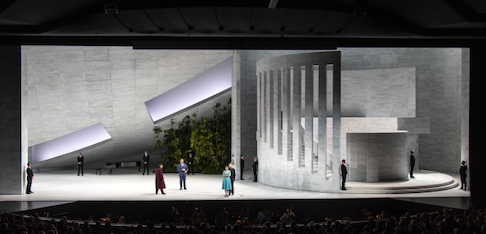
The full stage unit set, Amelia in blue front and center
Much happened in between Boccanegra's election and his death. Moment after moment recalled the great Verdi and presaged his most profound gestures — the indelible tonalities of Traviata, the male bonding in Otello, and most moving of all, the Don Carlo minor second weeping of Fiesco in his duet of reconciliation with the dying Boccanegra.
If no stylistically defining moments emerge from Simon Boccanegra it is not from a lack of splendid arias and duets in moments of extreme duress and of ecstatic resolve. Simon Boccanegra is a sprawling tale of splintered focus, no one character assumes an immensity of theatrical presence — Simone is overwhelmed by affairs of family and of state, the villain Paulo has confused motives, the grandfather Fiesco suffers a complicated history, Adorno appears out of nowhere and Amelia will not be upfront with anyone.
Still there is lots to sing about, maybe too much. Stage director Kriegenburg got the telephones put away early on, costumer Tanja Hofmann gave everyone a discreet identifying color in ordinary contemporary dress and conductor Gergiev took over and made the most of it. Initially we thought maybe we had stumbled into a Boris Godunov —. RenÈ Pape’s Fiesco lamented and shamelessly wept like a Russian bass in his famed prayer “Il lacerato spirito.” We did however quickly adjuste to conductor Valery Gergiev’s unidiomatic Italian, his orchestra participating with the singers in moods and colors rather than in Italianate operatic gestures.
Twenty-five years lapse between the prologue and the events that lead to the murder of Boccanegra. The filmy curtain that covered the architecture vanished after the prologue. His daughter Amelia appeared through some sort of silly digital magic that we had to overlook to deliver her luminous “come in quest ora bruna sorridon gli astri e il mare!” Adorno arrived. He sat momentarily at the piano, the harp accompanying his ecstatic greeting that became a love duet. Mo. Gergiev made time stand still in an absolute lyricism of young love.
Gergiev made the lyricism of Verdi’s Boccanegra the central focus of "his" production, insisting that we feel each of Verdi’s characters. And that we did in its arias and duets — the warmth of the love of Boccanegra for his daughter, the loyalty of Amelia for her father, the selfish, ugly rage of Paolo, the jealousy that consumed Adorno and dissolved into desperate need. Above all else we felt Boccanegra’s dying cry to the sea.
The senators, the conspirators and the populace were dressed in undifferentiated dark color. They were construed graphically on the marble expanse of the stage, a part of which was a monumental circular structure that moved of and within itself. This complex mechanism served as a metaphor of the size, power and pride of a city that has.called itself “la Superba,” and against which the actors of this civic and familial tragedy reacted. It was an evening of lyrical moments laid gloriously bare by conductor Gergiev and a splendid cast of singers.
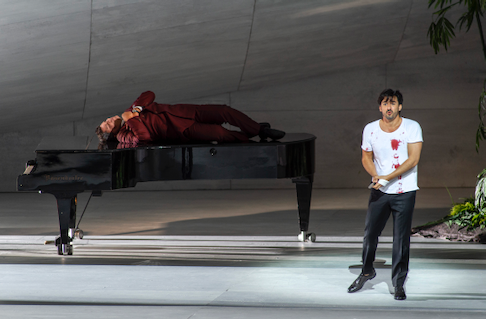
The piano as a tomb (the first, failed poisoning of Boccanegra), with Adorno
In keeping with the scope of the production Italian baritone Luca Salsi was a very feeling father and a sensitive patriot and statesman in warm and strong voice. Latvian soprano Marina Rebeka has the purity of voice to project the innocence of Amelia and the strength of voice to support her resolve. German bass RenÈ Pape found satisfying resonance of voice to meld patrician pride with surprising personal integrity. American tenor Charles Castronovo offered a perfectly sculpted Adorno that gave young Gabriele convincing sincerity as a lover and as a rebel. French baritone AndrÈ Heyboer as Paolo poisoned the water drunk by Boccanegra with the evil resolve of a despicable baritone, assisted by bass Antonio Di Matteo as Pietro.
Simon Boccanegra was performed in the 2200 seat Grosses Festspielhaus, its vast proscenium width allowing both the monumental tower and a vast slit through which a brilliant blue sea shone at Boccanegra’s death. Completing the exemplary artistic resources employed for this production was the Vienna Philharmonic.
Production information:
The Vienna Philharmonic, the Summer Academy of the Vienna Philharmonic (stage band), the Concert Choir of the Vienna Staatsoper. Conductor: Vallery Gergiev; Stage Director: Andreas Kriegenburg; Set Design: Harald B. Thor; Costumes: Tanja Hofmann; Lighting: Andreas Gr¸ter; Video: Peter Venus; Dramaturg: Julia Weinreich. Grosses Festspielhaus, Salzburger Festspiele, August 15, 2019 (first of six performances).
Il Signor Bruschino in Pesaro
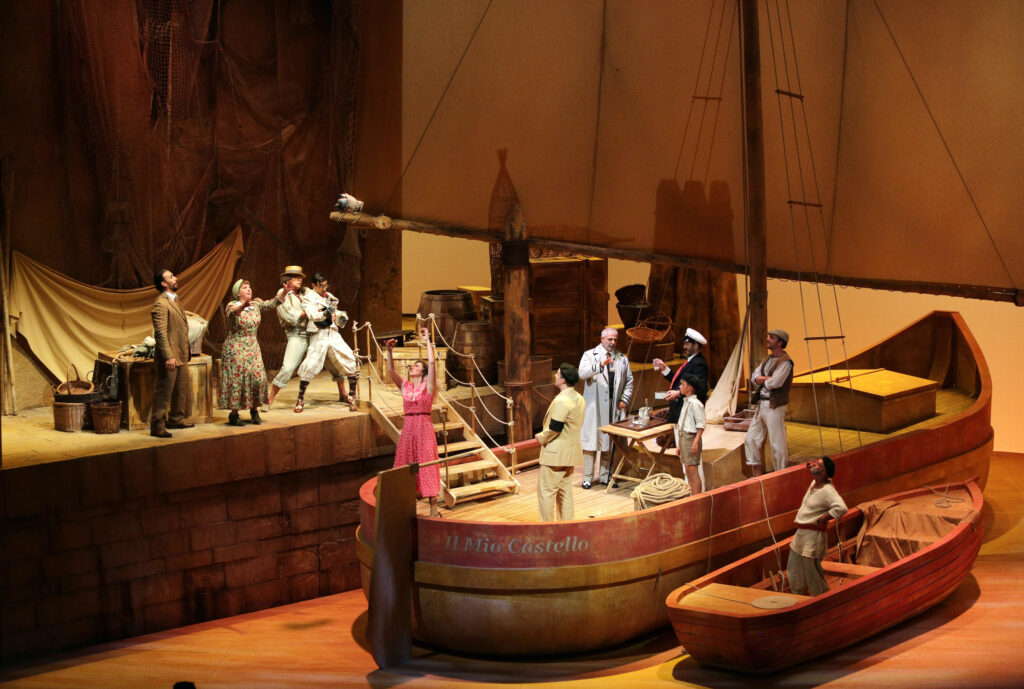
The entire cast and supernumeries
Il Signor Bruschino, ovvero il figlio per azzardo was last staged at the Pesaro festival in 2012 by Teatro Sotterraneo, a theater collective who by committee effort effected the farce in a “Rossiniland” theme park. It was bedlam. This time it was staged by the Canadian design/director team Barbe and Doucet (André Barbe and Renaud Doucet) who somehow connected Il Signor Bruschino to Guignol theater’s Il tabarro, setting Rossini’s country house farce on a river barge named “Il Mio Castello” even though there were no bloody murders thereupon.
The farce itself is off the wall. Signor Bruschino, being swindled, refuses to recognize a pretend son until doing so swindles the guardian of his real son’s fiancé. That true love may triumph isn’t nearly as important as winning. These days Rossini critics are delighted by the musical witticisms spread through the score, starting with the second violins tapping their music stands with their bows during the overture (in the moment one did wonder what had gone wrong to make all that racket).
There are indeed many musical rewards, among them a fine trio for three buffos — the father, the guardian and the innkeeper (who has imprisoned Bruschino’s son). There was as well a brief, miniature finale-scaled ensemble (five voices), a fine duet extolling the value of marriage to the conniving ingenue, a spectacular aria for the ingenue in splendid duet with an English horn and finally a plethora of patter pieces. The great Rossini comedies are just around the corner.
Vocally the challenges were very well met. Signor Bruschino himself was enacted by veteran Italian buffo bass Pietro Spagnoli, his counterpart Gaudenzio, the guardian, was sung by Giorgio Caoduro who executed really fine, dignified patter, the innkeeper Filoberto was broadly enacted by Gianluca Margheri — voilà the buffo trio! The swindler lovesick swain was stylishly sung by American tenor Jack Swanson, his now fiancé Sofia well sung by Spanish soprano Marina Monzó (an alumna of the festival’s young artist program). Roles facilitating the action were the Commisario sung by Enrico Iviglia and Marianna sung by Chiara Tirotta. The cameo role of the real Signor Bruschino junior was Manuel Amati.
Barbe and Doucet gave a straight forward accounting of the farce, the three levels of the very pretty set (left to right the high dock, the lower barge deck, and finally an auxiliary rowboat (whose tippiness provided just the right amount of provocation) serving as alternating stages for Rossini’s nifty musical procession. After the chaos of the 2012 production it was a quite tame and responsible solution for the farce, set on a barge, there, on the river of life [maybe?].
I’ll Signor Bruschino was performed in the 850 seat Teatro Rossini, pandemically reconfigured by placing all the spectators in two of the four seats of the horseshoe theater boxes (about a hundred of them) leaving the entire orchestra seating area to the orchestra. Amply spread out in concert formation we were able to admire an early Rossini’s score, as never before (a manuscript edition was clearly visible on the music stands). Many of us had clear sight of young conductor Michele Spotti who lived every moment of Rossini’s pre-maturity in a just and lively fashion. FYI Daniele Rustioni was the conductor for the 2012 version.
Teatro Rossini, Pesaro, August 2021. All photos courtesy of the Rossini Opera Festival copyright ROF / Studio Amati Bacciardi
Elisabetta, regina d'Ingliterra in Pesaro
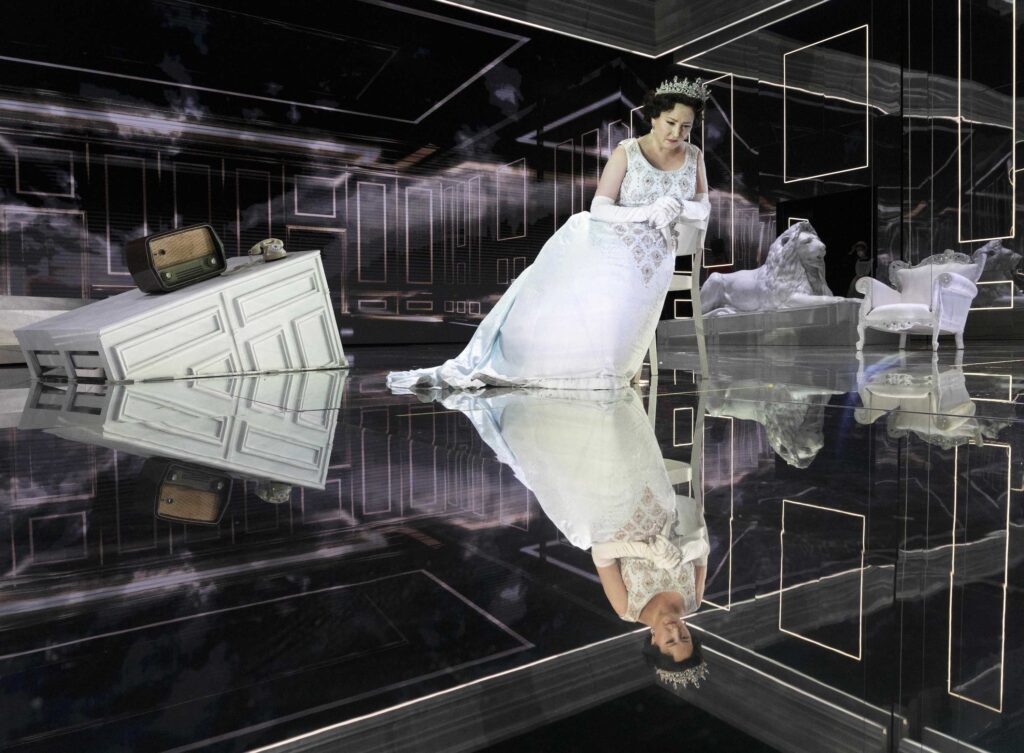
Karine Deshayes as Elisabetta
Plus Elisabetta, Regina d'Inghilterra, Rossini’s « audition » for more tragedies in Italy’s most important theater, Naples’ Teatro San Carlo, and Il Signor Bruschino, a failed farce composed just before the dawn of Rossini’s fame and fortune.
Strangely the 15,000 seat Vitrofrigo Arena in Pesaro becomes one of the world’s great opera theaters for a month each summer (Vitrifrigo makes refrigerators for boats). Normally the festival configures a 1200 seat auditorium on the basketball court floor and erects a full stage house on one end complete with traps, flies and wings. Over the years (since 2005) the acoustic has been perfected, the leaky roof not a problem as there has been little rain.
Configured for the pandemic only 500 audience places were made available, leaving ample space to seat the Orchestra Sinfonica Nazionale della RAI in concert formation. Conductor Evelino Pidò exploited the greater resonance and orchestral presence for Elisabetta, Regina d’Inglilterra (1815) extracting great breadth of phrase and depth of tone. Rossini originally composed its overture for Aureliano in Palmira (1813), though it is far better known as the quite lively overture to the Barber of Seville (1816).
Elisabetta was a great success back in 1815, paving the way for Rossini’s famous Neapolitan opera seria's, notably Otello (1816) and Mosé in Egitto (1818). Elisabetta (who not-so-secretly loves the secretly-married-to-someone-else Leicester) has the first great aria of the tragedy “Quant'è grato all'alma mia,” its cabaletta now far better known in its later, recycled version as that of Barber’s “Una voce poco fa.”
Norfolk betrays Leicester’s secret marriage, Elisabetta condemns everyone to death. In the spirit of the day it all ends quite happily. So was it a tragedy after all? Distinguished Italian stage director Davide Livermore (dah-vee-day lee-ver-mor-aye) didn’t take it a bit seriously, after all this is the period of the great Rossini Roman comedies.
Sig. Livermore imposed a highly abstract, maximally sophisticated, thoroughly cartoonized theatrical language that had far more to do with the technical challenges of pulling it off than it did with finding a life for Rossini’s formulaic emotions. It was a tour de force staging, starting with the tromp l’oeil stage picture that defied any possible definition of space thanks to impressive tricks of video, lasers and mirrors. Raging fires, violent storms, heavy clouds raced through the space reminding us that the background of the story is the Earl of Leicester’s glorious defeat of Mary Queen of Scots’ forces that has made the Duke of Norfolk so jealous of Leicester, and that emotions do indeed run amuck.
There really wasn’t much room for Rossini’s music, try as Mo. Pidò might with the responsive Orchestra Sinfonica Nationale della RAI. He exaggerated Rossini’s musical structures in sustained lines that slowed the dramatic pulse, further contributing to the monotony of the performance.
When the constant video commentary was less violent and things calmed down a bit with the lasers fooling our eyes, four witty, stock maids and four stock, goose-stepping palace guards executed sharply geometric choreography in perfect synchrony with Rossini’s musical structures, the principals moving much in the same fashion. The visual mirroring of the music was particularly tiresome in the what-seemed-to-be interminable recitatives.
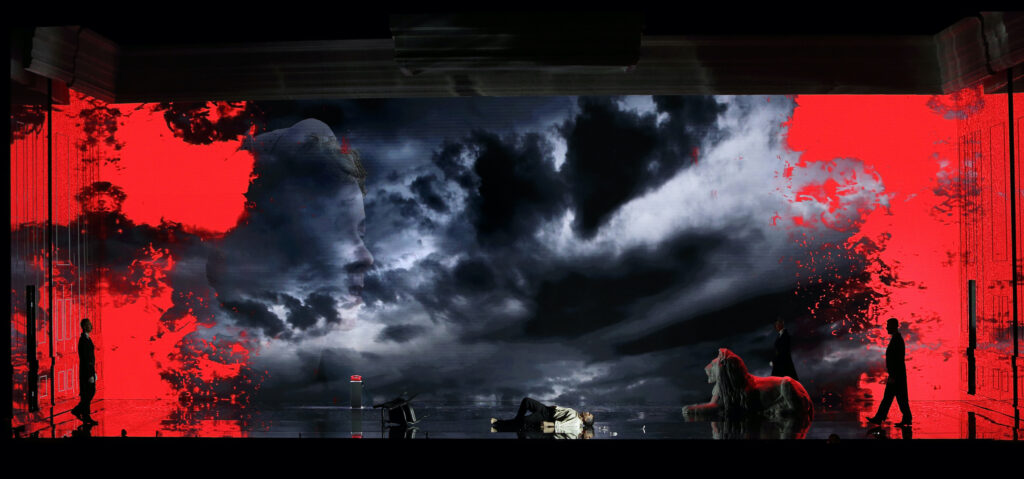
In the dramatic climax of the story the Duke of Norfolk rushes out to stab the queen only to be thwarted by Leicester. I confess I missed this greatly anticipated moment (quieting once and for all Leicester’s arch enemy), evidently having zoned out.
Elisabetta was brilliantly sung by French diva Karine Deshayes though in a smaller scaled voice than many recent Elisabettas. She looked very much like the official mid-life portraits of Elizabeth II. The Duke of Norfolk was performed by British tenor Barry Banks looking very much like Winston Churchill, his character tenor voice and presentation allowing no dignity (or authenticity) whatsoever to Norfolk’s treachery. No discernible rationale can be imagined for these two political/historical references.
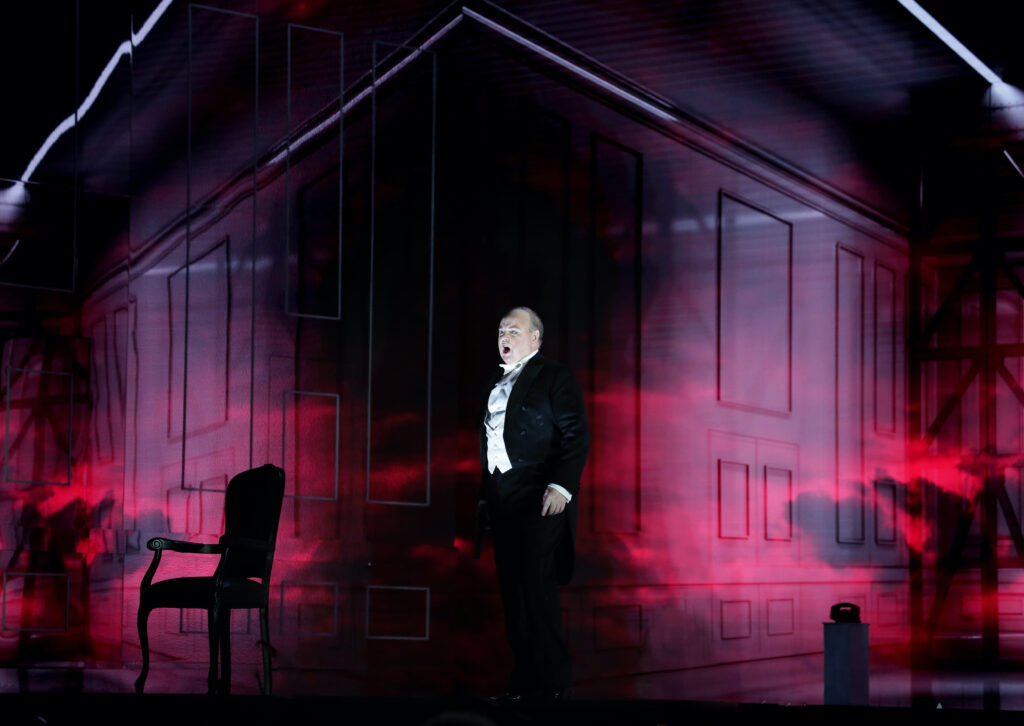
Barry Banks as Norfolk
Much less colorful was the rather wooden Leicester sung by Russian tenor Sergey Romanovsky. As Leicester’s secret bride Matilde Georgian born, Italian finished soprano Salome Jicia shone in her beautifully sung Act I aria “Sento un'interna voce.” Matilde’s brother Enrico was sung by mezzo soprano Marta Pluda, a recent participant in the ROF young artist program. Baritone Valentino Buzza was the Guglielmo, a role of actual dramatic importance but of no interest to stage director Livermore.
Vitrifrigo Arena, Pesaro, August 2021. All photos courtesy of the Rossini Opera Festival copyright ROF / Studio Amati Bacciardi.
Moïse et Pharaon in Pesaro
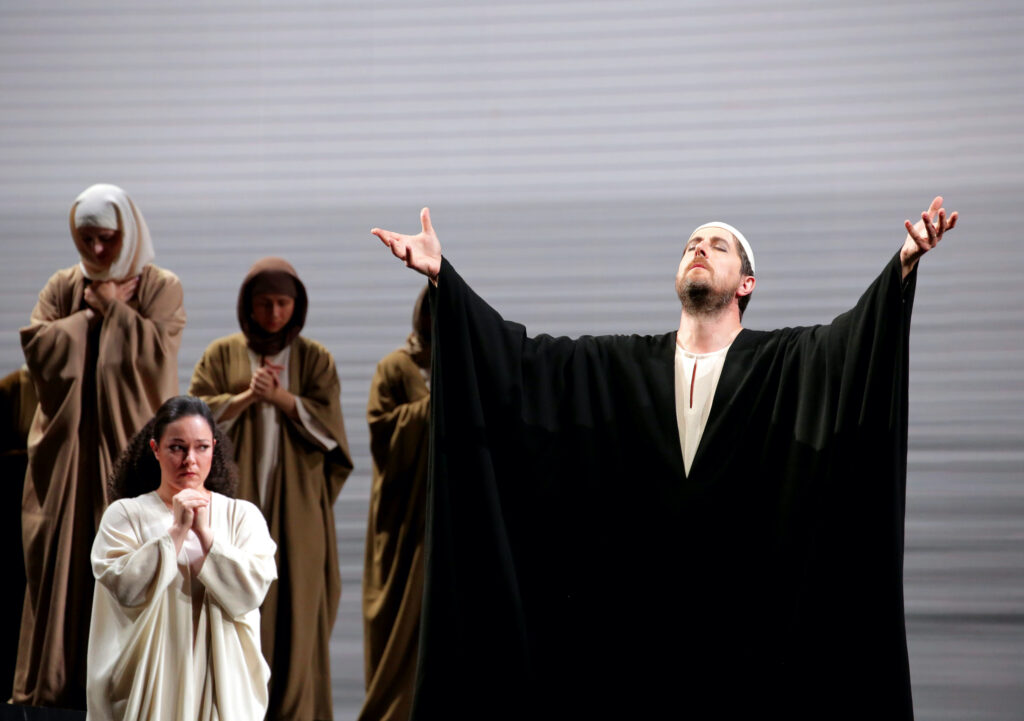
Moïse et Pharaon, ou Le passage de la mer rouge is Rossini’s adaptation of his Neapolitan Mosè in Egitto for the Paris Opéra. This revision may be the epitome of all opera. Photo: Eleonora Buratto as Anaï, Roberto Tagliavini as Moses.
Of great interest however, and of very great pleasure was Rossini’s remake of Naple’s Mosè in Egitto (1818) for the Paris Opéra, then known as the Académie royale de Musique. Mosè in Egitto itself was first performed at Paris’ Théâtre-Italien in 1822, its French version appearing in 1827, renamed Moïse et Pharaon, thus giving greater presence to the opera’s antagonist, the king of Egypt, called Pharaon (pharaoh in English, faraone in Italian) — there is no further biblical name in the Book of Exodus.
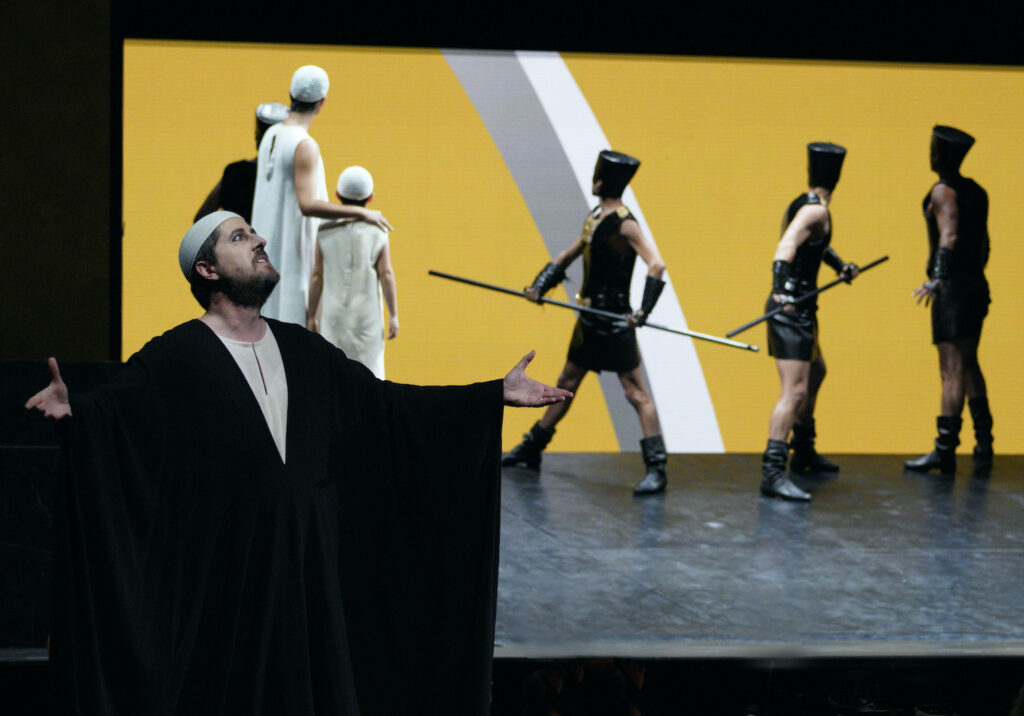
Roberto Tagliavini as Moses
Expected in the revision was the purging of many arias, florid singing less valued in the early moments of French grand opera, and the addition of dance, much valued in French court theater. There was a brief dance moment in Act I, and an extended dance sequence in Act III (three Airs de dances) with impressive music (and excellent dancing) that held our interest for thirty or so minutes already quite late in the evening.
Spectacle too was valued at the Opéra, thus the impressive addition of biblical phenomenon in Act 1. The Israelites rejoice, "Oh jour heureux, jour solennel," in learning that Pharaon will allow them to leave, God himself joins in creating a giant rainbow, He flames a bush that does not burn, Moses receives the Ten Commandments. It was awe inspiring indeed, both musically and visually. And that wasn’t all. The act concludes when God darkens the sky, collapses the great pyramid rendering it a volcano, all this in an eight voice finale with chorus. It was awesome. Grand opera loves spectacle!
A finale of even greater effect was “Je réclaim la foi promise,” new for the Opéra, in which the nine solo voices of the opera convene at the end of Act III, together with the Egyptians and Israelites to plead the release of the Israelites (Pharaon had reneged his Act I promise). The sacred Egyptian flames extinguish, the statue of Isis crumbles, the Ark of the Covenant appears, and the pharaoh decrees that the Israelites be released into the desert, all this to a repeating ascending bass line, rising each repetition first by a minor third, then a major third while the upper lines descend chromatically. The house came down, ignorant of such musical analysis.
Act I was newly created for the Opéra, except the duet when Anaï (Moses’ nice) tells Aménophis (Pharoan’s son) that though she loves him she loves her God and family more (this of course is the root of all the opera’s disasters). There are several more superb duets that occur throughout the opera, many with the mezzo soprano Marie (Anaï’s mother), a voice that was to find particular favor in French grand opera.
There were harp accompanied chorus scenes of invocation and prayers in each act, especially noteworthy was the justly famous, gorgeous Act IV chorus "Des cieux oû tu résides" where Moses sings the first strophe (harp accompaniment) repeated by the chorus, his brother Éliézer sings the second, repeated by the chorus, Anaî the third, then in a sudden modulation to a major key all voices sing together. It was a musical prayer of absolute and exquisite beauty.
Though all important voices had at least one brief solo air, there were two major aria scenes. The mother of Aménophis, Sinaïde, begs her son to marry a princess of his own rank in an extended scene that closes Act II. Her aria "Ah! d’une tendre mère" is interspersed with recitatives with her reluctant son, and includes opportunities for her to exhibit hugely virtuoso coloratura before concluding with a triumphant cabaletta.
And finally, in the dramatic conclusion to Act IV (though later the Red Sea does part for the Israelites to pass before it swallows the Egyptians, and there is a final encomium as well) Anaï sings her "Quelle horrible distinée!," newly composed for the Opéra in which Rossini pulls out all the stops possible in an aria — sustained cantabile, florid passages, and declamations that leap to distant intervals. It is a very difficult, splendid piece indeed, worthy to be the vocal crown of this amazing opera, perhaps of the Rossini canon.
The just over four hour evening (one brief interval) was held together by the superb conducting of Giacomo Sagripanti who sustained an unfaltering musical tension that connected the prayers to the spectacles, the arias to the ensembles to the enormous finales. It was a conducting tour de force, coaxing rich tone and mighty musical excitement from the Orchestra Sinfonica Nationale della RAI, moving from tormented individuals to tormented throngs ultimately to a rarified celestial peace that ultimately portends hope for mankind.
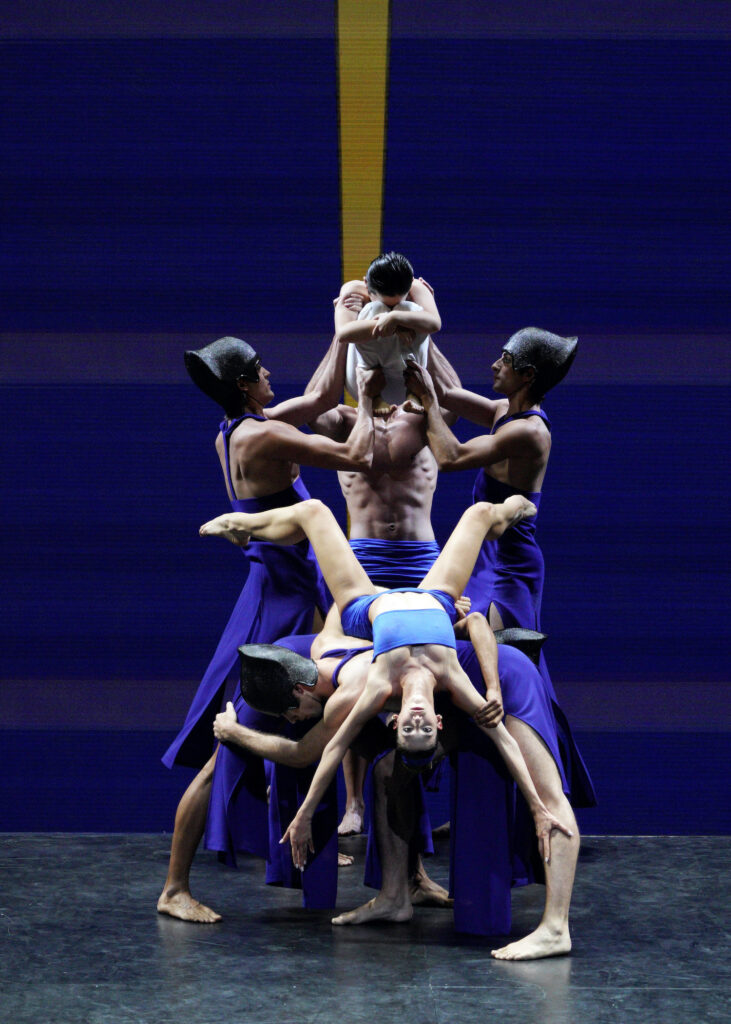
Maria Celeste Losa and Gloacchino Starace, solo dancers, with white clad boy in final dance sequence image
The opera was staged by 91 year old Pier Luigi Pizzi, a veteran designer/stage director of the world’s great theaters. His concept seems to have been that since Rossini refined his Mosè in Egitto to become Moïse et Pharaon, surely his most musically refined opera, he, Pizzi, would refine its staging to the purest form possible. Thus the stage itself was a floor and a wall that parted to reveal a blank space in which abstracted spectacle was placed or projected. Of great importance was a stage apron that surrounded the orchestra upon which principals often descended to directly sing to the spectators. No scenery, just the singer, Rossini, and you. But not always. The huge Act III finale brought all nine singers across the apron, obliterating the orchestra, to create musical excitement that grew to mammoth proportion, well beyond human scope (you had to be there to know that you could survive it).
Pier Luigi Pizzi was a minimalist long before minimalism became fashionable. Here, with Rossini’s massive score the minimalism became architectural brutalism, its weighty materials molded into purest form.
Sig. Pizzi opened his staging of the opera with the appearance of a young boy dressed in white who then reappeared in the final tableau, the Cantique (hymn) "Chantons, benisons le Seigneur!" This encomium sung now that the Jews have reached the promised land. The walls were now hidden leaving only the dark silhouettes of the Jews against the clear and empty space where God's earthly spectacles had taken place. At the last moment of the opera four dancers raised the white-clothed boy in offering.
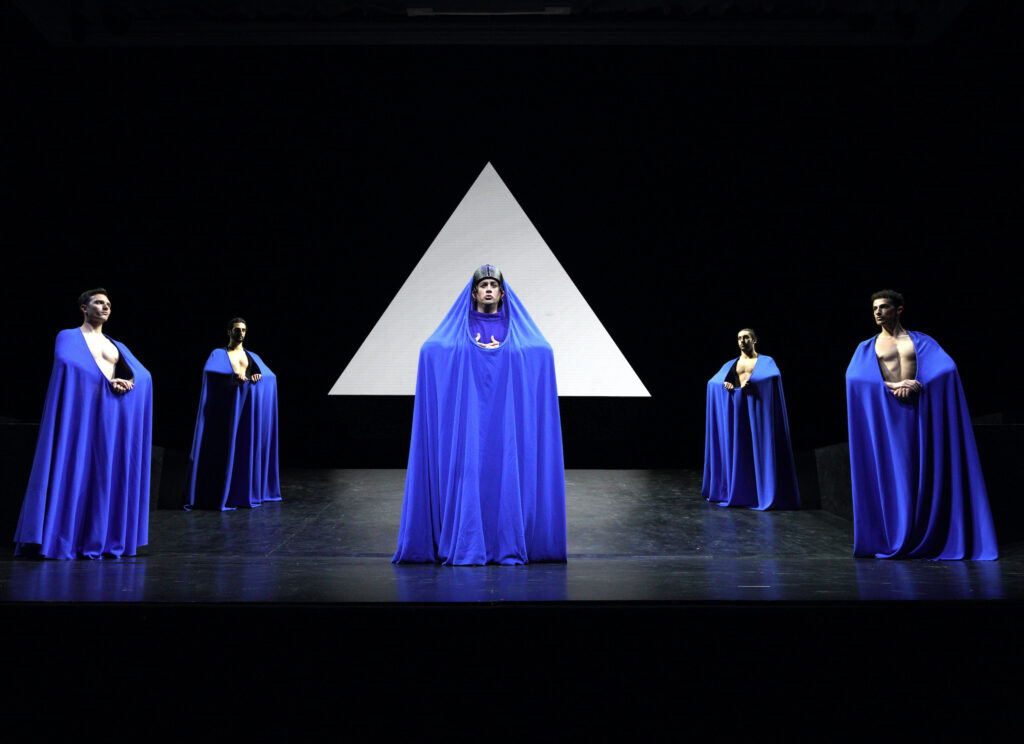
Matteo Roma as the Egyptian high priest Aufide with the four movement mimes
The excellent chorus was that of Ascoli Piceno’s (a nearby town) theater, the Teatro Ventidio Basso [Publio Ventidio Basso was a local hero in Roman times who became a consul!]. Since becoming the main chorus for the ROF in 2017 the Coro del Teatro Ventdio Basso has assumed considerable artistic stature.
The choreographer was Romanian born, Bolshoi finished Gheorghe Iancu, a longtime Pizzi collaborator. His dancers were four movement mimes, four ballerinos, and a male and female principal dancer, nearly all of La Scala provenance. The Act III ballet sequence was effected in mostly basic classical balletic steps, the four male dancers in unisex costume often executing movements normally associated with ballerinas, the soloists often in grand pas de deux, Egyptian frieze informed movement and then in breathtaking lifts. In short, it was awesome.
Baritone Roberto Tagliavini sang a Moses of powerful dignity, his voice achieving supernatural beauty in the Act IV prayer. Bass-baritone Erwin Schrott sang Pharaon in pontifical tones that shook the walls. He obviously was having the time of his life here in Rossini heaven. Soprano Eleonora Buratto sang Anaï, at first her full lyric voice seemed out of place though in the great final aria she shone in uncommon virtuosity — flawless coloratura, finding precise intonation in staggering leaps. Soprano Vasilisa Berzranskaya sang Sinaïde, her great Act II aria earning one of Pesaro’s tumultuous multi-minutes, foot stomping ovations. Tenorino Alexey Tatarintsev sang Mose’s brother Èliézer in unusually smooth and warm tones for this voice. Tenorino Andrew Owens sang Aménophis in biting tone appropriate to this villainous role. Mezzo-soprano Monica Bacelli sang Anaï’s mother Marie affecting appropriate maternal maturity, and Matteo Roma sang the irascible Egyptian priest Aufide. Nicolò Donini sang the offstage mysterious voice.
Massimo Gasparon was the associate stage director, effecting as well impressive lighting.
P.S. If you got this far you may be interested in my review of the late Graham Vick’s production of Mosè in Egitto performed in Pesaro in 2011. It is a horse of a different color.
Vitrigrigo Arena, Pesaro, August 2021. All photos courtesy of the Rossini Opera Festival copyright ROF / Studio Amati Bacciardi
La traviata at San Francisco Opera
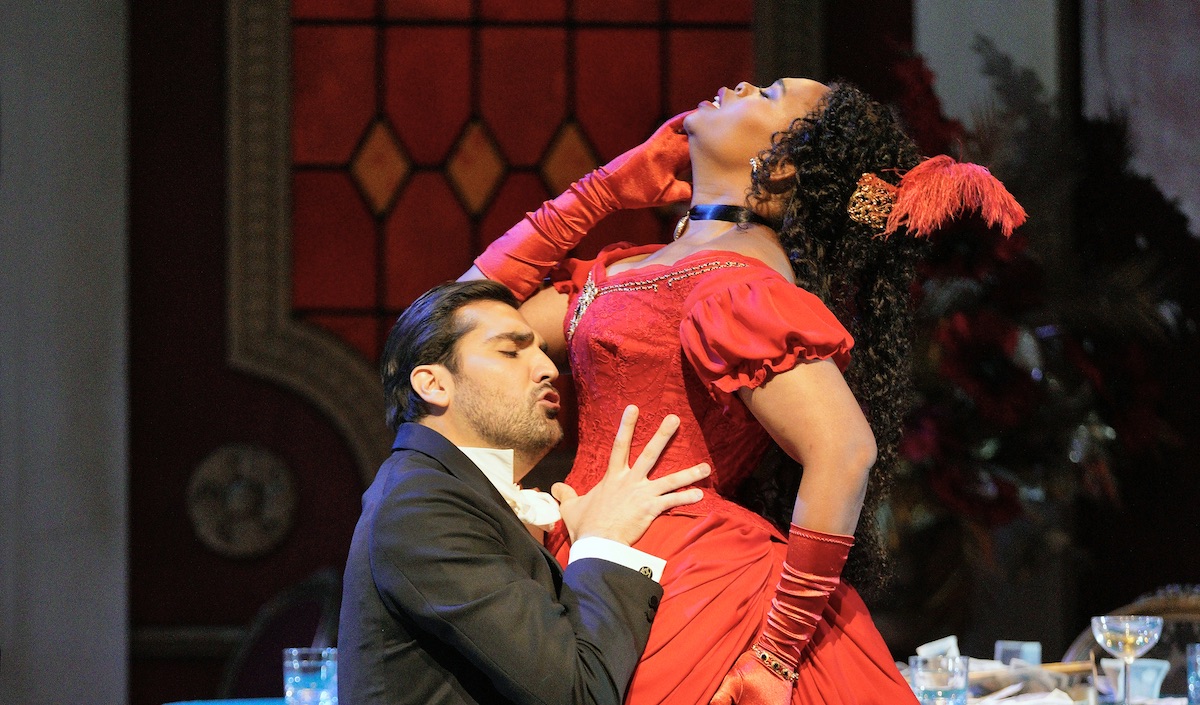
Jonathon Tetelman as Alfredo, Pretty Yende as Violetta
Wondrous things do still happen at San Francisco Opera. Like the La traviata last night where conductor Eun Sun Kim built a perfect synergy with soprano Pretty Yende and tenor Jonathan Tetelman (lead photo), and baritone Simone Piazzola.
It is the operatic ideal when the music actually becomes character, the composer’s genius absorbing the raw emotion, distilling the emotion into a voice that envelopes our senses and our intellects — in short the operatic ideal is the same as the Apollonian ideal. Verdi’s opera La traviata was such a voice just now, told by three singers who perused its nearly infinite range of emotions in telling their stories.
Conductor Eun Sun Kim established the measure — a firm beat except when it had to pause. Her beat did not often breathe, thus pushing the voices to move with or around the beat, capturing the immediacy and urgency of a moment. And there were plenty of these moments, in fact the entire evening was such a moment.
Conductor Kim’s orchestra [she is San Francisco Opera's Music Director] sometimes competes with the stage for attention. But provide to her these singers who have the technique and musical importance to enter into her musical world, and her orchestra did indeed become one with the stage — in the intimate moments it was barely a whisper, and in the intense moments on stage is was all that was needed, no more. Her conducting was about measure, not about color — that was for the singers, and it too was largely about the rhythms of their words flowing through the conductor’s beat.
South African soprano Pretty Yende is surely the Traviata of the moment. She possesses a beauty of tone that exemplifies a virginal purity of emotion as well projecting sincerity of feeling. La Yende retains this purity and sincerity throughout her registers, from the softness and resignation in her lower voice in the third act “Addio, del passato bei sogni ridenti” to her sharp, full voice outbursts of rage in her midrange when she encounters Germont in Act II. From the intimacy of the discovery of her most intimate feelings in “È strano . . . ah! fors’è lui” to the flights of freedom in the stratospheric reaches of the soprano voice in “Sempre libera” (yes, she took the E-flat!).
La Yende is technically possessed by the role of Violetta, able to vocally realize every nuance of feeling in this complex fallen woman who tragically falls in love.
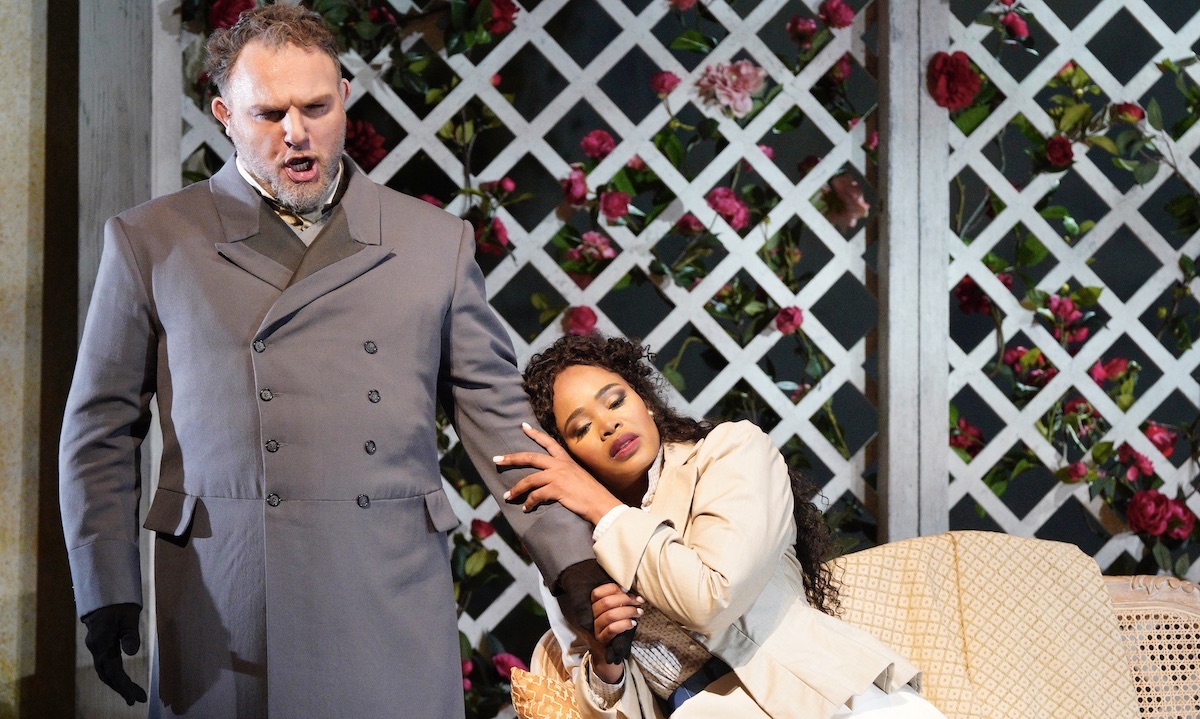
Simone Piazzola as Germont, Pretty Yende as Violetta
All photos copyright Cory Weaver, courtesy of San Francisco Opera
Alfredo’s father Germont was the domain of Italian baritone Simone Piazzola. Though young for the role (he is 37), he radiates a nobility of spirit in a unique baritone timber that resounds with tremendous authority and purpose. These attributes served him well as he established the god-given purity of his unseen daughter in the “Pura siccome un Angelo” and then cemented his parental authority by seeming to quietly demand rather than sing the “Di Provenza il mare” to the inexorable pulse of Eun Sun Kim’s Verdi baton.
American tenor Jonathon Tetelman brought big, beautiful Italianate voice to Alfredo. While the role does not offer Mr. Tetelman much (any) opportunity to thrill us with ringing high notes (he does sing Cavaradossi around the world) the role shone with a firm resoluteness of voice, rendering his love for Violetta as deep and sincere. His behavior at Baron Douphol’s party was therefore hugely disturbing, his anger at Violetta was wrenching. Finally, rather than soar to an emotional climax, Verdi asks him only to find the tenderness of his love. He sang his final duet with Violetta with his head buried in her bosom, the scene releasing an avalanche of emotion that overtook us all.
Of special note were the strong performances of Baron Douphol by Philip Skinner and the Flora of Taylor Raven, both roles firmly anchoring the happenings of the party scenes, the San Francisco Opera chorus was urged to extraordinarily spirited displays by conductor Kim, ever the showman.
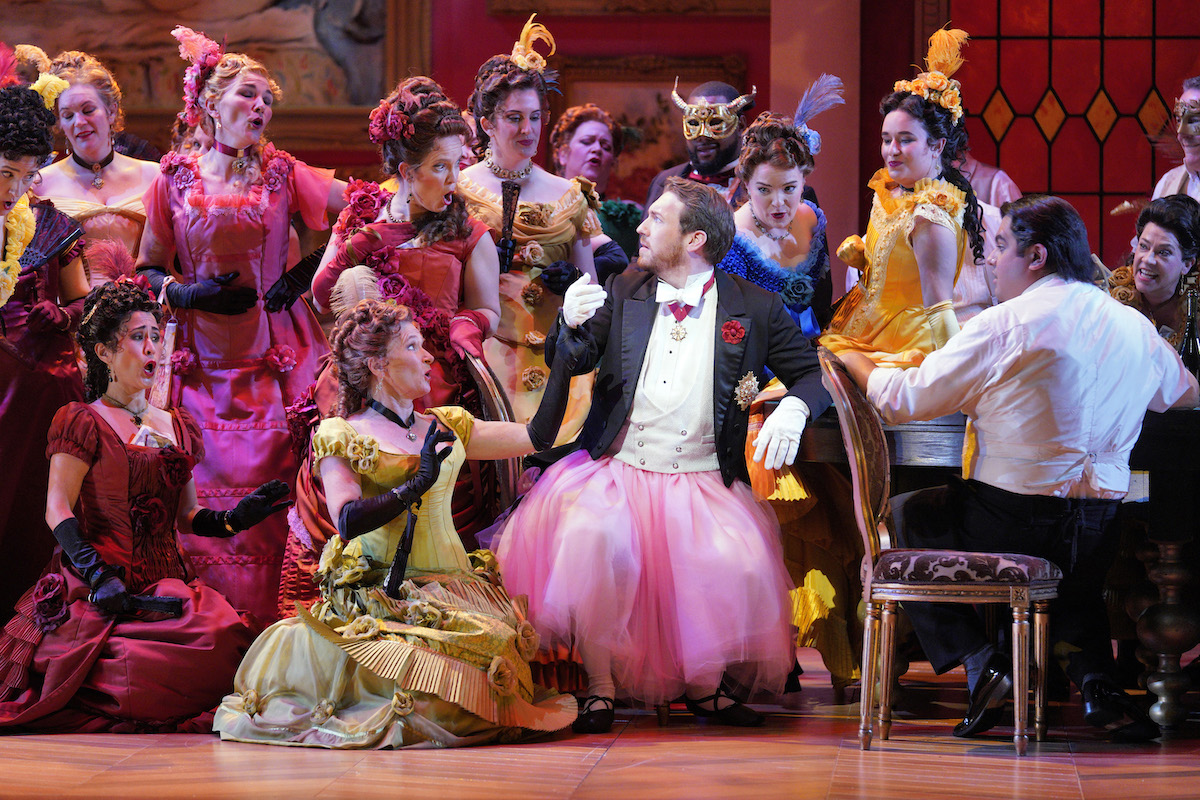
Adler Fellow Timothy Murray (in tutu) as the Marchese d'Obigny with members of the San Francisco Opera Chorus
It was a new production, staged by Shawna Lucey. Given the extraordinary musical elegance of the Verdi masterpiece by the conductor and principal singers the possibility of imposing any staging concept was nonexistent, or irrelevant. The larger chorus scenes unfolded in a sometime-in-the-19th century crass lasciviousness. The sets were well-designed generic recreations of 19th century looks, catering to the supposition that future audiences will always prefer period settings. Fortunately the sets will easily accommodate the use of other costume looks, and other stagings as future decades roll by — the previous Traviata production (John Copley) endured for three.
The sets and costumes were designed by Robert Innes Hopkins, lighted by Michael Clark. Choreography was by John Heginbotham.
Verdi’s overture was left unstaged.
War Memorial Opera House, San Francisco, November 16, 2022Orfeo ed Euridice at San Francisco Opera
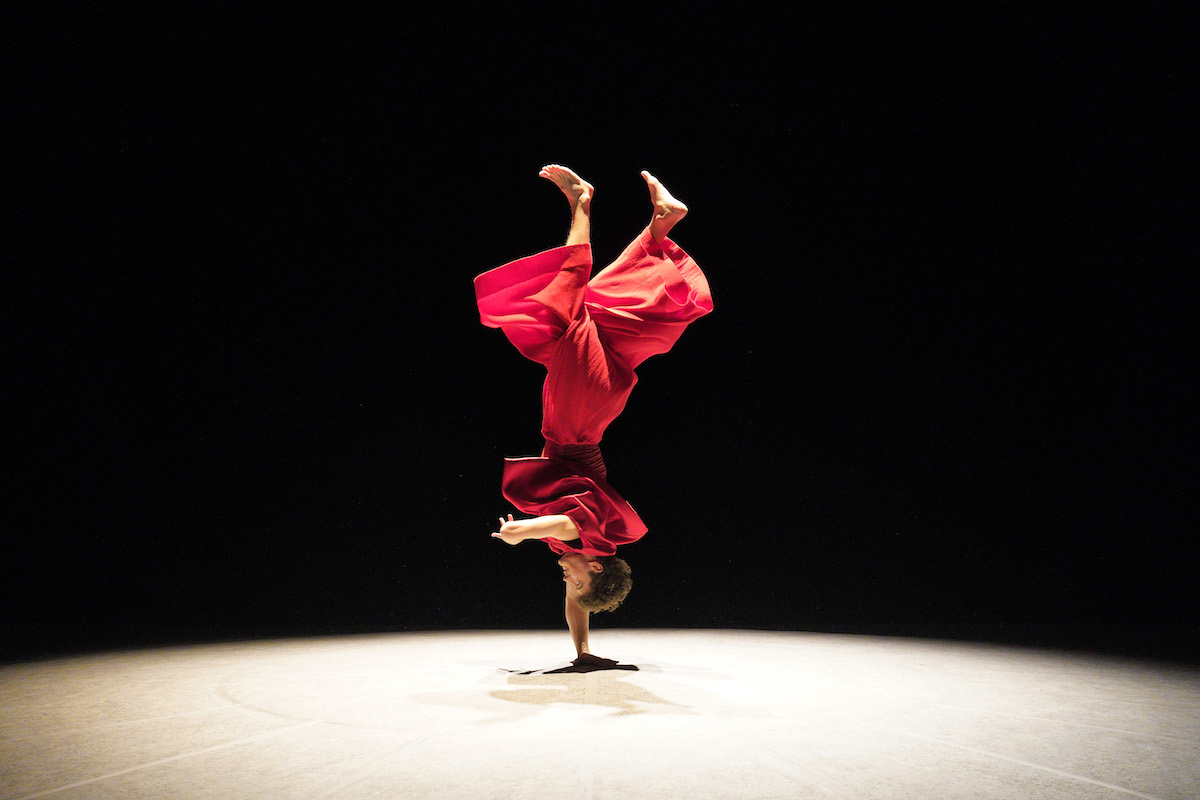
Jakub Józef Orlinski as Orfeo
One of opera’s most awesome scores came, finally, to the the War Memorial Opera House stage, arriving with flying colors in stage director Matthew Ozawa’s fine new, bigtop-like production.
An oxymoron that worked, abetted by a conductor from the Irish National Opera and the Irish Baroque Orchestra, Peter Whelan who found, somehow, Straussian (almost) orchestral colors in this 1762 score, maybe because it was rendered by modern instrumentation (oboes and clarinets instead of cornetts and chalumeaux). Current early music conductors relish such opportunities to create surprising colors, and this maestro did just that.
The setting for Orfeo ed Euridice was a ring disk — a circular revolving disk — that lighted up from time to time like a kaleidoscope (which is why we sat in the first tier rather than in the orchestra section from where the stage floor was less apparent). Orfeo wore brilliant red, Eurydice brilliant blue, and Amore topped it all off, draped in flowing gold.
Meigui Zhang as Euridice, Jakub Józef Orlinski as Orfeo. All photos copyright Cory Weaver, courtesy of the San Francisco Opera
It was not the classical underworld, though my envisioning a circus metaphor (see lead photo) is probably not stage director Ozawa’s intention.
Gluck’s cheerful overture was danced by Orfeo and Eurydice and three more Orfeos and three more Euridices. It was where Orfeo did his act — spectacular breakdance moves that set this countertenor apart from, surely, all other countertenors in the world. Though Orfeo is is not always a countertenor, as Orphée in Gluck’s French version he is a tenor or a haute contra (very high) tenor, the Parisians not enamored with Italy’s castrati as were the Viennese.
Polish countertenor Jakub Józef Orlinski brought an ephemeral presence to mythological tragedy’s most notable hero, his initial cries “Euridice” nearly covered by Maestro Whelan’s orchestra, even though they sounded amplified (they were not). The quirky acoustic of the War Memorial Opera House gave Mr. Orlinski’s uniformly colored voice a big, pervasive presence throughout the evening.
In Gluck’s reform opera Orfeo has two famed arias, his initial “Chiamo il mio ben cosi” and in the end his “Che farò senza Euridice,” both arias of extraordinary histrionic challenge given that both are simple songs, sung, however, over the dead body of his beloved. Mr. Orlinski did not find the gravity of these moments. He did find a couple of ecstatic breakdance moves at Euridice’s re-animation.
Though Orfeo ed Euridice is largely a one man show (if you discount the huge role of the chorus) the more moving part of the evening occurred when the Euridice, sung by Merola Opera Program graduate, Chinese soprano Meigui Zhang, let loose with her “Che fiero momento” reproaching and misinterpreting Orfeo’s cold response to her as they find one another, the stage ring (disk) turning and turning in stage director Ozawa’s abstracted, circus-like world.
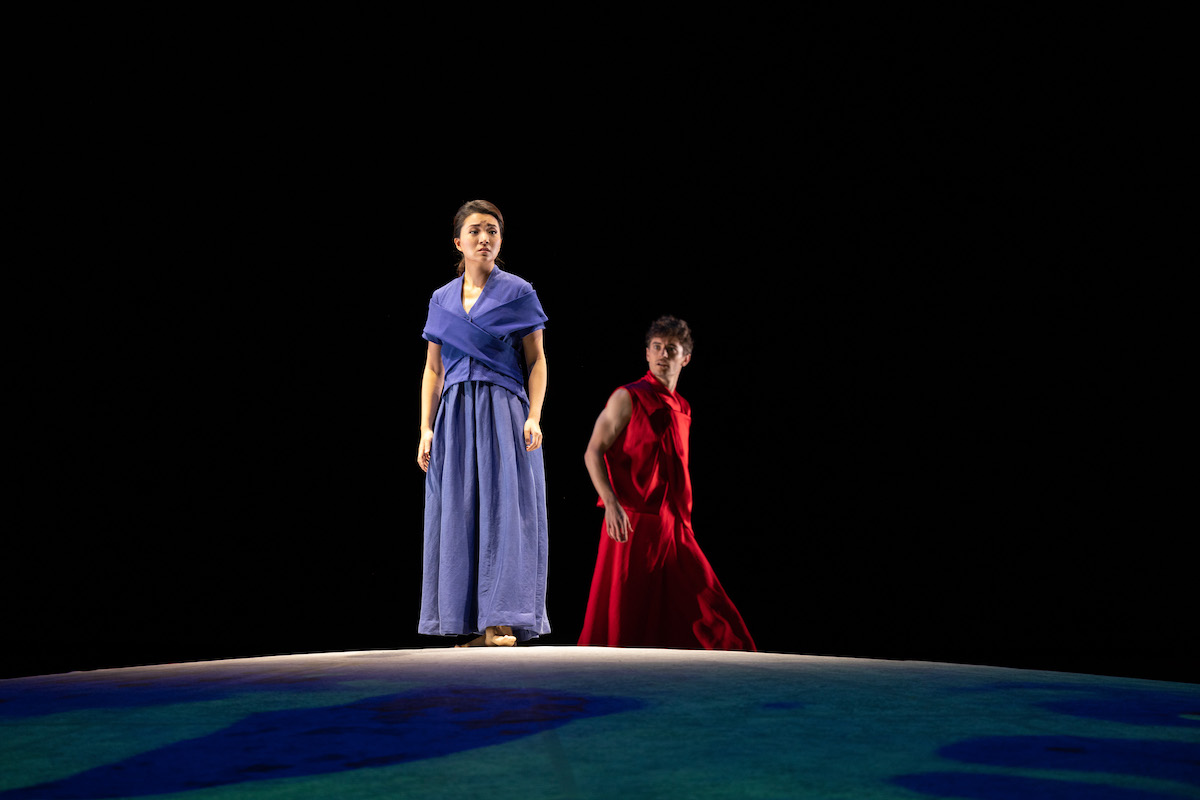
Orfeo with infernal spirits (the San Francisco Opera Chorus)
The other felt moments of the evening were created by forty-one San Francisco Opera choristers who, sometimes in white, sometimes in dark robes, intoned a surrounding world, from its light to its darkness. Beautifully sung in San Francisco, these choruses were Gluck’s triumph, exploiting a uniquely French choral element to create atmospheres well beyond those illustrated by mere scenic elements, or just now in San Francisco substituting for any actual scenery.
As well Gluck sought to bring dance into his reformed tragedies (of these only Iphigénie en Tauride has found its way to San Francisco). Though dance in Gluck is meant to enrich the storytelling, it is now often used to fill a perceived void left by the unadorned, ornament-less vocal lines, which is to say replacing virtuoso Baroque displays of voice with modern dance movement.
Such was not the case for Mr. Ozawa’s production with its three Orfeo/Euridice doubles. Choreographer Rena Butler offered a complex choreography for the overture, including Mr. Orlinski’s virtuoso break dancing and Miss Zhang’s less spectacular but convincing movement. Mlle. Butler added her six dancers to the complex staging choreography required to detail Orfeo’s avoidance of turning to Euridice in dance choreography that integrated smoothly into the complexities of the lovers’ duet "Vieni, appaga il tuo consorte,” intensifying the considerable artistic tension of this beautifully realized scene.
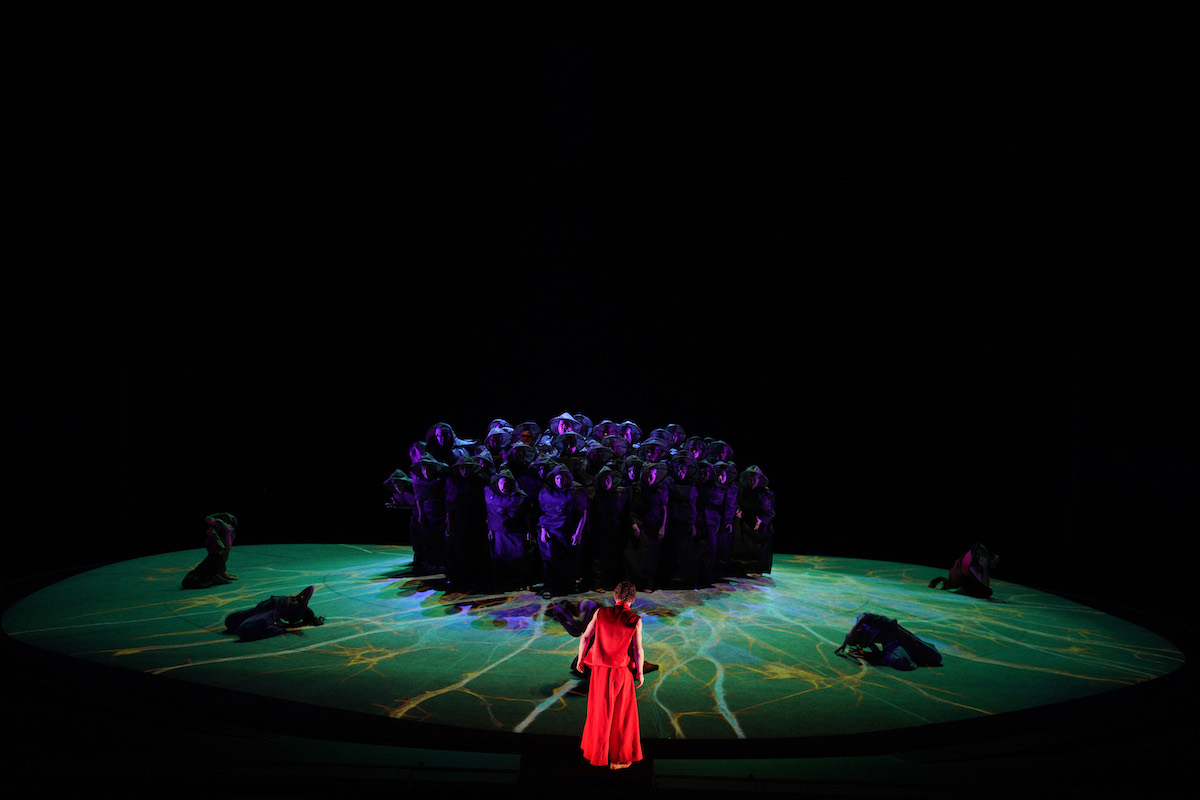
Nicole Heaston as Amore
Cherry atop the cake was Amore, sung by richly voiced Texas soprano Nicole Heaston, a humor filled, mature matron in place of the petite Adler Fellow who would normally have been cast. She made both her entrances aerially (suspended 20 or 30 feet above the stage floor), adding a fine Baroque deus ex machina touch to the staging, and at the same time, dressed in flowing gold, adding the imagined peak to a virtual circus tent.
Matthew Ozawa’s production tread a fine line between the deadly artistic seriousness of Gluck’s opera, and the fun of creating a contemporary theatrical world for it. That Gluck’s opera survived the assault attests to its inherent artistic stature, and the delicacy, finally, of the staging overlay.
Stage director Ozawa was supported by a very talented production team. Costumes were designed by Jessica Jahn, lighting was effected by Yuki Nakase Link, the superb setting (at least for tiered seating) was designed by Alexander V. Nichols.
War Memorial Opera House, San Francisco, November 15, 2022
Dialogues of the Carmelites at San Francisco Opera
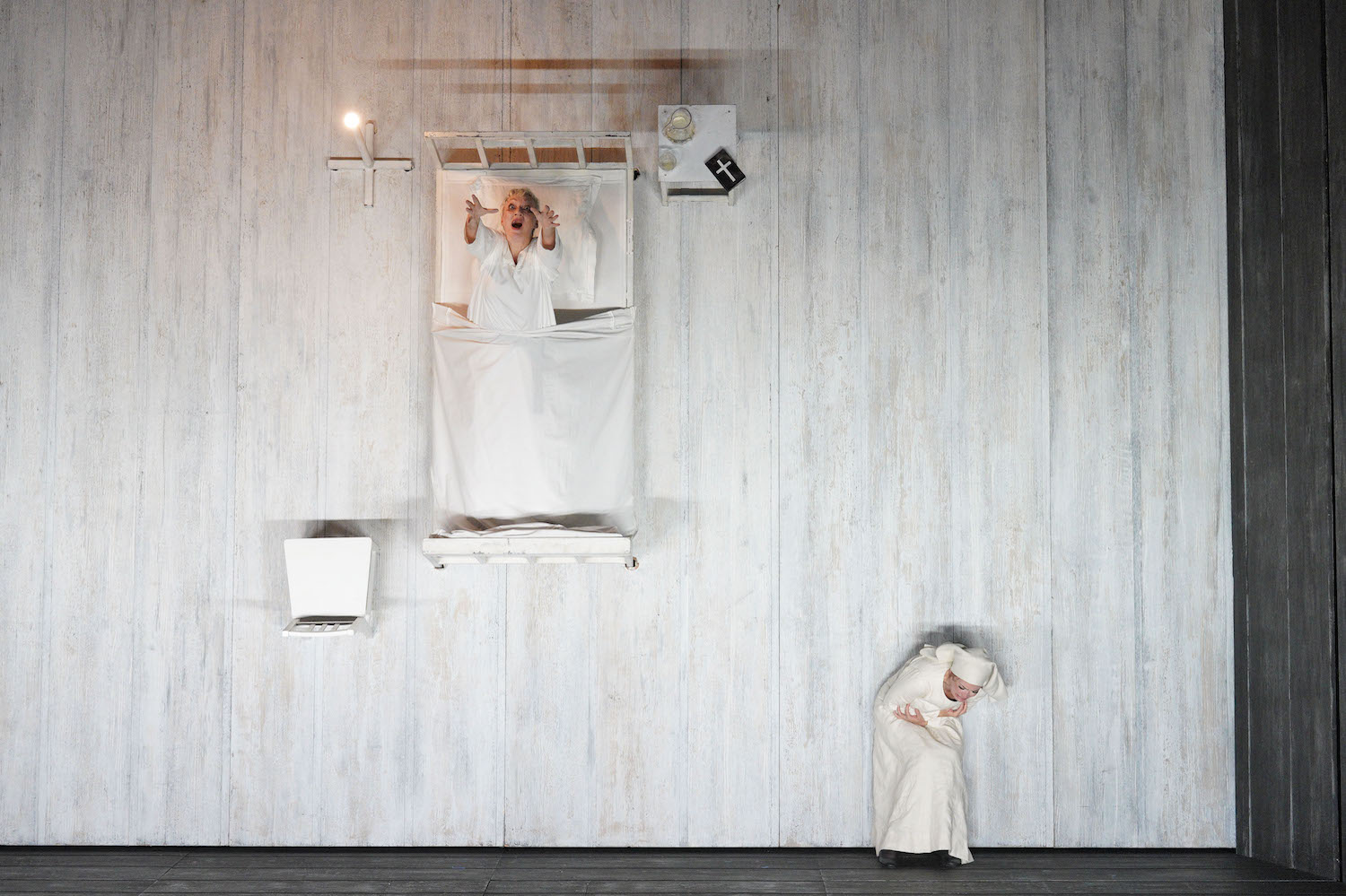
Michaela Schuster as the dying prioress, Heidi Stober as Blanche
Poulenc’s masterpiece (1957), Camus’ La Chute (The Fall) Nobel Prize for Literature (1957), Bernstein’s West Side Story (1957), Gian Carlo Menotti’s The Saint of Bleecker Street (1954).
San Francisco Opera has mounted just now French stage director Olivier Py’s 2013 production of Les Dialogues des Carmelites (Théâtre des Champs-Elysées then at Brussel’s La Monnaie [2017]), a staging that invokes the philosophical moods of the mid-1950’s as much as Poulenc’s music echoes the accessible, populist compulsions of the era.
Poulenc’s score is tonal, the story is told in recitative, the orchestration is sparse, transparent, descriptive and emotional. The libretto based on the novella of a German authoress of the late nineteenth century was a failed film scenario that was an elaboration of an actual historical incident (the decapitation of Carmelite nuns near the end of the Reign of Terror). Poulenc asked that the opera be sung in the vernacular of the theater, its La Scala premiere was in Italian, its American premiere a few months later at San Francisco Opera was in English. Following the Met’s lead (2013) San Francisco Opera has now rendered it in French, though there were no francophones in the cast to sing this French screenplay.
Olivier Py forsakes the bright tricolors of the French Revolution using instead a dark, empty theater, illuminated only by the usual “ghost light” — a single bulb mounted on a standing pole meant to dispel or maybe reveal the specters of the imaginary souls that have inhabited its stage. There is a wall that splits horizontally and vertically, partially and totally, to reveal from time to time massive, leafless/lifeless tree trunks. Ghostly stagehands are shadow puppets wielding props depicting death and destruction as needed.
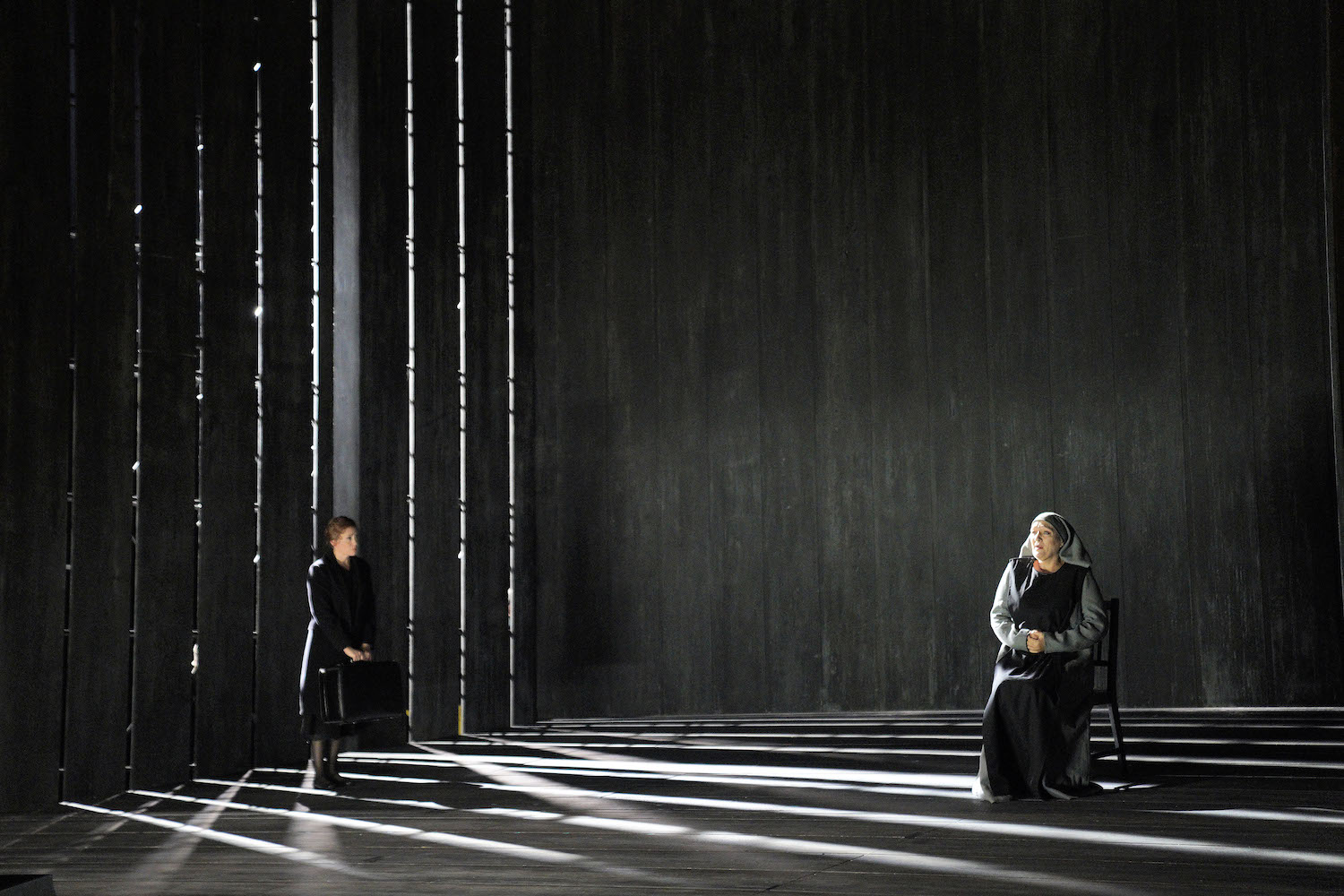
Heidi Stober as Blanche, Michaela Schuster as the Old Prioress (mother superior)
All photos copyright Cory Weaver, courtesy of San Francisco Opera
Director Py and his designer Pierre-André Weitz have created a theater world that is dark and frightening, a theatrical world that is imaginary as well as real. It is a universal world of modern, maybe recent times. While Poulenc had recently re-embraced the Catholicism of his youth the opera is decidedly non-ecumenical, despite its trappings. Finding no meaning in this world the Carmelites renounce it, yet they fear leaving it. They overcome this fear, and thereby find meaning in this world. It is the existential dilemma, though it vaguely echos the Christian metaphor, present in the plethora of crucifixion images Mr. Py exploits.
Les Dialogues des Carmelites portrays a kind of matriarchal family, all of whose women are in the throes of spiritual crises. The nun Blanche de la Force bridges and confuses the menace of the outside world with the refuge of the convent. The old mother superior, hung on the wall like Jesus on the cross, begs that she not suffer, an image verging on blasphemy. The novice Constance confronts her own innocence, Mother Marie confronts her understanding of sacrifice, the new Mother Superior confronts her responsibility to her sisters.
In the Py production Poulenc’s kitsch guillotine finale assumes, potentially, a philosophic grandeur that overcomes the usual Guignol horror of the scene.
The Paris premier boasted the creme de la creme of French divas as its protagonists — Patricia Petibon, Sabine Devieilhe, Sophie Koch, and Veronique Gens. N.B. the only non-Francophone was Rosalind Plowright as the dying mother superior.
In San Francisco the role of Blanche de la Force was taken by Heidi Stober, San Francisco Opera’s go-to soprano for light lyric roles. Mme. Stober is an estimable artist who embodied Poulenc’s heroine with obvious conviction. Blanche’s brother, the Chevalier de la Force (Blanche’s secular world), was sung by Ben Bliss who possesses a voice of great beauty and a handsome bearing. Both Mme. Stober and Mr. Bliss were perhaps directed to illustrate the production’s theater metaphor (the production was staged in San Francisco by Daniel Izzo, an Olivier Py assistant} with exaggerated acting, in Mr. Bliss’s case however the acting verged on mugging.
The novice, Sister Constance, was effectively sung by soubrette Deanna Breiwick. Soprano Melody Moore enacted Mother Marie in large, warm tones that embodied her maternal and intellectual largesse, though her exclusion from her sisters’ martyrdom was compromised by the lightweight performance of the convent’s priest confessor — tenor Brenton Ryan (strange casting) had the daunting task of conveying God’s will. The young prioress, the role taken at the San Francisco Opera U.S. premiere by Leontyne Price, was sung by soprano Michelle Bradley whose arching vocal climaxes did not equal her otherwise exemplary performance, leaving her character somewhat pallid.
German soprano Michaela Schuster portrayed the dying prioress in huge gestures, making her fear of suffering the suffering of fear, though without a subtlety of intent. Mme. Schuster possesses a voice that at this point is more suited to her upcoming Herodias’ in Vienna.
Blanche de la Force’s father was gruffly sung by bass baritone Dale Travis. Mezzo soprano Catherine Cook had an impressive moment in the brief cameo role of Mother Jeanne.
San Francisco Opera music director Eun Sun Kim imposed a considerable presence for the San Francisco Opera orchestra, a presence that often competed with the stage for attention.
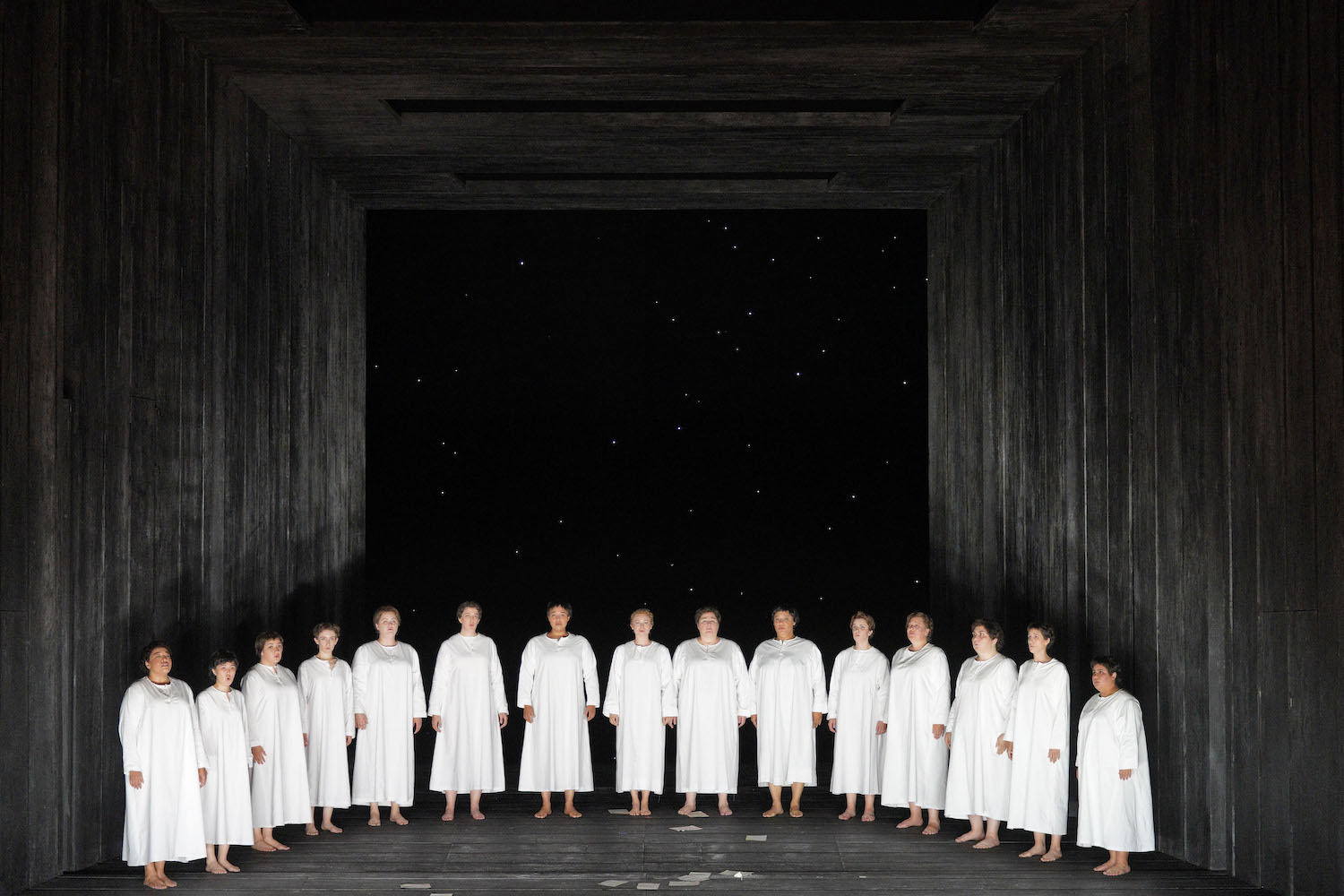
The Carmelite nuns in the initial moments of the Salve Regina chorale.
<
Former Adler Fellows Efrain Solis, Christopher Oglesby and Hadleigh Adams sang the smaller male roles. All of the Carmelite nuns were named roles, their quite beautiful chorales sung by Taylor Raven, Deborah Nansteel, Alexandra Sanchez, Esther Tonea, Chea Kang, Mikayla Sager, Gabrielle Beteag, Jesslyn Thomas, Anne-Marie MacIntosh, Elisa Sunshine, Buffy Baggott, and Courtney Miller.
The ghost lamp was hardly the only light. French lighting designer Bertrand Killy, the production’s original lighting designer, provided the needed illumination, a daunting task when the image is an empty, black stage.
War Memorial Opera House, San Francisco, October 18, 2022
Eugene Onegin at San Francisco Opera
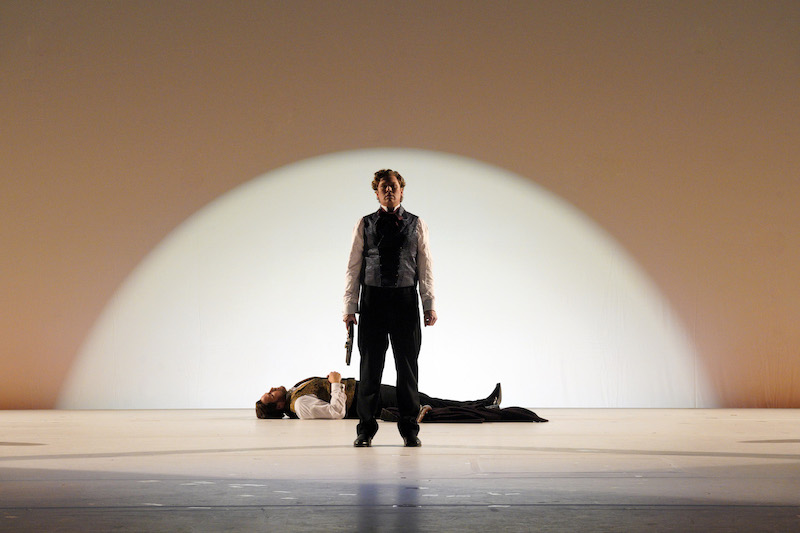
Gorden Bingner as Onegin, Evan Leroy Johnson as Lensky
Symphonic excess in a spiritless exposition of Tchaikovsky’s sacrifice of youthful love.
Greek conductor Vassilis Christopoulos came to fame at the Athens Opera with an Elektra, and then gained even more fame in Athens with a Lady Macbeth of Mtsensk, operas of great orchestral prowess. A prowess he imposed just now in San Francisco onto Tchaikovsky’s spare setting of the Pushkin novel.
Let it be said that the San Francisco Opera Orchestra gave a full throated response to the maestro, showing once again that it is one of the world’s fine opera orchestras. It cut loose with maximum, infectious gusto for Tchaikovsky’s third act polonaises, dwarfing the intimacies that so infuse this delicate masterpiece, that had so begged to be brought to life throughout the evening.
Canadian bass baritone Gordon Bintner, a recent house singer at the Frankfurt Opera, sang Onegin. Mr. Bintner brought his youth, and his sincerity to the role, easily passing for the twenty-six years he claims in his frantic pleas to Tatiana in the final scene of the opera. His opening scenes were less persuasive, his aloof posturing unconvincing, but he gained authority as the opera progressed, finding the appropriate swagger in Tatyana’s Act II name day ball, then portraying a moving sympathy for his dead friend Lensky. The final confrontation with Tatiana was a fully realized operatic ending.
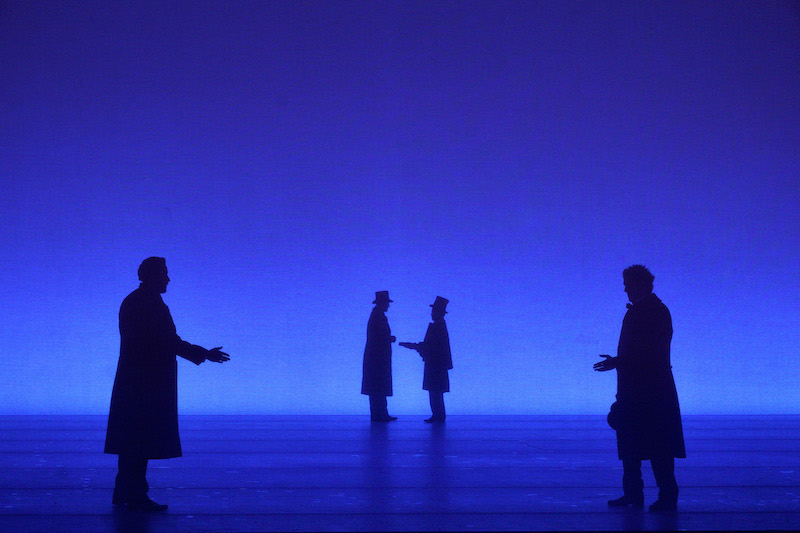
Evgenia Muraveva as Tatyana
It was this scene where the Tatyana of St. Petersburg soprano Evgenia Muraveva was fully realized as well. Of beautiful lyric voice, and youthful allure, Mme. Muraveva is an emotionally distant performer, a coldness that well served her as she dismisses Onegin from her life. While beautifully sung, her first act Letter Scene missed the fervor, and the transport of infatuation that makes this scene one of opera’s most brilliant showpieces. Mme. Muraveva gained fame when she stepped in for Nina Stemme in Salzburg’s 2017 Lady Macbeth of Mtsensk, returning to Salzburg the next season as Lisa in Pique Dame, both performances marked by this same distant emotional involvement.
Pushkin’s poet Lensky was portrayed by American tenor Evan Leroy Johnson, a house singer at the Munich Opera. There is however nothing poetic about Mr. Johnson’s presence. Tall and handsome, and a fine singer indeed, he certainly embodies Otello’s Cassio (one of his Munich roles) more comfortably. Towering over Onegin, he projected the confidence of a much older man, his Act II jealousies while well acted remained unconvincing. Once totally alone on the darkened stage for his famed aria “Kuda, kuda, vi udalilis” (Where, where have you [my young life] gone) he attained some poetic stature, though without the urgency of voice associated with this aria.
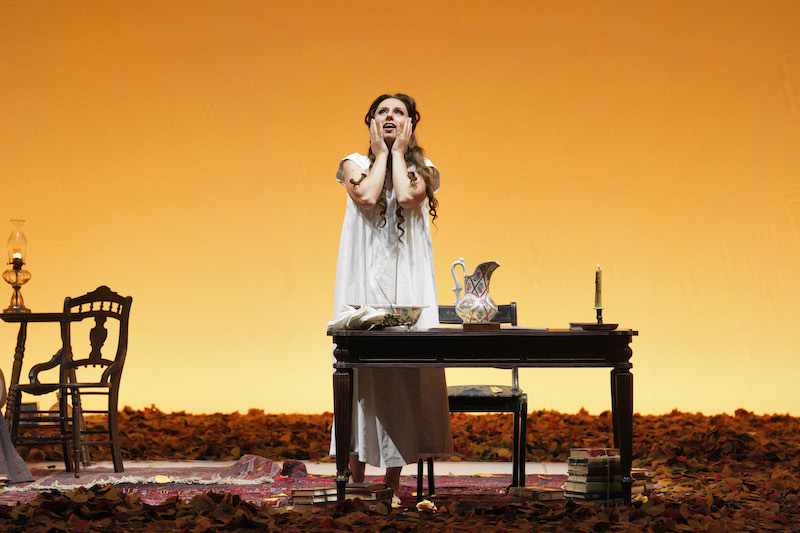
The duel
Olga, Lensky’s bethroved was sung by Russian mezzo-soprano Aigul Akhmetshina whose career is unfolding entirely in Europe (she was a Covent Garden young artist). This is her San Francisco debut, inauspicious indeed in this relatively small, though principal role. Of huge personality her Act I aria “Ah, Tanya, Tanya” was delivered with the pizazz of the Carmen she sang not so long ago on the Covent Garden mainstage. She brought an exaggerated diva presence to her Act II scene with Onegin and Lensky that precipitates the later operatic disasters.
Distinguished Italian bass Ferruccio Furlanetto found the requisite maturity and presence for Tatiana’s aged husband, Prince Gremin, his famed aria sung in rich, lyric voice with much nuance, if with no hint of slavic coloration. Tatiana’s nurse Filiipyevna was gracefully enacted by Ronnita Miller in remarkably clear diction, her opening duet with mezzo soprano Deborah Nansteel as Madame Marina portending in its clarity an evening far more rewarding than would unfold. To wit the lackluster rendition of Monsieur Triquet’s song by tenor Trenton Ryan, and the mess of the second Act III polonaise effected by solo dancers of the San Francisco Opera Ballet.
The staging was the 1997 Metropolitan Opera production by Robert Carsen and his designer Michael Levine, realized in San Francisco by the Met’s Peter McClintock. It is the vintage minimalism of this gifted stage director, the set a huge white box that assumed magical, saturated colors in which Tchaikovsky’s numbers bask, mixing an abstract space with the realism of a few pieces of furniture, his actors interchanging a tangible world with their emotions, much as music itself is both physical and metaphysical.
This staging conferred a huge responsibility upon the conductor to impose the spirit of Pushkin’s characters onto the scene, as Tchaikovsky had imagined in his music. As it was the Christopoulos orchestra sang gloriously, independent of the protagonists, not hearing the agonies that might have been poured out by the suffering Russian souls on the stage.
The lighting designer was Christine Diner, a monumental task. Zaretsky was richly sung by bass Stefan Egerstrom, a peasant was sung by tenor Michael Jankosky.
Michael Milenski
All photos copyright Cory Weaver, courtesy of the San Francisco Opera.
Anthony and Cleopatra at San Francisco Opera
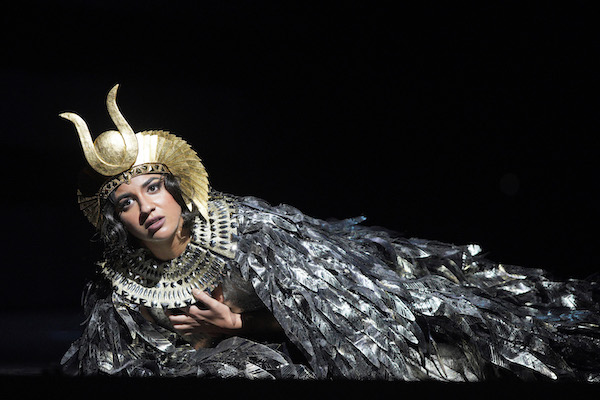
Amina Edris as Cleopatra
A John Adams premiere is about the biggest news event the opera world can generate. Here’s the news from San Francisco.
Anthony and Cleopatra is the first opera John Adams has created without the input of stage director Peter Sellars. The libretto is now the work of composer Adams himself who, like Richard Wagner, has thus assured its compatibility to his very own, particular animus. Like the seventy-four year old Giuseppe Verdi for his Otello, seventy-five year old Adams renders a Shakespeare play into opera. And like Falstaff (and Pelleas et Melisandre), Adams’ Anthony and Cleopatra is text driven — a play set to music.
It is the text of Anthony and Cleopatra largely comprised of old Shakespearean language and rhythms (though some Dryden Virgil as well) that is the John Adams muse, his music from its first sounds capturing the richness of verse, the atmospheres of poetry and the urgencies of drama. Far from the minimalist sobriquet associated with Adams the score exploded in infinite details that beguiled us for a more than three hour duration. The conducting of San Francisco Opera music director Eun Sun Kim surcharged the Adams score to art song on steroids.
The Adams opera tells the Plutarch tale in bold strokes. The powerful warrior Anthony, smitten by the wily, seductive Cleopatra, rebels against the wily, ambitious Octavian, but loses a huge naval battle when he follows the unexplained retreat of Cleopatra’s ships. Forced to beg Octavian’s (soon to become Caesar Augustus, the first Roman emperor) mercy, Anthony and Cleopatra are torn apart in their responses to Caesar’s (Octavian) deceits. To regain Anthony’s love Cleopatra feigns death, Anthony, who seems none too swift, believes it, so he tries to kill himself. They come together, Anthony dies, Cleopatra summons the asp.
If only it were that simple. Shakespeare weaves his story with 40 named roles in 42 scenes. Adams pulls it down to twelve roles in nine scenes, though the scenes are quite complex indeed — Adams wishing to incorporate as many of the Shakespearean complexities as he possibly can. Thus we have nine more personalities who both enact and embellish the story in many, many added words (tough for us to process), though offering composer Adams myriad opportunities to create very magnificent music.
The Anthony and Cleopatra music is awesome in and of itself, dwarfing the personalities and actions of his protagonists and their acolytes.
Adams worked with stage director Elkhanah Pulitzer [yes, of the famed St. Louis Pulitzer family], and her dramaturg Lucia Scheckner to imagine and realize the opera. They consider it a study of power, of nations and individuals. It is, according to Adams, quite modern because of its focus on the seizure of power (Octavian), the empowerment of women (Cleopatra), and the vanity of masculine strength (Anthony). Adams believes it therefore to be a worthy successor to his famed earlier collaborations with Peter Sellars — Nixon in China, Klinghoffer and Dr. Atomic.
The setting is both an abstracted ancient Egypt and a (the) Hollywood golden era that idolized the doomed couple. Much effective use of video projection was made, the work of designer Bill Morrison. Specifically there were two 1930 black and white newsreels from Italy — the marriage of Mussolini’s daughter, and the marriage of Umberto II, the last king of Italy. The staging is highly abstracted, the great naval battle has choristers holding poles topped by a tiny, square sail shape, Octavian’s huge Trump/Hitler-like rally has the red sashed chorus in a line across the front of the stage, Octavian’s face in caught in huge, repeating, black and white video images.
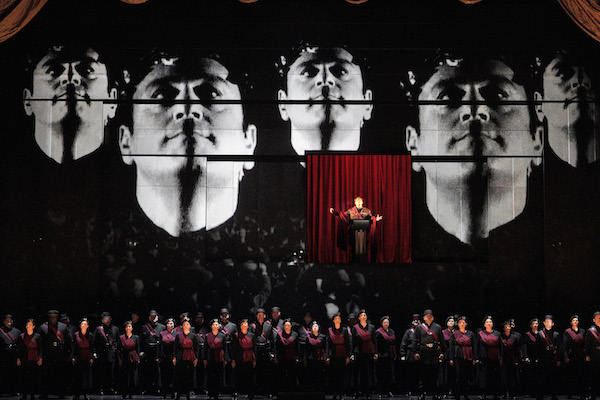
Paul Appleby as Octavian, the San Francisco Opera Chorus
The stage set by Broadway and theatre designer Mimi Lien (a former MacArthur Fellow) is spectacular. A black, huge full stage camera lens covers the stage, magically opening and closing, revealing ever new, techni-colorful staging pictures on the floor and at random elevations. Designer Lien traversed the opera’s three continents with great ease and restraint, the actors themselves declaiming location on a mostly barren stage, supported by the costumes, spectacular as well, by Constance Hoffman, — white or light for Anthony and company, dark or colored for Caesar and company, simmering metallic colors for Cleopatra and company.
San Francisco Opera assembled a prestigious support staff for the production, a joint venture with the Metropolitan and Barcelona operas, that included lighting designer David Finn. And there was a surprising credit for an “intimacy director!”
Always noteworthy is composer Adams’ addition of voice amplification. The sound design and mixing was undertaken Mark Grey, a technician of great experience. Conductor Kim’s orchestra was very present — too present, quite loud, skewing a possible, plausible relationship between pit and stage, the voices finding a too low relief.
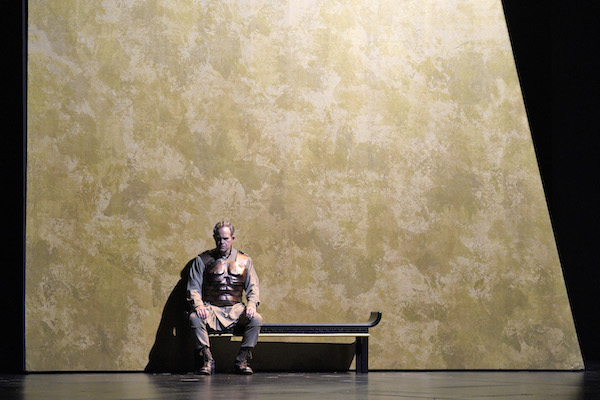
Gerald Finley as Anthony
Anthony was sung by baritone Gerald Finley, a veteran of Dr. Atomic in San Francisco and at the Met, a voice and presence well known to Mr. Adams, that well suited the middle aged, besot, not too bright warrior created by Adams and Shakespeare — though Mr. Finley is often cast as Scarpia on the world’s major stages.
The Cleopatra role was created for soprano Julia Bullock, who withdrew. San Francisco Opera had its own, real Egyptian princess in the wings, soprano Amina Edris (lead photo) who made the role her own in shimmering, golden tone. The melodic flow is determined by intervallic colors rather than a succession of tones, exploring the full reaches of the soprano range. It is a big, long role, obviously quite difficult to master. It was well executed indeed by Mlle. Edris.
Tenor Paul Appleby was the Caesar Augustus/Octavian, this estimable artist well acquainted with the repertory’s more interesting roles (Tom Rakewell, Pelleas, etc.). He found the sound and presence for a rising, young, ambitious tyrant, his big rally diatribe was terrifyingly familiar (magnified by its spectacular staging), and all too believable.
Noteworthy were the roles of Caesar’s lieutenant Agrippa, sung by baritone Harleigh Adams (no relation) and Anthony’s aide Eros, sung by tenor Brenton Ryan, both artists finding the complex, internal rhythms of composer Adams’ texts, and making their lines incisive and musically real. Agrippa suffered his beating by Anthony’s thugs with great aplomb. Eros’ suicide was one of the few felt moments of the performance I attended, text and music coming together in sublime, momentary solemnity.
Performance dates in New York and Barcelona have not been announced. It will be interesting to see what changes may be effected. This San Francisco premiere is but the initial exposition of a potential masterpiece.
Cast and Production Staff
Cleopatra: Amina Edris; Anthony: Gerald Finley; Chairman: Taylor Raven; Eros: Brenton Ryan; Enobarbus: Alfred Walker; Caesar/Octovian: Paul Appleby; Agrippa: Hadleigh Adams; Lepidus: Philip Skinner; Octavia: Elizabeth DeShong; Scarus: Timothy Murray; Iras: Gabrielle Beteag; Maccenas: Patrick Blackwell. San Francisco Opera Orchestra and Chorus. Conductor: Eun Sun Kim; Stage Director: Elkhannah Pulitzer; Set Design: Mimi Lien; Costume Designer: Constance Hoffman; Lighting Design: David Finn; Projection Designer: Bill Morrison; Sound Design: Mark Grey. War Memorial Opera House, San Francisco, September 23, 2022.
All photos copyright Cory Weaver, courtesy of San Francisco Opera
Oedipus Rex and Symphony of Psalms at San Francisco Symphony
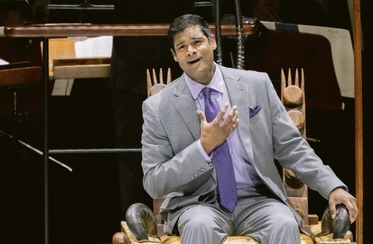
Sean Panikker as Oedipus
Plague infested Thebes, plague infested San Francisco. Esa Pekka Salonen has brought his Peter Sellars staged Oedipus Rex and concluding Stravinsky prayer, Symphony of Psalms, to Davis Hall.
Salonen, now music director of the San Francisco Symphony, former music director of the Los Angeles Philharmonic, has long associated himself with Stravinsky’s operatic oratorio. His debut concert at the LA Phil in 1987 was in fact the Stravinsky/Cocteau tragedy. In 2009 he enlisted wunderkind (then 52 years old) stage director Peter Sellars to stage the tragedy at Disney Hall. Sellars reconsidered and rewrote the part of the narrator, and added the Oedipal salvation offered by Stravinsky’s symphonic prayer. This production was Salonen’s farewell to Los Angeles.
Salonen, music director of London’s Philharmonia (as well as SF Symphony) presented the Sellars staging in 2016 at Royal Festival Hall. This was two months after conducting a fully staged production (by Sellars) at the Aix Festival, performed just hours after the Nice massacre (a truck plowed into a Bastille Day crowd killing 86 people, injuring 458 others, an attack attributed to jihadist terrorism). This civic tragedy resonated inexorably onto these Aix performances. We knew that this massacre was within our collective guilt.
Peter Sellars muse has long been the oppression of peoples of color. This muse has engendered much splendid theater art. At times this art has seemed quite abstract, if not mannered.
Though San Francisco may be in the grips of plague, as was Sophocles’ Thebes, of greater emotive impact is our current confrontation with critical race theory, and its visible effects in our cities and countryside. Thus casting a black actress (Breezy Leigh) as Antigone, an ancient black bass (Willard White) as Creon and Tiresias, a beautiful black woman (J’Nai Bridges) as Jocasta, a young Chicano (Jose Simerilla Romero) as the Shepherd, was hardly coincidence.
And most importantly Sri Lankan/American tenor Sean Panikkar as Oedipus (lead photo) whose leggiero tenor, its warmth of tone, and his sympathetic presence brought inherent innocence to Oedipus, rendering his gradual recognition of guilt painful for us to absorb. Antigone’s searing monologue of his self-inflicted blinding was then absolutely terrifying. And finally, in Stravinsky’s prayerful Symphony of Psalms, the blinded Oedipus’ slow traversal of the stage, led by Antigone’s silent sister Ismene (dancer Laurel Jenkins), was heartbreaking.
Maestro Salonen imposed the emotional distance we needed in a calculated reading of Stravinsky’s neo-classical score. The maestro contained the tensions of its fugues and shattering climaxes, paced its emotional operatic underpinnings, and regimented the outbursts of the citizens of Thebes, the tenors and basses of the San Francisco Symphony Chorus. This without sacrificing the immediacy, the hugeness and the delicacy of this youthful Stravinsky masterpiece.
Stravinsky famously rendered Cocteau’s French text (libretto) into Latin — “a medium not dead but turned to stone.” Cueing from this statement Sellars has the Greek chorus make choreographed, abstracted, uniform motions with their arms while singing, evincing the frozen positions of marble statues. In San Francisco the chorus was seated behind and above the orchestra, immobile and spread out in the chorus loft beneath the pipes of the grand organ, a position that dominated the stage. It was acoustically and visually spectacular, this huge Greek chorus impressively enacted both individually and collectively.
Unlike the 2009 Los Angeles production where the protagonists were placed on a platform behind and above both chorus and orchestra, and amplified, in San Francisco the acting platform was placed stage floor level in front of the orchestra, only the voice of the narrator amplified, the singers well able to project their voices operatically. As well, positioned in front of the orchestra, they established a powerful and immediate presence in the hall.
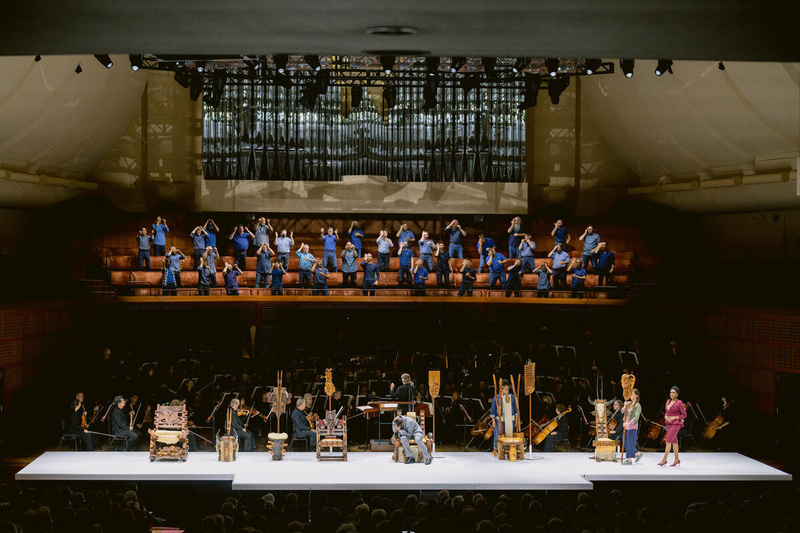
Esa-Pekka Salonen, conductor, and Sean Panikkar, Oedipus, with Laurel Jenkins, dancer, and J'Nai Bridges, Jocasta
Over the acting platform, the orchestra and the chorus loft hung 4 huge, black lighting trusses with bevies of lighting instruments hanging from them. An impressive, terrifying sight, it added a monumentality to the proceedings, the deserved monumentality for one of western civilization’s great tragedies. Interestingly this sense of importance was not captured in the fully staged production at the Aix Festival, its space limited to the dimensions of a stage box. As well in Aix the protagonists were white Europeans (with the exception of Willard White, an important bass in Europe at that time). Thus the Aix production was deprived of Sellars fascination of exotic civilizations and the politics of color.
Peter Sellars resolves his sacrificial Oedipus into the songs of salvation and praise of Stravinsky’s Symphony of Psalms, capturing at the conclusion of the first Psalm the magnificence of God by illuminating the pipes of the grand organ in golden light. The chorus is now the full San Francisco Symphony Chorus, again as statues with frozen gestures, singing the Latin texts from Psalms 138,139 and 150, Psalm 150 Stravinsky once described as a dance.
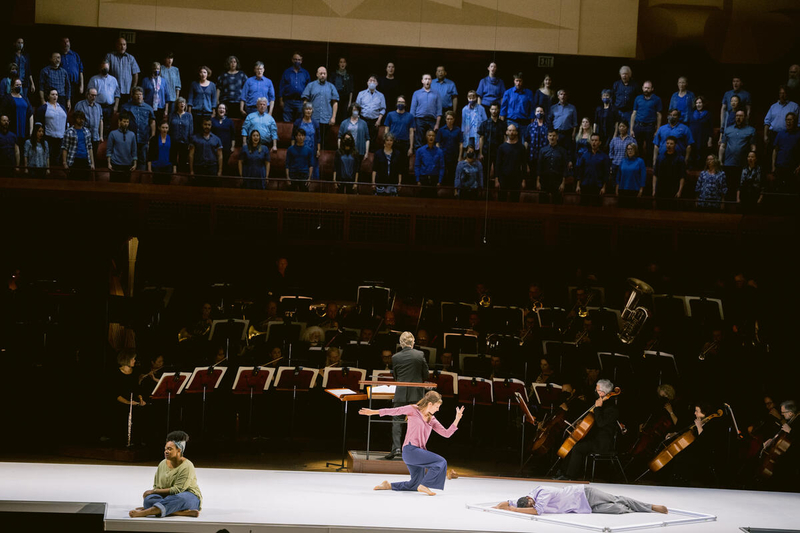
Breezy Leigh, Antigone; Laurel Jenkins, Ismene; Sean Panikkar, Oedipus rex; Esa-Pekka Salonen, conductor
The San Francisco Symphony and Chorus in the Symphony of Psalms
Antigone’s sister Ismene, a Peter Sellars addition to Cocteau’s personae, had silently led all of Stravinsky’s Oedipus Rex actors onto the stage, and then in the Symphony of Psalms she led the blinded, now silent Oedipus across the stage into an illuminated space from which he assumed salvation, and disappeared. She danced this final hymn, adding the silent mystery of an actual human soul to Stravinsky’s extravagant praise of God. Though Stravinsky’s soft, luminously colored C major chord was the final sound of this magical and magnificent performance.
Additional production information
Lighting designer: James F. Ingalls; Costume designer: Helene Siebrits
All photos by Kristen Loken, courtesy of San Francisco Symphony
Davis Hall, San Francisco, June 12, 2022
Don Giovanni at San Francisco Opera
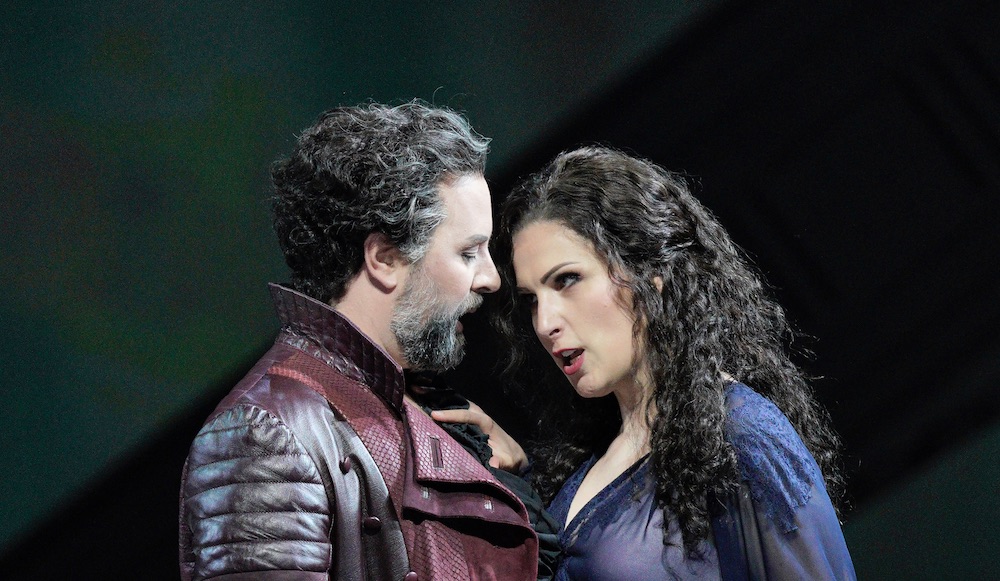
Don Giovanni, Etienne Dupuis, with Donna Anna, soprano Adela Zaharia
The crowning jewel of Mozart’s operas has arrived at the War Memorial Opera House, San Francisco Opera now completing, finally, the Covid thwarted rollout of an integrated Mozart/DaPonte trilogy.
The trilogy has been staged by Canadian director Michael Cavanagh, mining American cultural histories first in the Jeffersonian world of black slaves and its pursuit of liberty, then in the genteel world of Southern comfort in the smug complacency of a repurposed Colonial mansion, now a country club. But in Don Giovanni, director Cavanagh creates American history by imagining the state of Virginia in the year 2080, a sort of deconstructed Monticello (a neoclassical abstraction thereof) as a post apocalyptic ruin, its façade draped in tattered strips of stars and stripes.
French conductor Bertrand de Billy obliged Mr. Cavanagh with a great big, sweeping, sometimes violent reading of Mozart’s overture that well supported the Armageddon action projected on the show scrim — though amidst the flames and smoke we really couldn’t know what was the good and what was the evil. A lot of things did come to mind, none seemed relevant.
What and who was left was Leporello’s shopping cart and a hand turned generator that could illuminate a small lamp (as well as project the mille tre names of Don Giovanni’s Spanish conquests onto the Monticello façade). And, besides the fashionably, late twenty-first-century-attired aristocrats, a rag tag group of Mozart’s peasants, some obviously homeless, others dressed like the festive vagabonds of San Francisco’s Haight Street (a remnant of its last century Flower Child culture).
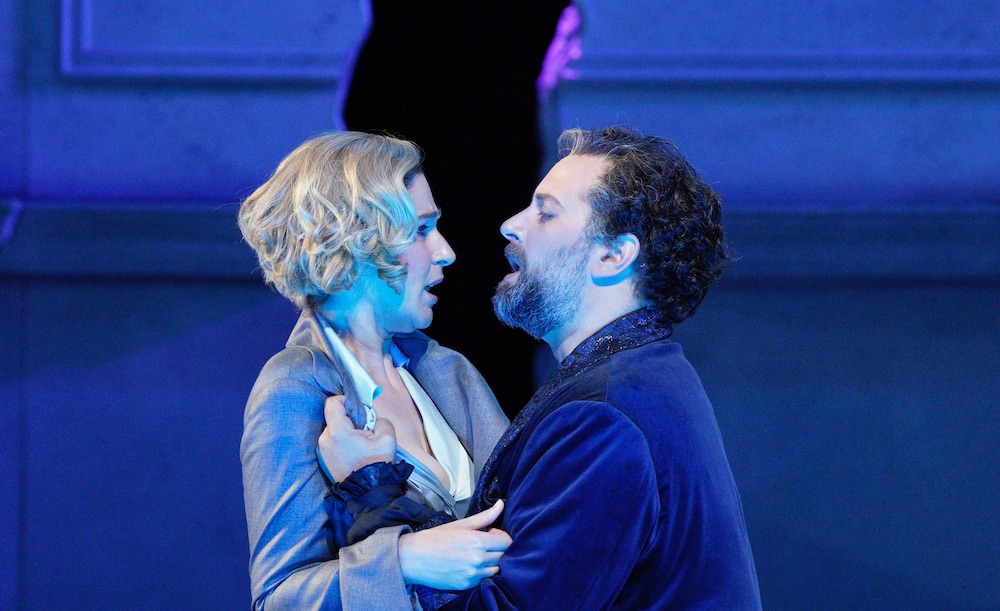
Nicole Car as Donna Elvira, Etienne Dupuis as Don Giovanni
Present most of all was libido, pure and simple — the irrepressible libido of Don Giovanni, though there seemed no general shortage.
The stage bathed in an apocalyptic yellow light, Don Giovanni slaughtered the Commendatore, bantered with Leporello, avoided the love-crazy Elvira as best he could, assuaged the orphaned Donna Anna as best he could, seduced Zerlina, — masterfully to say the least, manipulated Leporello ruthlessly, and grandly and heroically met his fate amidst the flames (quite real) of hell.
Though set in the rubble of annum 2080 it was an absolutely straight forward reading of the DaPonte libretto. Relaxed, easy and deeply thorough.
The action flowed seamlessly, maestro de Billy finding a sweep of sound that filled the 3000 seat opera house, encouraging a beauty of tone that complemented the beauty of voices on the stage (and they were indeed beautiful). The great second act prima donna arias, Donna Elvira’s “Mi tradi quell’alma ingrada” and Donna Anna’s “Non mi dir,” were notable for a graceful lyric flow that rendered them absolutely magical works of art — art that only unfettered libido could possibly engender.
The entire Michael Cavanagh’s trilogy was above all witty and charming. In the Don Giovanni however these myriad moments of wit and charm were but the cornerstones of Mozart’s classically structured arias and finales, forms that took on new, unexpected monumentality against this destroyed vision of America’s cultural neoclassicism.
A master of moving his actors around the stage, in Don Giovanni Cavanagh made much use of the stage’s fourth wall (the proscenium opening), Leporello sighting the Commendatore’s tomb first out there in our midst as example. But he used the fourth wall most of all when Mozart’s actors literally “hit the wall” — nothing to do but sing about what had happened. Thus they simply lined up across the front of the stage, faced the [transparent] wall and held forth in our faces.
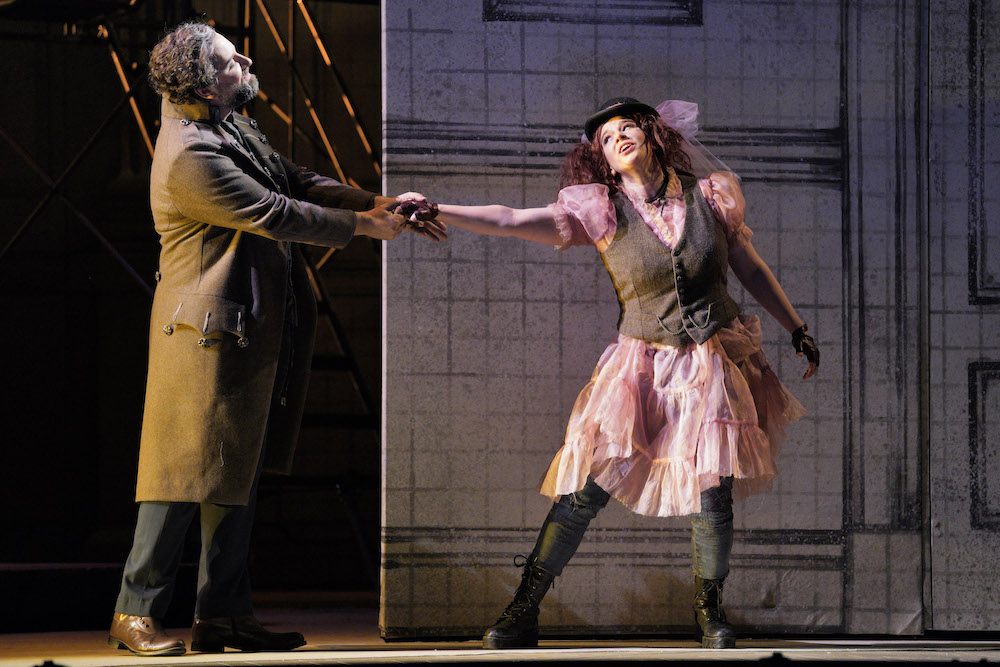
Etienne Dupuis as Don Giovanni, Christina Gansch as Zerlina
This was the formation for Mozart’s encomium to the opera’s denouement. Giovanni dispatched into hell, his survivors line up across the stage in front of the scrim on which the apocalypse had been projected. Monticello, dimly behind, is somewhat reconstructed. But they in fact have nothing much to say other than memorialize the just desserts of he who does evil on earth — “quest è il fin di chi fa mal.” But what evil can it be (toxic masculinity?) that inspires such magnificent music?
In addition to this imposing house debut of conductor Bertrand de Billy, there were four cast debuts, Australian soprano Nicole Car as Donna Elvira, German soprano Adela Zaharia as Donna Anna, Canadian bass baritone Etienne Dupuis as Don Giovanni and American baritone Cody Quattlebaum as Masetto, formidable artists currently performing these and other roles in the great theaters of the western world.
These high octane performances were indeed equaled by Austrian bass baritone Luca Pisaroni (once a SFO Figaro) as an easy going, new age Leporello. Zerlina, was presented as a big, new forceful and very charming presence by Austrian mezzo Christina Gnash (once at SFO for Handel’s Orlando). The able presence of Adler alumnus Amitai Pati made the fine, hapless Don Ottavio. Excellent bass Soloman Howard sang Donna Anna’s father, the Commendatore.
Aspirational casting.
Production information:
Stage Director: Michael Cavanagh; Set and Projection Designer: Erhard Rom; Costume Designer: Constance Hoffman; Lighting Designer: Jane Cox. The San Francisco Opera Chorus and Orchestra. Conductor: Bertrand de Billy. War Memorial Opera House, San Francisco, June 10, 2022.
Radamisto in Palo Alto
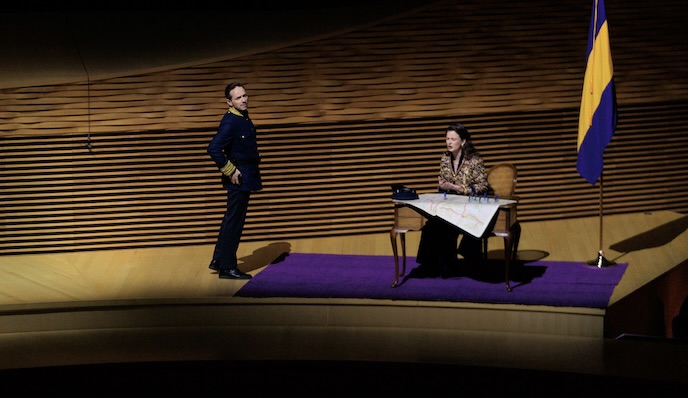
Iestyn Davies as Radamisto, Liv Redpath as Zenobia, all photos copyright Nikolas Liepins, courtesy of the Bing Concert Hall.
In some ways the Philharmonia Baroque’s Radamisto did not disappoint San Francisco Bay Area’s Handel fans.
Handel is no stranger at San Francisco’s esteemed Philnarmonia Baroque Orchestra, just now it was Radamisto, his first opera (1720) for King George II’s Royal Academy of Music. Upcoming this fall is Theodora (1750), Handel’s only dramatic oratorio (i.e. opera, no sets) on a Christian subject, and in April 2022 comes a staged Amadigi di Gaula (1715), composed soon after his migration to Italian-opera-crazed London.
Radamisto was a big hit at the Kings Theater back in 1720, thus impresario Handel revived and revised it later in the same year for famed castrato Senesino, and revived and revised it again and again for other specific singers over the next few years. At Stanford University’s Bing Concert Hall just now the PBO revived Handel’s 1728 version for Senesino and two famed divas named Faustina and Cuzzoni (or maybe one of which was named Faustina Cuzzoni).
In Palo Alto famed counter tenor, Iestyn Davies, star of Broadway and the West End’s recent Farinelli and the King (and the world’s major opera stages), sang Radamisto, whose sister Polissena was sung by soprano Ellie Laugharne, famed as a renowned Eliza Doolittle (My Fair Lady) of our current moment. Radamisto’s wife Zenobia was sung by Liv Redpath, maybe not so famous, but she has already found her way to the stages of the Deusche Oper Berlin as Lucia, Munich’s Bayerische Staatsoper as Sophie, and at the Hollywood Bowl with the L.A. Philharmonic! [The lead photo is Mr. Davies (Radamisto) and Mlle. Redpath (Zenobia), all photos copyright Nikolas Liepins, courtesy of the Bing Concert Hall.]
Handel operas are all about singing (one aria after another) and nothing else. Normally there are six or so singers per opera (though the upcoming Amadigi di Gaula has but four). Thus the balance of the Philharmonia Baroque’s cast were virtuoso singers of various fames as well. Namely Radamisto and Polissena’s father Farasmane, sung by baritone Morgan Pearse, who didn’t have a lot to say. Polissena’s husband Tridate, king of Armenia, sung by bass baritone Aubrey Allicock, who had quite a lot to say, and his lieutenant Tigrane, sung by mezzo soprano Wallis Giunta, who hopelessly loves his boss’s wife and who gets in the way of most everything, and who finally gets his way. At least in this production.
But Handel singers do have to have something to sing about. Polissena laments that her husband doesn’t love her, but later pleads for his life as her wifely duty. Tridate, helplessly in love with Zenobia, overruns Farasmane’s kingdom to get her. Zenobia, as her duty, will sacrifice herself to Tridate to free her people, Radamisto loves his wife and she loves him, Farasmene prefers to die rather than have his son’s wife sacrifice herself. Etcetera.
Finally, hours later, Tridate in a grandiose tirade sees the error of his ways and leaves the stage, everyone else sings together, at last.
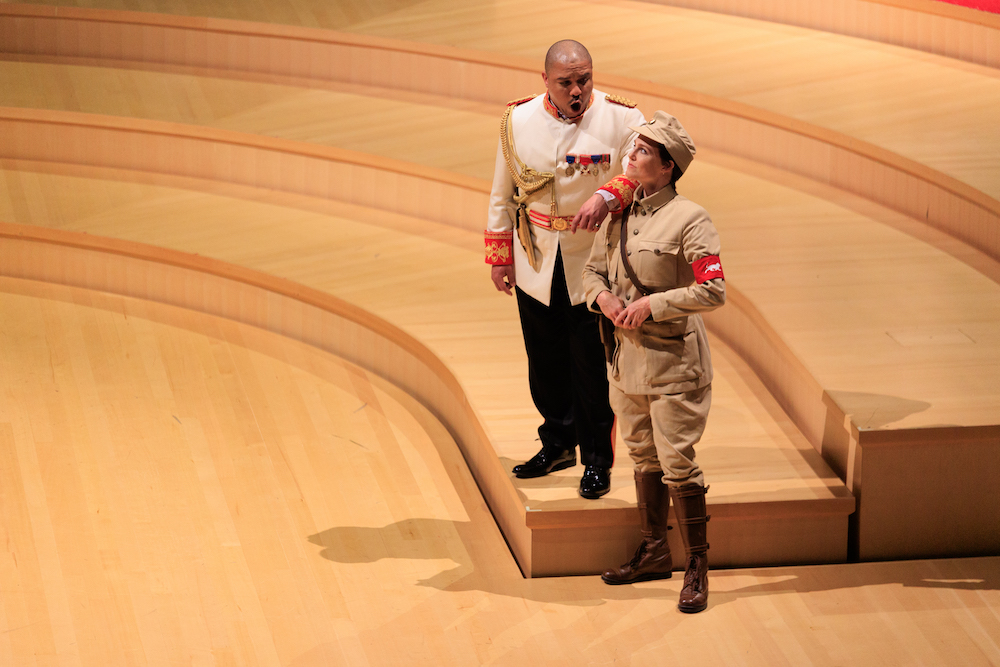
Aubrey Allicock as Tiridate, Wallis Giunta as Tigrane
Where were the 33 players of the Philharmonia Baroque Orchestra and its esteemed music director Richard Egarr in all of this? Sequestered upstage behind the maze of moving platforms that is the stage of the acoustical contraption called the Bing Concert Hall (842 seats). On can imagine a Mahler symphony spread out at various levels on these platforms, or a concert performance of Götterdämmerung with its six harps and eight horns. As it was the Radamisto orchestra, dimly visible, sounded faraway indeed.
Staged opera also has a history at the PBO, most notably Christopher Alden’s COVID-eve, avant-garde conception and imaginative staging of Handel’s dramatic cantata Aci, Galatea e Polifemo (1708). Thus anticipation of this Radamisto was high.
French stage director Christophe Gayral was entrusted to stage this PBO’s production. Seduced by the Bing Concert Hall’s complex of stage platforms, Mr. Gayral changed the golden wood floor geometry of the vast stage space many, many times, generally placing Handel’s costumed singers quite distanced from the orchestra, and always with no contact to conductor Richard Egarr. It was visually and acoustically troublesome. The stage was somehow illuminated by stage director Robert Carsen’s lighting designer Peter van Praet. In spite of the lighting instruments residing at extreme distances from the stage floor van Praet managed to find various intensities that created what few theatrical atmospheres occurred.
Finally, unfortunately, it was an evening of little more than some spectacular singing.
April 24, 2022, Bing Concert Hall, Stanford University, Palo Alto, California.
West Side Story in San Jose
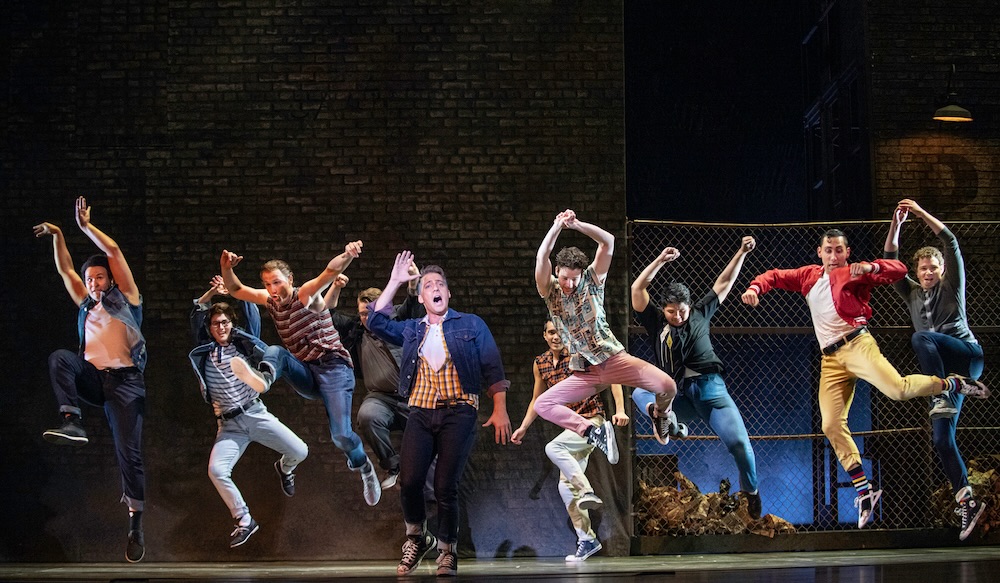
The Jets
No one can deny that Leonard Bernstein’s West Side Story is one of the bigger moments in twentieth century theater. Its movies may be Oscar worthy films, but finally its stagings are the only true realization of this American masterpiece.
West Side Story opened on Broadway in 1957 and in London’s West End in 1958. Its revivals have not been rare— major Broadway and West End tours have occurred every decade since. But you had to be in the right place at the right time to catch one (I never was).
Opera house stagings with larger musical forces for the Bernstein masterpiece are not unknown either, notably Houston and Glimmerglass (2018). And specifically, now in San Jose, this 2018 production created for Indiana University Jacobs School of Music Opera and Ballet Theater.
And too there are often concert or semi staged performances around the world, thus avoiding the work’s major challenge — four enormous scenes danced by the Sharks and the Jets with their girlfriends.
Just now I was finally in the right place at the right time (I had not seen a staged West Side Story since 1957), Opera San Jose mounted this splendid production, the full nine yards — a real orchestra (44 players) to support the 33 named principals who, to a man, could sing and dance and act, plus an army of stagehands and electricians to move and illuminate blocks of scenery that instantly transformed the stage from the streets of New York to Bernardo and Anita’s apartment, then into the bridal shop, the dance hall, the L train rumble. Ultimately we arrived at Doc’s drug store for Jerome Robbins and Stephen Sondheim’s wrenching denouement that unfolded to the orchestral echos of Bernstein’s now soul searing love music.
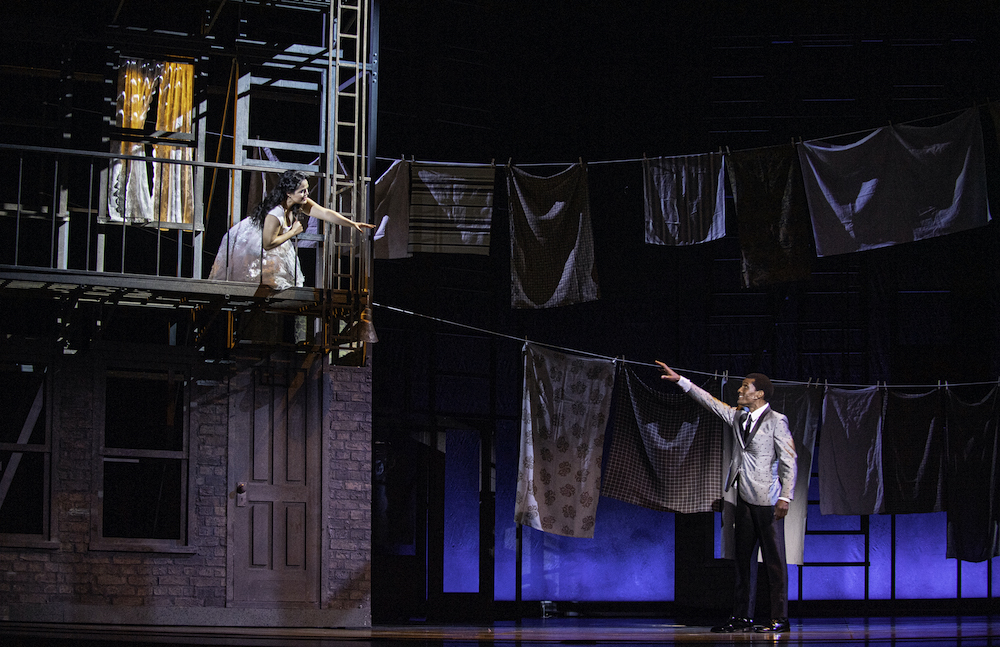
Not to mention the Romeo and Juliet balcony, now a fire escape! The Shakespeare, Bellini and Gounod tragedies had not prepared us for the artistic and political upheavals of the mid twentieth and now those of our own fire escape moment. And these upheavals were indeed blatant just now on the Opera San Jose stage.
It may be that the Bernstein Foundation prohibits tampering with the original conception of the opera. The recent Spielberg movie, then, is an exception, avoiding the scary politics of caricaturing an ethnic group. But the time (50’s) and place (NYC) were definitely respected in San Jose, and Maria was sung by Latina American soprano Teresa Castillo, though there is the suspicion that her charming Latino accent was not her own.
Unlike the Gershwin Family that insists on color coded casting for Porgy and Bess, Opera San Jose cast black American opera singer Noah Stewart as the Polack Tony (aka Anton) — though his Polack best friend Riff, played by musical comedy singer Trevor Martin, was pure white bred.
Opera is color blind, except it isn’t. Tenor Noah Stewart is an excellent singer, as is Teresa Castillo, Both are affecting performers with beautiful, well used voices that easily traverse the operatic repertory. Here both singers emphasized careful operatic diction that propelled their solos and duets from their theater song roots into the rarefied realm of operatic arias.
Likewise "Somewhere" was sung Puerto Rican operatic soprano Natalie Santaliz transforming this soaring dream into a moment of high art both vocally and visually, as it was danced en point by a classical ballerina in white tutu, supported by her black, white-clad danseur.
Pivotal to the celebration of the sacrificial deaths of Tony and Bernardo was the role of Anita, Bernardo’s fiancé, sung by operatic soprano Natalie Rose Havens. Mlle. Havens rose to quite moving emotional heights in her "A Boy Like That / I have Love" duet with Maria, and in her final, brutal confrontation with the Jets. Her fiancé Bernardo, sung by musical comedy artist Antony Sanchez, well held his place as head of the Sharks, indeed the flashiest dancer of the evening.
The production was an astonishing submersion of high art into contemporary political discourse within the amazing energy of a popular art form!
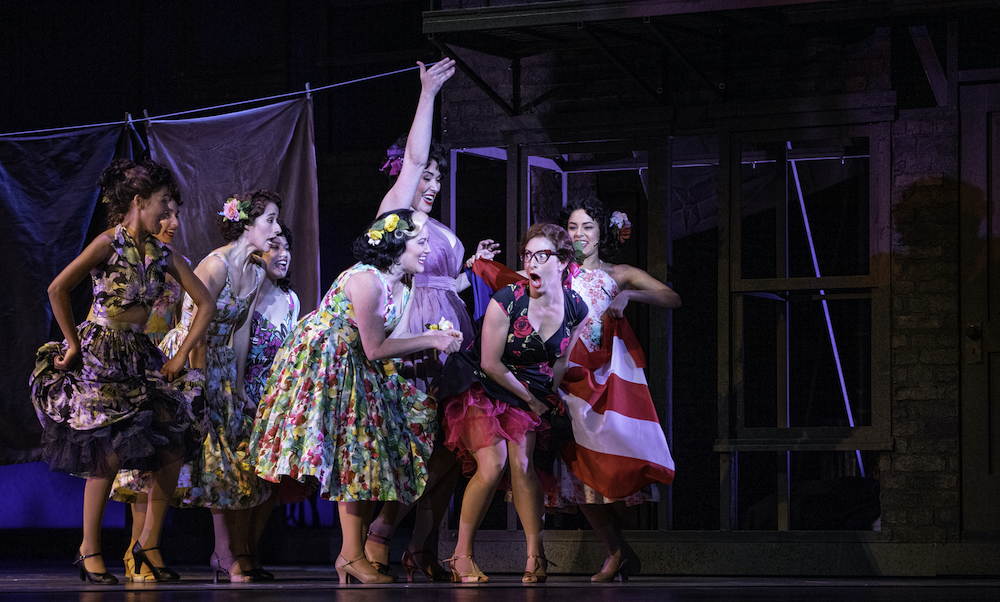
"America" (Ahm-may-ree-cuh)
Opera San Jose well met the huge challenge of casting the Jets and the Sharks and their Molls, the Sharks perhaps a bit more bronze colored, a few more Latino names. Of great fun was the "America" (Ahm-may-ree-cuh), the role of Rosalia beautifully sung and danced by Christine Capsuto-Shulman. Of special notice was Doc, sympathetically and grandly played by well-known Bay Area basso Philip Skinner (who did not sing a note).
The original, 1957 production of West Side Story needed a two month dance rehearsal period. Hopefully it took less in San Jose. Choreographer Michael Pappalardo respected the movement precedents set by Jerome Robbins with all needed energy, moving his dancers through these huge scenes with seeming ease — though the process will surely have been painstaking. Not to mention the choreographic flourishes added to the smaller numbers.
This sprawling masterpiece was scenically realized, masterfully, by stage director Crystal Manich (born in Puerto Rico BTW), in appropriately generic, manageable sets designed by Steven C. Kemp, and appropriately 1950’s costumes designed by Linda Pisano. All this ably and sensitively lighted by Sarah Riffle.
Conductor Christopher James Ray gave us the tempos we expected while accommodating the specific qualities of his singers and dancers on the stage, and confirming the masterpiece status of Bernstein’s opera.
Cast and production information: Principals Maria: Teresa Castillo; Tony: Noah Stewart; Anita: Natalie Rose Havens; Riff: Trevor Martin; Bernardo: Antony Sanchez; Chino: Jared V. Esguerra; Doc: Philip Skinner. Orchestra of Opera San Jose. Conductor: Christopher James Ray; Stage director: Crystal Manich; Choreographer: Michael Pappalardo; Set designer: Steven C. Kemp; Costume designer: Linda Pisano; Lighting designer: Sarah Riffle. California Theater, San Jose, California, April 21, 2022.Cosi fan tutte in San Francisco

Cosi fan tutte (1790), the little sister of the Mozart Da Ponte trilogy, was mounted last night in the same set used by its older brother The Marriage of Figaro (1786) that began San Francisco Opera’s new, integrated version of the trilogy before Covid shut everything down.
One may presume that the trilogy’s most powerful sibling, Don Giovanni (1787), set for this June at the War Memorial Opera House will use again this same abstracted household some say to be Thomas Jefferson’s Monticello though architecture historians disagree.
In stage director Michael Cavanagh’s San Francisco Da Ponte trilogy this architectural monument to the Enlightenment (the French intellectual moment that gave us our Constitution and Bill of Rights), has become a pleasure palace, the Wolfbridge Country Club, Don Alfonso general manager. Let’s place it somewhere in Virginia.
Though Thomas Jefferson is now infamous as a slave owner.
PHOtO Irene Roberts as Dorabella, Nicole Heaston as Despina, Nicole Caball as FiordiligiOpera is color blind (SFO’s recent Fidelio as example) but it isn’t, thus in director Cavanagh’s Marriage of Figaro both Figaro and his bride Susanna were of color (black). Jefferson’s home has now become The Wolfbridge Country Club, frozen in time into the 1930’s by costume designer Costance Hoffman’s very witty, broad abstractions of provincial period fashion, and very witty takes on period set accoutrements (treadmills, easels, martini glasses, etc.) The quick scene changes were a tour de force of stage management.
Since opera is colorblind but isn’t Despina, a country club employee/servant, was of color (black), and like Figaro, Despina was the moral conscience of the opera, such as it was, reveling in the hedonism of the well fed, indulged lives of the country club set back then — where were the cigars? — with plenty of indulgent, condescending humor.
All this allowed for the really fun, spoofy tableaux that opened many of the scenes set in the myriad of spaces that director Cavanagh and his witty designer Erhard Rom invented to help us get through this long, very long opera — most notably a parade of aged males in swimming attire. But all this witty action was quickly shooed off the stage, leaving us alone with Mozart’s Cosi fan tutte sung mostly standing just in front of the prompter box.
Fortunately the rewards were great, starting with the splendid reading of Mozart’s overture by Hungarian conductor Henrik Nánási, the musical mastermind behind the San Francisco trilogy. The orchestra pit was made less deep, allowing a vivid, balanced presence for a 45 count San Francisco Opera Orchestra. It was very pleasurable music, wonderfully colored by wind solos made wittier by the accompanying, projected graphic depictions of 30’s silhouettes (cars and people) that enlivened the architectural schematics of the 18th century house of the show curtain.
Conductor Nánási finds a wonderfully flowing lyricism in his Mozart, eschewing the emotional intensities that other conductors may find in Mozart operas. This maestro favors a beauty of line and tone that is most appealing. The Cosi fan tutte story favors, obviously, much vocal writing in parallel thirds and sixths, smooth harmonies that resulted often in parallel physical movements of the protagonists in the Cavanagh staging. The more intense musical moments of Mozart’s opera occurred when the front of the Jefferson house was a closed wall all across the stage, the heroine alone with her music. There was resplendent lyricism in abundance.
The complex and subtle dramatic context (though maybe way too obscure to perceive) and very subtle musical drama were enveloped within the gentle humor of the production.
In the end in fact the heroines amusingly donned mustaches (the emblem of disguise in the opera) to give their tormentors a taste of their own medicine, Despina evidently was surprised to learn that the Albanians were the original fiancés, and everyone exited the wild finale through separate doors.
PHOTO John Brancy as Guglielmo, Ben Bliss as FerrandoSan Francisco Opera assembled an excellent, balanced cast for this production, anchored by bass Ferruccio Furlanetto. This venerable Italian buffo provided solid vocal and histrionic management of the country club, magisterial rather than whimsical. If soprano Nicole Heaston had made her fine San Francisco Opera last minute debut as the Countess in this trilogy’s Marriage of Figaro she found her true calling as Despina, a role she wholly owns vocally, and manages with mayoral aplomb. She was one of the great pleasures of the afternoon.
Soprano Nicole Cabell, remembered vividly for climbing the wall as Giulietta in San Francisco Opera’s 2012 I Capuleti ed I Montecchi, held the stage with equal authority as Fiordiligi, capturing the Mozart line in rich voice and impeccable intonation. Mme. Cabell’s voice was beautifully matched by mezzo soprano Irene Roberts as Dorabella, the two voices finding rich, warm vocal sympathy in their duets. Mlle. Roberts played the fun and humor of her character in uniformly even singing, not having been asked to explore Dorabella’s darker sides.
Tenor Ben Bliss played Ferrando to the hilt, unfazed by the swimming suit and other ungainly period costumes. His voice is of even strength from top to bottom allowing him to extol the Mozart line to its utmost. It was quite beautiful singing. Baritone John Brancy as Guglielmo reveled in the fun of the costumes, and obviously enjoyed his well made character. He is a fine singer, well matched to Mr. Bliss in the many duets they shared, and in his arias.
Michael Milenski
Cast and Production:
Fiordiligi: Nicole Cabell; Dorabella: Irene Roberts; Ferrando: Ben Bliss; Guglielmo: John Brancy; Don Alfonso: Ferruccio Fulanetto; Despina: Nicole Heaston. Chorus and Orchestra of the San Francisco Opera. Conductor: Henrik Nánási; Director: Michael Cavanagh; Set and Production Designer: Erhard Rom; Costume Designer: Constance Hoffman; Lighting Designer: Jane Cox. War Memorial Opera House, San Francisco, CA, November 21, 2021.
Fidelio in San Francisco

A superb cast, a fine production, inspired conducting, classy orchestra and a classy chorus, a wired audience — it was Fidelio last night at the War Memorial Opera House.
To boot, long overdue new chairs in the opera house, more comfortable with more legroom for the masked and vaccinated spectators. All in all it was a triumphant return of actual world class opera to San Francisco.
Soprano Elza van den Heever shone as the Fidelio of your dreams. Her voice clear and strong, her presence magnetic, majestic. As Florestan’s wife Leonore she commanded the stage realizing the opera’s goal of saving this political prisoner from an ugly death. Her impassioned first act aria “Komm, Hoffnung, lass den letzten Stern” (“Come, hope, let the last star”) earned a remarkably huge ovation.
PHOToTenor Russell Thomas as the delirious, starving prisoner Florestan radiated musical elegance in his beautifully voiced vision of his savior, Leonore, and held the stage with consummate dignity through to the eventual, sublime moment when his chains are removed.
Mme.Van den Heever’s Fidelio shone in spite of the blue denim coveralls and cap she wore, somehow meant to be a uniform of the security or more likely, custodial staff at some sort of heavily bureaucratic (lots of file boxes and very busy personnel) contemporary detainment center somewhere. The set, designed by Alexander V. Nichols, was a two sided open metal super structure dressed with TV screens and lines of industrial neon lights. The massive structure gracefully revolved to a new position for each of the opera’s scenes, the prevailing black background becoming a blinding white for the opera’s triumphant finale. The structure, now fully transparent, its neon lights fully aligned in infinite parallels, achieved, finally, its moment of liberation. It was a huge, and quite magnificent effect.
Maestra Eun Sun Kim urged the final, Rossinian strepitosissimo moments of Beethoven’s complex finale to shattering, fortissimo levels, the seventy-two voices of the San Francisco Opera Chorus joining Florestan and Leonore, the jailer Rocco and the minister Don Fernando, and the first act refugees, Marzelline and Jaquino — the arch-villain Don Pizarro having been unceremoniously hustled off the stage — in full voice celebration of an impassioned ode to conjugal loyalty. The audience went wild.
If stage director Matthew Ozawa seems a bit vague as to what this was all about, Beethoven certainly was not. In modern, everyday dress director Ozawa’s prisoners were men, women and children who could have been you and me, though some were in yellow (low risk) prison jumpsuits, leaving it uncertain as to why we were imprisoned. Beethoven nonetheless responded with his sublime ode to freedom "O welche Lust" ("O what a joy”).
Fidelio was originally a French play set in Spain, one grandee exposing the crimes of another. The accuser, abducted and secretly imprisoned, is saved by his wife who infiltrated the prison disguised as a man. Variations of this “rescue” plot were wildly popular during the very recent French Revolution, satisfying an understandable need to escape whatever. Stage director Ozawa with the obvious relish of San Francisco Opera’s Wotan, bass baritone Greer Grimsley, created an anonymous, business suited villain from whose rhetorical vileness (i.e. caricature) you really wanted to distance yourself.
This was the first act. In the second act Don Pizarro was (as all of us were) caught up in Beethoven’s massive musical structures that spoke to the genius of conductor Eun Sun Kim. Ma. Eun is a big conductor. The second act of Fidelio is big music, its philosophical terms are heroic. The maestra ran with with her superb singers and her powerful orchestra to create a truly thrilling tribute to Beethoven’s muse, and to the dignity of humankind.
PHOTO Don Fernando with entire cast of FidelioPuzzling however was the arrival of the minister from Seville, Don Fernando. Costumed in a natty, bright blue business suit, bass Soloman Howard strode onstage with cocky confidence. While this entrance did indeed add zing to the proceedings, it unbalanced the musical gravity of the moment. Puzzling also is the seating of all the winds at the extreme left side of the orchestra pit (except the trombones who were at the extreme right with the percussion). Though this placement allowed us to admire this colorful choir, particularly in the pomposity of this conductor’s take on Beethoven’s 1814 Fidelio overture, it was sometimes oppressive in the first act when the orchestra often overwhelmed Beethoven’s less heroic characters.
The jailer Rocco was sung by American bass baritone James Creswell who successfully navigated the gulf between the common man attitudes of the first act, and the dignity of the common man in the second act. Mr. Creswell was both folksy and sincere, and in beautiful voice, as were the Marzelline and Jaquino, sung by Adler Fellows Anne-Marie MacIntosh and Christopher Oglesby. Stage director Osawa’s detention center metaphor did not sit easily with the domesticity of Beethoven’s first act placing all these artists at a disadvantage, though the maestra’s Canon Quartet celebrating wondrous love (Fidelio, Rocco, Marzelline, Jaquino) came through with remarkable musical sublimity.
Michael Milenski
Cast and Production:
Fidelio: Elza van den Heever; Florestan: Russell Thomas; Don Pizarro: Greer Grimsley; Rocco: James Creswell; Marzelline: Anne-Marie MacIntosh; Jaquino: Christopher Oglesby; Don Fernando: Soloman Howard; First Prisoner: Zhengyi Bai; Second Prisoner: Stefan Egerstrom. Chorus and Orchestra of the San Francisco Opera. Conductor: Eun Sun Kim; Stage Director: Matthew Ozawa; Set & Projection Designer: Alexander V. Nichols; Costume Designer; Jessica Jahn; Co-Lighting Designers: JAX Messenger and Justin A. Partier. War Memorial Opera House, San Francisco, October 20, 2021.
The Barber of Seville by San Francisco Opera
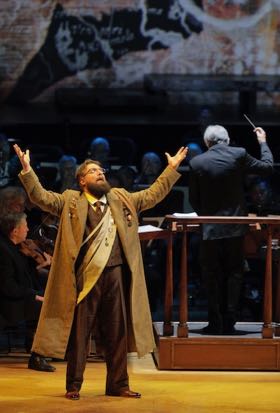
San Francisco has fielded, masterfully, a giganticized miniaturized version of Gioachino Rossini’s iconic masterwork Il barbiere di Siviglia in a parking lot for hundreds of socially distanced cars.
It is jaw-dropping grand opera by all standards, notably the erection of a mammoth steel stage (120 feet wide, 55 feet high — a replica of that erected at the Coachella Festival) and the sheer audacity of concept. Which is to destruct opera buffa (a genre that evolved into its Rossinian perfection from classical Roman comedy over about 1800 years) onto a rock festival landscape, or maybe into a Burning Man operatic wet dream.
PHOTO, no captionThe classic Roman comedy plot (youthful innocence prevails over age and greed) was wittily destructed as well. To wit: Rosina was already robustly pregnant with Lindoro’s baby at the get go, thus Bartolo did indeed have a lot to rage about, though he pretended not to notice, or maybe it didn’t matter anyway. Meanwhile Basilio obviously was stricken with Covid, a suspicion we had from the Act I finale where he was distantly placed, un-costumed, on the very edge of the carefully socially distanced principals lined up across the stage (Figaro and Lindoro had earlier marked out a careful six feet with a measuring tape).
PHOto Alek Shrader as Lindoro, Philip Skinner as BartoloWith all the superimposed antics (it was a play within a play) not much was left of Rossini’s carefully crafted comic masterpiece. Operatically it was reduced to a ninety minute or so exposition of Barber’s hit tunes and crazed ensembles taken out of order (absolutely no recitative). The show began with “Largo al factotum.” “La calunnia,” sung from Basilio’s obvious quarantine, came near the end. The act II storm and finale were severely curtailed and things came to abrupt conclusion, first in a quite abstracted, formal concert performance of the trio of resolution, “Ah qual colpo”, then in a chorus-less celebration.
PHoto Lucas Meachem as Figaro, Alek Shrader as Lindoro, Daniela Mack as Rosina in "ah qual colpo" standing before a projectionAt last, the conceptually cacophonized Barbiere spent, came a huge cacophony of automobile horns [motorcycles were not admitted, nor were convertibles] that blasted the huge pleasure had by these hundreds of cars, and the joy of their occupants at the rebirth of a vibrant, alive San Francisco Opera!
But these were not all the glories. Musically and vocally the evening was of accomplishment and interest. The orchestra (seen on the side screens from time to time) was 18 players from the San Francisco Opera Orchestra — single winds and just enough strings to blend their sounds — seated socially distanced [what else] in a tent behind the stage. The lightness and transparency of sound allowed conductor Roderick Cox an alacrity that approached from time to time the famed, elusive Rossini delirium (a huge accomplishment), and always underscored the wit of the production with tempos suited exactly to his singers.
The sound was broadcast into our cars by FM radio. A triumph of the evening was the mixing of the sound, each voice clearly heard in the huge ensembles (simply not possible in an opera house), the superimposition of words was distinct adding a novel dimension to the musicality of these monumental structures. Parked close to the stage I could not see the supertitles projected hugely [too hugely] above the stage, but there was no need, as the quality of the sound transmission and engineered balance with the orchestra allowed the singers’ crystal clear English diction to prevail.
The revised story (putting on an opera mostly) allowed the singers to move from dressing room and rehearsal informality to performance formality. This was most pleasurable in the performances of Daniela Mack (Rosina) and her real-life husband Alek Shrader (Lindoro). Mme. Mack exhibited vocal fireworks aplenty, disguising “una voce poco fa" into an almost unrecognizably new virtuoso aria (it is said that pregnancy enhances vocal production). Mr. Shrader displayed a charming elegance of tone and delivery throughout the considerable acting antics required by the role.
It was easy to appreciate bass Philip Skinner as a brash, brusque Bartolo in the context of this production. He sold his aria “a un doctor della mia sorte” with fine conviction, hitting the wall however when it came to the patter where true Rossinian elegance is required. Bass baritone Lucas Meachem brought his well known, often seen at San Francisco Opera swagger to his well sung Figaro, as did mezzo Catherine Cook in her usual SFO stage persona. Of special note was the Basilio of bass Kenneth Kellogg who delivered his sequestered “la calunnia” in beautiful voice.
The production was masterminded by American stage director Matthew Ozawa, a former assistant director at San Francisco Opera. Unlike most of us, perhaps Mr. Ozawa has been to the Coachella Festival and Burning Man, making his considerable accomplishment with this production maybe explicable. Set and projection designer Alexander V. Nichols conceived an amazing, always evolving visual structure made of two levels divided into multiple rooms, and four huge sliding panels that moved back and forth to provide the screens for a panoply of projected images. Colored asymmetric graphic lines were sometimes used to outline the tiny (by comparison) live performances from their huge video projections that could seen by cars in distant fields (see lead photo, Lucas Meachem as Figaro in his War Memorial Opera House dressing room}.
It is impossible to fathom the myriad of technical requirements of such a production. Whatever challenges there may have been, they were well met. The production was impressively polished on every level.
Michael Milenski
Gioachino Rossini: The Barber of Seville
Figaro: Lucas Meachem; Rosina: Daniela Mack; Almaviva: Alek Shrader; Doctor Bartolo: Philip Skinner; Don Basilio: Kenneth Kellogg; Berta: Catherine Cook; Officer: Will Bryan. Members of the San Francisco Opera Orchestra. Conductor: Roderick Cox; Production: Matthew Ozawa; Set and Projection Designer: Alexander V. Nichols; Costume Designer: Jessica Jahn; Lighting Designer: JAX Messenger. San Francisco Opera at the Marin Civic Center, April 27, 2021.
La Boheme at San Francisco's Fort Mason Drive-in Movies
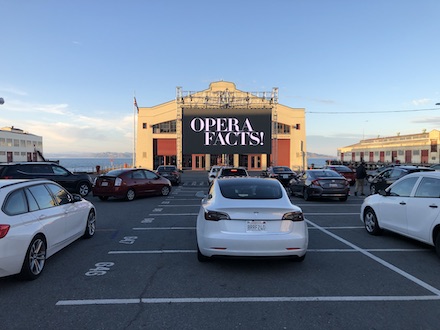
The Tesla parked directly in front of me waiting for La Bohème to be on-screen.
Well, maybe it wasn’t an opera house, but it was somewhere to go for opera beyond your living room. It was festive indeed to join a few hundred diehard aficionados for an actual opera performance, be it a recorded performance that happened in November 2008.
This was however a Bohème for the ages. Music director designate Nicola Luisotti previewing his nine momentous years to come at San Francisco Opera, Piotr Beczala as Rodolfo previewing the Lohengrin he became not so long ago in Bayreuth, Quinn Kelsey as Marcello previewing the Rigoletto he has assumed on the world’s major stages. The Mimi was Angela Gheorghiu in full diva form (on the rebound from having been fired by Lyric Opera of Chicago for skipping rehearsals to visit her then husband Roberto Alagna who was singing at the Met). You can see her as Tosca at the Semperoper this November 28 if you could somehow get to Dresden.
And La Bohème has come a long way too in these twelve years, as is witness the 2019 La Boheme at the Paris Opera where, no longer San Francisco Opera’s kitsch garret, Caffe Momu and snow flurry, it is the astronaut Rodolfo, lost in outer space, who dies, his oxygen supply depleted.
The screen version of this now retired San Francisco Opera production focuses on faces. The musical intimacy that so infused the live performances those many years ago came into a physical intimacy that rendered the heartbreak of these young Bohemians even more apparent. In my review of the 2008 performance I did not recognize the deeply moving contributions of the Musetta of Norah Amsellem, the Colline of Oren Gradus, and the Schaunard of Brian Leerhuber, these excellent portrayals deftly directed by Harry Silverstein.
La Bohème at San Francisco Opera, a review of the 2008 production.
On the not-so-big screen at San Francisco’s Fort Mason Drive-In we could easily participate in the Act I seduction, Mimi seemingly in full health and happiness, oozing the fun of youth and life on the streets of Paris, we could feel up close the confused, emotional turmoil of the Act III separation, and finally address, full face, the quiet, at first un-noticed by others, death of Mimi. If ever there was a cast to make the La boheme video this was it.
As it was in Greek theater it is for us in the opera house, dramatic catharsis is a ceremony to be felt by community. And there we were, a couple hundred, socially distanced cars (as if cars socialize), in a parking lot between two old warehouses over the bay (hardly the sculpted seashell of the drive-in theaters of yore), to cathartically transcend the sacrifice of youth. Strangely, unlike recent political rallies, no overt appreciation was shared when the arias were artfully rendered, and finally there was no blaring of our car horns at the end to release the tragic tension we all must have felt.
We all drove away silently. It was wonderful to have been there.
Not that drive-in movie opera doesn’t have its problems. These days the sound is broadcast on FM to your car radio, the upside is that most cars have rather decent sound systems. Rarely used in our car, the default settings, we learned, favored the bass. While this well supported Mo. Luisotti’s rather frequent emotional surges it came to make them a bit mannered. We will figure out how to adjust the balance for the upcoming Tosca on December 12.
But most troublesome was the faulty broadcast, the sound underlined by a constant rattle that often moved to an instrumental solo, or treble vocal line. We overcame the urge to leave, agreeing to accept the highly distorted sound to be able to watch this superb cast move through Puccini’s masterpiece.
Less troublesome was the fogging of the windshield — it was cold and damp just there by the bay with our heated emotions inside the car. At first we lowered the windows to clear the fog, when that became untenable we had to start the car to activate the defroster. In current cars this illuminates lights inside and outside the car creating a visual distraction for the cars around us, akin maybe to someone seated near you in an opera house illuminating their cell phone to check their messages.
Cast and Production
Mimi: Angela Gheorghiu; Rodolfo: Piotr Beczala; Marcello: Quinn Kelsey; Musetta: Norah Amsellem; Colline: Oren Gradus; Schaunard: Brian Leerhuber; Benoit, Alcindoro: Dale Travis; Parpignol: Colby Roberts; Customhouse Sergeant: David Kekuewa; Customhouse Officer: Jere Torkelsen; Prune Vendor: Chester Pidduck. Conductor: Nicola Luisotti. Director: Harry Silverstein. Set Designer: Michael Yeargan. Costumes: Walter Mahonney.
La traviata at San Francisco Opera

Jonathon Tetelman as Alfredo, Pretty Yende as Violetta
Wondrous things do still happen at San Francisco Opera. Like the La traviata last night where conductor Eun Sun Kim built a perfect synergy with soprano Pretty Yende and tenor Jonathan Tetelman (lead photo), and baritone Simone Piazzola.
It is the operatic ideal when the music actually becomes character, the composer’s genius absorbing the raw emotion, distilling the emotion into a voice that envelopes our senses and our intellects — in short the operatic ideal is the same as the Apollonian ideal. Verdi’s opera La traviata was such a voice just now, told by three singers who perused its nearly infinite range of emotions in telling their stories.
Conductor Eun Sun Kim established the measure — a firm beat except when it had to pause. Her beat did not often breathe, thus pushing the voices to move with or around the beat, capturing the immediacy and urgency of a moment. And there were plenty of these moments, in fact the entire evening was such a moment.
Conductor Kim’s orchestra [she is San Francisco Opera's Music Director] sometimes competes with the stage for attention. But provide to her these singers who have the technique and musical importance to enter into her musical world, and her orchestra did indeed become one with the stage — in the intimate moments it was barely a whisper, and in the intense moments on stage is was all that was needed, no more. Her conducting was about measure, not about color — that was for the singers, and it too was largely about the rhythms of their words flowing through the conductor’s beat.
South African soprano Pretty Yende is surely the Traviata of the moment. She possesses a beauty of tone that exemplifies a virginal purity of emotion as well projecting sincerity of feeling. La Yende retains this purity and sincerity throughout her registers, from the softness and resignation in her lower voice in the third act “Addio, del passato bei sogni ridenti” to her sharp, full voice outbursts of rage in her midrange when she encounters Germont in Act II. From the intimacy of the discovery of her most intimate feelings in “È strano . . . ah! fors’è lui” to the flights of freedom in the stratospheric reaches of the soprano voice in “Sempre libera” (yes, she took the E-flat!).
La Yende is technically possessed by the role of Violetta, able to vocally realize every nuance of feeling in this complex fallen woman who tragically falls in love.

Simone Piazzola as Germont, Pretty Yende as Violetta
All photos copyright Cory Weaver, courtesy of San Francisco Opera
Alfredo’s father Germont was the domain of Italian baritone Simone Piazzola. Though young for the role (he is 37), he radiates a nobility of spirit in a unique baritone timber that resounds with tremendous authority and purpose. These attributes served him well as he established the god-given purity of his unseen daughter in the “Pura siccome un Angelo” and then cemented his parental authority by seeming to quietly demand rather than sing the “Di Provenza il mare” to the inexorable pulse of Eun Sun Kim’s Verdi baton.
American tenor Jonathon Tetelman brought big, beautiful Italianate voice to Alfredo. While the role does not offer Mr. Tetelman much (any) opportunity to thrill us with ringing high notes (he does sing Cavaradossi around the world) the role shone with a firm resoluteness of voice, rendering his love for Violetta as deep and sincere. His behavior at Baron Douphol’s party was therefore hugely disturbing, his anger at Violetta was wrenching. Finally, rather than soar to an emotional climax, Verdi asks him only to find the tenderness of his love. He sang his final duet with Violetta with his head buried in her bosom, the scene releasing an avalanche of emotion that overtook us all.
Of special note were the strong performances of Baron Douphol by Philip Skinner and the Flora of Taylor Raven, both roles firmly anchoring the happenings of the party scenes, the San Francisco Opera chorus was urged to extraordinarily spirited displays by conductor Kim, ever the showman.

Adler Fellow Timothy Murray (in tutu) as the Marchese d'Obigny with members of the San Francisco Opera Chorus
It was a new production, staged by Shawna Lucey. Given the extraordinary musical elegance of the Verdi masterpiece by the conductor and principal singers the possibility of imposing any staging concept was nonexistent, or irrelevant. The larger chorus scenes unfolded in a sometime-in-the-19th century crass lasciviousness. The sets were well-designed generic recreations of 19th century looks, catering to the supposition that future audiences will always prefer period settings. Fortunately the sets will easily accommodate the use of other costume looks, and other stagings as future decades roll by — the previous Traviata production (John Copley) endured for three.
The sets and costumes were designed by Robert Innes Hopkins, lighted by Michael Clark. Choreography was by John Heginbotham.
Verdi’s overture was left unstaged.
War Memorial Opera House, San Francisco, November 16, 2022Orfeo ed Euridice at San Francisco Opera

Jakub Józef Orlinski as Orfeo
One of opera’s most awesome scores came, finally, to the the War Memorial Opera House stage, arriving with flying colors in stage director Matthew Ozawa’s fine new, bigtop-like production.
An oxymoron that worked, abetted by a conductor from the Irish National Opera and the Irish Baroque Orchestra, Peter Whelan who found, somehow, Straussian (almost) orchestral colors in this 1762 score, maybe because it was rendered by modern instrumentation (oboes and clarinets instead of cornetts and chalumeaux). Current early music conductors relish such opportunities to create surprising colors, and this maestro did just that.
The setting for Orfeo ed Euridice was a ring disk — a circular revolving disk — that lighted up from time to time like a kaleidoscope (which is why we sat in the first tier rather than in the orchestra section from where the stage floor was less apparent). Orfeo wore brilliant red, Eurydice brilliant blue, and Amore topped it all off, draped in flowing gold.
Meigui Zhang as Euridice, Jakub Józef Orlinski as Orfeo. All photos copyright Cory Weaver, courtesy of the San Francisco Opera
It was not the classical underworld, though my envisioning a circus metaphor (see lead photo) is probably not stage director Ozawa’s intention.
Gluck’s cheerful overture was danced by Orfeo and Eurydice and three more Orfeos and three more Euridices. It was where Orfeo did his act — spectacular breakdance moves that set this countertenor apart from, surely, all other countertenors in the world. Though Orfeo is is not always a countertenor, as Orphée in Gluck’s French version he is a tenor or a haute contra (very high) tenor, the Parisians not enamored with Italy’s castrati as were the Viennese.
Polish countertenor Jakub Józef Orlinski brought an ephemeral presence to mythological tragedy’s most notable hero, his initial cries “Euridice” nearly covered by Maestro Whelan’s orchestra, even though they sounded amplified (they were not). The quirky acoustic of the War Memorial Opera House gave Mr. Orlinski’s uniformly colored voice a big, pervasive presence throughout the evening.
In Gluck’s reform opera Orfeo has two famed arias, his initial “Chiamo il mio ben cosi” and in the end his “Che farò senza Euridice,” both arias of extraordinary histrionic challenge given that both are simple songs, sung, however, over the dead body of his beloved. Mr. Orlinski did not find the gravity of these moments. He did find a couple of ecstatic breakdance moves at Euridice’s re-animation.
Though Orfeo ed Euridice is largely a one man show (if you discount the huge role of the chorus) the more moving part of the evening occurred when the Euridice, sung by Merola Opera Program graduate, Chinese soprano Meigui Zhang, let loose with her “Che fiero momento” reproaching and misinterpreting Orfeo’s cold response to her as they find one another, the stage ring (disk) turning and turning in stage director Ozawa’s abstracted, circus-like world.

Orfeo with infernal spirits (the San Francisco Opera Chorus)
The other felt moments of the evening were created by forty-one San Francisco Opera choristers who, sometimes in white, sometimes in dark robes, intoned a surrounding world, from its light to its darkness. Beautifully sung in San Francisco, these choruses were Gluck’s triumph, exploiting a uniquely French choral element to create atmospheres well beyond those illustrated by mere scenic elements, or just now in San Francisco substituting for any actual scenery.
As well Gluck sought to bring dance into his reformed tragedies (of these only Iphigénie en Tauride has found its way to San Francisco). Though dance in Gluck is meant to enrich the storytelling, it is now often used to fill a perceived void left by the unadorned, ornament-less vocal lines, which is to say replacing virtuoso Baroque displays of voice with modern dance movement.
Such was not the case for Mr. Ozawa’s production with its three Orfeo/Euridice doubles. Choreographer Rena Butler offered a complex choreography for the overture, including Mr. Orlinski’s virtuoso break dancing and Miss Zhang’s less spectacular but convincing movement. Mlle. Butler added her six dancers to the complex staging choreography required to detail Orfeo’s avoidance of turning to Euridice in dance choreography that integrated smoothly into the complexities of the lovers’ duet "Vieni, appaga il tuo consorte,” intensifying the considerable artistic tension of this beautifully realized scene.

Nicole Heaston as Amore
Cherry atop the cake was Amore, sung by richly voiced Texas soprano Nicole Heaston, a humor filled, mature matron in place of the petite Adler Fellow who would normally have been cast. She made both her entrances aerially (suspended 20 or 30 feet above the stage floor), adding a fine Baroque deus ex machina touch to the staging, and at the same time, dressed in flowing gold, adding the imagined peak to a virtual circus tent.
Matthew Ozawa’s production tread a fine line between the deadly artistic seriousness of Gluck’s opera, and the fun of creating a contemporary theatrical world for it. That Gluck’s opera survived the assault attests to its inherent artistic stature, and the delicacy, finally, of the staging overlay.
Stage director Ozawa was supported by a very talented production team. Costumes were designed by Jessica Jahn, lighting was effected by Yuki Nakase Link, the superb setting (at least for tiered seating) was designed by Alexander V. Nichols.
War Memorial Opera House, San Francisco, November 15, 2022
Dialogues of the Carmelites at San Francisco Opera

Michaela Schuster as the dying prioress, Heidi Stober as Blanche
Poulenc’s masterpiece (1957), Camus’ La Chute (The Fall) Nobel Prize for Literature (1957), Bernstein’s West Side Story (1957), Gian Carlo Menotti’s The Saint of Bleecker Street (1954).
San Francisco Opera has mounted just now French stage director Olivier Py’s 2013 production of Les Dialogues des Carmelites (Théâtre des Champs-Elysées then at Brussel’s La Monnaie [2017]), a staging that invokes the philosophical moods of the mid-1950’s as much as Poulenc’s music echoes the accessible, populist compulsions of the era.
Poulenc’s score is tonal, the story is told in recitative, the orchestration is sparse, transparent, descriptive and emotional. The libretto based on the novella of a German authoress of the late nineteenth century was a failed film scenario that was an elaboration of an actual historical incident (the decapitation of Carmelite nuns near the end of the Reign of Terror). Poulenc asked that the opera be sung in the vernacular of the theater, its La Scala premiere was in Italian, its American premiere a few months later at San Francisco Opera was in English. Following the Met’s lead (2013) San Francisco Opera has now rendered it in French, though there were no francophones in the cast to sing this French screenplay.
Olivier Py forsakes the bright tricolors of the French Revolution using instead a dark, empty theater, illuminated only by the usual “ghost light” — a single bulb mounted on a standing pole meant to dispel or maybe reveal the specters of the imaginary souls that have inhabited its stage. There is a wall that splits horizontally and vertically, partially and totally, to reveal from time to time massive, leafless/lifeless tree trunks. Ghostly stagehands are shadow puppets wielding props depicting death and destruction as needed.

Heidi Stober as Blanche, Michaela Schuster as the Old Prioress (mother superior)
All photos copyright Cory Weaver, courtesy of San Francisco Opera
Director Py and his designer Pierre-André Weitz have created a theater world that is dark and frightening, a theatrical world that is imaginary as well as real. It is a universal world of modern, maybe recent times. While Poulenc had recently re-embraced the Catholicism of his youth the opera is decidedly non-ecumenical, despite its trappings. Finding no meaning in this world the Carmelites renounce it, yet they fear leaving it. They overcome this fear, and thereby find meaning in this world. It is the existential dilemma, though it vaguely echos the Christian metaphor, present in the plethora of crucifixion images Mr. Py exploits.
Les Dialogues des Carmelites portrays a kind of matriarchal family, all of whose women are in the throes of spiritual crises. The nun Blanche de la Force bridges and confuses the menace of the outside world with the refuge of the convent. The old mother superior, hung on the wall like Jesus on the cross, begs that she not suffer, an image verging on blasphemy. The novice Constance confronts her own innocence, Mother Marie confronts her understanding of sacrifice, the new Mother Superior confronts her responsibility to her sisters.
In the Py production Poulenc’s kitsch guillotine finale assumes, potentially, a philosophic grandeur that overcomes the usual Guignol horror of the scene.
The Paris premier boasted the creme de la creme of French divas as its protagonists — Patricia Petibon, Sabine Devieilhe, Sophie Koch, and Veronique Gens. N.B. the only non-Francophone was Rosalind Plowright as the dying mother superior.
In San Francisco the role of Blanche de la Force was taken by Heidi Stober, San Francisco Opera’s go-to soprano for light lyric roles. Mme. Stober is an estimable artist who embodied Poulenc’s heroine with obvious conviction. Blanche’s brother, the Chevalier de la Force (Blanche’s secular world), was sung by Ben Bliss who possesses a voice of great beauty and a handsome bearing. Both Mme. Stober and Mr. Bliss were perhaps directed to illustrate the production’s theater metaphor (the production was staged in San Francisco by Daniel Izzo, an Olivier Py assistant} with exaggerated acting, in Mr. Bliss’s case however the acting verged on mugging.
The novice, Sister Constance, was effectively sung by soubrette Deanna Breiwick. Soprano Melody Moore enacted Mother Marie in large, warm tones that embodied her maternal and intellectual largesse, though her exclusion from her sisters’ martyrdom was compromised by the lightweight performance of the convent’s priest confessor — tenor Brenton Ryan (strange casting) had the daunting task of conveying God’s will. The young prioress, the role taken at the San Francisco Opera U.S. premiere by Leontyne Price, was sung by soprano Michelle Bradley whose arching vocal climaxes did not equal her otherwise exemplary performance, leaving her character somewhat pallid.
German soprano Michaela Schuster portrayed the dying prioress in huge gestures, making her fear of suffering the suffering of fear, though without a subtlety of intent. Mme. Schuster possesses a voice that at this point is more suited to her upcoming Herodias’ in Vienna.
Blanche de la Force’s father was gruffly sung by bass baritone Dale Travis. Mezzo soprano Catherine Cook had an impressive moment in the brief cameo role of Mother Jeanne.
San Francisco Opera music director Eun Sun Kim imposed a considerable presence for the San Francisco Opera orchestra, a presence that often competed with the stage for attention.

The Carmelite nuns in the initial moments of the Salve Regina chorale.
<
Former Adler Fellows Efrain Solis, Christopher Oglesby and Hadleigh Adams sang the smaller male roles. All of the Carmelite nuns were named roles, their quite beautiful chorales sung by Taylor Raven, Deborah Nansteel, Alexandra Sanchez, Esther Tonea, Chea Kang, Mikayla Sager, Gabrielle Beteag, Jesslyn Thomas, Anne-Marie MacIntosh, Elisa Sunshine, Buffy Baggott, and Courtney Miller.
The ghost lamp was hardly the only light. French lighting designer Bertrand Killy, the production’s original lighting designer, provided the needed illumination, a daunting task when the image is an empty, black stage.
War Memorial Opera House, San Francisco, October 18, 2022
Eugene Onegin at San Francisco Opera

Gorden Bingner as Onegin, Evan Leroy Johnson as Lensky
Symphonic excess in a spiritless exposition of Tchaikovsky’s sacrifice of youthful love.
Greek conductor Vassilis Christopoulos came to fame at the Athens Opera with an Elektra, and then gained even more fame in Athens with a Lady Macbeth of Mtsensk, operas of great orchestral prowess. A prowess he imposed just now in San Francisco onto Tchaikovsky’s spare setting of the Pushkin novel.
Let it be said that the San Francisco Opera Orchestra gave a full throated response to the maestro, showing once again that it is one of the world’s fine opera orchestras. It cut loose with maximum, infectious gusto for Tchaikovsky’s third act polonaises, dwarfing the intimacies that so infuse this delicate masterpiece, that had so begged to be brought to life throughout the evening.
Canadian bass baritone Gordon Bintner, a recent house singer at the Frankfurt Opera, sang Onegin. Mr. Bintner brought his youth, and his sincerity to the role, easily passing for the twenty-six years he claims in his frantic pleas to Tatiana in the final scene of the opera. His opening scenes were less persuasive, his aloof posturing unconvincing, but he gained authority as the opera progressed, finding the appropriate swagger in Tatyana’s Act II name day ball, then portraying a moving sympathy for his dead friend Lensky. The final confrontation with Tatiana was a fully realized operatic ending.

Evgenia Muraveva as Tatyana
It was this scene where the Tatyana of St. Petersburg soprano Evgenia Muraveva was fully realized as well. Of beautiful lyric voice, and youthful allure, Mme. Muraveva is an emotionally distant performer, a coldness that well served her as she dismisses Onegin from her life. While beautifully sung, her first act Letter Scene missed the fervor, and the transport of infatuation that makes this scene one of opera’s most brilliant showpieces. Mme. Muraveva gained fame when she stepped in for Nina Stemme in Salzburg’s 2017 Lady Macbeth of Mtsensk, returning to Salzburg the next season as Lisa in Pique Dame, both performances marked by this same distant emotional involvement.
Pushkin’s poet Lensky was portrayed by American tenor Evan Leroy Johnson, a house singer at the Munich Opera. There is however nothing poetic about Mr. Johnson’s presence. Tall and handsome, and a fine singer indeed, he certainly embodies Otello’s Cassio (one of his Munich roles) more comfortably. Towering over Onegin, he projected the confidence of a much older man, his Act II jealousies while well acted remained unconvincing. Once totally alone on the darkened stage for his famed aria “Kuda, kuda, vi udalilis” (Where, where have you [my young life] gone) he attained some poetic stature, though without the urgency of voice associated with this aria.

The duel
Olga, Lensky’s bethroved was sung by Russian mezzo-soprano Aigul Akhmetshina whose career is unfolding entirely in Europe (she was a Covent Garden young artist). This is her San Francisco debut, inauspicious indeed in this relatively small, though principal role. Of huge personality her Act I aria “Ah, Tanya, Tanya” was delivered with the pizazz of the Carmen she sang not so long ago on the Covent Garden mainstage. She brought an exaggerated diva presence to her Act II scene with Onegin and Lensky that precipitates the later operatic disasters.
Distinguished Italian bass Ferruccio Furlanetto found the requisite maturity and presence for Tatiana’s aged husband, Prince Gremin, his famed aria sung in rich, lyric voice with much nuance, if with no hint of slavic coloration. Tatiana’s nurse Filiipyevna was gracefully enacted by Ronnita Miller in remarkably clear diction, her opening duet with mezzo soprano Deborah Nansteel as Madame Marina portending in its clarity an evening far more rewarding than would unfold. To wit the lackluster rendition of Monsieur Triquet’s song by tenor Trenton Ryan, and the mess of the second Act III polonaise effected by solo dancers of the San Francisco Opera Ballet.
The staging was the 1997 Metropolitan Opera production by Robert Carsen and his designer Michael Levine, realized in San Francisco by the Met’s Peter McClintock. It is the vintage minimalism of this gifted stage director, the set a huge white box that assumed magical, saturated colors in which Tchaikovsky’s numbers bask, mixing an abstract space with the realism of a few pieces of furniture, his actors interchanging a tangible world with their emotions, much as music itself is both physical and metaphysical.
This staging conferred a huge responsibility upon the conductor to impose the spirit of Pushkin’s characters onto the scene, as Tchaikovsky had imagined in his music. As it was the Christopoulos orchestra sang gloriously, independent of the protagonists, not hearing the agonies that might have been poured out by the suffering Russian souls on the stage.
The lighting designer was Christine Diner, a monumental task. Zaretsky was richly sung by bass Stefan Egerstrom, a peasant was sung by tenor Michael Jankosky.
Michael Milenski
All photos copyright Cory Weaver, courtesy of the San Francisco Opera.
Anthony and Cleopatra at San Francisco Opera

Amina Edris as Cleopatra
A John Adams premiere is about the biggest news event the opera world can generate. Here’s the news from San Francisco.
Anthony and Cleopatra is the first opera John Adams has created without the input of stage director Peter Sellars. The libretto is now the work of composer Adams himself who, like Richard Wagner, has thus assured its compatibility to his very own, particular animus. Like the seventy-four year old Giuseppe Verdi for his Otello, seventy-five year old Adams renders a Shakespeare play into opera. And like Falstaff (and Pelleas et Melisandre), Adams’ Anthony and Cleopatra is text driven — a play set to music.
It is the text of Anthony and Cleopatra largely comprised of old Shakespearean language and rhythms (though some Dryden Virgil as well) that is the John Adams muse, his music from its first sounds capturing the richness of verse, the atmospheres of poetry and the urgencies of drama. Far from the minimalist sobriquet associated with Adams the score exploded in infinite details that beguiled us for a more than three hour duration. The conducting of San Francisco Opera music director Eun Sun Kim surcharged the Adams score to art song on steroids.
The Adams opera tells the Plutarch tale in bold strokes. The powerful warrior Anthony, smitten by the wily, seductive Cleopatra, rebels against the wily, ambitious Octavian, but loses a huge naval battle when he follows the unexplained retreat of Cleopatra’s ships. Forced to beg Octavian’s (soon to become Caesar Augustus, the first Roman emperor) mercy, Anthony and Cleopatra are torn apart in their responses to Caesar’s (Octavian) deceits. To regain Anthony’s love Cleopatra feigns death, Anthony, who seems none too swift, believes it, so he tries to kill himself. They come together, Anthony dies, Cleopatra summons the asp.
If only it were that simple. Shakespeare weaves his story with 40 named roles in 42 scenes. Adams pulls it down to twelve roles in nine scenes, though the scenes are quite complex indeed — Adams wishing to incorporate as many of the Shakespearean complexities as he possibly can. Thus we have nine more personalities who both enact and embellish the story in many, many added words (tough for us to process), though offering composer Adams myriad opportunities to create very magnificent music.
The Anthony and Cleopatra music is awesome in and of itself, dwarfing the personalities and actions of his protagonists and their acolytes.
Adams worked with stage director Elkhanah Pulitzer [yes, of the famed St. Louis Pulitzer family], and her dramaturg Lucia Scheckner to imagine and realize the opera. They consider it a study of power, of nations and individuals. It is, according to Adams, quite modern because of its focus on the seizure of power (Octavian), the empowerment of women (Cleopatra), and the vanity of masculine strength (Anthony). Adams believes it therefore to be a worthy successor to his famed earlier collaborations with Peter Sellars — Nixon in China, Klinghoffer and Dr. Atomic.
The setting is both an abstracted ancient Egypt and a (the) Hollywood golden era that idolized the doomed couple. Much effective use of video projection was made, the work of designer Bill Morrison. Specifically there were two 1930 black and white newsreels from Italy — the marriage of Mussolini’s daughter, and the marriage of Umberto II, the last king of Italy. The staging is highly abstracted, the great naval battle has choristers holding poles topped by a tiny, square sail shape, Octavian’s huge Trump/Hitler-like rally has the red sashed chorus in a line across the front of the stage, Octavian’s face in caught in huge, repeating, black and white video images.

Paul Appleby as Octavian, the San Francisco Opera Chorus
The stage set by Broadway and theatre designer Mimi Lien (a former MacArthur Fellow) is spectacular. A black, huge full stage camera lens covers the stage, magically opening and closing, revealing ever new, techni-colorful staging pictures on the floor and at random elevations. Designer Lien traversed the opera’s three continents with great ease and restraint, the actors themselves declaiming location on a mostly barren stage, supported by the costumes, spectacular as well, by Constance Hoffman, — white or light for Anthony and company, dark or colored for Caesar and company, simmering metallic colors for Cleopatra and company.
San Francisco Opera assembled a prestigious support staff for the production, a joint venture with the Metropolitan and Barcelona operas, that included lighting designer David Finn. And there was a surprising credit for an “intimacy director!”
Always noteworthy is composer Adams’ addition of voice amplification. The sound design and mixing was undertaken Mark Grey, a technician of great experience. Conductor Kim’s orchestra was very present — too present, quite loud, skewing a possible, plausible relationship between pit and stage, the voices finding a too low relief.

Gerald Finley as Anthony
Anthony was sung by baritone Gerald Finley, a veteran of Dr. Atomic in San Francisco and at the Met, a voice and presence well known to Mr. Adams, that well suited the middle aged, besot, not too bright warrior created by Adams and Shakespeare — though Mr. Finley is often cast as Scarpia on the world’s major stages.
The Cleopatra role was created for soprano Julia Bullock, who withdrew. San Francisco Opera had its own, real Egyptian princess in the wings, soprano Amina Edris (lead photo) who made the role her own in shimmering, golden tone. The melodic flow is determined by intervallic colors rather than a succession of tones, exploring the full reaches of the soprano range. It is a big, long role, obviously quite difficult to master. It was well executed indeed by Mlle. Edris.
Tenor Paul Appleby was the Caesar Augustus/Octavian, this estimable artist well acquainted with the repertory’s more interesting roles (Tom Rakewell, Pelleas, etc.). He found the sound and presence for a rising, young, ambitious tyrant, his big rally diatribe was terrifyingly familiar (magnified by its spectacular staging), and all too believable.
Noteworthy were the roles of Caesar’s lieutenant Agrippa, sung by baritone Harleigh Adams (no relation) and Anthony’s aide Eros, sung by tenor Brenton Ryan, both artists finding the complex, internal rhythms of composer Adams’ texts, and making their lines incisive and musically real. Agrippa suffered his beating by Anthony’s thugs with great aplomb. Eros’ suicide was one of the few felt moments of the performance I attended, text and music coming together in sublime, momentary solemnity.
Performance dates in New York and Barcelona have not been announced. It will be interesting to see what changes may be effected. This San Francisco premiere is but the initial exposition of a potential masterpiece.
Cast and Production Staff
Cleopatra: Amina Edris; Anthony: Gerald Finley; Chairman: Taylor Raven; Eros: Brenton Ryan; Enobarbus: Alfred Walker; Caesar/Octovian: Paul Appleby; Agrippa: Hadleigh Adams; Lepidus: Philip Skinner; Octavia: Elizabeth DeShong; Scarus: Timothy Murray; Iras: Gabrielle Beteag; Maccenas: Patrick Blackwell. San Francisco Opera Orchestra and Chorus. Conductor: Eun Sun Kim; Stage Director: Elkhannah Pulitzer; Set Design: Mimi Lien; Costume Designer: Constance Hoffman; Lighting Design: David Finn; Projection Designer: Bill Morrison; Sound Design: Mark Grey. War Memorial Opera House, San Francisco, September 23, 2022.
All photos copyright Cory Weaver, courtesy of San Francisco Opera
Oedipus Rex and Symphony of Psalms at San Francisco Symphony

Sean Panikker as Oedipus
Plague infested Thebes, plague infested San Francisco. Esa Pekka Salonen has brought his Peter Sellars staged Oedipus Rex and concluding Stravinsky prayer, Symphony of Psalms, to Davis Hall.
Salonen, now music director of the San Francisco Symphony, former music director of the Los Angeles Philharmonic, has long associated himself with Stravinsky’s operatic oratorio. His debut concert at the LA Phil in 1987 was in fact the Stravinsky/Cocteau tragedy. In 2009 he enlisted wunderkind (then 52 years old) stage director Peter Sellars to stage the tragedy at Disney Hall. Sellars reconsidered and rewrote the part of the narrator, and added the Oedipal salvation offered by Stravinsky’s symphonic prayer. This production was Salonen’s farewell to Los Angeles.
Salonen, music director of London’s Philharmonia (as well as SF Symphony) presented the Sellars staging in 2016 at Royal Festival Hall. This was two months after conducting a fully staged production (by Sellars) at the Aix Festival, performed just hours after the Nice massacre (a truck plowed into a Bastille Day crowd killing 86 people, injuring 458 others, an attack attributed to jihadist terrorism). This civic tragedy resonated inexorably onto these Aix performances. We knew that this massacre was within our collective guilt.
Peter Sellars muse has long been the oppression of peoples of color. This muse has engendered much splendid theater art. At times this art has seemed quite abstract, if not mannered.
Though San Francisco may be in the grips of plague, as was Sophocles’ Thebes, of greater emotive impact is our current confrontation with critical race theory, and its visible effects in our cities and countryside. Thus casting a black actress (Breezy Leigh) as Antigone, an ancient black bass (Willard White) as Creon and Tiresias, a beautiful black woman (J’Nai Bridges) as Jocasta, a young Chicano (Jose Simerilla Romero) as the Shepherd, was hardly coincidence.
And most importantly Sri Lankan/American tenor Sean Panikkar as Oedipus (lead photo) whose leggiero tenor, its warmth of tone, and his sympathetic presence brought inherent innocence to Oedipus, rendering his gradual recognition of guilt painful for us to absorb. Antigone’s searing monologue of his self-inflicted blinding was then absolutely terrifying. And finally, in Stravinsky’s prayerful Symphony of Psalms, the blinded Oedipus’ slow traversal of the stage, led by Antigone’s silent sister Ismene (dancer Laurel Jenkins), was heartbreaking.
Maestro Salonen imposed the emotional distance we needed in a calculated reading of Stravinsky’s neo-classical score. The maestro contained the tensions of its fugues and shattering climaxes, paced its emotional operatic underpinnings, and regimented the outbursts of the citizens of Thebes, the tenors and basses of the San Francisco Symphony Chorus. This without sacrificing the immediacy, the hugeness and the delicacy of this youthful Stravinsky masterpiece.
Stravinsky famously rendered Cocteau’s French text (libretto) into Latin — “a medium not dead but turned to stone.” Cueing from this statement Sellars has the Greek chorus make choreographed, abstracted, uniform motions with their arms while singing, evincing the frozen positions of marble statues. In San Francisco the chorus was seated behind and above the orchestra, immobile and spread out in the chorus loft beneath the pipes of the grand organ, a position that dominated the stage. It was acoustically and visually spectacular, this huge Greek chorus impressively enacted both individually and collectively.
Unlike the 2009 Los Angeles production where the protagonists were placed on a platform behind and above both chorus and orchestra, and amplified, in San Francisco the acting platform was placed stage floor level in front of the orchestra, only the voice of the narrator amplified, the singers well able to project their voices operatically. As well, positioned in front of the orchestra, they established a powerful and immediate presence in the hall.

Esa-Pekka Salonen, conductor, and Sean Panikkar, Oedipus, with Laurel Jenkins, dancer, and J'Nai Bridges, Jocasta
Over the acting platform, the orchestra and the chorus loft hung 4 huge, black lighting trusses with bevies of lighting instruments hanging from them. An impressive, terrifying sight, it added a monumentality to the proceedings, the deserved monumentality for one of western civilization’s great tragedies. Interestingly this sense of importance was not captured in the fully staged production at the Aix Festival, its space limited to the dimensions of a stage box. As well in Aix the protagonists were white Europeans (with the exception of Willard White, an important bass in Europe at that time). Thus the Aix production was deprived of Sellars fascination of exotic civilizations and the politics of color.
Peter Sellars resolves his sacrificial Oedipus into the songs of salvation and praise of Stravinsky’s Symphony of Psalms, capturing at the conclusion of the first Psalm the magnificence of God by illuminating the pipes of the grand organ in golden light. The chorus is now the full San Francisco Symphony Chorus, again as statues with frozen gestures, singing the Latin texts from Psalms 138,139 and 150, Psalm 150 Stravinsky once described as a dance.

Breezy Leigh, Antigone; Laurel Jenkins, Ismene; Sean Panikkar, Oedipus rex; Esa-Pekka Salonen, conductor
The San Francisco Symphony and Chorus in the Symphony of Psalms
Antigone’s sister Ismene, a Peter Sellars addition to Cocteau’s personae, had silently led all of Stravinsky’s Oedipus Rex actors onto the stage, and then in the Symphony of Psalms she led the blinded, now silent Oedipus across the stage into an illuminated space from which he assumed salvation, and disappeared. She danced this final hymn, adding the silent mystery of an actual human soul to Stravinsky’s extravagant praise of God. Though Stravinsky’s soft, luminously colored C major chord was the final sound of this magical and magnificent performance.
Additional production information
Lighting designer: James F. Ingalls; Costume designer: Helene Siebrits
All photos by Kristen Loken, courtesy of San Francisco Symphony
Davis Hall, San Francisco, June 12, 2022
Don Giovanni at San Francisco Opera

Don Giovanni, Etienne Dupuis, with Donna Anna, soprano Adela Zaharia
The crowning jewel of Mozart’s operas has arrived at the War Memorial Opera House, San Francisco Opera now completing, finally, the Covid thwarted rollout of an integrated Mozart/DaPonte trilogy.
The trilogy has been staged by Canadian director Michael Cavanagh, mining American cultural histories first in the Jeffersonian world of black slaves and its pursuit of liberty, then in the genteel world of Southern comfort in the smug complacency of a repurposed Colonial mansion, now a country club. But in Don Giovanni, director Cavanagh creates American history by imagining the state of Virginia in the year 2080, a sort of deconstructed Monticello (a neoclassical abstraction thereof) as a post apocalyptic ruin, its façade draped in tattered strips of stars and stripes.
French conductor Bertrand de Billy obliged Mr. Cavanagh with a great big, sweeping, sometimes violent reading of Mozart’s overture that well supported the Armageddon action projected on the show scrim — though amidst the flames and smoke we really couldn’t know what was the good and what was the evil. A lot of things did come to mind, none seemed relevant.
What and who was left was Leporello’s shopping cart and a hand turned generator that could illuminate a small lamp (as well as project the mille tre names of Don Giovanni’s Spanish conquests onto the Monticello façade). And, besides the fashionably, late twenty-first-century-attired aristocrats, a rag tag group of Mozart’s peasants, some obviously homeless, others dressed like the festive vagabonds of San Francisco’s Haight Street (a remnant of its last century Flower Child culture).

Nicole Car as Donna Elvira, Etienne Dupuis as Don Giovanni
Present most of all was libido, pure and simple — the irrepressible libido of Don Giovanni, though there seemed no general shortage.
The stage bathed in an apocalyptic yellow light, Don Giovanni slaughtered the Commendatore, bantered with Leporello, avoided the love-crazy Elvira as best he could, assuaged the orphaned Donna Anna as best he could, seduced Zerlina, — masterfully to say the least, manipulated Leporello ruthlessly, and grandly and heroically met his fate amidst the flames (quite real) of hell.
Though set in the rubble of annum 2080 it was an absolutely straight forward reading of the DaPonte libretto. Relaxed, easy and deeply thorough.
The action flowed seamlessly, maestro de Billy finding a sweep of sound that filled the 3000 seat opera house, encouraging a beauty of tone that complemented the beauty of voices on the stage (and they were indeed beautiful). The great second act prima donna arias, Donna Elvira’s “Mi tradi quell’alma ingrada” and Donna Anna’s “Non mi dir,” were notable for a graceful lyric flow that rendered them absolutely magical works of art — art that only unfettered libido could possibly engender.
The entire Michael Cavanagh’s trilogy was above all witty and charming. In the Don Giovanni however these myriad moments of wit and charm were but the cornerstones of Mozart’s classically structured arias and finales, forms that took on new, unexpected monumentality against this destroyed vision of America’s cultural neoclassicism.
A master of moving his actors around the stage, in Don Giovanni Cavanagh made much use of the stage’s fourth wall (the proscenium opening), Leporello sighting the Commendatore’s tomb first out there in our midst as example. But he used the fourth wall most of all when Mozart’s actors literally “hit the wall” — nothing to do but sing about what had happened. Thus they simply lined up across the front of the stage, faced the [transparent] wall and held forth in our faces.

Etienne Dupuis as Don Giovanni, Christina Gansch as Zerlina
This was the formation for Mozart’s encomium to the opera’s denouement. Giovanni dispatched into hell, his survivors line up across the stage in front of the scrim on which the apocalypse had been projected. Monticello, dimly behind, is somewhat reconstructed. But they in fact have nothing much to say other than memorialize the just desserts of he who does evil on earth — “quest è il fin di chi fa mal.” But what evil can it be (toxic masculinity?) that inspires such magnificent music?
In addition to this imposing house debut of conductor Bertrand de Billy, there were four cast debuts, Australian soprano Nicole Car as Donna Elvira, German soprano Adela Zaharia as Donna Anna, Canadian bass baritone Etienne Dupuis as Don Giovanni and American baritone Cody Quattlebaum as Masetto, formidable artists currently performing these and other roles in the great theaters of the western world.
These high octane performances were indeed equaled by Austrian bass baritone Luca Pisaroni (once a SFO Figaro) as an easy going, new age Leporello. Zerlina, was presented as a big, new forceful and very charming presence by Austrian mezzo Christina Gnash (once at SFO for Handel’s Orlando). The able presence of Adler alumnus Amitai Pati made the fine, hapless Don Ottavio. Excellent bass Soloman Howard sang Donna Anna’s father, the Commendatore.
Aspirational casting.
Production information:
Stage Director: Michael Cavanagh; Set and Projection Designer: Erhard Rom; Costume Designer: Constance Hoffman; Lighting Designer: Jane Cox. The San Francisco Opera Chorus and Orchestra. Conductor: Bertrand de Billy. War Memorial Opera House, San Francisco, June 10, 2022.
Radamisto in Palo Alto

Iestyn Davies as Radamisto, Liv Redpath as Zenobia, all photos copyright Nikolas Liepins, courtesy of the Bing Concert Hall.
In some ways the Philharmonia Baroque’s Radamisto did not disappoint San Francisco Bay Area’s Handel fans.
Handel is no stranger at San Francisco’s esteemed Philnarmonia Baroque Orchestra, just now it was Radamisto, his first opera (1720) for King George II’s Royal Academy of Music. Upcoming this fall is Theodora (1750), Handel’s only dramatic oratorio (i.e. opera, no sets) on a Christian subject, and in April 2022 comes a staged Amadigi di Gaula (1715), composed soon after his migration to Italian-opera-crazed London.
Radamisto was a big hit at the Kings Theater back in 1720, thus impresario Handel revived and revised it later in the same year for famed castrato Senesino, and revived and revised it again and again for other specific singers over the next few years. At Stanford University’s Bing Concert Hall just now the PBO revived Handel’s 1728 version for Senesino and two famed divas named Faustina and Cuzzoni (or maybe one of which was named Faustina Cuzzoni).
In Palo Alto famed counter tenor, Iestyn Davies, star of Broadway and the West End’s recent Farinelli and the King (and the world’s major opera stages), sang Radamisto, whose sister Polissena was sung by soprano Ellie Laugharne, famed as a renowned Eliza Doolittle (My Fair Lady) of our current moment. Radamisto’s wife Zenobia was sung by Liv Redpath, maybe not so famous, but she has already found her way to the stages of the Deusche Oper Berlin as Lucia, Munich’s Bayerische Staatsoper as Sophie, and at the Hollywood Bowl with the L.A. Philharmonic! [The lead photo is Mr. Davies (Radamisto) and Mlle. Redpath (Zenobia), all photos copyright Nikolas Liepins, courtesy of the Bing Concert Hall.]
Handel operas are all about singing (one aria after another) and nothing else. Normally there are six or so singers per opera (though the upcoming Amadigi di Gaula has but four). Thus the balance of the Philharmonia Baroque’s cast were virtuoso singers of various fames as well. Namely Radamisto and Polissena’s father Farasmane, sung by baritone Morgan Pearse, who didn’t have a lot to say. Polissena’s husband Tridate, king of Armenia, sung by bass baritone Aubrey Allicock, who had quite a lot to say, and his lieutenant Tigrane, sung by mezzo soprano Wallis Giunta, who hopelessly loves his boss’s wife and who gets in the way of most everything, and who finally gets his way. At least in this production.
But Handel singers do have to have something to sing about. Polissena laments that her husband doesn’t love her, but later pleads for his life as her wifely duty. Tridate, helplessly in love with Zenobia, overruns Farasmane’s kingdom to get her. Zenobia, as her duty, will sacrifice herself to Tridate to free her people, Radamisto loves his wife and she loves him, Farasmene prefers to die rather than have his son’s wife sacrifice herself. Etcetera.
Finally, hours later, Tridate in a grandiose tirade sees the error of his ways and leaves the stage, everyone else sings together, at last.

Aubrey Allicock as Tiridate, Wallis Giunta as Tigrane
Where were the 33 players of the Philharmonia Baroque Orchestra and its esteemed music director Richard Egarr in all of this? Sequestered upstage behind the maze of moving platforms that is the stage of the acoustical contraption called the Bing Concert Hall (842 seats). On can imagine a Mahler symphony spread out at various levels on these platforms, or a concert performance of Götterdämmerung with its six harps and eight horns. As it was the Radamisto orchestra, dimly visible, sounded faraway indeed.
Staged opera also has a history at the PBO, most notably Christopher Alden’s COVID-eve, avant-garde conception and imaginative staging of Handel’s dramatic cantata Aci, Galatea e Polifemo (1708). Thus anticipation of this Radamisto was high.
French stage director Christophe Gayral was entrusted to stage this PBO’s production. Seduced by the Bing Concert Hall’s complex of stage platforms, Mr. Gayral changed the golden wood floor geometry of the vast stage space many, many times, generally placing Handel’s costumed singers quite distanced from the orchestra, and always with no contact to conductor Richard Egarr. It was visually and acoustically troublesome. The stage was somehow illuminated by stage director Robert Carsen’s lighting designer Peter van Praet. In spite of the lighting instruments residing at extreme distances from the stage floor van Praet managed to find various intensities that created what few theatrical atmospheres occurred.
Finally, unfortunately, it was an evening of little more than some spectacular singing.
April 24, 2022, Bing Concert Hall, Stanford University, Palo Alto, California.
West Side Story in San Jose

The Jets
No one can deny that Leonard Bernstein’s West Side Story is one of the bigger moments in twentieth century theater. Its movies may be Oscar worthy films, but finally its stagings are the only true realization of this American masterpiece.
West Side Story opened on Broadway in 1957 and in London’s West End in 1958. Its revivals have not been rare— major Broadway and West End tours have occurred every decade since. But you had to be in the right place at the right time to catch one (I never was).
Opera house stagings with larger musical forces for the Bernstein masterpiece are not unknown either, notably Houston and Glimmerglass (2018). And specifically, now in San Jose, this 2018 production created for Indiana University Jacobs School of Music Opera and Ballet Theater.
And too there are often concert or semi staged performances around the world, thus avoiding the work’s major challenge — four enormous scenes danced by the Sharks and the Jets with their girlfriends.
Just now I was finally in the right place at the right time (I had not seen a staged West Side Story since 1957), Opera San Jose mounted this splendid production, the full nine yards — a real orchestra (44 players) to support the 33 named principals who, to a man, could sing and dance and act, plus an army of stagehands and electricians to move and illuminate blocks of scenery that instantly transformed the stage from the streets of New York to Bernardo and Anita’s apartment, then into the bridal shop, the dance hall, the L train rumble. Ultimately we arrived at Doc’s drug store for Jerome Robbins and Stephen Sondheim’s wrenching denouement that unfolded to the orchestral echos of Bernstein’s now soul searing love music.

Not to mention the Romeo and Juliet balcony, now a fire escape! The Shakespeare, Bellini and Gounod tragedies had not prepared us for the artistic and political upheavals of the mid twentieth and now those of our own fire escape moment. And these upheavals were indeed blatant just now on the Opera San Jose stage.
It may be that the Bernstein Foundation prohibits tampering with the original conception of the opera. The recent Spielberg movie, then, is an exception, avoiding the scary politics of caricaturing an ethnic group. But the time (50’s) and place (NYC) were definitely respected in San Jose, and Maria was sung by Latina American soprano Teresa Castillo, though there is the suspicion that her charming Latino accent was not her own.
Unlike the Gershwin Family that insists on color coded casting for Porgy and Bess, Opera San Jose cast black American opera singer Noah Stewart as the Polack Tony (aka Anton) — though his Polack best friend Riff, played by musical comedy singer Trevor Martin, was pure white bred.
Opera is color blind, except it isn’t. Tenor Noah Stewart is an excellent singer, as is Teresa Castillo, Both are affecting performers with beautiful, well used voices that easily traverse the operatic repertory. Here both singers emphasized careful operatic diction that propelled their solos and duets from their theater song roots into the rarefied realm of operatic arias.
Likewise "Somewhere" was sung Puerto Rican operatic soprano Natalie Santaliz transforming this soaring dream into a moment of high art both vocally and visually, as it was danced en point by a classical ballerina in white tutu, supported by her black, white-clad danseur.
Pivotal to the celebration of the sacrificial deaths of Tony and Bernardo was the role of Anita, Bernardo’s fiancé, sung by operatic soprano Natalie Rose Havens. Mlle. Havens rose to quite moving emotional heights in her "A Boy Like That / I have Love" duet with Maria, and in her final, brutal confrontation with the Jets. Her fiancé Bernardo, sung by musical comedy artist Antony Sanchez, well held his place as head of the Sharks, indeed the flashiest dancer of the evening.
The production was an astonishing submersion of high art into contemporary political discourse within the amazing energy of a popular art form!

"America" (Ahm-may-ree-cuh)
Opera San Jose well met the huge challenge of casting the Jets and the Sharks and their Molls, the Sharks perhaps a bit more bronze colored, a few more Latino names. Of great fun was the "America" (Ahm-may-ree-cuh), the role of Rosalia beautifully sung and danced by Christine Capsuto-Shulman. Of special notice was Doc, sympathetically and grandly played by well-known Bay Area basso Philip Skinner (who did not sing a note).
The original, 1957 production of West Side Story needed a two month dance rehearsal period. Hopefully it took less in San Jose. Choreographer Michael Pappalardo respected the movement precedents set by Jerome Robbins with all needed energy, moving his dancers through these huge scenes with seeming ease — though the process will surely have been painstaking. Not to mention the choreographic flourishes added to the smaller numbers.
This sprawling masterpiece was scenically realized, masterfully, by stage director Crystal Manich (born in Puerto Rico BTW), in appropriately generic, manageable sets designed by Steven C. Kemp, and appropriately 1950’s costumes designed by Linda Pisano. All this ably and sensitively lighted by Sarah Riffle.
Conductor Christopher James Ray gave us the tempos we expected while accommodating the specific qualities of his singers and dancers on the stage, and confirming the masterpiece status of Bernstein’s opera.
Cast and production information: Principals Maria: Teresa Castillo; Tony: Noah Stewart; Anita: Natalie Rose Havens; Riff: Trevor Martin; Bernardo: Antony Sanchez; Chino: Jared V. Esguerra; Doc: Philip Skinner. Orchestra of Opera San Jose. Conductor: Christopher James Ray; Stage director: Crystal Manich; Choreographer: Michael Pappalardo; Set designer: Steven C. Kemp; Costume designer: Linda Pisano; Lighting designer: Sarah Riffle. California Theater, San Jose, California, April 21, 2022.Die Walkûre in Marseille

Petra Lang as Brünnhilde and the Valkyries
Omicron roared through Marseille, civil authorities refused its opera house orchestra entry into the dangerously close confines of its pit. But sitting comfortably distanced on stage itself, this under appreciated orchestra proved itself well capable of its starring role in Wagner’s monumental Die Walküre.
Placed slightly upstage, sequestered behind a scrim, the orchestra attained a huge musical presence magnified by the flashes of light that penetrated the scrim when music stand score pages were flipped.
The proscenium apron and the now covered pit created a stage that thrust into the hall. There was nothing to separate us from Siegmund’s heroics and Wotan’s anguish, from Fricka’s admonishments, Sieglinde’s pride and Brunnhilde’s pleadings.

Die Walküre Act 1
It was exactly as Wagner wished, nothing between the words of his actors and us, fellow celebrants of his tragic rite. Not exactly Bayreuth though, perhaps slightly fewer harps, horns and Wagner tubas (the program sheet does not list the orchestra personnel), instead a very transparent, clearly voiced sound though which the famed leitmotifs sang out, the bass clarinet pronounced and the tubas spat without restraint.
German conductor Adrian Prabava meticulously enunciated the orchestral flow, finding evident pleasure in the anger of his meddlesome tubas, and finding in the end phenomenal volume for Loge’s wall of flames. We did not see him, or his players until the applause at the very end, though he and his players were the principal motivation and force of the performance.
Veteran Marseille stage director Charles Roubaud played with the idea of a semi-staging — though the Wagner masterpiece was in fact fully staged, every nuance of the score fully embodied within his actors, moved by sheer musical force all over the thrust platform.
There was, however, no dramatic action! There was not even a sword! We did not witness the battle between Siegmund and Hunding brokered by Wotan! There was only the music, deeply felt and precisely exposed in the voices and bodies of Mr. Roubaud’s actors.
The thrust acting space was backed by the scrim on which was projected a surrounding of sorts, enveloping as well the columns of the proscenium. Though this video background had obvious limitless capability it eschewed all temptation to introduce horses or parachutes for the entrance of valkyries. Instead they were simply on the stage as the curtain rose on Act III, against a background of leafless tree branches. Costumed by the Opéra de Marseille’s industrious Katia Duflot, they were a visual spectacle indeed! While all principals were discretely costumed, Brünnhilde and her sisters’ attire was a post performance subject of controversy, consternation and condemnation at the O’Stop bar across the street from the opera house!
The valkyries were not only a visual spectacle but were also the vocal spectacle that Wagner intended. Eight, then nine big-voiced singers rose to sonic volumes that dwarfed all imaginable scenic intervention. Evidently that was the point — and we got it, like it or not.
The musical intimacy of Mr. Roubaud’s production was realized by an extraordinary cast, dominated by Austrian tenor Nikolaï Schukoff as Siegmund and Korean bass Samuel Youn as Wotan, the two Wagnerian heroes who lost what they most loved.
Mr. Schukoff is athletic and heroic, an impetuous actor and an elegant singer. His well focused voice clearly enunciated each word. Of note was his immediate physical intimacy with the Sieglinde of French soprano Sophie Koch, Wagner’s magic moment of recognition, as yet unconscious. Mme. Koch is of great vocal and physical charisma, her third act pronouncement of the sword’s destiny attained a vocal and emotional magnificence that would, if needed, carry us through the prolonged vicissitudes to the Ring’s ultimate denouement.

Die Walküre Act II
Samuel Youn sings the Walküre Wotan, but is known for Wotan’s nemesis Alberich in Siegfrieds around the world. His Walküre Wotan is volatile, uncertain, deeply troubled, and violent. He shoutingly defied any so-called hero to penetrate the flames that surround his daughter. Mr. Youn is an intense performer, of sharply vocal focus and of myriad colors. We sat on the edge of our seats while he was berated by his wife Fricka (above photo) — the intense force of the young and beautiful French mezzo Aude Extrémo [sic]. We were both moved, dismayed and frightened by his confession to Brünnhilde, and we feared for the life of Brünnhilde at his anger in their final confrontation.
German soprano Petra Lang offered some amazing Brünnhilde whoops at her Act II entrance though we feared for her middle voice as the performance progressed. She offered a profoundly moving, almost sottovoce messenger telling Siegmund of his impending death (beautifully acted, intensely felt by Mr. Schukoff), and she pulled herself together vocally for her pleas to Wotan at the end. It was, finally, an appreciated performance.
The Roubaud production was not about Hunding, handily enacted by French bass Nicolas Courial. But it was all about lighting. Marc Delamézière often lights Opéra de Marseille productions. He well surmounted the challenges of lighting the faces as they moved throughout the thrust stage, capturing the emotional intimacy of the Wagner score. The productions minimalist videos were sensitively created by Camille Lebourges.
Michael Milenski
The Valkyries: Jennifer Michel, Ludivine Gombert, Laurence Janot, Lucie Roche, Carine Séchaye, Cécile Galois, Marie Gautrot, Jullie Pasturaud
All photos courtesy of the Opéra de Marseille, copyright Christian Dresse
Opéra de Marseille, Marseille, France, February 11, 2022
Falstaff in Aix
It was inevitable. If stage director Barrie Kosky famously ravaged Wagner’s only comedy at Bayreuth, then he must do the same to Verdi’s only comedy. It happened just now in Aix. Mr. Kosky is not subtle.
But the glories of the Aix production were not just that Falstaff himself could deftly leap up upon a dining table (and up onto Alice Ford’s bed), they included an absolutely cool, symphonic orchestral display of Verdi’s masterpiece by conductor Daniele Rustioni and the Opera de Lyon’s orchestra. It was a heady evening.
A gourmet chef, complete with chef’s apron, Falstaff concocted a sublime dish while organizing his correspondence with Alice and Meg, the apron however not quite covering his exposed bare butt cheeks, a vulgar touch. It was a fearsome, tour de force performance by British rock singer turned operatic baritone Christopher Purves, a man of quite ordinary size and quite extraordinary talent.
If Falstaff’s Dionysian enthusiasms were clearly articulated in Mo. Rustioni’s pit, the maestro indulged in the youthful flights of sexual delight in the encounters of the Ford’s daughter Nanetta with her boy friend (in short pants) Fenton in a soaring purity. The young lovers were incomparably sung by Italian soprano Giulia Semenzato and Argentine tenor Juan Francisco Gatelli.
Further examples of the casting perfection we have come to expect of the Aix Festival were the Alice of Italian soprano Carmen Giannattasio and the Ford of French baritone Stéphane Degout, Mr. Degout etching a cartoonized outraged, cuckolded (in his mind) husband, Mme. Giannattasio eliciting ravishingly attractive tone always and particularly in her Windsor Park duet with Falstaff.
Falstaff’s four nemesis women were summarily costumed and wigged in recent times, solid color, quite ordinary everyday attire until the witches’ sabbath when everyone including the Opéra de Lyon chorus were in black, the famed oak tree only present by its acorns in abstracted wallpaper decor covering the lower portion of the nowhere-everywhere stage box of the first two acts, the same design repeated on the special suit Falstaff dons to seduce Mrs. Ford.
Between the scenes in the first half, bedroom voices breathed detailed voluptuous butter laden recipes, the metaphor bursting into a cascade of voluptuously decorated cakes finding their way onto the stage for the seduction. Mo. Rustioni countered all this with solid tempos that deferred to the developing metaphor rather than exposing the musical excitement of Verdi’s abstract comic process, unsupportable in Mr. Kosky’s staging.
After the intermission, unperturbed, Mr. Kosky brought Falstaff back to a table, upon it a toaster — and a bit of burnt toast with abundant crumbs. Baritone Purves, often shirtless, though in different, scraggly wigs, still always quick in facile movement and always in perfect voice, continued his unique, epicurean Falstaff.
Finally came the maestro’s moment — and it was all his, the magnificent eight (maybe more) voices of Verdi’s great fugue “Tutto nel mondo è burla!” Now, no Kosky metaphors visible, the black dressed singers, except for bare chested Falstaff, lined across the stage delivered the the sublime Verdi musical encomium to the complexities of life, and its fun. We were soundly reminded that Verdi’s Falstaff is first and foremost a masterpiece of comedy in music, not withstanding stage director Kosky’s dogged insistence that Falstaff, like all opera, indeed life itself, is all about food, drink and sex. As if we didn’t know.
The lesser roles were of course appropriately cast. Surprising however was the rather colorless portrayal of Mistress Quickly by the revered Italian pants role diva Daniela Barcellona (though she was an audience favorite). The thankless role of Meg Page was fleshed out as much as possible by French soprano Antoinette Dennefeld. Two character singers, Gregory Bonfatti as Dr. Cajus and Antonio di Matteo as Pistola, proved again that buffo is purely Italian when not equalled by French baritone Rodolphe Briand as Bardolfo.
P.S. If you missed the show in Aix you can catch it this winter in Lyon, and later in Berlin and then in Moscow.
P.P.S. Back in the last century, when revisionist opera began, there was an adage: don’t mess with Verdi. It may still hold true.
Production information
Stage Director: Barrie Kosky; Scenery and Costumes: Katrin Lea Tag; Lighting: Franck Evin. Théâtre de l’Archeveché, Aix-en-Provence, July 6, 2021
Tristan et Isolde in Aix
Soprano Nina Stemme, tenor Stuart Skelton, bass Franz-Josef Selig and conductor Simon Rattle create a Tristan of transcendent music in a revelatory staging by Simon Stone.
The London Symphony Orchestra possessed Aix’s Grand Théâtre de Provence in unprecedented volumes with three short stories unfolding one by one in a visual strip across the stage, Wagner’s music drama probing ever more deeply into its three protagonist’s psyches. Stage director Stone invented a separate, very present, vividly contemporary world for each act.
Act I was the penthouse apartment of a successful career woman, perhaps a mother, celebrating Twelfth Night with her friends, maybe family, all sporting the paper king crowns of the celebration, she their queen. Yet in this precise, comfortable world there is a disrupter, the tattooed punkster Brangäne. Guests departed, Isolde’s well known story unfolds, neither dream nor fantasy, the vast expanse of windows becoming the Celtic Sea (lead photo).
Act IIAct II was a vast, windowed industrial administrative work space, with its glassed in supervisor’s cube. Isolde, now a manager, bid farewell to a visiting male business associate. The windows become a darkening sky, he returns. Love music begins, soon youthful alter-Tristan/Isolde lovers enter the glass cubical, physically caressing. A young boy enters, watches their caresses. Yet another Tristan/Isolde enter the workspace with their young male offspring. It heats up, we keep waiting for the young lovers in the cubicle to couple. They don’t. Yet another couple with male child appears, etc. The disrupter Brangäne intones from afar that everything is fine. It isn’t. Marke confronts the betrayal of his surrogate son Tristan, the male child of the tryst, now Melot, stabs his father Tristan in oedipal rage.
Act III, Tristan and Isolde with their son, also MelotAct III is a moving Paris Metro car, the English horn solo is an on board street performer. Among the passengers is an older, formally dressed couple, Tristan and Isolde, their young male progeny close by. There is some sort of disagreement, the post-adolescent male stabs his father, the doors slide open, the son flees with his mother. The great Tristan monologues ensue, the windows reveal the passing stations, moving through tunnels into a verdant countryside, passing expanses of northern seas. We are at one with the Tristan vigil, it is never ending, it is always vividly present. Kurwenal, we perceive, is and was always the story teller.
Isolde is now back on the train with Marke and entourage. Marke kills Kurwenal. Isolde sings her Liebestod. The train stops at the Châtelet, everyone exits. Except Tristan. The doors close, the train moves on.
We’re wasted.
Conductor Rattle has immersed himself in the hidden depths of Wagner’s music drama, as has every player in his orchestra — the oboes and clarinets as profoundly as the maestro. The pit and the stage were one, as Wagner intended in his music dramas. Though here in Aix the orchestra was as much a physical protagonist as were the actors, hardly their hidden souls, rather their souls laid bare.
Nina Stemme as Isolde transformed seamlessly through her characters, commanding the evening vocally, finding the nuances of tone that would humanize the queen Isolde onto our larger, current world. This incomparable Wagnerian diva transformed Wagner’s existential encomium, her “Liebestod,” into our universal love-death, we knew and felt that finally we are quite alone in what we love.
Australian tenor Stuart Skelton as Tristan possesses a very beautiful voice that shown splendidly in the Act II love duet, and achieved rare tortured beauty, intimacy and urgency in his Act III agonies, the tenor becoming physically one with his character. It was a total performance. In the end, standing alone, silent, on the train we knew that he knew that the opera was about him, though understood by Isolde.
German bass Franz-Josef Selig as King Marke exposed his authority in strong voice and delivery in full recognition and finally feeling that he was the victim of complex psychic forces transcending his deepest human instinct — that of successive generation. In this Simon Stone edition the tragedy of the opera is as much about him, a father enacting and suffering oedipal forces, as it is about love.
American mezzo-soprano Jamie Barton as Brangäne was most effective in her Act II off-stage assurances, her voice achieving great strength, warmth and beauty. Austrian bass-baritone Josef Wagner as Kurwenal established his narrative authority from his first utterance in Act I. With incisive tone we learned much from him throughout the opera, and felt the energy of his physicality. We knew he had to die. British baritone Dominic Sedgwick as Melot effectively balanced the boyishness of the Tristan son with the cunning of the King Marke vassal/Tristan rival. Dutch tenor Lizard Vrielink as the Act III shepherd somehow captured a pastoral spirit on the subway train, and Belgian baritone Ivan Thirlon as the Steersman sustained the sumptuous vocal level of the production from his beautifully sung, impeccably pitched, a cappela song that begins the opera.
It was a Tristan and Isolde for the ages.
Production information
Stage Director: Simon Stone; Set Design: Ralph Myers; Cosumes: Mel Page, Ralph Myers, Blanca anon Garcia; Lighting: James Farncombe; Video: Luke Halls; Choreography: Arco Renz. Grand Théâtre de Provence, July 8, 2021.
All photos courtesy of the Festival d’Aix-en-Provence 2021 © Jean-Louis FernandezInnocence in Aix
This was the world premiere of Kaija Saariaho’s new opera that will come soon to Helsinki, Amsterdam, London, New New York and San Francisco, its co-commissioners.
Finland born composer Saariaho matured musically at Paris’ IRCAM (Institute for Research and Coordination Acoustics/Music). She has established herself as the most visible successor to the great names of the French timbre based tradition (Debussy, Ravel, Messiaen). Innocence is in fact her third opera.
More specifically Saariaho is considered a post-spectralist, meaning that her methods of musical organization are based largely on sonic frequency relationships (rather than tonal centers or serial repetitions). Suffice to say that her music explodes in carefully constructed, colorful soundscapes that are spectacularly beautiful.
Mme. Saariaho finds herself in the rare position to be able to envision an opera requiring an 80 player symphony orchestra and a sizable offstage chorus. These numbers do not include the personnel and equipment to electronically manipulate their sounds as well as the voices of thirteen soloists. Innocence is a text driven opera, the voices always in high relief, sometimes spoken, sometimes chanted by multi-discipline artists. When the actors were singers they intoned operatically in sprechstimme or in fully voiced arias and ensembles. Except in many easily recognizable instances the electronic manipulation was seamlessly integrated into the unified timbre that unified the sound world of the opera.
Upper left: Teacher, standing Markéta,students; lower left: WaitressThe opera is sung in English, though its parallel story, a secondary school massacre, is set in an international school. Thus there are six other languages present in the opera as the schools students relive their ancient tragedy. At the same time the action is the wedding celebration of a young Finn to a Romanian girl whom he met vacationing in Bucharest, adding that language as well. The libretto was constructed in Finnish by Sofi Oksanen, a Finnish/Estonian novelist and then made into this multi-lingual version by D’Alesksi Barrière. It tells thirteen separate stories, the unifying thread is the innocence or guilt each character feels, and we, in turn, understand in the unfolding action of the wedding celebration.
The complex libretto is the bones of the Kaija Saariaho opera, and the staging, entrusted to Simon Stone, is its flesh. Saariaho’s score is the soul of the opera, and it was perceived to be immense by the tumultuous reaction of the Aix audience. The voices of the students tell of their post-traumatic stress in strictly measured, always well amplified speech. There are as well specters of murdered students who describe the violence of their deaths, now ten years in the past. Particularly there is the greatly altered, truly spectral voice of Markéta, murdered daughter of a waitress at the wedding (see lead photo), in tortured, sung and chanted lines sometimes in extreme registers. She is the original sin, instilling the collectives guilts that obsess the students and wedding party, and finally involve all of us in guilt and innocence.
Upper floor: Bride and bridegroom; Lower floor: Mother and Father of the groomThe adults — the waitress, the teacher, the priest, the groom and his fiancé, the mother and father — operatically intone their recitatives and arias — each have an extended monologue or actual aria. Saariaho creates vocal lines that are coherent, though flowing in lines and intervals specific to her style. The difficulty of execution is quite obvious.
It is the text that gives the opera its structure and demands our attention. The orchestra is a sound continuum underlying the text in spectral tones, in gorgeous microtone slabs and slides of seemingly indeterminate meaning, and this is, perhaps, the intention of its participation (a queasy relationship of guilt and innocence). Interestingly the orchestral sound blocks do provide sufficient context that the singers exist within a specified pitch realm.
Though English was the language of the adults, and the words well projected, the students stories were in myriad languages. Thus we became entrapped by the supertitles. We quickly perceived there were to be thirteen stories and that the wedding celebration would end in disaster. It was like reading a tabloid newspaper page by page.
Stage director Simon Stone, like in his Salzburg Medée, created a docudrama of human interest stories. It was not realism (a version of what an artists deems as real), it was journalistically real. The hidden musical mysteries of Mme. Saariaho’s musical spectralism succumbed to a persistent, present reality.
The set was a revolving two level structure divided into rooms, of course a kitchen as well as a toilet room were included. As the structure turned rooms became hidden, allowing them to be repurposed (from a banquet hall to a school room for example), this effected by a small army of stagehands who were included in the bows.
In the end we questioned our own reactions, both to the sensational tales of the opera and to its discussion of innocence. We also questioned our personal reactions and perspectives to the characters and their need to sustain innocence in their guilt. And we questioned the quite wonderful art of famed composer Saariaho and her realizer, stage director Simon Stone, the creator of brilliant settings for the Aix Tristan, the Salzburg Lear and the Paris Traviata. Superb artists both whose art was overtaken by the realities of everyday life. Of which school shootings have become an ordinary occurrence.
Waitress: Magdalaena Kožená; Mother in Law: Sandrine Plau; Father in Law: Thomas Pursio; Bride: Lilian Farahani; Groom: Markus Nykänen; Priest: Jukka Rasilainen; Teacher: Lucy Shelton; Markéta: Vilma Jää; Lilly: Beate Mordal; Student 3: Julie Hege; Student 4: Simon Kluth; Jerónimo: Camilo Delgado Diaz; Student 6: Marina Dumont. London Symphony Orchestra, Estonian Philharmonic Chamber Choir. Conductor: Susanna Mälkki; Mise en Scene: Simon Stone; Scenery: Chloe Lamford; Costumes: Mel Page; Lighting: James Farncombe; Choreography: Arco Renz. Grand Théâtre de Provence. Aix-en-Provence, July 10, 2021.
Le nozze di Figaro in Aix
Mozart meets hysteria in this new staging of his masterpiece by Dutch metteur en scène Lotte de Beer, to the quick and just baton of conductor Thomas Hengelbrock and his Balthaser Newmann Ensemble.
In recent years the Aix Festival has incorporated period instrument ensembles into its stagings of the Mozart canon, its signature repertory. Given our familiarity with these so-very-standard-repertory pieces this refinement is a breath of fresh air. And revelatory in the alacrity and directness period orchestras can return to these usually musically over-indulged pieces.
This freshness requires singers that have agility and wit and ensemble aspirations, with the given that they are fine singers. Of the glories of the Aix Festival the greatest is casting. The star of this show, no question, was its villain Count Almaviva, sung by sex obsessed Transylvanian baritone Gyula Orendt who pulled off raping an ironing board after indulging in a bit of child abuse (Barbarina, who looked about 13 years old).
Count Almaviva, Susanna, CountessThe dramatic climax of the piece was delivered by American soprano Jacquelyn Wagner who observed the shenanigans of Act III entombed in a glass case on a bare black stage from which she emerged to wonder where she could possibly be and to sing her “Dove sono i bei momenti” in the simplicity of purist tone, bringing welcome perspective. It brought the house down.
Figaro of Sud-Tyrolese (Italy) baritone Andrè Schuen and Susanna of French soprano Julie Fuchs inhabited the utility room of modest bourgeois home, and yes, their recitative “Orbene, ascolta e taco” was delivered to the roar of a vacuum cleaner. Acts III and IV, the second half of the evening, are essentially a string of arias, a couple of them normally cut (not in Aix). By the time we got to Figaro’s “Aprite un po’ quelgli occhi” and Susanna’s “Deh, vieni, non tardar” it was already 1:00 AM and we were very ready to put hysteria aside and succumb to the intelligence, maturity and good sense this couple had exhibited throughout the evening. Both arias were delivered with a sublime calm that was pure balm.
Then came the what-the-hell-was-that! that ended the evening.
Countess, Susanna, AlmavivaThe central prop of the show was of course an elaborate bed. First it was in front of a show curtain tumbled upon by clown mimes. It gave way in the first half to an industrially sized clothes dryer, then in the second half the bed was in a glass case (with the countess in it), and finally a gigantic inflated phallus on its way to becoming a clown dressed tree.
During her aria Marcellina, sung by Italian mezzo Monica Bacelli, busily sewed up some clown attire, donned by Basilio, sung by tenor Emiliano Gonzalez Toro. Mr. Toro delivered, madly stuttering, the Don Curzio aria, a hilarious scene unabashedly laughed at by the Aix audience.
That leaves Barbarina, sung by Canadian soprano Elizabeth Boudreault easily passing for a thirteen year-old, and her intended Cherubino, sung by Franco-Italian soprano Lea Desandre easily passing for a seventeen year-old. There was no window for his usual escape as the walls of the Countess’ bedroom had collapsed when the Countess tried to kill herself. He simply fell off the edge of the platform.
The gardener Antonio was forcefully incised by an enraged Italian baritone Leonardo Galeazi, and Bartolo, sung by Italian bass Maurizio Muraro, delivered his famed aria in an endearing, gossipy tone. And there was chorus of the Conservatoire National de Rayonnement Régional de Marseille, thus a plethora of gorgeous young girls to further excite the Count.
The brilliant, rapid fire comedy created by Mme. de Beer collided with the intense lyricism we have come to associate with the Mozart operas. The comic gags flowed gracefully within the quick and easy tempos instilled by conductor Hengelbrock with the consequence that many, even most of the scenes we cherish disappeared into a general hysteria (the Act I Basilio/Count/Susanna trio, the Act III Count’s aria, even the Act II finale as examples). What we gained were three solitary, absolutely sublime moments, the “Dove sono,” “Aprite un po gli occhi” and “Deh, vieni.”
Was it worth it?
Seeing is believing. If you missed the show in Aix you can catch it in Madrid. P.S. I haven’t spilled the beans. This was only the tip of the iceberg.
Production information
The Balthaser Newmann Ensemble and the Choir du CNRR de Marseille. Conductor: Thomas Hengelbrock; Stage Director: Lotte de Beer; Scenery: Rae Smith; Costumes: Jorine van Beck; Lighting: Alex Brok. Théâtre de L’Archevêché, Aix-en-Provence, France, July 14, 2021.
All photos courtesy of the Festival d’Aix-en-Provence 2021 © Jean-Louis Fernandez
Apocalypse and Combattimento in Aix
Pierre Audi’s 2021 Aix Festival included two small pieces that continue the Festival’s operatic exploration of the larger Mediterranean world, meanwhile connecting the Festival’s general director to his Lebanese roots.
L’Apocalypse Arabe is a theatre piece conceived by Israeli Palestinian composer Samir Oder-Tamimi based on portions of Arab/American, Lebanese-born poetess Ethel Adnan’s 1980 eponymous poem (in French) about the 1975 Lebanese civil war.
The piece, an Aix Festival commission, was performed in the Grand Hall of Arles’s brand new Parc des Ateliers (re-purposed industrial buildings from the early 20th century envisioned as an “interdisciplinary creative campus” crowned by a Frank Gerry designed art museum). The campus opened on June 28, 2021, a project of Zurich’s ZUMA Foundation.
The production itself, conceived by Pierre Audi, was a joint effort of the Aix Festival and LUMA Arles that travels to the Abu Dhabi Festival. The interdisciplinarians were Mr. Audi as creator of the “mise en espace,” Urs Schônebaum who created the lighting that articulated the space, Chris Kondec who supplied extensive video, and Wojciech Dziedzic who created the costumes. All are celebrated (very famous) in their fields. May we say that the names on this interdisciplinary adventure were well positioned to challenge that of Frank Gehry in the opening salvos of LUMA Arles.
The central image of L’Apocalypse Arabe was the sun. It came in successive colors as both torturer and victim of the apocalypse, and as both destiny and fate. Seven voices interplayed in the action, that of the witness (the voice of the poetess who sees it all), the five voices of a sort of Greek chorus who offer neutral perspective, and the recorded spoken voice of an outsider who tries to understand what is happening.
Mr. Oder-Tamimi’s orchestral score was performed by a 15 piece ensemble seated in the center of an immense space (western symphonic instruments — the composer is German schooled). The trombones blew tonelessly through their instruments, the horns repeated fantastical scales, the double bass struck his instrument, the strings scratched in a directed cacophony — splendid music of sonic excitement.
The witness, vividly rendered by Dutch baritone Thomas Oliemans (see lead photo), and the chorus both sing and chant and recite in mostly understandable French, but in some Greek as well. They move in circles around the orchestra, and around the periphery of the chairs (audience) encircling the orchestra. The Outsider broadcasts in spoken Arabic.
The text is highly poetic, a flow of images, metaphors and allusions, all quite complex, some very obscure, making it hard to perceive a comprehensible narrative movement within the poetic flow. A succession of solar colors, huge circular projections at two opposing poles, gave body to the poetic flow, arriving dramatically at a pure white sun. This image, made of light, underpinned by a flow of poetic heretical imagery created a real emotive wallop. And finally the two suns enacted the apocalypse in a lighting event, ever increasing to a super-intensity.
The temperature inside the Grand Hall was, shall we say, quite human — maybe 37 C (98.6 F). Humanely we were kept outside until minutes before the piece, prey to Arles’ famed mosquito hordes (depriving us as well of time to study the very thick program booklet). What price art?
Mise en scene: Pierre Audi; Decor/Lumiere: Urs Schönebaum; Costumes: Wojciech Dziedzic; Video: Chris Kondek; Musical director/Conductor: Ilan Volkov; The Chorus: Mille Allérat, Pauline Sikirdji, Fiona McGown, Camille Merckx, Helena Rasker; Le Temoin: Thomas Oliemans; Orchestra: Ensemble Modern. Grand Hall, Parc des Ateliers, Arles, France, July 5, 2021. Photos courtesy of Festival d’Aix-en-Provence 2021 © Ruth Walz.
Combattimento, la Théorie du Cygne Noir (Black Swan) was performed in Aix’s tiny, horseshoe, 1787 Théâtre du Jeu de Paume. It is based on the mortal combat of the knights Tancredi and Clorinda in Monteverdi’s madrigal version, then it mines the musical and emotional richness of early Baroque madrigals and monody. Tancredi’s inadvertent slaying of his beloved, Clorinda was a popular episode in Renaissance epics, portraying in very emotional terms a rare and unexpected catastrophe, and one of considerable consequence.
A lamentThe Black Swan is a book (2007) by Lebanese/American Nassim Nicholas Taleb, a former option trader and risk analyst, now a hedge fund manager. The book explores randomness, probability and uncertainty, imploring the creation of “black swan robust” societies that can withstand unpredictable catastrophes.
The families of both Pierre Audi and Nassim Taleb fled Lebanon in its initial years of revolution, the 1970’s. Both men were then educated in France, Audi building his theater career in Britain, Taleb building his finance career in the U.S.
Swans are graceful white birds, thus a black swan is totally unexpected [though they do actually exist in Australia], but it may sail forth with the elegance of a white swan.
The quite unexpected juxtaposition of Black Swan theory with early Baroque vocal music is the brainchild of French early music conductor Sébastien Daucé and a Romeo Castelucci [a famous Italian avant-garde stage director] collaborator, Silvia Costa. The consequence was totally foreseeable — an hour and a half of rare and gorgeous vocal music supported by Mo. Daucé’s instrumental ensemble Correspondences overpowering a totally abstract and obscure theatrical language.
The narrative sequence of Combattimento, La Théorie du Cygne Noir is catastrophe, reaction, reconstitution, plus an epilogue. Its musical structure is the catastrophic moments of the Monteverdi Combattimento, then laments by composers Cavalli, Carissimi and Merula. The resurrection and reconstruction occurs in an oratorio by Luigi Rossi, and in arias and ariosos from operas by Cavalli, returning to the second part of Monteverdi’s famed madrigal from Book VIII, “Hor che’l ciel e la terra” as the epilogue, its tercets expounding new and healing perspectives to the extensive sufferings of the evening. Whew.
The small scale of the Théâtre du Jeu de Paume did not offer metteur en scène Silva the scope and technical resource to create more effective scenic choreography. She integrated her singers and scenic images into unified stage pictures, dividing her staging into three separate sections. The imagery of the first, the Combattimento, was the most effective in its abstractness, the more literal symbols of the lamentations and the reconstitution diminished the poetic world of the music.
Conductor Sébastien Daucé, opening image of the Silvia Costa stagingMusically the evening was spectacular. Opportunities to hear live performances of early Baroque vocal music are very rare indeed, particularly performances by high level singer/actors. The madrigal repertory is incredibly rich in expressive tools, and extremely appealing in the richness of sound created by the integration of five and six voices. Mo. Daucé’s thirteen player Correspondences ensemble, utilizing a bevy of bowed, plucked, blown and struck instruments, enriched the vocal colors exponentially, eschewing more conservative approaches to period performance practice.
As is wanted in the madrigal world all voices were equal, though the world of monody (single voice arioso) individualizes the artists. The diversity of the chosen repertory allowed each of the singers to be within the single voice of the five or six voices of a madrigal, and also to be the solo voice of a monody. Two of the singers stood out, Italian tenor Valerio Contaldo, perhaps because he narrated Monteverdi’s famed monody madrigal, Combattimento, and French mezzo-soprano Lucile Richardot perhaps because she delivered Cavalli’s impressive Dido arioso “Alle ruine del mio regno,” later added a surprising counter-tenor vocal quality to the mix of voices.
Madrigal singers: Valerio Contaldo, Lucile Richardot, Julie Roset, Etienne Bazola, Nicholas Brooymans, Caroline Weynants, Antonin Rondepierre, Blanding de Sansal. Théâtre du Jeu de Paume, Aix-en-Provence, France, July 16, 2021. Combattimento photos courtesy of Festival d’Aix-en-Provence 2021 © Monika Rittershaus
The Golden Cockerel in Aix
It was Rimsky Korsakov’s last opera, his 1907 masterpiece Le Coq d’Or in one fell swoop (no intermission). In Aix Pushkin’s poetic Tzar Dodon met his fate, his head smashed, like a lot of other heads in this formidable evening.
Rarely does music flow so gracefully into staging. Conductor Daniele Rustioni urged his Opéra National de Lyon orchestra to articulate, with great potency, every nuance of Rimsky Korsakov’s satire laden score. Its richness and lush colors were captured in aggressive wit — sometimes absolutely gross wit, always very witty wit by stage director Barrie Kosky.
Here’s the story: Avoiding the trials of ruling Czar Dodon sleeps when he isn’t eating. Warned by his astrologer’s golden cockerel that his city is threatened he goes off to battle. He falls to the cruel thrusts of devastating oriental beauty. Returning with a queen he beheads his astrologer. The golden cockerel takes revenge. N.B. this has everything to do with Czar Alexander II and the 1905 St. Petersburg riots.
The beheaded astrologer has the last word anyway, telling us it was all just a fairy tale, that only he and the queen are real.
vThough composer Rimsky Korsakov may not be a musical dramatist, he is a consummate musical colorist. In Le Coq d’Or he smites us with exotic scales and harmonies that often exult in extended periods of pure music. This was director Kosky’s cue to bring on four ballerinos, like back-up dancers who add gratuitous razzle dazzle, to lighten the heavy political sarcasm that has little relevance these days. Austrian choreographer Otto Pichler brilliantly captured Rimsky Korsakov’s tongue-in-cheek musical enthusiasms in movement, i.e. orientalism for the sake of orientalism just because it is exotic and musically adventurous. Left to right: Queen of Chermakha, Astrologer, Tzar Dodon, CockerelThese four comedic, straight-faced ballerinos were easily the stars of the show, appearing first as horses, then as harem women and finally as cockerels. Though the real stars of the show were Czar Dodon and the Queen of Chermakha, Russian bass Dimitry Ulyanov deliciously glorying in Dodon’s sloth, and Armenian soprano, Bolshoi finished Nina Minasyan effecting the second act seduction with indefatigable sexual (read vocal) charisma, at once theatrical and entirely convincing. The seduction scene holds such beautiful, seductive music that you wish it would never end.
The absolute star of the show was however the astrologer, Russian tenor Andrei Popov whose first utterance was an unholy shriek, and whose very last words came from his severed head, its mouth moving and eyes glittering. Mr. Popov boasts a range that incorporates a falsetto reaching beyond a tenurial stratosphere, loud, and definitely not pretty. A commanding performer he created the blackout breaks between Rimsky Korsakov’s acts by trudging very slowly, haltingly, across the audience (about row 12), muttering.
Nina Minasyan as the Queen of ChemakhaAdded to Pushkin’s original poem were spoken, i.e. sung lines by his counselors, his two arguing tsarovitches (sons) Apron and Gvidon, sung respectively by Moldavian baritone Andrey Zhilikhovsky and Russian tenor Vasily Efimov. Dressed in modern business suits they were deputized by the Tzar to become impromptu generals. Defeated, their heads came to be tossed around like footballs, their suited torsos dangling from the cockerel’s tree.
The cockerel herself sat way-up-high in a forlorn tree, dangerously hanging over a branch, visibly singing every word — though we came to perceive that it was a stuntman (see lead photo). The real voice, that of Russian soprano Maria Nazarova held forth beautifully evidently from high up, back stage.
Tzar Dodon’s trusted general, and therefore kindred spirit Polkon was sung by Russian born, German finished Mischa Schelomianski, and Amelia, his nurse was sung by Russian mezzo-soprano Margarita Nekrasova.
The Rimsky Korsakov showpiece score gave the Opéra de Lyon’s orchestra (one of Europe’s finest theater orchestras) plentiful opportunity to show the beauty of its woodwinds and the richness of its strings. The pit performance was revelatory of the composer’s affinity to opera, and to satire, the resulting inspirations offering far more colors and moods than in his more familiar instrumental works. Le Coq d’Or is certainly the Rimsky Korsakov masterpiece.
The production was a refugee from the canceled 2020 Aix Festival. It will travel to Lyon, Adelaide and Berlin in future seasons. Catch it if you can. It’s worth a trip.
Production information
Conductor: Daniele Rustioni; Stage director: Barrie Kosky; Set design: Rufus Didwiszus; Costumes: Victoria Behr; Lighting: Franck Evin; Choreography: Otto Pichler. Orchestra and Chorus of the Opéra de Lyon. Théâtre de l’Archevêché, Aix-en-Provence, France, July 22, 2021.v
All photos courtesy of the Aix Festival, copyright Louis Fernandez
La Pèrichole in Marseille
Then there is Patrice Munsel who re-created the role for soubrette soprano for the Metropolitan Opera’s grand opera version back in the 1950’s. Never to be forgotten is Maria Ewing’s delightful PÈrichole in San Francisco Opera’s spring season at the Curran Theatre back in the 1970’s. And of course Stephanie d’Oustrac who triumphed in the role at the OpÈra de Marseille in 2002.
It is good news indeed that Marseille may have discovered a PÈrichole for a new generation. Already on her way to becoming an Offenbach diva mezzo soprano HÈlo?se Mas recently sang stage director Laurent Pelly’s bratty Boulotte (Barbe-Bleue) on the main stages in Lyon and Marseille. Just now Mlle. Mas found herself on the OpÈra de Marseille’s second stage, the ThÈ‚tre de l’OdÈon de Marseille (a 1928 cinema updated to an 800 seat “boulevard” style theater) for a somewhat reduced La PÈrichole.
Not that the PÈrichole of Mlle. Mas was in any way reduced. She approaches the mold of a larger than life diva, radiating a huge personality. It is a bonus that she is a fine singer who sang the role in big, warm and confident mezzo voice. This young artist (32 years old) may be capable of finding a far greater subtlety of character in this role than she projected, though she did create a charming, big-eyed mock innocence that all too often usurped the small stage.
Pedrillo was sung by tenor Samy Camps who brought everything needed to create Perichole’s easily duped, hapless lover. He is charming, young and fun and sings well. He has carved himself a career bringing new life to long forgotten Offenbach lovers in the OpÈra de Marseille’s Offenbach Project, and to delighting France’s regional operetta audience in revivals of once famed works like composer HerzÈ and librettist Henri Meilhac’s comÈdie-vaudeville, Mam’zelle Nitouche.
The balace of the cast, notably the Viceroy sung by Olivier Grand and the Old Prisoner sung by Michel Delfaud, comes from the OpÈra de Marseille’s (and the south of France’s) rich treasury of operetta and character singers.
Perichole_Marseille1.pngThe Can-Can, with wigged chorus
The production was staged by Marseille born Olivier Lepelletier. Mr. Lepelletier organized a minimal set that made the most of the minimal stage space of the OdÈon, erecting four steps up across the back of the state, the center of which was a tiny, curtained proscenium opening, making the scene the cabaret of the three cousins. Minimal adjustments were made to create the second act palace (the chorus was sumptuously costumed) and the third act jail (a couple of benches downstage). Director/designer Lepelletier used the conceit of weird wigs that echoed a bit the idea of the exaggerated costuming of the 1868 ThÈ‚tre des VarietÈs production.
It was absolutely plenty to set the stage where Offenbach’s musical antics to the charmed antics of his famous librettists, Meilhac and HalÈvy triumphed without distraction. It was done with an orchestra of twenty players in the OdÈon’s minimal pit. Conductor Bruno Membrey gave the accomplished performers everything they needed to show off their considerable personalities. It was the pure Offenbach at his minimal, maybe maximal, indeed very pleasurable best.
Mr. Lepelletier incorporated Offfenbach’s 1874 version in so much as he could in his reduction of production requirements, modifying the narrative a bit in the first act to accommodate its placement in the cabaret, gently mocking the clergy as well.
Of great amusement were the four leg-some dancers, one of whom, EsmÈralda Albert, was the choreographer. They were the acrobats of the first act, the high kicking legs somehow avoiding a massacre of the chorus. They then became the guards who hustled Pedrillo and PÈrichole off to jail in jolly synchronized steps, a very charming moment.
It all climaxed in a rip roaring can-can ‡ la Moulin Rouge, with the contortionist dancer, Adonis Kosmadakis, joining the four propelled danseuses to blow us away (it’s hard to see the legs in the photo, but they’re there).
Cast and production information
La PÈrichole:†HÈloÔse Mas; 1Ëre†Cousine / Guadalena:†Kathia Blas; 2Ëme†Cousine / Berginella†Lorrie Garcia; 3Ëme†Cousine / Mastrilla:†Marie Pons; Piquillo†Samy Camps; Vice-Roi†Olivier Grand; Panatellas†Jacques Lemaire; Hinoyosa†…ric Vignau; Tarapote / Un Notaire†Antoine Bonelli; Le Vieux Prisonnier / Un Notaire†Michel Delfaud. Chúur PhocÈen; Orchestre de l’OdÈon. Direction musicale†Bruno Membrey; Mise en scËne†Olivier Lepelletier; ?ChorÈgraphe†EsmÈralda Albert. ThÈ‚tre de l’OdÈon de Marseille, February 23, 2020.
I Capuleti e i Montecchi in Rome
Though to the vocal splendors of Romeo, 26 year old Russian mezzo-soprano Vasilisa Berzhanskaya, the Giulietta, 34 year old Italian soprano Mariangela Sicilia, and Tebaldo, 27 year old Peruvian tenor Iv·n AyÛn Rivas we may add the splendors of Rome Opera’s excellent orchestra. The harp sang in splendid duet with Giulietta, the clarinet sang gloriously all on its own in an extended bel canto aria without words. Conductor Gatti and his orchestra were much more than accompaniment to the desperately beautiful outpourings of the protagonists, the orchestra penetrating the depths of their feelings in the musical delicacy of pristine Romanticism.
The passions that drive Bellini’s protagonists arise from difficult, usually impossible situations. Juliet of the Capuleti family falls in love with Romeo of the opposing Montecchi family. The resolution is in a most beautiful love duet. Finally Romeo believes Juliet dead, then Juliet knows that Romeo is dead. The resolutions are most beautiful arias.
Meanwhile all attempts at reconciliation of the factions are fruitless in some fine choruses. Poison was the usual Renaissance solution to many problems, and here its effect is far more than Juliet’s death-like sleep. It precipitates the confrontation of Romeo with Tybald (Juliet’s intended) Romeo accusing Tybald of causing Juliet’s death, Tybald accepting the blame. No bloodshed here, the resolution is a most beautiful duet.
Bel canto is by nature virtuoso singing, since that is what bel canto operas are about. Thus bel canto operas on major stages are most often about famous singers. Rome Opera chose instead to use young singers in the early stages of their careers. It was a daring idea, pulled off by very accomplished, surprisingly accomplished young artists, and with the complicity of conductor Gatti.
Capuleti_Rome2.pngNicola Ulivieri as Lorenzo, Vasilisa Berzhanskaya as Romeo
Conductor Gatti is known for the major repertory — Parsifal at Bayreuth, Elektra at the Met, Don Carlo at La Scala as examples, yet he found the ephemeral delicacy of this minor Bellini opera, and paternally supported the innocence of his young protagonists in their initiation into bel canto. These were not virtuoso displays of singing, rather there was the sense of these young artists discovering their musical feelings in voices as yet unmarked by established style and personality.
Soprano Mariangela Sicilia was the Teresa in Rome Opera’s 2016 Benvenuto Cellini (Berlioz) where her high notes were remarkable, but I noted some vocal uncertainties. Here there were no uncertainties whatsoever, the high notes still remarkable, more remarkable were the beautiful, extended pianissimos she exploited in her upper voice. Though to this point she has sung the standard light lyric roles there is now no doubt that bel canto is her inevitable destiny.
Mezzo soprano Vasilisa Berzhanskaya is a current protege of the Deutsche Oper Berlin where she has already sung Rosina in Il barbiere di Siviglia. She is a fully finished artist having survived the young artist programs at the Bolshoi, Aix-en-Provence and Pesaro. She possesses the necessary warmth of tone and agility of voice to portray the youthful Rossini roles to perfection, promising with maturity to reach for the heroic mezzo roles.
Capuleti_Rome3.pngThe Capuleti faction with riflesTenor Iv·n AyÛn Rivas has profited from training by Juan Diego Florez among other teachers in Peru. He has trained in Italy since 2014 and is in the first moments of his career. Of particular note is the evenness of his tone throughout the light lyric tenor register, and the ease with which he reaches and holds his high notes. As well the young tenor brings charming ingenue energy onto the stage.
Italian baritone Nicola Ulivieri sang Lorenzo, the family physician who imagined the machinations that resulted in the tragic deaths of the young lovers. Mr. Ulivieri has an established career on major stages and brought accomplished singing to this compassionate personage.
The new production was directed, designed and lighted by French/Italian stage director Denis Krief, a long time resident of Rome. His setting was highly abstracted shapes that moved efficiently, costumes were contemporary street dress. His lighting was of some sophistication resulting at times in effective stage pictures, notably the exquisite death tableau. What I found missing was a real context for the sophisticated conducting and the brilliant, youthful singing of this rarely performed opera.
Cast and production information
Romeo: Vasilisa Berzhanskaya; Giulietta: Mariangela Sicilia; Tebaldo: Iv·n AyÛn Rivas; Lorenzo: Nicola Ulivieri; Capellio: Alessio Cacciamani. Orchestra and Chorus of the Teatro dell’Opera di Roma. Conductor: Daniele Gatti; Stage direction, scenery, costumes, lights: Denis Krief. Teatro dell’Opera, Rome, January 23, 2020.
Tristan e Isolde in Bologna
Gossip has it that Bologna’s 1871 Lohengrin was the first Wagner opera to be heard in Italy because Giuseppe Verdi did not engage the Teatro Comunale’s principle conductor Angelo Mariani to conduct the premiere of Aida in Cairo, and furthermore that Verdi had encouraged star soprano Teresa Stolz, Mariani’s lover, to leave him. Thus Mariani wreaked revenge on Verdi by bringing Verdi’s archival into Italy! Verdi did attend one of the performances of Lohengrin, and later wrote to his publisher that it made him want to throw up. It is rumored that Teresa Stolz then became Verdi’s mistress.
Tannhauser was programmed in Bologna the following year, 1872 the year Wagner accepted honorary citizenship of Bologna! Rienzi came in 1876 and Dutchman in 1877. The Teatro Comunale gave the Italian premiere of Tristan und Isolde in 1888. This 2020 production of Tristan is the twelfth in the Teatro Comunale’s history. The stage director of the 1983 third last version situated the opera in the Otto Wesendonk living room [his wife Mathilde a Wagner lover and muse], stage director Ruth Berghaus set the 1996 penultimate version on a space station.
Surely taken right in stride by the Bolognese this 2020 version occurs within a work of art, an installation that surely would be most at home in hip, chic, intellectual Berlin. Stage director Ralf Pleger and his designer Alexander Polzin are numbingly credentialed within the film/art/opera avant-garde establishment.
Tristan_Bologna2.pngAct IThe first act was in a maze of slowly, very slowly descending stalactites that illuminated, lightning-like, from within at that crucial moment, the second act was a huge revolving tumbleweed-like sculpture from which oozed white worms (dancers) in crucial moments in Wagner’s love death enactment. The third act was a highly abstracted starry sky back wall that in the considerable magic of the lighting effected by John Torres sometimes appeared as a ceiling that was a floor, and at that crucial moment the wall moved in toto, somehow, startlingly forward.
Tristan_Bologna3.pngAct IIIThere was no action. No one drank the magic potion, the lovers never touched much less looked at one another except in rare, very rare strategic moments, Isolde did not even glance at the dead Tristan, Melot’s spear did not wound Tristan or kill Kurvenal. There was no action. None.
It was spectacular, never mind whatever philosophical underpinnings or artistic intuitions one may conjure (director Pleger suggests it as a drug trip). It was abstract art as image in music. It was not drama in music.
Musically Wagner’s opera soared within these images, conductor Val?uha finding surpassing warmth and an astounding intimacy from the Teatro Comunale’s splendid orchestra, the winds and brasses singing in tones of purest color, the tempos in spontaneous and natural unison with the text declamation and the progression of images. There was no drama, no musical trauma in Mo. Val?uha’s exposition of this Wagnerian rite.
German tenor Stefab Vinke was Tristan. Mr. Vinke began as a light lyric dramatic tenor (jugendlicher heldontenor), later adding all the Wagner heldon tenor roles to his repertoire. It was reported that he tired though the trials of Siegfried in the recent Metropolitan Opera Ring, and here there seemed to be a moment of distress in the second act love duet. But for the murderous third act monologue he was in superb voice to his death, riveting us as an image of wounded suffering in a red tunic, finally trailed by six dancers in red tunics to create a swirling red line.
King Mark was sung by German bass baritone Albert Dohmen, a formidable Bayreuth Wotan. Of imposing presence Mr. Dohmen stated the case of the betrayed king in absolute clarity and exquisite dignity, adding occasional portamento (sliding tone) in his attack of a phrase to startling vocal effect. Russian mezzo soprano Ekaterina Gubanova provided the Brang?ne in gorgeous, present voice throughout, her second act warning ”Einsam wachend in der Nacht” was one of the evening’s most beautiful moments as she hung on the turning sculpture bathed in golden light. Tristan’s squire Kurvenal was sung by German baritone Martin Gantner who infused his sympathetic evening-long presence with Tristan in warmly focused voice.
The production’s Isolde was 54 year-old Danish soprano Ann Petersen. Mme Petersen produces a mighty tone that she manages with little nuance. She is an accomplished veteran of the role and thus delivered a performance that was generic though sufficient for us to understand and enjoy composer Wagner and stage director Pleger’s intentions.
Cast and production information
Tristan: Stefan Vinke; Isolde: Ann Petersen; King Mark: Albert Dohmen; Kurwenal: Martin Gantner; Brang‰ne: Ekaterinburg Gubanova; Melot: Tommaso Caramia; Shepherd: Klodjan KaÁani. Chorus and orchestra of Teatro Comunale di Bologna. Conductor: Jura Val?uha; Stage Director: Ralf Pleger; Scenery: Alexander Polzin; Costumes: Wojciech Dziedzic; Lights: John Torres/Kate Bashore; Choreography: Fernando Melo. Teatro Comunale di Bologna, January 26, 2020.
Eugéne Onéguine in Marseille
The original 1997 production born in Nancy (near Strasbourg) was revived in Nantes (the central Atlantic coast) in 2015 and seen in Saint-Étienne (near Lyon) in 2016, in Nice in 2017 and in Toulon (near Marseille) in 2019 before arriving finally just now in Marseille. All the editions have been staged by the original stage director Alain Garichot though with completely different casts, often Russian, and conductors.
The OpÈra de Marseille hit the casting jackpot with a quartet of lesser known French singers (and one ringer — Nicolas Courjal as Gremin) and with young American conductor Robert Tuohy, now music director of the OpÈra de Limoges (center southwest of France). The maestro was the ever present, matter of fact purveyor of Tchaikovsky rich panoply of expressive themes, his woodwinds dancing to intensify every movement of poetic beauty flowing through the words of Tchaikovsky’s self made libretto. Mo. Tuohy let Tchaikovsky’s opera be about the words of Pushkin’s troubled lovers, carefully parsing the orchestral phrasing to support these eloquent speakers. And sometimes letting loose with shattering fortes when only the orchestra had something to add.
Onegin_Marseille2.pngEmanuela Pascu as Olga, Thomas Bettinger as LenskiAnd speak they did, each of Pushkin’s characters pouring out their hearts in performances that were not about singers and singing, these were human beings who opened their hearts, intimately, laying bare their raw souls. We sat spellbound, rarely, and reluctantly interrupting the flow of emotion by applauding the famed arias.
Baritone RÈgis Mengus brought grace and elegance to Pushkin’s bored, existentially “superfluous” hero whose discovery of feeling and change of heart brought an extended, electrifying ending to the evening. In convincing voice he waltzed solo, with consummate skill to his confrontation with Lenski and then coldly shot his best friend in a precisely executed duel. Silently, eloquently he then remained on the stage, lost, during the a vista transformation to Gremin’s ball, months maybe years later.
Tenor Thomas Bettinger sang Lenski impeccably, whose Chopinesque coiffure gave him a poetic presence that made him the poet Pushkin, lest we forget that Pushkin himself was killed in a similar duel. With a spontaneous energy he greeted his intended bride Olga in the first act, then exploded in spontaneous anger in the second act before reflecting on his life, the famed “Kuda, kuda vy udalilis” from an almost detached, closely personal perspective. He then allowed Onegin to kill him — there was only one shot fired.
Soprano Marie-Adeline Henry sang Tatiana, lost within herself, participating quietly, distantly emotional in the wonderful first act quartet of the four women’s voices. She connected with herself in a full, if innocently voiced discovery of her infatuation with Onegin in the Act I Letter Scene. She was then silently, deeply shamed by Onegin’s rebuff. And finally she again connected with her deepest feelings in the final scene with Onegin, this time in a fully lyric dramatic voice, her chagrin turned into electrifyingly personal sacrifice.
Onegin_Marseille3.pngMarie-Adeline Henry as Tatiana, Nicolas Courjal as Gremin, RÈgis Mengus as OneginBulgarian mezzo soprano Emanuela Pascu is making her career in France though she returns to Bucharest from time to time to sing what must be a beautifully voiced Carmen. Her brilliant first act aria moved effortlessly through the Carmen tessatura with a lightness of spirit that made her Olga a charming, capricious if uncomplicated young woman in love who when called upon could add a powerful, vocally dramatic presence to Tchaikovsky’s masterfully constructed first and second act ensembles.
Bass Nicolas Courjal sang Gremin. Mr. Courjal is a powerful presence (once a Phillip II on the Marseille stage) who made Gremin’s aria a song of his enraptured love for Tatiana, a profound, very alive love he had found later in life. This glowing presence of deep love became the emotional backdrop for the opera’s final scene, the shattering realizations of both Onegin and Tatiana that all love was forever lost.
Gifted with this cast of fine singers of appropriate ages, bodies and spirits stage director Alain Garichot can be credited with evincing these deeply personal, intimate performances of this conceptually unadorned production. Mr. Garichot’s directorial prowess comes out of his many years of formation at Paris’ ComÈdie FranÁaise (an esteemed group of classical actors founded by Moliere in 1680) to teach operatic acting at the young artist program at the Paris Opera and other European opera formation programs.
Mr. Garichot used little else than his singers to realize this emotionally pointed exposition of this operatic masterpiece. He needed no scenery nor did he have much. There were but nine soaring, foliage bare tree trunks on the stage that then disappeared into the loft for the Gremin ball. The only backdrop present was precise detail of character in the masterful enactments of Tatiana’s mother Lariana sung by Doris Lamprecht, Tatiana’s nurse sung by CÈcile Galois, the Triquet sung Be …ric Huchet and Lenski’s second sung by SÈvag Tachdijian. Of special notice throughout the first act, infusing inescapable actuality, was the mute presence of the nurse Filipievna’s grandson, the messenger of Tatiana’s love.
When it was all over no one dashed for the exits. We all remained seated for extended, solid applause, though there were some whistles (negative) and boos for select singers, and particularly for the conductor. Marseille lived up to its raucous reputation.
Production information
Chorus and Orchestra of the OpÈra de Marseille. Conductor: Robert Tuohy, Mise en scËne: Alain Garichot; Choreographer: Cookie Chiapalone; Scenery: Elsa Pavanel; Costumes: Claude Massoni; Lighting: Marc DelamÈziËre. OpÈra Municipal, Marseille, France, February 13, 2020.
Parsifal in Palermo
Richard Wagner chose to finish his Good Friday opera residing in Sicily's Palermo, partaking of the splendors of its famed verdant basin, the Conca d'Oro. and reveling in the golden lights of its surreal Monreale cathedral.
Thirty-eight year old Israeli conductor Omer Meir Wellber chose Wagner’s opera of renewal to inaugurate his tenure as music director of Palermo’s Teatro Massimo, architecturally and artistically one of Italy’s most impressive opera houses. The maestro exploited the Teatro Massimo's excellent orchestra to resolutely proclaim Wagner’s sublime grail motif tirelessly throughout the seemingly brief, if five hour evening.
Maestro Wellber inherits the Teatro Massimo’s recent commitment to Teutonic art, the theater having concluded its Ring cycle in 2016 with British stage director Graham Vick’s minimalist Gotterdämmerung. Mr. Vick returned to stage this minimalist Parsifal.
Minimalist does not mean minimal resources. Foremost was the immense empty stage of an historic grand opera theater, the massive cut stones of its back wall strengthened by the architectural principles of ancient Rome. A huge and timeless space, the world and its humanity there to confront us when we entered the theater. The grand proscenium curtain then fell to create the dark, abstract space of the auditorium for the metaphysical musical world of Wagner’s prelude.
The stage and its platform, a giant, raked (upward sloping) space, again appeared on which we soon confronted Amfortas as the naked body of the crucified Jesus Christ, crowned by thorns (the fit and pale Christlike body of Iceland bass Tómas Tómasson). The exposed lighting sources and the half curtain used to mark the changes of scene were additional quotes of typical trademarks of Brechtian Epic Theatre that we were to behold.
Catherine Hunold as Kundry with the seduction bedWhile Graham Vick’s theater is indeed essentially Brechtian, respecting an aim to make us think and learn, it also confronts us with blatant humanity using startling costumes — the loin cloth, wounded nudity of Amfortas, the loin cloth wounded nudity of his antithesis Klingor (the fit and muscular body of German bass baritone Thomas Gazheli), the hijab covering of Kundry in the first act and the female chorus in the second act garden, the army fatigues and assault rifles of the knights of the grail, the pantsless knights of Klingsor’s sex obsessed kingdom.
Pure Brechtian theater rejects realism and its emotions but Graham Vick’s theater uses human bodies to create an intense sense of emotional space that heightens the realities we are forced to confront. His theater demands awesome numbers of human bodies to create these confrontations. Literally hundreds of bodies — a daunting demand fully met by the Teatro Massimo.
Of note in the Vick staging of Parsifal was the use of the half curtain as a shadow curtain in a direct quote of the silhouette processions that puppeteer William Kentridge often creates. The orchestral processions to the Holy Grail in the first and third acts were in Graham Vick’s world shadows of an endless line of a cruel and frivolous humanity marching across the vast stage expanse towards a meaningless grail. And yes, coup de théâtre, finally there was no grail at all!
Gurnemanz among the children, Parsifal and KundryCosima Wagner in her diaries quotes Wagner stating that Parsifal is “salvation to the savior” and the opera’s final music ascends towards somewhere for the more than five minutes of sublime orchestral music with offstage choir. But for Mr. Vick there there was no salvation of the savior — Amfortas had simply disappeared somewhere into the crowd.
The final tableau, in place of Wagner’s dove ascending to heaven while Amfortas and Kundry lay dead on the floor, was Parsifal sitting in the center of a circle of children wholesomely lecturing them about something profound while Kundry is beatifically standing nearby, liberated from Klingsorian aggression (a #MeToo moment), the impoverished knights of the grail now freed to pursue their personal destinies. One presumes that the throngs of humanity that populated Mr. Vick’s processions were now purified as well.
There were many electrifying moments to be sure, among them Amfortas digging out the buried grail (a tin cup), his blood falling into it to be drunk by the knights as they too mortified themselves. Kundry’s seduction of Parsifal held us entranced for its duration. And finally, astonishingly, as Parsifal baptized Kundry, a crowd of children were carried onto the stage holding huge building blocks (the voices of innocence that flooded the auditorium from time to time throughout the evening).
All this was a lot for maestro Amer Meir Wellber to hold together. But he succeeded in a reading that was absolutely straight forward, keeping to the tight timeline for each act that Richard Wagner had dictated (other conductors have loved to flaunt much slower times), thereby laying a solid foundation on which Graham Vick production might lay out his broader, social resolution. If the Italianate sound of the Teatro Massimo orchestra did not capture the philosophic raptures of the northern European spirit it did portray the enlivened spirit of the Mediterranean soul.
Among the many fine performances of the evening, some extraordinary (Tómas Tómasson as Amfortas and Thomas Gazheli as Klingsor), the magisterial Gurnemanz of Canadian bass baritone John Relyea stood out first as a young, emboldened knight, and finally as the old, wise voice of humanity. French soprano Catherine Hunold sang Mary Magdalene/Kundry in fine voice though without correspondence to a Wagnerian Venus.
The announced Parsifal of the production, Daniel Kirch, fell ill. His understudy Julian Hubbard stepped in for all six performances. Mr. Hubbard fully embodied Mr. Vick and Mo. Wellber’s Parsifal. If his fine, young voice served him exceedingly well for the first two acts, it did not possess the power and color to fulfill the heroic vocal demands of Wagner's third act Parsifal.
Production information
Stage Director: Graham Vick; Scenery Timothy O'Brien; Costumes: Mauro Tinti; Choreography: Ron Howell; Lighting: Giuseppe Di Iorio. Chorus, childrens chorus, orchestra of the Teatro Comunale di Bologna. Teatro Comunale, January 28, 2020. All photos by Franco Lannino courtesy of the Teatro Massimo.
Parsifal in Toulouse
The Orchestra National du Capitole earned its international reputation in the late 20th century with its conductor Michel Plasson and has retained its stature as one of France’s finest symphonic ensembles into the 21st century. Its quality was well evidenced at the fifth (and final), highly polished performance of Parsifal. Orchestrally there was an unfaltering beauty of tone throughout Parsifal’s wide dynamic register and its evolving intensities, and a suppleness of ensemble that softly and quite precisely sculpted Wagner’s unending flow of motives.
Conducting was Frank Beermann, long associated with an ongoing (since 2002) Wagner project at the Stadttheater Minden (near Hanover). Like many conductors Mo. Beermann takes much slower tempos than those prescribed by Wagner himself, resulting in a quite long evening. Nonetheless it efficiently spread the mysteries of Wagner’s rite of redemption into a musical and dramatic structure that entranced the audience for those many hours. Maestro Beermann and the orchestra were awarded a huge ovation when it was all over.
Toulouse assembled a remarkable cast led by Austrian tenor Nikolai Schukoff as Parsifal. Lithe and handsome Mr. Schukoff is not Wagner’s fool. He is a male force (a hunter and a lover) that Wagner will redeem with the help of opera’s most complex, enigmatic heroine Kundry. French mezzo-soprano Sophie Koch was the Kundry in her role debut. She reads as a beautiful, sexual woman. She also projects an intelligence befitting a woman who feels and demands to understand the conflict and contradiction of body and soul that consume her.
Kundry’s second act seduction of Parsifal and Parsifal’s resistance was the epicenter of director AurÈlien Bory’s staging of Wagner’s quest of salvation. Kundry was its key, Mme. Koch exploding vocally and emotionally. The stage was blank except for a narrow, dark wall against a pale glow. Kundry in a dark green gown stood in the glow on one side, Parsifal, in white, on the other as they began their epic encounter concert style. Eventually it became a physical brawl, the two bodies and minds in physical and intellectual battle. [see lead photo]
Matthias Goerne as AmfortasGerman bass-baritone Matthias Goerne was Amfortas. The wounded king was laid out in a horizontal chair carried by ninja-like bearers. Dressed completely in black he was tipped up to deliver his three excoriating monologues. Mr. Goerne, a lieder singer by choice, plumbed the depths of philosophical suffering with a profound musical intelligence in the voice of an operatically heroic bass, awesomely rising to his feet in his most intense moments.
Director Bory and his designer Pierre Dequivre worked with few scenic elements, each there for specific choreographic purpose — they were kinetic. The lance was a tube of light that sometimes lighted the face of someone in its wake. The tube was sometimes duplicated into many tubes of light that moved choreographically. The swan was a shadow puppet magnified onto a suspended slightly circular drape that then served as a gigantic reflecting surface for the immense Act I shadow revelation of the chalice.
A huge metal grid lay on the stage in Act I through which Gurnemanz appeared with his companions, the grid disappearing into the loft for the procession to the grail, Gurnemanz was sung by British bass Peter Rose in Falstaffian fashion though he attained true philosophic stature in his third act baptism of Parsifal.
Act I, Gurnemanz leads Parsifal to the grailCircus-like the opera’s protagonists interfaced with the physical apparatus on the stage, the third act a huge cube of individual lights suspended in a black void. The lights illuminated in various configurations and intensities among, behind and over the protagonists to attain maximum illumination at musical and philosophical climaxes. Finally Parsifal, having shed his black knight attire, achieved his apotheosis, his salvation standing upon a cube, again in the white suit of his Act I entrance, now bathed in intense white light. The orchestral ascension that closes the opera found the male chorus on the stage in regimented formation echoing the geometric perfection of the cube of illuminated lights.
Director Bory has a huge presence in Toulouse, and this Toulouse Parsifal may well amplify that presence into a much, much larger, international sphere. Making Wagner’s enigmatic opera make perfect sense in a flow of light and dark encounters, really nothing more, was a monumental achievement.
Mr. Bory was assisted by Toulouse choreographer and Flamenco dancer StÈphanie Fuster with whom he frequently collaborates in dance pieces. Of great effect was the highly choreographed staging of the Flower Maidens, the six veiled singers lined across the stage, the choreography nothing more than the lifting and falling of their veils.
Cast and production information
Nikolai Schukoff: Parsifal;†Sophie Koch: Kundry;†Peter Rose: Gurnemanz;†Matthias Goerne: Amfortas;†Pierre-Yves Pruvot: Klingsor;†Julien VÈronËse: Titurel; Andreea Soare,†Marion Tassou,†AdËle Charvet,†Elena Poesina,†CÈline Laborie,†Juliette Mars: Flower Maidens.†Kristofer Lundin,†Yuri Kissin,†Enguerrand de Hys,†FranÁois Almuzara: Knights and Squires. Chorus and Childrens Chorus of the TÈ‚tre du Capitole augmented by the Chorus of the Opera de Montpellier. Orchestre National du Capitole. Frank Beermann: Conductor; AurÈlien Bory: Mise en scËne; AurÈlien Bory and Pierre Dequivre: ScÈnographie; Manuela Agnesini: Costumes; Arno Veyrat: LumiËres. ThÈ‚tre du Capitole, Toulouse, France, February 4, 2020.
Il trovatore at San Francisco Opera
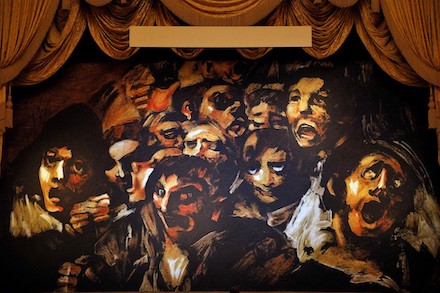
Show curtain, a detail of Goya's painting “A Pilgrimage to San Isidro”
This fall season, besides programming only composers and operas that everyone has heard of, San Francisco Opera seems to have targeted two other rather large groups — those who would not be caught dead in an opera house and those who are hard of hearing.
Verdi’s blockbuster Il trovatore opened the SFO fall season on September 11. The War Memorial’s familiar gold curtain flew out to reveal the production’s show curtain, a detail of Goya’s 1823 painting “A Pilgrimage to San Isidro,” dampening the festive mood of the inauguration of the company’s eighty-seventh season. The Met and Chicago Lyric had conspired with San Francisco Opera to create this new production of Verdi’s first mega-opera. We can hope that it will not end up in SFO’s warehouse to be revived every five or six years, or ever again.
Verdi blockbusters are not fodder for little league opera. The great big San Francisco Opera had the goods. A big style, knock-em dead, real Italian conductor Nicola Luisotti, the company’s incoming music director; a real Italian tenor, Marco Berti (a recipient of the Giuseppe Verdi Gold Metal), Sondra Radvanovsky, an American soprano who brings real push to “spinto;” the mezzo Stephanie Blythe, Musical America’s (the major trade publication) current Singer of the Year; and Dimitri Hvorostovsky (who needs no introduction) as the Count di Luna. It was a lively contest as to who could sing louder, clearly at the urging of the maestro. It was loud, very loud.
The most beautiful singing of the evening came from Hvorostovsky in the second act reverie of his love for Leonora, though the effect was betrayed by the maestro who too aggressively drove Verdi’s delicate orchestration. Stephanie Blythe heaved the rantings of Azucena from her chest throughout the evening, leaving her vocally exhausted at the end, and arousing our concern for her on-going vocal health. Mme. Radvanovsky was busy with strange operatic acting accompanying her impressively goosed up, later in the evening bleating vocal production, evoking concerns for her eventual vocal health as well. Marco Berti squarely hit the high C (though not for very long) in Di quella pira, actually a high B as the whole aria had been transposed down to accommodate this show-off high note infamously interpolated by tenors.
At the September 25 performance many of the audience rose to their feet when Azucena appeared for her bow, then the balance stood when Hvorostovsky took the next bow (Azucena had just sung her guts out in the final trio while the Count di Luna merely looked on, one might have thought she would have taken the later bows in turn with Leonora and Manrico). Then la Radvanovsky got huge, the hugest applause, probably because she had the softer, prettier arias, followed by the title role, Manrico, who was well appreciated as the most genuine performance of the evening (no one expects sincerity from a tenor, so its lack was not a problem).
Scottish stage director David McVicar got the whole thing wrong. Il trovatore is not about infanticide or bloody revenge (or Napoleonic wars), it is about singing. Famously victimized as a bad libretto Il trovatore is a succession of set pieces that tell what has happened over a thirty year period. There is very little in Il trovatore of what is actually happening at the moment. Each of its eight scenes needs a specific mood to be set within which the story-telling takes place, and it was any attempt to create these moods that this production lacked. Unfortunately this led to a painful absence of poetry in this musically and theatrically over-blown production.
McVicar, as a good director thinks he should, attempted to make a dramatic whole, over-laying a larger mood or concept — the horrors of the Napoleonic wars. Il trovatore is far less than a national or social tragedy, and these larger horrors were quite pale, indeed unnoticeable beside the vicious personal dramas of Verdi’s characters. To the hopeless task of imposing a dramatic unity McVicars and his designer Charles Edwards developed a revolving set that could instantly move from one locale to another, one story to another, with no time for the Verdi’s moods to dissipate and then radically transform themselves. Put this together with the pushed-to-the-hilt conducting of Luisotti and it became opera that hit below the belt.
The performance on September 19 was beamed simultaneously to the digital scoreboard of AT&T ball park where a reported twenty-five thousand people converged to participate in this contest of who could sing loudest. More than opera, Opera at the Ball Park is a San Francisco happening that entices just about everyone to join in the sport of opera, if not the art of opera.
War Memorial Opera House, San Francisco. Photo copyright Cory Weaver, courtesy of San Francisco Opera.Orfeo ed Euridice at the Teatro dell'Opera di Roma
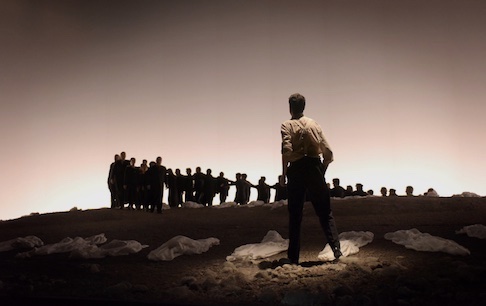
Carlo Vistoli as Orfeo with Act I mourners
In Berlin (1989) Euridice killed in a motorcycle accident, Orpheus' lyre a guitar; in Montpellier (2007) sexpot Euridice killed in a car wreck, Amor an undertaker (Roberto Alagna Orphée); in Los Angeles (2018) the whole thing was danced by the Joffrey Ballet.
In Rome there was but an excavated grave.
It was Canadian stage director Robert Carsen’s 2006 Lyric Opera of Chicago take on the ancient Orpheus legend as told by Virgil in his Georgics and then reimagined in 1762 Vienna by Christoph Willibald Ritter†von Gluck — these days simply called Gluck — as a one and one half hour azione teatrale.
Mr. Carsen revived his production of Gluck’s azione teatrale last November (2018) in Paris (in Italian) with famed French counter-tenor Philippe Jaroussky and French soprano Patricia Petibon, and just now (March 21) he staged it again in Rome with an all-Italian cast and conductor. Note that when Gluck refashioned his opera in French for 1774 Paris it became a full-blown drame héroique, Orphée was now a non-controversial haute-contre (a naturally high tenor voice) rather than a contralto castrato (a voice once disliked by the French), and of course Gluck added airs, choruses and dances to make a lengthier evening.
Back in 1762 Vienna there were two brief dances in the drama — one by the infernal spirits, another by the Elysian spirits — and now in Rome (as well as Paris!) there were none. Robert Carsen’s stage was but a bed of pebbles, an excavated grave, a hand held bowl of fire and a sky. The black silhouettes of mourners bemoaning the death of Eurydice transformed themselves into barely visible, supine, white covered infernal spirits who slowly transformed themselves into black silhouetted blessed spirits, movement that sufficed to prolongate Gluck’s drama.
If there was actual dance in the Carsen Orfeo ed Euridice it was in the duet of Euridice’s escape from hell. Euridice, beautifully sung by Mariangela Sicilia, repeatedly implored Orfeo to place his loving gaze upon her, when he did not she turned away in dismay. Orfeo then faced the back of her head to beg her repeatedly to wait. She would not.
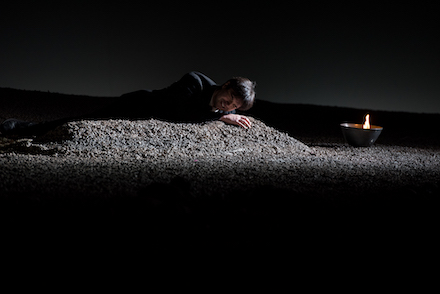
Carlo Vistoli as Orfeo, Mariangela Sicilia as Euridice
The emotional stillness of director Carsen’s bleak choral landscape was initially shattered by Orfeo’s thrice repeated,“Euridice” in a spine chilling cry by Italian counter-tenor Carlo Vistoli. Mr. Vistoli is the perfect swain — young, handsome, masculine, immaculately groomed musically, endowed with a beautiful contralto voice. Though Gluck’s arias for Orfeo were much simplified from the highly ornamented singing of the Baroque, Mr. Vistoli did not eschew adding the occasional appoggiatura. These chokes and sobs rendered his laments heart wrenching.
If conductor Gianluca Capuano normally conducts period instrument orchestras, in Rome he revelled in exploiting the resources of a modern symphonic ensemble (the Rome Opera orchestra) to create an immediacy that did not falter through the intermission-less duration. It was a close reading of Gluck’s score that left no emotive phrase unremarked, taking us to an emotional level that in fact betrayed Gluck’s intention to purge Baroque opera of its excesses.
The great tension of Baroque opera is love vs. duty. It is indeed this same tension that pervades Gluck’s reform opera. It is Orfeo’s duty to not look at Euridice, and finally it is his love for Euridice that forces him to forsake his pledge, his passion overwhelming the art that had so moved the infernal spirits.
By the time we arrived, with Orfeo, to his “Che faro senza Euridice” we were all in a state of utter despair, Gluck’s azione teatrale having become an expressionistic nightmare.
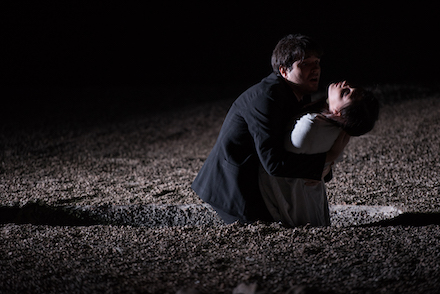
Carlo Vistoli as Orfeo
Fortunately Gluck’s Amore, sung by Hungarian born, Italian formed soprano Emˆke Bar·th, saved the day reuniting Orfeo and Eurydice through the power of love, thus averting Orfeo's suicide, indeed the mass suicide of all of us who, with Orfeo, had endured the tragedy of this splendid evening.
Cast and production
Orfeo: Carlo Vistoli; Euridice: Mariangela Sicilia; Amore: Emˆke Bar·th. Orchestra and chorus of the Teatro dell'Opera di Roma. Conductor: Gianluca Capuano; Production: Robert Carsen; Sets and Costumes: Tobias Hoheisel; Lights: Robert Carsen and Peter Van Praet. Teatro dell'Opera, Rome, Italy, March 21, 2019.
All photos courtesy of the Teatro dell'Opera di Roma.
Le Comte Ory at the Rossini Opera Festival
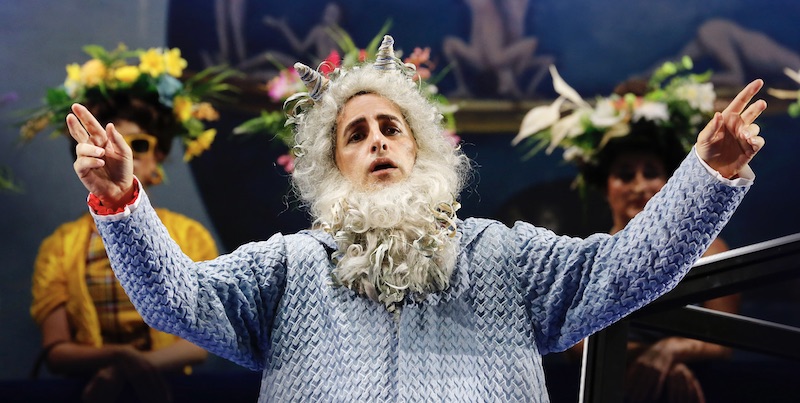
Juan Diego Flórez as Count Ory
It was a South American mafia, Peruvian tenor Juan Diego Flórez as the deceitful Count Ory, Venezuelan Diego Matheuz as conductor and Argentinian Hugo de Ana as metteur en scène. FYI Juan Diego Flórez, now 49 years-old was recently named Artistic Director of the 43 year-old Rossini Opera Festival.
A twenty-three year old Juan Diego made his professional debut in 1996 at the Rossini Opera Festival, and he has returned nearly every year since, having sung 13 different Rossini roles in Pesaro, some of them twice — he was already Count Ory back in 2003!
Conductor Diego Matheuz was once the concert master of Venezuela’s Simón Bolivar Symphony Orchestra, and since has been its principal conductor, though his career has largely unfolded on European stages. Stage director Ugo de Ana’s career has taken place almost exclusively on Italian stages, and only once before at the Rossini Opera Festival, a Semiramide in 1992.
All these credentials could not save this Le Comte Ory, victim of Mr. De Ana’s bizarre staging for which he was not only the stage director but also designer of the sets and costumes.
The opening scene of Le Comte Ory (the 36 year-old Rossini’s penultimate opera) is Count Ory’s hermitage which seems to be an egg, and the Formoutiers chateau, maybe a frog, is nearby where its housekeeper is making an omelet. Peasants are dressed as colorfully as they could possibly be, the women in huge hats of fruits, flowers and foliage. Note that Mr. de Ana's images are replicas of Hieronymus Bosch's triptych The Graden of Earthly Delights.
There is a ballet of ten dancers who take on various tasks throughout the opera, in this opening scene pushing three, real supermarket carts into Mr. de Ana’s pastel, Rococo-esque abstracted world. And at the end of Act I they rushed on stage as green dinosaurs.
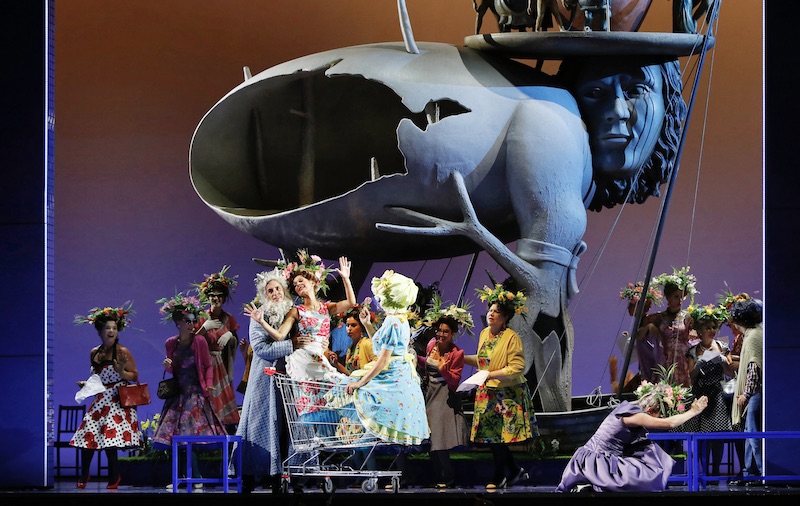
Chateau de Formoutiers
Never for a moment was there not a flapping of some sort happening on the stage.
The wives of the crusaders, off in Palestine, are sequestered in the chateau to avoid temptation, like — according to Mr. de Ana — birds in a glass case, adding this Audubon image to frogs, fruit and eggs. There was lots and lots of scenery, and lots and lots of costumes, and lots and lots of stage action.
Mr. de Ana’s food fixation maybe found its motivation when the male chorus arrives at the chateau disguised as female pilgrims (silly, exaggerated nun-like costumes), wherein they are welcomed and given sustenance in a huge chorus scene. “Je sors de l’oratoire, et j’entre au refectoire” says Count Ory’s friend, Raubaud, as example of the silly, Offenbachesque non-stop rhyming of the libretto, the work of the famed French dramatist Eugène Scribe (120 librettos for 48 different composers).
Le Comte Ory distinguishes itself from a simple farce — the clever count creates a couple of silly shenanigans to court the lonely Countess of Formoutiers, but in the end he is tricked into holding hands with his rival, Isomer — by the complexity of its music. It is the full scale, mature Rossini of fancy arias, highly articulated scenes and spectacular finales — a septet with chorus ends Act I!
The most successful number of this production was the Act II trio in which the Count is tricked by Isolier and the Countess, only the three of them on the stage, though strewn on a brown bird atop a dead duck. With less scenery and somewhat restrained movement (they slipped and slid over each other) the music and the singing came to the fore. It was Rossini and the three principal voices alone at last to create the thrilling music that brings us back to Pesaro year after year.
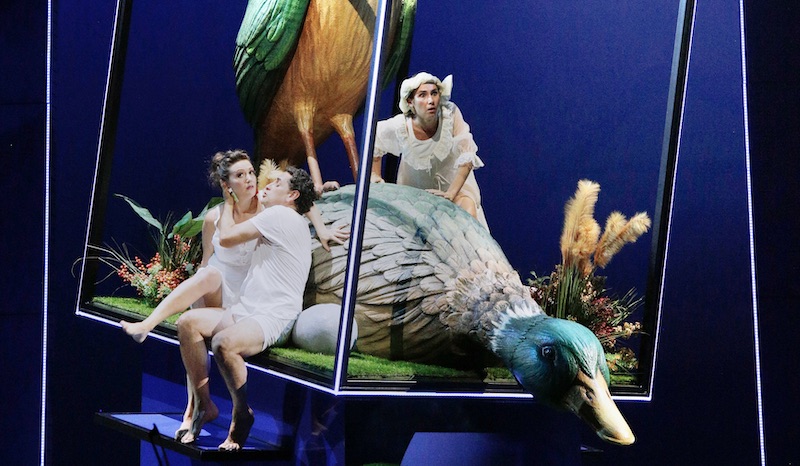
Julie Fuchs as the Countess, Juan Diego Florez as the Count Ory, Maria Kataeva as Isolier
Yes, Juan Diego’s high notes were solid, spectacular and plentiful. He gamely executed the inane character imposed on him by Mr. de Ana. It is disturbing to watch a great singer cope with such a difficult production circumstance. Conductor Diego Matheuz provided the primo tenore, and all the singers exactly what they needed to navigate the rigors of Rossini singing, finding the fun and joy of Rossini’s musically deadly serious score.
The discovery of the evening was Russian mezzo soprano Maria Kataeva in the trouser role Isolier (the count’s page and rival). She brought beautifully voiced, full-throated singing to her role, as well as excellent fioratura and a presence of great charm. French soprano Julie Fuchs sang the Countess of Formoutiers, her first act aria “En proie à la tristesse” earned her a uniquely Pesaro ovation — many long minutes of hand clapping and foot stomping (the only such ovation of the evening). The aria is spectacular, its fioratura breathtaking, that Mlle. Fuchs deserved this huge ovation is questionable.
As always in Pesaro the smaller roles are well cast. Polish tenor Andrzej Filonczyk sang the count’s friend Raimbaud, Argentine baritone Nahuel di Pierro sang the count’s tutor and veteran Italian mezzo Monica Bacelli sang the chateau housekeeper Ragonde. Alice, a pretty peasant was sung by Anna-Doris Capitelli, a recent participant the Rossini Opera Festival’s Accademia Rossiniana.
The Accademia Rossiniana “Alberto Zedda” (its founder) has been a part of the Rossini Opera Festival since 1989. Open to professional singers (women under the age of 30, men 32) it probes vocal and dramatic requirements for modern interpretations of Rossini roles. Each year the participants perform Rossini’s Il viaggio a Reims (1825), a cantata celebrating the coronation of France’s king Charles X (reign 1824-1830). Rossini composed Le Comte Ory three years later to incorporate much of this music into a full scale opera.
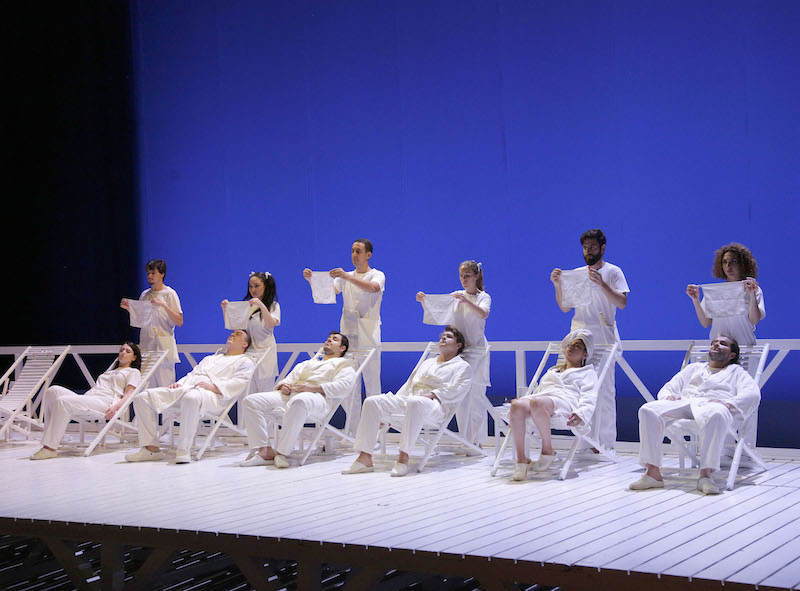
In 2001 Spanish director Emilio Sagi created a production of Il viaggio a Reims for the Accademia which has been remounted every year since. Seven or eight beach chairs are lined across the stage for the first part, there is a pole on either side from which a string of lights will be strung for the string of national dances that conclude the one act theater piece. There are a few glasses and towels as props. There is judicious addition of directorial wit, never so much as to detract from the vocal accomplishment and dramatic charm of the young singers.
Emilio Sagi’s Il viaggio a Reims is the polar opposite of Hugo de Ana’s Le Comte Ory.
Le Comte Ory, Coro del Teatro Ventidio Basso, Orchestra Sinfonica Nazionale dell RAI. Vitrifrigo Arena, Pesaro, Italy, August 16, 2022.
Il viaggio a Reims, Philharmonica Giachino Rossini, Daniel Carter, conductor. Teatro Rossini, Pesaro, Italy, August 15, 2022.
Otello at the Rossini Opera Festival
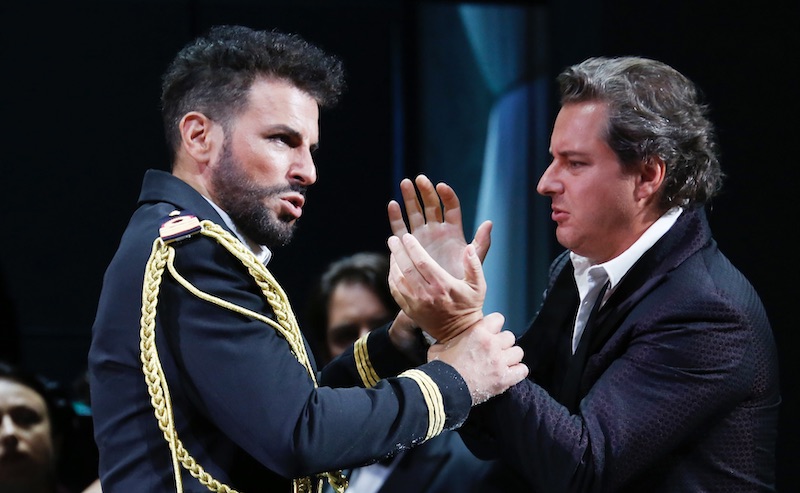
Enea Scala as Otello, Dmitry Korchak as Rodrigo
Two high concept productions: Rossini’s Otello set in a kitchen with Rossini’s Le Comte Ory providing some eggs. More or less.
For its large scale productions the Rossini Opera Festival once inhabited Pesaro’s center-town Palasport, a venue it shared with the famed local basket team, Scavolini Pesaro. Scavolini, a well known manufacturer of luxury kitchens, agreed to remodel the Palasport into a fine, modern theater for the Rossini Festival, and include a practice court for basketball.
So, in 2006 the Rossini Festival decamped to freeway close, ex-centric Adriatic Arena, now branded as the Vitrifrigo Arena for the duration of the renovations (Vitrifrigo makes refrigerators for yacht kitchens). The arena’s basketball court is now the real estate where an impromptu, fully equipped, 1200 seat theater has been erected each summer for the past 17 years to host the annual three week Rossini Festival season.
It is, simply said, one of the world’s great theaters (its initial echoes have long been eliminated, though the arena’s roof may still be a bit leaky). Each year we are told the next festival will be in the new, PalaScavolini, but each year we are back, happily, at the arena.
The historic, 750 seat Teatro Rossini hosts the festival’s intimate productions.
Rossini’s Otello (1816) is not told in the broad strokes of Shakespeare’s Othello or Verdi’s Otello. It is three high tenors, Otello, Iago and Desdemona’s intended, Rodrigo, plus the doomed bride and her father who enact a nasty domestic drama. A daughter’s duty to her father conflicts with her love for a black man — more simply stated it is the classic Baroque operatic conflict of love and duty with an unhappy ending.
Rossini’s Neapolitan librettist, Francesco Berio, often the young Rossini’s host at gatherings of Naples’ literati, conjured a tale of little moral complexity, vaguely basing his libretto on a brief mention in Giovanni Battista Giraldi’s 1685 novella Un capitano moro, that Desdemona’s parents had tried to induce her to marry someone other than the black man.
In librettist Berio’s tale a father, Elmiro, has chosen a husband, Rodrigo, for Desdemona, though Desdemona is secretly married to the just returned military hero Otello. Desdemona had written a love letter to Otello that fell into Iago’s hands, a letter that Desdemona’s father thinks was intended for Rodrigo who does indeed love Desdemona. Iago helps Rodrigo by showing the letter to Otello, suggesting that it was intended for Rodrigo. Otello and Rodrigo come to blows. You know the rest.
So there was a lot to sing about, and really a lot fancy music created by the brilliant, 24 year-old Rossini.
Just now a Pesaro pianist turned stage director, Rosetta Cucchi, enriched this early nineteenth century idea of an explosive situation by lathering it with the current cause célèbre of male brutality to women (endemic gender violence). Thus we suffered through an exposition during the overture of a man slapping a woman, to the horror of Desdemona’s maid Emilia (who Rossini will then ignore, giving her no aria in the opera). Plus there were small windows high up on either side of the back wall where there were constant videos of women in various situations — you could either attempt to understand what the videos were conveying, or you could follow the plot on the stage. There was no discernible integration of video to stage.
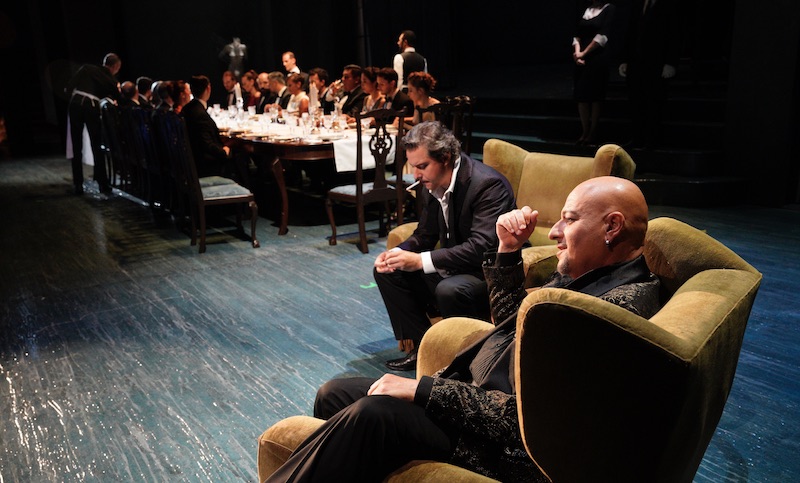
Antonino Siragusa as Iago (right), Dmitry Korchak as Rodrigo
With her designer Tiziano Santi, Mme. Cucchi, envisioned a kitchen and formal dining room as the setting for this domestic tragedy, not confusing us with the monumentality we attribute to the Shakespeare and Verdi tragedies (as was the case in the Pesaro 2007 Giancarlo del Monaco production).
For the dining room of the first act Mme. Cucchi and her costume designer Ursula Patzak, gave cool business suits to the men, classic servant attire to maids and waiters, and flashy evening gowns to the women of the chorus — most likely we were meant to consider them as objects, they were in fact quite attractive. Otello laden in gold braid and medals has the first operatic salvo, a magnificent aria concluding with a plea to love. Forget that Elmiro, Desdemona’s father, later in the act slapped her in the face to the horror of the onlookers.
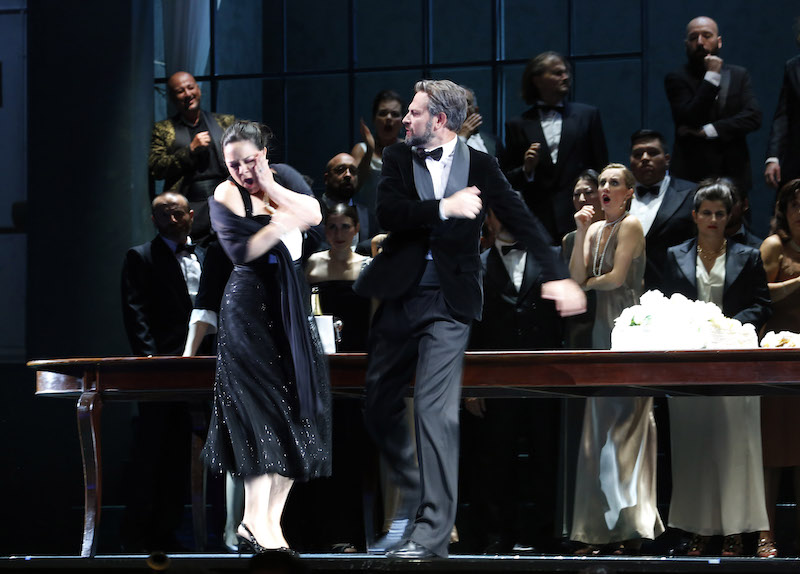
Eleonora Buratto as Desdemona, Evgeny Stavinsky as her father, Elmiro
The entire second act takes place in the kitchen, though we see into the dining room, wherein shapely female forms/objects are in high evidence. The act is a massive musical construction that unfolded in a very intimate space. First a huge aria by Rodrigo after Desdemona informs him she is married to Otello, then a duet in which Iago reveals the misaddressed letter to Otello. A trio continues in which which Otello and Rodrigo duel in the presence of Desdemona followed by a finale in which Desdemona confronts her father Elmiro. It was splendidly staged and sung, vintage Rossini. Forget the gratuitous manhandling of Desdemona as the men fight over her (was it here that bloody, battered women appeared on either side of the stage?).
The final act murder occurs in the now empty dining room. It is a single number, meticulously paced by Rossini. A gondolier’s sad song is heard from afar followed by a splendid willow song and prayer (not the Willow Song in Othello). An arriving storm shatters the sadness that had prevailed. As the storm increases the distraught Otello bursts in to accuse Desdemona of infidelity in a strepitoso duet that climaxes in the clamorous unison exclamation “Notte per me funesta!” Then, in the following calm, Otello murders Desdemona. It was powerful, felt tragedy.
It had nothing to do with battered women. It had only to do with Otello and Desdemona.
And it had everything to do with the excellent conducting of Yves Abel who has proved himself over the years in Pesaro to be a Rossini conductor of the first water, most recently with the splendid 2018 Il barbiere di Siviglia. The maestro is able to achieve a precise flow for the vocal lines, and ascend to the Rossini delirium when it naturally arrives, a rare feat. In Otello, instead, he found the precise Rossini pacing that rendered this mediocre libretto into bonafide tragedy.
While the Rossini delirium is not a factor in Otello, a force of personality and a virtuosity of voice is an absolute necessity. The assembled cast well met this criteria, foremost the two tenors (lead photo) who love Desdemona, Otello sung by Italian tenor Enea Scala, and Rodrigo, sung by Russian tenor Dmitry Korchak. Scala, a participant in the festival’s 2009 Accademia Rossiana has moved through supporting roles in Pesaro to hold the stage now as opera’s most distraught lover. Korchak boasts a warm, beautiful voice well able to find the brilliance in the fioratura of his arias, making him a formidable artistic threat to Otello. Sicilian tenor Antonino Siragusa, the Iago, has proven himself a stalwart and valiant villain over the years in Pesaro.
Desdemona was sung by Italian soprano Eleonora Buratto who brought diva presence to the role, traversing the dramatic vicissitudes of the second act with true suffering, then singing her Willow Song and prayer with felt resignation before exhibiting her fury at Otello’s accusation. Desdemona’s father, Elmiro was sung by Russian bass Evgeny Stavinsky. The role of Emilia was sung by mezzo soprano Adrianna di Paola who had much to say in her recitatives but no chance to expound, though it always seemed like she might be about to. The off stage gondolier song was sung by Julian Henno Gonzalez, and the Doge was sung by tenor Antonio Garés
Coro del Teatro Ventidio Basso, Orchestra Sinfonica Nazionale Della RAI, Vitrifrigo Arena, Pesaro, Italy, August 14, 2022
Turandot at the Arena di Verona
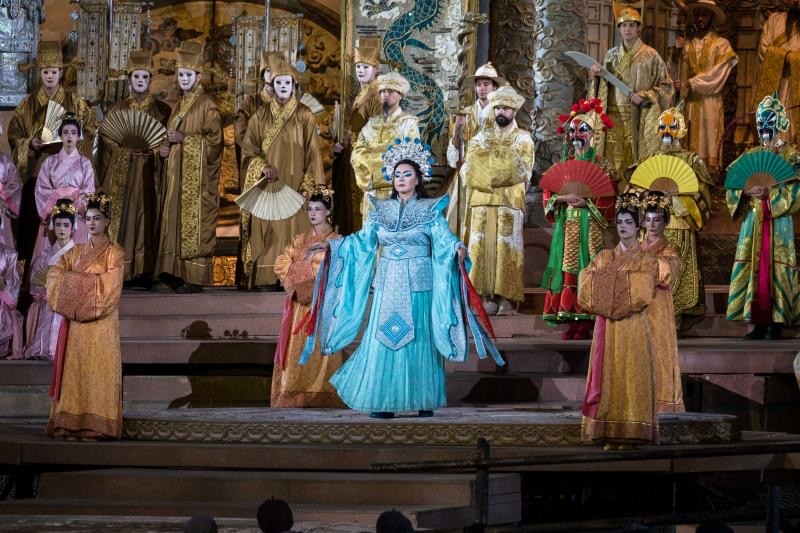
Oksana Dyka as Turandot
Spectacle is what the Arena di Verona does best, spectacle is what the late Franco Zefferelli did best, Turandot is an opera that lends itself to spectacle like no other. Ergo . . .
It was Turandot in its full glory (August 13) with a cast well up to its vocal challenges, and a conductor, Francesco Ivan Ciampi, who unleashed a verismo that shone through the visual splendors of the production.
This 2022 edition of the Puccini masterwork at « the world’s largest outdoor theater » remounts Franco Zeffirelli’s now famed 2010 production for the Arena di Verona. The great Zeffirelli productions endure — his 1987 Metropolitan Opera Turandot production remains in the Met repertoire to this day.
Typically at the Arena di Verona staging is abstracted to the most minimal terms allowing the carousel casting that alternates opera’s biggest international names with viable singers and conductors on the European circuit. I attended the fourth of seven performances. The first three boasted Russian diva Anna Netrebko as Turandot and Yusif Eyvazov as Calaf — a real life married couple, now operatically wed as well. Marco Armiliato was the conductor. The sixth performance (August 26) will find Placido Domingo in the pit!
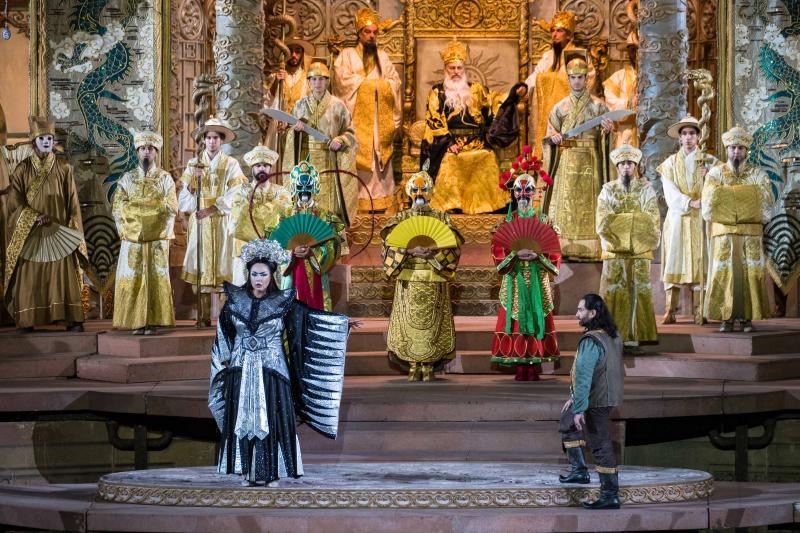
Oksana Dyka as Turandot, Samuel Simonicini as Calaf, Carlo Bosi as the Emperor
Four different Calaf tenors were announced for the run of performances. Even so, in the play of musical chairs the Calaf originally announced for my evening was replaced by Italian tenor Samuel Simonicini, who possesses nearly everything an Italian tenor needs — most of all he has a good, solid “squillo” (ringing tone)! Unfortunately in his big third act aria “Nessun dorma,” standing alone in the center of the stage, he was tempted, understandably, to sing to the last row of the theater (at least a quarter mile away), thus losing some of his vocal focus. This did not diminish the huge, grateful ovation we awarded him.
At maximum capacity the Arena di Verona hosts almost 16,000 spectators for opera. Without walls and ceiling there is only a natural acoustic. I have always been seated within a hundred feet or so of center stage, from where I hear the real voices of the singers, though not loudly — a very great pleasure quite unlike opera houses where the acoustic of the hall comes into play. The furthest reaches of the arena’s massive bleacher seating are at least ten times this distance, and are always packed with opera lovers from throughout Europe. They too are surely aurally rewarded in their way as well.
With the departure of la Netrebko the Turandot role was taken over by Ukrainian diva Oksana Dyka. Mme. Dyka brought all required stature to the icy princess, if not with the symbolic and actual fire power of the Russian diva. La Dyka possesses a steely, lyric voice that sailed unwaveringly through Puccini and Alfano’s massive orchestration. Turandot in Verona Is usually surrounded by 50 or 100 dancers, sword carriers and standard bearers, plus an adoring chorus of an un-countable number. She is hugely costumed, wigged and made-up. Though she is of little personality she is of maximum monumentality –– through to her final utterance, the word “amor!”
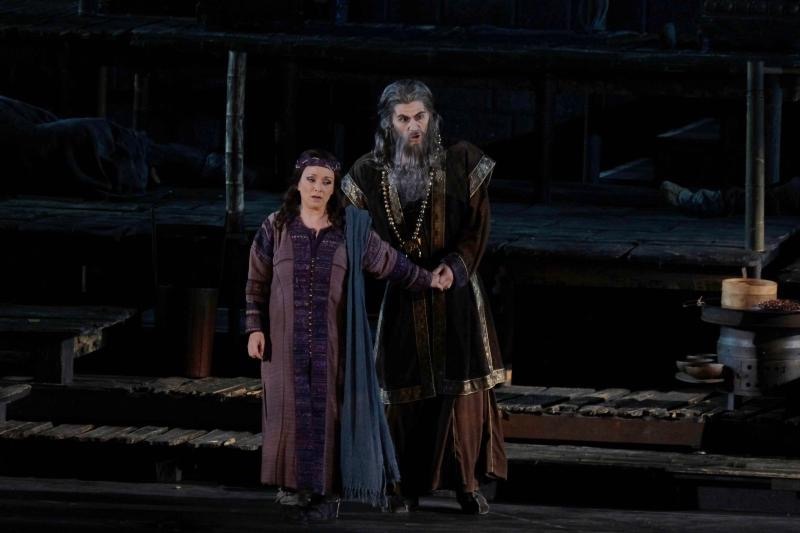
Ruth Iniesta as Liu, Riccardo Fassi as Timur
The simply dressed slave girl Liu on the other hand is left quite alone on the stage to sing her Act I aria, “Signore, ascolta.” The role was beautifully and sensitively sung by Spanish soprano Ruth Iniesta at the performance I attended, achieving an expressive monumentality that surely sailed into the furthest reaches of the Arena. The heart rending role of Calaf’s father blinded father Timur was sung by Italian bass Riccardo Fassi, though the role largely disappeared into the crowds on the stage.
Ping, Pang and Pong, sung by Gëzim Myshketa, Ricardo Rados and Marreo Mezzaro, were declaimed center stage, all intimacy of discussion eschewed in the interest of informing the story to the thousands of spectators. Their voices were big, not the character voices that usually bring great charm to their scenes. The emperor was sung by Carlo Bosi at the performance I attended. Legendary Rossini tenor Chris Merritt sings the role at the final two performances!
Turandot, Arena di Verona, August 13, 2022. All photos copyright Ennivi Foto, courtesy of the Arena di Verona.
Tristan und Isolde at the Bayreuth Festival
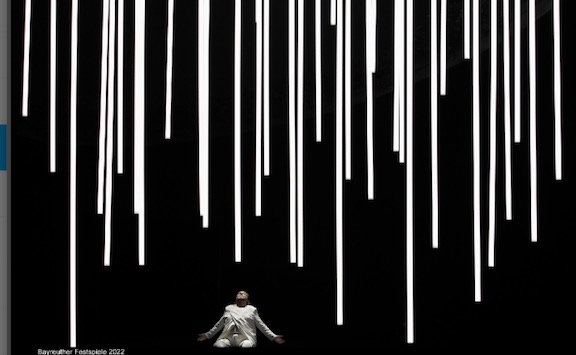
This new production by Roland Schwab, conducted by Markus Poschner was given an ecstatic welcome by the acolytes of Wagner’s revered Festspielhaus. There were, in fact, occasional, very occasional moments of sublimity.
Stage director Schwab undertook the daunting task of creating two simultaneous worlds, one of primal human desires (love, i.e. yearning, and destruction, i.e. death — transcendental realities), the other world surrounds us, it is the life we see and feel as we exist day to day.
Director Schwab chose to place Wagner’s treatise on love and death on a cruise ship, or maybe it was a spacecraft, either vessel though might be confused with a nickelodeon (a machine that lights up when you put a coin in).
But then, all mostly said and done, Isolde having begun her "Liebestod," a decrepit ancient couple (modern dress) entered and separated, circling slowly to then reunite at the final moment of Isolde’s ecstasy of separation. Hearsay has it that during the ecstasies of the Act II love duet there was a contemporary dress teenage couple making-out on the upper deck of the ship, though not in my sight lines. At the final bows these two couples were joined by a couple of children who evidently had been strategically deployed somewhere at some point.
But mostly, obviously, the staging was of Wagner’s transcendental world as musically revised by conductor Markus Poschner. The staging dialectic imagined by Herr Schwab evidently encouraged the maestro to introduce a dialectical discussion of his own, contrasting the metaphysical magic of Wagner’s musical flow to the nuts and bolts of its construction, evidencing the colors of its smaller motives and inner lines, slowing the flow so that every rhythmic complexity was apparent, that every individual word was distinctly formed, every musical comment was clearly understood.
Such plodding had its ups and downs. If the Act III Tristan monologue sometimes assumed an illuminating clarity, its emotional climaxes were compromised, dissolving into a conglomeration of over-loud sounds. Isolde’s Act I discourses descended into angry exclamations, exacerbated by her childishly slapping the wall and stamping her feet from time to time. Most damaging, this musical dialectic resulted in clumsy singing that came from the outsized voices of the Tristan and Isolde, particularly troublesome in the Act II duets.
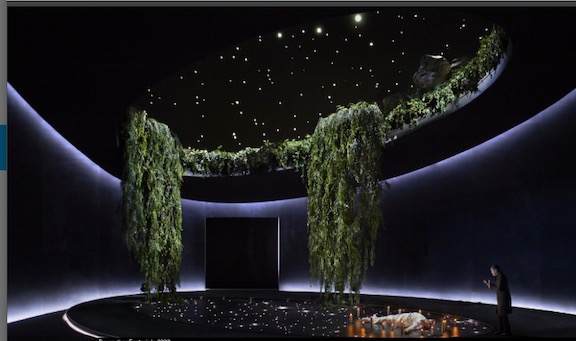
Tristan lying wounded on the Brittany coast
The setting, the work of Herr Schwab’s usual design collaborator Piero Vinciguerra, was a spectacular ship of some sort. There was a virtual body of water in the center of this full stage vessel, placed below an upper deck that had an ocular opening through which a sky was apparent. Both the pool and sky were sentient, i.e. the enthusiasms of Tristan and Isolde were visually manifest by means of digitally formed images apparent within its confines, shapes and colors that got hyper from time to time. Plus the several circles that comprised the donut shaped spaceship were outlined with hidden lights that went berserk at appropriate moments.
In the first act the pool was a swimming pool, blue until it turned boiling red. After the love potion was drunk the lovers walked onto the surface of the pool, now a magical space where they remained over/within the virtual pool’s various, quite remarkable manifestations to come. In fact there were moments of visual sublimity, the lovers pulled into a vortex, the lovers lost in a galaxy of stars, the dying Tristan in a sea of candles. All this spectacle was Herr Schwab’s representation of Wagner’s transcendental world.
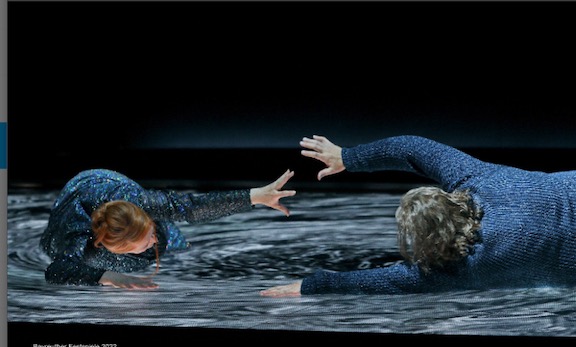
Tristan and Isolde near the end of Act I
Near the end, when Isolde arrives at Tristan’s castle on Brittany's rocky coast, the spell has been somehow broken, the world is no longer transcendent, it is an every day world. Thus Isolde cannot walk across the pool, now a pond or maybe an ocean, that separates her from Tristan. It is a real life barrier. She sings her "Liebestod" (and it was beautifully sung) to Wagner’s world of dream and destruction. Life goes on.
This magical world created by Messieurs Schwab and Vinciguerra was indeed magical, requiring its inhabitants to move in magical ways, i.e. with some balletic grace at the very least. Unfortunately neither British soprano Catherine Foster nor American tenor Stephen Gould are or could have been dancers, resulting in clumsy movements that ran counter to the expressive intentions of the production. Both singers are formidable artists, of formidable voice who were not suited to this difficult to realize, high concept production.
The King Marke of German bass Georg Zeppenfeld was well sung indeed, and well acted within the framework of the production. Kurvenal, well sung by German baritone Markus Eiche, had the onerous task to circle Tristan’s death pond for the entire duration of the soliloquies, a task accomplished with patient aplomb. Brangäne was sung in very beautiful voice by Russian mezzzo Ekaterina Gubanova, and gracefully enacted as well.
Tristan’s friend Melot was strangely cast. Icelandic baritone Olafur Sigurdarson had the age one expects for King Marke (Mr, Zeppenfeld did not). Melot wielded an onstage lighting instrument (of which there were always a few — reminding us that Wagner’s opera is theater and not reality) that he focused on Tristan for the duration of the Act II King Marke soliloquy. He then stood aside as a huge chandelier of abstract blades slowly descended through the ocular opening to wound, symbolically, Tristan (see lead photo).
It was a long and difficult evening at the Wagner shrine.
Tristan und Isolde, Festspielhaus, Bayreuth, August 12, 2022. All photos copyright Enrico Nawrath courtesy of the Bayreuth Festival
De Temporum Fine Comoedia at the Salzburg Festival
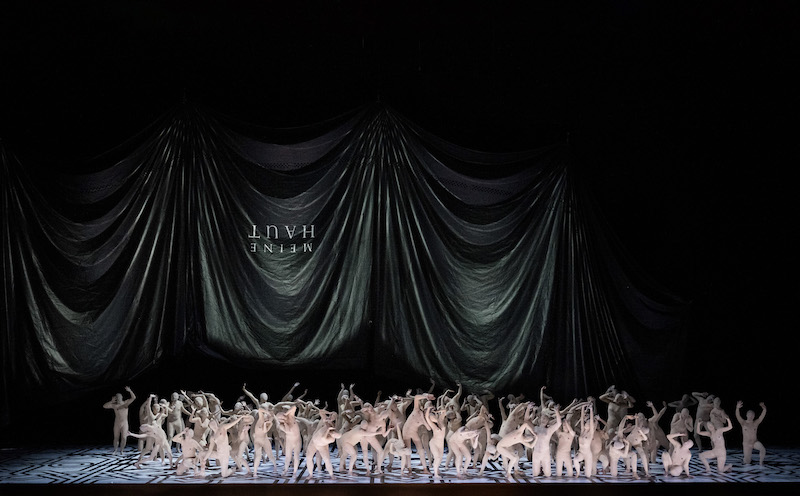
The damned
The huge stage (Felsenreitschule) that is carved into the massive rock face that is the Salzburg Festival’s backdrop — Bartok’s Duke Bluebeard’s Castle, Janacek’s Kat’a Kabanova (lead photo), and Carl Orff’s A Play on the End of Time.
Of the three operas only A Play on the End of Time is of the philosophic weight to fill this monumental space. Carl Orff’s 1973 mystery play dramatizes, no less, the angel Lucifer’s expulsion from grace, and its consequent day of judgement. Such judgement is questioned, no less, by a group of monks who suggest that God will absorb all earthly evil back into Himself. This does occur, with considerable discussion at the end of time, at a terrifying final judgement resolving in Lucifer’s assumption into grace.
Luckily, last month stage director Romeo Castellucci had already exhumed much of mankind at his Aix Festival staging of Mahler’s Resurrection Symphony.
Carl Orff became known through his 1937 Carmina Burana, a work embraced first by the Nazi regime in spite of its eroticism, and since then this early work has assumed solid placement in popular culture worldwide. Compared to A Play on the End of Time it is of very modest proportions requiring only a triple wind symphony orchestra with six percussion players, plus mixed chorus and three soloists.
Just now Salzburg, for Orff’s 1981 revision of De Temporum Fine Comoedia, his magnum opus, the Gustav Mahler Jugendorchester was modified into 30 or so percussion players (100 different instruments), double triple winds, i.e. six each except eight trumpets, three pianos (2 players each), three harps, organ. There were no violins, violas or cellos but there were 8 double basses plus a quartet of viols. The vocal forces were nine sibyls, nine monks, three mixed choruses (joined finally as the damned), plus a few more roles or so, not to forget Lucifer himself (speaking role).
And then to mention as well the considerable instrumental and choral forces that were required to create the magnetic tapes, massively amplified to initiate the Orff Comoedia (Play) and to intervene from time to time as it unfolds.
Conductor Teodor Currentzis, music director of the Stuttgart SWR Symphony Orchestra, held all this together with remarkable musical aplomb, indeed relentless remarkably precise rhythmic aplomb. More importantly for this Salzburg endeavor Mo. Currentzis is the music director of the musicAeterna Choir, a choral group based in Perm, Russia (a city in western Russia near the Ural Mountains) whose solo and ensemble voices provide the underpinnings of this Salzburg Festival production. musicAeterna is lavishly supported by the sanctioned Russian Bank VTB. May it be said that contractural arrangements surely will have long preceded the Russian invasion of Ukraine, that the sheer artistic momentum of this production was unstoppable, overwhelming all political rationale that should have stood in its way.
Stalwart avant-garde stage director Romeo Castellucci handled Orff’s philosophic arguments with remarkable aplomb, creating striking images (the nine sibyls hurling real stones at Lucifer to drive him from heaven), and stagings in minimalistic terms that demanded maximal technical resources (as example, the three choruses [countless numbers] broke through the stage floor [!] to voice, relentlessly, their despair).
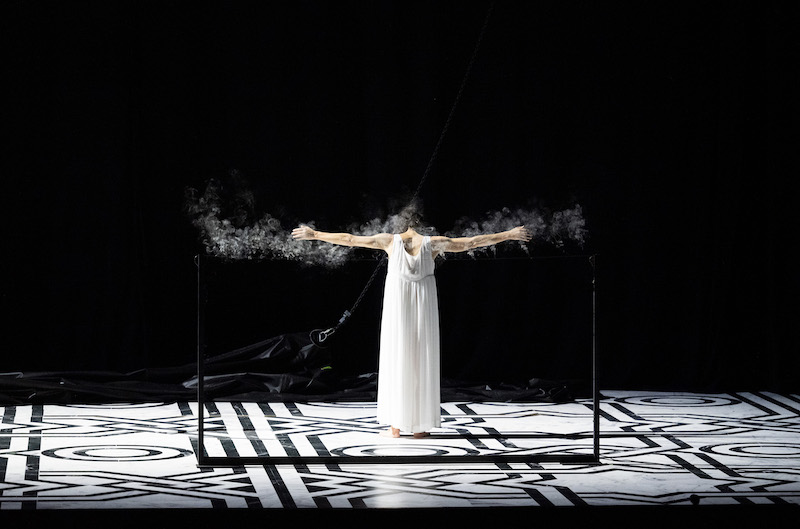
Christian Reiner as Lucifer
In the end Lucifer, voiceless, achieved his assumption, donning white angelic dress, with remarkable, minimalistic geometric movement of his arms, minuscule motions that brought closure to this gigantic artistic adventure within a brief moment of sublime intimacy.
N.B. De Temporum Fine Comoedia (A play on the End of Time) had its premiere at the Salzburg Festival in 1973. This revival boasts the conglomeration of artistic resources that only the Salzburg Festival has the resources to assemble. Among the countless well performed roles two performers must be mentioned — the Lucifer of Christian Reiner, a speaker of poetry and experimental text (read experimental theater actor), and the first Sibyl, a large role, sung by soprano Nadezhda Pavlova (of the Perm Opera and Ballet Theatre) in a full throated, golden voice.
Duke Bluebeard's Castle at the Salzburg Festival
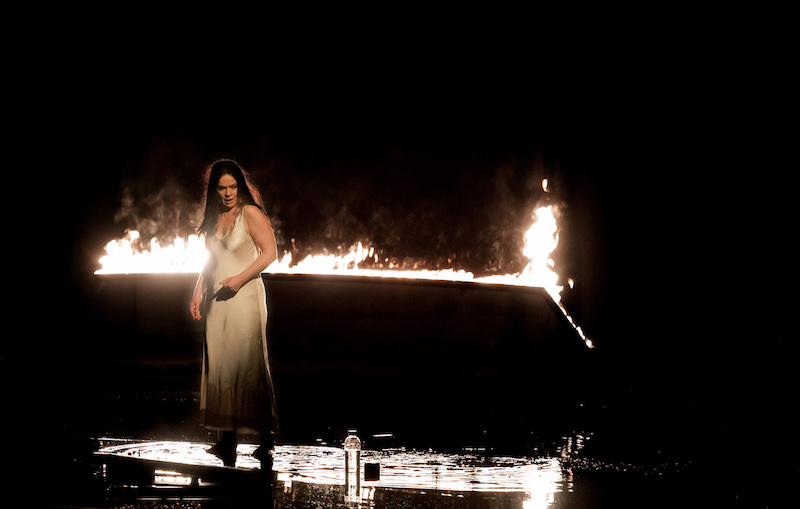
Austrine Stundyte as Judith
Romeo Castellucci staged Duke Bluebeard’s Castle as well.
The massive stage space of the Rock riding School was covered by a gigantic show certain that gradually took on very pale striped colors. Poetry speaker Christian Reiner (see above) slipped from under it to deliver the opera’s prologue in highly measured rhythms and dramatic pauses in very clear, declaimed English (though the opera was sung in Hungarian), admonishing us that what we will be revealed will be real.
The curtain then disappeared revealing nothing more than an infinite, silent black void. We hear a baby wailing, then a mother weeping, auditory images that will haunt us as Judith subsequently unlocks, and opens the doors to the rooms that hide the recesses of her psyche. We come to understand that what she discovers is her world, not Bluebeard’s, and that Bluebeard is her protective, even reluctant guide into her inner world.
Duke Bluebeard with his bride Judith first appeared as barely discernible shadows, Judith declaring her love for Bluebeard, wishing to illuminate its darkness. A jet of vertical flames erupted from the stage floor to provide some light, establishing the metaphor of a moth attracted to the flames that will consume it.
As the doors are progressively opened we see Judith become ever more immersed in Bartok’s meticulously defined musical world, jets of flame erupting and subsiding near and far in various shapes, the floor flooding with water into which Judith and Bluebeard fall, Judith engulfed in orgasm. These primal images played freely within Castellucci’s theatrical pulses that flowed continuously in the massive darkness of the vast stage.
With the opening of the fifth door to Bluebeard’s vast kingdom the orchestra arrives at the famed, radiantly massive C major chord, and the full force of Bartok’s expanded orchestra (quadruple winds) flows forth from the pit reinforced by faraway players in the nearby orchestra loft. In Castellucci’s blackness we discerned Bartok’s musical world in pristine detail and we yearned to hear the infinite colors that we divined, missing from the otherwise able performance by Vienna’s Mahler Jugendorchester. Greek born, St. Petersburg finished conductor Teodor Currentzis ably urged the orchestra to create a required musical universe.
Duke Bluebeard was sung by Finnish bass Mika Kares, a singer of immense vocal charisma who rose to embody the unusual complexities of the production — Bluebeard as both a seducer and a somewhat paternalistic presence. Castellucci’s Judith was enacted by Lithuanian soprano Austrine Stundyte, the Salzburg Festival’s Elektra in its famed 2020 Warlikowski production. Mme. Stundyte is surely the most formidable expressionist diva of this moment, adding full vocal security in an unwavering intensity of voice to a spellbinding presence. This Castellucci production provided her the unique opportunity to create a Judith of exceptional if quite unusual emotional magnitude.
Kat'a Kabanova at the Salzburg Festival
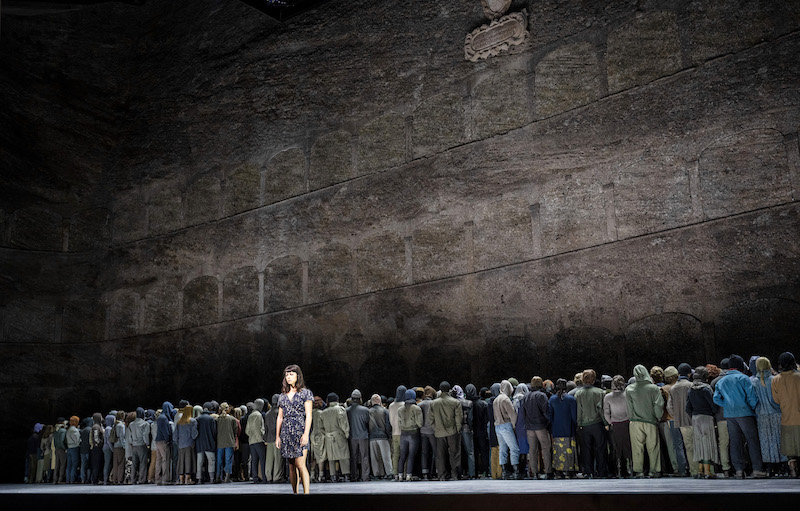
Kat’a Kabanova is Janacek’s most personal opera, an homage to his muse Kamala Stosslova, and homage to his hopeless, unrequited love for her, reasons enough to place this intimate, salon drama by the 67 year-old composer within the vast, hard stone confines of the Rock Riding School.
In the initial moment of silence before music we hear birds chirping, an auditory image that portends escape. We will again hear the chirping birds when Kat’a contemplates a grave for which she yearns, and where she will find, perhaps, some sort of peace.
Stage director Barrie Kosky played with the vast stage space in myriad ways, most striking was the placement of a thousand or so citizens of Salzburg standing in lines across the stage, motionless, their backs to us. This astounding image plus the stone face of Salzburg’s mountain were the sole backdrop to encompass a hopeless world.
Stage director Kosky is famous for such in-your-face images (like the Bayreuth Beckmesser balloon).
The first music we hear takes us into Kat’a’s psyche as we see and hear in the music her mind and body darting back and forth across the stage. Kat’a was sung by American soprano Corinne Winters in a voice cannily suited to the guilts of a Janacek heroine belying the purity and innocence of her spirit. Mlle. Winters physically embodies such a heroine as well. Though of powerful, and quite beautiful voice she is of petite stature, vulnerable to abuse. As Kat’a she offered little physical resistance to the considerable emotional forces bearing down on her, and at the same time she embodied a very great spiritual turmoil.
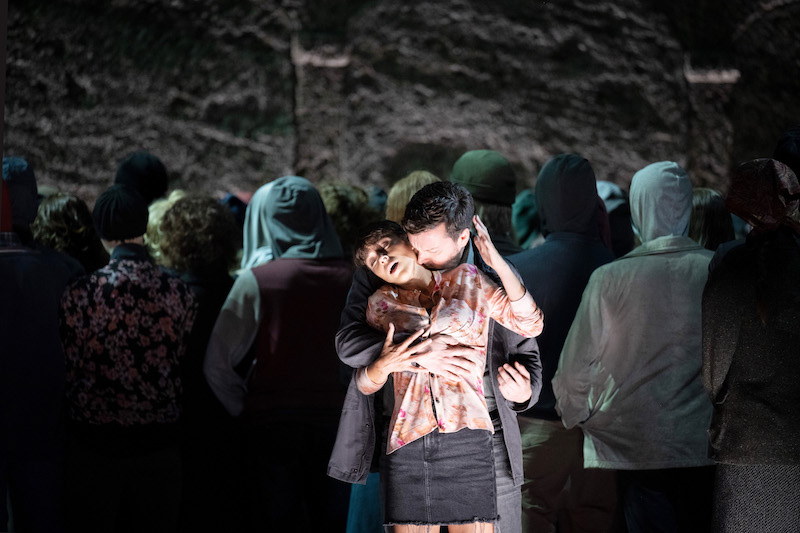
Corinne Winters as Kat'a, David Butt Philip as Boris
Kat’a’s situation is complicated by the young man who has fallen in love with her, and with whom she has had, perhaps, a flirtatious moment. He, Boris, was sung by British tenor David Butt Philip, a singer of beautifully pure voice whose dimensionality of spirit embraces Don Jose, Lohengrin and Grigory, though Janacek’s Boris is surely the most emotionally complex role he embraces — Boris is an ardent lover, though he is passive to an abusive uncle. His potential inheritance is more important to him than his emotional fulfillment. He exhibits an amazing indifference to existential suffering.
The most enduring menace to Kat’a’s well being is her abusive mother-law, Kabanicha. In Barrie Kosky’s telling of Janacek’s tale Kabanisha is pathologically abusive, hardly a stalwart guardian of family, social and business interests. This role was assumed by distinguished dramatic soprano Evelyn Herlitzius who made the role about nothing more than abuse, this accomplished by authoritative voice and powerful diva presence.
Stage director Kosky indeed thrusts the story well beyond Janacek’s family drama playing out in a small town somewhere, anywhere. There is no salon, encounters occur when actors emerge from the lines of the Salzburg citizens, the love garden is but a huge freed space of the stage, the thousand Salzburg citizens having been moved to one side during an act break. The river into which Kat’a throws herself is simply where Kat’a suddenly falls through the floor of the stage.
Finally the Barrie Kosky production is an existential intermezzo that plays to a huge, indifferent world. N.B. The thousand Salzburg citizens I first imagined to be on the Rock Riding School stage were in fact, disappointingly, dummies (motionless puppets).
Janacek’s additional actors orbit these three personalities. The young lovers who escape to Moscow, Varvara and Váñá, were skillfully played by Slovakian mezzo-soprano Jarmila Balážová and British tenor Benjamin Hulett. Dikoj, the abusive uncle as well as Kabanicha’s play dog, was gamely enacted by German bass Jens Larsen. Kat’a’s drunken, if somewhat sympathetic husband Tichon was convincingly portrayed by Czech tenor Jaroslav Brezina.
The Kosky abstraction of Janacek’s drama served to render the delicate emotional tracery of the Janacek orchestral score in high relief. Czech conductor (of Brno origin) Jakob Hruša evoked all possible Eastern European musical magic from a very willing Vienna Philharmonic.
De Temporum Fine Comoedia and Herzog Blaubarts Burg, August 6, 2022, Felsenreitschule, Salzburg. Photos copyright Monika Ritterhaus, courtesy of the Salzburg Festival.
Kat'a Kabanov, August 7, 2022, Felsenreitschule, Salzburg. Photos copyright Monika Ritterhaus, courtesy of the Salzburg Festival.
L'incoronazione di Poppea at the Aix Festival
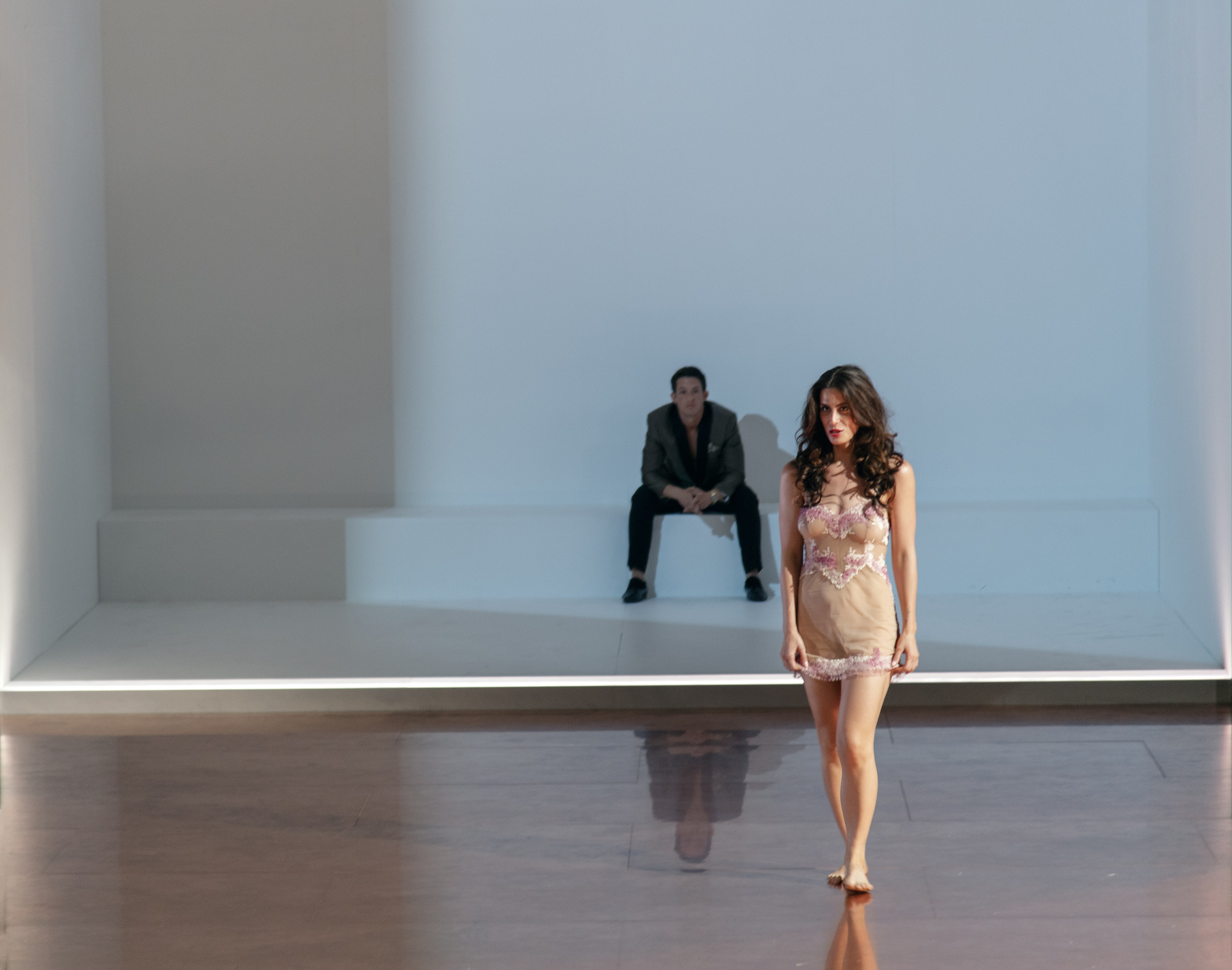
Jacqueline Stucker as Poppea, Jake Arditti as Nerone
It is hard to say which was more impressive just now in Aix’s tiny Jeu de Paume theater — the musical edition of the Monteverdi masterpiece realized by conductor Leonardo Garcia Alarcón, the production created by American stage director Ted Huffman, or the performance by an ensemble of eleven singers and an instrumental ensemble of eleven players.
The Huffman production made it perfectly clear that this opera is about sex — not that that is any secret — ergo eleven beautiful young men and women with one thing on their minds. Though what good is sex if you can’t talk about it, thus these eleven excellent singers had been coached within an inch of their lives (or maybe it came naturally) to negotiate the heightened speech (Monteverdi’s famed dramatic arioso recitatives) that exploded from their throats.
Basically the emperor Nerone and his paramour Poppea are having at it (he’s a buff high soprano counter tenor, she’s a gorgeous lyric soprano), but there are problems. A Nerone adjunct, Ottone, is sick in love with Poppea (he’s a handsome, warm voiced haute-contra tenor), Nerone’s wife Ottavia is neurotic, classy, rich, but yesterday’s news (she’s a very good looking woman with a beautiful, forceful mezzo soprano voice, until Nerone throws her chokingly out of Rome). Drusilla is sick in love with Ottone (she’s sleek and exotic, a shining, Indian soprano), not to mention the stoic philosopher Seneca (he’s a handsome, fashionably bearded young man with a beautiful, persuasive bass voice).
We sat in spellbound, absolute silence waiting for the poison to take effect. Supine, Seneca then enjoyed a long, painful death. A death Nero celebrated with the poet Lucano (he’s a buff, beau Englishman) and Poppea, the three of them, semi-naked, left the stage for a bit of intermission.
You ask about Arnalta and the Nutrice? They are sung by the same tenor (he’s a charming, young, consummate comedian with a voice that could be very loud, and at times [expressing his love for Poppea] quite beautiful). A most delicious moment was Valletto’s seduction of Damigella (played of course by Arnalta). Valletto was played by Amore (she’s a cute, fine soubrette who could go white voiced to be infantile, and then bray bratily) — this compound travesty a witty joke about the opera’s confusion of male and female voices.
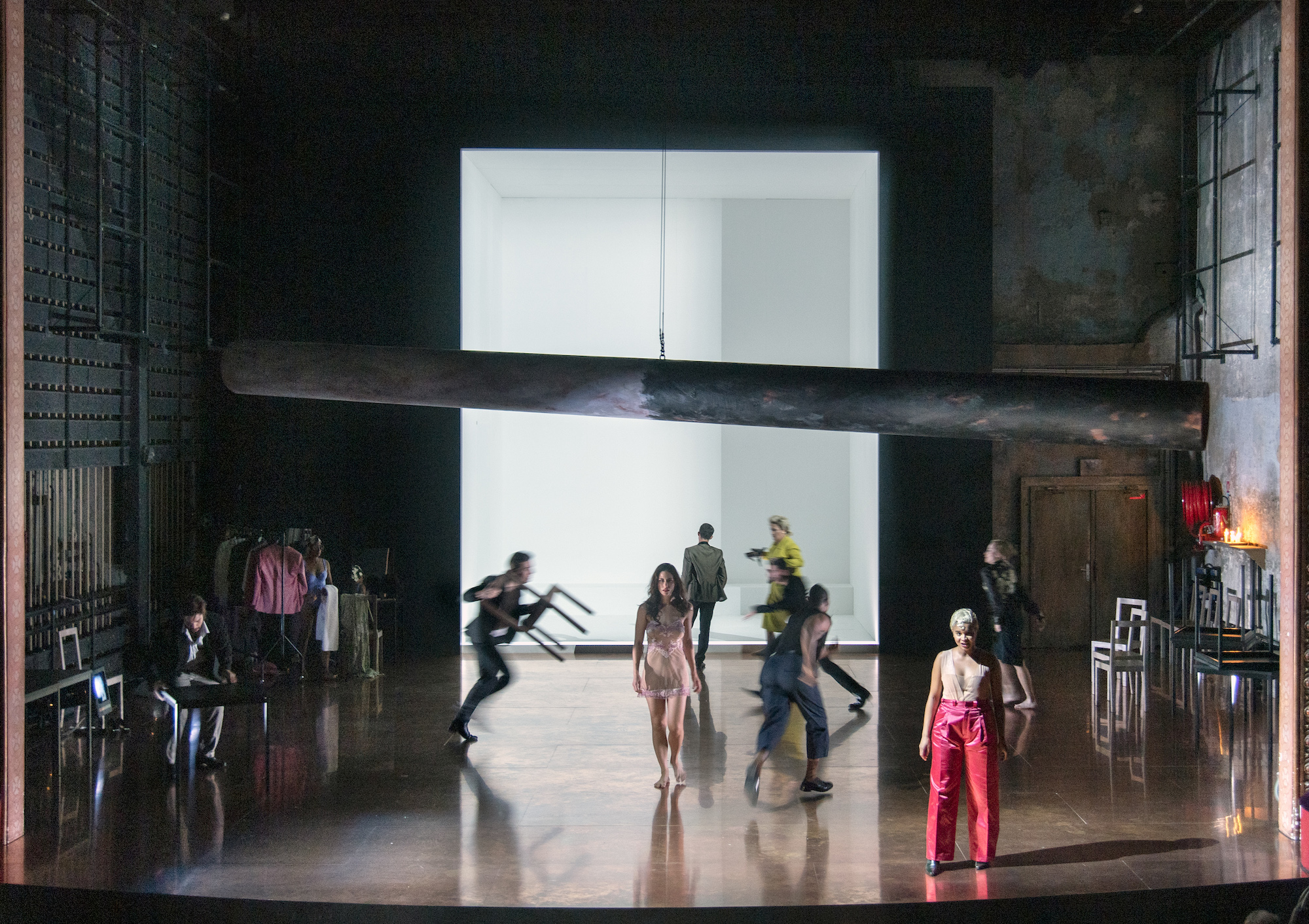
Arnalta, center
The Huffman production has its eleven performers hang out on the naked stage at all times. Though there is a huge tube of evident indeterminate symbolism hanging horizontally from the rafters, and a hard edge, abstract proscenium platform sitting at the back. An a vista clothing rack to effect the changes of character sits upstage right. There are a few tables and chairs that sit on the sides of the stage except when they are used oh-so-sparingly in the action.
Costumes are contemporary chic off to high fashion. There is a lot of low beam, golden sidelight that floods the stage from time to time. No gesture was not provocative in the endless, seamless flow of the opera’s 32 scenes.
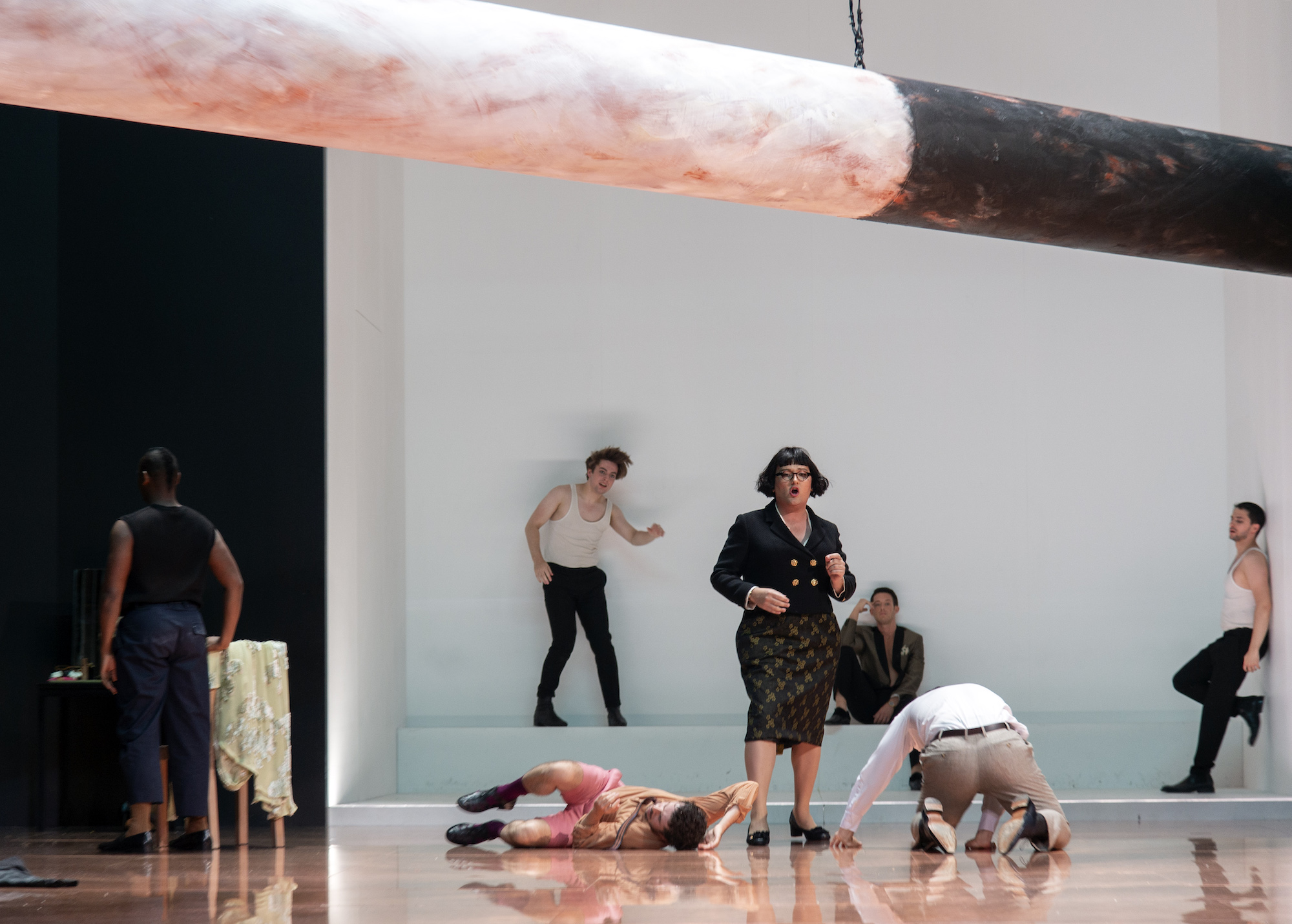
Poppea, center, Amore in red pants
Magically the eleven voices encompassed the 20 named roles in Monteverdi’s opera. A guards’ duet at the beginning added yet another tenor to the ensemble (he’s a fine voiced, handsome young Italian) while someone had to hand the poison to Seneca (a muscular dancer, black Guadeloupean bass baritone) and both became, with others, consuls, tribunes and students as needed.
The musical edition, as the staging, was of exquisite detail, foremost in constraining the opera’s personae to eleven chosen voices. The production’s coup de théâtre was certainly the pairing of two soprano voices for the final, sublime duet that unites Nero and Poppea at last, sublime in the voicing of the orchestra for this scene, and sublime in the tension of the two lovers slowing shedding their wedding whites. Lingering sex was one with Monteverdi’s enigmatic last few notes.
Conductor Alarcón made the eleventh players in the pit, adding a third keyboard continuo to a harp, two harpsichords with their cellos and bass, the lute, theorbo and the two cornettos doubling on secondary instruments. Far from creating a spare accompaniment to the recitatives, ariosos and madrigals conductor Alarcón saw to it that these instruments added a flurry of sounds to the production’s swirling world of primary instincts. The maestro moved well beyond all sense of a purity of Baroque style, finding no musical shame to adding the sophisticated harmonies and gestures of American jazz to Arnalta’s meteoric rise in social standing.
The ovations were thunderous.
Cast and Production Staff
Poppea, Jacqueline Stucker (US); Nerone, Jake Arditti (GB); Ottavia, Fleur Barron (GB); Ottone, Paul-Antoine Bénos-Djian (FR); Seneca, Alex Rosen (US); Arnalta, Miles Mykkanen (FI); Drusilla, Maya Kherani (US); Amore, Julie Roset (FR); Lucano, Laurence Kilsby (GB); Guard, Riccardo Romeo (IT); Littore, Yannis François (GP). The Capella Méditerranée (FR). Conductor, Leonardo Garcia Alarcón (CH); Stage Director, Ted Huffman (US); Scenery, Anna Wörl (DE); Costumes, Astrid Klein (DE); Lighting, Bertrand Couderc (FR); Movement, Pim Veulings (NL). Théâtre Jeu de Paume, Aix-en-Provence, France, July 18, 2022.
Moīse et Pharoan at the Aix Festival
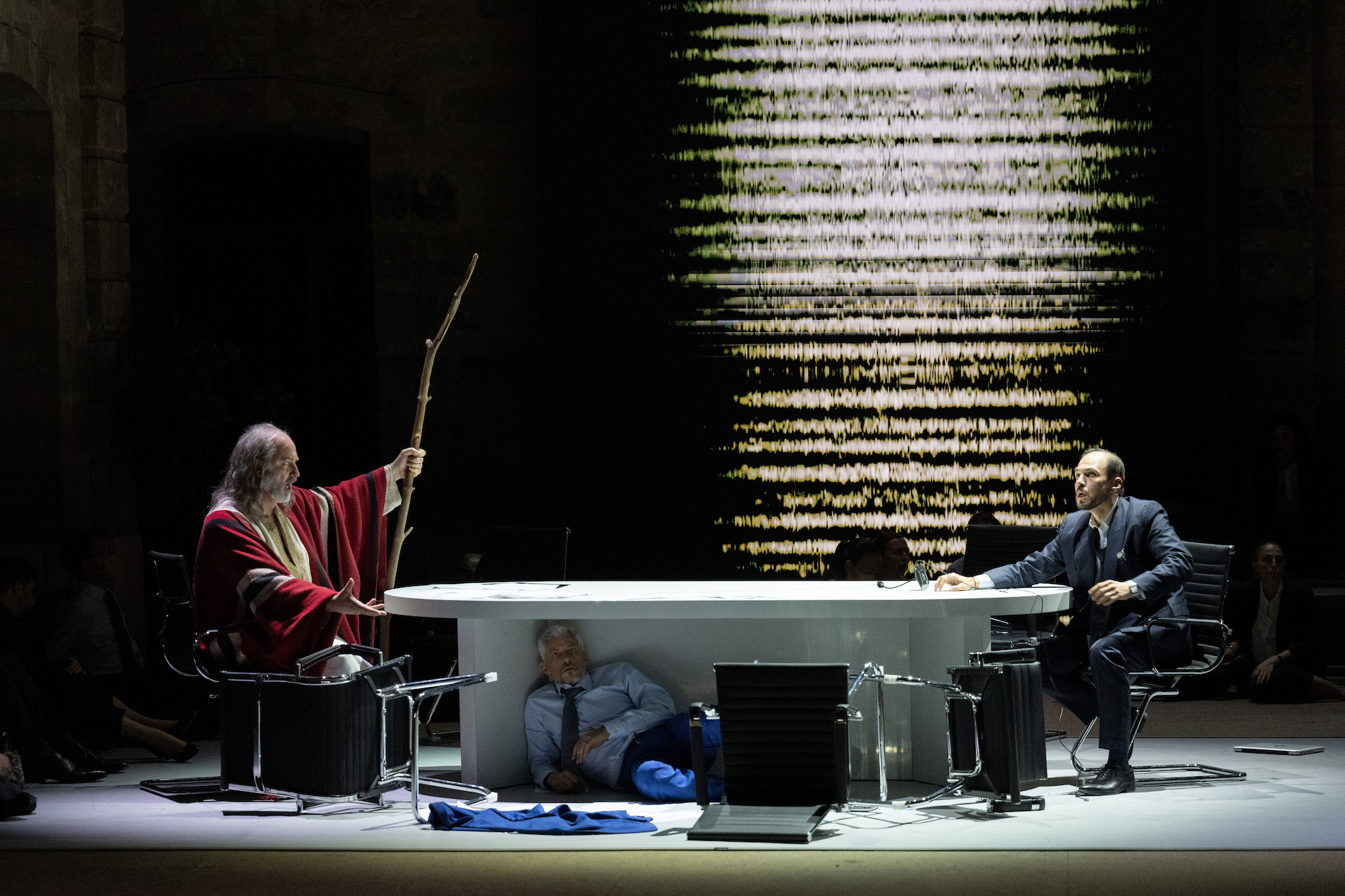
Jacqueline Stucker as Poppea, Jake Arditti as Nerone
Rossini at the hand of a non-Rossinian, stage director Tobias Kratzer, to the baton of a real Rossinian, conductor Michele Mariotti.
At the downbeat it was pure Rossini, Mo. Mariotti establishing the rhythmic vitality that animates voices to find the joy of singing. The great Rossini comedies and the great Rossini tragedies are filled with characters who have much to say and much to feel, always expressed with a virtuosity of voice that is meant to thrill.
That was it for Rossini.
But this is France. Rossini had made his Neapolitan Mose in Egitto into the French grand opera Moïse et Pharaon. Here it how it happened just now in Aix:
German stage director Tobias Kratzer gained much fame from his charming, off-the-wall Bayreuth Tannhauser. His now established formula integrates cinematic sequences within standard operatic storytelling. The interpolated movies, real or imagined, are intended to be a distraction, let us say a relief from far-fetched opera plots. That Wagner profited, i.e. did not suffer from such shenanigans, may be attributed to Wagnerian mythical abstractions that can wear many cloaks.
On the contrary, Rossini’s situations are very specific, derivative of Baroque opera’s “affections,” a specific emotion (love, hate, desire, joy, sorrow) and how beautifully such emotions could be expressed. And specifically to Rossini, when individuals are not holding forth, one is confronted with a Rossini ensemble, the most complex examples of musical and emotional mechanics ever imagined.
For this Rossini mise en scène stage director Kratzer obviously worked backwards, his off-the-wall coup de théâtre was his staging of the opera’s conclusion — it was a Tel Aviv beach, its content sunbathers hardly interested in the biblical tales that got them there. Not that that had much mattered to Herr Kratzer either. [See featured image where police are clearing the beach for the final tableau. All photos copyright Monica Rittershaus, courtesy of the Festival d'Aix.]
All of Kratzer’s locations have the sharp focus of cinematographic images, though he indulged in a real movie for the Egyptians drowning in the Red Sea — real suit and tie guys overcome by a real ocean, amazing, forget the poetry of biblical myths. It was however puzzling that the Israelites donned life vests and pulled out rafts to cross the sea when all they had to do was walk across it.
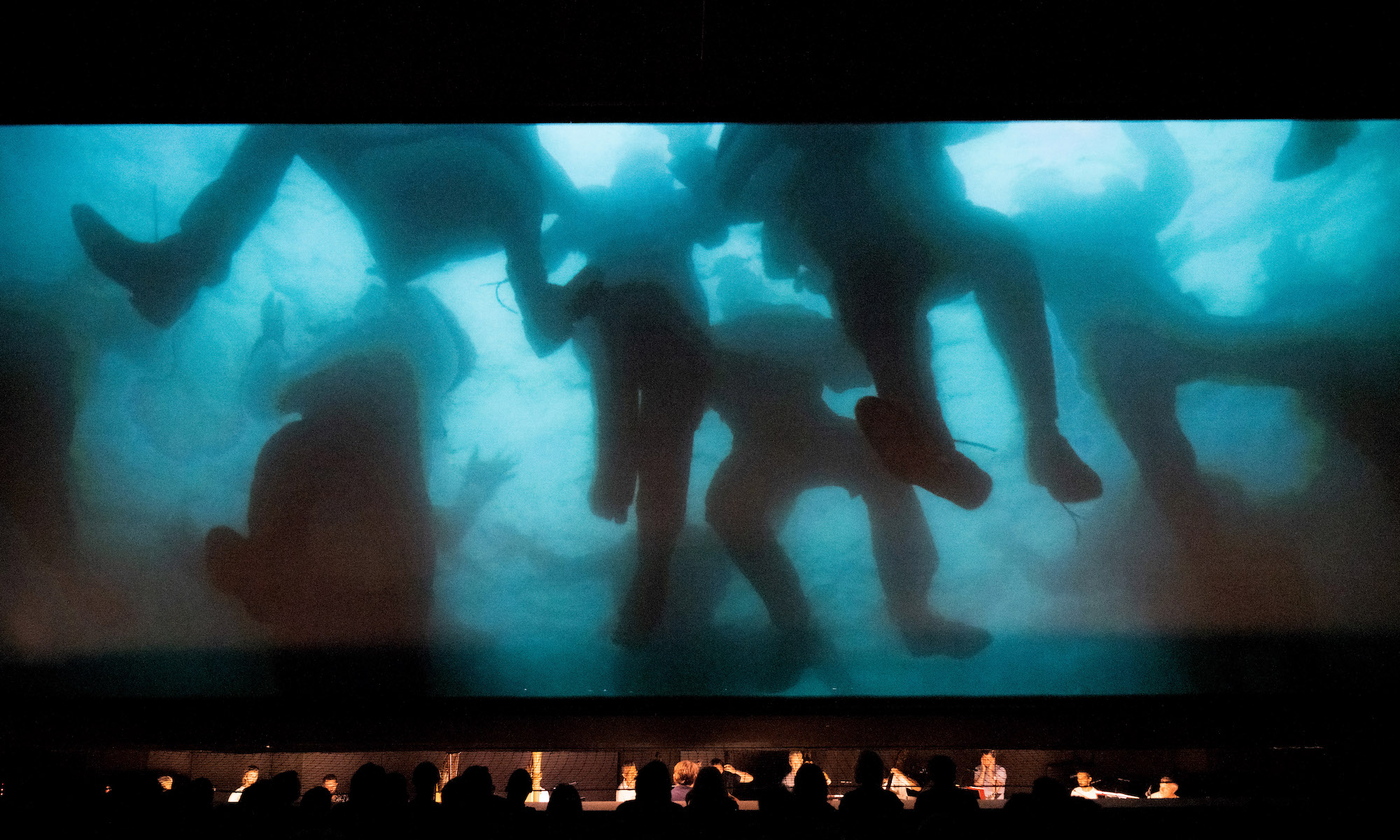
The drowning political elite of Egypt, at bottom the Orchestra de l'Opéra de Lyon
French grand opera is indeed about spectacle, maybe tricky cinematography is too easy.
The initial setting of the opera was schizophrenic, the stage divided exactly in half, the Israelis in a refuge camp of makeshift tents on the left, the Egyptians in a chic, modern office environment on the right. There was but one ancient reference — Moses, alone, in biblical get-up including the obligatory staff.
Though Rossini’s story telling is straight forward, this staging confused happenings to the degree that by act III everyone on stage had to take a break. They arranged themselves in rows of chairs to watch French grand opera ballet, and catch their breaths maybe.
Belgian choreographer Jeroem Verbruggen construed a destruction of all that ballet ever was, in keeping with Herr Kratzer’s take that Rossini could not possibly have known what he was doing. Seven excellent dancers executed choreographed slips, falls and collapses in amazing movements that delighted those sitting on the stage far more than those of us who had paid to see the performance.
The Aix Festival’s casting for this production was of some sophistication, given its crude grand opera perimeters. Italian bass Michele Pertusi sang Moses. Once an esteemed Rossinian Mr. Pertusi is now known as a Verdian, thus he added imposing vocal authority to his Rossini resurrection rather than relying on Rossini’s vocal diplomacy. His was a gruff, no nonsense Moses in keeping with the narrow dramatic focus of the production, whatever it was.

Michele Pertusi as Moses, Adrian Sampetrean as Pharoan
Though a viable Rossini singer, if of small scale, Romanian bass Adrian Sampetrean as the Egyptian Pharaon was costumed in an unremarkable business suit and staged anonymously among the Egyptian bureaucrats, perhaps we saw his face among the drowning governing elite as they attempted to cross the Red Sea (there was of course no army). Rossini had made the Pharaon’s role much bigger for the French version, hence the addition of his name to the title. The role virtually disappeared in the Kratzer production.
Of much more presence was Russian mezzo soprano Vasilisa Berzhanskaya as the Pharaon’s wife Sinaïde. She has the spectacular Act II aria and scene “Ah d’une tendre mère” which earned her the sole [!] intra-act ovation of the performance I attended.
Samoan tenor Pene Pati (San Francisco finished) sang the Pharoah’s son Aménophis, forsaking any possible pretense that Mr. Kratzer’s production had anything to do with Rossini. Though Mr. Pati is a wonderful singer within his fach he does not have the sound or agility of a Rossinian. Much the same may be said of Aménophis’ love interest in the biblical plot, Anaï, the role sung by Trinité-et-Tobagoian soprano Jeanine De Bique. This wonderful young singer does have amazing fioratura (and important credits in the Baroque repertory), but she does not possess the forward, brighter sound of a Rossini heroine.
Casting of the smaller roles enhanced the stylistic whateverness of the Kratzer production. French mezzo soprano Géraldine Chauvet, a Carmen at the Arena di Verona, assumed considerable presence as Marie, Anaï’s mother. French-Irelandese baritone Edwin Crossley-Mercer, a Guglielmo in Aix and Zurich, sang the high priest Osiride in beautiful voice. Turkish tenor Mert Süngü assumed the role of the Pharaon’s brother Éliézer though without establishing the importance of this character.
Il viaggio, Dante at the Aix Festival
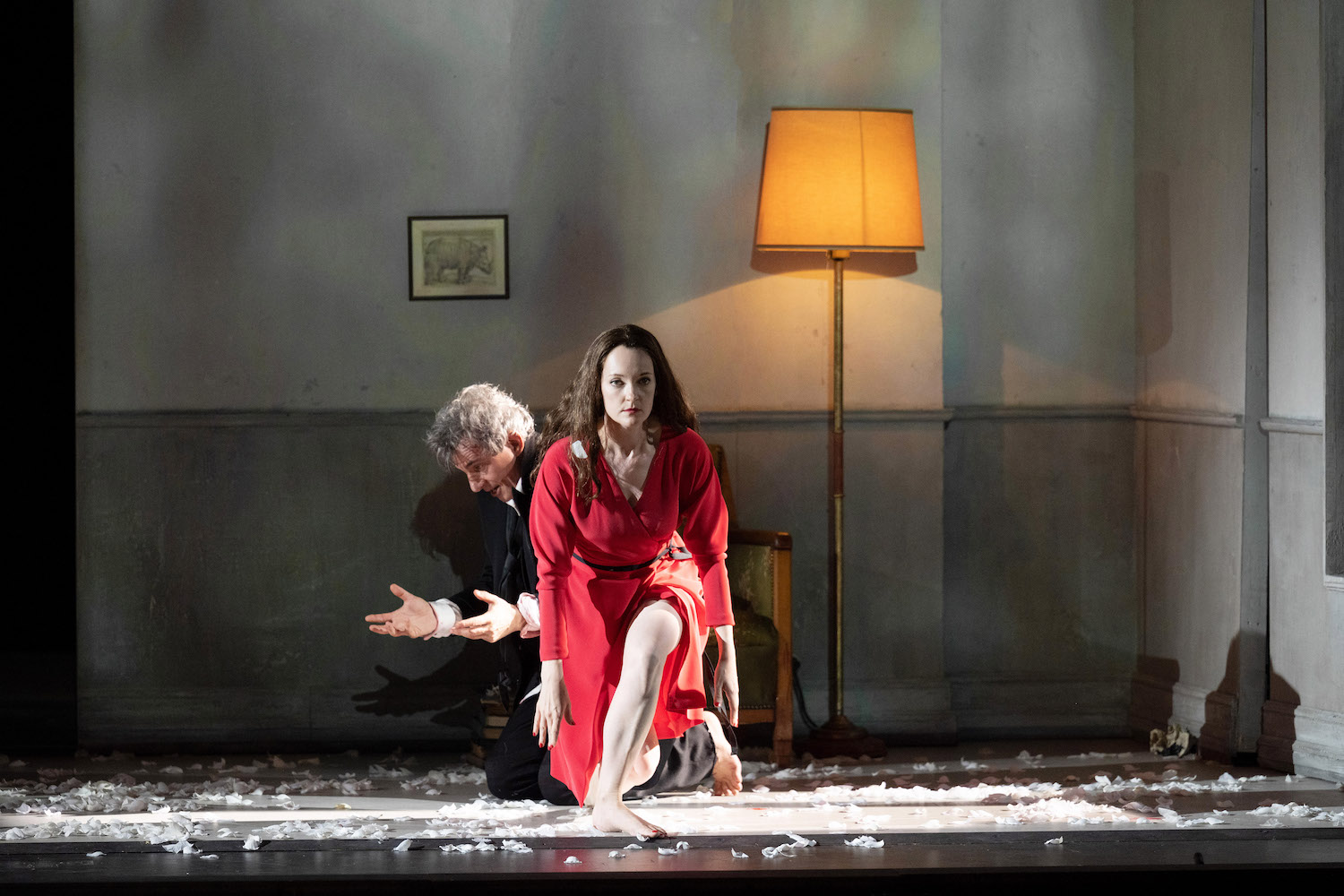
Jacqueline Stucker as Poppea, Jake Arditti as Nerone
A world premiere, the tenth opera of 67 year old, prolific French composer Pascal Dusapin in a production that will move on to Paris, Saarbrücken and Luxembourg.
In the staging of the opera by famed German metteur en scène Klaus Guth a drunken driver — who later will be named Dante — crashes his car on a dark, lonely country road (a huge video projection on the show curtain). Dying, he is not alone, a woman who will be named Beatrice is with him.
The opera is a highly sophisticated and very witty satire on the 14th century Italian poet Dante Alighieri’s adoration of a woman, Beatrice, who will lead him to love, to understand love, and to be consumed by love. The libretto is by Frédérick Boyer, creator of the famed television series A French Village, as well as a translator of Shakespeare’s sonnets into French, among a massive catalogue of original and translated works.
Il Viaggio, Dante is sung entirely in Italian (though some Ecclesiastical Latin is included) quoting from time to time lines and verses from both Dante Alighieri’s little book La Vita Nuova and his very big book, The Divine Comedy. These lines anchor us in the opera’s structure — a descent through Dante Alighieri’s nine circles of hell, transition into a purgatory, finding at last a paradise.
The main characters in the opera are the same as in the medieval Dante’s books, namely Dante (baritone), Beatrice (high soprano) who will lead him to ecstatic contemplation, Virgilio (bass) who guides him through hell, and the patron Saint of the blind, Lucia (very high soprano), who directs Dante, weirdly and blindly, towards enlightenment. The opera though adds two more characters, a narrator (spoken), and in a Faustian complication, a young Dante (mezzo soprano).
Dante, whom we already know from the directorial preface, is dying, but he is now dying in his room (see lead image, Jean-Sébastion Bou as Dante, Jennifer France as Beatrice). Saint Lucia knows he needs help to find the light, and the young Dante arrives who laments the loss of his guiding light, Beatrice. Beatrice appears in a dream needing a light for her cigarette (she is a serial smoker — a directorial flourish), and says not to sleep, though the opera continues, dream like.
Virgil leads Dante into a waiting room filled with spooks/shades (Limbo), then through various circles where he is presented with a diversity of spooks, including a hideous Beatrice (now a sprechstimme, shrill haute-contre tenor). Meanwhile the young Dante keeps chasing and losing his Beatrice.
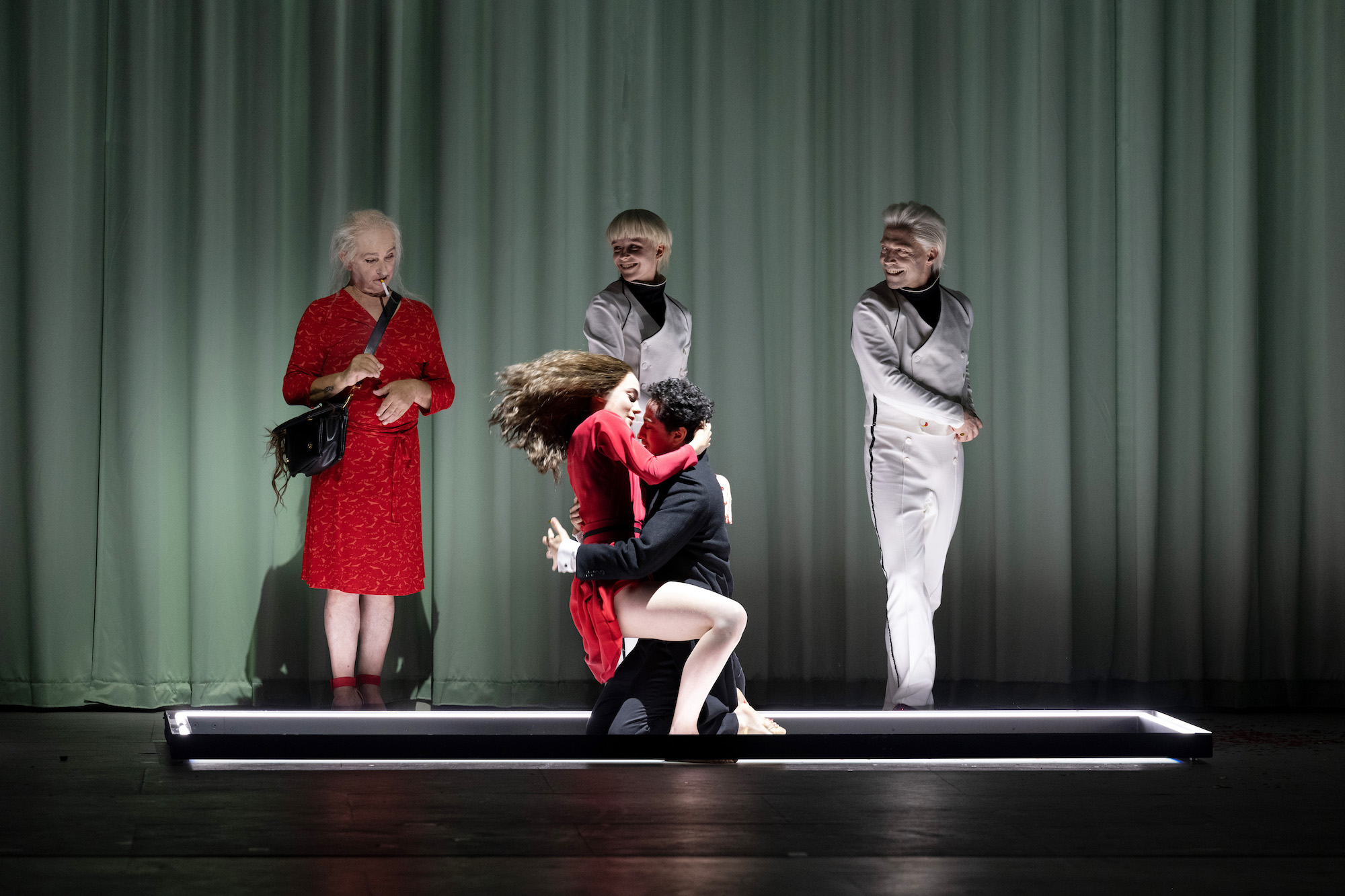
Domique Visse as the voice of the damned, Jennifer France as Beatrice, Christel Loetzsch as the young Dante, with the two showgirl presenters of the damned
There is lot of Gregorian chant (the Beatitudes) from the choir in the pit as Dante and Virgilio pass through Purgatory, and finally they arrive at Paradise where there is more Gregorian chant from the pit while a parade of zombie angel spooks are suctioned off towards eternal light. Beatrice appears back in Dante’s room needing a light for her cigarette (she’s high maintenance). Dante experiences ecstasy. It seemed to fade.
Did I get this right? The charming ring master narrator was not much help, given that Dante’s will and desire are said to exchange themselves as you change a tire — Gia volgeva il mio disio e'l velle, sì come rota ch'igualamente è mossa.
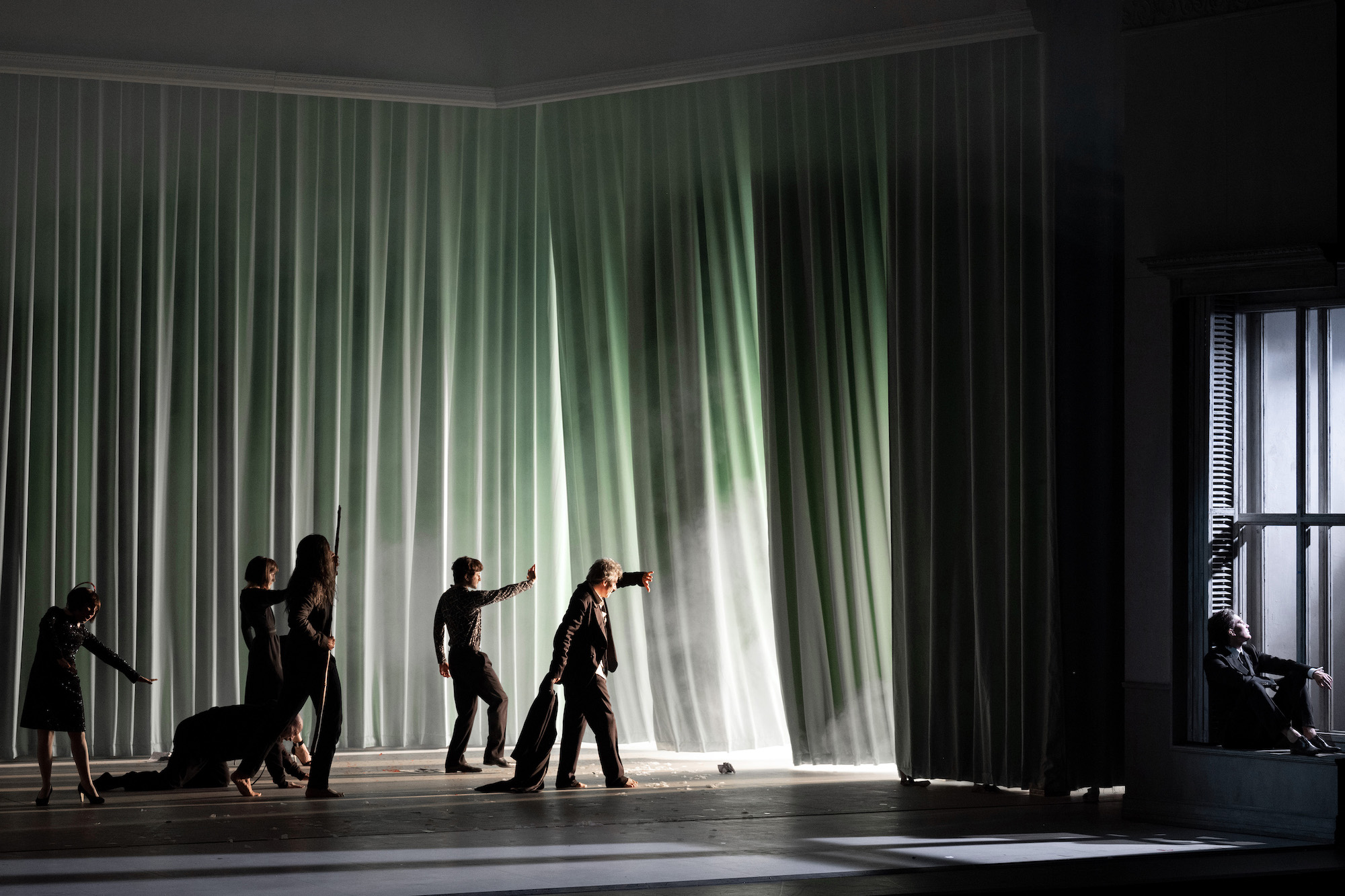
Shades in Paradise being suctioned towards the light of God
Composer Dusapin is no stranger to these themes. His most recent operatic hit was Macbeth Underworld (2019) at Brussel’s La Monnaie. His very first opera was Romeo and Juliet.
The Pascal Dusapin sound, and it is very particular, absorbed all this with great élan. In the French stylistic spirit it is impressionistic rather than mechanical, its sounds now melding together rather than establishing individual colors. The sound has no perceivable structure, remaining a mass. The mass, and it is huge, moves with amazing ease, assuming myriad hues as needed to create a sonic world into which the rarefied world of the divine comedy of the libretto and staging slipped so very naturally.
Dante’s ecstasy was persuasively achieved orchestrally, with the help of an occasional, well placed diatonic chord, as Messiaen too knew exactly where to place them.
Composer Dusapin moves his voices in seeming natural melodic shapes, eschewing sharp intervals, as in fact his orchestral sound avoids sharp percussive noises. His orchestra was double winds and a reasonably small string contingent. The lone exotic instrument was a glass harmonica. The four registers of a sizable chorus of human voices added huge resonance upon occasion. The chorus and orchestra were from the Opéra de Lyon.
The pit of Aix’s Grand Théâtre de Provence is naturally very loud, thus it was unclear to me how much electronic enhancement of sound there may have been. There is a program credit for the name Thierry Coduys as responsible for sound management.
As usual at the Aix Festival the complex production was flawlessly executed, and the casting was exemplary. Foremost was the spoken Tuscan Italian of venerable Florentine bass Giacomo Prestia, who did not sing a note but rendered the evening truly Dantesque in a sparkling white tuxedo, most likely impersonating Dante Alighieri himself. Within the comedy of the libretto and staging both Dantes exhibited great warmth of tone, French baritone Jean-Sébastian Bou was the mature Dante, German mezzo-soprano Christel Loetzsch was the young Dante.
The two stratospheric sopranos were the Brazilian Maria Carla Pino Cury as the delightfully spastic Lucia, and the English Jennifer France [sic] as the celestially deadpan Beatrice. American bass Evan Hughes was the Virgilio. The hellish Beatrice, as the voices of the damned, was a brilliant cameo appearance by the venerable French haute-contre Dominique Visse.
American conductor Kent Nagano managed all the musical and dramatic forces with absolute surety.
All photos © copyright Monika Rittershaus, courtesy of the Festival d'Aix
"Resurrection" at the Aix Festival
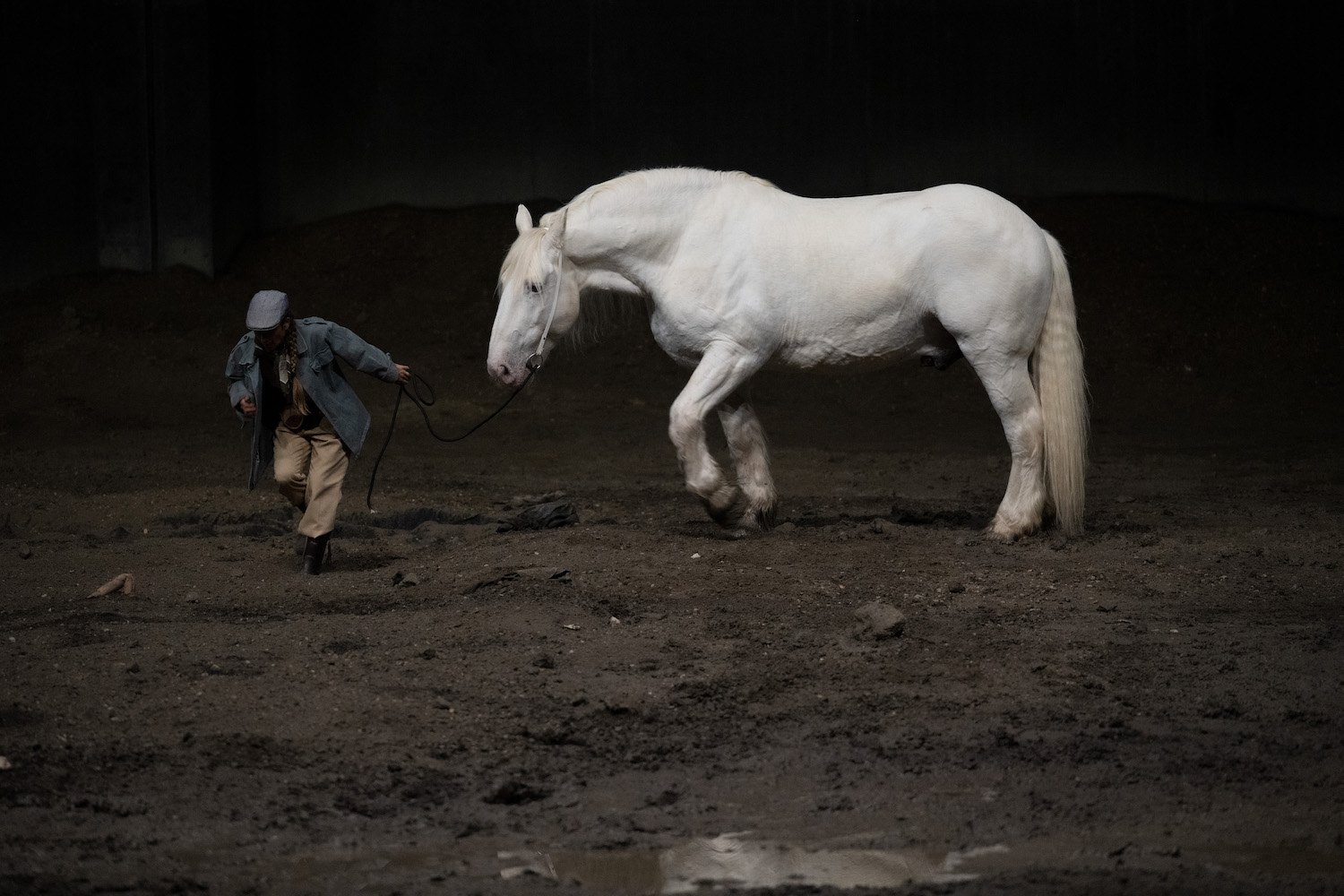
Gustav Mahler himself once offered a program guide to his magnificent symphonic resurrection, later renounced. Just now at the Aix Festival stage director Romeo Castellucci has tried again, and maybe nailed it. After his fashion.
And what a Mahler Symphony No. 2 in C minor, “Resurrection” it was! Conductor Esa-Pekka Salonen led 125 players of the Orchestra de Paris (the faraway French capital’s major orchestra), plus 100 or so singers of the Chœur de l’Orchestra de Paris at an abandoned stadium found atop an isolated, bleak hill not far from the Marseille airport — a magnificent huge, black, graffiti covered block of concrete resurrected!
This foreboding structure was first used in 1994, only four years later it fell into disuse. But just now a single wall of terrifyingly steep stadium seating (no hand rails or other protections) overlooked a massive pit holding the orchestra, chorus and soloists, all very visible to all of us perched above. Behind the pit was a massive staging area, surely exceeding the dimensions of Pierre Audi’s Park Avenue Armory in New York.
Just the place for famed Italian metteur en scène Roméo Castellucci to once again establish himself as a pillar of avant-garde theater, echoing his renowned 2002/2004 Tragedia Endogonidia where he redefines theater as an abstract musical form (closely associated with opera before supertitles, i.e. no discernible words though something or the other is evidently happening).
Mahler knew his programmatic words failed his symphony. Castellucci forsakes all literary words, rendering them only as elements of his musical fabric. Thus in this performance it was no longer Mahler’s Resurrection Symphony, Castellucci had made it into his own.
Except he hadn’t. An artist of equal prowess, Esa-Pekka Salonen, held us in the thrall of one of the most massive pieces of musical construction ever conceived, the subject of which is the multitude of complex questions of human existence. The acoustic of the stadium was, surprisingly, as huge and as precise as the subject of the opera. In the final moments of the opera Mahler adds the organ to capture the grandeur of whatever resurrection may mean to you. It became big, very big, beyond huge, beyond gigantic. [It was just a mightily amplified synthesizer.]
The crowning achievement of the Castellucci staging happened in fact not on the stage, but in the pit. Rows of choristers had sat silently either side of the orchestra for the first four of the massive symphony’s five movements. When finally they began to sing we realized that they had no scores! The magic of this imposing human image was then overwhelmed when, with the words “with wings that I have earned” they rose to their feet!
It was resurrection, may there be no doubt.
The Castellucci mise en scène began in silence, a magnificent, pure white horse came onto the massive dirt mound that was the stage. It slowly, magically crossed the staging area. As it began to exit through the stadium’s loading bay it was caught by young woman who had her cell phone in hand to call for help. Mahler’s symphony began. [See lead photo, all photos © Monika Rittershaus, courtesy of the Aix Festival.]
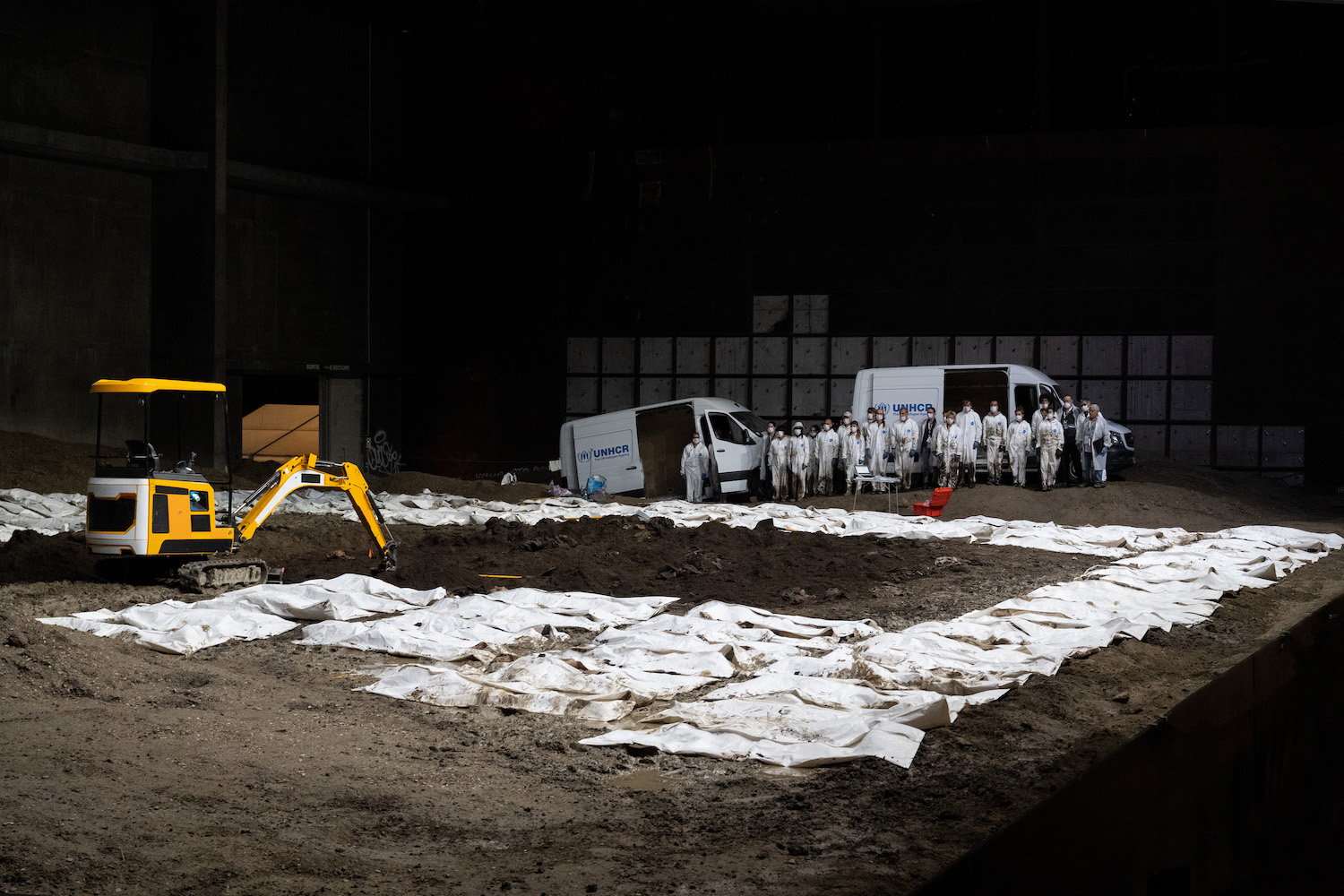
An small army of excavators arrived in trucks, a scoop caterpillar as well. The first four Mahler movements — the allegro maestoso, the andante moderato, the scherzo, “Urlicht,” — saw the slow exhumation of a mass grave in the dirt, surely that of mankind in all its tragic guises. The countless bodies were then loaded in the trucks and driven off, though one excavator remained and continued to dig frantically with his hands. Finally a very last excavator shed her white, protective coveralls, leaving it in the abstract form of a pure white bird against the barren earth.
This was the final Castellucci image — the abandoned mound of dirt, the only discernible form a tiny white bird. As Mahler’s play of scherzos moved toward their majestic symphonic conclusion the lighting became always magically more suggestive. Within the final Mahlerian sonic magnificence a subtle rain began to fall onto this empty expanse, awaiting life.
Resurrection.
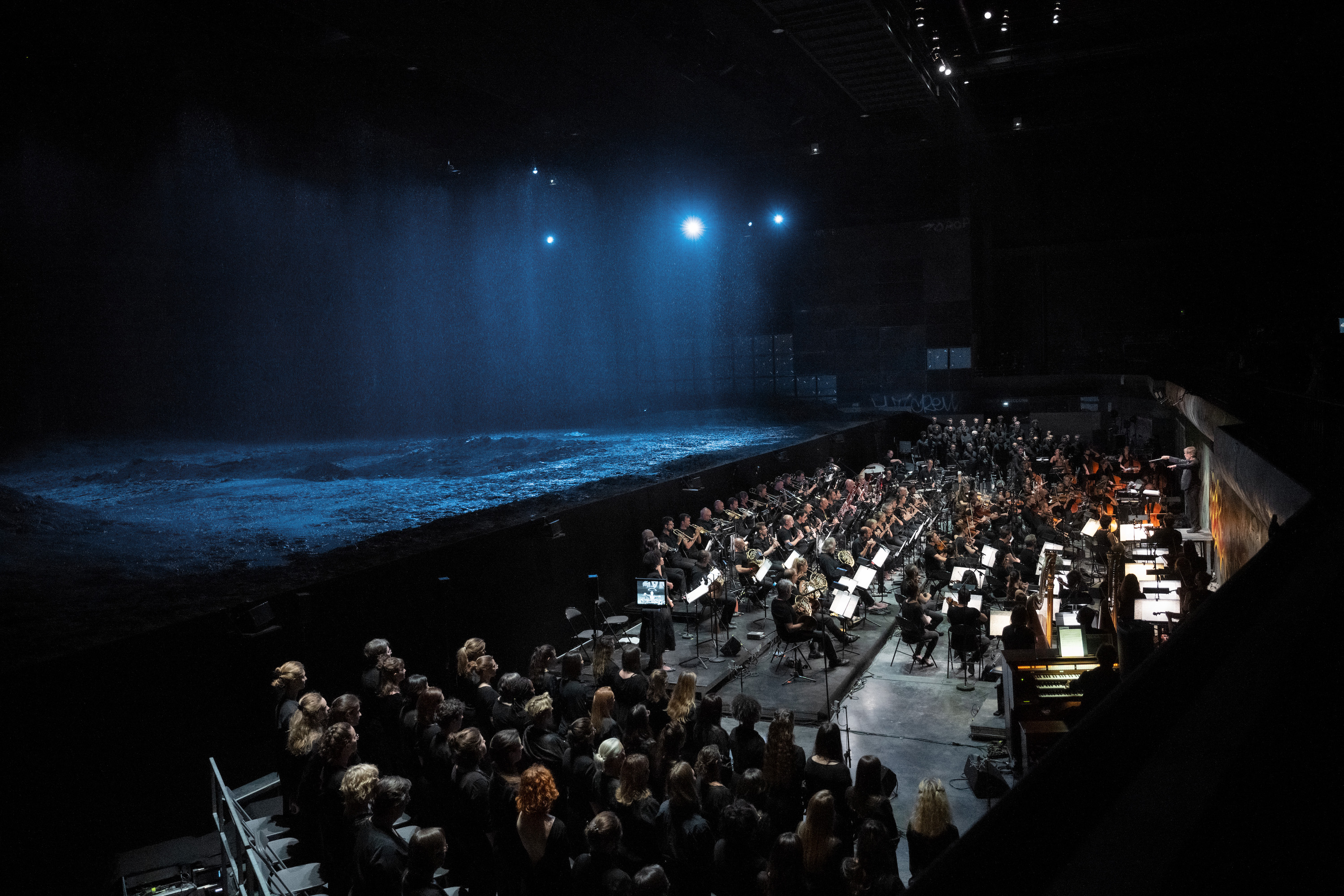
Esa-Pekka Salonen is a conductor of exquisite refinement. From within the sense of absolute intellectual control he imposes, the full expressive power of music emerges — immediate and pure. With the Castellucci intelligence, Salonen created a highly estimable work of theater art for the Aix Festival.
Idomeneo at the Aix Festival
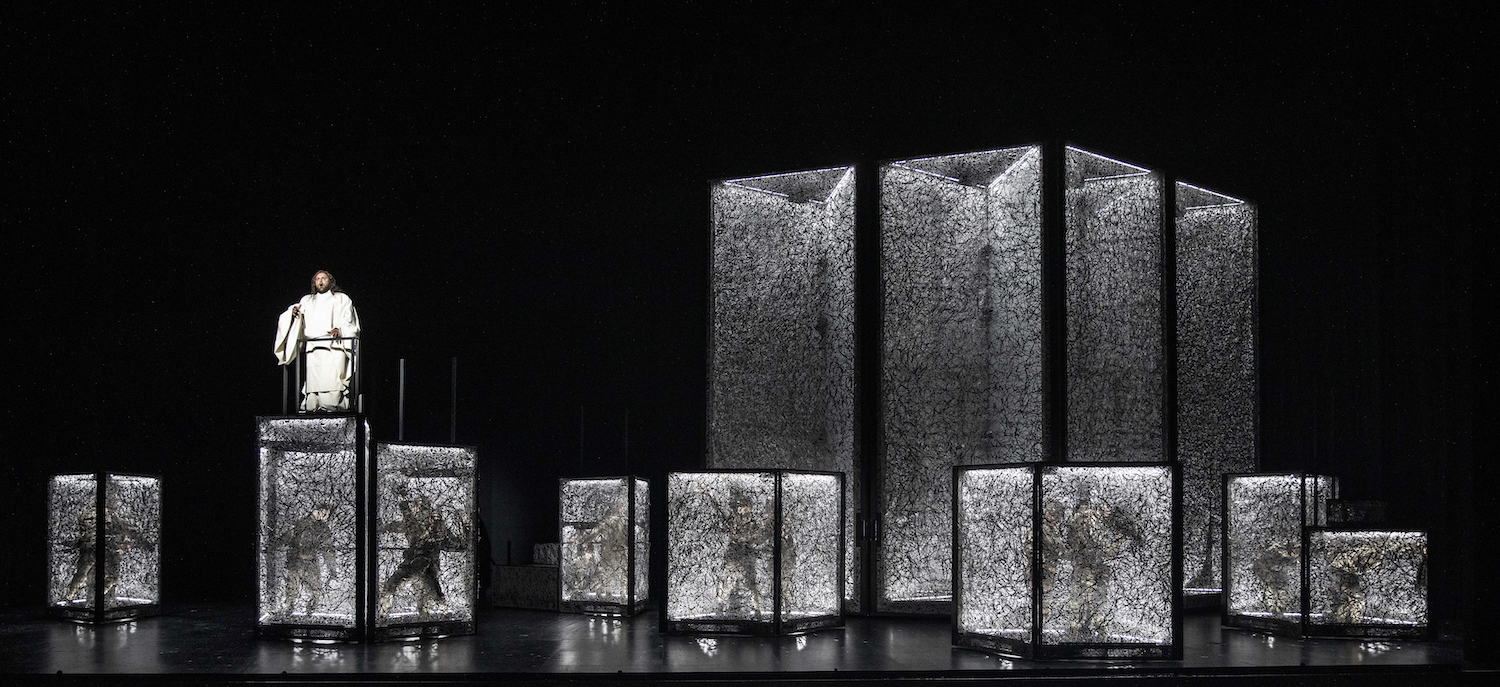
Idomeneo, said to be one of the great operas of all times in a magnificent production at Pierre Audi’s Aix Festival. Though the Mozart opera seria itself had been filtered through a maze of cultures and histories and traditions that stripped it of its charm and humanity and relevance.
Not that that is a bad thing.
The production is signed by Japanese metteur en scène Satoshi Miyagi, artistic director of the Shizuoka (a city 100 miles south of Tokyo) Performing Arts Center. Significantly for us, in recent years Mr. Miyagi has staged production’s at Olivier Py’s Avignon Festival (50 miles up the road from Aix) notably Mahabharata in 2014 at a nearby rock quarry, and Antigone in 2017 at the Cour d’Honneur of the papal palace as well as at Mr. Audi’s Park Avenue Armory in New York.
Japanese architect Junpei Kiz imagined the settings for Mr. Miyagi’s Avignon productions, as he has for this Aix Idomeneo. It is an abstract city, its sky made of eight huge, sometimes transparent screens, its buildings made of screens that form structures, transparent blocks that serve as pedestals on which the opera’s protagonists stand to proclaim its happenings. And as you know, things were dire indeed in twelfth century BC Crete.
Idomeneo îs the king of the island Crete, the surrounding sea inhabited by Neptune himself who proclaimed through a vintage record-player situated atop a block that Idomeneo must yield his throne. The sea’s turbulent waters were danced by the chorus, their bodies strewn on the floor when it was calm.
We greeted Knossos as a city in perpetual motion, its buildings and sky soundlessly propelled by humans partially hidden inside or behind the structures. When movement was not needed (the opera is built, primarily of 14 arias) the buildings sometimes became shadow puppet screens sometimes reflecting an aria’s content. (See lead photo. All photos © Jean-Louis Fernandez, courtesy of the Aix Festival).
If you ask a European or an American to identify a city destroyed by vengeance as was Idomeneo’s city, Dresden of WWII or New York City of 9/11 might be mentioned. Ask a Japanese, surely Hiroshima will be the answer. It was for Mr. Miyagi, his coup de théâtre was the turning of the huge sky screens to reveal a gigantic reproduction of the Fire panel (the second of fifteen) of the Hiroshima Panels at Japan’s famed Maruki Gallery. It was a powerful, symbolic gesture to mark this rare moment of spectacle in Mozart’s opera.
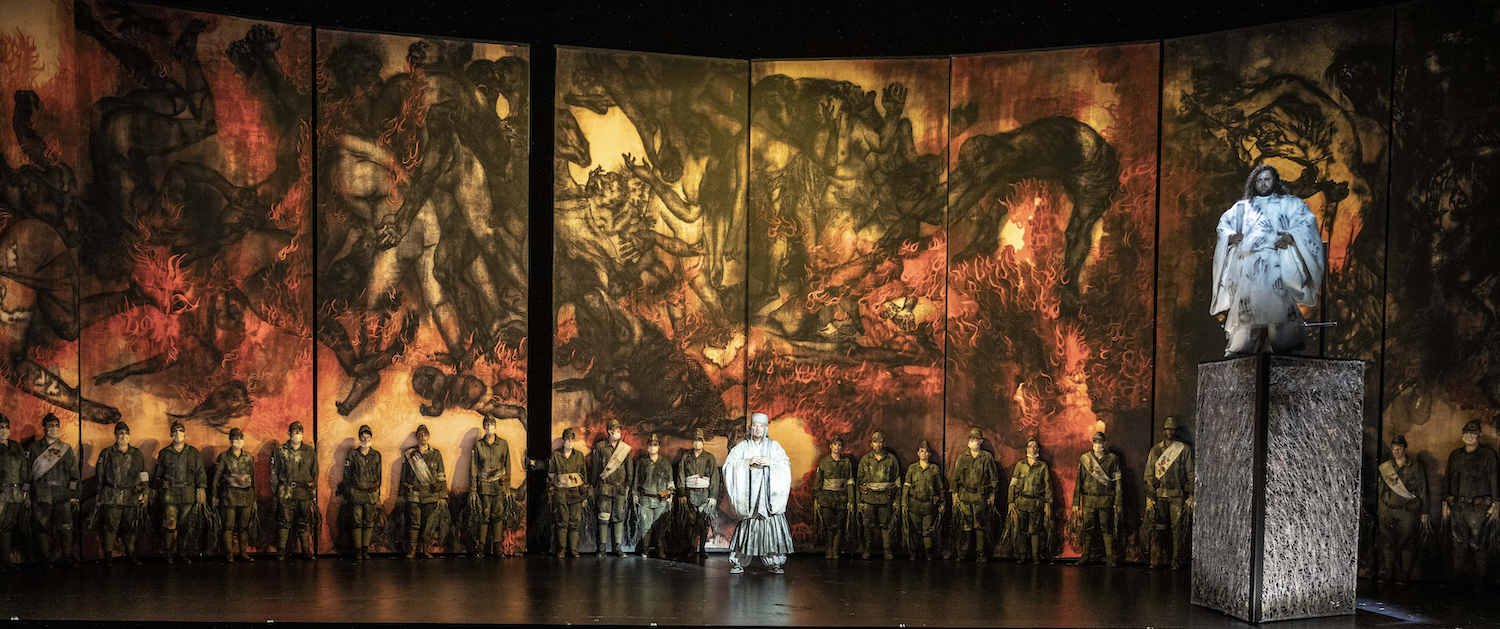
Michael Spyres (upper right) as Idomeneo, Krešimir Špicer (center) as Neptune's priest
Messieurs Miyagi and Kiz have created an abstracted theatrical language based on Asian theatrical traditions and histories onto which Aix imposed the equally abstract language of opera seria [a succession of virtuoso arias until Gluck added choruses, happy endings preferred]. Opera seria was the sole tragic art form, perpetual and universal, that dominated the great European centers throughout the entire eighteen century. It is itself superimposed on Greek myths, Roman myths and histories, and biblical stories — Idomeneo itself is a mythification of the biblical Jeptha!
Mr. Miyagi’s theater does not confuse the audience with the stage. Idomeneo was not our story or stories, or an elaboration of our feelings. Rather, it was a ceremony of the understanding of a civic disaster, and certainly it was a purging of our collective guilts. Mozart ends his opera seria with an orchestral postlude, harmonically cementing the king Idomeneo to his history and his destiny. The Aix Idomeneo ended with the spectacular ascension of four huge, magnificent silver scrolls under which the city, its sky and sea, and its inhabitants disappeared, having been absorbed into the telling of this tragic tale.
The singers, powerless to overcome the ceremonial quality of the staging, gave themselves wholeheartedly to the production’s intentions. American baritenor Michael Spyres, in beautiful, powerful voice, stood confidently and regally on his pedestal, declaring, never enacting his dilemma. His “Fuor del mar” was terrifying, effectively representing the virtuosity of Baroque opera seria singing. As if that were not enough vocal high drama, the spurned Elettra, sung by American soprano Nicole Chevalier, delivered, outraged, her final “D’Oreste, d”Apace ho in seno i tormenti” floor level, and then stormed off the stage though the delighted-at-last audience. Such moments of a felt humanity had been in very short supply indeed.
Another of the few dramatic moments of Mr. Miyagi’s staging occurred when the once estranged lovers Ilia and Idamonte finally were able to declare their love. Atop their pedestals on opposite sides of the stage they actually turned to look, steadily, at one another for the opera’s only duet "Principessa a'tuoi sguardi se offrirmi ardisco ancor - Spiergarti non poss’io.” French soprano Sabine Devieilhe cut a fine figure in the spectacular costumes by Tokyo based designer Kayo Takahashi Deschene, as did her lover Idamonte, sung by Italian mezzo-soprano Anna Bonitatibus. Both singers are especially endowed performers of the Baroque repertory, Mme. Bonitatibus a pants role specialist.
Of special note, and of rare, momentary wit, was the Arbace, a counselor to Idomeneo sung by Dutch tenor Lizard Vrielink, who late in the opera came onstage from the audience to deliver his "Se colà ne' fati è scritto” floor level, wishing to sacrifice himself to save Idomeneo’s kingdom. We too, the audience, were certainly willing to spill a little blood to bring this performance to its conclusion.
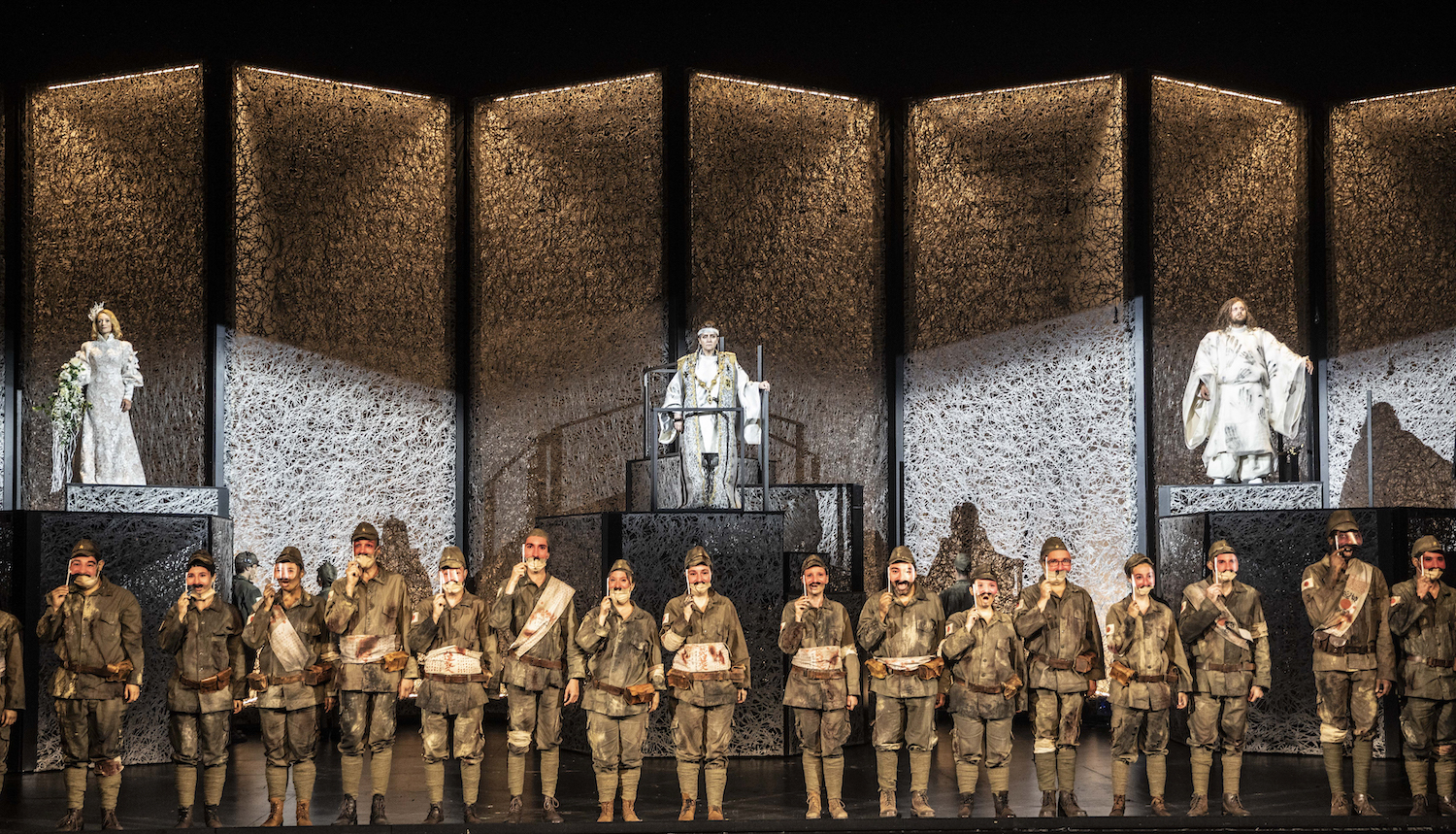
Sabine Devieilhe (left) as Ilia, Anna Bonitatibus (center) as Idamante, Michael Spyres (right) as Idomeneo
Conductor Raphaël Pichon let his famed orchestra of period instruments, Pygmalion, in a fully informed opera seria reading of Mozart’s 1781 score. The Pygmalion chorus executed the opera’s expansive chorus role with enthusiasm and finesse, individual voices often penetrating the choral voice to individualize its participation in the action [à la Gluck reforms].
The musical values of the evening were absolutely splendid, placing opera seria on equal footing with Mr. Miyagi’s finely wrought, if abstract and highly ceremonial Asiatic theater. It was an evening of extraordinary artistic interest.
Finally, is possible that we, the audience, did experience a sort of catharsis, though one of great complexity. Beyond confronting a real, classical tragedy, we had coped with, endured, and survived this quite magnificent production. Having collectively succeeded, we warmly applauded Mr. Miyagi’s bow, though amidst a modicum of very loud boos.
Cast and Production staff:
Idamante: Anna Bonitatibus, Ilia: Sabine Devieilhe, Elettra: Nicole Chevalier, Arbace: Linard Vrielink, Gran Sacerdote: Krešimir Špicer, Voce di Nettuno: Alexandros Stavrakakis, Crétoises et Troyens: Adèle Carlier, Anaïs Bertrand, Clémence Vidal, Constantin Goubet, René Ramos Premier, Danseuses et danseurs: Sophie Blet, Idir Chatar, Apolline Di Fazio, Anaïs Michelin, Yumi Osanai, Ken Sugiyama. Chœur: Pygmalion, Orchestre: Pygmalion. Conductor: Raphaël Pichon, Mise en scène: Satoshi Miyagi, Décors: Junpei Kiz, Costumes: Kayo Takahashi Deschene, Lumière: Yukiko Yoshimoto, Chorégraphie: Akiko Kitamura. Théâtre de l”Archevêché, Aix en Provence, July 8, 2022)
Salome at the Aix Festival
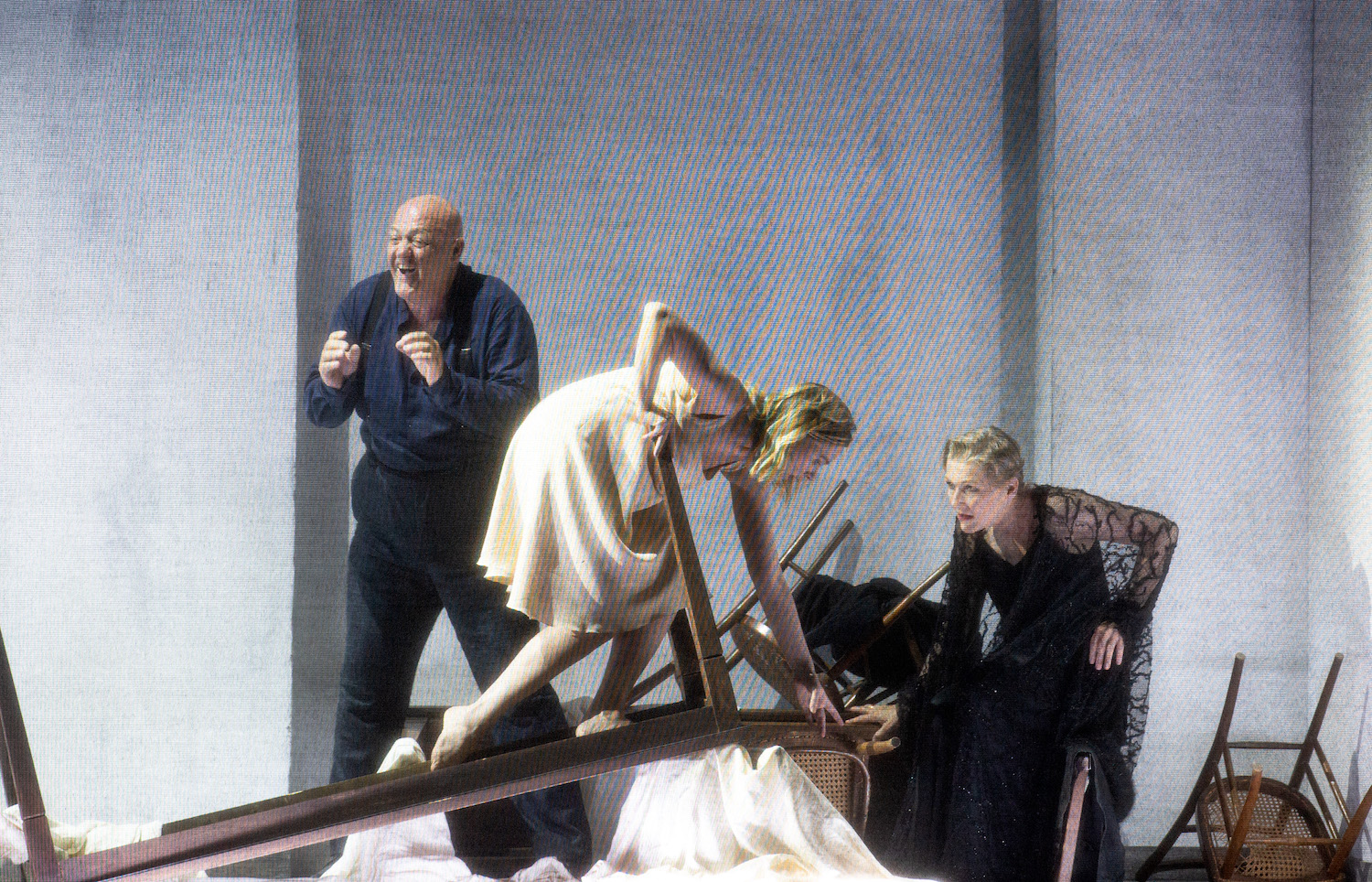
A ponderous reading of the Strauss score, a meticulous, methodical staging of the Oscar Wilde drama. A radiant Salome, an unleashed Herod. Unsettling, sentient scenography. Unexpected magnificence.
High, very high Teutonic art unfolded under the gentle breezes of a cloudless Provençal sky. Shocking, blasphemous imagery — Jochanaan’s severed head on a serving platter at a replication of Da Vinci’s Last Supper, a crucified Herodias — appeared on the flat screen face of a very defined, very contained stage box, like the black and white moving images of primitive expressionistic film, but now widescreen, with the evolving shades of the alabaster skin of John the Baptist and Jochanaan’s black hair.
Conductor Ingo Metzmacher brought the 109 players in the pit of Aix’s Grand Théâtre de Provence (the Orchestra de Paris) to monumental volumes, molded into sumptuous harmonies when not raging and pleading in carefully delineated and paced blocks. Blocks created by venerable German stage director Andrea Breth to slowly and carefully enshrine the nascent, sick, very sick sexuality of the adolescent Salome, and the consummation of her desire. Blocks created by the settings of Austrian scenographer Raimund Orfeo Voigt that moved onto and out of a black floor that heaved with guilty rage and desire under an unsettled, nervous moon.
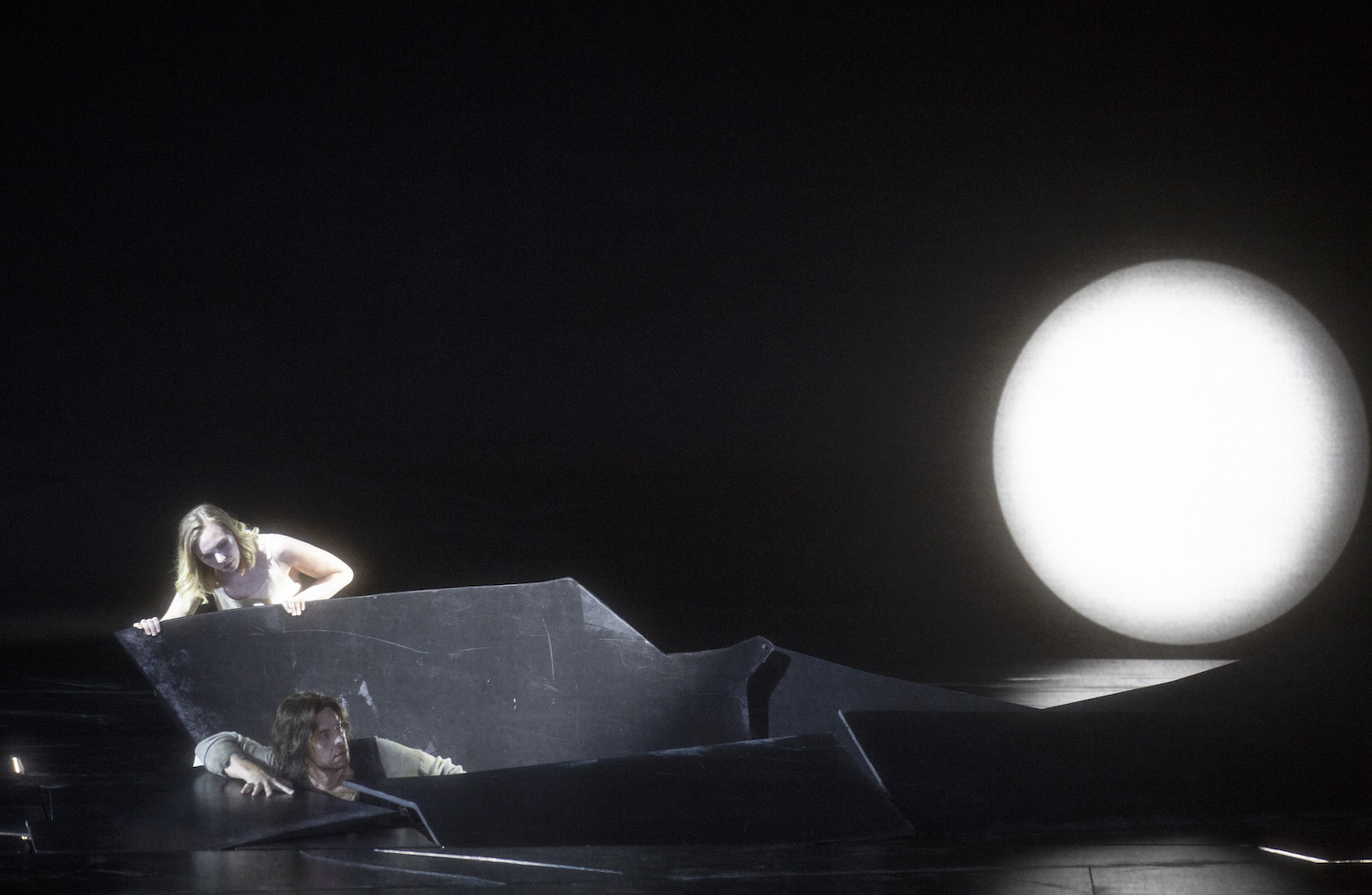
Elsa Dreisig as Salome, Gábor Bretz as Jochanaan. All photos © Bernd Uhlig, courtesy of the Aix Festival.
Within this, and in fact its maker was the unlikely Salome of Franco/Danish lyric soprano Elsa Dreisig, not-so-long-ago an Aix Micaela. If initially she was overwhelmed by the massive symphonic noise, by the time she consummated her desire — this in a white tiled bathroom/interrogation room/isolation cell — she attained a beautiful steely, silvery volume. Tones that sailed easily through the now solemnly beautiful orchestral sounds of fulfillment, when not assailed by the intrusion of Strauss’ nauseous dissonance.
Finally, the crushed Salome curled herself into a fetal position in the corner of her cell, and the hidden voice of Herod shouted needlessly for her slaughter. Salome’s death had been presaged in her dance — her psyche, the stage floor as it happened, was in full eruption. Four identical Salomes slowly, butoh-like, moved through a complex dream of inexorable emotional conflict.
British tenor Jonn Daszak, known to Aix audience through Andrea Breth’s hyper expressionist staging of Wolfgang Rihm’s Jacob Lenz (2019), was at once a protagonist and antagonist to Salome’s psyche. He shrilly dominated his operatic banquet — in fact Salome’s last supper, the Jews to his right erupting into hugely monumental discord, the Nazarenes on his left voicing miracles and salvation.
But the mise en scène, sentient to itself, had had enough. Director Andrea Breth simply stopped it all. We sat at a silent, still tableau `— a mute thunderclap — for the eternity of maybe only a few seconds. Strauss be damned.
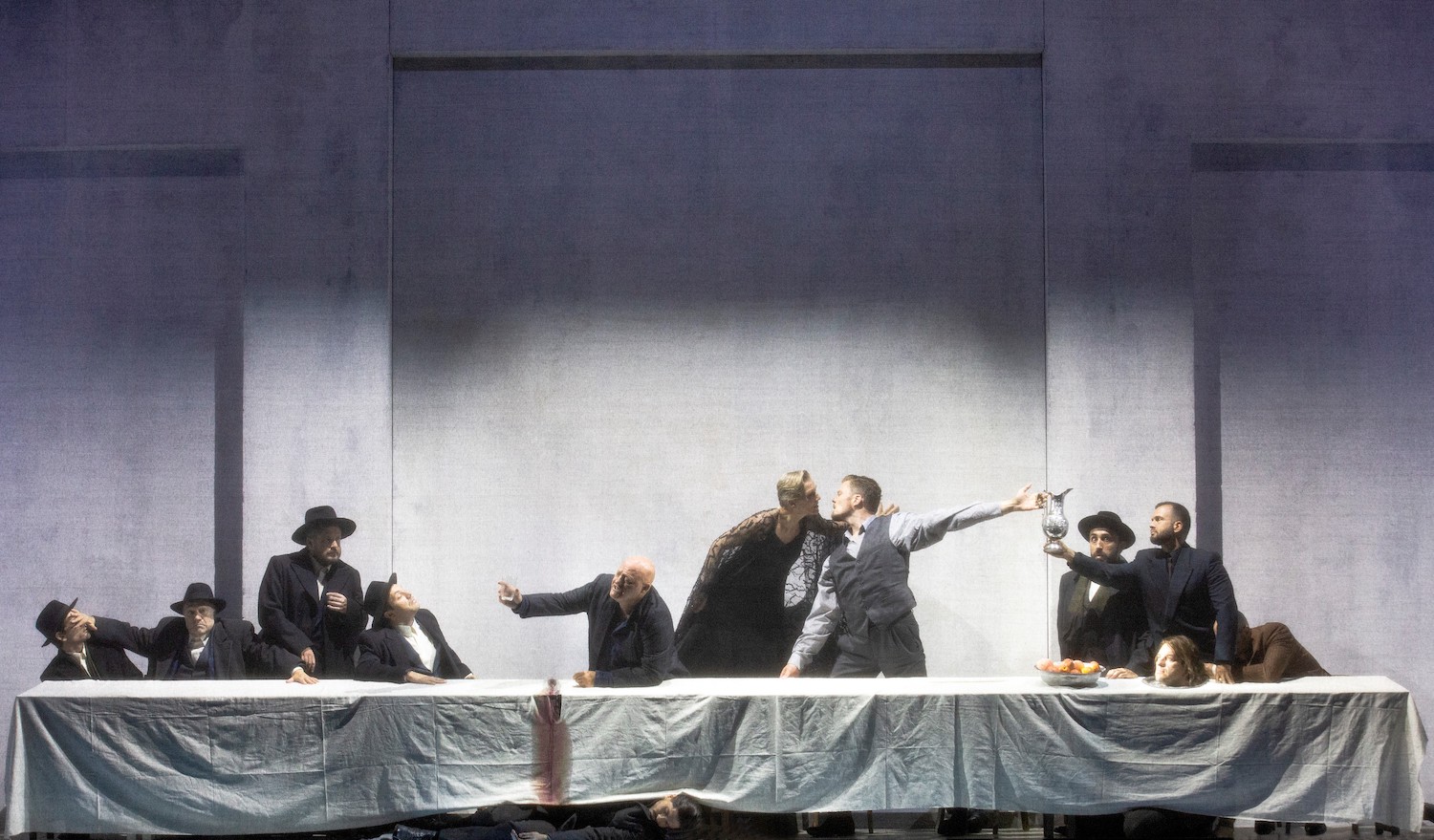
John Daszak as Herod, Elsa Dreisig as Salome, Angela Denoke as Herodias. The stage box scrim covering visible in photo.
The banquet continued. Herodias, enacted by soprano Angela Denoke, herself a famed, not-so-long-ago Paris Salome, echoed her daughter’s doubts and resolves, and in fact became one with her daughter.
The first voice we hear in Salome is that of Narraboth extolling the beauty of Salome and the beauty of the moon. Like the Salome of Elsa Dreisig, Spanish/Porto Rican tenor Joel Prieto is of beautiful, light lyric voice. He was the voice of a youthful innocence awakening to the forbidden desires of the world. He suicides, this innocence slipping into the precise chasm in the stages’s sentient floor where Salome, is confronting Narraboth, obsessed by horror of the Prophet’s body, and awakened to the horrors of her mother.
Jochanaan was sung by Hungarian bass baritone Gábor Bretz, a voice of enormous authority whose words were heard first everywhere in the stage box, then from random placements on Herod’s terrace, that was, as well, Salome’s emotional floor. Jochanaan’s severed, singing head was previewed on the table at Herod’s banquet table (Narraboth’s head on the floor beneath his feet) where Herodias shouted for its silence, and where the beaten Herod finally consented to the horror of Salome’s demand.
An extended, thunderous timpani roar, in an imposed fermata, brought the head of Jochanaan to Salome. The head was now hidden, and unseen, in a tin washtub. Strauss be damned.
Casting at Pierre Audi’s Aix Festival continues to be one of its greatest glories, these singers, and the impeccably cast Jews and Nazarenes, fully embodied stage director Andrea Breth’s blatantly Freudian world. It was a world brilliantly concocted scenically by designer Voigt, strikingly and remarkably subtly lighted by Alexander Kopelmann, and faultlessly executed by the Festival’s technical staff. Costumes, by Alexandra Charles, were based in the filmic early twentieth century.
Mr. Audi fearlessly confronted the fame of the recent Salzburg Festival Romeo Castelucci Salome with his own Salome. Worlds apart in the universal and particular these two productions will remain operatic benchmark productions for years to come.
FESTIVAL D’AIX EN PROVENCE 2022 SALOME DIRECTION MUSICALE: Ingo Metzmacher MISE EN SCÈNE: Andrea Breth DÉCORS: Raimund Orfeo Voigt COSTÜMES: Carla Teti LUMIÈRE: Alexander Koppelmann CHORÉGRAPHIE: Beate Vollack Salome Elsa Dreisig Jochanaan Gábor Bretz Herodes John Daszak Herodias Angela Denoke Narraboth Joel Prieto Ein Page der Herodias Carolyn Sproule Erster Jude Léo Vermot-Desroches Zweiter Jude Kristofer Lundin Dritter Jude Rodolphe Briand Vierter Jude Grégoire Mour Fünfter Jude / Zweiter Soldat Sulkhan Jaiani Erster Nazarener / Ein Kappadozier Kristján Jóhannesson Zweiter Nazarener Philippe-Nicolas Martin Erster Soldat Allen Boxer Eine Sklavin Katharina Bierweiler Danseuses et danseurs Martina Consoli Beatriz De Oliveira Scabora Jacqueline Lopez Alessia Rizzi
Platée at the Palais Garnier
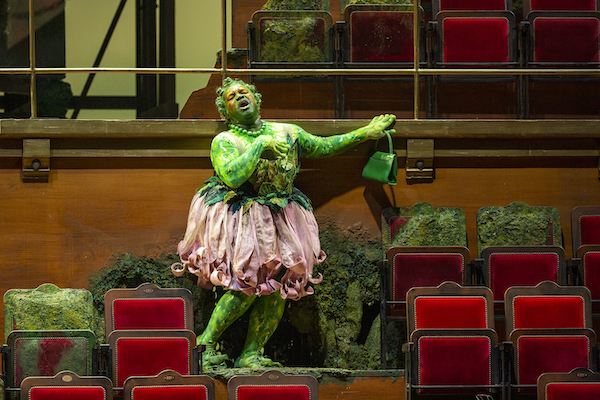
Lawrence Brownlee as Platée
The French are indeed “frogs!” Rameau’s Platée (1745) as told by French stage director Laurent Pelly is yet another proof. This production appeared first in 1999, then again in 2205, 2007 and 2015. And just now, yet again with conductor Marc Minkowski’s famed Les Musiciens du Louvre. It is a truly vintage production, grand cru indeed.
From the downbeat of Rameau’s sumptuous overture à la French Baroque opera we see on the stage the mirror of architect Charles Garnier’s auditorium (where we are sitting). In successive musical blocks we see an audience being seated (dressed like us), who slowly take life, abstractly, as frogs, aided by a number of usherettes who will make some witty balletic moves à la French Baroque opera. Meanwhile more audience is seated, the 27 strong chorus from the Opéra de Paris who come together finally into a solid block. They will have much to say, quite formally and magnificently à la French Baroque opera.
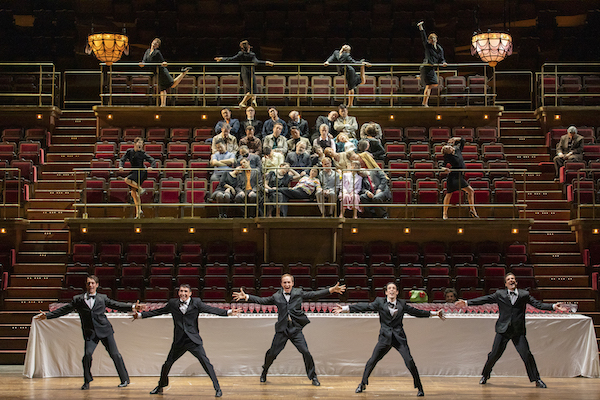
Essentially there is a vain, deluded, middle aged frog, Platée, who thinks she is gorgeous, sure to capture the attentions of the god Jupiter (who will come to the frog pond in various disguises). Frogs dance. Jupiter who travels with a muse and a tragedian, a retinue of lesser divinities plus personified Amour and personified Folly, pretends to fall in love with her and proposes marriage. La Folie then sings a huge aria à la the then wildly popular Italian opera — and then sings some more. Satyrs and nymphs dance. And then dance some more. Bride-to-be-Platée, waiting patiently for “Hymen et Amour,” gets bored at these wedding divertissements.
The raging Juno, Jupiter’s jealous heavenly wife, arrives and sings furiously à la French Baroque opera. She lifts the wedding veil, only to expose an ugly frog. Everyone laughs. Jupiter and Juno return to Valhalla, the humiliated Platée jumps back into the pond. The problem is that we had come to love Platée, played in this fifth edition by American tenor Lawrence Brownlee as a totally believable, vain frog who sings her many airs like a goddess.
Pit this against Platée’s nemesis, La Folie, who gets completely carried away by her arty virtuosity, leaving Platée quite alone in a far more complex emotional world.
It is a mean opera.
La Folie was sung by French soprano Julie Fuchs, an accomplished comedienne who sang the role also in the 2015 edition. Though I found her recent Susanna (Nozze) in Aix to be dazzling, I was not convinced by these Parisian pyrotechnics. The very first (1745) Folie was, like Mme. Fuchs, a light, high soprano. Rameau chose a heavier voiced tragedian for the opera’s revival a few years after its premiere. Of great interest will be the final two performances of this edition to be sung by Egyptian, San Francisco finished, soprano Amina Edris who is of much darker voice.
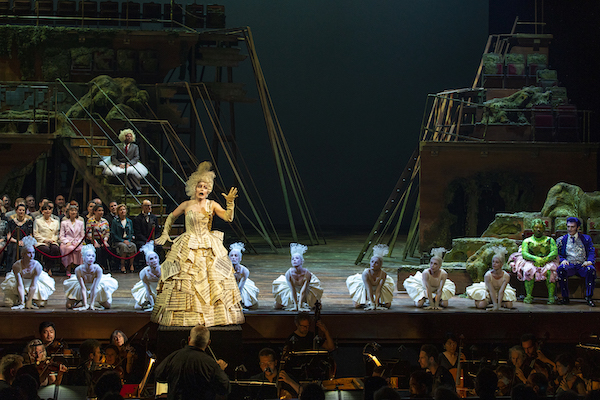
Marc Mauillon as Momus (in tutu and wig), Julie Fuchs as La Folie standing over Les Musiciens du Louvre, Lawrence Brownlee as Platée, Jean Teitgen as Jupiter
Tenor Lawrence Brownlee is a famed Rossini/bel canto tenor, of quite beautiful voice. He easily negotiated Rameau’s baroque lyricism, though I found his sound smaller than usual. The program booklet makes no mention of a transposition to accommodate Mr. Brownlee’s slightly lower range. His Platée was of consummate charm.
Platée is normally cast with a haute contre tenor (a naturally high voice of vocal range similar to a castrato). The first two editions of this production were sung by famed French haute contre tenor Jean-Paul Fouchécourt (who sang the role in the 2007 Santa Fe Opera version of this production as well). He is a character tenor (not a leading/romantic tenor) thus he displays the attendant vocal and comedic characteristics of that voice.
Mr. Fouchécourt was also the Platée for a contemporized Mark Morris Dance Company/New York City Opera production that toured the U.S. in 2001, which I saw in Orange County (California). In stark contrast to Mark Morris’ rough-trade gays, cross dressers, drunkards and showgirls, in Paris there were 14 dancers (presumably from the Opéra de Paris ballet) staged by famed Italian choreographer Laura Scozzi, dancers who assumed many abstract guises — an audience [us], satyrs and nymphs, ballerinas and, of course, frogs in absolutely wacky, highly balletic moves that punctuated the opera’s airs and choruses.
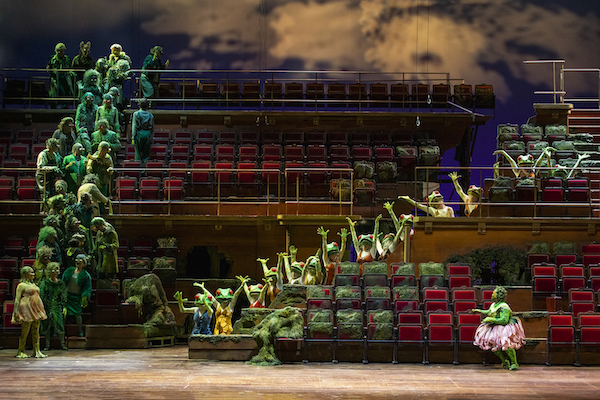
Frogs
This production marked the the beginning of Laurent Pelly’s international career, always promulgated by the bold primary colors of his set designer Chantal Thomas. In productions I have seen Mr. Pelly’s characters have been highly abstracted from any normal reality, freed to assume an independent musical life. Pelly himself imagines their costumes.
Marc Minkowski’s Les Musiciens du Louvre is one of the France’s artistic treasures. For this production there were two flutes, six oboes, four bassoons plus percussion and keyboards, and a huge number of strings. The sound was rich and smooth, the performance highly polished indeed, this fifth time around. Conductor Marc Minkowski obviously has great affection for this score, reveling in Rameau’s liberal sprinkling of onomatopoeiae — donkeys. owls, birds, frogs, etc., while basking in the mighty symphonic richness of Rameau’s overtures and interludes.
Michael Milenski
Cast and Production credits:
Platée: Lawrence Brownlee; La Folie: Julie Fucks; Cithéron: Nahuel di Pierro; Momus: Marc Mauillon; L’Amour: Tamara Bounazou; Mercury: Reinoud Van Mechelen; Jupiter: Jean Teitgen; Juno: Adriana Bignagni Lesca. Les Musiciens du Louvre, Choeurs of the Opéra national de Paris. Conductor: Marc Minkowski, Mise en scène/costumes: Laurent Pelly, Scenery: Chantal Thomas; Lighting: Joël Adam; Choreography: Laura Scozzi. Opéra Garnier, Paris, France, June 21, 2022.
All photos copyright Guergana Damianova, courtesy of the Opéra national de Paris
A Quiet Place at the Palais Garnier
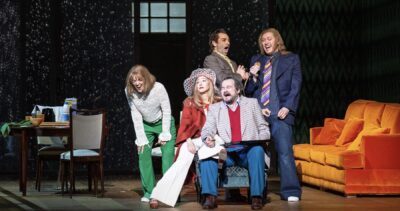
Sam's family with his phantom wife (center)
A Quiet Place has come of age, thirty-nine years later. In 1983 much of its subject matter was sensitive, even taboo. As well it dwelt on naked emotional histories that were foreign to public forums.
If I got it right Stephen Wadsworth’s libretto tells us that Sam’s alcoholic, now dead wife Dinah had been menopausibly unhappy, Sam’s kids felt ignored by their success driven father. His son Junior is queer, his daughter Dede is married to Junior’s Canadian French lover François who in turn was ignored by his father. Junior had incestuously loved his sister. They all learned to live happily ever after, having taken to heart the mother’s posthumous admonition to accept yourself as you are.
The mother’s catty friends had a field day at her funeral.
These were real people, the stuff of psychodrama if that’s your thing. The real real is, after all, the new zeitgeist. It is social media where everyone is a star, and all that.
Yet in A Quiet Place there is the Leonard Bernstein’s American mid-twentieth century genius, and now in Paris let’s add Polish stage director Krzysztof Warlikowski’s crystalline vision, and the considerable artistic and technical resources of the Opéra de Paris.
In A Quiet Place Bernstein synthesizes the musical palate we share with Europe into a homogenous language that takes on the American openness, its guile and naïveté, and its brilliance. A Quiet Place’s first act challenges Verdi’s Falstaff in its wit, and Wagner’s Meistersinger in its choral complexities. The Bernstein opera’s intense interludes recall those of Debussy and Berg, our ears now adept at counting twelve tones without fear while accepting the Tchaikovsky’s emotional urgencies with equanimity.
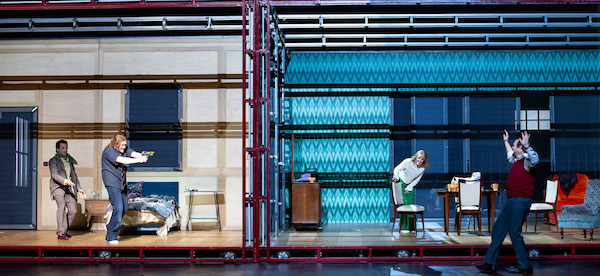
Francois: Frédéric Autoun; Junior: Gordon Bintner; Dede: Claudia Boyle; Sam: Russel Braun
And its climaxes often resolve with the ease and charm of the American musical, its lyric moments sometimes succumb to little songs for the sake of a little song sung for the fun of it. There are the thick, turgid colors and rhythms of American jazz that promote an aggression or an intense flood of reaction.
A Quiet Place has been through many orchestral and dramaturgical. transformations, first by its creators, Wadsworth and Bernstein, then in 2013 its original full sized orchestra was reduced to eighteen players by Garth Edwin Sunderland, a move to reconcile its musical forces with its dramatic intimacy. Mr. Sunderland has since recast the opera into a very large orchestra, this Paris production is its premiere.
Krzysztof Warlikowski has great experience dealing with dysfunctional families, most famously in his recent Elektra in Salzburg — a production of grandiose proportion. In A Quiet Place he has miniatured his approach in keeping with the gentle aphorism of its denouement (you must accept yourself as you are). With his designer Malgorzata Szczęśniak (his wife) he envisioned a huge open box into which flow, seamlessly, from time to time, two smaller boxes, one a living room, the other Junior’s bedroom.
A video of Dinah’s deadly car accident inaugurated the production. It was brutally real. The other videos were brief minimalist settings of location projected onto the back wall of the large box.
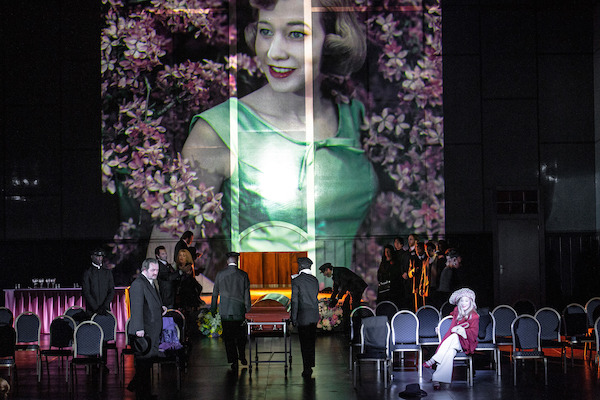
Sam and his wife Dinah (actress Johanna Wokalek) at her funeral
To great dramaturgical value, and relief from the personalities of the four protagonists, the mute presence of the mother had been added somewhere in the history of the piece (it was her funeral that had brought the dysfunctional family together). As well a clip of Bernstein’s famed, televised introduction to music for children was included, offering more relief — and the only, very small moment of charm in the evening. Though this clip did motivate the introduction of Junior as a child (mute) who soon entered (flashback) into his mother’s garden garden and attempted to kill her. This within the intense orchestral prelude to the final act.
This Paris production introduces the Bernstein opera back into the big house repertory. Despite the opera’s obviously huge musical value it is unlikely that this large scale psychodrama will achieve much presence as a staged work.
There is the temptation to elevate the personal histories of the opera’s creators and producers as validation of an artistic integrity. These thirty-nine years later, however, such histories have very little relevance.
The cast was international, among whom there was but one American. It is difficult music that was confidently performed. Given the sensitivities of the libretto one can imagine the emotional toll paid by the performers to realize their characters. The conductor was Kent Nagano, a Bernstein specialist and one of the primary promoters of this largely Canadian endeavor.
Cast and Production
François: Frédéric Antoun; Junior: Gordon Bintner; Sam: Russell Braun; Funeral director: Colin Judson; Bill: Régis Mengus; Susie: Maria Fiselier; Analyst: Loïc Félix; Doc: Jean-Luc Ballestra; Mrs Doc: Emanuela Pascu; Mourners: Marianne Croux, Ramya Roy, Kiup Lee, Niall Anderson; Dinah (actress): Johanna Wokalek. Orchestra of the Opéra national de Paris. Conductor: Kent Nagano; Stage Director: Krzysztof Warlikowski; Set and Costume Design: Małgorzata Szczęśniak; Lighting design: Felice Ross; Video: Kamil Polak. Palais Garnier, Paris, France, March 21, 2022.
All photos copyright Bernd Uhlig – OnP, courtesy of the Opéra national de Paris.
Family Secrets III (Traurnacht) in Lyon

Théâtre des Celestins
Some years ago British stage director Katie Mitchell, with French early music conductor Raphaël Pichon concocted a dramatic action based on fragments of cantatas by J.S. Bach for the Aix Festival. Here it was again, in Lyon’s historic, spoken word Théâtre des Célestins (above photo).
In Aix, at the time, Trauernacht (Night of Mourning) seemed to be a mere requiem mass for a dead pater familias, his four children gathered around a dining table to recount their reactions to his death, recognizing that he, as all men, was a sinner, his children ultimately finding solace knowing that the father, redeemed, would now bask under the gaze of God.
As part of the Opéra de Lyon’s themed (family secrets) winter festival, Trauernacht has taken on an added dramatic dimension. it has become the moment of revelation of the fathers secrets that have affected the lives of his children (though we are not told what or how). Its abstract action recounts the recognition by each child of the father’s transgressions, and charts their forgiveness (or lack of) of these revealed sins.
It is a quite subtle dramatic action.
Over the years stage director Mitchell distinguished herself at the Aix Festival for her stagings of family dramas, many — yes, most — of her stagings were at a dining table. It was no surprise that she set Trauernacht at a table where a soprano, alto, tenor and bass come to grips, again now in Lyon, with the death of their father. Dinner is three full courses, with digestif. It was a long evening.
The four singers, simply and somberly clothed, sit at the table on four chairs. There was a fifth unoccupied chair where the dead father would finally sit, mostly he remained upstage, a phantom, his presence marked occasionally by his eerie whistling. The four singers had mastered slow motion movement in order to move, eerily, to and from the table to the serving shelves at the edges of the stage without disturbing the almost beat-less flow of the music.
These artificial movements, butoh-like, were quite extended. The singers were barefoot. With such staging the result was certainly more oratorio than opera (oratorio is un-staged opera on a sacred theme).
Like at the Aix premiere in 2014 the four voices were entrusted to singers in the companies’ young artist programs. The players in the 11 person orchestra in Aix were a part of the Aix Festival’s summer academy, and in Lyon the players were from the Conservatoire National Supérieur de Musique.
Trauernacht is a collection of four choruses, five recitatives and five arias (ranging between BWV 46 and BWV 668) from among Bach’s 200 cantatas. There is as well an initial a cappella motet composed by Johann Christof Bach that calls our attention to the requiem mass that was to unfold.
Within the context of the themed Lyon winter festival the dramatic charge was more interesting in Lyon than it had been in Aix, and indeed there were some moments when Bach’s music was propelled into celestial spheres. Like in Aix however, the evening in its totality remained a tedious exposition of antique four-part harmony.
Soprano: Elisabeth Boudreault; Mezzo-soprano: Fiona McGown; Ténor: Andrew Henley; Baryton: Romain Bockler; The Father: Philippe Dusigne. Musiciens du département de musique ancienne du CNSMD de Lyon. Conductor: Simon-Pierre Bestion; Stage direction: Katie Mitchell realized by Robin Tebbutt; Sets and Costumes: Vicki Mortimer; Lighting; James Farncombe. Théâtre des Célestins, Lyon, France, March 19, 2022.
Family Secrets II (Irrelohe) in Lyon
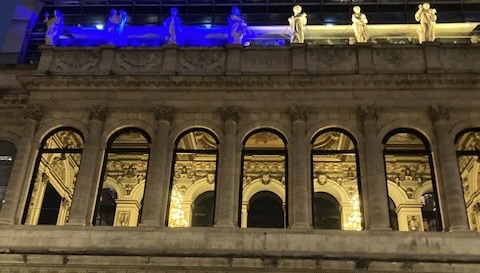
Grand Salon of the Opéra Nouvel
Irrelohe. An orchestral orgy — triple winds, quadruple brass though six horns, two harps, organ, celeste, guitar, mandolins, an eighth player percussion battery plus tympani and strings.
Libretto and music by Austrian composer Frank Schreker — of Jewish descent. Schreker was emblematic of the Nazi idea of degenerate art.
*[Towards the end of March each year the Opéra de Lyon presents its winter festival of three operas on a theme, this year "Family Secrets." The second installment is Irrelohe. Photo is the Opéra Nouvel, architect Jean Nouvel's opera house built upon and within Lyon's old opera house.]
Innkeeper Lola was raped some 30 years ago by the debauched count of Irrelohe (an imaginary duchy somewhere). Her resulting illegitimate son is therefore the brother of the current son and legitimate heir of the offending count. The brothers love the same village girl who loves them both. Moving deeper into the story it becomes a gory Grand Guignol tale colored by the sensualism of a D’Annunzio novel with healthy doses of Dostoyevsky and Freudian innuendo.
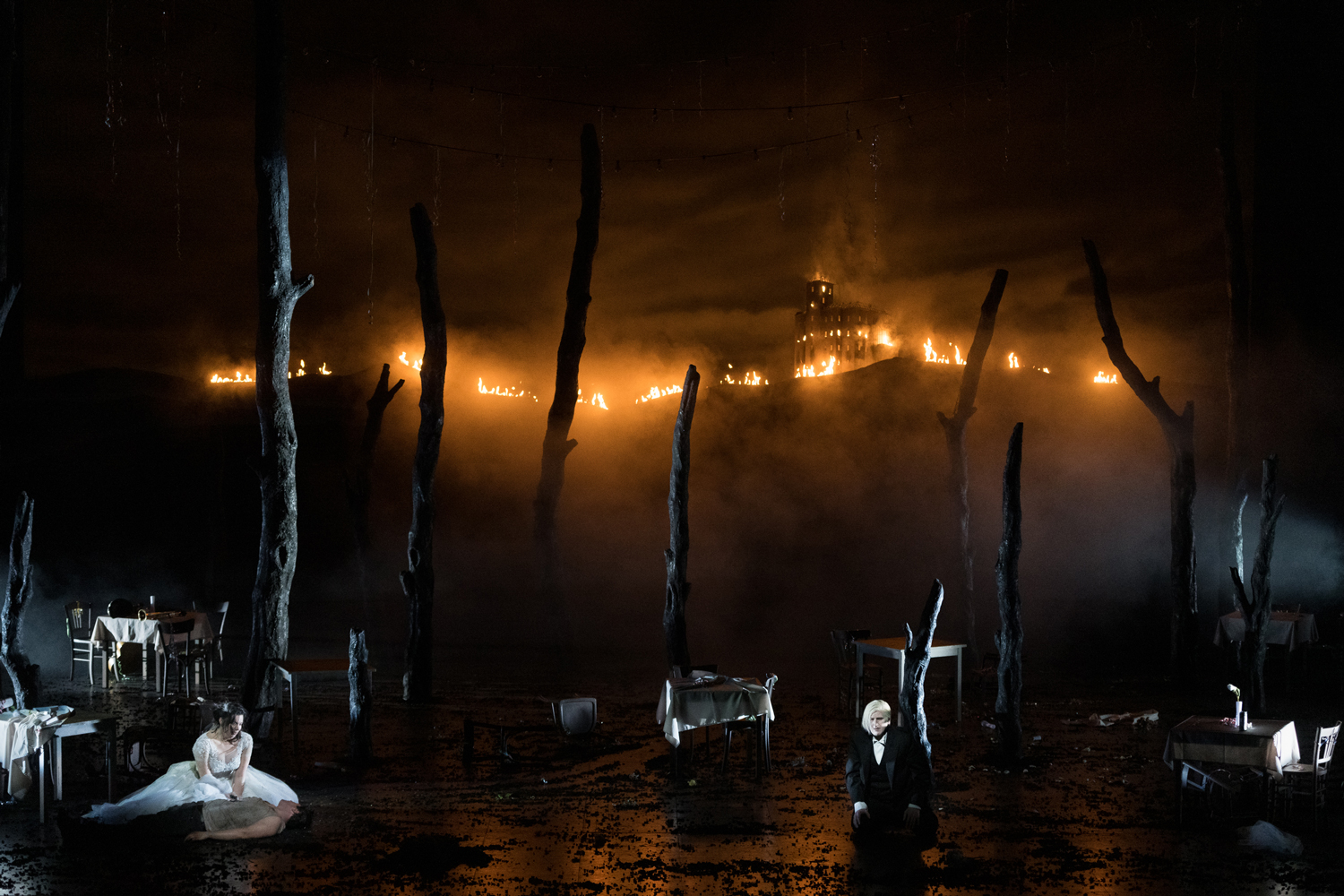
At the wedding party of the village girl Eva and the very weird count Heinrich
Composer Schreker follows the dictates of Wagnerian gesamtkunstwerk, his degenerate tale offering ample fodder for the mind boggling complexities and colors of the collapsed tonalities of his orchestral continuum. It is awesome music, overpowering in its totality.
Rather than take his visual clue from a Klimt or Kandinsky German stage director David Bösch chose the scratchy black and white of silent film, as if the magnificent, beautiful degenerate music of Franz Schreker was live music accompaniment to the tiny screens of a Fritz Lang or Robert Weine movie. Going a step further, the Opéra de Lyon’s publicity for the opera likened Schreker’s music to that of films of the 1950s.
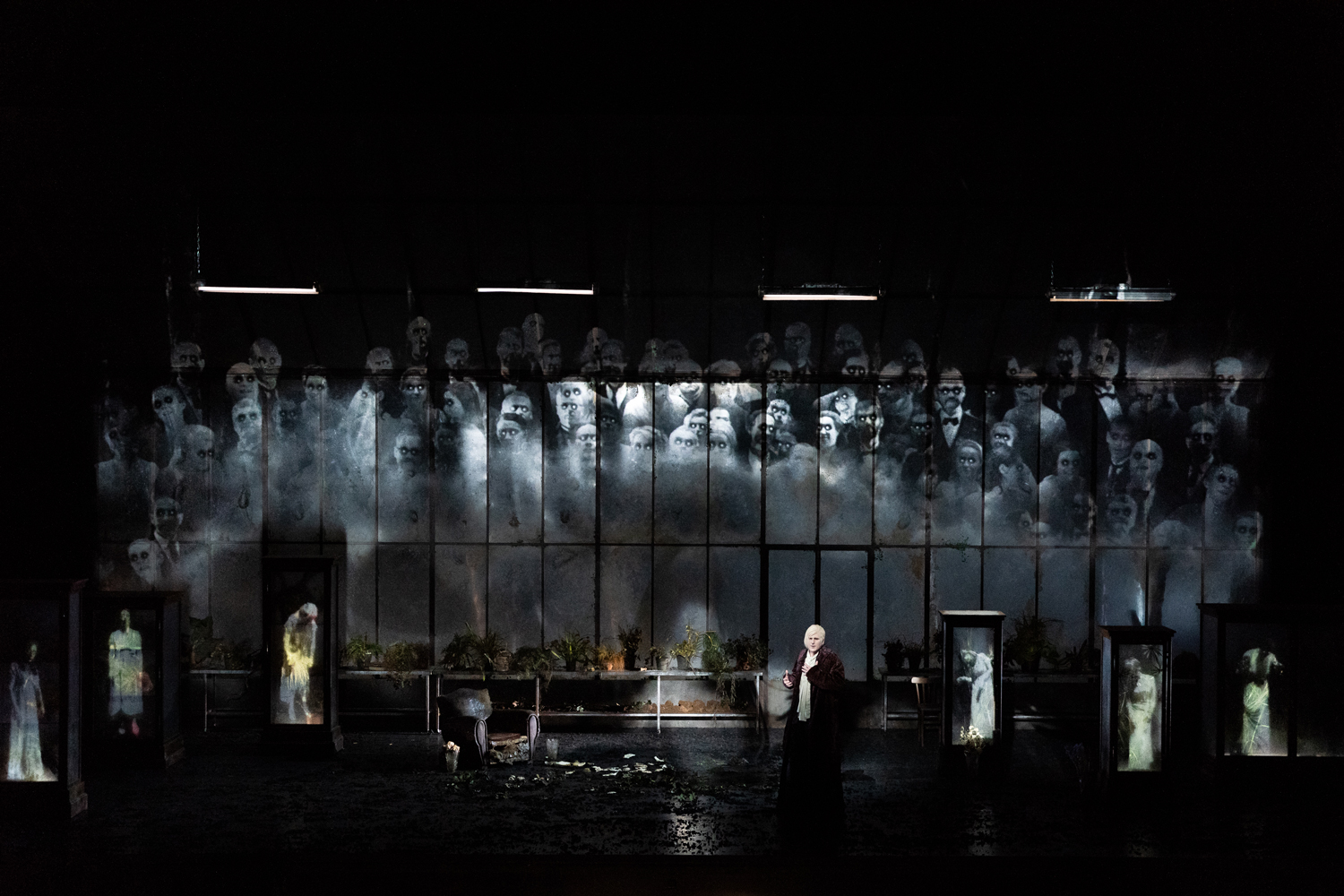
The plant conservator of the very weird count Heinrich's chateau.
Expressionism specialist, venerable German conductor Bernard Kontarsky inspired the 80 or so players of the very able Opéra de Lyon orchestra to achieve the opulence of this degenerate, spellbinding music. It was surely more pleasurable for these players (having the immense satisfaction of meeting a formidable challenge) than for us spectators who had the onerous challenge of relating the score to the dramatic conventions of silent film.
When not actual imitation silent film footage the scenery itself was mostly in the black and white (and many shades of gray) tonalities of silent film. Even the 44 members of the Opéra de Lyon chorus were costumed in black and white.
Meanwhile three itinerant, arsonist musicians whose instruments doubled as phalli, and their chef Christobald, once engaged to Lola (those thirty long years ago) have rampaged the countryside setting fires. They incinerate, finally, after all these years, the chateau. There is lots and lots of real flame, imitating at last the spectacle of real, live opera!
In the end the very weird count Heinrich kills the illegitimate Peter and falls dead, gloriously. Eva, the village girl, having embraced Lola’s dead son, falls dead too. That’s all folks.
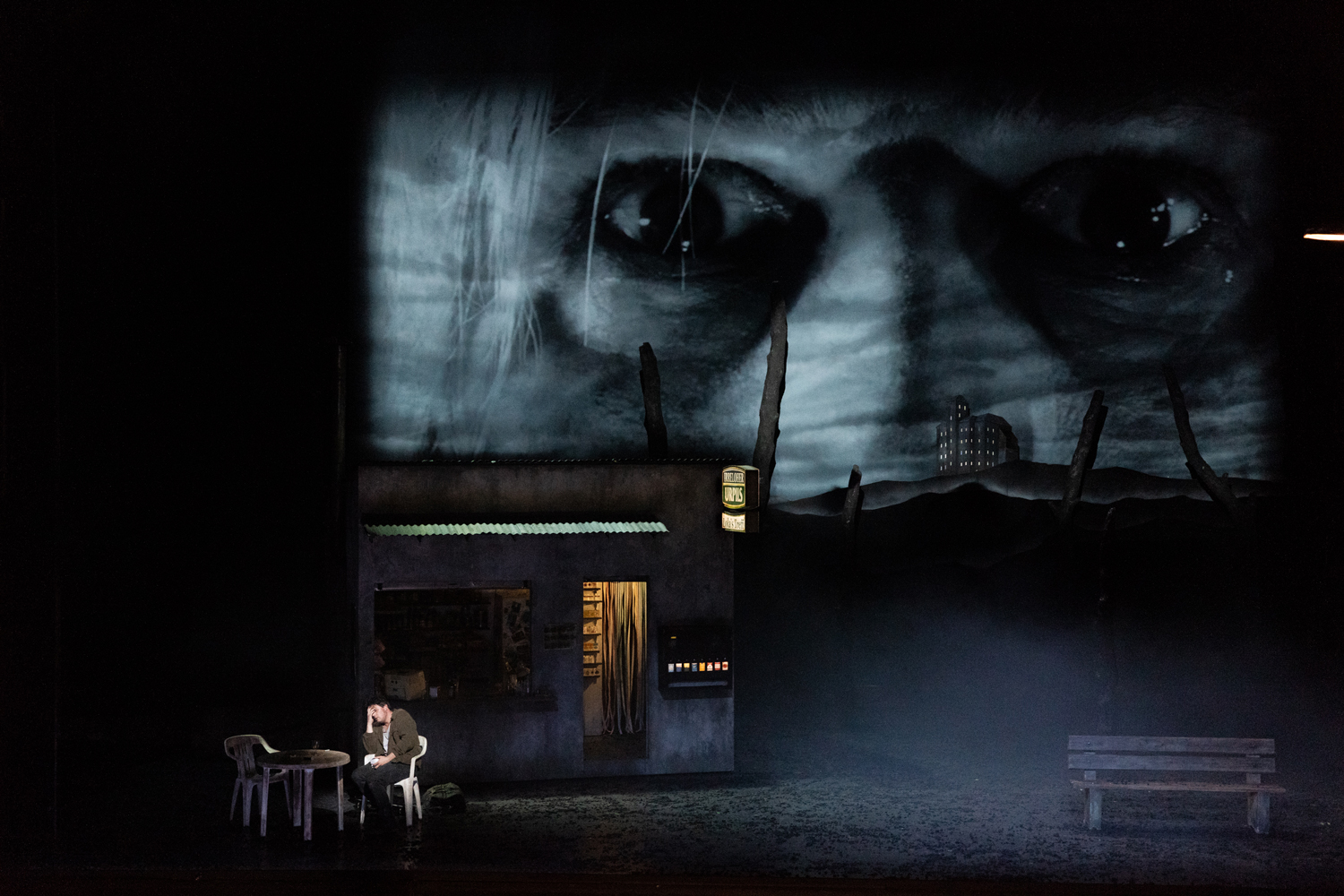
Peter sitting in front of Old Lola's refreshment stand.
But just maybe Schreker’s opera is not stage director David Bösch’s silent movie after all.
The massiveness of conductor Kontarsky’s orchestra generally overwhelmed the singers. Canadian soprano Amber Braid as Eva did however sail above the continuum with effective, Straussian delivery. Tenor Tobias Hächler, from the Kassel Opera [a city in the north of Germany] rallied as well, effectively portraying the very weird count Heinrich. German baritone Julian Ortishaussen as Lola’s son Peter gave an admirable, very physical performance of this obsessed and doomed young man.
Old Lola’s long ago fiancé Christobald was firmly enacted by character tenor Michael Gniffke, as befitting the role of an aggrieved, now old, vindictive lover. Lola, entrusted to veteran mezzo Lioba Braun, was sung in a barely discernible, indeed old voice, and with minimal presence. The three arsonist musicians were rendered with infectious, nasty verve by Peter Kirk, Romanas Kudriašovas and Barbary Rea.
Cast and Production
The Comte Heinrich: Tobias Hächler; Le Forestier: Piotr Micinski; Eva: Ambur Braid; Old Lola: Lioba Braun; Peter, Lola’s son: Julian Orlishausen; Christobald: Michaël Gniffke; Fünkchen, a musician: Peter Kirk; Strahlbusch, a musician: Romanas Kudriašovas; Ratzekahl, un musicien: Barnaby Rea; Le Prêtre: Kwang Soun Kim; Le Meunier: Paul-Henry Vila; Anselme: Antoine Saint-Espès; Un Laquais: Didier Roussel. Orchestre et Chœurs de l'Opéra de Lyon. Conductor: Bernhard Kontarsky; Director: David Bösch; Sets and Video: Falko Herold; Costumes: Moana Stemberger; Lighting: Michael Bauer. Opéra Nouvel, Lyon, France, March 19, 2022.
All photos courtesy of the Opéra de Lyon.
Family Secrets I (Rigoletto) in Lyon
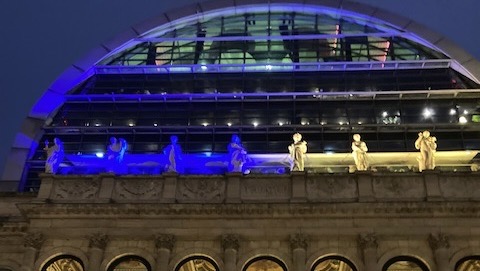
Identify
Rigoletto. Docudrama of a father whose wife dies in childbirth, raises daughter who falls in love with a selfish, debauched hoodlum. Show curtain is block apartment lighted windows. And they are winking. Who is jesting whom?
Answer: everyone except Rigoletto and Gilda in this Westside Story (sort of) take on Verdi’s early middle period bel canto masterpiece. And anyway, maybe Verdi had just seen The Barber of Seville when he wrote Rigoletto.
*[Towards the end of every March the Opéra de Lyon produces a winter festival of three operas around a theme. This year it is family secrets. The operas speak for themselves. Above is a detail of the façade of the Opéra Nouvel showing the grand salon of the original Opéra de Lyon.]
The story opens in a cinematically toned, Harlem like speakeasy in a modern Western-world city, the Countess Ceprano crosses herself to a priest on portable oxygen who plays the slots, a pole dancer or two (real ballerinas) tirelessly work out, a lively young hood sings “questa o quella” to backup, lively synchronized dancing by his debauched friends (including crossed dressers of various sexual persuasions).
Dalibor Jenis as Rigoletto, Helko Pintowsky as Hugo with observer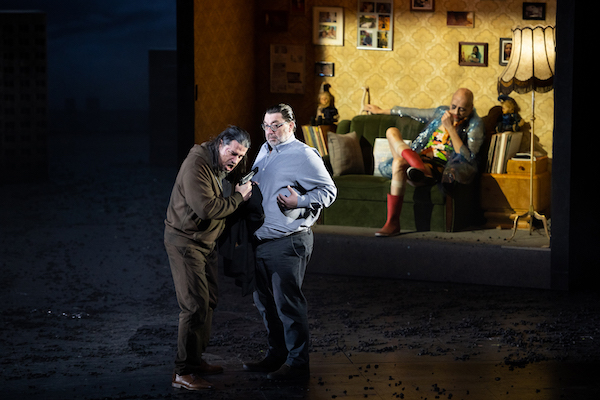
"Questa o quella"
"Questa o quella"
Complicit was conductor Daniele Rustioni in the pit who walked a tightrope the entire evening between finding a good beat — indeed successfully — for the numerous full out production numbers in Verdi’s numbers opera, and defining the operatic bathos, and every emotional twinge, of the Victor Hugo’s domestic tragedy.
A daughter stigmatized by her father’s suicide was the story told in a drop down screen by filmmaker/opera stage director Axel Ranisch. Simultaneously on the stage floor was his story of the suicide of the daughter discovered by the operatically traumatized father, both stories unfolding amidist massive public housing apartment blocks.
Not to mention the jukebox, a 33 LP store, a Rigoletto VCR. All this was, in fact, the tip of the iceberg for the musical and dramaturgical complexities of the evening. The final result was very theatrical, mind-boggling, intellectually stimulating, highly emotional (verging on visceral overload), in short Rigoletto.
Seen from without. And within. Musically and dramatically.
Adding to the evenings baggage: both the Rigoletto, Slovak baritone Dalibor Jenis, and the Gilda, Armenian soprano Nina Minasyan, have had extensive ties with the Bolshoi. Ironically, the Monterone (of the famed curse), towering Ukrainian bass Roman Chabaranok, took his bow wrapped in an Ukrainian flag.
Director Ranisch kept his singers mostly down stage center for maximum volume and presence. Baritone Jenis’s Rigoletto interchanged with his ever present, live mute double named, of course, [Victor] Hugo (this was actor Helko Pintowsky, an Alex Ranisch film collaborator). If Hugo was a lost, timid soul, Verdi’s Rigoletto was magnificently defiant. Neither were hunchbacked court jesters. Rigoletto sharply and proudly voiced his condemnations, though he found quite beautiful, tender tone when singing to, with or about his daughter.
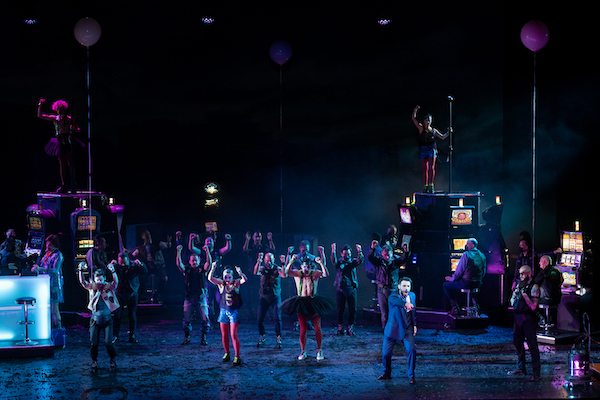
Dalibor Jenis as Rigoletto, Helko Pintowsky as Hugo with observer
Mlle. Minasyan is a uniquely voiced Gilda, reveling in her brilliant above-the-staff ecstasies, her Slavic intonations bringing pliant humanity to her middle voice that expressed very real, dying love for the Duke (of Harlem maybe, or Chicago or a Parisian banlieue). She killed herself, sparing the shaved head, black-voiced, hit-man-caricature Sparafucile, sung by bass Gianluca Buratto, the trouble.
Sicilian tenor Aeneas Scala pranced, danced, swaggered and drank his way through the sordid tale, his voice sharp, brittle and loud in his famous arias, belying a false confidence, his tiny mother (mute) was always nearby to help him out of a mess. He did attain, finally, a drunken smoothness of voice in his “la donna è mobile.” FYI his doubled, video personage was an employee in a CD and LP shop.
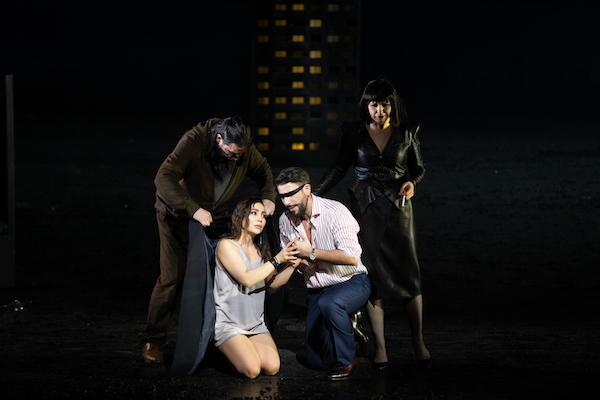
Dalibor Jenis as Rigoletto, Nina Minasyan as Gilda, Aeneas Scala as the Duke of Mantova, Agatha Schmidtg as Maddalena
Upholding the Eastern European tonality of the production Polish mezzo Agatha Schmidt, dressed in chic sadistic black, sang Maddalena. She handled her drunk client with cool vocal aplomb, coldly aware of and sympathetic to his vulnerability. Of special note was the Borsa of Grégoire Mour whose dance movements upheld the Westside Story energy of the production.
The production was impeccably cast, and flawlessly produced.
Cast and Production
The Duke of Mantua: Aennea Scala; Rigoletto: Dalibor Jenis; Gilda: Nina Minasyan; Sparafucile: Gianluca Buratto; Maddalena: Agata Schmidt; Marullo: Daniele Terenzi; Matteo Borsa: Grégoire Mour; Conte de Ceprano: Dumitru Madarasan; Conte de Monterone: Roman Chabaranok. Orchestre et Chœurs de l'Opéra de Lyon. Conductor: Daniele Rustioni; Stage Director and Videographer: Axel Ranisch; Costumes; Alfred Mayerhofer; Lighting; Michael Bauer Choreographer: Daphné Mauger. Opéra Nouvel, Lyon, France, March 18, 2022. All photos courtesy of the Opéra de Lyon
Pelleas et Melisande in Montpellier
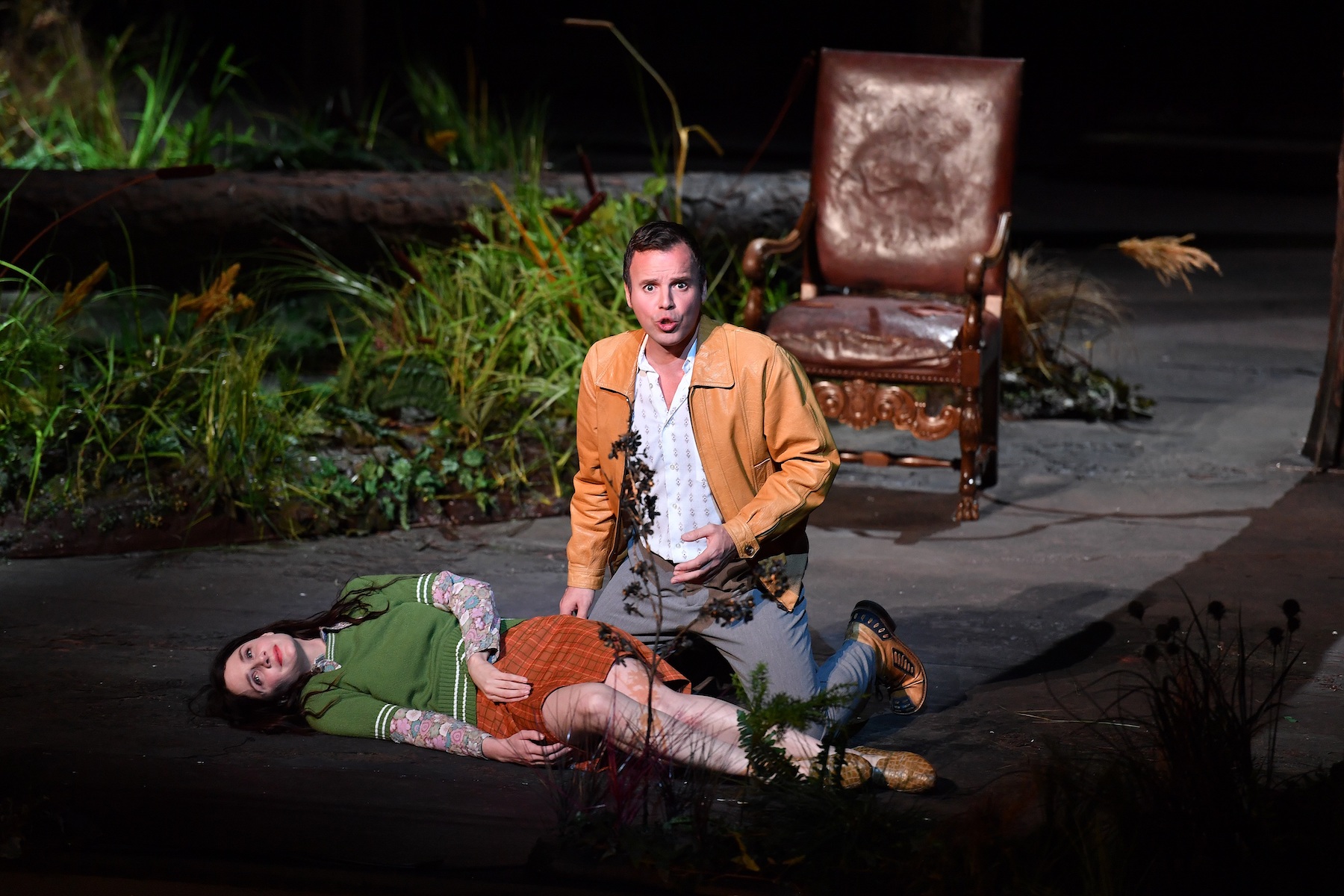
identify
A third staging of French stage director Benjamin Lazar’s poetic and sophisticated production (Malmö in 2017 and Karlsruhe in 2019), highly refined in Montpellier by an early music tenor as Pelléas and an actress who sings as Mélisande.
Each of these two singers brought specific vocal tonalities that created lost mystical beings who wander Maeterlinck’s darkly forested world, much like the three starving (mute) beggars and his silent serving women, thus separating the protagonists from the men who inhabit a decaying castle. These men are richly voiced, but men who are blind — Mélisande’s husband Golaud who cannot see truth, and his great grandfather Arkel who is blind but sees, finally, hopelessness.
Vincent Le Texier as Arkel, Élodie Méchain as Genevieve, serving womenDirector Benjamin Lazar creates a further world, that of Golaud’s son Yniold, rich in innocence and intuition, and this world is present from the first orchestral interlude as Yniold dashes about like a sprite. It is into this innocent world that Pelléas and Mélisande slide. In the opera’s emblematic moment, Mélisdande’s tresses falling from the tower, Mélisande stands on Yniold’s swing as a delighted Pelléas wears the crown Mélisande lost when Golaud came upon her, picked up in the woods by Yniold.
The scene is famously dismissed by Golaud as child’s play. Child’s play as well was Yniold’s wrenching intuition that his toy sheep have no home.
Director Lazar makes Pelléas et Mélisande far more than a tawdry love triangle. His stage is in fact not a home, it is a dark forest. As Debussy’s piles on Maeterlinck’s symbols in his orchestra, Lazar piles on images of light that penetrate into this forest, the first are the headlights of Golaud’s ATV and his flashlight discovering the lost Mélisande. The castle appears only in vague outlines. Therein hang sometimes three electrically lighted chandeliers. At the moment of disaster five carefully placed spotlights blasted vivid light directly into our eyes. We too were blind.
The scenes of the opera are changed in the dark, with careful light revealing a small bridges, a pier, Arkel’s chair, Yniold’s tree, the castle, a fallen tree — the tree that later is where Golaud slays Pelléas, and finally it becomes a headboard against which Mélisande dies, arms extended not as a crucifix image but in abject vulnerability.
As the symbols pile on from the libretto, from Debussy’s orchestra and from Lazar’s staging, we lost track of the love triangle as we were overwhelmed by the individual philosophic plights of Pelléas and Mélisande, of Golaud, of Arkel and of Yniold.
Thank the stage machinery of the Opera Comique at the opera’s 1902 premiere (it couldn’t handle the quick scene changes the opera requires) for the interludes that Debussy created to make time for changes. In the Lazar staging the scene transitions were in the dark, sometimes peopled, the later ones were in black, shattering orchestral statements of despair.
It was a spellbinding evening. From the first timid sounds of Debussy’s dark world from the Orchestre Nationale de Montpellier we felt the presence of this musical world vibrating in the wooden floor of the venerable old (1888) Opéra Comédie. Ukrainian conductor Kirill Karabits (music director of the Bournemouth and Weimar orchestras) later brought this fine French orchestra to shattering volumes in Act IV as Arkel imagined a new, lighted world, a world quickly destroyed by the angered Golaud. The maestro held Debussy’s musical spell through the almost silent ending of the opera. The theater was totally enthralled.
Pelléas was sung by baritenor Marc Mauillon whose usual repertoire is Baroque opera and Offenbach. As a Pelléas he was of lighter voice and presence than the Pelléas we have come to expect. Mr. Mauillon however totally owned the role in this production, his Pelléas was a vulnerable creature lost in a complex web of conflicting loyalties. He was vocally convincing both in his delighted play with Mélisande and in the ultimate, highly emotional distress and confusion of his love for Mélisande.
Mélisande was sung by actress Judith Chemla, known to director Lazar through his 2016 production of Traviata, vous méritez un avenue meilleur at Paris’ Théâtre des Bouffes du Nord. Mme. Chemla is not an opera singer, rather she is a chanteuse with an amazing capability to accomplish this Mélisande, a Mélisande fraught with a vocal vulnerability that supported her emotional and philosophic vulnerability. This quite unusual, indeed quite wonderful Mélisande was a Mélisande for the theater, not a recording studio.
Allan Boxer as Golaud, Mulie Mathevet as YnioldGolaud was sung by American bass baritone Allan Boxer, whose finishing preparation was at the Dresden Opera. Though at the initial stages of a promising career he created a fully formed, powerful Golaud who evinced our enormous sympathy by a handsome presence and his quite beautiful voice. He was gentle in his initial encounter with Mélisande, brutal in his denouncement of her, and at the end quite moving in his desperate pleas for truth.
Arkel was sung by veteran French bass Vincent Le Texier who, though seeming to embody a personage of extreme age, sang with a warmth of tone that anchored the philosophical underpinnings of the production. He was Maeterlinck and Debussy’s continuum, motivated by hope, and finally resigned to despair. With conductor Karabits he rose to powerful persuasion in his lust for a better world placing his kiss on the forehead of Mélisande.
Yniold, a huge presence in this production, was sung by French soprano Julie Mathevet, a carryover from the original Malmö cast. Within the scope of this production her vocal confidence was necessary (she sings Queen of the Night elsewhere), as were her histrionic gifts, rendering director Lazar’s Yniold as an additional protagonist in this philosophical treatise. The opera’s final image was Yniold holding, rocking Mélisande’s child.
Geneviève was sung by Élodie Méchain and the Doctor was sung by Laurent Sérou.
Production information:
Orchestre et Choeur Opéra national Montpellier Occitanie. Conductor: Kirill Karabits; Stage director: Benjamin Lazar; Scenery: Adeline Caron; Costumes: Alain Blanchot; Lighting: Mael Iger. Opéra Comédie, Montpellier, March 13, 2022.
All photos copyright Marc Ginot, courtesy of the Opéra national Montpellier Occitanie.
Werther in Marseille

Werther and Charlotte
The Opéra de Marseille assembled a fine cast to perform the Massenet masterpiece in a prize winning production from Nancy.
Bordeaux tenor Thomas Bettinger poured his heart out as the poet Werther. His is an ideal voice for the French lyric repertory, flowing evenly through the register, achieving the climatic notes with grace and ease. His Werther does not want for passion, in Marseille his arias fairly exploded with the pleas that his love be requited. Strasbourg born, Lausanne finished mezzo soprano Antoinette Dennefeld suffered, with Massenet, mightily in the heroic struggles of her third act dilemmas, her voice fulfilling easily and forcefully the mid-voice demands of the role. Mme. Dennefeld sang the fourth act (death of Werther) wonderfully full voiced to Werther ’s mezza voce, choked utterances — we ached to experience his agony in full tenor vocal regalia. (photo above).
Drôme born, Avignon finished soprano Ludivine Gombert accomplished the soubrette role of Sophie with the customary silvery tones, flirting easily with the spontaneity of youth in its upper registers, projecting the innocence of youth in her bearing. Marseille born, Paris finished baritone Marc Scoffoni sang Albert in a confident, metallic edged voice that identified him as man of purpose and means. These attributes, often associated with this role, precluded us from having sympathy whatsoever for him as he lay weeping downstage while Werther shot himself off stage. Yes, we too were puzzled.
An Act II confrontation. Marc Scoffoni as Albert, Ludvine Gombert as Sophie, Antoinette Dennefeld as Charlotte, Thomas Bettinger as WertherBass Marc Barrard, a veteran of many roles in many theaters in the south of France, responsibly sang the Bailli (a magistrate), a rebound from the same role last month in Monte-Carlo. Of special note were the eight children from the Maitrise des Bouches-du-Rhone Choeur d’Enfants who sang their role with unusual perfection. Never mind that this number makes the Bailli’s dead wife the mother of ten children (including Charlotte and Sophie).
The production originated at the Opéra national de Lorraine in 2018. It was conceived by British stage director Bruno Ravella (though born in France) and his British designer Leslie Travers. The production won the 2019 Prix de la critique Claude Rostand (a syndicate of professional French critics) for the best regional production, i.e. taking place outside Paris.
The design of the production is highly stylized, the first act was in an oversized entry room (no furniture) with painted walls à la nineteenth century provincial French decor. They were distressed, who knows why. The ceiling magically lifted itself high up — deus ex machina! — to reveal a forest during Werther’s “O Nature, pleine de grâce” (tenor Bettinger however was not yet sufficiently warmed up to warrant this big, or in fact any scenic trick). A while later in his declaration of love to Charlotte the ceiling, now covered with pinpoint stars, descended into the room.
The second act was set in the same room, this time the roof had been uniformly raised to reveal a blue line of cloudless sky at which elevation Schmidt and Johann’s torsos did their drinking scene. Down below folks passed through on their way to and from church, and the story got quite a bit more complicated as they encountered one another.
Jean-Marie Delpas as Johann, Marc Larcher as SchmidtThe third act was a flat, floridly painted wall, with a geometric intestine in its center through which the opera’s protagonists passed — the first act room had the same intestinal conceit of which the production took advantage to bathe in pure white light at moments it found significant. Charlotte accompanied Sophie’s "Ah! le rire est béni" sitting at a barely visible, abstracted black harpsichord shape. The pistols to give to Werther were at the ready on Charlotte’s table, who knows why. The hole in the wall was closed. Albert wept.
The wall rose onto a blank stage for Werther’s death, save a massive upstage snow fall, magnificently lighted to be sure (lighting is credited to Malcom Reppeth), and a lone sofa on which sat Werther at one end. Charlotte entered and sat at the other end. The snowfall stopped, Werther expired.
So much for the intimacy of love.
All of this might have worked (or been made inconsequential) had the Orchestre de l'Opéra de Marseille realized Massenet’s tragedy in the pit. Conductor Victorian Vanoosten, a former assistant conductor at the Marseille Opera, stood high above his orchestra thus assuming considerable presence in the theater — we noted his florid conducting style. While he did find the lyricism of Massenet’s masterpiece it followed the emotional moment instead of creating the emotional moment. There was constant, pervasive, inherent dramatic stasis.
This made for a very long evening, and evoked our great sympathy for the fine cast assembled by the Opéra de Marseille.
Opéra de Marseille, March 1, 2022. All photos copyright Christian Dresse, courtesy of the Opéra de Marseille
Werther in Monte-Carlo
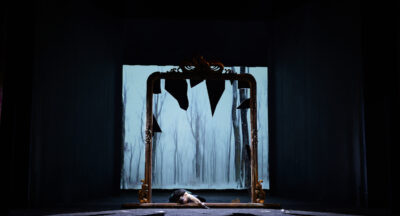
Werther
A superb cast, an inspired maestro, an intimate theater, an operatic masterpiece (the eighteenth of Massenet’s thirty-six operas), Werther in Monte-Carlo was a thrilling bombardment of emotional crises.
From the downbeat Hungarian conductor Henrik Nánási blasted a tragic lyricism into Massenet’s beautifully flowing lines, leading the poet Werther to magnificent intensities in the plentitude of his climactic high notes. Brass colors howled the rawness of Werther’s feelings, the bass viols sounding the depths.
The maestro took Charlotte to utter despair in the third act, marking the plentitude of minor steps and intervals as the agonies of Charlotte, the ascending lines in the cellos insisting the severity. The full voice of the esteemed Orchestre Philharmonique de Monte-Carlo was unleashed for the suffering of the final scene.
At the downbeat stage director Jean-Louis Grinda’s Werther faced a huge gilt frame. 3-D images of Charlotte appeared from time to time. It then became a huge mirror that shattered and disappeared. The fragments of mirror were explained a bit more in the third act as that of Charlotte’s dressing table, the exiled Werther seated at its smashed mirror as an inescapable presence (a harpsichord and a case of pistols completed the third act minimalist set).
At the intermezzo between Acts 3 and 4 [though no gunshot] the huge frame reappeared, its opaque surface becoming transparent for the final scene. But it was now an imaginary, impenetrable barrier, the frantic Charlotte behind.
All this smashed glass was a bit confusing though it did serve to underscore the fury of the exposed emotions.
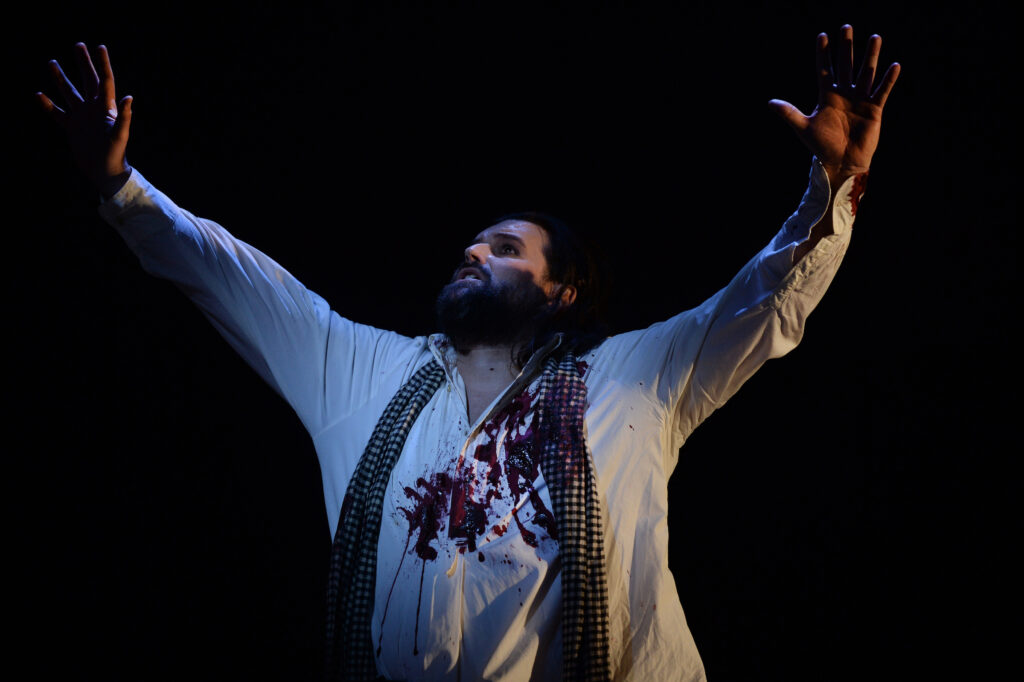
Jean-François Borras as Werther
Jean-François Borras as Werther
Fortunately at crucial moments a gray surround descended to hide the distracting scenic backgrounds of designer Rudy Sabounghi, and we were left with the words alone — a late nineteenth century take on Goethe's pre-Romantic novella. They were sung by artists among the finest of France’s singing actors, notably tenor Jean-François Borras as Werther and mezzo soprano Stéphanie d’Oustrac as Charlotte. Interestingly their famed arias were not delivered as show pieces, rather the arias were perceived as monologues that deepened character. There was no urge to applaud, thus there was no interruption of the maestro’s tragic flow.
Mr. Borras is no stranger to the role of Werther, having taken then place of Jonas Kaufman for the Metropolitan Opera’s 2014 Werther. A singer in his prime, he has a fine point and focus in his voice that lends itself beautifully to the French language. Though the tessitura of Werther is not high (a few A’s and one B-flat) he found profound excitement in attaining them, while prolonging the vocal intensities of Werther’s extended agonies.
Mme. d’Oustrac is an actress of extraordinary gifts who managed to convey through body language alone the confusion of her emotions in the first and second acts (there is little help from the libretto), letting Werther take all the vocal glory. The third act is hers however, and she cemented her fame as a singing actress, able to access the intimacies of the French language while grandly intoning the suffering of nineteenth century womanhood. Once a respected Baroque singer she still has a lighter vocal color though now she adds a fullness of tone and an abundance of power.
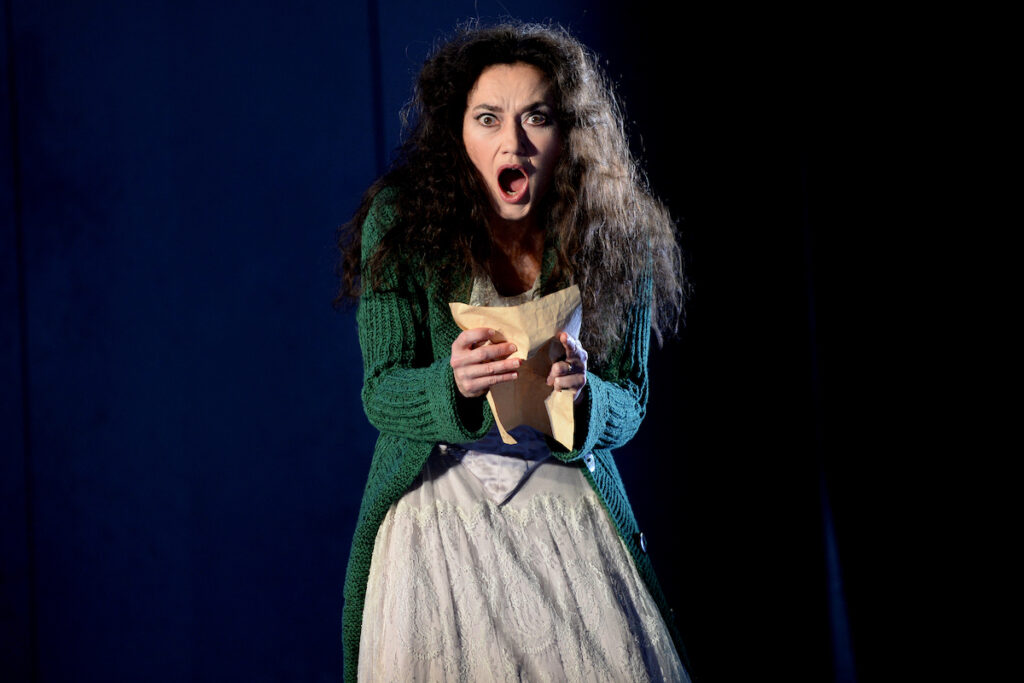
Stéphanie d'Oustrac as Charlotte
Charlotte’s sister Sophie was sung by soprano Jennifer Courcier who magically transformed herself into an adolescent child, a somewhat older sister to her five younger siblings (the core of the excellent, small children’s chorus), and convinced us of an innocent infatuation with Werther, leaving us focused on the trials of Charlotte. Charlotte’s fiancé then husband Albert was sung by baritone Jean-François Lapointe whose leading man looks and beautiful voiced Act I aria created a world of security and well being that went far beyond what any physical setting could demonstrate.
The bailiff (a magistrate, not a sheriff) was confidently enacted by baritone Marc Barrard, a veteran of many roles in Monaco. His drinking buddies Johann and Schmidt were played by Philippe Ermelier and Reinaldo Macias, Mr. Macias the only non-French cast member.
Mise en Scène: Jean-Louis Grinda; Décors et costumes: Rudy Sabounghi; Lumières: Laurent Castaingt; Décors vidéo: Julien Soulier; Films: Gabriel Grinda. Choeur d’Enfants de l’Académie de Musique Rainier III; Orchestre Philharmonique de Monte-Carlo. All photos courtesy of the Opéra de Monte-Carlo, copyright Alain Hanel. Opéra Garnier de Monte-Carlo, Monaco, February 20, 2020
Die Walküre in Marseille

Petra Lang as Brünnhilde and the Valkyries
Omicron roared through Marseille, civil authorities refused its opera house orchestra entry into the dangerously close confines of its pit. But sitting comfortably distanced on stage itself, this under appreciated orchestra proved itself well capable of its starring role in Wagner’s monumental Die Walküre.
Placed slightly upstage, sequestered behind a scrim, the orchestra attained a huge musical presence magnified by the flashes of light that penetrated the scrim when music stand score pages were flipped.
The proscenium apron and the now covered pit created a stage that thrust into the hall. There was nothing to separate us from Siegmund’s heroics and Wotan’s anguish, from Fricka’s admonishments, Sieglinde’s pride and Brunnhilde’s pleadings.

Die Walküre Act 1
It was exactly as Wagner wished, nothing between the words of his actors and us, fellow celebrants of his tragic rite. Not exactly Bayreuth though, perhaps slightly fewer harps, horns and Wagner tubas (the program sheet does not list the orchestra personnel), instead a very transparent, clearly voiced sound though which the famed leitmotifs sang out, the bass clarinet pronounced and the tubas spat without restraint.
German conductor Adrian Prabava meticulously enunciated the orchestral flow, finding evident pleasure in the anger of his meddlesome tubas, and finding in the end phenomenal volume for Loge’s wall of flames. We did not see him, or his players until the applause at the very end, though he and his players were the principal motivation and force of the performance.
Veteran Marseille stage director Charles Roubaud played with the idea of a semi-staging — though the Wagner masterpiece was in fact fully staged, every nuance of the score fully embodied within his actors, moved by sheer musical force all over the thrust platform.
There was, however, no dramatic action! There was not even a sword! We did not witness the battle between Siegmund and Hunding brokered by Wotan! There was only the music, deeply felt and precisely exposed in the voices and bodies of Mr. Roubaud’s actors.
The thrust acting space was backed by the scrim on which was projected a surrounding of sorts, enveloping as well the columns of the proscenium. Though this video background had obvious limitless capability it eschewed all temptation to introduce horses or parachutes for the entrance of valkyries. Instead they were simply on the stage as the curtain rose on Act III, against a background of leafless tree branches. Costumed by the Opéra de Marseille’s industrious Katia Duflot, they were a visual spectacle indeed! While all principals were discretely costumed, Brünnhilde and her sisters’ attire was a post performance subject of controversy, consternation and condemnation at the O’Stop bar across the street from the opera house!
The valkyries were not only a visual spectacle but were also the vocal spectacle that Wagner intended. Eight, then nine big-voiced singers rose to sonic volumes that dwarfed all imaginable scenic intervention. Evidently that was the point — and we got it, like it or not.
The musical intimacy of Mr. Roubaud’s production was realized by an extraordinary cast, dominated by Austrian tenor Nikolaï Schukoff as Siegmund and Korean bass Samuel Youn as Wotan, the two Wagnerian heroes who lost what they most loved.
Mr. Schukoff is athletic and heroic, an impetuous actor and an elegant singer. His well focused voice clearly enunciated each word. Of note was his immediate physical intimacy with the Sieglinde of French soprano Sophie Koch, Wagner’s magic moment of recognition, as yet unconscious. Mme. Koch is of great vocal and physical charisma, her third act pronouncement of the sword’s destiny attained a vocal and emotional magnificence that would, if needed, carry us through the prolonged vicissitudes to the Ring’s ultimate denouement.

Die Walküre Act II
Samuel Youn sings the Walküre Wotan, but is known for Wotan’s nemesis Alberich in Siegfrieds around the world. His Walküre Wotan is volatile, uncertain, deeply troubled, and violent. He shoutingly defied any so-called hero to penetrate the flames that surround his daughter. Mr. Youn is an intense performer, of sharply vocal focus and of myriad colors. We sat on the edge of our seats while he was berated by his wife Fricka (above photo) — the intense force of the young and beautiful French mezzo Aude Extrémo [sic]. We were both moved, dismayed and frightened by his confession to Brünnhilde, and we feared for the life of Brünnhilde at his anger in their final confrontation.
German soprano Petra Lang offered some amazing Brünnhilde whoops at her Act II entrance though we feared for her middle voice as the performance progressed. She offered a profoundly moving, almost sottovoce messenger telling Siegmund of his impending death (beautifully acted, intensely felt by Mr. Schukoff), and she pulled herself together vocally for her pleas to Wotan at the end. It was, finally, an appreciated performance.
The Roubaud production was not about Hunding, handily enacted by French bass Nicolas Courial. But it was all about lighting. Marc Delamézière often lights Opéra de Marseille productions. He well surmounted the challenges of lighting the faces as they moved throughout the thrust stage, capturing the emotional intimacy of the Wagner score. The productions minimalist videos were sensitively created by Camille Lebourges.
Michael Milenski
The Valkyries: Jennifer Michel, Ludivine Gombert, Laurence Janot, Lucie Roche, Carine Séchaye, Cécile Galois, Marie Gautrot, Jullie Pasturaud
All photos courtesy of the Opéra de Marseille, copyright Christian Dresse
Opéra de Marseille, Marseille, France, February 11, 2022
Die Walküre in Marseille

Petra Lang as Brünnhilde and the Valkyries
Omicron roared through Marseille, civil authorities refused its opera house orchestra entry into the dangerously close confines of its pit. But sitting comfortably distanced on stage itself, this under appreciated orchestra proved itself well capable of its starring role in Wagner’s monumental Die Walküre.
Placed slightly upstage, sequestered behind a scrim, the orchestra attained a huge musical presence magnified by the flashes of light that penetrated the scrim when music stand score pages were flipped.
The proscenium apron and the now covered pit created a stage that thrust into the hall. There was nothing to separate us from Siegmund’s heroics and Wotan’s anguish, from Fricka’s admonishments, Sieglinde’s pride and Brunnhilde’s pleadings.

Die Walküre Act 1
It was exactly as Wagner wished, nothing between the words of his actors and us, fellow celebrants of his tragic rite. Not exactly Bayreuth though, perhaps slightly fewer harps, horns and Wagner tubas (the program sheet does not list the orchestra personnel), instead a very transparent, clearly voiced sound though which the famed leitmotifs sang out, the bass clarinet pronounced and the tubas spat without restraint.
German conductor Adrian Prabava meticulously enunciated the orchestral flow, finding evident pleasure in the anger of his meddlesome tubas, and finding in the end phenomenal volume for Loge’s wall of flames. We did not see him, or his players until the applause at the very end, though he and his players were the principal motivation and force of the performance.
Veteran Marseille stage director Charles Roubaud played with the idea of a semi-staging — though the Wagner masterpiece was in fact fully staged, every nuance of the score fully embodied within his actors, moved by sheer musical force all over the thrust platform.
There was, however, no dramatic action! There was not even a sword! We did not witness the battle between Siegmund and Hunding brokered by Wotan! There was only the music, deeply felt and precisely exposed in the voices and bodies of Mr. Roubaud’s actors.
The thrust acting space was backed by the scrim on which was projected a surrounding of sorts, enveloping as well the columns of the proscenium. Though this video background had obvious limitless capability it eschewed all temptation to introduce horses or parachutes for the entrance of valkyries. Instead they were simply on the stage as the curtain rose on Act III, against a background of leafless tree branches. Costumed by the Opéra de Marseille’s industrious Katia Duflot, they were a visual spectacle indeed! While all principals were discretely costumed, Brünnhilde and her sisters’ attire was a post performance subject of controversy, consternation and condemnation at the O’Stop bar across the street from the opera house!
The valkyries were not only a visual spectacle but were also the vocal spectacle that Wagner intended. Eight, then nine big-voiced singers rose to sonic volumes that dwarfed all imaginable scenic intervention. Evidently that was the point — and we got it, like it or not.
The musical intimacy of Mr. Roubaud’s production was realized by an extraordinary cast, dominated by Austrian tenor Nikolaï Schukoff as Siegmund and Korean bass Samuel Youn as Wotan, the two Wagnerian heroes who lost what they most loved.
Mr. Schukoff is athletic and heroic, an impetuous actor and an elegant singer. His well focused voice clearly enunciated each word. Of note was his immediate physical intimacy with the Sieglinde of French soprano Sophie Koch, Wagner’s magic moment of recognition, as yet unconscious. Mme. Koch is of great vocal and physical charisma, her third act pronouncement of the sword’s destiny attained a vocal and emotional magnificence that would, if needed, carry us through the prolonged vicissitudes to the Ring’s ultimate denouement.

Die Walküre Act II
Samuel Youn sings the Walküre Wotan, but is known for Wotan’s nemesis Alberich in Siegfrieds around the world. His Walküre Wotan is volatile, uncertain, deeply troubled, and violent. He shoutingly defied any so-called hero to penetrate the flames that surround his daughter. Mr. Youn is an intense performer, of sharply vocal focus and of myriad colors. We sat on the edge of our seats while he was berated by his wife Fricka (above photo) — the intense force of the young and beautiful French mezzo Aude Extrémo [sic]. We were both moved, dismayed and frightened by his confession to Brünnhilde, and we feared for the life of Brünnhilde at his anger in their final confrontation.
German soprano Petra Lang offered some amazing Brünnhilde whoops at her Act II entrance though we feared for her middle voice as the performance progressed. She offered a profoundly moving, almost sottovoce messenger telling Siegmund of his impending death (beautifully acted, intensely felt by Mr. Schukoff), and she pulled herself together vocally for her pleas to Wotan at the end. It was, finally, an appreciated performance.
The Roubaud production was not about Hunding, handily enacted by French bass Nicolas Courial. But it was all about lighting. Marc Delamézière often lights Opéra de Marseille productions. He well surmounted the challenges of lighting the faces as they moved throughout the thrust stage, capturing the emotional intimacy of the Wagner score. The productions minimalist videos were sensitively created by Camille Lebourges.
Michael Milenski
The Valkyries: Jennifer Michel, Ludivine Gombert, Laurence Janot, Lucie Roche, Carine Séchaye, Cécile Galois, Marie Gautrot, Jullie Pasturaud
All photos courtesy of the Opéra de Marseille, copyright Christian Dresse
Opéra de Marseille, Marseille, France, February 11, 2022
Les Vêpres Siciliennes in Palermo
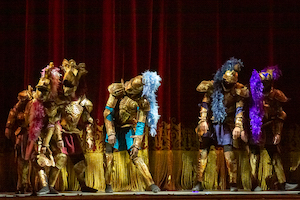
Puppet soldieers
Ossia I Vespri Siciliani takes its name from the evening prayer to which the faithful are called by the ringing of bells. Specifically the bells of Verdi’s Sicilian vespers signal the Sicilians that it is time to massacre the French.
This was many years ago, about 750 years ago actually. Just now Palermo’s Teatro Massimo has mounted Verdi’s original 1855, grand opera version in commemoration, after thirty years, of another Sicilian massacre. Judges Giuseppe Falcone and Paolo Borsellino were famously blown-up in 1992 (many others were murdered less spectacularly), the result of turncoat Mafiosi testimony.
Trying to reconcile this recent Mafia history with that long ago history of a French occupation as told by Verdi’s famed librettist, Eugène Scribe is not so easy. But it is easy to be critical of the Scribe libretto. In fact Verdi’s mistress Giuseppina Strapponi (later his wife) advised him to back out of his contract with Paris’ Opéra, given the second hand libretto was of such doubtful quality. Verdi thought however that he might be able to make some really impressive grand opera music. And that he did.
Besides impressive spectacle, grand opera likes flashy, virtuoso singing, it likes pretty little hummable songs, nifty quartets and trios, emotional duets, and lots and lots of great big choruses. And maybe and above all French grand opera likes ballets. The Scribe libretto provided all these opportunities for Verdi. Never mind that grand opera had been out of fashion for about twenty years.
Palermo born stage director Emma Dante (of impressive credential indeed) summarized the pre-history of the opera by dumping five ballerino French soldiers gaudily costumed as puppets onto the stage apron who twitched like bewitched marionettes throughout Verdi’s clumsy overture. The first act introduced Hélène, the murder of whose brother, the Duke of Alba, was unavenged, with an aria virtually impossible to sing. We met Montfort, the sympathetic baritone French governor who later will splendidly deliver one of the opera’s loveliest airs once he learns that the Sicilian tenor Henri (who maybe will get it together vocally for his big Act IV aria) is actually his son.
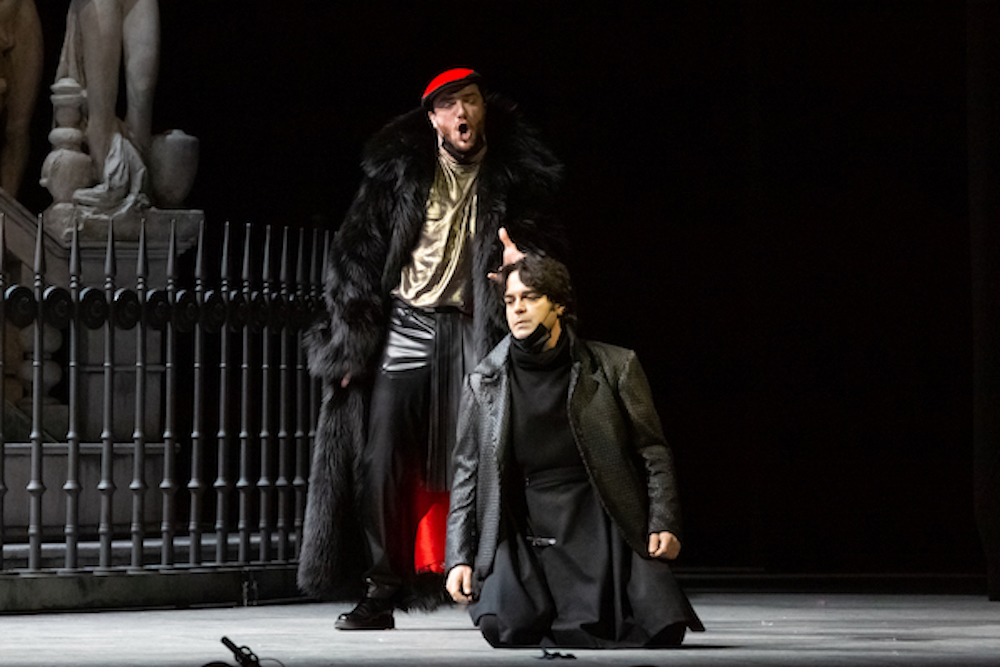
Mattea Olivieri as Guy de Montfort, Leonardo Caimi as Henri
The brilliance of Hélène’s aria stirred up a grand chorus of revolt, the Palermitani clash with French soldiers, 15 or so banners appeared with photos of the victims of the 1992 massacre. A ballet of revolt followed. Three Klezmer style musicians walked on stage — a violin, clarinet and accordion — to provide a very stylish, and personable reduction of Verdi’s very extended, musically pallid ballet score. Palermo may lack good restaurants but it has a terrific clarinet player and a plentitude of truly excellent dancers who responded with boundless energy and refined technique to Palermo born choreographer Manuela Lo Sicco’s rich, chic and witty choreography — she is a frequent Emma Dante collaborator.
This first act encounter of Montfort with his as yet unrecognized son Henri does not go well — Henri refuses to become an accomplice to the French. Plus of course he loves Hélène. Meanwhile an angry spectacle erupts. Palermo is sacked by the French who threw huge piles of furniture etcetera onto the stage, the Palermitani meanwhile sack the palace, dumping box after box of papers from the palace onto the stage (did I get this right?). The spectacle did continue on, and for quite a while after the music had stopped.
Voilà grand opera!
The curtain fell on Act I. There was a lot to clean up onstage. It was a long intermission. With great trepidation we embarked onto the second of the five acts.
Procida, a bass voiced Sicilian rabble rouser, has returned from exile. He is standing in a suspended boat, sort of like it was an airplane. He sang the air “Et toi, Palerme” in gorgeous tone, the Palermitani were entranced (as was I) as he extolled the beauty of Palermo, “queen of cities!”
Et voici! The four principal singers that la Dante does not mess with, leaving them mostly downstage and on the stage apron to render the plentitude of quartets (some a cappella), trios, duets and arias that are the glories of Verdi’s Les vêpres Siciliennes. The opera comes just after the Verdi's middle period masterpieces, Traviata, Rigoletto and Trovatore. While offering in Paris homage to the French styles of songs and ensembles there is the sense as well that Verdi has moved into a new sphere, a new exploration of the emotional depths of his later personages.
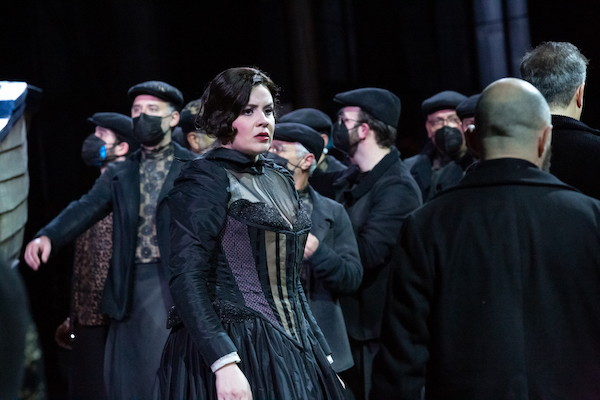
Seline Zanetti
Yes, tenor Leonardo Caimi got it together vocally, barely, for his big fourth act aria “O jour de peine et de souffrance!” — he had betrayed Hélène and Procida by revealing to his father the plans for insurrection. Baritone Mattea Olivieri’s third act aria “Au sein de la puissance” was delivered the joyous emotion of a new father. Beside his enchanting “Et toi Palerme” Luca Tittoto smoothly anchored all of the grandiose quartets and trios. Soprano Selene Zanetti negotiated her difficult first act aria “Au seins des mers” with cautionary aplomb and let her final aria “Sorte fatale” rip with its spectacular glissandos.
It was an all Italian cast, to my ears at odds with the French language, basic Italian flair and flash always just below the surface. Conductor Order Meir Wellber (Teatro Massimo’s music director) held the Teatro Massimo orchestra in check in the quirky acoustic of its auditorium, allowing the public scenes the necessary volume, pulling back to work closely with the singers in their personal moments. There is the suspicion that it was Mo. Wellber’s idea to assign the first act ballet to Klezmer-like treatment.
And no, Emma Dante’s staging shenanigans never let up, nor did the glories of Mme. Lo Sicco’s choreography (or the energy of her dancers). Well, we were all waiting, let me say dreading the massacre. The production travels to Naples, Bologna and Madrid. I won’t be the spoiler.
But maybe someone can tell me what happened to Henri in the end.
Cast and Production
La duchesse Hélène: Selene Zanetti; Ninetta: Carlotta Vichi; Henri: Leonardo Caimi; Guy de Montfort: Mattia Olivieri; Jean Procida: Luca Tittoto; Thibault: Matteo Mezzaro; Danieli: Francesco Pittari; Mainfroid: Pietro Luppina; Robert: Alessio Verna; Le sire de Béthune: Ugo Guagliardo; Le comte de Vaudemont: Gabriele Sagona. Orchestra, Chorus and Ballet of the Teatro Massimo. Conductor: Omer Meir Wellber; Stage Director: Emma Dante; Scenery: Carmine Maringola; Costumes: Vanessa Sannino; Choreography: Manuela Lo Sicco; Lighting: Cristian Zucaro. Teatro Massimo, Palermo, July 23, 2022. All photos courtesy of the Teatro Palermo, copyright Rosellina Garbo.
Kat'a Kabanova at the Rome Opera
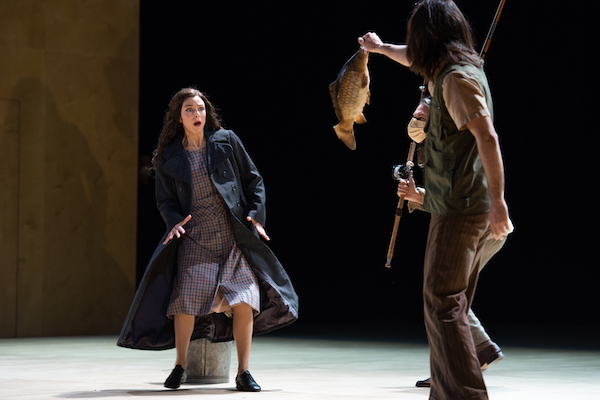
Corinne Winters as Kat'a
The Opera di Roma marks the centenary of Janacek’s intimate domestic tragedy Kat’a Kabanova with a new cast for Richard Jones’ prize winning, 2019 Covent Garden production. Reportedly spell binding in London, in Rome, though some faults were apparent, its effect was certainly no less overwhelming.
That is because it is the Janacek of the gritty real, finding immeasurable beauty in the ugly. These scores, Kát’a Kabanová and From the House of the Dead in particular, take you to emotional planes you would not endure without the cloak of art — absolute hopelessness and absolute alienation. You may revel in the pristine clarity of such feeling, knowing it is art.
Janacek scores usually thrive on the minimal, the simplest of surrounding, anything more detracts from the tracery of emotional movement that Janacek so carefully and specifically etches. In Rome American born, London schooled conductor David Robertson masterfully delineated the detailed Janacek score.
British stage director Richard Jones teased minimalism in this staging. The elaborate abstractions of his set — a huge brown wooden box; the spare interior and exterior of a house; a bus stop shelter; a street light — alone drowned the orchestral continuum. All this was in concert with sharply geometric lighting shapes imposed on these elements (that went awry in the performance I saw compromising Kát’a’s Act I monologue — the germ of director Jones’ concept).
Mr. Jones revises, with the justification of Kát’a’s monologue, the libretto’s inherent intent that societal and commercial pressures crush basic human instincts. Kat’a is a victim. Jones elaborates, reading Kát’a in the Act I monologue as an unstable personality, whose descent into a depressive madness is the thread we will follow. In the end she is the victim of her isolation and of her madness.
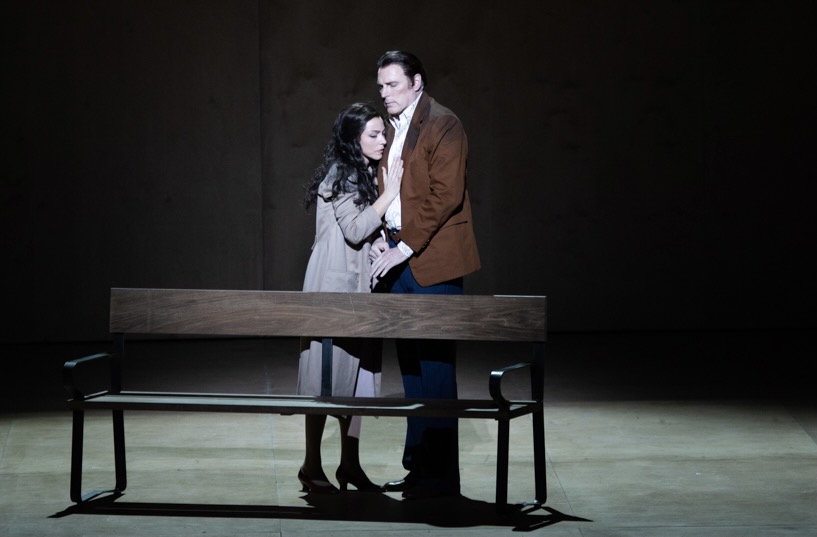
Corinne Winters as Kát'a and Charles Workman as Boris in Act II
American soprano Corinne Winters brilliantly fulfilled director Jones’ reading of the libretto, initially convincing us in the first act that she is a lost soul, her words themselves lacked precise enunciation. Precision was indeed present in the beautifully sung role of Varvara, Kát’a’s nemesis — a free spirit able to break free away from familial and social fetters, enacted with infectious abandon by Canadian soprano Carolyn Sproule.
Conductor Robertson’s Act II precisely teased the ecstasies of love, its fulfillment hinted but seldom achieved. Varvara and her equally free spirited, if wise boyfriend Vaña Kudrjáš — sung by British tenor Sam Furness — indulged in fleeting lovers spats underpinned by soaring, joyous offstage utterances by Káty’a and her equally doomed lover Boris. American Heldon tenor Charles Workman offered an exquisitely passive portrayal as Kát’a’s lover.
Often director Jones’ staging indulged in superfluous illustration of Janacek’s inner emotional states. A confusing example was the apparition of a 1960’s Mercedes sedan with Kat’à’s internal musical confusion marked by her repeated attempts to climb in, thwarted by her husband Tichon Kabanov — sung by British tenor Julian Hubbard. Conversely a quite powerful example of Jones’ staging was at Kát’a’s final encounter with her lover when she attempted to lift Boris’ flaccid arms into an embrace.
Of surprise, and indeed fine effect was Jones’ totally abstract river Volga, nothing more than the disappearance of all scenic paraphernalia leaving black voids, the river becoming the void of the auditorium, and the revealed void of a blackened upstage creating the Act III bridge. In a heavy handed directorial flourish Mr. Jones had fishermen pull a fish from its waters in Act I, the dead fish image becoming Kát’a in Act III. Director Jones’ point was made, and the story was thereby told.

Kát'a pulled from Volga river, with Susan Bickley as Kabanicha and villagers
The opera’s final image, Kát’a’s stepmother — ably performed by British character mezzo Susan Bickley — is rejected by her son, Kát’a’s bereaved, drunken husband. This last scene, sometimes made into an important pronouncement (i.e. that Kát’a was crushed by what these two figure represent), for director Jones was but a somewhat insignificant postlude, and definitely beside the point.
Finally, maybe this Richard Jones production, with this superb cast, did again earn that prize.
Cast and Production
Kát’a: Corinne Winters; Boris: Charles Workman; Tichon: Jullian Hubbard; Vana: Sam Furness; Varvara: Carolyn Sproule; Kabanicha: Susan Bickley; Dikoj: Stephen Richardson; Kuligin: Lukas Zeman. Orchestra and Chorus of the Rome Opera. Conductor: David Robertson; Stage director: Richard Jones; Costumes and Sets: Anthony McDonald; Lighting: Lucy Carter. Teatro Costanzi of the Teatro dell’Opera di Roma, January 21, 2022.
Rusalka at Madrid’s Teatro Real
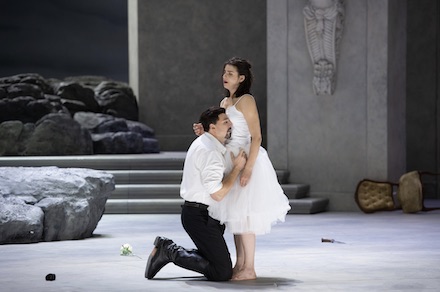
Eric Cutler as the Prince, Asmik Grigorian as Rusalka
All photos copyright Monica Rittershaus, courtesy of the Teatro Real
For this opera critic sheltered in San Francisco the next best thing to actually being at an opera house is tuning into an actual, real-time performance, digitally. Thus the 7:30 PM downbeat for the Madrid Rusalka occurred at 10:30 AM in my darkened living room.
It was the new, long awaited Christof Loy Rusalka finally on stage at the Teatro Real with Lithuanian soprano Asmik Grigorian, the famed Salzburg Salome, as Dvorak’s water nymph. All this while Covid rages in Spain. If safety protocols are your thing check out the Associated Press account of pandemic opera at the Teatro Real The Show Goes On . . ..
But wait, there’s more than mere plague! The night before the dress rehearsal American tenor, Eric Cutler, Dvorak’s Prince, ruptured his Achilles tendon. A serious injury that might have required replacing him, forsaking the two month rehearsal period he had endured.
But it was a blessing in disguise, serving to enrich stage director Christof Loy’s wounded lover concept. Eric Cutler’s Prince now arrives onto the Teatro Real’s stage on real forearm crutches, seemingly having just stepped in from the Plaza de España, the epicenter of Madrid’s nightly passeggiata.
In Dvorak’s water world the nymphs dance in a magical trance, except the nymph Rusalka who has fallen in love with a human — the Prince. In Christof Loy’s conception, enveloped in post modern neoclassical mythology, this renders Rusalka crippled — the ballerina Rusalka has injured her left foot and cannot join her white crinoline-ed tutu-ed, swan lake-like sisters gracefully sus-sous-ing across the stage.
In Mr. Loy’s mythical world the witch Ježibaba, a maternal, all knowing floozy, and the water sprite Vodnik, a formally suited male paternal figure together inhabit a neoclassical room where we see as well the injured ballerina Rusalka’s bed, and lava-like intrusions of a stony shore.
It comes to pass (you know the story) that when Rusalka joins the human world she will no longer be able to speak. This of course awakens in Mr. Loy the world of silent film, wittily inserted into this world of high operatic theater. Thus the set includes a box office, sometimes inhabited by Mme. Ježibaba selling tickets to all this art.
No surprise then, to our great delight, that we see Charlie Chapman with his famed ladder at the top of Act II. Dvorak’s gamekeeper and the kitchen boy do their kitchen antics à la slapstick. Mr. Loy’s demonstrably boundless wit exploits the opera metaphor by introducing the current diva of all divas, Karita Matilla as Rusalka’s competition, the Foreign Princess, in a pure Busby Berkeley moment. Let me add that Mme. Matilla was in good voice and fine figure, divissima in fact, the outlines of an opera house apparent through the center stage arch.
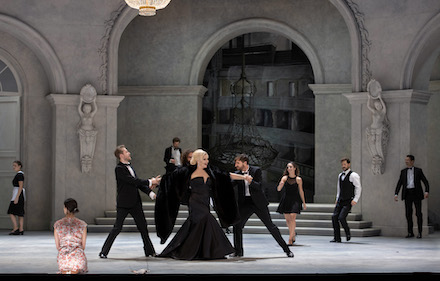
Karita Matilla as the Foreign Princess, with dancers.
The Prince’s fatal Act I hunt is guided by Dvorak’s Huntsman, in Mr. Loy’s post modern vision it is a commedia dell’arte, white-faced Pierrot, yet another reference to a world of mute theater, here a character of silent understanding in search of his Colombine, and as well as the sad clown face of existential despair.
But the crippled Prince too, like Rusalka to her dancing sisters, no longer belongs to the frenetic world just outside the theater walls. Doomed, in the end, by Rusalka’s kiss he drops his forearm crutches a few feet before he falls. Freed now from the fetters of this world he consecrates his love for Rusalka by his death. The Teatro Real does not offer a photo of this sublime moment.
Had I been inside the Teatro Real I would have reveled in the glories of Dvorak’s richly Romantic score surely exploited by conductor Ivor Bolton and the obviously full throated Orquestra Sinfónia de Madrid. As it was there were many, many hints of orchestral magnificence, resonances well beyond the capabilities of my salon audio resources.
Nonetheless I was captivated by the concept and by the performers. I had only known soprano Asmik Grigorian as Salome from my seat at a recent Salzburg Festival from which vantage point I responded to her as a 16 year-old prodigiously endowed with Straussian vocal resources in the context of the Castelucci production. Mme. Grigorian’s voice and body were one as Strauss’s adolescent. Thus it was a revelation to encounter this unique artist in her actual late thirties, maybe 40, in a television production where faces are more important than bodies.
Mme. Grigorian’s voice is pure and silvery, and naturally young. Its production is so secure that it issues forth, even mightily, with seemingly natural ease. Up close we could note aspects of the remarkable technique that underlies such deception. La Grigorian melds body and voice effecting a complex, operatically realized character that is rarely achieved by singers — and exceedingly affective.
In the Christof Loy Rusalka Mme. Grigorian is a ballerina as well as a singer! En point! Not surprisingly, her dance movements were accomplished with evident balletic technique.
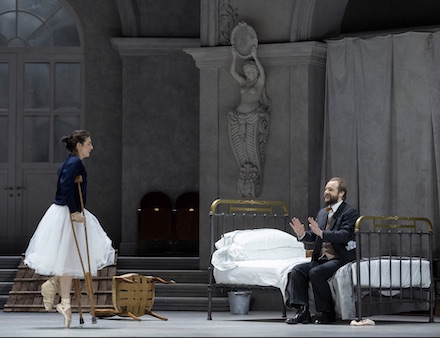
Asmik Grigorian as Rusalka en point, Maxime Kuzmin-Karavaev as Volnik
Eric Cutler in his role debut exhibited secure, powerful singing though the size and scope of the voice cannot be known in a video performance where levels are adjustable. The Act I hunt scene with Mr. Loy’s Pierrot and following aria were hugely effective. Mr. Cutler’s death, in street clothes, his forearm crutches abandoned, found all the pathos of the Dvorak score and at the same time amplified the brilliance of the Christof Loy concept.
Madrid’s Teatro Real is one of Europe’s major theaters, thus casting is informed and appropriate. Swedish mezzo soprano Katarina Dalyman sang Jezibaba, Russian bass Maxime Kuzmin-Karavaev sang Volnik, Spanish baritone Sebastià Peris created the spooky Pierrot Huntsman. Catalan baritone Manel Esteve created the convincing silent screen Charlie Chaplin Gamekeeper together with French soprano Juliette Mars as the Kitchen Boy. Armenian soprano Julietta Aleksanyan, Irish mezzo soprano Rachel Kelly and Russian mezzo soprano Alyona Abramova were the three nymphs.
The video production was well done, offering sufficient full stage shots to instill a larger scenic context while focusing on the changing dramatic circumstances, very occasionally moving to full frame faces. It was filmed for MezzoTV (www.mezzo.tv, available in Canada and Europe, and offered to medici.tv subscribers worldwide at www.medici.tv/en/operas/dvorak-rusalka/. Both MezzoTV and MediciTV will stream the production for a limited time.
Production information
Chorus, Ballet and Orchestra of the Teatro Real conducted by Ivor Bolton. Stage Direction: Christof Loy; Set Design: Johannes Leiacker; Costumes: Ursula Renzenbrink; Lighting: Bernd Purkrabek. Teatro Real, Madrid, November 25.
Three Chamber Operas at the Aix Festival
Along with the celestial Mozart Requiem, a doomed Tosca and a gloriously witty Mahagonny the Aix Festival’s new artistic director Pierre Audi regaled us with three chamber operas — the premiere of a brilliant Les Mille Endormis, the technically playful Blank Out (on a turgid subject), and a heavy-duty Jakob Lenz.
Les Milles Endormis

Gan-ya Beb-gur Akseldrod as Nurit
photo copyright Patrick Berger / Artcompress
Les Milles Endormis is a brilliant piece of real opera by Israeli composer Adam Maor and it was brilliantly staged by its librettist, Israeli poet Yonatan Levy. Four singers and eight instrumentalists (Luxembourg's United Instruments of Lucilin) made a mighty noise — though insufficient to wake up the thousand imprisoned Palestinian hunger strikers the Israeli Prime Minister and his security chief had put to sleep not knowing what else to do with them.
We saw only about thirty of them laid out quite comfortably on the stage only they weren’t asleep as they were actually audience members, like us, watching the show (maybe the only seats they could get for this, the hit show of the Festival).

Tomasz Kumiega as the Prime Minister, Gan-ya Beb-gur Akseldrod as Nurit (extreme right)
photo copyright Patrick Berger / Artcompress
The U.S. president phoned the insomniac (with the rest of Israel) PM to say that he had not vetoed the UN resolution denying rainfall on Israel. Meanwhile Israeli children in the north were having epileptic seizures that left them speaking Arabic.
This provided occasion for the reading of a lengthly newspaper article describing the stricken toddlers. Though it wasn’t read. It was recited in an astonishing Hebrew prose aria by a Cantor wearing a crown of with faceted mirror fragments that ricocheted points of light among us adding even more magic to the Arabic infused musical lines.
The PM’s chronic nightmares are determined to be psychic tunnels dug into Jewish dreams by the sleeping terrorists. The Security Chief takes over, sending in a sleeper agent, the PM’s assistant, Nurit whom he hypnotises in a magical, mystical monologue. In an extended dream aria embellished with Arabic musical gestures, Nurit standing among us on a platform over the orchestra pit in the now lighted hall tells of the spiritual homeland the thousand sleeping souls have founded. It is one soul connecting to another.
This is but the surface of this brilliant, perfect bel canto libretto. The Prime Minister and his adjuncts create quite a mess, thus the PM has much to rage about. The Cantor, the Security Chief and the PM’s assistant Nurit are left to sing their way out of it. Though the subject of the opera may not be bel canto’s classical conflicts, the Mille Endormis’s conflict is indeed a current torment in our minds and hearts.
Like the Brecht/Weill Rise and Fall of the City of Mahagonny, Les Mille Endormis is heavy political satire. But unlike the Brecht/Weill piece it is first and foremost opera as revealed in its profoundly human, emotional resolution that eclipses its conflict.
Composer Maor’s orchestral score includes considerable use of recorded electronically produced sounds, created by the Centre Pompidou’s Ircam (an electro-acoustical music laboratory). The basic musical language is sonic gesture created, with the Ircam component, in the beautifully colored sounds of traditional orchestral instruments — a string trio with added bass viol plus a clarinet. Add to this an accordion and percussion, plus an electronic keyboard. The vocal lines are melodic (moving in steps rather than leaps). The lines are based on normal speech patterns embellished with the Arabic vocal gestures.
Holding all of this together musically was Swiss-Australian conductor Elena Schwarz. It was a conducting tour de force accomplished with visible precision and total command of the deceptively minuscule forces that may as well been those of a Bruckner symphony.
Polish baritone Tomasz Kumiega gave an over the top performance as the Prime Minister, finding his rage, his passiveness, his helplessness and his humanity. American bass David Salsbery Fry displayed a strange and surreal humanity in the black tones of magical incantation hypnotizing Nurit. French tenor Benjamin Alunni accomplished a monumental feat in delivering the huge newspaper account of the stricken children babbling in Arabic with detached cantorial aplomb. Israeli soprano Gan-ya Beb-gur Akselrod intoned the mesmerizing dream of the Israeli who joined the sleeping Palestinians in a world beyond hunger where there is no homeland.
The opera was performed in the small, horseshoe Théâtre du Jeu de Paume on Aix's Rue de l'Opéra.
Blank Out
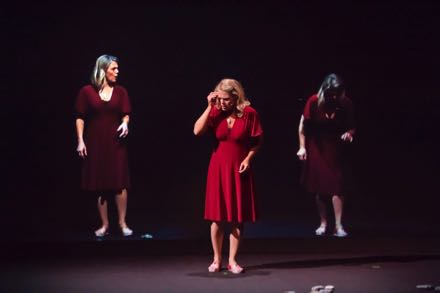
Miah Persson as the young mother in Michel van der Aa's Blank Out
photo copyright Priska Ketterer - Lucerne Festival
The hour long opera Blank Out was created by Dutch composer Michel van der Aa. It was first performed in 2015 under the auspices Pierre Audi’s Dutch National Opera who commissioned the piece. Among other stops before finding its way into the recital hall of Aix's Darius Milhaud Conservatoire it was seen at Mr. Audi’s Park Avenue Armory in Manhattan.
Mr. van der Aa plays with electronic technology in his compositions for the stage (Blank Out is his fifth opera) which are both visual and auditory creations. Blank Out is scored for one live soprano and one recorded baritone on an accompanying van der Aa made video. The video is in 3D thus we were provided with the necessary glasses.
The opera’s gimmick is the presentation of a horrific domestic tragedy — the live-on-stage mother tells of watching her seven-year-old son drown, and later the filmed baritone re-experiences the drowning death of his mother. The artistic intent of Mr. van der Aa’s opera is not so much to operatically create such a shocking, mirrored tragedy as it is to demonstrate how current audiovisual creation and reproduction technology can be harnessed to tell stories. We were first wowed by the doubling of the live soprano on the 3D recorded video screen to make a duet with herself, then we were amazed by the quality of the recorded voice that fully matched the live soprano. And, voilà, it became a trio with herself!
The fully electronic recorded score provided soundscapes where the mother moved to the side of the stage to manipulate a model of a house, the 3D film documenting her re-configurations of the model. It was this model house that we see become as well the real house of the baritone’s mother located on a barren, bleak stretch of sea land reclaimed by a Dutch dike. The video alternates between the recorded image of an actual (real) house and the recorded manipulations of the house model by the live soprano.
With all this going on in vivid, high definition color I struggled in vain to feel anything other than passing interest in the cleverly mirrored domestic tragedies. I did admire the technology, and the solid, if stolid storytelling.
The live soprano was sung by Swedish soprano Miah Persson, the same singer who created the opera’s premiere a few years ago (thus no need to make a new film). Mlle. Persson is a musician of high order, evidenced in the extended, pitch perfect a cappella singing that began the opera. Her pure sounds perfectly embodied the tentative emotions of this young mother, sounds that have made her a Mozart heroine on major stages. British baritone Roderick Williams was the recorded son, well portraying a mature male recalling and then again grieving the death of his mother.
Eight
The Aix Festival partnered with a nearby winery cum architectural art installations, Château La Coste to exhibit Michel van der Aa’s 15 minute virtual reality piece Eight. As Blank Out its narrative is a gimmick. A virtual old woman traces her life in virtual physical re-creations backwards to her eighth year. Note that the shape 8 is a symbol of infinity and that once inside the 20-foot square paddock, capped with headset and earphones, we configured the shape of 8 with our footsteps as we followed our virtual guide, the age inverting female.
The sound tract is the recorded singing of poems and texts compiled by Mr. van der Aa and Australian pop songwriter-singer Kate Miller-Heidke who sings the texts in a weak and breathy, new-age-music voice to electronic accompaniment. The soundscape includes manipulated voices of the Netherlands Chamber Choir.
Virtual reality provided astonishing, infinite vistas, hurling boulders, and finally an intimate, low tent I dutifully squatted to enter where I watched and listened to a virtual eight-year-old girl earnestly telling me something or the other. Standing again I put my hand out to use a wall to steady myself. It was, however, virtual. As was the artistic experience.
Jakob Lenz
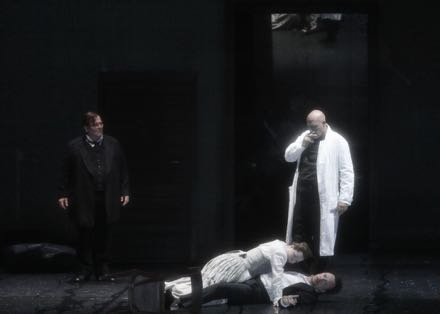
Wolfgang Bankl as Oberlin and John Daszak as Kaufmann (both standing)
Georg Nigl as Lenz (on floor) with doll Friederike
photo copyright Patrick Berger / Artcompress
German composer Wolfgang Rihm’s 1978 one-hour-fifteen-minute chamber Jakob Lenz was given three performances in Aix’s Grand Théâtre de Provence in a major, i.e. great big 2014 production from the Stuttgart Opera.
This Rihm opera completes a trilogy of operas based on the literary works of the German Romantic expressionist Georg Bûchner— Alban Berg’s 1925 Wozzeck, Gottfried von Einem’s 1947 Dantons Tod (The Death of Danton), and the 1978 Rihm Jakob Lenz. Dantons Tod had a major revival at the Vienna State Opera last year. This 2014 production of Jakob Lenz evidently stimulated a revival of interest in composer Rihm, now 67 years-old, as the Salzburg Festival revived his The Conquest of Mexico a year later in a splendid production of rich metaphor by Peter Konwitschny.
Though Bûchner’s Lenz is a novella based on Jakob Lenz’s diary, the Rihm Jakob Lenz librettist, Michael Fröhling configured it à la Wozzeck as 13 short scenes wherein Goethe’s friend, the schizophrenic, strum und drang poet Jakob Lenz is found, half drowned by the parson Oberlin. He takes Lenz to the parsonage with him. Lenz has visions of his beloved Friederike and engages with his friend Kaufmann in a discussion about art. Lenz hears voices that tell him Friederike is going to die, he searches for her only to find an infant on a bed whom he sees as Friederike. He tells her to rise. She doesn’t. He hears voices that tell him to suicide. Oberlin and Kaufmann are powerless to help Lenz. The place him in a straight-jacket. Left alone on the stage he repeats the word ”logical.”
Composed when Rihm was twenty-six years old Jakob Lenz is a neo-expressionist statement, very much in the mold of Wozzeck though without its dramatic and musical interest. The Stuttgart production by venerable German theater director Andrea Breth is in the stratospheric teutonic theatrical mannerisms of unvarnished, ugly reality that typify the German long-ago avantgarde. Here in Aix they read as naive, a language befitting a retro staging of Wozzeck.
The opera Jakob Lenz’s opening image was the poet Lenz falling from the stage loft onto the stage floor (enacted by a acrobat double). It was spectacular, but we were then held captive for the monochromatic duration of the opera. Austrian baritone Georg Nigl sang Lenz, Austrian baritone Wolfgang Bankl sang Parson Oberlin and English tenor John Daszak sang Kaufmann. German conductor Ingo Metzmacher conducted eleven members of Frankfurt’s Ensemble Modern.
The Rise and Fall of the City of Mahagonny at the Aix Festival
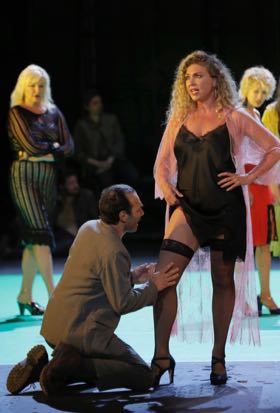
Nikolai Schukoff was Jim Mahoney, Annette Dasch as Jenny
All photos copyright Pascal Victor / Artcompress
Make no mistake, this is about you! Jim laid-out dead on the stage floor, conductor Esa-Pekka Salonen brought his very loud orchestra (London’s Philharmonia) to an abrupt halt. Black out. The maestro then turned his spotlighted face to confront us and he held his stare. There was no mistake, the music was about us.
Stage director Ivo van Hove worked on a wide open, bare sound stage. This was not opera. It was no-where. That was exactly the point, and that is where Fatty, Moses and the widow Begbick built their city Mahagonny to satisfy their greed and our lust.
All this greed and lust were in-your-face — this the orchestra insisted. The maestro gave a loud, very loud, clinical and chiselled reading of the Kurt Weill score from the get-go, making it very clear that it is highly sophisticated, brilliant music, and that it is confrontational.
Mr. van Hove’s staging was confrontational, On the bare stage was a projection screen serving as the glass plate of a microscope under which we would study the faces and the souls of the hordes of men who came to Mahagonny to forget their dreary lives and to indulge their vices and their pleasures. Then came the whores from Alabama and four lumberjacks from Alaska, a bit lost in the visual cacophony of the teeming world.
It was a chaotic stage, but the videographer singled out the faces of our a few of the arrivals while Kurt Weill singled out their voices — Jenny the whore, Jim Mahoney the sensitive, soul searching lumberjack who goes a bit crazy, and his three buddies, Jack the glutton, Joe the boxer and Bill the miser. If their voices were at first nearly lost in the melee, that’s because they were in fact in a melee.
Little by little their projected faces bared their souls to us as their voices grew stronger. The maestro did not indulge the easy rhythms of the Kurt Weill’s jazz, rag time and folk influences. It was musically obvious there was a lot of tough stuff to come.
Jim, the lumberjack, got a bit maudlin and then he got bored. There came a hurricane (three giant fans and a wounded citizen suffering melodramatically on the screen), and Jim had his revelation, and the hordes (well, the thirty men of the Pygmalion Chorus and fifteen supernumeraries) shouted it in our faces. Black out.
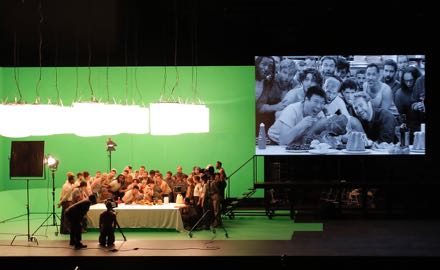
The stage and the screen. Peixin Chen as Joe, Sean Panikkar as Jack (head down),
Thomas Oliemans as Bill at the all-you-can-eat table, with the Pygmalion Chorus
The lid was off — total liberty to totally satisfy any of your cravings, and to get whatever you want. If you can pay for it. A stage was needed to play out the demises of Jack the glutton and Joe the boxer, so one was constructed stage right. There was simulated humping against its back wall, and at the same time we saw very graphic humping projected on the screen, the whore ’s face directly in our face.
Austrian tenor Nikolai Schukoff was Jim Mahoney, the ring leader of it all. Mr. Schukoff is a very charismatic performer, easily projecting a sexuality to be satisfied, but willing to show a softer side and maybe yearn for a better, truer life. Tenor Schukoff is a big performer and easily found the force needed to bust things wide open in Mahagonny (Mr. Schukoff is both a Don Jose and a Siegmund on major stages).
The Rise and Fall of the City of Mahagonny is the epitome of didactic, Epic Theater. These days social commentary wears thin on the opera (or any) stage. As the citizens of Mahagonny were wearying of its corruption we too were wearying. Bertold Brecht maybe was as well, so he added a bit of witty, heavy irony— the Mahagonny inhabitants dream of a new, better city, Bénarès, better known these days as Varanasi, the Hindu city of death. Director van Hove obliged by projecting onto the screen hazy, smokey images of this city of ritualistic cremation as seen from the Ganges.
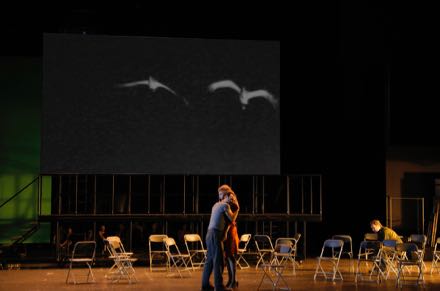
Nikolai Schukoff as Jim, Anette Dasch as Jenny in the final duet.
Jim's friend Bill (Thomas Oliemans) is at the far right.
In the penultimate scene van Hove brought, finally, our total focus and our held back sympathy onto Jim Mahoney when Jim delays his death as long as he can in a long, moving and hopeless monologue, and then makes his farewell to Jenny in a beautiful, tender duet. Here there were no screen projections, there was no microscope. Here was, finally, real human emotion to for us to feel, not to judge.
The Fall of the City of Mahagonny was of the scenic magnitude to equal the gigantic musical efforts emanating from the pit. There was smoke and fire, there was thunder and lightning, more smoke and fire raged from the pit. It was the destruction of Valhalla you have always wanted to see but never got. You have had to settle for Wagner’s pale by comparison account of such cataclysmic destruction.
It was no-holds-barred casting: Karita Mattila as the widow Begbick, Sir Willard White as Moses, Alan Oke as Fatty. The Jenny was German soprano Annette Dasch (a Donna Elvira on major stages) though in this staging Jenny was not given a dominant presence, nor did the staging on the wide open stage provide an acoustic shell to project her voice. The three lumberjacks were of consummate charm and fine voice: Sean Panikkar as Jack, Thomas Allemans as Bill, and Peixin Chen as Joe.
The six prostitutes were gutsy and lusty, very willing to play their parts: Kristina Bitenc, Cathy-Di Zhang, Thembinkosi Magagula, Maria Novella Malfatti, Leonie Van Rheden and Veerle Sanders.
I saw the second of four performances on July 9, 2019.
Production information:
The Philharmonia Orchestra and the Pygmalion Chorus. Conductor: Esa-Pekka Salonen, Mese en scène Ivo van Hove, Scenery and lighting: Jan Versweyveld, Costumes: An d’Huga; Video: Tai Yarden
Tosca at the Aix Festival
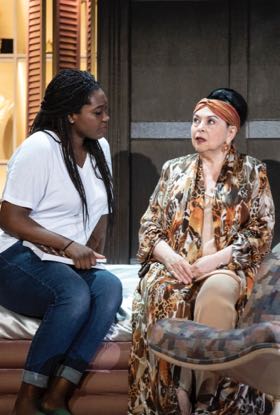
Angel Blue as Tosca, Catherine Malfitano as the old diva
All photos copyright Louis Fernandez
From the sublime — the Mozart Requiem — to the ridiculous, namely stage director Christophe Honoré's Tosca. A ridiculous waste of operatic resources.
Christophe Honoré is a high-profile French film maker and playwright who is a prominent gay activist in this time of a long overdue updating of human rights. This places Mr. Honoré in prime position to become a part of France’s progressive opera world, namely the Aix Festival where he directed the 2016 Ethiopian Cosi fan tutte and the Opéra de Lyon where he directed the 2017 Don Carlos wrapped in stage curtains (until the auto da fé which was stuffed into the galleries of an Elizabethan theater).
Thus it is no surprise that he should be back on the front lines of French avant-garde opera, again at the Aix Festival with a Tosca than he has set in New York City’s Manhattan, or maybe in the far less sophisticated Bronx. It is not Tosca the opera, it is an unsettling tale of the demise of a Tosca diva, Puccini’s magnificent score reduced to a troubling piece of prosaic theater.
Mr. Honoré states in the program booklet that the big question in Tosca is if an artist’s art can protect the artist from life — Tosca’s does not, Cavaradossi’s does not. It would seem that the question need not be asked, since the great, even gigantic gesture in Puccini’s Tosca is release from life. The opera Tosca is an artistic ritual of liberation that can be infinitely repeated. It is not an “impermanent” (descriptive term used by director Honoré) work of art waiting to be used.
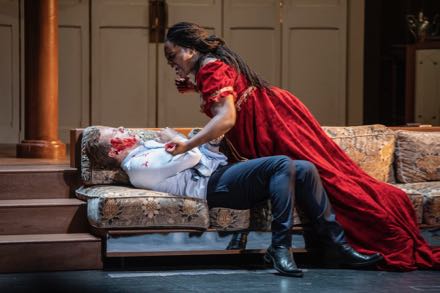
Angel Blue as Tosca in the copy of the dress worn by the Tosca of Maria Callas,
Alexey Markov as Scarpia.
And abused. Abused by the giant screen film adaptations (movies) of real performances that occurred in the past few weeks in Aix cinemas. Or abused by re-writing the story to make the first act the rehearsal for a concert to honor an aged diva, the second act to illustrate psycho-sexual implications of gay diva worship, and the third act to be the concert where the diva is the victim of her art, taking her own life at the conclusion of the concert.
A reading of The Rise and Fall of Gay Culture might suggest that the gay men of the second act vicariously execute the diva to rid themselves of their arch competitor for the seduction of desired males (Cavaradossi, for example).
Then there was the abuse of the audience, making us wait while the orchestra was moved to the stage (no easy process), thus repeating the wait-abuse Mr. Honoré perpetrated on the Lyon Don Carlos audience. And the abuse of the audience by two videographers stalking the stage to capture faces to be continuously projected on giant screens above the stage floor, images of disembodied voices that Mr. Honoré ordains as images of the real (as opposed to the operatic).
The revelation of the evening was the very present, vibrant sound of the Archeveché theater pit evidenced by the huge presence of the excellent orchestra of the Opéra de Lyon. Conductor Daniele Rustioni, music director of the Opéra de Lyon, offered an idiomatically correct reading of the Puccini score, allowing its subtleties to shine forth. The orchestral sound was forceful indeed, though it never competed with the stage for presence. Once on-stage the orchestral sound was nearly magnificent, an unexpected acoustic miracle.
The aged diva of the Christophe Honoré’s Tosca was Catherine Malfitano, once an internationally recognized Tosca. La Malfitano is now seventy-one years old, and retains the remarkable presence that marked her long and distinguished career. She bravely fought her way through this ordeal of uselessness, bravely enduring the ravages of time on the body and voice in this savage vision of artistic demise.
The ingenue Tosca diva was American soprano Angel Blue, already a Mimi on major stages she may yet become a new age Tosca. Maltese tenor Joseph Calleja sang Cavaradossi, his rôle fétishe. His recent Cavaradossi at the Met boasted secure high notes that did not find their way to Aix, the intimacy of the Archeveché theater did not favor his blatant, high-horsepower delivery.
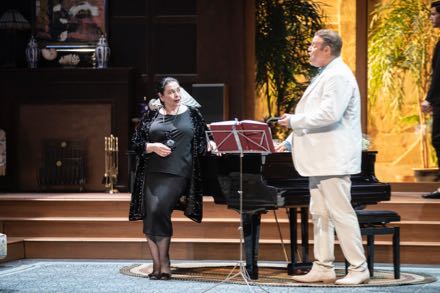
Catherine Malfitano as the Diva, Joseph Calleja as Cavaradossi
Russian bass baritone Alexey Markov provided a trim figured, vocally dark and focused Scarpia. The cluttered, frenetic happenings (lots of gay sex stage-right) on the stage eclipsed his great moments. It was unclear how he fit into the picture. Tosca brutally stabbed him in the face, meanwhile the aged Tosca diva payed a Cavaradossi double for sex. There was so much extra-opera stuff going on I wasn’t sure where to look to discover the essentials. If there were any.
Cast and production information:
La Prima Donna: Catherine Malfitano; Floria Tosca: Angel Blue; Mario Cavaradossi: Joseph Calleja; Il barone Scarpia: Alexey Markov: Cesare Angelotti: Simon Shibambu; Il sagrestano: Leonardo Galeazzi; Sciarrone: Jean-Gabriel Saint Martin; Spoletta: Michael Smallwood; Un Carceriere: Virgile Ancely; Le Majordome: Jean-Frédéric Lemoues; Pompier: Frank Daumas. Orchestre et Choeur de l’Opéra de Lyon; Maîtrise de l’Opéra de Lyon. Conductor: Daniele Rustioni; Mise en scène: Christophe Honoré; Scénographie: Alban Ho Van; Costumes: Olivier Bériot; Lumière: Dominique Bruguière. Théâtre de l’Archeveché, Aix-en-Provence, France, July 6, 2019.
The Mozart Requiem at the Aix Festival
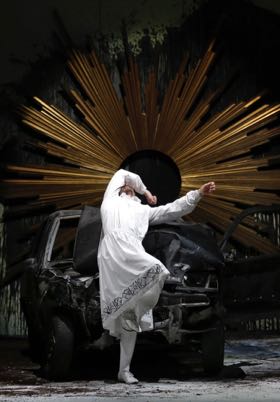
All photos copyright Pascal Victor / Artcompress
Pierre Audi, now the directeur général of the Festival d’Aix as well as the artistic director of New York City’s Park Avenue Armory opens a new era for this distinguished opera festival in the south of France with a new work by the Festival’s signature composer, Wolfgang Amadeus Mozart.
It is, namely, Mozart’s last work, a Requiem Mass left unfinished at his death in 1791, later finished —based on Mozart’s notes and sketches by his student Franz Saver Süssmayr. In this Aix edition it has been reconfigured and expanded by French musical visionary Raphaël Pichon, a conductor well-known at the Aix Festival, and by Italian theater visionary Romeo Castelucci in a belated, long awaited Aix debut.
But this “Mozart” Requiem is now a theater piece somewhat beyond, actually well beyond Mozart’s setting of the Catholic death mass liturgy. His widow Constanza pretended he composed his own requiem, and in Aix it was indeed just that — Mozart’s moment of life long vanished, conceptually the “Aix” Requiem insists that Mozart’s Requiem Mass will vanish as well.
Discovering this existential tragedy made the Castelucci Aix debut well worth the wait. In his Brussels Parsifal, his Lyon Jeanne d’Arc au Bûcher and his Salzburg Salome Sig. Castelucci is fettered by narrative, and imposed philosophical concept and psychological involvement. But in this Aix Requeim, like in his Tragedia Endogonidia cycle, he freely traverses ephemeral human atmospheres filled with unanswered questions that are met with spontaneous reactions. It is rare access to the most hidden theatrical realms of the human psyche.
Like the non-verbal, purely intuitive communicative process of music Castelucci’s language is the non-verbal communicative power of essential theater. There is no intelligence and there is no interpretation, there is but momentary recognitions of an intuited physical reality.
From its first moment in this Aix Requiem, a lone, older woman is perhaps at her death, the requiem passes through her four, simultaneous existences in identically dressed embodiments — a child, a virgin, a mother, and this old woman. The Aix Requiem ends with their issue — a baby alone on the silent stage. A male.
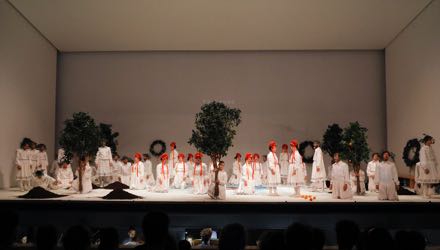
Musically the Requiem begins with the disembodied voice of a male child (soprano) intoning an anonymous Gradual (a response refrain normally sung between recitation of psalms): “Christus factus est.” It insists that the will of God be imposed on man. It is sung in the purest sounds of male innocence.
The usual requiem liturgies of praise and pain continue though interspersed by conductor Pichon with other Mozartian moments — a Masonic hymn, a Psalm setting, the reuse of a piece from his incidental music to Thamos Roi d’Egypte, a solfeggio (sung by the boy), an Amen, the parody of a Serenade, a church song. The Aix Mozart Requiem ends with again the lone voice of the boy intoning an anonymous “In Paradisum” (sung at the moment the body exits the church) — the will of God fulfilled.
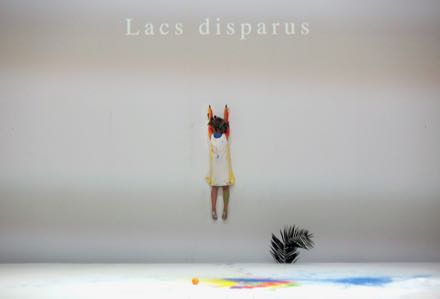
There passed before our eyes an abstracted cruxifiction (the young girl), a forest, a maypole, a wrecked car, the Pygmalion chorus and four soloists of purest voices (soprano, alto, tenor, bass) intoning the liturgies first in the clothes they wore to the theater (a heat-wave in Aix), transforming themselves in courtly white unisex dresses, then in celebratory courtly crimson unisex robes, finally in muslin tunics for the "Agnus Dei" before decaying into a chiaroscuro mass of naked bodies. The complex choruses issued forth while the singers created the structures of the music in abstracted movement, often dance, impeccably carving the interlocking phrases of Mozart’s fugues to construct the technical grandeur of mankind’s accomplishment.
The coup de théâtre was the cataclysm that occurred in the "Communion" of the requiem liturgy, the souls becoming one with God shouting their jubilation, tearing down the white walls of the world. The floor of the stage slowly rose, becoming vertical, the debris of the wall and black dirt of the world randomly sliding down to reveal, finally, a blank, white wall. Death. Silence.
From beginning of the Requiem to its end continuous words streamed across the stage box, naming the now vanished accomplishments of man and nature. The final words, incised, were July 5, 2019 — the day I saw the Aix Requiem.
With, then, the lone male child — the creator — alone on the stage we were left with the finality of death, and the image of creation. There was no comfort in rebirth.
The stage was the music, and the music was the stage. Maestro Pichon’s Pygmalion orchestra of period instruments was the voice and the world of man, the solo winds of purest sound, of psychological innocence, the solfeggio violin duet with the boy soprano giving corpus to nature. The eloquence of the requiem liturgies ceaselessly emerged from the pit in crystal clear phrasing that created profound, truly human embodiment for this mass of death.
This Mozart / Pichon / Castelucci Requiem occurred in the most minimal terms. The chorus sang without score, the stage was but a white box. It was sublime music made alive in pure theater.
Cast and production information:
Conductor: Raphaël Pichon; Mise en scène, scénographie, costumes, lumière: Romeo Castellucci; Collaboratrice à la mise en scène et aux costumes: Silvia Costa; Dramaturgie: Piersandra di Matteo. Chorus and Orchestra: Pygmalion. Soprano: Siobhan Stagg; Alto: Sara Mingardo; Ténor: Martin Mitterrutzner; Basse: Luca Tittoto; Enfant chanteur: Elias Pariente. Théâtre de l’Archeveché, Aix-en-Provence, July 5, 2019.
Barbe-Bleue at the Opéra de Lyon
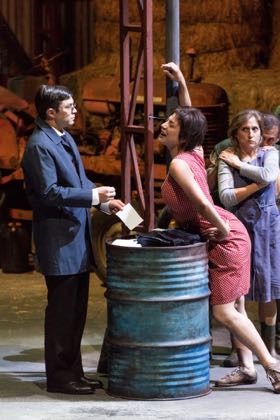
Christophe Gay as Popolani, Héloise Mas as Boulotte
All photos copyright Stofleth
Stage director Laurent Pelly is famed for his Offenbach stagings, above all others his masterful rendering of Les Contes d’Hoffmann as a nightmare. Mr. Pelly has staged eleven of Offenbach’s ninety-nine operettas over the years (coincidently this production of Barbe-Bleue is Mr. Pelly’s ninety-eighth opera staging).
Unlike Mr. Pelly’s straight forward, very charming Peruvian fantasy, La Perichole that I saw at the Marseille Opera in 2002, or his parody of The Barber of Seville (sung on top of sheets of musical score paper) seen at the Marseille Opera in 2018 (boasting the hyper personalities of Stephanie d’Oustrac as Rosina and Florian Sempey as Figaro), here Mr. Pelly’s Barbe-Bleue is set on a farm near Paris and in a grand salon in the Élysée Palace, with actors of limited personality.
The real Barbe-Bleue is the 1619 folk fairy tale by Charles Perrault which Offenbach parodies à la Second Empire. But Mr. Pelly’s stretches the parody to include a parody of his own — that of opera stagings which imitate the criminal underworld (Bluebeard is dressed and acts like a mobster) and a parody of mindless operettas (King Bobeche is a pompous fairy tale king with a silly fairy tale court).
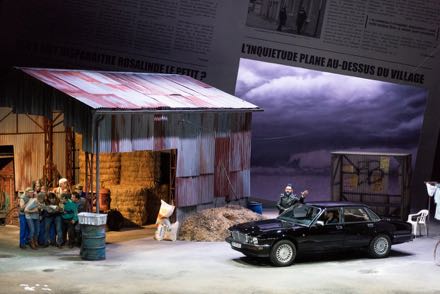
The Farm
The time is now or maybe not-so-long-ago. We see a backdrop that is a latest edition newspaper, two front page articles discuss the strange murders. There is a tractor and chicken sounds and some bales of straw to convince us that all this is somehow what real is. Then we see a huge shelf of weekly revues (magazines), those that thrive on news of lurid allure, maybe true and maybe not. It is a side wall of the grand salon in which such tales of the rich and powerful evidently take place.
All this operetta scenery did not add up to a convincing stage for Offenbach’s amusing serial murders, particularly when we saw the refrigerated lockers of a morgue where Bluebeard’s victims are stored. We do know that "bluebearding" women (serial murder of women) is a real, recognized syndrome, but Mr. Pelly and his long-time designer Chantal Thomas only confused us about what may be real and what may not be.
From copious accounts we know that Offenbach’s muse during his very productive years at the Théâtre des Variétés was mezzo-soprano Hortense Schneider. We read of the very great charm of her performances but, alas, we have no digital records of them. Plus what was charming in the Parisian 1860’s may not charm us these days.
It is however the charm, whatever it may be, of an Offenbach heroine that wins our attention and ushers us into his music. The Lyon Boulotte (the Hortense Schneider role) was bravely undertaken by Héloise Mas who can indeed boast Boulotte’s “Rubenesque” body. Mlle. Mas was directed to be a bratty, tomboy rustic — maybe Mr. Pelly’s idea of real — forgetting that first of all Offenbach’s Boulotte must be a comic diva.
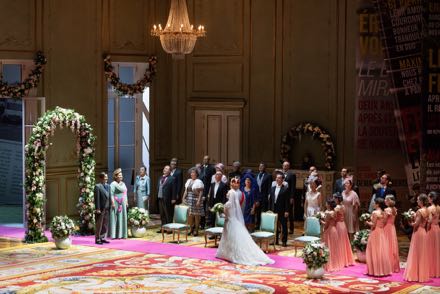
The Palace
Bluebeard himself, played by tenor Yann Beuron, was directed to be oily, dangerous and thoroughly unsavory. Though not the usual mild-mannered, reclusive murderer we read about in actual newspaper accounts of such murders, perhaps Mr. Beuron’s Bluebeard fulfilled Mr. Pelly’s idea of a real murderer.
If the two protagonists of the Lyon Barbe-Bleue were meant to be real, the balance of the cast was rendered quite irreale. Prince Saphir played by Carl Ghazarossian and Popolani played by Christophe Gay were physically willowy, and both had an annoying lock of hair that fell across their faces. Count Oscar was willowy as well. The three men exuded a similar maximal energy in executing their roles while avoiding any distinguishing personality or character.
Fleurette, played by soprano Jennifer Courcier, King Bobeche played by Christophe Mortagne and Queen Clementine, played by Aline Martin were stock operetta characters. The thirty-six choristers were directed as if they were collectively one character — they made unison, abstractly choreographed movements.
Maybe a less slick reading of the score by conductor Michele Spotti and a less slick performance by the Opera de Lyon orchestra might have allowed a bit of Barbe-Bleue’s innate charm to slip through.
Cast and production information:
Barbe-Bleue: Yann Beuron; Le Prince Saphir: Carl Ghazarossian; Fleurette: Jennifer Courcier; Boulotte: Héloïse Mas; Popolani: Christophe Gay; Le roi Bobeche: Christophe Mortagne; Le Comte Oscar: Thibault de Damas; La reine Clémentine: Aline Martin. Orchestre et Chœurs de l'Opéra de Lyon. Conductor: Michele Spotti; Mise en scène et costumes: Laurent Pelly; Adaptation des dialogues: Agathe Mélinand; Décors: Chantal Thomas; Lumières: Joël Adam. Opéra Nouvel, Lyon, France, June 22, 2019
Don Giovanni at the Opéra Garnier, Paris
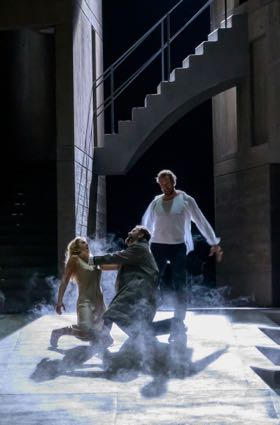
Jacquelyn Wagner as Donna Anna, Etienne Dupuis as Don Giovanni,
Ain Anger as Don Pedro (Donna Anna's father)
All photos copyright Charles Duprat
A brutalist Don Giovanni at the Palais Garnier, Belgian set designer Jan Versweyveld installed three huge, a vista raw cement towers that overwhelmed the Opéra Garnier’s Second Empire opulence. The eight principals faced off in a battle royale instigated by stage director Ivo van Hove. Conductor Philippe Jordan thrust the Mozart score into the depths of expressionistic conflict.
Et voilà, one of the great evenings in the theater. And yes, it was not subtle.
Conductor Jordan immediately pounced on the musical tensions that structure late eighteenth century music and did not let go. The ensuing, unrelenting drama from the pit creating the antagonism between Giovanni and Leporello, with Leporello cruelly rubbing in Giovanni’s sexual exploits to Elvira, Masetto angrily snapping at Zerlina, Giovanni coldly setting up the ambush of Leporello.
Don Ottavio took resolute charge of the vengeance to come, Giovanni brutally beat-up Masetto. Donna Anna, horrified at her aggressor, selfishly cruel to Don Ottavio. Elvira doggedly chased Giovanni, Giovanni focused full determination to seduce the perfect woman. Leporello, finally losing all patience with Giovanni, picked up the Commendatore’s dinner table and threw it across the room.
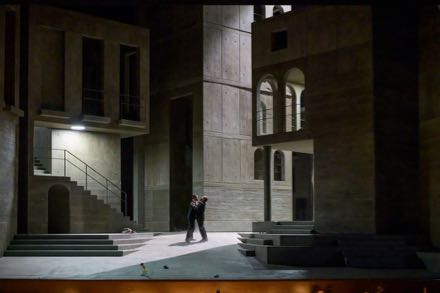
Don Giovanni and Leporello
Giovanni went straight into the seething hell that had been leaking steam through the stage floor from the downbeat of the overture.
And, by the way, Mozart wanted three orchestras on the stage for the Act I finale. There they were, no room for much else, the country dance and the waltz chiming in with the minuet to create a quite Classical idea of cacophony to match the mess on stage.
This Don Giovanni is a gloves off release for all your pent up Don Giovanni hostilities. No wimpy Don Ottavio, no Freudian Donna Anna. No bumbling Masetto or cute Zerlina, no heroic or lonely or debauched Giovanni.
It was pure Mozart, and it was pure Don Giovanni, no questions asked.
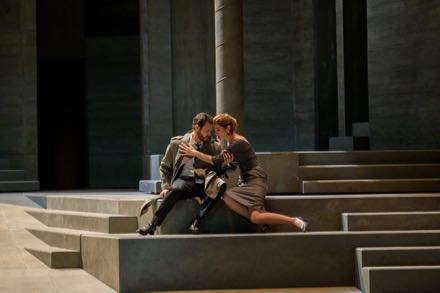
Philippe Sly as Leporello impersonating Don Giovanni, Nicole Car as Donna Elvira
To accomplish this musical and dramatic feat the Opéra de Paris assembled a very handsome cast indeed of fine, beautifully voiced young singers who confronted one another face to face when not nose to nose. Giovanni tall, slim and bearded, Leporello tall, slim and bearded (no Act II suspension of disbelief necessary), Donna Anna obviously very worthy prey, Masetto wiry, sharp witted and energetic, the Commendatore towering in presence and in voice.
Thus it is no understatement to say the the evening was an orgy of Mozartian phrasing, maestro Jordan’s orchestra sharply defining the musical parameters, carving out strategic dramatic plains against which the vocal lines etched themselves.
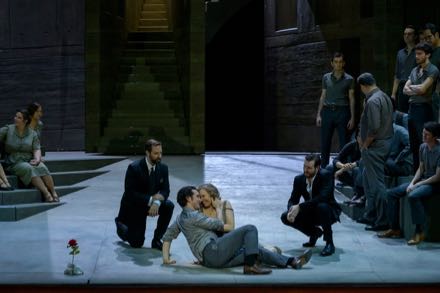
Étienne Dupuis as Don Giovanni, Mikhail Timoshenko as Masetto, Elsa Dreisig as Zerlina, Philippe Sly as Leporello<
The unique colors of each of the voices defined its character — the suavity of the Don’s Act II serenade, the sophistication of Leporello’s “Madamina,” the narcissism of Donna Anna’s “Non mi dir,” the voluptuous of Donna Elvira’s “Mi tradi,” the confidence of Don Ottavio’s “Il mio tesoro” (though sung partly in fetal position), the free and easy sexuality of Zerlina’s “Vedrai carino.”
With a virtuosity and sense of phrasing surely equal to the voices designer Jan Versweyveld lighted his concrete walls, pulling out components of its geometric shapes in light and dark grey based colors, save the saturated gold that flooded the stage for the masked trio “Protegga, il giusto cielo.” Designer Versweyveld served as well as the dramaturg of the production.
Stage director Ivo van Hove and conductor Philippe Jordan created a production that took Mozart’s masterpiece to its bare bones with a myriad of hidden sophistications. This Don Giovanni is a daring creation of great wit and profound sensitivity to Mozart’s masterpiece.
French bass-baritone Etienne Dupuis was Don Giovanni, Canadian bass-baritone Philippe Sly was Leporello. American soprano Jacuelyn Wagner was Donna Anna, Australian soprano Nicole Car was Elvira. French tenor Stanilas de Barbeyrac sang Don Ottavio. Russian Mikhail Timoshenko and Franco-Danish Elsa Dreisig were the Masetto and Zerlina. Estonian bass Ain Anger sang the Commendatore.
Opera and theater director Ivo van Hove directs Kurt Weill’s The Rise and Fall of the City of Mahagonny at the Aix Fesitival next month (July). Note that this Don Giovanni travels to the Metropolitan Opera next year. Conductor Philippe Jordan this summer again conducts the deconstructed Die Meistersinger at the Bayreuth Festival.
The understated, simple costuming for this production was created by An D’Huys, the impressive hell video was created by Christopher Ash.
I saw the fourth (June 21, 2019) of eleven performances.
The Enchantress (Tchaikowsky) in Lyon

Migran Agadzhanyan as the Prince's son, Elena Guseva as the Enchantresse
Photos copyright Stolteth, courtesy of the Opéra de Lyon]
Dido and Aeneas, Il ritorno d’Ulisse and Tchaikowsky’s L’Enchantresse, the three operas of the Opéra de Lyon’s annual late March festival all tease destiny. But far more striking than the thematic relationship that motivates this 2019 festival is the derivation of these three productions from the world of hyper-refined theater, far flung hyper-refined theater.
Of rich theatrical interest are the two new productions — Hungarian stage director David Marton’s Dido and Aeneas filtered though Berlin’s late, lamented Volksbühne, and Moscow-formed Ukrainian stage director and theatre theorist Andriy Zholdak’s The Enchantress filtered through the filmic lens of the 1950’s and 60’s (Fellini, Bergman). Of less interest but still of enormous pleasure was Monteverdi’s Il ritorno d’Ulisse, revived in the 1999 William Kentridge South African life-size puppet theater production, sung by members of the Opéra de Lyon young artist program.
Andriy Zholdak’s staging of Tchaikowsky’s The Enchantress is nothing less than monumental. The Enchantress is the ninth of Tchaikovsky’s eleven operas (Eugene Onegin is the fifth, Mazeppa the seventh, Pique-Dame and Iolanta the tenth and eleventh respectively). It is Tchaikovsky’s lengthiest work (just under four hours with one intermission) that only recently is finding its way into the repertory after a tepid reception back in 1887.
Mr. Zholdak makes a strong case that The Enchantress is one of opera’s great theatrical moments, or maybe it was conductor Daniele Rustioni who made the case. Working together the two artists kept their audience spellbound for the duration, the orchestra unflaggingly sustaining the unrelenting tension on the stage.

A bedroom juxtaposed to Prince's dining room, with faces of two adolescent girls
seated center back watching action, video projected
A priest, probably a surrogate Mr. Zholdak, extinguished candles in Lyon’s St. John the Baptist cathedral, climbed into a limousine to arrive at Lyon’s Opéra Nouvel (we watched this on video). Arriving onto the stage he contemplated a game of chess, a game that soon moved to the beautiful Nastasia’s humble inn where he engaged her in a game. Four hours later, a few chess boards and a card game later dressed in a green suit he batted tennis balls against the inn’s walls during the wrenching lament of the opera’s antagonist (who had just murdered his own son).
Early on the priest planted a camera in the eye of crucified Jesus then donned virtual reality goggles to watch and encourage things to go from bad to worse. The Prince’s son stopped by the inn briefly. At the mere sight of him Nastasia fell in love. The Prince stopped by a few minutes later and fell madly in love with Nastasia. Neither the Prince’s wife nor the Prince’s son could abide the Prince’s infatuation with Nastasia.
Like in a dream seemingly random images flowed hour after hour alongside, though of course they were related somehow. Location somehow shifted between Nastasia’s mean little wooden inn, the Prince’s towering, blinding white dining room, Nastasia’s boudoir, and a stone chapel with a huge, crucified Jesus. A catalogue of sexual desires were fulfilled, fantasy murders were enacted. A story was somehow told (the Prince’s wife poisons Nastasia, the son renounces his mother, the prince murders his son in a fit of jealous rage).
Tchaikovsky’s score turged on, magnificent arias, magnificent rages, ecstatic duets, huge choral climaxes (though we never actually saw the chorus). Alternative Images flowed unbound, uncontrolled by linear narrative. Zholdak’s world unfolded in an unparalleled display of theatrical craftsmanship, both artistic and technical. Tchaikovsky’s orchestral world spewed forth in unbridled emotion like no Tchaikovsky score you have heard before.

Three (of four) constantly moving scenic elements, crucified Jesus in white light
The Opéra de Lyon assembled an exemplary cast. Beautiful Russian soprano Elena Guseva inhabited the temptress role to perfection in beautiful, warmly Russian tone that never faltered through the punishing several hours of singing. Former Los Angeles Opera young artist, Russian tenor Migran Agadzhanyan gamely played with his teddy bear, soundly berated his mother and ardently declared his love for Nastasia in a total performance. Russian mezzo soprano Ksenia Vyaznikova was unrelentingly terrifying as the mother in music that explored the full mezzo vocal and histrionic range. Azerbaijan baritone Evez Abdulla reveled in splendidly baritonal self indulgent swagger as first the love sick prince then the tortured father.
Polish bass Piotr Micinski played the priest Mamyrov in an amazing display of body language and dramatic concentration in his constant, silent presence as the star of Zholdak’s and now Tchaikovsky’s dream. It was a performance of absolute virtuosity. Of note also was the physicality of the sorcerer Koudma sung by Siberian baritone Sergey Kaydlov. The myriad of secondary roles were sung in fearsome Russian both by Russian singers and by the French artists who appear regularly at the Opéra de Lyon.
Cast and productionThe Enchantresse Princesse Eupraxie Romanovna: Ksenia Vyaznikova; Mamyrov: Piotr Micinski; Prince Youri: Migran Agadzhanyan; Nenila, sa sœur: Mairam Sokolova; Ivan Jouran: Oleg Budaratskiy; Nastassia (surnommée Kouma): Elena Guseva; Loukach: Christophe Poncet de Solages; Kitchiga: Evgeny Solodovnikov; Païssi: Vasily Efimov; Koudma: Sergey Kaydalov; Foka: Simon Mechlinski; Polia: Clémence Poussin; Balakine: Daniel Kluge; Potap: Roman Hoza; Invité: Tigran Guiragosyan. Orchestre et Chœurs de l’Opéra de Lyon. Conductor: Daniele Rustioni; Mise en scène et décors: Andriy Zholdak; Lumières: Andriy Zholdak et les équipe lumières de l'Opéra de Lyon; Décors: Daniel Zholdak; Costumes: Simon Machabeli; Vidéo: Étienne Guiol. Opéra Nouvel, Lyon, France, March 24, 2019.
Dido and Aeneas in Lyon
Henry Purcell’s masterpiece Dido and Aeneas is of sufficient dramatic magnitude to command an evening in and of itself. However its brief, fifty minute duration does not fill an evening at the opera. It is an unsolvable problem.

Dido and Aeneas with chorus members
The Opéra de Lyon offered just now a novel solution — the immersion of Dido’s tragedy and Aeneas’ destiny into a larger piece of conceptual theater. Such theatrical exercise has had impressive precedent at Berlin’s Volksbühne with works like famed director Frank Castorf's dismembering of Dostoyevsky’s Insulted and Humiliated in a seven hour sitting, and Schumann’s setting of Goethe’s Faust Book II ignored in a seven hour sitting because the director decided he didn’t know what to do with it so they would simply stage something or the other on the set built for the opera, never mind that the actors had learned to sing its lines.
Volksbühne formed Hungarian stage director David Marton and his dramaturg Johanna Kobusch knew exactly what to do with Dido and Aeneas to make it into a two hour evening — they sank it into an archeological dig, building on the current scientific myth that time moves in circles. Thus you are where you have already been revealing the multiple civilizations present in Purcell's Dido and Aeneas.

Juno and Jupiter (lower left) video projected (note presence of videographer)
Cleverly Mr. Marton turned to Virgil to find lines for toga-attired Jupiter and Juno to speak while they dug in a covered dig finding artifacts of our tech age. Finnish composer Kalle Kalima created convincing noises and some fine new music from time to time to make much of the spoken episodes into a melodramma of sorts (speech with music). These spoken episodes related the adventures of Aeneas, amplifying the evening beyond the personal tragedy of the queen of Carthage to encompass a larger vision of humanity. Aeneas himself, sung by Guillaume Andrieux revealed himself not only a fine singer but also a high-style actor.
Purcell’s little tragedy did find its way into the melée from time to time, Belinda, sung by a matronly Claron McFaddon, offering sage advice over drinks to Dido, sung by soprano Alix le Saux, dressed for cocktails. A huge black period dress was provided to Mlle. le Saux for Dido’s, "When I am laid, am laid in earth," though this did not manage to support the lament which had little of the wrenching gravity that makes this aria one of opera's towering masterpieces.
There was a striking Volksbühne moment. The face of Icelandic actor, Thorbjörn Björnsson (a former Volksbühne actor), was painstakingly revealed as the dirt covering it (he was fully buried in the dirt of the excavation) was slowly brushed away by Juno (we watched this procedure on video close-up).

Face of buried Jupiter becoming apparent, brushed by Juno, video projected from excavation pit.
Swiss performance artist Erika Stucky (born in San Francisco) made all sorts of vocal noises pinch-hitting as Purcell’s witch plus scrunching cellophane, dragging a shovel, etc. These added bits of performance art were annoying to some of us. Many in the audience had had enough and exited the theater during her bits.
Of particular pleasure were Purcell’s madrigals, gracefully performed by members of the Opéra de Lyon chorus. These highly skilled singers articulated Purcell’s voice lines in ways that added a textural lightness through which new layers of meaning emerged. A sizable string orchestra comprised of members of the Opéra de Lyon orchestra gave a bright sound to what little Purcell we actually heard, as well as to the added intermezzos and their musical destruction by composer Kalle Kalima (dressed in a white suit, he sat with his electric guitar on a high platform in the orchestra pit). Conductor Pierre Bleuse obliged with all the necessary moods.
The production had the feel of a clique of artists who got together to do something they thought was cool. The audience at the performance I attended had little patience for it.
Cast and productionDido and Aeneas Didon: Alix Le Saux; Enée: Guillaume Andrieux; Belinda: Claron McFadden; Esprit / chant / interludes: Erika Stucky; Juno / comédienne: Marie Goyette; Jupiter / comédien: Thorbjörn Björnsson. Orchestre et Chœurs de l’Opéra de Lyon. Conductor: Pierre Bleuse: Concept et mise en scène: David Marton; Composer: Kalle Kalima; Décors: Christian Friedländer; Costumes: Pola Kardum; Lumières: Henning Streck; Vidéo: Adrien Lamande; Dramaturgie: Johanna Kobusch. Opéra Nouvel, Lyon, France, March 23, 2019.
Orfeo ed Euridice in Rome

Carlo Vistoli as Orfeo, Mariangela Sicilia as Eurydice
All photos courtesy of the Teatro dell'Opera di Roma]
No wrecked motorcycle (director Harry Kupfer’s 1987 Berlin Orfeo), no wrecked Citroen and black hearse (David Alagna’s 2008 Montpellier Orfée [yes! tenorissimo Roberto Alagna was the Orfée]), no famed ballet company (the Joffrey Ballet) starring in L.A. Opera’s 2018 Orpheus and Eurydice).
In Rome there was but an excavated grave.
It was Canadian stage director Robert Carsen’s 2006 Lyric Opera of Chicago take on the ancient Orpheus legend as told by Virgil in his Georgics and then reimagined in 1762 Vienna by Christoph Willibald Ritter von Gluck — these days simply called Gluck — as a one and one half hour azione teatrale.
Mr. Carsen revived his production of Gluck’s azione teatrale last November (2018) in Paris with famed French counter-tenor Philippe Jaroussky and French soprano Patricia Petibon, and just now (March 21) he staged it again in Rome with an all-Italian cast and conductor. Note that when Gluck refashioned his opera in French for 1774 Paris it became a full-blown drame héroique, Orphée was now a non-controversial haute-contre (a naturally high tenor voice) rather than a contralto castrato (a voice once disliked by the French), and of course Gluck added airs, choruses and dances to make a lengthier evening.

Carlo Vistoli as Orfeo with Act I mourners
Back in 1762 Vienna there were two brief dances in the drama — one by the infernal spirits, another by the Elysian spirits — and now in Rome (as well as Paris!) there were none. Robert Carsen’s stage was but a bed of pebbles, an excavated grave, a hand held bowl of fire and a sky. The black silhouettes of mourners bemoaning the death of Eurydice transformed themselves into barely visible, supine, white covered infernal spirits who slowly transformed themselves into black silhouetted blessed spirits, movement that sufficed to prolongate Gluck’s drama.
If there was actual dance in the Carsen Orfeo ed Euridice it was in the duet of Euridice’s escape from hell. Euridice, beautifully sung by Mariangela Sicilia, repeatedly implored Orfeo to place his loving gaze upon her, when he did not she turned away in dismay. Orfeo then faced the back of her head to beg her repeatedly to wait. She would not.
The emotional stillness of director Carsen’s bleak choral landscape was initially shattered by Orfeo’s thrice repeated,“Euridice” in a spine chilling cry by Italian counter-tenor Carlo Vistoli. Mr. Vistoli is the perfect swain — young, handsome, masculine, immaculately groomed musically, endowed with a beautiful contralto voice. Though Gluck’s arias for Orfeo were much simplified from the highly ornamented singing of the Baroque, Mr. Vistoli did not eschew adding the occasional appoggiatura. These chokes and sobs rendered his laments heart wrenching.
If conductor Gianluca Capuano normally conducts period instrument orchestras, in Rome he revelled in exploiting the resources of a modern symphonic ensemble (the Rome Opera orchestra) to create an immediacy that did not falter through the intermission-less duration. It was a close reading of Gluck’s score that left no emotive phrase unremarked, taking us to an emotional level that in fact betrayed Gluck’s intention to purge Baroque opera of its excesses.

The great tension of Baroque opera is love vs. duty. It is indeed this same tension that pervades Gluck’s reform opera. It is Orfeo’s duty to not look at Euridice, and finally it is his love for Euridice that forces him to forsake his pledge, his passion overwhelming the art that had so moved the infernal spirits.
By the time we arrived, with Orfeo, to his “Che faro senza Euridice” we were all in a state of utter despair, Gluck’s azione teatrale having become an expressionistic nightmare.
Fortunately Gluck’s Amore, sung by Hungarian born, Italian formed soprano Emöke Baráth, saved the day reuniting Orfeo and Eurydice through the power of love, thus averting Orfeo's suicide, indeed the mass suicide of all of us who, with Orfeo, had endured the tragedy of this splendid evening.
Cast and production
Orfeo: Carlo Vistoli; Euridice: Mariangela Sicilia; Amore: Emöke Baráth. Orchestra and chorus of the Teatro dell'Opera di Roma. Conductor: Gianluca Capuano; Production: Robert Carsen; Sets and Costumes: Tobias Hoheisel; Lights: Robert Carsen and Peter Van Praet. Teatro dell'Opera, Rome, Italy, March 21, 2019.
La Pieta in Rome

Michelangelo's Pietà in the Vatican [Wikipedia photo]
Say "La Pietà" and you think immediately of Michelangelo’s Rome Pietà. Just now Roman Oscar-winning film composer Nicola Piovani has asked us to contemplate two additional Pietà’s in Rome, a mother whose son is dead by overdose, and a mother whose son starved to death.
Composer Piovani’s La Pietà is subtitled a "Stabat Mater" per due voci femminili, voce recitante e orchestra. The work makes use of the 13th century poem/prayer “Stabat Mater Dolorosa,” probably by Jacopone da Todi, known to literary scholars not only as a poet who explored primitive vernacular Italian but also as a visionary of medieval liturgical theater.
Mr. Piovani’s Stabat Mater is theater only in so much as it is made of words and needs the immediacy of live performance to take flight. Mr. Piovani’s Pietà is opera only in so much as it uses voice with music (melodramma) and song (arias and duets). Maybe it can be called opera theater because there is are threads of narrative that unfold, and a conclusion is reached — the maternal contemplation of the fact of her child’s death.
The single performance, March 20, did take place in the Teatro Costanzi (Rome’s opera house) thus adding default spectacle. A performance platform sat in front of the covered proscenium (hiding the current Gluck Orfeo ed Euridice installation). Thrusting well into the audience this stage instilled a welcomed urgency into the performance.

Composer/conductor Nicola Piovani, Actor Giogi Proietti
All photos courtesy of the Teatro dell'Opera di Roma
Mr. Piovani composed this work in 1998 to verses by his friend Vincenzo Cerami (deceased in 2013), the screenwriter for Roberto Benigni’s Life is Beautiful, the film for which both Mr. Pioveni and Mr. Cerami received Oscars. Originally scored for 14 instruments at its premiere that same year the spoken role was taken by Mr. Piovani’s friend, actor Gigi Proietti, then 58 years old.
At the Teatro Costanzi just now 78 year-old Mr. Proietti was again the voce recitante. Mr. Proietti and Mr Piovani are now very well known and very respected figures in Italian film and theater thus Teatro Costanzi was filled to capacity with an enthusiastic and supportive audience.
To say that composer 72 year-old Piovani is prolific is an understatement. He has created the musical scores for 148 films and 49 plays and as well as has created 17 theater works (voices with music) plus a number of interesting chamber and orchestral works. Fortunately Nicola Piovani is a also very good composer.
For this performance of La Pietà Mr. Piovani expanded his chamber ensemble to symphonic proportions (the Rome Opera orchestra) — double winds with a full string complement (12/10/8/6/4), harp, two keyboards, expanded percussion plus a saxophone and batterie. The composer conducted.

Amii Stewart, soul singer, and Maria Rita Combattelli, soprano
The six movements of La Pietà / Stabat Mater interspersed orchestral intermezzi with spoken excerpts from Jacopone da Todi’s prayer (both translated and in medieval Latin), alternating with the histories, spoken and sung, of the lives of two young men. One was from an affluent Europe, the other from third world Africa. The European mother was sung by Maria Rita Combattelli, a high (stratospheric) soprano, amplified only because all voices were amplified, the African mother was sung by African soul singer Amil Stewart. Gigi Proietti brought expected high style theatrical delivery of the text.
Mr. Piovani is a master of descriptive music, and he is very adept at diverse styles ranging from soul and pop to symphonic styles ranging from easy listening to avant-garde minimalist structures. All the styles were beautifully expanded to symphonic proportions. The art of the evening was not in the workmanlike creation of these musical styles as much as it was in the lively juxtaposition of the styles in service to a complex, emotional text.
It was a beautifully performed and presented evening, greatly appreciated by its audience.
The Outcast in Hamburg

The Elbphilharmonie in Hamburg, Herzog & De Meuron architects
Photo copyright Thies Rätzke, all photos courtesy of the Hamburg Philharmonie
It is a “a musicstallation-theater with video” that had its world premiere at the Mannheim Opera in 2012, revived just now in a new version by Vienna’s ORF Radio-Symphonieorchester Wein for one performance at the Vienna Konzerthaus and one performance in Hamburg’s magnificent Elbphilharmonie (above). Olga Neuwirth’s The Outcast and this rich city are imperfect bedfellows!
Austrian composer Olga Neuwirth’s muse is injustice fuelled by discrimination and the abuse of power, themes that she welcomes in this retake on Herman Melville’s Moby Dick. The more sensational content of “the great American novel” is extracted and elaborated to make a sort of dramatic action supported by a musical score of great interest and indeed considerable appeal.
With the proliferation of our current “news and commentary” hungry culture Mme. Neuwirth’s expositions of contemporary evils are already the evils we well know. Thus at first glance the dramatic action of The Outcast is redundant elaboration of current sensibilities, overworked, everyday material that has lost edge through constant exposure. Our interest in Mme. Neuwirth’s installation is therefore focused on how she manipulates Melville and his great work.
To appreciate and to feel her music to its probable depths we needed to understand the text it embodies. I am not the first critic to say that an appreciation of The Outcast depends on an advance examination and consideration of its libretto. Without such warning we were left with only an approximate idea of its glories. Mme. Neuwirth’s The Outcast verges on hermeticism (art with difficulties that exclude a larger public).

Starbuck, Stubb, Ahab, Pip, Queequeg, Ishmaela. Photo copyright Claudia Höhne
Essentially the ship Pequod and its captain Ahab plunder the sea [reeking profits from their exploitation of the world’s resources], the Pequod’s crew at first idealistic whalers then give themselves to Ahab’s purposes [democracies that succumb to a strong, destructive leader]. Meanwhile in the libretto Ismael become Ismaela [self realization] among other strident themes. Neuwirth adds a spoken text (by Boston based Austrian author Anna Mitgutsch) for an “old” Melville. This text, read by an actor, questions power and helplessness, God, the act of writing, fate, cruelty and the beauty of nature.
Olga Neuwirth’s musical palette in The Outcast is a full symphony orchestra (double winds), plus a synthesizer, accordion and an electric guitar. There is no such thing as harmony (vertical structures of accord or discord), there are no scales (successive tones of internal attractions that have repetitive structure), and there is never any discernible beat or repetitive rhythm. Thus Mme. Neuwirth creates successive masses of symphonic sounds that are thrusts and plaines of complex colors (infinite shades) enhanced by amplification.
Vocal lines while linear and text friendly are not melodic. They certainly are not easy to sing. The concert format of the installation allows the presence of scores — a necessity given the arbitrary linear movement.
In her Outcast storytelling Mme. Neuwirth does use a sort of “concrete” music — the guitar for a folksong episode, the synthesizer fabricates a pipe organ for a New England church, the accordion a ship song, the traditional, recognizable (or maybe what we call real) musical structures soon dissolve into Mme. Neuwirth’s symphonic messes.
The Neuwirth musical poetic is fully developed and extremely effective. May it achieve its potential in her upcoming commission for the Vienna Staatsoper (this coming fall), an opera based on Virginia Woolf’s Orlando. Perhaps she will have the help of a dramaturg.
British designer/video artist Netia Jones created this installation. There were five screens of various sizes with sometimes bits of projected English language text that you were not meant to read, rather to accept as Moby Dick the book, other times there were still images of the open sea, and sometimes there were static, abstract vertical lines. The total look of the production was nothing less than spectacular, the eight costumed soloists (seven singers, one actor) in a line across the front of the orchestra platform, the male chorus single lined across the back behind the orchestra, the screens suspended above the chorus loft and the boys chorus eerily placed up there as well, and spookily lighted. The cast was quite able and did indeed bring Mme. Neuwirth’s The Outcast to vibrant life. The star of the show was the Munich Boys Chorus (Müncher Knabenchor) who stood without the slightest movement for the one and one half hour duration, singing the very difficult music that expressed the innocence of young boys who became sailors.
Israeli conductor Ilan Volkov, held all this together with no evidence of stress, adding to the overall impression of a beautifully produced evening.

Lighted area are the public areas of the Elbphilharmonie. Photo copyright Ralph Larmann
Hamburg is the epitome of a rich city. Rich enough to have a recent new opera house and rich enough to build this magnificent new concert hall designed by the star Swiss architecture firm Herzog & de Meuron. The structure, built over an old waterfront warehouse is a veritable Mount Parnussus of music — once inside the theater itself (it starts on the eighth elevator level of the building) you climb and climb through pure whiteness to the level (there are five) of your seats, spectacular, black-night city views are revealed from time to time. Note that the building holds also a hotel and 45 apartments.
The acoustical engineer was the famed Yasuhisa Toyota, responsible for the excellent acoustic of Los Angeles’ Disney Hall as well as other recent theaters throughout the world. Given the amplification of The Outcast forces it was not possible for me to assess the hall’s real sound.
That The Outcast is outrage directed at the capitalistic forces that could finance this $1,000,000,000 structure was the glaring irony that defined the evening.
Cast and production
Emily Hindrichs: Ishmaela; Omar Ebrahim: Ahab; Daniel Gloger: Queequeg; Georgette Dee: Bartleby, der Schreiber; Johan Leysen: Old Melville; Steve Karier: Father Mapple; Jan Petryka: Starbuck; Matthias Helm: Stubb; Joel Beer: Pip. ORF Radio-Symphonieorchester Wien, Company of Music Vokalensemble, Münchner Knabenchor Chor. Conductr: Ilan Volkov; Design and Video: Netia Jones; Sound Design: Gilbert Nouno Klangregie. Elbphilharmonie, Hamburg, Germany, March 4, 2019).
Der Fliegender Holländer and Tannhauser in Dresden

Georg Zeppenfeld (standing) as Daland, Senta child double (kneeling) and Dutchman (foreground)
All photos courtesy of Semperoper Dresden
To remind you that Wagner’s Dutchman had its premiere in Dresden’s Altes Hoftheater in 1843 and his Tannhauser premiered in this same theater in 1845 (not to forget that Rienzi premiered in this Saxon court theater in 1842).
The Altes Hoftheater, designed by Danish architect Gottfried Semper, had opened in 1841 but burned to the ground in 1869. It was rebuilt by Semper and his son only to be bombed in 1945. Painstakingly restored by the then East Germans it again opened in 1985. Somewhere along the line it became the Semperoper — as well as an homage to its architect the name has become a clever play on words.
The 1300 seat Italian style theater offers rare insight into what might have been the long ago sounds of these first two operas of Bayreuth’s “Wagner canon.” The Semperoper has a very present pit, and not a very large pit.
The colors of the winds that emerged from the Tannhäuser pit were quite pure and very distinct, volumes and intensities of sound were measurably calibrated resulting in specific musical atmospheres for Wagner’s leitmotifs. The strings found bite when needed, and most of all emitted a truly stringy tone that molded a sharply etched harmony. Brass was brilliant, tympani were thunderous, and, cherry atop the cake, the Tannhäuser pit harp sounded loudly, as if it were just by the Wartburg minnesingers on stage. The Semperoper sound is distinctly not the Bayreuth sound.

Stephan Gould as Hermann (far left), Ekaterina Gubanova (standing) as Venus
The Dresden Stadtskapell principal conductor, Israeli born, thirty-seven year old Omer Meir Wellber was in the pit for this seventy-first performance of the 1997 production by the famed German director Peter Konwitschny who was fifty-two years old at its premiere. The nineteenth century painting that was the show curtain disappeared during Mo. Wellber’s splendid account of Wagner’s famous overture to reveal a huge stage wide, tilted golden bowl into which a bevy of mythological Bacchantes joyously slid. We knew we were in for a good time.
When once again we were among the mortals of Wartburg director Konwitschny replaced the bowl with a huge, stage wide, acutely curved crescent shaped platform wittily reminding us that there were some slippery slopes ahead (Tannhäuser’s salvation). It can be mentioned that the high step up onto this soaring platform and ascending its slopes was challenging for some of the performers.
Of extraordinary pleasure were the male choruses, the theater’s immediate acoustic supporting the clarity of its uniquely beautiful tone, this acoustic as well permitting the voices of the protagonists to project clearly through even the most intense orchestral fortes. Though the actual words of Wagner’s poem were very present in our ears, and supertitles may have been superfluous, the Semperoper provides supertitles in German and in English (there are no supertitles at Bayreuth).

Ricarda Merbeth as Elisabeth
If the initial vocal and physical movements of American Heldon tenor Stephen Gould were clumsy, by the third act when we had arrived at his extended narration of his pilgrimage to Rome he redeemed himself, if unfortunately not spiritually certainly artistically, and we were genuinely moved by his torment and later by his death. German soprano Dorothea Röschmann delivered a solidly sung Elizabeth throughout, though she did not plumb the emotional depths of Wagner’s sublime prayer to the Virgin Mary. American baritone Christoph Pohl sang Wolfram in requisite beautiful voice and depth of feeling as Elizabeth’s rejected suitor.
Stage director Konwitschny pursuing his Berliner Ensemble roots made his few scenic elements into abstracted symbols of Wagnerian philosophical aspirations. Of special prominence were the outsized swords wielded first by Tannhäuser and the Baccantes, then by the knights of Wartburg and finally by Elisabeth as she crouched before Wolfram while he delivered his exquisitely sung hymn to the evening star. The sword became the Calvary cross born by Jesus in his sacrifice to save sinners, now borne by Elisabeth to save Tannhäuser’s soul — this a quite striking image.
The musical edition for this production seems to be a combination of Wagner’s 1860 Dresden version, his 1861 Paris version and his 1875 Vienna version. Though there was no Act I ballet, Venus did appear at the end of the opera tempting Tannhauser to return to her. And in this Konwitschny staging the rejected Venus does not disappear, but overcome, she caresses the dead Elisabeth while Tannhäuser whispers his final plea for salvation to Elisabeth, the offstage chorus of pilgrims extolling the infinite mercy of God.
Venus was sung by Russian mezzo Ekaterina Gubanova, a role that is perhaps wasted on this gifted artist of wide emotional range (cfr. her Paris Eboli). The Konwitschny production works in bold conceptual strokes, any subtleties in Mme. Gubanova’s discrete performance were invisible and superfluous.
Cast and production
Tannhauser Landgraf Hermann: Georg Zeppenfeld; Tannhäuser: Stephen Gould; Wolfram von Eschenbach: Christoph Pohl; Walther von der Vogelweide: Patrick Vogel; Biterolf: Jukka Rasilainen; Heinrich der Schreiber: Tom Martinsen; Reinmar von Zweter: Alexandros Stavrakakis; Elisabeth: Dorothea Röschmann; Venus: Ekaterina Gubanova; Ein junger Hirt: Tania Lorenzo. Sächsischer Staatsopernchor Dresden, Sinfoniechor Dresden, Staatskapelle Dresden. Conductor: Omer Meir Wellber; Staging: Peter Konwitschny; Set Design: Hartmut Meyer; Costume Design: Ines Hertel; Choir Jörn Hinnerk Andresen. Semperoper, Dresden, Germany, March 2, 2019.
Der Fliegender HolländerIf the Tannhäuser pit revelled in the acoustical glories of the Semperoper, the Holländer pit underscored the stylistic limbo of this first mature Wagnerian music drama. American conductor John Fiore favored a bright, Italianate sound, making no effort to explore the darker atmospheres that can make Wagner’s Dutchman a magical experience.

Act II: Senta's bedroom
This was the thirtieth performance of this 2013 production by German opera and theater director Florentine Klepper. Most striking was the doubling of Senta with a pre-adolescent girl who rescued a wounded vulture during the overture and caressed it during much of the first act. She is also cruelly ensnared in fishing net by raucous sailors in the joyous music the closes the first act.
The spinning chorus of the second act brings thirty or so, identically dressed, pregnant women onto the stage who proceed to give live births on the stage (my third experience with scenic live births this year), Senta’s friend Mary is the midwife. The third act opens as a sort of marriage festival, with Senta’s father Daland lying Freudianly dead on a bed downstage left.

Act III marriage
Said and done, the Dutchman exits stage left to board his ship, sacrificed forever to the sea, video projected vultures obsessively circling. Senta puts on a coat, picks up a suitcase and exits stage right.
As you can imagine we were on the edge of our seats struggling to make all this somehow make sense, and of course we heard Wagner’s music as never before. The Semperoper fielded a plausible cast and Mme. Klepper was vindicated. If not the masculine redemption Wagner intended, it was still high music drama indeed, Mme. Klepper making the case that the Wagner muse had set its sights well beyond the mid-nineteenth century to the moment when the feminine spirit was as redeemable as the masculine.
Senta was convincingly sung by German soprano Ricarda Merbeth, a role she performed last summer at Bayreuth. Korean born, Italian finished baritone Antonio Yang was the rich, youthfully voiced Holländer who projected a threateningly confident and finally a sympathetically complex character. Senta’s first love, Erik was sung by Croatian tenor Tomislav Mužek, also an alumnus of last summer’s Bayreuth Dutchman. Bass Georg Zeppenfeld of the original 2013 cast again sang Daland, Simeon Esper also from the 2013 cast sang the Steersman.
Cast and production
Der Fliegender Holländer Holländer: Antonio Yang; Senta: Ricarda Merbeth; Daland: Georg Zeppenfeld; Mary: Michal Doron; Erik: Tomislav Mužek. Steersman: Simeon Esper. Sächsischer Staatsopernchor Dresden, Staatskapelle Dresden. Conductor: John Fiore; Staging: Florentine Klepper; Set Design: Martina Segna; Costume Design: Anna Sofie Tuma; Lighting Design: Bernd Purkrabek; Video: Bastian Trieb. Semperoper, Dresden, Germany, March 1, 2019.
Faust in Marseille

Nicolas Courjal as Méphistophélès, Mean-Pierre Furlan as the old Faust
All photos copyright Christian Dresse, courtesy of the Opéra de Marseille
We sat, bewildered, all of us, watching (enduring) Gounod’s sweet little tear jerker as a nasty drug trip. Except for the Australian Marguerite it was an all French cast and they all gamely played along, the sophisticated verse of Offenbach’s librettists Jules Barbier and Michel Carré clearly sailing out over an abrasive pit.
It was a difficult evening at the Opéra de Marseille, a fine cast in service of a production from the Opéra Grand Avignon where stage director Nadine Duffaut has staged 14 productions over the years for her husband Raymond Duffaut, Avignon Opera’s guiding light since 1977 when he was appointed general director by his father, the then mayor of Avignon.
Opera in the south of France traditionally has been mired in politics, the complexities of which extend to the complicities of the Provençal opera houses. This 2017 Avignon Faust soon travels from Marseille to Nice for performances in May.
Mme. Duffaut is in fact an able metteur en scène. Her 2016 Opéra Grand Avignon production of Katja Kabanova which I saw at the Opéra de Toulon (45 miles from Avignon) proved her to be a meticulous storyteller, Janacek’s turgid tale of the intricacies of family and business coinciding with Mme. Duffaut’s obsession with detail. The Katja Kabanova unfolded in nothing more than a white box, Janacek’s motivic complexities directly objectified by Mme. Duffaut’s actors.
Such was not the case in this much reviled production as seen just now in Marseille. The simple bel canto like dramatic structure of Gounod’s naive story was amplified into a complex, bizarre nightmare that can only be deciphered by Mme. Duffaut. There were actually two Fausts, the old one and the young one. Siebel was not Gounod’s trouser role, instead he was sung by a crippled tenor. There was historical black and white film footage of Valentin’s war that was most likely the Franco-Algerian war. All this to make Gounod’s Faust real.

Nicole Car as Marguerite, Jean-Françoise Borras as the young Faust
The chorus however was an abstract mass of masked black and white movement, the Kermesse enlivened by three contortionist acrobats. Marguerite was at first a huge image projected on a full stage scrim, who later became real in a costume that shouted early 1960’s only to become a huge doll (20 feet or so), then to give birth realistically a vista, and finally to become a shaft of light for her salvation.
Mme. Duffaut’s long time collaborator, set designer Emmanuelle Favre provided a huge, architecturally detailed box, with a shadow box within the back wall covered by a painting of Jesus wearing a crown of abundant thorns (Bosch?) behind which the old Faust appeared from time to time (when he wasn’t writhing on the stage floor). There were occasional projections of leaves, branches and flowers. All in all it was not a pretty sight — what you could see of it through the bizarre lighting effected by Philippe Grosperrin.
77 year-old American conductor Lawrence Foster therefore took the opportunity to forgo exploiting the sweetness of Gounod’s trivial sentimentality in search of a deeper, desperate musical response to the nightmare Mme. Duffaut had erected on the stage. What resulted was a strident deconstruction of French Romanticism, revealing an emotionless musical skeleton. If nothing else this approach revealed the Gounod score to be technically daunting, engendering new respect for the often discounted genius of this composer.
Red shoed Nicolas Courjal was the Méphistophélès. This splendid bass reveled in the lighter banter of Gounod’s score, his words tumbling out into the house providing some moments of true delight in this otherwise lugubrious evening. As did vocal meanderings of the beautifully voiced and extremely well sung Faust of tenor Jean-François Borras, far more at home in French than in Italian as Boito’s Faust (Mefistofele) last summer in Orange. Nicole Car’s Marguerite was a vocal extravaganza indeed, but unlike Faust and the devil she did not find character. Étienne Dupuis as well did not find character in his beautifully sung Valentin, though in his case he was musically trounced by the conducting.
Tenor Kévin Amiel was the frustrating Siebel, frustrating because I really needed the mezzo vocal color. The old Faust, Jean-Pierre Furlan gave Faust’s "Rien! En vain j'interroge" in vocal shreds. Marthe, sung by Jeanne-Marie Lévy, sounded mature indeed. Strangely the student Wagner, played by Philippe Ermelier was about 50 years-old.
Bass Nicolas Courjal travels with the production to Nice. Marguerite there will be sung by Nathalie Manfrino of the original Avignon cast. Stefano Secco will be an Italianate Faust. Italian conductor Giuliano Carella (Toulon Opera’s music director) hopefully may provide a starkly different musical atmosphere though the production will remain hopeless.
Nice be warned.
Cast and production information:
Marguerite: Nicole Car; Marthe: Jeanne-Marie Levy; Faust: Jean-François Borras: Vieux Faust: Jean-Pierre Furlan; Méphistophélès: Nicolas Courjal; Valentin: Étienne Dupuis; Wagner: Philippe Ermelier; Siebel: Kévin Amiel. Orchestre et Chœur de l’Opéra de Marseille. Conductor: Lawrence Foster; Mise en scène: Nadine Duffaut; Décors: Emmanuelle Favre; Costumes: Gérard Audier; Lumières: Philippe Grosperrin. Opera de Marseille, Marseille, France, February 16, 2019.
Lucrezia Borgia in Toulouse
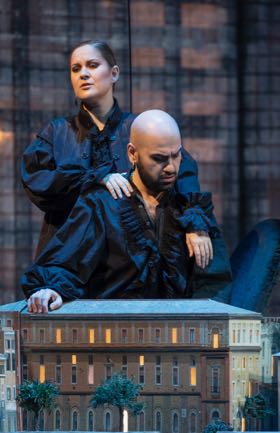
Mert Sùngù as Gennaro, Eléonore Pancrazi as Matteo Orsini
All photos copyright Patrice Nin, courtesy of the Opéra de Toulouse
This famed murderess worked her magic on Toulouse's Théâtre du Capitole stage, six dead including her beloved long lost son. It was Victor Hugo's carefully crafted 1833 thriller recrafted by Italian librettist Felice Romano for Donizetti's fragile Lucrezia Borgia.
With the tightness of a short story, Felice Romano reunites mother with son at a party in Venice only to have the mother inadvertently poison her son at a party in Ferrara when all she had wanted to do was poison his raucous friends. The plot is only slightly more complicated in that Lucrèce’s currently surviving husband Alphonse believes she is having an affair with her son, even though we know that possibly her son is having an affair with his best friend Maffeo Orsini.
It is a beautifully crafted opera, the story unfolding in highly structured musical numbers that encase the unstoppable series of obviously very tense situations. There are a lot of feelings to put on the table.
There is a delicate balance between ambience and emotion in bel canto, like there is a delicate balance between voice and pace — the emotions must flow but not rush nor may they falter. Italian conductor Giacomo Sagripanti created a plausible orchestral platform for bel canto, his more effective moments however were in his drives to the cadences that wrap up Donizetti’s emotive extensions. The maestro was obviously limited by the capabilities of his singers.
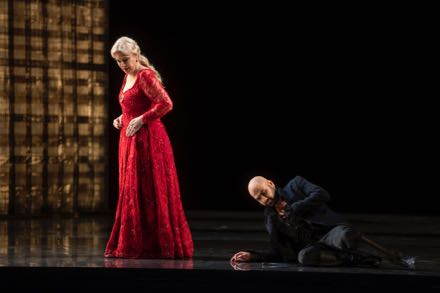
Annick Massis as Lucrezia Borgia, Mert Süngü as Gennaro
If Annick Massis, the sixty-one year old French bel canto diva, masterfully projected Lucrezia’s Borgia family pride and a towering pride of maternity, she could not effect a resolute tone of voice. Carefully placing her voice far back in her throat she avoided the wide, unfocused, indeed indeterminate tones that I heard in her 2015 Monaco Mathilde (Guillaume Tell). This new placement erased all authority of tone, her quite clean, careful coloratura had no sheen or pizazz, limiting its effect.
Turkish tenor Mert Süngü too physically created a convincing persona, that of a swashbuckling young warrior. Though a fine singer and a solid performer Mr. Süngü did not find the elegance of voice or line to establish the potentially sublime magic for the young warrior’s feelings for his mother and for his friend Matteo.
Frankfurt Opera bass Andreas Bauer Kanabas (the final Kanabas is his recently appended Bohemian maternal family name) took on the role of Alfonso d’Este. His dark hued voice serves him well for quite a variety of roles in Frankfurt and elsewhere, but his voice does not have the brightness that make raging bel canto lines fly off the page. French ingenue mezzo Eléonore Pancrazi brought little presence to the tenor’s best friend Matteo Orsini. This spirit of random casting extended to the myriad of smaller male roles required by this opera.
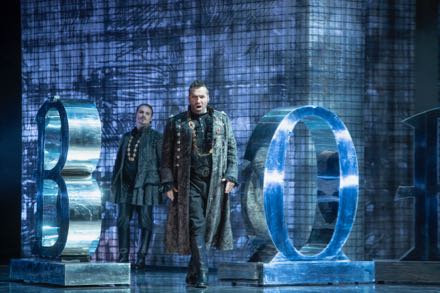
Andreas Bauer Kanabas as Alfonso d'Este, Thomas Bettinger as Rustighello (behind)
The 1917 production was from Valencia, Spain, by well-known (in California) Spanish director Emilio Sagi with his usual designers, Llorenç Corbella (sets) and Pepa Ojauguren (costumes). While Mr. Sagi moved his actors in easy accordance with the dramatic minimalism of Felice Romano’s libretto the physical production succumbed to an atmosphere of extravagant, abstract faux luxury. The result approached the questionable splendor of a sleek remake of a once grand, old hotel (ubiquitous metallic glints and lurid colors floating in chic blackness).
The legendary murderous excesses of Donizetti’s heroine Lucrezia Borgia universally seem to ignite hyper-active production imagination. Such response is at odds Felice Romano’s minimalism making Donizetti, finally, its the victim.
Cast and Production
Alfonso d’Este: Bauer Kanabas; Lucrezia Borgia: Annick Massis; Maffio Orsini: Eléonore Pancrazi; Gennaro: Mert Süngü; Liverotto: Galeano Salas; Vitellozzo: François Pardailhé; Gazella: Jérémie Brocard; Rustighello: Thomas Bettinger; Gubetta: Julien Veronèse; Ascanio: Rupert Grœssinger. Chorus and Orchestra of the Théâtre du Capitole. Conductor: Giacomo Sagripanti; Mise en scène: Emilio Sagi; Decors: Llorenç; Costumes: Pepa Ojanguren; Lights: Eduardo Bravo. Théâtre du Capitole, Toulouse, France, February 3, 2019.
De la Maison des Morts in Lyon
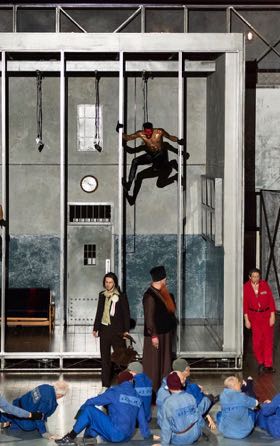
Karoly Szemeredy as the Orthodox Pope (later he is Shishkov),
Stefan Margita as Luka (far right in red)
All photos copyright Stolfeth, courtesy of the Opéra de Lyon
The obsessive Russian Dostoevsky’s novel cruelly objectified into music by Czech composer Leos Janacek brutalized into action by Polish director Krzysztof Warlikowski beatified by Argentine conductor Alejo Pérez.
These seven performances at the Opéra de Lyon wrap up the run of the Warlikowski production of From the House of the Dead that started last spring at London’s Covent Garden and continued in the fall at the Brussel’s Monnaie. Veteran bass Willard White has remained the prisoner Goriantchikov, Warlikowski’s protagonist for the full run as has Czech tenor Stefan Margita (San Francisco Opera’s Loge) as the prisoner Luka. Both artists are veterans of the 2007 Patrice Chéreau Aix Festival production also seen at the Metropolitan Opera in 2009.
Note that spellings of the Russian names have been Anglicized for this review.
It is ironic that black, “veteran” (the critical adjective for the past 20 years) bass White is both Chéreau and Warlikowski’s choice for the only prisoner to be freed from the horrors of modern penal servitude. For Chéreau it was a release from a physically detailed world of drudgery and degradation and suffering, for Warlikowski the prisoner’s release is a metaphorical death, the abandonment of a vibrant, intense, and principled world in which wounded human souls can truly soar. Warlikowski with conductor Pérez find, finally, the essence of Janacek’s most forgiving line “a divine spark (a soul) shines in every being” and it was an emotionally and intellectually thrilling, in fact mesmerizing conclusion to this evening of unrelenting brutality.
Warlikowski inaugurates his From the House of the Dead with a video of the late French philosopher Michel Foucault musing about justice and the police. He speaks over Janacek’s introductory music, the intense pace of concept and the inflection of the French is exponentially enlivened by Janacek’s already boiling motives. Janacek then drives a commanding musical climax to which the video expands the monumental gates of a soaring castle — and it is a prison!
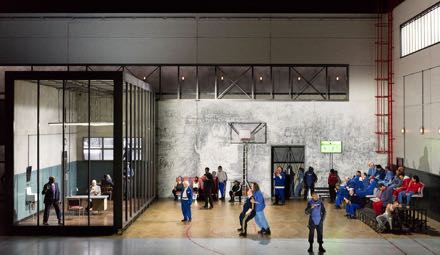
Willard White as Goryantchikov (far left), Nicky Spence as the Fat Prisonor
with Ladislav Elgr as Shuratov (center)
A basketball court is revealed, a black player (a “pro” equivalent) dribbles and shoots a basket, among the prisoners who enter are four break-dancing acrobats (of the various skin tones that populate Western prisons) who project an unbridled spirit of freedom in their movement and in their energy, a canny take on the wildness of the Janacek score. A fight breaks out, the basketball player is wounded. We understand that the basketball player is Dostoevsky’s taunted eagle as we know that an eagle is a visual epithet of freedom.
The player will remain in a wheelchair until the final moments of the opera when he stands, shoots the ball and misses, then he takes it to the rack. Blackout.
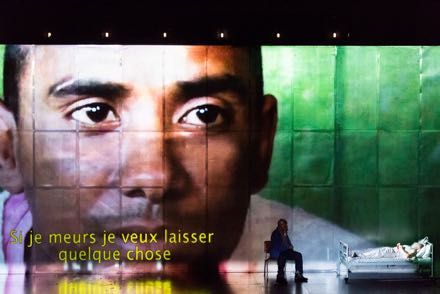
Unnamed South African gangster (video), Willard White as Goryantchikov,
Pascal Charbonneau as the wounded Alyeya
Warlikowski separates the acts of the opera with a video from American film director Teboho Edkins’ Gangster Backstage in which a black South African gangster (a real gangster) muses during the musical silences about death, knowing that he wishes a legacy and that legacy might be, he imagines, saving a small boy from danger. We know now why the prisoner Goriantchikov (Willard White) will teach the young prisoner Alyeya to read and write, his legacy and gift to the spirited, truly human world that he must leave. And why he is the opera’s protagonist though he has very little to say or sing.
Warlikowski’s frenetic intellectual and physical world is deeply embedded into the continuum of Janacek’s sonic world, a world in which stories are told — Luka who stabbed the abusive commander of his prison, Skuratov who shot the rich man his mistress married, Shapkin who robbed a rich man and was tortured, and finally Shishkov who murdered his wife because she dishonored him.
Finally, more than the merely recounted violence, Shishkov elevates Janacek’s narrative opera to action — Shishkov resolutely murders Luka who he has learned is the man who had falsely denounced his new wife as unchaste. Janacek’s continuum hammers Shishkov’s revenge and his remorse, and the bravado and regret of the other raconteurs. Shishkov’s action is finally release. Violence and brutality redeemed. And Janacek drives the pathos ever deeper in the Old Prisoner’s epithet of the dead Luka, “he too had a mother.”
That Warlikowski’s plays (Kedril and Don Juan and The Lovely Miller’s Wife) within Janacek’s play added gratuitous grotesquery and violence to his prison world can be attributed to blind, probably necessary adherence to the dictums of “regietheater.” Unfortunately these attributes also became boring, detracting from the honest, effective intellectualism of the Warlikowski concept.
Lyon’s Opéra Nouvel (named after it’s architect, Jean Nouvel) offers a very present, very bright acoustic. The Opéra de Lyon’s fine orchestra was well rehearsed and poised to deliver. Conductor Pérez, new to the production, was able to exploit (to the hilt) the quite detailed urgencies of the Janacek’s orchestral continuum, giving Warlikowski a musical force to well support the overwhelming physical and intellectual energy emanating from the stage.
From which there had been no escape. That final basket was deeply felt liberation.
Much of the sterling cast survives from the Covent Garden premiere, including the Luka of Stefan Margita and the Skuratov of Ladislav Elgr. Karoly Szemeredy was new to the production as a truly riveting Shishkov (he was Warlikowski’s Captain in last summer’s The Bassarids at Salzburg), as was the Shapkin of Dmitry Golovnin.
Cast and Production
Alexandre Petrovitch Goryantchikov: Sir Willard White; Alieïa: Pascal Charbonneau; Filka Morosov (Louka Kouzmitch): Stefan Margita; Le grand forçat (prisoner): Nicky Spence; Le petit forçat / Le forçat cuistot / Tchekounov: Ivan Ludlow; Le commandant: Alexander Vassiliev; Le vieux forçat: Graham Clark; Skouratov: Ladislav Elgr; Le Forçat ivre: Jeffrey Lloyd‑Roberts; Le forçat jouant: Don Juan et le Brahmane / Le forçat forgeron: Ales Jenis; Un jeune Forçat: Grégoire Mour; Une prostitiuée: Natascha Petrinsky; Kedril: John Graham-Hall; Chapkine: Dmitry Golovnin; Chichkov / Le pope: Karoly Szemeredy; Tcherevine / Une voix de la steppe: Alexander Gelah; Un garde: Brian Bruce; Un garde: Antoine Saint-Espès. Orchestre et Chœurs de l’Opéra de Lyon. Conductor: Alejo Pérez: Mise en scène: Krzysztof Warlikowski; Décors et costumes: Malgorzata Szczęśniak; Lumières: Felice Ross; Chorégraphie: Claude Bardouil; Vidéo: Denis Guéguin; Dramaturgie Christian Longchamp. Opéra Nouvel, Lyon, France, January 23, 2019.
Ricciardo e Zoraida at Rossini Festival, Pesaro

Juan Diego Flórez as Ricciardo, Sergey Romanovsky as Agorante
Photos by Studio Amati Bacciardi, courtesy of the Rossini Opera Festival, Pesaro
2018 may mark the 150th anniversary of Rossini’s death but of more interest is that it marks the 200th anniversary of the two operas he composed in 1818 — the one-act farce Adina, though not performed until 1826 in Lisbon (and rarely since) and the “dramma serio” Ricciardo e Zoraide, “a grotesque mixture of stupidities and improbabilities” according to a 1927 Rossini biographer.
A bit of a success in its time, Ricciardo e Zoraida soon disappeared to be resurrected only in 1990 by the Rossini Festival (that unquestioningly does all Rossini). Improbable as it may seem just now in Pesaro it attracted two major singers, Juan Diego Flórez as Ricciardo and South African soprano Pretty Yende as Zoraida, even though each has but one aria the entire evening.
The story is a generic, old style chivalric tale — exotic tyrant wishes to marry a damsel loved by a Christian knight, slightly complicated by a father who has his own ideas. Compared to the great Rossini tragedies of this same (Naples) period it is of slight dramaturgical interest, and therefore of lesser musical challenge for Rossini.
Its musical lines are however exquisitely Rossini, starting with the overture’s extended and quite lovely clarinet and horn solos followed by a brilliant flute display, brazenly interrupted from time to time by a raucous military band — a first use of stage musicians by Rossini, and quite startling indeed.
The African tyrant Agorante was sung by Russian bari-tenore Sergey Romanovsky whose darkly colored tenor voice soared with easy heft to the required high C’s, simultaneously sculpting elaborate coloratura in his lengthy aria. It was his one and only aria, an auspicious inauguration of this evening of spectacular vocal fireworks.

Front row Juan Diego Flórez, Sergey Romanovsky, Xabier Anduaga as Ernesto (a Christian ambassador).
Back row Sofia Mchedlishvili as Fatima (Zoraide's confidant), Martiniana Antonie as Elmira,
Victoria Yarovaya as Zomira (Agorante's wife); Pretty Yende (in gold gown)
If Pretty Yende seemed vocally tentative in her initial scenes — a duet with the tyrant’s current wife, Zomira, becoming a trio by adding the lovesick tyrant Agorante — it was perhaps because she was simply coping with a dramatically awkward situation (the other woman), exacerbated when Ricciardo unexpectedly showed up. She did hold her own in their extended duet.
But by the time la Yende, her stage father Ircano and Ricciardo got rescued from the tyrant’s clutches she was in magnificent voice and delivered her one aria with ultimate virtuoso aplomb. Though Rossini had embedded his usual soprano showpiece finale within the larger finale (in which the Christian forces overwhelmed those of Agorante and everyone forgave everyone), the glories of her shining high notes (well above the staff) lingered and the energy of her coloratura endured earning her an ovation at the curtain calls that well surpassed the ovation awarded to Juan Diego Flórez for his splendid Ricciardo.
Tenorissimo Flórez had great opportunity to show off his high C’s and his impeccable fioratura while imbuing his character with the welcomed notion that we didn’t have to take any of this too seriously, that after all this Rossini opera was meant to be about singing and that he can do, as everyone knows.
The production was staged by French director Marshall Pynkoski, a specialist in Baroque and proto-Romantic opera. Thus the staging was highly formalized in static stage pictures. Action when demanded was in the abstract choreography of five ballerinas and six male dancers — there were pompous entrances by the tyrant, preparations for beheadings, and a great battle among other, lesser activities. The extensive choreography was created by Jeanette Lajeunesse Zingg (Mr. Pynkoski’s wife).

An entrance of Agorante with ballet
Mr. Pynkoski did avail himself of the “close-up” technique so effectively used by director Pier Luigi Pizza in the Rossini Festival’s ad hoc 1200-seat theater inside Pesaro’s massive Adriatic Arena. Singers are brought outside the proscenium onto a catwalk fronting the orchestra pit, thus eliminating all scenic and musical context. The direct contact of these superb Rossini singers with the audience was an awesome experience.
Canadian set designer Gerard Gauci, a collaborator of Mr. Pynkoski at Versaille’s Opéra Atelier offered backdrops of painted canvas in monumental shapes and somber color. Appropriate period costumes were created by Michael Gianfrancesco, a Canadian colleague of Mr. Gauci. Neither sets nor costumes, nor Mr. Pynkoski’s staging for that matter, succeeded in finding the indulgent smile we might confer on such a precious literary relic.
Italian conductor Giacomo Sagripanti presided over the Orchestra Sinfonica Nazionale della RAI. The young maestro set the elegant musical level of the evening in the overture, finding its caressing lines, encouraging the excellent solo playing, stoically tolerating the noisy stage band, then providing Rossini’s richly colored foundation for some of Rossini’s loveliest vocal lines. The maestro’s tempi kept the easy energy needed to sustain ornamental singing and at the same time drive the opera’s substantial ensembles to maximum effect.
It is not hard to fathom why Giachino Rossini returned to the very simple one-act semi-serious farsa form of his youth after creating his four magnificent character comedies, as well as coping with libretti based on Shakespeare and Sir Walter Scott among other literary luminaries for his Neapolitan tragedies — he was paid to do it (but that’s another story)!
Cast and Production
Agorante: Sergey Romanovsky; Zoraide: Pretty Yende; Ricciardo: Juan Diego Flórez; Ircano Nicola Ulivieri; Zomira: Victoria Yarovaya; Ernesto: Xabier Anduaga; Fatima: Sofia Mchedlishvili; Elmira: Martiniana Antonie; Zamorre: Ruzil Gatin. Chorus of Teatro Ventidio Basso, Orchestra Sinfonica Nazionale della RAI. Conductor: Giacomo Sagripanti; Metteur en scène: Marshall Pynkoski; Coreografie: Jeannette Lajeunesse Zingg; Scene: Gerard Gauci; Costumi: Michael Gianfrancesco; Luci: Michelle Ramsay. Arena Adriatico, Pesaro, August 20, 2018.
Adina in Pesaro
Adina is the essentially the same story as Ricciardo e Zoraide. An older Persian caliph has taken a fancy to a beautiful prisoner of his seraglio and is about to marry her. Her former fiancé Selimo appears, whom she has believed to be dead after the shipwreck that separated them. The lovers hatch plans to escape with the help of Mustafa, the palace gardener. Ali, servant and confident of the caliph becomes aware or the plot. It fails. But as it turns out Adina is the long lost daughter of the caliph, thus Selimo need not be executed.
There are little complications to sing about. Selimo feels betrayed by Adina who is about to marry the caliph. Adina respects the caliph and is grateful to him for rescuing her. Adina believes Selimo to have been executed and is distraught.
Rossini actually recycled much of Adina’s music from his early operas and even borrowed musical material from other composers. Nonetheless Adina is still the musically mature Rossini, the vocal lines boast his ultimate sophistication. There is a splendid quartet near the end of great effect, plus a robust, exciting finale (with Adina’s splendid “Dove sono? Ancora respiro?”) composed especially for this operatic stepchild, the two pieces alone making the evening worthwhile.

Lisette Oropesa (center) with chorus of the Teatro della Fortuna M Agostini
Adina was sung by New Orleans born soprano Lisette Oropesa well known to L.A. and Met audiences as Lucia. An able Rossini singer as well, she did find the singerly excitement of her final aria. Her fiancé Selimo was ably sung by South African tenor Levy Sekgapane whose aria “Giusto ciel, che i dubbi miei tu conosci” is really a beautiful duet with English horn, attesting Rossini’s mature orchestral sophistication. The caliph was sung by Italian baritone Vito Priante, bringing the energy of his usual big-house Figaro to the caliph’s lone aria “D’intorno il Serraglio.” Completing the small farsa cast were character singers Matteo Macchioni as Ali who dutifully delivered his “aria di sorbetto” (a secondary singer’s small aria near the end of an opera) and Davide Giangregorio as Mustafa.
That the singers in this new production made little impression can be attributed to its metteur en scène, Rosetta Cucchi. Sig.a Cucchi is a pianist once associated with the Rossini Festival. Turned provincial opera house stage director she is now on the artistic staff of Ireland’s Wexford Festival. This Adina is a shared production with that festival.
Rather than allowing Rossini’s farsa process to work naturally, allowing its singers to expose Rossini’s prototype characters, this director imposed a blinding, supposedly comic environment (saturated pinks, blues and greens for the decor) that overwhelmed mere Rossini.
The stage was dominated by one huge scenic image — a three tiered wedding cake with the bride and groom statuette on the top (who were real people echoing the ins and outs of the farsa action).

Live groom and bride statuette
When the caliph wasn’t in a gold lame suit jacket for the wedding that never happened he was in a bubble bath singing his aria. Adina herself was accompanied by two mincing acolytes in short pink dresses. Selimo got off a bit easier appearing in a simple frocked shirt and gold vest as did his gardener sidekick who donned a straw hat adorned with foliage as well. The caliph’s henchmen threatened the lovers with colorful toy Uzis. There was not a turban or eunuch in sight.
A protege of Venezuela’s famed “Sistema” and now music director of Venice’s La Fenice, young (33 years old) conductor Diego Matheuz gave a fine account of this minor Rossini score, respecting the current performance practices that favor stylistically informed singers. The Orchestra Sinfonica G. Rossini, resident orchestra of Le Marche’s historic theaters (Pesaro, Fano, Jesi and Pergola) performed at its usual high level. The male chorus of the Teatro della Fortuna M Agostini in Fano (a small city 12 kilometres south of Pesaro) did its best to fulfill stage director Cucchi’s idea of what fun is not.
Cast and ProductionCalifo: Vito Priante; Adina: Lisette Oropesa; Selimo: Levy Sekgapane; Alì: Matteo Macchioni; Mustafà: Davide Giangregorio. Chorus of the Teatro Della Fortuna M. Agostini, Orchestra Sinfonica G. Rossini. Conductor: Diego Matheuz; Metteur 3n scène: Rosetta Cucchi; Scene: Tiziano Santi; Costumi: Claudia Pernigotti; Luci: Daniele Naldi. Teatro Rossini, Pesaro, August 18, 2018.
Il barbiere di Siviglia in Pesaro
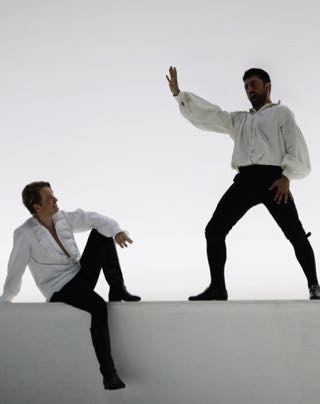
Maxim Mironov as Almaviva, Davide Luciano as Figaro
All photos by Studio Amati Bacciardi, courtesy of the Rossini Opera Festival, Pesaro
Oh no, not another Barber! Well, it is the 150th anniversary of the world’s greatest opera composer so what better way to commemorate the occasion than to program his most famous opera! And hope for the best.
And the best it was, though Canadian born Europe based conductor Yves Abel had some formidable competition for being the star of the show, namely 88 year old Pier Luigi Pizzi who staged it. In turn Signor Pizzi was upstaged by Italian baritone Davide Luciano, Seville’s factotum Figaro. But even he disappeared into the shadows when Russian tenor Maxim Mironov cut loose with his brilliant “Cessa di piu resistere,” that closes the show.
Never has the patter been more cuttingly precise at breakneck speed than when Italian bass baritone Pietro Spagnoli unleashed his “A un doctor della mia sorte” nor has the malicious pleasure of “La calunnia è un venticello” been more indulged than when intoned by Italian bass Michele Pertusi.
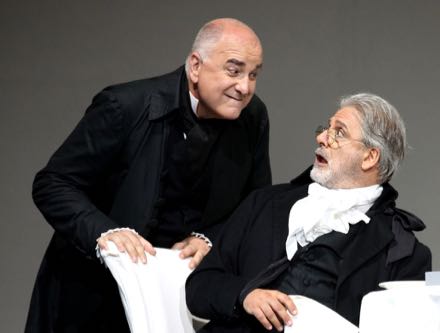
Michele Pertusi as Basilio, Pietro Spagnoli as Bartolo
That Rossini himself became the true star of the show can only be credited to stage director Pizzi who stripped the comedy of any specific scenic context using only a white box, anonymous white architecture, white furniture, a visual technique that thrust his actors and Rossini’s singers into high relief. The octogenarian stage director instilled an energy of personality into this production that effected the comic process — the triumph of youth over age — in monumental terms. It was the all too rare proof that Il barbiere is indeed one of the repertoire’s greatest masterpieces.
The overwhelming atmosphere of the production was that of youth, from Fiorello, sung by Venetian baritone William Corrò, to Almaviva and to Rosina, sung by splendid Japanese mezzo soprano Aya Wakizono, and finally, and even most of all to Figaro who stripped to his culottes, jumped into the fountain and then did a beefcake parade along the catwalk fronting the orchestra pit regaling us with his “Largo al factotum!”
None of this possible, of course, without conductor Abel who propelled Rossini’s numbers onto plateaux of lyricism that bordered on delirium. Of greater accomplishment was perhaps the pacing the maestro imposed on Rossini’s parade of blockbuster numbers, allowing us to savor each of them to the fullest but leaving us resource to sink ourselves into the opera’s two gigantic finales.
There was virtually no comic schtick (sight gags) in Pizzi’s production, the innate charm of each of its virtuoso singers needing no embellishment to create character. Except the music lesson scene which itself is nothing but schtick, and usually annoying. Director Pizzi solved this in simple strokes. There was no piano. Fiorello mimicked a cello for “L’inutil precauzione” conducted by Almaviva disguised as a dwarf. When it was Bartolo’s turn to show how to sing Sig. Spagnoli leapt into falsetto soprano!
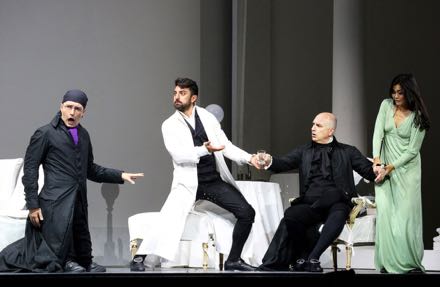
Almaviva disguised as dwarf music teacher [shoes on knees], Figaro, Basilio and Rosina
Note that before the performance I had spotted three little people among the spectators. Hopefully they enjoyed the comedy of such travesty (Almaviva had shoes on his knees) made transparent when Almaviva jumped to his feet from time to time when Bartolo wasn’t looking).
Not to forget that the storm was nothing more than the throes of fever that overtook Rosina when she thought Lindoro was betraying her, reinforcing stage director Pizzi’s firm commitment to comedy of character.
Esteemed Italian character mezzo soprano Elena Zilio sang Berta, sharing the tasks of Ambrogio, charmingly and broadly played by actor Armando de Ceccon, with little more to do that just be there to answer the door and bring in the laundry. Sig.ra Zilio’s “aria di sorbetto” “il vechhiotto cerca moglie” was met with huge applause. Note that in Rossini times sorbet was hawked near the end of a performance where such secondary arias were placed.
Sig. Pizzi directed, designed both sets and costumes, and designed the lighting with his associate Massimo Gasparon. The elegance of the costume design — abstracted formal wear in black and white, with Rosina in various solid colors — well served the elegance of the singing.
In his formative years Pier Luigi Pizzi worked as a designer with Giorgio Strehler and Luca Ronconi, incorporating much of mid-twentieth century Italian avant garde into his theatrical vocabulary. He made his Pesaro Rossini Opera Festival debut in 1982 with Tancredi. During the 1980’s as well he both designed and directed productions at San Francisco Opera, notably Simon Boccanegra, Semiramide and Orlando Furioso (though these credits are not included on Wikipedia). His productions have appeared in all of the world’s major theaters.
The male chorus of the Teatro Ventidio Basso (an historic opera house in Ascoli Piceno, a town halfway between Pesaro and Rome) was the raucous police force. The Orchestra Sinfonica Nazionale Della RAI (Italian Radio/Television) were the polished collaborators of maestro Abel.
Cast and Production
Il Conte d’Almaviva: Marim Mironov; Bartolo: Pietro Spagnoli; Rosina: Aya Wakizono; Figaro: David Luciano; Basilio: Michele Pertusi; Berta: Elena Zilio; Fiorello/Ufficiale: William Corrò. Chorus of the Teatro Ventidio Basso, Orchestra Sinfonica Nazionale della RAI. Conductor: Yves Abel; Regia, Scene e Costumi: Pier Luigi Pizzi; Regista collaboratore e Luci: Massimo Gasparon. Arena Adriatica, Pesaro, August 19, 2018.
The Bassarids in Salzburg

Tanya Ariane Baumgartner as Agave, the king of Thebes mother
holding high his severed head
All photos copyright Ruth Walz, courtesy of the Salzburg Festival
Hans Werner Henze’s fifth opera, The Bassarids (those who wear fox skins) had its world premiere at Salzburg’s Grosses Festspielhaus in 1966. Now, 52 years later Henze’s massive “opera seria” returns, but to the Felsenreitschule —the old riding school made into a theater that hosts the Salzburg Festival’s difficult operas, the Grosses Festspielhaus now dedicated to the grand repertoire.
And difficult Henze’s opera is. There is an heroic orchestra — batteries of brass, batteries of percussion, harps, pianos, guitars, it is after all the destruction of the founding family of one of ancient Greece’s greatest cities in the retelling of the last play of one of Greece’s greatest tragedians, Euripides! Not to mention two tone rows (yes, Henze was a serial composer) that configure the stark world of Pentheus, king of Thebes and the colorful world of Dionysus his challenger.
Euripides’ Bacchae was recast as an opera libretto for Henze by W.H. Auden and Chester Kallman, who provided the libretto for The Rake’s Progress and texts for Benjamin Britten. Thus here as well are the expected discussions, rather fixations on repressed sexual realities.

King Pentheus dressed as a woman, Dionysus plus a bacchanalia spirit (mute role)
Essentially Semele, great grand daughter of Cadmus, founding king of Thebes, was murdered while giving birth to a son who may be the son of Zeus, and therefore a god, or maybe not. Cadmus abdicated naming Semele’s sister Agave’s son Pentheus as the new king. Pentheus has complicated feelings about his mother who is pretty complicated herself. A challenger appears who may be the god Dionysus. Everyone joins his cult. Pentheus disguises himself as a woman to learn about the cult. He is discovered by a band of women led by his mother who tear him to pieces believing that he is a lion. Dionysus removes his mother Semele from her earthly tomb and takes her to Olympus to join him as a god.
With all this on his mind Henze needed far more than his two tone rows, thus he mined musical and operatic traditions to embellish and enrich his musical manifestation of the Auden/Kallman take on the Euripides’ Bacchae. Vocal lines are comprehensible, and there actually is a sort of bel canto. There are occasional, quite beautiful arias within the opera’s symphonic structure. Bach’s St Matthew’s Passion is oft quoted, Mahler like textures and harmonies are discernible, and by musical miracle we even arrive at a momentary, truly magnificent 6/4 chord (second inversion of a triad) during Semele’s assumption!
It is magnificent, complex, highly expressive music that painstakingly delves into the psychological depths of insecure men and women, of obsession, and into the psychologies of mass social phenomena and the resulting human debasement.
But the final scene of the opera is in fact wonderfully liberating, indeed moving as Dionysus leaves Thebes and abandons the cult he has founded. He commands Persephone to open the gates of hell and release his mother that she may triumphantly unite with him upon Olympus.
Mounting Henze’s setting of the Auden/Kallman’s neurotic tale of infanticide in the massive stone world of the old riding school was a wondrous gift to famed Polish stage director Krzysztof Warlikowski. He simply spread it all out across the expanse of the riding school paddock, The a vista crypt and shrine of Semele on the far left, the private bedroom (his neurotic inner life) of King Pentheus on the far right and in between three palace rooms where the founding dynasty of Thebes was destroyed. The massive upper reaches of the riding school galleries became a metaphorical mount Cithaeron.
Henze’s choruses were crucial players in the drama, not spectators, though the chorus did begin the evening as spectators filing into the first two rows of the auditorium as the citizens of Thebes praising their new king. They quickly left and little by little they joined the Dionysian cult as did Thebes founder Cadmus, deftly enacted by venerable bass Willard White who was in good voice.
The palace prophet Tiresias — blind of course — was played by Austrian tenor Nikolai Schukoff who cross-dressed as the fey Calliope of the Intermezzo. Cadmus’ granddaughter Agave was convincingly, even heroically portrayed by Frankfurt Opera’s dramatic mezzo soprano Tanya Ariane Baumgartner. Her weaker sister Autonoe was sung by Berlin’s Komischen Oper’s Vera-Lotte Böcker.

Agave as Venus in Intermezzo, with Adonis, Persephone and Calliope
A more complicated if less defined character was Pentheus’ Captain (of the royal guard) sung by Hungarian bass-baritone Károly Szemerédy who doubled as the Adonis in the Intermezzo in which Dionysus’ magic mirror shows to Pentheus the unbridled sexuality of his mother — a cunningly staged scene by Warlikowski that video-mirrored the Intermezzo in black and white from its enactment far stage left onto a wall far stage right.
Pentheus’ wet nurse Beroe, sung by Dutch mezzo Anna Maria Dur, was another complex character. Hera, Zeus’ wife impersonates Beroe so that she could intimidate Semele into demanding to see her lover (Zeus) thus destroying herself. Yet Beroe expresses blind, uncomplicated maternal love for Pentheus earning our sympathy.
Canadian Opera’s baritone Russell Braun brought unbridled commitment to his portrayal of the weak, sexually repressed King Pentheus, moving from impotent authority to loss of identity, from fulfillment as a woman to honesty as a lost man. Sri Lankan-American tenor Sean Panikkar brought full spectrum to Dionysus, from cunning manipulator to the loving son of the mother he never knew.
Henze’s score is fiendishly difficult, for its singers and for its orchestra. Conductor Kent Nagano marshalled the always impressive forces of the Vienna Philharmonic into a convincing performance, simultaneously chorus master Huw Rhys James conducted (from the pit) the 100 or so voices of the concert choir of the Vienna State Opera in its huge chorus role.
Additional production information
Sets: Christian Schmidt; Costumes: Reinhard von der Thannen; Lights: Stefan Billiger
Grosses Festspielhaus, Salzburg, August 13, 2018.
Pique Dame in Salzburg

Hanna Schwarz as Pique Dame, Brandon Jovanovich as Herman
All photos copyright Ruth Walz, courtesy of the Salzburg Festival
It was emeritus night at the Salzburg Festival with 75 year old maestro Mariss Jansons conducting 77 year old stage director Hans Neuenfels production about Pushkin’s 87 year old countess known as the Pique Dame.
There were ghosts present — Jansons’ teacher Herbert von Karajan who influenced the design of the Grosses Festspielhaus to favor the Vienna Philharmonic, and Neuenfel’s artistic ancestors — Salzburg Festival founder Max Reinhardt and the surrealist poet/sculptor, Max Ernst — who formed Mr. Neuenfels to be an enfant terrible of a more recent German opera world.
No longer of an age to be thought of as enfant terrible Neuenfels nevertheless is true to form. He did create a truly surreal Pique Dame, its action frozen into multiple tableaux, tableaux that oozed the luxe of Czarist Russia, the austerity of death, the naïveté of love, the joy of sunlight, the frustration of waiting, the anxiety of searching, and so on.
Fixating on the specific mood and atmosphere of each number of Pique Dame (it is very much an old style numbers opera) the heavy pathos of Tchaikovsky’s tormented, obsessed lovers is overlooked, pushed aside to paint the moments of the story. We were no longer able to connect a flow of feeling, thus we were left with no sympathy for Hermann or for Liza. We did have a huge sense of their world.

Brandon Jovanovich as Hermann, Eugenia Muraveva as Liza
These atmospheres were gloriously, indeed sumptuously created in Von Karajan’s very present orchestra pit, conductor Jansons urging every possible color from the Vienna Philharmonic, its solo players and its sections creating their unique Vienna tonal world. It was this orchestra beyond compare that riveted us for the multitude of scenes that exposed the soul of the tormented composer Tchaikovsky far more than it involved us in Pushkin’s tale.
Conductor Jansons considers this opera one of the ten finest in the repertory. Though most of us would not agree we surely must appreciate his respect for the piece and for this surely once-in-a-lifetime reading.
The stage setting and costumes were huge in keeping with this orchestral magnitude. Huge gray tufted walls were set upon a black floor laden with conveyor belts used to move fixed battalions of choristers on and off the stage and to allow Hermann to remain stationary while walking, as examples. A proscenium was built into the back wall through which smaller stages were thrust forward for the pastoral performance and as a hospital room the death of the countess. As well the gray surround walls served as a screen for huge projections of storms, city streets and, of course the triumphant face of the pique dame as the production’s final image.
Each chorus number, and there are many, was specifically costumed. There were possibly one hundred choristers, dressed first as fantastically breasted Mother Gooses, keepers of the possibly 50 children chorus who arrived in cages. The choristers became bathers, then donned rain gear when the weather changed, wore party dress for the engagement scene, skeleton costumes, elaborately bustled black dresses, and the men in tuxedos for the final card game.
It was extravagant, overpowering, expensive costuming.
If the elaborate costuming of the choruses illustrated the various exotic tableaux, the principles remained rather plainly and simply dressed in their anguish. Lisa was in simple, contemporary black and white attire, the Pique Dame wore a bizarre short-shirted, pink and green concoction, clothing she shed as she slowly died.
Hermann, the obsessed gambler, masterfully enacted by American tenor Brandon Jovanovich, was from beginning to end a toy soldier in an unbuttoned red uniform. Beautifully sung through the tortured twistings of his obsessive love of Liza and his obsessive quest of the Pique Dame’s three cards (not to discount the oblique, obsessive goals of the production) he was indeed an operatic soldier of impressive magnitude.

The death of Hermann, plus all named male characters
Mr. Jovanovich’s heated performance was in contrast to the distant involvement of Russian soprano Eugenia Muraveva as Liza. Mlle. Muraveva is an excellent singer of elegant presence and great reserve. Both Tchaikovsky’s Liza, and last summer’s Lady Macbeth of Mtsensk (that befell her when Nina Stemme fell ill) are well beyond her histrionic range.
The Countess aka Pique Dame was portrayed by 75 year-old, once mezzo Hanna Schwarz who brought little old lady confusion to this role usually taken by old divas of important presence. Mme. Schwartz delivered her death aria in a thin, dying voice, pathetic rather than moving, a performance well in keeping with the emotional void generated by the Neuenfels production.
The more direct and satisfying performances came from Russian male voiced imports — baritone Igor Golovatenko as Liza’s intended Prince Yeletsky, baritone Vladislav Sulimsky as Count Tomsky, bass Stanislavsky Trofimov as Surin, tenor Pavel Petrov as Chaplitsky, bass Gleb Peryazev as Narumov, and tenor Alexander Kravets as Chekalinski.
Equally impressive were the Russian female voices that completed the cast, Oksana Volkova as Polina, Margarita Nekrasova as the governess, Vasilisa Berzhanskaya as Mascha, and Yulia Suleimanova as Prilepa.
Production information
Sets: Christian Schmidt; Costumes: Reinhard von der Thannen; Lights: Stefan Billiger
Grosses Festspielhaus, Salzburg, August 13, 2018.
Salome in Salzburg

Asmik Grigorian as Salome
Photo copyright Ruth Walz, courtesy of the Salzburg Festival
A Romeo Castellucci production is always news, it is even bigger news just now in Salzburg where Lithuanian soprano Asmik Grigorian has made her debut as the fifteen year-old Salome.
Castellucci creates theater as Richard Strauss creates music. It is a language all its own, though sometimes of concrete reference it is usually an abstract flow of stimuli that create their own reality.
Here Castellucci has made a Salzburg Salome. Starting with the Latin "te saxo loquuator" (what the stones may say to you), a phrase found only in Salzburg where it is inscribed above the entry of the 18th century tunnel connecting old Salzburg with a later Salzburg built beyond its famous mountain.
Castellucci inscribes the phrase on a cloth that covers the massive galleries cut into the cliff behind the old riding school theater where he holds us in silence, save a cricket sounding. Finally the cloth parts to reveal that the galleries have been filled in with stone creating a gigantic cavern. Specific images appear, Salome in a white dress stained by menstrual blood standing on the huge mirrored floor, a displaced disk revealing a black hole.

The dance
Only when we have fully entered into Castellucci’s theater does the Strauss music begin. The players of the Vienna Philharmonic and maestro Franz Welzer-Möst become very present in the Castellucci's theater world — they themselves in fact become the dance that dooms the 15 year-old princess — Salome herself folded, immobile on a pedestal during the dance, a huge square cut stone slowly descending to crush her under its massive weight (sublime choreography by Castellucci collaborator Cindy Van Acker).
Castellucci’s implacable stone world reflects everything except the black voids he creates for the prophet’s aura and for Herod’s doom. There is no color save the occasional lightening flashes of brilliant red or blue and the painted red faces of Herodes, Narraboth, and the black-hatted Jews and the Nazarenes, and the huge gold, rolling wine chalice that links the brass horns of the pit to the stage.
A live black stallion dances a vista in Jochanaan’s cistern to Salome’s orchestrally created sexual fantasy. It is the stallion’s severed head that is then presented to Salome. In the final moments of the opera Salome herself descends into a pit — the final image of Castellucci’s theater is Salome’s head, a deathly silver light illuminating her face.
Like all productions in the Felsenreitschule (the name of the old riding school theater) Castellucci’s Salome is site specific. Thus I have spoiled nothing for you by revealing a few of its more striking images — the production is and will always be unique to these stones of Salzburg and its festival and for all that this may mean.
The sine non qua of the Castellucci production is its protagonist, Lithuanian soprano Asmik Grigorian. Diminutive, lithe, of fresh and beautiful voice to her death and dramatically expansive in her movements this extraordinary artist was as real and vivid a presence in Strauss’ account of an adolescent awakening as was the black stallion that was Jochanaan.

John Daszak as Herod
The prurient world surrounding Salome’s innocence erupted into a frenzy of battling images, during which the salient image was the cleansing of Jochanaan’s blackened body. Conductor Welzer-Möst’s orchestra created a frantic orgy of argument clearly visible in the a vista pit. The physical presence of the Vienna Philharmonic within the confines of the Castellucci theater world engendered a toxicity of enormous and hugely indulgent proportion.
English tenor John Daszak was the stark Herodes, his tormented spirit dominating every moment of Castellucci’s theater. Hungarian bass-baritone Gábor Bretz menacingly rang out his prophecies and admonitions shrouded in blackness. The pleas and imprecations of Italian mezzo soprano Anna Maria Chiuri’s Herodias were largely overlooked in the fracas of Castellucci’s powerfully masculine world, Salome its innocent victim.
Cast and production
Herod: John Daszak: Herodias: Anna Maria Chiuri; Salome: Asmik Grigorian; Jochanaan: Gábor Bretz; Narraboth: Julian Prégardien; Herodias' page: Avery Amereau; Jews/Nazarines/Soldiers: Matthäus Schmidlechner, Mathias Frey, Patrick Vogel, Jörg Schneider, David Steffens, Tilmann Rönnebeck, Paweł Trojak, Neven Crnić, Henning von Schulman, Dashon Burton. The Vienna Philharmonic. Conductor: Franz Welser-Möst; Production (stage direction, sets, costumes and lighting): Romeo Castellucci.
Die Meistersinger at Bayreuth
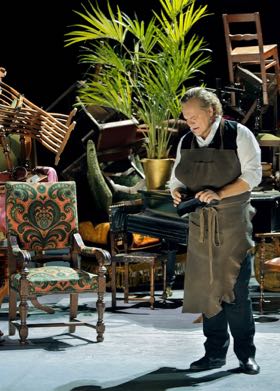
Michael Volle as Hans Sachs
All photos copyright Bayreuther Festspiele / Enrico Nawrath
Famously, controversy is the stuff of Bayreuth, be it artistic, philosophic or political. As well occasionally a Bayreuth production can simply be illuminating, as is the Barrie Kosky production of Wagner’s only comedy, Die Meistersinger.
Though Wagner’s comedy is only comedy in so much as it is the triumph of youth over age unless maybe you find the caricature of the Nürnburg town clerk Beckmesser to be amusing, or maybe you find it a bit amusing that a pretty young German girl is courted by three men, a young man and and old one and a Jew. Fortunately, like all comedy, the situation gets properly resolved — in Bayreuth youth is poised to renew an already perfect world.
Director Barrie Kosky does however take the comedy idea very seriously and creates Meistersinger’s entire first act as schtick. It takes place in Wagner’s Bayreuth home, confusing Wagner with Hans Sachs, Cosima Wagner with Eva, Franz Liszt (Cosima’s father) with Eva’s father Pogner. Wagner and Liszt play a mock piano duet, and later nine medievally dressed men climb out of the piano (how many clowns fit into a VW?). And these gimmicks are just for starters in this deft transposition of St. Catherine’s church into Wagner’s salon.
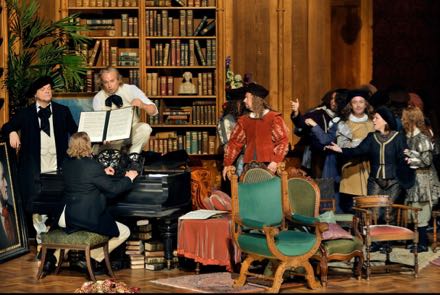
Michael Volle as Wagner, Günther Groissböck as Liszt,
Klaus Florian Voght as Walter with the mastersingers
At the act’s conclusion the Wagner residence dissolves into the apparition of a large, secular, quite empty room (hall), the signal that the fun is over. Thus we have our first suspicion that not only will the first act Wagners-at-home-sitcom become a play superimposed upon a play, but that there will be and even bigger, totally public drama. From hints in the sitcom (Cosima’s Jewish lover, conductor Hermann Levi AKA Beckmesser is humiliated) of course we know what the drama is about.
The Barrie Kosky second act is anti-comedic in that we have no context in which to place the complex Wagner/Hans Sachs story. The Wagner household furniture is piled up on a dark stage and we see little else. The Nürnberg intrigues begin, and things get messed up to the degree that there is a storm (as in Rossini’s Barber) though it is not a bit comedic (funnily enough a clock does run backward). Wagner’s storm is completely musical, an outburst of 56 independent voices! Director Kosky renders the midsummer night riot as a pogram, and indeed for Wagner this ethnic hysteria is not a farfetched musical scenario.
The third act is back to schtick. Director Kosky brings the private and public situations to trial, and we do have a quite specific and certainly witty comedic context — sessions of the Nurnberg Trials. There are personal testimonies that resolve into the Rossini moment when absolutely everything stops, the startled principals are absolutely stunned — thus the glorious private celebration that is Wagner’s sublime quintet.
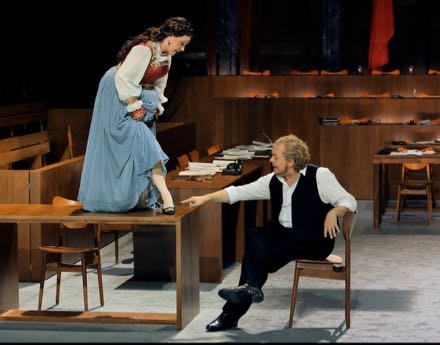
Emily Magee as Eva, Michael Volle as Hans Sachs
And then there are public testimonies that are distantly reminiscent of the music lesson in Rossini’s Barber. Beckmesser is ruthlessly ridiculed.
Finally it becomes the public resolution that we have been waiting for, everything becomes what it must be. And that is a celebration of a music that will endure within director Barrie Kosky’s world, and in our world, no matter what its content may be. A full symphony orchestra magically slips onto the stage. It is Nurnberg’s beloved Hans Sachs or more precisely it is Wagner himself who conducts the opera’s monumental farewell, its magnificent hymn to German art.
Keep in mind that the on-stage symphony orchestra is in addition to the ninety or so players in the Festspielhaus’ invisible pit — an additional reminder that German art as practiced in Bayreuth is indeed magnificent.
For all its comic magnificence this Bayreuth Die Meistersinger was a subdued affair. Conductor Philippe Jordan’s persuasive orchestral well upheld the glories of the Festspielhaus’ famed acoustic but his reading of the mighty score did not command attention. The great moments were musically flaccid (for example the Act II riot, and in fact the Quintet), possibly rendered such by Mr. Kosky’s shocking staging that often dramatically overpowered or sometimes simply flattened these moments. The musical effect was further dampened by the miscast Eva (British soprano Emily Magee) who brought no vocal or dramatic focus to her pivotal scenes within the larger Kosky dramas (and possibly as well by the controversially light voiced Walter).
With this one Anglo-Saxon exception the balance of the cast was German or Austrian and deeply satisfying. The Hans Sachs of Michael Volle is well known, and shown to perfection in this complicated production, as did the Beckmesser of Johannes Martin Kränzle (who took the second to last bow!). Tenor Klaus Florian Voght is an exceptionally light lyric dramatic tenor (jugendlicher heldontenor), an ethereally voiced singer who is evidently appreciated on some Wagnerian stages as Mr. Voght is legacy casting from the 2017 Bayreuth Meistersinger). His thin, boyish, pure-toned voice did not create a convincing vocal Stolzing presence, though he well upheld Mr. Kosky’s character needs. Günther Groissböck well fulfilled his role as Cosima’s bewigged father Lizst and was exceptionally sympathetic as Eva’s father. Tenor Daniel Behle held powerful sway as Sach’s apprentice David, as did Wiebke Lehmkuhl as Eva’s maid Magdalene, both artists assuming more musical presence in Wagner’s thick score than the Eva or Walter.
For the record, the trepidations one may harbor about the storied lack of comfort of the Bayreuth Festspielhaus may be put to rest. The benches are padded, there are backs and you are not crowded. Normally the thrill of simply being in this august temple of Teutonic art will overcome all climatic discomfort (it can be warm). The one-hour intermissions are appreciated because normally after a Bayreuth act you have a lot to chew on before taking on more. Refreshment is, contextually, reasonably priced.
Additional production information:
Chorus and Orchestra of the Bayreuth Festival. Sets: Rebecca Ringst; Costumes: Klaus Bruns; Lighting: Franck Evin; Dramaturgy: Ulrich Lenz. Festspielhaus, Bayreuther Festspiele, Bayreuth, August 12, 2018.<
Lohengrin at Bayreuth
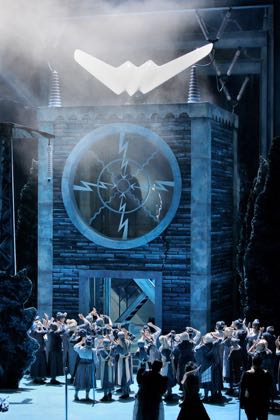
Lohengrin's swan
All photos copyright Bayreuther Festspiele / Enrico Nawrath
Three electrifying moments and the world is forever changed.
Elsa is to be burned at the stake for murdering her brother, the fire is lighted. A cataclysmic electrical display travels across live points on monumental insulators and conducts itself through the town clock upon which a white space ship in the vague shape of a giant moth alights (other times a swan). Elsa’s savior appears in street clothes wearing insulated gloves.
Matched by an orchestral display of appropriate proportion.
He sings but he is not tenor Roberto Alagna who would have brought his unique colors and attitudes to Lohengrin had he not cancelled three days before rehearsals were to begin. There were moments throughout evening when I could hear his voice and sense his persona, matched in so many ways to the lyricism, vulnerability and delicacy of mezzo Waltraud Meier, Wagner’s Ortrud in this production.
Polish tenor Piotr Beczala stepped in to sing his first Lohengrin. His was a spell binding portrayal, heroic in its youthful strength, of unflagging voice in its careful shaping of the subtleties of text, and profoundly moving as the tragic, failed savior of the duchy of Bramant.
In this production created by German visual artists (painters) Neo Rauch and Rosa Loy, and American stage director Yuval Sharon one is not sure how the concept evolved — to wit moths (like people) are attracted to light (enlightenment) and executed (confused) by touching its energy. As unlikely a metaphor as it was, finally, it was a powerful metaphor that took us to Wagner’s philosophical plain and kept us there, director Sharon staging the action in stultifying ceremonial symmetry to achieve solid inviolable confirmation.
The phenomenal energy introduced by Lohengrin burst the bindings holding Elsa to the stake, and this was the same energy that was to have bound her forever to Lohengrin, pulses of electricity rushing along cables into the marriage chamber as he bound her with electrical cord to a giant illuminated insulator.
But Ortrud had come to Elsa in a truly magical garden (mysterious foliage moving every which way) to warn her of the dangers and the insult of accepting what she must not know. Conductor Christian Thielemann convincingly led the two women to an understanding that overcame the mandate imposed on Elsa of blind acceptance of the imposed order. The radical strength imparted by Ortrud overcame Elsa’s blind ties to Lohengrin, and she was heroically able to burst the binding of matrimony in a truly magisterial musical climax.
And in the last scene Ortrud, bound to the stake to die for her participation in Telramund’s pagan, dark world, heroically burst her bindings as well. Stage director Sharon’s world is blatantly politically correct, and always a few clever and significant steps beyond Wagner’s Romantic philosophy. Mr. Sharon simply changed Richard Wagner’s ending — Elsa does not fall dead.
In a final sacrificial act Lohengrin attaches a backpack of pure light to Elsa who, with Ortrud goes forth to found, presumably, a new, enlightened world, leaving behind, presumably, the combative, male centricity of the old order. Wagner’s dream of theater as a religious rite was fully achieved and the audience went wild with its new liberation, with its rebirth into a new, maybe better world — though a world unfortunately left undefined, and certainly unquestioned.
Note that Cosima Wagner (Richard's widow) famously went forth to preserve Wagner’s nationalistic ideals, making Bayreuth a foundation of Nazism. Note that Katerina Wagner today preserves the Wagner legacy and Bayreuth canon, and she preserves its firm national identity (no English to help a significant if small percentage of foreigners). Though Mme. Wagner has embraced electrical rather than gas lighting, and installed the latest stage machinery she has not added supertitles, thus betraying her great grandfather’s greatest theatrical ambition — an immediacy of comprehension.
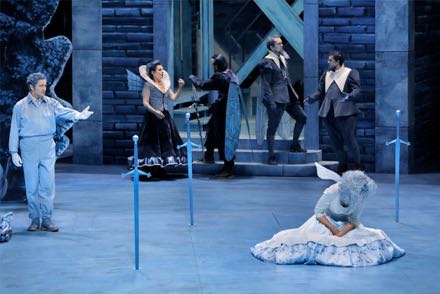
Lohengrin, Ortrud, Telramund, King Heinrich, a herald, Elsa
Painters Rauch and Loy’s world is brilliantly old fashioned in feel, painted drops the primary background. Sophistication abounded in the use of scrims, shadowy moving pieces and color. Architectural pieces and costumes superimposed the Medieval upon the Romantic, layered the industrial and modern, and confused the real with the fantastic, to wit pale, moth colored Elsa (well, until she was electric orange), not to overlook the moth wings, subtly worn by all the principles as if natural attire.
All the magic of Bayreuth’s Festspielhaus was in place — the hidden orchestra of absolute musical authority, the present acoustic that permits casting of artists of intimate intensity like 62 year-old Waltraud Meier as Ortrud whose voice very rarely betrayed its age and always found the full depth of character. The persuasive soprano of Anja Harteros kept Elsa as the focal point of this production, clearly sailing over the ensembles, never losing its inherent sweetness. Polish Tomas’s Konieczny had little to do other than be a force of darkness, Georg Zeppenfeld as King Heinrich was the benign moderator.
Conductor Christian Thielemann miraculously accomplished the required musical persuasion.
Gianni Schicchi in Arezzo (by Oberlin in Italy)
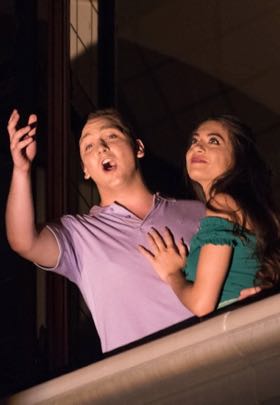
Giuliana Bossa as Lauretta, Ethan Burck as Rinuccio
It’s an all too rare pleasure to see Puccini’s only comedy as a stand alone opera. And more so when it is a careful production that uncovers the all too often overlooked musical and dramatic subtleties that abound in Puccini’s last opera.
Gianni Schicchi (1918), like Verdi’s Falstaff (1893), masterfully parses its dirty trick comedy among many players and many musical forms, though Puccini’s world is much evolved from that of Verdi, to include minstrel, jazz, Orientalism, musical alliteration, dissonance, spoken word, even a couple of old fashioned arias. Conductor Kevin Class did not miss a beat, making the most of every last bit of this stylistic richness, providing ample fodder for stage director Isabel Milenski’s [this critic’s daughter] canny take on Puccini’s comedy.
Even though Puccini’s hero — lifted from Dante’s Inferno — predates Verdi’s Shakespearean Falstaff by a few hundred years Schicchi’s wily, positive intelligence resonates in a modern, exploding world in ways Falstaffian self-indulgence simply cannot. Director Milenski’s Schicchi was 19 year-old [!] tenor Michael Butler who enthralled the audience with non-stop wit every bit as much as he enraged dead Buoso Donati’s relatives with his deceit.
Young Butler had lots competition in the charm department as this Gianni Schicchi was the first of three operas (with La Rondine in the Petrarca Opera House and Ariodante on the steps of the Church of the Assumption) presented gratis to to an enthusiastic public by Oberlin Conservatory’s summer program in Arezzo, Italy. The singers were essentially American undergraduates very much in the process of discovering their voices, finding their stage personae and, coincidently, learning Italian!
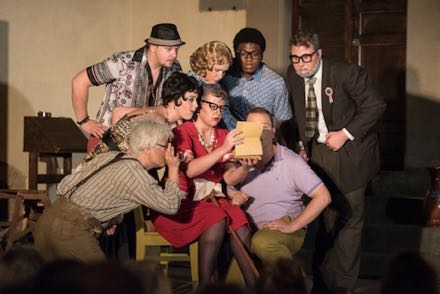
Zita reading Buoso's will to his relatives
To a man these were charming, talented young artists, vocally and dramatically coached in their roles by operatic professionals and meticulously rehearsed in Gianni Schicchi’s formidable ensembles, preparations that made this Gianni Schicchi into opera theater of solid effect.
Lyrically Gianni Schicchi belongs to the young lovers, Rinuccio and Lauretta, who were far closer to Puccini’s prescribed 21 and 18 year-olds than the usual big house lovers. It was a huge pleasure to watch Ethan Burck and Giuliana Bossa as they negotiated Puccini’s lovely lines with concentrated vocal thinking, finding themselves at last in a high window overlooking the courtyard of the Palazzo dei Priori (where we were seated) singing their contentment.
Scenic design credit goes mostly to the long ago architect of this 14th century palazzo who provided a big entry door through which the dying Buoso (prop master Luke D’Alessandro was himself this prop!) emerged onto the door’s porch (now a stage), led by Rinuccio to the bed where he expired to be stuffed (except for an arm) later into the armoire on another wall. Long ago someone had planted a tree to shade the porch into which old (well, maybe 20), furious Aunt Zita climbed, a perch from which she hurled dead Buoso’s pill bottles at Schicchi, and behind which pregnant Nella had a bit of morning sickness.
You get the idea — all of Buoso’s relatives were characters who did their natural thing without forcing comedy. And particularly Schicchi who tore up the stage in his “Si corre dal notaio,” playing to the hilt the smarts of a maximally personable auto mechanic like a hard sell vaudeville artist — Aunt Zita threw her cane at him which he then used to execute Puccini’s strutting and twirling.
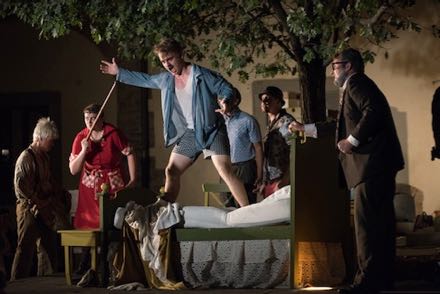
Betto, Zita, Schicchi, Rinuccio, Gherardo, Simone
Not to mention Betto enacted by Korean American Simon Nam who shuffled and shook a spoon to Puccini’s pentatonic Butterfly quotations, and Zita, Nella and La Ciesca who did their best, with Puccini’s help (“Spogliati, bambolino”), to seduce Schicchi, casting suspicion on who might be the actual father of Nella’s expected child.
Conductor Class kept his tempi deliberate, and director Milenski effected highly theatrical stage pictures that camouflaged strategic sight-lines to the conductor, thus the well-known treacheries of the three formidable ensembles were painstakingly overcome — a feat that provided enormous satisfaction not to say relief to all involved — singers and spectators!
Finally Schicchi gave the spoken encomio (what better use for Buoso’s money than to seed the lives of the triumphant young lovers) in perfect Italian, an additional reward to us all thanks to the splendid efforts of Oberlin in Italy.
Cast and production
Gianni Schicchi: Michael Butler; Rinuccio: Ethan Burck; Lauretta: Giuliana Bossa; Zita: Helena Crothers; Nella: Madison Williams; La Ciesca: Emma Webster; Simone: Thomas Petrushka; Betto: Simon Nam; Gherardo: Matteo Adams; Gherardino: Jenna Venturi; Marco: Lukasz Zienturski; Doctor / Notary: Robert Raso; A cobbler: Seth Tack; A dyer: Alex Smith. Orchestra: L'Orchestra AgrimusArte. Conductor: Kevin Glass; Stage Director: Isabel Milenski; Stage Design: Elizabet Puksto; Costume Design: Clara Fath; Lighting Design: Christian Londos. Cortile del Palazzo dei Priori, July 27, 2018.
Mefistofele at the Chorégies d'Orange

Erwin Schrott as Mefistofele [All photos copyright Philippe Gromelle, courtesy of the Chorégies d'Orange]
This is the one where a very personable devil tells God that mankind is so far gone it isn’t worth his time to bother corrupting it further.
It’s the famed librettist Arrigo Boito’s only opera, premiered in 1868 when he was 26 years-old, filled with youthful musical idealism and the then avant-garde ideas flowing down from the north. Though what we have seen just now in Orange’s huge old Roman theater is his 1876 version, much reduced in length. Faust is now a tenor (a flashier voice) and there is the added Act III grand duet “Lontano, lontano” - the too good to pass up opportunity to sentimentally dwell on what Faust and Marguerite’s lives might have been.
Said to have been composed in response to Gounod’s superficial treatment of the famed legend Boito’s opera has nonetheless become a vehicle for the world’s liveliest metteurs en scène to show supercilious wit. To be recalled are a couple of late 1980’s productions — the Genoa production by American director Ken Russell where the religious fervour of nuns becomes the fuel for a spaceship headed to the Walpurgis Night, and the Geneva production by Canadian director Robert Carson with its bared female breasts and exposed male genitalia. More recent was the Jean-Louis Grimpa production in Montpellier where Mefistofele exulted in Grecian beauty from afar, perched among audience on a balcony railing, legs dangling into the void.
Jean-Louis Grimpa, now in charge of the Chorégies d’Orange (as well as Monaco’s Opéra de Monte-Carlo) based his production for Orange’s Théâtre Antique on his Montpellier production, the difference becoming that of scale, the farcical indulgences of Montpellier were sacrificed to the monumentality of Roman architecture. The directorial wit was now expressed in a tongue-in-cheek explosion of staging grandeur. So much spectacle, so little content. And so much fun.

The Walpurgis Nacht, and the faraway earth
The Orange stage is 300 plus feet wide, the height of the back wall is 100 plus feet. The combined choruses of the operas of Monaco, Nice and Avignon swathed in miles of white gossamer-like fabric flowed on, across and off the stage as the heavenly choirs. For the Walpurgis Night this massive chorus wore exaggerated, hugely colorful village fair theater costumes. They cavorted onto and off of the stage and wildly upon and down from several rolling, welded metal staircase ramps (the only constructed scenery) abetted by clowns on very high stilts and more clowns on roller blades.
All this against full back-wall color projections, evoking marvel at the advancement of theatrical projection technology at Orange over the past ten years, from the first black and white moving shadows of a Trovatore way-back-when to the now detailed, almost photographic architectural images. Of spectacular effect was a small platform that hung from the recently added roof now covering the Théâtre Antique’s stage that slowly descended (the platform) while the image of an acropolis slowly arose. The physical sensation of ascent this trick created was truly amazing!
Opera’s stories are told to the Théâtre Antique’s 9000 spectators in bold strokes, without subtlety. The staging in Orange is always evident, principles congregate down stage center where they are both singer and scenery, and where they take advantage of the theater’s amazing and excellent acoustic to sing their arias and duets of which Boito’s Mefistofele offers a plentitude.
As is usual Mefistofele is never far from front and center anyway. Here it was Uraguay bass-baritone Erwin Schrott who managed a non-stop plethora of flashy and triumphant poses for three solid hours, including a beyond-the-pale series of catcall whistles as he collapsed on a walkway just by conductor Nathalie Stutzmann for the final notes of the opera. Mr. Schrott was in fine voice indeed, and well deserves to count Mefistofele among his signature roles (Don Giovanni as example of another).

Faust and Margherita
Monaco born tenor Jean-François Borras was a large scale Faust, boasting sufficient heft and presence of body and voice to persuade even the furthest away spectators of his earnest pursuit of enlightenment and his distress at the plight of poor Margherita. Certainly more at home in the French repertory his Faust missed the Italianate mannerisms that could have made Boito’s naive music into a more convincing vocal display. The same may be said of the Margherita of French mezzo-soprano Béatric Uria-Monzon who was Orange’s spectacular Carmen in 2008 (among many roles at the Chorégies). She delivered the famous “L’altra notte in fondo al mare” in splendid voice though she did not move us with the glorious variation of vocal colors that have made this aria a standard audition piece for Italianate voices.
The Orchestre Philharmonique de Radio France was conducted by Nathalie Stutzmann, a frequent collaborator with Jean-Louis Grimpa at the Opéra de Monte-Carlo. Amazingly, impeccable pit/stage ensemble at Orange is the norm, and this Mefistofele was no exception. The two harps of the orchestra earnestly pursued their angelic duties, the satanic bass drum player gave a virtuoso performance together with the dramas that unfolded on the timpani. Mme. Stutzmann held it all together ably without resolving the question of whether Boito’s youthful attempt at composing opera is great or even good music.
The world awaits a production of Boito’s 1867 La Scala score. Only then may we know if Boito’s opera is the send-up of Goethe’s tale that so amuses stage directors.
Cast and production information:
Mefistofele: Erwin Schrott; Faust: Jean-François Borras; Margherita/Helen: Béatrice Uria-Monzon; Marta: Marie-Ange Todorovitch; Wagner/Nero: Reinaldo Macias; Pantalis: Valentine Lemercier. Orchestre Philharmonique de Radio France. Choruses of the operas of Avignon, Monte-Carlo and Nice, Children’s Choir of the Académie Ranier-III-de-Monaco. Conductor: Nathalie Stutzmann; Stage Director: Jean-Louis Grinda; Scenery: Rudy Sabounghi; Costumes: Buki Shiff; Lighting: Laurent Castaingt; Videos: Julien Soulier. Théâtre Antique, Orange, France, July 9, 2018)
A Choral Triogy at the Aix Festival

Nicolas Simeha as the stone collector [Seven Stones and Dido and Aeneas photos copyright Vincent Pontet
Orfeo & Majnun photo copyright Vincent Beaume, all photos courtesy of the Aix Festival]
What Seven Stones (the amazing accentus / axe 21), and Dido and Aeneas (the splendid Ensemble Pygmalion) and Orfeo & Majnun (the ensemble [too many to count] of eleven local amateur choruses) share, and virtually nothing else, is spectacular use of chorus.
Seven Stones is an Aix Festival commission to the Czech composer Ondrej Adàmek (b. 1979), the Icelandic poet Sjòn — a pen name meaning “sight” (b. 1962), and the Niçois dancer / metteur en scène Éric Oberdorff (thirty-some) that resulted from a 2012 symposium at the Aix Festival’s Académie imagining a or maybe the future for opera.
And voilà, six years later a futuristic opera indeed. It blew us away by sheer audacity, charmed us by sheer audacity and entertained us by sheer audacity. Seven Stones is, need I say, complicated — a libretto, in English, of unfathomable depth based on stones and stoning and the magical number seven passing through nonlinear time from middle Europe through Argentina to Paris and Jerusalem passing by the moon to return finally to middle Europe for a murder then an admonition.

Principals and chorus of Seven Stones
There was no orchestra and no scenery but there were four singers who rarely, very rarely, and only incidentally sang and there was a four part (satb) chorus, Paris’ accentus / axe 21, that in fact never sang a note. These twelve singers associated with Paris’ elite Ensemble Intercontemporain spoke rhythmic text configured as magnificent, complex syllabic, toneless madrigals. These choruses were the major part of the evening’s one hour twenty minute duration.
During his twelve year reign departing Aix Festival general director Bernard Foccroulle (Foc-crewl- lih — did I get that right?) tenaciously and fruitfully explored opera’s most basic tenet — collaboration. Seven Stones well serves as his crowning achievement!
Seven Stones is a musico-dramatic mechanism. the score is not only auditory notation, in effect it also seems to be notated movement that is the staging of its 13 scenes. The singers magnify the colors of their sound world by hitting, rubbing or pounding on abstract constructions, some huge, that serve the story and music and as well as create the spectacle. There were a few instrumentalists (violin, cello, exotic zithers, an electric organ to create quotations of western and eastern music), whose on stage instruments were picked up from time to time by principals and chorus to be used as rhythmic noise sources.
There is of course the central figure of the poem. The stone collector (mineralogist) spoke and stuttered throughout the evening, abetted by three female voices who assumed various guises to confound the stone collector in complex clucks, pops and runs of language, sumptuously notated and executed. Needless to say these performances were as astonishing as the madrigals executed by accentus / axe 21.
Perhaps three, maybe four of the stones might have sufficed. The novelty wore thin.
Dido and Aeneas is Henry Purcell’s 1688 famous operatic tragedy, famed not only for the wrenching suicide of its heroine Dido, but also by the hopelessly bleak lament of the citizens of Carthage in their closing madrigal. Though of monumentally tragic proportion the 50 minute or so duration of Purcell’s opera usually condemns it to share the stage with another short opera, diluting the tragic spell it creates.
The Aix Festival extended the opera’s length, making it a one opera evening however brief (one hour twenty minutes) by adding a prologue to replace the original, long lost Purcell composed prologue. The Festival commissioned French novelist Maylis de Kerangal (b. 1967 in Toulon — her most recent (2016) English translated novel is The Heart: a novel [Réparer les vivants]). Mme. de Kerangal’s Dido and Aeneas prologue imagines Dido arriving in Africa on a ship together with 80 kidnapped girls, prey to Dido’s army of men who will father their children in Carthage.

Actress Rokia Trore with a few of the 80 silent abducted Cyprian girls
Mali born, internationally decorated actress Rokia Trore, founder of the Passerelle Foundation [for the arts] in Bamako, Mali’s capital, delivered the monologue. Slowly traversing the stage left to right she delivered her first-hand, immediate account of the fictional abduction of the girls, the abuses they suffered during their voyage to and the miseries of their lives in Africa. It was spoken in splendrous French, the official language of Mali.
The prologue did indeed offer an oblique perspective on the founding of Carthage back in 146 BC. Carthage, the city (in today’s Tunisia) was destroyed soon after it was founded. This new prologue well serves as a curse upon Dido's city, and more immediately upon her impending marriage to Aeneas.
Said to be a production of the Aix Festival’s Académie, the principal roles of the Purcell tragedy seemed to be taken by apprentice artists, perhaps in appreciation that Dido and Aeneas was written to be performed by students at Mr. Priest’s boarding school for girls back in 1689. In Aix the promising voices of these young participants exemplified the early stages of mastery of their craft. Note that after the first performance (which I attended) the Dido was replaced by a career singer.

Three of the principals with the chorus of the Pygmalion Ensemble
The evening did however attain some tragic grandeur in the voice of the Carthaginians, the 30 singers of the chorus of the Ensemble Pygmalion, and in the rich realization of Purcell’s scanty original score (string quartet plus harpsichord). Of the well endowed instrumentation of Ensemble Pygmalion’s twenty-seven orchestra players, many doubling on additional instruments, the continuo generously consisted of two keyboards, three plucked instruments and three strings.
The Ensemble Pygmalion is resident at the Opéra de Bordeaux, and associated with Paris’ Opéra Comique. It is one of the cultural glories of France. For these performances in Aix the Ensemble Pygmalion was lovingly conducted by well-known Czech early music conductor Václav Lucs, may we assume it was his edition.
The final chorus “With drooping wings” found its wanted sublimity and the audience roared its appreciation.
Orfeo & Majnun is a co-production with Brussel’s Monnaie and Rotterdam’s Stichting operas, a festival in Kraków (Poland), plus entities in Malta and Vienna, and a town in Portugal — an unlikely conglomeration indeed. It is intended as a public event/celebration (no admission charge) having premiered a couple of weeks ago in Brussels.
The opera, really musical theater, was the super-imposition of the Orpheus story and the Persian tale of Majnun and Layla. The common ground of the two stories are laments — Orpheus addresses Charon, the guardian of Hell’s entrance, and Majnun addresses the natural world (animals). But both Eurydice and Layla die anyway. While Majnun falls dead on Layla’s tomb, Orpheus becomes the voice of classical poetic love.
In Aix the single performance occurred in the Cour Mirabeau, the city’s famed grand avenue, of which it took over about half the length. Thousands of chairs were set up, enormous video screens were set up to pass the visual images along the route, and there was the attendant sound amplification (slightly out of sync with the visual images). One can only imagine the security that was in place.

The final moment of the opera, lovers in white, narrator in blue.
Like all productions of the Aix Festival this one too was beautifully and thoroughly produced, thus certainly our security was state of the art — only later did I understand that we had been sitting ducks.
The intent of the project was to illustrate a commonness of European and Middle-Eastern cultures. Certainly this was somewhat achieved even though the philosophic underpinnings of the two tales are strikingly different. However the juxtaposition of musical languages made it glaringly evident that there is irreconcilable difference of sensibility between the rich structures of Western music and the sharp melismatic lines of Eastern music.
The opera boasts three composers, the Palestinian Moneim Adwan who one assumes created the extended Arabic based episodes, the British composer and organist Howard Moody, and the Dutch composer Dick van der Harst. We had no idea who did what, except we assume that one or the other of the European composers will have accommodated the classical Arabic sounds to the basically musical theater sound of the evening.
Of the four fine singers only French baritone Yoann Dubruque as Orfeo stood out. Singing in English (Eurydice and the Narrator both used French, the Persians sang in Arabic) he alone found the direct and easy charm of musical theater.
Western music has traditionally used chorus to express a universality of sentiment. Thus in such an undertaking as this ode to multiculturalism a massive chorus would make its message exponentially more forceful. What seemed to be hundreds of amateur singers offered their voices to the many, not easy choruses that the composers included. These wonderful musicians succeeded with aplomb, singing without score in semi-staged movements.
It was a long one and one half hours.
Cast and production
Seven Stones Maid / Storyteller: Anne-Emmanuelle Davy; Land Lady / Storyteller: Shigeko Hata; Stone Collector: Nicolas Simeha; Stone Collector's Wife: Landy Andriamboavonjy; Chorus: accentus / axe 21. Conductor: Ondřej Adámek; Additional conductor: Léo Warynski; Mise en scème and choreographer: Éric Oberdorff: Scénographie et lumière: Éric Soyer; Costumes: Clémence Pernoud. Théâre du Jeu de Paume, Aix-en-Provence, July 8, 2018.
Dido and Aeneas Dido: Anaïk Morel; Femme de Chypre: Rokia Traoré; Æneas: Tobias Greenhalgh; Belinda: Sophia Burgos; Sorceress / Spirit: Lucile Richardot; Second Woman: Rachel Redmond; First Witch: Fleur Barron; Second Witch: Majdouline Zerari; Sailor: Peter Kirk. Chœur et orchestre: Ensemble Pygmalion. Conductor: Václav Luks; Mise en scène: Vincent Huguet; Décors: Aurélie Maestre; Costumes: Caroline de Vivaise; Lumière: Bertrand Couderc. Théâtre de L/Archevêché, Aix-en-Provence, July 7, 2018.
Orfeo & Majnun Majnun: Loay Srouji; Layla: Nai Tamish Barghouti; Orfeo: Yoann Dubruque; Eurydice: Judith Fa; Narratrice; Sachli Gholamalizad. Orchestre: Ensemble interculturel de l'Orchestre des Jeunes de la Méditerranée; Chef de chœur: Philippe Franceschi avec la participation d’amateurs choeurs; Sinfonietta: Session de l'Orchestre des Jeunes de la Méditerranée. Direction musicale: Bassem Akiki; Mise en scène: Airan Berg and Martina Winkel; Créatures animalières: Roger Titley; Costumes, dramaturgie: Martina Winkel; Lumière: Luc Schaltin; Vidéo: Daan Milius and Martina Winkel; Chorégraphie: Marta Coronado. Cour Mirabeau, Aix-en-Provence, July 8, 2018.
L'Ange de Feu at the Aix Festival
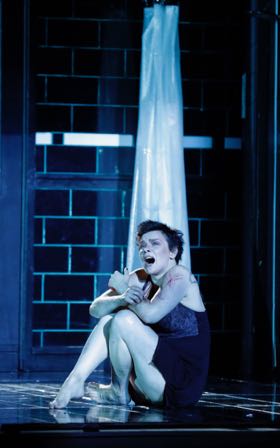
Aušrinė Stundytė as Renata
[All photos by Pascal Victor / Artcompress © courtesy of the Aix Festival]
Prokofiev’s Fiery Angel is rarely performed. This new Aix Festival production to be shared with Warsaw’s Teatr Wielki exemplifies why.
Its primary role, the possessed Renata, is punishing nearly beyond comprehension and its relentless, lurid narrative is difficult to follow, and in fact the vulgarity of its music can be off-putting.
The Fiery Angel is the third of Prokofiev’s seven operas (The Gambler and Love for Three Oranges are the first two), and the last opera he wrote before his return to Russia in 1936. Though begun in 1919 when the composer was 28 years old, and completed only in 1927 it was not premiered until 1955 in Paris and then in Vienna.
There is no doubt that The Fiery Angel is Prokofiev’s most intense dramatic music. It tells the ugly story of a young girl possessed by an angel, though perhaps a devil. She wishes to make physical love with her possessor. Two or so hours and several mis-adventures later she is exorcized (unsuccessfully) in a convent together with other nuns. It is a medieval tale of expressed sexual desire told from an early twentieth century symbolist perspective.
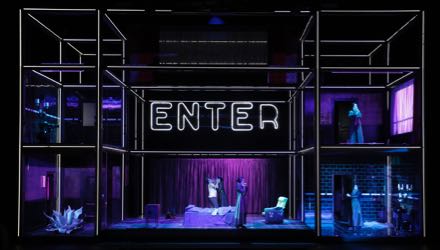
At the beginning there was the hotel room.
The possessed Renata and her would be redeemer, the knight Ruprecht seek and do find the angel of fire incarnate with the help of sorcerers. Finally Renata gives herself sexually to Ruprecht in place of the angel. A short philosophical discussion ensues between Mephistopheles and Dr. Faustus. And, voilà, Renata is condemned to be burned at the stake.
Mariusz Trelinski, artistic director of Teatr Wielki, staged the opera updating the action to what seemed to be rural eastern European surroundings in the communist 1960’s. Ruprecht seemed to be some sort of traveling salesman (if there were such then and there) who happened onto a seedy small town hotel. One recalled the Arthur Miller play Death of a Salesman.
Strangely, though we are in France and there are scenes specifically in medieval Cologne there were English language neon signs placed high in a multi-storied grid that was the stage face. The Cologne scenes were then staged on platforms in its upper reaches, effectively and unfortunately disembowelling Renata and Ruprecht’s voices from the dissonant maelstrom emanating from the pit way below.
Japanese conductor Kazushi Ono urged ever greater volume and bombast from the stalwart Orchestra de Paris, complementing the crassness of the staging. One of the many remarkable moments was in fact the long awaited sexual consummation of Renata and Ruprecht, the couple humping on an upper level, the orchestra turging away way down below while a miniature Ruprecht double attempted to jump rope on the stage floor.
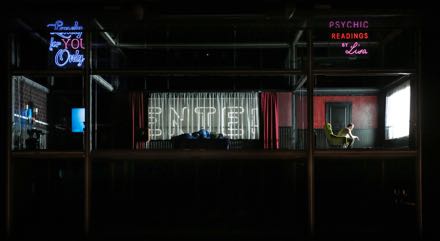
Renata (on left), Ruprecht (on right)
The role of Renata was sung by Aušrinė Stundytė, the Lithuanian soprano who incarnated the brilliant Lady Macbeth of Mtsensk in Lyon. Mme. Stundytė brought similar intensity to the obsessed Renata, but fell victim, understandably, to the obtuse staging demands as well as to the stamina needed to complete the role. She was essentially voiceless for the concluding exorcism.
The American baritone Scott Hendricks was the Ruprecht. This esteemed artist seemed a fish out of water, his fine, Italianate lyric voice not finding an edge or the volume needed to embody this complex, possessed-by-love knight who first attempts to rape Renata, and then in this production is raped by Renata. As well, and more importantly, Mr. Hendricks was placed in the upper reaches of the grid for his big scenes, depriving us of a direct presence, and an immediacy of voice.
Faring better were tenor Andrei Popov as Mephistopheles and bass Krzysztof Baczyk as Faust who both essentially tore up the stage in their stage level scene in the hotel bar. Both artists succeeded in projecting words and sentences that directly tied us to content, however oblique, an attribute sorely lacking in the balance of Mr. Triliński’s production.
Cast and Production
Renata: Aušrinė Stundytė; Ruprecht: Scott Hendricks; La Voyante / La Mère supérieure: Agnieszka Rehlis; Méphistophélès / Agrippa von Nettesheim: Andreï Popov; Faust / L’Inquisiteur: Krzysztof Bączyk; Jakob Glock / Un médecin: Pavlo Tolstoy; Matthieu Wissmann / L'Aubergiste / Un serviteur: Łukasz Goliński; La Patronne de l’auberge: Bernadetta Grabias; Première religieuse: Bożena Bujnicka; Seconde religieuse: Maria Stasiak. Orchestre de Paris, Chorus of the Opera of Warsaw. Conductor: Kazushi Ono; Mise en scène: Mariusz Treliński; Scenery: Boris Kudlička; Costumes: Kaspar Glarner; Lighting: Felice Ross; Vidéo: Bartek Macias; Chorégraphe: Tomasz Wygoda. Grand Théâtre de Provence, Aix-en-Provence, July 5, 2018.
Ariadne auf Naxos at the Aix Festival
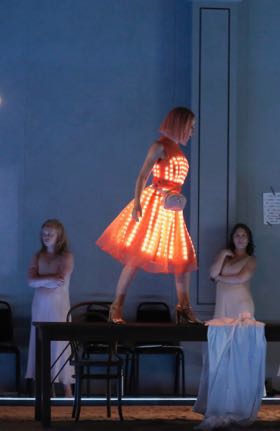
Zerbinetta on Ariadne's table with two of the three sprites
[All photos by Pascal Victor / Artcompress © courtesy of the Aix Festival].
Yes, of course British stage director Katie Mitchell served up Richard Strauss’ uber tragic Ariadne on Naxos at a dinner table. Over the past few years Mme. Mitchell has staged quite a few household tragedies at the Aix Festival, mostly at dinner tables, though some on doorsteps.
Among her Aix projects Mme. Mitchell staged George Benjamin’s Written on Skin with libretto by British playwright Martin Crimp. Mr. Crimp has subsequently served as dramaturg for Mme. Mitchell’s Aix Pelleas et Melisande and now for Ariadne, both productions brilliantly moving to meta-theatrical levels (metatheater is a Martin Crimp coined term). This simply means that it is theater as seen by theater — the original exists as well as how it is seen. Like metaphysics.
Of crucial contribution to the Aix Ariadne was the conducting of German born Marc Albrecht, now chief conductor of the Dutch National Opera. This maestro exploited the chamber music voice of the Strauss score in the expanses of the open air Théâtre de l’Archeveché, the grandness of Strauss’ orchestral introduction to the prologue monumentally minimized, but energized to accommodate the frantic transformation of the host’s (“the richest man in Vienna”) grand parlor into a makeshift theater space (a square of sand with a dinner table).
The maestro pulled out the intricacies of the myriad instrumental solos to create the usual intensity of backstage energy now augmented by the negotiations of merging commedia dell’arte with opera seria. Zerbinetta’s persuasive arguments to the opera seria’s composer seamlessly flowed into a passing moment of private musing by the composer, his fervent ode to music magically absorbed into the behind-the-scenes maelstrom.
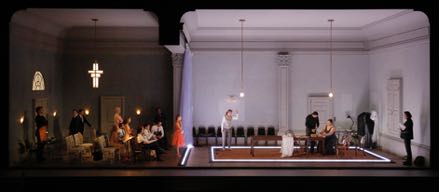
The totality of the Katie Mitchell production
And finally Mo. Albrecht transformed Strauss’ bombastic Ariadne Bacchus duet into an intimate discussion between two lovers accompanied by the exquisitely sweet comments of Dryad, Naiad and Echo, Bacchus taking frequent gulps of water from a plastic water bottle.
As Strauss and Von Hofmannsthal intended it was chamber opera, though now with Mme. Mitchell’s superimposed household on top of it — remember that the original intention was that Strauss’ opera seria was but an ending for Moliere’s Bourgeois Gentilhomme (translated by Von Hofmannstahl). In fact Mme. Mitchell’s household’s cross-dressed host and hostess sometimes interrupted Strauss’s opera with sarcastic comments (spoken) before they too climbed onto the stage to participate in Ariadne’s plight* and Zerbinetta’s solutions.
*Ariadne was pregnant.
Strauss was a very reluctant partner in this second, purely operatic version of the Strauss Von Hafmannstahl play-cum-opera, fearing with grave and indeed quite pertinent concerns a lack of comprehensibility for such a far-out, obliquely sculpted narrative. Katie Mitchell brilliantly brokered this Von Hofmannstahl/Strauss dispute by pulling it all together into one totality. The play within a play, the location and circumstance of the play, the guests at the play, the actors in the play (the commedia dell’arte troupe became transfixed by Ariadne’s outpourings), the exposed backstage psychologies, the opera indeed coalesced into pure metaphysics.
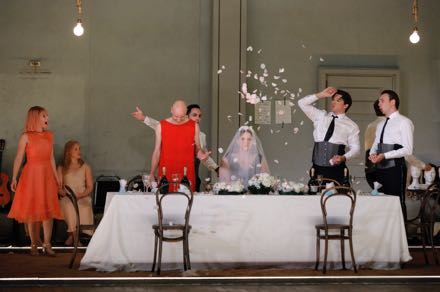
Zerbinetta, the richest man in Vienna, Ariadne, three of the commedia troupe
The Aix Festival is famed for its casting sophistication, and this Ariadne is no exception. Young Norwegian soprano Lise Davidsen let out immense, inhuman howls to welcome us to Ariadne’s solitude on Naxos. She added fine musicianship and vocal finesse in the use of her hugely powerful voice. French soubrette Sabine Devieilhe as Zerbinetta cooly seduced first the composer, and then she lectured Ariadne with splendrous soubrette tone in her lengthy, very lengthy “Großmächtige Prinzessin…So war es mit Pagliazzo.” The aria is punishing in its brilliant, stratospheric tessitura, flawlessly exuded in this Zerbinetta’s atypical soft charm and compassion that fit perfectly into the metaphysics of the production.
American mezzo-soprano Angela Brower as the composer physically conducted her opera though of course she sang not a word after the prologue, her presence in the opera seria adding the concept of creation and pride of creation to Mme. Mitchell’s inexhaustible philosophical complexities. She somehow seamlessly integrated her “Sein wir wieder gut” into the conceptual flow of the prologue, emanating gorgeous silvery tones in her radiant declaration of the powers of music.
Austrian bass baritone Josef Wagner as the Music Master was indeed authoritative in his deftly sung, deft management first of the spoken majordomo (actor Maik Solbach) and then of household’s two sets of performers. He was aided by the household’s very tall Dance Master, cross dressed and made taller by stiletto heels in the person of British tenor Rupert Charlesworth who for all his draggy, swishy flightiness was cooly supportive of the fraught performers in frank, masculine voice.
Like Zerbinetta the comedia dell’arte troupe (Harlequin, Brighella, Scaramuccia and Truffaldino) had costumes that lighted up (ah, what riches LED lights have brought to opera), in this case the exaggerated cumberbunds of their matching formal wear (black pants, white shirts) lighted up to make the flashiness of their comedic performances apparent, and in stark contrast to their weighty, maybe drab operatic counterparts.
Dryad, Naiad and Echo were physically matched to be sprites of nature, and vocally matched to be the sweetly voiced handmaidens of nature and its eternal renewal. Bacchus was sung by American heldon tenor Eric Cutter who served and re-served in stentorian voice (lubricated by gulps of water) the cake-like boxes of starry lights to Ariadne’s table throughout her death scene.
This Ariadne auf Naxos is an Aix Festival co-production with Barcelona, Paris, Helsinki, Copenhagen and Luxembourg. Be advised, it is a production worth crossing continents, even oceans to see.
Cast and Production
Primadonna / Ariadne: Lise Davidsen; Der Tenor / Bacchus: Eric Cutler; Zerbinetta: Sabine Devieilhe; Der Komponist: Angela Brower; Harlekin: Huw Montague Rendall; Brighella: Jonathan Abernethy; Scaramuccio: Emilio Pons; Truffaldin: David Shipley; Najade: Beate Mordal; Dryade: Andrea Hill; Echo: Elena Galitskaya; Ein Musiklehrer: Josef Wagner; Ein Tanzmeister: Rupert Charlesworth; Ein Offizier: Petter Moen; Ein Perückenmacher: Jean-Gabriel Saint Martin; Der Haushofmeister: Maik Solbach; Ein Lakei: Sava Vemić; L'Homme le plus riche de Vienne: Paul Herwig; Sa Femme: Julia Wieninger. Orchestre de Paris. Conductor: Marc Albrecht; Mise en scène: Katie Mitchell; Dramaturge: Martin Crimp; Set Design: Chloe Lamford; Costumes: Sarah Blenkinsop; Lighting: James Farncombe; Responsable des mouvements: Joseph W. Alford. Théâtre de l”Archevêché, Aix-en-Provence, July 4, 2018.
Don Carlos in Lyon
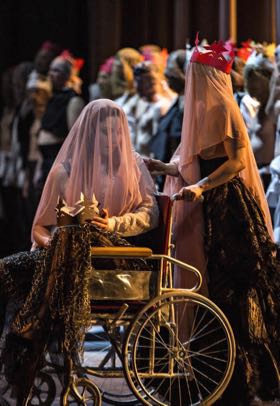
Eboli (in wheelchair) and Elisabeth at masquerade
All photos copyright Jean-Louis Hernandez, courtesy of Opéra de Lyon
Metteur en scène Christophe Honoré placed his 2016 Aix Festival Cosi fan tutte in Ethiopia. Unfortunately his current Lyon Don Carlos enjoys no such equivalent poetic intuition.
Mr. Honoré has reduced his Lyon Don Carlos to some sort of obscure theater metaphor. Thus basic scenic accoutrements and machines of an empty stage are the environments wherein the complexities of Phillip II’s filicide, uxoricide and amicicide unfold.
For the Fontainebleau forest there were some theatrical drapes and a dense, very dense fog of choking theatrical fog and not very much theatrical light. For Saint-Just there was another plane of theatrical drape and not much light, but there was a stage floor trap open to somewhere below. The masquerade was an orgy, theatrical drapes moving back and forth, hide and seek, peeking at couplings (sexual) certainly not that public during the Spanish Inquisition.
For the auto-da-fe the stage became an old raw wood theater, the Spanish court, the Flemish supplicants, and the Madrid populace stuffed into a side wall of boxes, the heretics (four total) were twitching architectural detail. Phillip II’s bedroom was a variation of the raw wood theater structure whose side boxes served to hint at cloister for the Grand Inquisitor. The stage was an empty black box for Rodrigo’s death in Carlos’ cell.
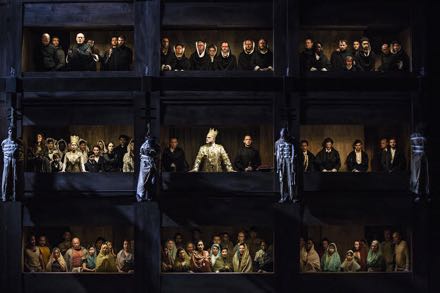
The Auto-da-fé
Back in Saint-Just the floor trap was again open to allow the entrance of incarnate Carlo V ashes in the form of a sort of walking cherub with a lighted breast plate. There was a scenic coup de theatre to let us know something had happened (what?) when a panel of drapes fell to the floor revealing a huge, seated blue madonna.
The evening was divided into two two-hour segments. At first we sat patiently during the lengthy minutes it took to cobble, and re-cobble together these set changes, and then impatiently in disbelief at such conceptual, indeed abusive ineptitude.
The edition was cobbled together as well. Among other machinations a part of the ballet was restored. Given that Ferrando had showered before his tryst with Fiordiligi back in Aix we knew a water feature would come. Voilà! The four soon to be immolated heretics fought and frolicked under an inexplicable shower of water as the ballet music chugged on. These four dancers appeared a final time laid out in Phillip II’s study during his famous soliloquy.
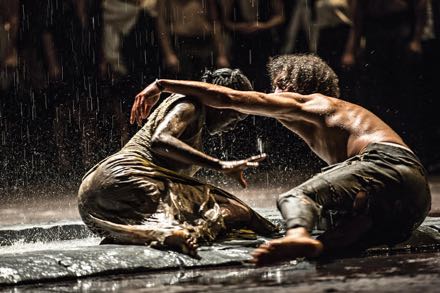
Two of the four heretics in the shower
Mr. Honoré embellished his concept by confining Princess Eboli to a wheel chair. French mezzo Eve-Maud Hubeaux is a lyric mezzo whose presence is non-threatening even without a broken leg. Her Eboli was of an engaging comic energy. French baritone Stéphane Degout is a quite lyric baritone as well, conferring a youthful naïveté on Rodrigue (Posa) that precluded a poetic gravitas we might expect from the opera’s one sympathetic personage. The easy energy of these two performers made them audience favorites.
Russian tenor Sergei Romanovsky carved a plausible Don Carlos, his light lyric voice responding to this character’s presumed epilepsy, though his swoon before Elisabeth found none of its magic. But this Don Carlos could not plausibly challenge his father. British soprano Sally Matthews has a significant wobble in her low and medium register evoking a maternal rather than romantic presence. She did find some convincing phrasing in her high voice that made her "Toi qui suis la néant" (Tu che la vanita) one of the few dramatic successes of the evening.
Italian bass Michele Pertusi as well captured some of the sublimity of phrasing in Phillip II’s "Elle ne m'aime pas" (Ella giammai m'amò) though the dignity of this scene dissolved into a dry anger that permeated his character start to finish. Italian bass Roberto Scandiuzzi was a warm voiced, bland Grand Inquisitor, though the night before he had created a dynamic Banquo in Macbeth.
With the conceptual, directorial and casting malaise of the production it was difficult to access the contribution of the pit to the evening. The Opéra de Lyon orchestra put forth some beautiful sounds, notably in the strings. Conductor Daniele Rustioni did indeed support the few successful moments of the evening with stylistic precision.
It was a long, very long, too long evening in Lyon.
Cast and Production
Philippe II: Michele Pertusi; Don Carlos: Sergey Romanovsky; Rodrigue, marquis de Posa: Stéphane Degout; Le Grand Inquisiteur: Roberto Scandiuzzi; Un Moine: Patrick Bolleire; Elisabeth de Valois: Sally Matthews; La Princesse Eboli: Eve-Maud Hubeaux; Thibault, page d’Elisabeth: Jeanne Mendoche; Une Voix d'en haut: Caroline Jestaedt; Le Comte de Lerme: Yannick Berne; Un Héraut royal: Didier Roussel; Députés flamands:Dominique Beneforti, Charles Saillofest, Antoine Saint-Espes, Paolo Stupenengo, Denis Boirayon, Thibault Gerentet. Orchestre, Chœurs et Studio de l'Opéra de Lyon. Conductor: Daniele Rustioni; Mise en scène: Christophe Honoré; Décors: Alban Ho Van; Costumes: Pascaline Chavanne; Lumières: Dominique Bruguière; Chorégraphie: Ashley Wright. Opéra de Lyon, March 16, 2018.
Macbeth in Lyon
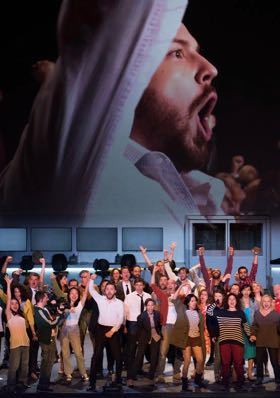
Arseny Yakovlev as Macduff (live projection) and Occupy Wall St. demonstrators
All photos copyright Stofleth, courtesy of Opéra de Lyon
A revival of the Opéra de Lyon’s 2012 Occupy Wall St. production of Verdi’s 1865 Macbeth, transforming naive commentary into strange irony, some high art included.
It’s a hard stretch of imagination indeed to connect the dynastic intrigue of Verdi’s opera (and this is Shakespeare’s play) with money hungry stock trading witches. Nonetheless the high tech trading room provided a rich backdrop of arbitrary decor — binary numbers flashing on countless monitors, the myriad screens morphing into interpretive pop television images from time to time, the entire back wall of the white stage box becoming a gigantic TV screen of surveillance camera images of the opera’s murders, its apparitions, and the TV reportage of Occupy Wall St.
All this was simply the counterpoint of passionate pursuit of riches to an intense Freudian drama playing out center stage, Lady Macbeth nurturing the ambitions of her husband Macbeth with her idea of a realpolitik — the simple elimination of competing parents and their progeny. These acts evolved into the couple’s shared moral and physical sterility that precluded all possibility of creating their own succession.
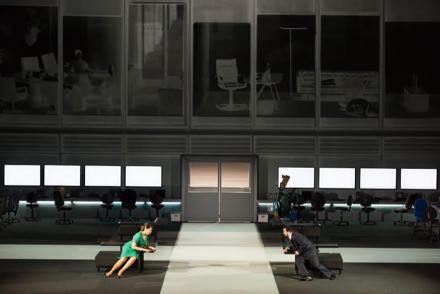
Lady Macbeth and Macbeth, above is negative projection of soon-to-be-murdered Duncan's rooms
Stage director Ivo van Hove defied Verdi’s wishes for a Lady Macbeth of ugly voice and overt madness by creating a full breasted, nurturing Lady Macbeth of powerful, even beautiful voice to match her fully confident if morally hesitant and certainly beautifully voiced husband. Mr. Van Hove further defied Verdi (and Shakespeare) by ultimately joining husband and wife into one tortured being, Macbeth shadowing and suffering with Lady Macbeth in her final moments of torture. His ultimate spousal compassion was his strangulation of Lady Macbeth.
This was not the blood and thunder Verdi of political action, it was a Verdi of bel canto, two tortured beings singing themselves into a complicity of mutual understanding that was to become their destruction. It was the stuff of high tragedy.
Conductor Daniele Rustioni found the precise balance between beautiful singing and stinging feeling countered from time to time with Verdi’s interwoven compassionate flute and oboe solos. Mo. Rustioni worked unrelentingly with Azerbaidjan baritone Elchin Azizov, a fine singer and a gifted actor, and Italian soprano Susanna Branchini, a physically and musically elegant singer to find and musically achieve this latent, and very real human tragedy.
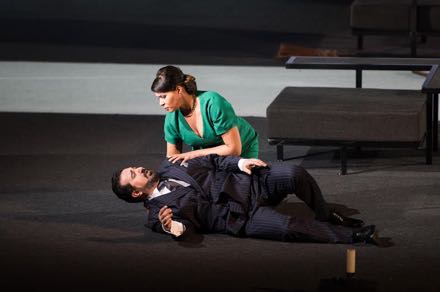
Macbeth and Lady Macbeth
Director van Hove wittily introduced a silent, observant black janitress who cleaned up the messes left on stage — the trader/witches’ printouts, Lady Macbeth’s bloody rags, the thrown chairs — and generally replaced the grim emotional residue with a stoic calm. She was a pointed, sarcastic comment on big money.
Director van Hove’s chorus scenes were masterfully configured, the chorus of female witches spread around the edges of the huge white box stage, its disembodied sound coming together in occasional center stage groupings. Of particular effect was the staging of the chorus of Scottish refuges, here something like later day East Coast flower children, who emerged in solo movements to animate individual suffering.
The opera’s triumphal chorus was a Occupy Wall Street camp bacchanal of live TV coverage including an gigantic cameo of beautifully sung lines by Macduff, Russian Arseny Yakovlev. There were splendid takes of cocky young Malcolm, the new king, sure to soon become, together with the balance of the Occupy Wall Street demonstrators, as greedy as Mr. and Mrs. Macbeth.
And such inevitable domestic tragedies to begin anew. Maybe Mr. Van Hove did not have this resolution in mind when he created this production in the aftermath of the 2008 financial markets crisis and the 2011 demonstrations. But his fine production has discovered unexpected new resonance.It was a splendid evening of beautifully produced opera.
Cast and Production
Macbeth: Elchin Azizov: Lady Macbeth: Susanna Branchini; Banco: Roberto Scandiuzzi; Macduff: Arseny Yakovlev; Médecin: Patrick Bolleire; Malcolm: Louis Zaitoun. Chorus and orchestra of the Opéra de Lyon. Conductor: Daniele Rustioni: Mise en scène: Ivo van Hove; Décors et lumières: Jan Versweyveld; Costumes: Wojciech Dziedzic; Vidéo: Tal Yarden. Opéra de Lyon, March 15, 2018.
Il barbiere di Siviglia in Marseille
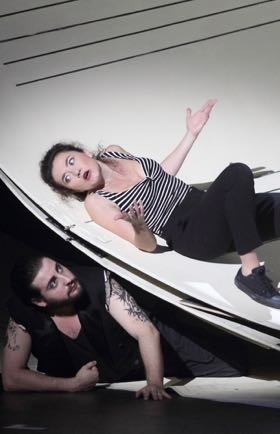
Florian Sempey as Figaro, Stephanie d'Oustrac as Rosina
All photos copyright Christian Dresse, courtesy of Opéra de Marseille
Any Laurent Pelly production is news, any role undertaken by soprano Stephanie d’Oustrac is news. Here’s the news from Marseille.
Rossini’s grand old (1816) comedy took the stage just now in Marseille’s fine, old (1787) opera house in the form of a Laurent Pelly production.
Pelly’s black and white production premiered this past December at Paris’ Théâtre des Champs Elysees. France’s most read newspaper Le Monde dubbed it a Barber in “demi-deuil” (half-mourning) and somehow dug up hints of tragedy in the storm — a bewildered Rosina rushed across a blank dark stage, dead leaves flying. Laurent Pelly’s conceit was in fact black ink on white paper, huge sheets of blank musical score paper on which Figaro tried to write out Lindoro’s “Se il mio nome bramate” (If you wish to know my name). In due time, however, for its moment “L’Inutile precauzione,” as backdrop, was fully notated (wittily it was not with the actual tune).
It was a complex conceit, the singers filling in, virtually, the notes missing on the scenery, or maybe the old warhorse having been performed so many times that Mr. Pelly found its story irrelevant — thus Il barbiere di Siviglia is only music, or maybe Mr. Pelly’s was saying that Il barbiere is music, though we already know this. Music was indeed a useless precaution in this scheme of things Barberiana.
Or something.
To be generous the five black lines of the musical staff did serve to imprison Rosina who appeared behind them when a square opened on a white page wall creating her balcony.
Mr. Pelly deployed his choruses and ensembles in geometric patterns, dissolving movement into abstracted, repeated motions (like music notation) reinforcing the music score conceit (the chorus mimed unison violins for Lindoro’s “Ecco ridente in cielo,” then stormed in as police brandishing folding metal music stands. These events were just the tip of the iceberg — there are lots of duets, trios, quartets and quintets, and one more chorus — gentlemen in regimented concert formation, sheets of music on their folding metal stands. It was a masterwork of stage choreography.
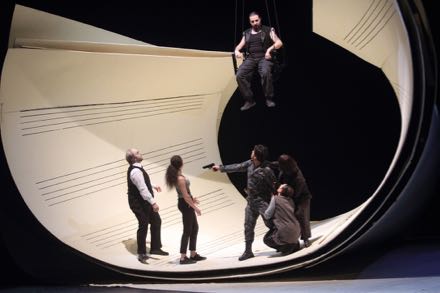
The drunken soldier, Figaro in swing
It was a long evening at the Marseille Opéra, a very long evening. [One of the most charming evenings I have ever passed in a theater was Laurent Pelly’s La Périchole (Stephanie d’Oustrac) at the Marseille Opéra back in 2002.]
Conductor Roberto Rizzi Brignoli was determined to make Rossini’s comic masterpiece into something it is not — Mozart, with touches of Cilea. The Barber’s overture was a caricature of this oft concert-performed masterpiece, this maestro insisting on determined, very determined tempos and very shaped phrases. The opening oboe solo was so extended that you could feel the player’s face turning red. Missing from the entire evening was the joy of music making, the joy of singing and the release of musical spirit when a vocal line explodes into fioratura.
The only carry over from the Paris cast was to have been the Figaro of Florian Sempey, but the diseases of the season claimed veteran baritone Carlos Chausson’s Bartolo at the very last minute, thus Spaniard Pablo Ruiz [the opera singer, not the pop singer of the same name] from the Paris cast jumped in.
It is surely possible to say that young baritone Florian Sempey will be (probably is) the reigning Figaro of our day. Less a look-alike of an imagined young Rossini now than in his Pesaro Figaro in 2015 he once again succeeded in bringing perfect Rossinian spirit to this comic hero. Mr. Sempey has facile, graceful movement on stage, and facile command of Rossini’s vocal requirements, singing in strongly focused, beautiful tone. Of infectious energy Mr. Sempey's Figaro in this production had no easily apparent context, thus there was no dramatic focus and this rendered his fine performance somewhat overbearing.
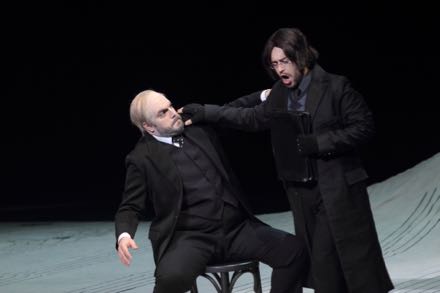
Bartolo and Basilio
There can be no argument that Stephanie d’Oustrac can create fascinating character, witness her recent successes as Carmen in wildly different productions. Certainly her Rosina in this production is a masterpiece of character — a sort of “valley girl” or whatever the French equivalent is. La d’Oustrac’s Rosina is more than anything else fun, and she is not a bit frightened by the prospect of marrying Bartolo. Her “una voce poco fa” was so inflected with personality that you forgot it was being sung. Although her performance was vocally secure and virtuoso indeed, I did miss a purely sung Rossini Rosina.
With the powerhouse conducting, the overwhelming staging conceit, and the surpassing performances of Mme. d’Oustrac and Mr. Sempey the balance of the cast struggled to make impression. Lindoro was ably if softly sung by French tenor Philippe Talbot, Spanish baritone Pablo Ruiz was an able, persuasive Bartolo, Young Italian bass Mirco Palazzi was Basilio, paired in appearance with Lindoro, a subtle casting touch. Annunziata Vestri was a lively, big voiced Berta and did make an impression. Fiorello was well presented by local Marseille singer Mikhaël Piccone.
Cast and production information:
Rosina: Stéphanie d’Oustrac; Berta: Annunziata Vestri; Comte Almaviva: Philippe Talbot; Figaro: Florian Sempey; Bartolo: Pablo Ruiz; Basilio: Mirco Palazzi; Fiorello: Mikhaël Piccone; Un Ufficiale: Michel Vaissiere; Ambroggio: Jean-Luc Epitalon. Orchestre et Chœur de l’Opéra de Marseille. Conductor: Roberto Rizzi Brignoli; Mise en scène, décors, costumes: Laurent Pelly; Lighting: Joël Adam. Opéra de Marseille, February 9, 2018
Die Walküre in Toulouse
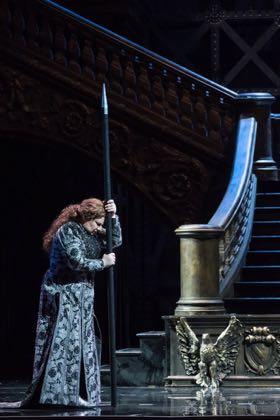
Anna Smirnova as Brünnhilde
This and following photo copyright David Herrero, third photo copyright Frederic Maligne
All photos courtesy of the Théâtre du Capitole
The Nicolas Joel 1999 production of Die Walküre seen just now in Toulouse well upholds the Airbus city’s fame as Bayreuth-su-Garonne (the river that passes through this quite beautiful, rich city).
The Joel production, here revived by stage director Sandra Pocceschi (a Castellucci assistant), approached masterpiece status, exploiting the intimacies and the unique acoustic of the Théâtre du Capitole, enjoying the splendors of its excellent orchestra, and profiting from an essentially perfect cast.
It is a rare pleasure to address an isolated Walküre in this recent (10 or so years) avalanche of entire Rings worldwide. Die Walküre is the one of the Ring’s operas that easily stands alone as a human document without need to be absorbed into larger 19th century philosophical concepts.
The Joel staging, in collaboration with Giorgio Strehler’s designers Ezio Frigerio (scenery) and Franca Squarciapino (costumes) eschews concept (no California gold rush for example), instead it explores a theatrical language (style) to expound the multiple crises of Wotan, the deeply human feelings of Brunnhilde, the forbidden love of Sieglinde and Siegmund, and the outrage of Fricka and Hunding.
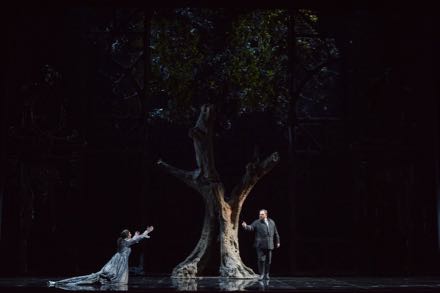
Sieglinde and Siegmund
The language is of the utmost simplicity. The set is a changing montage of ever present imperial architectural elements in front of a huge steel superstructure, though there is the sword-bearing abstracted tree trunk in the beginning. Costuming is in rich garments of basically medieval cut in grays and blacks and pastel hues.
Wagner imagined his music drama with its orchestra as the primary voice. The Théâtre du Capitole’s pit is very present, both visually and acoustically, its forte’s and then triple forte’s roar without impeding clear projection of voice from the stage. The intimate comments of Wagner’s much used bass clarinet, oboe and bassoon are no less present in their isolated purity.
Wagner’s poem flowed from the stage, its words never obfuscated, only enriched by orchestral colors. Wagner’s actors were sculpturally placed for their extended monologues, their extended stylized postures (a head hung for example) illustrated the emotions flowing from the orchestra. Gestures were broad, and when they occurred they were quite pointed — like the gazes of recognition between Siegmund and Sieglinde, or Wotan’s slapping of balustrades in his frustration or anger.
The dancing of the flames that surrounded Brünnhilde then burst (one giant flash of real flame, then smoke and lights) into a magnificent force of conflagration that the father Wotan knew would protect his daughter. The Joel staging defined pure music drama, as the Théâtre du Capitole’s orchestra traced the evolution of emotions of human love that made this nearly 6 hour Die Walküre finally into a uniquely enjoyable Wagnerian experience.
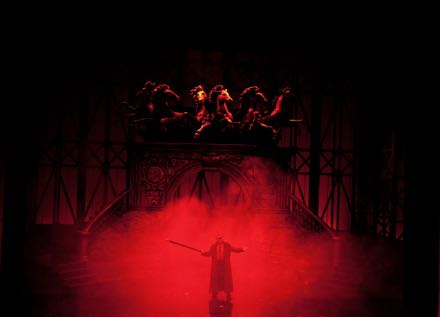
Wotan
And we leave the story at that.
Russian mezzo soprano Anna Smirnova made her dramatic soprano debut as this Brünnhilde. Her voice is of extraordinary power, and of a richness that amplified the surpassing humanity of Wotan’s favorite daughter. The youth of her voice was perfect for the innocence of the Walküre Brünnhilde (she is 35 years old), and her voice retained its youthful bloom to the last, intense moments of her final encounter with her father. Note that as a mezzo she will sing Eboli in L.A. Opera’s upcoming Don Carlo.
Polish bass-baritone Tomasz Konieczny brought unusually sharp vocal edge to Wotan, a god in utmost agony — he dictated the death of his son, and faced the rebellion of his most loved daughter. Konieczny was an actor in Poland before he became a singer. His Wotan was of intense concentration, his troubled postures added force to his defeat by his wife Fricka, his berating of the Valkyries was wearied and sharply apprehensive. Note that he sings Wotan in the Vienna State Opera’s upcoming Ring.
Strauss specialist, 50 years-old German soprano Daniela Sindram made her role debut as Sieglinde. She possesses a purity of voice that added pathos to her adultery and incest and her impending maternity, and impeccable technique that revealed the anguish of her attachment to her brother and lover. Likewise in his role debut as Siegmund, German tenor Michael König exposed a purity of youthful helden tenor sound that made his remembrances of his earthly father vivid, and made his declaration to Brünnhilde of his love for Sieglinde persuasive.
Russian bass Dimitry Ivashchenko was a menacing, beautifully sung Hunding. German mezzo Elena Zhidkova made Fricka appropriately shrill and rigid. The Valkyries were a noisy lot, wandering around a Valhalla courtyard amidst the piles of fallen heroes in bloody underclothes that they unceremoniously (bizarrely) dragged around like dead meat.
This Die Walküre began and ended in the pit. German conductor Claus Peter Flor, long associated with Toulouse, oversaw this Wagnerian masterpiece with musical clarity and Wagnerian insight, magnifying its humanity in his precisely dramatic reading of the score. The Théâtre du Capitole orchestra responded with utmost concentration, swelling to magnificent climaxes, joyfully popping the flames in its overture and again at its finale.
Cast and production information:
Brünnhilde; Anna Smirnova; Siegmund: Michael König; Wotan: Tomasz Konieczny; Sieglinde: Daniela Sindram; Fricka: Elena Zhidkova; Hunding: Dimitry Ivashchenko; Gerhilde: Marie-Laure Garnier; Ortlinde: Oksana Sekerina; Waltraute: Pilar Vázquez; Schwertleite: Daryl Freedman; Helmwige: Sonja Mühleck: Siegrune: Szilvia Vörös; Grimgerde: Karin Lovelius; Rossweisse: Ekaterina Egorova. Orchestra of the Théâtre du Capitole. Conductor: Claus Peter Flor; Mise en scène: Nicolas Joel mise en scène (by Sandra Pocceschi); Scenery: Ezio Frigerio; Costumes: Franca Squarciapino; Lighting: Vinicio Cheli. Théâtre du Capitole, Toulouse, France, February 6, 2018).
Guillaume Tell in Palermo
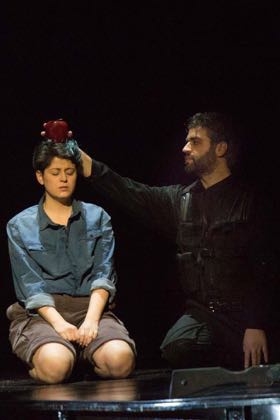
Anna Maria Sarra as Jemmy, Matteo Mezzaro as Rodolphe
This and next photo copyright Rosellina Garbo, third photo copyright Franco Lannini,
all photos courtesy of Teatro Massimo
This was the infamous production that was booed to extinction at Covent Garden. Palermo’s Teatro Massimo now owns the production.
The Palermitani, evidently less offended by abject sexual violence, tolerated the production’s humiliation and rape of a young woman without remark (having tacitly accepted as well Hunding’s gang rape of Sieglinde in last year’s Ring). Not that Damiano Micheletto’s William Tell production was not resolutely booed at this opening night of the Teatro Massimo’s one-hundred-twenty-first season. It was indeed.
It was a relaxed, festive evening at the Teatro Massimo, a red carpet runner ushering the very well-dressed audience past two magnificently uniformed guards at the entrance, shining swords at their sides. Never mind the heavy police presence in the piazza in anticipation of a demonstration (unrealized) against such extravagance.
At the hour the performance was to begin an announcement was made delaying the beginning by one-half hour due to a strike of some sort. No one minded as it was a very social evening, the animated conversations would have been hard to interrupt anyway.
Guillaume Tell, Rossini’s French style grand opera can be a very long evening (five hours plus in a recent Rossini Opera Festival production). In Palermo just now it was reduced to a bit over four hours, the act one marriage ballets were sacrificed, plus other less prominent sections.
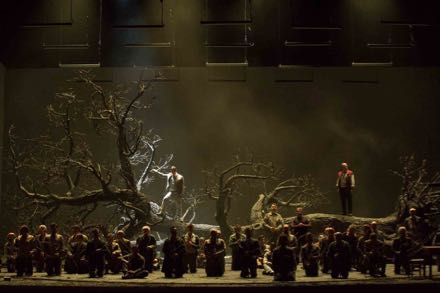
Dmitry Korchak as Arnold (in white light), Roberto Frontali as William Tell (in red vest)
The Michieletto production reduced Rossini’s spectacle to bare bones — an illustrated comic book story (projected from time to time) was its cornice from which a surrogate William Tell emerged to cement William Tell’s patriotic resolve at crucial moments. Rossini’s quite specifically human, and complicated storytelling was transformed in Palermo into a ceremonial hymn to liberty, told in three bold strokes, Gesler’s thugs tore out the tree of peasant life (Gesler is the tyrant villain). The tree lay dead on the stage until William Tell eradicated Gesler. A new tree was planted as the Swiss peasants celebrated their emancipation from tyranny.
The effect of the production, and it was considerable, was exponentially increased by the expansive conducting of Teatro Massimo’s music director Gabriele Ferro. His tempos were indeed deliberate, elaborating the ceremonial tone of the production, the flights of lyricism were reduced to the beautiful sounds of the overture’s flute solo and to the splendidly voiced fisherman’s song that opens the first act.
After this it was all business. The chorus of Swiss peasants was grimly seated at regimented tables to grimly celebrate love, marriage and the harvest. William Tell got right to work liberating them through his heroic resolve, abetted by the heroic courage of his son Jemmy and the stoicism of his wife Hedwige. The murdered Melcthal’s son Arnold came to his senses and swore to avenge his father (though William Tell actually did all the work), not without the help of the Hapsburg princess Mathilda whom he loved.
Done.
The chorus and the principals then let Rossini’s final hymn to liberty soar, and it was spine tingling. The gigantic dead tree magically lifted (grand opera is famous for spectacular scenic effects, and this was just that) to allow a young boy to pass under with a sapling that he planted down stage center.
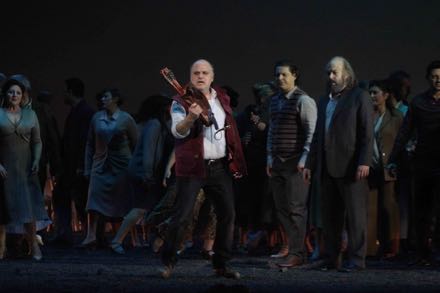
Roberto Frontali as William Tell
The Micheletto production was given vibrant life by an excellent cast whose voices and personae seconded its conceptual intentions. Baritone Roberto Frontali (San Francisco Opera’s recent Scarpia and L.A. Opera’s recent Falstaff) brought sharp edge to William Tell, no longer Rossini’s father figure he was far more a warrior. Soprano Anna Maria Sarra as William Tell’s son Jemmy was not diminutive, rather she was full-sized both vocally and morally, a warrior who mimed a child's movement.
Arnold, rendered impotent by love was sung by Russian tenor Dmitry Korchak in fine French and fine Rossini style. He was in love with Mathilde, the Hapsburg princess sung by Tbilisi (Georgia) born Nino Machaidze, a soprano of ample voice and great charm who negotiated her bit of fioritura with ease and to good effect.
William Tell’s stolid friend Walter Furst, sung by bass Marco Spotti, remained in the shadows, helping when called upon. Albanian mezzo Enkelejda Shkoza made Tell’s wife Hedwige a strong, purposeful presence supporting her husband and son, and a strong, purposeful voice in the upper registers of Rossini’s large ensembles, in Palermo executed with requisite magnificence.
The villain Gesler was delivered in high caricature by bass Luca Tittoto, underscoring the Italianate nature of this French evening (after all we were in Palermo!). Tenor Matteo Mezzaro, Gesler’s lieutenant Rodolphe, managed infectious charm in his nefarious duties.
The splendid first act’s fisherman’s song was sung by Sicilian tenor Enea Scala for the opening night performance only. He will sing Arnold in the final two of this eight performance run — the dynamic will be greatly changed. As the fisherman he and Enkelejda Shkoza were the only carryovers from the Covent Garden cast.
The orchestra and chorus of the Teatro Massimo seccured the solid artistic level of the evening, proving again that this Palermo theater is among the finest in Italy.
strong>Cast and Production
Guillaume Tell: Roberto Frontali; Arnold: Dmitry Korchak; Walter Furst: Marco Spotti; Melcthal: Emanuele Cordaro; Jemmy: Anna Maria Sarra; Gesler: Luca Tittoto; Rodolphe: Matteo Mezzaro; Ruodi: Enea Scala; Leuthold: Paolo Orecchia; Mathilde: Nino Machaidze; Hedwige: Enkelejda Shkoza; Un chasseur: Cosimo Diano. Chorus and Orchestra of the Teatro Massimo. Conductor: Gabriele Ferro; Metteur en scène: Damiano Michieletto; Scene designer: Paolo Fantin; Costumes: Carla Teti; Lighting: Alessandro Carletti. Teatro Massimo, Palermo, January 23, 2018.
I masnadieri in Rome
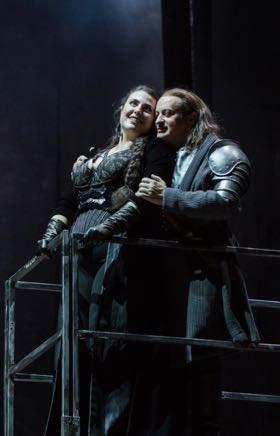
Roberta Mantegna as Amalia, Carlo Secco as Carlo
All photos copyright Yasuko Kageyama courtesy of Teatro dell'Opera di Roma
AKA I masnadieri, rare early Verdi, though not as rare as Alzira. In 1847 London’s Her Majesty’s Theatre commissioned the newly famous Verdi to write this opera for the London debut of Swedish soprano Jenny Lind.
And to this day “Tu del mio Carlo al seno” and its cabaletta remain a showpiece for sopranos, not to mention the “Parea mi che sorto da lauto convito” that is a blockbuster showpiece for baritones. There is even a greater amount of splendid music for tenor, starting with the opera’s initial scene “O mio castel paterno” that creates the situation that will result in the brutal murder of the soprano.
Just now in Rome the tenor Carlo, yearning for his childhood home, was sequestered up on some sort of rolling scaffold on the side of the stage for this first scene (and most of the opera), but upon learning that his father has disinherited him he vowed to remain in a band of robbers who plunder the countryside (and in this production brutally rape women). The robbers rose magically on one of Teatro Costanzi’s famous full stage elevators and he agreed to become their leader.
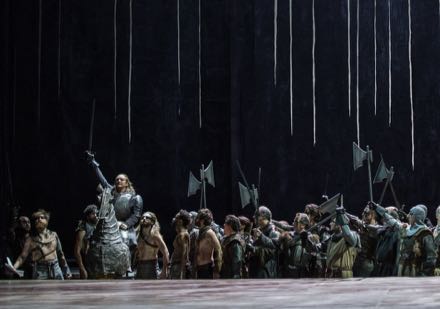
Carlo (Stefano Secco) becoming leader of Verdi's bandits
Meanwhile we learn that the baritone had deceived the tenor. The tenor had not been disinherited after all, he could in fact have renounced his dissolute life and returned home. The problem now becomes the tenor’s sworn loyalty to his band of robbers, not to mention that the soprano from his former upright life loves him. Unfortunately the conniving baritone wants to marry her. So there was a lot to sing about.
The metteur en scène of this new production was popular 57 year-old Italian actor and voiceover artist (for dubbing films) Massimo Popolizio. Mr. Popolizio made his directorial debut only last year with Author Miller’s 1968 play The Price. Mr. Popolizio is said to have based his staging of The Bandits on the popular U.S. TV series Game of Thrones. Maybe this explains the several scenes of gratuitous gang rape. Unlike the well developed threads of Game of Thrones, Mr. Popolizio left Verdi’s admittedly worst libretto without a discernible story line. We will never know from Mr. Popolizio why Carlo (the tenor) murdered Amalia (the soprano) just after their ardent declaration of love.
It was an an evening about singing, not about theater. After overcoming quite deserved opening night nerves the mostly Italian cast sang stylishly. Unfortunately tenor Stefano Secco (San Francisco’s 2014 Pinkerton) as Schiller’s questionable hero Carlo did not deliver the opening scene with sufficient pizazz to impress the audience which, despite his intense and eloquent (though small scale) delivery of the third act, awarded him vociferous boos at the final bows.
Twenty-nine year old ingenue diva Roberta Mantegna, a recent graduate of Rome Opera’s new young artist program, negotiated Amalia’s treacherous outpourings with knowing aplomb, belying the fact that this was her debut in a major role on a major stage. Additional maturity of voice will add effect to her Amalia.
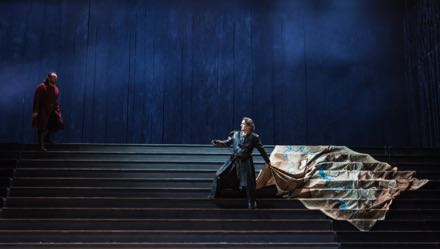
Francesco (Artur Ruciński) beginning “Parea mi che sorto da lauto convito”
Polish baritone Artur Ruciński, San Francisco Opera’s recent Germont, gave an impressive account of the repentant Francesco’s big scene, his fine diction finding its intimacy rather than its bravura. The role of Massimiliano, Carlo and Francesco’s feeble father, was competently delivered by ubiquitous bass Ricardo Zanellato.
Conductor Roberto Abbado exhibited little affection for early Verdi, and had no patience for attempting ensemble in the extended scenes with the male chorus.
Cast and production
Massimiliano: Riccardo Zanellato; Carlo: Stefano Secco; Francesco: Artur Ruciński; Amalia: Roberta Mantegna; Arminio: Saverio Fiore; Moser: Dario Russo; Rolla: Pietro Picone. Orchestra and Chorus of the Teatro dell’opera di Roma. Conductor: Roberto Abbado; Metteur en scène: Maurizio Popolizio; Set designer: Sergio Tramonti; Costumres: Silvia Aymonino; Lighting: Robert Venturi. Video: Luca Brinchi and Daniele Spanò. Teatro Costanzi. Rome, January 21, 2018
Le Cercle de Craie in Lyon
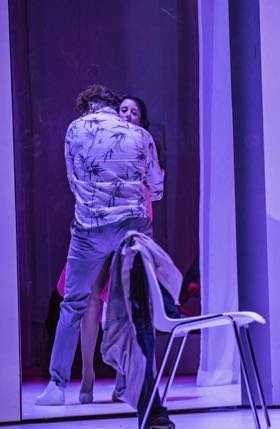
Prince Pao and Haitang falling in love
All photos copyright Jean Louis Fernandez courtesy of the Opéra de Lyon
Not the 14th century Chinese play nor its 1832 French translation, but a 1931 operatic re-creation by Alexander Zemlinsky of a 1925 German translation by “Klabund,” staged just now in Lyon by French stage director Richard Brunel.
Der Kreiderkreis or The Chalk Circle or Le Circle de Craie in French (1931) is the seventh of Zemlinsky’s eight operas (A Florentine Tragedy [1916] is the fifth, The Dwarf [1921] is the sixth, the unfinished Le Roi Candaule is the eighth). This Lyon production is the French premiere of The Chalk Circle.
Zemlinski’s The Chalk Circle is realized in masterful musical strokes, the late Romanticism and its destruction that surrounded Zemlinsky is fully assimilated into a finished style that floats faultlessly from the grotesque to the sublime, through cruelty and hopelessness to generosity and redemption. The.exotic tones of the ancient Orient and the new American world plus extended tracts in the actual spoken language finished the sophisticated soundscape of this tumultuous German political era. It was a unique music that mesmerized the opening night audience.
Director Richard Brunel found this sound world in ephemeral white images that merely suggested architecture. He dressed his actors in colors and periods that spoke to and of the wealth, power and corruption of the early twentieth century and to our current moment and to these early moments of the Chinese twenty-first century as well. He dissolved morality play abstractions into very specific and intense human scenes incorporating a large number of silent actors and even a live horse. The horse was white of course, and as the white snowflakes of the full stage snowstorm it too purified the heroine Haitang in her impossible plight.
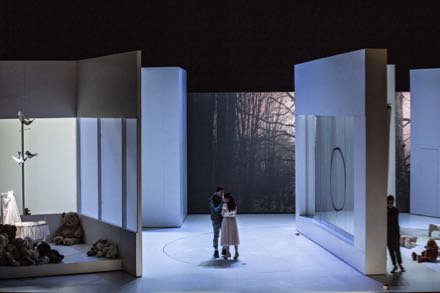
Ma’s number one wife Yu-Pei overhears Haitong’s reunion with her brother Ling,
and hatches her plot to frame Haitang for infidelity.
The story is simple. A maiden sold into sex slavery is saved first by a villain she then purifies by giving him an heir. Accused of killing this husband by his number one wife she is again saved, now by the emperor of China himself who discerns her purity when she refuses to inflict violence on her child by wrenching it from a circle drawn by chalk. Among the splendidly staged scenes was her initial house of joy encounter with the young noble who later became emperor. It made startling effect indeed as circles of white light moved and bounced in pleasure and innocence.
Director Brunel knows however that such purity and innocence is doomed. He is not duped by the happy morality of the Chinese play. Brunel’s heroine we learn in the split second before final blackout has only imagined this happy ending. This extended delirious love duet with the emperor was but a flash in the moments before she is executed by the forces of an unjust world.
It was a production of purely human dimension executed in exquisite theatrical taste.
The cast, primarily Germanic language singers, was perfection, physically and vocally finding the depths of purity and depravity in the humanity of the characters of this ancient morality play. Conductor Lothar Koenigs created a vibrant presence for Zemlinsky’s score.
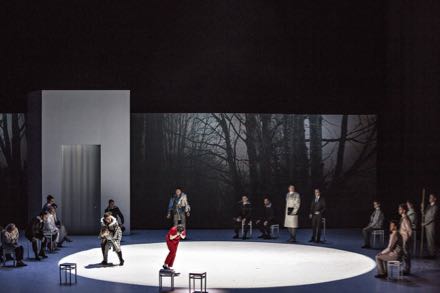
Haitang (in red) refuses to subject her child to the violence of a physical struggle.
The emperor in light tan coat looks on.
Soprano Ilse Eerens beautifully exploited every nuance of emotion felt by Haitang, convincingly traversing Zemlinsky’s quick shifts through fear, resolve, tenderness and ecstasy. Her first love, Prince Pao, the young noble later emperor sung by Stephan Rügamer, was of stentorian tone, her brother Tschang-Ling, sung by baritone Lauri Vasar was, as Haitang, a voice of sweetness and human understanding. Haitang’s husband Ma, a tax collector, sung by bass Martin Winkler was rough and raspy. His divorce lawyer Tchao, sung by baritone Zachary Altman matched the menacing warmth of his lover mezzo soprano Nicola Beller Carbone who as Ma’s number one wife was the opera’s villain. As the judge, Tchou-Tchou, at the murder trail character tenor Stefan Kurt gave terrifying presence to the corruption of power as character singer Paul Kaufman created the shocking depravity of German cabaret as the Chinese house of joy.
The French production team was metteur en scène Richard Brunel; set designer Anouk Dell’Aiera; costumer Benjamin Moreau; lighting designer Christian Pinaud and video by Fabienne Gras.
Opéra Nouvel, Lyon, January 20, 2018
Elektra at the Salzburg Festival

Mind-blowing productions of Strauss’ Elektra staged by Krzysztof Warlikowski and Luigi Nono’s Intolleranza 1960 staged by Jan Lauwers. [Lead photo is a detail of the back wall of Elektra covered with flies.]
The Salzburg Festival has three theaters — the great big, important Grossesfestspielhaus, the smaller, arty Haus fur Mozart, and its Felsenreitschule (Rock Riding School) theatrical space where great big artistic excitement happens.
Like a Roman theater the Rock Riding School has a scaenae frons, a high back wall (estimated 25 meters) in which boxes have been carved into a sheer cliff from which spectators once sat to watch horses perform. Over the years a cavea has been built (slightly semi-circular stadium seating for 1450 spectators facing the cliff wall), the orchestra is the orchestra (the Vienna Philharmonic), and an immense podium (platform) has evolved (40 meters wide [130 ft.], estimated 18 meters deep).
Not to mention the massive presence of dernier cri lighting, projection, flying and under stage capabilities that are continuously expanded and updated.
Though Strauss conceived his Elektra as an opera, performed in the Rock Riding School it became pure Greek tragedy, the famed artistic ritual to instill fear and pity, and most of all to evoke awe at the massive power of fate. Exceptionally, Clytemnestra gave Elektra a heated spoken prologue from Aeschylus’ Oresteia, she having murdered Agamemnon in his bath to avenge his sacrifice of their daughter Iphigenia, plus accomplishing a full-blown coup d’état making Aegisthus king.
PHOTO Austrine Stundyte (under bench) as Elektra, Peter Kellner as an old servant entering Agamemnon's bath.Director Warlikowski and his designer Malgorzata Szczęśniak (his wife) used every inch of the massive platform to color the tragedy — the far right, huge, clear plastic box, sometimes in red, sometimes violet, sometimes black that was the palace, magically moving center stage for its murders. Center left was a long light blue pool, a bath, that served both as the long history of Agamemnon and his family, and for his murder. Seven shower heads loomed along the wall behind the pool offering the prophecy of cleansing.
The entire space was finished and lighted to be slightly reflective thus intensifying the obsessions of von Hofmannsthal’s doomed women, and men.
In the beginning Elektra sat hissing on a smooth, molded seating bench along the extreme left wall, the maids sat on a similar bench stage right while observing Orestes’ resolve and Elektra’s blessing for the matricide, then disappearing for a shattering, seemingly scored, unseen chorus heard from within the palace during the orchestral maelstrom of the aftermath.
The coup de théâtre was the sudden splash of blood red over the massive expanse of the now brilliant white, sheer cliff (the open faced boxes plugged to make the surface solid), and the appearance of huge, projected black flies to feast on the blood, transforming themselves into a vortex of insect horror. The palace became a reflective black, the flying arms of conductor Franz Welser-Möst apparent on its surface for all to see his urging of ever greater volume in the terrifying orchestration of emotional chaos.
The inspired awe was indeed of the intractable, inescapable power of fate, but moreso of the immense force of art.
PHOTO Tanja Ariane Baumgartner as Clytemnestra haunted by Orestes as boy puppets.The huge platform of the Riding School has no wings, there is no arch. There is no fourth wall (the proscenium opening) through which we see into a further world. The doomed actors were in your same room, allowing you to hear and see them intimately. The hallmark of the Warlikowski production was in fact not the horror of murder, death and rot, it was the intimacy of your encounters with Elektra, Chrysothemis, Clytemnestra, Orestes and Aegisthus, conductor Welser-Möst illuminating with Strauss’ solo instruments the detailed movements of their doomed minds, Clytemnestra alone, seated center stage, shedding her protective jewels one by one, baring her soul to the hatred of her daughter, Elektra seducing an uncomprehending Aegisthus, Chrysothemis’ hunger for a life, Orestes dehumanized by his duty.
Austrine Stundyte, Elektra, is a vocally endowed actress of enormous intensity and stamina, Asmik Grigorian, Chrysothemis, Salzburg’s Salome, is youth personified; Tanja Ariane Baumgartner, Clytemnestra, is a vocally endowed actress of great intensity; Christoper Maltman, Orestes, a forceful voice as an instrument of destruction; Michael Laurenz, Aegisthus, sleekly sexual. The voices of the palace maids and overseerer, Clytemnestra’s train bearer and confidant were each of individual character and artistic finish adding much additional pleasure.
A television version of the production, well worth watching, is available on Medici.tv.
Additional Elektra production information:
Lights: Felice Ross; Video: Kamil Polak; Choreography: Claude Bardouil. Felsenreitschule, Salzburg, August 28, 2021.
Intolleranza 1960 at the Salzburg Festival

Like the members of the Neo-Marxist Frankfurt School (flourishing in the 1950’s), Luigi Nono (1924-1990) came from the privileged classes, in his case Venetian aristocracy. Nono was however a vehement anti-fascist, becoming a member of the Italian Communist Party in 1952. Artistically as well as politically he was an avid revolutionary, ascending to be one of the three primary voices [with Boulez and Stockhausen] of the Darmstadt School (a title he himself gave to this American funded musical initiative of the 1950’s).
Nono is remembered as an uncompromising avant-gardist of emotional and moral complexity, these attributes fundamental to his musicality.
Intolleranza 1960 is a work of unabashed, extreme musical, visual and political avant-gardism in which an emigrant seeks refuge from working class exploitation and political tyranny in an attempt to return to his homeland. Aside from the neo-Nazi clashes with anti-Fascists at the premiere the performance was notable for its compromised resources (no live chorus and the recorded choruses off kilter with the present orchestra. The eminent Italian poet Eugenio Montale reported that the decor by Nono’s architect friend Emilio Vedova and the staging by an imported Slav, Vaclav Kaslik reeked of an industrialized (i.e. stamped out) avant-garde.
Montale noted as well the musical sincerity of the work, and its accomplishment as highly communicative musical expressionism, though the work was in great need of a more refined staging.
PHOto Sean Panikkar as the Emigrant, Antonio Wang as the Algerian (left), one (of two) faraway orchestras in the background.Thus Intolleranza 1960 has been waiting for a proper exposition, that in some ways, not all, it received just now in the Salzburg Festival’s strikingly appropriate Rock Riding School space. With however full operatic resources — the live Vienna State Opera Concert Chorus, the Vienna Philharmonic, two dozen dancers from the Salzburg Experimental Academy of Dance (founded by a former Merce Cunningham dancer [Nono abhorred John Cage]), an army of extras plus seemingly infinite digital resources responding to Nono’s primitive electronic needs.
That the Salzburg production can be said to be a work by Luigi Nono is open to question. The Salzburg Festival entrusted its production to Flemish political artist (any medium you can think of) Jan Lauwers who re-envisioned Nono’s class struggle as a drama of oppressed people of color — the American blacks (yes, he inserted an “I can’t breathe” into Nono’s libretto) and the African refugees specifically — in search of a better life.
Fascism has come a long way since the 1950’s, suppression once inherent to capitalism is now grounded in populism. Mr. Lauwers does indeed have an agenda that he imposes on Nono’s Marxism, in fact he subtitles Nono’s Intolleranza 1960 as Intolleranza 2021 by the addition of a character, the Blind Poet! Mr. Lauwers begs us to understand the dichotomy of art (in his mind), its need to have clarity in its inherent political/societal message and the inherent ambiguity in the poetic search for image.
The blind poet closes his eyes to see the truth, losing himself in the ambiguity of truth, the populace wants social media clarity, “intolerant” of the poet whom it sees as a buffoon. Jan Lauwers himself wrote the lengthy tract that his blind poet recites within Nono’s opera, followed by the enormous crowd exploding in an extended scene of jeering, unaccompanied laughter.
Both scenes were indeed highly effective, dwarfing Nono’s mere Marxism, Lauwers’ tract ironic in its absolute didactic clarity, leaving evidently Nono’s “stage action” as the poetry of the evening.
Though mere is not a word that describes Nono’s gigantic construct — triple winds, six horns, four trumpets, four trombones, strings, a bevy of keyboard and percussion instruments plus magnetic tape (recorded chorus from faraway speakers). Its thirteen scenes are animated by five principal singers, Nono’s emigrant (tenor), his clinging concubine (mezzo), an Algerian (baritone), a tortured prisoner (bass), and most significantly a companion (soprano) who condemns war and offers hope. An a cappella mixed choir opens the opera contemplating the meaning of life, it concludes the opera quoting Bertolt Brecht’s message to future generations — class conflicts resolved, man may help men.
This hope was of course unrealized in Nono’s opera, the Emigrant, beautifully realized by tenor Sean Panikkar (of Sri Lankan descent), and his Companion were swept away by a flood.
PHoto Anna Maria Chiuri as a Woman, two letters of Mr. Lauwers' word "Liberty" visible on the floorThere was much to admire in Mr. Lauwers’ staging of the Nono portion of the evening. Unlike the La Fenice production with its drops of architect Emilio Vedova’s angry black lines Lauwers used the 24 dancers to execute acute movements on the stage floor, accomplishing the same thing. He allowed both the concubine of the Emigrant’s mine life and the tortured prisoner to deliver their solo, beautifully constructed arias quite alone, down stage center, and most especially he created the splendid, extended scene of the hope-inspiring-companion as a dance with Nono’s four actor soldiers, now ballerinos, gorgeously sung and spectacularly danced [!] by soprano Sarah Maria Sun.
Lauwers used every inch of the massive stage surface, effectively moving his massive crowds (in addition to the 24 dancers at least 60, maybe more, choristers plus supers), leaving the Felsenreitschule’s huge back wall mostly blank, save the occasional revealing of Breugelesque crowds within the boxes (let’s not speak of the tacky projection of the nursing baby at the end).
Nono’s highly constructed sound world — sounds and rhythms that clash and jar, the friction of dissonance that cannot be resolved (in the words of conductor Ingo Metzmacher) — absorbed the texts (diverse modernist authors including Sartre and Brecht), obscuring any possible dramatic clarity. It was indeed a revolutionary stage action in music, beautifully realized by Mo. Metzmacher.
And it was huge. Like fate in Elektra, the eternal plight of emigrants (and today’s migrants) was shatteringly felt, and like the Salzburg Elektra the sheer power of art was overwhelming.
Intollerenza 1960 Cast and Production Information:
Emigrant: Sean Panikkar; His Companion: Sarah Maria Sun; a Woman: Anna Maria Chiuri; An Algerian: Antonio Yang; Tortured Prisoner: Musa Ngqungwana; Blind Poet: Victor Afung Lauwers. Vienna Philharmonic; Concert Choir of the Vienna Staatsoper; Salzburg Experimental Academy of Dance. Conductor: Ingo Metzmacher; Stage Direction, Scenery and Video: Jan Lauwers; Choreography: Jan Lauwers, Paul Blackman; Costumes: Lot Lemm; Lights and Video: Ken Hioco. Felsenreitschule, Salzburg, August 26, 2021.
All photos courtesy of the Salzburg Festival.
For a history of the Felsenreitschule as a theater please see:
La Boheme at San Francisco's Fort Mason Drive-in Movies

The Tesla parked directly in front of me waiting for La Bohème to be on-screen.
Well, maybe it wasn’t an opera house, but it was somewhere to go for opera beyond your living room. It was festive indeed to join a few hundred diehard aficionados for an actual opera performance, be it a recorded performance that happened in November 2008.
This was however a Bohème for the ages. Music director designate Nicola Luisotti previewing his nine momentous years to come at San Francisco Opera, Piotr Beczala as Rodolfo previewing the Lohengrin he became not so long ago in Bayreuth, Quinn Kelsey as Marcello previewing the Rigoletto he has assumed on the world’s major stages. The Mimi was Angela Gheorghiu in full diva form (on the rebound from having been fired by Lyric Opera of Chicago for skipping rehearsals to visit her then husband Roberto Alagna who was singing at the Met). You can see her as Tosca at the Semperoper this November 28 if you could somehow get to Dresden.
And La Bohème has come a long way too in these twelve years, as is witness the 2019 La Boheme at the Paris Opera where, no longer San Francisco Opera’s kitsch garret, Caffe Momu and snow flurry, it is the astronaut Rodolfo, lost in outer space, who dies, his oxygen supply depleted.
The screen version of this now retired San Francisco Opera production focuses on faces. The musical intimacy that so infused the live performances those many years ago came into a physical intimacy that rendered the heartbreak of these young Bohemians even more apparent. In my review of the 2008 performance I did not recognize the deeply moving contributions of the Musetta of Norah Amsellem, the Colline of Oren Gradus, and the Schaunard of Brian Leerhuber, these excellent portrayals deftly directed by Harry Silverstein.
La Bohème at San Francisco Opera, a review of the 2008 production.
On the not-so-big screen at San Francisco’s Fort Mason Drive-In we could easily participate in the Act I seduction, Mimi seemingly in full health and happiness, oozing the fun of youth and life on the streets of Paris, we could feel up close the confused, emotional turmoil of the Act III separation, and finally address, full face, the quiet, at first un-noticed by others, death of Mimi. If ever there was a cast to make the La boheme video this was it.
As it was in Greek theater it is for us in the opera house, dramatic catharsis is a ceremony to be felt by community. And there we were, a couple hundred, socially distanced cars (as if cars socialize), in a parking lot between two old warehouses over the bay (hardly the sculpted seashell of the drive-in theaters of yore), to cathartically transcend the sacrifice of youth. Strangely, unlike recent political rallies, no overt appreciation was shared when the arias were artfully rendered, and finally there was no blaring of our car horns at the end to release the tragic tension we all must have felt.
We all drove away silently. It was wonderful to have been there.
Not that drive-in movie opera doesn’t have its problems. These days the sound is broadcast on FM to your car radio, the upside is that most cars have rather decent sound systems. Rarely used in our car, the default settings, we learned, favored the bass. While this well supported Mo. Luisotti’s rather frequent emotional surges it came to make them a bit mannered. We will figure out how to adjust the balance for the upcoming Tosca on December 12.
But most troublesome was the faulty broadcast, the sound underlined by a constant rattle that often moved to an instrumental solo, or treble vocal line. We overcame the urge to leave, agreeing to accept the highly distorted sound to be able to watch this superb cast move through Puccini’s masterpiece.
Less troublesome was the fogging of the windshield — it was cold and damp just there by the bay with our heated emotions inside the car. At first we lowered the windows to clear the fog, when that became untenable we had to start the car to activate the defroster. In current cars this illuminates lights inside and outside the car creating a visual distraction for the cars around us, akin maybe to someone seated near you in an opera house illuminating their cell phone to check their messages.
Cast and Production
Mimi: Angela Gheorghiu; Rodolfo: Piotr Beczala; Marcello: Quinn Kelsey; Musetta: Norah Amsellem; Colline: Oren Gradus; Schaunard: Brian Leerhuber; Benoit, Alcindoro: Dale Travis; Parpignol: Colby Roberts; Customhouse Sergeant: David Kekuewa; Customhouse Officer: Jere Torkelsen; Prune Vendor: Chester Pidduck. Conductor: Nicola Luisotti. Director: Harry Silverstein. Set Designer: Michael Yeargan. Costumes: Walter Mahonney.
Boris Godunov at the San Francisco Symphony

Stanislav Trofimovbass as Boris Godunov
Photos by Cory Weaver, courtesy of San Francisco Symphony.
Though the Symphony billed the program as semi-staged for all intents and purposes it is fully staged. There is scenery or what purports to be in this digital age (this also happens across the street). There are lights and costumes and make-up. There is a stage on two levels. Reduced San Francisco Symphony forces (the string count [and personnel] is not specified in the program booklet — maybe 12/10/8/6/5) were stuffed in between in a sort of pit.
More accurate billing would have defined the production as a compromised staging, given that nothing functioned very well, sacrificing the contributions of the pit players of a major symphony orchestra and the imposing presence of imported Russian singers among the generally high-level cast.
Perhaps the four towers that support a lighting-grid circle are recycled from staged production to staged production at the Symphony thus alleviating what must be the breath-taking cost of trying to mount an opera production in a symphony hall. Lighting, rather lack of effective lighting was the most problematic technical issue of the evening.
There was a huge cyclorama — a semi-architectural, jagged backdrop — behind the orchestra and stage platforms onto which unrelenting video images were projected. There were cutouts to reveal the San Francisco Symphony Chorus seated in the stage terrace (amphitheater) behind the orchestra platform, the voices of the Russian populace. The projections onto the huge backdrop attempted grandeur — sometimes nature, sometimes specific colorful Russian architecture, sometimes interpretive color blotches, sometimes black shadows on blank white.
Stage director James Darrah employed six ninja-like action facilitators who were often, but not always, carefully choreographed. These six were sometimes joined by another 12 or so supers to constitute more specific though soundless Russian souls. The ninja’s participation was sometimes abstract and sometimes descriptive, like the lengthy, bloody downstage center brutalizations of a captured boyar (aristocrat) and two Jesuits.
It was complex staging that attempted to adapt Mussorgsky’s sprawling drama to an essentially non theatrical space.
The event was certainly envisioned to be magnificent, and it was in spite of itself. After all it is magnificent music, and San Francisco Symphony music director Michael Tilson Thomas of course made the most of it. Two loge boxes were conscripted to hold ranks of Russian bells that rang forth gloriously when called upon. A solo trumpet sounded an imposing fanfare from the first tier. These moments of unleashed sonic grandeur encased Mussorgsky’s grand choruses as well as the vaguely connected scenes of private discussions and of Boris’ raving. The extended intimacy of these solo voice scenes required that the SF Symphony’s virtuoso players become accompanists. And that they did, like an overly careful sometimes precious accompanist at a lieder recital.
There were two genuine Russian basses, the Boris of Stanislav Trofimov of St. Petersburg’s Marinsky Theater and the Pimen of Maxim Kuzmin-Karavaev of the Novaya Opera Theatre Moscow. Mussorgsky’s Boris Godunov is about words, about the Russian language and about the Russian soul. The Russian bass epitomizes these qualifications as no other voice. Both Mr. Trofimov and Mr. Kuzmin-Karavaev are excellent specimens.
There were three genuine Russian tenors, the intense Grigory (the Pretender) of Sergei Skorokhodov of the Marinsky Theatre and the harsh, very harsh Shuisky of Yevgeny Akimov, a veteran of the Marinsky and all of the world’s major stages, and the very sweetly sung Holy Fool of Stanislav Mostovoy of the Bolshoi Theatre.
The home team included San Francisco Opera’s Catherine Cook and Philip Skinner as the Innkeeper and Nikitich (a police officer) respectively who well held their own amidst the Russians. Of particular note was the Shchelkalov of American baritone Aleksey Bogdanov who made the opera’s momentous announcements in convincingly Russian voice.
It is always said that the protagonist of Boris Godunov is its chorus of suffering Russians. The San Francisco Symphony Chorus brought true beauty of style and edge of tone to its cultured and earnest concert choir voice, well defining its role as a musical protagonist. Though of course the real protagonists of the drama are Russian basses — the suffering czar Boris and the hermit Pimen, the chronicler of his reign.
Conductor Michael Tilson Thomas held all of this together with great aplomb and with obvious understanding, respect and affection for this great monument of Russian art.
Cast and production information:Stanislav Trofimovbass (Boris Godunov), Eliza Bonet Mezzo-soprano (Fyodor), Jennifer Zetlan Soprano (Xenia), Silvie Jensen Mezzo-soprano (Nurse), Yevgeny Akimov Tenor (Prince Shuisky), Aleksey Bogdanov Baritone (Andrei Shchelkalov), Maxim Kuzmin-Karavaev Bass (Pimen), Sergei Skorokhodov Tenor (Grigory), Vyacheslav Pochapsk yBass (Varlaam), Ben Jones Tenor (Missail), Catherine Cook Mezzo-soprano (Innkeeper), Stanislav Mostovoy Tenor (Holy Fool), Philip Skinner Bass (Nikititsch), Chung-Wai Soong Bass (Mityukha). Pacific Boychoir, Andrew Brown, Director; San Francisco Symphony Chorus, Ragnar Bohlin Director; San Francisco Symphony, Michael Tilson Thomas Conductor. Stage Director: James Darrah, Lighting Design: Pablo Santiago; Video: Adam Larsen; Scenic and Costume Design: cameron Jaye Mock. Davis Hall, San Francisco, June 14, 2018)
Rusalka at San Francisco Opera
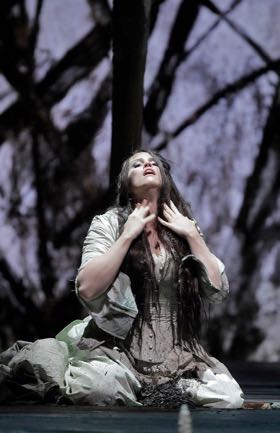
Rachel Willis-Sorensen as Rusalka
All photos copyright Cory Weaver, courtesy of San Francisco Opera
It must be a dream. Though really it is a nightmare. The water sprite Rusalka tortures herself if she is telling the story, or tortures the man who has imagined her if he is telling the story. Either way the bizarrely construed confusion of Czech fairy tales has no easily apparent meaning or message.
But it does have several hours of quite beautiful music to be sung and danced, and that has happened just now in San Francisco. Soprano Rachel Willis-Sorensen made her role debut as the “rusalka” or water sprite who has fallen in love with a hunter who is, incidentally, a prince. The role is a tour de force.
Seated in a moonlit tree Mme. Willis-Sorensen (35 years old) captured all of the naive magic of Dvorak’s famous Song to the Moon. Her considerable vocal resources are now fully realized (she was an ingenue Eva in SFO’s 2015 Meistersinger) and in this Rusalka fully utilized — even though she is voiceless for the entire second act when she must confront her competitor, the Foreign Princess. Rejected she returns to the forest to confront her destiny — that she kill the hunter she loves or forever lure men to their death with her kiss.
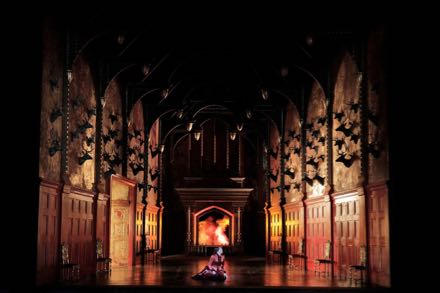
Act II Hunting Lodge
This occasioned quite a lot of singing. Mme Willis-Sorensen acquitted herself magnificently, the beauty of her silvery colored voice raging and caressing with unfaltering strength the conflicting emotions of her lost innocence. The hunter prince returns to her only to be pulled into the depths of the earth by her kiss. But not before joining Rusalka in one of opera’s most thrilling duets, it’s emotive extensions dissolving into an ultimate resignation to loss.
Tenor Brandon Jovanovich, a veteran hunter prince (he has recorded the opera with Anna Maria Martínez)) again brought beautiful, secure singing and ardent acting to this role. Mr. Jovanovich naturally brings the genuine innocence required by most tenor roles, plus he retains the requisite physicality. He is a unique artist.
The David McVicar production from Lyric Opera of Chicago gently embraces a lament of the effects of human intrusion into the natural world. The concept engenders a mysteriously lovely, animated forest marred by a concrete sewage dam, and a gigantic, trophy laden hunter’s lodge with carcass laden kitchen. Huge subtle atmospheres were thereby created that provided requisite presence for the unexpected monumentality of Dvorak’s score.
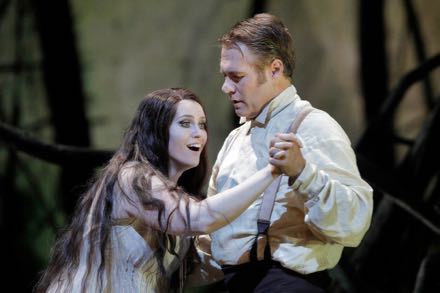
Rachel Willis-Sorensen as Rusalka, Brandon Javonovich as the Prince
Houston opera principal guest conductor Eun Sun Kim drove the emotional flow, pulling the vibrant Dvorak colors from the triple winds of the opera orchestra, urging full-throated force from its strings. Unlike the subtlety of the McVicar production Ma. Kim strove for immediate effect. It was thrilling when it was not overpowering. This talented conductress did find balance in the final moments of the duet. Its hopelessness seemed genuinely felt.
The three Wood Nymphs were appropriately embodied by three delightful Adler Fellows who frolicked together with the Opera’s corps de ballet in motions of rustic grotesquerie. British operatic choreographer Andrew George as well created the extensive balletic dance caricatures in the second act hunting lodge. The witch Jezibaba who transforms Rusalka into human form was sung by mezzo Jamie Barton with exaggerated grotesque sophistication.
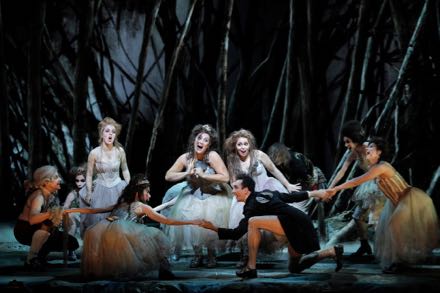
The Wood Nymphs and the corps de ballet
The high level casting was completed with Icelandic bass Kristen Sigmundsson singing Rusalka’s father Vodnik and bass baritone Philip Horst as first the lusty then the frightened Gamekeeper. Both artists were appropriately cast in these character roles that were very well sung. The Kitchen Boy who becomes Rusalka’s first victim was beautifully portrayed by former Adler Fellow Laura Krumm.
Soprano Sarah Cambridge, a recent Adler Fellow, was a perfunctory, steely toned Foreign Princess. An additional hunter was rendered by former Adler Fellow baritone Andrew Manea.
Cast and production
Rusalka: Rachel Willis‐Sørensen; The Prince: Brandon Jovanovich; Vodník: Kristinn Sigmundsson; Ježibaba: Jamie Barton; Foreign Princess: Sarah Cambidge; First Wood Nymph: Natalie Image; Second Wood Nymph: Simone McIntosh; Third Wood Nymph: Ashley Dixon; Forester: Philip Horst; Kitchen Boy: Laura Krumm; Hunter: Andrew Manea. The San Francisco Opera Chorus and Orchestra. Conductor: Eun Sun Kim; Production: David McVicar; Revival Stage Director: Leah Hausman; Set Designer: John Macfarlane; Costume Designer: Moritz Junge; Lighting Designer: David Finn; Choreographer: Andrew George. War Memorial Opera House, San Francisco, June 16, 2019.
Orlando at San Francisco Opera
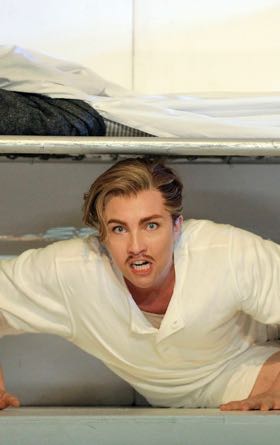
Sasha Cooke as Orlando [All photos copyright Cory Weaver
All photos copyright Cory Weaver, courtesy of San Francisco Opera
George Frederic Handel was both victim and survivor of the San Francisco Opera’s Orlando seen last night on the War Memorial stage.
Forget the brutal conflict between love and duty suffered by Lodovico Ariosto’s great chivalric hero Orlando. General director Matthew Shilvock made a curtain announcement that mezzo soprano Sasha Cooke, the Orlando, was indisposed, but would sing the famed Italian castrato Senescino’s role anyway. Thus the performance was compromised, Mme. Cooke’s Orlando pallid indeed.
Further compromise — Orlando’s arch rival in love was sung by Adler Fellow counter tenor Aryeh Nussbaum Cohen. He replaced David Daniels, the “me-too” disgraced counter tenor who brought virile flash to Xerxes’ Arsamenes a few years back and surely would have cut-the-figure to woo Ariosto’s femme fatale Angelica away from Orlando. Mr. Cohen has a lovely, smooth mezzo voice of feminine grace. Costumed as a middle aged business man Mr. Cohen did not make the cut vocally or figuratively.
The production came from Scottish Opera. Its conceit is that Edward VIII who abdicated the British throne (and the implied responsibility to battle Nazi Germany) for his love of American socialite Wallis Simpson serves as an admonition to Orlando (Italian for the famed knight Roland) that he forget love for a while and get on with saving Europe from the invading Saracens.
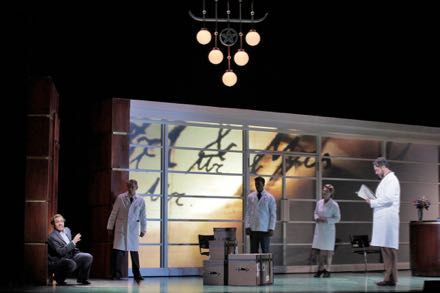
Orlando (far left), Zoroastro as psychiatrist (far right), supernumerary nurses
And so the action was in some sort of WWII hospital, Orlando a shot down pilot or something, with clothing of that period. It is a post-modern fashion look well known here in hip San Francisco where the Edward VIII abdication is a minor, if salacious though quaint footnote to ever more distant history. This 2011 production perhaps found greater resonance in the United Kingdom.
Essentially Orlando who has saved Isabella loves Angelica who has saved Medoro and is in love with him but has to deal with Orlando who goes crazy. Dorinda is crazy in love with Medoro who has to deal with her. The magician Zoroastro oversees it all. The language is purely pastoral.
Handel deals with all of this love and madness in the flow of his magnificent arias, plus a sublime trio at the conclusion of act I. Handel scored his 1733 opera for a very large orchestra, thus the resonant strings of the San Francisco Opera Orchestra were quite appropriate. Add two recorders, two blasting horns, two plaintive oboes, a splendid vibrato-less cello duet and two fine sopranos and Handel’s opera took flight. In fact under English early music conductor Christopher Moulds Handel’s music soared.
Only to be grounded in a small, low one wall set that turned around from time to time to accommodate British provincial stage director Harry Fehr’s stolid concept where everything is squarely explained as in a play. Handel and Ariosto’s imaginative, magically musical and pastoral impulses were forsaken to a purely earthbound narrative. It was hard to stay interested, thus there was significant audience defection after the second act.
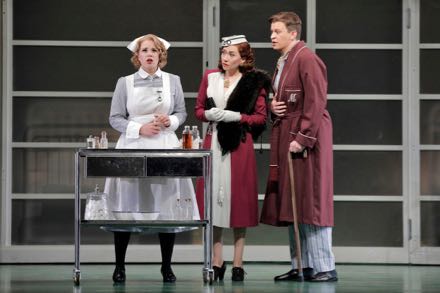
Dorinda, Angelica, Medoro
The greatest vocal pleasure emanated from young Austrian soprano Christina Gansch who found the poetic naïveté of the nymph (nurse) Dorinda in very communicative singing. Once again soprano Heidi Stober as Angelica proved she can do anything (everything from Magnolia Hawks in Showboat to Marguerite in Faust). Within the limitations of the concept she even found some of Ariosto’s magic and a great deal of Handel’s genius. San Francisco Opera’s catch-all bass Christian Van Horn did a workmanlike job of delivering Zoroastro.
Stage director Fehr inserted recorded bombardment explosions to confuse and disturb Orlando’s musical madness, and a sterile box to stifle Orlando’s florid delusions. So much for Orlando furioso.
Handel however happily survived it all.
Cast and production
Orlando: Sasha Cooke; Angelica: Heidi Stober; Dorinda: Christina Gansch; Medoro: Aryeh Nussbaum Cohen. San Francisco Opéra Orchestra. Conductor: Christopher Moulds; Director: Harry Fehr; Production Designer: Yannis Thavoris; Revival Lighting Designer: Tim van’t Hof; Projection Designer: Andrzej Goulding. War Memorial Opera House, San Francisco, June 15, 2019.
Carmen at San Francisco Opera
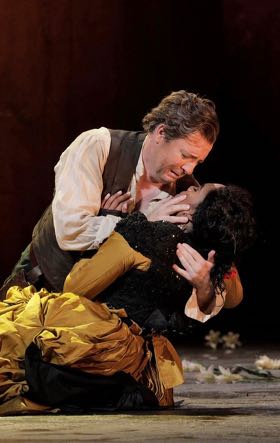
Matthew Polenzani as Jose, J'Nai Bridges as Carmen
All photos copyright Cory Weaver, courtesy of San Francisco Opera
A razzle-dazzle, bloodless Carmen at the War Memorial, further revival of Francesca Zambello’s 2006 Covent Garden production already franchised to Oslo, Sidney and Washington, D.C.
Unabashedly not a contestant in the Carmen wars (who can fit Merimee’s bloody tale most uncomfortably into a relevant contemporary context) Mme. Zambello sets her Carmen in a music hall somewhere. We see it as a sort of music hall revue of the numbers we know and love complete with lively production dance numbers. Like music theater there is spoken dialogue (a bit more than usual), the simple story is clearly told with no troubling nuances and there is not a drop of blood. On second thought this is about as far-out as a Carmen production could get.
But wait. There were more troubling aspects to the performance — Bizet’s Carmen was in fact further deconstructed. It happened in the pit. Former San Francisco Symphony associate conductor James Gaffigan, now a rising star on the world’s major stages, offered a bright, lilting overture, the always admirable San Francisco Opera Orchestra in resplendent tone. The rose red show curtain rose, Jose alone, desolate in a pool of light (he had already murdered Carmen, the story to be told in flashback) while Carmen’s famed fate motive flowed forth oh-so-sweetly at a mere orchestral forte (Mo. Gaffigan eschewed all sense of fortissimo throughout the ordeal).
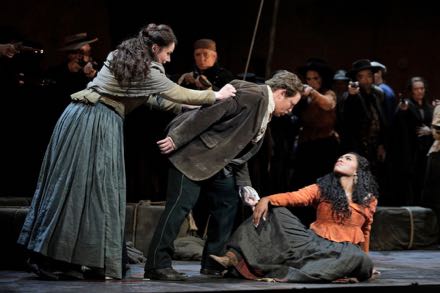
Anita Hartig as Micaëla, Matthew Polenzani as Jose, J'Nai Bridges as Carmen
Further Carmen shock and awe (and there was a lot of it) happened in Jose’s Flower Song, Carmen (the very beautiful J’Nai Bridges) reclined down stage right in a pool of light — a perfect rose — while Jose (Matthew Polenzani in fine voice) tenderly related to the rose he held, the maestro enveloping Bizet's brief postlude in the sweetest and loveliest possible colors, our two lovers in perfect, innocent and quite uncomplicated harmony. It was not ironic. This was a perfect love that simply got derailed.
One can only fear for the blood and guts of Verdi’s Ernani that this talented maestro will conduct in San Francisco Opera’s 2020 spring season.
Carmen dead on the stage, there was a final burst of glitz as Micaela, overlooking the tragedy from atop an orangey brown abstract structure meant to represent the exterior of the bull ring, threw blood red (finally some blood!) streamers along with clouds of confetti onto the estranged lovers.
With the stage director and the conductor in collusion the cast, clearly capable of far greater emotional range, diligently and effectively brought this strange Carmen to life. Mezzo-soprano J’Nai Bridges is young, sexy, vibrant, and dangerous, attributes that were as apparent in her voice as in her figure. She is a Carmen of exceptional musical finish. Her Habañera and Seguidilla were spellbinding, the maestro clearly under the artist’s thrall, the orchestral accompaniment a mere hint of the beat, like the finest Rossini conducting.
Tenor Matthew Polenzani portrayed a simple, smitten-with-pure-love soldier. His light lyric voice easily avoided the treacheries of the role for heavier voices, voices that have easier potential to personify the more usual sexually charged love Jose has for Carmen. As it was it seemed that this Jose’s love for Carmen was as pure as his love for his dying mother. On the other hand tenor Polenzani was a resolutely virile, recent San Francisco Opera Hoffmann.
Romanian soprano Anita Hartig as Micaëla fulfilled SFO’s claim to being an international house. This gifted artist of great presence brought a pure, silvery vocal sound to Micaëla in exceedingly careful phrasing, attributes that created a character of utter innocence. This Micaëla was never a foil to Carmen so much as she was the angel that oversaw the naive soul of a simple Spanish soldier. Hers was a performance indeed befitting a major stage.
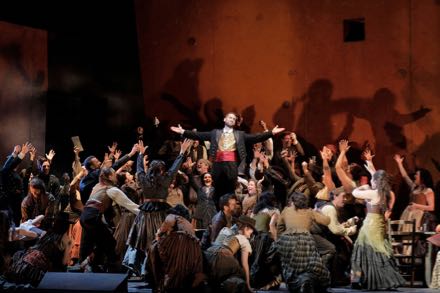
yle Ketelsen as Escamillo
Though not a flashy Spaniard, bass-baritone Kyle Ketelsen does cut a fine figure as the toreador Escamillo. He reads as physically strong and boasts an agility that easily could avoid a charging bull. The same could be said of his powerful voice and supple singing that he uses to actually create a character of depth, rare for this role usually played as a pure sex symbol. His third act fight with Jose was unsettling when all this magnificent virile physicality fell to Jose’s clumsy thrust.
The principal singers and the conducting were the elegance of the production. The actual staging and the lesser roles were clumsily rendered. Adler Fellows or equivalents were called upon to approximate as best they could the complex characters that complete Bizet’s drama, characters than can add intense emotional atmospheres to Carmen, but here did not. Unfortunately Natalie Image’s Frasquita was sometimes under pitch in the climaxes of the opera’s huge ensembles.
Mme. Zambello’s Carmen is music theater where action is controlled choreography and not spontaneous realism. There was incessant, staged movement, moreover in the complex fights movement was less than precise and usually ill timed, at odds with the rhythmic elegance emanating from the pit. The chicken and the mule of the original Covent Garden production have fallen by the wayside, leaving only the horse on which Escamillo arrives in Act II. One might envision a beautiful black stallion with an elegantly curved neck to second the imagined sleek figure of Escamillo. The War Memorial horse had none of these attributes, and should have been rejected by this toreador as an unsuitable nag.
The demagoguery (catering to common taste) of the production was blatant. Surely the San Francisco opera audience would prefer to be challenged with productions that stimulate the imagination and illuminate the human condition.
Cast and production
Carmen: J’Nai Bridges; Micaëla: Anita Hartig; Don Jose: Matthew Polenzani; Escamillo: Kyle Ketelsen; Frasquita: Natalie Image; Mercédès: Ashley Dixon; Zuniga: David Leigh; Morales: Seok Jong Baek; Remendado: Zhengyi Bai; Dancairo: Christopher Oglesby. San Francisco Chorus and Orchestra. Conductor: James Gaffigan; Production: Francesca Zambello; Associate Director & Movement Director: Denni Sayers; Production Designer: Tanya McCallin; Original Lighting Designer: Paule Constable; Revival Lighting Designer: Justin a. Partier. War Memorial Opera House, San Francisco, June 11, 2019.
Tosca at the Metropolitan Opera
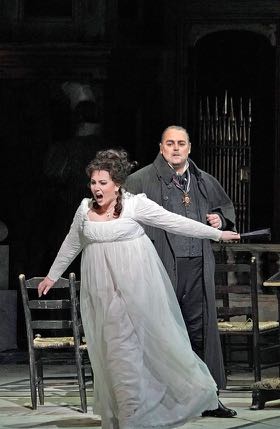
Jennifer Rowley as Tosca, Wolfgang Koch as Scarpia
All photos copyright Ken Howard / Met Opera
The 1917 Met Tosca production hung around for 50 years, bested by the 1925 San Francisco Opera production that lived to the ripe old age of 92. The current Met production is just 2 years old but has the feel of something that can live forever.
It is a not-too-subtle Rome. The massive stage opening of the Met was filled with architecture that exaggerated the Baroque massiveness of St. Andrea della Valle. This masculine world of the church became as well an expanse for the boundless desire of Rome’s chief-of-police, Scarpia. We did not see the details that illustrate the story (the painting, the picnic basket, etc.). But we did feel the threat of this space that rendered the diva Floria Tosca very vulnerable.
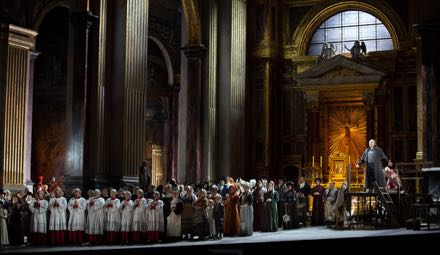
The Te Deum
The Farnese Palace was present in its spirit, not its architecture. Its famed fresco “The Loves of the Gods” extended in exaggerated perspective along one wall. A huge fireplace, votive candles and candle chandeliers spread through the huge dark space created a massive chiaroscuro where Tosca’s anima exploded.
The massiveness of Sant Angelo on the other hand was greatly diminished. A small terrace was its only architectural feature and only a small, morning sky floated in the now massive blackness of the Met stage house. The smallness of the space provided context for Tosca and Cavaradossi’s discussion of intimacies of the bloody murder. Tosca’s leap was but a small step into this void, an intimate, spectacular slide into nothingness.
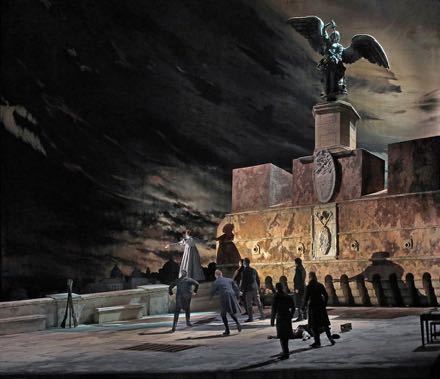
The leap
David McVicar’s Rome was not mere background for Puccini’s intense reading of Sardou’s play. Rome was the dominant player in this drama of release that has become the most famous of all operatic rituals, that has created a cult of Tosca followers. And that’s all of us — the entire corpus of the opera audience who need Puccini’s Rome to embody the world from which we must (and will ultimately) escape.
The powerful Rome that this Tosca set creates demands powerful singers to inhabit its vastness. This was fulfilled in the four spring performances conducted by Carlo Rizzo who aided and abetted the three principals to create personages of impressive magnitude. American soprano Jennifer Rowley embodied a Tosca flooded by a huge spectrum of emotions, from the playfulness of diva attitudes in the first act to her murderess fury in the second act and finally the complexities of the third act. Mme. Rowley’s voice has a fast flutter that served to create an exaggerated singerly presence for Tosca. She has a surcharge of vocal heft to ride above the climaxes, and artistry that made her “Vissi d’arte” a show stopper.
German bass-baritone Wolfgang Koch created a unique Scarpia, one who seemed to almost speak his words in Puccini’s threatening vocal lines, his massively powerful physical size added to the menace of his character. Mr. Koch’s Scarpia is not a subtle creature, he is the ultimate predator, and Puccini provides him ample of opportunity to brag about it.
Tenor Joseph Calleja more naturally plays the role of a tenor rather than he played the painter Cavaradossi. Fortunately he is a good tenor so his instinct to turn to face the audience when he has a high note, and to hold it long enough to be doubly sure that we know he has powerful, secure high notes, was not as annoying as it might have been.
Mr. Calleja is the Cavaradossi this coming July at the Aix-en-Provence festival in a mise en scène of Tosca by French director Christophe Honoré. This director set his Aix Cosi fan tutte in Ethiopia, his Lyon Don Carlo amidst theater drapes on an otherwise empty stage. Thus we nervously await the Rome (if Rome) he will conjure for this Aix Tosca, into which he must slip tenor Calleja. It may be worth the trip just to find out.
Cast and production
Floria Tosca: Jennifer Rowley; Cavaradossi: Joseph Calleja; Baron Scarpia: Wolfgang Koch; Sacristan: Philip Cokorinos; Spoletta: Tony Stevenson; Sciarroe: Bradley Garvin. Chorus and orchestra of the Metropolitan Opera. Conductor: Carlo Rizzi; Production: David McVicar; Set and Costume Design: John MacFarlane; Lighting Designer: David Finn; Revival Stage Director: Jonathon Loy. Metropolitan Opera, New York, March 29, 2019.
Samson et Dalila at the Metropolitan Opera
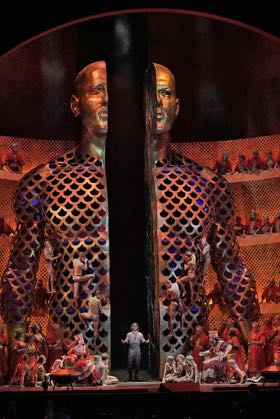
Temple to the god Dagon, with Samson
All photos copyright Ken Howard / Met Opera
It was the final performance of the premiere season of Darko Tresnjak’s production of Camille Saint-Saëns' Samson et Dalila. Four tenors later.
Serbian born American theater director Darko Tresnjak envisioned a production with the look of a nickelodean (maybe you put your nickel in and out comes “Mon coeur s’ouvre à ta voix”). Or maybe he was thinking of a slot machine (bet with the odds that the tenor can’t make it to the end). He did like shiny, flowing pale blues and pinks for the intimate scenes within his arched scenic structure, intense reds and metallic blues for the big scenes trusting perhaps that these shapes and colors were enough to tell the story.
What the Met did do right was hire English conductor Mark Elder to expose the magnificence of the Metropolitan Opera orchestra, and to motivate the glories of the Met chorus whose opening scene reeked with overt Baroque-esque, old testament Romantic musical profundities that gave us enormous pleasure.
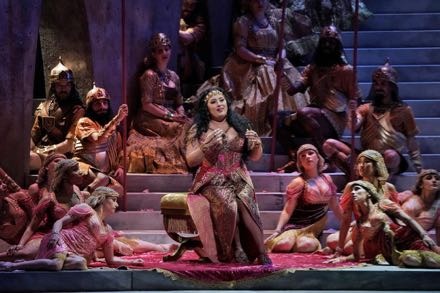
Anita Rachvelishvili as Dalila
The stifling symmetry of Broadway designer Alexander Dodge’s scenic structure placed the singers squarely center stage for their big numbers where the artists of the evening did their best to measure up to the symphonic magnificence rising from the pit. Georgian mezzo soprano Anita Rachvelishvili well held her own in powerful voice though I missed a warmth of sensual phrasing in her two famous second act arias. A well-known Carmen Mme. Rachvelishvili did find plenty of fire in her confrontations with Samson and the High Priest.
Lithuanian tenor Kristian Benedikt, who last fall was called upon to finish the opera when tenor Roberto Alagna gave up after the second act, was the Samson at this performance (his only full performance in this 2018/19 run). Mr. Benedikt did make it all the way to the end, though he encountered some rough patches in the second act. Both his first and third act arias were beautifully rendered, his fine tenor holding strong tone to their conclusions. However in the second act and the final scene of the opera his persona and voice were swallowed into the grander trappings of the staging.
The High Priest of Dagon was sung in all thirteen performances by bass-baritone Laurent Naouri in easily distinguishable French though his delivery did not rise to the musical elegance of Saint-Saëns' score and Mo. Elder’s conducting. Note also that the back-of-seat “super” titles (very hard to see) were offered in German and Spanish. Why not French, as it is, after all, the language of the opera?
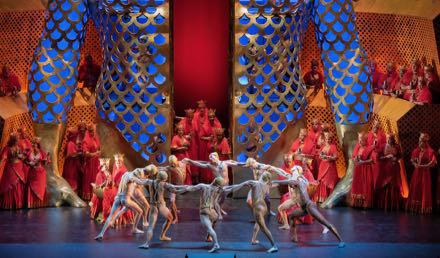
Male dancers of the corps de ballet
Besides the splendid second act arias the famed part of Saint-Saëns' masterwork is the third act orgy that culminates in the destruction of the pagan temple. Ten almost naked ballerinos and eight ballerinas executed a complex choreography conceived by Austin McCormick, artistic director of Brooklyn’s Company XIV. The unballetic style was Martha Graham avant gardesque, a look that flowed uneasily with the grander formal structures of the Saint-Saëns' score.
Despite the thunderous percussion climax the short circuit electric flash within Mr. Tresnjak's nickelodeon did not satisfy as Samson’s crowning moment of superhuman strength. Mr. Tresnjak’s staged oratorio setting of Saint-Saëns' score would have profited from some operatic context.
Cast and production
Dalila: Anita Rachvelishvili; Samson: Kristian Benedikt; Abimélech: Tomasz Konieczny; High Priest of Dagon: Laurent Naouri; First Philistine: Eduardo Valdes; Secon Philistine: Jeongcheol Cha; A Philistine Messenger: Scott Scully; An Old Hebrew: Günther Groissböck. Chorus and Orchestra of the Metropolitan Opera. Conductor: Mark Elder; Production: Darko Tresnjak; Set Designer: Alexander Dodge; Costumes Designer: Linda Cho; Lighting Designer: Donald Holder; Choreographer: Austin McCormick. Metropolitan Opera, New York, March 28, 2019.
It's a Wonderful Life at San Francisco Opera
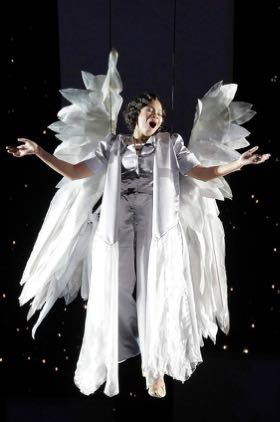
Golda Schultz as the guardian angel Clara
All photos copyright Cory Weaver, courtesy of San Francisco Opera
It was 1946 when George Bailey of Bedford Falls, NY nearly sold himself to the devil for $20,000. It is 2018 in San Francisco where an annual income of ten times that amount raises you slightly above poverty level, and you’ve paid $310 for your orchestra seat to Jake Heggie and Gene Scheer’s It’s a Wonderful Life.
Maybe you’ve seen the 1946 film It's a Wonderful Life. It seems many of you have, maybe most of you, and it seems that Jake Heggie and San Francisco Opera know you are yearning to return to that simpler time when the housing crisis was easily solved by simple community economics, big government was no where to be seen or felt, and winged Christian angels, like the one once atop your Christmas tree, watched over you. And, well (there can be no doubt), you are Christians and that prayers actually worked.
Though you once might have dreamt about college and a larger world, the world of Bedford Falls, NY is already pretty big in itself, or big enough to satisfy the ambitions of a good husband and father and citizen. When an outside evil intrudes (the “yellow peril”) you hold a spine-chilling rally to "Make America Great" again.
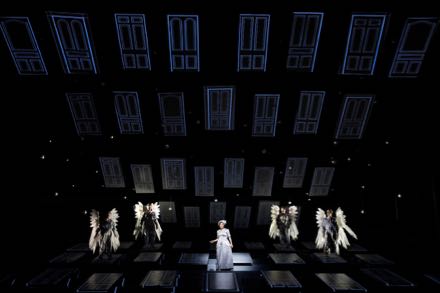
Set design by Robert Brill, costume design by David C. Woolard
Mr. Heggie and Mr. Scheer’s It’s a Wonderful Life is a tight (it enjoyed a gestation period in Bloomington and Houston before arriving at the War Memorial), beautifully crafted opera that tells its story in high operatic terms — it is a string of lyric moments woven into compelling, if trivial episodes that propel us to a final crisis that even the opera’s hero, George Bailey of Bedford Falls, NY learns is trivial — that it’s not worth killing yourself over $8000 ($111,000 in today’s dollars).
Mr. Scheer proved himself a brilliant librettist in his masterful adaptation of the Great American Novel Moby Dick for composer Heggie. Jake Heggie himself now has resolutely proven himself the Great American Composer with It’s a Wonderful Life, following Moby Dick and Dead Man Walking, works that embody the American spirit in flowing, intensely lyrical, American middle high-art musical terms. In It’s a Wonderful Life Mr. Heggie exploits the richness of American vaudeville, and dwells incessantly on the mannerisms of the American musical as well. Startlingly the opera begins with an ear-splitting imitation of the primitive sound of postwar movie theater amplification.
The opera’s coup de théatre is the moment George Bailey understands that if he had never existed there would be no music. It becomes a spooky, spoken world that makes us encourage George to quickly get back to the world of everyday problems that you can easily sing about — eschewing, of course, any whiff of the psycho-sexual violence that is the meat of real opera.
But wait. There was a second coup de théâtre and that was an urge to sing "Auld Lang Sang" that gripped us all when George at last hugged his wife and kids standing before a brilliantly lighted Christmas tree under the loving gaze of his suspended Guardian Angel. Well, we all belted it out with the maestro before leaping to our feet to salute the very fine artists and the excellent production.
Orchestrally It’s a Wonderful Life is scored for single winds (except two horns) and strings making it easily accessible for smaller holiday productions in regional theaters. On the other hand there can be no doubt that It’s a Wonderful Life will find international success in theaters throughout the world as a throbbing example of Americana.
Though of great sophistication the production by Leonard Foglia and Robert Brill was quite simple — a unit set of countless, identical floating panels that were doors, maybe tombs, other times wallpapered panels, floors, clouds that were heaven, streets, etc. The angels in heaven were breathtakingly flown in from the celestial spheres of the War Memorial fly loft. Costuming was the period of the film (1946).
There was considerable choreography, some maybe expertly fronted by dancers of the San Francisco Opera Ballet, but mostly executed by the principals together with 28 members of the San Francisco Opera Chorus, presumably chosen for their lithe bodies to fit the costumes of students of Bedford Falls High School and then the not-too-well-fed Irish and Italian immigrants that lived on the other side of the tracks.
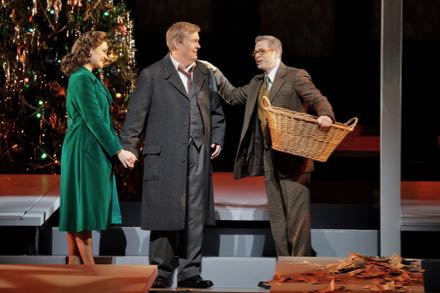
Andriana Chuchman as Mary Hatch, William Burden as George Bailey,
Keith Jameson as Uncle Billy Bailey
The casting for the production made its bow to multi-culturalism by casting George Bailey’s guardian angel Clara [as in The Nutcracker] with the South African soprano Golda Schultz who set the standard for the high-level vocal performances that characterized the evening. American baritone William Burden successfully embodied the young George Bailey to then become the distraught middle aged banker and the loving husband. Canadian soprano Andriana Chuchman brought force and beauty of voice to create George’s emotional anchor, his wife Mary Hatch (who did escape to New York but came right back to Bedford Falls to create a home for George).
Confined to a wheelchair as the crooked businessman Mr. Potter, Los Angeles bass-baritone Rod Gilfry exuded greed and selfishness, his wheelchair coldly and calculatedly guided by the production’s one supernumerary. George’s brother Harry who does go off to college was sung by Canadian baritone Joshua Hopkins with vibrant presence. Genuinely batty Uncle Billy was aptly played by Keith Jameson, and George’s mother found big prominence as sung by San Francisco mezzo soprano Catherine Cook.
There are 34 named roles in It’s a Wonderful Life. Of the principals identified above Mr. Burden, Mr. Gilfry and Mr. Hopkins survive from the Houston cast. Conductor Patrick Summers from the Houston Opera ably helped the singers carve out their roles, evoking suitable orchestral pizazz.
Disclaimer: I have not seen the Frank Capra film, It’s a Wonderful Life.
Wise opera goers could pay $10 for standing room for the brief 2 1/2 hours that fly by fairly quickly, though you may wish to suggest a few economies to Mr. Heggie.
Cast and production
Clara: Golda Schultz; Angels First Class: Sarah Cambidge, Ashley Dixon, Amitai Pati, Christian Pursell; George Bailey: William Burden; Harry Bailey; Joshua Hopkins; Uncle Billy Bailey: Keith Jameson; Mother Bailey: Catherine Cook; Mary Hatch: Andriana Chuchman; Mr. Potter: Rod Gilfry; Helen Bailey: Carole Schaffer. Chorus and Orchestra of the San Francisco Opera. Conductor: Patrick Summers; Stage Director: Leonard Foglia; Set Designer: Robert Brill; Costume Designer: David C. Woolard; Lighting Designer: Brian Nason; Projection Designer: Elaine j. McCarthy; Choreographer: Keturah Stickann. War Memorial Opera House, San Francisco, November 20, 2018.
Arabella at San Francisco Opera
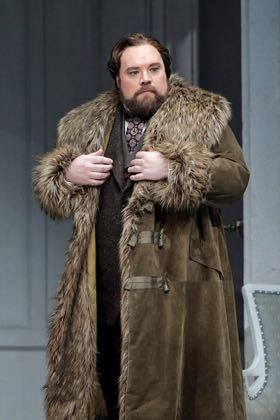
Brian Mulligan as Mandryka
All photos copyright Cory Weaver, courtesy of San Francisco Opera
A great big guy in a great big fur coat falls in love with the photo of the worldly daughter of a compulsive gambler. A great big conductor promotes the maelstrom of great big music that shepherds all this to ecstatic conclusion.
Austrian dramatist Hugo Von Hofmannsthal, Arabella’s librettist, was nothing if not worldly and post WWI Vienna was nothing if not indulgent. This made rich ground for Richard Strauss to plow, playing seriously with Romantic ideals of love while toying with the poetic pastoralism of the Germanic Hellenistic revival, and indulging in the modernist zeal for dissecting reality.
It all became quite a celebration last night on the War Memorial stage at the first performance (of five) of this rarely performed example of the Strauss canon. The revelry was in the pit, the mighty San Francisco Opera orchestra unleashed by conductor German conductor Marc Albrecht in his American debut. Undaunted with only 67 players in the pit, a far cry from Elektra’s 100 or so, the maestro drove the score as if it had the richness and the urgency of Elektra’s obsession. The spectrum of colors, the motivic details, the phrasings and the volumes (considerable) that the maestro exploited did indeed verify masterpiece status if not outright awe for the score. They also made me long for singers and production that might equal such musical monumentality.
The well-traveled production (Toronto, Santa Fe, Minneapolis) by British director Tim Albery instead traded on the minimal. The sets and costumes by German designer Tobias Hoheisel were of utmost simplicity, a series of small, monochromatic, curving architectural elements of subdued classical detail construed the three spaces of von Hofmannsthal’s fin de siècle hotel. Von Hofmannsthal respects the Aristotelian unities — the opera happens before, during, and after a ball in the hotel — thus Mr. Hoheisel’s costuming has limited requirements, easily incorporating abstractions of fin de siècle opulence.
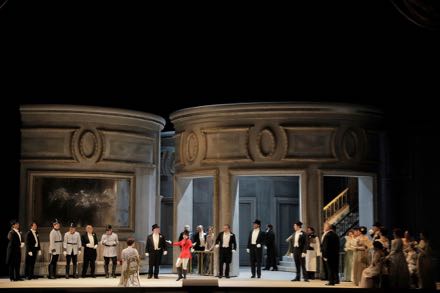
Hye Jung Lee (in red) as the ball mascot Fiakermilli
Director Albery moved his actors minimally, just enough to fulfill the musical and textural needs of the score. Every gesture was carefully measured to be an elegant surface motion that masked the musical compulsions underneath. It was smooth, indeed exquisite staging effected by a willing cast.
Like all Strauss female roles, Arabella too is vocally daunting. Most difficult are the moments of sublime beauty when the soprano floats an above the staff phrase over and beyond its apex, as had Strauss’ Marschallin. Then there are extended passages of longing, regret, reconciliation and finally ecstasy that sail through and above rich and soaring orchestral outpourings. Above all Strauss’ Arabella must be a beautiful woman who projects honesty and simplicity and compassion, and forgiveness for those who betray her. San Francisco Opera house soprano Ellie Dehn confronted the challenges of the role and largely succeeded, often rising to the monumentality imposed by the maestro.
Though Strauss loves most of all to exploit the female voice, in Arabella he challenges the endurance and the emotional spectrum of the baritone voice. Mandryka who has chosen Arabella to be his wife, made a bloodstained photo of Arabella his talisman for recovery after he was mauled by a bear. San Francisco Opera house baritone Brian Mulligan did not survive his first act explanation of all this, victim of the maestro who demanded a more experienced Strauss voice and more imposing presence to musically fulfill the Straussian ideal. Mr. Mulligan does possess a quite beautiful voice whose limits however were clearly exposed.
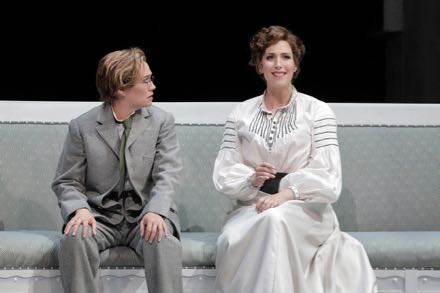
Heidi Stober as Zdenko, Ellie Dehn as Arabella
Von Hofmannstahl twisted the swain from pastoral poetry into a cross dressed soprano, here San Francisco Opera house soubrette Heidi Stober who gave a quite effective account of Zdenka who loves Arabella’s rejected suitor Matteo, however Zdenka is first known as the boy Zdenko who is Matteo’s best friend (you had to be there). Mme. Stober’s charming trouser role presence abetted by fine singing well matched the maestro’s need for a big house, tongue-in-cheek shepherd/ess. The Matteo of Swedish tenor Daniel Johansson held his own in the melee. Though missing the warm vocal colors to create the ideal Straussian swain he did project appealing musical energy.
Well cast as the Countess Waldner, mezzo soprano Michaela Martens made Arabella’s mother quite sympathetic in her enthusiastic support of the ruinous gambling addiction of her husband, Count Waldner sung by Richard Paul Fink.
The balance of the cast — three more suitors, plus the Fiakermilli — conformed to the in-house casting policy for this Arabella. The suitors were drawn from the Adlers (San Francisco Opera’s operatic finishing school) or equivalent. The Fiakermilli, usually a cameo role taken by an accomplished Ariadne Zerbinetta, was sung by former Merola participant Hye Jung Lee.
Cast and production information:
Arabella: Ellie Dehn; Zdenka: Heidi Stober; Countess Waldner: Michaela Martens; Fiakermilli: Hye Jung Lee; A fortune teller: Jill Grove; Mandryka: Brian Mulligan; Matteo: Daniel Johansson; Count Waldner: Richard Paul Fink; Count elemer: Scott Quinn; Count Dominik: Andrew Manea; Count Lamoral: Christian Pursell. Chorus and Orchestra of the San Francisco Opera. Conductor: Marc Albrect; Stage director: Tim Albery; Production designer: Tobias Hoheisel; Lighting Designer: David Finn. War Memorial Opera House, San Francisco, October 16, 2018
Cavalleria rusticana and I pagliacci at San Francisco Opera
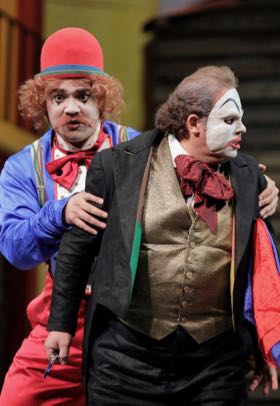
Amitai Pati as Beppo, Marco Berti as Canio
All photos copyright Cory Weaver, courtesy of San Francisco Opera
Pietro Mascagni’s Cavalleria Rusticana won first prize in the 1888 Casa Sonzogno’s [a once famous Italian publisher] competition for a new, one-act opera, Ruggero Leoncavallo saw the need to complete an evening of nascent verismo and rushed to fill it, thus I pagliacci! San Francisco Opera’s current edition of these two rather naive masterpieces will not win any prizes.
In 2012 Argentine tenor José Cura sang both Mascagni’s Turiddu and Leoncavallo’s Canio in Liège (a city of about 200,000 inhabitants in southeast Belgium), a feat he first accomplished in 2006 at the Arena di Verona. In Liège Mr. Cura staged the double bill as well, and designed its sets and costumes. Other times Mr. Cura has been known to stage and design and conduct operas all at once.
San Francisco Opera’s new general director Matthew Shivlock imported this production. though without the 56 year-old tenor, assigning directorial duties to another Argentine, José Maria Condemni, a staff director at SFO. Of questionable artistic value the assumption is that the production was imported because it was a bargain — one small set serving two operas.
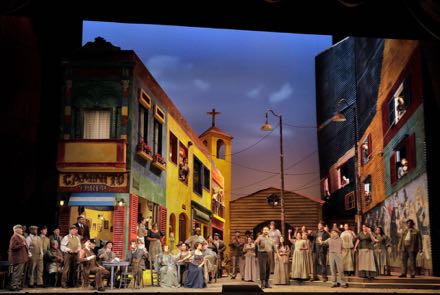
The Argentine tenor made the two operas into two bloody moments in the lives of the inhabitants of one primary-colors hued Argentine village square (program notes tell us it’s a neighborhood in Buenos Aires) complete with the ever present hispanic street wall mural. The characters of both operas are the villagers who hang out in the cafe that serves copious wine to both operas. Yes, that was Pagliacci tenor Marco Berti (Canio) sitting at a table at the beginning of Cavalleria. In a questionably inspired directorial moment Mamma Lucia pre-empted the clown Tonio’s famous “la commedia è finita” at the end of Pagliacci (Turiddu’s mother was also Silvio’s mother thus this attempt at a crude pathos well outside Mascagni’s intention).
The casting of this San Francisco Opera production was just what you might expect for an opera in a provincial city in Argentina — take whoever you can get resulting in the bizarre (Ekaterina Semenchuk as Santuzza), the right-on (Marco Berti as Canio and Adler Fellow Amitai Pati as Beppo), the willing (baritone David Pershall’s silent, very charismatic Cavalleria cafe waiter though pallid Pagliacci Silvio). From the louder-the-better casting principle came the Turiddu of Roberto Aronica and the Alfio/Tonio of Dimitri Platanias. Local and quite serviceable if stylistically inapplicable were the Mamma Lucia of Jill Grove and the Lola of Laura Krumm.
Further example of catch-as-catch-can casting was former Adler Fellow Toni Marie Palmertree as Nedda, filling in for the ailing Lianna Haroutounian. Mlle. Palmertree sang very nicely indeed but in no way can be transformed into verismo prima donna even in dire circumstances.
It was an “international” cast (Russian, Greek, Italian, Armenian, New Zealand, American, plus a latino paper boy). Over the years stage director Condemni has proven himself very competent but even he evidently could not pull all these identities into an Argentine much less Italian stylistic whole, nor organize them into working together to tell a coherent story.
Italian conductor Daniele Callegari whipped the San Francisco Opera orchestra into giving a full-throated not to say bombastic account of these tuneful scores. The maestro remained unconcerned that the San Francisco Opera chorus had learned phrasing that was inconsistent with his musical take on early verismo. If you think tenor Marco Berti belted out a beautifully sung and stylistically acceptable Canio (I did, and enjoyed his performance) the evening’s complementary roles, Turiddu and Alfio/Tonio were miles away from convincing verismo, remaining loud, wooden imitations at best.
Tosca at San Francisco Opera
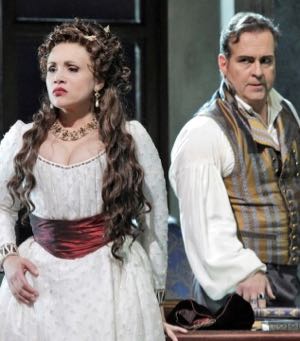
Carmen Giannattasio as Tosca, Scott Hendricks as Scarpia
All photos copyright Cory Weaver, courtesy of San Francisco Opera
The story was bigger than its actors, the Tosca ritual was ignored. It wasn’t a Tosca for the ages though maybe it was (San Francisco’s previous Tosca production hung around for 95 years). P.S. It was an evening of powerful theater, and incidentally it was really good opera.
Whether by design or accident the pairing of British conductor Leo Hussain with American stage director Shawna Lucey resulted in a synergy of theatrical perspective and musical vision that rarely occurs. Conductor Hussain comes from new music, thus he hears this oft repeated score with new ears, sensing and amplifying subtle atmospheres, stabbing with sudden emphasis an orchestral color that embody a word or phrase uttered the stage, carefully erecting the intimacies of the arias and ariosos, pacing the confrontations with unhurried deliberation, settling on sonic brutality with with cold force. Musically this Tosca was conducted as a new-music score to be laid out in detail, take it or leave it.
Stage director Lucy was in complete sympathy, laying out a detail of staging to embody every action of the libretto in minute precision, then embellishing the libretto and music with additional narrative detail to create a seemingly impromptu context for the action and to make the surroundings seem like a everyday spaces where shit probably does sometimes happen. The richness of narrative context for this Puccini score was of a nineteenth century novel, certainly of a twentieth century romance, and most of all a twenty-first century made-for-television movie.
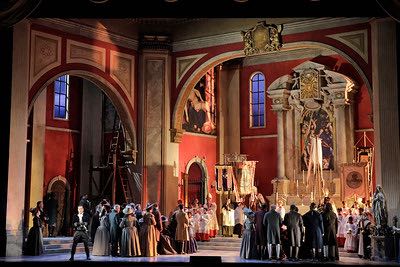
The Te Deum
British designer Robert Innes Hopkins obliged with a first act set that cannily caught the details of the austere spaces and the coldness of Rome’s St. Andrea della Valle (in spite of the vivid red wall) but focused his space into a corner where the story could begin in its sordid detail. The Palazzo Farnese of the second act took place not in a grand room of state but in a messy, lesser room, once again in a corner perspective for intimacy. The palace’s Renaissance grandeur was marred by the detail of an art nouveau facade of a shadow box side-room (yes, the torture room!). The upward swirl of the Sant-Angelo fortress was topped by its sword-bearing Bernini-esque statue (brutal Renaissance art works were a visual focal point in each act).
The Bernini statue however hid our view of a presumed Tosca leap from the heights of the fortress — the final abnegation of the Tosca ritual that had been enacted 175 times on the War Memorial stage over the past 95 years. Tosca herself of this iconic operatic ritual is a diva, and we’ve seen absolutely every great Tosca of opera’s golden era (except Maria Callas who canceled) leap the thirty feet from the top of the old Agnini/Bosquet set to the War Memorial floor. Until now.
Our current Tosca, Italian soprano Carmen Giannattasio is not a diva, rather she is a Roman soprano who has caught the fancy of a lusty Roman policeman, Scarpia, American baritone Scott Hendricks, who made the “hard pulse of his arousal” quite apparent. Cavaradossi, American tenor Brian Jagde, is a good-spirited painter who unfortunately is involved a bit in politics, and has a young friend, Angelotti who was beat up by partisan thugs. These were real people, made real, in fact, because they were excellent singers, and could be, possibly, exactly who they are.
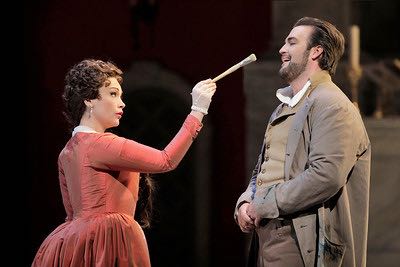
Carmen Giannattasio as Tosca, Brian Jagde as Cavaradossi
Of course it was Puccini’s Tosca and that too was always apparent, and this was the magic of the production. Tenor Jagde delivered his two arias with a delicacy of feeling and a mastery of Italianate technique that I did not know he possessed. Soprano Giannattasio gave her great aria supine on the stage floor, and scaled the many heights of the role with a convincing bel canto lyricism that comfortably rode Puccini’s verismo. Baritone Hendricks exposed his desire in true bel canto (say what you want but say it beautifully) and simultaneously convinced us of its urgency. Bass-baritone Hadleigh Adams’ Angelotti was sonorous, made even more operatic by his operatic limping (not always the same leg).
Further intelligence about the production: the voices of the boy acolytes of the first act were amplified by the voices of their mothers, perhaps present to protect the boys from predators (hardly Dale Travis’ ageless, sweet old sacristan). The first act question we always ask (just who is this Countess Attavanti?) was finally answered — she showed up at the end of Scarpia’s Te Deum, was abducted by Scarpia’s thugs, and reappeared looking a bit used when the second act curtain opened onto Scarpia’s office. Tosca did fortify herself with a gulp of wine after murdering Scarpia, placing but two candles by his lifeless body to the absolutely eery, creepy music rising from the pit. The faraway shepherds music of the third act was enacted by boys atop Sant’Angelo who cutely pretended to be soldiers executing one of their own.
We were gripped by the story, and satisfied by the singing. It was an auspicious debut of the Tosca set that we will see in countless editions, possibly throughout the remainder of this century. Catch it while it’s fresh.
Cast and production
Floria Tosca: Carmen Giannattasio; Mario Cavaradossi: Brian Jagde; Baron Scarpia: Scott Hendricks; Cesare Angelotti: Hadleigh Adams; A sacristan: Dale Travis; Spoletta: Joel Sorensen; Sciarrone: Andrew Manea; A shepherd boy: Miles Kaludzinski. Chorus and Orchestra of the San Francisco Opera. Conductor: Leo Hussain; Stage director: Shawna Lucey; Production designer: Robert Innes Hopkins; Lighting designer: Michael James Clark. War Memorial Opera House, San Francisco, October 11, 2018.
Roberto Devereux at San Francisco Opera
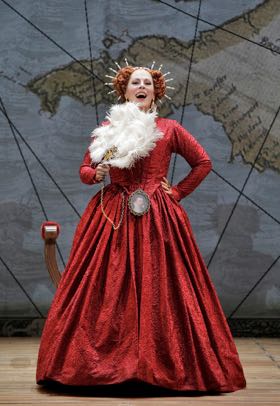
Sondra Radvanovsky as Elizabeth I
All photos copyright Cory Weaver, courtesy of San Francisco Opera
Opera’s triple crown, Donizetti’s tragic queens — Anna Bolena who was beheaded by her husband Henry VIII, their daughter Elizabeth I who beheaded her rival Mary, Queen of Scots and who executed her lover Roberto Devereux.
Donizetti traversed these sordid histories in 8 years (from 1830-1838). It took San Francisco Opera 13 years (Joan Sutherland as Maria Stuarda in 1971, Monserrat Caballé as Elizabeth I in 1978, and Joan Sutherland as Anna Bolena in 1984). Of course a couple of years ago the mighty Met managed to mount the whole bloody history in a few mere months.
This is opera history and Donizetti’s queens are opera history, rather history according to opera. There is no question which history is more real and true — crumbling parchment documents and a few words etched in stone from long ago or the delicate intimacies and huge tantrums that flew off the War Memorial stage last night at the final (of six) performances of Roberto Devereux. Donizetti’s bel canto miraculously achieved the Apollonian ideal — raw emotion absorbed into high art.
Soprano Sondra Radvanovsky portrayed history’s most terrifying queen in terrifying intricacies of voice, high d’s surreally emerging from nowhere to cap thrilling ascents of tortured lines, then other moments of descending lines, stepwise and sorrowfully slow. La Radvanovsky’s Elizabeth is terrifying, a persona of monumental presence, of absolute authority terrorised by love, a persona that is fully aware of her regal power, exuding the pleasure of executing astonishingly difficult vocalism, and surely of holding the 3000 spectators in the War Memorial in her thrall.
And a persona willing to fully suffer the torment of losing those she most loves, Roberto Devereux whom she blindly loves and the woman Devereux loves, her confident Sara.
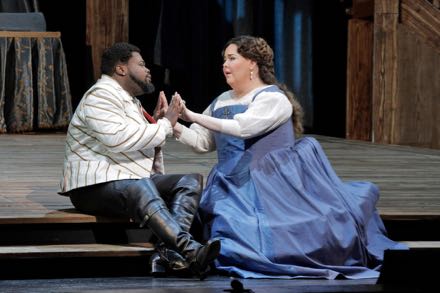
Russell Thomas as Devereux, Jamie Barton as Sara
Elizabeth is hardly the only one to suffer. Sara’s husband, the Duke of Nottingham is Devereux’s best friend who must reconcile his love for and trust of his wife with his love and respect for his friend. Sara must reconcile her love for the queen with being her rival for Devereux’s love, and Devereux must reconcile his political and blatant personal betrayals of absolutely everyone with himself. So there is a lot to sing about.
And sing and suffer they do. After three hours of trying no one reconciled much of anything, to our very great pleasure. It was indeed an evening of bel canto! Italian conductor Riccardo Frizza established an unwavering dramatic pace that drove the betrayals and at the same time offered the protagonists all freedom to expand each moment of elation or despair and all gradations of joy and suffering in between. It was an all-too-rare conductorial achievement in parsing the emotional machinations of this difficult repertoire.
The voices of the protagonists were carefully matched. The all American cast was in prime vocal condition, and musical preparation was stylistically consistent. All voices were indeed beautiful, befitting the essence of bel canto. If the Radvanovsky sound is magisterial, mezzo-soprano Jamie Barton as Sara added the freshness of voice of a young woman in love. Tenor Russel Thomas as Roberto Devereux produces a limpid yet lush tenor sound throughout his full register, including its stratospheric tenorino reaches. In such company Adler Fellow Andrew Manea as the Duke of Nottingham strangely was not over parted. If his youth was obvious, his authority of presence, his command of style and use of his quite beautiful voice were formidable.
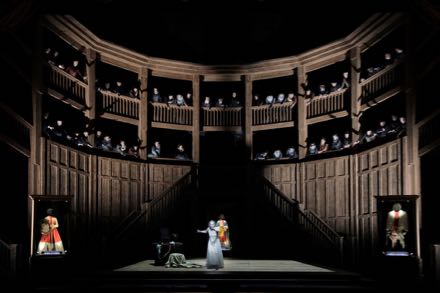
Sondra Radvanovsky as Elisabetta in final scene
The well traveled production by British director Stephen Lawless belongs to Canadian Opera. Mr. Lawless took his cue from Donizetti’s quote of “God Save the Queen” in the overture to attempt to create levity, if not caricature of opera history. The surround was the galleries an Elizabethan theater indicating, I suppose, that we need not assume what we saw happen on the center stage acting platform was true or real, that it was, after all, only opera. There was a multitude of cute staging tricks that tried to keep us distanced from the distraught, often overwrought protagonists. They did not. We suffered.
That the production is not distinguished was of little importance to this evening. Mme. Radvanovsky grounded the production in high bel canto style that easily overcame all directorial conceits. This unique artist had the support of a well qualified cast. With Maestro Frizza we, right along with this distinguished cast, enjoyed a splendid evening of opera history.
Cast and production
Elisabetta: Sondra Radvanovsky; Roberto Devereux: Russell Thomas; Lord Cecil: Amitai Pati; Sir Walter Raleigh: Christian Pursell; Sara: Damie Barton; A page: Ben Brady; Duke of Nottingham: Andrew Manea; Nottingham’s servant: Igor Vieira. Chorus and Orchestra of San Francisco Opera. Conductor: Riccardo Frizza; Director: Stephen Laless; Set Designer: Benoit Dugardyn; Costume Designer: Ingeborg Bernerth; Lighting Designer: Christopher Akerlind. War Memorial Opera House, San Francisco, September 27, 2018
Das Rheingold at San Francisco Opera
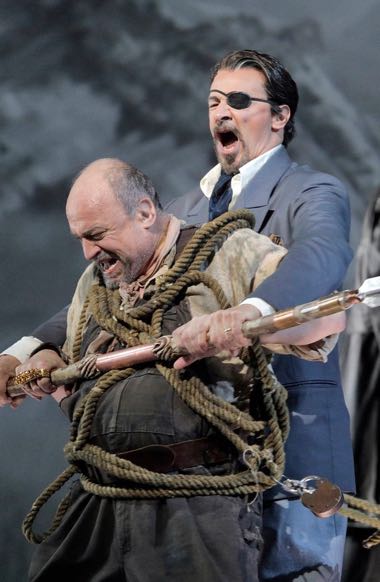
Falk Struckmann as Alberich, Greer Brimsley as Wotan
All photos copyright Cory Weaver, courtesy of San Francisco Opera
Alberich’s ring forged, the gods moved into Valhalla, Loge’s Bic flicked, Wagner’s cumbersome nineteenth century mythology began unfolding last night here in Bayreuth-by-the-Bay.
Ring fever was high in the rather-more-than-usual well-dressed, quite excited crowds (standees three deep) present for the first part of the famous tetralogy of three operas plus satyr play (that’s Das Rheingold).
Though first, Rheingold was the last of the tetralogy composed, thus Wagner had already forged the means to taunt us with the magic fire music that will protect us and finally consume us this Sunday, fire that issued full force from the mighty forces of the superb San Francisco Opera Orchestra of ninety players — curious ears were cocked for four Wagnerian tubas. Conductor Donald Runnicles, of the 2011 San Francisco Ring again sustained a convincing Wagnerian continuum.
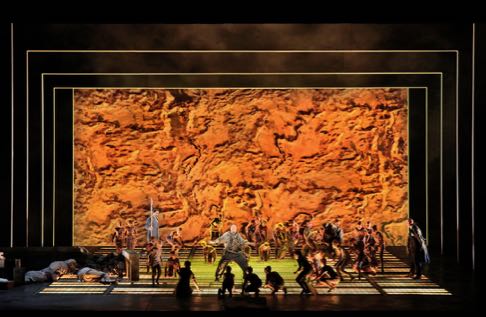
A moment in the Nibelungen workshop
Back in 2008 when Francesca Zambello’s 2006 Rheingold was unveiled here in San Francisco the chorus of anvils (last night six off-site players hammered 15 tuned anvils) was prelude to a surprising, indeed stunning vision of the Nibelungen workshop with its multitude of child workers (this was the Industrial Revolution after all). For many of us this was the third time for this revelation, hopefully it once again thrilled those new to this production.
In pre-opening press events care was taken to stress important modifications to the original production, specifically the recasting of many of the proscenium wide videos that now impose video designer S. Katy Tucker’s take on Richard Wagner’s gloriously imposing soundscapes, beginning with the visual play of vastly magnified water molecules intended to introduce the theme of environmental destruction, an important element of the Zambello production.
As well digital technology in more recent years has added stage floor video and lighting possibilities to scenography. This was present in the checkerboard of video screens that was now the stage floor pavement offering the intrusion of ever greater color interpretation. Perhaps an unintended theme to Mme. Zambello’s production will be the tyranny of technology.
The most significant addition to the production is the splendid cast that was introduced to us last night starting with the elegant and cocky shyster Wotan of bass baritone Greer Grimsley. Mr. Grimsley’s well-focused voice promises us an unusually articulate Wotan who has a lot of tough stuff to come to grips with in the next two operas. Of startling effect was the Alberich of German bass baritone Falk Struckmann in his role debut. Mr. Struckmann, once a formidable Wotan himself, was of well-voiced, sufficiently evil stature to forge an amazing weapon of destruction (the ring) and impose its use (his curse).
Dominating the proceedings was the Loge of Czech tenor Stefan Margita (a veteran of the 2008 production in his role debut) — oh so charming, impertinent, supercilious and oh so profoundly cynical. Mr. Margita’s Rheingold Loge was of masterpiece status.
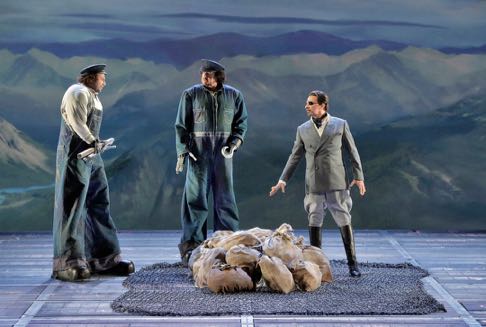
Fafner, Fasolt and Wotan
The Zambello Rheingold coup de théâtre is of course the builders of Valhalla, the giants (literally) Fasolt and Fafner. Fasolt, sung by baritone Raymond Aceto (tonight’s Hunding) is smoother and a bit smarter than Fafner, sung by bass Andrea Silvestrelli in a rough and dumb voice. Directorially his mutual infatuation with Freia, beautifully sung by the aspiring dramatic soprano Julie Adams, was ostentatiously overstated. Tenor Brandon Jovanovich (tonight’s Siegmund) added fun, empty-headed personality to Wagner’s conceited gods as Froh, and baritone Brian Mulligan redeemed his pallid Donner with a splendidly delivered command of the storm that clears the skies for a vision of Valhalla (unseen).
Mezzo soprano Jamie Barton as Wotan’s wife Fricka has yet to prove herself. That she may do tonight in Die Walküre. Plus we will find out on Friday much more about the Mime of David Cangelosi.
Some of the locales of this first installment of the “American” Ring seemed less specific. Huge billows of stage fog obliterated what I remembered as a gold prospector’s gully, and now the Rhine maidens were burdened with cumbersome, self conscious choreography. As the Rhine valley the Gilded Age ambience of the Newport R.I. was fully intact.
Mme. Zambello did not take a bow.
Cast and production information:
Wotan: Greer Grimsley; Alberich: Falk Struckmann; Loge: Stefan Margita; Mime: David Cangelosi; Froh: Brandon Jovanovich; Donner Brian Mulligan; Fasolt: Andrea Silvestrelli; Fafner: Raymond Aceto; Fricka: Jamie Barton; Freia: Julie Adams; Erda: Ronnita Miller; Woglinde: Stacey Tappan; Wellgunde: Lauren McNeese; Flosshilde: Renée Tatum. San Francisco Opera Orchestra. Conductor: Donald Runnicles; Production/Stage Director: Francesca Zambello; Associate Director and Choreographer: Denni Sayers; Set Designer: Michael Yearden; Costume Designer: Catherine Zuber; Lighting Designer: Mark McCullough; Original Projections: Jan Hartley; Additional Projections: S. Katy Tucker. War Memorial Opera House, San Francisco, June 12, 2018.
Die Walküre at San Francisco Opera
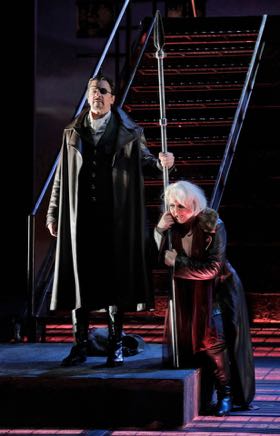
Greeer Brimsley as Wotan, Iréne Thoerin as Brünnhilde
All photos copyright Cory Weaver, courtesy of San Francisco Opera
The hero Siegfried in utero, Siegmund dead, Wotan humiliated, Brünnhilde asleep, San Francisco’s Ring ripped relentlessly into the shredded emotional lives of its gods and mortals. Conductor Donald Runnicles laid bare Richard Wagner’s score in its most heroic and in its most personal revelations, in their intimacy and in their exploding release.
This was an evening of almost unbearable tension, the age old torment of love vs. duty taken to the summit of nineteenth century operatic accomplishment — and into the higher reaches of twenty-first century staging accomplishment, from the fleeting video image of a wolf to Hunding’s Appalachian cabin, from Valhalla’s sweeping vista of a crumbling black and white world to its monumental cementic bowels, and finally to the Zambello Walküre’s signature image, the valkyries parachute arrival onto a mountain peak, a peak that then burst into a circle of actual, live flame.
Far more than about its timely concepts (the “American” Ring, American environmental destruction, the abuse and subjugation of women), last night’s Walküre was about opera. It fully exposed the current artistic and technical resources that allow twenty-first century opera to transcend mere theater and operatic tradition itself to transport us to ever rarer states and durations of artistic understanding.

Wotan and Brünnhilde
American bass-baritone Greer Grimsley’s Wotan, no longer the confident deal maker of Das Rheingold, was the sleek executive whose world began disintegrating when he took on its administration. Mr. Grimsley had hugely difficult encounters — with his wife Fricka, with his daughter Brünnhilde, and with himself when he learns that is daughter is, in fact, an extension of himself. Mr. Grimsley survived each encounter in magnificent voice, articulately humbling himself step-by-step to his very human and quite understandable and inescapable torment.
Swedish soprano Iréne Theorin, the valkyrie Brünnhilde burst onto the stage in a torrent of magnificent sounds that put to rest any regrets we may have harbored about the cast change (Evelyn Herlitzius cancelled at the last minute). Mme. Theorin brought the fiercely thrilling high notes of an Amazon warrior together with a richly warm, very feminine lower voice. With her significant use of piano and pianissimo tones this richness distilled her determined devotion to her father. But never far away were the forte’s of an emotional strength to be reckoned with.
The Fricka of American mezzo-soprano Jamie Barton eschewed the dignity that becomes the protector of basic family law not to mention protector of basic dynastic rights. Mlle. Barton continued her contemptuous, comedic Das Rheingold Fricka, thereby eviscerating the sanctity and solidity of the social contracts that bedevil Die Walküre’s Wotan. There is no question that Mlle. Barton is a fine singer, that she created a significant Die Walküre Fricka is another question.
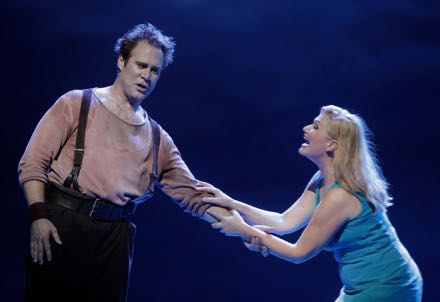
Siegmund and Sieglinde
There is no question that Finnish soprano Karita Mattila created a Sieglinde of requisite magnitude for the Zambello Walküre. The magnetic presence of this esteemed artist found the youth and the postures of an abused woman, her marital guilts and finally her pride as the wife of her brother and the mother of his child. It was a portrayal teetering on the edge of, somehow not surpassing, credibility — no small task for her adultery and incest. That Mme. Mattila could vocally create Sieglinde is another question.
American tenor Brandon Jovanovich brought perfection to his Siegmund, finding and exploiting the subtleties of the Wagnerian vocal line that gave immense, and new pleasures. Siegmund is a romantic hero with stories to tell. Jovanovich has the purity of voice to exploit the emotional innocence of Siegmund's adventures, and to fall victim to his hopeless love and to die for this love. With conductor Runnicles, Jovanovich and la Mattila brought the Act 1 love duet to its intended magical conclusion.
American bass Raymond Aceto created the Hollywood male predator, oozing masculinity and brute force, and doing all this in beautiful, intelligent voice while groping his wife Sieglinde. Entirely absent was a sympathy one might extend to this husband whose wife elopes with a stranger who stops by for the night.
Finally though this evening belonged to the San Francisco Opera Orchestra and its conductor Donald Runnicles whose presence was acutely and profoundly felt through the often exquisite performances on stage, and the staging itself which was expectedly masterful.
Cast and production information:
Brünnhilde: Iréne Theorin; Wotan: Greer Grimsley; Sieglinde: Karita Mattila; Siegmund: Brandon Jovanovich; Fricka: Jamie Barton; Hunding; Raymond Aceto; Siegrune: Laura Krumm; Grimgerde: Renée Rapier; Ortlinde: Sarah Cambidge; Gerhilde: Julie Adams; Rossweisse: Lauren McNeese; Schwertleite: Nicole Birkland; Helmwige: Melissa Citro; Waltraute: Renée Tatum. San Francisco Opera Orchestra. Conductor: Donald Runnicles; Production/Stage Director: Francesca Zambello; Associate Director: Laurie Feldman; Choreographer: Denni Sayers; Set Designer: Michael Yeargan; Costume Designer: Catherine Zuber; Lighting Designer: Mark McCullough; Projections: Jan Hartley. War Memorial Opera House, San Francisco, June 13, 2018.
Seigfried at San Francisco Opera
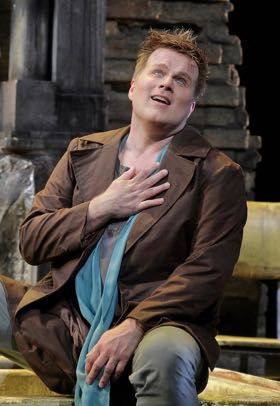
Daniel Brenna as Siegfried
All photos copyright Cory Weaver, courtesy of San Francisco Opera
We discover the child of incestuous love, we ponder a god’s confusion, we anticipate an awakening. Most of all we marvel at genius of the composer and admire the canny story telling of the Zambello production.
Though dubbed the “American” Ring there is nothing specifically American about this Siegfried except maybe the Siegfried — Wisconsin born Daniel Brenna, a veteran of the Washington D.C. Ring who has sung Siegfried in Budapest, Karlsruhe and Dijon as well.
In this Ring we relate to Wagner’s greedy dwarfs Alberich and his brother Mime perhaps as gypsies more than anything else, though for San Franciscans they might also be the classic, wily homeless (not unlike some of those on my block). They were Wagner’s Jews.
Mime’s dilapidated caravan (a gypsy image) is in a truly desolate setting, thus we know Mime is a loner, all the better to protect Siegfried, his ticket to the gold he covets. The Mime of American tenor David Cangelosi is slinking, garrulous and bubbling over with deceit — just perfect.
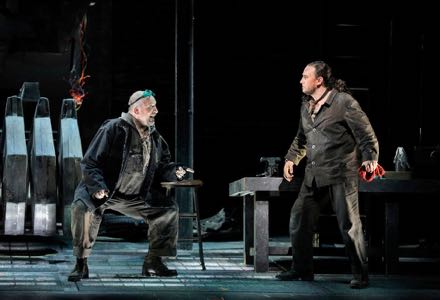
Falk Struckmann as Alberich, David Cangelosi as Mime
Mime’s bleak landscape is the only nature in the Zambello Ring beyond a few video references. There are no horses, there are no ravens, no forest bird, but there is Siegfried’s bear who playfully gallops onstage chased by his playmate Siegfried. The two creatures epitomize Wagner’s vision of unspoiled nature, and for Zambello tenor Brenner embodies a perfect portrait of wide and bright-eyed American innocence.
Of youthful visage and fine young voice tenor Brenna well embodied Wagner’s ideal of pure and indeed powerful nature. This innocence served him well through his almost joyful murders of Fafner and Mime and prepared him for his monumentally guileless encounters with the god Wotan and Wotan's once immortal daughter Brünnhilde.
Bass baritone Greer Grimsley’s heroic Wotan wanders through Siegfried’s industrially littered world in search of its and his destiny, the outcome he himself has willed to Siegfried. He encounters Siegfried’s protector Mime, and he encounters his arch rival Alberich, known to us since the initial moments of Das Rheingold in the personnage of Falk Struckmann, an imposing German bass baritone who is also known as a Wotan. As Alberich Mr. Struckmann's currency is gold, Wotan’s contracts forgotten.
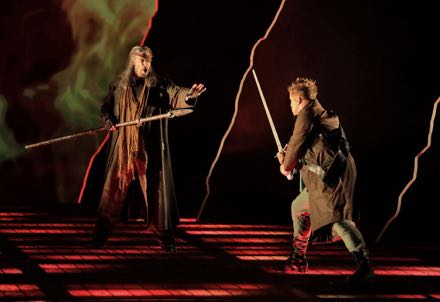
Greer Grimsley as the Wanderer, Daniel Brenna as Siegfried
Wotan encounters Brunnhilde’s mother Erde in a scene where he completely loses his cool, and finally Wotan encounters Siegfried who shatters his creator's spear into which is imbued all social order. In all these encounters Grimsley’s Wotan exploits a humanity that is profoundly tragic and richly heroic, knowing finally that he himself has willed his destruction. And tenor Brenna musters the magnitude of innocent force to equal Grimsley’s resigned humanity in this spellbinding scene created by these two gifted actors.
The Forest Bird is no bird but rather a simple human creature who normally might have been Siegfried’s first love. Destiny however leads Siegfried to Brünnhilde. This final scene of the opera is spellbinding as well, playing on the youthful and direct voice of Siegfried in contrast to the powerful, mature voice of Wotan’s fallen daughter Brünnhilde, Swedish soprano Iréne Theorin. If at first the disparity of vocal production in this climactic scene is musically jarring, upon reflection it brilliantly sets up the tensions that will obsess us for the last, lengthy installment of the Ring.
A Ring given truly rich life by conductor Donald Runnicles and the San Francisco Opera Orchestra.
Cast and production information:
Mime: David Cangelosi; Siegfried: Daniel Brenna; Brünnhilde: Iréne Theorin; Wotan: Greer Grimsley; Alberich: Falk Struckmann; Fafner: Raymond Aceto; Forest Bird: Stacey Tap;pan; Erda: Ronnita Miller. San Francisco Opera Orchestra. Conductor: Donald Runnicles; Production/Stage Director: Francesca Zambello; Associate Director: Laurie Feldman; Choreographer: Denni Sayers; Set Designer: Michael Yeargan; Costume Designer: Catherine Zuber; Lighting Designer: Mark McCullough; Projections: Jan Hartley. War Memorial Opera House, San Francisco, June 15, 2018.
Götterdämmerung at San Francisco Opera
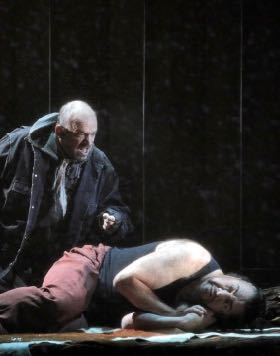
Alberich appears to Hagen in a dream
All photos copyright Cory Weaver, courtesy of San Francisco Opera
The truly tragic moments of this long history rich in humanity behind us we embark on the sordid tale of the Lord of the Gibichungs’s marriage to Brünnhilde and the cowardly murder of Siegfried, to arrive at some sort of conclusion where Brünnhilde sacrifices herself to somehow empower women. Or something.
The Zambello Ring is big, and particularly Götterdämmerung is huge. There is a lot of video — Wagner’s musical interludes are always fully illustrated. Some of this surprisingly successful video was newly created for this revival by S. Katy Tucker, earlier created videos were by Jan Hartley.
There is a lot of architecture — abandoned warehouse buildings of some post-industrial era, monumental civic structures, crumbling elevated cement roadways, there are tons of plastic bottles that litter a dried up river bed. In this re-mounting of the 2011 San Francisco Ring the sets designed by Michael Yeargan have become fully absorbed into the telling of the saga, and fully achieve Wagnerian Gesamtkunstwert where words and music are one with sight, an achievement to be savored as it is indeed rare.
The Donald Runnicles Ring is big, well exploiting the full resources of the eighty-nine players of the admirable San Francisco Opera Orchestra. Seated on the left side of the theater the magnitude of sound flowed gloriously across the expanse of the theater to fully absorb me into its myriad of leitmotivic detail and massive ensemble. The Wagnerian Rhine, its reality and its myth, was fully present in the Runnicles reading.
The signature image of the Götterdämmerung is the massive computer mother board and the three norns who plug and replug cables until one snaps in the famous orchestral clap and we enter the pitiful world of the Gibichungs (FYI fourth century Burgandians) whose leader is the unmarried Gunter, his sister Gutrune is also unmarried. Alberich’s son Hagen manipulates these two weak creatures into disastrous marriages to further his goal of becoming lord of the ring and possessor of the massive hoard of gold.
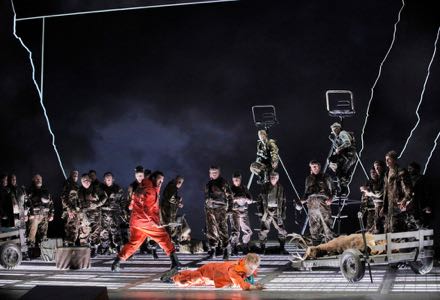
Hagen kills Siegfried. The Ring production costume designer is Catherine Zuber.
San Francisco Opera’s house bass Andrea Silvestrelli sang Hagen. Mr. Silvestrelli’s extraordinary height plus his dark, rough and powerful voice gave a strong presence to this cunning personnage who cruelly orchestrates the marital disasters. Though you might wish for more elegance of sound and subtlety of character, Mr. Silverstrelli certainly did the job, playing the role to the hilt.
San Francisco Opera house baritone Brian Mulligan sang Gunter. Mr. Mulligan possesses a very beautiful, Italianate voice without supplying a persuasive presence. This worked for establishing a certain character for Gunter though you might have wished for a less lyric voice and a more forward personality. Mr. Mulligan did succeed in making Gunter pathetic, evoking my reluctant sympathies for such a weakness.
We first encountered mezzo soprano Jamie Barton as a contemptuous Fricka. In Götterdämmerung she sings Waltraute, Brünnhilde’s valkyrie sister who comes to Brünnhilde to beg her to return the ring to the Rhine, to break its curse and perhaps save the gods. It is our last reference to Wotan before his annihilation in the opera’s last moments. Unfortunately Mlle. Barton was unable to achieve the angst and the gravitas that might have moved Brünnhilde to save her father. The complexity of the pathos of this scene were lost in its pallid reading.
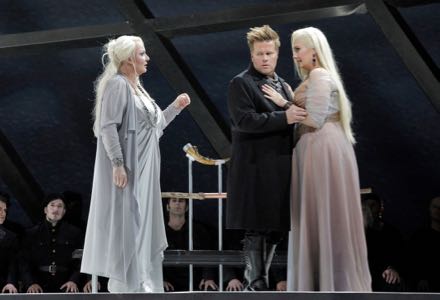
Siegfried and his two brides. Gutrune (right) sung by Melissa Citro
Soprano Iréne Theorin perservered through it all. In firm Brünnhilde character she ferociously denounced her marriage to Gunter, and together with Hagan and Gunter she swore revenge on Siegfried, this spectacular marriage scene set in the monumental architecture of the Gibichung Hall. She remained in equal vocal radiance for her immolation. Tenor Daniel Brenna’s Siegfried perservered through it all to make, finally, his scene with the Rhine maidens one of the memorable moments of the entire Ring. Maestro Runnicles brought earth shattering pathos to Siegfried’s death, freezing for eternity the complex emotions of this climactic moment.
After much sublime poetry over sixteen or so hours of one of the finest Rings I have ever seen, the immolation of Brünnhilde and the gods of Valhalla was strangely prosaic. Inexplicably, or maybe as victimized sisters Gutrune, Siegfried’s wife, stood by Brünnhilde’s during the valkerie's invocation to the ravens (unseen) to fly to Valhalla. The female chorus joined the Rhine maidens and Gutrune on stage for Brünnhilde’s horseless immolation. The radiant calm of the Ring’s final music was captured by the Rhine maidens energetically swirling great swathes of gold cloth.
Cast and production information:
Brunnhilde: Irene Thorin; Siegfried: Daniel Brenna; Gunther: Brian Mulligan; Hagen: Andrea Silvestrelli; Waltraute: Jamie Barton; Gutrune: Melissa Citro; Alberich: Falk Struckmann; First Norn: Ronnita Miller; Second Norn: Jamie Barton; Third Norn: Sarah Cambidge; Woglinde: Stacey Tappan; Wellgunde: Lauren McNeese; Flosshilde: Renée Tatum. Chorus and orchestra of the San Francisco Opera. Conductor: Donald Runnicles; Production/Stage Director: Francesca Zambello; Associate Director: Laurie Feldman; Choreographer: Denni Sayers; Set Designer: Michael Yeargan; Costume Designer: Catherine Zuber; Lighting Designer: Mark McCullough; Projections: Jan Hartley. War Memorial Opera House, San Francisco, June 17, 2018.
Rusalka at Madrid’s Teatro Real

Eric Cutler as the Prince, Asmik Grigorian as Rusalka
All photos copyright Monica Rittershaus, courtesy of the Teatro Real
For this opera critic sheltered in San Francisco the next best thing to actually being at an opera house is tuning into an actual, real-time performance, digitally. Thus the 7:30 PM downbeat for the Madrid Rusalka occurred at 10:30 AM in my darkened living room.
It was the new, long awaited Christof Loy Rusalka finally on stage at the Teatro Real with Lithuanian soprano Asmik Grigorian, the famed Salzburg Salome, as Dvorak’s water nymph. All this while Covid rages in Spain. If safety protocols are your thing check out the Associated Press account of pandemic opera at the Teatro Real The Show Goes On . . ..
But wait, there’s more than mere plague! The night before the dress rehearsal American tenor, Eric Cutler, Dvorak’s Prince, ruptured his Achilles tendon. A serious injury that might have required replacing him, forsaking the two month rehearsal period he had endured.
But it was a blessing in disguise, serving to enrich stage director Christof Loy’s wounded lover concept. Eric Cutler’s Prince now arrives onto the Teatro Real’s stage on real forearm crutches, seemingly having just stepped in from the Plaza de España, the epicenter of Madrid’s nightly passeggiata.
In Dvorak’s water world the nymphs dance in a magical trance, except the nymph Rusalka who has fallen in love with a human — the Prince. In Christof Loy’s conception, enveloped in post modern neoclassical mythology, this renders Rusalka crippled — the ballerina Rusalka has injured her left foot and cannot join her white crinoline-ed tutu-ed, swan lake-like sisters gracefully sus-sous-ing across the stage.
In Mr. Loy’s mythical world the witch Ježibaba, a maternal, all knowing floozy, and the water sprite Vodnik, a formally suited male paternal figure together inhabit a neoclassical room where we see as well the injured ballerina Rusalka’s bed, and lava-like intrusions of a stony shore.
It comes to pass (you know the story) that when Rusalka joins the human world she will no longer be able to speak. This of course awakens in Mr. Loy the world of silent film, wittily inserted into this world of high operatic theater. Thus the set includes a box office, sometimes inhabited by Mme. Ježibaba selling tickets to all this art.
No surprise then, to our great delight, that we see Charlie Chapman with his famed ladder at the top of Act II. Dvorak’s gamekeeper and the kitchen boy do their kitchen antics à la slapstick. Mr. Loy’s demonstrably boundless wit exploits the opera metaphor by introducing the current diva of all divas, Karita Matilla as Rusalka’s competition, the Foreign Princess, in a pure Busby Berkeley moment. Let me add that Mme. Matilla was in good voice and fine figure, divissima in fact, the outlines of an opera house apparent through the center stage arch.

Karita Matilla as the Foreign Princess, with dancers.
The Prince’s fatal Act I hunt is guided by Dvorak’s Huntsman, in Mr. Loy’s post modern vision it is a commedia dell’arte, white-faced Pierrot, yet another reference to a world of mute theater, here a character of silent understanding in search of his Colombine, and as well as the sad clown face of existential despair.
But the crippled Prince too, like Rusalka to her dancing sisters, no longer belongs to the frenetic world just outside the theater walls. Doomed, in the end, by Rusalka’s kiss he drops his forearm crutches a few feet before he falls. Freed now from the fetters of this world he consecrates his love for Rusalka by his death. The Teatro Real does not offer a photo of this sublime moment.
Had I been inside the Teatro Real I would have reveled in the glories of Dvorak’s richly Romantic score surely exploited by conductor Ivor Bolton and the obviously full throated Orquestra Sinfónia de Madrid. As it was there were many, many hints of orchestral magnificence, resonances well beyond the capabilities of my salon audio resources.
Nonetheless I was captivated by the concept and by the performers. I had only known soprano Asmik Grigorian as Salome from my seat at a recent Salzburg Festival from which vantage point I responded to her as a 16 year-old prodigiously endowed with Straussian vocal resources in the context of the Castelucci production. Mme. Grigorian’s voice and body were one as Strauss’s adolescent. Thus it was a revelation to encounter this unique artist in her actual late thirties, maybe 40, in a television production where faces are more important than bodies.
Mme. Grigorian’s voice is pure and silvery, and naturally young. Its production is so secure that it issues forth, even mightily, with seemingly natural ease. Up close we could note aspects of the remarkable technique that underlies such deception. La Grigorian melds body and voice effecting a complex, operatically realized character that is rarely achieved by singers — and exceedingly affective.
In the Christof Loy Rusalka Mme. Grigorian is a ballerina as well as a singer! En point! Not surprisingly, her dance movements were accomplished with evident balletic technique.

Asmik Grigorian as Rusalka en point, Maxime Kuzmin-Karavaev as Volnik
Eric Cutler in his role debut exhibited secure, powerful singing though the size and scope of the voice cannot be known in a video performance where levels are adjustable. The Act I hunt scene with Mr. Loy’s Pierrot and following aria were hugely effective. Mr. Cutler’s death, in street clothes, his forearm crutches abandoned, found all the pathos of the Dvorak score and at the same time amplified the brilliance of the Christof Loy concept.
Madrid’s Teatro Real is one of Europe’s major theaters, thus casting is informed and appropriate. Swedish mezzo soprano Katarina Dalyman sang Jezibaba, Russian bass Maxime Kuzmin-Karavaev sang Volnik, Spanish baritone Sebastià Peris created the spooky Pierrot Huntsman. Catalan baritone Manel Esteve created the convincing silent screen Charlie Chaplin Gamekeeper together with French soprano Juliette Mars as the Kitchen Boy. Armenian soprano Julietta Aleksanyan, Irish mezzo soprano Rachel Kelly and Russian mezzo soprano Alyona Abramova were the three nymphs.
The video production was well done, offering sufficient full stage shots to instill a larger scenic context while focusing on the changing dramatic circumstances, very occasionally moving to full frame faces. It was filmed for MezzoTV (www.mezzo.tv, available in Canada and Europe, and offered to medici.tv subscribers worldwide at www.medici.tv/en/operas/dvorak-rusalka/. Both MezzoTV and MediciTV will stream the production for a limited time.
Production information
Chorus, Ballet and Orchestra of the Teatro Real conducted by Ivor Bolton. Stage Direction: Christof Loy; Set Design: Johannes Leiacker; Costumes: Ursula Renzenbrink; Lighting: Bernd Purkrabek. Teatro Real, Madrid, November 25.
Three Chamber Operas at the Aix Festival
Along with the celestial Mozart Requiem, a doomed Tosca and a gloriously witty Mahagonny the Aix Festival’s new artistic director Pierre Audi regaled us with three chamber operas — the premiere of a brilliant Les Mille Endormis, the technically playful Blank Out (on a turgid subject), and a heavy-duty Jakob Lenz.
Les Milles Endormis

Gan-ya Beb-gur Akseldrod as Nurit
photo copyright Patrick Berger / Artcompress
Les Milles Endormis is a brilliant piece of real opera by Israeli composer Adam Maor and it was brilliantly staged by its librettist, Israeli poet Yonatan Levy. Four singers and eight instrumentalists (Luxembourg's United Instruments of Lucilin) made a mighty noise — though insufficient to wake up the thousand imprisoned Palestinian hunger strikers the Israeli Prime Minister and his security chief had put to sleep not knowing what else to do with them.
We saw only about thirty of them laid out quite comfortably on the stage only they weren’t asleep as they were actually audience members, like us, watching the show (maybe the only seats they could get for this, the hit show of the Festival).

Tomasz Kumiega as the Prime Minister, Gan-ya Beb-gur Akseldrod as Nurit (extreme right)
photo copyright Patrick Berger / Artcompress
The U.S. president phoned the insomniac (with the rest of Israel) PM to say that he had not vetoed the UN resolution denying rainfall on Israel. Meanwhile Israeli children in the north were having epileptic seizures that left them speaking Arabic.
This provided occasion for the reading of a lengthly newspaper article describing the stricken toddlers. Though it wasn’t read. It was recited in an astonishing Hebrew prose aria by a Cantor wearing a crown of with faceted mirror fragments that ricocheted points of light among us adding even more magic to the Arabic infused musical lines.
The PM’s chronic nightmares are determined to be psychic tunnels dug into Jewish dreams by the sleeping terrorists. The Security Chief takes over, sending in a sleeper agent, the PM’s assistant, Nurit whom he hypnotises in a magical, mystical monologue. In an extended dream aria embellished with Arabic musical gestures, Nurit standing among us on a platform over the orchestra pit in the now lighted hall tells of the spiritual homeland the thousand sleeping souls have founded. It is one soul connecting to another.
This is but the surface of this brilliant, perfect bel canto libretto. The Prime Minister and his adjuncts create quite a mess, thus the PM has much to rage about. The Cantor, the Security Chief and the PM’s assistant Nurit are left to sing their way out of it. Though the subject of the opera may not be bel canto’s classical conflicts, the Mille Endormis’s conflict is indeed a current torment in our minds and hearts.
Like the Brecht/Weill Rise and Fall of the City of Mahagonny, Les Mille Endormis is heavy political satire. But unlike the Brecht/Weill piece it is first and foremost opera as revealed in its profoundly human, emotional resolution that eclipses its conflict.
Composer Maor’s orchestral score includes considerable use of recorded electronically produced sounds, created by the Centre Pompidou’s Ircam (an electro-acoustical music laboratory). The basic musical language is sonic gesture created, with the Ircam component, in the beautifully colored sounds of traditional orchestral instruments — a string trio with added bass viol plus a clarinet. Add to this an accordion and percussion, plus an electronic keyboard. The vocal lines are melodic (moving in steps rather than leaps). The lines are based on normal speech patterns embellished with the Arabic vocal gestures.
Holding all of this together musically was Swiss-Australian conductor Elena Schwarz. It was a conducting tour de force accomplished with visible precision and total command of the deceptively minuscule forces that may as well been those of a Bruckner symphony.
Polish baritone Tomasz Kumiega gave an over the top performance as the Prime Minister, finding his rage, his passiveness, his helplessness and his humanity. American bass David Salsbery Fry displayed a strange and surreal humanity in the black tones of magical incantation hypnotizing Nurit. French tenor Benjamin Alunni accomplished a monumental feat in delivering the huge newspaper account of the stricken children babbling in Arabic with detached cantorial aplomb. Israeli soprano Gan-ya Beb-gur Akselrod intoned the mesmerizing dream of the Israeli who joined the sleeping Palestinians in a world beyond hunger where there is no homeland.
The opera was performed in the small, horseshoe Théâtre du Jeu de Paume on Aix's Rue de l'Opéra.
Blank Out

Miah Persson as the young mother in Michel van der Aa's Blank Out
photo copyright Priska Ketterer - Lucerne Festival
The hour long opera Blank Out was created by Dutch composer Michel van der Aa. It was first performed in 2015 under the auspices Pierre Audi’s Dutch National Opera who commissioned the piece. Among other stops before finding its way into the recital hall of Aix's Darius Milhaud Conservatoire it was seen at Mr. Audi’s Park Avenue Armory in Manhattan.
Mr. van der Aa plays with electronic technology in his compositions for the stage (Blank Out is his fifth opera) which are both visual and auditory creations. Blank Out is scored for one live soprano and one recorded baritone on an accompanying van der Aa made video. The video is in 3D thus we were provided with the necessary glasses.
The opera’s gimmick is the presentation of a horrific domestic tragedy — the live-on-stage mother tells of watching her seven-year-old son drown, and later the filmed baritone re-experiences the drowning death of his mother. The artistic intent of Mr. van der Aa’s opera is not so much to operatically create such a shocking, mirrored tragedy as it is to demonstrate how current audiovisual creation and reproduction technology can be harnessed to tell stories. We were first wowed by the doubling of the live soprano on the 3D recorded video screen to make a duet with herself, then we were amazed by the quality of the recorded voice that fully matched the live soprano. And, voilà, it became a trio with herself!
The fully electronic recorded score provided soundscapes where the mother moved to the side of the stage to manipulate a model of a house, the 3D film documenting her re-configurations of the model. It was this model house that we see become as well the real house of the baritone’s mother located on a barren, bleak stretch of sea land reclaimed by a Dutch dike. The video alternates between the recorded image of an actual (real) house and the recorded manipulations of the house model by the live soprano.
With all this going on in vivid, high definition color I struggled in vain to feel anything other than passing interest in the cleverly mirrored domestic tragedies. I did admire the technology, and the solid, if stolid storytelling.
The live soprano was sung by Swedish soprano Miah Persson, the same singer who created the opera’s premiere a few years ago (thus no need to make a new film). Mlle. Persson is a musician of high order, evidenced in the extended, pitch perfect a cappella singing that began the opera. Her pure sounds perfectly embodied the tentative emotions of this young mother, sounds that have made her a Mozart heroine on major stages. British baritone Roderick Williams was the recorded son, well portraying a mature male recalling and then again grieving the death of his mother.
Eight
The Aix Festival partnered with a nearby winery cum architectural art installations, Château La Coste to exhibit Michel van der Aa’s 15 minute virtual reality piece Eight. As Blank Out its narrative is a gimmick. A virtual old woman traces her life in virtual physical re-creations backwards to her eighth year. Note that the shape 8 is a symbol of infinity and that once inside the 20-foot square paddock, capped with headset and earphones, we configured the shape of 8 with our footsteps as we followed our virtual guide, the age inverting female.
The sound tract is the recorded singing of poems and texts compiled by Mr. van der Aa and Australian pop songwriter-singer Kate Miller-Heidke who sings the texts in a weak and breathy, new-age-music voice to electronic accompaniment. The soundscape includes manipulated voices of the Netherlands Chamber Choir.
Virtual reality provided astonishing, infinite vistas, hurling boulders, and finally an intimate, low tent I dutifully squatted to enter where I watched and listened to a virtual eight-year-old girl earnestly telling me something or the other. Standing again I put my hand out to use a wall to steady myself. It was, however, virtual. As was the artistic experience.
Jakob Lenz

Wolfgang Bankl as Oberlin and John Daszak as Kaufmann (both standing)
Georg Nigl as Lenz (on floor) with doll Friederike
photo copyright Patrick Berger / Artcompress
German composer Wolfgang Rihm’s 1978 one-hour-fifteen-minute chamber Jakob Lenz was given three performances in Aix’s Grand Théâtre de Provence in a major, i.e. great big 2014 production from the Stuttgart Opera.
This Rihm opera completes a trilogy of operas based on the literary works of the German Romantic expressionist Georg Bûchner— Alban Berg’s 1925 Wozzeck, Gottfried von Einem’s 1947 Dantons Tod (The Death of Danton), and the 1978 Rihm Jakob Lenz. Dantons Tod had a major revival at the Vienna State Opera last year. This 2014 production of Jakob Lenz evidently stimulated a revival of interest in composer Rihm, now 67 years-old, as the Salzburg Festival revived his The Conquest of Mexico a year later in a splendid production of rich metaphor by Peter Konwitschny.
Though Bûchner’s Lenz is a novella based on Jakob Lenz’s diary, the Rihm Jakob Lenz librettist, Michael Fröhling configured it à la Wozzeck as 13 short scenes wherein Goethe’s friend, the schizophrenic, strum und drang poet Jakob Lenz is found, half drowned by the parson Oberlin. He takes Lenz to the parsonage with him. Lenz has visions of his beloved Friederike and engages with his friend Kaufmann in a discussion about art. Lenz hears voices that tell him Friederike is going to die, he searches for her only to find an infant on a bed whom he sees as Friederike. He tells her to rise. She doesn’t. He hears voices that tell him to suicide. Oberlin and Kaufmann are powerless to help Lenz. The place him in a straight-jacket. Left alone on the stage he repeats the word ”logical.”
Composed when Rihm was twenty-six years old Jakob Lenz is a neo-expressionist statement, very much in the mold of Wozzeck though without its dramatic and musical interest. The Stuttgart production by venerable German theater director Andrea Breth is in the stratospheric teutonic theatrical mannerisms of unvarnished, ugly reality that typify the German long-ago avantgarde. Here in Aix they read as naive, a language befitting a retro staging of Wozzeck.
The opera Jakob Lenz’s opening image was the poet Lenz falling from the stage loft onto the stage floor (enacted by a acrobat double). It was spectacular, but we were then held captive for the monochromatic duration of the opera. Austrian baritone Georg Nigl sang Lenz, Austrian baritone Wolfgang Bankl sang Parson Oberlin and English tenor John Daszak sang Kaufmann. German conductor Ingo Metzmacher conducted eleven members of Frankfurt’s Ensemble Modern.
The Rise and Fall of the City of Mahagonny at the Aix Festival

Nikolai Schukoff was Jim Mahoney, Annette Dasch as Jenny
All photos copyright Pascal Victor / Artcompress
Make no mistake, this is about you! Jim laid-out dead on the stage floor, conductor Esa-Pekka Salonen brought his very loud orchestra (London’s Philharmonia) to an abrupt halt. Black out. The maestro then turned his spotlighted face to confront us and he held his stare. There was no mistake, the music was about us.
Stage director Ivo van Hove worked on a wide open, bare sound stage. This was not opera. It was no-where. That was exactly the point, and that is where Fatty, Moses and the widow Begbick built their city Mahagonny to satisfy their greed and our lust.
All this greed and lust were in-your-face — this the orchestra insisted. The maestro gave a loud, very loud, clinical and chiselled reading of the Kurt Weill score from the get-go, making it very clear that it is highly sophisticated, brilliant music, and that it is confrontational.
Mr. van Hove’s staging was confrontational, On the bare stage was a projection screen serving as the glass plate of a microscope under which we would study the faces and the souls of the hordes of men who came to Mahagonny to forget their dreary lives and to indulge their vices and their pleasures. Then came the whores from Alabama and four lumberjacks from Alaska, a bit lost in the visual cacophony of the teeming world.
It was a chaotic stage, but the videographer singled out the faces of our a few of the arrivals while Kurt Weill singled out their voices — Jenny the whore, Jim Mahoney the sensitive, soul searching lumberjack who goes a bit crazy, and his three buddies, Jack the glutton, Joe the boxer and Bill the miser. If their voices were at first nearly lost in the melee, that’s because they were in fact in a melee.
Little by little their projected faces bared their souls to us as their voices grew stronger. The maestro did not indulge the easy rhythms of the Kurt Weill’s jazz, rag time and folk influences. It was musically obvious there was a lot of tough stuff to come.
Jim, the lumberjack, got a bit maudlin and then he got bored. There came a hurricane (three giant fans and a wounded citizen suffering melodramatically on the screen), and Jim had his revelation, and the hordes (well, the thirty men of the Pygmalion Chorus and fifteen supernumeraries) shouted it in our faces. Black out.

The stage and the screen. Peixin Chen as Joe, Sean Panikkar as Jack (head down),
Thomas Oliemans as Bill at the all-you-can-eat table, with the Pygmalion Chorus
The lid was off — total liberty to totally satisfy any of your cravings, and to get whatever you want. If you can pay for it. A stage was needed to play out the demises of Jack the glutton and Joe the boxer, so one was constructed stage right. There was simulated humping against its back wall, and at the same time we saw very graphic humping projected on the screen, the whore ’s face directly in our face.
Austrian tenor Nikolai Schukoff was Jim Mahoney, the ring leader of it all. Mr. Schukoff is a very charismatic performer, easily projecting a sexuality to be satisfied, but willing to show a softer side and maybe yearn for a better, truer life. Tenor Schukoff is a big performer and easily found the force needed to bust things wide open in Mahagonny (Mr. Schukoff is both a Don Jose and a Siegmund on major stages).
The Rise and Fall of the City of Mahagonny is the epitome of didactic, Epic Theater. These days social commentary wears thin on the opera (or any) stage. As the citizens of Mahagonny were wearying of its corruption we too were wearying. Bertold Brecht maybe was as well, so he added a bit of witty, heavy irony— the Mahagonny inhabitants dream of a new, better city, Bénarès, better known these days as Varanasi, the Hindu city of death. Director van Hove obliged by projecting onto the screen hazy, smokey images of this city of ritualistic cremation as seen from the Ganges.

Nikolai Schukoff as Jim, Anette Dasch as Jenny in the final duet.
Jim's friend Bill (Thomas Oliemans) is at the far right.
In the penultimate scene van Hove brought, finally, our total focus and our held back sympathy onto Jim Mahoney when Jim delays his death as long as he can in a long, moving and hopeless monologue, and then makes his farewell to Jenny in a beautiful, tender duet. Here there were no screen projections, there was no microscope. Here was, finally, real human emotion to for us to feel, not to judge.
The Fall of the City of Mahagonny was of the scenic magnitude to equal the gigantic musical efforts emanating from the pit. There was smoke and fire, there was thunder and lightning, more smoke and fire raged from the pit. It was the destruction of Valhalla you have always wanted to see but never got. You have had to settle for Wagner’s pale by comparison account of such cataclysmic destruction.
It was no-holds-barred casting: Karita Mattila as the widow Begbick, Sir Willard White as Moses, Alan Oke as Fatty. The Jenny was German soprano Annette Dasch (a Donna Elvira on major stages) though in this staging Jenny was not given a dominant presence, nor did the staging on the wide open stage provide an acoustic shell to project her voice. The three lumberjacks were of consummate charm and fine voice: Sean Panikkar as Jack, Thomas Allemans as Bill, and Peixin Chen as Joe.
The six prostitutes were gutsy and lusty, very willing to play their parts: Kristina Bitenc, Cathy-Di Zhang, Thembinkosi Magagula, Maria Novella Malfatti, Leonie Van Rheden and Veerle Sanders.
I saw the second of four performances on July 9, 2019.
Production information:
The Philharmonia Orchestra and the Pygmalion Chorus. Conductor: Esa-Pekka Salonen, Mese en scène Ivo van Hove, Scenery and lighting: Jan Versweyveld, Costumes: An d’Huga; Video: Tai Yarden
Tosca at the Aix Festival

Angel Blue as Tosca, Catherine Malfitano as the old diva
All photos copyright Louis Fernandez
From the sublime — the Mozart Requiem — to the ridiculous, namely stage director Christophe Honoré's Tosca. A ridiculous waste of operatic resources.
Christophe Honoré is a high-profile French film maker and playwright who is a prominent gay activist in this time of a long overdue updating of human rights. This places Mr. Honoré in prime position to become a part of France’s progressive opera world, namely the Aix Festival where he directed the 2016 Ethiopian Cosi fan tutte and the Opéra de Lyon where he directed the 2017 Don Carlos wrapped in stage curtains (until the auto da fé which was stuffed into the galleries of an Elizabethan theater).
Thus it is no surprise that he should be back on the front lines of French avant-garde opera, again at the Aix Festival with a Tosca than he has set in New York City’s Manhattan, or maybe in the far less sophisticated Bronx. It is not Tosca the opera, it is an unsettling tale of the demise of a Tosca diva, Puccini’s magnificent score reduced to a troubling piece of prosaic theater.
Mr. Honoré states in the program booklet that the big question in Tosca is if an artist’s art can protect the artist from life — Tosca’s does not, Cavaradossi’s does not. It would seem that the question need not be asked, since the great, even gigantic gesture in Puccini’s Tosca is release from life. The opera Tosca is an artistic ritual of liberation that can be infinitely repeated. It is not an “impermanent” (descriptive term used by director Honoré) work of art waiting to be used.

Angel Blue as Tosca in the copy of the dress worn by the Tosca of Maria Callas,
Alexey Markov as Scarpia.
And abused. Abused by the giant screen film adaptations (movies) of real performances that occurred in the past few weeks in Aix cinemas. Or abused by re-writing the story to make the first act the rehearsal for a concert to honor an aged diva, the second act to illustrate psycho-sexual implications of gay diva worship, and the third act to be the concert where the diva is the victim of her art, taking her own life at the conclusion of the concert.
A reading of The Rise and Fall of Gay Culture might suggest that the gay men of the second act vicariously execute the diva to rid themselves of their arch competitor for the seduction of desired males (Cavaradossi, for example).
Then there was the abuse of the audience, making us wait while the orchestra was moved to the stage (no easy process), thus repeating the wait-abuse Mr. Honoré perpetrated on the Lyon Don Carlos audience. And the abuse of the audience by two videographers stalking the stage to capture faces to be continuously projected on giant screens above the stage floor, images of disembodied voices that Mr. Honoré ordains as images of the real (as opposed to the operatic).
The revelation of the evening was the very present, vibrant sound of the Archeveché theater pit evidenced by the huge presence of the excellent orchestra of the Opéra de Lyon. Conductor Daniele Rustioni, music director of the Opéra de Lyon, offered an idiomatically correct reading of the Puccini score, allowing its subtleties to shine forth. The orchestral sound was forceful indeed, though it never competed with the stage for presence. Once on-stage the orchestral sound was nearly magnificent, an unexpected acoustic miracle.
The aged diva of the Christophe Honoré’s Tosca was Catherine Malfitano, once an internationally recognized Tosca. La Malfitano is now seventy-one years old, and retains the remarkable presence that marked her long and distinguished career. She bravely fought her way through this ordeal of uselessness, bravely enduring the ravages of time on the body and voice in this savage vision of artistic demise.
The ingenue Tosca diva was American soprano Angel Blue, already a Mimi on major stages she may yet become a new age Tosca. Maltese tenor Joseph Calleja sang Cavaradossi, his rôle fétishe. His recent Cavaradossi at the Met boasted secure high notes that did not find their way to Aix, the intimacy of the Archeveché theater did not favor his blatant, high-horsepower delivery.

Catherine Malfitano as the Diva, Joseph Calleja as Cavaradossi
Russian bass baritone Alexey Markov provided a trim figured, vocally dark and focused Scarpia. The cluttered, frenetic happenings (lots of gay sex stage-right) on the stage eclipsed his great moments. It was unclear how he fit into the picture. Tosca brutally stabbed him in the face, meanwhile the aged Tosca diva payed a Cavaradossi double for sex. There was so much extra-opera stuff going on I wasn’t sure where to look to discover the essentials. If there were any.
Cast and production information:
La Prima Donna: Catherine Malfitano; Floria Tosca: Angel Blue; Mario Cavaradossi: Joseph Calleja; Il barone Scarpia: Alexey Markov: Cesare Angelotti: Simon Shibambu; Il sagrestano: Leonardo Galeazzi; Sciarrone: Jean-Gabriel Saint Martin; Spoletta: Michael Smallwood; Un Carceriere: Virgile Ancely; Le Majordome: Jean-Frédéric Lemoues; Pompier: Frank Daumas. Orchestre et Choeur de l’Opéra de Lyon; Maîtrise de l’Opéra de Lyon. Conductor: Daniele Rustioni; Mise en scène: Christophe Honoré; Scénographie: Alban Ho Van; Costumes: Olivier Bériot; Lumière: Dominique Bruguière. Théâtre de l’Archeveché, Aix-en-Provence, France, July 6, 2019.
The Mozart Requiem at the Aix Festival

All photos copyright Pascal Victor / Artcompress
Pierre Audi, now the directeur général of the Festival d’Aix as well as the artistic director of New York City’s Park Avenue Armory opens a new era for this distinguished opera festival in the south of France with a new work by the Festival’s signature composer, Wolfgang Amadeus Mozart.
It is, namely, Mozart’s last work, a Requiem Mass left unfinished at his death in 1791, later finished —based on Mozart’s notes and sketches by his student Franz Saver Süssmayr. In this Aix edition it has been reconfigured and expanded by French musical visionary Raphaël Pichon, a conductor well-known at the Aix Festival, and by Italian theater visionary Romeo Castelucci in a belated, long awaited Aix debut.
But this “Mozart” Requiem is now a theater piece somewhat beyond, actually well beyond Mozart’s setting of the Catholic death mass liturgy. His widow Constanza pretended he composed his own requiem, and in Aix it was indeed just that — Mozart’s moment of life long vanished, conceptually the “Aix” Requiem insists that Mozart’s Requiem Mass will vanish as well.
Discovering this existential tragedy made the Castelucci Aix debut well worth the wait. In his Brussels Parsifal, his Lyon Jeanne d’Arc au Bûcher and his Salzburg Salome Sig. Castelucci is fettered by narrative, and imposed philosophical concept and psychological involvement. But in this Aix Requeim, like in his Tragedia Endogonidia cycle, he freely traverses ephemeral human atmospheres filled with unanswered questions that are met with spontaneous reactions. It is rare access to the most hidden theatrical realms of the human psyche.
Like the non-verbal, purely intuitive communicative process of music Castelucci’s language is the non-verbal communicative power of essential theater. There is no intelligence and there is no interpretation, there is but momentary recognitions of an intuited physical reality.
From its first moment in this Aix Requiem, a lone, older woman is perhaps at her death, the requiem passes through her four, simultaneous existences in identically dressed embodiments — a child, a virgin, a mother, and this old woman. The Aix Requiem ends with their issue — a baby alone on the silent stage. A male.

Musically the Requiem begins with the disembodied voice of a male child (soprano) intoning an anonymous Gradual (a response refrain normally sung between recitation of psalms): “Christus factus est.” It insists that the will of God be imposed on man. It is sung in the purest sounds of male innocence.
The usual requiem liturgies of praise and pain continue though interspersed by conductor Pichon with other Mozartian moments — a Masonic hymn, a Psalm setting, the reuse of a piece from his incidental music to Thamos Roi d’Egypte, a solfeggio (sung by the boy), an Amen, the parody of a Serenade, a church song. The Aix Mozart Requiem ends with again the lone voice of the boy intoning an anonymous “In Paradisum” (sung at the moment the body exits the church) — the will of God fulfilled.

There passed before our eyes an abstracted cruxifiction (the young girl), a forest, a maypole, a wrecked car, the Pygmalion chorus and four soloists of purest voices (soprano, alto, tenor, bass) intoning the liturgies first in the clothes they wore to the theater (a heat-wave in Aix), transforming themselves in courtly white unisex dresses, then in celebratory courtly crimson unisex robes, finally in muslin tunics for the "Agnus Dei" before decaying into a chiaroscuro mass of naked bodies. The complex choruses issued forth while the singers created the structures of the music in abstracted movement, often dance, impeccably carving the interlocking phrases of Mozart’s fugues to construct the technical grandeur of mankind’s accomplishment.
The coup de théâtre was the cataclysm that occurred in the "Communion" of the requiem liturgy, the souls becoming one with God shouting their jubilation, tearing down the white walls of the world. The floor of the stage slowly rose, becoming vertical, the debris of the wall and black dirt of the world randomly sliding down to reveal, finally, a blank, white wall. Death. Silence.
From beginning of the Requiem to its end continuous words streamed across the stage box, naming the now vanished accomplishments of man and nature. The final words, incised, were July 5, 2019 — the day I saw the Aix Requiem.
With, then, the lone male child — the creator — alone on the stage we were left with the finality of death, and the image of creation. There was no comfort in rebirth.
The stage was the music, and the music was the stage. Maestro Pichon’s Pygmalion orchestra of period instruments was the voice and the world of man, the solo winds of purest sound, of psychological innocence, the solfeggio violin duet with the boy soprano giving corpus to nature. The eloquence of the requiem liturgies ceaselessly emerged from the pit in crystal clear phrasing that created profound, truly human embodiment for this mass of death.
This Mozart / Pichon / Castelucci Requiem occurred in the most minimal terms. The chorus sang without score, the stage was but a white box. It was sublime music made alive in pure theater.
Cast and production information:
Conductor: Raphaël Pichon; Mise en scène, scénographie, costumes, lumière: Romeo Castellucci; Collaboratrice à la mise en scène et aux costumes: Silvia Costa; Dramaturgie: Piersandra di Matteo. Chorus and Orchestra: Pygmalion. Soprano: Siobhan Stagg; Alto: Sara Mingardo; Ténor: Martin Mitterrutzner; Basse: Luca Tittoto; Enfant chanteur: Elias Pariente. Théâtre de l’Archeveché, Aix-en-Provence, July 5, 2019.
Barbe-Bleue at the Opéra de Lyon

Christophe Gay as Popolani, Héloise Mas as Boulotte
All photos copyright Stofleth
Stage director Laurent Pelly is famed for his Offenbach stagings, above all others his masterful rendering of Les Contes d’Hoffmann as a nightmare. Mr. Pelly has staged eleven of Offenbach’s ninety-nine operettas over the years (coincidently this production of Barbe-Bleue is Mr. Pelly’s ninety-eighth opera staging).
Unlike Mr. Pelly’s straight forward, very charming Peruvian fantasy, La Perichole that I saw at the Marseille Opera in 2002, or his parody of The Barber of Seville (sung on top of sheets of musical score paper) seen at the Marseille Opera in 2018 (boasting the hyper personalities of Stephanie d’Oustrac as Rosina and Florian Sempey as Figaro), here Mr. Pelly’s Barbe-Bleue is set on a farm near Paris and in a grand salon in the Élysée Palace, with actors of limited personality.
The real Barbe-Bleue is the 1619 folk fairy tale by Charles Perrault which Offenbach parodies à la Second Empire. But Mr. Pelly’s stretches the parody to include a parody of his own — that of opera stagings which imitate the criminal underworld (Bluebeard is dressed and acts like a mobster) and a parody of mindless operettas (King Bobeche is a pompous fairy tale king with a silly fairy tale court).

The Farm
The time is now or maybe not-so-long-ago. We see a backdrop that is a latest edition newspaper, two front page articles discuss the strange murders. There is a tractor and chicken sounds and some bales of straw to convince us that all this is somehow what real is. Then we see a huge shelf of weekly revues (magazines), those that thrive on news of lurid allure, maybe true and maybe not. It is a side wall of the grand salon in which such tales of the rich and powerful evidently take place.
All this operetta scenery did not add up to a convincing stage for Offenbach’s amusing serial murders, particularly when we saw the refrigerated lockers of a morgue where Bluebeard’s victims are stored. We do know that "bluebearding" women (serial murder of women) is a real, recognized syndrome, but Mr. Pelly and his long-time designer Chantal Thomas only confused us about what may be real and what may not be.
From copious accounts we know that Offenbach’s muse during his very productive years at the Théâtre des Variétés was mezzo-soprano Hortense Schneider. We read of the very great charm of her performances but, alas, we have no digital records of them. Plus what was charming in the Parisian 1860’s may not charm us these days.
It is however the charm, whatever it may be, of an Offenbach heroine that wins our attention and ushers us into his music. The Lyon Boulotte (the Hortense Schneider role) was bravely undertaken by Héloise Mas who can indeed boast Boulotte’s “Rubenesque” body. Mlle. Mas was directed to be a bratty, tomboy rustic — maybe Mr. Pelly’s idea of real — forgetting that first of all Offenbach’s Boulotte must be a comic diva.

The Palace
Bluebeard himself, played by tenor Yann Beuron, was directed to be oily, dangerous and thoroughly unsavory. Though not the usual mild-mannered, reclusive murderer we read about in actual newspaper accounts of such murders, perhaps Mr. Beuron’s Bluebeard fulfilled Mr. Pelly’s idea of a real murderer.
If the two protagonists of the Lyon Barbe-Bleue were meant to be real, the balance of the cast was rendered quite irreale. Prince Saphir played by Carl Ghazarossian and Popolani played by Christophe Gay were physically willowy, and both had an annoying lock of hair that fell across their faces. Count Oscar was willowy as well. The three men exuded a similar maximal energy in executing their roles while avoiding any distinguishing personality or character.
Fleurette, played by soprano Jennifer Courcier, King Bobeche played by Christophe Mortagne and Queen Clementine, played by Aline Martin were stock operetta characters. The thirty-six choristers were directed as if they were collectively one character — they made unison, abstractly choreographed movements.
Maybe a less slick reading of the score by conductor Michele Spotti and a less slick performance by the Opera de Lyon orchestra might have allowed a bit of Barbe-Bleue’s innate charm to slip through.
Cast and production information:
Barbe-Bleue: Yann Beuron; Le Prince Saphir: Carl Ghazarossian; Fleurette: Jennifer Courcier; Boulotte: Héloïse Mas; Popolani: Christophe Gay; Le roi Bobeche: Christophe Mortagne; Le Comte Oscar: Thibault de Damas; La reine Clémentine: Aline Martin. Orchestre et Chœurs de l'Opéra de Lyon. Conductor: Michele Spotti; Mise en scène et costumes: Laurent Pelly; Adaptation des dialogues: Agathe Mélinand; Décors: Chantal Thomas; Lumières: Joël Adam. Opéra Nouvel, Lyon, France, June 22, 2019
Don Giovanni at the Opéra Garnier, Paris

Jacquelyn Wagner as Donna Anna, Etienne Dupuis as Don Giovanni,
Ain Anger as Don Pedro (Donna Anna's father)
All photos copyright Charles Duprat
A brutalist Don Giovanni at the Palais Garnier, Belgian set designer Jan Versweyveld installed three huge, a vista raw cement towers that overwhelmed the Opéra Garnier’s Second Empire opulence. The eight principals faced off in a battle royale instigated by stage director Ivo van Hove. Conductor Philippe Jordan thrust the Mozart score into the depths of expressionistic conflict.
Et voilà, one of the great evenings in the theater. And yes, it was not subtle.
Conductor Jordan immediately pounced on the musical tensions that structure late eighteenth century music and did not let go. The ensuing, unrelenting drama from the pit creating the antagonism between Giovanni and Leporello, with Leporello cruelly rubbing in Giovanni’s sexual exploits to Elvira, Masetto angrily snapping at Zerlina, Giovanni coldly setting up the ambush of Leporello.
Don Ottavio took resolute charge of the vengeance to come, Giovanni brutally beat-up Masetto. Donna Anna, horrified at her aggressor, selfishly cruel to Don Ottavio. Elvira doggedly chased Giovanni, Giovanni focused full determination to seduce the perfect woman. Leporello, finally losing all patience with Giovanni, picked up the Commendatore’s dinner table and threw it across the room.

Don Giovanni and Leporello
Giovanni went straight into the seething hell that had been leaking steam through the stage floor from the downbeat of the overture.
And, by the way, Mozart wanted three orchestras on the stage for the Act I finale. There they were, no room for much else, the country dance and the waltz chiming in with the minuet to create a quite Classical idea of cacophony to match the mess on stage.
This Don Giovanni is a gloves off release for all your pent up Don Giovanni hostilities. No wimpy Don Ottavio, no Freudian Donna Anna. No bumbling Masetto or cute Zerlina, no heroic or lonely or debauched Giovanni.
It was pure Mozart, and it was pure Don Giovanni, no questions asked.

Philippe Sly as Leporello impersonating Don Giovanni, Nicole Car as Donna Elvira
To accomplish this musical and dramatic feat the Opéra de Paris assembled a very handsome cast indeed of fine, beautifully voiced young singers who confronted one another face to face when not nose to nose. Giovanni tall, slim and bearded, Leporello tall, slim and bearded (no Act II suspension of disbelief necessary), Donna Anna obviously very worthy prey, Masetto wiry, sharp witted and energetic, the Commendatore towering in presence and in voice.
Thus it is no understatement to say the the evening was an orgy of Mozartian phrasing, maestro Jordan’s orchestra sharply defining the musical parameters, carving out strategic dramatic plains against which the vocal lines etched themselves.

Étienne Dupuis as Don Giovanni, Mikhail Timoshenko as Masetto, Elsa Dreisig as Zerlina, Philippe Sly as Leporello<
The unique colors of each of the voices defined its character — the suavity of the Don’s Act II serenade, the sophistication of Leporello’s “Madamina,” the narcissism of Donna Anna’s “Non mi dir,” the voluptuous of Donna Elvira’s “Mi tradi,” the confidence of Don Ottavio’s “Il mio tesoro” (though sung partly in fetal position), the free and easy sexuality of Zerlina’s “Vedrai carino.”
With a virtuosity and sense of phrasing surely equal to the voices designer Jan Versweyveld lighted his concrete walls, pulling out components of its geometric shapes in light and dark grey based colors, save the saturated gold that flooded the stage for the masked trio “Protegga, il giusto cielo.” Designer Versweyveld served as well as the dramaturg of the production.
Stage director Ivo van Hove and conductor Philippe Jordan created a production that took Mozart’s masterpiece to its bare bones with a myriad of hidden sophistications. This Don Giovanni is a daring creation of great wit and profound sensitivity to Mozart’s masterpiece.
French bass-baritone Etienne Dupuis was Don Giovanni, Canadian bass-baritone Philippe Sly was Leporello. American soprano Jacuelyn Wagner was Donna Anna, Australian soprano Nicole Car was Elvira. French tenor Stanilas de Barbeyrac sang Don Ottavio. Russian Mikhail Timoshenko and Franco-Danish Elsa Dreisig were the Masetto and Zerlina. Estonian bass Ain Anger sang the Commendatore.
Opera and theater director Ivo van Hove directs Kurt Weill’s The Rise and Fall of the City of Mahagonny at the Aix Fesitival next month (July). Note that this Don Giovanni travels to the Metropolitan Opera next year. Conductor Philippe Jordan this summer again conducts the deconstructed Die Meistersinger at the Bayreuth Festival.
The understated, simple costuming for this production was created by An D’Huys, the impressive hell video was created by Christopher Ash.
I saw the fourth (June 21, 2019) of eleven performances.
The Enchantress (Tchaikowsky) in Lyon

Migran Agadzhanyan as the Prince's son, Elena Guseva as the Enchantresse
Photos copyright Stolteth, courtesy of the Opéra de Lyon]
Dido and Aeneas, Il ritorno d’Ulisse and Tchaikowsky’s L’Enchantresse, the three operas of the Opéra de Lyon’s annual late March festival all tease destiny. But far more striking than the thematic relationship that motivates this 2019 festival is the derivation of these three productions from the world of hyper-refined theater, far flung hyper-refined theater.
Of rich theatrical interest are the two new productions — Hungarian stage director David Marton’s Dido and Aeneas filtered though Berlin’s late, lamented Volksbühne, and Moscow-formed Ukrainian stage director and theatre theorist Andriy Zholdak’s The Enchantress filtered through the filmic lens of the 1950’s and 60’s (Fellini, Bergman). Of less interest but still of enormous pleasure was Monteverdi’s Il ritorno d’Ulisse, revived in the 1999 William Kentridge South African life-size puppet theater production, sung by members of the Opéra de Lyon young artist program.
Andriy Zholdak’s staging of Tchaikowsky’s The Enchantress is nothing less than monumental. The Enchantress is the ninth of Tchaikovsky’s eleven operas (Eugene Onegin is the fifth, Mazeppa the seventh, Pique-Dame and Iolanta the tenth and eleventh respectively). It is Tchaikovsky’s lengthiest work (just under four hours with one intermission) that only recently is finding its way into the repertory after a tepid reception back in 1887.
Mr. Zholdak makes a strong case that The Enchantress is one of opera’s great theatrical moments, or maybe it was conductor Daniele Rustioni who made the case. Working together the two artists kept their audience spellbound for the duration, the orchestra unflaggingly sustaining the unrelenting tension on the stage.

A bedroom juxtaposed to Prince's dining room, with faces of two adolescent girls
seated center back watching action, video projected
A priest, probably a surrogate Mr. Zholdak, extinguished candles in Lyon’s St. John the Baptist cathedral, climbed into a limousine to arrive at Lyon’s Opéra Nouvel (we watched this on video). Arriving onto the stage he contemplated a game of chess, a game that soon moved to the beautiful Nastasia’s humble inn where he engaged her in a game. Four hours later, a few chess boards and a card game later dressed in a green suit he batted tennis balls against the inn’s walls during the wrenching lament of the opera’s antagonist (who had just murdered his own son).
Early on the priest planted a camera in the eye of crucified Jesus then donned virtual reality goggles to watch and encourage things to go from bad to worse. The Prince’s son stopped by the inn briefly. At the mere sight of him Nastasia fell in love. The Prince stopped by a few minutes later and fell madly in love with Nastasia. Neither the Prince’s wife nor the Prince’s son could abide the Prince’s infatuation with Nastasia.
Like in a dream seemingly random images flowed hour after hour alongside, though of course they were related somehow. Location somehow shifted between Nastasia’s mean little wooden inn, the Prince’s towering, blinding white dining room, Nastasia’s boudoir, and a stone chapel with a huge, crucified Jesus. A catalogue of sexual desires were fulfilled, fantasy murders were enacted. A story was somehow told (the Prince’s wife poisons Nastasia, the son renounces his mother, the prince murders his son in a fit of jealous rage).
Tchaikovsky’s score turged on, magnificent arias, magnificent rages, ecstatic duets, huge choral climaxes (though we never actually saw the chorus). Alternative Images flowed unbound, uncontrolled by linear narrative. Zholdak’s world unfolded in an unparalleled display of theatrical craftsmanship, both artistic and technical. Tchaikovsky’s orchestral world spewed forth in unbridled emotion like no Tchaikovsky score you have heard before.

Three (of four) constantly moving scenic elements, crucified Jesus in white light
The Opéra de Lyon assembled an exemplary cast. Beautiful Russian soprano Elena Guseva inhabited the temptress role to perfection in beautiful, warmly Russian tone that never faltered through the punishing several hours of singing. Former Los Angeles Opera young artist, Russian tenor Migran Agadzhanyan gamely played with his teddy bear, soundly berated his mother and ardently declared his love for Nastasia in a total performance. Russian mezzo soprano Ksenia Vyaznikova was unrelentingly terrifying as the mother in music that explored the full mezzo vocal and histrionic range. Azerbaijan baritone Evez Abdulla reveled in splendidly baritonal self indulgent swagger as first the love sick prince then the tortured father.
Polish bass Piotr Micinski played the priest Mamyrov in an amazing display of body language and dramatic concentration in his constant, silent presence as the star of Zholdak’s and now Tchaikovsky’s dream. It was a performance of absolute virtuosity. Of note also was the physicality of the sorcerer Koudma sung by Siberian baritone Sergey Kaydlov. The myriad of secondary roles were sung in fearsome Russian both by Russian singers and by the French artists who appear regularly at the Opéra de Lyon.
Cast and productionThe Enchantresse Princesse Eupraxie Romanovna: Ksenia Vyaznikova; Mamyrov: Piotr Micinski; Prince Youri: Migran Agadzhanyan; Nenila, sa sœur: Mairam Sokolova; Ivan Jouran: Oleg Budaratskiy; Nastassia (surnommée Kouma): Elena Guseva; Loukach: Christophe Poncet de Solages; Kitchiga: Evgeny Solodovnikov; Païssi: Vasily Efimov; Koudma: Sergey Kaydalov; Foka: Simon Mechlinski; Polia: Clémence Poussin; Balakine: Daniel Kluge; Potap: Roman Hoza; Invité: Tigran Guiragosyan. Orchestre et Chœurs de l’Opéra de Lyon. Conductor: Daniele Rustioni; Mise en scène et décors: Andriy Zholdak; Lumières: Andriy Zholdak et les équipe lumières de l'Opéra de Lyon; Décors: Daniel Zholdak; Costumes: Simon Machabeli; Vidéo: Étienne Guiol. Opéra Nouvel, Lyon, France, March 24, 2019.
Dido and Aeneas in Lyon
Henry Purcell’s masterpiece Dido and Aeneas is of sufficient dramatic magnitude to command an evening in and of itself. However its brief, fifty minute duration does not fill an evening at the opera. It is an unsolvable problem.

Dido and Aeneas with chorus members
The Opéra de Lyon offered just now a novel solution — the immersion of Dido’s tragedy and Aeneas’ destiny into a larger piece of conceptual theater. Such theatrical exercise has had impressive precedent at Berlin’s Volksbühne with works like famed director Frank Castorf's dismembering of Dostoyevsky’s Insulted and Humiliated in a seven hour sitting, and Schumann’s setting of Goethe’s Faust Book II ignored in a seven hour sitting because the director decided he didn’t know what to do with it so they would simply stage something or the other on the set built for the opera, never mind that the actors had learned to sing its lines.
Volksbühne formed Hungarian stage director David Marton and his dramaturg Johanna Kobusch knew exactly what to do with Dido and Aeneas to make it into a two hour evening — they sank it into an archeological dig, building on the current scientific myth that time moves in circles. Thus you are where you have already been revealing the multiple civilizations present in Purcell's Dido and Aeneas.

Juno and Jupiter (lower left) video projected (note presence of videographer)
Cleverly Mr. Marton turned to Virgil to find lines for toga-attired Jupiter and Juno to speak while they dug in a covered dig finding artifacts of our tech age. Finnish composer Kalle Kalima created convincing noises and some fine new music from time to time to make much of the spoken episodes into a melodramma of sorts (speech with music). These spoken episodes related the adventures of Aeneas, amplifying the evening beyond the personal tragedy of the queen of Carthage to encompass a larger vision of humanity. Aeneas himself, sung by Guillaume Andrieux revealed himself not only a fine singer but also a high-style actor.
Purcell’s little tragedy did find its way into the melée from time to time, Belinda, sung by a matronly Claron McFaddon, offering sage advice over drinks to Dido, sung by soprano Alix le Saux, dressed for cocktails. A huge black period dress was provided to Mlle. le Saux for Dido’s, "When I am laid, am laid in earth," though this did not manage to support the lament which had little of the wrenching gravity that makes this aria one of opera's towering masterpieces.
There was a striking Volksbühne moment. The face of Icelandic actor, Thorbjörn Björnsson (a former Volksbühne actor), was painstakingly revealed as the dirt covering it (he was fully buried in the dirt of the excavation) was slowly brushed away by Juno (we watched this procedure on video close-up).

Face of buried Jupiter becoming apparent, brushed by Juno, video projected from excavation pit.
Swiss performance artist Erika Stucky (born in San Francisco) made all sorts of vocal noises pinch-hitting as Purcell’s witch plus scrunching cellophane, dragging a shovel, etc. These added bits of performance art were annoying to some of us. Many in the audience had had enough and exited the theater during her bits.
Of particular pleasure were Purcell’s madrigals, gracefully performed by members of the Opéra de Lyon chorus. These highly skilled singers articulated Purcell’s voice lines in ways that added a textural lightness through which new layers of meaning emerged. A sizable string orchestra comprised of members of the Opéra de Lyon orchestra gave a bright sound to what little Purcell we actually heard, as well as to the added intermezzos and their musical destruction by composer Kalle Kalima (dressed in a white suit, he sat with his electric guitar on a high platform in the orchestra pit). Conductor Pierre Bleuse obliged with all the necessary moods.
The production had the feel of a clique of artists who got together to do something they thought was cool. The audience at the performance I attended had little patience for it.
Cast and productionDido and Aeneas Didon: Alix Le Saux; Enée: Guillaume Andrieux; Belinda: Claron McFadden; Esprit / chant / interludes: Erika Stucky; Juno / comédienne: Marie Goyette; Jupiter / comédien: Thorbjörn Björnsson. Orchestre et Chœurs de l’Opéra de Lyon. Conductor: Pierre Bleuse: Concept et mise en scène: David Marton; Composer: Kalle Kalima; Décors: Christian Friedländer; Costumes: Pola Kardum; Lumières: Henning Streck; Vidéo: Adrien Lamande; Dramaturgie: Johanna Kobusch. Opéra Nouvel, Lyon, France, March 23, 2019.
Orfeo ed Euridice in Rome

Carlo Vistoli as Orfeo, Mariangela Sicilia as Eurydice
All photos courtesy of the Teatro dell'Opera di Roma]
No wrecked motorcycle (director Harry Kupfer’s 1987 Berlin Orfeo), no wrecked Citroen and black hearse (David Alagna’s 2008 Montpellier Orfée [yes! tenorissimo Roberto Alagna was the Orfée]), no famed ballet company (the Joffrey Ballet) starring in L.A. Opera’s 2018 Orpheus and Eurydice).
In Rome there was but an excavated grave.
It was Canadian stage director Robert Carsen’s 2006 Lyric Opera of Chicago take on the ancient Orpheus legend as told by Virgil in his Georgics and then reimagined in 1762 Vienna by Christoph Willibald Ritter von Gluck — these days simply called Gluck — as a one and one half hour azione teatrale.
Mr. Carsen revived his production of Gluck’s azione teatrale last November (2018) in Paris with famed French counter-tenor Philippe Jaroussky and French soprano Patricia Petibon, and just now (March 21) he staged it again in Rome with an all-Italian cast and conductor. Note that when Gluck refashioned his opera in French for 1774 Paris it became a full-blown drame héroique, Orphée was now a non-controversial haute-contre (a naturally high tenor voice) rather than a contralto castrato (a voice once disliked by the French), and of course Gluck added airs, choruses and dances to make a lengthier evening.

Carlo Vistoli as Orfeo with Act I mourners
Back in 1762 Vienna there were two brief dances in the drama — one by the infernal spirits, another by the Elysian spirits — and now in Rome (as well as Paris!) there were none. Robert Carsen’s stage was but a bed of pebbles, an excavated grave, a hand held bowl of fire and a sky. The black silhouettes of mourners bemoaning the death of Eurydice transformed themselves into barely visible, supine, white covered infernal spirits who slowly transformed themselves into black silhouetted blessed spirits, movement that sufficed to prolongate Gluck’s drama.
If there was actual dance in the Carsen Orfeo ed Euridice it was in the duet of Euridice’s escape from hell. Euridice, beautifully sung by Mariangela Sicilia, repeatedly implored Orfeo to place his loving gaze upon her, when he did not she turned away in dismay. Orfeo then faced the back of her head to beg her repeatedly to wait. She would not.
The emotional stillness of director Carsen’s bleak choral landscape was initially shattered by Orfeo’s thrice repeated,“Euridice” in a spine chilling cry by Italian counter-tenor Carlo Vistoli. Mr. Vistoli is the perfect swain — young, handsome, masculine, immaculately groomed musically, endowed with a beautiful contralto voice. Though Gluck’s arias for Orfeo were much simplified from the highly ornamented singing of the Baroque, Mr. Vistoli did not eschew adding the occasional appoggiatura. These chokes and sobs rendered his laments heart wrenching.
If conductor Gianluca Capuano normally conducts period instrument orchestras, in Rome he revelled in exploiting the resources of a modern symphonic ensemble (the Rome Opera orchestra) to create an immediacy that did not falter through the intermission-less duration. It was a close reading of Gluck’s score that left no emotive phrase unremarked, taking us to an emotional level that in fact betrayed Gluck’s intention to purge Baroque opera of its excesses.

The great tension of Baroque opera is love vs. duty. It is indeed this same tension that pervades Gluck’s reform opera. It is Orfeo’s duty to not look at Euridice, and finally it is his love for Euridice that forces him to forsake his pledge, his passion overwhelming the art that had so moved the infernal spirits.
By the time we arrived, with Orfeo, to his “Che faro senza Euridice” we were all in a state of utter despair, Gluck’s azione teatrale having become an expressionistic nightmare.
Fortunately Gluck’s Amore, sung by Hungarian born, Italian formed soprano Emöke Baráth, saved the day reuniting Orfeo and Eurydice through the power of love, thus averting Orfeo's suicide, indeed the mass suicide of all of us who, with Orfeo, had endured the tragedy of this splendid evening.
Cast and production
Orfeo: Carlo Vistoli; Euridice: Mariangela Sicilia; Amore: Emöke Baráth. Orchestra and chorus of the Teatro dell'Opera di Roma. Conductor: Gianluca Capuano; Production: Robert Carsen; Sets and Costumes: Tobias Hoheisel; Lights: Robert Carsen and Peter Van Praet. Teatro dell'Opera, Rome, Italy, March 21, 2019.
La Pieta in Rome

Michelangelo's Pietà in the Vatican [Wikipedia photo]
Say "La Pietà" and you think immediately of Michelangelo’s Rome Pietà. Just now Roman Oscar-winning film composer Nicola Piovani has asked us to contemplate two additional Pietà’s in Rome, a mother whose son is dead by overdose, and a mother whose son starved to death.
Composer Piovani’s La Pietà is subtitled a "Stabat Mater" per due voci femminili, voce recitante e orchestra. The work makes use of the 13th century poem/prayer “Stabat Mater Dolorosa,” probably by Jacopone da Todi, known to literary scholars not only as a poet who explored primitive vernacular Italian but also as a visionary of medieval liturgical theater.
Mr. Piovani’s Stabat Mater is theater only in so much as it is made of words and needs the immediacy of live performance to take flight. Mr. Piovani’s Pietà is opera only in so much as it uses voice with music (melodramma) and song (arias and duets). Maybe it can be called opera theater because there is are threads of narrative that unfold, and a conclusion is reached — the maternal contemplation of the fact of her child’s death.
The single performance, March 20, did take place in the Teatro Costanzi (Rome’s opera house) thus adding default spectacle. A performance platform sat in front of the covered proscenium (hiding the current Gluck Orfeo ed Euridice installation). Thrusting well into the audience this stage instilled a welcomed urgency into the performance.

Composer/conductor Nicola Piovani, Actor Giogi Proietti
All photos courtesy of the Teatro dell'Opera di Roma
Mr. Piovani composed this work in 1998 to verses by his friend Vincenzo Cerami (deceased in 2013), the screenwriter for Roberto Benigni’s Life is Beautiful, the film for which both Mr. Pioveni and Mr. Cerami received Oscars. Originally scored for 14 instruments at its premiere that same year the spoken role was taken by Mr. Piovani’s friend, actor Gigi Proietti, then 58 years old.
At the Teatro Costanzi just now 78 year-old Mr. Proietti was again the voce recitante. Mr. Proietti and Mr Piovani are now very well known and very respected figures in Italian film and theater thus Teatro Costanzi was filled to capacity with an enthusiastic and supportive audience.
To say that composer 72 year-old Piovani is prolific is an understatement. He has created the musical scores for 148 films and 49 plays and as well as has created 17 theater works (voices with music) plus a number of interesting chamber and orchestral works. Fortunately Nicola Piovani is a also very good composer.
For this performance of La Pietà Mr. Piovani expanded his chamber ensemble to symphonic proportions (the Rome Opera orchestra) — double winds with a full string complement (12/10/8/6/4), harp, two keyboards, expanded percussion plus a saxophone and batterie. The composer conducted.

Amii Stewart, soul singer, and Maria Rita Combattelli, soprano
The six movements of La Pietà / Stabat Mater interspersed orchestral intermezzi with spoken excerpts from Jacopone da Todi’s prayer (both translated and in medieval Latin), alternating with the histories, spoken and sung, of the lives of two young men. One was from an affluent Europe, the other from third world Africa. The European mother was sung by Maria Rita Combattelli, a high (stratospheric) soprano, amplified only because all voices were amplified, the African mother was sung by African soul singer Amil Stewart. Gigi Proietti brought expected high style theatrical delivery of the text.
Mr. Piovani is a master of descriptive music, and he is very adept at diverse styles ranging from soul and pop to symphonic styles ranging from easy listening to avant-garde minimalist structures. All the styles were beautifully expanded to symphonic proportions. The art of the evening was not in the workmanlike creation of these musical styles as much as it was in the lively juxtaposition of the styles in service to a complex, emotional text.
It was a beautifully performed and presented evening, greatly appreciated by its audience.
The Outcast in Hamburg

The Elbphilharmonie in Hamburg, Herzog & De Meuron architects
Photo copyright Thies Rätzke, all photos courtesy of the Hamburg Philharmonie
It is a “a musicstallation-theater with video” that had its world premiere at the Mannheim Opera in 2012, revived just now in a new version by Vienna’s ORF Radio-Symphonieorchester Wein for one performance at the Vienna Konzerthaus and one performance in Hamburg’s magnificent Elbphilharmonie (above). Olga Neuwirth’s The Outcast and this rich city are imperfect bedfellows!
Austrian composer Olga Neuwirth’s muse is injustice fuelled by discrimination and the abuse of power, themes that she welcomes in this retake on Herman Melville’s Moby Dick. The more sensational content of “the great American novel” is extracted and elaborated to make a sort of dramatic action supported by a musical score of great interest and indeed considerable appeal.
With the proliferation of our current “news and commentary” hungry culture Mme. Neuwirth’s expositions of contemporary evils are already the evils we well know. Thus at first glance the dramatic action of The Outcast is redundant elaboration of current sensibilities, overworked, everyday material that has lost edge through constant exposure. Our interest in Mme. Neuwirth’s installation is therefore focused on how she manipulates Melville and his great work.
To appreciate and to feel her music to its probable depths we needed to understand the text it embodies. I am not the first critic to say that an appreciation of The Outcast depends on an advance examination and consideration of its libretto. Without such warning we were left with only an approximate idea of its glories. Mme. Neuwirth’s The Outcast verges on hermeticism (art with difficulties that exclude a larger public).

Starbuck, Stubb, Ahab, Pip, Queequeg, Ishmaela. Photo copyright Claudia Höhne
Essentially the ship Pequod and its captain Ahab plunder the sea [reeking profits from their exploitation of the world’s resources], the Pequod’s crew at first idealistic whalers then give themselves to Ahab’s purposes [democracies that succumb to a strong, destructive leader]. Meanwhile in the libretto Ismael become Ismaela [self realization] among other strident themes. Neuwirth adds a spoken text (by Boston based Austrian author Anna Mitgutsch) for an “old” Melville. This text, read by an actor, questions power and helplessness, God, the act of writing, fate, cruelty and the beauty of nature.
Olga Neuwirth’s musical palette in The Outcast is a full symphony orchestra (double winds), plus a synthesizer, accordion and an electric guitar. There is no such thing as harmony (vertical structures of accord or discord), there are no scales (successive tones of internal attractions that have repetitive structure), and there is never any discernible beat or repetitive rhythm. Thus Mme. Neuwirth creates successive masses of symphonic sounds that are thrusts and plaines of complex colors (infinite shades) enhanced by amplification.
Vocal lines while linear and text friendly are not melodic. They certainly are not easy to sing. The concert format of the installation allows the presence of scores — a necessity given the arbitrary linear movement.
In her Outcast storytelling Mme. Neuwirth does use a sort of “concrete” music — the guitar for a folksong episode, the synthesizer fabricates a pipe organ for a New England church, the accordion a ship song, the traditional, recognizable (or maybe what we call real) musical structures soon dissolve into Mme. Neuwirth’s symphonic messes.
The Neuwirth musical poetic is fully developed and extremely effective. May it achieve its potential in her upcoming commission for the Vienna Staatsoper (this coming fall), an opera based on Virginia Woolf’s Orlando. Perhaps she will have the help of a dramaturg.
British designer/video artist Netia Jones created this installation. There were five screens of various sizes with sometimes bits of projected English language text that you were not meant to read, rather to accept as Moby Dick the book, other times there were still images of the open sea, and sometimes there were static, abstract vertical lines. The total look of the production was nothing less than spectacular, the eight costumed soloists (seven singers, one actor) in a line across the front of the orchestra platform, the male chorus single lined across the back behind the orchestra, the screens suspended above the chorus loft and the boys chorus eerily placed up there as well, and spookily lighted. The cast was quite able and did indeed bring Mme. Neuwirth’s The Outcast to vibrant life. The star of the show was the Munich Boys Chorus (Müncher Knabenchor) who stood without the slightest movement for the one and one half hour duration, singing the very difficult music that expressed the innocence of young boys who became sailors.
Israeli conductor Ilan Volkov, held all this together with no evidence of stress, adding to the overall impression of a beautifully produced evening.

Lighted area are the public areas of the Elbphilharmonie. Photo copyright Ralph Larmann
Hamburg is the epitome of a rich city. Rich enough to have a recent new opera house and rich enough to build this magnificent new concert hall designed by the star Swiss architecture firm Herzog & de Meuron. The structure, built over an old waterfront warehouse is a veritable Mount Parnussus of music — once inside the theater itself (it starts on the eighth elevator level of the building) you climb and climb through pure whiteness to the level (there are five) of your seats, spectacular, black-night city views are revealed from time to time. Note that the building holds also a hotel and 45 apartments.
The acoustical engineer was the famed Yasuhisa Toyota, responsible for the excellent acoustic of Los Angeles’ Disney Hall as well as other recent theaters throughout the world. Given the amplification of The Outcast forces it was not possible for me to assess the hall’s real sound.
That The Outcast is outrage directed at the capitalistic forces that could finance this $1,000,000,000 structure was the glaring irony that defined the evening.
Cast and production
Emily Hindrichs: Ishmaela; Omar Ebrahim: Ahab; Daniel Gloger: Queequeg; Georgette Dee: Bartleby, der Schreiber; Johan Leysen: Old Melville; Steve Karier: Father Mapple; Jan Petryka: Starbuck; Matthias Helm: Stubb; Joel Beer: Pip. ORF Radio-Symphonieorchester Wien, Company of Music Vokalensemble, Münchner Knabenchor Chor. Conductr: Ilan Volkov; Design and Video: Netia Jones; Sound Design: Gilbert Nouno Klangregie. Elbphilharmonie, Hamburg, Germany, March 4, 2019).
Der Fliegender Holländer and Tannhauser in Dresden

Georg Zeppenfeld (standing) as Daland, Senta child double (kneeling) and Dutchman (foreground)
All photos courtesy of Semperoper Dresden
To remind you that Wagner’s Dutchman had its premiere in Dresden’s Altes Hoftheater in 1843 and his Tannhauser premiered in this same theater in 1845 (not to forget that Rienzi premiered in this Saxon court theater in 1842).
The Altes Hoftheater, designed by Danish architect Gottfried Semper, had opened in 1841 but burned to the ground in 1869. It was rebuilt by Semper and his son only to be bombed in 1945. Painstakingly restored by the then East Germans it again opened in 1985. Somewhere along the line it became the Semperoper — as well as an homage to its architect the name has become a clever play on words.
The 1300 seat Italian style theater offers rare insight into what might have been the long ago sounds of these first two operas of Bayreuth’s “Wagner canon.” The Semperoper has a very present pit, and not a very large pit.
The colors of the winds that emerged from the Tannhäuser pit were quite pure and very distinct, volumes and intensities of sound were measurably calibrated resulting in specific musical atmospheres for Wagner’s leitmotifs. The strings found bite when needed, and most of all emitted a truly stringy tone that molded a sharply etched harmony. Brass was brilliant, tympani were thunderous, and, cherry atop the cake, the Tannhäuser pit harp sounded loudly, as if it were just by the Wartburg minnesingers on stage. The Semperoper sound is distinctly not the Bayreuth sound.

Stephan Gould as Hermann (far left), Ekaterina Gubanova (standing) as Venus
The Dresden Stadtskapell principal conductor, Israeli born, thirty-seven year old Omer Meir Wellber was in the pit for this seventy-first performance of the 1997 production by the famed German director Peter Konwitschny who was fifty-two years old at its premiere. The nineteenth century painting that was the show curtain disappeared during Mo. Wellber’s splendid account of Wagner’s famous overture to reveal a huge stage wide, tilted golden bowl into which a bevy of mythological Bacchantes joyously slid. We knew we were in for a good time.
When once again we were among the mortals of Wartburg director Konwitschny replaced the bowl with a huge, stage wide, acutely curved crescent shaped platform wittily reminding us that there were some slippery slopes ahead (Tannhäuser’s salvation). It can be mentioned that the high step up onto this soaring platform and ascending its slopes was challenging for some of the performers.
Of extraordinary pleasure were the male choruses, the theater’s immediate acoustic supporting the clarity of its uniquely beautiful tone, this acoustic as well permitting the voices of the protagonists to project clearly through even the most intense orchestral fortes. Though the actual words of Wagner’s poem were very present in our ears, and supertitles may have been superfluous, the Semperoper provides supertitles in German and in English (there are no supertitles at Bayreuth).

Ricarda Merbeth as Elisabeth
If the initial vocal and physical movements of American Heldon tenor Stephen Gould were clumsy, by the third act when we had arrived at his extended narration of his pilgrimage to Rome he redeemed himself, if unfortunately not spiritually certainly artistically, and we were genuinely moved by his torment and later by his death. German soprano Dorothea Röschmann delivered a solidly sung Elizabeth throughout, though she did not plumb the emotional depths of Wagner’s sublime prayer to the Virgin Mary. American baritone Christoph Pohl sang Wolfram in requisite beautiful voice and depth of feeling as Elizabeth’s rejected suitor.
Stage director Konwitschny pursuing his Berliner Ensemble roots made his few scenic elements into abstracted symbols of Wagnerian philosophical aspirations. Of special prominence were the outsized swords wielded first by Tannhäuser and the Baccantes, then by the knights of Wartburg and finally by Elisabeth as she crouched before Wolfram while he delivered his exquisitely sung hymn to the evening star. The sword became the Calvary cross born by Jesus in his sacrifice to save sinners, now borne by Elisabeth to save Tannhäuser’s soul — this a quite striking image.
The musical edition for this production seems to be a combination of Wagner’s 1860 Dresden version, his 1861 Paris version and his 1875 Vienna version. Though there was no Act I ballet, Venus did appear at the end of the opera tempting Tannhauser to return to her. And in this Konwitschny staging the rejected Venus does not disappear, but overcome, she caresses the dead Elisabeth while Tannhäuser whispers his final plea for salvation to Elisabeth, the offstage chorus of pilgrims extolling the infinite mercy of God.
Venus was sung by Russian mezzo Ekaterina Gubanova, a role that is perhaps wasted on this gifted artist of wide emotional range (cfr. her Paris Eboli). The Konwitschny production works in bold conceptual strokes, any subtleties in Mme. Gubanova’s discrete performance were invisible and superfluous.
Cast and production
Tannhauser Landgraf Hermann: Georg Zeppenfeld; Tannhäuser: Stephen Gould; Wolfram von Eschenbach: Christoph Pohl; Walther von der Vogelweide: Patrick Vogel; Biterolf: Jukka Rasilainen; Heinrich der Schreiber: Tom Martinsen; Reinmar von Zweter: Alexandros Stavrakakis; Elisabeth: Dorothea Röschmann; Venus: Ekaterina Gubanova; Ein junger Hirt: Tania Lorenzo. Sächsischer Staatsopernchor Dresden, Sinfoniechor Dresden, Staatskapelle Dresden. Conductor: Omer Meir Wellber; Staging: Peter Konwitschny; Set Design: Hartmut Meyer; Costume Design: Ines Hertel; Choir Jörn Hinnerk Andresen. Semperoper, Dresden, Germany, March 2, 2019.
Der Fliegender HolländerIf the Tannhäuser pit revelled in the acoustical glories of the Semperoper, the Holländer pit underscored the stylistic limbo of this first mature Wagnerian music drama. American conductor John Fiore favored a bright, Italianate sound, making no effort to explore the darker atmospheres that can make Wagner’s Dutchman a magical experience.

Act II: Senta's bedroom
This was the thirtieth performance of this 2013 production by German opera and theater director Florentine Klepper. Most striking was the doubling of Senta with a pre-adolescent girl who rescued a wounded vulture during the overture and caressed it during much of the first act. She is also cruelly ensnared in fishing net by raucous sailors in the joyous music the closes the first act.
The spinning chorus of the second act brings thirty or so, identically dressed, pregnant women onto the stage who proceed to give live births on the stage (my third experience with scenic live births this year), Senta’s friend Mary is the midwife. The third act opens as a sort of marriage festival, with Senta’s father Daland lying Freudianly dead on a bed downstage left.

Act III marriage
Said and done, the Dutchman exits stage left to board his ship, sacrificed forever to the sea, video projected vultures obsessively circling. Senta puts on a coat, picks up a suitcase and exits stage right.
As you can imagine we were on the edge of our seats struggling to make all this somehow make sense, and of course we heard Wagner’s music as never before. The Semperoper fielded a plausible cast and Mme. Klepper was vindicated. If not the masculine redemption Wagner intended, it was still high music drama indeed, Mme. Klepper making the case that the Wagner muse had set its sights well beyond the mid-nineteenth century to the moment when the feminine spirit was as redeemable as the masculine.
Senta was convincingly sung by German soprano Ricarda Merbeth, a role she performed last summer at Bayreuth. Korean born, Italian finished baritone Antonio Yang was the rich, youthfully voiced Holländer who projected a threateningly confident and finally a sympathetically complex character. Senta’s first love, Erik was sung by Croatian tenor Tomislav Mužek, also an alumnus of last summer’s Bayreuth Dutchman. Bass Georg Zeppenfeld of the original 2013 cast again sang Daland, Simeon Esper also from the 2013 cast sang the Steersman.
Cast and production
Der Fliegender Holländer Holländer: Antonio Yang; Senta: Ricarda Merbeth; Daland: Georg Zeppenfeld; Mary: Michal Doron; Erik: Tomislav Mužek. Steersman: Simeon Esper. Sächsischer Staatsopernchor Dresden, Staatskapelle Dresden. Conductor: John Fiore; Staging: Florentine Klepper; Set Design: Martina Segna; Costume Design: Anna Sofie Tuma; Lighting Design: Bernd Purkrabek; Video: Bastian Trieb. Semperoper, Dresden, Germany, March 1, 2019.
Faust in Marseille

Nicolas Courjal as Méphistophélès, Mean-Pierre Furlan as the old Faust
All photos copyright Christian Dresse, courtesy of the Opéra de Marseille
We sat, bewildered, all of us, watching (enduring) Gounod’s sweet little tear jerker as a nasty drug trip. Except for the Australian Marguerite it was an all French cast and they all gamely played along, the sophisticated verse of Offenbach’s librettists Jules Barbier and Michel Carré clearly sailing out over an abrasive pit.
It was a difficult evening at the Opéra de Marseille, a fine cast in service of a production from the Opéra Grand Avignon where stage director Nadine Duffaut has staged 14 productions over the years for her husband Raymond Duffaut, Avignon Opera’s guiding light since 1977 when he was appointed general director by his father, the then mayor of Avignon.
Opera in the south of France traditionally has been mired in politics, the complexities of which extend to the complicities of the Provençal opera houses. This 2017 Avignon Faust soon travels from Marseille to Nice for performances in May.
Mme. Duffaut is in fact an able metteur en scène. Her 2016 Opéra Grand Avignon production of Katja Kabanova which I saw at the Opéra de Toulon (45 miles from Avignon) proved her to be a meticulous storyteller, Janacek’s turgid tale of the intricacies of family and business coinciding with Mme. Duffaut’s obsession with detail. The Katja Kabanova unfolded in nothing more than a white box, Janacek’s motivic complexities directly objectified by Mme. Duffaut’s actors.
Such was not the case in this much reviled production as seen just now in Marseille. The simple bel canto like dramatic structure of Gounod’s naive story was amplified into a complex, bizarre nightmare that can only be deciphered by Mme. Duffaut. There were actually two Fausts, the old one and the young one. Siebel was not Gounod’s trouser role, instead he was sung by a crippled tenor. There was historical black and white film footage of Valentin’s war that was most likely the Franco-Algerian war. All this to make Gounod’s Faust real.

Nicole Car as Marguerite, Jean-Françoise Borras as the young Faust
The chorus however was an abstract mass of masked black and white movement, the Kermesse enlivened by three contortionist acrobats. Marguerite was at first a huge image projected on a full stage scrim, who later became real in a costume that shouted early 1960’s only to become a huge doll (20 feet or so), then to give birth realistically a vista, and finally to become a shaft of light for her salvation.
Mme. Duffaut’s long time collaborator, set designer Emmanuelle Favre provided a huge, architecturally detailed box, with a shadow box within the back wall covered by a painting of Jesus wearing a crown of abundant thorns (Bosch?) behind which the old Faust appeared from time to time (when he wasn’t writhing on the stage floor). There were occasional projections of leaves, branches and flowers. All in all it was not a pretty sight — what you could see of it through the bizarre lighting effected by Philippe Grosperrin.
77 year-old American conductor Lawrence Foster therefore took the opportunity to forgo exploiting the sweetness of Gounod’s trivial sentimentality in search of a deeper, desperate musical response to the nightmare Mme. Duffaut had erected on the stage. What resulted was a strident deconstruction of French Romanticism, revealing an emotionless musical skeleton. If nothing else this approach revealed the Gounod score to be technically daunting, engendering new respect for the often discounted genius of this composer.
Red shoed Nicolas Courjal was the Méphistophélès. This splendid bass reveled in the lighter banter of Gounod’s score, his words tumbling out into the house providing some moments of true delight in this otherwise lugubrious evening. As did vocal meanderings of the beautifully voiced and extremely well sung Faust of tenor Jean-François Borras, far more at home in French than in Italian as Boito’s Faust (Mefistofele) last summer in Orange. Nicole Car’s Marguerite was a vocal extravaganza indeed, but unlike Faust and the devil she did not find character. Étienne Dupuis as well did not find character in his beautifully sung Valentin, though in his case he was musically trounced by the conducting.
Tenor Kévin Amiel was the frustrating Siebel, frustrating because I really needed the mezzo vocal color. The old Faust, Jean-Pierre Furlan gave Faust’s "Rien! En vain j'interroge" in vocal shreds. Marthe, sung by Jeanne-Marie Lévy, sounded mature indeed. Strangely the student Wagner, played by Philippe Ermelier was about 50 years-old.
Bass Nicolas Courjal travels with the production to Nice. Marguerite there will be sung by Nathalie Manfrino of the original Avignon cast. Stefano Secco will be an Italianate Faust. Italian conductor Giuliano Carella (Toulon Opera’s music director) hopefully may provide a starkly different musical atmosphere though the production will remain hopeless.
Nice be warned.
Cast and production information:
Marguerite: Nicole Car; Marthe: Jeanne-Marie Levy; Faust: Jean-François Borras: Vieux Faust: Jean-Pierre Furlan; Méphistophélès: Nicolas Courjal; Valentin: Étienne Dupuis; Wagner: Philippe Ermelier; Siebel: Kévin Amiel. Orchestre et Chœur de l’Opéra de Marseille. Conductor: Lawrence Foster; Mise en scène: Nadine Duffaut; Décors: Emmanuelle Favre; Costumes: Gérard Audier; Lumières: Philippe Grosperrin. Opera de Marseille, Marseille, France, February 16, 2019.
Lucrezia Borgia in Toulouse

Mert Sùngù as Gennaro, Eléonore Pancrazi as Matteo Orsini
All photos copyright Patrice Nin, courtesy of the Opéra de Toulouse
This famed murderess worked her magic on Toulouse's Théâtre du Capitole stage, six dead including her beloved long lost son. It was Victor Hugo's carefully crafted 1833 thriller recrafted by Italian librettist Felice Romano for Donizetti's fragile Lucrezia Borgia.
With the tightness of a short story, Felice Romano reunites mother with son at a party in Venice only to have the mother inadvertently poison her son at a party in Ferrara when all she had wanted to do was poison his raucous friends. The plot is only slightly more complicated in that Lucrèce’s currently surviving husband Alphonse believes she is having an affair with her son, even though we know that possibly her son is having an affair with his best friend Maffeo Orsini.
It is a beautifully crafted opera, the story unfolding in highly structured musical numbers that encase the unstoppable series of obviously very tense situations. There are a lot of feelings to put on the table.
There is a delicate balance between ambience and emotion in bel canto, like there is a delicate balance between voice and pace — the emotions must flow but not rush nor may they falter. Italian conductor Giacomo Sagripanti created a plausible orchestral platform for bel canto, his more effective moments however were in his drives to the cadences that wrap up Donizetti’s emotive extensions. The maestro was obviously limited by the capabilities of his singers.

Annick Massis as Lucrezia Borgia, Mert Süngü as Gennaro
If Annick Massis, the sixty-one year old French bel canto diva, masterfully projected Lucrezia’s Borgia family pride and a towering pride of maternity, she could not effect a resolute tone of voice. Carefully placing her voice far back in her throat she avoided the wide, unfocused, indeed indeterminate tones that I heard in her 2015 Monaco Mathilde (Guillaume Tell). This new placement erased all authority of tone, her quite clean, careful coloratura had no sheen or pizazz, limiting its effect.
Turkish tenor Mert Süngü too physically created a convincing persona, that of a swashbuckling young warrior. Though a fine singer and a solid performer Mr. Süngü did not find the elegance of voice or line to establish the potentially sublime magic for the young warrior’s feelings for his mother and for his friend Matteo.
Frankfurt Opera bass Andreas Bauer Kanabas (the final Kanabas is his recently appended Bohemian maternal family name) took on the role of Alfonso d’Este. His dark hued voice serves him well for quite a variety of roles in Frankfurt and elsewhere, but his voice does not have the brightness that make raging bel canto lines fly off the page. French ingenue mezzo Eléonore Pancrazi brought little presence to the tenor’s best friend Matteo Orsini. This spirit of random casting extended to the myriad of smaller male roles required by this opera.

Andreas Bauer Kanabas as Alfonso d'Este, Thomas Bettinger as Rustighello (behind)
The 1917 production was from Valencia, Spain, by well-known (in California) Spanish director Emilio Sagi with his usual designers, Llorenç Corbella (sets) and Pepa Ojauguren (costumes). While Mr. Sagi moved his actors in easy accordance with the dramatic minimalism of Felice Romano’s libretto the physical production succumbed to an atmosphere of extravagant, abstract faux luxury. The result approached the questionable splendor of a sleek remake of a once grand, old hotel (ubiquitous metallic glints and lurid colors floating in chic blackness).
The legendary murderous excesses of Donizetti’s heroine Lucrezia Borgia universally seem to ignite hyper-active production imagination. Such response is at odds Felice Romano’s minimalism making Donizetti, finally, its the victim.
Cast and Production
Alfonso d’Este: Bauer Kanabas; Lucrezia Borgia: Annick Massis; Maffio Orsini: Eléonore Pancrazi; Gennaro: Mert Süngü; Liverotto: Galeano Salas; Vitellozzo: François Pardailhé; Gazella: Jérémie Brocard; Rustighello: Thomas Bettinger; Gubetta: Julien Veronèse; Ascanio: Rupert Grœssinger. Chorus and Orchestra of the Théâtre du Capitole. Conductor: Giacomo Sagripanti; Mise en scène: Emilio Sagi; Decors: Llorenç; Costumes: Pepa Ojanguren; Lights: Eduardo Bravo. Théâtre du Capitole, Toulouse, France, February 3, 2019.
De la Maison des Morts in Lyon

Karoly Szemeredy as the Orthodox Pope (later he is Shishkov),
Stefan Margita as Luka (far right in red)
All photos copyright Stolfeth, courtesy of the Opéra de Lyon
The obsessive Russian Dostoevsky’s novel cruelly objectified into music by Czech composer Leos Janacek brutalized into action by Polish director Krzysztof Warlikowski beatified by Argentine conductor Alejo Pérez.
These seven performances at the Opéra de Lyon wrap up the run of the Warlikowski production of From the House of the Dead that started last spring at London’s Covent Garden and continued in the fall at the Brussel’s Monnaie. Veteran bass Willard White has remained the prisoner Goriantchikov, Warlikowski’s protagonist for the full run as has Czech tenor Stefan Margita (San Francisco Opera’s Loge) as the prisoner Luka. Both artists are veterans of the 2007 Patrice Chéreau Aix Festival production also seen at the Metropolitan Opera in 2009.
Note that spellings of the Russian names have been Anglicized for this review.
It is ironic that black, “veteran” (the critical adjective for the past 20 years) bass White is both Chéreau and Warlikowski’s choice for the only prisoner to be freed from the horrors of modern penal servitude. For Chéreau it was a release from a physically detailed world of drudgery and degradation and suffering, for Warlikowski the prisoner’s release is a metaphorical death, the abandonment of a vibrant, intense, and principled world in which wounded human souls can truly soar. Warlikowski with conductor Pérez find, finally, the essence of Janacek’s most forgiving line “a divine spark (a soul) shines in every being” and it was an emotionally and intellectually thrilling, in fact mesmerizing conclusion to this evening of unrelenting brutality.
Warlikowski inaugurates his From the House of the Dead with a video of the late French philosopher Michel Foucault musing about justice and the police. He speaks over Janacek’s introductory music, the intense pace of concept and the inflection of the French is exponentially enlivened by Janacek’s already boiling motives. Janacek then drives a commanding musical climax to which the video expands the monumental gates of a soaring castle — and it is a prison!

Willard White as Goryantchikov (far left), Nicky Spence as the Fat Prisonor
with Ladislav Elgr as Shuratov (center)
A basketball court is revealed, a black player (a “pro” equivalent) dribbles and shoots a basket, among the prisoners who enter are four break-dancing acrobats (of the various skin tones that populate Western prisons) who project an unbridled spirit of freedom in their movement and in their energy, a canny take on the wildness of the Janacek score. A fight breaks out, the basketball player is wounded. We understand that the basketball player is Dostoevsky’s taunted eagle as we know that an eagle is a visual epithet of freedom.
The player will remain in a wheelchair until the final moments of the opera when he stands, shoots the ball and misses, then he takes it to the rack. Blackout.

Unnamed South African gangster (video), Willard White as Goryantchikov,
Pascal Charbonneau as the wounded Alyeya
Warlikowski separates the acts of the opera with a video from American film director Teboho Edkins’ Gangster Backstage in which a black South African gangster (a real gangster) muses during the musical silences about death, knowing that he wishes a legacy and that legacy might be, he imagines, saving a small boy from danger. We know now why the prisoner Goriantchikov (Willard White) will teach the young prisoner Alyeya to read and write, his legacy and gift to the spirited, truly human world that he must leave. And why he is the opera’s protagonist though he has very little to say or sing.
Warlikowski’s frenetic intellectual and physical world is deeply embedded into the continuum of Janacek’s sonic world, a world in which stories are told — Luka who stabbed the abusive commander of his prison, Skuratov who shot the rich man his mistress married, Shapkin who robbed a rich man and was tortured, and finally Shishkov who murdered his wife because she dishonored him.
Finally, more than the merely recounted violence, Shishkov elevates Janacek’s narrative opera to action — Shishkov resolutely murders Luka who he has learned is the man who had falsely denounced his new wife as unchaste. Janacek’s continuum hammers Shishkov’s revenge and his remorse, and the bravado and regret of the other raconteurs. Shishkov’s action is finally release. Violence and brutality redeemed. And Janacek drives the pathos ever deeper in the Old Prisoner’s epithet of the dead Luka, “he too had a mother.”
That Warlikowski’s plays (Kedril and Don Juan and The Lovely Miller’s Wife) within Janacek’s play added gratuitous grotesquery and violence to his prison world can be attributed to blind, probably necessary adherence to the dictums of “regietheater.” Unfortunately these attributes also became boring, detracting from the honest, effective intellectualism of the Warlikowski concept.
Lyon’s Opéra Nouvel (named after it’s architect, Jean Nouvel) offers a very present, very bright acoustic. The Opéra de Lyon’s fine orchestra was well rehearsed and poised to deliver. Conductor Pérez, new to the production, was able to exploit (to the hilt) the quite detailed urgencies of the Janacek’s orchestral continuum, giving Warlikowski a musical force to well support the overwhelming physical and intellectual energy emanating from the stage.
From which there had been no escape. That final basket was deeply felt liberation.
Much of the sterling cast survives from the Covent Garden premiere, including the Luka of Stefan Margita and the Skuratov of Ladislav Elgr. Karoly Szemeredy was new to the production as a truly riveting Shishkov (he was Warlikowski’s Captain in last summer’s The Bassarids at Salzburg), as was the Shapkin of Dmitry Golovnin.
Cast and Production
Alexandre Petrovitch Goryantchikov: Sir Willard White; Alieïa: Pascal Charbonneau; Filka Morosov (Louka Kouzmitch): Stefan Margita; Le grand forçat (prisoner): Nicky Spence; Le petit forçat / Le forçat cuistot / Tchekounov: Ivan Ludlow; Le commandant: Alexander Vassiliev; Le vieux forçat: Graham Clark; Skouratov: Ladislav Elgr; Le Forçat ivre: Jeffrey Lloyd‑Roberts; Le forçat jouant: Don Juan et le Brahmane / Le forçat forgeron: Ales Jenis; Un jeune Forçat: Grégoire Mour; Une prostitiuée: Natascha Petrinsky; Kedril: John Graham-Hall; Chapkine: Dmitry Golovnin; Chichkov / Le pope: Karoly Szemeredy; Tcherevine / Une voix de la steppe: Alexander Gelah; Un garde: Brian Bruce; Un garde: Antoine Saint-Espès. Orchestre et Chœurs de l’Opéra de Lyon. Conductor: Alejo Pérez: Mise en scène: Krzysztof Warlikowski; Décors et costumes: Malgorzata Szczęśniak; Lumières: Felice Ross; Chorégraphie: Claude Bardouil; Vidéo: Denis Guéguin; Dramaturgie Christian Longchamp. Opéra Nouvel, Lyon, France, January 23, 2019.
Ricciardo e Zoraida at Rossini Festival, Pesaro

Juan Diego Flórez as Ricciardo, Sergey Romanovsky as Agorante
Photos by Studio Amati Bacciardi, courtesy of the Rossini Opera Festival, Pesaro
2018 may mark the 150th anniversary of Rossini’s death but of more interest is that it marks the 200th anniversary of the two operas he composed in 1818 — the one-act farce Adina, though not performed until 1826 in Lisbon (and rarely since) and the “dramma serio” Ricciardo e Zoraide, “a grotesque mixture of stupidities and improbabilities” according to a 1927 Rossini biographer.
A bit of a success in its time, Ricciardo e Zoraida soon disappeared to be resurrected only in 1990 by the Rossini Festival (that unquestioningly does all Rossini). Improbable as it may seem just now in Pesaro it attracted two major singers, Juan Diego Flórez as Ricciardo and South African soprano Pretty Yende as Zoraida, even though each has but one aria the entire evening.
The story is a generic, old style chivalric tale — exotic tyrant wishes to marry a damsel loved by a Christian knight, slightly complicated by a father who has his own ideas. Compared to the great Rossini tragedies of this same (Naples) period it is of slight dramaturgical interest, and therefore of lesser musical challenge for Rossini.
Its musical lines are however exquisitely Rossini, starting with the overture’s extended and quite lovely clarinet and horn solos followed by a brilliant flute display, brazenly interrupted from time to time by a raucous military band — a first use of stage musicians by Rossini, and quite startling indeed.
The African tyrant Agorante was sung by Russian bari-tenore Sergey Romanovsky whose darkly colored tenor voice soared with easy heft to the required high C’s, simultaneously sculpting elaborate coloratura in his lengthy aria. It was his one and only aria, an auspicious inauguration of this evening of spectacular vocal fireworks.

Front row Juan Diego Flórez, Sergey Romanovsky, Xabier Anduaga as Ernesto (a Christian ambassador).
Back row Sofia Mchedlishvili as Fatima (Zoraide's confidant), Martiniana Antonie as Elmira,
Victoria Yarovaya as Zomira (Agorante's wife); Pretty Yende (in gold gown)
If Pretty Yende seemed vocally tentative in her initial scenes — a duet with the tyrant’s current wife, Zomira, becoming a trio by adding the lovesick tyrant Agorante — it was perhaps because she was simply coping with a dramatically awkward situation (the other woman), exacerbated when Ricciardo unexpectedly showed up. She did hold her own in their extended duet.
But by the time la Yende, her stage father Ircano and Ricciardo got rescued from the tyrant’s clutches she was in magnificent voice and delivered her one aria with ultimate virtuoso aplomb. Though Rossini had embedded his usual soprano showpiece finale within the larger finale (in which the Christian forces overwhelmed those of Agorante and everyone forgave everyone), the glories of her shining high notes (well above the staff) lingered and the energy of her coloratura endured earning her an ovation at the curtain calls that well surpassed the ovation awarded to Juan Diego Flórez for his splendid Ricciardo.
Tenorissimo Flórez had great opportunity to show off his high C’s and his impeccable fioratura while imbuing his character with the welcomed notion that we didn’t have to take any of this too seriously, that after all this Rossini opera was meant to be about singing and that he can do, as everyone knows.
The production was staged by French director Marshall Pynkoski, a specialist in Baroque and proto-Romantic opera. Thus the staging was highly formalized in static stage pictures. Action when demanded was in the abstract choreography of five ballerinas and six male dancers — there were pompous entrances by the tyrant, preparations for beheadings, and a great battle among other, lesser activities. The extensive choreography was created by Jeanette Lajeunesse Zingg (Mr. Pynkoski’s wife).

An entrance of Agorante with ballet
Mr. Pynkoski did avail himself of the “close-up” technique so effectively used by director Pier Luigi Pizza in the Rossini Festival’s ad hoc 1200-seat theater inside Pesaro’s massive Adriatic Arena. Singers are brought outside the proscenium onto a catwalk fronting the orchestra pit, thus eliminating all scenic and musical context. The direct contact of these superb Rossini singers with the audience was an awesome experience.
Canadian set designer Gerard Gauci, a collaborator of Mr. Pynkoski at Versaille’s Opéra Atelier offered backdrops of painted canvas in monumental shapes and somber color. Appropriate period costumes were created by Michael Gianfrancesco, a Canadian colleague of Mr. Gauci. Neither sets nor costumes, nor Mr. Pynkoski’s staging for that matter, succeeded in finding the indulgent smile we might confer on such a precious literary relic.
Italian conductor Giacomo Sagripanti presided over the Orchestra Sinfonica Nazionale della RAI. The young maestro set the elegant musical level of the evening in the overture, finding its caressing lines, encouraging the excellent solo playing, stoically tolerating the noisy stage band, then providing Rossini’s richly colored foundation for some of Rossini’s loveliest vocal lines. The maestro’s tempi kept the easy energy needed to sustain ornamental singing and at the same time drive the opera’s substantial ensembles to maximum effect.
It is not hard to fathom why Giachino Rossini returned to the very simple one-act semi-serious farsa form of his youth after creating his four magnificent character comedies, as well as coping with libretti based on Shakespeare and Sir Walter Scott among other literary luminaries for his Neapolitan tragedies — he was paid to do it (but that’s another story)!
Cast and Production
Agorante: Sergey Romanovsky; Zoraide: Pretty Yende; Ricciardo: Juan Diego Flórez; Ircano Nicola Ulivieri; Zomira: Victoria Yarovaya; Ernesto: Xabier Anduaga; Fatima: Sofia Mchedlishvili; Elmira: Martiniana Antonie; Zamorre: Ruzil Gatin. Chorus of Teatro Ventidio Basso, Orchestra Sinfonica Nazionale della RAI. Conductor: Giacomo Sagripanti; Metteur en scène: Marshall Pynkoski; Coreografie: Jeannette Lajeunesse Zingg; Scene: Gerard Gauci; Costumi: Michael Gianfrancesco; Luci: Michelle Ramsay. Arena Adriatico, Pesaro, August 20, 2018.
Adina in Pesaro
Adina is the essentially the same story as Ricciardo e Zoraide. An older Persian caliph has taken a fancy to a beautiful prisoner of his seraglio and is about to marry her. Her former fiancé Selimo appears, whom she has believed to be dead after the shipwreck that separated them. The lovers hatch plans to escape with the help of Mustafa, the palace gardener. Ali, servant and confident of the caliph becomes aware or the plot. It fails. But as it turns out Adina is the long lost daughter of the caliph, thus Selimo need not be executed.
There are little complications to sing about. Selimo feels betrayed by Adina who is about to marry the caliph. Adina respects the caliph and is grateful to him for rescuing her. Adina believes Selimo to have been executed and is distraught.
Rossini actually recycled much of Adina’s music from his early operas and even borrowed musical material from other composers. Nonetheless Adina is still the musically mature Rossini, the vocal lines boast his ultimate sophistication. There is a splendid quartet near the end of great effect, plus a robust, exciting finale (with Adina’s splendid “Dove sono? Ancora respiro?”) composed especially for this operatic stepchild, the two pieces alone making the evening worthwhile.

Lisette Oropesa (center) with chorus of the Teatro della Fortuna M Agostini
Adina was sung by New Orleans born soprano Lisette Oropesa well known to L.A. and Met audiences as Lucia. An able Rossini singer as well, she did find the singerly excitement of her final aria. Her fiancé Selimo was ably sung by South African tenor Levy Sekgapane whose aria “Giusto ciel, che i dubbi miei tu conosci” is really a beautiful duet with English horn, attesting Rossini’s mature orchestral sophistication. The caliph was sung by Italian baritone Vito Priante, bringing the energy of his usual big-house Figaro to the caliph’s lone aria “D’intorno il Serraglio.” Completing the small farsa cast were character singers Matteo Macchioni as Ali who dutifully delivered his “aria di sorbetto” (a secondary singer’s small aria near the end of an opera) and Davide Giangregorio as Mustafa.
That the singers in this new production made little impression can be attributed to its metteur en scène, Rosetta Cucchi. Sig.a Cucchi is a pianist once associated with the Rossini Festival. Turned provincial opera house stage director she is now on the artistic staff of Ireland’s Wexford Festival. This Adina is a shared production with that festival.
Rather than allowing Rossini’s farsa process to work naturally, allowing its singers to expose Rossini’s prototype characters, this director imposed a blinding, supposedly comic environment (saturated pinks, blues and greens for the decor) that overwhelmed mere Rossini.
The stage was dominated by one huge scenic image — a three tiered wedding cake with the bride and groom statuette on the top (who were real people echoing the ins and outs of the farsa action).

Live groom and bride statuette
When the caliph wasn’t in a gold lame suit jacket for the wedding that never happened he was in a bubble bath singing his aria. Adina herself was accompanied by two mincing acolytes in short pink dresses. Selimo got off a bit easier appearing in a simple frocked shirt and gold vest as did his gardener sidekick who donned a straw hat adorned with foliage as well. The caliph’s henchmen threatened the lovers with colorful toy Uzis. There was not a turban or eunuch in sight.
A protege of Venezuela’s famed “Sistema” and now music director of Venice’s La Fenice, young (33 years old) conductor Diego Matheuz gave a fine account of this minor Rossini score, respecting the current performance practices that favor stylistically informed singers. The Orchestra Sinfonica G. Rossini, resident orchestra of Le Marche’s historic theaters (Pesaro, Fano, Jesi and Pergola) performed at its usual high level. The male chorus of the Teatro della Fortuna M Agostini in Fano (a small city 12 kilometres south of Pesaro) did its best to fulfill stage director Cucchi’s idea of what fun is not.
Cast and ProductionCalifo: Vito Priante; Adina: Lisette Oropesa; Selimo: Levy Sekgapane; Alì: Matteo Macchioni; Mustafà: Davide Giangregorio. Chorus of the Teatro Della Fortuna M. Agostini, Orchestra Sinfonica G. Rossini. Conductor: Diego Matheuz; Metteur 3n scène: Rosetta Cucchi; Scene: Tiziano Santi; Costumi: Claudia Pernigotti; Luci: Daniele Naldi. Teatro Rossini, Pesaro, August 18, 2018.
Il barbiere di Siviglia in Pesaro

Maxim Mironov as Almaviva, Davide Luciano as Figaro
All photos by Studio Amati Bacciardi, courtesy of the Rossini Opera Festival, Pesaro
Oh no, not another Barber! Well, it is the 150th anniversary of the world’s greatest opera composer so what better way to commemorate the occasion than to program his most famous opera! And hope for the best.
And the best it was, though Canadian born Europe based conductor Yves Abel had some formidable competition for being the star of the show, namely 88 year old Pier Luigi Pizzi who staged it. In turn Signor Pizzi was upstaged by Italian baritone Davide Luciano, Seville’s factotum Figaro. But even he disappeared into the shadows when Russian tenor Maxim Mironov cut loose with his brilliant “Cessa di piu resistere,” that closes the show.
Never has the patter been more cuttingly precise at breakneck speed than when Italian bass baritone Pietro Spagnoli unleashed his “A un doctor della mia sorte” nor has the malicious pleasure of “La calunnia è un venticello” been more indulged than when intoned by Italian bass Michele Pertusi.

Michele Pertusi as Basilio, Pietro Spagnoli as Bartolo
That Rossini himself became the true star of the show can only be credited to stage director Pizzi who stripped the comedy of any specific scenic context using only a white box, anonymous white architecture, white furniture, a visual technique that thrust his actors and Rossini’s singers into high relief. The octogenarian stage director instilled an energy of personality into this production that effected the comic process — the triumph of youth over age — in monumental terms. It was the all too rare proof that Il barbiere is indeed one of the repertoire’s greatest masterpieces.
The overwhelming atmosphere of the production was that of youth, from Fiorello, sung by Venetian baritone William Corrò, to Almaviva and to Rosina, sung by splendid Japanese mezzo soprano Aya Wakizono, and finally, and even most of all to Figaro who stripped to his culottes, jumped into the fountain and then did a beefcake parade along the catwalk fronting the orchestra pit regaling us with his “Largo al factotum!”
None of this possible, of course, without conductor Abel who propelled Rossini’s numbers onto plateaux of lyricism that bordered on delirium. Of greater accomplishment was perhaps the pacing the maestro imposed on Rossini’s parade of blockbuster numbers, allowing us to savor each of them to the fullest but leaving us resource to sink ourselves into the opera’s two gigantic finales.
There was virtually no comic schtick (sight gags) in Pizzi’s production, the innate charm of each of its virtuoso singers needing no embellishment to create character. Except the music lesson scene which itself is nothing but schtick, and usually annoying. Director Pizzi solved this in simple strokes. There was no piano. Fiorello mimicked a cello for “L’inutil precauzione” conducted by Almaviva disguised as a dwarf. When it was Bartolo’s turn to show how to sing Sig. Spagnoli leapt into falsetto soprano!

Almaviva disguised as dwarf music teacher [shoes on knees], Figaro, Basilio and Rosina
Note that before the performance I had spotted three little people among the spectators. Hopefully they enjoyed the comedy of such travesty (Almaviva had shoes on his knees) made transparent when Almaviva jumped to his feet from time to time when Bartolo wasn’t looking).
Not to forget that the storm was nothing more than the throes of fever that overtook Rosina when she thought Lindoro was betraying her, reinforcing stage director Pizzi’s firm commitment to comedy of character.
Esteemed Italian character mezzo soprano Elena Zilio sang Berta, sharing the tasks of Ambrogio, charmingly and broadly played by actor Armando de Ceccon, with little more to do that just be there to answer the door and bring in the laundry. Sig.ra Zilio’s “aria di sorbetto” “il vechhiotto cerca moglie” was met with huge applause. Note that in Rossini times sorbet was hawked near the end of a performance where such secondary arias were placed.
Sig. Pizzi directed, designed both sets and costumes, and designed the lighting with his associate Massimo Gasparon. The elegance of the costume design — abstracted formal wear in black and white, with Rosina in various solid colors — well served the elegance of the singing.
In his formative years Pier Luigi Pizzi worked as a designer with Giorgio Strehler and Luca Ronconi, incorporating much of mid-twentieth century Italian avant garde into his theatrical vocabulary. He made his Pesaro Rossini Opera Festival debut in 1982 with Tancredi. During the 1980’s as well he both designed and directed productions at San Francisco Opera, notably Simon Boccanegra, Semiramide and Orlando Furioso (though these credits are not included on Wikipedia). His productions have appeared in all of the world’s major theaters.
The male chorus of the Teatro Ventidio Basso (an historic opera house in Ascoli Piceno, a town halfway between Pesaro and Rome) was the raucous police force. The Orchestra Sinfonica Nazionale Della RAI (Italian Radio/Television) were the polished collaborators of maestro Abel.
Cast and Production
Il Conte d’Almaviva: Marim Mironov; Bartolo: Pietro Spagnoli; Rosina: Aya Wakizono; Figaro: David Luciano; Basilio: Michele Pertusi; Berta: Elena Zilio; Fiorello/Ufficiale: William Corrò. Chorus of the Teatro Ventidio Basso, Orchestra Sinfonica Nazionale della RAI. Conductor: Yves Abel; Regia, Scene e Costumi: Pier Luigi Pizzi; Regista collaboratore e Luci: Massimo Gasparon. Arena Adriatica, Pesaro, August 19, 2018.
The Bassarids in Salzburg

Tanya Ariane Baumgartner as Agave, the king of Thebes mother
holding high his severed head
All photos copyright Ruth Walz, courtesy of the Salzburg Festival
Hans Werner Henze’s fifth opera, The Bassarids (those who wear fox skins) had its world premiere at Salzburg’s Grosses Festspielhaus in 1966. Now, 52 years later Henze’s massive “opera seria” returns, but to the Felsenreitschule —the old riding school made into a theater that hosts the Salzburg Festival’s difficult operas, the Grosses Festspielhaus now dedicated to the grand repertoire.
And difficult Henze’s opera is. There is an heroic orchestra — batteries of brass, batteries of percussion, harps, pianos, guitars, it is after all the destruction of the founding family of one of ancient Greece’s greatest cities in the retelling of the last play of one of Greece’s greatest tragedians, Euripides! Not to mention two tone rows (yes, Henze was a serial composer) that configure the stark world of Pentheus, king of Thebes and the colorful world of Dionysus his challenger.
Euripides’ Bacchae was recast as an opera libretto for Henze by W.H. Auden and Chester Kallman, who provided the libretto for The Rake’s Progress and texts for Benjamin Britten. Thus here as well are the expected discussions, rather fixations on repressed sexual realities.

King Pentheus dressed as a woman, Dionysus plus a bacchanalia spirit (mute role)
Essentially Semele, great grand daughter of Cadmus, founding king of Thebes, was murdered while giving birth to a son who may be the son of Zeus, and therefore a god, or maybe not. Cadmus abdicated naming Semele’s sister Agave’s son Pentheus as the new king. Pentheus has complicated feelings about his mother who is pretty complicated herself. A challenger appears who may be the god Dionysus. Everyone joins his cult. Pentheus disguises himself as a woman to learn about the cult. He is discovered by a band of women led by his mother who tear him to pieces believing that he is a lion. Dionysus removes his mother Semele from her earthly tomb and takes her to Olympus to join him as a god.
With all this on his mind Henze needed far more than his two tone rows, thus he mined musical and operatic traditions to embellish and enrich his musical manifestation of the Auden/Kallman take on the Euripides’ Bacchae. Vocal lines are comprehensible, and there actually is a sort of bel canto. There are occasional, quite beautiful arias within the opera’s symphonic structure. Bach’s St Matthew’s Passion is oft quoted, Mahler like textures and harmonies are discernible, and by musical miracle we even arrive at a momentary, truly magnificent 6/4 chord (second inversion of a triad) during Semele’s assumption!
It is magnificent, complex, highly expressive music that painstakingly delves into the psychological depths of insecure men and women, of obsession, and into the psychologies of mass social phenomena and the resulting human debasement.
But the final scene of the opera is in fact wonderfully liberating, indeed moving as Dionysus leaves Thebes and abandons the cult he has founded. He commands Persephone to open the gates of hell and release his mother that she may triumphantly unite with him upon Olympus.
Mounting Henze’s setting of the Auden/Kallman’s neurotic tale of infanticide in the massive stone world of the old riding school was a wondrous gift to famed Polish stage director Krzysztof Warlikowski. He simply spread it all out across the expanse of the riding school paddock, The a vista crypt and shrine of Semele on the far left, the private bedroom (his neurotic inner life) of King Pentheus on the far right and in between three palace rooms where the founding dynasty of Thebes was destroyed. The massive upper reaches of the riding school galleries became a metaphorical mount Cithaeron.
Henze’s choruses were crucial players in the drama, not spectators, though the chorus did begin the evening as spectators filing into the first two rows of the auditorium as the citizens of Thebes praising their new king. They quickly left and little by little they joined the Dionysian cult as did Thebes founder Cadmus, deftly enacted by venerable bass Willard White who was in good voice.
The palace prophet Tiresias — blind of course — was played by Austrian tenor Nikolai Schukoff who cross-dressed as the fey Calliope of the Intermezzo. Cadmus’ granddaughter Agave was convincingly, even heroically portrayed by Frankfurt Opera’s dramatic mezzo soprano Tanya Ariane Baumgartner. Her weaker sister Autonoe was sung by Berlin’s Komischen Oper’s Vera-Lotte Böcker.

Agave as Venus in Intermezzo, with Adonis, Persephone and Calliope
A more complicated if less defined character was Pentheus’ Captain (of the royal guard) sung by Hungarian bass-baritone Károly Szemerédy who doubled as the Adonis in the Intermezzo in which Dionysus’ magic mirror shows to Pentheus the unbridled sexuality of his mother — a cunningly staged scene by Warlikowski that video-mirrored the Intermezzo in black and white from its enactment far stage left onto a wall far stage right.
Pentheus’ wet nurse Beroe, sung by Dutch mezzo Anna Maria Dur, was another complex character. Hera, Zeus’ wife impersonates Beroe so that she could intimidate Semele into demanding to see her lover (Zeus) thus destroying herself. Yet Beroe expresses blind, uncomplicated maternal love for Pentheus earning our sympathy.
Canadian Opera’s baritone Russell Braun brought unbridled commitment to his portrayal of the weak, sexually repressed King Pentheus, moving from impotent authority to loss of identity, from fulfillment as a woman to honesty as a lost man. Sri Lankan-American tenor Sean Panikkar brought full spectrum to Dionysus, from cunning manipulator to the loving son of the mother he never knew.
Henze’s score is fiendishly difficult, for its singers and for its orchestra. Conductor Kent Nagano marshalled the always impressive forces of the Vienna Philharmonic into a convincing performance, simultaneously chorus master Huw Rhys James conducted (from the pit) the 100 or so voices of the concert choir of the Vienna State Opera in its huge chorus role.
Additional production information
Sets: Christian Schmidt; Costumes: Reinhard von der Thannen; Lights: Stefan Billiger
Grosses Festspielhaus, Salzburg, August 13, 2018.
Pique Dame in Salzburg

Hanna Schwarz as Pique Dame, Brandon Jovanovich as Herman
All photos copyright Ruth Walz, courtesy of the Salzburg Festival
It was emeritus night at the Salzburg Festival with 75 year old maestro Mariss Jansons conducting 77 year old stage director Hans Neuenfels production about Pushkin’s 87 year old countess known as the Pique Dame.
There were ghosts present — Jansons’ teacher Herbert von Karajan who influenced the design of the Grosses Festspielhaus to favor the Vienna Philharmonic, and Neuenfel’s artistic ancestors — Salzburg Festival founder Max Reinhardt and the surrealist poet/sculptor, Max Ernst — who formed Mr. Neuenfels to be an enfant terrible of a more recent German opera world.
No longer of an age to be thought of as enfant terrible Neuenfels nevertheless is true to form. He did create a truly surreal Pique Dame, its action frozen into multiple tableaux, tableaux that oozed the luxe of Czarist Russia, the austerity of death, the naïveté of love, the joy of sunlight, the frustration of waiting, the anxiety of searching, and so on.
Fixating on the specific mood and atmosphere of each number of Pique Dame (it is very much an old style numbers opera) the heavy pathos of Tchaikovsky’s tormented, obsessed lovers is overlooked, pushed aside to paint the moments of the story. We were no longer able to connect a flow of feeling, thus we were left with no sympathy for Hermann or for Liza. We did have a huge sense of their world.

Brandon Jovanovich as Hermann, Eugenia Muraveva as Liza
These atmospheres were gloriously, indeed sumptuously created in Von Karajan’s very present orchestra pit, conductor Jansons urging every possible color from the Vienna Philharmonic, its solo players and its sections creating their unique Vienna tonal world. It was this orchestra beyond compare that riveted us for the multitude of scenes that exposed the soul of the tormented composer Tchaikovsky far more than it involved us in Pushkin’s tale.
Conductor Jansons considers this opera one of the ten finest in the repertory. Though most of us would not agree we surely must appreciate his respect for the piece and for this surely once-in-a-lifetime reading.
The stage setting and costumes were huge in keeping with this orchestral magnitude. Huge gray tufted walls were set upon a black floor laden with conveyor belts used to move fixed battalions of choristers on and off the stage and to allow Hermann to remain stationary while walking, as examples. A proscenium was built into the back wall through which smaller stages were thrust forward for the pastoral performance and as a hospital room the death of the countess. As well the gray surround walls served as a screen for huge projections of storms, city streets and, of course the triumphant face of the pique dame as the production’s final image.
Each chorus number, and there are many, was specifically costumed. There were possibly one hundred choristers, dressed first as fantastically breasted Mother Gooses, keepers of the possibly 50 children chorus who arrived in cages. The choristers became bathers, then donned rain gear when the weather changed, wore party dress for the engagement scene, skeleton costumes, elaborately bustled black dresses, and the men in tuxedos for the final card game.
It was extravagant, overpowering, expensive costuming.
If the elaborate costuming of the choruses illustrated the various exotic tableaux, the principles remained rather plainly and simply dressed in their anguish. Lisa was in simple, contemporary black and white attire, the Pique Dame wore a bizarre short-shirted, pink and green concoction, clothing she shed as she slowly died.
Hermann, the obsessed gambler, masterfully enacted by American tenor Brandon Jovanovich, was from beginning to end a toy soldier in an unbuttoned red uniform. Beautifully sung through the tortured twistings of his obsessive love of Liza and his obsessive quest of the Pique Dame’s three cards (not to discount the oblique, obsessive goals of the production) he was indeed an operatic soldier of impressive magnitude.

The death of Hermann, plus all named male characters
Mr. Jovanovich’s heated performance was in contrast to the distant involvement of Russian soprano Eugenia Muraveva as Liza. Mlle. Muraveva is an excellent singer of elegant presence and great reserve. Both Tchaikovsky’s Liza, and last summer’s Lady Macbeth of Mtsensk (that befell her when Nina Stemme fell ill) are well beyond her histrionic range.
The Countess aka Pique Dame was portrayed by 75 year-old, once mezzo Hanna Schwarz who brought little old lady confusion to this role usually taken by old divas of important presence. Mme. Schwartz delivered her death aria in a thin, dying voice, pathetic rather than moving, a performance well in keeping with the emotional void generated by the Neuenfels production.
The more direct and satisfying performances came from Russian male voiced imports — baritone Igor Golovatenko as Liza’s intended Prince Yeletsky, baritone Vladislav Sulimsky as Count Tomsky, bass Stanislavsky Trofimov as Surin, tenor Pavel Petrov as Chaplitsky, bass Gleb Peryazev as Narumov, and tenor Alexander Kravets as Chekalinski.
Equally impressive were the Russian female voices that completed the cast, Oksana Volkova as Polina, Margarita Nekrasova as the governess, Vasilisa Berzhanskaya as Mascha, and Yulia Suleimanova as Prilepa.
Production information
Sets: Christian Schmidt; Costumes: Reinhard von der Thannen; Lights: Stefan Billiger
Grosses Festspielhaus, Salzburg, August 13, 2018.
Salome in Salzburg

Asmik Grigorian as Salome
Photo copyright Ruth Walz, courtesy of the Salzburg Festival
A Romeo Castellucci production is always news, it is even bigger news just now in Salzburg where Lithuanian soprano Asmik Grigorian has made her debut as the fifteen year-old Salome.
Castellucci creates theater as Richard Strauss creates music. It is a language all its own, though sometimes of concrete reference it is usually an abstract flow of stimuli that create their own reality.
Here Castellucci has made a Salzburg Salome. Starting with the Latin "te saxo loquuator" (what the stones may say to you), a phrase found only in Salzburg where it is inscribed above the entry of the 18th century tunnel connecting old Salzburg with a later Salzburg built beyond its famous mountain.
Castellucci inscribes the phrase on a cloth that covers the massive galleries cut into the cliff behind the old riding school theater where he holds us in silence, save a cricket sounding. Finally the cloth parts to reveal that the galleries have been filled in with stone creating a gigantic cavern. Specific images appear, Salome in a white dress stained by menstrual blood standing on the huge mirrored floor, a displaced disk revealing a black hole.

The dance
Only when we have fully entered into Castellucci’s theater does the Strauss music begin. The players of the Vienna Philharmonic and maestro Franz Welzer-Möst become very present in the Castellucci's theater world — they themselves in fact become the dance that dooms the 15 year-old princess — Salome herself folded, immobile on a pedestal during the dance, a huge square cut stone slowly descending to crush her under its massive weight (sublime choreography by Castellucci collaborator Cindy Van Acker).
Castellucci’s implacable stone world reflects everything except the black voids he creates for the prophet’s aura and for Herod’s doom. There is no color save the occasional lightening flashes of brilliant red or blue and the painted red faces of Herodes, Narraboth, and the black-hatted Jews and the Nazarenes, and the huge gold, rolling wine chalice that links the brass horns of the pit to the stage.
A live black stallion dances a vista in Jochanaan’s cistern to Salome’s orchestrally created sexual fantasy. It is the stallion’s severed head that is then presented to Salome. In the final moments of the opera Salome herself descends into a pit — the final image of Castellucci’s theater is Salome’s head, a deathly silver light illuminating her face.
Like all productions in the Felsenreitschule (the name of the old riding school theater) Castellucci’s Salome is site specific. Thus I have spoiled nothing for you by revealing a few of its more striking images — the production is and will always be unique to these stones of Salzburg and its festival and for all that this may mean.
The sine non qua of the Castellucci production is its protagonist, Lithuanian soprano Asmik Grigorian. Diminutive, lithe, of fresh and beautiful voice to her death and dramatically expansive in her movements this extraordinary artist was as real and vivid a presence in Strauss’ account of an adolescent awakening as was the black stallion that was Jochanaan.

John Daszak as Herod
The prurient world surrounding Salome’s innocence erupted into a frenzy of battling images, during which the salient image was the cleansing of Jochanaan’s blackened body. Conductor Welzer-Möst’s orchestra created a frantic orgy of argument clearly visible in the a vista pit. The physical presence of the Vienna Philharmonic within the confines of the Castellucci theater world engendered a toxicity of enormous and hugely indulgent proportion.
English tenor John Daszak was the stark Herodes, his tormented spirit dominating every moment of Castellucci’s theater. Hungarian bass-baritone Gábor Bretz menacingly rang out his prophecies and admonitions shrouded in blackness. The pleas and imprecations of Italian mezzo soprano Anna Maria Chiuri’s Herodias were largely overlooked in the fracas of Castellucci’s powerfully masculine world, Salome its innocent victim.
Cast and production
Herod: John Daszak: Herodias: Anna Maria Chiuri; Salome: Asmik Grigorian; Jochanaan: Gábor Bretz; Narraboth: Julian Prégardien; Herodias' page: Avery Amereau; Jews/Nazarines/Soldiers: Matthäus Schmidlechner, Mathias Frey, Patrick Vogel, Jörg Schneider, David Steffens, Tilmann Rönnebeck, Paweł Trojak, Neven Crnić, Henning von Schulman, Dashon Burton. The Vienna Philharmonic. Conductor: Franz Welser-Möst; Production (stage direction, sets, costumes and lighting): Romeo Castellucci.
Die Meistersinger at Bayreuth

Michael Volle as Hans Sachs
All photos copyright Bayreuther Festspiele / Enrico Nawrath
Famously, controversy is the stuff of Bayreuth, be it artistic, philosophic or political. As well occasionally a Bayreuth production can simply be illuminating, as is the Barrie Kosky production of Wagner’s only comedy, Die Meistersinger.
Though Wagner’s comedy is only comedy in so much as it is the triumph of youth over age unless maybe you find the caricature of the Nürnburg town clerk Beckmesser to be amusing, or maybe you find it a bit amusing that a pretty young German girl is courted by three men, a young man and and old one and a Jew. Fortunately, like all comedy, the situation gets properly resolved — in Bayreuth youth is poised to renew an already perfect world.
Director Barrie Kosky does however take the comedy idea very seriously and creates Meistersinger’s entire first act as schtick. It takes place in Wagner’s Bayreuth home, confusing Wagner with Hans Sachs, Cosima Wagner with Eva, Franz Liszt (Cosima’s father) with Eva’s father Pogner. Wagner and Liszt play a mock piano duet, and later nine medievally dressed men climb out of the piano (how many clowns fit into a VW?). And these gimmicks are just for starters in this deft transposition of St. Catherine’s church into Wagner’s salon.

Michael Volle as Wagner, Günther Groissböck as Liszt,
Klaus Florian Voght as Walter with the mastersingers
At the act’s conclusion the Wagner residence dissolves into the apparition of a large, secular, quite empty room (hall), the signal that the fun is over. Thus we have our first suspicion that not only will the first act Wagners-at-home-sitcom become a play superimposed upon a play, but that there will be and even bigger, totally public drama. From hints in the sitcom (Cosima’s Jewish lover, conductor Hermann Levi AKA Beckmesser is humiliated) of course we know what the drama is about.
The Barrie Kosky second act is anti-comedic in that we have no context in which to place the complex Wagner/Hans Sachs story. The Wagner household furniture is piled up on a dark stage and we see little else. The Nürnberg intrigues begin, and things get messed up to the degree that there is a storm (as in Rossini’s Barber) though it is not a bit comedic (funnily enough a clock does run backward). Wagner’s storm is completely musical, an outburst of 56 independent voices! Director Kosky renders the midsummer night riot as a pogram, and indeed for Wagner this ethnic hysteria is not a farfetched musical scenario.
The third act is back to schtick. Director Kosky brings the private and public situations to trial, and we do have a quite specific and certainly witty comedic context — sessions of the Nurnberg Trials. There are personal testimonies that resolve into the Rossini moment when absolutely everything stops, the startled principals are absolutely stunned — thus the glorious private celebration that is Wagner’s sublime quintet.

Emily Magee as Eva, Michael Volle as Hans Sachs
And then there are public testimonies that are distantly reminiscent of the music lesson in Rossini’s Barber. Beckmesser is ruthlessly ridiculed.
Finally it becomes the public resolution that we have been waiting for, everything becomes what it must be. And that is a celebration of a music that will endure within director Barrie Kosky’s world, and in our world, no matter what its content may be. A full symphony orchestra magically slips onto the stage. It is Nurnberg’s beloved Hans Sachs or more precisely it is Wagner himself who conducts the opera’s monumental farewell, its magnificent hymn to German art.
Keep in mind that the on-stage symphony orchestra is in addition to the ninety or so players in the Festspielhaus’ invisible pit — an additional reminder that German art as practiced in Bayreuth is indeed magnificent.
For all its comic magnificence this Bayreuth Die Meistersinger was a subdued affair. Conductor Philippe Jordan’s persuasive orchestral well upheld the glories of the Festspielhaus’ famed acoustic but his reading of the mighty score did not command attention. The great moments were musically flaccid (for example the Act II riot, and in fact the Quintet), possibly rendered such by Mr. Kosky’s shocking staging that often dramatically overpowered or sometimes simply flattened these moments. The musical effect was further dampened by the miscast Eva (British soprano Emily Magee) who brought no vocal or dramatic focus to her pivotal scenes within the larger Kosky dramas (and possibly as well by the controversially light voiced Walter).
With this one Anglo-Saxon exception the balance of the cast was German or Austrian and deeply satisfying. The Hans Sachs of Michael Volle is well known, and shown to perfection in this complicated production, as did the Beckmesser of Johannes Martin Kränzle (who took the second to last bow!). Tenor Klaus Florian Voght is an exceptionally light lyric dramatic tenor (jugendlicher heldontenor), an ethereally voiced singer who is evidently appreciated on some Wagnerian stages as Mr. Voght is legacy casting from the 2017 Bayreuth Meistersinger). His thin, boyish, pure-toned voice did not create a convincing vocal Stolzing presence, though he well upheld Mr. Kosky’s character needs. Günther Groissböck well fulfilled his role as Cosima’s bewigged father Lizst and was exceptionally sympathetic as Eva’s father. Tenor Daniel Behle held powerful sway as Sach’s apprentice David, as did Wiebke Lehmkuhl as Eva’s maid Magdalene, both artists assuming more musical presence in Wagner’s thick score than the Eva or Walter.
For the record, the trepidations one may harbor about the storied lack of comfort of the Bayreuth Festspielhaus may be put to rest. The benches are padded, there are backs and you are not crowded. Normally the thrill of simply being in this august temple of Teutonic art will overcome all climatic discomfort (it can be warm). The one-hour intermissions are appreciated because normally after a Bayreuth act you have a lot to chew on before taking on more. Refreshment is, contextually, reasonably priced.
Additional production information:
Chorus and Orchestra of the Bayreuth Festival. Sets: Rebecca Ringst; Costumes: Klaus Bruns; Lighting: Franck Evin; Dramaturgy: Ulrich Lenz. Festspielhaus, Bayreuther Festspiele, Bayreuth, August 12, 2018.<
Lohengrin at Bayreuth

Lohengrin's swan
All photos copyright Bayreuther Festspiele / Enrico Nawrath
Three electrifying moments and the world is forever changed.
Elsa is to be burned at the stake for murdering her brother, the fire is lighted. A cataclysmic electrical display travels across live points on monumental insulators and conducts itself through the town clock upon which a white space ship in the vague shape of a giant moth alights (other times a swan). Elsa’s savior appears in street clothes wearing insulated gloves.
Matched by an orchestral display of appropriate proportion.
He sings but he is not tenor Roberto Alagna who would have brought his unique colors and attitudes to Lohengrin had he not cancelled three days before rehearsals were to begin. There were moments throughout evening when I could hear his voice and sense his persona, matched in so many ways to the lyricism, vulnerability and delicacy of mezzo Waltraud Meier, Wagner’s Ortrud in this production.
Polish tenor Piotr Beczala stepped in to sing his first Lohengrin. His was a spell binding portrayal, heroic in its youthful strength, of unflagging voice in its careful shaping of the subtleties of text, and profoundly moving as the tragic, failed savior of the duchy of Bramant.
In this production created by German visual artists (painters) Neo Rauch and Rosa Loy, and American stage director Yuval Sharon one is not sure how the concept evolved — to wit moths (like people) are attracted to light (enlightenment) and executed (confused) by touching its energy. As unlikely a metaphor as it was, finally, it was a powerful metaphor that took us to Wagner’s philosophical plain and kept us there, director Sharon staging the action in stultifying ceremonial symmetry to achieve solid inviolable confirmation.
The phenomenal energy introduced by Lohengrin burst the bindings holding Elsa to the stake, and this was the same energy that was to have bound her forever to Lohengrin, pulses of electricity rushing along cables into the marriage chamber as he bound her with electrical cord to a giant illuminated insulator.
But Ortrud had come to Elsa in a truly magical garden (mysterious foliage moving every which way) to warn her of the dangers and the insult of accepting what she must not know. Conductor Christian Thielemann convincingly led the two women to an understanding that overcame the mandate imposed on Elsa of blind acceptance of the imposed order. The radical strength imparted by Ortrud overcame Elsa’s blind ties to Lohengrin, and she was heroically able to burst the binding of matrimony in a truly magisterial musical climax.
And in the last scene Ortrud, bound to the stake to die for her participation in Telramund’s pagan, dark world, heroically burst her bindings as well. Stage director Sharon’s world is blatantly politically correct, and always a few clever and significant steps beyond Wagner’s Romantic philosophy. Mr. Sharon simply changed Richard Wagner’s ending — Elsa does not fall dead.
In a final sacrificial act Lohengrin attaches a backpack of pure light to Elsa who, with Ortrud goes forth to found, presumably, a new, enlightened world, leaving behind, presumably, the combative, male centricity of the old order. Wagner’s dream of theater as a religious rite was fully achieved and the audience went wild with its new liberation, with its rebirth into a new, maybe better world — though a world unfortunately left undefined, and certainly unquestioned.
Note that Cosima Wagner (Richard's widow) famously went forth to preserve Wagner’s nationalistic ideals, making Bayreuth a foundation of Nazism. Note that Katerina Wagner today preserves the Wagner legacy and Bayreuth canon, and she preserves its firm national identity (no English to help a significant if small percentage of foreigners). Though Mme. Wagner has embraced electrical rather than gas lighting, and installed the latest stage machinery she has not added supertitles, thus betraying her great grandfather’s greatest theatrical ambition — an immediacy of comprehension.

Lohengrin, Ortrud, Telramund, King Heinrich, a herald, Elsa
Painters Rauch and Loy’s world is brilliantly old fashioned in feel, painted drops the primary background. Sophistication abounded in the use of scrims, shadowy moving pieces and color. Architectural pieces and costumes superimposed the Medieval upon the Romantic, layered the industrial and modern, and confused the real with the fantastic, to wit pale, moth colored Elsa (well, until she was electric orange), not to overlook the moth wings, subtly worn by all the principles as if natural attire.
All the magic of Bayreuth’s Festspielhaus was in place — the hidden orchestra of absolute musical authority, the present acoustic that permits casting of artists of intimate intensity like 62 year-old Waltraud Meier as Ortrud whose voice very rarely betrayed its age and always found the full depth of character. The persuasive soprano of Anja Harteros kept Elsa as the focal point of this production, clearly sailing over the ensembles, never losing its inherent sweetness. Polish Tomas’s Konieczny had little to do other than be a force of darkness, Georg Zeppenfeld as King Heinrich was the benign moderator.
Conductor Christian Thielemann miraculously accomplished the required musical persuasion.
Gianni Schicchi in Arezzo (by Oberlin in Italy)

Giuliana Bossa as Lauretta, Ethan Burck as Rinuccio
It’s an all too rare pleasure to see Puccini’s only comedy as a stand alone opera. And more so when it is a careful production that uncovers the all too often overlooked musical and dramatic subtleties that abound in Puccini’s last opera.
Gianni Schicchi (1918), like Verdi’s Falstaff (1893), masterfully parses its dirty trick comedy among many players and many musical forms, though Puccini’s world is much evolved from that of Verdi, to include minstrel, jazz, Orientalism, musical alliteration, dissonance, spoken word, even a couple of old fashioned arias. Conductor Kevin Class did not miss a beat, making the most of every last bit of this stylistic richness, providing ample fodder for stage director Isabel Milenski’s [this critic’s daughter] canny take on Puccini’s comedy.
Even though Puccini’s hero — lifted from Dante’s Inferno — predates Verdi’s Shakespearean Falstaff by a few hundred years Schicchi’s wily, positive intelligence resonates in a modern, exploding world in ways Falstaffian self-indulgence simply cannot. Director Milenski’s Schicchi was 19 year-old [!] tenor Michael Butler who enthralled the audience with non-stop wit every bit as much as he enraged dead Buoso Donati’s relatives with his deceit.
Young Butler had lots competition in the charm department as this Gianni Schicchi was the first of three operas (with La Rondine in the Petrarca Opera House and Ariodante on the steps of the Church of the Assumption) presented gratis to to an enthusiastic public by Oberlin Conservatory’s summer program in Arezzo, Italy. The singers were essentially American undergraduates very much in the process of discovering their voices, finding their stage personae and, coincidently, learning Italian!

Zita reading Buoso's will to his relatives
To a man these were charming, talented young artists, vocally and dramatically coached in their roles by operatic professionals and meticulously rehearsed in Gianni Schicchi’s formidable ensembles, preparations that made this Gianni Schicchi into opera theater of solid effect.
Lyrically Gianni Schicchi belongs to the young lovers, Rinuccio and Lauretta, who were far closer to Puccini’s prescribed 21 and 18 year-olds than the usual big house lovers. It was a huge pleasure to watch Ethan Burck and Giuliana Bossa as they negotiated Puccini’s lovely lines with concentrated vocal thinking, finding themselves at last in a high window overlooking the courtyard of the Palazzo dei Priori (where we were seated) singing their contentment.
Scenic design credit goes mostly to the long ago architect of this 14th century palazzo who provided a big entry door through which the dying Buoso (prop master Luke D’Alessandro was himself this prop!) emerged onto the door’s porch (now a stage), led by Rinuccio to the bed where he expired to be stuffed (except for an arm) later into the armoire on another wall. Long ago someone had planted a tree to shade the porch into which old (well, maybe 20), furious Aunt Zita climbed, a perch from which she hurled dead Buoso’s pill bottles at Schicchi, and behind which pregnant Nella had a bit of morning sickness.
You get the idea — all of Buoso’s relatives were characters who did their natural thing without forcing comedy. And particularly Schicchi who tore up the stage in his “Si corre dal notaio,” playing to the hilt the smarts of a maximally personable auto mechanic like a hard sell vaudeville artist — Aunt Zita threw her cane at him which he then used to execute Puccini’s strutting and twirling.

Betto, Zita, Schicchi, Rinuccio, Gherardo, Simone
Not to mention Betto enacted by Korean American Simon Nam who shuffled and shook a spoon to Puccini’s pentatonic Butterfly quotations, and Zita, Nella and La Ciesca who did their best, with Puccini’s help (“Spogliati, bambolino”), to seduce Schicchi, casting suspicion on who might be the actual father of Nella’s expected child.
Conductor Class kept his tempi deliberate, and director Milenski effected highly theatrical stage pictures that camouflaged strategic sight-lines to the conductor, thus the well-known treacheries of the three formidable ensembles were painstakingly overcome — a feat that provided enormous satisfaction not to say relief to all involved — singers and spectators!
Finally Schicchi gave the spoken encomio (what better use for Buoso’s money than to seed the lives of the triumphant young lovers) in perfect Italian, an additional reward to us all thanks to the splendid efforts of Oberlin in Italy.
Cast and production
Gianni Schicchi: Michael Butler; Rinuccio: Ethan Burck; Lauretta: Giuliana Bossa; Zita: Helena Crothers; Nella: Madison Williams; La Ciesca: Emma Webster; Simone: Thomas Petrushka; Betto: Simon Nam; Gherardo: Matteo Adams; Gherardino: Jenna Venturi; Marco: Lukasz Zienturski; Doctor / Notary: Robert Raso; A cobbler: Seth Tack; A dyer: Alex Smith. Orchestra: L'Orchestra AgrimusArte. Conductor: Kevin Glass; Stage Director: Isabel Milenski; Stage Design: Elizabet Puksto; Costume Design: Clara Fath; Lighting Design: Christian Londos. Cortile del Palazzo dei Priori, July 27, 2018.
Mefistofele at the Chorégies d'Orange

Erwin Schrott as Mefistofele [All photos copyright Philippe Gromelle, courtesy of the Chorégies d'Orange]
This is the one where a very personable devil tells God that mankind is so far gone it isn’t worth his time to bother corrupting it further.
It’s the famed librettist Arrigo Boito’s only opera, premiered in 1868 when he was 26 years-old, filled with youthful musical idealism and the then avant-garde ideas flowing down from the north. Though what we have seen just now in Orange’s huge old Roman theater is his 1876 version, much reduced in length. Faust is now a tenor (a flashier voice) and there is the added Act III grand duet “Lontano, lontano” - the too good to pass up opportunity to sentimentally dwell on what Faust and Marguerite’s lives might have been.
Said to have been composed in response to Gounod’s superficial treatment of the famed legend Boito’s opera has nonetheless become a vehicle for the world’s liveliest metteurs en scène to show supercilious wit. To be recalled are a couple of late 1980’s productions — the Genoa production by American director Ken Russell where the religious fervour of nuns becomes the fuel for a spaceship headed to the Walpurgis Night, and the Geneva production by Canadian director Robert Carson with its bared female breasts and exposed male genitalia. More recent was the Jean-Louis Grimpa production in Montpellier where Mefistofele exulted in Grecian beauty from afar, perched among audience on a balcony railing, legs dangling into the void.
Jean-Louis Grimpa, now in charge of the Chorégies d’Orange (as well as Monaco’s Opéra de Monte-Carlo) based his production for Orange’s Théâtre Antique on his Montpellier production, the difference becoming that of scale, the farcical indulgences of Montpellier were sacrificed to the monumentality of Roman architecture. The directorial wit was now expressed in a tongue-in-cheek explosion of staging grandeur. So much spectacle, so little content. And so much fun.

The Walpurgis Nacht, and the faraway earth
The Orange stage is 300 plus feet wide, the height of the back wall is 100 plus feet. The combined choruses of the operas of Monaco, Nice and Avignon swathed in miles of white gossamer-like fabric flowed on, across and off the stage as the heavenly choirs. For the Walpurgis Night this massive chorus wore exaggerated, hugely colorful village fair theater costumes. They cavorted onto and off of the stage and wildly upon and down from several rolling, welded metal staircase ramps (the only constructed scenery) abetted by clowns on very high stilts and more clowns on roller blades.
All this against full back-wall color projections, evoking marvel at the advancement of theatrical projection technology at Orange over the past ten years, from the first black and white moving shadows of a Trovatore way-back-when to the now detailed, almost photographic architectural images. Of spectacular effect was a small platform that hung from the recently added roof now covering the Théâtre Antique’s stage that slowly descended (the platform) while the image of an acropolis slowly arose. The physical sensation of ascent this trick created was truly amazing!
Opera’s stories are told to the Théâtre Antique’s 9000 spectators in bold strokes, without subtlety. The staging in Orange is always evident, principles congregate down stage center where they are both singer and scenery, and where they take advantage of the theater’s amazing and excellent acoustic to sing their arias and duets of which Boito’s Mefistofele offers a plentitude.
As is usual Mefistofele is never far from front and center anyway. Here it was Uraguay bass-baritone Erwin Schrott who managed a non-stop plethora of flashy and triumphant poses for three solid hours, including a beyond-the-pale series of catcall whistles as he collapsed on a walkway just by conductor Nathalie Stutzmann for the final notes of the opera. Mr. Schrott was in fine voice indeed, and well deserves to count Mefistofele among his signature roles (Don Giovanni as example of another).

Faust and Margherita
Monaco born tenor Jean-François Borras was a large scale Faust, boasting sufficient heft and presence of body and voice to persuade even the furthest away spectators of his earnest pursuit of enlightenment and his distress at the plight of poor Margherita. Certainly more at home in the French repertory his Faust missed the Italianate mannerisms that could have made Boito’s naive music into a more convincing vocal display. The same may be said of the Margherita of French mezzo-soprano Béatric Uria-Monzon who was Orange’s spectacular Carmen in 2008 (among many roles at the Chorégies). She delivered the famous “L’altra notte in fondo al mare” in splendid voice though she did not move us with the glorious variation of vocal colors that have made this aria a standard audition piece for Italianate voices.
The Orchestre Philharmonique de Radio France was conducted by Nathalie Stutzmann, a frequent collaborator with Jean-Louis Grimpa at the Opéra de Monte-Carlo. Amazingly, impeccable pit/stage ensemble at Orange is the norm, and this Mefistofele was no exception. The two harps of the orchestra earnestly pursued their angelic duties, the satanic bass drum player gave a virtuoso performance together with the dramas that unfolded on the timpani. Mme. Stutzmann held it all together ably without resolving the question of whether Boito’s youthful attempt at composing opera is great or even good music.
The world awaits a production of Boito’s 1867 La Scala score. Only then may we know if Boito’s opera is the send-up of Goethe’s tale that so amuses stage directors.
Cast and production information:
Mefistofele: Erwin Schrott; Faust: Jean-François Borras; Margherita/Helen: Béatrice Uria-Monzon; Marta: Marie-Ange Todorovitch; Wagner/Nero: Reinaldo Macias; Pantalis: Valentine Lemercier. Orchestre Philharmonique de Radio France. Choruses of the operas of Avignon, Monte-Carlo and Nice, Children’s Choir of the Académie Ranier-III-de-Monaco. Conductor: Nathalie Stutzmann; Stage Director: Jean-Louis Grinda; Scenery: Rudy Sabounghi; Costumes: Buki Shiff; Lighting: Laurent Castaingt; Videos: Julien Soulier. Théâtre Antique, Orange, France, July 9, 2018)
A Choral Triogy at the Aix Festival

Nicolas Simeha as the stone collector [Seven Stones and Dido and Aeneas photos copyright Vincent Pontet
Orfeo & Majnun photo copyright Vincent Beaume, all photos courtesy of the Aix Festival]
What Seven Stones (the amazing accentus / axe 21), and Dido and Aeneas (the splendid Ensemble Pygmalion) and Orfeo & Majnun (the ensemble [too many to count] of eleven local amateur choruses) share, and virtually nothing else, is spectacular use of chorus.
Seven Stones is an Aix Festival commission to the Czech composer Ondrej Adàmek (b. 1979), the Icelandic poet Sjòn — a pen name meaning “sight” (b. 1962), and the Niçois dancer / metteur en scène Éric Oberdorff (thirty-some) that resulted from a 2012 symposium at the Aix Festival’s Académie imagining a or maybe the future for opera.
And voilà, six years later a futuristic opera indeed. It blew us away by sheer audacity, charmed us by sheer audacity and entertained us by sheer audacity. Seven Stones is, need I say, complicated — a libretto, in English, of unfathomable depth based on stones and stoning and the magical number seven passing through nonlinear time from middle Europe through Argentina to Paris and Jerusalem passing by the moon to return finally to middle Europe for a murder then an admonition.

Principals and chorus of Seven Stones
There was no orchestra and no scenery but there were four singers who rarely, very rarely, and only incidentally sang and there was a four part (satb) chorus, Paris’ accentus / axe 21, that in fact never sang a note. These twelve singers associated with Paris’ elite Ensemble Intercontemporain spoke rhythmic text configured as magnificent, complex syllabic, toneless madrigals. These choruses were the major part of the evening’s one hour twenty minute duration.
During his twelve year reign departing Aix Festival general director Bernard Foccroulle (Foc-crewl- lih — did I get that right?) tenaciously and fruitfully explored opera’s most basic tenet — collaboration. Seven Stones well serves as his crowning achievement!
Seven Stones is a musico-dramatic mechanism. the score is not only auditory notation, in effect it also seems to be notated movement that is the staging of its 13 scenes. The singers magnify the colors of their sound world by hitting, rubbing or pounding on abstract constructions, some huge, that serve the story and music and as well as create the spectacle. There were a few instrumentalists (violin, cello, exotic zithers, an electric organ to create quotations of western and eastern music), whose on stage instruments were picked up from time to time by principals and chorus to be used as rhythmic noise sources.
There is of course the central figure of the poem. The stone collector (mineralogist) spoke and stuttered throughout the evening, abetted by three female voices who assumed various guises to confound the stone collector in complex clucks, pops and runs of language, sumptuously notated and executed. Needless to say these performances were as astonishing as the madrigals executed by accentus / axe 21.
Perhaps three, maybe four of the stones might have sufficed. The novelty wore thin.
Dido and Aeneas is Henry Purcell’s 1688 famous operatic tragedy, famed not only for the wrenching suicide of its heroine Dido, but also by the hopelessly bleak lament of the citizens of Carthage in their closing madrigal. Though of monumentally tragic proportion the 50 minute or so duration of Purcell’s opera usually condemns it to share the stage with another short opera, diluting the tragic spell it creates.
The Aix Festival extended the opera’s length, making it a one opera evening however brief (one hour twenty minutes) by adding a prologue to replace the original, long lost Purcell composed prologue. The Festival commissioned French novelist Maylis de Kerangal (b. 1967 in Toulon — her most recent (2016) English translated novel is The Heart: a novel [Réparer les vivants]). Mme. de Kerangal’s Dido and Aeneas prologue imagines Dido arriving in Africa on a ship together with 80 kidnapped girls, prey to Dido’s army of men who will father their children in Carthage.

Actress Rokia Trore with a few of the 80 silent abducted Cyprian girls
Mali born, internationally decorated actress Rokia Trore, founder of the Passerelle Foundation [for the arts] in Bamako, Mali’s capital, delivered the monologue. Slowly traversing the stage left to right she delivered her first-hand, immediate account of the fictional abduction of the girls, the abuses they suffered during their voyage to and the miseries of their lives in Africa. It was spoken in splendrous French, the official language of Mali.
The prologue did indeed offer an oblique perspective on the founding of Carthage back in 146 BC. Carthage, the city (in today’s Tunisia) was destroyed soon after it was founded. This new prologue well serves as a curse upon Dido's city, and more immediately upon her impending marriage to Aeneas.
Said to be a production of the Aix Festival’s Académie, the principal roles of the Purcell tragedy seemed to be taken by apprentice artists, perhaps in appreciation that Dido and Aeneas was written to be performed by students at Mr. Priest’s boarding school for girls back in 1689. In Aix the promising voices of these young participants exemplified the early stages of mastery of their craft. Note that after the first performance (which I attended) the Dido was replaced by a career singer.

Three of the principals with the chorus of the Pygmalion Ensemble
The evening did however attain some tragic grandeur in the voice of the Carthaginians, the 30 singers of the chorus of the Ensemble Pygmalion, and in the rich realization of Purcell’s scanty original score (string quartet plus harpsichord). Of the well endowed instrumentation of Ensemble Pygmalion’s twenty-seven orchestra players, many doubling on additional instruments, the continuo generously consisted of two keyboards, three plucked instruments and three strings.
The Ensemble Pygmalion is resident at the Opéra de Bordeaux, and associated with Paris’ Opéra Comique. It is one of the cultural glories of France. For these performances in Aix the Ensemble Pygmalion was lovingly conducted by well-known Czech early music conductor Václav Lucs, may we assume it was his edition.
The final chorus “With drooping wings” found its wanted sublimity and the audience roared its appreciation.
Orfeo & Majnun is a co-production with Brussel’s Monnaie and Rotterdam’s Stichting operas, a festival in Kraków (Poland), plus entities in Malta and Vienna, and a town in Portugal — an unlikely conglomeration indeed. It is intended as a public event/celebration (no admission charge) having premiered a couple of weeks ago in Brussels.
The opera, really musical theater, was the super-imposition of the Orpheus story and the Persian tale of Majnun and Layla. The common ground of the two stories are laments — Orpheus addresses Charon, the guardian of Hell’s entrance, and Majnun addresses the natural world (animals). But both Eurydice and Layla die anyway. While Majnun falls dead on Layla’s tomb, Orpheus becomes the voice of classical poetic love.
In Aix the single performance occurred in the Cour Mirabeau, the city’s famed grand avenue, of which it took over about half the length. Thousands of chairs were set up, enormous video screens were set up to pass the visual images along the route, and there was the attendant sound amplification (slightly out of sync with the visual images). One can only imagine the security that was in place.

The final moment of the opera, lovers in white, narrator in blue.
Like all productions of the Aix Festival this one too was beautifully and thoroughly produced, thus certainly our security was state of the art — only later did I understand that we had been sitting ducks.
The intent of the project was to illustrate a commonness of European and Middle-Eastern cultures. Certainly this was somewhat achieved even though the philosophic underpinnings of the two tales are strikingly different. However the juxtaposition of musical languages made it glaringly evident that there is irreconcilable difference of sensibility between the rich structures of Western music and the sharp melismatic lines of Eastern music.
The opera boasts three composers, the Palestinian Moneim Adwan who one assumes created the extended Arabic based episodes, the British composer and organist Howard Moody, and the Dutch composer Dick van der Harst. We had no idea who did what, except we assume that one or the other of the European composers will have accommodated the classical Arabic sounds to the basically musical theater sound of the evening.
Of the four fine singers only French baritone Yoann Dubruque as Orfeo stood out. Singing in English (Eurydice and the Narrator both used French, the Persians sang in Arabic) he alone found the direct and easy charm of musical theater.
Western music has traditionally used chorus to express a universality of sentiment. Thus in such an undertaking as this ode to multiculturalism a massive chorus would make its message exponentially more forceful. What seemed to be hundreds of amateur singers offered their voices to the many, not easy choruses that the composers included. These wonderful musicians succeeded with aplomb, singing without score in semi-staged movements.
It was a long one and one half hours.
Cast and production
Seven Stones Maid / Storyteller: Anne-Emmanuelle Davy; Land Lady / Storyteller: Shigeko Hata; Stone Collector: Nicolas Simeha; Stone Collector's Wife: Landy Andriamboavonjy; Chorus: accentus / axe 21. Conductor: Ondřej Adámek; Additional conductor: Léo Warynski; Mise en scème and choreographer: Éric Oberdorff: Scénographie et lumière: Éric Soyer; Costumes: Clémence Pernoud. Théâre du Jeu de Paume, Aix-en-Provence, July 8, 2018.
Dido and Aeneas Dido: Anaïk Morel; Femme de Chypre: Rokia Traoré; Æneas: Tobias Greenhalgh; Belinda: Sophia Burgos; Sorceress / Spirit: Lucile Richardot; Second Woman: Rachel Redmond; First Witch: Fleur Barron; Second Witch: Majdouline Zerari; Sailor: Peter Kirk. Chœur et orchestre: Ensemble Pygmalion. Conductor: Václav Luks; Mise en scène: Vincent Huguet; Décors: Aurélie Maestre; Costumes: Caroline de Vivaise; Lumière: Bertrand Couderc. Théâtre de L/Archevêché, Aix-en-Provence, July 7, 2018.
Orfeo & Majnun Majnun: Loay Srouji; Layla: Nai Tamish Barghouti; Orfeo: Yoann Dubruque; Eurydice: Judith Fa; Narratrice; Sachli Gholamalizad. Orchestre: Ensemble interculturel de l'Orchestre des Jeunes de la Méditerranée; Chef de chœur: Philippe Franceschi avec la participation d’amateurs choeurs; Sinfonietta: Session de l'Orchestre des Jeunes de la Méditerranée. Direction musicale: Bassem Akiki; Mise en scène: Airan Berg and Martina Winkel; Créatures animalières: Roger Titley; Costumes, dramaturgie: Martina Winkel; Lumière: Luc Schaltin; Vidéo: Daan Milius and Martina Winkel; Chorégraphie: Marta Coronado. Cour Mirabeau, Aix-en-Provence, July 8, 2018.
L'Ange de Feu at the Aix Festival

Aušrinė Stundytė as Renata
[All photos by Pascal Victor / Artcompress © courtesy of the Aix Festival]
Prokofiev’s Fiery Angel is rarely performed. This new Aix Festival production to be shared with Warsaw’s Teatr Wielki exemplifies why.
Its primary role, the possessed Renata, is punishing nearly beyond comprehension and its relentless, lurid narrative is difficult to follow, and in fact the vulgarity of its music can be off-putting.
The Fiery Angel is the third of Prokofiev’s seven operas (The Gambler and Love for Three Oranges are the first two), and the last opera he wrote before his return to Russia in 1936. Though begun in 1919 when the composer was 28 years old, and completed only in 1927 it was not premiered until 1955 in Paris and then in Vienna.
There is no doubt that The Fiery Angel is Prokofiev’s most intense dramatic music. It tells the ugly story of a young girl possessed by an angel, though perhaps a devil. She wishes to make physical love with her possessor. Two or so hours and several mis-adventures later she is exorcized (unsuccessfully) in a convent together with other nuns. It is a medieval tale of expressed sexual desire told from an early twentieth century symbolist perspective.

At the beginning there was the hotel room.
The possessed Renata and her would be redeemer, the knight Ruprecht seek and do find the angel of fire incarnate with the help of sorcerers. Finally Renata gives herself sexually to Ruprecht in place of the angel. A short philosophical discussion ensues between Mephistopheles and Dr. Faustus. And, voilà, Renata is condemned to be burned at the stake.
Mariusz Trelinski, artistic director of Teatr Wielki, staged the opera updating the action to what seemed to be rural eastern European surroundings in the communist 1960’s. Ruprecht seemed to be some sort of traveling salesman (if there were such then and there) who happened onto a seedy small town hotel. One recalled the Arthur Miller play Death of a Salesman.
Strangely, though we are in France and there are scenes specifically in medieval Cologne there were English language neon signs placed high in a multi-storied grid that was the stage face. The Cologne scenes were then staged on platforms in its upper reaches, effectively and unfortunately disembowelling Renata and Ruprecht’s voices from the dissonant maelstrom emanating from the pit way below.
Japanese conductor Kazushi Ono urged ever greater volume and bombast from the stalwart Orchestra de Paris, complementing the crassness of the staging. One of the many remarkable moments was in fact the long awaited sexual consummation of Renata and Ruprecht, the couple humping on an upper level, the orchestra turging away way down below while a miniature Ruprecht double attempted to jump rope on the stage floor.

Renata (on left), Ruprecht (on right)
The role of Renata was sung by Aušrinė Stundytė, the Lithuanian soprano who incarnated the brilliant Lady Macbeth of Mtsensk in Lyon. Mme. Stundytė brought similar intensity to the obsessed Renata, but fell victim, understandably, to the obtuse staging demands as well as to the stamina needed to complete the role. She was essentially voiceless for the concluding exorcism.
The American baritone Scott Hendricks was the Ruprecht. This esteemed artist seemed a fish out of water, his fine, Italianate lyric voice not finding an edge or the volume needed to embody this complex, possessed-by-love knight who first attempts to rape Renata, and then in this production is raped by Renata. As well, and more importantly, Mr. Hendricks was placed in the upper reaches of the grid for his big scenes, depriving us of a direct presence, and an immediacy of voice.
Faring better were tenor Andrei Popov as Mephistopheles and bass Krzysztof Baczyk as Faust who both essentially tore up the stage in their stage level scene in the hotel bar. Both artists succeeded in projecting words and sentences that directly tied us to content, however oblique, an attribute sorely lacking in the balance of Mr. Triliński’s production.
Cast and Production
Renata: Aušrinė Stundytė; Ruprecht: Scott Hendricks; La Voyante / La Mère supérieure: Agnieszka Rehlis; Méphistophélès / Agrippa von Nettesheim: Andreï Popov; Faust / L’Inquisiteur: Krzysztof Bączyk; Jakob Glock / Un médecin: Pavlo Tolstoy; Matthieu Wissmann / L'Aubergiste / Un serviteur: Łukasz Goliński; La Patronne de l’auberge: Bernadetta Grabias; Première religieuse: Bożena Bujnicka; Seconde religieuse: Maria Stasiak. Orchestre de Paris, Chorus of the Opera of Warsaw. Conductor: Kazushi Ono; Mise en scène: Mariusz Treliński; Scenery: Boris Kudlička; Costumes: Kaspar Glarner; Lighting: Felice Ross; Vidéo: Bartek Macias; Chorégraphe: Tomasz Wygoda. Grand Théâtre de Provence, Aix-en-Provence, July 5, 2018.
Ariadne auf Naxos at the Aix Festival

Zerbinetta on Ariadne's table with two of the three sprites
[All photos by Pascal Victor / Artcompress © courtesy of the Aix Festival].
Yes, of course British stage director Katie Mitchell served up Richard Strauss’ uber tragic Ariadne on Naxos at a dinner table. Over the past few years Mme. Mitchell has staged quite a few household tragedies at the Aix Festival, mostly at dinner tables, though some on doorsteps.
Among her Aix projects Mme. Mitchell staged George Benjamin’s Written on Skin with libretto by British playwright Martin Crimp. Mr. Crimp has subsequently served as dramaturg for Mme. Mitchell’s Aix Pelleas et Melisande and now for Ariadne, both productions brilliantly moving to meta-theatrical levels (metatheater is a Martin Crimp coined term). This simply means that it is theater as seen by theater — the original exists as well as how it is seen. Like metaphysics.
Of crucial contribution to the Aix Ariadne was the conducting of German born Marc Albrecht, now chief conductor of the Dutch National Opera. This maestro exploited the chamber music voice of the Strauss score in the expanses of the open air Théâtre de l’Archeveché, the grandness of Strauss’ orchestral introduction to the prologue monumentally minimized, but energized to accommodate the frantic transformation of the host’s (“the richest man in Vienna”) grand parlor into a makeshift theater space (a square of sand with a dinner table).
The maestro pulled out the intricacies of the myriad instrumental solos to create the usual intensity of backstage energy now augmented by the negotiations of merging commedia dell’arte with opera seria. Zerbinetta’s persuasive arguments to the opera seria’s composer seamlessly flowed into a passing moment of private musing by the composer, his fervent ode to music magically absorbed into the behind-the-scenes maelstrom.

The totality of the Katie Mitchell production
And finally Mo. Albrecht transformed Strauss’ bombastic Ariadne Bacchus duet into an intimate discussion between two lovers accompanied by the exquisitely sweet comments of Dryad, Naiad and Echo, Bacchus taking frequent gulps of water from a plastic water bottle.
As Strauss and Von Hofmannsthal intended it was chamber opera, though now with Mme. Mitchell’s superimposed household on top of it — remember that the original intention was that Strauss’ opera seria was but an ending for Moliere’s Bourgeois Gentilhomme (translated by Von Hofmannstahl). In fact Mme. Mitchell’s household’s cross-dressed host and hostess sometimes interrupted Strauss’s opera with sarcastic comments (spoken) before they too climbed onto the stage to participate in Ariadne’s plight* and Zerbinetta’s solutions.
*Ariadne was pregnant.
Strauss was a very reluctant partner in this second, purely operatic version of the Strauss Von Hafmannstahl play-cum-opera, fearing with grave and indeed quite pertinent concerns a lack of comprehensibility for such a far-out, obliquely sculpted narrative. Katie Mitchell brilliantly brokered this Von Hofmannstahl/Strauss dispute by pulling it all together into one totality. The play within a play, the location and circumstance of the play, the guests at the play, the actors in the play (the commedia dell’arte troupe became transfixed by Ariadne’s outpourings), the exposed backstage psychologies, the opera indeed coalesced into pure metaphysics.

Zerbinetta, the richest man in Vienna, Ariadne, three of the commedia troupe
The Aix Festival is famed for its casting sophistication, and this Ariadne is no exception. Young Norwegian soprano Lise Davidsen let out immense, inhuman howls to welcome us to Ariadne’s solitude on Naxos. She added fine musicianship and vocal finesse in the use of her hugely powerful voice. French soubrette Sabine Devieilhe as Zerbinetta cooly seduced first the composer, and then she lectured Ariadne with splendrous soubrette tone in her lengthy, very lengthy “Großmächtige Prinzessin…So war es mit Pagliazzo.” The aria is punishing in its brilliant, stratospheric tessitura, flawlessly exuded in this Zerbinetta’s atypical soft charm and compassion that fit perfectly into the metaphysics of the production.
American mezzo-soprano Angela Brower as the composer physically conducted her opera though of course she sang not a word after the prologue, her presence in the opera seria adding the concept of creation and pride of creation to Mme. Mitchell’s inexhaustible philosophical complexities. She somehow seamlessly integrated her “Sein wir wieder gut” into the conceptual flow of the prologue, emanating gorgeous silvery tones in her radiant declaration of the powers of music.
Austrian bass baritone Josef Wagner as the Music Master was indeed authoritative in his deftly sung, deft management first of the spoken majordomo (actor Maik Solbach) and then of household’s two sets of performers. He was aided by the household’s very tall Dance Master, cross dressed and made taller by stiletto heels in the person of British tenor Rupert Charlesworth who for all his draggy, swishy flightiness was cooly supportive of the fraught performers in frank, masculine voice.
Like Zerbinetta the comedia dell’arte troupe (Harlequin, Brighella, Scaramuccia and Truffaldino) had costumes that lighted up (ah, what riches LED lights have brought to opera), in this case the exaggerated cumberbunds of their matching formal wear (black pants, white shirts) lighted up to make the flashiness of their comedic performances apparent, and in stark contrast to their weighty, maybe drab operatic counterparts.
Dryad, Naiad and Echo were physically matched to be sprites of nature, and vocally matched to be the sweetly voiced handmaidens of nature and its eternal renewal. Bacchus was sung by American heldon tenor Eric Cutter who served and re-served in stentorian voice (lubricated by gulps of water) the cake-like boxes of starry lights to Ariadne’s table throughout her death scene.
This Ariadne auf Naxos is an Aix Festival co-production with Barcelona, Paris, Helsinki, Copenhagen and Luxembourg. Be advised, it is a production worth crossing continents, even oceans to see.
Cast and Production
Primadonna / Ariadne: Lise Davidsen; Der Tenor / Bacchus: Eric Cutler; Zerbinetta: Sabine Devieilhe; Der Komponist: Angela Brower; Harlekin: Huw Montague Rendall; Brighella: Jonathan Abernethy; Scaramuccio: Emilio Pons; Truffaldin: David Shipley; Najade: Beate Mordal; Dryade: Andrea Hill; Echo: Elena Galitskaya; Ein Musiklehrer: Josef Wagner; Ein Tanzmeister: Rupert Charlesworth; Ein Offizier: Petter Moen; Ein Perückenmacher: Jean-Gabriel Saint Martin; Der Haushofmeister: Maik Solbach; Ein Lakei: Sava Vemić; L'Homme le plus riche de Vienne: Paul Herwig; Sa Femme: Julia Wieninger. Orchestre de Paris. Conductor: Marc Albrecht; Mise en scène: Katie Mitchell; Dramaturge: Martin Crimp; Set Design: Chloe Lamford; Costumes: Sarah Blenkinsop; Lighting: James Farncombe; Responsable des mouvements: Joseph W. Alford. Théâtre de l”Archevêché, Aix-en-Provence, July 4, 2018.
Don Carlos in Lyon

Eboli (in wheelchair) and Elisabeth at masquerade
All photos copyright Jean-Louis Hernandez, courtesy of Opéra de Lyon
Metteur en scène Christophe Honoré placed his 2016 Aix Festival Cosi fan tutte in Ethiopia. Unfortunately his current Lyon Don Carlos enjoys no such equivalent poetic intuition.
Mr. Honoré has reduced his Lyon Don Carlos to some sort of obscure theater metaphor. Thus basic scenic accoutrements and machines of an empty stage are the environments wherein the complexities of Phillip II’s filicide, uxoricide and amicicide unfold.
For the Fontainebleau forest there were some theatrical drapes and a dense, very dense fog of choking theatrical fog and not very much theatrical light. For Saint-Just there was another plane of theatrical drape and not much light, but there was a stage floor trap open to somewhere below. The masquerade was an orgy, theatrical drapes moving back and forth, hide and seek, peeking at couplings (sexual) certainly not that public during the Spanish Inquisition.
For the auto-da-fe the stage became an old raw wood theater, the Spanish court, the Flemish supplicants, and the Madrid populace stuffed into a side wall of boxes, the heretics (four total) were twitching architectural detail. Phillip II’s bedroom was a variation of the raw wood theater structure whose side boxes served to hint at cloister for the Grand Inquisitor. The stage was an empty black box for Rodrigo’s death in Carlos’ cell.

The Auto-da-fé
Back in Saint-Just the floor trap was again open to allow the entrance of incarnate Carlo V ashes in the form of a sort of walking cherub with a lighted breast plate. There was a scenic coup de theatre to let us know something had happened (what?) when a panel of drapes fell to the floor revealing a huge, seated blue madonna.
The evening was divided into two two-hour segments. At first we sat patiently during the lengthy minutes it took to cobble, and re-cobble together these set changes, and then impatiently in disbelief at such conceptual, indeed abusive ineptitude.
The edition was cobbled together as well. Among other machinations a part of the ballet was restored. Given that Ferrando had showered before his tryst with Fiordiligi back in Aix we knew a water feature would come. Voilà! The four soon to be immolated heretics fought and frolicked under an inexplicable shower of water as the ballet music chugged on. These four dancers appeared a final time laid out in Phillip II’s study during his famous soliloquy.

Two of the four heretics in the shower
Mr. Honoré embellished his concept by confining Princess Eboli to a wheel chair. French mezzo Eve-Maud Hubeaux is a lyric mezzo whose presence is non-threatening even without a broken leg. Her Eboli was of an engaging comic energy. French baritone Stéphane Degout is a quite lyric baritone as well, conferring a youthful naïveté on Rodrigue (Posa) that precluded a poetic gravitas we might expect from the opera’s one sympathetic personage. The easy energy of these two performers made them audience favorites.
Russian tenor Sergei Romanovsky carved a plausible Don Carlos, his light lyric voice responding to this character’s presumed epilepsy, though his swoon before Elisabeth found none of its magic. But this Don Carlos could not plausibly challenge his father. British soprano Sally Matthews has a significant wobble in her low and medium register evoking a maternal rather than romantic presence. She did find some convincing phrasing in her high voice that made her "Toi qui suis la néant" (Tu che la vanita) one of the few dramatic successes of the evening.
Italian bass Michele Pertusi as well captured some of the sublimity of phrasing in Phillip II’s "Elle ne m'aime pas" (Ella giammai m'amò) though the dignity of this scene dissolved into a dry anger that permeated his character start to finish. Italian bass Roberto Scandiuzzi was a warm voiced, bland Grand Inquisitor, though the night before he had created a dynamic Banquo in Macbeth.
With the conceptual, directorial and casting malaise of the production it was difficult to access the contribution of the pit to the evening. The Opéra de Lyon orchestra put forth some beautiful sounds, notably in the strings. Conductor Daniele Rustioni did indeed support the few successful moments of the evening with stylistic precision.
It was a long, very long, too long evening in Lyon.
Cast and Production
Philippe II: Michele Pertusi; Don Carlos: Sergey Romanovsky; Rodrigue, marquis de Posa: Stéphane Degout; Le Grand Inquisiteur: Roberto Scandiuzzi; Un Moine: Patrick Bolleire; Elisabeth de Valois: Sally Matthews; La Princesse Eboli: Eve-Maud Hubeaux; Thibault, page d’Elisabeth: Jeanne Mendoche; Une Voix d'en haut: Caroline Jestaedt; Le Comte de Lerme: Yannick Berne; Un Héraut royal: Didier Roussel; Députés flamands:Dominique Beneforti, Charles Saillofest, Antoine Saint-Espes, Paolo Stupenengo, Denis Boirayon, Thibault Gerentet. Orchestre, Chœurs et Studio de l'Opéra de Lyon. Conductor: Daniele Rustioni; Mise en scène: Christophe Honoré; Décors: Alban Ho Van; Costumes: Pascaline Chavanne; Lumières: Dominique Bruguière; Chorégraphie: Ashley Wright. Opéra de Lyon, March 16, 2018.
Macbeth in Lyon

Arseny Yakovlev as Macduff (live projection) and Occupy Wall St. demonstrators
All photos copyright Stofleth, courtesy of Opéra de Lyon
A revival of the Opéra de Lyon’s 2012 Occupy Wall St. production of Verdi’s 1865 Macbeth, transforming naive commentary into strange irony, some high art included.
It’s a hard stretch of imagination indeed to connect the dynastic intrigue of Verdi’s opera (and this is Shakespeare’s play) with money hungry stock trading witches. Nonetheless the high tech trading room provided a rich backdrop of arbitrary decor — binary numbers flashing on countless monitors, the myriad screens morphing into interpretive pop television images from time to time, the entire back wall of the white stage box becoming a gigantic TV screen of surveillance camera images of the opera’s murders, its apparitions, and the TV reportage of Occupy Wall St.
All this was simply the counterpoint of passionate pursuit of riches to an intense Freudian drama playing out center stage, Lady Macbeth nurturing the ambitions of her husband Macbeth with her idea of a realpolitik — the simple elimination of competing parents and their progeny. These acts evolved into the couple’s shared moral and physical sterility that precluded all possibility of creating their own succession.

Lady Macbeth and Macbeth, above is negative projection of soon-to-be-murdered Duncan's rooms
Stage director Ivo van Hove defied Verdi’s wishes for a Lady Macbeth of ugly voice and overt madness by creating a full breasted, nurturing Lady Macbeth of powerful, even beautiful voice to match her fully confident if morally hesitant and certainly beautifully voiced husband. Mr. Van Hove further defied Verdi (and Shakespeare) by ultimately joining husband and wife into one tortured being, Macbeth shadowing and suffering with Lady Macbeth in her final moments of torture. His ultimate spousal compassion was his strangulation of Lady Macbeth.
This was not the blood and thunder Verdi of political action, it was a Verdi of bel canto, two tortured beings singing themselves into a complicity of mutual understanding that was to become their destruction. It was the stuff of high tragedy.
Conductor Daniele Rustioni found the precise balance between beautiful singing and stinging feeling countered from time to time with Verdi’s interwoven compassionate flute and oboe solos. Mo. Rustioni worked unrelentingly with Azerbaidjan baritone Elchin Azizov, a fine singer and a gifted actor, and Italian soprano Susanna Branchini, a physically and musically elegant singer to find and musically achieve this latent, and very real human tragedy.

Macbeth and Lady Macbeth
Director van Hove wittily introduced a silent, observant black janitress who cleaned up the messes left on stage — the trader/witches’ printouts, Lady Macbeth’s bloody rags, the thrown chairs — and generally replaced the grim emotional residue with a stoic calm. She was a pointed, sarcastic comment on big money.
Director van Hove’s chorus scenes were masterfully configured, the chorus of female witches spread around the edges of the huge white box stage, its disembodied sound coming together in occasional center stage groupings. Of particular effect was the staging of the chorus of Scottish refuges, here something like later day East Coast flower children, who emerged in solo movements to animate individual suffering.
The opera’s triumphal chorus was a Occupy Wall Street camp bacchanal of live TV coverage including an gigantic cameo of beautifully sung lines by Macduff, Russian Arseny Yakovlev. There were splendid takes of cocky young Malcolm, the new king, sure to soon become, together with the balance of the Occupy Wall Street demonstrators, as greedy as Mr. and Mrs. Macbeth.
And such inevitable domestic tragedies to begin anew. Maybe Mr. Van Hove did not have this resolution in mind when he created this production in the aftermath of the 2008 financial markets crisis and the 2011 demonstrations. But his fine production has discovered unexpected new resonance.It was a splendid evening of beautifully produced opera.
Cast and Production
Macbeth: Elchin Azizov: Lady Macbeth: Susanna Branchini; Banco: Roberto Scandiuzzi; Macduff: Arseny Yakovlev; Médecin: Patrick Bolleire; Malcolm: Louis Zaitoun. Chorus and orchestra of the Opéra de Lyon. Conductor: Daniele Rustioni: Mise en scène: Ivo van Hove; Décors et lumières: Jan Versweyveld; Costumes: Wojciech Dziedzic; Vidéo: Tal Yarden. Opéra de Lyon, March 15, 2018.
Il barbiere di Siviglia in Marseille

Florian Sempey as Figaro, Stephanie d'Oustrac as Rosina
All photos copyright Christian Dresse, courtesy of Opéra de Marseille
Any Laurent Pelly production is news, any role undertaken by soprano Stephanie d’Oustrac is news. Here’s the news from Marseille.
Rossini’s grand old (1816) comedy took the stage just now in Marseille’s fine, old (1787) opera house in the form of a Laurent Pelly production.
Pelly’s black and white production premiered this past December at Paris’ Théâtre des Champs Elysees. France’s most read newspaper Le Monde dubbed it a Barber in “demi-deuil” (half-mourning) and somehow dug up hints of tragedy in the storm — a bewildered Rosina rushed across a blank dark stage, dead leaves flying. Laurent Pelly’s conceit was in fact black ink on white paper, huge sheets of blank musical score paper on which Figaro tried to write out Lindoro’s “Se il mio nome bramate” (If you wish to know my name). In due time, however, for its moment “L’Inutile precauzione,” as backdrop, was fully notated (wittily it was not with the actual tune).
It was a complex conceit, the singers filling in, virtually, the notes missing on the scenery, or maybe the old warhorse having been performed so many times that Mr. Pelly found its story irrelevant — thus Il barbiere di Siviglia is only music, or maybe Mr. Pelly’s was saying that Il barbiere is music, though we already know this. Music was indeed a useless precaution in this scheme of things Barberiana.
Or something.
To be generous the five black lines of the musical staff did serve to imprison Rosina who appeared behind them when a square opened on a white page wall creating her balcony.
Mr. Pelly deployed his choruses and ensembles in geometric patterns, dissolving movement into abstracted, repeated motions (like music notation) reinforcing the music score conceit (the chorus mimed unison violins for Lindoro’s “Ecco ridente in cielo,” then stormed in as police brandishing folding metal music stands. These events were just the tip of the iceberg — there are lots of duets, trios, quartets and quintets, and one more chorus — gentlemen in regimented concert formation, sheets of music on their folding metal stands. It was a masterwork of stage choreography.

The drunken soldier, Figaro in swing
It was a long evening at the Marseille Opéra, a very long evening. [One of the most charming evenings I have ever passed in a theater was Laurent Pelly’s La Périchole (Stephanie d’Oustrac) at the Marseille Opéra back in 2002.]
Conductor Roberto Rizzi Brignoli was determined to make Rossini’s comic masterpiece into something it is not — Mozart, with touches of Cilea. The Barber’s overture was a caricature of this oft concert-performed masterpiece, this maestro insisting on determined, very determined tempos and very shaped phrases. The opening oboe solo was so extended that you could feel the player’s face turning red. Missing from the entire evening was the joy of music making, the joy of singing and the release of musical spirit when a vocal line explodes into fioratura.
The only carry over from the Paris cast was to have been the Figaro of Florian Sempey, but the diseases of the season claimed veteran baritone Carlos Chausson’s Bartolo at the very last minute, thus Spaniard Pablo Ruiz [the opera singer, not the pop singer of the same name] from the Paris cast jumped in.
It is surely possible to say that young baritone Florian Sempey will be (probably is) the reigning Figaro of our day. Less a look-alike of an imagined young Rossini now than in his Pesaro Figaro in 2015 he once again succeeded in bringing perfect Rossinian spirit to this comic hero. Mr. Sempey has facile, graceful movement on stage, and facile command of Rossini’s vocal requirements, singing in strongly focused, beautiful tone. Of infectious energy Mr. Sempey's Figaro in this production had no easily apparent context, thus there was no dramatic focus and this rendered his fine performance somewhat overbearing.

Bartolo and Basilio
There can be no argument that Stephanie d’Oustrac can create fascinating character, witness her recent successes as Carmen in wildly different productions. Certainly her Rosina in this production is a masterpiece of character — a sort of “valley girl” or whatever the French equivalent is. La d’Oustrac’s Rosina is more than anything else fun, and she is not a bit frightened by the prospect of marrying Bartolo. Her “una voce poco fa” was so inflected with personality that you forgot it was being sung. Although her performance was vocally secure and virtuoso indeed, I did miss a purely sung Rossini Rosina.
With the powerhouse conducting, the overwhelming staging conceit, and the surpassing performances of Mme. d’Oustrac and Mr. Sempey the balance of the cast struggled to make impression. Lindoro was ably if softly sung by French tenor Philippe Talbot, Spanish baritone Pablo Ruiz was an able, persuasive Bartolo, Young Italian bass Mirco Palazzi was Basilio, paired in appearance with Lindoro, a subtle casting touch. Annunziata Vestri was a lively, big voiced Berta and did make an impression. Fiorello was well presented by local Marseille singer Mikhaël Piccone.
Cast and production information:
Rosina: Stéphanie d’Oustrac; Berta: Annunziata Vestri; Comte Almaviva: Philippe Talbot; Figaro: Florian Sempey; Bartolo: Pablo Ruiz; Basilio: Mirco Palazzi; Fiorello: Mikhaël Piccone; Un Ufficiale: Michel Vaissiere; Ambroggio: Jean-Luc Epitalon. Orchestre et Chœur de l’Opéra de Marseille. Conductor: Roberto Rizzi Brignoli; Mise en scène, décors, costumes: Laurent Pelly; Lighting: Joël Adam. Opéra de Marseille, February 9, 2018
Die Walküre in Toulouse

Anna Smirnova as Brünnhilde
This and following photo copyright David Herrero, third photo copyright Frederic Maligne
All photos courtesy of the Théâtre du Capitole
The Nicolas Joel 1999 production of Die Walküre seen just now in Toulouse well upholds the Airbus city’s fame as Bayreuth-su-Garonne (the river that passes through this quite beautiful, rich city).
The Joel production, here revived by stage director Sandra Pocceschi (a Castellucci assistant), approached masterpiece status, exploiting the intimacies and the unique acoustic of the Théâtre du Capitole, enjoying the splendors of its excellent orchestra, and profiting from an essentially perfect cast.
It is a rare pleasure to address an isolated Walküre in this recent (10 or so years) avalanche of entire Rings worldwide. Die Walküre is the one of the Ring’s operas that easily stands alone as a human document without need to be absorbed into larger 19th century philosophical concepts.
The Joel staging, in collaboration with Giorgio Strehler’s designers Ezio Frigerio (scenery) and Franca Squarciapino (costumes) eschews concept (no California gold rush for example), instead it explores a theatrical language (style) to expound the multiple crises of Wotan, the deeply human feelings of Brunnhilde, the forbidden love of Sieglinde and Siegmund, and the outrage of Fricka and Hunding.

Sieglinde and Siegmund
The language is of the utmost simplicity. The set is a changing montage of ever present imperial architectural elements in front of a huge steel superstructure, though there is the sword-bearing abstracted tree trunk in the beginning. Costuming is in rich garments of basically medieval cut in grays and blacks and pastel hues.
Wagner imagined his music drama with its orchestra as the primary voice. The Théâtre du Capitole’s pit is very present, both visually and acoustically, its forte’s and then triple forte’s roar without impeding clear projection of voice from the stage. The intimate comments of Wagner’s much used bass clarinet, oboe and bassoon are no less present in their isolated purity.
Wagner’s poem flowed from the stage, its words never obfuscated, only enriched by orchestral colors. Wagner’s actors were sculpturally placed for their extended monologues, their extended stylized postures (a head hung for example) illustrated the emotions flowing from the orchestra. Gestures were broad, and when they occurred they were quite pointed — like the gazes of recognition between Siegmund and Sieglinde, or Wotan’s slapping of balustrades in his frustration or anger.
The dancing of the flames that surrounded Brünnhilde then burst (one giant flash of real flame, then smoke and lights) into a magnificent force of conflagration that the father Wotan knew would protect his daughter. The Joel staging defined pure music drama, as the Théâtre du Capitole’s orchestra traced the evolution of emotions of human love that made this nearly 6 hour Die Walküre finally into a uniquely enjoyable Wagnerian experience.

Wotan
And we leave the story at that.
Russian mezzo soprano Anna Smirnova made her dramatic soprano debut as this Brünnhilde. Her voice is of extraordinary power, and of a richness that amplified the surpassing humanity of Wotan’s favorite daughter. The youth of her voice was perfect for the innocence of the Walküre Brünnhilde (she is 35 years old), and her voice retained its youthful bloom to the last, intense moments of her final encounter with her father. Note that as a mezzo she will sing Eboli in L.A. Opera’s upcoming Don Carlo.
Polish bass-baritone Tomasz Konieczny brought unusually sharp vocal edge to Wotan, a god in utmost agony — he dictated the death of his son, and faced the rebellion of his most loved daughter. Konieczny was an actor in Poland before he became a singer. His Wotan was of intense concentration, his troubled postures added force to his defeat by his wife Fricka, his berating of the Valkyries was wearied and sharply apprehensive. Note that he sings Wotan in the Vienna State Opera’s upcoming Ring.
Strauss specialist, 50 years-old German soprano Daniela Sindram made her role debut as Sieglinde. She possesses a purity of voice that added pathos to her adultery and incest and her impending maternity, and impeccable technique that revealed the anguish of her attachment to her brother and lover. Likewise in his role debut as Siegmund, German tenor Michael König exposed a purity of youthful helden tenor sound that made his remembrances of his earthly father vivid, and made his declaration to Brünnhilde of his love for Sieglinde persuasive.
Russian bass Dimitry Ivashchenko was a menacing, beautifully sung Hunding. German mezzo Elena Zhidkova made Fricka appropriately shrill and rigid. The Valkyries were a noisy lot, wandering around a Valhalla courtyard amidst the piles of fallen heroes in bloody underclothes that they unceremoniously (bizarrely) dragged around like dead meat.
This Die Walküre began and ended in the pit. German conductor Claus Peter Flor, long associated with Toulouse, oversaw this Wagnerian masterpiece with musical clarity and Wagnerian insight, magnifying its humanity in his precisely dramatic reading of the score. The Théâtre du Capitole orchestra responded with utmost concentration, swelling to magnificent climaxes, joyfully popping the flames in its overture and again at its finale.
Cast and production information:
Brünnhilde; Anna Smirnova; Siegmund: Michael König; Wotan: Tomasz Konieczny; Sieglinde: Daniela Sindram; Fricka: Elena Zhidkova; Hunding: Dimitry Ivashchenko; Gerhilde: Marie-Laure Garnier; Ortlinde: Oksana Sekerina; Waltraute: Pilar Vázquez; Schwertleite: Daryl Freedman; Helmwige: Sonja Mühleck: Siegrune: Szilvia Vörös; Grimgerde: Karin Lovelius; Rossweisse: Ekaterina Egorova. Orchestra of the Théâtre du Capitole. Conductor: Claus Peter Flor; Mise en scène: Nicolas Joel mise en scène (by Sandra Pocceschi); Scenery: Ezio Frigerio; Costumes: Franca Squarciapino; Lighting: Vinicio Cheli. Théâtre du Capitole, Toulouse, France, February 6, 2018).
Guillaume Tell in Palermo

Anna Maria Sarra as Jemmy, Matteo Mezzaro as Rodolphe
This and next photo copyright Rosellina Garbo, third photo copyright Franco Lannini,
all photos courtesy of Teatro Massimo
This was the infamous production that was booed to extinction at Covent Garden. Palermo’s Teatro Massimo now owns the production.
The Palermitani, evidently less offended by abject sexual violence, tolerated the production’s humiliation and rape of a young woman without remark (having tacitly accepted as well Hunding’s gang rape of Sieglinde in last year’s Ring). Not that Damiano Micheletto’s William Tell production was not resolutely booed at this opening night of the Teatro Massimo’s one-hundred-twenty-first season. It was indeed.
It was a relaxed, festive evening at the Teatro Massimo, a red carpet runner ushering the very well-dressed audience past two magnificently uniformed guards at the entrance, shining swords at their sides. Never mind the heavy police presence in the piazza in anticipation of a demonstration (unrealized) against such extravagance.
At the hour the performance was to begin an announcement was made delaying the beginning by one-half hour due to a strike of some sort. No one minded as it was a very social evening, the animated conversations would have been hard to interrupt anyway.
Guillaume Tell, Rossini’s French style grand opera can be a very long evening (five hours plus in a recent Rossini Opera Festival production). In Palermo just now it was reduced to a bit over four hours, the act one marriage ballets were sacrificed, plus other less prominent sections.

Dmitry Korchak as Arnold (in white light), Roberto Frontali as William Tell (in red vest)
The Michieletto production reduced Rossini’s spectacle to bare bones — an illustrated comic book story (projected from time to time) was its cornice from which a surrogate William Tell emerged to cement William Tell’s patriotic resolve at crucial moments. Rossini’s quite specifically human, and complicated storytelling was transformed in Palermo into a ceremonial hymn to liberty, told in three bold strokes, Gesler’s thugs tore out the tree of peasant life (Gesler is the tyrant villain). The tree lay dead on the stage until William Tell eradicated Gesler. A new tree was planted as the Swiss peasants celebrated their emancipation from tyranny.
The effect of the production, and it was considerable, was exponentially increased by the expansive conducting of Teatro Massimo’s music director Gabriele Ferro. His tempos were indeed deliberate, elaborating the ceremonial tone of the production, the flights of lyricism were reduced to the beautiful sounds of the overture’s flute solo and to the splendidly voiced fisherman’s song that opens the first act.
After this it was all business. The chorus of Swiss peasants was grimly seated at regimented tables to grimly celebrate love, marriage and the harvest. William Tell got right to work liberating them through his heroic resolve, abetted by the heroic courage of his son Jemmy and the stoicism of his wife Hedwige. The murdered Melcthal’s son Arnold came to his senses and swore to avenge his father (though William Tell actually did all the work), not without the help of the Hapsburg princess Mathilda whom he loved.
Done.
The chorus and the principals then let Rossini’s final hymn to liberty soar, and it was spine tingling. The gigantic dead tree magically lifted (grand opera is famous for spectacular scenic effects, and this was just that) to allow a young boy to pass under with a sapling that he planted down stage center.

Roberto Frontali as William Tell
The Micheletto production was given vibrant life by an excellent cast whose voices and personae seconded its conceptual intentions. Baritone Roberto Frontali (San Francisco Opera’s recent Scarpia and L.A. Opera’s recent Falstaff) brought sharp edge to William Tell, no longer Rossini’s father figure he was far more a warrior. Soprano Anna Maria Sarra as William Tell’s son Jemmy was not diminutive, rather she was full-sized both vocally and morally, a warrior who mimed a child's movement.
Arnold, rendered impotent by love was sung by Russian tenor Dmitry Korchak in fine French and fine Rossini style. He was in love with Mathilde, the Hapsburg princess sung by Tbilisi (Georgia) born Nino Machaidze, a soprano of ample voice and great charm who negotiated her bit of fioritura with ease and to good effect.
William Tell’s stolid friend Walter Furst, sung by bass Marco Spotti, remained in the shadows, helping when called upon. Albanian mezzo Enkelejda Shkoza made Tell’s wife Hedwige a strong, purposeful presence supporting her husband and son, and a strong, purposeful voice in the upper registers of Rossini’s large ensembles, in Palermo executed with requisite magnificence.
The villain Gesler was delivered in high caricature by bass Luca Tittoto, underscoring the Italianate nature of this French evening (after all we were in Palermo!). Tenor Matteo Mezzaro, Gesler’s lieutenant Rodolphe, managed infectious charm in his nefarious duties.
The splendid first act’s fisherman’s song was sung by Sicilian tenor Enea Scala for the opening night performance only. He will sing Arnold in the final two of this eight performance run — the dynamic will be greatly changed. As the fisherman he and Enkelejda Shkoza were the only carryovers from the Covent Garden cast.
The orchestra and chorus of the Teatro Massimo seccured the solid artistic level of the evening, proving again that this Palermo theater is among the finest in Italy.
strong>Cast and Production
Guillaume Tell: Roberto Frontali; Arnold: Dmitry Korchak; Walter Furst: Marco Spotti; Melcthal: Emanuele Cordaro; Jemmy: Anna Maria Sarra; Gesler: Luca Tittoto; Rodolphe: Matteo Mezzaro; Ruodi: Enea Scala; Leuthold: Paolo Orecchia; Mathilde: Nino Machaidze; Hedwige: Enkelejda Shkoza; Un chasseur: Cosimo Diano. Chorus and Orchestra of the Teatro Massimo. Conductor: Gabriele Ferro; Metteur en scène: Damiano Michieletto; Scene designer: Paolo Fantin; Costumes: Carla Teti; Lighting: Alessandro Carletti. Teatro Massimo, Palermo, January 23, 2018.
I masnadieri in Rome

Roberta Mantegna as Amalia, Carlo Secco as Carlo
All photos copyright Yasuko Kageyama courtesy of Teatro dell'Opera di Roma
AKA I masnadieri, rare early Verdi, though not as rare as Alzira. In 1847 London’s Her Majesty’s Theatre commissioned the newly famous Verdi to write this opera for the London debut of Swedish soprano Jenny Lind.
And to this day “Tu del mio Carlo al seno” and its cabaletta remain a showpiece for sopranos, not to mention the “Parea mi che sorto da lauto convito” that is a blockbuster showpiece for baritones. There is even a greater amount of splendid music for tenor, starting with the opera’s initial scene “O mio castel paterno” that creates the situation that will result in the brutal murder of the soprano.
Just now in Rome the tenor Carlo, yearning for his childhood home, was sequestered up on some sort of rolling scaffold on the side of the stage for this first scene (and most of the opera), but upon learning that his father has disinherited him he vowed to remain in a band of robbers who plunder the countryside (and in this production brutally rape women). The robbers rose magically on one of Teatro Costanzi’s famous full stage elevators and he agreed to become their leader.

Carlo (Stefano Secco) becoming leader of Verdi's bandits
Meanwhile we learn that the baritone had deceived the tenor. The tenor had not been disinherited after all, he could in fact have renounced his dissolute life and returned home. The problem now becomes the tenor’s sworn loyalty to his band of robbers, not to mention that the soprano from his former upright life loves him. Unfortunately the conniving baritone wants to marry her. So there was a lot to sing about.
The metteur en scène of this new production was popular 57 year-old Italian actor and voiceover artist (for dubbing films) Massimo Popolizio. Mr. Popolizio made his directorial debut only last year with Author Miller’s 1968 play The Price. Mr. Popolizio is said to have based his staging of The Bandits on the popular U.S. TV series Game of Thrones. Maybe this explains the several scenes of gratuitous gang rape. Unlike the well developed threads of Game of Thrones, Mr. Popolizio left Verdi’s admittedly worst libretto without a discernible story line. We will never know from Mr. Popolizio why Carlo (the tenor) murdered Amalia (the soprano) just after their ardent declaration of love.
It was an an evening about singing, not about theater. After overcoming quite deserved opening night nerves the mostly Italian cast sang stylishly. Unfortunately tenor Stefano Secco (San Francisco’s 2014 Pinkerton) as Schiller’s questionable hero Carlo did not deliver the opening scene with sufficient pizazz to impress the audience which, despite his intense and eloquent (though small scale) delivery of the third act, awarded him vociferous boos at the final bows.
Twenty-nine year old ingenue diva Roberta Mantegna, a recent graduate of Rome Opera’s new young artist program, negotiated Amalia’s treacherous outpourings with knowing aplomb, belying the fact that this was her debut in a major role on a major stage. Additional maturity of voice will add effect to her Amalia.

Francesco (Artur Ruciński) beginning “Parea mi che sorto da lauto convito”
Polish baritone Artur Ruciński, San Francisco Opera’s recent Germont, gave an impressive account of the repentant Francesco’s big scene, his fine diction finding its intimacy rather than its bravura. The role of Massimiliano, Carlo and Francesco’s feeble father, was competently delivered by ubiquitous bass Ricardo Zanellato.
Conductor Roberto Abbado exhibited little affection for early Verdi, and had no patience for attempting ensemble in the extended scenes with the male chorus.
Cast and production
Massimiliano: Riccardo Zanellato; Carlo: Stefano Secco; Francesco: Artur Ruciński; Amalia: Roberta Mantegna; Arminio: Saverio Fiore; Moser: Dario Russo; Rolla: Pietro Picone. Orchestra and Chorus of the Teatro dell’opera di Roma. Conductor: Roberto Abbado; Metteur en scène: Maurizio Popolizio; Set designer: Sergio Tramonti; Costumres: Silvia Aymonino; Lighting: Robert Venturi. Video: Luca Brinchi and Daniele Spanò. Teatro Costanzi. Rome, January 21, 2018
Le Cercle de Craie in Lyon

Prince Pao and Haitang falling in love
All photos copyright Jean Louis Fernandez courtesy of the Opéra de Lyon
Not the 14th century Chinese play nor its 1832 French translation, but a 1931 operatic re-creation by Alexander Zemlinsky of a 1925 German translation by “Klabund,” staged just now in Lyon by French stage director Richard Brunel.
Der Kreiderkreis or The Chalk Circle or Le Circle de Craie in French (1931) is the seventh of Zemlinsky’s eight operas (A Florentine Tragedy [1916] is the fifth, The Dwarf [1921] is the sixth, the unfinished Le Roi Candaule is the eighth). This Lyon production is the French premiere of The Chalk Circle.
Zemlinski’s The Chalk Circle is realized in masterful musical strokes, the late Romanticism and its destruction that surrounded Zemlinsky is fully assimilated into a finished style that floats faultlessly from the grotesque to the sublime, through cruelty and hopelessness to generosity and redemption. The.exotic tones of the ancient Orient and the new American world plus extended tracts in the actual spoken language finished the sophisticated soundscape of this tumultuous German political era. It was a unique music that mesmerized the opening night audience.
Director Richard Brunel found this sound world in ephemeral white images that merely suggested architecture. He dressed his actors in colors and periods that spoke to and of the wealth, power and corruption of the early twentieth century and to our current moment and to these early moments of the Chinese twenty-first century as well. He dissolved morality play abstractions into very specific and intense human scenes incorporating a large number of silent actors and even a live horse. The horse was white of course, and as the white snowflakes of the full stage snowstorm it too purified the heroine Haitang in her impossible plight.

Ma’s number one wife Yu-Pei overhears Haitong’s reunion with her brother Ling,
and hatches her plot to frame Haitang for infidelity.
The story is simple. A maiden sold into sex slavery is saved first by a villain she then purifies by giving him an heir. Accused of killing this husband by his number one wife she is again saved, now by the emperor of China himself who discerns her purity when she refuses to inflict violence on her child by wrenching it from a circle drawn by chalk. Among the splendidly staged scenes was her initial house of joy encounter with the young noble who later became emperor. It made startling effect indeed as circles of white light moved and bounced in pleasure and innocence.
Director Brunel knows however that such purity and innocence is doomed. He is not duped by the happy morality of the Chinese play. Brunel’s heroine we learn in the split second before final blackout has only imagined this happy ending. This extended delirious love duet with the emperor was but a flash in the moments before she is executed by the forces of an unjust world.
It was a production of purely human dimension executed in exquisite theatrical taste.
The cast, primarily Germanic language singers, was perfection, physically and vocally finding the depths of purity and depravity in the humanity of the characters of this ancient morality play. Conductor Lothar Koenigs created a vibrant presence for Zemlinsky’s score.

Haitang (in red) refuses to subject her child to the violence of a physical struggle.
The emperor in light tan coat looks on.
Soprano Ilse Eerens beautifully exploited every nuance of emotion felt by Haitang, convincingly traversing Zemlinsky’s quick shifts through fear, resolve, tenderness and ecstasy. Her first love, Prince Pao, the young noble later emperor sung by Stephan Rügamer, was of stentorian tone, her brother Tschang-Ling, sung by baritone Lauri Vasar was, as Haitang, a voice of sweetness and human understanding. Haitang’s husband Ma, a tax collector, sung by bass Martin Winkler was rough and raspy. His divorce lawyer Tchao, sung by baritone Zachary Altman matched the menacing warmth of his lover mezzo soprano Nicola Beller Carbone who as Ma’s number one wife was the opera’s villain. As the judge, Tchou-Tchou, at the murder trail character tenor Stefan Kurt gave terrifying presence to the corruption of power as character singer Paul Kaufman created the shocking depravity of German cabaret as the Chinese house of joy.
The French production team was metteur en scène Richard Brunel; set designer Anouk Dell’Aiera; costumer Benjamin Moreau; lighting designer Christian Pinaud and video by Fabienne Gras.
Opéra Nouvel, Lyon, January 20, 2018
Die Tote Stadt at San Francisco Opera

Torsten Kerl as Paul
All photos by Terrence McCarthy
Korngold’s third opera Die tote Stadt premiered in 1920 in Cologne, the composer a mere 23 years old. Back then, opera remained a living art form, with the likes of Strauss and Puccini keeping the public excited about new works.
Korngold’s third opera Die tote Stadt premiered in 1920 in Cologne, the composer a mere 23 years old. Back then, opera remained a living art form, with the likes of Strauss and Puccini keeping the public excited about new works. The Met, not wanting to miss out on any of the excitement, immediately grabbed this odd piece for its American premiere only a year later. Korngold’s next opera Das Wunder der Heliane premiered in Hamburg in 1927 but its generic musicality and moralistic satire failed to ignite enthusiasm on either side of the Atlantic. Never mind though, it was time to write movie music.
After its initial Met performances, Die tote Stadt had to wait more than fifty years to again seduce American audiences with the heavy nostalgia that permeates Korngold’s score. This time it was a brave excursion into rare but revered repertory by America’s only adventurous company of the time, the New York City Opera, where the 1975 Frank Corsaro staging remained in its repertory until 2006. San Franciscans had to wait even longer for Korngold’s enigmatic work.
Die tote Stadt is a masterpiece, at least in the hands of a stage director able to superimpose the real and the imaginary, of an indulgent conductor able to sustain its unending waltzes and revivals of a single tune, of a tenor able to sing loud and long and high, and of a soprano able to do the same as well as impersonate a cabaret dancer. All this the San Francisco Opera brought over to us from the Salzburg Festival where it originated in 2004, with a brief stop in Vienna to pick up soprano Emily Magee.
Die tote Stadt is a tour de force for everyone involved. The formidable role of Paul, the bereaved husband of the dead Marie, belongs these days to Torsten Kerl, who continues on to London with this superb Willy Decker production. Frank, Paul’s friend and finally rival for the attentions of the dancer Marietta, is the third of the opera’s formidable roles, particularly as it is tied to the Pierrot song and antics of Fritz who taunts Paul in Marietta’s cruel commedia dell’arte improvisation on death and resurrection. The staging of this complicated scene (as well with the entire opera) was entrusted to and effectively realized by Meisje Hummel, an assistant for the Salzburg premiere.
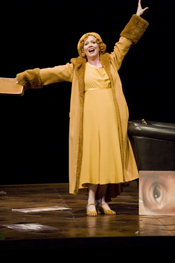 Emily Magee (Marietta)
Emily Magee (Marietta)
There is no doubt that the piece casts its spell from the first note. The
San Francisco audience gave its immediate and full attention to
Korngold’s rich sound, conductor Donald Runnicles lovingly pulling
forth its thick and weighty sonorities from San Francisco Opera orchestra.
The big tune from the opera, “Marietta’s Lied” comes fairly
early but it is really a duet for Paul and Marietta (though it is far better
known as a stand alone concert aria for soprano), and this tune comes back
many, many times, finally as Paul’s wrenching farewell to his dead
wife.
The message of Die tote Stadt is simple – there is no resurrection. It is a plain statement, unadorned with philosophic and religious implications, forcefully presented with the full resources of the post Romantic orchestra with expanded percussion. The Willy Decker production assumes equal proportion in a conception that sometimes juxtaposes and other times superimposes Paul’s present upon Paul’s past, resulting in a confusion of life with dream that brings a whirling corporealness to what is cold and dead. These are the brilliant designs of Wolfgang Gussmann whose black boxes and shadowy abysses inhabited by Decker’s real people and by their shadows. The production means are both enormous and delicately expended.
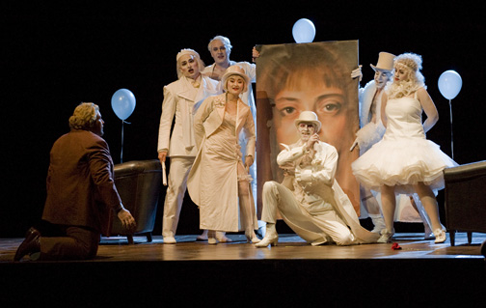 Paul and troupe
Paul and troupe
Donald Runncles resonated mightily with Korngold’s over-the-top sonorities. Torsten Kerl is justifiably famous for the role of Paul. Emily Magee brought impeccable musical taste and character dimensionality as the nemesis of the dead wife. San Francisco Opera’s particular contributions to its performances of the Decker production were adequate. The Frank of Lucas Meachem fulfilled the formidable needs of this role, though it lacked the weight as antagonist to counter balance the musical and dramatic personalities of the production’s protagonists. The Brigitta of Katharine Tier was similarly out of balance. The well-performed commedia scene added enormously to the many pleasures of this production.
Cast and ProductionPaul (Torsten Kerl), Marie/Marietta (Emily Magee), Fritz, Frank (Lucas Meachem), Brigitta (Katharine Tier), Juliette (Ji Young Yang), Lucienne (Daniela Mack), Victorin (Alek Shrader), Count Albert (Andrew Bidlack), Gaston (Bryan Ketron), Paul's Double (Ben Bongers). Conductor: Donald Runnicles. Original Director: Willy Decker. Revival Director: Meisje Hummel. Production Designer: Wolfgang Gussmann.
Turandot at San Francisco Opera
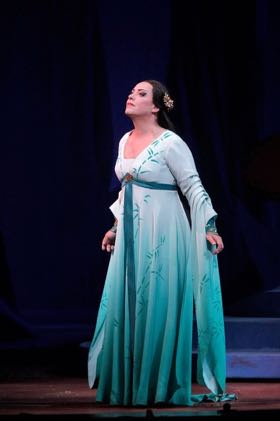
Nine Stimme as Turandot
All photos copyright Cory Weaver, courtesy of San Francisco Opera
San Francisco Opera wrapped up its 95th fall opera season just now with a bang up Turandot. It has been a season of hopeful hints that this venerable company may regain some of its former luster.
The David Hockney Turandot, with the John Adams / Peter Sellers Girls of the Golden West, the Vincent Boussard Manon and the Prague/Karlsruhe/SF shared Elektra were all fascinating in their mises en scène. Only La traviata of the five operas of the 2017 fall season (some of us remember when there were thirteen) suffered an outdated production, though it too had its merits — the three excellent principal singers and the masterful conducting of Nicola Luisotti.
In September the refurbished David Hockney 1992 Turandot burst once again onto the War Memorial Opera House stage in new intense colors for Puccini’s musically imagined Peking, the princess Turandot enacted in highest verismo terms by Austrian soprano Martina Serafin and the pit energized by the subtleties of Puccini’s score, conductor Luisotti having matured over his ten San Francisco years to join the ranks of the great conductors of Italian opera.
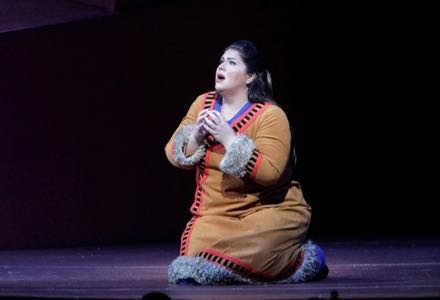
Leah Crocetto as Liu
The Turandot casting evolved in three significant ways for the six November performances. The icy Princess was now sung in highest heroic terms by Swedish dramatic soprano Nina Stemme, the slave girl Liu was sung by former Adler Fellow Leah Crocetto who has achieved a now deserved diva status, and Calaf’s father Timur was sung fully and forcefully by American bass Soloman Howard, grounding this role dramatically into the Liu tragedy of Calaf’s ascension into the realm of high love.
Nina Stemme, the world’s reigning dramatic soprano, took us into the heady stratospheres of the soprano voice and kept us there beyond what we know can be humanly possible. The three riddles were hurled in intense colors and vocal luster, her defeat felt in surprisingly human terms, this superb artist like almost no other is able to be both human and super-human. The ascension to love in the Alfano finale took the human love she had discovered into the rarefied spheres of Romanticism’s spiritual union, this impossible Teutonic ideal rendered possible, finally, in the Puccini oeuvre where before it had never found, or even sought.
Leah Crocetto in her Adler days was perhaps prematurely cast as Liu in the 2011 SFO Turandot. Just now la Corcetto projected the musical and histrionic attributes of a fully arrived, mature artist. Gratefully she is willing to take risks, like her first act “Signore, ascolta!” sung pianissimo, knowing dramatically that it is a silent prayer. It was stunning even with this estimable artist rested on the lower edges of pitch tones. There were not issues at all with her third act “Tu che di gel sei cinta,” delivered with compassion and fervor. La Crocetto brought great dignity to Liu’s tragedy in studied, convincing and satisfying verismo terms.
If conductor Christopher Franklin fully supported these two remarkable artists in their vocal and dramatic subtleties he took the balance of the score to its most blatant terms, knocking out the intimacy of the Ping, Pang, Pong interplay in rhythmic force, and resorting to the latent bombast of both Puccini and Alfano whenever possible. Obvious effect was certainly achieved, a thoughtful realization of the musical and dramatic magic of the Puccini score was sacrificed.
The June revival of the San Francisco Opera’s 2011 Der Ring des Nibelungen will tell more about a perceived new sophistication of casting perspectives at San Francisco Opera. The casting of Evelyn Herlitzius as Brünnhilde is a great start.
Cast and Production
Turandot: Nine Stimme; Calaf: Brian Jagde; Liù: Leah Crocetto; Timur: Soloman Howard; Ping: Joo Won Kang; Pang: Julius Ahn; Pong: Joel Sorensen; A Mandarin: Brad Walker; Emperor Altoum: Robert Brubaker. San Francisco Opera Chorus and Orchestra. Conductor: Nicola Luisotti; Production and Design: David Hockney; Director: Garnett Bruce; Costume Designer: Ian Falconer; Original Lighting Designer: Thomas J. Munn; Lighting Designer: Gary Marder; Choreographer: Lawrence Pech. War Memorial Opera House, San Francisco, November 6, 2017.
Girls of the Golden West at San Francisco Opera
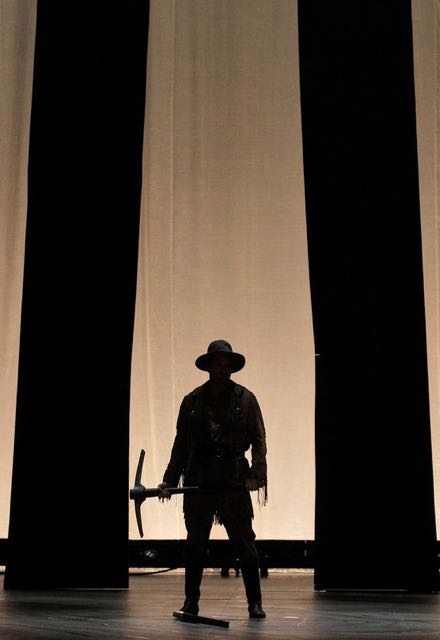
All photos copyright Cory Weaver courtesy of San Francisco Opera
Not many (maybe any) of the new operas presented by San Francisco Opera over the past 10 years would lure me to the War Memorial Opera House a second time around. But for Girls of the Golden West just now I would be there again tomorrow night and the next, and I am eagerly awaiting all future productions.
John Adams’ eighth opera takes his now astonishing sonic and dramatic vocabulary to ever greater depths, creating, ultimately, shattering climax to the lives of seven early Californians, their stories, as construed by librettist Peter Sellars, unfolding both in their own words and in the words of poets and slaves in American history. The real protagonist of Girls of the Golden West is however the corpus of the 49er miners who pursue riches above all else and their inalienable right to the gold of the California mountains.
Girls of the Golden West, as staged by Peter Sellars, is an apt prelude to San Francisco Opera’s forthcoming Der Ring des Nibelungen (it’s essentially the same story). But far more than a prelude it stands on its own as the artistic exploration of the human and social forces of the American post-industrial era (Wagner’s Ring is of the industrial world), insisting that we inherit from these miners a collective guilt for destroying the hopes and lives of people of color — black, brown and yellow, and, yes, even poor Joe Cannon from Missouri (white). It is of epic proportion though it takes a mere three hours compared to the sixteen hours of Wagner’s epic when both finally arrive at a moment of purification.
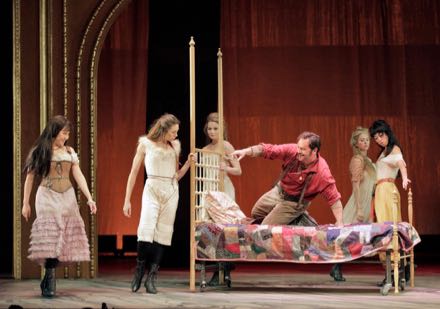
The minor Joe in the whorehouse, with whore Ah Sing, and corp de ballet whores
But Sellars’ Girls of the Golden West goes dramatically beyond its philosophic purpose, immersing us in Adams’ musical worlds of each of its characters. Dame Shirley is an actress from New England who plays Lady Macbeth to the down-on-luck miner Clarence’s Macbeth inciting the miners to lynch Ned Peters, a black slave turned teamster. Joe Cannon’s Sally back home in Missouri marries a butcher, on the rebound he marries a Chinese whore, Josefa is the beautiful Latina lure to attract the miners to the bar where Ramón is the croupier.
Act I is an idyll of perfect life inasmuch as life may be dreamt to be in this beautiful if rough, ugly world. In Act II these worlds are brutally vanquished in music that relentlessly throbs in powerful pulses, punctuated with bursts of tone that cannot be placed.
This bit of California history is real, in the real words of its historical actors, and thus alien to history or myth as usually imagined by opera where elaborated human situations are acted by invented human psyches. Composer Adams composes music to these real words that create art songs, an extended series of songs that you know and feel to be a cycle of some sort. There is a rare duet or two, six or so magnificent male choruses, several ballets (a respectful bow to grand opera), an occasional orchestral interlude. But there is no dialogue and there is no real story.
It is beautiful music of profound lyricism that is fiendishly difficult to sing, thus adding to the atmosphere of art that liberates this Girls of the Golden West from its imposed moral reprimand.
The Sellars production plays on the minimal, the literal and the naive. Scenic designer David Gropman ignores masking, thus there is no illusion. We know what we see is theater, and only that. Against an upstage gold drape stagehands walk on and off with props now and then. Visual quotes from rustic melodrama fly in and out. There is a huge stump and slice of a sacrificed California redwood. Costume designer Rita Ryack stays literal to the period, adding naive concept to dancers’ costumes. Choreographer John Heginbotham too played the naive against the en point classical technique exploits of the four women of the corps de ballet and particularly for the spider dance of prima ballerina Lorena Feijóo as the famed Lola Montez.
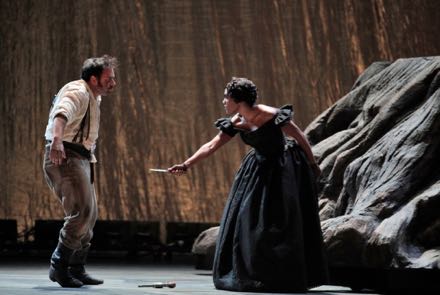
Josefa in the act of murdering Joe
But finally it was the words, and nothing but words, discretely if significantly amplified by sound designer Mark Grey. Amplification served to add heroic dimension to the voices most notably to mezzo-soprano J’Nai Bridges as Josefa Segovia and baritone Elliot Madore as Ramón, these two roles the focus of the Sellars’ romantic tragedy — and it was sublime. Bass-baritone Davóne Tines as Ned Peters as the former slave was the moral focus, drawing a character of immense stature. Tenor Paul Appleby was the driven miner Joe Cannon who with soprano Hye Jung Lee as the Chinese whore Ah Sing created the grittiness and hopelessness of the gold rush free-for-all in their go-for-it-all performances.
Finally the soul of the opera was found in the performance of bass-baritone Ryan McKinny as Joe’s friend Clarence who wielded Lady Macbeth’s knife, forever transforming the lives of the opera’s victims, and in the end, perhaps, embodying the opera’s spiritual redemption. The opera’s redeemer was Dame Shirley sung by soprano Julia Bullock who saw all, and as Lady Macbeth motivated all. Mlle. Bullock found the amplitude of emotional tone to observe, live and understand the tragedies of Downieville, by now a mere gold rush relic in the high Sierras, never letting us forget that these are real people with real names as was she (note that skin color was not always consistent with character).
These unique artists responded perfectly to the John Adams musical world, as did the spectacular accomplishment of the men of the San Francisco Opera chorus, all mastering the daunting score in what seemed to be a perfect performance (the fourth of eight). Conductor Grant Gershon took the San Francisco Opera Orchestra to the magnificent heights of the Adams score, in sometimes mind and heart boggling amplified fortes.
Surely this is composer John Adams’ masterpiece. It is understood that the masterful Peter Sellars setting of the opera is but one of the infinite possibilities for stagings of the Sellars libretto and Adams score.
Cast and production
Dame Shirley: Julia Bullock; Ned Peters: Davóne Tines; Joe Cannon: Paul Appleby; Ah Sing: Hye Jung Lee; Clarence Ryan McKinny; Josefa Segovia: J’Nai Bridges; Ramón: Elliott Madore; Lola Montez: Lorena Feijóo. Chorus and Orchestra of the San Francisco Opera. Conductor: Grant Gershon; Stage director: Peter Sellars; Set designer: David Gropman; Costume designer; Rita Ryack; Lighting designer: James F. Ingalls; Sound designer: Mark Grey; Choreographer: John Heginbotham. War Memorial Opera House, San Francisco, November 29, 2017.
Manon at San Francisco Opera
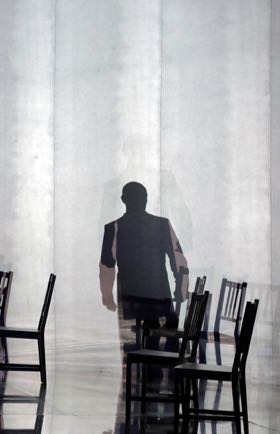
Shadow of des Grieux in the Vincent Boussard production
[All photos copyright Cory Weaver courtesy of San Francisco Opera]
Nothing but a wall and a floor (and an enormous battery of unseen lighting instruments) and two perfectly matched artists, the Manon of soprano Ellie Dehn and the des Grieux of tenor Michael Fabiano, the centerpiece of Paris’ operatic Belle Époque found vibrant presence on the War Memorial stage.
Not that Jules Massenet’s 1884 opera based on the Abbé Prevost’s 1731 novel has much to do with San Francisco’s tech drenched world. Except that the production by French director Vincent Boussard — with a perfect cast top to bottom (a rare feat for SFO) and deep musical sympathy for Massenet’s trivial but magnificently crafted score by French conductor Patrick Fournillier — reverberated with trivial, exquisitely crafted emotions. It was a pure, universal art without much to do with anything or anywhere.
American soprano Ellie Dehn (Fiordiligi and Donna Elvira in recent SFO Mozart revivals) brought purity of voice, impeccable technique and refined musicianship and made Massenet’s shallow trollop into an exquisite porcelain miniature. In aria after aria (there are lots and lots of them) Ms. Dehn’s Manon’s artistic integrity belied her selfishly frivolous ambitions. Her crystalline portrayal reflected off of the mirrored floor, her shadow caught on a curved wall that was at once her world and the world’s display case.
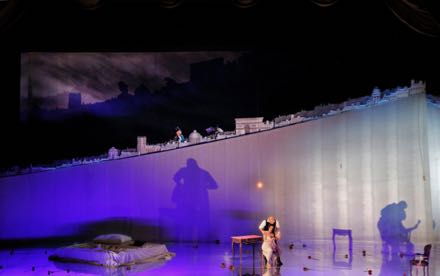
La petite table of Act II
American tenor Michael Fabiano (Rodolfo and Don Carlo in recent SFO productions, Jose at the Aix Festival) added stature to his exploding career as des Grieux, the amplitude of his voice and his studied acting made Massenet’s impulsive young lover — who without a second thought hides his chagrin in abbott’s habit overseen by crucified Jesus hanging in an upper vast black void — into a formidable operatic creation, never mind that it only took a few confused seconds for him to pull Manon onto the floor of the church and roll on top of her. All this after his exquisite "Ah ! Fuyez, douce image” that was met with our thunderous applause.
For those many of you who didn’t stick around for the end, Manon expired down stage center in des Grieux’ arms before rolling off the mirrored floor into the total black void that had enveloped the entire stage, all traces of the world erased. There were only these two meaningless creatures in the throes of high art. It was, in fact, sublime.
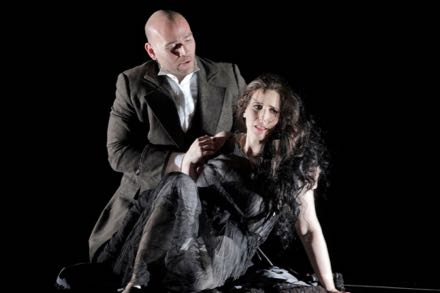
Michael Fabiano as des Grieux and Ellie Dehn as Manon of Act II
Director Boussard’s set designer Vincent Lemaire provided the curved sloping wall and the mirrored floor that continued up the downstage left wall. As well it will have been Mr. Lemaire who provided the nothingness of the black void. Mr. Boussard created his own costumes, fantasy abstractions of the Belle Époque, the women’s costumes adding intense color to the colorless monotones of the stage. Gilded shopping bags and gift boxes punctuated the space, not to overlook the bouquets of balloons, one of which transported Manon from the top of the wall to the floor of the stage!
This complex stage may have been heaven itself for the art of lighting designer Gary Marder, or maybe it was hell. Whichever, the lighting was a tour de force. From time to time the floor reflected onto the wall, the wall was bathed in color reflected on the floor, the minds and bodies of the actors were amplified by their shadows cast upon the wall, all the stage was black except for the precise illumination of the singers, and seemingly infinite variations of all the above.
The French of the all American cast had been coached to kingdom-come, making the spoken dialogues fun to follow as best we could, helped by the supertitles. Excellent companions to the Manon of Ms. Dehn and the des Grieux of Mr. Fabiano were des Grieux’ father (an exact echo of La traviata’s Germont), richly intoned by age appropriate bass James Creswell, Manon’s sleazy cousin Lescaut cockily delivered by baritone David Pershall and Lescaut’s rich friend de Bretigny intoned by elegant and worldly Timothy Mix. Providing additional, substantial vocal pleasure was the trio of actresses smoothly sung by Renée Rapier, Laura Krumm and Monica Dewey (strangely not a current Adler Fellow on the roster).
A slowly descending grand chandelier substituted the fourth act ballet, though when Manon’s original suitor Guillot (Robert Brubaker) entered he was accompanied by a sous-sus-ing ballerina in tutu (Rachel Speidel Little) on a leash.
This masterful Boussard production originated in Vilnius in 2015. From San Francisco it travels to Tel Aviv. Not to be missed.
Cast and Production
Manon: Ellie Dehn; Chevalier des Grieux: Michael Fabiano; Lescaut: David Pershall; Comte des Grieux: James Cresswell; De Brétigny: Timothy Mix; Guillot: Robert Brubaker; Pousette: Monica Dewey; Javotte: Laura Krumm; Rosette: Renée Rapier. Chorus and Orchestra of the San Francisco Opera. Conductor: Patrick Fournillier; Stage Director: Vincent Boussard; Associate Director: Gediminas Seduikis; Scenery: Vincent Lemaire; Costumes: Vincent Boussard; Lighting Designer: Gary Marder. War Memorial Opera House, San Francisco, November 7, 2017.
La traviata at San Francisco Opera
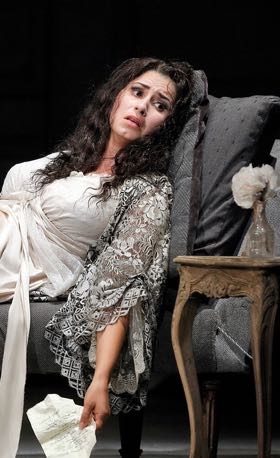
Aurelia Floria as Violetta
[All photos copyright Cory Weaver courtesy of San Francisco Opera]
A beautifully sung Traviata in British stage director John Copley’s 1987 production, begging the question is this grand old (30 years) production the SFO mise en scène for all times.
Romanian soprano Aurelia Florian sings Violetta in all ten performances (through October 17). She is young and pretty, her voice is strong and rich throughout all registers, and her high notes are splendid (she does not take the optional high E flat in the “Sempre libera”). Verdi famously wanted a real woman for this role, a woman who could actually suffer. Mme. Florian does indeed suffer, if as a heroine of opera’s coming verismo. In Verdian terms la Florian’s Violetta is far from the proto-verismo of his delicate Desdemona, hers is more his decisive Lady Macbeth.
Most of all Mme. Florian greatly pleases us as an excellent singer. That she is also a suffering mid 19th century courtesan is less compelling.
Alfredo, the Brazilian tenor Atalla Ayan, is an excellent singer as well. His voice is wonderfully even throughout its registers, its tone more decisive than rich. He offers his arias with a vocal enthusiasm that is infectious, easily projecting his vibrant emotions.
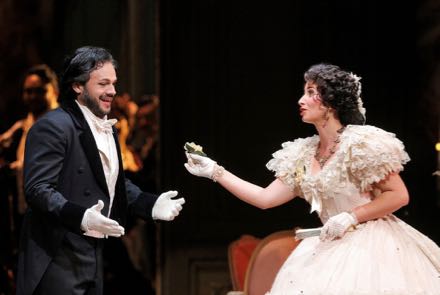
Atalla Ayan as Alfredo, Aurelia Floria as Violetta
In the first act both singers easily found their characters, Violetta seated alone in her grand salon to contemplate her “Ah fors’è lui,” then to burst onto her balcony to deliver its antithesis, Alfredo, behind the scene, grandly intoning his ardor.
The second act became difficult, the complex turns of the plot demand subtle development of character and emotion, here the actors were exploiting the fine movement of their voices, leaving the unfolding tragedy to find its own way. The loss of dramatic focus was most evident in the Germont of young Polish baritone Artur Ruciński. Mr. Ruciński is an extraordinary singer, able to gloriously project text in musical line, providing enormous satisfaction to his listeners. But he did not achieve the warmth and maturity and the deep humanity of this sympathetic, honest man trapped in provincial morality.
The Copley production in this fifth edition staged by Shawna Lucey became clumsy in the gambling scene, the chorus and ballet cumbersome, and the showdown (Alfredo humiliating Violetta) pallid. Without having deepened and exploited the opera’s personalities the death scene read as incidental.
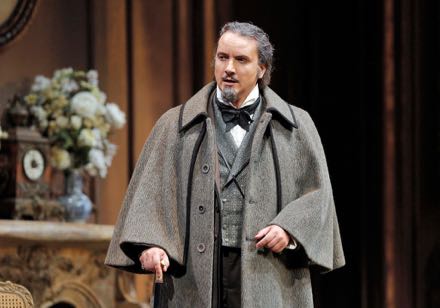
Artur Ruciński as Germont
Meanwhile conductor Nicola Luisotti was finding every palpitation of emotion in the score, the strings of the San Francisco Opera orchestra choking with emotion in the overture, the clarinet solo unabashedly sobbing while Violetta writes her note to Alfredo, the enormity of the tragedy welling up in the death scene, the finality of death hammered in the final, magnificent roll of the tympani.
In concert with the truly excellent singing the magnificence of the Luisotti orchestra trapped this evening into inexplicable musical and dramatic frigidity.
As Verdi wished (and was initially denied) the Copley production sets the action in 1852 or so. Verdi wanted the contemporary moment. Of course it is now 2017. Our contemporary moment is of great complexity, and of a breadth far beyond the concerns of Verdi. It is a fascinating question how to stage a timeless work of art in a production that recognizes, respects and exploits the artistic and moral accomplishment of the intervening 150 or so years.
This production marked the first time supertitles were used for La traviata at San Francisco Opera. The supertitles were created by Jerry Sherk (SFO’s then production manager, now legendary). They tell the story simply and easily in the abstract manner of supertitles of that era. It is time to create new supertitles for future productions that echo the rhythms of the phrases as they are sung.
It should be mentioned that sloppy masking in the first act allowed an annoying, blinding light from a stage manager’s desk to escape into the house.
Cast and production
Violetta Valery: Aurelia Floria; Alfredo Germont: Atalla Ayan; Giorgio Germont: Arthur Rucinski; Flor Bervoix: Renee Rapier; Gastone: Amitai Pati; Baron Douphon: Philip Skinner; Doctor Grenvil: Anthony Reed; Marquis d’Obigny: Andrew G. Manea; Annina: Amina Edris. Chorus and Orchestra of the San Francisco Opera. Conductor: Nicola Luisotti; Production: John Copley; Stage Director: Shawna Lucey; Set Designer: John Conklin; Lighting Designer: Gary Marder; Choreogorapher: Carola Zertuche; Costume Designer: David Walke. War Memorial Opera House, San Francisco, September 26, 2017.
Elektra at San Francisco Opera
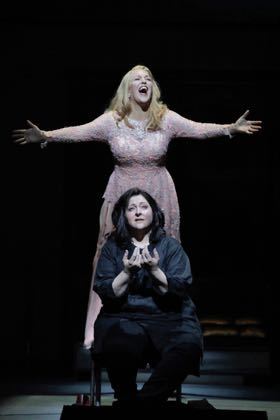
Christine Goerke as Elektra, Adrianne Pieczonkan as Chrysothemis
[All photos copyright Cory Weaver courtesy of San Francisco Opera]
Among the myriad of artistic innovation during the Kurt Herbert Adler era at San Francisco Opera was the expansion of the War Memorial Opera House pit. Thus there could be 100 players in the pit for this current edition of Strauss’ beloved opera, Elektra!
Among the accomplishments of the Gockley era was music director Nicola Luisotti's refinement of the San Francisco Opera Orchestra. And perhaps in no other opera can the glories of this superb orchestra shine forth more brilliantly than in Elektra, the Strauss score demanding myriads of colors and masses of volumes to tell its very ugly story.
It is very beautiful music, but unlike bel canto that can tell ugly stories too, Strauss modernism finds its beauty in sonically colorful hues that intensify the human spirit in its most dreadful conflicts (bel canto revels in the voices it uses to overpower conflict). All this Strauss orchestral magnificence was indeed present for this Elektra!
On stage was British stage director Keith Warner’s staging, a co-production with Prague’s National Theatre where the production debuted last year, and with the Karlsruhe (Germany) opera. It is a rarity these days to find a high concept European-style production on the War Memorial stage.
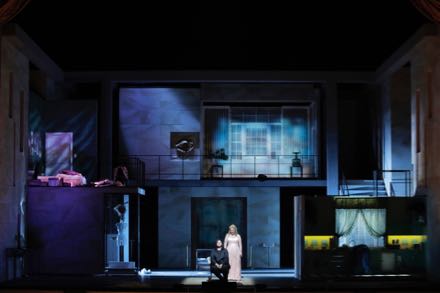
Museum with interpolated bedroom, living room and kitchen of surrogate family
Director Warner set up his concept in the a vista (open-to-view) stage while the audience was finding its way to its seats and reading the program booklet. Those of us who didn’t pay much attention to the open stage and to what we assumed was an over-used Brechtian convention (meaninglessly used in the 2009 Salome as example) had some catching up to do once the opera started. We had no idea that the evening had begun before it began.
But we correctly assumed that the girl dressed all in black was Elektra. Little by little it became clear that the setting was not just a museum but actually an antiquities museum, and the girl dressed in black was going to relive a domestic drama (mother kills the girl’s father), its actors confused between ghosts of antiquity and the actual members of a modern family.
Thus it became a sort of soap-opera docudrama of the Strauss opera that we either enjoyed sorting out, most evidently did, or we did not (I didn’t). Director Warner was so involved creating his concept in a myriad of detail that the idées fixes — the obsessions — of Elektra, Klytemnestra, and Orest simply evaporated into his orgy of storytelling.
In fact Mr. Warner’s Elektra re-creation was so vividly explained that for me it overpowered the splendors emanating from the pit and eviscerated the opera’s usual punch.
The Elektra bar has been set really high in recent productions around the world. San Francisco Opera’s Elektra, American soprano Christine Goerke, kept pace. She is in prime form vocally, and showed herself well capable of withstanding Elektra’s extended vocal tortures with appealing musicianship. If from time to time you wished for a bigger sound you got it when Strauss demanded it. On stage she gamely and convincingly fulfilled director Warner’s idea of a family’s black sheep child in dramatic soprano wolf’s clothing.
Canadian soprano Adrianne Pieczonka is the world’s reigning Chrysothemis. Her voice was of innocent sweetness until she became overwhelmed with Elektra’s demands and then it soared proudly over the hugest orchestral climaxes. She too convincingly and unflinchingly embodied director Warner’s character, complete with little girl mannerisms while hugging her teddy bear.
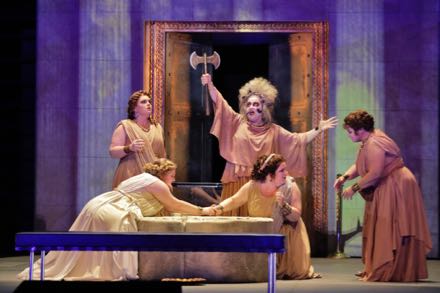
The five Maidservants
The five maidservants of the opera’s beginning were splendidly sung once they were allowed on stage (initially they were off-stage, their sound uncomfortably muffled, so that director Warner could make his point that the ghosts of the museum were to come alive).
The balance of the cast was a mixed bag. Stephanie Blithe was to have been the Klytemnestra but she cancelled. Her replacement, Michaela Martens was over-parted in the company of Mmes. Goerke and Pieczonka, as were the Orest of Alfred Walker and the Aegisth of Robert Brubaker.
Young Hungarian conductor Henrik Nánási gave convincing body to the Strauss orchestral score. Note that Mr. Warner’s staging was effected in San Francisco by Anja Kühnhold of the Badisches Staatstheater Karlsruhe.
Cast and production information:
Elektra: Christine Goerke; Klytemnestra: Michaela Martens; Chrysothemis: Adrianne Pieczonka; Orest: Alfred Walker; Aegisth: Robert Brubaker; Tutor of Orest: Anthony Reed; Fifth Maidservant: Rhoslyn Jones; The Overseer: Alexandra Loutsion; Maidservant 1: Jill Grove; Maidservant 2: Laura Krumm; Maidservant 3: Nicole Birkland; Maidservant 4: Sarah Cambidge; Klytemnestra’s Trainbearer: Amina Edris; An Old Servant: Bojan Kneževiċ; A Young Servant: Kyle van Schoonhoven; Klytemnestra's Confidante: Erin Neff. San Francisco Opera Orchestra. Conductor: Henrik Nánási; Original Director: Keith Warner; Revival Director: Anja Kühnhold; Set Designer: Boris Kudlička; Costume Designer: Kaspar Glarner; Lighting Designer: John Bishop; Video Designer: Bartek Macias. War Memorial Opera House, San Francisco, September 13, 2017
Turandot at San Francisco Opera
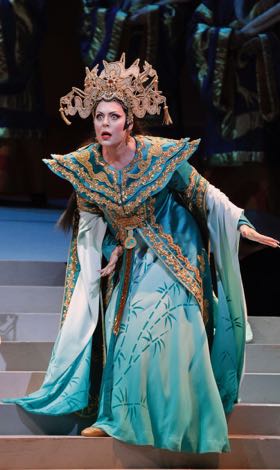
Martina Serafin as Turandot
[All photos copyright Cory Weaver courtesy of San Francisco Opera]
Mega famous L.A. artist David Hockney is no stranger at San Francisco Opera. Of his six designs for opera only the Met’s Parade and Covent Garden’s Die Frau ohne Schatten have not found their way onto the War Memorial stage.
The hype surrounding the Hockney retrospective just now in Paris, last year in London and soon to arrive at New York’s Met (November 27), and certainly the 2013 Hockney exhibition at SF’s De Young have kept this now 80 year-old icon of canvas painting at the center of the art world’s attention.
Thus there has been excited anticipation of this operatic addition to a Hockney retrospective. His 1992 Turandot burst just now onto the War Memorial stage like it had never before been there. And there are reasons for this perception.
There was a more intense sense of color indeed as the scenic drops had been repainted, plus (and I am surmising) there were (perhaps) more sophisticated lighting instruments in use that brought greater luminosity to color and clarity of shape. [For the record: current SFO lighting designer Gary Marder used the original 1993 lighting plot to light the scenery. Intensities were brightened from those found on a poor quality video of the 1993 production. Newer high-intensity lamps were used to light the actors.]
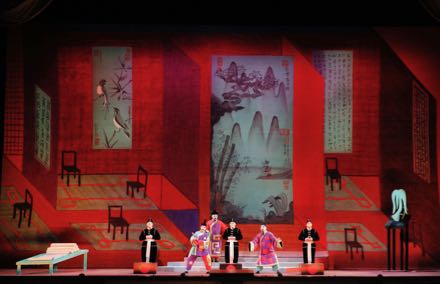
Act II, scene 1. Ping, Pang, Pong, in front of Hockney drop in reverse perspective
A more compelling contribution for this new discovery of the Hockney production was conductor Nicola Luisotti who triggered timeless lyricism into the Puccini’s sonically massive score. As David Hockney defies space with his plays of and on perspective, conductor Luisotti made time stand still with tempos and tonalities that dwelt on fixing the specific place and amplifying the immediate emotion — in fact eternalizing the moment. It was an amazing musical feat that intensified the Hockney discovery of the huge spaces and boundless desire.
The opera Turandot is much like what Hockney discovers in his L.A. swimming pools — a magical world of vivid color and commanding shape in which not-so-covert desires dance in motionless forms. That Puccini’s Turandot is dramatically stagnant intrigued Hockney and Luisotti to create Puccini’s opera as a parable of desire extended onto a timeless flat canvas.
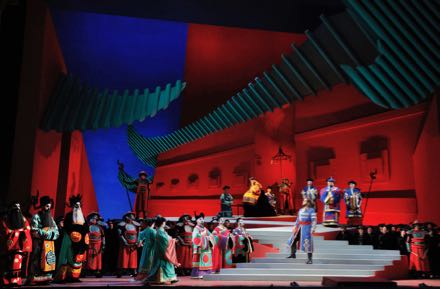
Act II, scene 2. Calaf answering riddles
As conducted by Luisotti last night the Hockney production proved itself a masterpiece.
Of the cast only Austrian soprano Martina Serafin rose to the level of the production. The 47 year-old diva rang the icy tones of a Turandot isolated in blind revenge until her emotions finally roared forth in unleashed verismo. She and conductor Luisotti musically and dramatically validated Franco Alfano’s controversial conclusion.
American tenor Brian Jagde has finally found his niche as the stentorian Calaf with such tones unrelentingly imposed on Turandot and the Chinese crowds and us. If initially thrilling in effect his clean tone wore as it remained unvaried. This fine, young tenor showed his stylistic limitations in the first act where middle voice strength and emotional mannering make Calaf one of the repertoire’s more challenging roles. Adler Fellow (SFO’s finishing school) Toni Marie Palmertree sang Liu quite beautifully but Liu’s innocence was replaced with the bravura of inexperience.
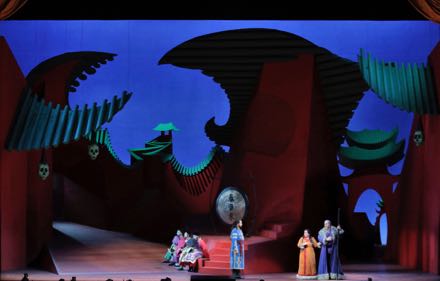
Act 1. Ping, Pang, Pong, Calaf, Liù and Timur
The pathos of Calaf’s father Timur, sung by bass Raymond Aceto, somehow got lost in the melée. Korean baritone Joo Won Kang was a lovely sounding if small voiced Ping, Korean tenor Julius Ahn as Pang added energy to the trio of counselors, and tenor Joel Sorensen as Pong capped the group with infectious gusto. Baritone Robert Brubaker delivered, gratefully, the Emperor Altoum as a dignified, fine voiced father of Turandot.
The huge chorus and the principals were expertly and very beautifully posed and moved about by American regional stage director Garnett Bruce who always respected the flat surface of the stage canvas. He amusingly employed six, mostly-naked senior citizen eunuchs to execute the Prince of Persia and later to remove the dead Liu.
Cast and production
Turandot: Martina Serafin; Calaf: Brian Jagde; Liù: Toni Marie Palmertree; Timur: Raymond Aceto; Ping: Joo Won Kang; Pang: Julius Ahn; Pong: Joel Sorensen; A Mandarin: Brad Walker; Emperor Altoum: Robert Brubaker. San Francisco Opera Chorus and Orchestra. Conductor: Nicola Luisotti; Production and Design: David Hockney; Director: Garnett Bruce; Costume Designer: Ian Falconer; Original Lighting Designer: Thomas J. Munn; Lighting Designer: Gary Marder; Choreographer: Lawrence Pech. War Memorial Opera House, San Francisco, California, September 12, 2017.
La bohème at San Francisco Opera
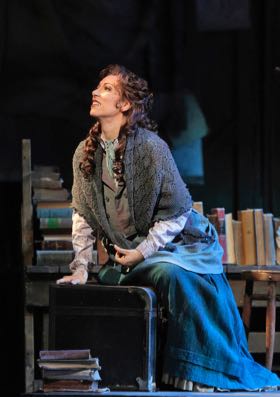
Erika Grimaldi as Mimi
[All photos copyright Cory Weaver courtesy of San Francisco Opera]
In 2008 it was the electrifying conducting of Nicola Luisotti and the famed Mimì of Angela Gheorghiu, in 2014 it was the riveting portrayals of Michael Fabbiano’s Rodolfo and Alexey Markov’s Marcelo. Now, in 2017, it is the high Italian style of Erika Grimaldi’s Mimì — and just about everything else!
Notably the crystalline story telling of Puccini’s sad little tale by director John Caird. Gone, well mostly gone, was his forced metaphor of life becoming art, i. e. the Paris of Marcello’s paintings (a collage) as the backdrop for Mimì’s death to become Rodolfo’s muse (blatant in his 2014 SFO staging). In its place nothing but detail, and no detail in the staging not discovered in the Puccini score — in large strokes the precise restaurant service at the Café Momu, in tiny strokes the sprinkling of water droplets to triangle tings. With this specificity director Caird found his story in the music. Marvelous even magical storytelling was the result.
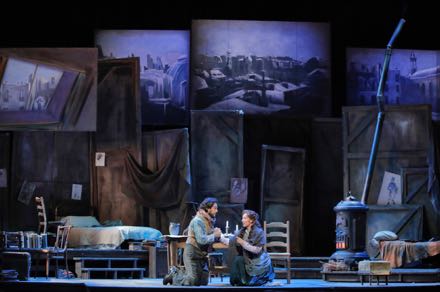
Arturo Chacón-Cruz as Rodolfo, Erika Grimaldi as Mimì
Conductor Carlo Montanaro was a skilled collaborator, providing an energetic canvas for director Caird’s realization of Puccini’s four brief vignettes of Parisian bohemian life. Montanaro’s reading vividly portrayed this Paris and its little tragedies without imposing the power of music to overwhelm their importance. His was a descriptive reading of that world, not a profound descent into its most private moments. Except, maybe, in soprano Mimì’s moving Donde lieta, splendidly delivered by Erika Grimaldi.
The masterpiece status of Puccini’s opera was resoundingly reaffirmed.
Amidst a cast that seemingly could have stepped right out of Montmartre Italian soprano Erika Grimaldi stood out as the voice of Italian opera, delivering the delights of Italian schooling (ma che scuola!). In a full, warm voice that bespoke Puccini’s Tuscan landscape she articulated language with throaty finesse and allowed her tongue ample freedom to roll and punctuate. The largest voice of the evening, well exploiting the sculpture of soaring lines la Grimaldi was indeed this Bohème — the title of the show.
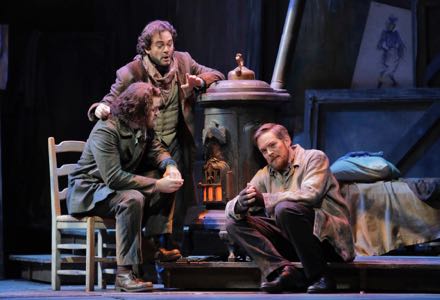
Brad Walker as Schaunard, Arturo Chacón-Cruz as Rodolfo, Scott Conner as Colline
Mexican tenor Arturo Chacón-Cruz stretched his voice to take on Rodolfo, his lighter timbre permitting him to exploit the flow of Puccini line rather than to mimic tenorial mannerisms. His Rodolfo was youthful, charming and real. Norwegian baritone Auden Iversen was a small scale, believable Marcello, his darkly hued voice adding unexpected color and therefore an earthy reality to this mix of bohemians. American bass Scott Conner was a low affect Colline. He as well fit right into the gang, his aria to his coat sung softly and very beautifully. Adler Fellow Brad Walker made himself leader of the gang with his lively, fun and richly vocal presence.
Inexplicably cast (yet again) as Musetta Mozart soprano Ellie Denn made this vibrant Puccini character matronly in beautiful, measured tone.
Mimì’s death, the fourth vignette, slowly and softly revealed each of the bohemians coming to grips with death, making Rodolfo’s death cry a sudden recognition of finality to a magical vision of young life as art. It was indeed beautiful.
And very slick.
Cast and production
Mimì: Erika Grimaldi; Musetta: Ellie Dehn; Rodolfo: Arturo Chacón-Cruz; Marcello: Audun Iversen; Colline: Scott Conner; Schaunard: Brad Walker; Benoit: Dale Travis; Alcindoro: Dale Travis. San Francisco Opera Chorus and Orchestra. Conductor: Carlo Montanaro; Director: John Caird; Production Designer: David Farley; Lighting Designer: Michael James Clark. War Memorial Opera House, San Francisco, June 15, 2017.
Don Giovanni at San Francisco Opera
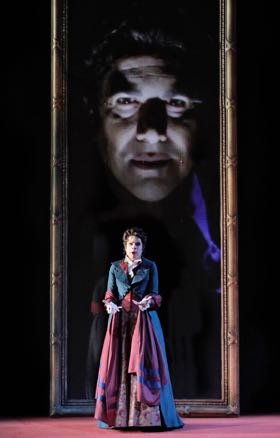
Lianna Hartounounian as Cio-Cio-San
[All photos copyright Cory Weaver courtesy of San Francisco Opera]
San Francisco Opera revved up its 2011 production of Don Giovanni with a new directorial team and a new conductor. And a blue-chip cast.
Originally staged in 2011 by Italian actor and theater director Gabriele Lavia, a sometime Nicola Luisotti collaborator for opera productions in Italy and Japan, this SF production hung twenty two huge, framed mirrors that flew in and out of an empty black space. Lavia did sometimes move the action among them, but usually he simply paraded the protagonists back and forth across the front-of-stage where maestro Luisotti could keep them under his baton.
The mirror metaphor can indeed be visually effective, and it does infer all sorts of conceptual profundity. But mostly it simply reflects what is and then simply asks what it all means. Responding to this lack of content San Francisco Opera brought in an alternate director, Italian theater director Jacopo Spirei who brought with him Tommi Brem, a theatrical video designer. No longer reflections, the mirrors framed video portraits of characters of interest to whomever might be singing an aria. This was only sometimes. Usually the frames were blank.
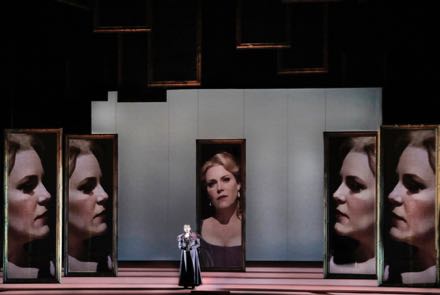
Erin Wall as Donna Anna plus Donna Anna in video image
It all ended with the face and hands of the consumed Don Giovanni plastered on a number of frames, evidently trying to get back in. Or something.
Though Luisotti was no longer in the pit, the protagonists still crossed and re-crossed the front-of-stage pathway to sing the arias we know so well. The new conductor was Marc Minkowski, once famed as an early music conductor now general director of Opéra National de Bordeaux. Minkowski is not insensitive to what happens on stage — as example his conducting of the 2013 inebriated production of Don Giovanni at the Aix Festival was absolutely wacko. In keeping with this production however he gave us the score exactly as written, his quick, very quick tempos avoiding any exploration of the score whatsoever. And that is what was on the stage.
The splendid San Francisco Opera orchestra did indeed keep the pace, but the smooth sounds of a modern symphony orchestra do not give the bite and scratch needed to articulate the phrasing and structure of a Mozart score at such speed. Arms flailing in the overture Minkowski did indeed let us know he is a divo. His pit erected an orchestral entity that remained haughtily separate from the world of the stage — even though evidently he fully knew what was there. The finales of both acts I and II were a mess. He could not have cared.
Even so it was, after all, Don Giovanni, and there was a cast well qualified to perform the roles. Thus some of the magic of the masterpiece did shine through from time to time. All excellent singers, they were seven artists in search of a production.
Da Ponte’s characters came straight off the pages of the score, no deeper exploration at all, i.e. the production asked no questions (though no doubt these artists had many). Ildebrando D’Arcangelo, the Don Giovanni, was seductive, defeated and unrepentant. Leporello, sung by Erwin Schrott was quick, articulate and knew the score (no puns intended). Donna Anna, sung by Erin Wall, was indeed aggressed by the Don and indeed suffered, Don Ottavio, sung by Stanislas de Barbeyrac, fully understood her need of a year to recover. Donna Elvira, sung by Ana Maria Martinez, was sillily obsessed by the Don. Zerlina and Masetto, sung by Sarah Shafer and Michael Sumuel, gamely did their thing.
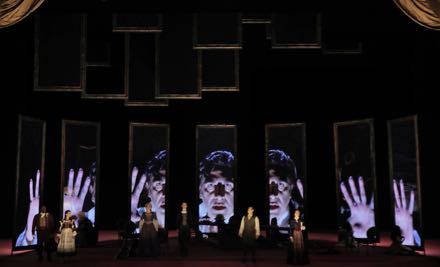
All principals in Epilogue and final video image of Don Giovanni
No doubt the simulcast of the opera house performance onto the score board of AT&T stadium on June 30 is the place to get the best of this Don Giovanni. On-screen opera focuses on the faces of the performers rather than on the production.
Cast and production
Don Giovanni: Ildebrando D’Arcangelo; Donna Anna: Erin Wall; Donna Elvira: Ana María Martínez; Leporello: Erwin Schrott; Don Ottavio: Stanislas de Barbeyrac; Zerlina: Sarah Shafer; Masetto: Michael Sumuel; Commendatore: Andrea Silvestrelli. Chorus and Orchestra of the San Francisco Opera. Conductor: Marc Minkowski; Stage Director: Jacopo Spirei; Projections and Scenic Adaptations: Tommi Brem; Costume Designer: Andrea Viotti; Lighting Designer: Gary Marder; Original Set Designer: Alessandro Camera. War Memorial Opera House, San Francisco, June 8, 2017.
Rigoletto at San Francisco Opera
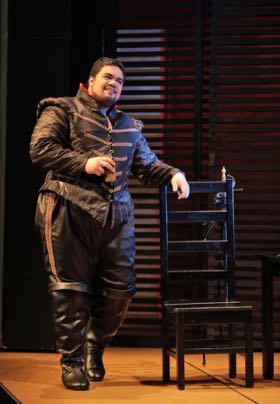
Pene Pati as the Duke of Mantua
[All photos copyright Cory Weaver courtesy of San Francisco Opera]
Every once in a while a warhorse redefines itself. This happened last night in San Francisco when Rigoletto propelled itself into the ranks of the great masterpieces of opera as theater — the likes of Falstaff and Tristan and Rossini’s Otello.
The two Rigoletto’s were clearly evident, that of its protagonists in the persuasive lyricism of the jester and his daughter and the Duke of Mantua, and that of its clumsy dramatic rhetoric — the curse of Monterone. British stage director Rob Kearney, working in the 20 year-old sets designed by Michael Yeargan (SFO’s current Ring among countless others), exploited Yeargan’s minimalist abstractions of neoclassic architecture and blocks of primary color to frame Verdi’s actors in abstracted, often long sustained dramatic poses when not responding to the commotion of the courtiers in detailed lazzi (commedia dell'arte staging tricks) by four dancers.
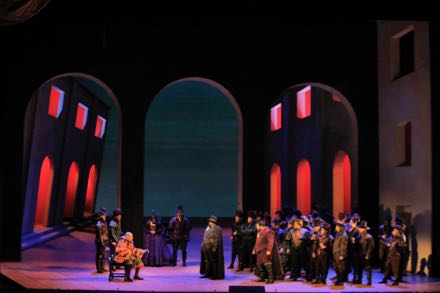
Respecting a (i.e. my) perceived Luisotti dictum director Kearney moved the action into and out of the downstage areas easily controlled by the maestro’s baton. In this splendid evening however it was evident that three powerful artists had the maestro in their thrall. This synergy created what may have been conductor Nicola Luisotti’s finest hour at San Francisco Opera as he led an impeccably measured exposition of Verdi’s early middle period opera as pure bel canto.
Beautiful singing is basic to Rigoletto as its basic emotions are beautiful and very human — the love of a father for his daughter and the freshness of youthful desire. Baritone Quinn Kelsey, once a Merola participant and then a house singer at San Francisco Opera, has matured into a formidable bel canto artist, able to discover larger and longer contours in Verdi’s musical lines and to manipulate the inherent emotion of text without breaking line. Now in his vocal prime, Kelsey possesses a strong instrument of golden tone he has placed in service to high style.
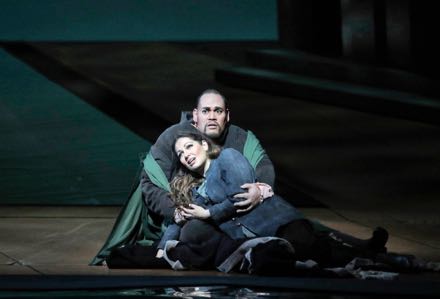
Quinn Kelsey as Rigoletto, Nino Machaidze as Gilda
Soprano Nino Machaidze has a warm maturity of voice and a command of style that goes far beyond the innocence of Victor Hugo’s young victim. It was her intelligence that thrust this performance to a musical plateau where anything is possible, in this case a virtual musical embodiment of an adolescent girl gilded in magnificent sound. It was this ideal of bel canto that gave unique definition to the drama of this Rigoletto.
Ingénu tenor Pene Pati is purely and simply the vocal embodiment of the Duke of Mantua, possessing the vocal swagger, the freshness of voice, and the creative energy that makes the Duke, indeed all youth, lovable. The artistic achievement of this debut in a major role on a major stage was formidable, this young artist fusing surprisingly graceful stage movement with nearly impeccable vocal delivery. And there was solid tenorial attitude. Aplenty.These three artists inhabited their musical worlds to the fullest. It was the collision of their worlds that created high operatic drama on the War Memorial stage, and proved, as does happen every so often, that opera is the most rarefied and distilled of all theatrical worlds.
If conductor Luisotti’s pit was devoid of all exaggeration, so was director Kearney’s stage, the melodrama of Monterone’s curse was defused by placing it always front and center and always thundering it in the voice of bass Reginald Smith, Jr. Nothing more. The fulfillment of the curse was relegated to the shadows. Andrea Silvestrelli in his signature role as Sparafucile, emerged from the darkness from time to time to realize the Monterone’s vengeance. Maddalena, sung by Adler Fellow Zanda Švēde appeared only in the dim environs of his inn and then only to satisfy the Duke’s desire. Nothing more.
San Francisco Opera resident lighting designer Gary Marder created a mottled darkness that permeated the evening, offset from time to time by saturated blocks of primary color. Mr. Marder’s lighting discovered entirely new atmospheres for this old production, atmospheres that were instrumental in upholding the intense musical level of this remarkable evening. Even the Yeargan set was swept up in the musicality, when required its elements changed position, motion seemingly initiated not by mechanics but by the sheer power of the music. Gesamtkunstwerk indeed.
Luisotti’s orchestra played with requisite finesse, the lower strings elegantly grinding gutsy drama into Rigoletto’s realization that he had been tricked, solo wind instruments suavely adding subtle feeling to arias à la Rossini. Kelsey Quinn’s “Cortegiani” acquired an unusual sophistication in tones that moved us, and moved the resplendent San Francisco Opera’s courtiers to back off, thus creating a quite powerful emotional vista — amply rewarded with prolonged applause.
Cast and production
Rigoletto: Quinn Kelsey; Gilda: Nino Machaidze; The Duke of Mantua: Pene Pati; Maddalena: Zanda Švēde; Sparafucile: Andrea Silvestrelli; Count Monterone: Reginald Smith, Jr.; Marullo: Andrew G. Manea; Borsa: Amitai Pati; Count Ceprano: Anthony Reed; Countess Ceprano: Amina Edris. San Francisco Opera Chorus and Orchestra. Conductor: Nicola Luisotti; Stage Director: Rob Kearley; Set Designer: Michael Yeargan; Costume Designer: Constance Hoffman; Lighting Designer: Gary Marder. War Memorial Opera House, San Francisco, June 6, 2017.
Boris Godunov in San Francisco

Samuel Ramey (Boris Godunov)
All photos by Terrence McCarthy courtesy of San Francisco Opera
As performed just now by the San Francisco Opera Mussorgsky’s initial (1869), seven scene version of Boris Godunov revealed itself a finished masterpiece.
As recently as 1992 SFO still made use of an “improved” version of this magnificent opera — Mussorgsky’s own so-called definitive version (1872), improved in that it provided a role for a diva, added a resplendent ball scene and included the pretender Dimitri’s march to Moscow.
The fate of Mussorgsky’s Boris gets even more complicated because after his death his friend Rimsky-Korsakov did him the favor of improving his vocal lines and his orchestration, and then 50 years later Soviet composer Shostakovitch improved the Rimsky-Korsakov version. San Franciscans know all three musical versions, in the early years it was the Rimsky-Korsakov, but as one of the world’s progressive companies in the 1970’s San Francisco Opera was among the first to recover Mussorgsky’s original orchestration. The more recent 1992 staging offered, gratefully, the fine Shostakovitch version.
Vitalij Kowaljow (Pimen) and Vsevolod Grivnov (Grigory)This twelfth San Francisco Opera staging of Boris Godunov is the first time that San Franciscans will see Mussorgsky’s original seven scenes. The profound concentration of the audience (10/30/08) made it apparent that there was not one note too many, nor one note too few. It was a performance of perfection, our hearts and minds focused, with Mussorgsky, on the power, the fear and the anguish of Pushkin’s guilty czar Boris.
Never mind that modern historians do not find Boris guilty of murdering the czarevitch Dimitri, Pushkin and Mussorgsky did, thus Boris lives in history as a magnanimous ruler tormented by the crime that made him the ruler of Russia. Boris is a man who is kind to his children and his people, and brutally cruel to his enemies. Obsessed by the terrible guilt of murder, he understands that his crime will inflict unspeakable suffering onto the Russian people.
The program booklet attributes this production to Norwegian theater director Stein Winge, who staged Boris at the Grand Théâtre de Genève in 1993. These fifteen years later any reference to his original staging is surely coincidental, though the rudiments of his conception still exist in the huge abstract wooden structure, a massive skateboard ramp that is the stage, and the magnificent costumes that seem to have jumped out of the museum paintings that commemorate this turbulent period of Russian history. Though the production hardly reflects current operatic thought, it is timeless in concept, the powerful image of the land and state made only of wood and therefore as vulnerable to easy destruction as are Russia’s forests and her wooden churches, palaces and villages.
Mussorgsky’s opera is really only a few scenes from Pushkin’s huge play of the same name. These scenes are intoned over music, a sort of opéra dialoguée though Mussorgsky’s Boris adds the historical social moment with huge, beseeching choruses, the wily songs of countryside peasantry, and the landscape itself echoing in the tonal magnificence of church bells. Its biggest moments are however its most intimate moments, the two monologues that tell of the czarevitch’s murder, Boris’ great soliloquy and then his death, and the moral authority of Boris’ nemesis — an idiot — in a simple song.
Andrew Bidlack (The simpleton)Nothing is ever perfect, least of all this San Francisco Opera production, but the word perfect lingers because of the many fine performances turned in. Russian conductor Vassily Sinaisky brought Mussorgsky’s score radiantly alive in the huge chorus scenes, and brilliantly detailed the musical colors of the monologues, eloquently stating the ironies of Mussorgsky’s leitmotifs.
Mo. Sinaisky was particularly effective with his Russian speaking colleagues. The heroic tenor of Vsevolod Grivnov rang with the opportunism of Dimitri, the warm, well produced voice of bass Vitalij Kowaljow gave strong presence to the old monk/chronicler Pimen, bass Vladimir Ognovenko made the wily, corrupt Varlaam into an infatuating caricature of a mendicant monk. Tenor John Uhlenhopp gave a beautifully sung and brilliantly graphic characterization of the treacherous prince, Shuisky, and mezzo-soprano Catherine Cook offered an absolutely believable raunchy Innkeeper.
Perhaps bass Samuel Ramey was once perfection itself as the czar Boris Godunov. At this point in what has been a distinguished career only the shell of a voice remains. He held himself at a strange distance from Boris, seeming only occasionally to make contact with either the vocal line or the Boris character. By contrast his son Fyodor was brought alive by twelve year old Jack Gorlin, in an extraordinary performance that was vocally, musically and histrionically that of a finished artist.
The cast is large, thus San Francisco Opera made a lot of use of its artists-in-training program, the Adler Fellows. Soprano Ji Young Yang was perfect as the Czar’s daughter Xenia, and tenor Matthew O’Neill was masterful as the rogue monk Missail. The commanding stature of whip cracking baritone Kenneth Kellogg was effective. Soprano Daveda Karanas functioned as the Nurse to the Czar’s children. The casting of a young artist-in-training as the Simpleton was unfortunate. Tenor Andrew Bidlack could not contribute the complex stature needed for this role, nor does he possess the purity of voice color appropriate to the simplicity and emotional import of this daunting personage.
John Uhlenhopp (Prince Shuisky)The current stage director for this widely traveled production was Julia Pevzner who moved people on and off stage as needed, but seemed to have left the huge cast otherwise helpless. The brilliant, now dated set for this 1993 Geneva production was designed by Sweden’s Goran Wassberg, the sumptuous costumes the work of Norwegian designer Kari Gravklev.
November 4, 2008
La cenerentola in Lyon
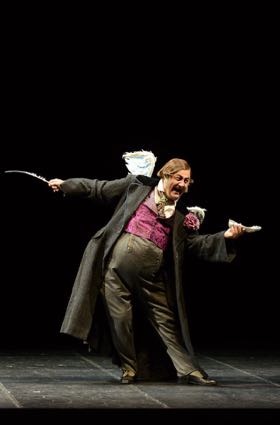
Renato Girolami as Giacomo Rossini, later known as Don Magnifico
All photos from the Opéra de Lyon website
Like Stendhal when he first saw Rossini’s Cenerentola in Trieste in 1823, I was left stone cold by Rossini’s Cendrillon last night in Lyon. Stendhal complained that in Trieste nothing had been left to the imagination. As well, in Lyon nothing, absolutely nothing was left to the imagination.
Norwegian stage director Stefan Herheim and the Opéra de Lyon pulled out all the stops to create the biggest, most complicated Cenerentola you may ever encounter. Immensely gifted set designer Daniel Unger, with Mr. Herheim, offered a perspective of six superposed classical proscenium arches. Each leg revolved to become a street of working class row houses in forced perspective, each house with a chimney belching smoke. Immensely gifted video artists Torge Möller and Momme Hinrichs created the fairytale palace that appeared in many digital guises, and magical rainbows of flowers and gears as well.
Herheim, a quite respected and credentialed metteur en scène, began (and ended) with a contemporary janitor’s cart and a cleaning lady on a blank stage. A book fell from the lofts, she picked it up and read, a Baroque cloud descended, Giacomo Rossini emerged. Five elaborately costumed (18th century) actors frolicked onto the stage, the cleaning lady climbed into a fireplace that had magically descended, and emerged as a smoke smudged Cinderella. That was the overture.
There was no let up for the next 3 hours.
When astonishing scenic magic was not occurring a show curtain swooped down for the principals to frolic in front of. The hard selling comedians of the overture in their highly elaborated costumes executed highly exaggerated shtick. It was visually deafening.
Cinderella herself exposed some unusual bratty traits.
In Mr. Herheim’s avalanche of scenic gimmicks and fast and loud comic shtick, there were actually a few slightly amusing moments. The second act curtain rose revealing the conductor lounging on the stage smoking a joint, Tisbe and Clorinda had to order him into the pit. Dandini dropped his pants, broke off a piece of the stage lip and kicked it into the pit and then unceremoniously (his pants around this ankles) pushed the janitor’s-cart-now-royal-carriage off this stage. The best however was the enactment of the storm, the principals became the stagehands who would have created the scenic effects back when such effects were mechanical and hand operated.
All in all Mr. Herheim’s Cenerentola was a tsunami of mostly unrelated conceits. The real Cinderella of the evening was finally Rossini himself, sequestered irrevocably into the kitchen of tricks dreamed up by vainglorious regietheater.
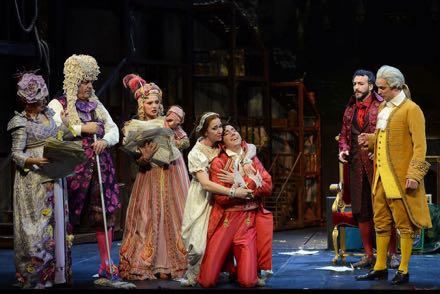
l/r Katherine Aitken as Tisbe, Renato Girolami as Don Magnifico, Clara Meloni as Clorinda
Michèle Losier as la Cenerentola, Cyrille Dubois as Don Ramiro
Simone Alberghini as Alidoro, Nikolay Borchev as Dandini
A fine cast was sacrificed to the production. The singers gamely pulled off all the hard-sell antics, remaining always the stock vaudeville comedians they were supposed to be, their loud antics never betraying that they were accomplished musicians. A Golden Carriage ending might have been a dynamite “Non piu mesta.” As it was French mezzo Michèle Losier did not have the vocal clarity, point and bite to make the opera’s finale into the showpiece it is meant to be.
The scope of this Opera de Lyon / Oslo Opera production was evidently to show off the talents of Mr, Herheim and his team. This it most certainly did.
Stendal back in 1823 noted that the Trieste public found the production splendid. So did the Lyon public, evidenced by the opening night ovation.
Cast and Production
Angelina aka Cenerentola: Michèle Losier; Don Ramiro: Cyrille Dubois; Dandini: Nikolay Borchev; Don Magnifico: Renato Girolami; Clorinda: Clara Meloni; Tisbe: Katherine Aitken; Alidoro: Simone Alberghini. Orchestre et Chœurs de l'Opéra de Lyon. Conductor: Stefano Montanari; Mise en scène: Stefan Herheim; Costumes: Esther Bialas; Lumières: Phoenix (Andreas Hofer); Dramaturgie: Alexander Meier-Dörzenbach: Vidéo: fettFilm (Momme Hinrichs, Torge Möller). Opéra de Lyon, December 15, 2017.
Lear at the Salzburg Festival
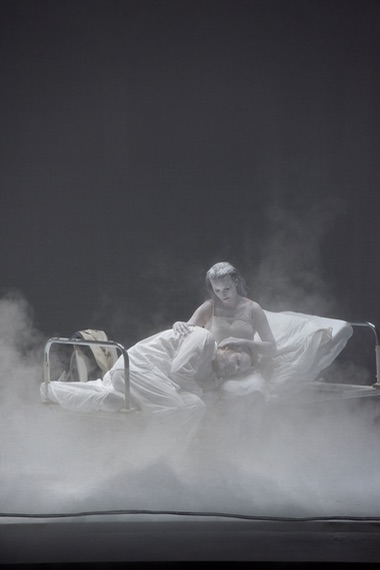
Gerald Finley as Lear, Anna Prohaska as the ghost of Cordelia at the death of Lear
All photos copyright by the Salzburger Festspiele / Thomas Auri.
Undaunted by the bloody majesty of this 1606 Shakespeare tragedy, German composer Aribert Reimann embraced the challenge back in the cold-war era (1970’s). Its Munich premiere was in 1978, a Jean-Pierre Ponnelle production that then traveled to San Francisco in 1981. Of the Munich cast only Helga Dernesch as Goneril appeared in San Francisco.
There remain in my mind indelible images from the San Francisco performances. Ponnelle used a stage wide, brush-filled heath against a black void (an antique, under-stage hydraulic system was revived to vary heights of this floor). The storm raged with the bare pipes of the fly system in chaotic motion. And the rages of Mme. Dernesch’s Goneril remain a vivid memory as well. I know of no other productions of the Reimann Lear in the U.S.
In San Francisco it was sung in English, though this was before supertitles came into general use. Without a clear text in front of you the prodigious subtleties of the Reimann score were (dare-we-say) vaguely felt rather than dramatically understood.
Thus this Salzburg Festival revival of Reimann’s cold-war masterpiece, now with subtitles in both German and English, was a musical and dramatic revelation. It is a nearly precise reading of Shakespeare’s play, but in musical terms, and those chosen by composer Reimann are bleak and brutal and ugly. Like Zimmermann’s famed Die Soldaten (1965) Lear throbs with threat, fear and remorse. It is unrelenting, and there is no salvation.
Both operas respond mightily to Germany’s position as the epicenter of the cold-war, and to its enduring guilt for the two twentieth century world-wars.
Now we are in the twenty-first century, and most of us decline to bear the guilt of our fathers. Reimann’s Lear can now finally exist on purely artistic terms. It is a magnificent orchestral score that takes us on a journey into a human hell, an experience we can bear only with the protection of high art. It is not for the faint of heart, or art for that matter.
And for the Salzburg Lear there is no place more accommodating than Salzburg’s old riding school, the Felsenreitschule, its massive galleries carved into the solid cliff of granite that is the backdrop for this space now used as a theater. For Lear there is no more fitting orchestra than the magnificent forces of the Vienna Philharmonic, including a side gallery stuffed with massive additional percussion.
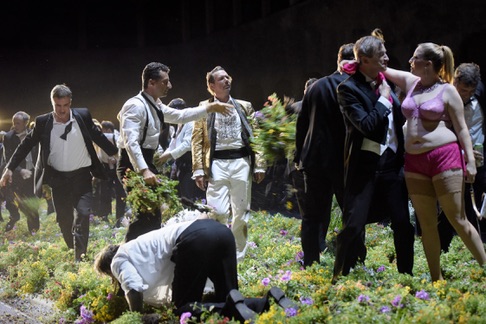
Michael Maertens as the Fool (speaking role) with Lear's knights (chorus and supers)
No longer considered a parochially German experience, it was staged by Australian theater and film director Simon Stone. Like Ponnelle in Munich the action occurred on a single platform, first it was a heath of fresh flowers, then it became a pure white slab with a pool of blood. It was staged as theater in the round, several hundred people sitting below the empty galleries behind the platform.
There followed one coup de theatre after another — the flowered heath was ruthlessly torn out by Lear’s knights; rain poured down for the duration of the storm; Mickey Mouse appeared on the stage; spectators behind the platform were torn out of their seats and thrown into the pool of blood; the hundreds of spectators sitting behind the platform, suddenly symbolic victims of war, were brutally driven out of the theater; a full-stage surround of white film cloth dropped to create a massive, heroic hospital space for Lear and Cordelia’s death.
I don’t think I’ve given too much away (and spoiled it for anyone) as it was a site specific event, surely impossible to re-produce elsewhere.
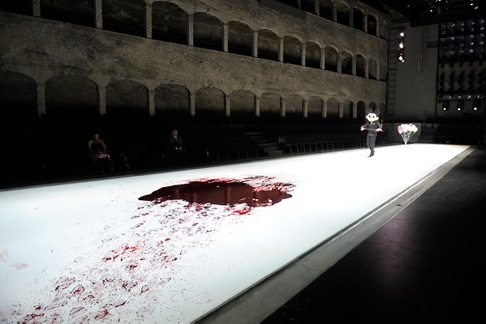
Lauri Vasar as the Duke of Glouchester in Mickey Mouse head cover
Cleveland Symphony conductor Franz Welser-Mõst urged and controlled rhythmic and harmonic contortions that flowed and over-flowed with ultimate Shakespeare’s cruelty. The stage resources equalled the pit resources in this production of massive size and daunting complexity.
Canadian born, British baritone Gerald Finley suffered willingly and mightily in a somewhat small scale, very sympathetic, human portrayal of Lear, Dresden Opera’s Evelyn Herlitzius again proved herself a singing actress of surpassing power as Goneril (she was Patrice Chéreau’s Elektra at the Aix Festival). Estonian baritone showed himself as an accomplished dancer in his vivid portrayal of the blinded Glouchester, and German counter-tenor Kai Wessel made great effect as Glouchester’s son Edgar, the tragedy’s only survivor.
The Salzburg Festival was obviously committed to making this an important theatrical and musical event. The assembled cast achieved this goal dramatically and vocally, and the production team arrived at its theatrical brilliance with amazing technical finesse.
Cast and productionGerald Finley: König Lear; Evelyn Herlitzius: Goneril; Gun-Brit Barkmin: Regan; Anna Prohaska: Cordelia; Lauri Vasar: Graf von Gloster; Kai Wessel: Edgar; Charles Workman: Edmund; Michael Maertens: Narr; Matthias Klink: Graf von Kent; Derek Welton: Herzog von Albany; Michael Colvin: Herzog von Cornwall; Tilmann Rönnebeck: König von Frankreich; Franz Gruber: Bedienter; Volker Wahl: Ritter.
Konzertvereinigung Wiener Staatsopernchor, Weiner Philharmoniker. Franz Welser-Möst: Musikalische Leitung; Simon Stone: Regie ; Bob Cousins: Bühne ; Mel Page: Kostüme ; Nick Schlieper: Licht; Christian Arseni: Dramaturgie. Felsenreitschule, Salzburg, August 23, 2017.Wozzeck at the Salzburg Festival
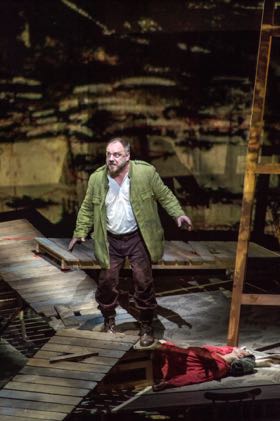
Matthias Goerne as Wozzeck, Asmik Grigorian as Marie, dead
All photos copyright Salzberger Festspiele / Ruth Walz
South African actor, artist, multimedia artist, film and theater, now opera director William Kentridge has taken the world by storm over the past few years. In my experience The Magic Flute in Brussels, The Return of Ulysses (puppets) in San Francisco, The Nose in Aix, Lulu at the Met, Die Winterreise and his “One Man Show” in Aix. And now Wozzeck at the Salzburg Festival.
And there’s more recent stuff, much more, mostly multi channel video and sound installations around the world that I won’t see.
All of Mr. Kentridge’s disciplines come into play in his opera productions, providing this prolific artist a rich palate of expressive tools. Though basically it’s abstract black lines, and silhouettes, symbolic images, and fragmented squares (still or moving images or playing areas) on a stage face plane that is his hyperbolic canvas. It is one dimensional.
Given Mr. Kentridge’s prestige he works with only the most prestigious, i.e. rich opera companies, thus his productions are supplied with first rank artists, conductors and orchestras, and the most expert technical assistance.
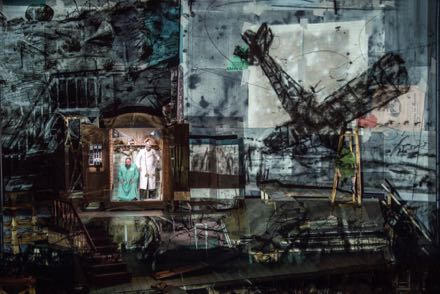
Matthias Goerne as Wozzeck, Jens Larsen as the Doktor
Of his operatic oeuvre, Wozzeck is his masterpiece, the precision of the opera’s focus, and the velocity of dénouement make quick and pointed use of his techniques. We had little time to tire of them, and given the subject matter they were not trite. It was an artistic success of image to music.
The program booklet informed us that Berg’s Wozzeck was born of the first world war, and composed in the shadows of its human devastation, thus the most powerful of the progression of projected images that captivated our interest (while Buchner’s tragedy unfolded below) was a huge WWI gas mask (not shown in photos).
This Wozzeck therefore did not dwell on the accumulation of the heady human tragedies of Wozzeck, Marie and the Child, but on the plethora of Kentridge images that flowed to the accompaniment of baritone Matthias Goerne’s smooth, art-song style delivery of Wozzeck’s deceptions and delirium. Mr. Goerne in fact was the surrogate William Kentridge in this production — Mr Kentridge himself is always a central feature in his stagings.
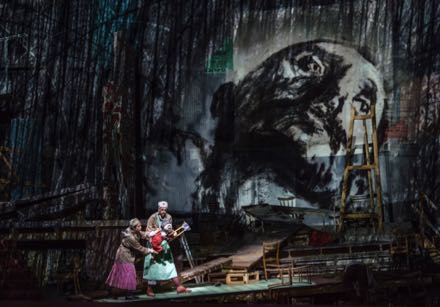
A super, the puppeteer and puppet of the child in gas mask
Of very great effect was the Child represented by a puppet, an image laden with metaphoric, if hackneyed possibilities. Though in addition to dehumanizing the human expressionism of Berg’s domestic tragedy the puppet troubled us greatly. Puppets don’t sing, so who was going to sing the “hop hops" of the final image?
No one did, they were played by mallets in the orchestra, the words projected on the supertitle screen.
The putrid physical and human atmospheres of Berg’s opera were smoothed over by the flow of images. This same flow obliterated the independence of scenes, the accumulation of which generally lead to the overwhelming effect of Marie’s murder, Wozzeck’s suicide and the Child’s isolation.
The Vienna Philharmonic in the pit of the medium sized Haus für Mozart theater brought an overwhelming presence to Berg’s score. But the vaunted orchestral signposts were obliterated by the incessant flow of images. Moments when you ached to sink into Berg’s abstract musico-dramatic world rushed by so quickly you only reacted to them after the fact. Was this the intention of conductor Vladimir Jurowski, or was he a victim of the production?
Cast and production
Matthias Goerne: Wozzeck; John Daszak: Drum Major; Mauro Peter: Andres; Gerhard Siegel: Captain; Jens Larsen: Doctor; Tobias Schabel: First Apprentice; Huw Montague Rendall: Second Apprentice; Heinz Göhrig: Madman; Asmik Grigorian: Marie ; Frances Pappas: Margret. Salzburger Festspiele und Theater Kinderchor; Concert Association of the Vienna State Opera Chorus ; Vienna Philharmonic; Angelika-Prokopp-Sommerakademie der Wiener Philharmoniker. Vladimir Jurowski: Conductor; William Kentridge: Director; Luc De Wit: Co-Director; Sabine Theunissen: Sets; Greta Goiris: Costumes; Catherine Meyburgh: Video Compositor & Editor; Urs Schönebaum: Lighting . Haus für Mozart, Salzburg, August 24, 2017.
Ariodante at the Salzburg Festival
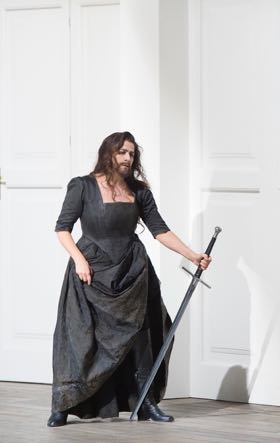
Cecilia Bartoli as Ariodante
All photos copyright by the Salzburger Festspiele / Marco Borrelli]
From time to time felicitous circumstances create impromptu masterpieces, like the Salzburg 2017 Whitsun Festival production of Handel's Ariodante that has continued just now into the 2017 summer festival.
Handel opera productions are famously fraught with troubling decisions — which voices to use, which gender to use for which voices, which dances to use from which opera. Sometimes decisions are made for you. Like, for example, Handel had no choice but to use the Covent Garden theater back in 1735 for his Ariodante, and to use an imposed roster of singers, and to use French choreographer Marie Sallé’s troupe of dancers.
The abstract story telling of the Handel operas indeed offer stage directors rich possibility for imagining context. For example the metteur en scène, Richard Jones, of the 2014 Aix Festival production of Ariodante illuminated its dramaturgical depths by placing the action within the fundamental Christian values (and confines) of the American Midwest.
But in Salzburg German stage director, Christof Loy, took everything at absolute face value -- it was Handel's opera as it was, through post-modern lens. As givens he had a producer (general director) of impeccable taste (Cecilia Bartoli) for the casting, one of the world’s foremost artists as his Ariodante (Cecilia Bartoli), and an unlimited budget for Salzburg’s splendidly equipped Haus für Mozart theater.
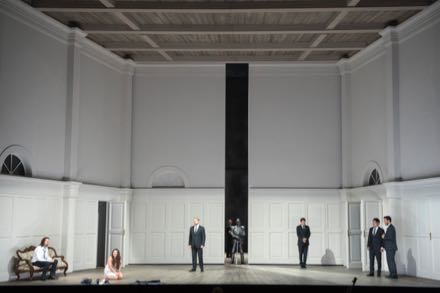
Nathan Berg (The King of Scotland), Kristofer Lundin (Odoardo)
Christophe Dumaux (Polinesso), Sandrine Piau (Dalinda)
Like the 1735 production at Covent Garden, Mr. Loy’s production was not modest. It had multiple scene changes. A basic neoclassical room opened up from time to time to reveal elaborately painted Rococo scenes, and once it opened to reveal a shockingly huge room (it was elaborately forced-perspective architecture). As well there was an elaborately blank wall that descended mid-stage from time to time to obliterate all sense of physical location.
Though back in Aix Handel’s interpolated dance music became the erotic pole dancing of the U.S. prohibition era, the dances just now in Salzburg were simply highly stylized movements in mimic of the interlude ballets of French Baroque theater, the dancers dressed in French court dress of the time (including elaborate wigs).
Handel’s Ariodante was a castrato, Instead Mr. Loy’s Ariodante in Salzburg was a mezzo-soprano. He was Mme. Bartoli, and that provoked more than the usual play of gender confusion given this diva’s fame and repertory. It was a confusion easily solved by Christof Loy and Cecilia Bartoli as Ariodante reappeared after his failed suicide as partly female (see photo above), a transition that continued into the final scene where la Bartoli lost her beard as well (but she did, amusingly, maintain her exquisite trouser role imitation-male movement).
In turn, of course, Ariodante’s damsel Ginevra had donned boots and a jacket for the final scene with Ariodante to assume some genial male characteristics. The conceit quite evidently was that there was finally a union of male and female, at once completing human complexities of the two individual human psyches, and dramatically wrapping up the story in marital union. [In Aix Ginevra was last seen hitching a ride, alone, to Toronto.]
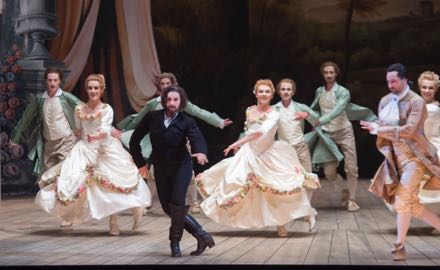
Cecilia Bartoli (Ariodante), Christophe Dumaux (Polinesso), dancers
But finally it remained certain that the magnificent Bartoli had always been la Bartoli and never Ariodante.
Lost in the marvels of the Baroque’s psychological affects, elaborate Baroque vocal ornamentation, and the glories of the Baroque orchestral palate it did not matter where we were. And certainly it could not matter to the seven singers of the opera where they might find themselves either. Thus sometimes the actors were in simple contemporary dress, sometimes in current formal attire, sometimes in Baroque period costumes. What’s more, the Polinesso Lurcanio duel was fought in head-to-foot knightly armor. This play of costumes obliterated all sense of story and took us directly into the singers’ psyches.
Most of all stage director Loy indulged the famed indulgent smile of the Renaissance poet Lodovico Ariosto, the author of the stanzas of his epic Orlando Furioso from which the tale is taken. Like Ariosto we too, together with the evening's singers indulged these chivalric characters in their wishes and disappointments, their plotting and undoing, their anger and joy, their deceits and generosity, their weaknesses and strengths. Etcetera.
There was no place, and time stood still. This was our shared joy with the artists in this remarkable production.
Early music conductor Gianluca Capuano wrenched every possible nuance of tone from the truly splendid voices of Les Musicians du Prince, a new orchestra in the service of Albert II of Monaco founded by Cecilia Bartoli.
La Bartoli amazed us with magnificent ornamentation in Ariodante’s drunkenness and then spellbound us in his extended lament, only to amaze us even more more in her final aria of joy. American soprano Kathryn Lewec met her halfway, enthralling us in her extended laments and thrilling us in her joy. The villains of this operatic extravaganza were both French [!], Sandrine Piau made Dalinda vividly if blindly in love with Polinesso, charmingly and wittily sung — breathtaking coloratura — by countertenor Christophe Dumaux. Rolando Villazón brought huge presence to Ariodante’s brother Lurcanio, nailing his second act aria “Il tuo sangue, ed it tuo zelo” but later fought vocal distress. Canadian bass Nathan Berg suffered mightily and exulted greatly as the King of Scotland. His able leutenant was sung by Swedish tenor Kristofer Lundin.
Norwegian National Ballet choreographer Andreas Heise threw some very witty twenty-first century steps and poses into his sort of convincing facsimile of French Baroque dance. Set design by Johannes Leiacker, costume design by Ursula Renzenbring, and lighting by Roland Edrich provided the utmost in measured teutonic theatrical chic to this magnificent production.
Cast and production information included in body of review
Lady MacBeth of Mtsensk at the Salzburg Festival
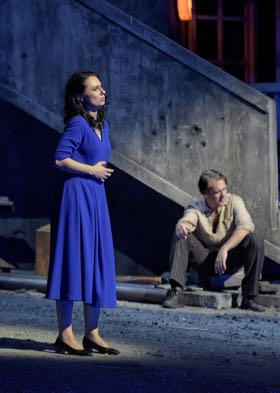
Eugenia Muraveva as Katerina, Brandon Jovanovich as Sergej
All photos copyright by the Salzburger Festspiele / Thomas Aurin]
The well-to-do merchant life of the opera’s small Russian town of Czarist times translocated to a monumental, socialistically heroic, concrete slum block.
Though it really was not crumbling, decaying socialist housing, it was actually a vagina shaped cavity into which thrust two phallic platforms, in and out repeatedly throughout this long, loud, gross evening.
Shostakovich’s cheeky opera meant to impress Soviet authorities with politically correct attitudes backfired at its premiere, and Shostakovich was artistically sidelined for years. Just now stage director Andreas Kriegenberg’s extreme re-imagining of the piece in monumental uber-expressionistic terms, meant as well to be politically correct and impress the sophisticated Salzburg Festival audience, backfired as well.
Without comment on current, hackneyed socio-artistic platitudes let me simply attribute the misfortune that beset Herr Kriegenberg’s production to the common cold and attendant laryngitis. Heroically voiced soprano Nina Stemme, indisposed, sang but the first two of five performances. She was replaced for the remaining performances by the sweetly voiced rape victim of the opera's second scene, Russian mezzo soprano Evgenia Muraveva.
Make no mistake. Mlle. Muraveva is already a first-class Katerina Ismailowa. She is young and pretty and has a beautiful lyric voice, ideal for a straight forward take on life in czarist Russia by a young, sympathetic and erotically motivated Soviet composer.
But with cast concrete sets soaring 20 meters (60 ft) into the loft of the Grosses Festspielhaus, with two suspended phallic appendages charging in and out, with high powered character singers in all other roles, and with the super-charged Vienna Philharmonic in the pit this fine young artist was out of her depth.
Thus the production failed.
My suspicion is that Nina Stemme was the key to Herr Kriegenberg’s production. Mme. Stemme is not a simple woman. She is both Brünnhilde and Elektra, and she is well able to scale the heights of Herr Kriegenberg’s socialist Valhalla in all its putrid glory.
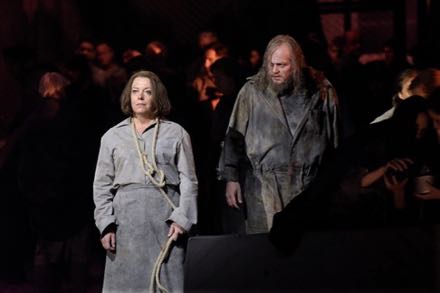
Nina Stemme as Katerina, Stanislav Trofimov as the Pope
And it was indeed putrid. Shostakovich’s opera is famously pornographic. Mr. Kriegenberg, abetted by conductor Mariss Jansons made sex as ugly as it could possibly be in scenes of anal penetration, colossal, collective humping. Not that there were not some light, kitsch touches. The arrested atheist who proclaims that frogs have souls was a Shostakovich look alike, the policemen effeminately cooked, wove and crocheted, the priest was dead drunk, etc.
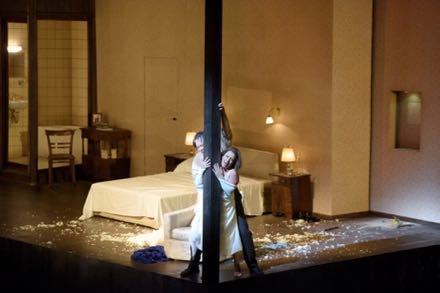
Nina Stemme as Katerina, Brandon Jovanovich as Sergey
And further kitsch — there was sperm everywhere — flying feathers of pillows ripped apart, hundreds of little phallus sized cans of aerosol spewing thousands of tiny bubbles, bottles dispelling liquid through narrow necks. And so on.
I would have loved to have been offended and amused by such grossness. Overheard comments at the intermission noted that it was indeed an “extreme” production. And finally Mlle. Muraveva’s Lady Macbeth was greatly appreciated by audiences. But as it was I was disappointed that the Salzburg Festival did not respect Herr Kriegenberg’s production enough to find an appropriate replacement for Mme. Stemme.
Cast and productionEvgenia Muraveva: Katerina Lvovna Izmaylova; Dmitry Ulyanov: Boris Timofeyevich Izmaylov; Maxim Paster: Zinowy Borisovich Izmaylov; Brandon Jovanovich: Sergey; Tatiana Kravtsova: Aksinya / Woman Convict; Andrei Popov: Shabby Peasant; Oleg Budaratskiy: Porter / Sentry; Igor Onishchenko; Millhand Vasily Efimov: Coachman / Teacher; Stanislav Trofimov: Pope; Alexey Shishlyaev: Chief of Police; Valentin Anikin: Policeman / Officer; Ksenia Dudnikova: Sonyetka; Andrii Goniukov: Old Convict; Gleb Peryazev: Manager; Martin Müller: First Worker; Oleg Zalytskiy: Second Worker / Drunken Guest; Ilya Kutyukin: Third Worker. Chorus of the Vienna Statsoper; Vienna Philharmonic. Mariss Jansons: Conductor; Andreas Kriegenburg: Director; Harald B. Thor: Sets; Tanja Hofmann: Costumes; Stefan Bolliger: Lighting; Christian Arseni: Dramaturgy. Grosses Festspielhaus, Salzburg Festival, Salzburg, August 21, 2017.
Torvaldo e Dorliska in Pesaro
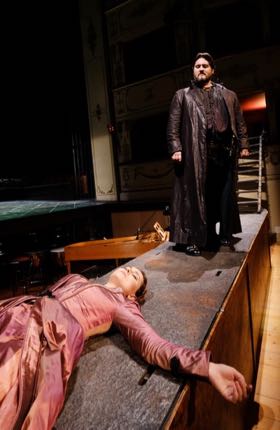
Nicola Alaimo as the Duke of Orlow, Salome Jicia as Dorliska
All photos courtesy of the Rossini Opera Festival, Pesaro.
The rare and somewhat interesting Rossini! Torvaldo e Dorliska (1815) comes just after Elisabetta, Regina di Ingleterra (the first of his nineteen operas for Naples) — a huge success, and just before Il barbiere di Siviglia in Rome — a failure.
Already before Torvaldo e Dorliska Rossini had three of his major comedies under his belt (La pietra del paragone, L’italiana in Algeri and Il turco in Italia) and two successful tragedies (Tancredi and Elisabetta).
But Torvaldo e Dorliska is a dramma semiseria — a horse of a quite different color. The genre can stretch finally into operas like maybe Don Giovanni and Rigoletto, but in Rossini’s oeuvre it did not engender any enduring Rossini masterpieces, as have comedy and tragedy — the 2015 Pesaro production of La Gazza Ladra, Rossini's only other semiseria, directed by Damiano Michieletto, definitively finished off its bid for masterpiece status.
Strict semiseria genre norms require a basso buffo, and Torvaldo and Dorliska obliges with the Duke of Ordow, played just now by none other than Nicola Alaimo, Pesaro’s recent William Tell. Mr. Alaimo is a performer of stature and of great presence, and is a powerful singer who evokes sympathy. These attributes confused this current Pesaro edition of,Torvaldo e Dorliska (a remount of its 2006 production directed by Mario Martone).
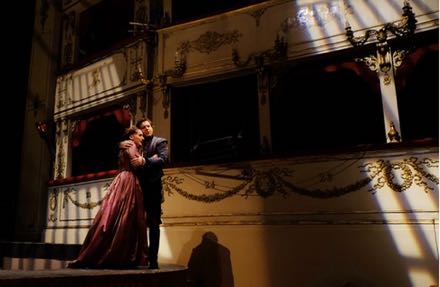
Salome Jicia as Dorliska, Dmitry Korchak as Torvaldo
The Duke of Ordow is smitten by Dorliska, recently married to Torvaldo whom the Duke assumes his thugs have murdered. Not so. The wounded Torvaldo is taken into the Duke’s castle by its gatekeeper. Meanwhile Dorliska, abducted into the castle, is slapped around by the Duke to try to get her to marry him. Everyone rebels against the Duke for various reasons and he is led off to prison.
After all that we were quite confused as we had come to like Mr. Alaimo even though everyone on stage hated him.
Director Mario Martone and his designer Sergio Tramonti set this Polish tale somewhere with lots of thick foliage, all the better to mask his thugs as they came and went, and finally hide the revolutionaries as well. The setting had all the atmospheres of incipient Romanticism. But Rossini’s libretto was largely a farce of the type that plays best under bright lights.
Besides the un-Romantic brutal slapping of Dorliska Mr. Martone offered some extreme, un-Romantic schtick as well — Ormondo, the Duke’s lieutenant climbs a tree singing his aria, and falls out still singing (he was caught by his friends), and as the revolutionary movement gained momentum thousands of "Viva Rossini" leaflets rained down upon us from the auditorium's rafters.
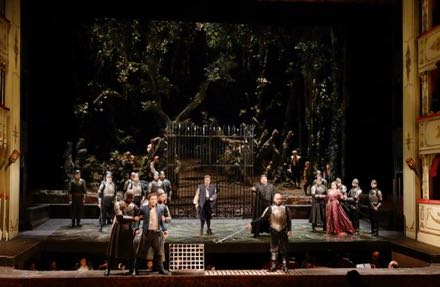
The entire cast in the Act II finale
As usual in Pesaro there were fine singers who created this evening of pure delight. Of particular note was young Georgian soprano Salome Jicia as Dorliska who raged and spat in secure Rossinian language, and Russian tenor Dmitry Korchak who delivered Torvaldo with aplomb though missing was an innocence and charm we might have liked in this young lover. Pesaro regular, bass Carlo Lepore convinced us as the duplicitous gatekeeper (we sympathized with his employer). A former participant in the Pesaro’s Accademia Rossiniana, baritone Filippo Fontana was the soldier who fell out of the tree singing.
The greatest pleasures of the evening were being in the Teatro Rossini, a typical Italian horseshoe theater of perfect size for minor Rossini, the able orchestral playing of the Orchestra Sinfonica G. Rossini under conductor Francesco Lanzillotta who found the real Rossini, and most of all it was a lot of fun to have the opportunity to explore the ideals and the potential of opera semiseria in this production of undeniable charm.
Cast and production
Duca d’Ordow: Nicola Alaimo; Dorliska: Salome Jicia; Torvaldo: Dmitry Korchak; Giorgio: Carlo Lepore; Carlotta: Raffaella Lupinacci; Ormondo: Filippo Fontana. Coro del Teatro della Fortuna M. Agostini; Orchestra Sinfonica G. Rossini. Conductor: Francesco Lanzillotta; Regia: Mario Martone; Scene: Sergio Tramonti; Costumi: Ursula Patzak; Luci: Cesare Accetta. Teatro Rossini, Pesaro, August 18, 2017.
La pietra del paragone in Pesaro
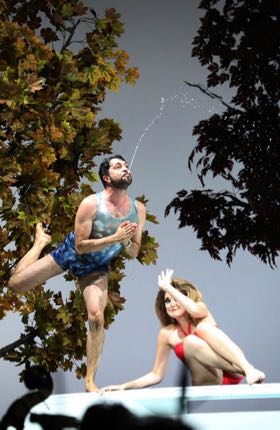
Paolo Bordogna as Pacuvio, Aurora Faggioli as Aspasia
All photos courtesy of the Rossini Opera Festival, Pesaro.
Impeccable casting — see photos. Three new generation Italian buffos brought startling new life to Pier Luigi Pizzi’s 2002 production of Rossini’s first major comedy (La Scala, 1812).
The comedy's huge success in Milan won a military draft exemption for the 20 year-old Rossini, and thus assured the world of its most impressive catalog of operas.
La pietra del paragone is a bit like Cenerentola — which of the rich count's pursuers should he marry? There are two who care about his money and position, and one who cares about him. It’s a thin story, more of a simple farce than than the richly human comedies yet to come.
Count Asdrubale devises a test (the “stone of comparison”) — he pretends to be ruined, and thereby will find his true friends. And so the antics continue, musical and physical, for another couple of hours.
From the beginning Pier Luigi Pizzi never lets up, discovering new ways to animate the cubby holes of his set, including a swimming pool on the patio of his two story Malibu spread (it is very California). The scene-stealing count is into physical culture, and plays it to the hilt, illustrating the role's narcissism with absolutely splendid fioratura.
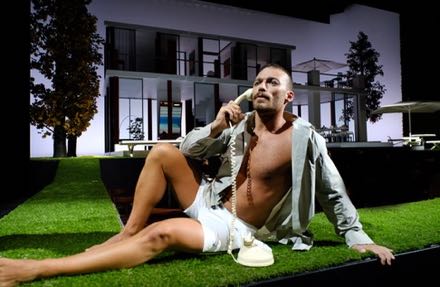
Gianluca Margheri as Conte Asdrubale
Each of the gold diggers has a champion, one a pretentious poet, the other a pretentious journalist. And the count’s true love has a champion as well — a real poet and a true friend who loves the heroine, but is left standing there.
Duets are sung as tennis matches (lobbing the ball back and forth across the pit), lovers’ duets are sung by telephone across the stage, machinations are devised on the diving board, false starts end up in the pool (you can be sure this very real pool was heated). A hunting party ends up in a duel, the heroine concocts a trick of her own to seal the deal with the count.
And the antics never stopped. It was slapstick humor and physical humor that somehow never became tiresome (well, there were those who nodded off in our row) and that sometimes motivated involuntary guffaws. This Pizzi production has indeed become a classic.
Not to be outdone Rossini proved himself unstoppable in musical antics, from patter arias, to patter duets and trios, not to forget a quintet with tons of patter. Vocal ornamentation flew around the stage and into the house via the much-used walkway fronting the pit. And the young composer from Pesaro gave his true lovers spectacular arias to cap the show — and that brought huge applause from the excited house (those who were still awake).
Milanese wunderkind maestro Daniele Rustioni, now the principle conductor of the Opéra de Lyon, recognized the high-tailed nature of the young Rossini. With the Orchestra Sinfonica Nazionale of the RAI the maestro balanced the fever pitch of the musical and stage antics with workable tempos and measured energy, even finding elusive hints of the great Rossini from time to time.
The three amazing buffos were Florentine bass baritone Gianluca Margheri as the super cool count, Benevento (near Naples) baritone David Luciano as the slimy journalist and Melzo-born (near Milan) bass baritone Paola Bordogna, a Pesaro mainstay, as the truly terrible poet. All three are splendid singers as well as real performers who epitomize a new generation, or re-birth of buffo.
Needless to say the tenor left out in the cold, Cavalier Giocondo, was not an Italian, but a Russian, Maxim Mironov who earned the evening’s biggest ovation for his spectacular aria “Quell’alme pupille.”
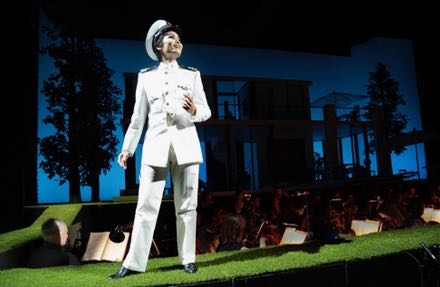
Aya Wakozono as Clarice (disguised as her "brother")
The count’s true love, Clarice was well portrayed by Japanese mezzo Aya Wakizono, an alumna of the festival’s Accademia Rossiniana. The ingenue diva, a charming performer, boasts splendid high notes. Spanish soprano Marina Monzó sang Donna Fulvia’s “Pubblico fu l’oltraggio” with appropriate gusto, and Bolzano soprano well executed the paces of Baronessa Aspasia.
Cast and production information:
Marchesa Clarice: Aya Wakizono; Baronessa Aspasia: Aurora Faggioli; Donna Fulvia: Marina Monzó; Conte Asdrubale: Gianluca Margheri; Cavalier Giocondo: Maxim Mironov; Macrobiotic: David's Luciano; Pacuvio: Paulo Bordogna; Fabrizio: William Corrò. Coro del Teatro Ventidio Bassi; Orchestra Sinfonica Nazionale Della RAI. Conductor: Daniele Rustioni; Stage director, sets abs costumes: Pier Luigi Pizzi; lights: Vincenzo Raponi. Adriatico Arena, Pesaro, August 17, 2017.
La Siège de Corinthe in Pesaro
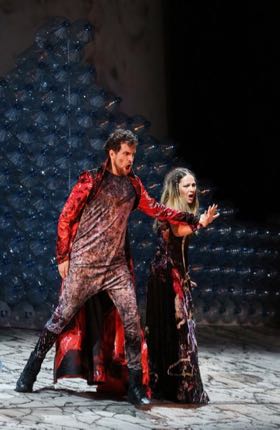
Luca Pisaroni as Mahomet II, Nino Machaidze as Pamyra
All photos courtesy of the Rossini Opera Festival, Pesaro.
That of Rossini (in French) and that of Lord Byron (in English, Russian, Italian and Spanish), the battles of both Negroponte (1470) and of Missolonghi (1826) re-enacted amidst massive piles of plastic water bottles (thousands of them) that collapsed onto the heroine at Mahomet II's destruction of Corinth.
We were all eager participants, harangued lengthily and forcibly by a high priest of the Greeks to accept martyrdom. Some of us were actually absorbed into the crowds of the condemned citizens of Corinth transfixed by the priest’s ecstatic vision of freedom.
Uncompromising in its pursuit of the purest Rossini, this Italian high-art Festival provided supertitles only in French for this new, hyper-researched critical edition of Rossini’s first “grand” opera for France, said to musically recreate its original performance on October 9, 1826.
Thus Rossini’s five second act ballet divertissements were reduced to the three that the Paris Opera allowed at the premiere — though in Pesaro there was not a dancer in sight. Mahomet II, transported by his love for Pamyra wandered amidst the plastic bottles during the first divertissement, Lord Byron’s verses (in four languages) were projected line by line for the second, and members of the theater collective, La Fura dels Baus, fought over a bottle of water for the third.
After a few moments of indecision the audience booed its disapproval, but only half-heartedly.
This famed theater collective had envisioned the production of this musical reproduction of the 1826 event with deft, intellectual whimsy, finding in the plastic water bottle metaphor sufficient depth to intrigue if not enlighten the audience for the nearly five hour duration of the performance. That the massive walls of bottles sparkled brilliantly in the lights, and collapsed magnificently and elegantly (yet quietly enough not to cover Rossini’s magnificent music) more than adequately fulfilled French grand opera’s requirement for spectacle. Not to mention several important, enigmatically-imaged banner filled parades through the audience.
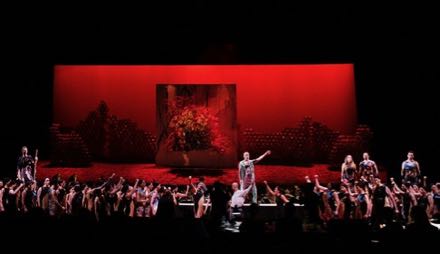
The high priest Hiéros leading the Corinthians
(chorus mixed with some spectators) to martyrdom, Corinth in flames.
This flashy, beautifully staged and very successful production surely atones for the festival’s lackluster 2008 production of Maometto II, Rossini’s original 1820 Naples version of this Paris re-write (though the young general Calbo was memorably etched in Pesaro by Daniella Barcelona). The French had long forbade castrati (evidently trouser roles as well) thus this same young general now named Néoclès was sung just now by Russian tenor Sergey Romanovsky.
Rossini had broken new ground in Maometto II, thinking in larger and more complex dramatic blocks. But he allowed himself one huge aria scene and it was for Néoclès — the Russian tenor soared in impeccable fioratura to a high “C” (at least) praying to God to save the Greeks. This magnificent aria earned the one huge ovation of the evening. Note that Rossini’s advanced style precludes pauses for applause.
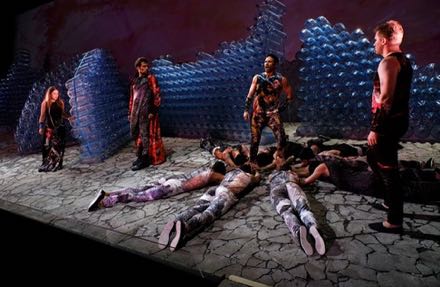
Left to right: Pamyra, Mahomet II, Néoclès, Omar
The overwhelming conflict of the evening was love versus duty. The Greek princess Pamyra loves the Turkish sultan Mahomet but her responsibility is to her father and to her homeland, and to her Greek fiancé Néoclès. Georgian bel canto diva Nino Machaidze suffered as only great Rossini divas may. This remarkable artist brought a musical intelligence that informed every phrase, suffusing the complex vocal lines with a unique expressive gravitas in richly colored voice.
It was indeed a brutal conflict of love and duty, all the more so because Mahomet, Luca Pisaroni, was very handsome in his red regalia, imposing in stance, and convincing in voice (Mr. Pisaroni is a well-known Neapolitan Maometto II as well). Rossini proved the enlightenment of this Muslim general who conquered Corinth by giving him an aria in which, stating his love of the arts, he declares he will not destroy Corinthian monuments. There was some applause.
To the festival’s good fortune Torino’s RAI Orchestra Sinfonica Nazionale found its way into the pit of Pesaro’s Adriatic Arena (changing regional financial structures have destroyed the festival's long time association with Bologna’s Teatro Comunale). As expected from a symphony orchestra there was elegance of tone, limpidity of texture, and an easy virtuosity, attributes that responded to the transparency and clarity of score imposed by conductor Roberto Abbado.
With such resources Mo. Abbado uncovered instrumental sonorities new to Rossini’s advanced style, and clarified the dramatic and musical intelligence of the expanded structures of the numbers that included combinations of arias, duets, trios and ensembles. The maestro achieved the rare and ephemeral plateaux of sustained lyricism that create absolute opera.
Each August we Rossinians make our pilgrimage to Pesaro, his birthplace, in search of such transcendental evenings.
The casting of Le Siège de Corinthe was uniformly effective. British tenor John Irwin sang Pamyra’s father King Cléomène, adding additional tenorial splendor to this evening. The high priest Hiéros was lustily intoned by Italian bass Carlo Cigni. The Greeks and the Turks, and there were a lot of them, were energetically enacted by the fine chorus of Teatro Ventidio Basso (the opera house of Ascoli Piceno, a small city in Le Marche, the same province as Pesaro).
Cast and production information:
Mahomet II: Luca Pisaroni; Cléomène: John Irvin; Pamyra: Nino Machaidze; Néoclès: Sergey Romanovsky; Hiéros: Carlo Cigni; Adraste: Xabier Anduaga; Omar: Iurii Samoilov; Ismène: Cecilia Molinari. Coro del Teatro Ventidio Basso. Orchestra Sinfonica Nazionale della RAI. Conductor: Roberto Abbado; Production: La Fura dels Baus; Stage director and set designer: Carlus Padrissa; Costumes and video: Lita Gabellut; Lights: Fabio Rossi. Adriatic Arena, Pesaro, August 16, 2017.
Festival Memoires in Lyon
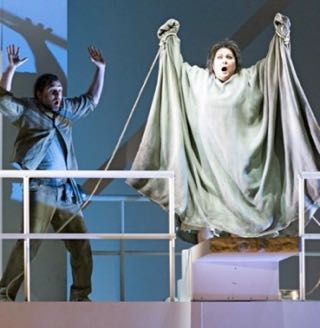
Elena Pankratova as Elektra, Christof Fischesser as Oreste [Elektra and Tristan
[Elektra and Tristan photos copyright Stofleth, courtesy of the Opéra de Lyon.]
Each March France's splendid Opéra de Lyon mounts a cycle of operas that speak to a chosen theme. Just now the theme is Mémoires -- mythic productions of famed, now dead, late 20th century stage directors. These directors are Klaus Michael Grüber (1941-2008), Ruth Berghaus (1927-1996), and Heiner Müller (1929-1995).
Le Couronnement de Poppée
Klaus Michael Grüber's production of L'incoronazione di Poppea comes from the Aix Festival of 2000. The design was by visual artist/painter Gilles Aillaud (1928-2005), Grüber's frequent collaborator at West Berlin's Schaubühne (and opera houses in Berlin and elsewhere). It was a prestigious cast, Grenoble's Les Musiciens du Louvre in the pit with Marc Minkowski.
I remember being bored, very bored. For me, then, there was no hint of mythic-in-the-making.
Just now in Lyon's 870 seat Théâtre National Populaire it indeed became mythic, brought there not solely by messieurs Gruber and Aillaud, but also and possibly because of the Les Nouveaux Caractères (a French early music ensemble) and principally its conductor Sébastien d'Hérin, and the fourteen Solistes du Studio de l'Opéra de Lyon (its young artists program). We, all of us -- the cast and audience -- were enthralled.
Conductor d'Hérin drove the music of the words, Monteverdi's dramatic genius bursting into dramatic phrases, with the double continuo of Les Nouveaux Caractères melding a myriad of colors into the Monteverdi's unfettered catalogue of affects. It was never mere musical color, it was always word and phrase, a relentless concentration of affects from beginning to end.
Conductor d'Héron evoked a flowing sensuality of sound, and an obsessive drive that never allowed Poppea and Nerone's ambitions to falter, culminating in the sublime love duet where Grüber's actors cross and cross and finally line-up on the most abrupt and corrupt ending of all opera.
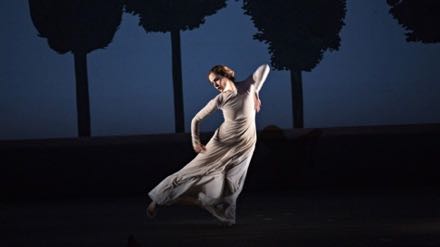
Josefine Göhmann as Poppea
[Poppea photos copyright Jean-Louis Fernandez, courtesy of the Opera de Lyon]
Director Grüber was a disciple of Giorgio Strehler. He bases much of what he does on Strehler's minimalistic principles and physical theater convictions. Gruber creates a theatrical language of abstractions, both in positioning and posturing. It is entirely presentational, eschewing all sense of an actual world, remaining always an imaginary, artistic world where the word itself is the only reality. Designer Aillaud's flat scenery visually embraces Grüber's artistic spaces to the fullest.
Without the distraction of famous artists attempting to realize such arcane abstractions, we entered this theatrical world through the willing young singers of the Opéra de Lyon's studio, who without exception gave total performances. Especially effective were the Nerone of Lithuanian mezzo Laura Zigmantaite and German/Chilean soprano Josefine Göhmann who were the only of Grüber's actors required to realize a constant plasticity of simultaneous gestural and musical movement -- a kind of emotional puppetry. Both were consummate performers.
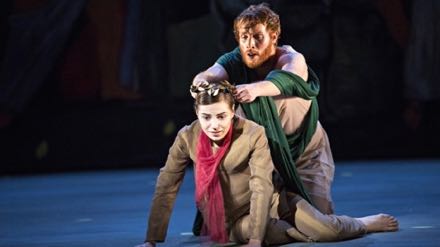
Laura Zigmantaite as Nerone, Oliver Johnston as Lucano
Excellent as well were the Seneca of Polish bass Pawel Kolodziej and the Ottavia of Finnish mezzo Elli Vallinoja. There were many memorable scenes, among them the spellbinding duet as Nerone expounds the sensual splendors of Poppea to his poet friend Lucano, sung by English tenor Oliver Johnston. And as well every scene with Poppea's nurse Arnalta, sung by French tenor André Gass.
Much praise for the success of this revival must be attributed to stage director Ellen Hammer, a directorial collaborator of Klaus Michael Grüber throughout his career. Mme. Hammer however in her program booklet remarks reveals herself needlessly pretentious as well as condescending to these superb young artists.
Cast and Production
Poppea: Josefine Göhmann; Drusilla / Virtu: Emilie Rose Bry; Nerone: Laura Zigmantaite; Ottone: Aline Kostrewa; Arnalta: André Gass; Damigella: Amore Rocio Perez; Fortuna / Valletto: Katherine Aitken; Famigliare / Pallade: James Hall; Famigliare / Mercurio / Soldato: Brenton Spiteri; Littore / Liberto: Pierre Héritier; Ottavia: Elli Vallinoja; Seneca: Pawel Kolodziej; Lucano / Soldato Oliver Johnston; Famigliare Aaron O'Hare. Orchestra: Les Nouveaux Caractères. Conductor: Sébastien d'Hérin; Mise en scène: Klaus Michael Grüber; Revival director: Ellen Hammer; Décors: Gilles Aillaud; Re-creater of sets: Bernard Michel; Costumes: Rudy Sabounghi; Lighting: Dominique Borrini. Théâtre National Populaire, Lyon, France, March 16, 2017.
Elektra
By definition any Ruth Berghaus production is mythic, and not just because this mega famous stage director was intimately associated with Bertolt Brecht's Berliner Ensemble and his (and East Germany's) didactic Epic Theater. Mme. Berghaus thinks and acts in epically scaled proportions.
Like her early mentor Walter Felsenstein (founder of East Berlin's Komische Oper), Mme. Berghaus insisted on an equal balance of the musical and theatrical elements of opera. This in the light of "regietheater" (which she more or less founded) wherein the director is free to modify period, locale, even the story itself to didactic ends. At the same time the music and text (usually) are sacrosanct, and must not be altered.
All this plays out brilliantly in this 1986 production of Elektra from Dresden's Semperoper, where it remained in the repertoire until 2012. The orchestra sits, dramatically, on the stage! The Semperoper pit simply could not accommodate Strauss's 49 winds and percussion players, plus strings (only 50 in Lyon -- a minimum number, and certainly the Opéra Nouvel's pit would burst even with that number). [Note that there exists a much used reduced orchestration of Elektra for approximately 70 total players.]
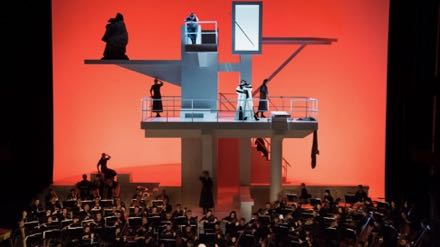
Strauss deemed that an expanded orchestra is necessary to create the colors necessary to his telling of this Greek tragedy, thus it becomes an absolute necessity for a Berghaus production. With this outsized orchestra needing to sit on the stage Elektra's cellar could only perch above the orchestra. So Mme. Berghaus simply transforms Elektra's prison into a perch from which the sisters see a world beyond their imprisonment and terror, and from which they search their salvation in the person of their brother Oreste who will murder his and their mother.
It becomes therefore perfect Brechtian Epic Theater -- theater as a catalyst for change and renewal. With the orchestra on yhe stage displacing traditional operatic staging convention the primary Brechtian precept was present -- distancing the spectator (and I indeed struggled with this distance) from the work of art in order that he might understand, and presumably act on its message rather than to be absorbed into its world.
These many years later, and in a different and far advanced social and political structure I struggled to transform such didactic theater into contemporary art. For me however it remained very much a period piece, evoking impotent nostalgia for the avant-garde of the ephemeral ideals of a failed world, and a longing for real, contemporary avant-garde operatic art.
This Lyon revival was very well cast, and convincingly conducted. It was a quite powerful if cold experience.
Cast and Production
Elektra: Elena Pankratova; Clytemnestre: Lioba Braun; Chrysothémis: Katrin Kapplusch; Egisthe: Thomas Piffka; Oreste: Christof Fischesser; Le précepteur d'Oreste: Bernd Hofmann; La confidente de Clytemnestre: Pascale Obrecht; La porteuse de traine: Marie Cognard; Un Jeune serviteur: Patrick Grahl; Un Vieux serviteur: Paul-Henry Vila; La Surveillante Christina Nilsson. Orchestra of the Opera de Lyon; Solistes du Studio de l'Opera de Lyon. Conductor: Hartmut Haenchen; Mise en scène: Ruth Berghaus; Revival stage director: Katharina Lang; Décors: Hans Dieter Schaal; Costumes: Marie-Luise Strandt; Lumières: Ulrich Niepel. Opera Nouvel, Lyon, France, March 17, 2017.
Tristan et Isolde
East Germany's and now Germany's most famous playwright after Bertold Brecht is Heiner Müller. His staging of Wagner's Tristan und Isolde was a part of the 1993 Bayreuth Festival, and is his only staging of an opera. Though a prolific playwright and dramaturg becoming finally the artistic director of the Berliner Ensemble, he himself staged few plays and then only in the last 15 years of his life.
Unlike Brecht or Ruth Berghaus theater for Müller is not didactic, nor does he promote social or political agenda (though it may be referenced). Rather he introduced multiple perspectives into his theater works, destroying linear storytelling and, in fact, drama itself in search of abstracted associations. In this sense Müller defined theatrical post-modernism for his generation.
It is no surprise then that Müller chose to stage Tristan und Isolde, composed as it is of three protagonists (including King Mark) whose life situations intersect only at brief moments of action, but whose personal dramas, or traumas are powerful and poetic, and associate only by chance.
Müller's collaborator for the Tristan production was avant-garde designer Erick Wonder who with Müller locked the opera's lengthy monologues in a huge, closed box. Theater's "fourth wall" was in fact an often visible scrim, referenced early in the evening by Isolde placing her hands directly on the [not merely imaginable, but quite real] fourth wall to indicate its boundary and, in fact, significantly, the box's separation from the audience itself.
The famed love scene of the second act was realized as two simultaneous monologues, the lovers met by placing their hands on an imaginary wall that isolated each from the other. The dreamy intensity of the love duet was rendered by the protagonists kneeling side by side, in separate prayers to love.
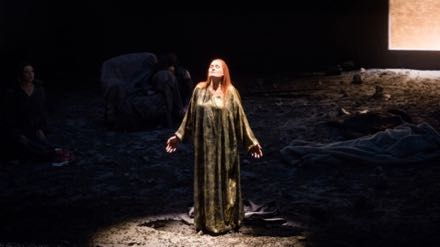
Ann Petersen sings the "Liebestod"
The stage box became Tristan's decaying chateau in the delirium, its floor now strewn with dead leaves, Tristan resting in a dilapidated easy chair. Blocks of intense color, first red then gold heralded Isolde who shed several cloaks to deliver, finally her "Liebestod" in a golden gown, motionless, breaking through the fourth wall at last, singing directly to us.
The squares of color, large and small, throughout the opera -- on the walls, floor and ceiling -- visually created the suggestion of separated emotional spaces, reinforcing the abstractions of the dramatic spaces of the protagonists. The staging itself kept each of the protagonists in oblique, abstractly linear movement, intersecting only in the rare moments of action. If nothing else the production itself made a splendid evening of abstract visual art, and this alone was sufficient to propel it to mythic status.
Separating the protagonists, isolating each in a unique space placed enormous responsibility on its artists to create individual theatrical and musical worlds -- it is certainly a very difficult requirement, and it may simply have demanded too much. If hopefully this responsibility was fulfilled in Bayreuth back in 1993 it was not just now in Lyon. On the stage the singers were left helplessly on their own, conductor Hartman Haenchen absorbed in a quite detailed reading of Wagner's score, a reading that excluded the sweep of sensual poetry, the dynamic force of poetic delirium and the depth of tragic, Romantic love.
After the orchestral excesses of Ruth Bergman's Elektra, the Opéra de Lyon opted for 69 players in the pit (who indeed sounded like many more), whose apparent artistry was welcome indeed in this otherwise frustrating evening.
Cast and Production
Tristan: Daniel Kirch; Isolde: Ann Petersen; Roi Marke: Christof Fischesser; Kurwenal: Alejandro Marco-Buhrmester; Melot: Thomas Piffka; Brangäne: Eve-Maud Hubeaux; Le Jeune Matelot / Le Berger: Patrick Grahl; Un timonier: Paolo Stupenengo. Chorus and Orchestra of the Opera de Lyon. Direction musicale: Hartmut Haenchen; Mise en scène: Heiner Müller; Réalisation de la mise en scène: Stephan Suschke; Décors: Erich Wonder; Recréation des décors: Kaspar Glarner; Costumes: Yohji Yamamoto; Lumières: Manfred Voss; Recréation des lumières: Ulrich Niepel. Opera Nouvel, Lyon, France, March 18, 2017.
Pinocchio in Aix
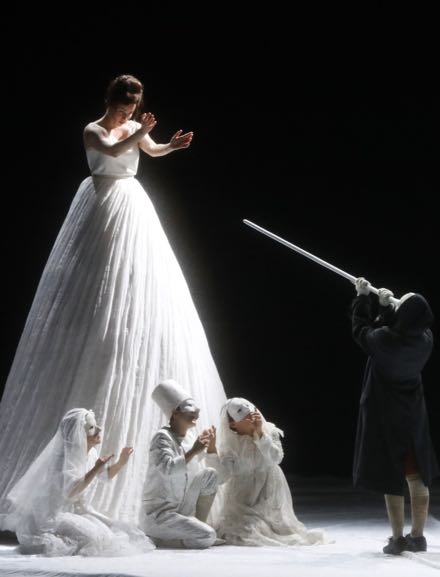
Marie-Eve Munger as the Good Fairy, Chloé Briot as Pinocchio
All photos by Patrick Berger/ArtComPress, courtesy of the Aix Festival.
Back to the operatic days when the book took top billing and the composer's name was in the fine print. Collodi’s tale is an epic journey wrapped in sophisticated innocence that leaves you probably more disgusted than anything else — Collodi’s Pinocchio is not a charming child.
The metteur en scène of this Pinocchio telling was Joël Pommerat, a 54 year-old French theatrical thinker who says he is an auteur de spectacle. When Mr. Pommerat turned 40 years-old he made a pact with a group of actors to create a show each year for 40 years. Thus he has a lot of experience creating shows and intends to create a lot more.
He authored a Pinocchio in 2008. But it was hardly on the scale of grand opera on the stage of one of the world’s important festivals of lyric theater. This 2017 Aix Pinocchio is big, great big and truly magnificent. It is grand opera complete with a ballet!
Mr. Pommerat writes shows about the world he and we live in — the “we” limited in no small way to a fairly rarefied world of the French avant-garde. Thus it was to that world that the mostly French audience of this international festival ascended. It is a perch that makes an intellectual, or theatrical game of animating fancy theatrical and musical genre with low-life characters, values, aspirations and situations. But not without intervention from much higher forms of life and art. Like Mr. Pommerat’s théâtre. Like la grande musique classique (oft referred to in Mr. Pommerat’s libretto).
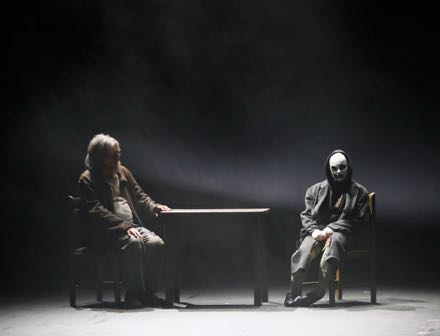
Vincent Le Texier as Pinocchio's father, Chloé Briot as Pinocchio
Pinocchio was an ideal subject to inspire Pommerat’s substantial operatic theatrics! Maybe here is where the actual music of the evening might be mentioned. The sound world accompanying Mr. Pommerat’s show was created by French composer Philippe Boesmans. This fine composer gamely built the complex world of Mr. Pommerat’s theatrical quotes of expressionism, cabaret, circus, fairyland, etc., and, yes, opera too.
Mr. Boesmans took a bow at the end of the show, sadly missing from the opening night accolades to the stage was Mr. Pommerat himself.
The music was always attractive, as was of course Mr. Pommerat’s show, the most lovable moments when the basic musical recitation of text burst into arioso — brief, even sometimes not so brief melodic flights that invited us to partake of moments of emotional release in pure operatic bel canto!
And, yes, the ballet — that was scene 16 (of 24), about the place of the traditional grand opera fourth act ballet. A group of ragamuffins were called onto the stage to seemingly rap dance to the howling klezmer band (an accordion, saxophone and violin who were in fact on-stage much of the evening, chiming in charmingly in all sorts of occasions).
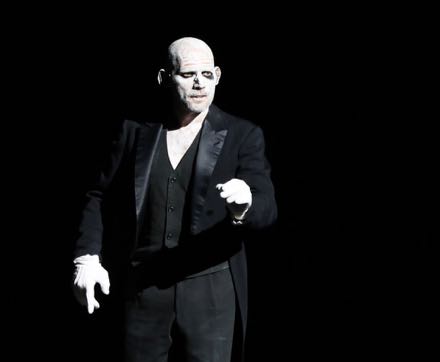
Stéphane Degout as the Director of the Troop (narrator)
All of Collodi’s Pinocchio was essentially present, but reclothed, most importantly with a narrator (the director of a theatrical troop that completed Mr. Pommerat’s larger metaphor) who made the transition from Collodi’s narrative text to Mr. Pommerat’s theatrical text. This role was superbly delivered by French baritone Stéphane Degout who kept us spellbound whenever the narrator took over or morphed into the circus director. His spoken French was brilliantly clear, as was his sung French to the degree that it was not included in the supertitles.
Pinocchio himself (herself) was diminutive French soprano Chloé Briot, supple of voice and of body (an incredible running leap up onto a table). She created a real Pinocchio, that is she found the brashness, the brattiness, the intelligence, the soft spots and finally the dignity of the brat becoming a real boy on his way to a classical music concert. A superb performance.
As usual at the Aix Festival casting was exemplary, mastery of vocal technique a given, appropriate colors of voice in place, physique and personality of actor in harmony with character.
Argentine/Italian conductor Emilio Pomarico presided over 19 players of the Klangforum Wein who easily made the magical sounds of the fairy world alongside the brash out-of-tune trumpets of composer Boesmans' musical dada.
Transforming metteur en scène Pommerat’s textural and dramatic world into a magical theatrical world was his long time collaborator set designer/lighting designer Éric Soyer who was joined by video designer Renaud Rubiano. The visual language is minimalism, the colors black and white, light and dark, stark and bright. The effects were huge, the moments were precise, the video seamlessly integrated to deploy massive, epic images. It was everything you expect from the minimal means of studio theater magnified with taste and intelligence to technically complex grand opera proportions.
Yet it was a long evening. Maybe you had to be French.
Cast and production
Le directeur de la troupe / premier escroc / deuxième meurtrier / le directeur de cirque: Stéphane Degout; Le père / troisième meurtrier / le maître d’école: Vincent Le Texier; Le pantin (Pinocchio): Chloé Briot; Deuxième escroc / le directeur de cabaret / le juge / premier meurtrier / le marchand d’ânes: Yann Beuron; La chanteuse de cabaret / le mauvais élève: Julie Boulianne; La fée: Marie-Eve Munger. Orchestre Klangforum Wien. Conductor: Emilio Pomarico; Mise en scène: Joël Pommerat; Décors et lumière: Éric Soyer; Costumes, maquilleage, perruques: Isabelle Deffin; Vidéo: Renaud Rubiano. Grand Théâtre de Provence, Aix-en-Provence, July 3, 2017
Carmen in Aix
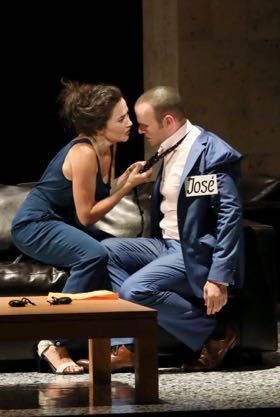
Stéphanie d'Oustrac as Carmen, Michael Fabbiano as Jose
All photos by Patrick Berger/ArtComPress courtesy of the Aix Festival.
There were four simultaneous Carmen — those of Prosper Merimee, Georges Bizet, Dimitri Tcherniakov and conductor Pablo Heras-Casado.
This new production by the Aix Festival was awaited with bated breath, Tcherniakov no stranger at the Aix Festival with two recent, unforgettable Don Giovanni under his belt, and the Aix Festival debut and role debut of conducting star Pablo Heras-Casado.
The euphoria and the dangers of imagining Bizet’s Carmen have long challenged avant-garde directors, among notable examples in my experience the by now historic stagings of Harry Kupfer and Calixto Bieito. The bar has been set always deeper into re-imagining the piece, and now Dimitri Tcherniakov has simply knocked the bar off its pinnings.
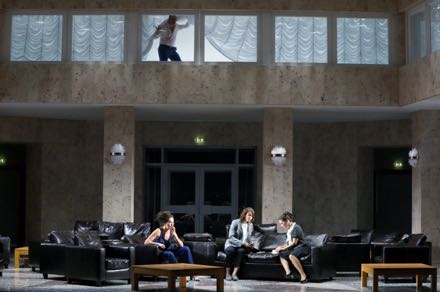
The card trio
Tcherniakov’s Carmen is no longer Carmen. It is the naked destruction of a human psyche, Carmen is merely its means. Layers of emotional bravado are meticulously stripped away within Tcherniakov’s chamber of horrors, a type of corporate-style self-improvement sanitarium. Not only the male anima is destroyed by an unfathomable sensation of maybe love, so also is the female anima destroyed. The tragedy sinks to the most elemental level of human existence, feeling laid bare. It is ugly, not cathartic.
To get there Tcherniakov has constructed a witty platform that ruthlessly plays with Bizet’s opera, and plays with us, challenging us to make it into a Carmen. Maybe you will be able to — there are five more performances and the production will travel to Luxembourg. I could not find a Carmen, this staging was not a real, working metaphor. But yes, the experience was pure gesamtkunstwerk, and high art, very high art.
Conductor Pablo Heras-Casado gave corpus to the stage. It was orchestrally full-throated, forcing out always intense feeling, i.e. the ultimate emotional elaboration of every melody, and the uncovering of emotional depths by laying bare the inner workings of Bizet’s harmonies and structures (who knew they were so incredibly rich). He took the Seguidilla to impossible hysterical frenzy, rendered the third act idyll as intense uncertainty, promise and frustration. As Tcherniakov laid naked his victims, the maestro flayed their feelings.
French diva Stéphanie d’Oustrac moved through Tcherniakov’s paces balancing a number of personalities, living not only the realities of Bizet’s vocal heroine and Merimée’s cold gypsy but also the delicacies, fears and sympathies of a real woman, and at the same time the detached professionalism of Tcherniakov’s illusive metaphor. The extent of these changing emotions were exponentially explored, her persona and her voice able to find always another elaboration, another level of feeling, another release of spirit.
American tenor Michael Fabbiano has the young tycoon swagger, the thirst for the ultimate experience, the blatant bravery, the unstoppable drive, the hidden vulnerability and the final weakness of all heroes. Mr. Fabbiano’s essentially monochromatic voice served this Jose to the fullest, his persona able to sustain the pressures and the abuse he imposed on himself until his final destruction. May you too beware of self discovery.
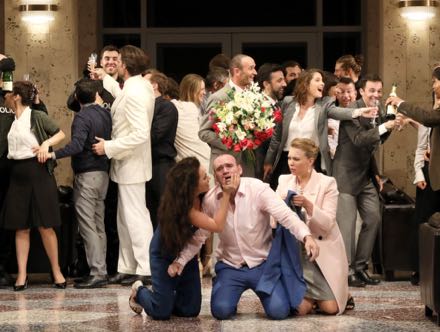
Jose'e graduation. Carmen, Jose, Michaëla
In Tcherniakov’s spoken frame for the opera Micaëla was Jose’s wife. Sung by French-Danish soprano Elsa Dreisig she used a bell-like purity of tone, in fact of metallic strength to push her husband into finding deeper feelings for her, i.e. so that he could give her more than wealth. This Micaëla was maybe a lot like Tcherniakov’s Lady Macbeth, but here in search of a sort of selfish emotional power.
American baritone Michael Todd Simpson had the task of acting out a matinée idol in Tcherniakov’s implied metaphor. The smugglers were simply magnificent, the quintet a masterpiece of execution. The children’s chorus was in the pit, in impeccable unison with the stage (the male chorus mouthed their words in hilarious pantomime).
Essentially the same set as his Don Giovanni which he used for his two distinctively different stagings perhaps Tcherniakov will use this set as well to stage a second edition of this Aix Carmen. There will always be something more to say.
Cast and productionCarmen Stéphanie d’Oustrac; Don José: Michael Fabbiano; Micaëla: Elsa Dreisig; Escamillo: Michael Todd Simpson; Frasquita: Gabrielle Philiponet; Mercédès: Virginie Verrez; Zuniga: Christian Helmer; Moralès: Pierre Doyen; Le Dancaïre: Guillaume Andrieux; Le Remendado: Mathias Vidal; L’Administrateur: Pierre Grammont. Chorus: Chœur Aedes; Childrens Chorus: Chœur d'enfants Maîtrise des Bouches-du-Rhône; Orchestra: Orchestre de Paris. Conductor: Pablo Heras-Casado; Mise en scène, décors et costumes: Dmitri Tcherniakov; Costumes: Elena Zaytseva; Lumière: Gleb Filshtinsky. Grand Théâtre de Provence, Aix-en-Provence, July 4, 2017.
Mozart and Stravinsky at the Aix Festival
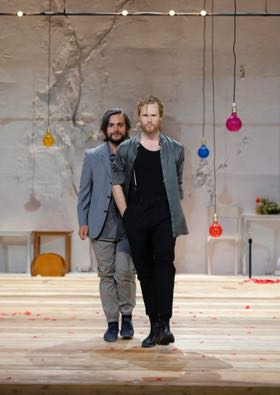
Nahuel di Pierro as Leporello, Philippe Sly as Don Giovanni
All photos by Victor Pascal, courtesy of the Aix Festival.
Bathed in Mediterranean light, basking in enlightenment Aix found two famous classical works, Mozart’s Don Giovanni and Stravinsky’s The Rake’s Progress in its famous festival’s open air Théâtre de l’Archevêche. But were we enlightened?
French theater director Jean-François Sivadier certainly gave it a go with his high, very high concept of Don Giovanni, focusing high-style Brechtian theater conventions onto Mozart’s rich hero. His accomplishment was to take all the fun out of this over-indulged dramma giocosa and let us know that it makes a very significant point that we all are Don Giovanni.
The Brechtian process can easily be imagined (an open stage, people like you and me milling around, the Don among them, the opera begun the 18th century costuming progressively deconstructed into contemporary dress, absolutely abstract [nothing realistic] in its geometric staging, and much use of the half-curtain). The Don himself was a life-force symbol, not a stud (or Tcherniakov’s drunk).The Commendatore was an authority who was revealed as a buddha once the back wall was partially demolished (noisily a vista of course) and the Christian cross initially hung on the back wall became a “t” as the word liberta was written out. It was not a political statement.
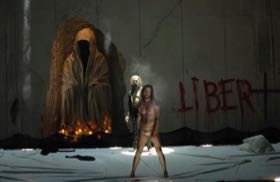
Philippe Sly as Don Giovanni, David Leigh as the Commendatore
And finally the Don was delivered to his fate by taking all his clothes off except his briefs which were more or less the discretely placed loin cloth of the Christian crucifixion.
Or something.
As usual the Aix Festival casting was impeccable. Impeccable for this concept. Young Canadian bass-baritone Philippe Sly was the Don. This unique artist projects deep energy and unstoppable force. His youthful physique projected an innocence for the Don of this concept. Wigged with long hair, his final image was absolutely Christ-like.
An announcement was made before the performance that he was ill, but would perform. Perhaps intended, perhaps because of illness Mr. Sly’s Don sometimes crooned, and this voice was indeed effective in his serenade to Elvira’s maid. This was the moment in the performance when the extraordinary communicating power of this young artist was most apparent.
The Don’s servant Leporello was sung by Argentine bass Nahuel di Pierro. Unlike the usual equality of master and servant in Mozart, Mr. di Pierro’s Leporello was indeed a servant, remaining always in the shadow of the Don, both vocally and emotionally. Slovakian tenor Pavol Breslik made the arias of a beautifully voiced Don Ottavio among the high points of the evening.
In harmony with the concept the Commendatore, sung in beautiful, youthful tone by American bass David Leigh, morphed into one of the universal crowd.
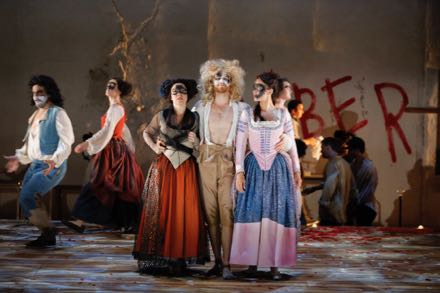
Isabel Leonard as Donna Elvira, Philippe Sly as Don Giovanni, Julie Fuchs as Zerlina
English Voices as the peasants in the Act I finale
Stage director Sivadier’s concept rendered the female heroines devoid of personality, though both sopranos brought splendid vocal colors and great virtuosity to their arias. American mezzo-soprano Isabel Leonard initiated her Donna Elvira at New York’s Metropolitan Opera in May, vocally displaying its musical and dramatic richness just now in Aix in very bright, silvery tones. Italian soprano Eleonora Buratto who makes her debut at the Met this fall, sang Donna Anna in a full throated voice of both power and agility. Overheard comments at intermission lamented pitch problems in both voices though I did not notice such issues.
As usual Zerlina and Masetto went through their paces. Director Sivadier presented them with the formidable challenge of singing their duets placed on opposite sides of the stage. French soprano Julie Fuchs sang a much appreciated Zerlina, and Polish bass Krrzystof Baczyk made Masetto into director Sivadier’s sung rather than acted peasant.
All splendid singers they came together wonderfully in the their second act chance encounter finding a gorgeous musical sublimity that we wish for and sometimes get in Mozart operas. Conductor Jérémy Rhorer gave his singers easy tempos, allowing them to show off their voices in the arias and work together in the ensembles. His orchestra, comprised of players on 19th century instruments, made a dark, scratchy sound continuum that compounded the stultifying austerity of the directorial concept. The bright colors on the stage offered little relief.
Cast and production information:
Giovanni: Philippe Sly; Leporello: Nahuel di Pierro; Donna Anna: Eleonora Buratto; Don Ottavio: Pavol Breslik; Donna Elvira: Isabel Leonard; Zerlina: Julie Fuchs; Masetto: Krzysztof Baczyk; Il Commendatore: David Leigh. Chorus: English Voices; Orchestra: Le Cercle de l’Harmonie. Conductor: Jérémie Rhorer; Mise en scène: Jean-François Sivadier; Décors: Alexandre de Dardel; Costumes: Virginie Gervaise; Lumière: Philippe Berthomé; Wigs and Make-up: Cécile Kretschmar. Théâtre de l’Archevêché, Aix-en-Provence, July 8, 2017.
The Rake's Progress at the Aix Festival
An American mid-last-century musical institution, Igor Stravinsky was fully immersed in his extreme neo-classicism when he composed The Rake’s Progress (premiere in 1951). In recent years the Aix Festival has focused on Stravinsky, having presented enlightened productions of his pre-American period operatic works — the Peter Sellars production of Oedipus Rex (1927) last year and the Robert Lepage production of Le Rossignol (1914) in 2010.
Thus all stops were pulled for this new production of The Rake’s Progress, entrusted to British theater director Simon McBurney. Mr. McBurney is known to nearby opera audiences for his masterful production of Coeur de Chien in Lyon and his gimmick filled filled ENO production of The Magic Flute in Aix. As for Coeur de Chien McBurney worked with British set designer Michael Levine for this new production, and much the same setting resulted — a white platform and solid white walls. But the walls are really paper walls that at strategic moments are torn through.
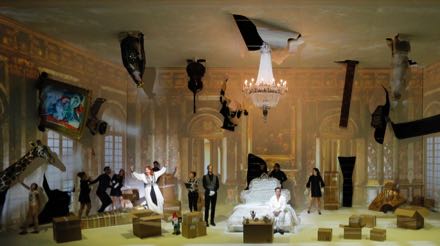
White box set in Act II with projected decor,
Baba the Turk's excesses having been thrust through the walls
For The Rake’s Progress much use was made of projected moving images (video) thus there were very distinct locales quickly created to substitute the eight scenes of the William Hogarth moralistic engravings from 1735 that were Stravinsky’s motivation. This as opposed to the unit set of the famed David Hockney production one fondly recalls.
The production was precisely conducted by Swedish maestro Elvind Gullberg Jensen replacing Daniel Harding who withdrew because of an injured wrist. The careful conducting seemed at odds with, and far away from the energy and brutality of the physical production, i.e. the fast moving images, the bursting of walls and the use of the theater itself as part of the stage.
As well the physical production itself was at calculated odds with McBurney’s actors who were rendered low affect, indeed colorless in contrast to the brilliant coloration of the set and its machinations, and the fantastic apparitions of Mother Goose and Baba the Turk. McBurney announces in his program booklet apology that The Rake’s Progress is a condemnation of braggartly Hollywood where Stravinsky resided with Auden as his guest. Evidently McBurney perceives Stravinsky and Auden, intellectually important, culturally alienated emigrants, as wanting to reveal and illustrate the inherent shallowness of the broader American civilization.
Stravinsky the neo-classicist is not universally admired, the detail and repetitiveness of his compositions in this period verging on the psychotic according to some critical estimations. In The Rake’s Progress one does indeed find the kind of ego destruction that results from such psychosis in both Tom and Ann.
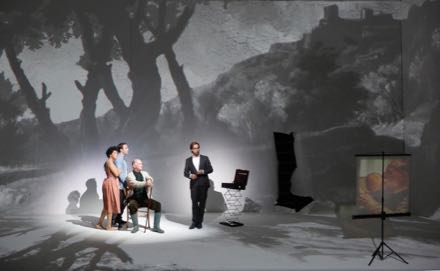
White box set in Act I with Ann, Tom, Trulove and Nick Shadow
The Aix Festival casting found American tenor Paul Appleby as a beautifully sung Tom Rakewell, ingenue American soprano Julia Bullock as Ann Trulove, American bass baritone David Pittsinger as her father Trulove. American bass baritone Kyle Ketelsen sculpted Nick Shadow on a level and energy far exceeding that of his compatriots. British counter tenor Andrew Watts rendered Baba the Turk as a brash, caricatured buffo presence that removed this pivotal character from Stravinsky’s neo-classical, distanced and refined world. The same may be said of British contralto Hilary Summers’ performance as Mother Goose.
Cast and production information:
Anne Trulove: Julia Bullock; Tom Rakewell: Paul Appleby; Nick Shadow: Kyle Ketelsen; Nick Shadow 2 / Le Gardien de l’asile: Evan Hughes; Trulove: David Pittsinger; Mother Goose: Hilary Summers; Baba la Turque: Andrew Watts; Sellem: Alan Oke. Chorus: English Voices; Orchestre de Paris. Conductor: Eivind Gullberg Jensen: Mise en scène: Simon McBurney; Dramaturge: Gerard McBurney; Décors: Michael Levine; Costumes: Christina Cunningham; Lumière: Paul Anderson; Vidéo: Will Duke.Théâtre de l’Archevêché, Aix-en-Provence, July 5, 2017.
Erismena at the Aix Festival
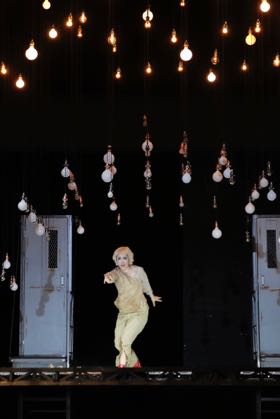
Francesca Aspramonte as Erismena
All photos copyright Pascal Victor, courtesy of the Aix Festival.
An incredible feat! The Aix Festival opened five operas, all new productions, on five consecutive evenings. The fifth was Francesco Cavalli’s 1655 drama per musica, Erismena! The compulsive intellectualism of Monteverdi’s L’incoronazione di Poppea (1643) long since thrown in the canals, Cavalli dissolves Venetian opera into purest, mindless hedonism.
Erismena in Aix was an incredible feat, captivating its audience for nearly three hours, evoking a thunderous applause. Its dramatis personae seducing us with their airs and ariosos, their elaborate recitatives and a final madrigal sung by its two sets of lovers, four soprano voices interweaving with such sweetness that we too drowned in their eternal raptures of love.
It took a long time to get to that madrigal, but no one minded. Least of all, seemingly, the young artists who sustained a concentration of voice and word and line, and the suspended tension of outcome created by the insatiable thirst Aldimira had for lovers, the terrifying dream that haunted Erimante, the dalliances of servants, the discoveries of “real” identities (and so on and so forth). It was the youth and the charm and the excellent artistry of these artists that made the inanities of Venetian opera into high art and great entertainment.
This version of Cavalli’s masterwork was created by Argentine born, Swiss early music conductor Leonardo Garcia Alarcón with his continuos provided by his Cappella Mediterannea (last spring Mo. Alarcón created a version of Cavalli’s massive Giasone for the Geneva Opera). The continuos in Aix were rich indeed with the maestro seated at an organ with virginals atop, harpsichord, two cellos, a bass and three “pluckers” on a variety of instruments. Two violins and two wind players added a plentitude of additional colors for the concerted pieces.
There were always new combinations to support the complications on the stage — from the roughness of Baroque violins, the violence of the cornetti, the sweetness, then unleashed chirping of the flutes, the warmth of full ensemble, the thundering (intended) of the organ. It was a very busy pit, Mo. Alarcón conducting seated, standing, with one hand (the other always at a keyboard), with his head, with his body. It was concentrated, joyous music making.
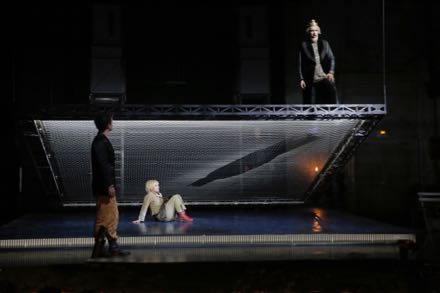
The platform
On stage there was nothing but a suspendible platform of transparent metal mesh, two elevated doorways, a canopy of suspended light bulbs and five or so cafe chairs from a junk pile somewhere. Think minimalism but do not think it was minimal. Moving these elements every which way as the situations changed throughout the evening was a monumental task. And there was a multitude of lightbulbs, some of which even knew to burst with a bang when there was a revelation down below!
The production requirements and accomplishments were formidable. From the “found” nature of the costuming (but indeed constructed given that no fuchsia suit the size needed to cloth the “skirt role” of the nurse could possibly exist, or the specific choice of fabric and sizes for the skirts worn by the male roles) to the make-up that added flashes of sparkle to the femme fatale Aldimira and the livid facial scar worn by Erimante’s lieutenant Diarte as examples of many.
There was no metaphor. The imagined story of pseudo-Roman history was told as written in this abstract, contemporary setting, French director Jean Bellorini moved his actors on and off the sometimes suspended platform, carefully established a space for each of the arias, changed his actors positions in direct dialogue to punctuate statement, and displaced them in a sudden blackout into a pool of light to utter an inner thought. Mr. Bellorini also masterminded the lighting that was of formidable complexity and huge effect.
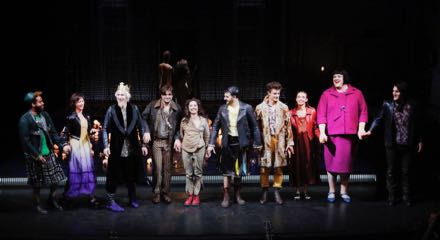
The bows
This weighty production effort was effectively absorbed, even eclipsed by the individual performances. Italian soprano Francesca Aspramonte sculpted the title role disguised as a warrior in clear tone, making impressive use of the Italian rolled “r” to aggravate her chagrin (she has lost her lover Idraspe to Aldimira), Italian counter-tenor Carlo Vistoli brought sensitivity and strength to Idraspe (who finally, hours later, recognized Erismena). British soprano Susanna Hurrell as Aldimira negotiated her nymphomania with soprano-esque verve, Polish counter-tenor Jakub Jósef Orliński dazzled us with some spectacular breakdance move declaring his love for Aldimira. These four artists delivered the final, mesmerizing, four part madrigal.
Some of the most impressive singing of the evening was achieved by 23 year-old French mezzo Lea Desandre as Aldirmira’s maid Flerida and Italian baritone Andrea Bonsignore as Idraspe’s servant Agrippo. The man who lost it all but gains a daughter and an heir, the Median king Erimante was solidly sung and acted by Russian bass-baritone Alexander Miminoshvili. New Zealand tenor Jonathan Abernathey was the strong voiced, virile lieutenant to King Erimante, these the two male voiced male roles.
Not to neglect dwelling on the crowd pleasing accomplishments of the comic roles — the nurse, Alcesta, well sung and convincingly, even lovingly acted by British tenor Stuart Jackson, and the role of Idraspe’s friend Clereo Moro, sung in very beautiful voice and estimable charisma by American counter-tenor Tai Oney.
The program booklet included a two-page, small print synopsis of the story of the opera. No one but no one could have made heads or tails of it. This excellent production took it all in stride and made an evening of admirable, comprehensible and highly amusing theater.
Cast and production information:
Erismena: Francesca Aspromonte; Idraspe: Carlo Vistoli; Aldimira: Susanna Hurrell; Orimeno: Jakub Józef Orliński; Erimante: Alexander Miminoshvili; Flerida: Lea Desandre; Argippo: Andrea Vincenzo Bonsignore; Alcesta: Stuart Jackson; Clerio Moro: Tai Oney; Diarte: Jonathan Abernethy. Orchestre Cappella Mediterranea. Conductor: Leonardo García Alarcón; Mise en scène et lumière: Jean Bellorini; Décors: Jean Bellorini et Véronique Chazal; Costumes: Macha Makeïeff; Wigs and Make-up: Cécile Kretschmar. Théâtre du Jeu de Paume, Aix-en-Provence, July 7, 2017.
Don Carlo in Marseille
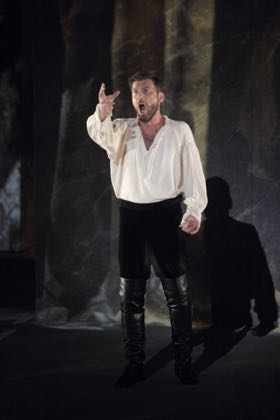
Nicolas Courjal as Philip II
All photos by Christian Dresse, courtesy of the Opéra de Marseille.
First mounted in 2015 at the Opéra National de Bordeaux this splendid Don Carlo production took stage just now at the Opéra de Marseille with a completely different cast and conductor. This Marseille edition achieved an artistic stature rarely found hereabouts, or anywhere.
Metteur en scène Charles Roubaud is nearly synonymous with the Opéra de Marseille, having initiated his opera career there in 1986 (an acclaimed Don Quichotte, seen in San Francisco in 1989). This Don Carlo is his 20th mise en scène for Marseille.
Roubaud is a minimalist. Eschewing all metaphor he favors image. Thus in recent stagings he has made much use of video washes projected onto substantial, abstract architectural shapes. His stagings occur in abstract ambience rather than specific locale. For this Don Carlo he was joined by long term collaborators, Avignon based set designer Emmanuelle Favre and Marseille based costume designer Katia Duflot. The video designer was Virgile Koering (of Montpellier origins).
Roubaud is also a conceptualist, imagining Verdi’s auto de fé spectacle as a relatively intimate court encounter between father and son, overseen by church and state, courtiers were lined up as observers. Finally he imagined a video procession of Flemish youth marching to their martyrdom. Nothing more.
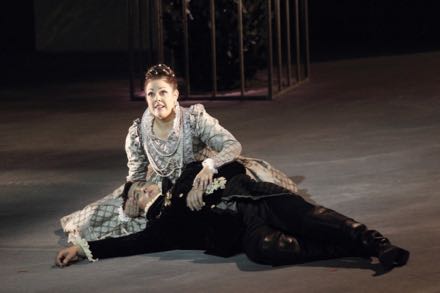
Yolanda Auyanet as Elisabetta, Teodor Llincal as Don Carlo
Based on intimacy and privacy such conceptual simplicity informed every scene. Don Carlo lay supine at the feet of Elisabetta for much of their fraught, post Fontainebleau encounter (this was the 4 act version). Eboli lay supine at the feet of Elisabetta to confess her betrayal. Every scene deployed its actors in abstract, emotionally charged positions, or abstract, strategically defined positioning rather than in active dramatic encounter.
Roubaud’s found Verdi’s theater not in Schiller’s drama, but in the expansion and implied collision of emotional worlds. Thus the theatrical climax fell onto the string of four huge arias that cap Verdi’s opera. Philip II’s Ella giammai, m’amò, Eboli’s “O don fatal,” Posa’s “Per me giunto è il di supreme, Elisabetta’s “Tu che le vanità conosce” riveted us to the complexity and richness of existentially separate human worlds. Roubaud made Verdi’s theater not in dramatic encounter but in the discovery and definition of these coexisting worlds.
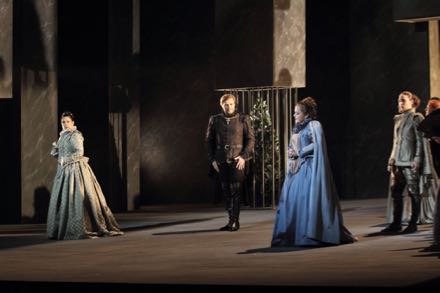
Yolanda Auyanet as Elisabetta, Jean-François Lapointe as Rodrigo
Sonia Ganassi as Eboli, Carine Sechaye as Tebaldo
This concentration was only possible with the complicity of the pit. Conductor Lawrence Foster found Verdi’s empathy with his tormented souls, and allowed it to expand and elaborate without boundary. Dramatic moments were indeed pointed, but only to extend possibility of amplitude and expansion of the existential moment.
With such an operatic poetic occurring simultaneously on the stage and in the pit the historical veracity of Verdi’s actors was far less significant than the actors abilities to live the moment. And that they did without exception. If bass Nicolas Courjal is too young to be an actual Philip II, he is vocally able to find an immediacy of plight with an energy and passion that were not resignation. His was the presence and the urgency of character that declared Philip II the central force of Verdi’s opera, not its tired victim.
Jean-François Lapointe brought unusual intelligence to Marquis de Posa with a maturity of male vitality, purity of resolve and duplicity, establishing himself as the moral equal of Philip II in beautiful, powerful voice. Italian mezzo Sonia Ganassi as Eboli unleashed sophisticated, mature vocalism and Rossinian confidence (plus solid, secure high notes) to make Eboli grovel magnificently in self pity. Spanish soprano Yolanda Auyanet’s Elisabetta had the purity of voice to project marital, maternal and filial innocence and the power of character and voice to explode in her confusion.
Physically and vocally robust, Romanian tenor Teodor Ilincai established a full voiced and straight forward confidence for history’s troubled young prince. And he was well able to appropriately soften and manipulate his tone as needed, This solid Don Carlo was the powerful catalyst for Elisabetta, Eboli, Rodrigo and Philip II to achieve the epitome of great lyric theater — a seemingly infinite state of simultaneous, suspended realities.
Immobile, directly in front of a huge white light cross bass Woytek Smilek’s Grand Inquisitor assumed terrifying terrestrial authority, A 2014 Operalia winner, soprano Anaïs Constans promised celestial peace for his victims in truly heavenly voice.
Cast and production
Elisabetta: Yolanda Auyanet; Eboli: Sonia Ganassi; Tebaldo: Carine Sechaye; Une Voix Céleste: Anaïs Constans; Don Carlo: Teodor Ilincai; Philippe II: Nicolas Courjal; Rodrigo: Jean-François Lapointe; Le Grand Inquisiteur: Wojtek Smilek; Un Moine: Patrick Bolleire; Comte de Lerma: Éric Vignau; Députés Flamands: Guy Bonfiglio, Lionel Ddelbruyere, Jean-Marie Delpas, Alain Herriau, Anas Seguin, Michel Vaissiere; Un Araldo: Camille Tresmontant. Orchestre et Chœur de l’Opéra de Marseille. Conductor: Lawrence Foster; Mise en scène: Charles Roubaud; Scénographie: Emmanuelle Favre; Costumes Katia Duflot; Lumières: Marc Delameziere; Vidéos: Virgile Koering. Opéra de Marseille, June 17, 2017.
Boris Godunov in Marseille
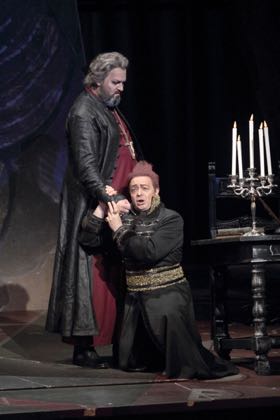
Alexey Tikhomirov as Boris, Luca Lombardo as Shuisky)
All photos by Christian Dresse, courtesy of the Opéra de Marseille
There has been much reconstruction of Marseille’s magnificent Opera Municipal since it opened in 1787. Most recently a huge fire in 1919 provoked a major, five-year renovation of the hall and stage that reopened in 1924.
Only the frieze above the stage is said to remain of the original theater.
While the current theater does not have a pit of sufficient size to host full-scale Romantic orchestras (to compensate harps and percussion instruments are placed in the baignoires (boxes stage level) over the pit often resulting in bizarre acoustics. At the same time this opera house boasts an amazing stage/spectator rapport that may be unequalled anywhere in the world — words flowing from the stage are clearly audible with no loss of the clarity and volume of orchestral sound. This theater like no other offers the possibility of achieving the epitome of the operatic ideal.
There were fortunately a few splendid moments to be savored in the recent production of Mussorgsky’s 1969 (first version) Boris Godunov, notably the sly Boyar Shuisky fueling Boris’ fears with his description of the dead Dimitri, the old monk Pimen’s recounting of the miracle at Dimitri’s tomb (a blind man praying recovered his sight), and finally Boris admonitions to his son Feodor to rule justly, delivered in his dying breaths.
These moments occurred in the few, very few periods when the frenetic movement on the stage relaxed somewhat, when storytelling phobia quieted a bit, when the singers could remain still long enough to expound the Pushkin story in the glories of the play of Russian phonemes.
Italian conductor Paolo Arrivabeni well supported these successful soliloquies in a somewhat restrained reading of the score. Perhaps he was attempting to mitigate the scenic hyperventilation.
Marseille fielded a respectable cast to tell Mussorgsky’s story, most notably the Boris of Russian bass Alexey Tikhomirov who had replaced Ruggiero Raimondi in this same production from Liège in 2010. Mr. Tikhomirov is of imposing stature and imposing voice. He finds much subtlety in the Boris personage, and as well assumes much of the stature needed to illuminate such a conflicted ruler. Tenor Luca Lombardo brought a blatantly evil spirit into his character portrayal of Shuisky. Of the principles 44 year-old French bass Nicolas Courjal made the most effect as the old monk Pimen, illuminating the Boris/Dimitri mysteries in a beautiful and clear tonal language that filled the theater.
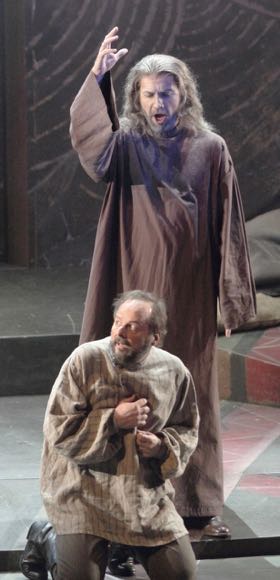
Nicolas Courjal as Pimen, Jean-Pierre Furlan as Gregory
Mezzo Marie-Ange Todorovitch did double duty as the innkeeper and the Boris children’s nurse, both roles delivered with pleasurable linguistic gusto. Soprano Ludivine Bombert made beautiful sounds in her laments as Boris’ daughter Xenia. Bass Wenwei Zhang enacted a splendid Varlaam, the drunken friar.
More problematic were the roles of Boris’ son Feodor, nicely sung by diminutive mezzo Caroline Meng. For the role to achieve its full and intended effect it must be sung by a young boy. Tenor Jean-Pierre Furlan embodied a ribald, ambitious, rough-voiced Grigory — a nervous wreck. This Grigory was definitely not a subtle schemer who you might believe could rally revolutionary forces. The Innocent, sung by tenor Christophe Berry, was in strident tone and grotesquely staged body movements.
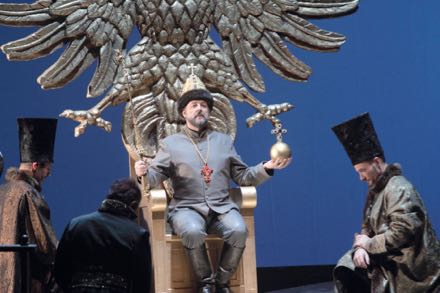
Dimitri, Czar of Russia 1605-1606, the final image of the Ionesco production of the 1869 Boris Godunov
Stage director and designer Petrika Ionesco deconstructed a Russian Orthodox fresco into George Braque-like, i.e. cubistic shapes, adding solid blocks of colored lights in open places. Scene changes were long, noisy and off-putting in this two and one-half hour sitting (no intermission). Evidently Mr. Ionesco was taken by the intense poses he found in Russian frescos, poses that he induced his actors and the chorus to imitate. This came across as blatantly naive, caricatured acting in incessant movement. It was laughable until it became unwatchable.
Cast and production
Boris Godounov: Alexey Tikhomirov; Pimène: Nicolas Courjal; Gregori / Dimitri: Jean-Pierre Furlan; Chouisky: Luca Lombardo; Xénia: Ludivine Gombert; Fiodor: Caroline Meng; La Nourrice / L’Hôtesse: Marie-Ange Todorovitch; Varlaam: Wenwei Zhang; L’Innocent: Christophe Berry; Andrei Tchelkalov: Ventseslav Anastasov; Missail: Marc Larcher; Nikitch / Officier de Police: Julien Veronese; Mityukha: Jean-Marie Defpas. Orchestre et Chœur de l’Opéra de Marseille; Maîtrise des Bouches-du-Rhône. Conductor: Paolo Arrivabeni; Mise en scène / Décors Petrika Ionesco; Lumières: Patrick Méeus. Opéréa Municipal, Marseille, February 21, 2017.
Billy Budd in Madrid
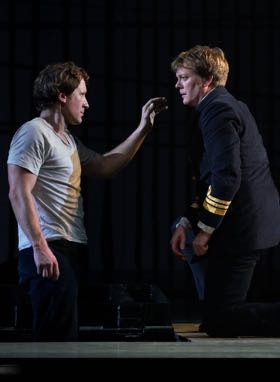
Toby Apense as Captain Vere, Jacques Imrailo as Billy Budd
All photos copyright Javier del Real, courtesy of the Teatro Real
Like Carmen, Billy Budd is an operatic personage of such breadth and depth that he becomes unique to everyone. This signals that there is no Billy Budd (or Carmen) who will satisfy everyone. And like Carmen, Billy Budd may be indestructible because the opera will always mean something to someone.
And always mean at least something to everyone.
Case in point — the new Deborah Warner production of Billy Budd at the Teatro Real in Madrid where Billy is ambitious and assertive, where his nemesis Claggart is a sadistic brute and where his alter ego Captain Vere is a weak, uncertain young man. Mme. Warner does indeed make the case, sort of, that Billy Budd may be read in such light.
Forsaking the intrinsic naturalistic and psychological impressionism of Britten’s muse Mme. Warner and her designer Michael Levine created an expressionistic world, the specific location was an actual aircraft carrier of 1940’s rather than Britten’s man-of-war (frigate) of the 1790’s, both ships in fact named the HMS Indomitable. Thus the spaces were wide open, there were huge platforms that moved up and down. The copious ropes and webs were metaphors of human entanglement and imprisonment rather than the essential tools of sailors — the means they used to move their ship and their lives.
While the officers were of the 1940’s, the sailors, a massive number (possibly a hundred), were interpreted as grubby galley slaves (the rowers of the quick, old Mediterranean ships), forced to work (here usually scrubbing the decks) by brutes with clubs and whips.
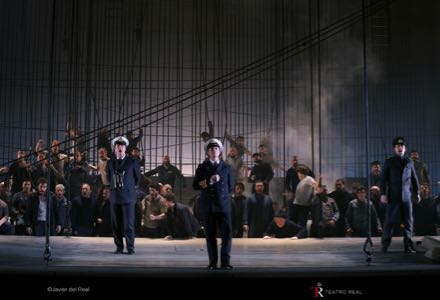
Officers and sailors of the HMS Indomitable
There was impressive scenographic rhetoric, the deck of the aircraft carrier (the full stage) rose to reveal a hundred or so suspended hammocks (a reference to the 18th century), the suspended command bridge of the ship was swung back and forth in a brutally thwarted mutiny, and finally Billy Budd disappeared up a ladder into the fly-loft for the hanging (one heard the clicks of the safety lines being attached).
There was impressive musical rhetoric emanating from the pit as well, Teatro Real music director Ivor Bolton incising precise musical shapes from his excellent players. The flute solos of the Billy death oration eschewed the mystical pull of death, invoking instead nervousness and certainty. And the maestro brought the full, massive orchestral force to a shattering fortissimo that made the presaged death of Billy a truly huge, indeed monumental moment. His was an impressively powerful reading of the Britten score in detached, mannered moments rather than in a flow of emotional atmospheres.
Musically the effect was somewhat like the Janacek of Jenufa.
Billy Budd was sung by South African baritone Jacques Imrailo in a very physical performance. There were spine tingling moments like when he heaved himself up on a downstage rope to sing his farewell to his former ship the Rights o’Man, like the viper-strike punch that felled Claggart, and like the confident, frightening ascent to his death. It was a beautifully sung, total performance that alone was the soul of this evening.
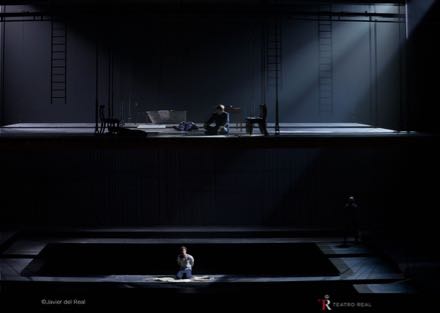
Above: Captain Vere, below: Billy Budd
There was, strikingly, no soul to be found in Captain Vere, sung by British tenor Toby Spence, and perhaps this was the intention of metteur en scène Deborah Warner. There was no intimation of the intense, human conflicts that torment Claggart, well sung by British bass Blindlay Sherratt but in absolutely one-dimensional tones.
The Teatro Real is one of the world’s major stages. The casting, mostly British, of Billy Budd was uniformly top notch, evidently fulfilling the needs and wishes of the production. The orchestra and chorus of the Teatro Real are estimable, its aspirations to producing fine opera were palpable. This Billy Budd is a co-production with Paris, Rome and Helsinki.
Cast and production
Billy Budd: Jacques Imbrailo; Edward Fairfax Vere: Toby Spence; John Claggart: Brindley Sherratt; Mr. Redburn: Thomas Oliemans; Mr. Flint: David Soar; Lieutenant Ratcliffe: Torben Jürgens; Red Whiskers: Christopher Gillet; Donald: Duncan Rock; Dansker: Clive Bayley; Un novicio: Sam Furness; Squeak: Francisco Vas; Bosun: Manel Esteve; Oficial primero: Gerardo Bullón; Oficial segundo: Tomeu Bibiloni; Amigo del novicio: Borja Quiza; Vigía: Jordi Casanova; Arthur Jones: Isaac Galán. Chorus and Orchestra of the Teatro Real. Conductor: Ivor Bolton; Stage Director: Deborah Warner; Set Design: Michael Levine; Costumes: Chloé Obolensky; Lighting: Jean Kalman; Choreography: Kim Brandstrup. Teatro Real, Madrid, February 12, 2017.
Anna Bolena in Lisbon
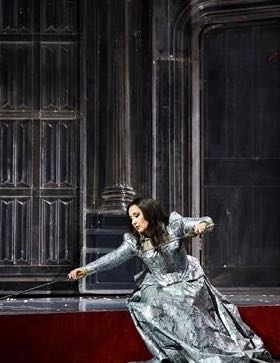
Elena Mosuc as Anna Bolena
All photos courtesy of Teatro São Carlos.
Donizetti’s Anna Bolena, composed in 1830, didn’t make it to Lisbon until 1843 when there were 14 performances at its magnificent Teatro São Carlos (opened 1793), and there were 17 more performances spread over the next two decades. The entire twentieth century saw but three (3) performances in this European capital.
Just now, in this twenty-first century, it returned for five performances, its long absence(s) due to the 150 years the operatic public has preferred operas it finds dramatically more engaging.
Donizetti’s Anna Bolena (the first of his famous three queens) does however introduce a sense of real drama to opera, as his voices explore their personal passions in a flow that almost overrides the divisions of narrative into “numbers” i.e. separate musical pieces — this considered a first, Donizetti’s breakthrough. The passions are hugely powerful, most notably of course in the protagonist who is no longer loved, wrongfully accused and then, no longer a queen, a sore loser. It flows from her first startlingly difficult aria “Come, innocente Giovine” where she expounds that her position as queen is threatened, to her final cabaletta condemning the new queen, Jane Seymour as she, Anna, proudly marches to her beheading.
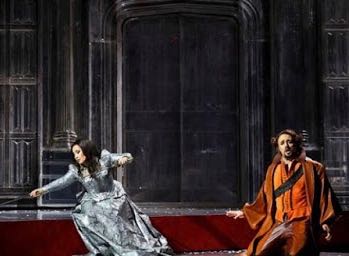
Elena Mosuc as Anna Bolena and Leonardo Cortellazzi as Percy
There were many, many more passions that are brilliantly laid out by Donizetti over the long, very long evening — by the queen-to-be Jane Seymour, Henry VIII, Percy (Anna’s former lover) and his friend Lord Rochefort (Anna’s brother), plus the page Smeton in seemingly countless arias and duets —the extraordinarily beautiful Act II duet of Percy and Lord Rochefort was indeed notable. Plus a plentitude of trios, quintets and finales with chorus.
It falls to the ambitious queen Anna Bolena to hold all this together by sheer force of artistry and personality. If 53 year-old Romanian/Swiss soprano Elena Mosuc seemed tentative in her first aria (the usual reaction of critics to this aria in performance) by the end of the opera she had found the histrionic and vocal depth and beauty of tone to thrill us first with her quiet, splendidly vocal reminiscences (usually said to be her madness) and then her full fury in “Coppia iniqua."
La Mosuc is an accomplished bel canto heroine of rich low notes, a full middle voice and beautiful high notes, notably a resplendent high E-flat that we heard over and over throughout the evening. You might wish for more dramatic heft and particularly for ornamentation that arises more naturally out of the vocal line, nonetheless her Anna Bolena was a satisfying tour de force.
Young American soprano Jennifer Holloway as Jane Seymour well held her own amidst a regional European cast, notably fine Italian tenor Leonardo Coretllazzi as Percy and Portuguese baritone Luis Rodrigues as Lord Rochefort. Turkish bass-baritone Burak Bilgili cut the imposingly wide figure of Henry VIII well enough without establishing a force of personality, histrionically or vocally to ground his participation in this passionately complicated (long) story.
Giampaolo Bisanti, music director of Bari’s Teatro Petruzzelli, led Teatro São Carlos’ willing orchestra, the house acoustic itself adding a roughness of tone that added a pleasing sense of times past to this old opera. This maestro, well traveled to Europe’s major stages in standard nineteenth century repertory, drove Donizetti’s music relentlessly seldom relaxing into the style and only rarely finding the soaring beauty of bel canto.
The 2007 production came from Verona’s Teatro Filarmonico, staged by Graham Vick and his designer Paul Brown. Mr. Vick based his staging on his assessment that the two women (Anna and Jane) use the bed to get themselves to the throne and the king (Henry VIII) uses the throne to get to the bed. Thus there was first a huge baldaquin bed, then later a huge sculpted head of blindfolded Justice followed by a huge (stage wide) sword that fell, and finally a crown of thorns, etc. — all unifying symbols to pull us through the numbers, which is to say fuse the musical pieces into a compelling narrative. A gratuitous visual quote was the enactment of the famous portrait of Henry VIII and Anna Bolena on horseback that hangs in London’s National Gallery.
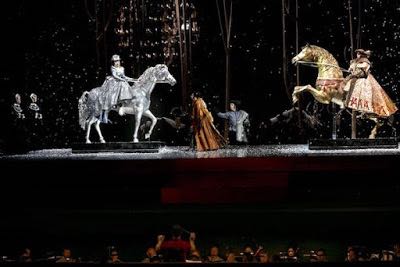
No amount of staging or dramatic intelligence can obliterate the fact that this bel canto opera is purely and simply beautiful singing into which you must be able to immerse yourself, and that Donizetti’s first queen Anna Bolena will always sit uneasily if restlessly on the fringes of the repertory.
Cast and production
Henry VIII: Burak Bilgili; Annad Bolena: Elena Mosuc; Jane Seymour: Jennifer Holloway; Lord Rochefort: Luis Rodrigues; Lord Richard Percy: Leonardo Cortellazzi; Seeton: Lilly Jorstad; Sir Hervey: Marco Alves dos Santos. Chorus of the Teatro Nacional de Sao Carlos. Orquestra Sinfónica Portuguesa. Conductor: Giampaolo Bisanti; Stage Director: Graham Vick; Sets and Costumes: Paul Brown; Lighting: Giuseppe Di Iorio.Teatro São Carlos, Lisbon, Portugal, February 9, 2017.
Giasone in Geneva
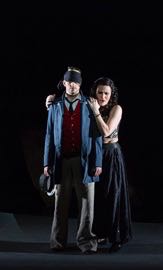
Valer Sabadus as Giasone, Kristina Hammarström as Medea
All photos courtesy of the Grand Théâtre de Genève, copyright GTG / Magali Dougados]os.
Fecund Jason, father of his wife Isifile’s twins and as well father of his seductress Medea’s twins, does indeed have a problem — he prefers to sleep with and wed Medea. In this resurrection of the most famous opera of the seventeenth century he evidently also sleeps with Hercules.
Meanwhile with Medea’s help (as you know) Jason steals the Golden Fleece which happens, in this telling, to be a vagina. He must also deal with the wrath and suicide of his wife Isifile, and in turn he must deal with the wrath of Medea. Jason is, however, a mere counter-tenor (soprano) who produces very lovely straight tones in a beautiful warm voice.
It was a long evening, very long, at the Opera des Nations in Geneva, a new, all wood stadium-like theater with minimal public spaces by the suburban UN complex, the temporary home of Geneva Opera. Almost improvisatory this slight theater would likely not withstand the vandalism incurred last year on the city’s opera house, the magnificent Grand Théâtre (closed now for two years of repairs), after budget cuts to alternative arts motivated a demonstration against this “bourgeois culture site with prices out of reach for most people.”
The proceedings of this 1649 Venetian opera unfolded slowly and methodically with the help of a bevy of licentious servants and the deus ex machine intrusion of Medea’s husband Egeo. It all worked out finally to everyone’s satisfaction — hardly the Medea outcome you’re used to — but in 17th century Venice and now in twenty-first century Geneva both sets of twins could now look forward to comfortable roofs over their heads.
You already may have the idea that Italian stage director Serena Sinigaglia went for broke in sexual matters. Indeed there was humping of Jason’s wife’s retinue by the Argonauts. Not to forget a sadomasochism (bondage and whipping) scene or watching Argonauts taking advantage of Medea’s countertenor wet nurse Delfa’s grotesque tits. Note that the Argonauts and Isfile’s retinue were non-singing as there is no chorus in Venetian opera. Besides intermittent posturing and sex acts they moved the props and scenery on and off the stage.
The Baroque orchestra Capella Mediterranean was presided over by Argentine born, Swiss early music conductor Leonardo Barcía Alarcón. As well Mo. Alarcón created this lengthy performance edition. There was a well-endowed double continuo plus a few viols and recorders to add occasional color and heft to the orchestral interludes. And of course just enough percussion to create a cute storm. Cavalli’s limited, antique musical language and these minimal orchestral resources could not begin to sustain all this bawdy violence and accompanying sexual extravagance, even with the one Baroque oboe that chimed in from time to time.
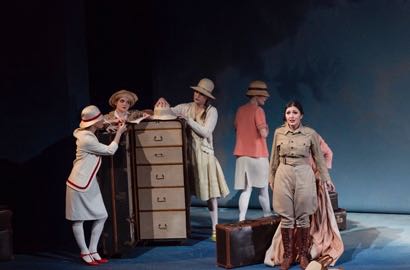
Kristina Mkhitaryan as Isifila (on right) with supernumeraries
Thus the charm of the performers was all there was to carry the evening — and this was limited.
Geneva Opera apprentice artist Mary Freminear (born in Alabama) enchanted us in her very cute cupid body suit and mask. Charming also was Geneva Opera apprentice artist Migran Agadzhanyan (born in Tbilisi, former L.A. Opera apprentice artist) who sang Demo, the hunch-backed, stuttering servant to Egeo. The un-self-conscious energy of these two young artists created a perfect balance of character to the Cavalli music. A similar energy flowed from Isifile’s maid Alinda sung by Argentine soprano Marianna Florès.
Of the four principals (the two married couples) Russian soprano Kristina Mkhitaryan, a resident artist at the Bolchoï Opera was indeed charming. She brought both beautiful singing and a nicely balanced pathos to Isifile, finding a pleasing innocence and true sincerity in Cavalli’s splendid suicide lament, floating pure toned high notes into her death wish. The sorceress Medea, sung by Swedish soprano Kristina Hammarström had the difficult task of being an aggressive queen while seducing us with Cavalli’s meltingly beautiful Poppea/Nero-like love duets with Jason, sung by Romanian counter tenor Valer Sabadus. This male soprano had the difficult task of balancing his youth and voice with the heroic demands of his character.
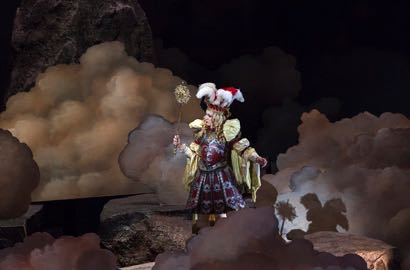
The goddess Sole in the prologue to the opera
The remaining cast, fine singers, all clashed in various ways with Cavalli’s need for sophisticated and pleasing personalities to complement the sophisticated, not-at-all bawdy directness of his music. Some of the casting however was inexplicable, like veteran bass Willard White as Oreste.
Stage director Sinigaglia’s concept of extravagant sex representing an easy seventeenth century Venetian morality was scenically represented by a potpourri of images and styles, from Baroque quotes to Japanese puppets conjured by veteran designer/stage director Elio Toffolutti who also envisioned costumes that echoed styles from then until now.
Cast and production
Giasone: Valer Sabadus; Medea: Kristina Hammarström; Isifile: Kristina Mkhitaryan; Ercole: Alexander Milev; Besso; Günes Gürle; Egeo: Raúl Giménez; Oreste / Giove: Willard White; Demo / Volano: Migran Agadzhanyan; Delfa / Eolo: Dominique Visse; Alinda: Mariana Flores; Amore: Mary Feminear. Cappella Mediterranea. Conductor: Leonardo García Alarcón; Mise en scène: Serena Sinigaglia; Décors et costumes: Ezio Toffolutti; Lumières: Ezio Toffolutti et Simon Trottet. Théâtre des Nations, Geneva, Switzerland, February 1, 2017.
Jeanne d'Arc au bucher in Lyon
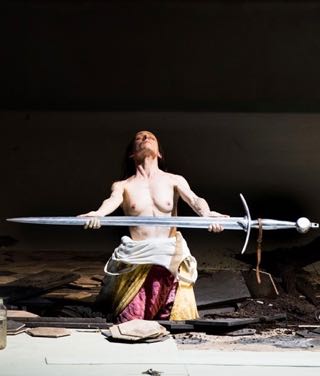
Audrey Bonnet as Jeanne
All photos courtesy of the Opéra de Lyon.
There is no bigger or more prestigious name in avant-garde French theater than Romeo Castellucci (b. 1960), the Italian metteur en scène of this revival of Arthur Honegger’s mystère lyrique, Joan of Arc at the Stake (1938) at the Opéra Nouvel in Lyon.
That Castellucci sought collaboration with Honegger and the dramatic oratorio’s author Paul Claudel to create this theater piece is no surprise. The Honegger work with its book by Paul Claudel was born in a Europe of clashing ideologies — political, artistic, technical, cultural — on the verge of self destruction. In fact the Prologue to the oratorio was added in 1944.
A time somewhat like the current moment in our now far larger world. Castellucci’s theatrical world explores an abyss of possibilities for any moment of tragedy in this or any world. For Castellucci theater is a unique language, well beyond the mere abstraction of musical language. To music Castellucci adds a tangible, physical world — real and simulated. There is the technical world that manipulates and colors the physical world and finally there is an interactive, interpretive world of infinite emotional perspectives.
It is unclear where or how you enter into Castellucci’s world, and it is also uncertain who you are. But you definitely immersed yourself Castellucci’s theater once you found yourself in Lyon’s opera house for Honegger’s mystère. The curtain rose in silence, a class of twenty-four 17 year-old girls studied silently in classroom made of reinforced concrete with period radiators and banks of neon lights. A bell rang, the girls sprang to life, noisily exited the class room and building. Faint ambient noises (dogs barking, cars, maybe sirens) were perceived over the next few minutes. A janitor appeared, swept a bit, began pulling the tables into the adjacent corridor, over time his actions took on urgency, and finally he violently and sonically heaved the last chairs and tables onto the giant pile in the corridor. He bolted the classroom door, isolating himself in the empty space.
It became apparent that the janitor was female, and we knew that soon she would be Jeanne d’Arc. She ripped the linoleum off the floor with its shrieking sound amplified, she tore out the planking and dug into the earth below. This was our 20 minute, maybe longer, maybe much longer journey into the language of Castellucci’s theatrical world.
Conductor Kazushi Ono now began Honegger’s oratorio. Joan of Arc is a speaking role, initially and through most of the piece her voice was electronically manipulated sometimes mixing it with the music, sometimes amplifying it to make clear and forceful words and sentences. Only in the last three scenes did Joan’s voice become her natural voice as she relived her childhood and accepted her martyrdom.

To be expected these final three scenes were riveting — Joan digging into the earth to find her sword, lifted into shining light, Joan dragging her dead horse, a very real horse, onto the stage and to the huge hole she had created, there followed the unforgettable imaged of Joan riding her horse. And then Joan, naked, covering herself with a white floury paste to make herself into the candle of her recalled nursery rhyme, and finally Joan, the stake itself, standing as the erect candle, an offering to the Virgin Mary.
As part of this image of Joan at the stake there then appeared an aged, maybe naked, figure who was (possibly) Joan herself as well as the saints of her visions, Catherine and Marguerite, and perhaps even the Virgin Mary.
Claudel and Honegger’s musical tragedy glories in the huge choruses of oratorio. In turn these choruses offered Castellucci the means to orient the action and to explain and advance the theatrical process. These choruses were indeed the Castellucci’s continuum, and they were persuasive. As well as, to use a Castellucci word, “gaseous.” We did not actually see the chorus until the curtain calls (it was a surprisingly small number of singers considering the size and presence of the chorus role).
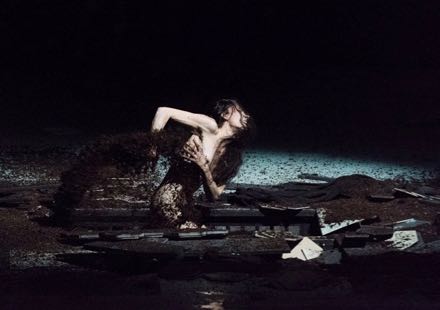
The actress Audrey Bonnet from the National Theater de Strasbourg gave the tour de force — physical and emotional — performance of first the janitor then the maid of Orléans. Castelucci’s Joan d’Arc does not attempt to move us, or ask us to sublimate her tragedy into a transcendent experience, as had, for example, Jean-Paul Scarpitta’s 2005 Jeanne d’Arc au bûcher in Montpellier. Instead we participate in her suffering, a theatrical participation that leaves us outside any hope of mystical or emotional release. It is theater, nothing more (and what more should there be) and nothing less (it is very fine, challenging theater).
Some of the same things may be said of Honegger’s score (standard orchestra with the addition of three saxophones, an ondes martenot and two pianos). The musical perspective is outside looking in. It is “surface” (to use a Castellucci word) and not essence. Though not closely identified with any of the predominant styles of the early-mid twentieth century Jeanne d’Arc au bûcher is richly twentieth century in musical effect.
Cast and production
Jeanne d’Arc: Audrey Bonnet; Frère Dominique: Denis Podalydès; La Vierge: Ilse Eerens; Marguerite: Valentine Lemercier; Catherine: Marie Karall; Ténor solo (une voix, Porcus, 1er Héraut, Le Clerc): Jean-Noël Briend; Récitant: Didier Laval; Récitant: Louka Petit-Taborelli. participation de Istvan Zimmermann & Giovanna Amoroso, Plastikart Studio. Chorus, children’s chous and orchestra of the Opéra de Lyon., Chœurs et Maîtrise de l'Opéra de Lyon. Conductor: Kazushi Ono; Mise en scène, décors, costumes et lumières: Romeo Castellucci; Dramaturgie: Piersandra Di Matteo; Collaboratrice artistique Silvia Costa. Opera Nouvel, Lyon, France, January 31, 2017.
Falstaff in Genoa
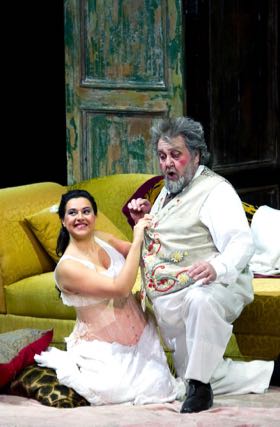
Valentina Boi as Alice, Alberto Mastromarino as Falstaff
All photos courtesy of Teatro Carlo Felice.
A Falstaff that raised-the-bar ever higher, this was a posthumous resurrection of Luca Ronconi’s masterful staging of Verdi’s last opera, the third from last of the 83 operas Ronconi staged during his lifetime (1933-2015). And his third staging of Falstaff following Salzburg in 1993 and Florence in 2006.
Both earlier productions designed by his long time operatic scenic collaborator Margarita Palli.
This Luca Ronconi Falstaff production was first seen in Bari in 2013 (then in Naples and Florence). It is designed by Tiziano Santi, normally a collaborator in Ronconi’s non-operatic theater projects. Santi’s set is nothing more than walls of blank canvases, including the show curtain itself, against which walls Verdi’s gigantic comedy takes place. It is minimalist staging, the scenes traveling presentationally back and forth across downstage. Finally it was a purely verbal Falstaff, staged so the we heard every word uttered both by the voice on the stage and by Verdi’s orchestra in the pit. And we clearly saw every word lived by the opera’s protagonists.
29 year-old, wunderkind conductor Andrea Battistoni was in the pit engaging the hyper alive Genoa orchestra with the stage, magnifying the “Falstaff immenso! enorme Falstaff!” announced by Sir John Falstaff into monumental proportion, driving the punctuating cadences to every last one of Verdi’s intended exclamation points, delighting in the sweet, fleeting encounters of the young lovers, encouraging the female chatter and indulging the Italian male cuckold fetish to its absolute maximum. It was a conducting tour de force, sparks still flying from the tip of his baton (stick still in-hand) at his stage bow.
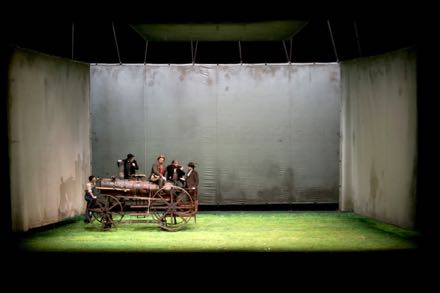
Ford's tractor, Fenton extreme left, Ford in hat with feather extreme right
The Genoa cast of January 28 found a distinctly Mediterranean bias for Ronconi’s simple English farm life — The Italiano Alberto Mastromarino as Falstaff, Brazilian born, Spain finished baritone Rodrigo Esteves as Ford, Serbian born and trained Nenad Čiča as Fenton, Livorno born Valentina Boi as Alice. Plus two Russian born artists who have become Italian artists — Anastasia Boldyreva as Dame Quickly and Daria Kovalenko as Nanetta. Add to these the bevy of Italian male buffo character roles that were plumbed to perfection in the inimitable Italian buffo tradition.
Interestingly this was the second cast, singing two of the five performances, but you could not imagine or wish for more finished performances. Sir John Falstaff was of believable girth, of quick spirit and of powerful voice. You could, for moments from time to time, even believe that this Falstaff was an honest predator and not simply a caricature of delusion. He quibbled with Ford as an equal, triggering Rodrigo Estives, a very smart-looking, too handsome farmer, to go-off-the-deep-end in forceful hyper-baritonal terms. Note that the Ford disguise was dark glasses and, wittily, a pillow stuffed under his jacket to add girth. Fenton was dressed in bibbed denim trousers, the classic piece-of-straw chewin’ farm hand, tenor Nenad Čiča’s “Dal labro il canto estasiato vola” exquisitely wrought in tenorial flight.
The Alice Ford of Valentina Boi was ever so slightly maternal, her ample lyric voice buoying the fracas of female voices in Ronconi’s barnyard (sketched by nothing more than four geese in a line), pedaling on and off on fantastical antique bicycles with her daughter, Nanetta, sung by Daria Kovalenko in her little-girl operetta-like voice. Anastasia Boldyreva found the richness of tone to vocally convey Verdi’s satiric Quickly, yet it was the voice of a real woman (and gratefully not a cameo appearance by a famous over-the-hill diva). Meg Page did what she always does — stayed out of the way except when needed.
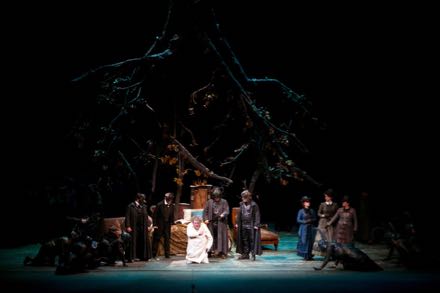
The upside down oak tree
It was perfect theater, well until Act III when the Herne, the Hunter’s Oak inexpicably flew in upside down and dramatically the carefully entwined threads lost direction. Focus was further diluted by Nanetta’s anemic delivery of “Sul fil d’un soffio etesio.” It is possible that the slight musical insecurities inherent to a second cast noticed throughout the evening became more pronounced. We were left musically and dramatically adrift until finally the 10 protagonists walked across the stage apron to sit on the lip and deliver Falstaff’s immense and enormous fugue “Tutto nel mondo è burla, l’uomo è nato burlone” directly under the conductor’s baton. It was indeed Verdi’s 10 voiced fugal joke as never before, his response maybe to Wagner’s 50 voiced Meistersinger riot and certainly a bit of well-meaning one-upmanship to the great ensembles of Rossini himself.
Cast and production
Sir John Falstaff: Alberto Mastromarino; Ford: Rodrigo Esteves; Fenton: Nenad Čiča; Dottor Cajus: Cristiano Olivieri; Bardolfo: Marcello Nardis; Pistola: Mihailo Šljivić; Mrs. Alice Ford: Valentina Boi; Nannetta: Daria Kovalenko; Mrs. Quickly: Anastasia Boldyreva; Mrs. Meg Page: Manuela Custer. Chorus and Orchestra of the Teatro Carlo Felice. Conductor: Andrea Battistoni; Production: Luca Ronconi; Stage Director: Marina Bianchi; Scenery: Tiziano Santi; Lighting: A. J. Weissbard. Teatro Carlo Felice, Genoa, Italy, January 28, 2016.
Madama Butterfly at San Francisco Opera
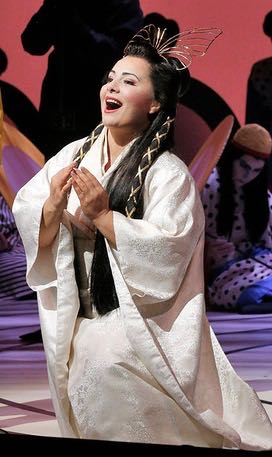
Lianna Hartounounian as Cio-Cio-San
[All photos copyright Cory Weaver courtesy of San Francisco Opera]
A Butterfly for the ages in a Butterfly marred by casting ineptness and lugubrious conducting.
The Madama Butterfly of Armenian soprano Lianna Haroutounian may well become recognized as the Butterfly of our time, indeed one of the great Butterflies of all times. It is a role she is just now assuming, thus it is fresh in her voice, mind and body. This freshness makes these performances here in San Francisco unique, an experience not to be missed by operatic lepidopterists — and aren’t we all?
Mlle. Haroutounian arrived at Paris Opera’s young artist program through Moscow, and achieved immediate successes as many of the major Verdi heroines. In 2014 she was miscast as Tosca in San Francisco, a fine singer but simply not the diva Tosca is and must be — in voice and persona.
Mlle. Haroutounian still does not exude the complexities of a diva and this brings the sheen of innocence to her Butterfly that makes it operatically true. The purity of voice that casts her as the unstained Verdi heroine, and the security of her vocal technique sustain the youth and stamina of the 18-year-old Butterfly. The strength and beauty of tone throughout the role’s range underscore the moral certitude of this simple and courageous geisha.
The excited Saturday night audience understood and felt the gravity of Butterfly’s strength and innocence, and awarded Mlle. Haroutounian an ovation the size of which I have never before witnessed in the War Memorial Opera House.
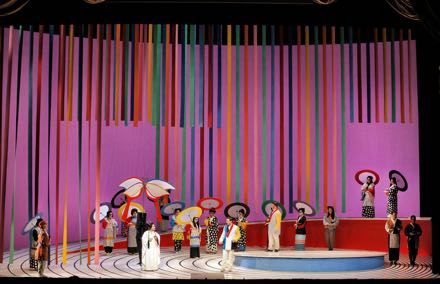
Act I meeting of Butterfly and Pinkerton
The production was a remount of the 2006 Jun Kaneko Opera Omaha production first seen here in 2014. The production is simply a masterpiece. It is/can be pure gesamtkunstwerk — the effective if unlikely synthesis of op art with Puccini’s verismo score. The contradiction of these polar opposite styles relies on a sympathetic rhythm of parallel emotional flows to unite the abstractions of sound with the abstractions of shape. It was perfection in 2014 when the Nicola Luisotti fleetness of musical soul melded with the force of shape and delicacy of movement of the Jun Kaneko colors and images.
Canadian conductor Yves Abel conducts nine of these ten performances. Evidently smitten by the emotional force of Mlle. Haroutounian’s Butterfly he editorialized on the tragedy with volume and bombast. While Mlle. Haroutounian could sail above this much of the rest of the cast could not. Conductor Abel added dramatic pauses (silences) that were annoying, annoying long and confusing — even to the diva.
The actual staging of the singers was once again entrusted to the production’s original director, Leslie Swackhamer, a Seattle based advocate for women playwrights. The production having traveled throughout the U.S. over the past ten years has given Mme. Swackhamer much experience. In this edition Trouble remained on the stage for too much of the second act wrenching focus from Butterfly and Suzuki. Otherwise her staging was without reproach.
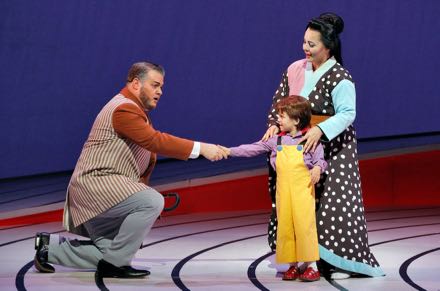
Anthony Clark Evans as Sharpless, Trouble, Lianna Haroutounian as Butterfly
Sharpless was sung by Lyric Opera of Chicago’s Anthony Clark Evans who despite obvious youth succeeded in bringing a deeply felt gravitas to this sympathetic bureaucrat. Mr. Evans possesses a voice of very great beauty he used with intelligence. He moved with a dramatic purpose that did not require the cane he was given, evidently to simulate age.
Pinkerton was sung by young Italian tenor Vincenzo Costanzo who has few if any of the traits of the Italian tenor. The punctuation of such stylistic mannerisms were sorely needed to balance the sheer size of the diva’s performance — the character of a Pinkerton was not vocally etched with sufficient strength to motivate the depths of their joint tragedies.
Yamadori, Butterfly’s ridiculous, old suitor was impersonated by Adler Fellow Edward Nelson who read as about nineteen years old. A lithe, handsome presence he delivered his few lines with elegance, confusing us by presenting a quite presentable, maybe preferable alternative to Pinkerton. Suzuki was sung by Adler Fellow Zanda Švēde. This fine, young singer brought an inappropriate, strongly athletic presence to Butterfly’s passive, compassionate companion, further compromised by a weird, unattractive wig. Goro was sung by Korean born Julius Ahn who contributed a light weight verisimilitude to the role, gratuitous under the circumstance. The Bonze was professionally delivered by Raymond Aceto.
Over the years this splendid production has been seen in many, many cities throughout the U.S., a monument to the high art that can be achieved in American opera. However, in addition to the questionable casting and conducting, the curved background scrim was not carefully stretched, further compromising the integrity of the Jun Kaneko production here in San Francisco.
Cast and production information:
Cio-Cio-San: Lianna Haroutounian; Lt. B. F. Pinkerton: Vincenzo Costanzo; Suzuki: Zanda Švēde; Goro: Julius Ahn; Sharpless: Anthony Clark Evans; Prince Yamadori: Edward Nelson; The Bonze: Raymond Aceto; Imperial Commisioner: Matthew Stump; Kate Pinkerton: Julie Adams; Official Registrat: Jere Torkelsen. San Francisco Opera Chorus and Orchestra. Conductor: Yves Abel; Director: Leslie Swackhamer; Production Designer: Jun Kaneko; Lighting Designer: Gary Marder. War Memorial Opera House, San Francisco, November 12, 2016.
Aida at San Francisco Opera
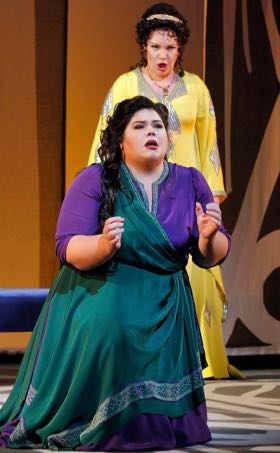
Leah Crocetto as Aida, Ekaterina Semenchuk as Amneris
[All photos copyright Cory Weaver courtesy of San Francisco Opera]
An exquisite pit, a Busby Berkeley stage, ingenue performers. Populist opera in San Francisco — in November eleven performances of Aida (alternating with ten of Madama Butterfly).
No echoes of spectacles like the al fresco productions beneath Egypt’s pyramids or Rome’s Baths of Caracalla. Nor of San Francisco’s famed jockstrap-less gay pride Aida, or an imagined specter of a new Zefferelli production recently dismissed by the Met. No echoes at all of the big singers that have always been called upon to evoke the monumental atmospheres commemorating global transformation.
Certainly not the 1981 San Francisco production starring Luciano Pavarotti, never-mind-the-name-of-the-opera [Aida]. If there is a star for this current production it is SFO protégé Leah Crocetto who offered a very sweetly sung Aida, and succeeded in projecting the beauties of the Italian language in an intimate “Ritorna vincitor” — though marred by a premature (surely unintended) drop of the hieroglyphically encrypted show scrim.
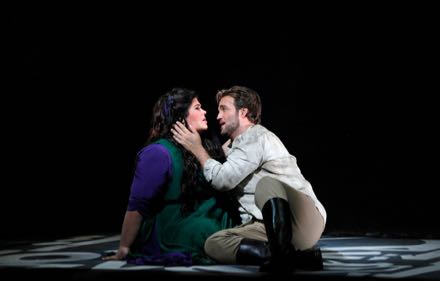
Leah Crocetto as Aida, Brian Jagde as Radames
Aida’s lover Radames was SFO protégé Brian Jagde. Once we arrived at the entombment of Aida and Radames Mr. Jagde’s knife-edged voice softened and we heard, finally and with welcome relief, a voice of a sweetness and warmth that matched that of Mlle. Crocetto’s Aida. Conductor Nicola Luisotti carefully sculpted this protracted scene into one of profound operatic intimacy. It was memorable.
Luisotti made this Verdi score all about atmospheres, pulling forth every possible musical nuance to be evoked by the flow of the Nile and the glow of the Egyptian night sky. There was innocent playfulness in the Moorish dance, and even in the eruption of violence when Radames surrendered and Aida and her father fled Luisotti sustained measured strokes. More often for Luisotti these days it was a reflective reading of the score rather than a flow of dramatic points. The maestro made exquisite music of this warhorse.
If high art emanated from the pit, low taste poured forth from the stage, and it was not unintended. Stage director Francesca Zambello has been turning out provocative productions of Aida over the decades. This edition adds the hieroglyphic inspired alphabet created by L.A. artist Retna (alias of Marquis Duriel Lewis) to her provocations. These symbols (said to actually say something — but only to Retna) covered the show curtain and the huge panels of the triumphal scene, and elsewhere. You may recall his cover art for Justin Bieber's 2015 album "Purpose."
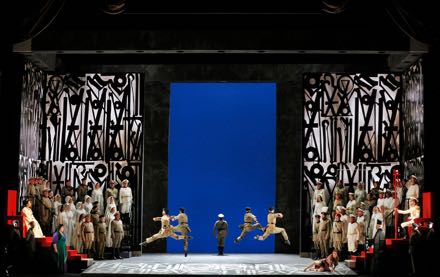
A moment in the Triumphal Scene
Zambello added as well eight dancing boys, and eight more boys who danced but were not trained dancers, two of whom were accomplished acrobats. When not dancing these groups of males sometimes marched across the back of the stage. Evidently the ritualized motions of these males were intended to illustrate religious statehood. Mme. Zambello used a related movement technique as well in her La vestale at ENO some years ago.
The choreography was created by Jessica Lang, a well-known name in institutional dance. She imagined complex, highly geometrical routines whenever possible but especially in the triumphal scene where there was no procession, instead a ballet in which the eight dancing boys chased and threw around a ballerina. Mmes. Lang and Zambello enforced a crescendo of visual razzle dazzle through which we barely felt the measured pace of the maestro’s triumphal march. It was tongue-in-cheek, camp and kitsch all at once. And sort of lovable.
Zambello updated the costumes to generic uniforms and religious robes of recent periods, and the program notes declared that the supertitles would say foreigners rather than Ethiopians or slaves. Mme. Zambello’s intended message that women were looked upon as possessions of men was perhaps apparent only to her, though the hijab-less ballerina was indeed tossed about quite a bit.
Things get serious in the third act and it was here that the singers seemed undirected, left to wander in a stage space absent of context. It was here that we felt to need of heroic singers to construct the political and dynastic catastrophe that Verdi creates musically, i.e. operatically. Aida does not play as a chamber opera of familial proportions cum triumphal scene, though this premise may have precipitated the role debuts of Mlle. Crocetto and Mr. Jagde.
With the exception of the Amonastro sung by baritone George Gagnidze and the Ramfis of Raymond Aceto, both seasoned, solid professionals additional casting was inexplicable. Precocious Adler Fellow bass Anthony Reed sang the King of Egypt who invites his daughter Amneris to award Radames the triumphal crown. The supertitles were not modified to indicate the obvious — that this Amneris was twice the age of the young king and was thus his mother! Amneris, sung by Russian mezzo Ekaterina Semenchuk, found appropriate colors in her upper voice but otherwise melted into the scenery.
Cast and Production
Aida: Leah Crocetto; Amneris: Ekaterina Semenchuk; Radames: Brian Jagde; Amonasro: George Gagnidze; Ramfis: Raymond Aceto; King of Egypt: Anthony Reed; A Priestess: Toni Marie Palmertree; A Messenger: Pene Pati. San Francisco Opera Chorus and Orchstra. Conductor: Nicola Luisotti; Director: Francesca Zambello; Associate Director: E. Loren Meeker; Choreographer: Jessica Lan; Artistic Designer: RETNA; Set Designer: Michael Yeargan; Costume Designer: Anita Yayich; Lighting Designer: Mark McCullough. War Memorial Opera House, San Francisco, November 8, 2016.
The Makropulos Case at San Francisco Opera
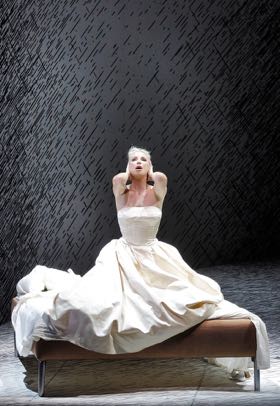
Nadja Michael as Emilia Marty
[All photos copyright Cory Weaver courtesy of San Francisco Opera]
A fixation on death at San Francisco Opera. A 337 year-old woman gave it all up just now after only six years since she last gave it all up on the War Memorial stage.
Strange programming at San Francisco Opera. While these October performances of Janacek’s penultimate opera do mark the 50th anniversary of its American premiere (at SFO in November 1966) one might have wished for a change of opera — not theme. For one of many examples we might have had Janacek’s last opera — From the House of the Dead instead, a surpassing masterpiece that has yet to find its way to San Francisco.
But dismiss that thought. In many ways this seems like the first time we will have witnessed this strange Slavic comedy here in San Francisco, given a convergence of factors — notably a comedienne of such dimension that we were irrevocably and directly present at the final collapse and total disintegration of a 337 year-old woman, and, strangely, the absence of a star conductor, leaving us with the raw, unfiltered power of the Janacek orchestral specter. It was an evening of monumental art.
There will be many of us San Franciscans who recall the veritable Who’s Who of Makropulos Case personages over the past 50 years — the Paul Hager production of 1966 with the forever mourned Marie Collier (our Tosca when Maria Callas was not), the 1976 remount of the same sets but with legendary Anna Silja directed by the young David Pountney, conducted by Ernő Dohnányi, the 1993 remount of the same cloth painted sets now staged by legendary soprano Elisabeth Söderström and conducted by famed Janacek champion Charles Mackerras. Then finally in 2010 a new production. French born, Germany based director Olivier Tambosi created a vehicle for the powerhouse presence of Karita Mattila conducted by esteemed Janacek interpreter Jiří Bělohlávek.
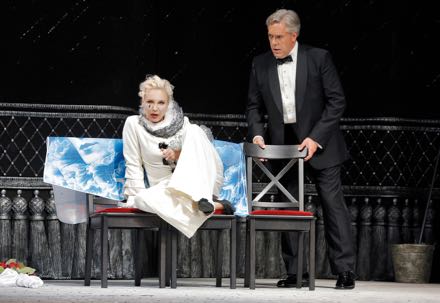
Nadja Michael as Emilia Marty, Stephen Powell as Baron Jaroslav Prus
But it has taken Leipzig born, Berlin based, American educated (IU) Nadja Michael to realize the Emilia Marty (formerly Elina Makropulos et al) in deepest and truest and most vivid essence on the War Memorial stage, aided in no small way by stage director Tambosi in this remount of his turntable, solid-walled production. The lithographic scenic texture grounded the storytelling in timelessness — even with the naive, gratuitous real time clock. The concentrated playing areas forced the action into high theatrical pitch, and the lighting burned through the threads of time with maximum intensity.
Soprano Nadja Michael was one with her costumes and platinum wig, brilliant quotations from historic haute couture, teasing where high fashion crosses into theater (and cinema) and visa versa. Her costumes gave free flow to the supple physical contortions she effected, that took us to a confusion of the real with the irreal, blurring human and the supernatural. Mme. Michael possesses a strong voice and riveting presence that dissolved into moral exhaustion and the finality of her existence.
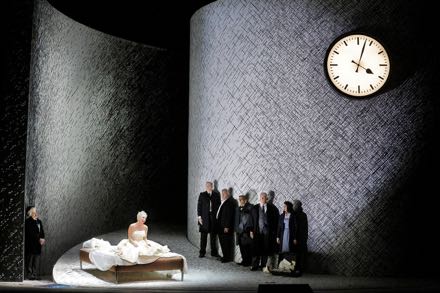
The death of Emilia Marty, Elina Makropolus, et al
But neither the men in her life nor the young singer aspiring to this artistic immortality had the size of personality or voice to illuminate much less confront the very complicated machinations of the plot. I wanted bigger, more important characters to effect the musical gestures of love and longing, hopelessness and realization that Janacek develops in all of his operas. It is possible that this pallid humanity was exaggerated by the naïveté of the conducting. Young St. Petersberg conductor Mikhail Tatarnikov permitted the primary, primitive motions of Janacek’s orchestral continuum to illuminate the diva but the maestro all but ignored the complex world in which she existed. As well, and disappointingly the young maestro did not achieve the shattering orchestral climaxes that would ordinarily cap each of the acts.
Given the conducting perhaps the supporting characters did not have a chance. Tenor Charles Workman as Berti missed the soaring climaxes of the hapless, incestuous lover, tenor Brenton Ryan, a participant in the L.A. Opera young artist program, does not yet have the chops to muster the intensity of compulsive infatuation. Joel Sorensen brought sharp brittleness to the role of the law clerk Vitek, and as well I found an unwanted caricature in the role of the aspiring singer Kristina, performed by Adler Fellow Julia Adams. As Gregor’s lawyer, Dr. Kolenaty, and Gregor’s opponent, Baron Prus, baritones Dale Travis and Stephen Powell left me wishing for more powerful voices and personages.
Nonetheless it was an exhilarating evening at San Francisco Opera.
Cast and production information
Emilia Marty: Nadja Michael; Albert Gregor: Charles Workman; Baron Jaroslav Prus: Stephen Powell; Dr. Kolenatý; Dale Travis; Vitek: Joel Sorensen; Kristina: Julie Adams; Count Hauk-Sendorf: Matthew O’Neill; Janek: Brenton Ryan; A Cleaning Woman/A Chambermaid: Zanda Svede; A Stagehand: Brad Walker. Chorus and orchestra of the San Francisco Opera. Conductor: Mikhail Tatarnikov; Stage Director: Olivier Tambosi; Production Designer: Frank Philipp Schlössmann; Lighting Designer: Duane Schuler. War Memorial Opera House, October 18, 2016.
Don Pasquale at San Francisco Opera
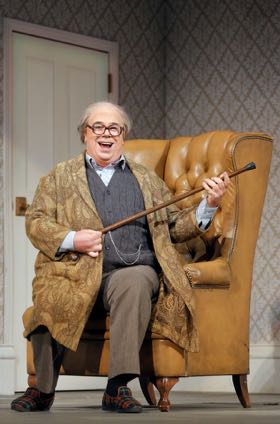
Maurizio Muraro as Don Pasquale
[All photos copyright Cory Weaver courtesy of San Francisco Opera]
With only four singers and a short-story-like plot Don Pasquale is an ideal chamber opera. That chamber just now was the 3200 seat War Memorial Opera House where this not always charming opera buffa is an infrequent visitor (post WWII twice in the 1980’s after twice in the 40’s).
Don Pasquale is a most welcome visitor. It is the first of the three operas of the last year of Donizetti’s creative life, and one his few operas based on comedic formulae. Certainly a masterpiece it imposes physical, interpretive, musical and vocal challenges that were somewhat met just now in San Francisco.
The bel canto of early Romanticism is ephemeral stuff, far more content exploring the extended delights of fraught emotions than the rapidity and physicality of comedy. Donizetti’s libretto does indeed get serious, the usual triumph of youth over age accompanied by a deeper take on human emotions, though finally their frivolousness is forgiven.
Italian conductor Giuseppe Finzi (former assistant to SFO’s Nicola Luisotti) found the seriousness of musical purpose in Donizetti’s score and its warmth, and sustained the tempo of comedy as well. This gifted maestro discovered the lightness of musical touch, the delicacy of line and the richness of orchestral color that makes bel canto soar, and kept our musical sensibilities on edge for the duration of the opera.
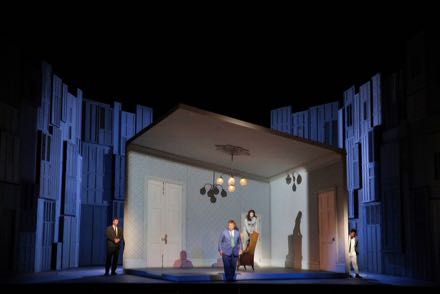
Act I, left to right Lucas Meachem as Dr. Malatesta
Maurizio Muraro as Don Pasquale, Heidi Stober as Norina, Lawrence Brownlee as Ernesto
The Laurent Pelly production ignores Donizetti’s (and comedy’s usual) forgiving humanity, exploring instead the emotional underbelly of spoiled, selfish youth. And finally it dwells on just plain elder abuse. This gifted French stage director divided the opera into two parts, the first (acts I and II) were straight forward comedic antics of contemporary images and sensibilities. It was pure, delightful, mid-last-century humor that melded gracefully into the pit.
Act III (after intermission) moved to comic book colors and imagery, everything upside down — very clever (there was an open curtain set change I did not witness). Norina was now in a crinoline layered, puffed out orange skirt, Ernesto in white, lose-fitting casual shirt and pants, the starry sky was facing up. Mr. Pelly deftly and smoothly managed his actors in crazy antics (Ernesto climbing through a window, though keep in mind that the window is upside down — as was Ernesto!).
Meanwhile however it was the same Donizetti musicality emanating from the pit. The concept short circuited into an abrupt, unsatisfying end because the two Laurent Pelly worlds did not, indeed could not converge, and the coldness of the concept could not reconcile with the intrinsic musical charm of Donizetti’s stock comic characters. We were left dramatically and musically bewildered.
The production was inaugurated at the Santa Fe Opera, with Santa Fe Opera principles, i.e. the back of the stage open into the New Mexico sky, in San Francisco a black void. But the scenery by French designer Chantal Thomas intelligently deployed forced perspective side walls to create the idea of classic comedy’s crossroads. In the center of the stage she constructed an angularly complex revolving structure that focused the story into a small area that wittily moved us in and out of Don Pasquale’s house. The sets well filled the War Memorial Stage.
Even the side walls played their role, the abstracted shapes becoming lighted windows that opened onto the the stage in the last moments of the opera, a hint at least that we were in the finale.
Don Pasquale himself was sung by Italian buffo Maurizio Muraro. A gifted comedian exhibiting genuine Italian buffo style his performance was pure delight beginning to end, his ample girth bouncing lightly off the floor on the several times he was laid out by situation. The role of Dr. Malatesta was double cast, veteran SFO house singer Lucas Meachem for four performances, Adler Fellow Edward Nelson for two performances including the one I attended. This young singer well held his own, but greatly confused the story, his youth and lack of earned buffo gravitas at odds with the dramatic responsibilities of the role.
House singer, soprano Heidi Stober sang Norina. Mme. Stober is a gifted comedian who acted Mr. Pelly’s concept with aplomb, missing however Norina’s youth. Mme. Stober seems to catch all the soubrette roles at SFO, from Sophie in Werther to Magnolia in Showboat, from Pamina in The Magic Flute to Johanna in Sweeney Todd. This fine, demonstrably generic singer did not find the vocal verve for Donizetti’s mid-voice, relying on big, loud high notes for effect.
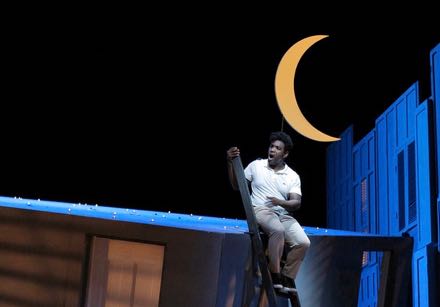
Lawrence Brownlee as Ernesto in Act III
Lawrence Brownlee was the Ernesto in his belated San Francisco debut. Beyond his status as one of the world’s leading bel canto tenors, upheld in this performance, Mr. Brownlee exhibited a surprising physicality and wit that I now understand he has been asked to suppress in recent high-concept productions seen elsewhere (Narciso in Aix, Don Ramiro in Pesaro, Tamino in L.A.).
Of note were the few lines of the Notary appropriately and gruffly sung by Bojan Knežević and the wonderful third act chorus cameo “Che interminabile andirivieni!” delivered with obvious gusto and evident pleasure by 24 members of the SFO Chorus.
Cast and production
Don Pasquale: Maurizio Muraro; Norina: Heidi Stober; Ernesto: Lawrence Brownlee; Dr. Malatesta: Edward Nelson; A Notary: Bojan Knežević. Chorus and Orchestra of the San Francisco Opera. Conductor: Giuseppe Finzi; Stage Director and Costume Designer: Laurent Pelly; Set Designer: Chantal Thomas; Lighting Designer: Duance Schuler. War Memorial Opera House, San Francisco, October 4, 2016.
Dream of the Red Chamber at San Francisco Opera
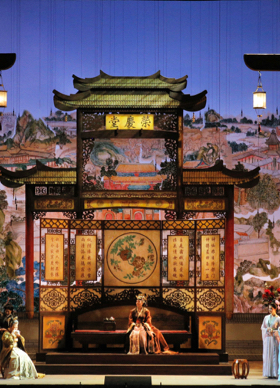
A scene from the opera, Tim Yip production designer
[All photos copyright Cory Weaver courtesy of San Francisco Opera]
Globalization finds its way ever more to San Francisco Opera where Italian composer Marco Tutino’s La Ciociara saw the light of day in 2015 and now, 2016, Chinese composer Bright Sheng’s Dream of the Red Chamber has been created.
The Tutino opera was said to be a co-production with Teatro Regio di Torino though there is no trace of it in upcoming Torino seasons. Dream of the Red Chamber is a co-production with the Hong Kong Arts Festival where it will be performed in English. It is said that if there are additional performances in China Mr. Sheng will re-cast it in Chinese, with the intriguing question of how this English language Gian Carlo Menotti-like theater piece will sound sung in Mandarin.
The Bright Sheng Dream of the Red Chamber is a very Chinese indeed, based on a famous Chinese novel of the same name by one Cao Xueqin of the 18th century Qing Dynasty, his novel considered one of the four pre-modern Chinese classics.
As it came down to those of us sitting in the War Memorial Opera House it is the story of a family who owes the emperor money. The debt can be repaid if the family scion will marry a rich heiress. He however prefers to write poetry with a pretty cousin. He has a dream sleeping in a red chamber in which the two young women appear, confusing him.
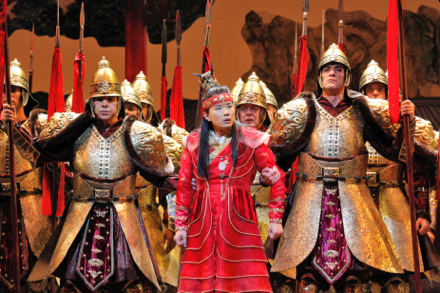
Yijie Shi as Bao Yu seized by imperial guards
San Francisco Opera’s publicity enthused that this is the Chinese equivalent of Romeo and Juliet, though it really is the equivalent of Richard Strauss’ Die Liebe der Danae, originally titled A Marriage of Convenience.
Unlike the motivic subtleties Richard Strauss exploits, Bright Sheng has based his musical story telling on the tunes of Chinese folk songs, and there are four or five of them that appear and then reappear, one in particular stood out sung to the words “A woman's only chance for happiness is to marry well.”
Mr. Sheng’s style is middle-of-the-road, mid-last-century with strong moments of Stravinsky and Hindemith et al, though there is a strong dose of mid-range brass and jazz chords that adds a big-band feel from time to time. What makes his style unique are the lurid colors of the orchestration, glissandos and oriental intervals. Mr. Sheng is a very able composer, and of prolific invention when expanding his folk song material.
Most characteristic of his vocal lines was the leap of a major 7th to a high note, and there were high notes aplenty, delivered always forte to fortissimo.
Like musical comedy, Mr. Sheng and his famed Chinese-American co-librettist David Henry Hwang (Broadway’s M. Butterfly) set up situations and then sang songs about what had happened. There were lots and lots of songs. It is a very long opera.
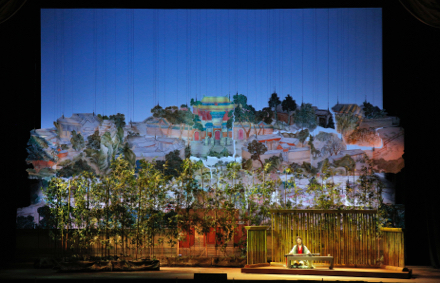
A scene from the opera
Like musical theater, the sets, designed by Tim Yip (the film Crouching Tiger, Hidden Dragon), were cloth drops that flew in and out and small wagons of set pieces that rolled on and off so that locations could quickly and easily be changed without breaking the pace of the opera’s musical theater song structure. Obviously there was much bright red color, and much richness in the imperial decor that threatened the debtor family. Mr. Yip, an Academy Award winning art director, supplied the costumes as well, of required 18th century Chinese dynastic splendor.
Of note in the large cast was tenor Yijie Shi who brought a fine level of operatic professionalism to his role as the family scion.
Cast and production
Dai Yu: Pureum Jo; Bao Yu: Yijie Shi; Lady Wang: Hyona Kim; Bao Chai: Irene Roberts; Granny Jia: Qiulin Zhang; Princess Jia: Karen Chia-ling Ho; Aunt Xue: Yanyu Guo; The Monk/Dreamer: Randall Nakano; Lady-in-Waiting/Flower: Toni Marie Palmertree; Lady-in-Waiting/Flower: Amina Edris; Lady-in-Waiting/Flower: Zanda Švēde; Eunuch/Stone: Pene Pati; Eunuch/Stone: Alex Boyer; Eunuch/Stone: Edward Nelson. San Francisco Chorus and Orchestra. Composer and Co-librettist: Bright Sheng; Co-librettist: David Henry Hwang; Conductor: George Manahan; Stage Director: Stan Lai; Production Designer: Tim Yip; Lighting Designer: Gary Marder; Choreographer: Fang-Yi Sheu. San Francisco War Memorial Opera House, September 18, 2016.
Andrea Chénier at San Francisco Opera
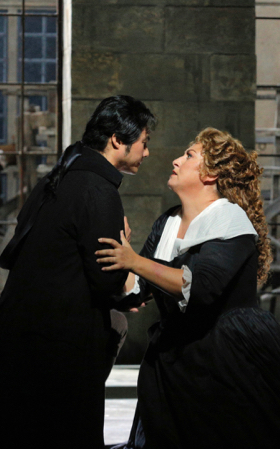
Yonghoon Lee as Chénier, Anna Pirozzi as Maddalena
[All photos copyright Cory Weaver courtesy of San Francisco Opera]
San Francisco Opera makes occasional excursions into the operatic big-time, such just now was Giordano’s blockbuster Andrea Chénier, last seen at the War Memorial 23 years ago (1992) and even then after a hiatus of 17 years (1975).
Andrea Chénier is a masterpiece of many styles — of verismo, the micro-second before emotion explodes; of melodramma, the moment emotion is expressible only by singing; of post-Romanticism where emotional colors overwhelm all dramatic impetus. Its libretto is a triumph of latent lyricism that dissolves into a musical magic that possesses your mind, body and soul.
And it all happened on the War Memorial stage. Well almost.
The eight-year so far tenure of San Francisco Opera music director Nicola Luisotti has imposed a resplendent warmth and suppleness to this superb orchestra, attributes that responded most comfortably to the ample tempos the maestro imposed onto Giordano’s opera, tempos that fused easily and naturally with the musical impulses of the singers.
It was this sometimes problematic maestro at his finest, his hyper-Italianate musicality flowing unabashedly and unstoppably for the two hour, too brief duration of this magnificent opera.
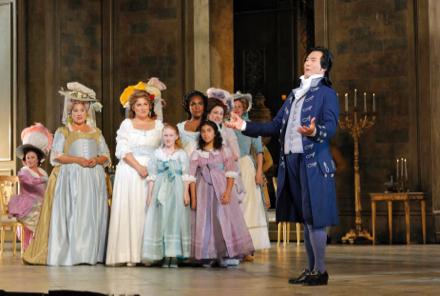
Second from left Anna Pirozzi as Maddelena, third from left J'Nai Bridges as Bersi
choristers and supers, Yonghoon Lee as Chénier
Andrea Chénier is a tenor showpiece, and actually little more than that, four gigantic arias that are an exposé of voice and style and pose. It was once whispered in War Memorial corridors that tenorissimo Roberto Alagna would be our Chènier, but even his splendid swagger could not compensate for the uncomfortable phrasing of his 2013 concert attempt at the role (Opera Orchestra of New York). Tenorissimo Jonas Kaufman was the original Chénier of this Covent Garden production brought now to San Francisco, but this oh-so-famous tenor does not find his way to the operatic provinces.
And all the better because San Francisco Opera fielded South Korean tenor Yonghoon Lee as the doomed poet Andreas Chénier. If lacking the ethnicity of the Italian tenor, Mr. Lee’s distilled mastery of the style was exquisite. The vocal gestures were elegant moreso than mannered, the posing more for vocal and musical necessity than tenorial vanity. Mr. Lee’s performance satisfied on every level, he proved himself a connoisseur's tenor.
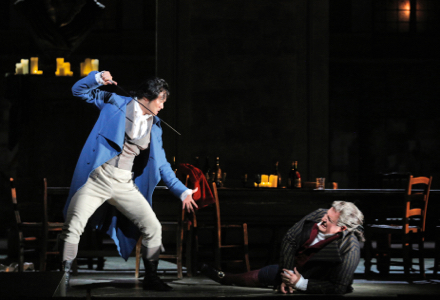
Yonghoon Lee as Chénier, George Gagnidze as Gérard
Blue chip casting continued with the Gérard of Georgian baritone George Gagnidze. Famed as a Rigoletto (L.A. and Aix-en-Provence in my experience), Gagnidze finds the deep humanity of this footman infatuated both by the poetry of the revolution and by the beautiful daughter of the soon-to-be annihilated aristocratic family he serves. Beautifully sung and sensitively acted he upheld the artistically aristocratic tenor of the performance.
Outstanding among the fine cast were the charming Bersi of J’Nai Bridges, the confident Roucher (Chénier’s friend) by David Pershall, and the gruff and rough Mathieu (the sans culotte), not to overlook Joel Sorensen’s sly Incroyable. The cameo of the blind Madelon offering her grandson to the revolution was satisfyingly delivered by Jill Grove. Finally much appreciation must be extended to the San Francisco Opera Chorus for the splendid execution of its sizable role in the opera,
Problematic were the performances of Catherine Cook as the Countess of Coigny who made the role broad caricature, a tone that clashed with the overall mood of the opera. The role of Maddalena (daughter of the Countess in love with Chénier) was taken by Italian soprano Anna Pirozzi who sang the notes adequately without evoking either musical or dramatic character. Much reference was made to her golden hair though her wig read as mousy brown (from my seat in Row 16).
The production was by British director David McVicar who stages most everything of size and importance at San Francisco Opera (and the Met and Covent Garden and elsewhere). His productions are well researched, beautifully designed, skillfully executed and always very big (but not too). And entirely generic.
The scenery for this Andrea Chenier was designed by Robert Jones, well known to the world’s major operatic venues. The solid constructions were rich in period detail, creating the very specific environment of late 18th century France. The costumes designed by Jenny Tiramani were rich in period detail, though the white dresses worn by Maddelena and Bersi in the first act (1789 eve-of-Revolution) seemed a bit similar to the white dresses of the merveilleuses (fashionable women who survived the Reign of Terror) of the second act (1794). Hear/tell the costumes were also constructed in period technique (no zippers, only hooks) if not, hopefully, in actual Lyonnaise silk.
As a David McVicar production is haute gamme so was the lighting, a virtuoso accomplishment of lighting designer Adam Silverman who struggled nonetheless to create a sense of mood. The play of lights and shadows remained, like the McVicar production, an exercise in theater technique rather than a dramatic and musical discovery of Giordano’s magnificent opera.
Cast and production
Andrea Chénier: Yonghoon Lee; Maddalena di Coigny: Anna Pirozzi; Carlo Gérard: George Gagnidze; Bersi: J’Nai Bridges; L'Incredibile: Joel Sorensen; Mathieu: Robert Pomakov; Roucher: David Pershall; Madelon: Jill Grove; Contessa di Coigny: Catherine Cook; Pietro Fléville: Edward Nelson; The Abbé: Alex Boyer; Dumas: Brad Walker; Fouquier-Tinville: Matthew Stump; Schmidt: Anthony Reed; Major-Domo: Anders Fröhlich. San Francisco Opera Chorus and Orchestra. Conductor: Nicola Luisotti; Stage Director: David McVicar; Set Designer: Robert Jones; Costume Designer: Jenny Tiramani; Lighting Designer: Adam Silverman. San Francisco War Memorial Opera House, September 17, 2016
Don Carlo at San Francisco Opera
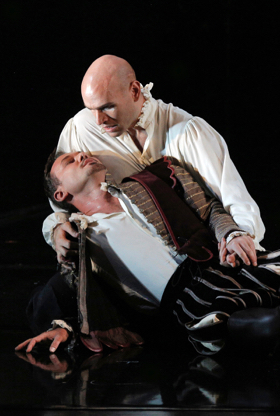
Mariusz Kwiecien as Rodrigo (below), Michael Fabiano as Don Carlo (above)
[All photos copyright Cory Weaver courtesy of San Francisco Opera]
Not merely Don Carlo, but the five-act Don Carlo in the 1886 Modena version! The welcomed esotericism of San Francisco Opera’s extraordinary spring season.
Everyone knows that Don Carlos was written in French, and premiered in 1866 at the Paris Opera. Like all grand opera productions in Paris it included a ballet. An Italian translation quickly surfaced for performances in London the next year and then in all major Italian theaters. All sorts of modifications to the opera’s extraordinary length were taken, resulting finally in the Verdi sanctioned four act, no ballet La Scala version of 1884. It is said that Verdi may not have objected to the addition of the original first act (in Italian) for performances in Modena in 1886.
And therefore in San Francisco in 2016. Don Carlo has been done in San Francisco both in the four-act La Scala version and in a five-act Don Carlos French version, though without the ballet (Verdi originally insisted that the opera must include the ballet). With hoped for new directions at San Francisco Opera perhaps we will some day soon have the opera as Verdi intended.
It can come as no surprise that the Italian language Modena five-act version was chosen for these performances given that Italian conductor Nicola Luisotti is the SFO music director. Though an unexpected double-take could not be helped when we heard words that simply do not belong in Fontainebleau. While strange words were probably not meant to be the old theater trick of putting the audience on edge (stage directors sometimes do it by forcing blinding light into your eyes), it had that effect.
So it was as if we were hearing this magnificent opera for the first time. Conductor Luisotti held us spell bound for four and one half hours, every possible quiver or roar of emotion poured forth, never once did we feel the score being pushed for effect, nothing too fast, nothing too slow. Always the Verdi genius was foremost (and not the conductor’s). Evidently Luisotti had met his match. Finally.
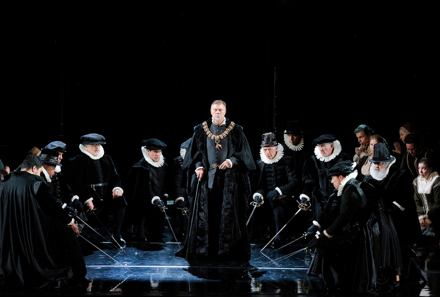
René Pape as Philip II
In the fourth and fifth acts this Don Carlo venerated the centuries old, creaky, passé opera seria style with its succession or arias. After King Philip’s momentous “Ella giammai m’amo” Rodrigo dies with his very moving “Per me giunto é il dì supremo.” Then there is the most trying aria in the repertory, not because of emotional or technical difficulties but because it is of extended length and comes four hours into the opera. Philip’s wife and Don Carlo’s lover Elisabeth delivered “Tu che le vanità conoscesti del mondo” in such exquisitely soaring voice that an already exhausted audience gave it the biggest ovation of the evening!
On the basis of the casting, American tenor Michael Fabiano as Don Carlo and Polish baritone Mariusz Kwiecién as the Marquis of Posa the opera could well be renamed Carlo and Rodrigo as these two splendid singing actors made this opera more about the love of two men — sublimated into freeing the oppressed — and its ramifications than about the thwarted betrothal of Don Carlo to Elisabetta and its ramifications. From the first moments of the pasted on first act, Don Carlo’s romance “Io la vidi” (better known as “Je l’ai vu dans son sourire”), we knew that tenor Fabiano was born to this role, finding sufficient Verdi vocal heft and color to compete musically with kings and queens and a spurned woman while he sustained the character of a weak and troubled epileptic youth. Rodrigo, the Marquis de Posa, baritone Kwiecién found the seductive, the duplicitous and the sacrificial, confusing everyone with beautiful, convincing singing. Both men — and maybe most of all Verdi — made this edgy staging very real and very moving.
The opera Don Carlo is also about power — ecclesiastical and secular power. Power is a very complicated question in the Verdi oeuvre and he discusses it in great depth in Don Carlo. Here King Philip II usurps his son’s fiancé to gain political power, and finally gives his son to the Inquisition to maintain his power. The Philip II of bass René Pape found very real humanity for this unhappy king in the always touching “Ella giammai m’amo” but otherwise did not create the overwhelming sense of suffocating authority that might underlie these four and one half hours.
Andrea Silvestrelli was over parted as the Grand Inquisitor, his roughness of voice and tired presence did not adequately color the manipulative cunning and sinister reasoning of such an instrument and technique of power. Still the famous bass duet was convincing in its revelation of the weakness and vulnerability of Philip II. The old monk who begins and ends the opera (the four act version) was sung by Adler Fellow Matthew Stump. An old, tired presence would be preferred to balance the maturity of the cast, and the maturity of the subject matter of the opera.
Texas soprano Ana Maria Martinez brought us a beautifully sung if pallid Elisabetta — the role itself does find much presence in this male world until the fifth act aria (see above) when she essentially has the last word, decrying the vanities of the world. Verdi’s snarling mezzo, Eboli was well sung by Bulgarian mezzo soprano Nadia Krasteva who fulfilled her function as catalyst for Philip II’s lament without ever have fully taken the stage, even in her famous “O don fatal.”
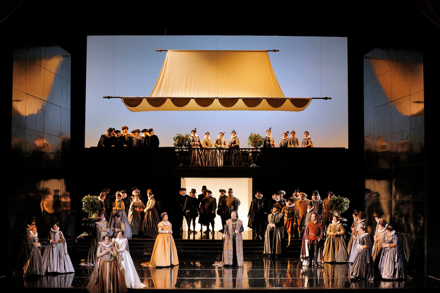
Production by Emilio Sagi, set design by Zack Brown
The pedestrian production was the remount of a 1998 San Francisco Opera production by Spanish director Emilio Sagi (note that all productions in this spring season come from 1998). An opera of the stature of Don Carlo and a quality cast deserve a production that can plumb the theatrical depths of this masterpiece.
If this 2016 early summer San Francisco Opera season had some real interest, consider the 2017 early summer season: Rigoletto, Don Giovanni and La Boheme, all in oft re-cycled productions.
Cast and production
Don Carlo: Michael Fabiano; Elisabetta: Ana Maria Martinez; Princess Eboli: Nadia Krasteva; Rodrigo: Mariusz Kwiecien; Philip II: René Pape; The Grand Inquisitor: Andrea Silvestrelli; A Monk; Mathew Stump; Tebaldo: Nian Wang; A Heavenly Voice: Toni Marie Palmertree; Count Lerma: Pene Pati. Chorus and Orchestra of San Francisco Opera. Conductor: Nicola Luisotti; Director: Emilio Sagi; Designer: Zack Brown; Lighting Designer: Gary Marder. War Memotial Opera House, San Francisco, June 15, 2016.
Jenufa at San Francisco Opera
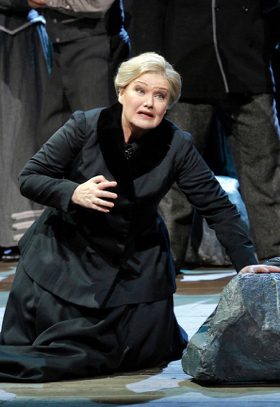
Karita Mattila as Kostelnička
All photos copyright Cory Weaver courtesy of San Francisco Opera
The early summer San Francisco Opera season has the feel of a classy festival. There is an introduction of Spanish director Calixto Bieito to American audiences, a five-act Don Carlo and two awaited, inevitable role debuts, Karita Mattila as Kostelnička and Malin Bystrom as Janacek's Jenůfa.
Swedish soprano Malin Bystrom (the Mozart heroines in Salzburg and at the Met and Covent Garden) was born to be Janáček's melodramatic heroine. A lithe, youthful presence with a voice of sufficient importance to make us revel in this squalid, brutal tale of a primitive social world. As well her voice possesses a primal purity and innocence that reassures us finally of the beauties possible in the human psyche. The Bystrom Jenůfa was at once the fallen woman and the redeemed soul, her redemption a simple acceptance and understanding of human love.
Some twenty years ago this was the Jenůfa of Karita Mattila as well. No longer willing to portray the guilty innocence of an operatic adolescent this extraordinary diva has transformed herself into Jenůfa's stepmother Kostelnička, a mature woman driven by powerful social forces and overwhelmed by a selfish form of maternal love. Mattila fans (and that is nearly everyone) have eagerly awaited the Mattila take on this complex and emotionally demanding role.
Mattila’s transition from daughter to mother however has not been fully effected in San Francisco. While there is no question that la Mattila projected the persona of great force that this role requires we see that sheer force of personality alone cannot explain and does not explore the subtlety and cunning of this conflicted human creature.
Subtlety and cunning are indeed ripe in Janáček’s adaptation of The Stepmother’s Daughter (the play on which Jenůfa is based and in fact the Czech title of the opera) and in Janáček’s musical score every germ of thought and action is detailed, and the motivations are nervous, brutal, direct and honest interspersed with moments of understanding that are luminous. The story builds to a shattering climax and final minutes (not moments) of revelation that can attain the sublime.
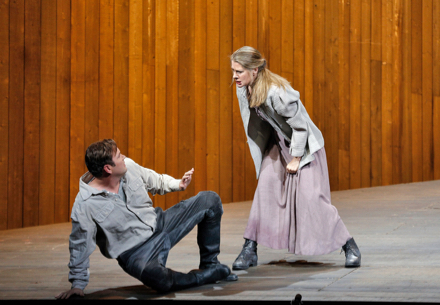
Scott Quinn as Steva, Malin Byström as Jenufa
Czech maestro Jiří Bělohlávek took a symphonic approach to the score that integrated Janáček's maelstrom of thought fragments into larger musical shapes. This larger wash, a somewhat dreamlike emotional force, robbed Janáček's characters of the psychic minutiae that informed their actions, leaving us in an unexplained emotional wake. We missed the bursts of revelation as they were absorbed into this larger and indeed far more delicate thrust. From the first moment conductor Bělohlávek left us no where to go, and no place to land.
A similar approach was taken by French stage director Olivier Tambossi when he conceived his Jenůfa production (1998). He abstracted the minutiae of Janáček’s primitive peasant world into one primary image — a boulder (a metaphor for emotional weight mentioned in Act II). Like conductor Bělohlávek he suppressed the particulars of the world of Kostelnička, leaving us in its emotional wake — a priori he interpreted Kostelnička’s world for us by reducing it to this one image. We had nothing to discover, we were simply told. By-the-way the stone looked a lot like a huge potato. It was confusing.
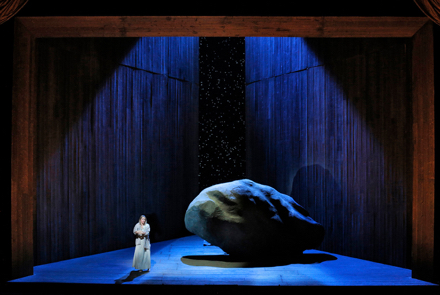
Malin Byström as Jenufa
Of somewhat lesser scale than the two divas were the performances by William Burden as Laca and Scott Quinn as Steva. Both young men impressively created Janacek's troubled young men, both are very fine singers and excellent actors. Such talent begs a production that does not rely solely on force of personality.
Though a victim of the heavy-handed direction Grandmother Burjovka was ably portrayed by Jill Grove.
As usual the Adler Fellows assumed many minor roles. Soprano Julie Adams was an appropriate Karolka and baritone Matthew Stump made an almost believable Foreman-at-the-Mill. The fresh voices of the Adlers are always a great pleasure to hear and admire. These young singers are too often called upon to portray characters that have nothing to do with their age, personalities, or quality of voice.
Casts and production
Jenůfa: Malin Byström; Kostelnička: Karita Mattila; Laca Klemeň: William Burden; Steva Buryja: Scott Quinn; Grandmother Buryjovka: Jill Grove; Foreman at the Mill: Matthew Stump; Mayor of the Village: Anthony Reed; Karolka: Julie Adams; Barena: Toni Marie Palmertree; The Mayor's Wife: Zanda Svëde; The Maid: Laura Krumm; Jano: Sarah Tucker. Chorus and Orchestra of the San Francisco Opera. Conductor:Jiří Bělohlávek; Director: Olivier Tambosi; Production Designer: Frank Philipp Schlössmann; Lighting Designer: Gary Marder. War Memorial Opera House, San Francisco, June 14, 2016.
Carmen at San Francisco Opera
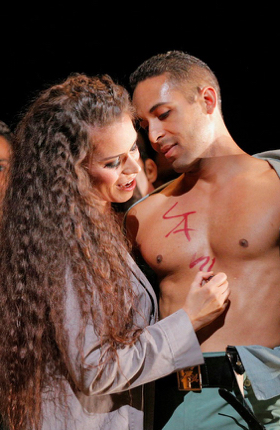
Ginger Costa-Jackson as Carmen with supernumerary
All photos copyright Cory Weaver courtesy of San Francisco Opera]
Calixto Bieito is always news, Carmen with a good cast is always news. So here is the news.
The Calixto Bieito Carmen is old news, this edition having already taken place in Barcelona, Venice, Torino and Bilbao where I saw it in 2014. Already a Bieito Carmen has been around on advanced European operatic stages since 1999. This production was never headline news, finding instead this extraordinary stage director in a rather subdued state.
Bieito always creates a world that puts you on edge, here it was the cut-out bulls on the hilltops of Spain, gypsies in dilapidated cars, freaked out youth, blinding beaches and lurid tourism, and of course bull rings. Yes, in Bieito’s world there is fellatio, pissing, nudity, gang rape, child abuse and unbridled brutality. Yes, Mercedes was Lilas Pastia’s middle-aged wife, and yes, Don Jose was really annoyed by an insistent Micaëla who sang her pretty song and then gave Carmen the “up-yours.”
First delineated by a semi-naked soldier hypnotically circling the stage for much of Act I Bieito’s Act IV bull ring finally was only a chalk-line circle laid down by Lilas Pastia in which the raw power of Carmen’s indifference was pitted against the impotent supplications of Jose. Murdered, Jose dragged Carmen out of the circle — like a dead bull.
Movement is violent and often sudden in this Bieito world. There were very limited moments of dialogue but many additions of crowd noise and shouts, and punctuations of imposed silence broken by frenetic crowd clamor. The quintet [in Bilbao] was splendidly staged catching the lightening speed of the music in fast, demonstrative movement, and the trio was deadpan, the cards read on the hood of a car with no sense of doom, Carmen indifferent to her fate.
There was no set. A simple cyclorama against which there was first a flag pole and a phone booth, then a car and a Christmas tree, then eight cars and a gigantic cut out bull and finally nothing except a beach with a marked out chalk ring.
All this might seem a recipe for a powerful tragedy, but this does not seem to be Bieito’s intention. The telling of Jose’s infatuation disappears into this cosmos of marginal life in Spain and becomes unimportant in itself, its emotions melted into the morass of a much bigger and equally violent, emotionally raw world.
Bieito’s Carmen world did not make it to San Francisco.
Production notes clarify that what we have now in San Francisco is “based on” Bieito’s 1999 production, staged “after Bieito” by Spanish director Joan Anton Rechi. For the record there was no fellatio, no pissing, no gang rape, no child abuse and no unfettered brutality. Replacing Bieito’s violent, elemental world are precious emblems of some Spanish village in North Africa, to wit 1980’s Mercedes Benz (six of ‘em) that are used as taxi’s thereabouts.
Replacing Bieito’s mythical characters, his larger than life personages that embody the tragic human scope of men and women (and a child as well) caught relishing this brilliant, brutal world were very fine singers in young artist programs or recent graduates thereof (with the exception of the Micaëlas of Ellie Dehn and Erika Grimaldi, both established, elegant exponents of Mozart’s Countess).
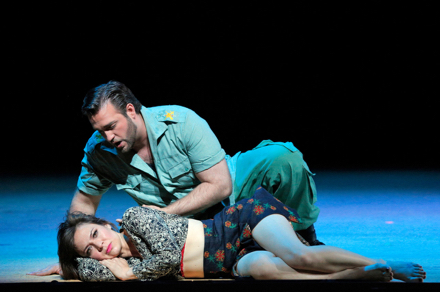
Irene Roberts as Carmen, Brian Jagde as Don Josén
Bieito’s emblematic tragedians were now young, real people, who recently perfected their roles in coaching studios. Director Joan Anton Rechi obliged their fine preparation with what would liked to have passed as a type of realism. The resulting movement on stage however read as practiced mechanical motion rather than as a gritty enactment of character realization. With no real character achieved by these too willing young artists no continuity of story emerged, leaving Bizet's tragic masterpiece a series of unrelated musical numbers.
Italian conductor Carlo Montanaro relished the elegance of the esteemed San Francisco Opera Orchestra, finding a continuum of refined sound rather than capturing the changing moods and violence Bizet’s musical kaleidoscope. Tempos seemed too fast or too slow, or both at the same time. Both the flute and cello solos were self-consciously over-articulated destroying dramatic mood in search of elegance.
The San Francisco Opera Orchestra is a major ensemble, capable of plumbing the dramatic depths of the repertory, in fact you get the feeling it is straining at the bit to do so. Pairing it with an eviscerated production and a clueless conductor squanders this splendid resource.
Both of the Carmens, Irene Roberts and Ginger Costa-Jackson who alternate in the eleven performances are viable artists and both are real, ingenue Carmens. I particularly appreciated the variation of vocal color projected by Mlle. Costa-Jackson, and greatly admired the splendid voices and solid techniques of both artists. Tenor Brian Jagde sings ten of the eleven performances, many back to back, i.e. day after day. Tenor Adam Diegel sang one performance (May 28) in which he found some of Bizet’s hapless lover. Brian Jagde seemed too busy making great big tenor sounds — that wore us out over the long evening — rather than finding the humanity of this role.
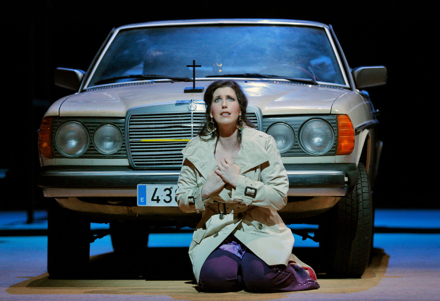
Ellie Dehn as Micaëla
Italian soprano Erika Grimaldi was miscast as Micaëla, though her “Je dis” on May 28 was beautifully and very elegantly delivered. On June 1 soprano Ellie Dehn was a-fish-out-of-water and in apparent vocal difficulty. Neither of the two Escamillos could fill the breeches of Bizet’s toreador, nor muster the required vocal coglioni — inexplicable casting. All supporting roles were responsibly sung, though cast without regard to the character needs of this Bieito production.
Casts and Production
Carmen: Ginger Costa-Jackson (May 28); Carmen: Irene Roberts (June 1); Don José: Adam Diegel (May 28); Don José: Brian Jagde (June 1); Micaëla: Ellie Dehn; Escamillo: Michael Samuel (May 28); Escamillo: Zachary Nelson (June 1); Frasquita: Amina Edris; Mercédes: Renée Rapier; Morales: Edward Nelson; Zuniga: Brad Walker; El Dancairo: Daniel Cilli; El Remendado: Alex Boyer; Lillas Pastia: Yusef Lambert. Chorus and Orchestra of San Francisco Opera. Conductor: Carlo Montanaro; Production: Calixto Bieito; Stage Director: Joan Anton Rechi; Set Designer: Alfons Flores; Costume Designer: Mercé Paloma; Lighting Designer: Gary Marder. War Memorial Opera House, San Francisco, May 28 and June 1, 2016.
The Lighthouse at San Francisco's Opera Parallèle
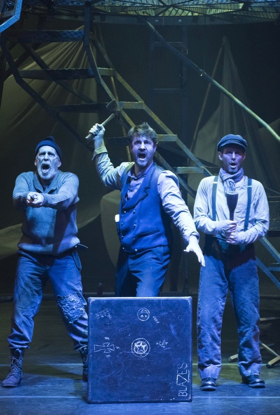
Robert Orth as Blazes, David Cushing as Arthur, Thomas Glenn as Sandy
All photos copyright Stefan Cohen, courtesy of Opera Parallèle]
What more fitting memorial for composer Peter Maxwell Davies (d. 03/14/2016) than a splendid performance of The Lighthouse, the third of his eight works for the stage.
Such was the production mounted by Opera Parallèle, an ambitious San Francisco operatic enterprise that offers two productions each season in theaters appropriate to specific repertory. The Lighthouse took place in the Mission district’s 300 seat, very arty, black box Z Space. Earlier this season Champion, an Opera in Jazz was performed at the SFJAZZ Center.
Peter Maxwell Davies (pronounced Davis) became resident of the bleak Orkney Islands above Scotland’s most northerly coast a few years before composing this bleak operatic masterwork about three real-life keepers who vanished from a lighthouse on a bleak island far off Scotland’s west coast. These Scottish extremes remained in fact a powerful Davies muse, interweaving climatic challenge with emotional isolation. A huge body of affective and very effective music results from these complementary components.
The Davies stage pieces, The Lighthouse in particular is not a narrative, rather it is like an ABA musical form: exposition, development and recapitulation (with a twist). The musical forces (12 fine instrumentalists) mustered by Opera Parallèle succeeded in creating climatic and emotional chaos, transforming it from time to time into ballads and hymns that organized the inherent despair of the lighthouse keepers. Crucial to the success of this production was the presence of the musical ensemble on the acting stage itself, this immediacy infused an almost overwhelming musicality into the performance.
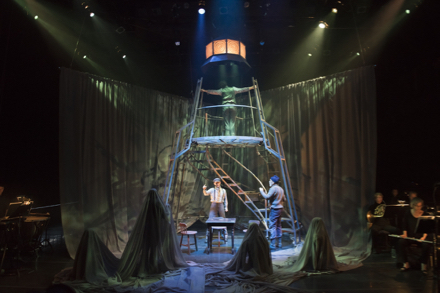
The percussion sat stage right, the balance of the ensemble and conductor were stage left enveloping within the music the three singers and the lighthouse of skeleton steel with its huge beacon lamp. The supply ship relief crew were at once the lighthouse keepers and the demons that inhabited and destroyed this troubled humanity. The final wallop, and it was complex and huge, happened when the chaos of all unknown and unsolved mysteries erupted into a final hysterical hymn.
Stage director/designer Brian Staufenbiel used no more than the named props — a table and two chairs, a lighthouse, and the sea. The sea itself was created by four ninjas who brandished poles of gauzy cloth and who themselves became the rats of the libretto. The three singers were always positioned or moved musically rather than dramatically. Costuming and lighting fulfilled a cool professional production standard.
All three singers were impressive, baritone Robert Orth added histrionic depth, bass-baritone David Cushing brought rich, evangelist tone, and tenor Thomas Glenn found true beauty of tone in his love song.
Conductor Nicole Paiement ably kept the complex musical forces together, coaxed careful, fine playing from her ensemble and drove the Davies score to a searingly effective climax.
Casts and production information:
Sandy/Officer 1: Thomas Glenn; Blazes/Officer 2: Robert Orth; Arthur/Voice of the Cards/Officer 3: David Cushing. Conductor: Nicole Paiement; Stage Director/Set Designer: Brian Staufenbiel; Costumes: Christine Crook; Lighting Designer: Matthew Antaky. Z Space, San Francisco, May 1, 2016.
Svadba at San Francisco Opera Lab
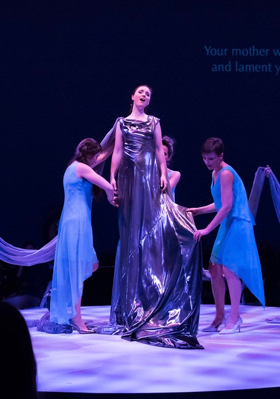
Final moments of the bride's preparation
All photos copyright Stefan Cohen / San Francisco Opera.
The brand new SF Opera Lab opened last month with artist William Kentridge’s staged Schubert Winterreise. Its second production just now, Svadba-Wedding — an a cappella opera for six female voices — unabashedly exposes the space in a different, non-theatrical configuration.
The Atrium Theater is a huge square room with overwhelming neoclassical architectural elements, said to seat 300. It sits atop the Veterans Memorial just next door to the War Memorial Opera House. The theater is a daunting space, posing enormous challenges to producers. Its possibilities are exciting and limitless. May the new management of San Francisco Opera rise to the occasion!
Obviously it is an impossible space for a natural acoustic to exist or to be consistent. Thus the room has been acoustically engineered to the ‘nth degree with all sorts of advanced technologies. Based on this performance of Svadba the sound was entirely satisfactory, if manufactured.
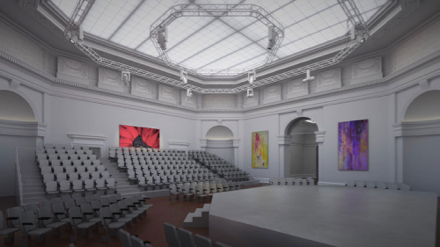
The Dianne and Tad Taube Atrium Theater in theater configuration
Svadba (2013) is a brief (55 minutes) opera by Serbian composer Ana Sokolovic (b. 1968). She lives in Canada. "Svadba" means marriage in Serbian, a slavic language, thus for these performances at the SF Opera Lab the title became Svadba-Wedding.
There are apparently marriage customs that straddle slavic cultures, one of which is the preparation of the bride’s hair for the marriage day, like Konstantin Makovsky’s enormous “The Russian Bride’s Attire” (1889) that hangs in San Francisco’s Palace of the Legion of Honor. This is simply that. That Svadba is an opera is a question in itself. It may be more of a painting as there is little if any dramatic development. Mainly there is exposition of subject, like your eye following the story told in the fixed images — a painting.
The subject matter of Svadba is of far less importance than the delight you find in the way the story is told. Composer Ana Sokolovic created its seven moments with the six female voices, but they are not always a cappella. There were strategic dings of a bell, plus noises the six singers created with the few props as well as stomping, clapping and tongue clicking.
The sound world was enormous using the tones of trained voices that mostly moved in soundscapes of close intervals, though of course there was much rhythmic invention of syllables that were both nonsense and Serbian. To our Western ears the formulated voice sounds were all abstract (the sounds were so involving that we ignored the sparse supertitles). When there were melodic moments they were in the modal scales of slavic folk music, and this alone created a long ago and far away atmosphere.
There were two strategic and quite beautiful moments when the voices collided on the first inversion of a triad chord, and the grandiose final moment when the voices resolutely landed on a perfect fifth! It was good music. The six singers were superb musicians with beautiful voices.
The subject matter is essentially folkloric though its relevance surely has long disappeared. The metteur en scène, perhaps the composer herself chose to update the imagery to contemporary dress and action. I found this disconcerting given my assumption of dated subject matter, though maybe there currently are some strange customs among Serbian women who live in Canada. However all this female maneuvering was a long haul for the guys sitting at my table (we sat on rented banquet chairs, like at a wedding celebration). We will have our male moment next month when we are offered a gang rape by stage director Calixto Bieito (Carmen, Act I).
The SF Opera Lab did not entrust the staging to a sophisticated stage director who might explore contemporary staging theories and conceptual practices, rather it was realized by Winnipeg, Canada stage director Michael Cavanagh (SF Opera productions of Susannah and Lucia di Lammermoor). Mr. Cavanagh’s concept was that we all were at the wedding resulting from the preparation of the bride’s hair.
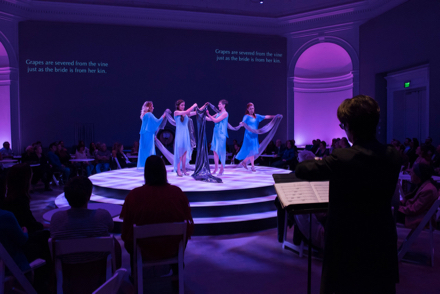
Preparing the bridal gown and audience at tables
The opera began on a platform in the middle of the room, then the action moved counterclockwise to a corner of the room, then a second corner, then the third, along the back wall, finally the fourth corner and then back to the center for the ending. It was tiresome, plodding organization.
All movement was abstract choreography in imitation of the music, often breaking natural movement into tiny bits of movement, like the fragmentary quality of the music. The lighting was sometimes fragmentary as well in flashes of pastel color. This music does not need, want or tolerate illustration, it merely requires focus and this we sorely lacked.
The magic of this splendid score was largely lost in this staging attempt. Note that the concept included champagne and wedding cake for everyone.
Il turco in Italia in Pesaro
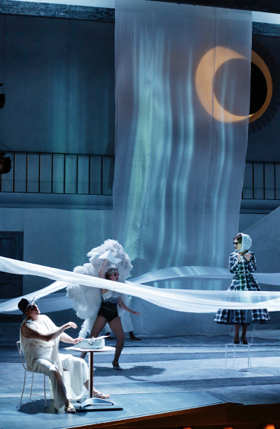
Pietro Spagnoli as Prosdocimo, supernumerary (center), Olga Peretyatko as Fiorilla (far right)
All photos courtesy of the Rossini Opera Festival, Pesaro.
When more is definitely more, and less would indeed be less. Two of the biggest names in Italian theater art collide in an eponymous theater.
That’s Gioachino Rossini and Federico Fellini in Pesaro’s historic Teatro Rossini. Italian director Davide Livermore (that’s lee-vair-MOR-aye) unabashedly re-wrote Fellini’s Lo scieco bianco (The White Sheik) and 8 1/2 as Rossini’s Il Turco in Italia, or maybe it’s the other way around. All your favorite characters were present: the sheik himself, Guido (Marcello Mastroiani) as the film director, the whore Saraghina, the priest(s) and cardinal, the glamorous mistress(s), the bearded lady, the showgirls, and probably many more characters you and I may have forgotten since the 1960’s.
Rossini’s world became Fellini’s and Fellini’s world became Rossini’s. Prosdocimo’s play got written (with a lot of help from his actors), and Fellini’s film got made. Davide Livermore brought it all together adding the perfect physical comic schtick that matched up perfectly with the musical pace of Rossini’s masterpiece. And was funny to boot, sometimes really funny, like the mute Saraghina’s dominatrix relationship with the tenor priest Narciso.
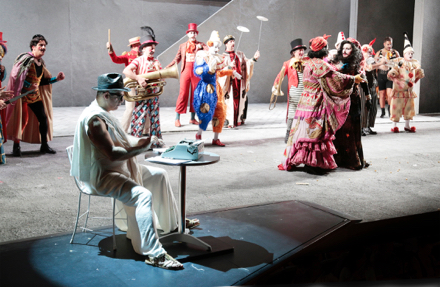
Paolo Spagnolo as Prosdocimo in Act I costume, Pietro Adaini as Albazar, Cecilia Molinari as Zaida with members of the Chorus of the Teatro della Fortuna M. Agostini
Surprisingly all this was not too much, given that Rossini’s librettist Felice Romani had already complicated a really simple comic situation with an absurdist pre-Pirandello intuition, like the metatheatrical Six Charactors. Just as Fellini’s films are laden with images that abstractly create a real world that is imaginary so does Livermore’s opera, a world that we feel and understand but that would take volumes to define. Finally Livermore lays out Rossini’s mixture of error and truth in the same way as had Fellini.
Like some of the American film critics of the time (1963) opined the film 8 1/2 misses touching the heart or moving the spirit, that it’s structure is incomprehensible, and finally that it was a plain out fiasco. This of course can be said of Livermore’s masterful staging. It was far more an intellectual game than a honest rendering of comic and sentimental truths of Rossini’s opera.
Roman born, Juilliard trained opera coach turned conductor Speranza Scappucci was in the pit with the Filarmonica Gioachino Rossini. This brilliant young conductor provided the control needed to keep the bedlam on the stage comprehensible. It was solid music making, with the possibility of inspired music making far beyond what could be expected or even wanted. Her tempos were moderate, patter was measured, the Rossini “boil” or ‘buzz” was never fully achieved, and the unique Rossini joy of singing was absent. But the event was about Fellini, and it was spectacular.
The question looms — what was the understanding and pleasure of those (few) of later generations sitting in Teatro Rossini for whom Fellini films are not part of their general culture?
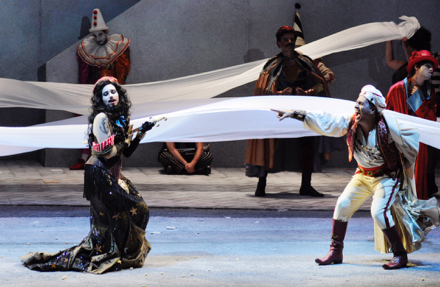
Erwin Schrott as Selim recognizing Cecilia Molinari as Zaida in Act
The greatest charm of the evening was the sheik Selim, sung by Uruguay born, Italian trained baritone Erwin Schroit [FYI former partner of Anna Netrebko] who had no more to do than walk onto the stage to steal the show. He reinforced the physical mannerisms of Fellini's White Sheik with powerful voice, simply making the world turn about him. This made it all the more fun for Prosdocimo to try to lay out his comedy, which veteran Italian baritone Pietro Spagnoli did with equal panache and volume, if not with such overwhelming charm.
The third anchor of the comedy was Narcisco sung by young American tenor René Barbera whose priestly presence was complicated by his masochistic relationship with Saraghina and his travestimento as the sheik for the masked ball. True blue chip casting held sway with Nicola Alaimo, Pesaro and Monaco’s William Tell as the cuckolded husband, Geronio, this artist’s famous girth bouncing lightly in a graceful tumble when kicked over by Fiorella.
Fiorella was impersonated to great effect by Russian soprano Olga Peretyatko, who like her portrayal of the same role at the 2014 Aix Festival succeeded as the character without assuming the stature of voice or technique to bring the role fully to life. Young Italian mezzo-soprano Cecilia Molinari, a participant in the Rossini Festival’s Accademia held her own as a bearded Zaida. Her side kick Albazar was sung by cross-dressed tenor Pietro Adaini who was wittily hauled off the stage during his aria by stagehands preparing the movie set for the finale.
Cast and production
Selim Erwin Schrott, Fiorilla Olga Peretyatko, Geronio Nicola Alaimo, Narciso René Barbera, Prosdocimo Pietro Spagnoli, Zaida Cecilia Molinari, Albazar Pietro Adaini. Coro del Teatro della Fortuna M. Agostini; Filarmonica Gioachino Rossini. Conductor: Speranza Scappucci; Stage Director and Set Design: Davide Livermore; Videodesign: D-WOK; Costumes: Gianluca Falaschi; Lighting: Nicolas Bovey. Teatro Rossini, Pesaro, Italy, August 12, 2016.
La donna del lago in Pesaro
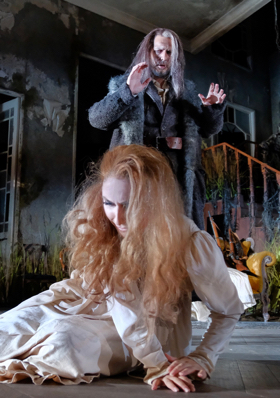
Salome Jiria as the Lady of the Lake
All photos courtesy of the Rossini Opera Festival, Pesaro
Each August the bleak and leaky, 12,000 seat Arena Adriatica (home of the famed Pesaro basketball team) magically transforms itself into an improvised opera house that boasts the ultimate in opera chic — exemplary Rossini production standards for its now twelve hundred seats.
La donna del lago is from Naples’ Teatro San Carlo in 1819. Rossini masterpieces abound in these years, though they were not always appreciated by the fickle Neapolitan audience who in 1818 had wildly applauded Spontini’s La Vestale and decried Rossini’s Ermione. Consequently in 1819 Spontini had a contract for two new operas at San Carlo and Rossini had none! Circumstances forced Spontini to back out, but Rossini, always ready, took over the contract.
The novels of Sir Walter Scott were in the air in French translation. It is fairly likely that La donna del lago was originally intended for Spontini. But Rossini gets the credit of creating the first Italian opera based on Scott’s wildly popular, colorful novels that gave first definition to European theatrical Romanticism!
The now infamous Venetian stage director Damiano Michieletto staged La donna del lago just now in Pesaro. Last year at Covent Garden Michieletto had Jemmy, William Tell’s son compare his father Guillaume Tell with a comic book William Tell brought alive, played by an actor who remained on stage for the duration of that opera. In recent years in Pesaro Michieletto has turned La scala di seta into pure run-of-the-mill TV sit-com and Sigismondo into a classic made-for-TV horror movie (low budget, low taste).
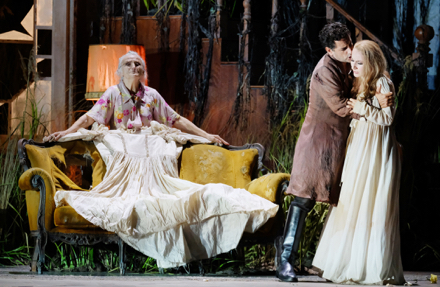
Elena double, Juan Diego Flórez as Uberto, Salome Jicia as Elena
It was a surprise to see Michieletto back on the Pesaro directorial roster but it was of no surprise to learn that La donna del lago had become two old folks in a probably-mid-twentieth century British Isles-someplace parlor having a spat about the wife’s infatuation with a black and white photo of the king. The couple became a duplicate, aged Elena (the lady of the lake) and Malcom, a duplicate of the opera's pants role rebel but who (the double) was a real male. The doubles shadowed their Scottian counterparts the entire evening. Not to give it all away but towards the end the old woman falls into the lake (real water for this dramatic backflop) and Elena finds herself back in the drawing room of the opening scene. She transforms herself into the old woman while singing her final spectacular and breathtakingly beautiful “Tanti affetti in tal momento” that ends the show in the old folk’s reconciliation.
Elena was sung by Pesaro-finished (the festival's Accademia Rossiniana) ingenue Rossini diva, Georgian soprano Salome Jicia who more than held her own amid stiff competition — Jean Diego Flórez as King James V who liked to wander the Scottish countryside incognito and — according to Sir Walter Scott — fall in love with beautiful young women, and American tenorino cum coglioni Michael Spyres as Rodrigo, Malcom’s brash competition (lots of leaps to forte C’s and D’s).
Malcom was sung by Armenian mezzo soprano/contralto Varduhi Abrahamyan, an accomplished Carmen as well as bel canto singer who is well able to cross dress when called upon (last spring’s Ascanio in Benvenuto Cellini in Rome as example). Her first act aria “Elena! oh tu, che chiamo” earned the huge Pesaro ovation — uniique to Pesaro these ovations extend multiple minutes and are homage to a singer, to Rossini and to simply being a Rossini afecionado in Pesaro. This fine artist is of ample voice and excellent technique, a very welcome newcomer to the limited ranks of Rossini pants role interpreters.
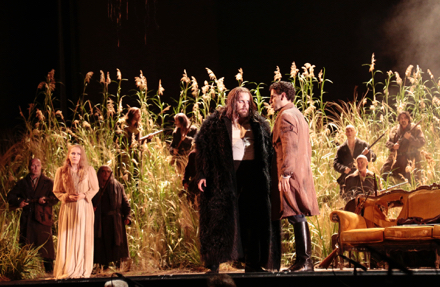
Salome Jicia as Elena, Michael Spyres as Rodrigo, Juan Diego Flórez as James V / Uberto
Among the great moments of the evening was the second act scena in which the incognito James V reveals himself to Rodrigo and then kills him in a duel but not before the two tenorinos deliver the splendid duet “Vendetta! accendi mi di rabbia il seno” before which the lady of the lake suggests they kill her instead of themselves even though she loves neither one of them. In these moments it is clear that Juan Diego Flores has no equal in finding the joy of singing (this the genius of Rossini) and Michael Spyres is among the few who truly deliver the excitement of a Rossini voice.
The biggest of all the ovations was however reserved for Pesaro conductor Michele Mariotti, now an international star, who has naturally absorbed the Rossinian esprit, and like no other is able to communicate it to his orchestra in the pit, here the Orchestra of Bologna’s Teatro Comunale and to the singers on the stage with whom you feel and can actually see the joining of voice to the sentient Rossini orchestra. On this occasion Mo. Mariotti’s tempos seemed more deliberate than sweeping, possibly in sympathy to Mr. Michieletto’s very precise storytelling, and possibly in response to Rossini’s newly found Romantic colors — the specific horn calls and the momentary crowning of intense moments with sharp flute tones, and the always important clarinet in introduction and duet with the stage. Strangely this evening did not come across as the great Rossini.
Set design by Paolo Fantin was indeed splendid, superimposing the drawing room on the swampy lake shore, spectacularly lighted by Alessandro Carletti. Said and done the self-consciously chic Michieletto staging did indeed enhance the evening, the doubling of Elena and Malcolm adding a dramatic depth and possibly too comprehensible human emotion to this exotic tale of long ago and far away. Would that it not have been so prosaic.
Cast and production
James V / Uberto: Juan Diego Flórez; Duglas: Marko Mimica; Rodrigo: Michael Spyres; Elena: Salome Jicia; Malcom: Varduhi Abrahamyan; Albina: Ruth Iniesta; Serano / Bertram: Francisco Brito. Elena (silent); Giusi Merli, Malcom )silent) Alessandro Baldinotti. Orchestra e Coro del Teatro Comunale di Bologna. Conductor: Michele Mariotti; Metteur en scène: Damiano Michieletto; Set design: Paolo Fantin; Costumes: Klaus Bruns; Lighting: Alessandro Carletti. Arena Adriatica, Pesaro, Italy, August 11, 2016.
Manon Lescaut at the Salzburg Festival
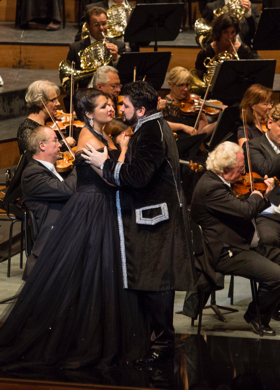
Anna Netrebko as Manon, Yusif Eyvazov as Des Grieux
[All photos copyright Marco Borrelli courtesy of the Salzburg Festival]
A staged piano recital and an opera as a concert. Pianist András Schiff accompanied the Salzburg Marionette Theater at the Mozarteum Grosser Saal and Anna Netrebko sang Manon Lescaut at the Grosses Festspielhaus.
Opera in concert is a tradition at the Salzburg Festival. The format of such endeavors is however puzzling, at least based on the concert performances (three) of Manon Lescaut in early August. Basic expectations of such events might assume that musical values would be paramount since there would not be the distraction of staging. This was not the case of this Manon Lescaut.
Instead it was a showcase for Anna Netrebko, and that alone of course validates the programming. However such a centerpiece could surely give incentive to the festival to build a cast around such vocal splendor that might strive toward some degree of high, finished art.
The assembled cast included Algerian born, Moscow trained, Franco-Corelli-finished tenor Yusif Eyvazov as Des Grieux (who happens to be Mme. Netrebko’s husband), and Mexican baritone Armando Piña as Manon’s brother Lescaut. Piña, a fine young singer, is a Resident Artist, i.e. student at Philadelphia’s prestigious finishing school for opera singers, the Academy of Vocal Arts. Geronte was sung by 66 year-old bass-baritone Carlos Chausson who has made a distinguished career singing the repertory’s well-known buffo roles.
Rather than the singers sitting in chairs with music stands and scores while waiting their turn to sing the Salzburg concert format elicits actual staging, if minimal. Singers entered and exited much as staging instruction in the score might tell them. Roles were acted, singers moved as if staged. It did not arrive at what the French call a mise en espace (there was no lighting or costumes) nor was it a concert.
The staging, probably improvised by the singers, was on the stage apron therefore the conductor, Marco Armiliato and the Munich Rundfunkorchester were behind the singers. Mo. Armiliato had no visual contact with the singers, nor did the singers ever communicate with him. Apparently at ease with standard Manon Lescaut routine this maestro never felt the need even to look over his shoulder.
Forty-five year old Anna Netrebko, in good physical and perfect vocal shape, appeared in a huge black gown discretely studded with black sequins, i.e. concert dress that made her entrances and a few hurried exits cumbersome indeed. Mr. Eyvazov wore some sort of ethnic coat of maybe Slavic, maybe Turkic inspiration that indeed set him apart, the balance of the performers wore formal concert dress.
Portraying a teenage girl was of course out of the question for Mme. Netrebko under the circumstances, and she did not really shine as an artist until Manon’s death. It was spellbinding. Though of course she was a star the entire evening and that is why we were there. Mr. Eyvazoy delivered the first act deploying the tenorial vocal and histrionic attitudes that are long out of fashion, the stuff of caricature. He rose valiantly and with a degree of artistic honesty to the occasion of Manon’s deportation — well rewarded by applause. Without proper costuming and wig Mr. Piña’s well coached singing disappeared into little more than a reading of the role to support the exploits of the tenor and soprano. In the midst of these two powerful, youthful male voices Mr. Chausson’s performance seemed small indeed. The only performance of the evening that seemed appropriate for what a Salzburg Festival concert opera might be was that of the Dance Master, fancily performed by young German tenor Patrick Vogel.
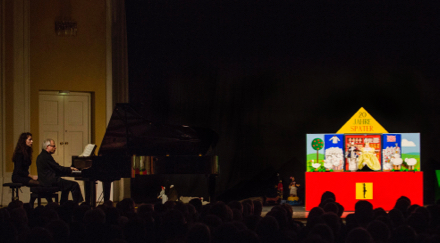
András Schiff and page turner with set for Children's Corner puppet ballet
Hungarian pianist András Schiff, one of the world’s established concert artists, slickly played Robert Schumann’s youthful Papillons (Op. 2) of about 16 minute duration, and then played Claude Debussy’s Children’s Corner, a suite of about 17 minutes duration that Debussy composed for a piano teaching method book. For this piece Mr. Schiff used the music. Both pieces are well within the reach of advanced piano students. Surely I am not alone in wishing Mr. Schiff’s program had been from the major, virtuoso repertory.
The piano was then pushed to one side exposing puppet show contraptions. Mr. Schiff returned to perform the same two pieces, accompanying a mise en scène for each, executed by four puppeteers operating a variety of puppets.
For the Schumann’s Papillons there were characters of the novel Flegeljahre (Adolescent Years) by a writer named “Jean-Paul,” this novel the inspiration for these 12 brief pieces. Essentially the well-organized Walt wins the girl, having competed with his impetuous brother Vult for her attentions. This mise en scène was imagined by puppeteer Thomas Reichert. It was premiered in 2014 in Calgary, Canada.
Debussy amplified his Children’s Corner suite for piano into a full-scale puppet ballet for children with orchestra, La Boite à joujoux. The ballet was recast in 2010 in Ittigen, Switzerland by puppeteer Hinrich Horstkotte to fit Debussy’s original Children’s Corner for piano. The characters are Pulcinella, Golliwog — a late nineteenth century black faced puppet, evidently not a politically incorrect issue in Austria — for Debussy’s famed Golliwog’s Cakewalk, and a Soldier, plus lots of mechanical intervention of the toy box set contraption and dramatic participation by the four, obviously accomplished, black dressed puppeteers.
The evening was appreciated by the audience who apparently did not care that it was gratuitous use of the talents of Andràs Schiff.
Die Liebe der Danae at the Aix Festival
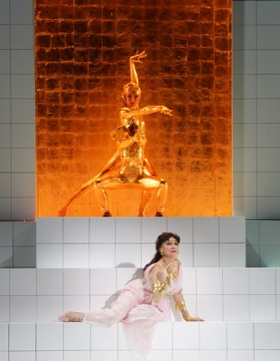
Krassimira Stoyanova as Danae
All photos courtesy of the Salzburger Festspiele, © Festspiele / Forster
The tale of a Syrian donkey driver. And, yes, the donkey stole the show! The competition was intense — the Vienna Philharmonic and the Grosses Festspielhaus in full production regalia for starters.
The dress rehearsal in Salzburg, August 16, 1944, of Richard Strauss' penultimate opera was its premiere and only performance until the 1952 Salzburg Festival (all Third Reich theaters had been closed in late July, 1944). The Covent Garden premiere was in 1953, the Santa Fe Opera American premiere in 1982. In recent years the opera, when attempted, is usually rendered in concert rather than staged.
Thus any new production of Die Liebe der Danae is of great interest — even Salzburg has given it only one other production in the past 65 years! This new production by Latvian stage director Alvis Hermanis imbues the opera with a requisite splendor and conceptual depth that fully complements the surpassing complexities and difficulties of the Strauss score.
Danae, daughter of bankrupt Pollux, has dreamt of gold. If Midas will marry Danae the household will be saved. Three and one half hours later Midas has lost his touch but gained a contented Danae after a monumental tussle with Jupiter who has paid off Pollux's creditors and finally understands that love is more powerful than riches.
All this was actually Strauss' formidable librettist Von Hofmannstahl's idea back in the 1920's who dubbed it a Marriage of Convenience. Not at all in the Roman tradition of Italian comedy, in the spirit of his times Strauss liked to think of his opera as the union of German music and the Greek soul.

The Grosses Festspielhaus stage with Die Liebe der Danae, Alvis Hermanis designer
Director Hermanis worked in bold strokes. The hugely wide stage of the Grosses Festspielhaus was an all white wall and floor, a pyramid of white boxes mounting to a shuttered oblong box. Making the Turkish setting of the Midas myth his backdrop Hermanis mined the riches of Turkish turbans and Oriental carpets. He included Hollywood musicals of the 1930's (Busby Berkeley's Gold Diggers comes to mind), and Islam to boot (the final scene is Midas' harem — 12 women in white burqa contentedly weaving rugs).
Jupiter's harem were 12 Las Vegas style dancers in gold body stockings tirelessly executing sophisticated geometric routines. Hermanis well exploited the talents of Russian choreographer Alla Sigalova who among other jobs is the choreographer for the Russian version of Dancing with the Stars!
Like the Strauss score the staging was spectacular above all else.
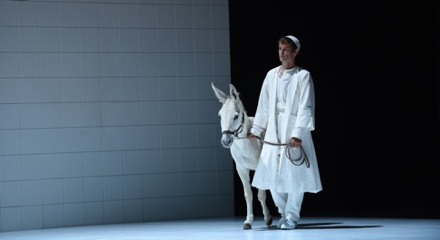
The donkey led by its trainer
And the coup de théâtre — the mule of the newly impoverished Midas — a real, alive white donkey led across the elevated open box in the now pristine whiteness of the entire stage! Like Strauss' "love" it was at last something real in this world of riches. It was an almost shocking moment, even moving in the context of the overripe world of Straussian post Romanticism.
Conductor Franz Welser-Möst musically commanded all this most actively plus directing the wondrous splendors of Straussian forces of the Vienna Philharmonic. The grand conductorial traditions of this Von Karajan-designed theater were firmly in place.
Die Liebe der Danae is ultimate Strauss demanding ultimate virtuosity and bravura on all levels, most certainly from the singers. Bulgarian soprano Krassimira Stoyanova negotiated the unrelenting high tessatura of Danae with ease in unflagging golden tone. German tenor Gerhard Siegel, well-known as a Wagner Mime, fulfilled the character demands of the Midas role without fully finding its romantic color, and managed its high tessatura with some difficulties. Polish bass baritone Tomasz Konieczny found both the brashness and the humanity of Jupiter, and delivered his final scene of blessing with utmost elegance. Austrian tenor Norbert Ernst portrayed a dynamic Mercury and Austrian tenor Wolfgang Ablinger-Sperrhacke made Pollux desperate indeed.
Unusual for Strauss were the ensemble scenes — complex machinations of vocal lines managed by a quartet of Pollux' nephews, and a quartet of their wives who are also former conquests of Jupiter. Unusual also was the duet of Danae and her maid, sung by Austrian soprano Regine Hangler, discussing Danaë's dream, the voices weaving equally in and out of the upper ranges.
The star of the show (second performance) was however the donkey who marched center stage and refused to go further. It turned its head to stare directly at the 2400 of us staring back. As any star might it very reluctantly left the stage. Note that its third act entrance was very disciplined.
Cast and production
Danae: Krassimira Stoyanova; Jupiter: Tomasz Konieczny; Merkur: Norbert Ernst; Pollux: Wolfgang Ablinger-Sperrhacke; Xanthe: Regine Hangler; Midas/Chrysopher: Gerhard Siegel; Four Nephews: Pavel Kolgatin, Andi Früh, Ryan Speedo Green, Jongmin Park: Semele: Maria Celeng; Europa: Olga Bezsmertna; Alkmene: Michaela Selinger; Leda: Jennifer Johnston. Konzertvereinigung Wiener Staatsopernchor; WienerPhilharmoniker. Conductor: Franz Welser-Möst; Stage Direction and Set Design: Alvis Hermanis; Costumes: Juozas Statkevičius; Lights: Gleb Filshtinsky; Video: Ineta Sipunova; Choreography: Alla Sigalova. Grosses Festspielhaus, Salzburg, August 5, 2016.
Cosi fan tutte at the Salzburg Festival
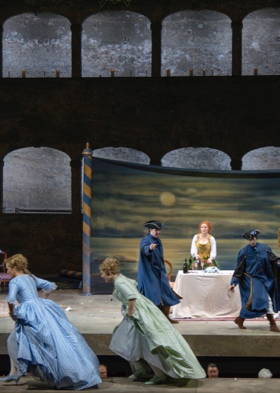
Da Ponte's four young lovers in the Riding School
All photos by Monica Rittershaus, courtesy of the Salzburger Festspiele
This Cosi fan tutte concludes the Salzburg Festival's current Mozart / DaPonte cycle staged by Sven-Eric Bechtolf, the festival's head of artistic planning.
Unlike Le nozze di Figaro (2014) and Don Giovanni (2015) both staged by Mr. Bechtolf in the Haus für Mozart theater (both to be revived later in the month) Cosi is staged in the Felsenreitschule — the old riding school with galleries carved into Salzburg's famous city center rock.
Thus director Bechtolf's staging is site specific, utilizing the 50 or so meter wide (165 feet or more), three tiered carved into the stone galleries as a living backdrop (singers and supers move amongst the tiers) the equally wide stage platform as a field for a sort of improvised street theater style staging. During the overture a number of black cloaked, masked sort of ninjas use chloroform saturated handkerchiefs to lay out Fiordilig and Dorabella (left supine on the stage) and Despina (carted off on a wheelbarrow).
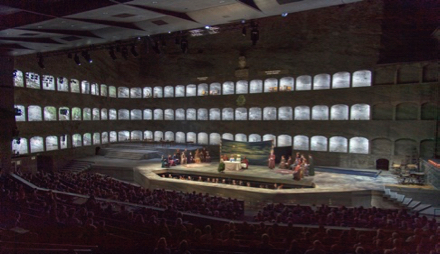
The Felsenreitschule galleries and Cosi stage platform
The knocked out sisters are draped onto a sofa (that needless to say will seat four at strategic moments), Don Alfonso, Ferrando and Guglielmo make their wager, The ninjas retreat to some sort of library way over on stage right. And the geometry (symmetries of four or six points) begins, and so far so good.
A pit has been cut into the stage platform in which the Mozarteum Orchester Salzburg was seated that provided polished (what else) accompaniment for the next four hours, its winds in pure sounds that evoked an orchestral utopia from another time within the splendid acoustic of this architectural artifact.
The conductor for the Cosi in this cycle is Ottavio Dantone (Dan Ettinger conducts Le nozze, Alain Altinoglu conducts the Giovanni). Mo. Dantone, a gifted Italian early music specialist, provided measured tempos throughout the evening allowing the Da Ponte text to be deliberately stated, tempos that were musical rather than dramatic. It was a lyric evening indeed with nothing musically extraordinary expected of the artists beyond fine singing.
The sisters Fiordiligi and Dorabella, sung by German soprano Julia Kleiter and American mezzo soprano Angela Brower respectively, were identically costumed in period style (only a slight variation of pastel hue) and vocally and musically perfectly matched in their pure rather than rich tones. Fernando, Swiss tenor Mauro Peter (a noted lieder singer) who with Guglielmo, Italian bass baritone Alessio Arduini, did their best to execute the fairly tame antics imposed on the young soldiers by director Bechtoff. Interestingly both Don Alfonso, sung by German bass-baritone Michael Volle and Despina, sung by Swiss soprano Martina Janková were aggressively presented, irritants to the protagonists rather than the amused instigators of Da Ponte's dirty trick.
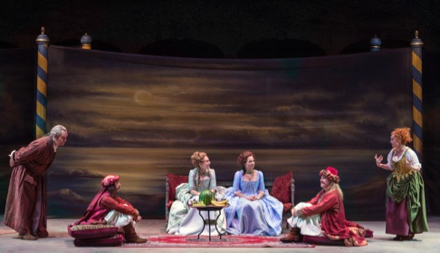
Left to right: Don Alfonso, Guglielmo, Dorabella, Fiordiligi, Ferrando, Despina
Director Bechtolf's humor is low key in simple, momentary situational comedic skits that precluded a larger dramatic focus. Notably "Come scoglio" — Fiordiligi holds the entire cast at sword point for the duration of the aria, some traversing the runway that created a fore-stage in front of the pit (and therefore illustrating a theatrical chic fourth wall). On the other hand the trio "Soave sia il vento" was sung entirely presentational, the three singers seated unmoving on the sofa.
Musically the high point of the evening was the quartet of leave taking, the sisters bidding farewell to their soldier lovers. It was delivered with the musical precision and mannered shaping of exquisite string quartet playing.
Our expectations for an exceptional evening were high indeed.
The evening did not sustain this level of studied musical and theatrical interest. In the best of times the second act of Cosi challenges the stamina of is audience. Here the alternation of comedic moments with presentational scenes of serious feeling lost momentum. The emotional scope of the singers proved limited, and the directorial attempt to create interest by referencing the geographical extremes of the stage platform and by populating the back wall galleries succeeded only in pulling focus from the tense Fiordiligi Ferrando situation center stage.
Finally this difficult dramaturgical problem was more or less dismissed both musically and theatrically. At the end the four protagonists dashed individually to the four separate corners of the platform, the tyranny of all this theatrical geometry destroyed. Or something.
Production details
Chorus: Concert Association of the Vienna State Opera Chorus; Orchestra: Salzburg Mozarteum Orchestra. Conductor: Ottavio Dantone; Stage direction and set design: Sven-Eric Bechtolf; Costumes: Mark Bouman; Lighting: Friedrich Rom. Felsenreitschule, Salzburg, August 2, 2016.
The Avenging Angel at the Salzburg Festival
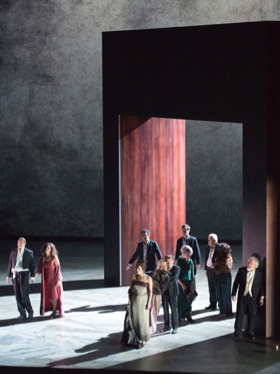
At left Amanda Echalaz as Lucia de Nobile and Charles Workman as Edmundo de Nobile
with guests emerging from self imposed captivity.
All photos courtesy of the Salzburger Festspiele, copyright Ruth Walz
Zeitgeist or what? What Luis Bunuel's 1962 Franco era film El àngel exterminador may mean to composer Thomas Adès' 2016 opera The Exterminating Angel.
The opera is the film recast for Salzburg, Covent Garden and the Met by Adès and British stage director Tom Cairns. For Buñuel the film was gentle if macabre, humorous if macabre condemnation of Spain's Fascist bourgeoisie.
Re-worked in Salzburg the exterminating angel (an invisible presence) presides at a dinner party after an opera where its conductor's wife amuses with a (brief) piano recital and its diva is begged to sing a song by Adès. By mutual consent and compulsion no one can leave the party — for days, then weeks. Feelings fray, living conditions deteriorate. Finally the guests agree the only possible exit is to sacrifice the host. The diva has the revelation that they all now are exactly where they initially were. They leave.
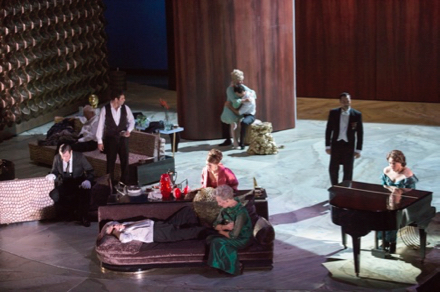
The piano recital
And they will be back. Like, just like the Salzburg audience. Year after year.
Adès opera is bourgeois, hook, line and sinker. Rich, beautiful music requiring everything money can buy, i.e. triple winds, huge percussion battery. Difficult music requiring extended rehearsals for orchestra and for twenty-two solo voices plus chorus and dancers. It is an undertaking only possible at institutions lavishly supported by the haute bourgeoisie. The three mentioned above are possibly the only such in existence. The ironies are blatant.
Adès inspiration is obviously complex, and finally he surely is teasing himself. And delighting in composing music that has the depth and breadth to encompass a quarrel about the size of spoon needed to stir coffee and the lengthy death of an elderly guest and then an intense love death, not to mention slaughtering a couple of lambs to avoid starvation, the cuisson of which is a lengthy discussion. The piano becomes more and more distressed, a cello is smashed, incest revealed.
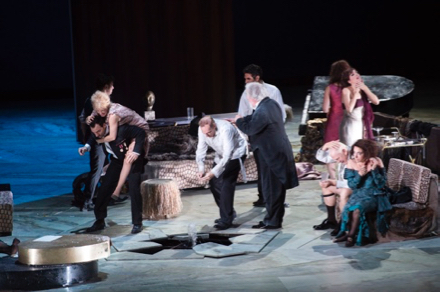
The excavation to access water
It is rich, beautiful music that can say anything, the sublime merged with the twisted, the simple with the complex. Music of Wagnerian scope and Brittenesque precision, of Buñuelian cruelty and Aristophanesque satire. It is pure Thomas Adès.
Adès somehow creates natural sounding vocal lines in surreal intervals and rhythms that explore surreal vocal ranges. The always forte orchestral score exposes extreme unidentifiable harmonies that, like Messiaen, grandly pass over or sometimes converge on beautifully inverted triads. Orchestral climaxes are sometimes hugely violent, explosive if impotent energy released. It is gratifying, very pleasurable music in service to supercilious philosophy.
As expected in Salzburg casting was exemplary, of particular note the huge vocal presence of the dinner's hostess Lucis de Nobile sung by South African soprano Amanda Echalaz, plus the freakishly high voice of American soprano Audrey Luna who squeals and squeaks the role of the opera diva Leticia. Swedish mezzo-soprano Anne Sofie von Otter sang Leonora's moving delirium and lovely if occasionally putrid prayer to the Virgin Mary. British tenor Ed Lyon and British soprano Sophie Bevan grandly intoned the love death.
The staging conceived by director Tom Cairns was adequate but not complimentary to the score, the bows (no solo bows) were excessively choreographed.
Cast and production
Performers: Amanda Echalaz, Audrey Luna, Anne Sofie von Otter, Sally Matthews, Christine Rice, Sophie Bevan, Charles Workman, Frédéric Antoun, David Adam Moore, Iestyn Davies, Ed Lyon, Sten Byriel, Thomas Allen, John Tomlinson, Morgan Moody, John Irvin, Franz Gürtelschmied, Rafael Fingerlos, Frances Pappas, Anna Maria Dur, Cheyne Davidson, Leonhard Radauer, Elias Karl. Sfalzburger Bachchor, ORF Radio-Symphonieorchester Wien. Conductor: Thomas Adès; Stage Director: Tom Cairns; Sets and Costumes: Hildegard Bechtler; Lighting: Jon Clark. Haus für Mozart, Salzburg, August 1, 2016.
Il trionfo del tempo e del disinganno at the Aix Festival
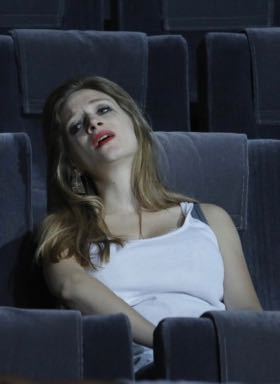
Sabine Devieilhe as Bellezza
All photos by Pascal Victor / Artcomart courtesy of the Aix Festival.
The tense, three hour knock-down-drag-out seduction of Beauty by Pleasure consumed our souls in this triumphal evening. Forget Time and Disillusion as destructors, they were the very constructors of the beauty and pleasure found in this miniature oratorio.
The Triumph of Time and Disillusion was composed in 1707 in Rome by the 22 year-old German composer Georg Friedrich Händel. Opera was banned in Rome, the pontifical city firmly in the grips of the artistic terrors of the Counter Reformation, i.e. opera was banned. So Rome, never left wanting for the finer things, was reduced to bootleg opera, called oratorio. Some of its librettos were supplied by Cardinal Benedetto Pamphili (quite a few of his librettos not surprisingly are about Mary Magdalene). Note that Alessandro Scarlatti set the Cardinal’s The Triumph of Truth and Grace a few years before Händel tackled that of Time and Disillusion.
Just like opera seria, distraught with the terrors of its heroes and heroines vacillating between inexorable forces (love and duty mostly), Roman oratorio provided polar opposing forces (pleasure versus truth as example) with no possible compromise. In the early 18th century resolution could only be death in opera seria while in oratorio the resolution was eternal life. Once the Counter Reformation dissipated opera seria did begin finding happy endings here on earth.
In the program booklet Polish theater director Krzysztof Warlikowski expresses his outrage at the dogmatism of this libretto (Time and Disillusion [essentially Truth] banish Pleasure while Beauty repents). With the orchestral overture stage director Warlikowski concocted on a full stage video scrim (screen) the sordid world of drugged youth’s indiscriminate sexual appetites. On stage for the next three hours a beautiful young woman struggles to emerge from this world. Bludgeoned by Truth she gives in to repentance. But, like opera seria where there is no eternity we watch her symbolically die. It is spiritual death at the hands of dogmatism.
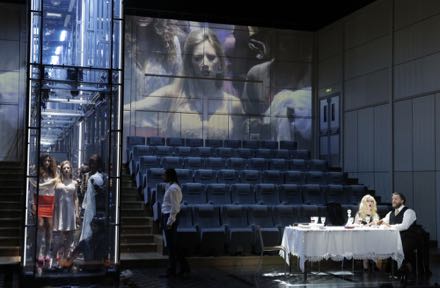
Beauty (in box), Pleasure (in shadow), Truth and Time (at table)
Watching this were 1500 or so mostly Christian souls seated in Aix's bishops' palace (the Archevêché) facing the stage that was in fact a theater staring directly back at us, i.e. mirroring us. From time to time a bevy of young women in lurid party attire emerged from a transparent box (surely an abstracted disco-tech) to file into these stage seats to watch with us the battle taking place on the stage apron.
Like Warlikowski the young Handel was entranced by this battle and thus gave it the most beautiful music ever composed for the human voice. Time stood still while we reveled in beauty. Truth and pleasure fused into that sublime moment that was only dreamt of on the stage by Beauty. It was the triumph of art.
Director Warlikowski did take a moment to remind us that all of this artistic grandiosity is a bit silly. This was the intermission feature. Once again the full stage scrim fell and we watched a video of a most worldly man in supercilious discussion with a most wide-eyed young woman about ghosts (this video a comment on Pleasure’s just uttered fear that Beauty would believe in the purely imaginary heroes of truth, i.e. ghosts). [No doubt the actors were well known to the largely French audience, I had no clue].
Once again in this summer’s Festival, Aix has triumphed in its casting. Beauty was young French soprano Sabine Devielhe of pristine physical beauty, her face marred by clown face tears. She possesses a voice of riveting purity, platinum colored (i.e. an extravagant silver), a range that extending well above the staff upon occasion. Her final aria of repentance was spellbinding (as were all of her arias) in the splendid bleakness of its despair.
Matching in effect was a sassy Pleasure, sung by Argentine counter tenor soprano Franco Fagioli who as well soared above the staff in his final aria of banishment. Leaning against the transparent box he sank to the floor delivering wrenching tones of tragic loss, descending well below middle “C” into tenor range though never losing counter tenor color. The brash young Handel demanded the ultimate from his opera seria singers, the high Baroque in full force. This Trionfo's arias exploited the extremes of range and demands on technique that are seldom encountered in his London operas.
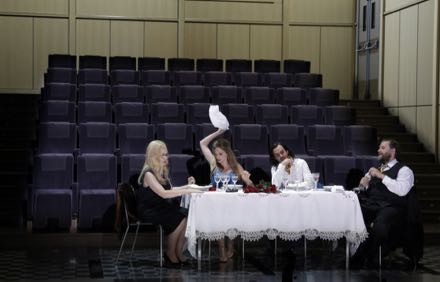
Sara Mingardo, Sabine Devielhe, Franco Fagioli, Michael Spires
American tenor Michael Spires showed off his resplendent tenorino as Time, bringing throaty authority to his tone, soaring to threatening insistence in his high “D”’s. He was dramatically matched by the powerful voice of Italian contralto Sara Mingardo who brought a blatant irony of false authority to Disinganno (Truth), the attribute that so intrigued stage director Warlikowski.
All four singers converged in the magnificent quartet early in the second act that were it more widely known by the opera public would be known as one of the great monuments of operatic quartets, rivaling, even surpassing the rank and fame of the Rigoletto quartet.
Of equal stardom in this extraordinary evening was the French early music orchestra Le Concert d’Astrée and particularly its founder and leader Emanuelle Haïm whose sculpted conducting forcefully and fully rendered the muscular, quite architectural components of Handel’s Baroque orchestral score. Of deep complicity were the several duets that violinist David Plantier, cellist Felix Knecht and oboist Patrick Beaugiraud effected with the singers. The large, un-conducted continuo offered kaleidoscopic colors to the recitatives and scenes, recalling somewhat the concept of Monteverdian and Gluckian accompanied speech.
See for yourself — Il Trionfo del Tempo e del Disinganno on www.culturebox.fr.
Cast and ProductionBellezza: Sabine Devieilhe; Piacere: Franco Fagioli; Disinganno: Sara Mingardo; Tempo: Michael Spyres. Orchestra: Le Concert d’Astrée. Conductor: Emmanuelle Haïm; Mise en scène: Krzysztof Warlikowski; Sets and costumes: Malgorzata Szczesniak; Lighting: Felice Ross; Chorégraphie: Claude Bardouil; Vidéo: Denis Guéguin. Théâtre d’Archevêché, Aix-en-Provence, July 6, 2016)
The Verdi Requiem at the Chorégies d'Orange
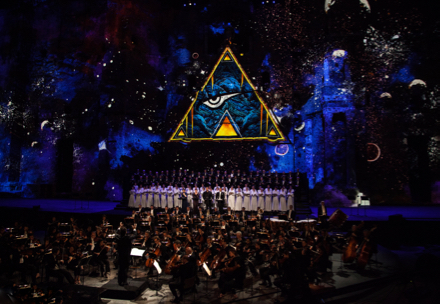
The Eye of Providence
Orchestre National du Capitole de Toulouse, soloists and the Orfeón Donostiarra
Photo copyright Kris Picart, courtesy of the Chorégies d'Orange
On July 16 a magnificent theater of a dead civilization, the Théâtre Antique in Orange breathed death’s prayer, the requiem mass. It is Verdi’s most terrifying portrayal of any of his tortured souls. In this Orange requiem we were these souls, as indeed was all humanity.
The acoustic of this massive theater is unforgiving, every voice of the awesome Toulouse Orchestra laid bare, the three flutes and two human voices of the Agnus Dei cutting into the hearts of the many thousands of spectators, the 60 centimeter high hammer stokes of the tympani mallets creating the deliberated havoc of an angry God, the huge bass drum thunderclaps burying us in eternal damnation.
The final prayer, the Libera Me, is intoned by the soul graveside who knows its guilt and begs the mercy of God for its salvation. It is delivered by the purist of voices, the soprano whose range belies the innocence of a child, whose warmth encompasses the heart of a woman, and whose primal ancestor was the Eve of original sin.
Russian conductor Tugan Sokhiev with his splendid players, the Orchestre National du Capitole de Toulouse sought universal humanity and not the particular sinner. The operatic drama of the individual soul was drowned by the hugeness of the theater, the one hundred five voices of the Orfeón Donostiarra from San Sebastion (Spain) and colossal, non-relevant, confusing and quite colorful iconography of the digital game-like images that were projected onto the huge scaenae frons of the Théâtre Antique. [This back wall is 61 meters wide by 31 meters high — 200 by 120 feet!]
Cast and Production
Soprano: Erika Grimaldi; Mezzo: Ekaterina Gubanova; Tenor: Joseph Calteja; Bass: Vitalij Kowaljow; Chorus: Orfeón Donostiarra. Orchestre National du Capitole de Toulouse, Conductor: Tugan Sokhiev. Projections: Philippe Druillet. Thèâtre Antique, Orange, France, July 16, 2016.
Kalila wa Dimna at the Aix Festival
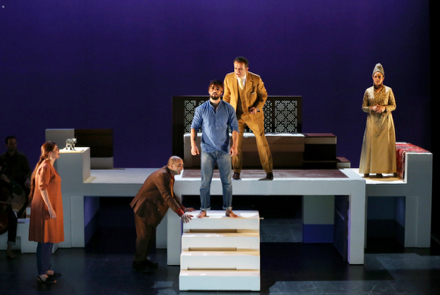
left to right: Kalîla (sister), Dinma (brother), the poet, the king, the queen mother
photo by Patrick Berger / ArtcomArt
In the late afternoon of July 17 the Aix Festival gave its final performance of a new opera entitled Kalîla wa Dimna (the names of a brother and sister), based on a Persian fable famous for its transcription by Ibn al-Muqaffa’ (executed in 759 AD) into narrative Arabic — a lion, jackal and raven trick a camel into sacrificing itself. In the opera a king is tricked into executing a poet whose song then posthumously reconciles populace with power.
French/Palestinian composer Moneim Adwan combined elements of Arabic and Indian musical languages to create the 24 scenes that meticulously spell out deception and revelation. Five singers and five instrumentalists, all born and trained in the classical musical arts of north Africa or the Middle East, discovered many musical moods in richly melismatic singing and what seemed to be virtuoso levels of plucking, bowing, striking, and blowing mostly arabic instruments.
With lengthy narrations and perfunctory staging it was a theater piece with inserted songs more than an opera, and the heavily instructive intention of the story gave it the trappings of dogmatic oratorio. Most striking was the absence of relevance of its message to the Western world, and certainly its absence of relevance to the Arab world, civilizations shaken to their foundations in this twenty-first century. This 68th Aix Festival in particular was laden with social, intellectual and artistic complexities in which this opera was an island of innocence, an interesting and enlightening, too lengthy excursion into an alternative musical language.
Cast and Production
Kalîla: Ranine Chaar; Dimna: Moneim Adwan; Le Roi: Mohamed Jebali; La Mère du roi: Reem Talhami; Chatraba: Jean Chahid. Music Director: Zied Zouari; Mise en scène: Olivier Letellier; Scenery Philippe Casaban and Eric Charbeau; Costumes: Nathalie Prats; Lighting: Sébastion Revel. Théâtre du Jeu de Paume, Aix-en-Provence, July 17, 2016.
Oedipus Rex and Symphony of Psalms at the Aix Festival
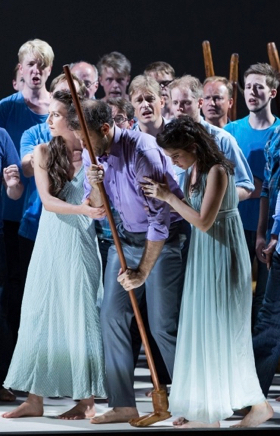
Joseph Kaiser as Oedipus
All photos by Vincent Beaume, courtesy of the Aix Festival.
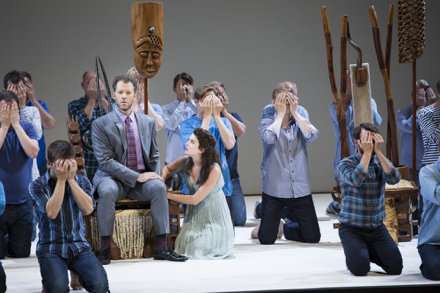
Oedipus and Antigone with singers of the Orphei Drängar
The afternoon’s world of Arabic innocence, its innocuous play on power and pity gave way in the evening to the shattering intellectual proportions of an individual soul — the powerful Oedipus. The Grand Théâtre de Provence hosted Stravinsky’s opera-oratorio Oedipus Rex, the king of Thebes who confronts his blindness to know what he could not know, the savior of Thebes who must confess his sacrileges in searing melismas and become an object of pity.
Shattering as well was the volume of sound pouring forth from the pit, Esa-Pekke Salonen’s magnificent Philharmonia Orchestra. The 75 voices of Orphei Drängar, the famed all male choir from Uppsula, Sweden shouted the glory of Oedipus’ power and their anger at his betrayal at unprecedented acoustic levels, and finally whispered their pity for their errant king.
Peter Sellars, the sixty-year-old wunderkind genius of late twentieth century opera ignored the text Stravinsky provided for narrator, making his own narrative adaptation for female voice of the Sophocles tragedy that would continue into Stravinsky’s Symphony of Psalms to complete the evening following an intermission.
This choral symphony was intoned by some seventy Christian singers comprised of members of Orphei Drängar, plus Sweden’s Gustaf Sjökvist Chamber Choir and its Sofia Vokalensemble. The blinded Oedipus, here bravely acted by the now silenced, splendid Canadian tenor Joseph Kaiser was led onto the stage by Oedipus’ daughter Antigone, the narrator for both pieces, and by her dancer sister Ismene (a Peter Sellars addition to the mythic forces at play in the Oedipus Rex).
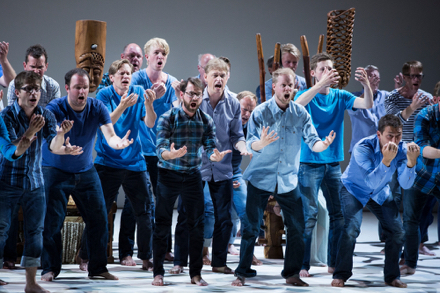
Singers of the Orphei Drängar
The Salonen pit begged redemption and peace for the soul of Oedipus in thundering exclamations as the lines of singers moved their arms in synchronized motions indicating abstracted, distilled universal participation in this neo-Classical musical world, Oedipus was led across the stage to be placed in a square of light (outlined by four neon tubes) while the chorus shouted praises of the Lord (Psalm 150). In the midst of this celebration Oedipus walked off stage left. The final image of this Symphony of Psalms was Antigone and Ismene embracing downstage right, each comforting the other.
In the aftermath of the tragedy in Nice each of us in Aix and Orange will have seen and felt these magnificent works of art in our own way. These were my perceptions.
Cast and Production
Oedipus Rex / Symphony of Psalms Oedipus: Joseph Kaiser; Jocasta: Violeta Urmana; Créon / Tirésias / Messanger: Sir Willard White; Shepherd: Joshua Stewart; Antigone (spoken): Pauline Cheviller; Ismene (dancer): Laurel Jenkins. Philharmonia Orchestra. Conductor: Esa-Pekka Salonen; Mise en scène: Peter Sellars. Grand Théâtre de Provence, July 17, 2016.
Pelleas et Melisande at the Aix Festival
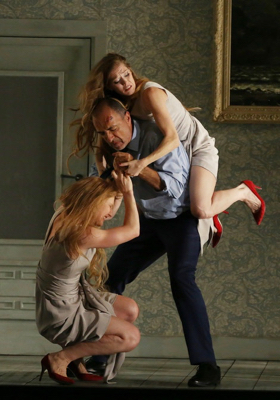
Barbara Hannigan as Melisande, Laurent Naouri as Golaud, with Melisande double
All photos courtesy of the Aix Festival.
Three parallel universes (before losing count) — the ephemeral Debussy/Maeterlinck masterpiece, the Debussy symphonic tone poem, and the twisted intricacies of a moldy, parochially English country estate.
It was inevitable. The Aix Festival has been grooming British theater director Katie Mitchell to take on the foggy atmospheres of this Debussy thriller for years. Dinner table after dinner table, bedroom after bedroom, slick theater to be sure (Written on Skin [2012], The House Taken Over [2013], Trauernacht [2014], Alcina [2015]), Mme. Mitchell is greatly admired for finding all human tension to be present in a domestic tea service.
Pelleas et Mélisande is undoubtably meant to be her masterpiece. She found Maeterlinck’s murky, hazy universe in the dream, rather nightmare of a bride alone in a hotel room. It was not always clear how these pre-conscious meanderings fit together (but of course the first thing you learn about dreams is that they don’t and that’s the fun). Like Maeterlink’s Mélisande we did not know how or why this bride got there. But there she was, center bedroom in her dream for three and one half hours (yes, right there for every second of those long, very long hours).
Given it was the Mélisande psyche that imagined her own particular universe she was rather more pro-active than Maeterlinck’s symbolic lost soul. Mme. Mitchell’s Mélisande made the men in her life react to her and watched the men in her life react to her (she was a double image [yes, there were two of them], herself and she who sees herself). It is possible, maybe probable that the three men in her dream [Arkel, Pelleas and Golaud] were all one man — her absent groom, and maybe there never was one anyway.
Certainly Mme. Mitchell with her dramaturg, Martin Crimp had all this worked out to the nth detail. Mme. Mitchell’s universe is very precise indeed. Including the a vista genitalia of Pelleas.
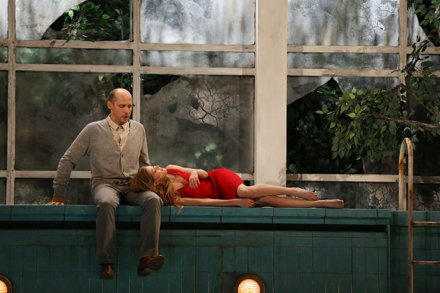
Stéphane Degout as Pelleas, Barbara Hannigan as Mélisander
The greatest of the many glories of the Aix Festival (besides, well, going for broke in many of its stagings) is the casting. Shapely Canadian soprano Barbara Hannigan was the Mélisande (the one who sang), existing much of the evening in her bra and panties, executing some spectacular physical theater moves from time to time (among other impressive accomplishment by Mme. Mitchell’s movement collaborator Joseph W. Alford), like a backwards summersault that left her contorted derrière aloft for extended moments, jumping animal-like onto Golaud’s back, etc. Her light and bright soprano illuminating her dreams in perfect French with impeccable musicianship. A total, spectacular performance.
Matched in every way by the Pelleas of French baritone Stéphane Degout and the Golaud of French bass-baritone Laurent Naouri. Both artists are of similar physical types that could make believable Maeterlinck’s half-brothers. Very male, handsome and physically fit both men were vocally very fit as well, the dark hued voice of Pelleas well able to scale the extreme range and emotional heights of this enigmatic force (Mme. Mitchell endowed him with the autistic nervous tic — at least in Melisande’s perception). Golaud in a black hued voice exuded every excited nuance of Maeterlinck’s most human and balanced and obsessive male force, creating in this staging finally a beautifully sculpted, deep and very moving pathos.
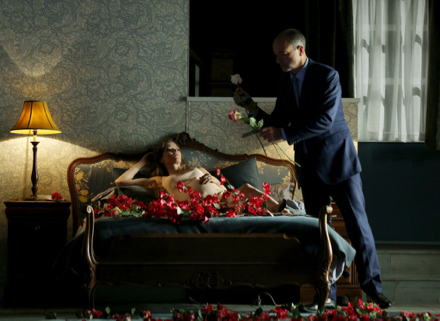
Barbara Hannigan as Mélisande, Laurent Naouri as Golaud
Parallel to Mme. Mitchell’s dream was Esa-Pekka Solonan’s descent into the sonic depths of Debussy’s masterpiece of orchestration. London’s Philharmonia Orchestra is one of the world’s fine ensembles, well able to manufacture a suave elegance for Debussy’s woodwinds, well able to ascend gracefully to fortissimo heights, and achieve shattering moments with no loss of sonic composure. It was an absolutely magnificent orchestral evening, seats in the mid section of the flawed Grand Théâtre de Provence offering a balanced if sometimes harsh sound, the voices on stage disarmingly amplified by the round shape of the theater.
The Philharmonia Orchestra is known for the warmth of its strings, and indeed they are, and the elegance of its winds. Conductor Salonen finds everything he needs to create the frigid warmth of his symphonic sound. His operatic emotions are well defined and highly considered, his great big moments are absolutely contained. Salonen’s lush symphonic poem ignored the unanswered questions and the mysteries of the story, remaining abstractly one dimensional.
This gifted maestro did not seem to care what occurred in those little scenic boxes up there on the stage. Nor did many of us.
Cast and Production
Pelléas: Stéphane Degout; Mélisande; Barbara Hannigan; Golaud: Laurent Naouri; Arkel: Franz Josef Selig; Geneviève: Sylvie Brunet-Grupposo; Yniold: Chloé Briot; Le Médecin: Thomas Dear. Cape Town Opera Chorus (unseen). Philharmonia Orchestra. Conductor: Esa-Pekka Salonen; Mise en scène: Katie Mitchell; Décors: Lizzie Clachan; Costumes: Chloé Lamford; Lumière: James Farncombe. Grand Théâtre de Provence, Aix-en-Provence, July 4, 2016.
Cosi fan tutte at the Aix Festival
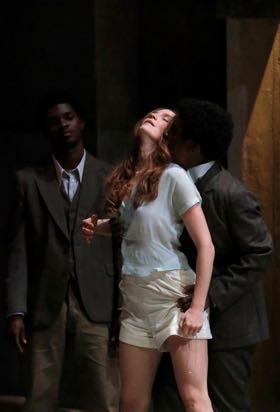
Kate Lindsey as Dorabella, with thugs
All photos courtesy of the Aix Festival.
Said and done the audience roared its enjoyment of the performance, reserving even greater enthusiasm to greet stage director Christophe Honoré with applauding boos and whistles that bespoke enormous pleasure, complicity and befuddlement.
Nothing held back, whites raped and brutalized and humiliated blacks in this witty comedy, here moved from the Bay of Naples to the African city Asmara (Mussolini’s new Rome) in Eritrea [a small state that won its independence from Italy’s former colony, Ethiopia in 1991].
Geography apart it was dimly lit comedy —hazy, sinister foreign atmospheres carefully calculated by lighting designer Dominique Bruguière (whose most recent project in Aix was Chéreau’s Elektra). French film set design/decorater Alban Ho Ban created Roman comedy’s cross streets for the first act — a shop front on a huge mud façade, probably a fort, the garrison of Italian soldiers. The final act took place inside the fort in a sort of distressed, mud colored courtyard, Italian flag limply hanging.
However the collaborator most responsible for abusing our sensibilities was conductor Louis Langrée whose overture to Da Ponte’s comedy resonated with the brutality on the stage (soldiers raping a black woman), not to mention the maestro’s very willing collaborators, the magnificent Freiburger Barockorchester whose antique tonalities shouted the roughness and the darkness of the stage atmospheres.
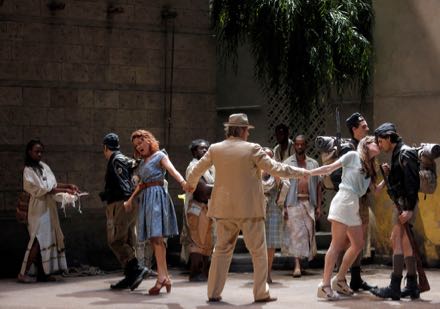
left to right Guglielmo (mostly hidden), Fiordiligi, Don Alfonso, Dorabella, Ferrando
The stage was rude and angry, two simple girls of their time and place, daughters of Italian colonists. Hardly polished examples of a master race, rather they were crude and tarnished examples of humankind’s totem of purity. Conductor Langrée and Kate Lindsey’s Dorabella made “Smanie implacabili” an explosion of ugly sentiment. There was no applause. Rod Gilfrey’s Don Alfonso with Lenneke Ruiten’s Fiordiligi and Dorabella moved as a menacing phalanx towards the audience in a dark and flatly sung “Soave sia il vento,” Mozart’s gentle reverie becoming an anthem to a lost humanity. There was no applause.
And it went from there, stage director Christophe Honoré plumbing the depths of wit, character perception and subtlety in his complex and thorough staging. Only to mention the virtual rape of a handsome noir by Fiordiligi and Dorabella in “Prenderò questo brunettino/Ed intanto io col biondino” and the morphing of Mozart’s more subtle racism (Turks) into blackface. The blond and brunette had become two very black African soldiers [in historical fact the occupying Italian fascist forces employed black mercenaries].
Bass [!] Nahuel di Pierro’s Guglielmo, often accompanied by two thugs (a blanc and a noir), made a tough guy match for rough and nasty Dorabella. Tenor Joel Prieto’s Ferrando who in the first act pressed his uniform on a period (‘30‘s) ironing board before marching off to the feigned war showered a vista before his second act seduction of Fiordiligi, his bronze blackened body reflecting golden light.
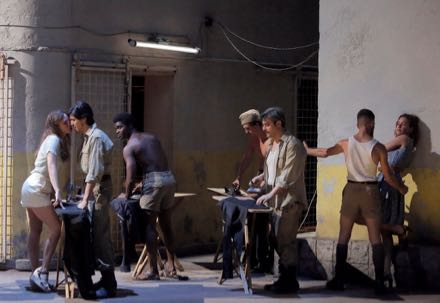
Dorabella and Ferrando (left), Guglielmo, supernumerary and Fiordiligi (right)
Above all else was conductor Louis Langrée plumbing the depths of Mozart’s score, finding, amplifying everything we saw on the stage, including — and most of all — the sublime moment when Fiordiligi knew she loved the black soldier, not the white one. This is when the Freiburger Barockorchester took us to a transcendental place we never knew or even suspected existed in this far-fetched, esoteric comedy.
Wow.
Making all this possible was the depth of casting, led by the omnipresence of Rod Gilfry’s Don Alfonso in a tacky white linen suit and fedora. But moreso by the chorus of Cape Town Opera, imported for the occasion, bringing with it the complexities of colonial racism in Africa and indeed racism everywhere.
As a complicit audience we allowed our sensibilities to be exploited. Overheard intermission discussion struggled to make sense of the metaphor and there was offense expressed at the in-your-face exposition of racism. Certainly all of us left the theater more than ever challenged to make sense of art and life.
Still it was Cosi fan tutte, and that means a very long evening of laying out the plot bit by bit and discovering, finally and slowly, its resolution. There were some rough moments between the pit and the stage, the Despina of Sandrine Piau not finding the sense of this music and maybe the production. We may have wished for a stronger portrayal of Fiordiligi, though Mlle. Ruiten did succeed wonderfully in accomplishing the opera’s final redemption.
Cast and Production
Fiordiligi: Lenneke Ruiten; Dorabella: Kate Lindsey; Despina: Sandrine Piau; Ferrando: Joel Prieto; Guglielmo: Nahuel di Pierro; Don Alfonso: Rod Gilfry. Cape Town Opera Chorus. Freiburger Barockorchester. Conductor: Louis Langrée; Mise en scène: Christophe Honoré; Décors: Alban Ho Van; Costumes: Thibault Vancraenenbroeck; Lumière: Dominique Bruguière. Théâtre de l’Archevêché, Aix-en-Provence, June 30, 2016.
Benvenuto Cellini in Rome
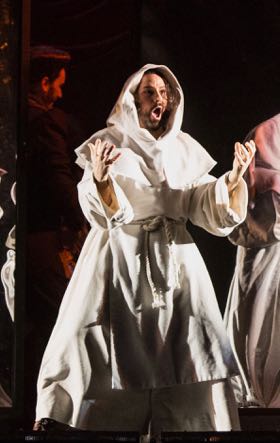
John Osborn as Benvenuto Cellini
All photos copyright Yasuko Kageyama, courtesy of the Opera di Roma.
One may think of Tosca as the most Roman of all operas, after all it has been performed at the Teatro Costanzi (Rome’s opera house) well over a thousand times since 1900. Though equally, maybe even more Roman is Hector Berlioz’ Benvenuto Cellini that has had only a dozen or so performances in Rome since 1838.
This is the one where the young sculptor Cellini must cast a statue of Perseus (the Greek hero who killed Medusa) commissioned (only in the opera) by Pope Clement VII, the high renaissance Medici pope. A true Renaissance man Cellini was a sculptor, soldier, flute player (like Berlioz), rogue, lover and author — his famous autobiography self-celebrates his considerable exploits in all these fields.
Hector Berlioz and Benvenuto Cellini were kindred spirits. They both thought big, very big, and imagined grandiose accomplishment. Both had absolute certainty of their genius and never doubted their abilities. This got Cellini into quite a lot of trouble. While Berlioz steered clear of the law he heroically schemed to effect the politics or raise the money to realize huge symphonic and operatic projects. Case in point Benvenuto Cellini — four horns, four trumpets, three trombones plus tuba, winds, two harps, seven percussion players, fifty-eight strings [the count in Rome], seven principal singers and the trappings of grand opera (huge choruses and lots of fire) to tell this far-larger-than-life exploit of a far-larger-than-life personage.
So you must think big if you want to attempt Berlioz’ Cellini opera. It is not said if film director Terry Gilliam (Fear and Loathing in Las Vegas among many more films and many Oscar nominations) initiated the idea to exploit this opera, or if English National Opera seized the opportunity to exploit the resources and processes of big time film making to create something really big.
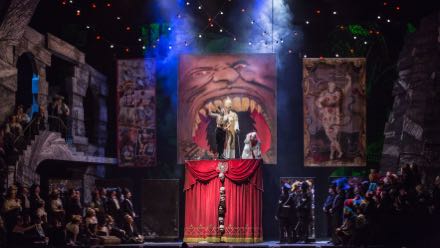
The commedia dell'arte performance in Act I
Mr. Gilliam’s team for this 2014 ENO production included scenographer Aaron Marsden (the film Moulin Rouge!), choreographer Leah Hausmann, costumer Katrina Lindsay and lighting designer Paule Constable (recipient of many Oliver and Tony awards), and videographer Finn Ross. The result is a huge and spectacularly cinematic production. Along with Cellini’s struggles to cast his statue in bronze and Berlioz’ struggles to conceive, compose and get his opera produced, you viscerally felt the tremendous creative energy and talent expounded by Mr. Gilliam’s team. It propelled this opera to an ultimate theatrical level.
Every note of Berlioz’ sprawling, elaborate, generally manic, often naive score was taken into consideration and turned into big time, let us say manic theater. It sat splendidly in the Teatro Costanzi, filling the proscenium width with wide screen presence, equalling in scope the enormous sound and color emanating from the expanded pit.
Conductor Roberto Abbado offered breadth and sympathy to the Berlioz score, underscoring its out-of-left-field musicality. Mo. Abbado allowed what seem to be illogical musical ideas to flow straight-on, avoiding compromise to ears (like the Parisian public of the 1830’s) that are (and were) accustomed to classic French grand operas like La Juive (1835) and to Roberto Devereux (Paris, 1838), operas that I had seen/heard only days before. Benvenuto Cellini was not a success in 1838. Even now musically it was a strange, long haul that profited greatly from expansive production values.
After its London premiere the production traveled to Amsterdam in 2015 where American tenor John Osborne took on the role of Benvenuto Cellini with solid success, a success repeated just now in Rome. Mr. Osborn is a very physical performer, a real actor and a beautifully voiced singer. Vocally he is a more lyric Bellini tenor than an heroic tenor, but this allows him to soar through the role’s high tessitura with ease. At the end when we expected and maybe wanted a physically exhausted Cellini Mr. Osborn sounded like he could take it from the top all over again.
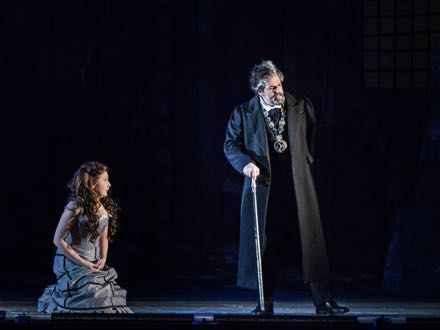
Mariangela Sicilia as Teresa, Nicola Ulivieri as Balducci
Teresa, the daughter of the pope’s banker and betrothed to Cellini’s untalented rival Fieramosca, was Mariangela Sicilia, again from the Amsterdam cast. This young Italian soprano brought spunk, sassiness and brilliant high notes galore to seduce Cellini, as well as several moments of pitch and vocal uncertainty. Ascanio, Cellini’s apprentice/sidekick was Armenian mezzo soprano Varduhi Abrahamyan, new to the production. A confident, strong voiced singer she perhaps too soberly anchored this trouser role character as the sole voice of good sense amongst a field of buffo males (let us include Cellini among these guys).
The three lively buffo baritone/bass roles, Fieramosca, Balducci, Pope Clement were entrusted here in Rome to Italians who simply did what the Italians alone can do best — buffo!
Casts and production informationAscanio: Varduhi Abrahamyan; Benvenuto Cellini: John Osborn; Fieramosca: Alessandro Luongo; Giacomo Balkducci: Nicola Ulivieri; Pope Clement: Marco Spotti; Pompeo: Andrea Giovannini; Teresa: Mariangela Sicilia; Francesco: Matteo Falcier; Le Cabaretier: Vladimir Reutov; Bernardino: Graziano Dallavalle. Chorus and Orchestra of the Opera di Roma. Conductor: Roberto Abbado; Stage Director: Terry Gilliam; Co-director and Choreography: Leah Hausman; Set Design: Terry Gilliam and Aaron Marsden, originally conceived by Rae Smith; Costume Design: Katrina Lindsay; Lighting: Paule Constable; Video: Finn Ross. Teatro Costanzi, Rome, Italy, March 29, 2016.
Roberto Devereux in Genoa
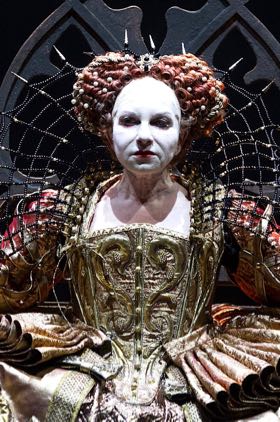
Mariella Devia as Elisabetta I
All photos courtesy of Teatro Carlo Felice, Genova.
Radvanovsky in New York, Devia in Genoa — Donizetti queens are indeed in the news! Just now in Genoa Mariella Devia was the Elizabeth I for her beloved Roberto Devereux in a new trilogy of Donizetti queens (Maria Stuarda and Anne Bolena) directed by baritone Alfonso Antoniozzi.
The productions are said to be shared with Venice's La Fenice and Parma's Teatro Regio. Unknown, at least unannounced is if these additional cities will have the splendid Elizabeth of now 68 year old Mariella Devia.
This incomparable diva sang Liu in Genova at age 64, followed the next year by her debut as Norma in Bologna. Her first Roberto Devereaux Elizabeth occurred in 2014 at Carnegie Hall, a performance that is nearly legendary.
Donizetti begins his opera by exposing the abilities and vulnerabilities of his queen as she threatens a terrible vengeance upon her rival for young Devereux's love in the vocally daunting "A te svelai tutto il mio core." Donizetti ends his opera with the emotionally exhausted old queen wreaking her vengeance in "Alma rea! Spietato core!" Finally, at her greatest anguish she abandons her throne to enter her tomb on a sustained high C. You knew it was coming, you gripped your arm rests, and with this great queen you triumphed. Well, maybe the C was a bit truncated. But it was powerful and real.
Mariella Devia's voice is not ripe, nor is it warm. It is steely and technically sure, and fully subject to the mature musical intellect of a formidable stylist and, yes, it is the voice of a queen. These attributes determined the tenor of the performance. However it remained an opera about an over-aged singer more than an opera about an older queen inappropriately in love with a much younger man. But make no mistake, it was splendid way to spend a bel canto evening.
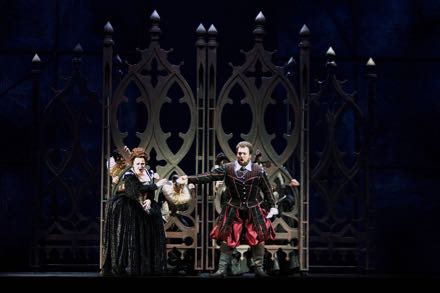
Sonia Ganassi as Sara, Stefan Pop as Devereau
Elizabeth's rival is Sara, to whom she has confided her love of the traitor, Robert Devereux. Young Sara also loves Devereux and he loves her though Elizabeth has forced Sara to marry Nottingham who is Devereux's best friend. You see that there is a lot to sing about. Sara was sung by esteemed lyric mezzo Sonia Ganassi, like la Devia a highly accomplished mature artist. The condemned Devereux was sung by Romanian tenor Stefan Pop who mostly confused singing with shouting, though he did offer a soft, sensitive and very beautiful "Ed ancor la tremenda porta non si dischiude?" Nottingham was sung by Korean baritone Mansoo Kim whose well applauded performance exhibited mastery of Italian style and technique in a beautiful, wooden, darkly colored tone.
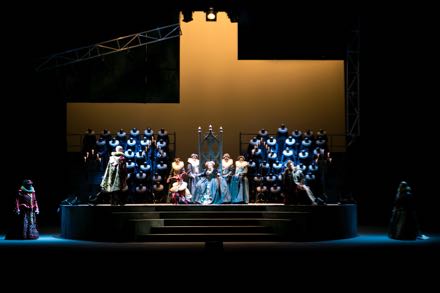
Principals on stage, Cecil and Gualtiero far left and far right in skirts
Cecil and Gualtiero are characters in the opera who facilitate some dreadful circumstances. They were confusing presences because they wore grand skirts but sang in baritonal voices. A primer on court dress of the 1600's would have been helpful so we could have understood and maybe appreciated the self conscious exaggerations of the costumes, victims of intensely colored synthetic fabrics, outsized and distorted collar shapes, and naive gender bending. The men of the chorus were costumed in dresses as well.
The stage was minimal, only a platform on which the principals did their thing aided by six mime assistants (the chorus costumed in all black was deployed on the floor around the stage). A huge bird cage descended to be the prison in which Roberto sang his lament (bel canto like a bird singing [groan]). There were two trendy crooked trusses alluding to, surely wishing to reinforce the fact that the agonies were, after all, only theater to be lighted.
Stage director Alfonso Antoniozzi provided lots of swish. To the accompaniment of the overture's play on “God Save the Queen” Antoniozzi dressed his queen in a huge golden imperial mantle that she would prosaically divest in the final scene, ninja acolytes raising the train to reveal a map of Europe. A singer himself Antoniozzi does in fact understand how to stage arias and numbers knowing that we do not need a lot of meaningless action to get us through ten or twenty minutes of powerful music.
The pit was in the hands of young Italian conductor Francesco Lancillotto who could not find the breath and phrase of Donizetti's bel canto, nor a solid, expressive ground for his accompaniments.
Casts and production information
Queen Elisabetta I: Mariella Devia; Sara: Sonia Ganassi; Roberto Devereuu: Stefan Pop; Nottingham: Mansoo Kim; Lord Cecil: Alessandro Fantoni; Gualtiero Raleigh: Claudio Ottino; A page: Matteo Armanino; Nottingham’s friend: Loris Purpura. Orchestra and Chorus of the Teatro Carlo Felice. Conductor: Francesco Lanzillotta; Stage Director: Alfonso Antoniozzi; Scenery: Monica Manganelli; Costumes: Gianluca Falaschi; Lighting: Luciano Novelli. Teatro Carlo Felice, Genova, March 24, 2016.
William Kentridge is a South African artist who works in charcoal and eraser (smudges) on paper, in small animated film and video segments (black and white), in theater, and now in opera. Monteverdi’s The Return of Ulysses was his first operatic project that took place in 1998 in collaboration with South Africa’s Handspring Puppet Theater.Il ritorno d'Ulisse in Patria at San Francisco Museum of Modern Art

Rachel Harnich as la juive, Sabina Puértolas as Princess Eudoxie
[All photos courtesy of the Opéra de Lyon, copyright Stofleth]
This 1998 production has been revived just now by Seattle’s Pacific Operaworks, using Mr. Kentridge’s original South African puppet collaborators, for performances in Seattle (March 11-21) and in San Francisco (March 24-29) in conjunction with SF Museum of Modern Art’s exhibition, William Kentridge: Five Themes (through May 31).
Mr. Kentridge’s art has been shown in many of the major modern art museums in Europe and America, at times in conjunction with performances of The Return of Ulysses, and these often with major musical collaborators. It was then obvious for Mr. Kentridge to take on Mozart’s puppet-like opera, The Magic Flute, which he did for Brussel’s Théâtre Monnaie in 2005, a production that made its way to the Brooklyn Academy in 2007. From there it is but a small step up (or maybe a giant leap) to Shostakovitch’s The Nose for The Metropolitan Opera in 2010.
Mr. Kentridge’s first ambition was to be an actor, though it soon became apparent that his greater talent was that of an artist. His vision though has remained theatrical. The San Francisco MOMA exhibition includes a series of large charcoal illustrations based on a version of Alfred Jarry’s absurdist Roi Ubu (1896) at Johannesburg’s Junction Avenue Theater Company, where he has often worked as an actor and director.
Mr. Kentridge’s is a man of the theater. His parents were lawyers and civil rights advocates in pre-Apartheid South Africa, thus Mr. Kentridge’s art is genetically imbued with the theatrics of domestic and civil politics, and his colors are black and white, with an occasional line or splash of primary color, usually red.
The SF MOMA exhibition includes Mr. Kentridge’s preparatory studies for The Magic Flute, and preliminary visual experimentation for The Nose. The Magic Flute exhibit is Mr. Kentridge’s model stage box, its surfaces illustrated by dark mini-video images for the Queen of the Night that contrast with the enlightened bright images of Sarastro (all the while accompanied by a medley from Mozart’s opera). Preparatory studies for The Nose are eight very large, black and white video projections on the walls of a large gallery (with only ambient sound, no Shostakovitch). Most striking of the impressive group were a Cossack dancer repeating a movement, and another of Mr. Kentridge (an Alfred Hitchcock look alike) walking in and out of a white space. The sense is that Gogol [author of The Nose] has met his match.
As Monteverdi’s two extant Venetian operas exist only in embryonic form when compared to modern opera scores, Ulysses and Poppea both require modern editions before they can be attempted by opera companies. Progressively these performing editions have moved to purer Baroque musical practices, contemporary audiences easily perceiving the integrity of the original musical and dramatic inspiration.
And at the same time we have had the good fortune to see these embryos developed freehand into very effective modern works — Raymond Leppard’s Poppea at one extreme, Luigi Dallapiccola’s Ulysses at another, Barry Kosky’s Poppea for the Vienna Schauspielhaus (actors who sing, piano and three cellos in the pit), and of course William Kentridge’s Ulysses, Monteverdi’s Baroque tapestry magnified into a focused delirium of the last one hundred minutes of Ulysses life.
In much of his art Mr. Kentridge is intrigued by simple mechanics, and certainly that of puppetry. Thus it is no surprise that his continuo (a small, non-specific group of instruments that accompanies sung text, the only accompaniment Monteverdi’s Venetian operas require) was a vista, make the players’ physical movements a part of the show. The continuo stretched across a slightly raised midstage platform. Led by Pacific Operaworks music director Stephen Stubbs on chitarrone (theorbo), the continuo was an additional theorbo, a baroque harp, two violins and a viola da gamba/cello. Maestro Stubbs and this combination of instruments provided a warm, smooth and sensual continuum of music, rarely disturbed by rhythmic punctuation or other coloristic intrusions.
The high back of the continuo platform divided the front stage from a more complicated upstage playing area, as the back wall of the orchestra platform allowed the nearly life sized puppets to be seen without their operators, animating them by sticks from below (see photo). On the front stage the vista puppeteers were silently one with their puppets, imbuing their movements with their own humanity, though the voice of puppet was a concert dressed singer, concentrating his gaze on the face of the puppet, and effecting the gestures of one of the puppet’s arms. The effect was a humanity of always profound and sometimes terrifying proportion.
If Monteverdi supercharged the intoned, impassioned speech imagined by Renaissance philologists as that of ancient tragedy, Pacific Opera Works took this heated musicality a further step by providing us a Ulysses who projected this text in inspired musical periods that were heroic, almost super human in musical effect, that grew into the sublime final duet with Penelope. The singer, Ross Hauck, is active in music ministry in the Northwest. Mr. Hauck was well supported by his Penelope, Laura Pudwell. The production’s star turn was Met singer Cyndia Sieden (Love and Athena), who was joined by five accomplished performers who enacted Penelope’s maid, Ulysses’ tutor, his son, and his rivals, and all hinted at the presences of the plethora of divine forces in Monteverdi’s original.
More a multimedia event than an integrated opera production, Mr. Kentridge’s Return of Ulysses was the combination of these musical forces with puppets animated by puppeteers (though the puppets were sometimes in solo, frozen movement, like comic book illustrations), plus a black and white video component projected on a large screen hung above the upstage playing area. As Mr. Kentridge’s Ulysses lies dying in a Johannesburg hospital this video takes us into his body through medical diagnostic imaging, at other times we see into his death delirium by the images in front of which his life plays back. Never a commentary, the video was always an immediate part of the momentary action. While these components remained a montage, changing focus for me was seamless though my experience will have been my own, not that of my companions. Yet in the end the montage did not build to a convincing apotheosis of love in death — and this was Mr. Kentridge’s attempted ending, not Monteverdi’s.
With this production (its first!) Pacific Operaworks has established itself as a national level producer of opera, San Francisco’s Artaud Theater has proven itself a fine theater for Baroque opera, SF MOMA has firmly established itself as an enlightened presenter of multimedia art. And Mr. Kentridge is on his way to the arguably enlightened Metropolitan Opera. The Nose will be an extraordinary event for the opera world.
La Juive in Lyon
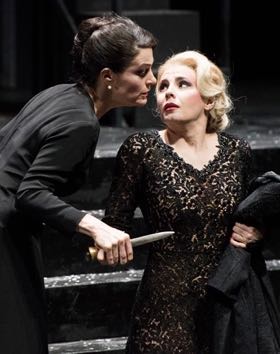
Rachel Harnich as la juive, Sabina Puértolas as Princess Eudoxie
[All photos courtesy of the Opéra de Lyon, copyright Stofleth]
Though all big opera is called grand opera, French grand opera itself is a very specific genre. It is an ephemeral style not at all easy to bring to life. For example . . .
The first production (1835) of La Juive at the Paris Opera demanded 20 horses on stage (in Lyon there was not even one!). In 1835 Paris la juive and Eléazar, her father threw themselves into a cauldron of water boiling upon a huge fire (in Lyon there was no leap, no cauldron or flame, the victims merely strode up stage into vague wisps of theatrical fog).
Not that the Opéra de Lyon was economizing as the sets were huge and complicated. Huge scenic elements moved continuously on and off a cross-stage moving belt, upstage there was another belt moving a forest of huge burned tree carcasses back and forth almost constantly. All of this was elevated 8 feet (2 1/2 meters) above the stage floor. An enormous bank of steps crossing the entire down stage descended to the stage floor (there was a net covering the orchestra pit to catch anyone who might trip and tumble). Not to mention the huge flat that hung flat way up above the stage, lighted spectacularly from time to time (surely a lighting designer’s nightmare).
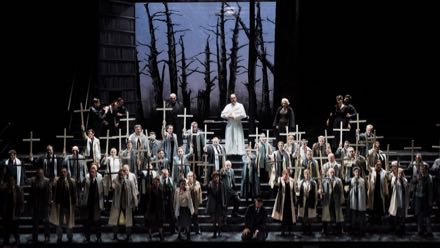
Roberto Scandiuzzi as Cardinal Brogni (production design by Pierre-André Weitz)
And surely a conductor’s nightmare in his attempts to coordinate the pit with the stage where in addition to the initial 8’ elevation much singing occurred on the additional three levels of a tower from which la juive and her father did not fling themselves into the cauldron [our assumption when we saw the tower in the first act was that it surely would serve such purpose].
The pit however was where the strengths of the production emanated. 33 year-old conductor Daniele Rustioni (music director designate of the Opéra de Lyon) ran a tight ship, feeling and communicating every quiver of musical emotion and energy from the soles of his feet to tips of his fingers (he conducted without stick). [I sat above the pit for the first act and had full view of this amazing young conductor.]
Metteur en scène Olivier Py and his designer Pierre-André Weitz envisioned Halévy’s opera in tones of black, the color of traditional European Jewish clothing, allowing only Cardinal Brogni and the catholic congregation to be clothed in light or white tones of generic modern dress. La juive’s nemesis, the Princess Eudoxie was in a lacy black gown allowing flesh to be seen (a lot of it from time to time), and she was wigged like a gangster moll. In her seduction of Leopold she slithered into brilliant red stockings [fueling our expectation that there would be red flames for la juive’s immolation though of course finally there were no flames].
The plot: Leopold returns victorious from a war to be received as a hero by the Christian people and Princess Eudoxie. He is however in love with la juive so he must pretend to be a Jew. When this pretense is discovered he flees to the palace into the arms of the princess. The Christians hear the news and condemn Leopold, la juive and her father to death. La juive and Princess Eudoxie agree that la juive will exonerate Leopold, sacrificing herself to the [absent] flames. When it is too late la juive’s father Eléazar tells the Cardinal Brogni that the juive is in fact the cardinal’s long lost daughter.
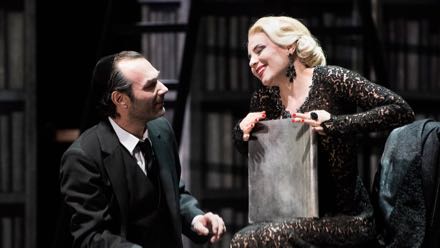
Nikolai Schukoff as Eléazar, Sabina Puértolas as Princess Eudoxie
Evidently all this is not really about religious tolerance. It is about making a story with emotive moments without inciting public judgement about Christians immolating Jews or Jews murdering anyone who profanes their rites. It is about love, forgiveness and sacrifice. French grand opera is purely about opportunities to sing and there were lots of them — declarations of love, denunciations of love, of vengeance, of pity, of anger, trios and sextets of frustration, incomprehension or comprehension. And huge choruses of support for all the above.
The cast for this grand opera event in Lyon generally lacked the power of voice, the color of voice and the stamina of voice to guide us safely through the musical intricacies of Halévy’s lengthy, singerly score (vocally it lies between Rossini and early Wagner). Agility for coloratura is a prime requirement, but equally important there must also be stamina for carving out longer phrases. Plus as characters have specific motivations voices must be those that add appropriate color to words and actions. Not that there was not a lot of fine singing. It was simply that most of the singing did not create big enough effect.
French grand opera composers structured the arias and ensembles to impress audiences who would then respond with applause. Few of the arias or ensemble in Lyon got applause, and when there was applause it was tepid. The hugest scene, the finale of Act III with all principles and the chorus of Christians on stage, had little effect because the too small voices of the principals could not soar over the chorus — blame also the place on the stage where the chorus was seated. It was a perfect megaphone, amplifying the chorus voices to the point that they shattered (sound waves colliding), ruining this magnificent scene.
Still it was a French grand opera and it is not often that these lengthy, difficult operas are staged in any manner. N.B There was no ballet, an integral component of French grand opera, though I am not sure where it should have occurred.
La Juive is the centerpiece of the Opéra de Lyon’s mid-winter festival, this year Festival pour l’Humanité, with the theme of tolerance. Metteur en scène Olivier Py could not help editorializing — in the Act I finale the Christian chorus places itself down stage center with placards urging “France for the French,” “Out with the Jews” [read Muslims], and in the silence prior to Act V (the death by fire) hundreds of shoes [the death-oven image] fell from the rafters. In coincidence both La Juive and Benjamin, Dernière Nuit used the library image to establish the presence of humanity in this Festival pour l’Humanité.
Casts and production information:
Eléazar: Nikolai Schukoff; Rachel: Rachel Harnisch; Princesse Eudoxie: Sabina Puértolas; Leopold: Enea Scala; Cardinal Brogni: Roberto Scandiuzzi; Ruggiero: Vincent Le Texier; Albert: Charles Rice. Chorus and Orchestra of the Opéra de Lyon. Conductor: Daniele Rustione; Mise en scène: Olivier Py; Scenery and costumes: Pierre-André Weitz; Lighting; Bertrand Killy. Opéra de Lyon, March 19, 2016.
Benjamin, Dernière Nuit in Lyon
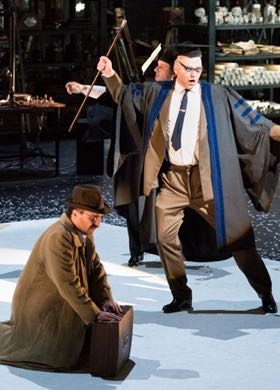
Philosophers Walter Benjamin and Max Horkheimer
All photos courtesy of the Opéra de Lyon, copyright Stofleth
That’s Walter Benjamin of the Frankfort School [philosophers in the interwar period (WW’s I and II) who were at home neither with capitalism, fascism or communism].
The libretto was created by Régis Dubray (b. 1940), professor of philosophy at the University of Lyon, the music was created by Michel Tabachnik (b. 1942), conductor of the Brussels Philharmonic and champion of the music of Xenakis and Ligeti.
Both men possess extensive catalogues of original literary and musical compositions. Both men possess biographies placing themselves at the epicenters of our previous century’s social, intellectual and artistic avant-garde.
Add to this primordial soup British stage director John Fulljames and British set designer Michael Levine (and you have the usual addition of Anglo-Saxon critical know-how to make sense of esoteric continental thought).
You get the idea — it wasn’t an easy evening.
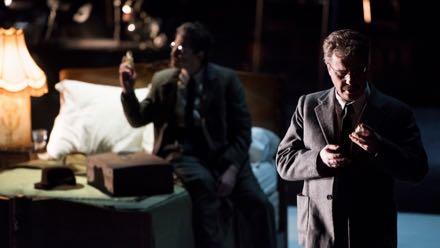
Actor Walter Benjamin and singer Walter Benjamin with bottle(s) of morphine tablets
However its ninety minute duration flew by in what seemed like ten minutes even though it was in ponderous, docudrama episodic form. There were 14 brief scenes documenting Walter Benjamin’s arrival and sojourn of one long evening at a Spanish hotel just across the French border. He was on his way to Lisbon where he would have embarked to the United States. Instead he committed suicide at this hotel.
The opera is his progression from life to death. The libretto imagines Benjamin’s suicide vigil encounters (imagined) with a few of the intellectual luminaries who had supported him in his escape and exile from Nazi Germany, namely Arthur Koestler (anti-Fascist author of Darkness at Noon), Gershom Sholem (German born Israeli mystical philosopher), André Gide, Bertolt Brecht, Max Horkheimer (interwar director of Frankfurt School of Critical Thinking, this institute later in exile at Columbia University together with Horkheimer), Asja Lacis (Benjamin’s mistress — a Latvian actress, avid communist, friend of Brecht) and Hanna Arendt (refugee German Jew, naturalized American political scientist).
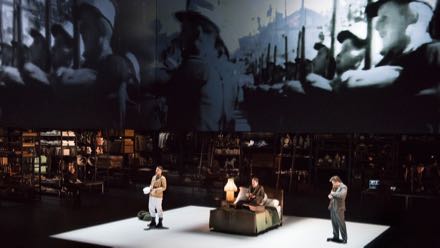
The library/museum of human artifacts (below), video of Third Reich marching soldiers above)
Yes, it was a lot to think about, the libretto projected high above the stage. The upper part of the stage itself was a huge three-sided box onto which were projections of Nazi and Stalin era propaganda films. The lower stage a huge three sided room of library shelves — books, artifacts, the above characters stuffed onto these shelves except when they came alive in Benjamin’s imaginings. Plus there were two Walter Benjamins, one a singer and the other an actor, sometimes one, sometimes the other, sometimes both being Benjamin. Not to mention eight ninjas (clothed in black) who were sometimes French Foreign Legionnaires and sometimes archivists of the above library. Plus there was a myriad of supporting roles divided among actors and singers.
Conceptual and visual cacophony, from beginning to end.
And, well, the music itself. There was a lot of it and a lot of it was musique concrete [a montage of any possible recorded sound] when it was not usually unidentifiable masses of orchestral sounds — triple or quadruple winds, full complement of strings, piano and harp, legions of percussion instruments, accordion, etc. No doubt is was more organized and structured than this quick appreciation of its general cacophony.
The genius of the production was however the seamless integration of the pit and the stage into a indecipherable, inexplicable, undefinable frenetic whole the magic of which created quite a wallop.
The Opéra de Lyon went for broke. We, the audience, roared our appreciation and roared some more, though I’m not sure how many of us would opt to see it a second time.
By the way, Benjamin, Dernière Nuit was one of three operas that comprise the Opéra de Lyon’s midwinter festival, this year entitled Festival pour l’Humanité with its theme of tolerance. This production rose well above such a prosaic formula, and succeeded in making art — an accomplishment not always achieved in opera houses these days.
Casts and production information:
Walter Benjamin (singer): Jean-Noël Briend; Walter Benjamin (actor): Sava Lolov; Asja Lacis: Michaela Kustekova; Hannah Arendt: Michaela Selinger; Arthur Koestler: Charles Rice; Gershom Sholem: Scott Wilde; Bertolt Brecht; Jeff Martin; André Gide; Gilles Ragon; Max Horkheimer: Karoly Szemeredy; Mme Henny Gurland: Elsa Rigmor Thiemann; La chanteuse de cabaret: Goele de Raedt; Joseph Gurland: Baptiste Mansot; Le Patron de l'Auberge: Emmanuel Amado; Le Médecin: Bruno Froment. Chorus and Orchestra of the Opéra de Lyon. Conductor: Bernhard Kontarsky; Mise en scène: John Fulljames; Scenery: Michael Levine; Costumes: Christina Cunningham; Lighting: James Farncombe; Chorégraphie: Maxine Braham; Vidéo: Will Duke; Son: Carolyn Downing. Opéra de Lyon (France), March 18, 2016.
Aiglon in Marseille
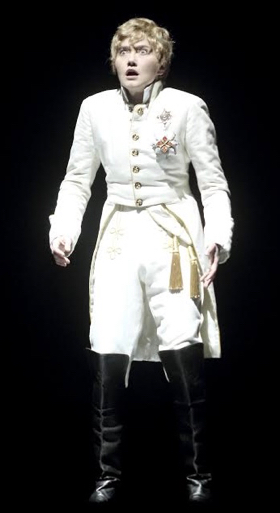
Stéphanie D'Oustrac as Napoleon II
All photos courtesy of the Opéra de Marseille.
Napoleon I (Bonaparte) was known as the Aigle (eagle), his son by Marie Louise (of the Hapsburgs) later became called the Aiglon (eaglet). At birth he was dubbed the King of Rome by his father. Unofficially and very briefly he was Napoleon II. Exiled in Austria he was officially titled the Duke of Reichstadt and the Prince of Parma.
All this would probably remain a footnote to history except Marseille born playwright Edmond Rostand (author of the famous Cyrano de Bergerac) wrote a six act play (1900) that wrung hearts in beautiful alexandrine verse about this young man who was deluded into believing he could restore the Bonapartists to France. The fabled Austrian diplomat Metternich who in fact had engineered the marriage, raison d’état, that begot the Aiglon was now a formidable counterforce for raisons d’état — not to mention his young age and fragile health.
Films based on the Rostand play were made in 1913, 1921 and 1931. In 1936 composers Jacques Ibert and Arthur Honeger joined forces to create an opera (joint compositions a practice Ibert in particular pursued it seems). The libretto was created by the prolific Henri Cain (many operas for Massenet as example) based on the Rostand play, then ruthlessly modified by the composers.
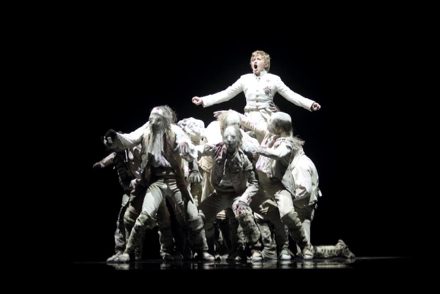
Stéphanie D'Oustrac as Napoleon II reinventing the Battle of Wagram
Ibert composed acts I and V, Honegger wrote II, III and IV, acts I, III and V are based largely on Viennese walzes much in keeping with the boulevard musical popular in Paris between the world wars. Honegger proves himself again a formidable dramatic composer in Acts II and particularly in Act IV which was an evocation of the stunning victory of Napoleon I at the battle of Wagram. Ibert interspersed some lovely airs in Act I and engineered a lovely, touching death in Act V. Both composers created sophisticated music easily accessible to a broad, early mid-twentieth century Parisian public.
The first and biggest problem of the evening was that the program booklet proclaimed no historical context for the opera. Most of us were in the dark, after all the happenings are a minor footnote to history. The program contained only the biographies of the artists plus self-congratulatory notes by the stage director. A “synopsis” stated only that the story is the pathetic attempt to restore Napoleon II as emperor of France. Period. With absolutely no context provided we were forced to keep our eyes glued on the supertitles, deciphering the alexandrines as best we could to create the story that was unfolding way down there on the stage.
And in fact it is a good story, well told by messieurs Ibert and Honegger.
Among other problems of the evening was the Aiglon herself, Stéphanie D’Oustrac who was suffering from a bad cold. In spite of this Mme. D’Oustrac managed a total performance, creating the youth, vulnerability, idealism, naïveté and delusion of the 21 year-old soldier in often very beautiful voice, and even in the passages in which she was vocally restrained the poetic voice of the Aiglon was never lost. It was a tour de force performance by a very special artist.
The remainder of the cast did not achieve the stature sufficient to support such a performance. There were those who were viable and those who were not, those who could sing and those who could not, those who were too young or too old for their roles. In particular the role of Flambeau, the faithful footman who naively deludes the young soldier, demanded an artist of accomplishment and stature. Such an artist was not provided.
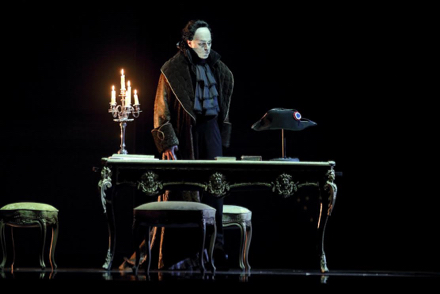
Franco Pomponi as Metternich
This was a remount of a 2004 Marseille production by the metteur en scène team Moshe Leiser and Patrice Caurier. It is typical of their style which is quite spare but very precise both in decor and by focus of light — characters are placed in specific shafts, lines and pools of light for specific and powerful moments of revelation. It can be very effective. The remount by former Marseille Opera directeur général Renée Auphan did not effect the style, hampered by poor casting as well as by attempting to recreate such a precise production so long after it was fresh.
If anything went right it was the pit! Conductor Jean-Yves Ossonce coaxed the Marseille orchestra to beautiful playing, capturing the spirit of the waltzes, the sweetness of the airs, and the dramatic force and colors of the Honegger acts. The pit did indeed make a fine recommendation for this piece to find its way occasionally onto repertory starved, adventurous stages around the world.
Casts and production
L’Aiglon: Stéphanie D’Oustrac; Thérèse de Lorget: Ludivine Gombert; Marie Louise: Bénédicte Rousseno; La Comtesse Camerata: Sandrine Eyglier; Fanny Elssler: Laurence Janot; Isabelle, le Manteau vénitien: Caroline Gea; Flambeau Marc Barrard; Le Prince Metternich: Franco Pomponi; Le Maréchal Marmont: Antoine Garcin; Frédéric de Gentz: Yves Coudray; L’Attaché militaire français: Éric Vignau; Le Chevalier de Prokesch-Osten: Yann Toussaint; Arlequin: Anas Seguin; Polichinelle, un Matassin: Camille Tresmontant; Un Gilles: Frédéric Leroy. Chorus and Orchestra of the Opera de Marseille. Conductor: Jean-Yves Ossance; Production: Patrice Caurier and Moshe Leiser; Metteur en scène: Renée Auphan; Décors: Christian Fenouillat; Costumes Agostino Cavalca; Lumières: Olivier Modol d'après original lighting designer Christophe Forey. The Opéra de Marseille, February 16, 2016.
Götterdämmerung in Palermo
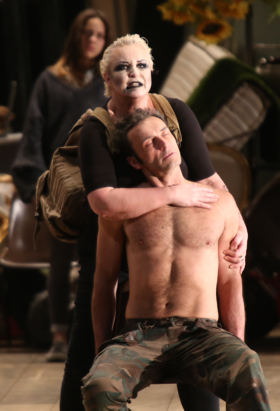
Iréne Theorin as Brünnhilde, with Grane (mime)
All photos courtesy of the Teatro Massimo, Palermo.
There are not many opera productions that you would cross oceans to see. Graham Vick’s Götterdämmerung in Sicily however compelled such a voyage.
Graham Vick deconstructed Wagner’s timeless musical myth of the gods of power and wealth into twenty-first century proportions, propelling Wagner’s nineteenth century, early industrial age to a destiny unimaginable, certainly unacceptable to Romantic idealism. The original catastrophic conclusion Wagner envisioned for the gods was absolutely real then, and perhaps from those final sublime moments of Götterdämmerung our modern social democracies have emerged.
But in Palermo Graham Vick rediscovered and revealed the Wagnerian catastrophe for the post-industrial age, may we say for our post-democracy age. The outcome is devastating and there is no sublimity. But make no mistake, all this unfolds in mythically musical terms that are purely Wagnerian.
Graham Vick built this concluding episode of Wagner’s epic in Brechtian language. An empty stage, a small green mound, some plastic chairs, a white platform, an Eames chair, a beat-up old caravan plus a huge, broken metal lighting tree that was surely Wotan’s ash tree!
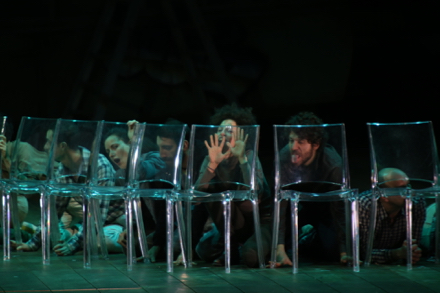
The Rhine, Act III
But it was far huger than these few props. The theater itself, its 1358 spectators were enveloped within the action, the foyers echoing with the fanfares, Hagen shouting insults seated in the tenth row, Gunther triumphantly dragging Brünnhilde down the center aisle onto the stage. And finally, in the end, we became aware that we were the Rhine itself, the ring thrown into our flood by the hoard lined across the stage apron, their suicide vests ticking.
Graham Vick totally humanized Wagner’s mythological compendium, Grane was a fine, strong young man with a chair onto which Siegfried mounted. During his orchestral journey to the Rhine the stage became flooded with innumerable strong, beautiful youth who moved with purpose and grace, the mighty Rhine, its mighty spirit. This was the truly sublime moment of the evening.
In the beginning the three norns had been seated at a table, the broken thread were the twigs of the ash tree that became the fuse of the bomb they constructed and placed in the backpack Siegfried picks up. At the end if Brünnhilde and Grane’s immolation was moving it was also equally terrifying as we understood that it was the same suicide that constitutes the final mass suicide image, Wagner’s sweet and beautiful music flooding into the bombers’ broad smiles — it was the ultimate Wagnerian irony.
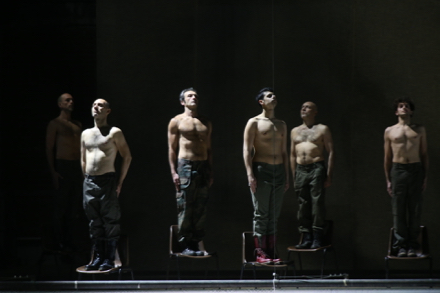
The hero horses on Valhalla
The spine tingling moment of the evening was however not the end of the opera, instead it was the visit of the Valkyrie Waltraute who tells Brünnhilde of Wotan’s council with his gods wherein he informs them that he has constructed the pire for Valhalla’s destruction, and that he has sent two ravens to bring news of the world below. Waltraute is elegant, her horse is a handsome young compassionate hero, her entreaties that Brünnhilde sacrifice the ring are maximally eloquent — fifty or so handsome young hero horses are suddenly revealed at rigid, bare chested heroic attention. But her supplications go unheeded thus she mounts her hero horse and disappears. It was the climatic scene of the evening.
Wotan’s ravens do appear in the world below, two black clad mimes in dark glasses who introduce the prelude to the third act. In the end Brünnhilde will dispatch them back to Valhalla. You know the rest.
Graham Vick’s mastery of theatrical languages in no less than astounding. His intuitions of the terrors of our present world and their connections to our artistic past are profound. The images he creates are not simple metaphors but remain rich poetic intuitions to be embraced rather than defined.
Wagner’s score and the individual performances were subsumed into this evening of powerful theater. If conductor Stefan Anton Reck’s tempos at times seemed slow they finally well served the staging. If the winds of the orchestra of the Teatro Massimo could not help bringing inappropriate lyricism to Wagnerian line, the brass and particularly the strings created the continuum that could be beautiful, inspiring and terrifying.
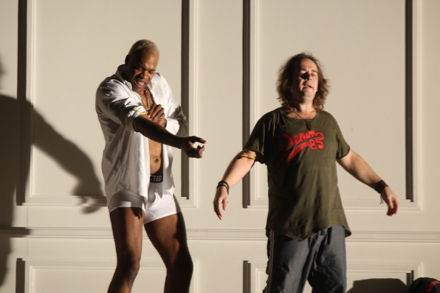
Eric Greene as Gunther and Christian Voigt as Siegfried becoming brothers
Without exception all performances were total. The three norns were of fine voice and fine figure, the Waltraute of elegant, high heeled Romanian mezzo Victoria Vizin, was superb. Swedish bass Mats Almgren created a rough, brutal Hagen and American baritone Eric Green was a beautifully voiced, sensitive and gullible Gunther. Danish soprano Iréne Theorin made Brünnhilde everything you wanted in thrilling Brigid Nilsson style delivery. German tenor Christian Voigt created a Siegfried more by intent than voice, but he did indeed embody a real Siegfried.
Cast and production:
Siegfried: Christian Voigt; Gunther: Eric Greene; Alberich: Sergei Leiferkus; Hagen: Mats Almgren; Brünnhilde: Irene Theorin; Gutrune: Elizabeth Blancke-Biggs; Waltraute; Viktoria Vizin; Erste Norn; Annette Jahns; Zweite Norn/Wellgunde: Christine Knorren; Dritte Norn/Woglinde: Stephanie Corley; Flosshilde: Renée Tatum; Ein Mann: Antonio Barbagallo, Gianfranco Giordano; Ein anderer Mann: Carlo Morgante, Francesco Polizzi. Chorus and Orchestra of the Teatro Massimo. Conductor: Stefan Anton Reck; Metteur en scéne: Graham Vick; Scene and Costume designs: Richard Hudson; Mimic actions: Ron Howell; Light designer: Giuseppe Di Iorio. Teatro Massimo, Palermo, February 2, 2016.
Lady Macbeth of Mtsensk in Lyon
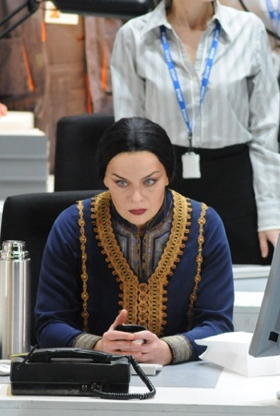
Ausrine Stundyte as Katerina Ismïlova
All photos courtesy of the Opéra de Lyon, copyright Jean-Pierre Maurin.
This nasty little opera evening in Lyon lived up to the opera’s initial reputation as pure pornophony. This is the erotic Shostakovich of the D minor cello sonata, it is the sarcastic and complicated Shostakovich of The Nose . . .
It is the brash, devil-may-care young Shostakovich (24 years old) who explodes in facile, brilliant music that sometimes may crash into the obvious but usually soars magnificently into the shimmering ethos of animal youth. Shostakovich’s music did indeed shine absolutely unfiltered through this sordid tale of desire in an ugly world.
At least this is the way director Dmitri Tcherniakov tells the story, making the Shostakovich score and conductor Kazushi Ono’s orchestra the protagonist of his staging, laying bare in 14 tableaux (the nine of the libretto plus the five musical interludes he staged as well) striking metaphors of this musical world, the mere facts of the libretto summarily sacrificed to the more powerful musical meanings of each of the scenes.
Tcherniakov boxed the nineteenth century world of an 1865 novel (à la Turgenev) of the libretto into the confines of a modern mechanized warehouse. Within the warehouse there was a love den box à l’orientale, and finally a grim, prison cell box. The action was not a narrative. It was fourteen boxes exploding in sexual acts and in brutal violence (think strong lights flashing, blinding you to what you knew was going on). This when the scenes were not sarcastic comments on the czarist Russian past, and surely the Soviet present as well.
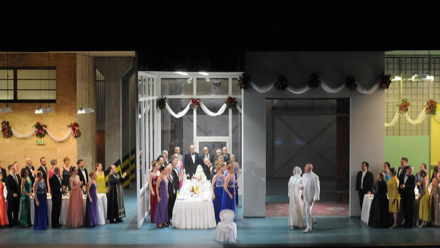
Tableau 8, the wedding
The bright acoustic of the Opéra de Lyon favored its splendid resident orchestral resources for this piece, unabashedly unleashed by conductor Kazushi Ono in a precise reading of the score, of particular note the huge role of Shostakovich’s clarinets not to mention the shattering, unimaginably loud orchestral and percussion climaxes that made Stalin wince leading to the first official denunciation of Shostakovich.
It was three and one half hours of blatant musical eroticism and brutality laid bare by Tcherniakov. The missing atmospheres of the natural world and the human narrative of its book however made the evening seem very long and sometimes even painful.
Katerina Ismailova (aka Lady Macbeth) was Lithuanian soprano Ausrine Stundyte who has performed this huge role in the Calixto Bieito production at the Berlin Volksoper (the mind boggles imagining what this may have been). There had been whispers that San Francisco Opera was going to mount a Christopher Alden production — a project evidently sacrificed to SFO’s anti-opera business model. Ms. Stundyte gave a total performance, moving from the obvious frigidity imposed on her life to the heated passions of her murder of her rival in the riveting penultimate scene. Three police thugs then attacked and killed her in the maximally violent (think loud) final scene.
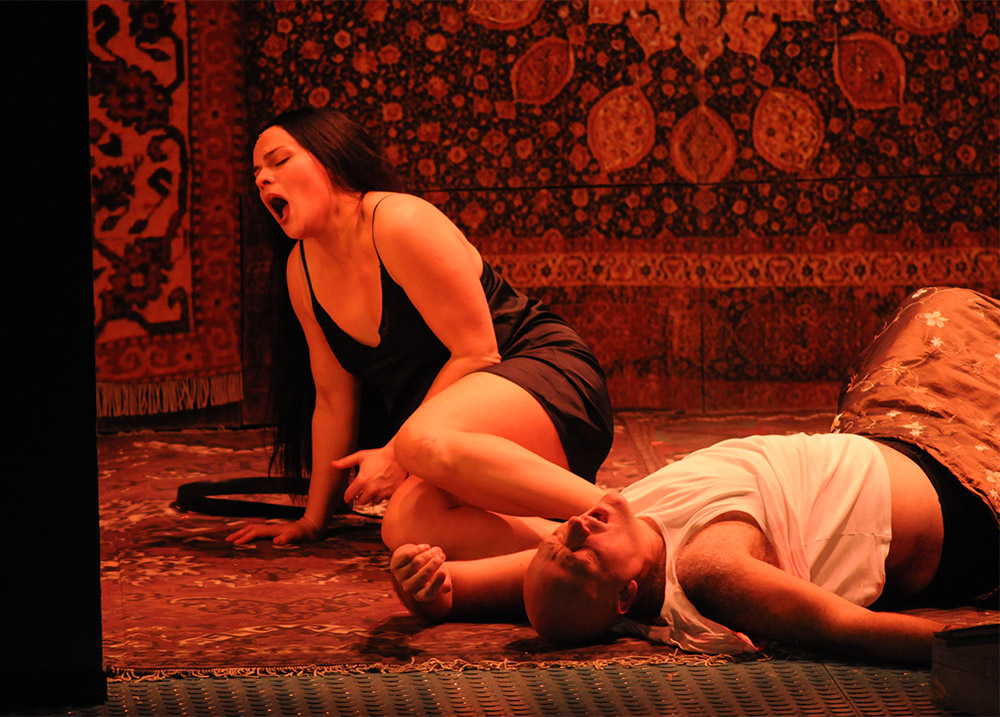
Ausrine Stundyte as Katerina, John Daszak as Sergei
The brutal tone of the production was established summarily by Katerina’s lover, Sergei, performed by the hulking body, shaved head and cutting voice of British tenor John Daszak (recently Loge in Bayreuth, and the Drum Major in Berlin). Sharply and urgently voiced Mr. Daszak was animal force and human cupidity personified. His too was a total performance, awarded by-the-way with less than appropriate applause at the curtain calls (at least it was not the outright hostility offered Tcherniakov’s equally unattractive Lady Macbeth [the Verdi soprano] at the Bastille a few years ago).
Russian bass Vladimir Ognovenko as the merchant and father Boris once again proved that there can be no Western substitute for a Russian bass. British tenor Peter Hoare convincingly portrayed Katerina’s impotent husband Zinoviy. All the supporting roles were cast with appropriately colored voices and personalities. This Lady Macbeth well sustains the Opéra de Lyon’s reputation as one of Europe's leading opera theaters.
Cast and production
Katerina Ismaïlova: Ausrine Stundyte; Boris Timoféiévitch Ismaïlov: Vladimir Ognovenko; Zinovy Boorisovitch Ismaïlov: Peter Hoare; Sergei: John Daszak; Le Pope / Un Vieux bagnard: Gennady Bezzubenkov; Le Chef de la police: Almas Svilpa; Le Balourd miteux, un ouvrier dépravé: Jeff Martin; Sonietka: Michaela Selinger; Aksinya: Clare Presland. Orchestre et Choeurs de l'Opéra de Lyon. Conductor: Kazushi Ono; Mise en scène et décors: Dmitri Tcherniakov; Costumes: Elena Zaitseva; Lumières: Gleb Filshtinsky. Opéra de Lyon, France, January 29, 2016.
The Fall of the House of Usher at San Francisco Opera
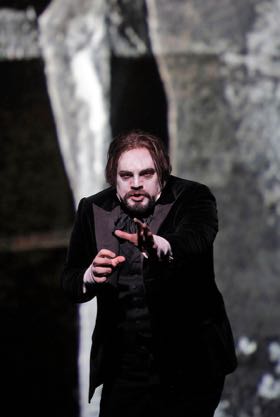
Brian Mulligan as Roderick Usher
All photos copyright Cory Weaver, courtesy of San Francisco Opera
It was a single title but a double bill and there was far more happening than Gordon Getty and Claude Debussy. Starting with Edgar Allen Poe.
The atmospheres of this famous short, deeply pseudo-psychological horror story were always present in vivid imagination even though they were seldom present in the War Memorial. The novella is that powerful. More than an artistic event it became a mental exercise in comparing Getty with Poe, Debussy with Poe and Debussy with Getty and fitting all this into the digital visual overload created by Swiss videographer David Haneke and English stage director David Pountney for the Welsh Opera in 2014.
While the Poe atmospheres oozed in and out of your mind the Getty Usher House, libretto by the composer, elaborated the Poe narrative into a complex plot woven by an evil scheming doctor who easily defeats a Poe sicko, his sick sister and his weird friend. Getty's music was much like recitative accompaniment though handsomely elaborated. It worked for a while.
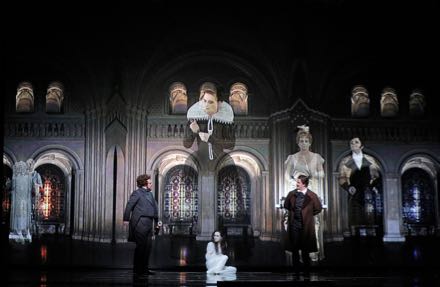
Brian Mulligan as Roderick Usher, Jamielyn Duggan (dancer) as Madeline Usher, Jason Bridges as the friend in Getty's Usher House
Gordon Getty is better known as a philanthropist of opera than as a composer of opera. Nonetheless Usher House is real music, and the opera was not without some splendid moments, notably the danced scenes.
Debussy on the other hand greatly simplified the Poe narrative for his Chute de la Maison Usher (libretto by the composer), elaborating its atmospheres with the grotto and cave vocabularies of Pelleas et Melisande. But Debussy does not nor could he have approached the twisted complexities of the tale's actors. He does masterfully build some of the House of Usher’s moods, and this alone brought great pleasure.
Debussy abandoned this, his last opera for undocumented reasons, may one surmise he sensed it was not worth finishing. But this mere sketch of an opera by one of the great composers of the early twentieth century makes it therefore of great intrinsic value. British musicologist Robert Orledge completed the opera for Debussy with such understanding and authority that you do not question its impression as pure Debussy.
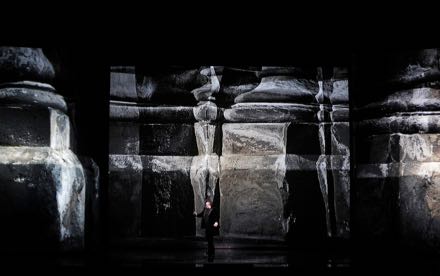
Brian Mulligan as Roderick Usher
Finally though the delicacies of the Poe malaise as respected by Getty and Debussy were bludgeoned by the huge size and overwhelming presences of the House of Usher itself, digital technology gone amuck on three huge screens that dwarfed the players. It is true that the monumental mysteries of the Usher mansion are the protagonist of Poe's tale but these are felt, sensed mysteries that were not manifest in the huge shapes of the constantly moving, precise particulars of English maybe Scottish gothic castles. There was not a whiff of Poe’s Boston or Getty’s Savannah, but there was a whole lot of video technology self congratulation.
Baritone Brian Mulligan sang Roderick Usher in both operas -- a tour de force well accomplished to say the least. Mr. Mulligan is a fine singer who is inexplicably and relentlessly overexposed to San Francisco audiences. He does not have the artistic stature to hold the stage for most principal roles much less the stature to hold our interest and respect for two and one half hours in this essentially one man show.
Jason Bridges was effective as Roderick’s friend Edgar Alan Poe (the novella’s narrator). The crucial role of the evil Doctor Primus was thrust upon first year Adler Fellow Anthony Reed who possesses a very fine bass voice. The role cried out for personality and presence well beyond the careful studio refinements of an Adler Fellow.
Conductor Lawrence Foster conducted this Robert Orledge completed version of the Debussy at the Bergenz Festival in 2006, perhaps explaining his presence in San Francisco. Within the covered acoustic of the War Memorial the fine SFO orchestra could not project the brighter colors of the Debussy score, colors that might have helped make the evening less dreary artistically.
Cast and Production
Roderick Usher: Brian Mulligan; Edgar Allan Poe: Jason Bridges; Madeline Usher / Lady Madeline: Jacqueline Piccolino; Madeline Usher (dancer): Jamielyn Duggan; Doctor Primus: Anthony Reed; Le Médecin: Joel Sorensen; L'Ami: Edward Nelson. San Francisco Opera Orchestra. Conductor: Lawrence Forster; Stage Director: David Pountney; Associate Director: Polly Graham; Choreographer ("Usher House"): Jo Jeffries; Production Designer: Niki Turner; Video Production Designer: David Haneke; Lighting Designer; Tim Mitchell; Lighting Supervisor: Benjamin Naylor. War Memorial Opera House, December 10, 2015.
Il barbiere di Siviglia at San Francisco Opera
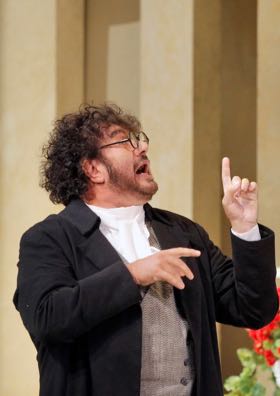
Andrea Silvestrelli as Basilio
All photos copyright Cory Weaver, courtesy of San Francisco Opera
There was a pre-curtain excited buzz, unusual these days, in the War Memorial Opera House. Word of mouth (and the major press) had spread the word — it’s a good show!
The Tuesday night audience was once the grand old, rich San Francisco, and maybe it still is. But this past Tuesday (December 1) the railroad magnates and oil executives seemed to have disappeared into a crowd of much younger dot-commers (there is a quite a dot-com explosion in San Francisco in case you hadn’t heard).
Some, maybe many of us were not so excited given that it was a mere two years ago that we were given this same production created by Spanish stage director Emilio Sagi. There were then some fine artists on the stage, and the pit was more than adequate. It was a good show, the best Barber I had ever seen.
Il barbiere is in fact a very difficult opera to pull off, and the 2013 Sagi production almost did.
Luckily for those dot-commers who somehow found themselves in the opera house, and for the die-hard opera audience this revival was an even better show, coming ever closer to really making the grand old comedy everything it can be — an elusive ideal to be sure.
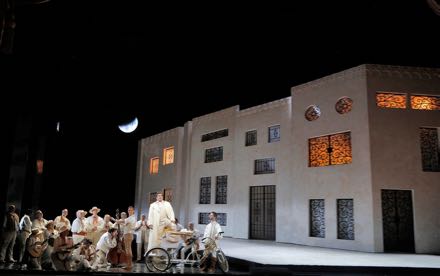
René Barbera as Almaviva
The star of the show is the set! Nothing more than a platform and a wall. These elements are basic comedy — the Roman street and the commedia dell’arte platform. This simplicity motivates the need for action and this makes comedy all about performance. It is a public place with a stage so let’s do a show!
This Barber was indeed about the comedians, each with his own abstracted comic personality, each with an individual swagger (Rosina’s outdid them all), each with their own silly schtick. They stepped on and off the platform reminding us that the opera is after all later-day commedia dell’arte, they played directly to the audience to get laughs and this meant much of the evening they were down stage center where all performers prefer to be.
The charm of each comedian was free to seduce the audience, and that they all did, silliness magnified by something as simple as body height. Almaviva and Don Bartolo are petite, Basilio towered over them, Rosina was slightly taller than Almaviva. All those provoked funny compromises in our perceptions of these archetypal comic characters.
Some of them could really sing! Texas tenor René Barbera had the most to sing, and sing he did, sailing easily into tenorino sphere when needed, cleanly executing coloratura (those exciting moments when there is so much excitement that musical line breaks into delirium). All this without losing a finely honed even sound. Exactly the same may be said of Argentine mezzo-soprano Daniela Mack, a former Adler Fellow, whose strong, lovely mezzo voice, beautiful high notes and solid diva confidence brought egotistical perfection to this Rosina.
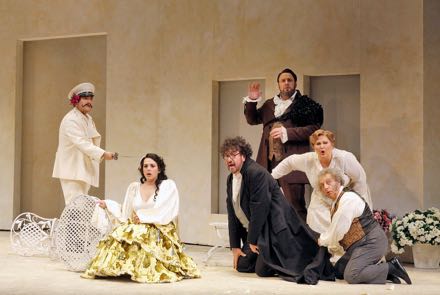
René Barbera as Almaviva, Daniela Mack as Rosina, Andrea Silvestrelli as Bartolo, Lucas Meachem as Figaro, Catherine Cooke as Berta, Alessandro Corbelli as Bartolo
Italian baritone Alessandro Corbelli, Don Bartolo, is a bel canto specialist. Though his voice is not large he used it with easy freedom as complement to genuine buffo acting. His rather soft, fast patter made me yearn for louder, even faster patter. Mezzo-soprano Catherine Cooke is one of San Francisco’s treasures, her Berta startlingly present and very well sung.
American baritone Lucas Meachem played Figaro with a certain charm, though I found his singing sloppy and his tone production irritatingly inconsistent. This may have been his idea of making Figaro an amusing character. Italian bass Andrea Silvestrelli is a fine comic performer who is vocally unsuited for Rossini roles. He is San Francisco Opera’s catch-all bass, one night the Night Watchman in Meistersinger, the next night Basilio, etc.
All this wonderful singing, and much of it high Rossini art, occurred because of the pit. Conductor Giuseppe Finzi somehow finding the real Rossini simply unleashed the joy of singing on the stage. From the overture to the finale this fine Rossini maestro never dropped the constant percolation and the easy boil of the Rossini musical continuum. We joyfully felt, obviously with him, the wonder of opera on the stage, and this does not happen very often.
The stage director of this revival of the Sagi production was Roy Rallo. The staging seemed greatly streamlined from the 2013 Sagi directed performances, the individual performances more vivid, the chorus and ballet more abstracted, and the bicycles and other post modern touches were less obtrusive. It was very effective comic staging (see above).
Casts and Production
Figaro: Lucas Meachem; Rosina: Daniela Mack; Cout Almaviva: René Barbera; Doctor Bartolo: Alessandro Corbelli; Don Basilio: Andrea Silvestrelli; Berta: Catherine Cook; Fiorello: Edward Nelson; Ambrogio: Efrain Solis; An officer: Matthew Stump. Chorus and Orchestra of the San Francisco Opera. Conductor: Giuseppe Finzi; Production: Emilio Sagi; Revival Director: Roy Rallo; Set Designer: Llorenç Corbella; Costume Designer: Pepa Ojanguren; Lighting Designer: Gary Marder; Choreographer: Nuria Castejôn. War Memorial Opera House, San Francisco, December 1, 2015.
Die Meistersinger at San Francisco Opera
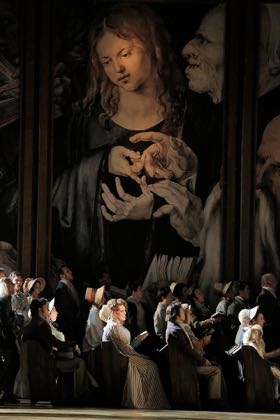
The San Francisco Opera Chorus, Act I
All photos copyright Cory Weaver, courtesy of San Francisco Opera
Falstaff and Die Meistersinger are among the pinnacles if not the pinnacles of nineteenth century opera. Both operas are atypical of the composer and both operas are based on a Shakespeare play.
Verdi looks ahead, Wagner looks back. It is hard to tell if the current production of Wagner’s Die Meistersinger von Nürnburg on the War Memorial stage looks forward or backward. Happily it is a return to an international production standard, increasingly rare at SFO, with British stage director David McVicar’s 2011 Glyndebourne version of Wagner’s masterpiece.
The conceit of the production seems to be that there are no cuts whatsoever to Wagner’s score. This resulted in an evening of five hours and forty minutes. Knowingly conducted by Mark Elder it did feel somewhat briefer than that, maybe like just about five hours. Still it was a long, very long evening.
This excellent conductor, once the music director of English National Opera, gave a firm, powerful and satisfying traditional hand to the famous overture, a tone that dissolved into a convincing lyricism that prevailed for the duration.
The David McVicar production was all about home-spun tradition, in fact the most moving moments of this lovely, emotional evening were Hans Sach’s admonition to Walther that he respect artistic tradition and Walther’s acquiescence to such respect.
As Wagner intended the philosophical and artistic meat of the opera was the shoemaker Hans Sachs. The real i.e. historical Hans Sachs shoemaker lived to the ripe old Renaissance age of 82, and there are those of us who remember the silver haired Hans Sachs of the four [!] SFO Meistersinger productions between 1959 and 1971. Just now the youthfulness of 43 year-old British baritone James Rutherford — an accomplished artist of wide expressive range — seemed at odds with the gravity we wanted and needed to award Hans Sachs for the first two acts.
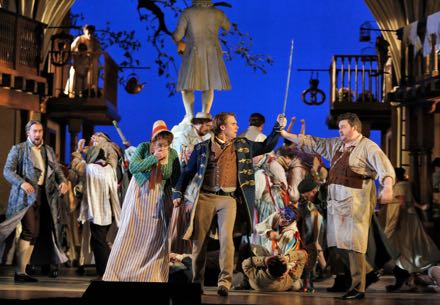
The Act III quintet
But with Hans Sachs extended soliloquy that dominates the first scene of the third act we entered into a real and tortured, not yet age-resigned psyche. As Hans Sachs uncovered and contemplated a portrait of his dead wife and child his conflicts gained an apparent philosophical realness that took us to the elusive, profound plane Wagner wished to achieve. This high minded angst then dissolved into the famous quintet, the love triangle (Sachs, Eva and Walther) holding hands with the lesser beings (David and Lene) in a simple, soft lyricism that forsook the musical gravity that should illuminate this magnificent moment and make it magical.
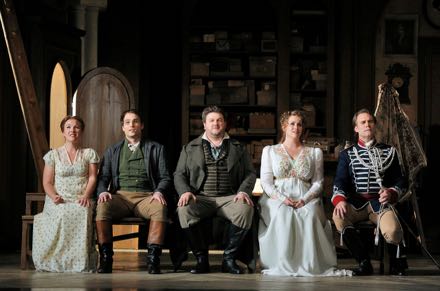
Ain Anger as Pogner, Rachel Willis-Sorensen as Eva, Brandon Jovanovich as Walther, James Rutherford as Sach
The McVicar production and the Mark Elder orchestra more than anything else worked to demystify Wagnerian thought and to quell Wagnerian rhetoric. Further example were the phenomenal complexities of mid-summer night riot chorus graphically reduced to a few dancers and children cavorting across the front of the stage, and as more example, the phenomenal choral complexities of the mid-summer day celebration graphically defined by three jugglers on stilts — fortunately the solidity of the musical preparation was not compromised by the fragility of the precarious balancing and juggling.
Director David McVicar’s slick stagecraft was always supported by conductor Mark Elder’s direct lyricism. As intended on the stage and from the pit the result was anything but intimidating and this despite the extraordinary length that was so wittily and unnecessarily imposed.
The production discretely toyed with Beckmesser, revealing but not dwelling on the famous anti-semitic polemic inherent to this opera. Here Beckmesser was superbly enacted by German baritone Martin Gantner who towed a very fine line between ridicule and caricature. Distinctly costumed in all-black he somehow evoked our sympathy within the larger warmth of the production. However at the end Beckmesser the Jew was left seated at the extreme edge of the stage, far from and pointedly exiled from the Wagnerian reconciliation of art and love.
San Francisco Opera’s casting perhaps inadvertently supported the home-spun nature of the production as it unfolded on the War Memorial stage. With the exception of the two baritones it was unpretentiously cast. Montana tenor Brandon Jovanovich was a vulnerable Walther whose prize song (“Morgenlich leuchtend im rosigen Schein") was just persuasive enough. Eva was sung by recent Houston Opera Studio graduate Rachel Willis-Sorensen whose tone I found shrill and whose vocal strength was not sufficient to hold together the quintet (not all my friends agree with me). Alek Shrader was vocally miscast though an exquisitely charming David while Sasha Cooke as Magdalene was vocally splendid. German bass Ain Anger as Eva’s father Veit Pogner added a further homey touch, his first act monologue shakily delivered.
It is a very great pleasure to hear San Francisco Opera’s fine orchestra and chorus in service to a fine conductor and a solid production.
Cast and Production
Hans Sachs: James Rutherford; Walther von Stolzing: Brandon Jovanovich; Eva: Rachel Willis-Sorensen; Magdalene: Sasha Cooke; David: Alek Shrader; Sixtus Beckmesser: Martin Gantner; Veit Pogner: Ain Anger; Fritz Kothner: Philip Horst; Kunz Vogelgesang: AJ Glueckert; Balthasar Zorn: Joel Sorensen; Augustin Moser: Corey Bix; Ulrich Eisslinger: Joseph Hu; Konrad Nachtigall: Sam Handley; Hans Schwarz: Anthony Reed; Hermann Ortel: Edward Nelson; A night watchman: Andrea Silvestrelli; Hans Foltz; Matthew Stump; An apprentice: Laurel Porter. Chorus and Orchestra of the San Francisco Opera. Conductor: Sir Mark Elder; Production: Sir David McVicar; Revival Co-Directors: Marie Lambert and Ian Rutherford; Production Designer: Vicki Mortimer; Lighting Designer: Paule Constable; Choreography: Andrew George. War Memorial Opera House, San Francisco, November 24, 2016.
The Magic Flute at San Francisco Opera
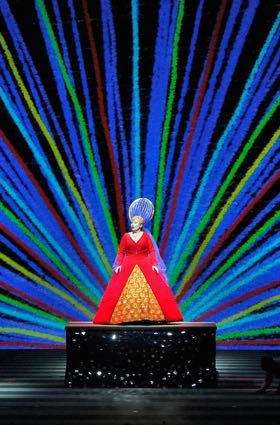
Albina Shagimuratova as the Queen of the Night
All photos copyright Cory Weaver, courtesy of San Francisco Opera
How did it go? Reactions of my neighbors varied. Some left at the intermission, others remarked that they thought the singing was good.
It was a remount of the Jun Kaneko production (a visual artist based in Omaha) that premiered only three and one half years ago (June 2012). All of us think that is way too soon for a repeat in an annual opera season of but nine operas. Back in 2012 the production boasted a plausible cast and conductor (see The Magic Flute in San Francisco) and was a qualified success.
Now, 2015, with the exception of veterans Monostotos Greg Fedderly and Queen of the Night Albina Shagimuratova (the usual minimal number of star turns San Francisco Opera deems necessary) it was a cast of promising young singers, some more promising than others, and some of little or no promise. At the performance I attended Mlle. Shagimuratova was said to be ill. Her replacement was a masters degree student at Florida State University, a touch that made the performance seem even more like a college workshop production.
Note that the very next night Mlle. Shagimuratova, a well known and experienced Lucia, replaced ingenue soprano Nadine Sierra for the final performance of that opera.
Make no mistake, there were some fine, youthful singers. However these were not performances by finished artists, evident not only in the voices but also in the stage comportment. This made what was perfunctory and clumsy staging seem amateurish.
The conductor was veteran maestro Lawrence Foster, now a regular in the south of France (Monaco, Marseille, Montpellier). His broadly orchestral reading was at odds not only with current Mozart performance practice but also with the expectations of these young singers, evident in the many stressed moments between pit and stage.
Note that both Mlle. Shagimuratova and Mr. Fedderly performed the same roles in 2012. It would have been interesting to observe other interpreters of these roles.
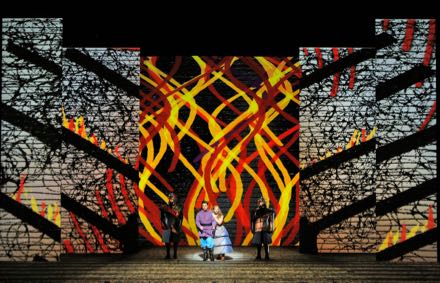
Paul Appleby as Tamino, Sarah Shafer as Pamina and the two Armored Men
The colorful, visual art (as opposed to theatrical) production was charming three years ago. Without the patina of slick performances from the stage and pit the constant visual stimulation of lines and colors was irritating rather than illuminating. The famous German libretto by Emanuel Schikaneder was rendered again in hokey contemporary American terms by San Francisco Opera General Director David Gockley, goosed up for this revival with even more topical references and jokes.
San Francisco’s opera audience deserves better. New audiences attracted to the opera house by this famous masterwork do know the difference. Just ask my neighbors.
San Francisco’s once venerable opera company has much catching up to do to again consider itself world class.
Casts and production information
Pamina: Sarah Shafer; Tamino: Paul Appleby; Papageno: Efrain Solis; Sarastro: Alfred Reiter; Queen of the Night: Kathryn Bowden; Monostatos: Greg Fedderly; First Lady: Jacqueline Piccolino; Second Lady: Nian Wang; Third Lady Zanda Svede; Papagena: Maria Valdes; Speaker: Anthony Reed; First Priest: Richard Walker; Second Priest: Richard Walker; First Armored Man Chong Wang; Second Armored Man: Anthony Reed; First Boy: Michael Sacco; Second Boy: Pietro Juvara; Third Boy: Nicholas Hu. Chorus and Orchestra of the San Francisco Opera. Conductor: Lawrence Foster; Stage Director: Harry Silverstein; Production Designer: Jun Kaneko; Lighting Designer: Paul Pyant. War Memorial Opera House, San Francisco, October 23, 2015.
Tannhauser und der Sängerkrieg auf Wartburg
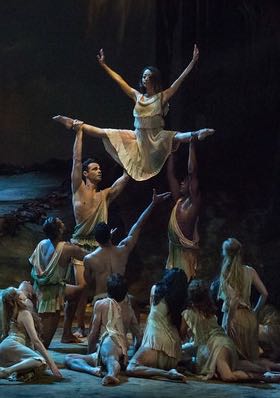
Venusburg Ballet
All photos by Marty Sohl/Metropolitan Opera
Ossia Tannhauser and James Levine with the Metropolitan Opera Orchestra.
This stellar evening was about this near legendary conductor and one of the world’s great orchestras. It was sophisticated music making that inhabited these first moments of the Wagnerian maturity. This musical illumination brought clarity, directness and purpose to Wagner’s obsession with art as the elixir of love and love as the elixir of art. Though more than anything else this performance whetted the appetite for the great Wagner — the musical sublimities of Meistersinger, the philosophic sublimities of Tristan.
The orchestral magnificence betrayed a musical carefulness that deprived the evening of a dramatic thrust that might have given real focus and meaning to the two deaths that brought the saga to an end and might have given deeper and more complex meaning to the opera. As it was Maestro Levine’s ending simply did not provide the momentous send off we would have wished for the tortured souls of Elisabeth and Tannhauser.
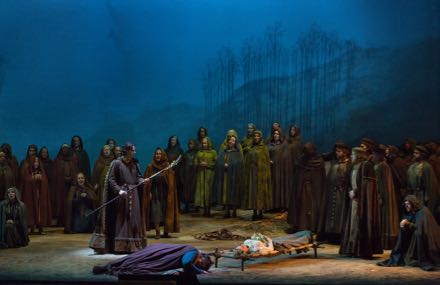
The deaths of Tannhauser and Elisabeth overseen by Wolfram (Peter Mattei)
Since it was conceived as a purely musical event the Met offered its 1977 production by German director Otto Schenk. This director remained a conservative force in those years of dramaturgical ferment, thus he made no attempt to interpret the story, nor any attempt to lay bare the intricacies of the opera’s meanings. His designer Günther Schneider-Siemssen painted drops that evoked the shapes and colors that must have pleased nineteenth century sensibilities as they did please the sensibilities of New Yorkers of the 1970’s (San Franciscans had moved on in those years).
For the Paris premiere of Tannhauser Wagner extended his original overture to transform itself into a magical realm of eroticism danced at the Met by eight strong ballerinos and eight fine ballerinas to the presumably original choreography of Norbert Vesak, well known as well to San Francisco Opera audiences of this epoch (see lead photo). Mr. Vesak typically provided big movement for big opera, and here offered as well absolutely breathtaking lifts (and lots and lots of them) to fill the Met’s gigantic stage.
The Met’s Venus was California mezzo soprano Michelle DeYoung, an early graduate of its Lindemann Young Artists program. Ms. DeYoung is of ample voice, and that seemed to be the criteria for the casting. This spectacular role profits from powerful artistic personality, a trait that Mme. DeYoung did not project.
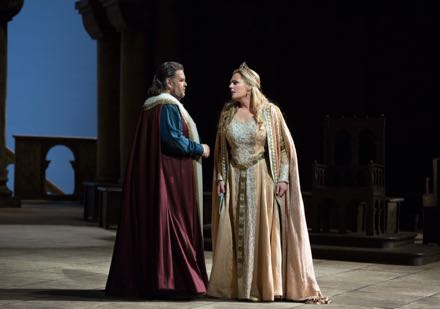
Johan Botha as Tannhauser, Eva-Maria Westbrock as Elisabeth
Elizabeth was sung by veteran soprano Eva-Maria Westbrock. Though no longer at vocal prime her mastery of the role and its stylistic demands was evident and satisfying. This alone certainly fulfilled Maestro Levine’s expectations notwithstanding her very wide tone — though she did manage it admirably.
Tannhauser himself was sung by South African tenor Johan Botha. He is in fine voice and a musically clean singer. Within the scope of the Met forces his voice may seem small, however it blossomed from time to time into richer sounds that sometimes shone in his emotional third act account of his trip to Rome.
The disappointment of the evening was the Wolfram sung by Swedish baritone Peter Mattei. This fine Mozart baritone seemed vocally over-parted, failing to sustain full tone over the longer Wagnerian phrases and in fact to fulfill the dramatic weight of this crucial role. His second act song to love was vocally unconvincing, and I feared he was going to lose his voice in his third act Song to the Evening Star. Evidently a Met favorite the audience did not seem to mind, awarding him the largest ovation given any of the singers.
Elisabeth’s father Hermann was ably performed by Austrian bass Günther Gröissbock. The remaining supporting male roles did not satisfy. Of particular note however were the beautifully pure tones of the page, soprano Ying Fang.
The performance belonged to the conductor, James Levine and the Met orchestra and it was indeed magnificent.
Cast and production information:
Tannhauser: Johan Botha; Elisabeth: Eva-Maria Westbrock; Venus: Michelle DeYoung; Wolfram: Peter Mattei; Hermann: Günther Groissböck; Walther: Noah Baetge; Biterolf: Ryan McKinny,; Heinrich: Adam Klein; Reinmar: Ricardo Lugo. Chorus and Orchestra of the Metropolitan Opera, New York. Conductor: James Levine; Production: Otto Schenk; Choreographer: Norbert Vesak; Set Designer: Günther Schneider-Siemssen; Costumes: Patricia Zipprodt; Lighting Designer: Gil Wechsler; Stage Director: Stephen Pickover. Metropolitan Opera, New York, October 15, 2015.
Lucia di Lammermoor at San Francisco Opera
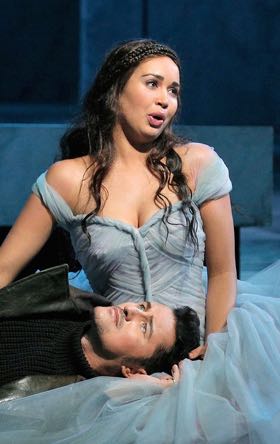
Nadine Sierra as Lucia, Piotr Beczaia as Edgardo
All photos by Cory Weaver, courtesy of San Francisco Opera
First it was Bulgarian soprano Sonya Yoncheva who cancelled in Zurich (no longer in her voice), then it was German soprano Diana Damrau who cancelled in San Francisco (too tired). Former Adler Fellow Nadine Sierra was poised to step into the bloodied costumes in both cities.
The young soprano paused a moment on the top of a glass skyscraper, then leapt to her death. All reports from the 1200 seat Opernhaus Zürich are that Mlle. Sierra’s mad scene was delightful and that she had effectively, if carefully negotiated the rest, and quite beautifully.
The world has awaited news about how this fine young (27 years) soprano would fare at San Francisco’s War Memorial Opera house, essentially three times the size of the Zurich house. The consensus is that Mlle. Sierra sang beautifully and held the stage. No small feat for an ingenue soprano, not yet a star.
That Mlle. Sierra did not take San Francisco by storm as she had Zurich (with reservations) is explained by two factors.
The first is that she was thrust into a hostile production, essentially a marble quarry when it was not the formalized architecture of Baroque opera complete with a scenic machine (the full stage show flat that was a camera shutter, astonishing because even though it was made of marble slabs it moved so smoothly and easily). But sometimes the setting was a marble knock off of Fritz Lang’s 1927 sci-fi film Metropolis. Every-once-in-a-while there were cameo’s of what were surely the crashing waves of the Pacific.
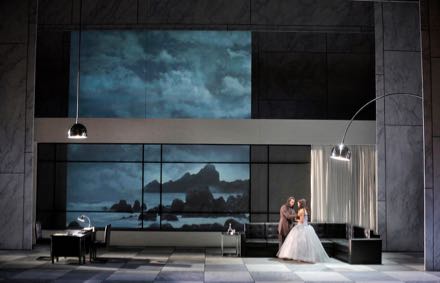
Nicolas Testé (Raimondo), Nadine Sierra (Lucia)
The beautifully wrought studio bel canto of a young singer did not have a chance as Lucia di Carrara (Italy’s famous marble quarry).
The second factor is the pit. Conductor Nicola Luisotti exploited every possible effect from his orchestra, effecting a bel canto competition between the stage and the pit. And too this maestro is known for controlling his singers, thus the stage often is merely an extension of the pit. Even the stage movement is controlled by Luisotti’s domination of his singers, as an example the mad scene was staged as a straight line moving straight upstage from the conductor podium.
Experienced singers — stars — are usually able to cope with this maestro, and sometimes a synergy is effected. Great things can happen. An ingenue artist has not yet absorbed the considerable presence needed to impose himself or herself on this maestro.
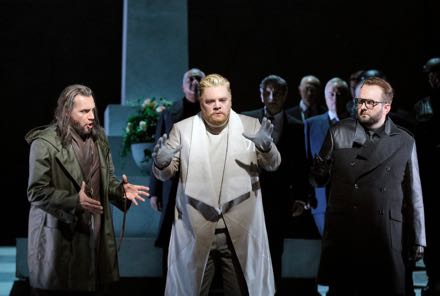
Nicolas Testé (Raimondo), Brian Mulligan (Enrico) and AJ Glueckert (Normanno)
Some of the singing in this Lucia was effective, notably baritone Brian Mulligan sang Enrico’s first act aria aria and cabaletta stylishly and convincingly. Mr. Mulligan is also singing Sweeney Todd where his cardboard acting works. And we also recently saw Mr. Mulligan as Marcello in Boheme (where it didn’t), and as Cassandra’s fiancé in Les Troyens, as Count Anckarström in Ballo, and the list goes on and on. One begs the question — is Mr. Mulligan the only baritone in the world? One shoe size does not fit all feet and one fine baritone voice does not fit all baritone roles. Finally Mr. Mulligan’s comic book Enrico did not survive the evening.
The one opera star in this Lucia was tenor Piotr Beczaia as Edgardo. While other critics found subtlety in his performance I found none. It was indeed loud enough to compete with the orchestra. This fine artist was perhaps a victim of the production as well. The final scene at the tomb of Lucia can be emotionally wrenching, one of bel canto’s most beautiful showpieces. Mr. Beczaia however stood in the marble box by the marble obelisk gave the maestro a run for his money.
Cast and production information
Lucia: Nadine Sierra; Edgardo: Piotr Beczaia; Enrico: Brian Mulligan; Raimondo: Nicolas Testé; Alisa: Zanda Svede; Normanno: AJ Glueckert; Arturo: Chong Wang. Chorus and Orchestra of San Francisco Opera. Conductor: Nicola Luisotti; Stage Director: Michael Cavanagh; Set Design: Erhard Rom; Costume Design: Mattie Ullrich; Lighting Design: Gary Marder. War Memorial Opera House, San Francisco, October 13, 2015.
Sweeney Tood in San Francisco
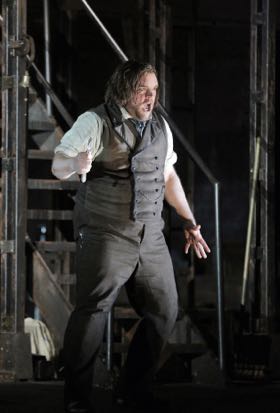
Brian Mulligan as Sweeney Todd
All photos by Cory Weaver / San Francisco Opera
Did the iconic “off-beat” and “serious” American musical hold the stage of the War Memorial Opera House? The excited audience (standees three deep) thought so and roared their appreciation.
This production by British stage director Lee Blakeley (same sets, costumes, stage direction) was originally done at Paris’ Théâtre du Chatelet in 2011. The Chatelet is a 2500 seat horseshoe theater that has hosted much revered and some esoteric music theater over the years, like for example Alfano’s Cyrano de Bergerac as a flashy vehicle for Placido Domingo that was brought to SFO. Director Blakeley in fact has staged four Stephen Sondheim musicals at the Chatelet — Sweeney Todd, Sunday in the Park with George, Into the Woods and A Little Night Music.
Chatelet productions are big and lavish and loved by Parisians.
The original Sweeney Todd 1979 Broadway production by Hal Prince was fairly modest with even a bit of avant-garde (for the time) theatricality, a reaction to the then customary razzle dazzle of musicals. The first opera company to take on Sweeney Todd was the Houston Opera in a Hal Prince production in 1984. This was the period when there was a concerted rapprochement of opera and musicals, Hal Prince directing a Madama Butterfly for Lyric Opera of Chicago in 1982, a production San Francisco Opera General Director David Gockley revived not so long ago in San Francisco.
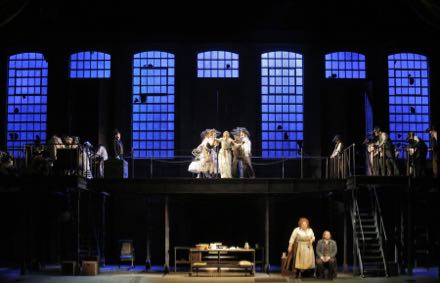
Production design by Tanya McCallin
Photo by Cory Weaver / San Francisco Opera
Hal Prince went on to stage Phantom of the Opera in 1986 and the bloated production scope of that show changed forever what we now consider a Broadway musical.
The 2011 Chatelet Sweeney Todd was big, and in San Francisco perhaps even bigger from the first moment when splendid digital technology recreated the huge acoustic of a pipe organ exponentially amplified to actually shake the War Memorial Opera House. And thus to get our attention in a reversal of the oft used theater trick of focusing attention ever smaller to make one aware of even the tiniest sound.
So we were warned that it was going to be a loud three hours in the opera house, and indeed it was. All the voices were hugely amplified thus creating an unrelenting loud, flat soundscape for the duration, embellished by some shattering electronic ringing when throats were slit. It was sometimes disconcerting when you were unable to place a voice you heard in the general sonic melee with a face you knew was somewhere — but where — on the stage.
Perhaps the orchestra sound was electronically manipulated as well, if so it will have served well to let us in on the subtleties of the orchestrations by Sondheim’s musical collaborator Jonathan Tunick, and onto the compositional complications that raise the level to what seems to be seriously sophisticated big music.
Biggest of all in San Francisco was the Sweeney Todd himself, baritone Brian Mulligan who is often miscast in secondary baritone roles at SF Opera. Here Mr. Mulligan fully inhabited the role wrenching every possible nuance within the limited emotional confines of the role and finally moved us. Equally big was the pie baker Mrs. Lovett, a star turn performance by veteran mezzo soprano Stephanie Blythe. Big is not the correct word — it was a huge performance in which her relish at pushing her chest voice was deliciously apparent.
The romantic lead Anthony Hope was sung by baritone Elliot Madore who knew how to take the postures of the cardboard musical comedy lover to the extremes of ardent, melodramatic (caricatural) proportion, and of course exactly the same may be said of Johanna, the damsel in distress, sung by soprano Heidi Stober.
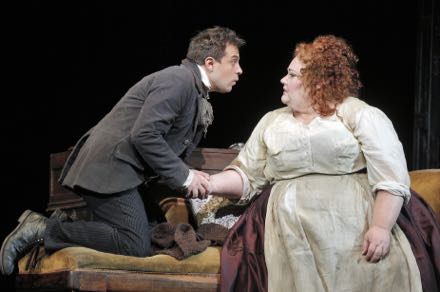
Matthew Grills as Tobias Rogg, Stephanie Blythe as Mrs. Lovett
Photo by Cory Weaver / San Francisco Opera
Of special interest was the role of Tobias Rogg sung by tenor Matthew Grills. He earned the biggest ovation, and it was huge, for his song “Not While I’m Around.” This song is the one moment in the musical where what might pass for real feelings or emotions seemed to enter the catalogue of occasions for a musical number. Mr. Grills sang it softly and sweetly indeed, and the human scaled volume seemed to say that he meant it.
The gamut of casting was perfect to voice and character. One wishes that this degree of care would extend itself to the casting of the operas at San Francisco Opera.
Houston Opera’s artistic and musical director Patrick Summers was in the pit, taking the orchestral proceedings very seriously indeed. Mo. Summers is a singers’ conductor, his care in supporting these opera singer artists in music that requires more conviction than technique contributed enormously to the success of their performances.
This day included the announcement of David Gockley’s former Houston Opera assistant Matthew Shilvock as the new General Director of San Francisco Opera. Mr. Shilvock has been a part of the San Francisco Opera’s administration during David Gockley’s entire tenure.
And thus the Houstonization of San Francisco Opera continues.
Casts and productionSweeney Todd: Brian Mulligan; Mrs. Lovett: Stephanie Blythe; Johanna: Heidi Stober; Beggar Woman: Elizabeth Futral; Anthony Hope: Elliot Madore; Adolfo Pirelli: David Curry; Tobias Ragg: Matthew Grills: Judge Turpin: Wayne Tigges; Beadle Bamford: A. J. Glueckert. Chorus and Orchestra of the San Francisco Opera. Conductor: Patrick Summers; Stage Director: Lee Blakeley; Production Designer: Tanya McCallin; Lighting Designer: Rick Fisher; Choreographer: Lorena Randi. War Memorial Opera House, San Francisco, September 23, 2015.
Luisa Miller in San Francisco
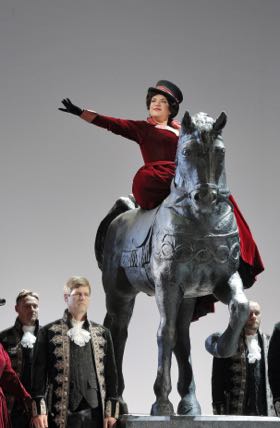
Ekaterina Semenchu as Federica
All photos by Cory Weaver / San Francisco Opera
Luisa Miller sits on the fringes of the repertory, and since its introduction into the modern repertory in the 1970’s it comes around every 15 or so years. Unfortunately this 2015 San Francisco occasion has not bothered to rethink this remarkable opera.
Remarkable because it is not the Giuseppe Verdi of his masterpieces, but it is a transitional Verdi who was leaving behind the blood and thunder of political strife to embrace the social tensions brought about by the revolutions of 1848!
Luisa Miller is a play by Friedrich von Schiller premiered in 1784, as was, by the way, Beaumarchais’ Le Mariage de Figaro — speaking of social tensions. Note that only later Schiller’s play was renamed Kabale und Liebe (Intrigue and Love), the title under which it is now obsessively studied as a theatrical masterpiece.
Luisa Miller by Verdi is not a theatrical masterpiece, nor is it even competent theater. Schiller’s dense play was reduced by Verdi’s librettist Salvadore Cammarano (who returns later this SFO season as the librettist of Lucia di Lammermoor) to a series of commonplace operatic situations that are easy to sing about but very hard to construe into a comprehensible story much less constitute a Figaro-like social document.
You do hear the Verdi of Traviata and Rigoletto, even some Boccanegra but mostly you hear the thunder of Nabucco, Attila and Macbeth (or maybe just now it was the conducting). It is music that in itself is foreign to the Verdi’s emerging dramatic interests, enthusiasms hardly supported by this poor libretto. Nonetheless it is Verdi and this a priori makes it great music waiting for a production that might at least try to make it make dramatic sense.
It is an essentially bel canto libretto thus Luisa Miller is about singing. Unfortunately the San Francisco Opera bar was set very high back in 1974 when Luisa was sung by Katia Ricciarelli (a prompter from La Scala was brought in for these performances remarked “che scuola! “ or “what stylish singing” about la Ricciarelli). Furthermore the Rodolfo was the young Luciano Pavarotti.
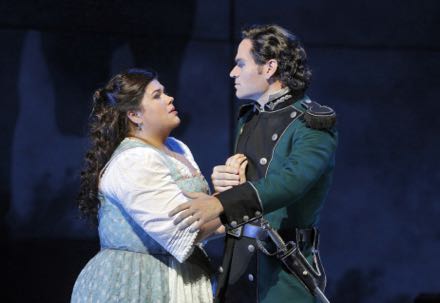
Leah Crocetto as Luisa, Michael Fabbiano as Rodolfo
For this Luisa Miller SFO cast its Verdi soprano prodigal daughter Leah Crocetto who acquitted herself very well and sang a quite beautiful “Tu puniscimi, o Signore.” Miss Crocetto has little spinto (push) therefore little drama in her voice, and I missed the soprano voice sailing over the top of the opera’s almost magnificent finales. Rodolfo aka Carlo was the Met’s prodigal tenor son Michael Fabbiano whose lighter lyric voice makes him choose his Verdi roles carefully. I would have wished for a somewhat larger and richer voice capable of more colors to relieve the vocal monotony of this long role.
Both Mr. Fabbiano and Miss Crocetto are fine, well prepared singers who embellish their performances with lots of acting. Here the acting seemed more like flailing as there was no apparent context. Ukrainian baritone Vitaliy Bilyy was Miller, Luisa’s father (in Schiller he is a musician, in Verdi an old soldier). Mr. Bilyy too is a quite fine singer who did only what he is supposed to do — sing! He offered little musical or dramatic personality, nor was any evidently expected or needed in this production.
Bass Andrea Silvestrelli sang Wurm who along with baritone Daniel Sumegi as Count Walter were the villains of the opera. Mr. Silvestrelli’s black colored voice and threatening presence have established him as the perfect Sparafucile (Rigoletto). As a bel canto villain I would have wished for a smoother, more beautiful voice. Russian mezzo-soprano Ekaterina Semechuk was the villainess Federica, the production itself made little demand of her and musically she was trounced by the conducting.
San Francisco Opera music director Nicola Luisotti was in the pit imposing his usual extreme tempos. He gave no freedom to his singers for stylistic expansion, thus he was free to drive his musical points, points that were in fact seldom singerly. As usual his finales were noisily magnificent, but by then it was hard to care.
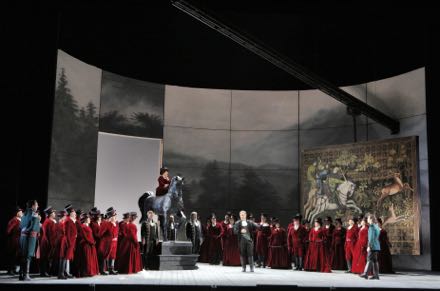
Production by Francesca Zambello, set design by Michael Yeargan
San Francisco Opera revived the fifteen year old production (2000) created by Francesca Zambello and designer Michael Yeargan. Both Mme. Zambello and Mr. Yeargan have had long careers in which they have perused virtually every passing fashion to the degree that it is hard to identify an individual style for either of them.
In the case of this Luisa Miller designer Yeargan created a hard edged, highly artificial environment in which Verdi attempts to challenge long established social mores. It is hard to know if the long, thin aluminum truss thrust towards the audience was the rigid arm of an antiquated social structure, or what. It is hard to know if the vertical and horizontal separations effected from time to time in the cyclorama were fissures that portended change, or what. The horse? It was all lovely to look at, but Luisa Miller is hardly a lovely opera.
Cast and production information:Luisa Miller: Leah Crocetto; Rodolfo: Michael Fabiano; Miller: Vitaliy Bilyy; Count Walter: Daniel Sumegi; Federica: Ekaterina Semenchuk; Wurm: Andrea Silvestrelli; Laura: Jacqueline Piccolino; Peasant: Christopher Jackson. Chorus and Orchestra of the San Francisco Opera. Conductor: Nicola Luisotti; Production: Francesca Zambello; Associate Director: Laurie Feldman; Set Designer: Michael Yeargan; Costume Designer: Dunya Ramicova; Lighting Designer: Mark McCullough. War Memorial Opera House, September 16, 2015.
Two Women in San Francisco
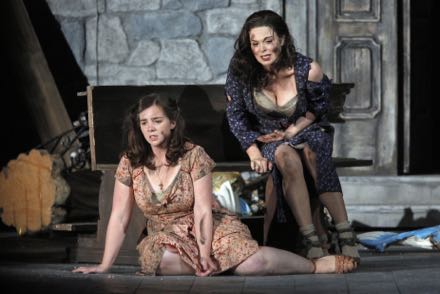
Sarah Shafer as the daughter, Anna Catterina Antonacci as the mother
Photo by Cory Weaver / San Francisco Opera
Why would an American opera company devote its resources to the premiere of an opera by an Italian composer? Furthermore a parochially Italian story?
Possible answers multiply. San Francisco Opera music director is the Italian conductor Nicola Luisotti who will have held sway. Perhaps San Francisco Opera concurs that it has not had success with its recent premieres by American composers so thinks a journey back to the wellspring of opera might be a good idea.
A further and more palatable idea is that Two Women is potentially a rare story that supports operatic treatment. It is, at least in the eponymous Vittorio De Sica film, a story that has not been artistically explored — the sharing of the sublimely delicate moment when a girl becomes a woman (well, let us forget Salome for the moment. The De Sica film explores this passage, this dramatic moment, in subtle and startling psychological terms laden in existentialism. The film is a masterpiece. Indeed ripe for opera.
The sound world of composer Marco Tutino supports such atmospheres. Tutino is a colorist who offers surprise after surprise in his score for Two Women, timbres that are hardly new — the bass clarinet for example — but were strategically placed to evoke heretofore unfelt sensations. Without creating an explicitly individual style Tutino avoids any derivative definition, though one might say that his conservative twentieth century sound has its roots in the verismo of Giordano but remains open to incorporating later techniques when called upon, like his very effective use of minimalism.
The opera Two Women or its Italian title La ciociara surely rides the coattails of the De Sica film so to be able to gain Italian and international attention. Comparison is therefore unavoidable, appropriate and in fact enlightening.
The De Sica film is derived from a novel, La ciociara (1957) by Italian novelist Alberto Moravia (Ciociara is a region of bleak and rocky hills south of Rome). Two Women was the title given the English language translation of La ciociara. The libretto for the opera Two Women is derived from a script by one Luca Rossi, it in turn derived from the Moravia novel.
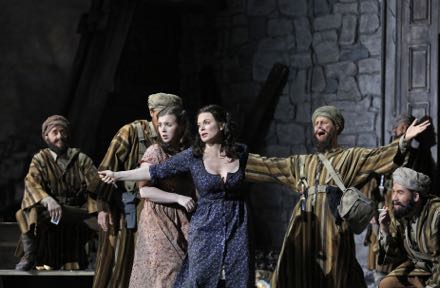
The two women and their Moroccan rapistsi
Photo by Cory Weaver / San Francisco Opera
Unlike the film which focuses on the complex psyches of the two women and absolutely nothing else the libretto delves into the Italian or rather human psyche that in wartime abdicates principle to collaborate with whoever or whatever is powerful at the moment. The libretto creates villains, from the Nazi commander to his local collaborators and to the Moroccan mercenary thugs who rape the two women. A powerful sense of evil is created that is pitted against the survival of the two women and their young male soulmate. That the daughter achieves womanhood in a singularly brutal fashion becomes the secondary, and less important story.
Though it is a thoroughly Italian event the only Italian in the cast was mezzo-soprano Anna Caterina Antonacci as the mother (who by-the-way gives Sophia Loren a run for her money as the costuming intends). Her daughter was sung by American ingenue soubrette Sarah Shafer. While vocally appropriate — a warm, lower voice for the mother and a higher, much brighter voice for the daughter — the two heroines were not physically matched, troublesome in the often cinematic circumstance of this production.
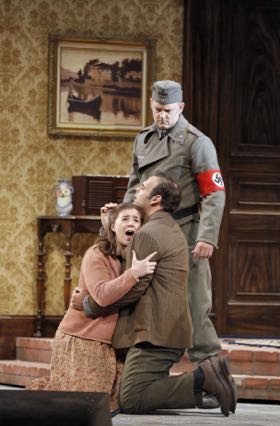
Sarah Shafer as Rosetta and Dimitri Pittas as Michele with Nazi soldier
Photo by Cory Weaver / San Francisco Opera
The young, pacifist school-teacher who infatuates both mother and daughter was sung by American tenor Dimitri Pittas (enough of a look-alike for Jean-Paul Belmondo from row P). The two villains were San Francisco Opera’s Scarpia, Mark Delavan as Giovanni and SFO’s Hoffmann villain, Christian Van Horn as the Nazi commandant.
Marco Tutino also created the libretto for his opera. It was staged by an all-American team (or at least all English speakers). The staging was a combination of cinematic scenes, docudrama of the advancing American forces in the liberation of Rome, the storybook fantasy of a verdant hilltop village in the arid region south of Roma as a sort of paradise, cut-out sets à la American musical and, yes, even moments of old fashioned opera.
The action unfolded in a series of vignettes that incorporated this potpourri of styles culminating in a complex, indeed impressive number (it is a numbers opera) where the action flip flopped between the rape of the women and the murder of Michele (the Belmondo role). Effective also was the scene of the Italian pop-crooner allowing composer Tutino to indulge in musical collage before he imagined a fairytale ending for his opera — a vision of the dead Michele walking toward the dream hilltop village.
The opening night audience accepted the opera as an old fashioned melodrama booing the villains, cheering the damsel (forgetting for the moment that she perhaps was not saved after all), and of course warmly thanking Mme. Antonacci and Mr. Pittas for ably holding their own against their cinematic competition (Loren and Belmondo). Comments overheard as the crowd left the theater were less enthusiastic.
As usual Maestro Nicola Luisotti forced his superb orchestra front and center, and it surely sang out all magic possible in Marco Tutino’s score. Interestingly and uncharacteristically the maestro allowed the singers to be actors in this drama rather than his musical puppets.
Said and done, the real opera remains the De Sica film. It creates one hundred minutes of pure lyricism, never descending to the cliches of movies or theater, or in the case of the opera Two Women to the cliches of musical theater.
Cast and production:
Cesira: Anna Caterina Antonacci; Rosetta: Sarah Shafer; Michele: Dimitri Pittas; Giovanni: Mark Delavan; John Buckley: Eddie Nelson; Pasquale Sciortino: Joel Sorensen; Fedor Von Bock: Christian Van Horn; Maria Sciortino: Buffy Baggott; Italian Singer: Pasquale Esposito; Country Woman: Zanda Svede; Old Woman: Sally Mouzon. Orchestra and Chorus of the San Francisco Opera. Conductor: Nicola Luisotti; Stage Director: Francesca Zambello; Set Designer: Peter Davison; Costume Designer: Jess Goldstein; Lighting Designer: Mark McCullough; Projection Designer: S. Katy Tucker. War Memorial Opera House, San Francisco, June 13, 2015.
Les Troyens in San Francisco
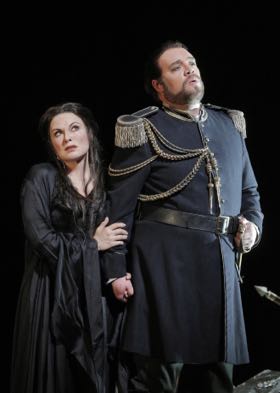
Anna Caterina Antonacci as Cassandra, Brian Mulligan as Coroebus
Photo by Cory Weaver / San Francisco Opera
Berlioz’ Les Troyens is in two massive parts — La prise de Troy and Troyens à Carthage.
Often these days the two parts are separated by a break of a couple hours thus enabling an audience to transcend the horror of the Trojan slaughter before settling into the beatific idyll of Dido’s Carthage and the fervors of founding Rome.
No such good fortune in San Francisco. It was done as one long moment, over five plus straight hours, its temporal monumentality forced into a single span of unrelenting musical and dramatic intensity. The action was so tightly drawn that British director David McVicar forced Susan Graham’s Dido to stand before a naked black stage curtain to deliver her impassioned adieu to Carthage (while her pyre was rolled onto the scene behind the curtain) — no pause before immediate immolation.
There was not a moment to be wasted in the race to the end.
On good days conductor Donald Runnicles brought the show in at just under five hours.
The McVicar production can indeed boast theatrical efficiency. It was all effected in front of a massive amphitheater shape set, its convex face apparent for Troy, its concave face exposed for Carthage. Both sides of the scenic unit were tiered so that the choristers could be deployed on the structure almost concert style gracefully eliminating the problem of how to stage the massive choruses.
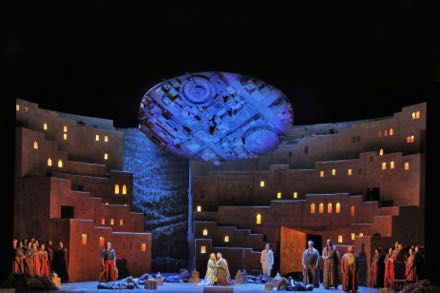
The garden (Act IV)
Photo by Cory Weaver / San Francisco Opera
Carthage was first a floor placed oval platform of miniature buildings on which McVicar’s signature male acolytes cavorted. The platform was tilted on its side and raised high, moonlike (deep blue light) for the garden, and then split, its halves moving to the sides of the stage when the love affair fell apart.
No stranger to heroic proportions the production designer, Es Devlin designed the closing ceremony of the 2012 London Olympics and will design the opening ceremony of the 2016 Rio de Janiero games. Maximum of effect with a minimum of means (someone mentioned there are 35 tons of Trojans scenery). Not to be confused with minimalism.
The McVicar direction was absolutely straightforward. The action was exactly the old story and exactly the music, like the choristers raining confetti onto their queen at the precise moments the Berlioz music spilled into momentary ecstasies. We were simply swept along by the action, no roadblocks to the inexorable destruction of a queen and her city.
Strangely the gigantic Trojan House head was made of bits of industrial revolution detritus plus a Greek shield or two, as was the gigantic torso of Aeneas that would one day squash Carthage. Dress was nineteenth century (a bewildered audience member was overheard explaining that maybe this was because there are a lot of nineteenth century operas so San Francisco Opera has a lot of old costumes that could be used).
If there was a concept besides theatrical efficiency it was not discernible. The McVicar production was heavy on solutions for easy story telling and quick scene changes. These solutions did make those five hours fly by with not a lot to think about!
Berlioz was left in the dust. Berlioz is an iconoclast, a misfit, a dreamer, an egomaniac, and of course a genius. His music is at once naive and brilliant. He absorbed Gluck and Beethoven making them uncomfortable partners. He could write meltingly beautiful music and at the same time relish in pushing harmonic rhythms beyond academic acceptability. It is not easy music.
Furthermore and by the way his estranged wife was an English Shakespearean tragedienne, he detested Rome as much as he detested (and was detested by) the operatic establishment.
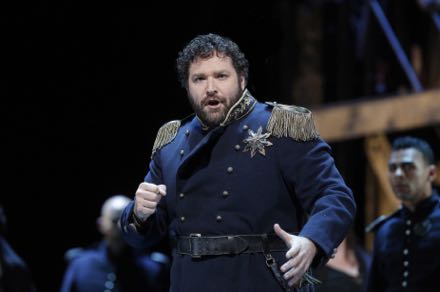
Bryan Hymel as Aeneas
Photo by Cory Weaver / San Francisco Opera
There were many, many fine performances (it is a huge cast) in this San Francisco edition, certainly beginning with the conducting of Donald Runnicles who carefully, even too carefully integrated his musical flow into the slick McVicar storytelling. There was wonderfully direct communication and understanding between the stage and pit in measured — huge or intimate as needed — never unleashed musicality.
Italian mezzo soprano Anna Caterina Antonacci created a riveting Cassandra at the San Francisco premiere, her voice lying comfortably in the role, no hint of the careful control she exerts in creating her higher Gluck heroines, rather she was a beautiful, human Cassandra in warm, strong and open tone and in honest, agonized posture. This made her love duet with her husband-to-be Coroebus, sung by Brian Mulligan, the most splendid moment of these performances. Baritone Mulligan, a catch-all San Francisco Opera regular, here found a role where his voice flowed in quite beautifully smooth, French colored tones, his persona constrained in mannered postures consistent with this brief and sad final encounter with his fiancé.
At the second performance one week later the role of Cassandra was taken by American soprano Michaela Martens. She is known to broader audiences for brilliantly portraying the passivity of Marilyn Klinghoffer both at ENO and the Met. A fine singer with a sizable voice (and career) she does not have the persona or experience to embody this epic character role, begging the question why she was cast.
There is no question that the role of Aeneas currently belongs to American tenor Bryan Hymel. He is handsome and heroic, his voice lies perfectly in the French heroic style pioneered by Berlioz. He has a sound that is uniquely French (he is from New Orleans) the strength of voice to portray a hero, a top that is open, secure and thrilling. Most of all he exudes youth and discovery creating an Aeneas who is emotionally connected to discovering love and discovering the world.
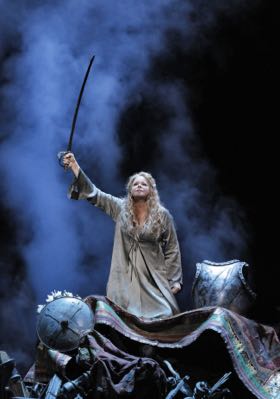
Susan Graham as Dido
Photo by Cory Weaver / San Francisco Opera
Esteemed American mezzo Susan Graham donned the long blond tresses of the tragic queen Dido. Mme. Graham is an exquisite singer, able to elegantly carve the ecstatic and desperate outpourings of this unfortunate, operatically over-exposed queen. Mme. Grahams’ Dido was sculpted art. It was not Dido the tragic queen.
The expanded San Francisco Opera Chorus was magnificent, as prescribed. Operatic ballet is famously maligned (remember the ballet in Samson et Dalila?). Here, if ever, operatic ballet has been exonerated. Sixteen dancers superbly executed the original Covent Garden Broadway style choreography by Lynne Page.
Cast and production
Cassandra: Anna Caterina Antonacci (June 7); Cassandra: Michaela Martens (June 12); Dido: Susan Graham; Aeneas: Bryan Hymel; Ascanius: Nian Wang; Anna: Sasha Cooke; Coroebus: Brian Mulligan; Narbal: Christian van Horn; Pantheus: Philip Horst; Iopas: Renè Barbera; Helenus: Chong Wang; Hylas: Chong Wang; King Briam: Philip Skinner; Queen Hecuba: Buffy Baggott; The Ghost of Cassandra: Buffy Baggott; The Ghost of Hector: Jordan Bisch; Greek Captain: Anthony Reed; Trojan Soldier: Matthew Stump; Trojan Chief: Jere Torkelsen; Andromaque: Brook Broughton; Polyxena: Rachel Speidel Little. Orchestra, Chorus and Ballet of the San Francisco Opera. Conductor: Donald Runnicles; Production: David McVicar; Stage Director: Leah Hausman; Choreographer: Lynne Page; Set Designer: Es Devlin; Costume Designer: Moritz Junge; Lighting Designer: Wolfgang Göbbel. War Memorial Opera House, San Francisco, June 7 and June 12, 2015.
La bohème in San Francisco
First Toronto, then Houston and now San Francisco, the third stop of a new production of Puccini's La bohème by Canadian born, British nurtured theater director John Caird.
Mr. Caird is a very skilled director of theater and music theater. He is well credentialed in opera in Britain with productions at Welsh National Opera, his U.S. opera credits are productions at Houston Opera that have or will tour to other U.S. opera houses. Let us not overlook the Siefried and Roy show in Las Vegas (1991-2004).
Mr. Caird has created a slick, intelligent and successful production of La bohème. Typical of theater directors staging opera he has endeavored to keep the dramatic pace of the opera moving along, accelerating pace whenever possible. Scene changes are quick, intermissions are short, bows are choreographed. This with the apparent assumption that theater audiences need to keep their minds involved and music theater audiences need to keep the beat.
The opera audience has been conditioned over the past 300 years to stop time, to forget the story and sink into the elaboration of an emotion. So maybe for some of us in the War Memorial this Boheme seemed rushed and over-produced, even seemed condescending with lighting effects that were too obvious (as if we were incapable of feeling the music without its help).
Not even Rodolfo’s final cries were left as pure emotion — as the curtain fell on the dead Mimi he we see him transform the moment into words. We needed not feel the tragedy of this moment because it had become mere art — a tricky conceit. Maybe this Boheme was not for us, but for a music theater audience.
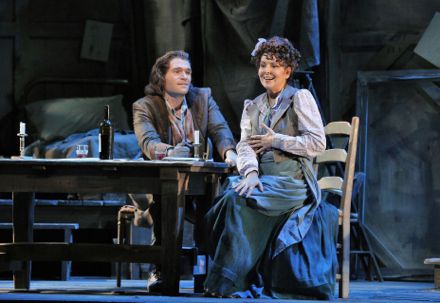
Michael Fabiano as Rodolfo, Alexia Voulgaridou as Mimi
Photo by Cory Weaver / San Francisco Opera
Mr. Caird’s astutely perceived La bohème as four character sketches — the garret, the cafe, the square, and the death. In fact Marcello, an artist as well, is busily sketching the dead Mimi when the curtain falls. Each setting is created by a collage of canvas paintings (images of rooms and buildings). The colors and costumes were in the warm palate of late nineteenth century naturalistic painting. Scene changes were a vista, stagehands visible in a slick bow to Brechtian dogma (with no hint of advocacy). It was meant to please a broad audience and it did.
Finally though none of this mattered. The November 19 performance was memorable because of riveting performances by American tenor Michael Fabiano as Rodolfo and Russian baritone Alexey Markov as Marcello. Tenor Fabiano boasts the clean musicianship of his American training, and an innate sense of Italian line unaffected by mannerism. He made Puccini into heroic bel canto that fully satisfies verismo. Mr. Fabiano is a natural actor, his moves at once incorporating the physicality of singing with the emotive enthusiasms of a young poet.
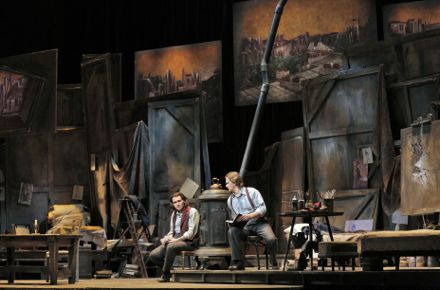
Michael Fabiano as Rodolfo, Alexey Markov as Marcello
Photo by Cory Weaver / San Francisco Opera
Michael Fabiano as Rodolfo, Alexey Markov as Marcello
Though of Russian formation much the same can be said of baritone Markov whose Slavic colored voice added an international exoticism to this young painter as well as specific flavor to the Parisian ambiance. Both Fabiano and Markov have strong, focused, beautiful voices that sailed across the orchestra. These artists in fact provided the musical determination for the performance far more than did the leadership, or lack of, from the pit.
The November 19 Mimi was Greek soprano Alexia Voulgaridou. The internet offers no birthday for Ms. Voulgaridou and it would not matter except that her voice betrayed the mannerisms of a singer no longer in the bloom of youth, or in bloom at all, and you wondered why she was cast as Mimi. Was it the spate of Toscas she undertook in 2013 (even though Tosca and Mimi are completely different voices)? But these Toscas seem to have worn her out and have encouraged her to fall back on generic (stock) opera singer moves and gestures.
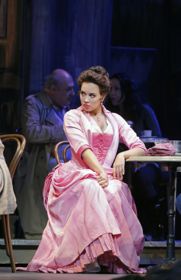
Nadine Sierra as Musetta
Photo by Cory Weaver, San Francisco Opera
The November 19 Musetta was former Adler Fellow Nadine Sierra. She was a far more youthful Musetta than you would expect to see on a major stage, and of much lighter voice (she is a lyric coloratura). This fine young artist made Musetta memorable, her coquettishness absolutely convincing while she carved out director Caird’s imaginative new antics to “Quando men vo soletta per la via.” These antics however forced an unnaturally slow tempo that would challenge even a much larger voice.
On November 20 the Mimi was former Adler Fellow Leah Crocetto. She sings beautifully, but physically she is not appropriate to embody a consumptive heroine. You wondered why she was cast. Italian tenor Giorgio Berrugi sang Rodolfo. This young tenor with a good sound has unfortunately absorbed many mannerisms that associate him with proverbial Italian provincial opera. Soprano Ellie Dehn sang Musetta. She is a San Francisco Mozart heroine (Countess, Donna Anna, Fiordiligi) who could not possibly make the transition from stately womanhood to this coquettish character role. San Francisco Opera regular, baritone Brian Mulligan was Marcello, a fish-out-of-water as well.
Colline, Schaunard, and Benoit/Alcindoro were the same singers for both casts. Christian van Horn is San Francisco Opera’s catch all bass, one night Alidoro in Cenerentola, the next two nights Colline, then back to Alidoro. While a competent performer he does not approach the depths of character that these smaller but crucially important roles require.
The conductor was San Francisco Opera’s resident conductor Giuseppe Finzi. With the help of messieurs Fabiano and Markov he carried off November 19 honorably. On November 20 he could not bring the cast to musical cohesion. At both performances I longed for a conductor who felt verismo, not simply a maestro to accompany, or try to, the singers. Follow this link for an account of a performance by such a maestro: La bohème at San Francisco Opera.
Casts and Production Mimì: Alexia Voulgaridou; Rodolfo: Michael Fabiano; Musetta: Nadine Sierra; Marcello: Alexdy Markov; Colline: Christian van Horn; Schaunard: Hadleigh Adams; Benoit/Alcindoro: Dale Travis. Alternate cast: Mimì: Leah Crocetto; Rodolfo: Giorgio Berrugi; Musetta: Ellie Dehn; Marcello: Brian Mulligan. San Francisco Opera Chorus and Orchestra. Conductor: Giuseppe Finzi. Stage Director: John Caird; Production Designer: David Farley; Lighting Designer: Michael James Clark. War Memorial Opera House, November 19/20, 2014. Seats row M).Cenerentola in San Francisco
The good news is that you don't have to go all the way to Pesaro for some great Rossini!
It was a rare evening, very rare, at San Francisco Opera when everything, almost everything, went together perfectly.
La cenerentola is Rossini’s most complex, and certainly greatest comedy. The competition is stiff indeed — L’italiana in Algeri (1812), Il turco in Italia (1814) and Il barbiere di Siviglia (1816). What separates Cenerentola (1817) and puts it way out front is the sheer size and number of its ensembles, big concerted pieces with four, five and six-voices, sometimes with chorus as well. These are the hallmarks of the great tragedies that begin with Otello (1816), the opera composed by Rossini immediately before Cenerentola.
Both Armida (1817), the tragedy written immediately after, and Cenerentola end with a huge showpiece aria for the prima donna. These years are the mature Rossini who demands big, virtuoso singers, like Cenerentola whose bravura alone must be sufficient to close the show and bring the audience to a level of delirium that made Rossini the most famous opera composer in the world.
Virtuoso singing and the sculpting of the highly sophisticated musical architecture of the arias and ensembles are the challenges of this great comedy, both challenges well met just now in San Francisco.
Conductor Jesús López-Cobos made a wunderkind debut at San Francisco Opera in 1972 at the age of thirty-two, and returned for the fall 1974 season, again for more of the big Verdi repertoire. Now, after an absence of forty years, he is back on the podium, a master of what some of us believe to be the epitome of what opera can be — the mature Rossini! The Rossini ethos is also the most delicate of all the great composers and it is sublime when it is revealed. This is very rare.
Conductor López-Cobos immediately took Rossini’s overture to the lightest boil. It was the bubbling of the tiny drops of the finest mineral water and the fleetness of a long distance runner, and it kept us there for the duration. In a Rossini tragedy the delight would be the suspension of time into pure lyricism (you forget to breathe), and the sheer joy of releasing emotion, tragic though it may be. In a comedy, you found a smile on your face, your foot marking the beat. Sheer delight. In Rossini, comedy or tragedy, it is the same music and the same joy of making that music.
The Lópes-Cobos tempos and his flights of Rossini’s sophisticated instrumentation were never indulged for effect. For example the patter pieces (when a male voice breaks into rapid words) did not so much amaze us with lightning speed as they amused us with rhythmic words. The ensembles never lost their individual voices by accelerandos intended to drive us to musical fulfillment, instead we remained immersed in the complexities of the ensembles. It was measured conducting that at once reconciled Rossini with his music and Rossini with the singers provided by San Francisco Opera.
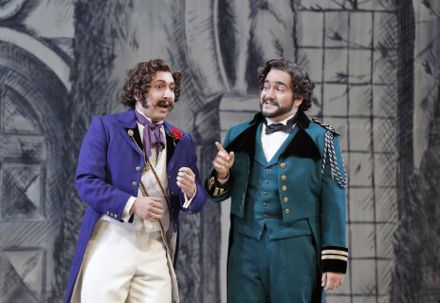
Efrain Solis as Dandini, René Barbera as Don Ramiro
Photo by Cory Weaver / San Francisco Opera
An announcement was made that French mezzo soprano Karine Deshayes was not feeling well and would not be at her best. As it was Mlle. Desayes displayed a reserved temperament and presence that left Cenerentola colorless for most of the evening. In the spectacular finale to the opera, “Non piu mesta” she did vocally approach the needed Rossini vocal excitement if not the personality. Had she not been indisposed perhaps her high notes would have been integrated into the smoother sounds of her lower voice.
Cenerentola’s father, Don Magnifico, was sung by Spanish bass-baritone Carlos Chausson. A seasoned interpreter of Rossini roles he was perfection itself in the delivery of this role as generic buffo. Bass-baritone Christian Van Horn, perfunctorily and colorlessly (fault of the staging) enacted Alidoro, the facilitator of the familiar story.
Young Texan tenor René Barbera made a splendid prince aka Don Ramiro in beautiful, smooth voice throughout the role’s very high tessitura. He delivered his big second act cabelletta “Si, ritrovarla io giuro” with the voice and personality that have made him the winner of vocal competitions and with high C’s to spare.
Among San Francisco’s great treasures are the Adlers. These young singers are usually the messengers and maids in the grand repertoire, and sometimes are over-parted in important roles. In this Cenerentola production they were utter perfection as Dandini and the ugly step sisters Clorinda and Tisbe. Both Maria Valdes and Zanda Svede made these minor roles (only Clorinda has a very brief aria) into scene stealing roles with the help of their stage director, Gregory Fortner.
But the biggest star of the evening (and it was a stiff competition) was California baritone Efrain Solis as the prince’s servant Dandini. This young singer exuded the charm, pent-up fun and exuberant singing that will make him a Rossini star. The cherry-atop-the-cake was the physical resemblance of Dandini, the servant, to Don Ramiro, the prince whom he was impersonating.
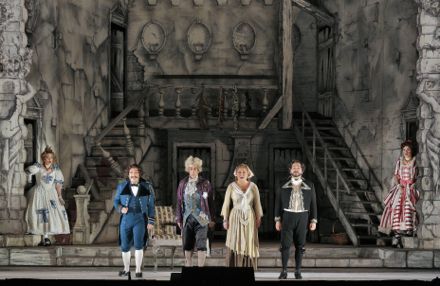
Production by Jean-Pierre Ponnelle
Photo by Cory Weaver / San Francisco Opera
In its heyday San Francisco Opera not only discovered Jesus Lopez-Cobos but also Jean Pierre Ponnelle, a young French scenographer who revolutionized San Francisco’s idea of what opera production could be. This brilliant designer turned stage director created this production of La cenerentola for San Francisco Opera back in 1969 — forty-five years ago! Its black and white, pencil drawn filigree and apparent architecture (cross-section of a multi-storied house) make it both storybook and physically tangible. It is self-consciously old and that alone made it new back in the ’60’s. More importantly its decor is integrated into action — the actors climb throughout the set — it was opera as scenographic action, not just singing.
The limitation of the Ponnelle set is however its symmetry, and it is stifling. The larger Rossini repertory was just being re-discovered back then. Since then Rossini performance practice has evolved to understand and embrace the structural complexity of these works. A mise-en-scène now must incorporate the musical score as a physical and intellectual component of the staging. This can be accomplished by imposing concept and shape as powerful as the music — strength of concept is no longer perceptible in this antique production.
Jean-Pierre Ponnelle who died in 1988 has long since not been a part of his production. It has been staged in recent revivals by Gregory Fortner who has staged this gifted cast in San Francisco as well. One assumes he kept the basic outlines of the original staging, respecting the symmetry of the set. He certainly will have added clever schtick to keep the action energized and to showcase his performers.
It is time to memorialize the Ponnelle production in photographs and move on to productions consistent with current performance practice.
Cast and ProductionCenerentola: Karine Deshayes; Don Ramiro: René Barbera; Dandini: Efrain Solis; Don Magnifico: Carlos Chausson; Alidoro: Christian Van Horn; Clorinda: Maria Valdes; Tisbe: Zanda Svede. San Francisco Opera Chorus and Orchestra. Conductor: Jésus López-Cobos. Production: Jean-Pierre Ponnelle; Stage Director: Gregory Fortner; Lighting Designer: Gary Marder. War Memorial Opera House, San Francisco, November 13, 2014. Seats: 11th row house left.
Dido and Aeneas and Bluebeard’s Castle in Los Angeles
Henry Purcell’s Dido is a splendid little opera. Barrie Kosky’s Dido is a splendid little theater piece.
Add Australian born, German nurtured director Barrie Kosky to Bela Bartok’s Bluebeard and you have a masterpiece of opera theater.
It is kinky art, where less is more and more is more. Among the kinkier elements were the three witches who foiled Dido’s consuming love for Aeneas — three full figured, bearded, black-American counter tenors who leapt on and off the long bench that traverses the stage hiking up their skirts to expose their hairy legs. It was an astonishing bit of casting by L.A. Opera.
The contemporary 20 maybe 30 something Dido (Irish soprano Paula Murrihy from the Frankfurt Opera) seemed not to have much to say, seated usually at a far edge of the stage-wide bench. Aeneas seemed to be an uninteresting fraternity boy who actually sings quite well (Liam Bonner, L.A. Opera’s recent Billy Budd) who slammed the door (an auditorium exit) when Dido threw him out. Then Dido exclaimed “Remember me, but forget my fate” which was only a prelude to the sobbing and choking she relentlessly continued through and well beyond the end of the famous chorus and the end of the opera (for this final scene the chorus was seated in the pit softly intoning “With drooping wings you cupids come to scatter roses on her tomb”).
Everyone else except Dido and Aeneas were 17th century something, including a naked Adam and Eve, and everyone actually became the music itself, brilliantly effected by director Kosky’s use of abstract physical language — body movement and crowd configuration — that took us from the world we see to a world we create, its meaning dwarfed by its conceit.
And there was much, much more to this famous production from Berlin’s Komische Oper. And when it was all said and done the awed Sunday matinee audience leapt to its feet in genuine appreciation. Did I mention Purcell? Well, he was left in the dust (the orchestra did a wonderful gramophone sliding halt to remind us that Dido and Aeneas is an opera we were quoting, not performing). Conductor Steven Sloane’s committed tempos were those demanded by the Kosky theater piece, not by the Purcell music.
If Dido and Aeneas was frivolous theater, Bluebeard’s Castle was deadly serious opera and deadly serious theater.
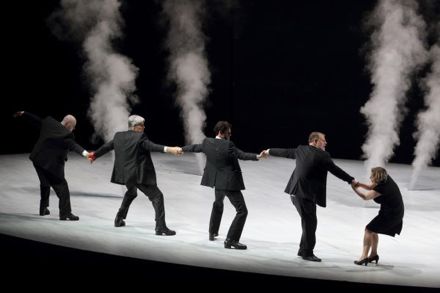
Robert Hayward as Bluebeard and Claudia Mahnke as Judith (both far right)
Photo by Craig Mathew / LA Opera
Less was seriously more. The stage was nothing more than a huge, tilted white disk that sometimes revolved making it possible to paint a black and white panorama when the front was low so that we could see the full surface, or when the front was high obliterating the surface so that we would only see figures, now in stark relief against the black void above. Like close-ups.
Bartok’s little horror opera has only two voices — Bluebeard (Komische Oper baritone Robert Hayward) and his victim Judith (Frankfurt Opera mezzo-soprano Claudia Mahnke). As the story unfolds Mr. Kosky discovers the revelations (opens the doors) by duplicating the Bluebeards — three additional Bluebeards (silent) appear as the doors are opened, and are magically and very simply transformed into Bluebeard’s treasure, force and domain (the three Bluebeards are engulfed in geysers of steam). Already powerfully realized in Bartok’s cannily descriptive music these revelations here crescendoed into a gigantic climax with added brass blasting from the lighting bays on either side of the stage. It was so gigantic that (knowing that Mr. Kosky is fearless when it comes to exploiting ideas) it is possible he even perpetrated the cardinal sin of opera — amplification!
German developed, born in L.A. conductor Steven Sloane participated magnificently in this psycho-drama, extracting music from the score that went well beyond merely descriptive storytelling, finding precise, immense terrors and ecstasies in the sado-masochism that makes Bluebeard’s Castle compelling. The L.A. Opera Orchestra sounded like a real opera orchestra.
This fine, conceptual production comes from Berlin, a city that nurtures the development of stage directors. Sadly in the U.S. there is no interest in developing American directors. Take a look at the seasons of the important American opera companies. The directors are from Germany and Great Britain, countries that develop talent and do not simply import it.
Cast and Production
Dido and Aeneas: Paula Murrihy (Dido), Liam Bonner (Aeneas), Kateryna Kasper (Belinda), John Holiday (Sorceress), Summer Hassan (Second Lady), G. Thomas Allen (First Witch), Darryl Taylor (Second Witch), Brenton Ryan (Sailor). Bluebeard’s Castle: Robert Hayward (Bluebeard), Claudia Mahnke (Judith) Los Angeles Opera Orchestra and Chorus, Steven Sloane (conductor), Grant Gershon (chorus master). Barrie Kosky (production), Ute M. Engelhardt (Associate Director), Katrin Lea Tag (Scenery and Costume Designer), Joachim Klein (Lighting Designer)
Tosca in San Francisco
Yet another Tosca is hardly exciting news, if news at all. The current five performances have come just two years after SFO alternated divas Angela Gheorghiu and Patricia Racette in the title role.
It begs asking why the opera comes back so soon. This is not a distinguished cast, and the production is the 1997 remake of the 1932 SFO production mounted for the umpteenth time.
Still it was an interesting and amusing experience.
The conducting was strikingly different from the powerfully present performances of 2012 (Nicola Luisotti). Just now the conductor was Riccardo Frizza, an Italian maestro who has worked in many important theaters around the world. If his program booklet biography is at all complete he has never before conducted a verismo opera.
Here in San Francisco he has earned critical accolades for the bel canto repertoire (Lucrezia Borgia and I Capuleti e i Montecchi. And this Tosca was pure bel canto — beautiful (pretty) music, lovely detail, flowing lines. It was music about singing, not about the brutal humanity of verismo. The first act was a delightful revelation of relaxed tempos that allowed a melodic flow. It was almost like you had never before seen the opera.
However the melodic flow was uncomfortably broken from time to time to accommodate a singer’s need/urge to exaggerate the duration of a high note, a basic stylistic impulse of later Italian style.
These same relaxed tempos imposed a dramatically flaccid second act. The pastoral beginning of the third act erased any hint, and there had been very few, of dramatic tension. We simply waited until Tosca leapt.
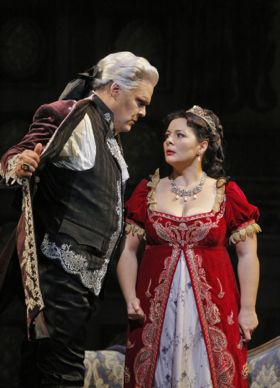
Mark Delavan as Scarpia, Lianna Haroutounian as Tosca
Photo by Cory Weaver, San Francisco Opera
Young Armenian soprano Lianna Haroutounian was the Tosca. Mlle. Haroutounian is not a diva. Tosca is a diva. That Mlle. Haroutounian may soon be a diva is without question, though divas come in all manner, shape and size. Probably this wonderful young proto-diva will never be a Tosca, i.e. a character diva. She exudes little innate dramatic temperament.
Mlle. Haroutounian does exude a purity of voice that casts her as the Verdi heroine. She has the beauty of voice, the size of voice, and the security of technique to immediately place her among the most sought after choices for these roles. That she has the complexity of personality and the dramatic intelligence to become a great artist is yet to be seen.
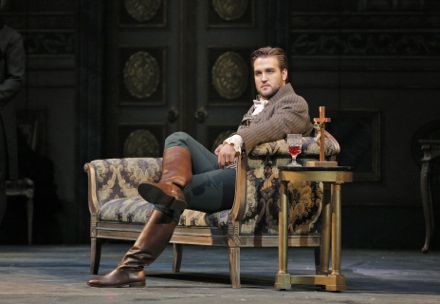
Brian Kagde as Cavaradpsso
Photo by Cory Weaver, San Francisco Opera
Young American tenor Brian Jagde was the Cavaradossi. This former Adler Fellow has at last shown that he is ready for the War Memorial and other important stages, that he a finished artist. As the Luisotti Cavaradossi and Pinkerton he seemed over-parted, maybe even terrorized. Here with Maestro Riccardo Frizza in the pit he was given the musical space to sing, and that he did beautifully. While Mr. Jagde does not embody the Italian tenor emblematic of this role he did exhibit the fruits of his excellent American training.
Baritone Mark Delavan sang Scarpia. Without musical tension coming from the pit, and without a Tosca with whom he could emotionally spar his cardboard evil character was meaningless. Perhaps he was attempting to create character by slurring his words but the effect was that he might have had some caramel in his mouth. On the other hand the Italian diction of Kansas born Scott Conner as Angelotti was admirable.
Jose Maria Condemi was the stage director. This very able facilitator of remounted productions was sabotaged by the musical pace from the pit and the naiveté (inexperience) of Mlle. Maroutounian. What would have been effective staging in a dramatically pointed performance became too many clumsy moves.
It was an evening of beautiful music and beautiful singing. Maybe you wanted more.
Casts and production information:
Floria Tosca: Lianna Haroutounian; Mario Cavaradossi: Brian Jagde; Baron Scarpia: Mark Delavan; Cesare Angelotti: Scott Conner; Sacristan: Dale Travis; Spoletta: Joel Sorensen; Sciarrone: Efrain Solis; Jailer: Hadleigh Adams. San Francisco Opera Chorus and Orchestra. Conductor: Riccardo Frizza; Stage director: Jose Maria Condemi; Production designer: Thierry Bosquet; Lighting designer: Gary Marder. War Memorial Opera House, November 4, 2014, Row M.
Un ballo in maschera in San Francisco
The subject is regicide, a hot topic during the Italian risorgimento when the Italian peninsula was in the grip of the Hapsburgs, the Bourbons, the House of Savoy and the Pontiff of the Catholic Church.And everyone knew what had happened to the Capetian kings in France.
It was in these final moments of the Risorgimento (unification of Italy) that Verdi wanted to premiere an opera in which there is a successful conspiracy to murder a king! Censors in Rome finally agreed that a story about a governor of Massachusetts involved in a nasty bit of adultery could be accepted.
Censorship these days operates a bit differently. No longer political censorship it is now economic censorship. Opera management perceives that the public will not buy tickets unless art is packaged in insipid wrappers. No Calixto Bieito in San Francisco. In this famous Spanish director's opening scene of Un ballo in maschera the courtiers sit on toilets in a mens room, the angry confrontation of husband and wife occurs in the bathroom of their home, their child’s toys floating in the bathtub.
On the War Memorial stage we were back in Sweden, at least we thought so because it was snowing in the second act, otherwise it could have been almost anywhere in nineteenth century Europe. In the program booklet there was no name credited to the design of the scenery. Presumably the sets are based on the production John Conklin created forty years ago (the mid 1970’s) and maybe the scenery has been modified for this staging by director Jose Maria Condemi, maybe by others over the years as well to the degree that it is not appropriate to identify Mr. Conklin with the sets.
Mr. Condemi is a resourceful stage director, finding business for his actors as if he were staging a comedy, and finding solutions for animating long chorus scenes with the addition of dancers miming slapstick comedy (or maybe this was a touch he was re-creating from the original production). He does move his actors around the stage with appropriate counter moves, and in fact he carefully sculpted all the musical numbers to accommodate Verdi’s musical initiatives.
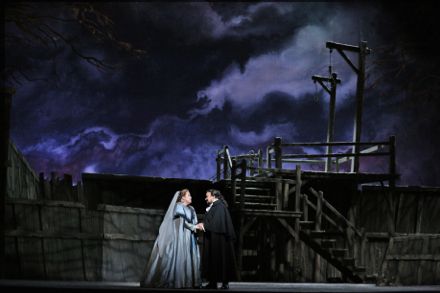
Act II
Photo by Cory Weaver, San Francisco Opera
However the opera itself lacks integrity, its libretto derived from those of several other remakes of an original libretto by Eugène Scribe who was famous for being able to recast nearly any story into reasonable opportunities for arias, duets and trios and then wrapping it all up in a big finale. The challenge in staging ballo is to create an atmosphere in which these musical forms transform theatrical formula into vibrant theatrical reality.
Context for this ballo was sorely missing.
Conductor Nicola Luisotti was in the pit. This meant that it was big conducting that resulted in a huge orchestral presence for this little story of innocent adultery that is in fact the big music of the politically strident Verdi.
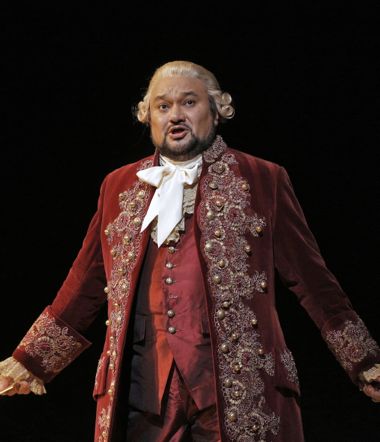
Ramón Vargas as Gustavus
Photo by Cory Weaver, San Francisco Opera
The pit cried out for big singing and the three protagonists could in fact do big, each in a different way. The king of Sweden was Mexican tenor Ramón Vargas, once a bel canto Nemorino, then a lyric tenor Werther and now Gustavo, a mature Verdi tenor! Mr. Vargas is big on musicianship, big on style, his medium sized voice pushed a bit beyond its endurance in this role with this maestro. The tenor and the maestro did together effect some quite fine Verdi moments.
American soprano Julianna Di Giacomo, a former Merola participant, was Amelia. She achieved volumes of beautiful tone that prevailed above the fortes of the full ensemble! Mlle. Di Giacomo presented herself as an arrived artist though she is not a fully finished artist, unable to create the emotionally charged vocal lines and tones that confuse innocence and guilt, the hallmarks of this and most Verdi heroines. It was therefore an incomplete performance.
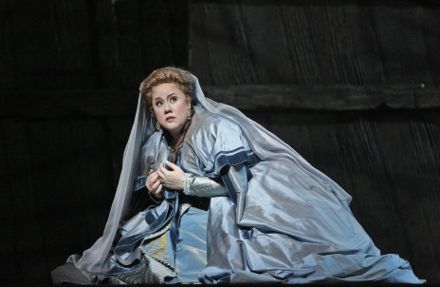
Julianna Di Giacomo as Amelia
Photo by Cory Weaver, San Francisco Opera
American baritone Brian Mulligan sang Count Anckarström aka Renato, husband of Amelia and Gustavus’s confidant and assassin. While Mr. Mulligan may not have the physical persona to impersonate a powerful Verdi baritone he apparently does have the voice, delivering the Act III “Eri tu che macchiavi quell'anima” in beautiful and passionate voice, one of the few felt moments in this mostly emotionally flat evening.
American soprano Heidi Stober was the Oscar. Mme. Stober is a mature artist whose facile, perfunctory performance did not capture the naiveté necessary to this role, an attribute that can make Oscar an emotionally moving part of the final moments of the opera. Veteran mezzo-soprano Dolora Zajick had the cameo role of Ulrica. A big artist, la Zajick cast an appropriate spell as Verdi’s witch but only very occasionally endowed her spell with magical singing.
Casts and production information:
Amelia: Julianna Di Giacomo; Oscar: Heidi Stober; Gustavus: Ramón Vargas; Count Anckarström: Brian Mulligan; Ulrica: Dolora Zajick; Count Horn: Scott Conner; Count Ribbing: Christian van Horn; Christian: Efrain Solis; Judge: A.J. Glueckert; Amelia’s servant: Christopher Jackson. Chorus and Orchestra of the San Francisco Opera. Conductor: Nicola Luisotti; Stage Director: Jose Maria Condemi; Costume Designer: John Conklin; Lighting Designer: Gary Marder; Choreographer: Lawrence Pech. War Memorial Opera House, San Francisco, October 7, 2014 (seated row 16 house right).
Susannah in San Francisco
Come to think of it the 1950‘s were operatically rich years in America compared to other decades in the recent past. Just now the San Francisco Opera laid bare an example, Carlisle Floyd’s Susannah. It is an opera some of us may now find to be a naive or simplistic artifact, nevertheless emblematic of those years.
Vanessa (1957), West Side Story (1957), The Saint of Bleecker Street (1955), and Susannah (1956) are the survivors from that decade. Like Vanessa, Susannah is a morbid short story though Vanessa is urban, subtle and twisted while Susannah is rural, obvious and brutal. At first Susannah may seem a bit like verismo, Cavalleria Rusticana for example, but it lacks the single physical blow and emotional resolution, dissolving instead into a sea of musically unsupported judgmental ironies.
Like West Side Story, Susannah is musical theater moreso than it is pure opera. It is a series of relatively brief, showy musical numbers that each illustrate a single emotion or situation. Its few action scenes are in elaborated recitative that is not integrated into larger musical structures.
West Side Story and The Saint of Bleecker Street are urban Americana composed by sophisticated New Yorkers (Bernstein and Menotti). These were the plights of poor immigrant Americans with strong ethnic accents, and music that eschewed the then current European complex serialism in favor of popular idioms and traditional forms.
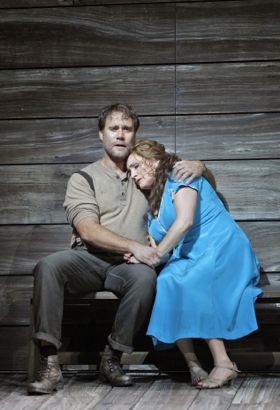
Brian Jovanovich as Sam, Patricia Racette as Susannah
Photo by Cory Weaver, San Francisco Opera
Susannah composer Carlisle Floyd was born in South Carolina. He was a tenured professor at Florida State University and later founded the Houston Opera Studio. He writes about the American south (both words and music) in verbal declaration for which a strong regional accent is taken for granted. His musical idiom combines easy flowing tonal music with a big folksy overlay (hymns and mountain tunes) spiced with a bit of glowing dissonance.
Susannah may be the second most performed American opera but there is an immense gulf between the artistic intelligence and power of Porgy and Bess and the blatant moralism of Susannah.
Neither Gian Carlo Menotti nor Carlisle Floyd pushed the artistic envelope sufficiently to be discussed in Alex Ross’ history of music in the twentieth century, The Rest is Noise (2007). But make no mistake, along with these other works Susannah too is an operatic masterpiece in its way, and it is a quite modest way.
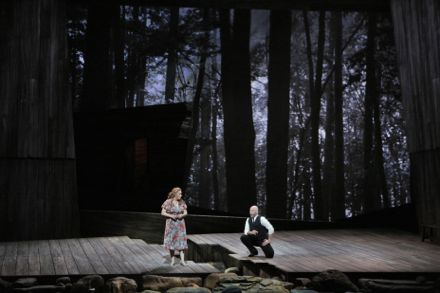
Patricia Racette as Susannah, Raymond Aceto as Blitch
Photo by Cory Weaver, San Francisco Opera
Susannah was composed for the reduced circumstances of post WWII and as a populist work of art consistent with the socialistic artistic politic of the time. Premiered in Florida it quickly made its way first to the New York City Opera, “the people’s opera” and then to the 1958 Brussels World’s Fair where it represented American culture. One can only question the wisdom behind the choice of specific, ugly content to portray American life to the world at large.
Just now San Francisco Opera rolled out a handsome new production that filled the War Memorial Stage. Canadian stage director Michael Cavanagh with his designer Erhard Rom created splendidly realistic expanses of southern mountains with scrims and projections. These lovely photographic impressions of nature were at odds with a modernistic cross, a huge, neon lighted (it seemed) cross typical of modern suburban mega churches that loom over the revival meetings. It screamed naiveté of concept.
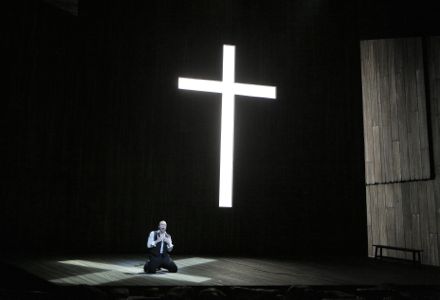
Raymond Aceto as Blitch
Photo by Cory Weaver, San Francisco Opera
A similar conflict arose in the stage direction, Mr. Cavanagh alternated between the presentational naturalism of the hayseed presences of Susannah, her brother Sam and the church elders, and clumsy solutions to managing the presentational needs of the crowd scenes at the picnics and in the church. Also clumsy were the several times a character was asked to silently act out conflicting emotions while we musically waited from him to make up his mind. Mr. Cavanagh is less to blame for these unsuccessful moments than Carlisle Floyd.
Soprano Patricia Racette, long a Carlisle Floyd heroine, still pulls it off, even in this latter day essay as Susannah. Because la Racette is usually associated with the great roles in the grand repertory it seems a waste to cast her in such simple music. The same can be said of tenor Brandon Jovanovich who gave us a superb Sam, Susannah’s brother, his performance utilizing but a tiny percentage of his capability (Lohengrin in 2012 for example). Of the three principals only bass Raymond Aceto as the Reverend Blitch did not find an un-self conscious Americana presence, his performance was purely big house look-at-me opera singing and acting. The smaller roles were well cast.
This little opera can pack quite a wallop in the right circumstances. Susannah simply does not blow up to grand opera proportions.
Casts and production information:
Susannah Polk: Patricia Racette; Sam Polk: Brandon Jovanovich; Rev. Olin Blitch: Raymond Aceto; Mrs. Mclean: Catherine Cook; Little Bat Mclean; James Kryshak; Mrs. Hayes: Jacqueline Piccolino; Mrs. Gleaton: Erin Johnson; Mrs. Ott: Suzanne Hendrix; Elder Hayes: Joel Sorensen; Elder Gleaton: A.J. Glueckert; Elder Mclean: Dale Travis; Elder Ott: Timothy Mix. Orchestra and Chorus of the San Francisco Opera. Conductor: Karen Kamensek; Stage Director: Michael Cavanagh: Set Designer: Erhard Rom; Costume Designer: Michael Yeargan; Lighting Designer: Gary Marder. War Memorial Opera House, September 12, 2014, seated seventh row center.
Norma in San Francisco
It was a Druid orgy that overtook the War Memorial. Magnificent singing, revelatory conducting, off-the-wall staging (a compliment, sort of).
Not much more is known about Druid ritual than what Vincenzo Bellini documents in his operatic version of an ancient mistletoe ceremony. He and his librettist Felice Romani then considered what might have happened if this fertility drug had begotten two adorable children and therefore doomed (in this production) an entire civilization to extinction. Their conjecture is complicated by a very human, operatically volatile tangle of fidelity and infidelity.
Make no mistake. Norma is not about human nature. It is about singing about human nature, and if you are the singer it is finding your way out of Romani’s mess by singing long enough, and singing beautifully enough. It got complicated in San Francisco.
Most of all the singing was loud enough, and that is important for a huge theater like La Scala where the opera began (2800 seats) and the War Memorial (3200 seats) where Norma now may be heard as it has never been heard before.
As usual when conductor Nicola Luisotti is in the pit the opera is about the maestro and the pit. The singers are usually lined up across the front of the stage to fall under the direct control of the maestro. He does not hear Norma as bel canto — long, dramatically graceful melodies that soar — but as overwrought emotional outpourings composed to challenge the techniques of big artists. It is big canto, and not only for the singers but also the orchestra who sang out Bellini’s simplistic harmonies as if they were those of Richard Strauss.
Surprisingly Bellini and the audience endured all this (unless as a bel canto purist you were so offended you walked out — though I saw no empty seats after intermission). The orchestra loudly declaimed bel canto subtleties meant to be subtle, and the singers rose magnificently to the challenges of deadly slow tempos or break-neck, ear splitting speed. Just when you thought it was all for nought Norma and Adalgisa, complicit with the maestro, gave a musically splendid duet “Sola, furtiva al tempio,” lines interwoven at a tempo that was at least melodically coherent, if unusually fast.
The second act generally sank under the musical weight imposed by the pit, until the concerted finale “Deh! non volerli [my children] victime.” Here the maestro found enough dramatic resolution occurring on the stage to support the massive energy coming from the pit. And when Pollione, the fickle tenor, declared “O mio dolore” and continued with “contento il rogo [the pyre] io ascenderò” it was spine tingling to the end.
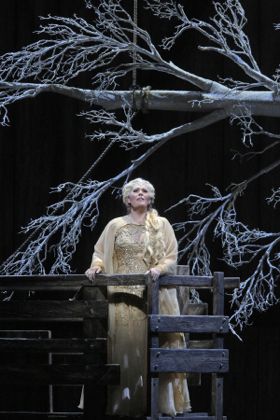
Sondra Radvanovsky as Norma
Photo by Cory Weaver, San Francisco Opera
Sondra Radvanovsky may be the epitome of Norma’s in recent history. Not the proto type bel cantista who slides through the intricacies of the role and easily overcomes its roadblocks but the mature priestess, distraught mother, and discarded lover who has a lot of uncomfortable things to sing about. La Radvanovsky has the powerful, luminous spinto voice to color the character, and the range and technique to take on the challenge of accomplishing mature bel canto. Here in San Francisco she accepted the risks perpetrated by the maestro, delivering the “Casta Diva” as melodic stasis, the physical act of vocal production (air moving forward) pitted against frozen motion from the pit (like frozen time in Berlioz’ Les Troyens love duet). Incredibly among the literally thousands of moments when her tone might break during this epic singing event a crack occurred only twice.
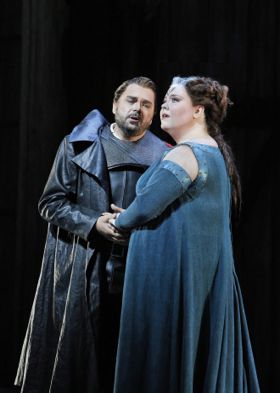
Marco Berti as Pollione, Jamie Barton as Adalgisa
Photo by Cory Weaver, San Francisco Opera
Soprano Jamie Barton took on the challenges of Adalgisa. This young artist, already well credentialed in this role, made a coherent dramatic and vocal contrast to the mature presence of Mme. Radvanosky. She brought appropriate virginal voice and presence that validates the casting of a young artist for artistic reasons (in this case like the original 1832 production) rather than for pecuniary reasons. Mlle. Barton displayed a technique well able to cope with Bellini and luckily has already gained sufficient sea legs (stage legs) to cope with this maestro.
Italian tenor Mario Berti sang Pollione. Mr. Berti is not a subtle artist, nonetheless he is a fine artist. Perhaps most importantly he brings true Italianate voice and flair to the War Memorial and the sense that San Francisco Opera may be an international house after all. Without really the range and agility to bring off this role (most glaring in his initial aria “Meco all'altar di Venere”) he later exhibited some very effective descents into his chest voice plus he succeeded, surprisingly, to sing softly a couple of times. Not to forget the tenorial coglioni that made the final moments of the opera a tenor showpiece (like Calaf in Turandot for example). Following this performance San Francisco Opera announced the Mr. Berti is being replaced by Russell Thomas, a recent graduation of the Met's young artist program, for the five remaining performances.
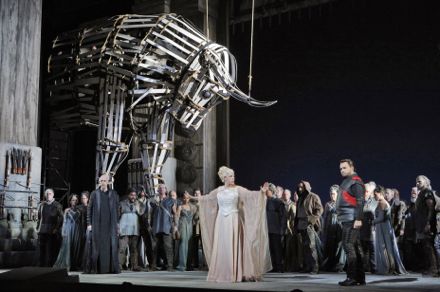
The Trojan Bull
Photo by Cory Weaver, San Francisco Opera
It is a big, new production by American director Kevin Newbury to be shared with Barcelona, Toronto and Chicago. Mr. Newbury has worked operatically primarily in Minneapolis and Houston. But he works also in theater and most recently in film. The production, created with designer David Korins (whose program booklet biography includes restaurant interiors), reflects this range of experience.
The set seemed to be the front of a stage proscenium (a stage within a stage), but also an old fashioned back stage, a mid-western barn, the Old Globe, off-Broadway, a fantasy film and Epic Theater. All these elements crowded at once onto the stage.
The concept seemed to be that maybe the Romans (who wanted the British Isles) snuck a general into Druid country to seduce a high priestess. This dreamed up, far fetched treachery made Messrs. Newbury and Korins think of the Trojan Horse. Since there were already bulls in the Druid mistletoe ceremony the production creators perhaps thought that a Trojan Bull might be constructed (long slats that seemed to be rolled up venetian blinds were carried across the stage from time to time). A huge slatted bull was rolled on stage at the end (explaining those wooden slats) and set afire, Druid soldiers and Norma and Pollione having climbed inside. The barn doors at the back of the stage (wooden) had been barred, trapping the the remaining Druids within the conflagration.
Given the fertility claims of mistletoe one suspects that Messrs. Newbury and Korins tripped out over the word “trojan.” Make no mistake, all this made for an amusing evening.
Casts and production information:Norma: Sondra Radvanovsky; Adalgisa: Jamie Barton; Pollione: Marco Berti; Oroveso: Christian Van Horn; Clotilda: Jaqueline Piccolino; Flavio: A.J. Glueckert. San Francisco Opera Orchestra and Chorus. Conductor: Nicola Luisotti; Stage Director: Kevin Newbury; Set Designer: David Korins; Costume Designer: Jessica Jahn; Lighting Designer: D.M. Wood. War Memorial Opera House, San Francisco. September 10, 2014, 7th row center seats.
Madama Butterfly in San Francisco
Gesamtkunstwerk, synthesis of fable, sound, shape and color in art, may have been made famous by Richard Wagner, and perhaps never more perfectly realized than just now by San Francisco Opera.
It was an Italian opera, the abstract visual images of a Japanese born American and an American fable that converged magically into artistic totality.
The 2006 production itself (design and staging), is from Opera Omaha. It has since traveled to Madison, Dayton, Vancouver, Honolulu, Atlanta, Philadelphia and Charlotte. It would hold the stage in any opera house in the opera world. It is a masterpiece.
The sets and costumes are by Omaha based ceramic artist Jun Kaneko who collaborated with stage director Leslie Swackhamer, a professor at Sam Houston State University (Houston) whose theatrical roots are in Seattle, to create this unique production.
Jun Kaneko works primarily in repeated patterns in two dimensional clay, a visual process that brilliantly found its way into Puccini’s verismo — the abstracted, multi-colored umbrellas of the wedding guests was the kaleidoscope of village life, the sliding panel of black and white squares meant the house. Screens flew in and out on which repeating, jagged lines of growing tension were drawn. These were but some of the patterns that multiplied the joyous and horrific emotional obsessions that are at the base of verismo.
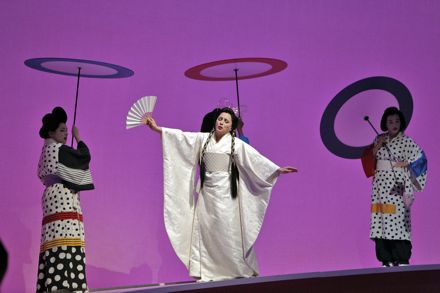
Act I, Patricia Racette as Butterfly
Photo by Cory Weaver, San Francisco Opera
Kaneko creates abstract location (background) in giant swaths of solid color — a golden yellow for the marriage, this color carried through the opera by the golden trousers of Trouble, reds and blues for the American presence, and finally brilliant red for blood, in a dripping image that mirrored the neck seppuku committed by the Butterfly standing just below. These were some of the colors that conveyed the powerfully contrasting forces of verismo.
San Francisco Opera’s Nicola Luisotti was in the pit. This powerful musical presence usually dominates the War Memorial stage. However here the tyrannical maestro met his match — the evolving visual statements riveted our eyes to the stage, diva Patricia captivated our emotions. The maestro did no more than hold us in thrall to this masterwork. It was what great operatic conducting can be. And very seldom is.
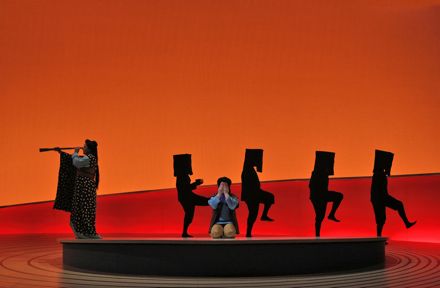
Act II vigil
Photo by Cory Weaver, San Francisco Opera
This was the performance in its finest moments.
Soprano Patricia Racette no longer has the bloom of voice to create the Act I Butterfly or to deliver a resplendent “un bel di.” But she has gained vocal force and darker colors to execute with soul-wrenching power the words that take her gently and brutally to sacrifice and suicide.
Patricia Racette’s Butterfly has been legend for many years. It is a role she is not likely to keep in her voice much longer.
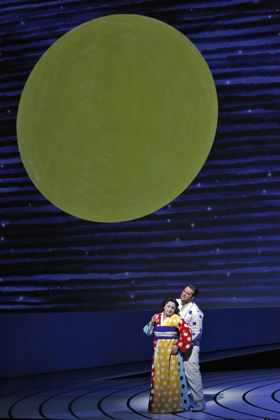
Patricia Racette as Butterfly, Brian Jagde as Pinkerton
Photo by Cory Weaver, San Francisco Opera
Mezzo soprano Elizabeth DeShong portrayed a Suzuki that could easily become legendary as well. She possesses a lyric mezzo voice in full flower, and a presence that offers an expanded dimension of character for roles like Suzuki and Cenerentola (her Glyndebourne debut) and trouser roles like Hansel (Chicago) and Maffio Orsini (ENO and SFO).
Baritone Brian Mulligan made an adequate Sharpless but did not resonate with the stature of the Racette Butterfly. The Pinkerton was tenor Brian Jagde, a recent Adler Fellow who does not have the refinement necessary to appear on a major stage (the War Memorial claims it is). It was a raw performance, made embarrassing by the strutting onto the stage apron (and even upon the prompter box) to attempt to impress us with his high notes. This young tenor will perform Pinkerson at Covent Garden, casting that is surely manifestation of artistic anti-americanism. Current Adler Fellow Julius Ahn is not a big enough performer to fill the Goro pants in a major production.
Casts and production information:
Cio-Cio-San: Patricia Racette; Lt. B.F. Pinkerton: Brian Jagde; Suzuki: Elizabeth DeShong; Sharpless: Brian Mulligan; Goro: Julius Ahn; Kate Pinkerton: Jacqueline Piccolino; Prince Yamadori: Efrain Solis; The Bonze: Morris Robinson; Commissioner: Hadleigh Adams. Chorus and Orchestra of San Francisco Opera. Conductor: Nicola Luisotti; Stage Director; Leslie Swackhamer; Production Designer: Jun Kaneko; Lighting Designer: Gary Marder. War Memorial Opera House, June 15, 2014.
Show Boat in San Francisco
To be uncomplimentary about the current production of
Critical consensus seems to be that Jerome Kern’s Show Boat was acceptable in San Francisco’s 3200 seat War Memorial (and at Chicago’s 3500 seat Lyric Opera). This acceptance has come at a price — sophisticated electronic amplification of voices and the imposition of a scale of production that well exceeds the stature of the piece.
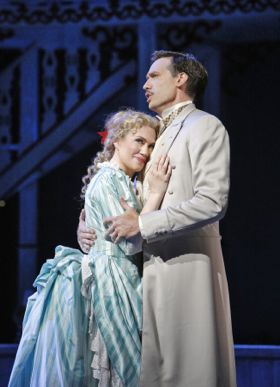
Heidi Stober as Magnolia, Michael Todd Simpson as Ravenal
Photo by Cory Weaver, San Francisco Opera
At the press conference before this San Francisco run of performances (the production has already been seen in Washington D.C. and Chicago) there were three primary rationales offered for presenting Show Boat on a grand opera stage.
The first rationale is that if operettas such as, and specifically mentioned, Die Fledermaus, La Périchole and Die Lustige Witwe are firmly established in the international operatic repertory, why not an American operetta (you must first of all consider Show Boat an operetta and that is a complicated rationale). Note that La Périchole has never been on the War Memorial stage, nor has any other Offenbach operetta. What small amount of dialogue that has occurred in SFO productions of Die Fledermaus and Die Lustige Witwe productions has used the natural acoustic of the opera house. No singing voices have been amplified.
The second rationale is that given the demise of American light opera companies it becomes the responsibility of American grand opera companies to preserve the American Musical Theater heritage. Note that most of the musicals that comprise this current popular theater heritage occurred before the advent of sound reinforcement.
The by now classic American musicals were staged in theaters adapted to acoustical voice projection (recall the focused nasal sound of spoken dialogue delivered in earlier times that projected easily to the last rows of a vaudeville “opera house”). If American grand opera companies feel compelled to step outside their mission of producing opera they should at least move from opera houses to appropriately sized theaters where acoustic voices are possible.
The third rationale is that Show Boat dared introduce racial issues into popular theater. The presence of this stain on our national history evidently elevates the importance of Show Boat, and imposes a moral duty on grand opera companies to remind us that we have sins to expiate. Maybe like American imperialism in Madama Butterfly, and narrow, what we now call Victorian mores like in La Traviata. Opera can make it painfully pleasurable to go through this cathartic process.
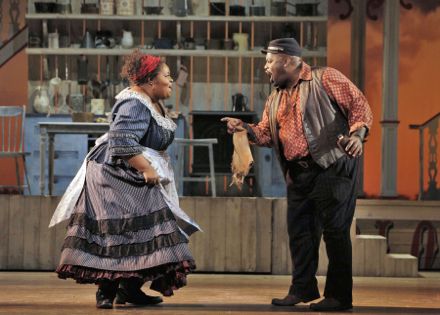
Angela Renée Simpson as Queenie, Morris Robinson as Joe
Photo by Cory Weaver, San Francisco Opera
Upon a bit of consideration however the racial issues addressed in Show Boat are more about problems white skinned people encounter than the inequalities encountered by black skinned people. The blacks in Show Boat contentedly remain the underclass throughout the story (white girl gets rich and may or may not take back her no-good husband) and these blacks seemed happy to represent little more than caricatures of what whites wanted blacks to be back in 1927. It was surprising to see contemporary black skinned people willing to accept this assignment.
Finally Show Boat was a sing along. The songs are immortal it seems, or at least inescapable to those of us who grew up in mid-century America — songs sort of like “Di Provenza il mar” and “Un bel dì” for the current opera crowd. However after we have hummed along with a Verdi and Puccini aria there remains so much more to invade our souls than a few more catchy songs.
Many contented critics did finally confess the triviality, read poverty of the story once it was revealed in the second act. Other contented critics admitted that the razzle dazzle of the production numbers was pale imitation of what should occur in a real Broadway show.
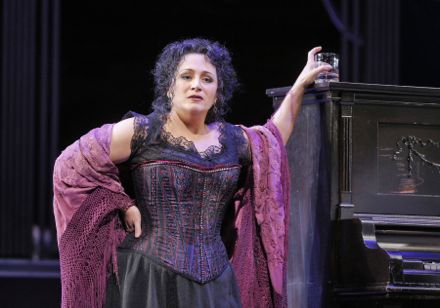
Patricia Racette as Julie
Photo by Cory Weaver, San Francisco Opera
The San Francisco cast included opera soprano Heidi Stober who achieved a sufficient level of sparkle as Magnolia. Opera diva soprano Patricia Racette brought some presence but little tone to the role of Julie, opera baritone Michael Todd Simpson as Magnolia’s gambler husband Ravenal was highly miked making his voice sound like a musical comedy voice, a voice that seemed quite tired by end of the second act. Operatic bass Morris Robinson made appropriate bass sounds as Joe who sings “Old Man River” over and over again.
Casts and production information:
Magnolia Hawks: Heidi Stober; Gaylord Ravenal: Michael Todd Simpson; Cap’n Andy Hawks: Bill Irwin; Julie la Verne: Patricia Racette; Queenie: Angela Renée Simpson; Party Ann Hawks: Harriet Harris; Ellie Mae Chipley: Kirsten Wyatt; Joe: Morris Robinson; Frank Schultz: John Bolton; Mrs. Obrien: Sharon McNight; et al. San Francisco Opera Orchestra and Chorus. Conductor: John DeMain. Stage Director: Francesca Zambello; Set Designer: Peter Davison; Costume Designer: Paul Tazewell; Lighting Designer: Mark McCullough; Sound Designer: Tod Nixon; Choreographer: Michele Lynch. War Memorial Opera House, San Francisco, June 3, 2014
La Traviata in San Francisco
La Traviata has hit the stage at San Francisco Opera every three to five years (even annually in some decades) since 1924. Surprises have been rare.
And unwelcomed. Take for instance the 2009 San Francisco installment which was the 2006 art deco version imported from L.A. Opera directed by Marta Domingo. Violetta, a flapper, arrived at the party in a Rolls Royce during the overture, and it was downhill from there even though the soprano was Anna Netrebko.
Just now in San Francisco there was a welcome surprise, and that was Verdi’s orchestral score made vividly present in moods and colors, rushes and hesitations, pianos and fortes, well, pianissimos and fortissimos. It was the high octane conducting of Nicola Luisotti that made Verdi’s first truly masterful score the star of the show. The pit was the sentient center of Verdi’s personal and deeply felt domestic tragedy.
Never mind that this intense emotional focus emanating from the seemingly inspired musicianship of a superb orchestra revealed Francesco Maria Piave’s (and one assumes Verdi’s) dramatic structure to be truly clumsy. Or that Luisotti’s ultimate acceleration missed the emotional beats of the opera’s final moments — the blow of the intense release was summarily trampled over — a not atypical Luisotti conclusion.
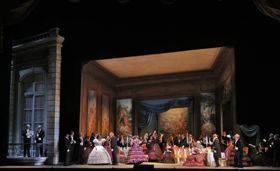
La Traviata, Act I
Photo by Cory Weaver, San Francisco Opera
The reliable 1987 (twenty-seven years ago) San Francisco Opera production by John Copley was back on stage. It is definitely mid-nineteenth century in concept as required by Verdi, glowing in warm colors (the splendid lighting designed by Gary Marder). The wash of colors, the swish of lavish gowns, the brilliant red flash of the flamenco dancer, the weight of nineteenth century architecture were however at odds with the detail and precision emerging from the Luisotti pit, and the emotional depth of the score itself.
The cast was decidedly low octane, and intimidated by the conductor. The stage action by the principals was kept downstage center, looking not at each other while singing to one another but presentational, addressing the audience and most importantly remaining able to have direct eye contact with the conductor.
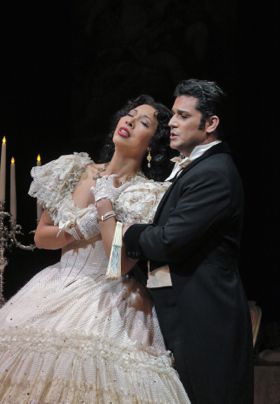
Nicole Cabell as Violetta, Saimir Pirgu as Alfredo.
Photo by Cory Weaver, San Francisco Opera
Soprano Nicole Cabell replaced the originally announced Bulgarian soprano Sonya Yoncheva as Violetta. Mlle. Cabell has previously proven herself a fine bel canto singer in San Francisco (Giulietta in Bellini’s I Capuleti ed i Montecchi) in an integrated production (musical and production elements were compatible). A fine singer and artist, here undirected, she struggled to dominate the stage as required of Violetta, and did not possess an energy or brilliance of tone to bring Violetta to vibrant life. She opted out of the optional E-flat in “Sempre Libera.”
Albanian tenor Saimir Pirgu has also proven himself in San Francisco as a bel canto singer (Tebaldo in Bellini’s I Capuleti ed i Montecchi). A fine singer and artist, vocally he cannot make the leap from easily fulfilling the demands of well-directed bel canto to the specific vocal and histrionic requirements of proto-realism roles (a larger, warmer voice and presence) or the higher powered vocal demands of mid- and late Verdi theater.
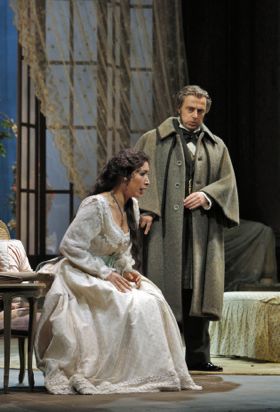
Nicole Cabell as Violetta, Vladimir Stoyanov as Germont.
Photo by Cory Weaver, San Francisco Opera
Bulgarian baritone Vladimir Stoyanov sang Germont. This esteemed artist possesses a quite beautiful voice, and more than Mlle. Cabell or Mr. Pirgu fulfilled the Luisotti musical vision. Yet he too seemed a too small vocal and histrionic presence on the War Memorial stage.
Conductor Nicola Luisotti brings very specific and very powerful musicianship to opera. San Francisco Opera has yet to build a production around his unique talent. One hopes this may one day happen.
Luisotti conducts the first six performances (through June 29). The remaining four July performances, including the July 5 performance beamed directly onto the gigantic scoreboard of AT&T Park (home of the Giants), have a different cast of principals and a different conductor. Opera-at-the-Ball Park is not to be missed. It may be the Traviata you want to see.
Casts and production information:
Violetta Valéry: Nicole Cabell; Alfredo Germont: Saimir Pirgu; Giorgio Germont: Vladimir Stoyanov; Flora Bervoix: Zanda Svede; Gastone: Daniel Montenegro; Baron Douphol: Dale Travis; Marquis D’Obigny: Hadleigh Adams; Doctor Grenvil: Andrew Craig Brown; Annina: Erin Johnson; Giuseppe: Christopher Jackson. Chorus and Orchestra of San Francisco Opera. Conductor: Nicola Luisotti. Original stage director: John Copley; Stage director: Laurie Feldman; Set design: John Conklin; Costume design: David Walker; Lighting design: Gary Marder; Choreographer: Yaelisa. San Francisco War Memorial Opera House, June 11, 2014.
Thaïs in Los Angeles
Libido was in short supply at Thaïs on Sunday afternoon. The tenor (singing a baritone role) was 73 years-old, the 50 year-old tenor was vocally dysfunctional, the soprano was willing if vocally worn. Never mind the libido suppressed father and mother superiors who should have been at least vocally viable to make their renunciations of the carnal meaningful.
Massenet’s opera comes from the irony laden novel Thaïs (1890) by Anatole France. It was on the Catholic Church’s infamous Index Librorum Prohibitorum!
The production, by director Nicola Raab and designer Johan Engels, in fact makes a blatant case for the libido by transposing the action from ancient, decadent Alexandria into a late nineteenth century Parisian theater. The thickly sensuous, excessive fin-de-siècle decor gave designer Engels license to design an over-the-top art nouveau costume for the Roman courtesan Thaïs replete with gilded wing feathers and 96 rhinestones (according to the program booklet).
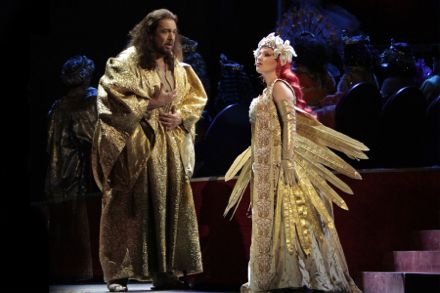
Photo by Robert Millard courtesy of Los Angeles Opera
Once we heard the famous violin solo where Thaïs gives herself to God the Parisian theater was changed into a ghostly gray ruin. Thaïs’ soul flew to heaven, the grand gold feathers now a drab gray — it was confusing because the corpus evidently was not assumed at the same time. Thaïs later appeared downstage center dressed in white satin as the bride of Jesus against the back drop of an abstracted reclining naked female form — very graphic nipples. It was maybe a hill on the Egyptian desert or maybe Sainte-Victoire in the south of France.
Even more confusing was the backstage of the theater as some sort of monastic setting where grandly dressed monks decried sensual pleasures. Inside the theater we did witness these pleasures, men in top hats salivating over an unseen burlesque act. The production offered clever and lively, graphic action and there was a lot of it (though it did not always make a lot of sense). What else do you want?
Massenet’s score (1894) is sensuous late romantic music. It is finely wrought, beautiful music with far more delicate drama than the bombastic Italian works of this period. Its dramatic points are more intellectual than visceral.
L.A. Opera engaged Massenet specialist Patrick Fournillier to conduct. He did the best he could with the uneven vocal and musical forces provided to him. Placido Domingo as the carnal minded monk Athanaël still sings well though his voice no longer has its famous warmth and sheen, his tenor style production in the baritone range at times resembled barking. Conductor Fournillier accommodated this quality by imposing a hell, fire and brimstone tonal force much at odds with the Massenet poetic. Mr. Domingo moves well for a man his age, however Massenet’s baritone is ideally a man in the prime of life and voice, otherwise the role has no meaning.
Soprano Nino Machaidze is no stranger to L.A. Opera audiences, having appeared as Fiorella not so long ago in Il Turco in Italia and Juliette in Rómeo et Juliette where she brought fun and flair and sang with a focus and a brilliance that was not at all present in her Thaïs. There was now significant spread in her tone that could embody neither the sensuality of voice of the courtesan nor the tonal beauty of a woman now transfixed by a new spirituality.
Thaïs’ suitor Nicias was attempted by tenor Paul Groves. He was in very evident vocal distress. Bass Valentin Anikin from L.A. Opera’s young artist program is not of an appropriate professional level to sing an important role. Bulgarian mezzo-soprano Milena Kitic who has sung major roles at L.A Opera in past years sang the mother superior with forced tone.
The production comes most recently from the Helsinki Opera having originated at the Göteborg Opera (Sweden) in 2010. Meanwhile it made important stops in Valencia and Seville where tenor Domingo sang the monk Athanaël as well.
Cast and Production
Nino Machaidze (Thaïs), Plácido Domingo (Athanaël), Paul Groves (Nicias), Valentin Anikin (Palemon), Milena Kitic (Albine), Hai Ji Chang (Crobyle), Cassandra Zoé Velasco (Myrtale), Kihun Yoon (Servant). Los Angeles Opera Orchestra and Chorus, Patrick Fournillier (conductor). Nicola Raab (stage director), Johan Engels (scenery and costumes design), Linus Fellbom (lighting design)
Le Mamelles de Tirésias and Mahagonny in San Francisco
Poulenc’s racy little 1947 confection took stage within Kurt Weill’s peculiar little 1927 singspiel Mahagonny all framed within the current California drought and doomsday predictions of impending global aridity.
But it has been raining a bit in San Francisco, and global warming might even make San Francisco wetter rather than dryer. All this took a bit of the edge off this far-fetched conglomeration of an opera within an opera within a commentary. The good news is that we heard some very good singing by well-trained young artists, and there were some snappy performances as well. Not to forget a quite capable little orchestra in a real pit in a real and indeed fine theater, the Lam Research Theater.
San Francisco has long been in need of an additional opera company to explore vast expanses of the repertory left untouched by the heroic scope of War Memorial Opera House. The 750 seat Lam Research Theater offers a potential home to such an opera company, and maybe it is Opera Parallèle, a venture of conductor Nicole Paiement and stage director Brian Staufenbiel, who have mustered a couple of productions each year since 2010, some of them in this fine theater.
This sally onto the Lam Research Theater stage was a meager production — a too real, quite forlorn 22 foot, vintage cabin cruiser put up on wheels and clumsily pulled around the stage. There was no context for the boat, like a parched earth ground or like denuded hills surround, though there were some meager gaseous aurora borealis lighting effects that flickered faintly from time to time that maybe were drought related.
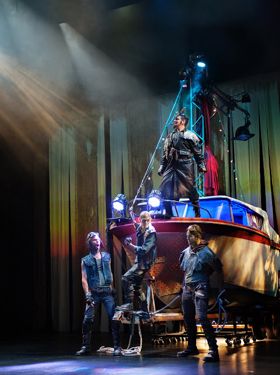
Photo by Steve DiBartolomeo, Westside Studio Image
The little, and it is conceptually and musically inconsequential, Mahagonny did not hold together visually or musically on the open, blank stage and the singers were simply too singerly, their elegance a poor substitution for the Weill/Brecht intended grit. Mme. Paiement’s orchestra was without edge and the maestra’s tempos felt leaden indeed.
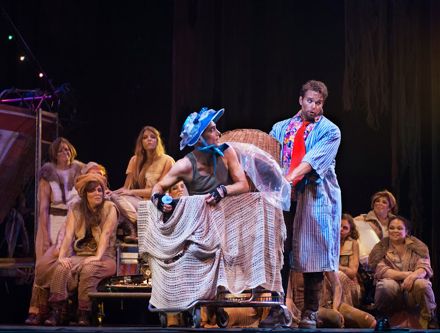
Glenn as The Boy, Gabriel Preisser as The Husband in Les Mamelles de Tirésias
Photo by Steve DiBartolomeo, Westside Studio Image
But it all picked up splendidly when the evening morphed into the Poulenc boulevard musical, Les Mamelles de Tirésias intended to titillate and distract the post WWII Parisian public. To be sure the “advanced” social ideals seemed a bit overworked in long-emancipated San Francisco. Fortunately director Staufenbiel did not take the issues too seriously having transformed the piece into I pagliacci (a commedia dell’arte troupe descends on a backward village) here Weill's singers come upon a camp of refuges from drought stricken village somewhere on the French Riviera. Except it was on a blank black stage.
The downstage sideways positioned cabin cruiser did work very well in Les Mamelles because it gave many levels for action, and many nooks and crannies for visual surprises. You could forget the off-the-wall concept (at least there was a concept, a concept sorely lacking these days in the War Memorial) and simply enjoy the quite appealing music beautifully played in the pit and sung on the stage.
Baritone Gabriel Preisser brought unusual warmth and charm to the role of the Thérèse’s husband, tenor Thomas Glenn stood out in his Les Mamelles caricatures and more than anyone else approached the tone of the Weill. Bass-baritone Hadleigh Adams brought snap and flair to Les Mamelles’ antagonist, the Constable. The entire cast attests the high level of training behind young American artists, and the accomplishment of these young singers was very pleasurable to behold.
It will be a relief to perceive them as artists of personality someday, hopefully soon, rather than as fine young singers. Perhaps Opera Parallèle can accomplish this with deeper production values.
It was finally a well realized evening, of institutional accomplishment and promise. Off-the-wall is meant as a compliment by the way, forget the unfortunate transition at the end back into the little Mahagonny.
Casts and production information:
The Husband: Gabriel Preisser; Therèse/Tirésias: Rachel Schutz; The Constable: Hadleigh Adams; The Director: Daniel Cilli; The Journalist/The Son: Thomas Glenn; The Newspaper Vendor: Renee Rapier; The Bearded Man: Aleksey Bogdanov; The Big Lady: Amber Marsh; The Lady; Suzanne Rivin. Opera Paralléle Orchestra and Chorus with the Resound Ensemble. Conductor: Nicole Paiement; Concept and stage director: Brian Staufenbiel; Production design: Frédéric Boulay; Set design: Dave Dunning; Costume design: Christine Crook; Choreographer: KT Nelson. Lam Research Theater, April 26, 2014.
Billy Budd in Los Angeles
Back in June 2000 the word on Wilshire was that Billy Budd was a show not to be missed, now 14 years later the word on Wilshire was again that Billy Budd was a show not to be missed.
It is the same show, a production of nearly unprecedented critical acclaim that was again at the Dorothy Chandler. By Francesca Zambello the production had originated in Geneva in 1994, the next year it won the Grand Prix des Critiques in Paris, and the next year it took the Olivier Award for Best Opera Production in London.
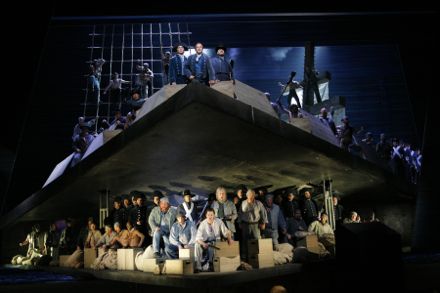
Bellipotent chase of the French warship
Photo by Robert Millard courtesy of Los Angeles Opera
Bass-baritone Rodney Gilfry was the Billy Budd in all these early editions of the production, his iconic role. He was the sole common element except of course for the production itself, its setting of uncanny reference to the worlds of Herman Melville and of Benjamin Britten, not to mention its references to the universal and timeless experience of all humanity — from the crucifix of the mast to the phallic metal pistons that suddenly push up the prow, from the blue platform of life itself to the trapdoors on the deck that open into hidden feelings.
This Billy Budd is about everything. As elemental as the pure spirit of Billy Budd is to the world of this opera it is Captain Vere who is its life force. As captain he is every man on his ship, but most of all he is Billy Budd and he is his executioner. Captain Vere sacrifices Billy and he sacrifices himself to the forces of man’s nature and men’s laws. The magic of this production takes you inexorably to this delicate and fearsome moment of human passage.
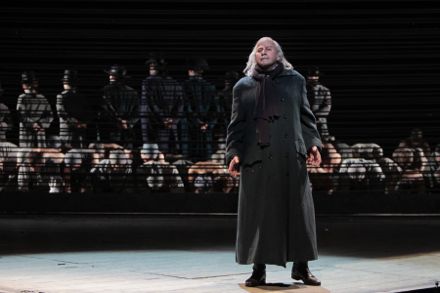
Richard Croft as Captain Vere in the Prologue
Photo by Robert Millard courtesy of Los Angeles Opera
In Los Angeles just now it was tenor Richard Croft, perhaps in his role debut, who brought gravity and authority to Captain Vere, in voice that is pliable and secure, expressive and powerful. Mr. Croft came much more as a mature Mozart tenor than as a Britten tenor, a voice and persona that integrated perfectly into this conception. It was a sincere, moving and masculine performance.
Bass-baritone Greer Grimsley was Claggart. Mr. Grimsley reads as a beautiful man and he possesses a beautiful voice, though somehow in this Britten world it is he who destroys beauty. More importantly it is he who awakens the sexual motions of Britten’s musical psyche and these moments are mesmerizing. This beautiful presence brings a powerful irony to this ugly role that the Zambello production accepts without complication.
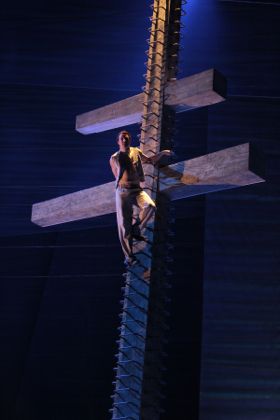
Liam Bonner as Billy Budd
Photo by Robert Millard courtesy of Los Angeles Opera
Baritone Liam Bonner was Billy Budd, and he made the role his own with an uncomplicated wholesomeness, with a simplicity of persona and sound that made his Billy a real boy more than an encompassing image of male innocence. Again it is the genius of this production that it can transform wholesomeness into a transcendent, even mythic condition.
Smaller roles were sensitively cast and generally well performed, particularly the Red Whiskers of Greg Fedderly and the Dansker of James Creswell.
The Los Angeles Opera Orchestra is a capable ensemble but it inherently lacks a beauty of tone that could complete and fulfill the acoustical aspiration of this production. Conductor James Conlon well supported the larger outlines of the Britten drama and made it riveting, but he did not achieve the humanity, the softness, the sense of loss and personal tragedy that a deep musical reading will find to grip and possess a listener.
Cast and Production
Liam Bonner (Billy Budd), Richard Croft (Captain Vere), Greer Grimsley (John Claggart), Anthony Michaels-Moore (Mr. Redburn), Daniel Sumegi (Mr. Flint), Patrick Blackwell (Lieutenant Ratcliffe), Greg Fedderly (Red Whiskers), Jonathan Michie (Donald), James Creswell (Dansker), Craig Colclough (Bosun), Keith Jameson (Novice), Paul LaRosa (First Mate), Daniel Armstrong (Second Mate), Valentin Anikin (Novice’s Friend), Vladimir Dmitruk (Maintop), Matthew O’Neill (Squeak), Museop Kim (Arthur Jones). Los Angeles Opera Orchestra and Chorus, James Conlon (conductor), Grant Gershon (chorus master). Francesca Zambello (production) Julia Pevzner (stage director), Alison Chitty (scenery and costume designer), Alan Burrett (lighting designer), Ed Douglas (fight director).
Lucia di Lammermoor in Los Angeles
When he is conducting a performance at L.A. Opera James Conlon gives the pre-opera talk. He is charming, witty and knowledgeable, making him a very popular man. More importantly he has the potential to create a much bigger role for the orchestra and the music in the minds and hearts of his audience. And often he does.
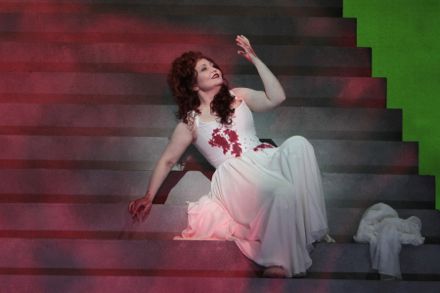
Albina Shagimuratova as Lucia
Photo by Robert Millard courtesy of Los Angeles Opera
After all opera is much more than the thrill of a singer squarely hitting a high note (though an even bigger thrill is when singer cracks or does not quite make it). When a finely sung note is placed in the an expressive musical line colored by the sounds of the orchestra it assumes emotional stature. Add to this a situational context — the physical attitude of a singer within an environment that completes a human story — this is real opera.
Maestro Conlon in his talk on Lucia di Lammermoor wanted his listeners to know that bel canto means beautiful voices. He did not say beautiful singing. In the examples he chose to illustrate his sketch of the bel canto style he used the golden voices of the of the last century, those who sang in the big houses around the world — tenors Domingo, Pavarotti, and Di Stefano, sopranos Maria Callas (though the maestro qualified that it was not a beautiful voice) and Joan Sutherland (though the maestro qualified that she does does not form words when she sings).
Opera has come a long way since these artists were thrilling audiences with beautiful (except Maria Callas), exciting voices and magnificent high notes. But it certainly was not voices like these that we were to hear once inside the Dorothy Chandler. Lacking golden age voices these days we hoped we would hear voices that would thrill us with bel canto style, singers who would sing beautiful music, and sing it beautifully. Some of us were not sitting there just to be amazed by a lot of quickly sung notes and a grand high note or two at the end of an aria so that we would wildly applaud.
But according to maestro Conlon’s pre-opera lecture that was exactly why we were there. The situation at opening night was exacerbated by minor press being seated in the upper reaches of the Founders Circle (well past the end of the alphabet). From the best of its seats the Dorothy Chandler does not offer beautiful sound and sitting under the balcony overhang in the Founders Circle we were offered minimal though harsh orchestral sound supporting huge, acoustically magnified voices. After intermission we moved into a couple of the many empty seats closer to the stage. It was better.
One can accept the acoustical quirks of theaters. It is much harder to accept poor harp playing (Donizetti’s extended harp obligato was nervously played, and flubbed) and lack-luster French horn playing (in his pre-opera talk the maestro had used the horns of the Vienna Philharmonic). It is very hard to accept singers who are not initiated into the bel canto style, or singers who are not of the appropriate voice. Bass James Creswell is not a basso cantante nor a singer equipped to hold the stage in exposed starring roles, baritone Stephen Powell’s program book repertoire includes no bel canto roles, nor does he have the delicacy of voice and temperament to approach such roles. The small roles were taken by singers from L.A. Opera’s young artist program — boys sent in to do men’s work.
It was a new production directed by Elkhanah Pulitzer who has credits as an assistant director at the operas of Los Angeles and San Francisco. The concept seems to have been based on the misconception that bel canto is presentational therefore singers face forward and sing with little or no need to move. The female chorus, identically dressed made silly synchronized movements and peculiar hand and arm motions as if the music were mechanical, these movements attributed Kitty McNamee. The set was designed by Carolina Angulo, the “design manager” at L.A. Opera, perhaps her professional debut. The visual concept was abstract, hard edged shapes in bright primary colors, there was a dominant projection of a white circle, presumably the Scottish moon, sitting on a symmetrical blue semi-circle, and other abstract projections, maybe they were trees, by Wendell K. Harrington. There was not an iota of bel canto in sight.
Russian soprano, Albina Shagimuratova is a formidable Queen of the Night thereby well able to negotiate the high fast notes that portray Lucia’s madness. But there is a softness as well in Lucia, a suspension of voice and feeling that Mme. Shagimuratova does not find. Working counter to the staging conception she attempted to create high acting drama that included countless full body falls. The same may be said of the Edgardo of Albanian tenor Saimir Pirgu. This fine young artist needed direction on the stage and from the pit to keep his performance from deteriorating into senseless opera singing and acting.
James Conlon is a unique and powerful musical force who does not seem to have a sensibility for bel canto.
Cast and Production
Albina Shagimuratove (Lucia), Saimir Pirgu (Edgardo), Stephen Powell (Enrico), James Creswell (Raimondo), Joshua Guerrero (Normanno), D’Ana Lombard (Alisa), Vladimir Dmitruk (Arturo). Los Angeles Opera Orchestra and Chorus. James Conlon (conductor), Elkhanah Pulitzer (stage director), Wendall K. Harrington (projection and scenic designer), Carolina Angulo (scenery designer), Christine Crook (costume designer), Duane Schuler (lighting designer), Rick Fisher (lighting designer), Kitty McNamee (movement)
Pesaro's 2015 Rossini Festival
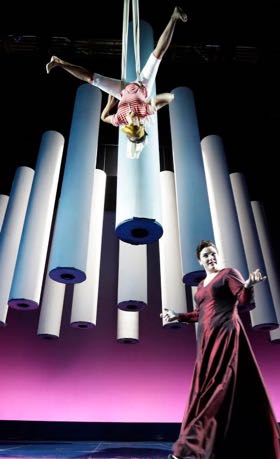
Sandhya Nagaraja as the magpie, Teresa Herovlino as Lucia in La gazza Ladra
All photos copyright Studio Amati Bacciardi, courtesy of the Rossini Opera Festival.
The 36th Rossini Opera Festival in Rossini’s Pesaro! La gazza ladra (1817), La gazzetta (1816) and L'inganno felice (1812) — the little opera that made Rossini famous.
Though these dates encompass the well known Rossini comedies, both L’inganno felice and La gazza ladra are not comedies but semi-serious operas. La gazzetta, beyond comedy, is just plain farce. Rossini then established himself firmly in Naples where he wrote his great tragedies (though few of today’s opera goers can name more than one or two). Once in Paris he did finally write one last comedy (Le conte Ory in 1828).
Many of us with serious Rossini addictions make an annual pilgrimage to Pesaro where at times we do achieve Rossini nirvana. Such was not the case this August, though there were hints of the great Rossini in L’inganno felice.
The leaky, forlorn Adriatic Arena (home of Pesaro’s famed basketball team) also serves each summer as one of the world’s most interesting and exciting opera houses. This summer the opera installed in this vast space was La gazza ladra or in English The Thieving Magpie, a remount of the 2007 Pesaro production by Damiano Michieletto of recent Covent Garden Guillaume Tell booing fame whose Sigismondo (2010) in Pesaro was soundly booed as well — of course there were vocal protestations at his bows on the opening night of this La gazza ladra.
Stage director Michieletto’s conceit is that Rossini’s opera is a dream fantasy of an adolescent girl. She arranges a few small white tubes on the floor, fashions a sort of swing from some hanging cloth, climbs on and swings about the stage for a while. While it is obvious she is going to be the magpie it is not obvious what the 15 tubes are — cigarettes or tampon cases were overheard intermission interpretations. The tubes were then scenically amplified to provide the huge and only scenic elements.
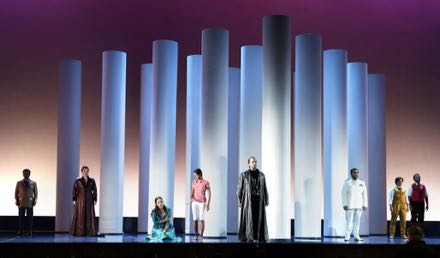
Principal Gazza ladra singers in ensemble scene, with magpie in center (in white shorts)
Whatever they might be (for Michieletto they are probably only white tubes) their geometrical arrangements on the stage were Michieletto’s idea of minimalism, as were the costumes, the heroine in a bright green dress the entire evening, the chorus women first in identical brilliant red dresses, then for the execution in identical taupe toned dresses as examples. The chorus was staged in geometric lines or blocks executing geometrically repetitive movements. Five storm troupers made a straight line tableau across the front of the stage displaying their Uzis horizontally over their heads for the execution of the simple peasant girl.
Michieletto is not a musical stage director, insisting that his adolescent magpie-girl intrude, clumsily choreographed, among the singers at the very moments it was possible that Rossini lyricism might take flight. La gazza ladra is mature Rossini, and that means that there is a big cast and abundant ensembles of magnificent musical architecture. This director is oblivious of these structures, placing his five, six or seven singers (and chorus) in arbitrary geometric patterns instead of allowing musical imperatives to determine how, when and where the components move. The famed crescendo of intensities of these fabulous ensembles were therefore intentionally thwarted.
The Rossini Festival has engaged Mr. Michieletto to stage a new La donna del lago for next summer. Go figure.
La gazza ladra is a semi-seria opera — a servant girl of a tenant farmer will marry the farmer’s son but not before it is determined who stole the silver spoon. Meanwhile the servant girl is assumed to have been the thief and has been condemned to death. It is absolute farce endowed with powerful emotional moments that require important musical involvement — its obvious dramaturgical and musical challenges are daunting.
The musical direction of this avowed Rossini masterpiece was entrusted to veteran conductor Donato Renzetti. Mo. Renzetti’s big Rossini period (in Pesaro and elsewhere) was in the early 1980’s. There has been much refinement in the musical understanding of Rossini in the last 30 years that has well surpassed the slow and heavy realization that this maestro imposes. It may well have comfortably accommodated the needs and expectations of the singers of previous generations but it does not support current musical practice. This was evidenced by repeated musical misunderstandings of the orchestra players and some of the singers, i.e. they felt and expected a celerity that was intentionally and forcefully squashed.
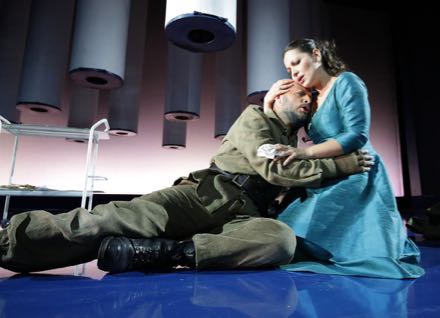
Alex Esposito as Fernando, Nino Machaidze as Ninetta
The role of the servant girl Ninetta was given to Georgian soprano Nino Machaidze. This artist, much beloved by Los Angeles audiences (Gounod’s Juliet as well as Traviata and Boheme) was the perfect, unrepentant Fiorella in L.A Opera’s production of Il turco in Italia, her hard-edged, brilliant coloratura dramatically convincing. Mme. Machaidze does not possess a sweet voice nor does she project a sweet personality that could embody the simple Ninetta. She is all diva business, and she does it very well, but these attributes do not make her a Rossini artist.
There was one fine Rossini artist in the cast, Alex Esposito who sang Ninetta’s father Fernando Villabella. This esteemed bass exudes character and executes thrilling coloratura. Pesaro audiences are famous for extended applause given well performed arias (or scenes). Mr. Esposito’s second act aria was the sole recipient of such appreciation for the entire four hour duration of the performance.
La gazzetta
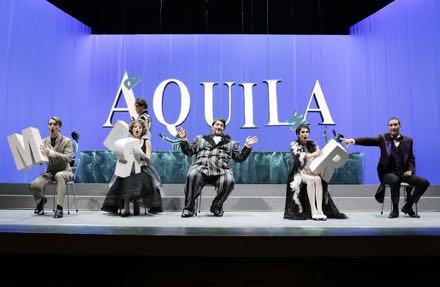
Principals singers of La gazzetta
La gazzetta or in English The Newspaper was on stage at the 800 seat, horseshoe Teatro Rossini the second night (of the second cycle). This opera was a contractual obligation for Napoli’s Teatro dei Fiorentini (FYI it is now a bingo palace) where audiences loved to be entertained. Rossini lifted some of La gazzetta’s major pieces from his masterwork Il turco in Italia (1814), and composed fine new material as well that found its way a few months later into his masterwork La Cenerentola.
La gazzetta is not a masterwork. A simple enough story (albeit three pages of synopsis needed): a silly father places an ad in the Gazette of Paris offering his daughter in marriage. She however loves the innkeeper. It is a three hour mess that finally gets cleared up at a costume party. As the libretto is based on a play by famed 18th century playwright Carlo Goldoni there is a lot of lively repartee that leaves us non-Italians (there are a lot of us and we come from around the globe) at a disadvantage — plus the supertitles are way above the stage and in 18th century Italian.
None the less there was a lot to look at on the stage, too much, but the story was easy to follow. We just missed the Goldoni wit that we knew was there and way above us. Rossini is performance art, this piece dominated by an electric performance by dead ringer Rossini look-alike Nicola Alaimo (a Metropolitan Opera Falstaff as well as a famed Guillaume Tell) as Don Pomponio, the silly father.
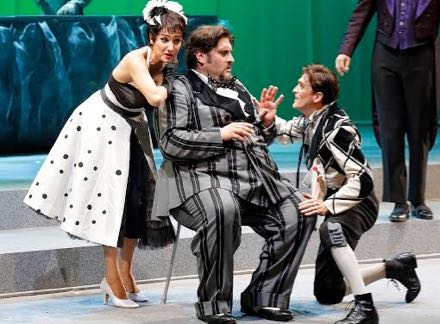
José Maria lo Monaco as Madama La Rose, Nicola Alaimo as Don Pomponio, Ernesto Lama as Tommasino
Stage director Marco Carniti gave Don Pomponio a side-kick servant mime he named Tommasino who seconded Don Pomponio’s decisions, argued with them, insisted that Don Pomponio’s wishes be carried out, and suffered Don Pomponio’s frustrations by repeated beatings. Neopolitan actor Ernesta Lama however was not a mute mime as he could not help himself from speaking out from time to time. It was pure comic delight. Stage director Carniti gave this physical theater performer much activity, and it was thoroughly musical, his physical intrusions into the arias and ensembles fully consistent with Rossini’s musical architecture (unlike the arbitrary Magpie intrusions in La gazza ladra).
Marco Carniti and his designer Manuela Gasperoni created a stage box fully enclosed by translucent plastic strips that easily absorbed projected colored light when not serving as a silhouette surface. Much of the mise en scène was in black and white, the costumes by Maria Filippi (a Franco Zeffirelli collaborator as well) were primarily in black and white but sometimes with bright color accents. This high design concept supported endless production numbers (like 1950’s American film musicals), including highly choreographed movement of the abstracted set pieces and much movement by four fine supernumeraries.
It was all too much for the simplistic wit of farce, and at the same time it was very well done and musically solid.
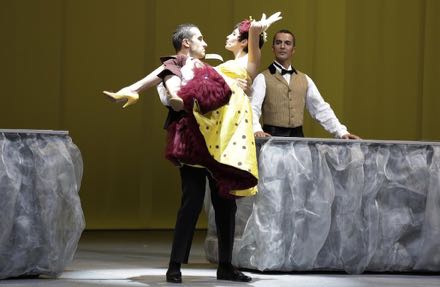
Hasmik Torosyan as Lisetta, Vito Priante as Filippo
The singing was of good level, notably the silly father’s daughter Lisetta, sung by young Armenian soprano Hasmik Torosyan who last summer was a participant in the festival’s young artists program, the Accademia Rossiniana. The innkeeper Filippo was sung by Vito Priante who with Nicola Alaimo were the two fully accomplished performers of the evening, Mr. Priante offering delightful coloratura dressed as a Turkish suitor in the masquerade.
Conductor Enrique Mazzola provided an unobtrusive, fully idiomatic orchestral basis, but the wit and charm of Rossini’s orchestrations were overwhelmed by the production.
L'inganno felice
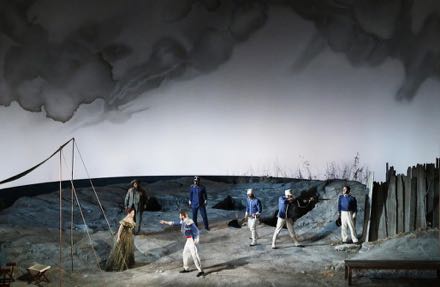
Principal singers of L'inganno felice
A Graham Vick production is always news, even moreso because this L’inganno felice was the revival of his 1994 Pesaro production for the Teatro Rossini, staged before he had become one of the world’s most admired and adventurous stage directors. In recent years he has reappeared at Pesaro with Mosé in Egitto (2011) and Guillaume Tell (2013) — both mise en scènes are masterpieces.
L’inganno felice is a simple, sentimental farce, the oft-used situation of a foundling baby, but here beautiful young woman, having been washed up on a shore. Here the shore was near a remote mine somewhere. A kindly old miner protects her and engineers a safe return to her beloved husband by tricking the very evil suitor she had rejected.
Vick and his designer Richard Hudson (most famous for The Lion King [1988], but on the other hand famous for this winter's Graham Vick production of Götterdämmerung at Palermo’s Teatro Massimo) imagined one grand diminution of light over the one and one half hours of the opera’s only act. The production’s original lighting designer Matthew Richardson returned to once again effect this spectacular light show — high noon becomes late afternoon then early evening, finally night falls to give cover for the deception. Meanwhile a miniature steamship traverses the far away, endless horizon for the duration of the action.
The set is an enormous curved white cyclorama with some Japanese looking gray splotches as clouds. There was a hole for the mine, a bench on the right indicating a house just offstage. When Nisa’s long lost husband, Bertrando happens to happen by he erects a tent on the other side of the stage. The stage floor is in cinematic detail, a realistic slope complete with struggling shrubs.
However Bertrando and his soldiers are straight out of nineteenth century operetta, Bertrando with grandiose epaulettes. Greek tenor Vassilis Kavayas, a recent Rossini Academician, brought ultimate snap and sparkle to his character as did his snappy soldiers to their marching entrances and exits.
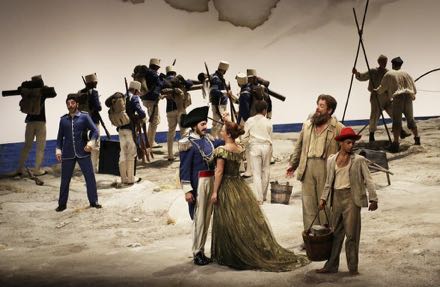
Giulio Mastrototaro as Ormondo (blue uniform), Vassilis Kavayas as Bertrando, Mariangela Sicilia as Isabella, Carlo Lepore as Tarabotto, plus soldiers and supernumeraries
The realistically costumed rustic miner Tarabotto was sung by veteran basso-buffo Carlo Lepore whose accomplished presence anchored the young cast. Also simply costumed in rags was Nisa, sung by ingenue soprano Mariangela Sicilia, a recent Rossini Academician as well. She began the evening with a splendidly sung contemplation of a tiny necklace pendent portrait of her long lost husband. Most of her remaining music required sustained singing but as the evening progressed her intonation seriously deteriorated.
Young Italian baritone Davide Luciano brought seriously snappy buffo to his role, Batone, an ardent, if not too bright sergeant. He had much to sing, and did a convincing and charmingly energetic performance that made you wish his coloratura was just a bit sharper. As it was the high point of the evening was the extended duet Batone sings with the miner Tarabotto where Tarabotto induces him into the deception. This duet and Alex Esposito’s aria “Eterni Dei, che sento!” in La gazza ladra were the two high points of all three operas of the festival)
With his eclectic set and his spotty cast Graham Vick’s palate had a bit of everything to work with. It was all masterfully laid out in low key, absolutely unpretentious terms, allowing us to enjoy all these wonderful performances without critical prejudice — though may we believe that back in 1994 perhaps the Vick production had considerable artistic prétention.
Great Rossini begins in the pit. The conductor was a thirty-four year old Russian, Denis Vlasenko, still another of the evening’s former Rossini Academicians. While Pesaro’s Orchestra Sinfonica G. Rossini lacks the finesse of the Orchestra del Teatro Comunale di Bologna (in the pit for La gazza ladra and La gazzetta) this young maestro still was able to create an estimable Rossini elation from time to time, the Rossini high that brings us back to Pesaro year after year.
Casts and production information
La gazza ladra: Vingradito: Simone Alberghini; Lucia: Teresa Iervolino; Giannetto: René Barbera; Ninetta: Nino Machaidze; Fernando Villabella: Alex Esposito; Gottardo: Marko Mimica; Pippo: Lena Belkina; Isacco: Matteo Macchioni; Antonio: Alessandro Luciano; Giorgio: Riccardo Fioratti; Ernesto/Il Pretore: Claudio Levantino; Una Gazza (mute): Sandhya Nagaraja. Orchestra e Coro del Teatro Comunale di Bologna. Conductor: Donato Renzetti; Stage director: Damiano Michieletto; Scenery: Paolo Fantin; Costumes: Carla Teti; Lighting: Alessandro Carletti. Adriatic Arena, Pesaro, Italy, August 13, 2015.
La gazzetta: Don Pomponio Storione: Nicola Alaimo; Lisetta: Hasmik Torosyan; Filippo: Vito Priante; Doralice: Raffaella Lupinacci; Anselmo: Dario Shikhmiri; Alberto: Maxim Mironov; Madama La Rose: Josè Maria Lo Monaco; Monsù Traversen: Andrea Vincenzo Bonsignore; Tommasino (mute): Ernesto Lama. Orchestra e Coro del Teatro Comunale di Bologna. Conductor: Enrique Mazzola; Stage director: Marco Carniti; Scenery: Manuela Gasperoni; Costumes: Maria Filippi; Lighting: Fabio Rossi. Teatro Rossini, Pesaro, Italy, August 14, 2015.
L’ingannno felice: Mariangela Sicilia; Bertrando: Vassilis Kavayas; Ormondo: Giulio Mastrototaro; Tarabotto: Carlo Lepore; Batone: Davide Luciano. Orchestra Sinfonica G. Rossini. Conductor: Denis Vlasenko; Stage director: Graham Vick; Scenery and Costumes: Richard Hudson. Lighting: Matthew Richardson. Teatro Rossini, Pesaro, Italy, August 15, 2015.
Die Eroberung von Mexico at the Salzburg Festival
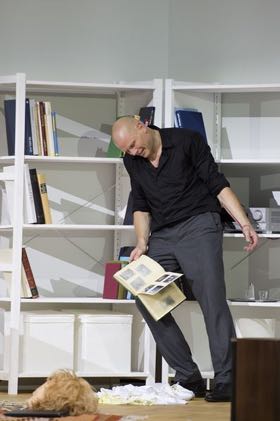
Bo Skovhus as Cortez
Photos courtesy of the Salzburg Festival
That’s The Conquest of Mexico, an historical music drama composed in 1991 by German composer Wolfgang Rihm (b. 1952). But wait. Wolfgang Rihm construed a few sentences of Artaud’s La Conquête du Mexique (1932) mixed up with bits of Aztec chant and bits of poem(s) by Mexico’s Octavio Paz (d. 1998) to make a libretto.
Like Nobel Prize winning (1991) poet Octavio Paz composer Wolfgang Rihm is at once a neo-modernist, a surrealist, an existentialist and an esotericist both as a composer and a librettist/poet. More than likely he and his collaborator for this production, stage director Peter Konwitschny are not like Artaud who discovered and devoured peyote during the year he lived in Mexico. There is no way a creation like The Conquest of Mexico with its complexities of concept, of sound and of staging could have been realized without absolute clarity of intellect and solidity of purpose. It was an evening of cold calculation.
What messieurs Rihm and Konwitschny do share with Antonin Artaud is cruelty. It was an unpleasant sometimes disgusting, too long evening that forced you to admire the resources of theater and the skill of execution, an evening that transported you finally to a plain of existential comprehension, this a place you would never dare attempt on your own — too scary. And this was the pleasure perpetrated by the opera, and this pleasure was finally enormous.
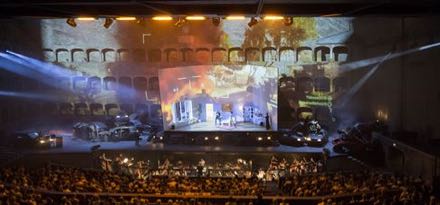
The back wall is the arcades of the Felsenreitschule (Summer Riding School) carved into the Salzburg mountainside that is now part of one of the three adjacent theaters of the Salzburg Festival, plus the wrecked cars and apartment of the production.
The Conquest of Mexico is a star vehicle for baritone if ever there was one. In this case it was Bo Skovhus who was Cortez, or in Artaud parlance the male principle. His inherent masculinity was blatant, this is not at all a personal compliment. He climbed through a massive pile of dirty wrecked cars (evidently Mr. Konwitschny’s male principle metaphor) to arrive at a sterile box with a window and a sofa and a door to a kitchen (Mr. Konwitschny’s female principle metaphor to represent Mr. Rihm’s idea of the new world — an opposite world). Montezuma was sung by soprano Angela Denoke whose blond presence was difficult and calculating. It was either rape or it was not but finally it was, the issue of copulation was the neuter world of computer games.
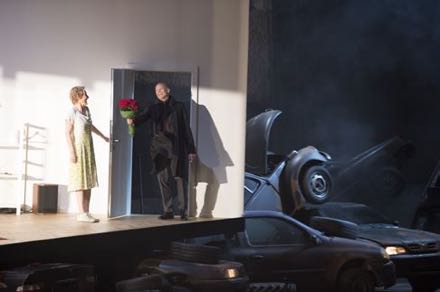
Angela Denoke as Montezuma, Bo Skovhus as Cortez
Before all festival performances the audience gathers in front of the festival theaters for one last aperitif before the performance. Any performance at the festival is a dressy event but you did notice more than the usual number of men in tuxedos, unusually they were young men (the festival audience is mature). Well, at a certain moment (intense noise) these thirty-one young guys rushed down through the audience, clamored onto and over the wrecked cars and finally crashed onto the stage where they provoked a beer blast, cheered on first male oral sex then the ugly rape, and finally slobbered over six scantily clad mädchen and a shinny red Porsche.
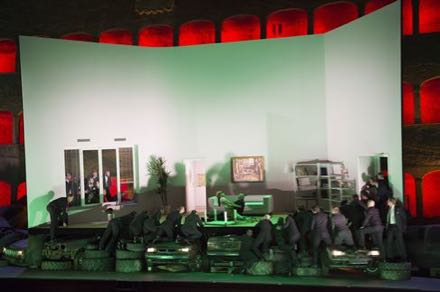
The tuxedo dressed Spanish soldiers
Bo Skovhus killed Angela Denoke (it was that real), then killed himself (in fact this was a very moving, extended scene). But Mr. Skovhus and Mme. Denoke aka Cortez and Montezuma did come together posthumously. They were seated side by side but not touching to sing the a cappella duet that ends the opera, It was the full exposition of Artaud’s neuter.
Did I get all this right?
There was a sizable ensemble of lower voiced instruments in the pit (violas and cellos, bass clarinet, contrabassoon, harp, piano and lots of tom-tom drums, etc. There was a primary conductor, Ingo Metzmacher, plus a second conductor who seemed to be only interested in the stage. There were two far-away orchestras of percussion instruments and brass instruments and a violin seated on an old truck-tire on each side of the wide stage. It was loud, very loud, then louder with a huge compliment of microphones and speakers. It was ugly music. It was meant to be.
In the pit as well were two male Speakers who spent the first part of the evening sitting in the pit making various weird noises with there voices, and a soprano seated in the pit house left who sang very high, freakish notes from time to time, and in the pit on house right a mezzo-soprano sang very low notes from time to time. And from time to time these four singers climbed out of the pit onto the stage, and climbed over piles of tires and wrecked cars to help out Cortez and Montezuma on the stage.
It was a fun evening.
For a formal exposition of the genesis of this work go to the Salzburg Festival website About this production .
Cast and Production
Montezuma: Angela Denoke; Cortez: Bo Skovhus; Soprano: Susanna Andersson; Mezzo-soprano: Marie-Ange Todorovitch; Speaker 1: Stephan Rehm; Speaker 2: Peter Pruchniewitz. ORF Radio-Symphonieorchester Wien. Conductor: Ingo Metzmacher; Stage Director: Peter Konwitschny; Sets and Costumes: Johannes Leiacker; Lighting: Manfred Voss; Video Design: fettFilm; Sound Design: Peter Böhm and Florian Bogner. Felsenreitschule Theater, Salzburg, August 1, 2015.
Norma at the Salzburg Festival
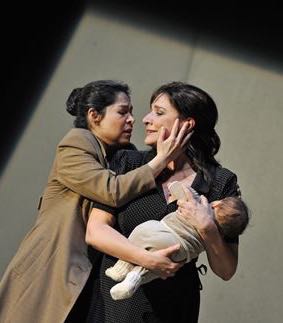
Rebeca Olvera as Adalgisa, Cecilia Bartoli as Norma
This Salzburg Norma is not news. This superb production was first seen at the Salzburg Festival’s springtime Whitsun Festival in 2013 with this same cast. It will now travel to a few major European cities.
The Norma herself is Cecilia Bartoli, and she is as well the artistic director of the Whitsun Festival (where, by the way, this next spring she will sing Maria in West Side Story conducted by Gustavo Dudamel). Evidently Mme. Bartoli is as deft a producer as she is a deft Norma.
Bellini’s spectacular old warhorse is a tour de force for a soprano, Mme. Bartoli’s upper extension is well able to handle the high and intense emotional climaxes, her lower chest voice beautifully portrays Norma’s maternal moments, and in between a strong mezzo-soprano sound well sustains the extended lines and slow motion of the likes of “Casta diva.” Mme. Bartoli’s musicianship is exemplary, her coloratura absolutely splendid, achieving in the cabaletta of rage at the end of the second act astonishing vocal turns that are unique to her artistry.
But all of this has been said many times before. It has also been said that la Bartoli is an exemplary producer, not only casting voices that compliment her sound, technique and musicianship but engaging a conductor and orchestra that simulate an early nineteenth century Bellini musical poetic, in this case La Scintilla, a Zurich Opera founded original instrument ensemble. This splendid orchestra makes a far more mellow sound than the sharp, exciting tones of a modern orchestra, its sound supporting, not competing with the beautiful singing that must resolve the truly impossible, indeed ugly situations proposed by the early Romantics.
Mme. Bartoli’s most brilliant choice is however that of stage director, in this case the French team Moshe Leiser and Patrice Caurier who imposed a concept that portrayed a parallel situation and created an atmosphere and a context that in no way updates what little Bellini knew (and we know) of the Druid fertility ceremony. The staging did not attempt to explain, amplify or go beyond the preposterous story the opera tells. It simply told another story from another century simultaneously. Both stories share a crucial theme — consorting with the enemy.
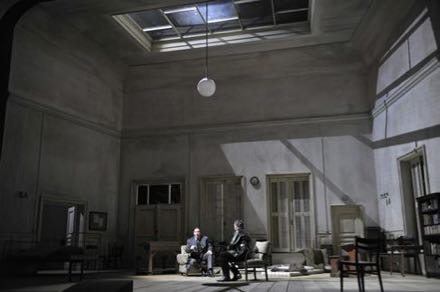
Production by Moshe Leiser and Patrice Caurier, set design by Christian Fenouillat
The mythical Druid world was sung in a school room in Vichy France. It moved to a blank wall, there was a doll in a blanket (an abstraction of Norma’s two children) and finally it returned to the school room that went up in flames. But not before Norma’s hair was hacked off marking her as a sexual collaborator. The ethical conflicts felt by a twenty-first century audience were addressed while the Romanticism of bel canto was allowed to drive naturally to its fiery climax (the fickle lover obviously won over by Norma’s beautiful singing since otherwise his change of heart cannot be comprehended).
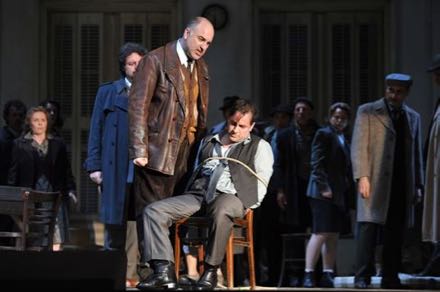
Michele Pertusi as Oroveso, John Osborn as Pollione
American tenor John Osborne is an exemplary Pollione, his sound and presence are of the amplitude to hold his own with two over-wrought sopranos, and his is of sufficient tenorial stature to go to his death with real coglioni — Mr. Osborne is able to respect the grace of bel canto and cut a fine figure as a lover as well be a tenor. Zurich Opera trained, Mexican soprano Rebeca Olvera possesses a much lighter voice than Mme. Bartoli. Her Adalgisa is intended to be girlish rather than monastic, she is vocally virginal in contrast to the maternal mezzo Norma. Italian bass Michele Pertusi sings Oroveso using a natural sharpness of voice that easily withholds all possible forgiveness.
Musically the production was in the hands of Zurich based Italian early music conductor Giovanni Antonini who keeps careful control of his orchestral forces to allow the bel canto to soar in the voices of the singers rather than rise from the pit. This Norma is about singing the Druid world as this world was perceived (maybe) by Bellini. And too this Norma was a collision of centuries.
Cast and productionNorma: Cecilia Bartoli; Adalgisa: Rebeca Olvera; Pollione: John Osborn; Oroveso: Michele Pertusi; Clotilde: Liliana Nikiteanu; Flavio: Reinaldo Macias. Chorus of the Radiotelevisione Svizzera, Lugano; Orchestra La Scintilla at Zurich Opera. Conductor: Giovanni Antonini; Stage Director: Moshe Leiser / Patrice Caurier; Scenery: Christian Fenouillat; Costumes: Agostino Cavalca; Lighting: Christophe Forey. Haus für Mozart, Salzburg Festival, August 31, 2015.
A Midsummer Night's Dream, Iolante and Perséphone at the Aix Festival
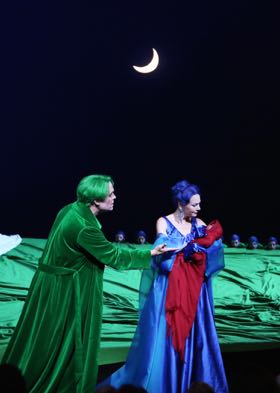
Lawrence Zazzo as Oberson, Sandrine Piau as Tytania
Photo copyright Patrick Berger courtesy of the Aix Festival
Two of the important late twentieth century stage directors, Robert Carsen and Peter Sellars, returned to the Aix Festival this summer. Carsen’s A Midsummer Night’s Dream is a masterpiece, Sellars’ double bill is strange.
A far cry from Christopher Alden’s controversial 2012 Midsummer Night’s Dream at the ENO where 0beron is the headmaster of a boys school and Theseus is his former lover, Robert Carsen’s 1991 production of Le Songe d’une nuit d’été for the Aix Festival floats high above the sexual and social complexities of Shakespeare’s raciest play.
The Carsen production however has become a classic because of the simplicity of its exposition, the intellectual innocence of its concept and the maximal minimalism of its execution. Thus twenty-five years later the Aix Festival has brought this splendid production back to its theater of origin, the Archevêché in a co-production with the Opéra de Lyon where it was staged in 2008.
The excellent Orchestre of the Opéra de Lyon was in the Archevêché pit with its music director Kazushi Ono to illuminate this complex 1960 Britten score, sculpting its lovers, whispering the mysteries of its fairy world, and teasing its rustic actors and opera itself. As often in Britten human actions are played out in an atmosphere of innocence, created just now in Aix by 20 boys from London’s Trinity Boys Choir.
Director Robert Carsen has often collaborated with designer Michael Levine (notably for Boito’s Mefistofele, another Carsen production that has achieved classic stature). The Midsummer Nights Dream exploits a favorite Robert Carsen texture — cloth. The entire stage is a bed complete with huge pillows covered with a brilliant saturated green coverlet. The night sky is another huge mass of saturated color — blue.
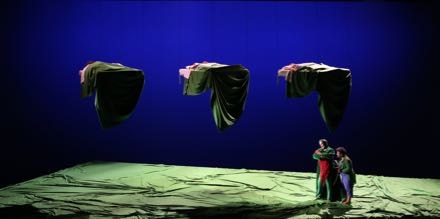
Two pairs of lovers in beds, Tytania and Bottom in far right bed, Lawrence Zazzo as Oberon, Miltos Yerolemou as Puck
Photo copyright Patrick Berger courtesy of the Aix Festival
The fairies are dressed in identical blue and green suits, their hands covered in brilliant red gloves, a color that betrays the hidden and maybe dangerous mysterious of the fairy world. The coup de théâtre is when the fairy world instantly vanishes (whooshed into the lofts by cables) and the blank golden lighted stage has become Athens. No hidden digital magic, just overt mechanical human ingenuity — and it is sublime theater.
Nothing could be simpler, and that is the Carsen brilliance. Here this simplicity transforms the absurdities of Shakespeare’s 17th century world into the absolute normal for Britten’s premonition of the psychedelic ’60’s, no questions asked. It is a distilled theatrical language that was new to the operatic stage in the ‘90‘s. It has withstood the test of time, and for this Midsummer Night’s Dream it once again it effectively stripped away layers of insignificant complications to reveal an unusual innocence in the complicated artistic soul of Benjamin Britten.
The Aix Festival provided a splendid cast led by the green wigged Oberon of American counter tenor Lawrence Zazzo who boasts a male colored alto voice that he used to musical perfection. Tytania was sung by French soprano Sandrine Plau in a shimmering and smooth high voice that made her magical. Bottom was sung by British bass Brindley Sherratt with welcomed authority and wit. Central to the success of this edition of the Carsen production was the Puck played by well known actor Miltos Yerolemou (Star Wars VII - the Force Awakens, Game of Thrones, Wolf Hall) whose 5’3” height left him in the world of boys but whose forty-some years added what seemed to be innocent depravity.
One has come to expect excellent casts at the Aix Festival, and this expectation was upheld throughout the huge cast.
Iolanthe and Perséphone
A Peter Sellars production is expected to be off-the-wall, as was his Zaïde (2010) at the Aix Festival (a remount of the 2006 Lincoln Center production) where a huge sheet metal wall was pounded on throughout the performance. Just now the maximally gifted, perpetual adolescent (he is 57 years old) has remounted his 2012 stagings for Madrid’s Teatro Real of Stravinsky’s Persephone and Tchaikovsky’s Iolanta. Once again it is all about walls, this time though they are full stage flat backdrops that rise and fall throughout the two brief operas, lighted in various hues and intensities.
Usually Mr. Sellars collaborates with off-beat (though firmly in the publicly-supported-art mainstream), culturally diverse designers (like for Perm Opera’s [and ENO’s] recent Indian Queen). But for this production Sellars’ set designer was George Tsypin, an designer fully vetted by virtually every mainstream stage director who toys with advanced theatrical ideas.
We entered the Grand Théâtre de Provence to an a vista set — a few black door frames construed center stage topped by primitive bird heads. We left more than three hours later and it was still sitting there, only by then all of the usual maskings that created the stage picture had disappeared revealing the fully open stage space, Mr. Sellars and Mr. Tsypin stubbornly reveling in this hackneyed image.
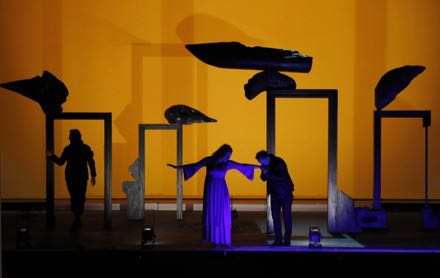
Maxim Aniskin as Robert, Ekaterina Scherbachenko as Iolanta, Arnold Rutkowski as Vaudémont
Photo by Pascal Victor courtesy of the Aix Festival
Mr. Sellars has long held a fascination for Oriental theater forms thus the black covered stagehands of Noh theater were transformed into concert-black dressed choristers who assisted in the storytelling in both operas, construing themselves in geometric shapes from time to time on the stage to sing while they made the uniform, formalized arm motions typical of the abstractions of Asian theater.
Like Zaïde, neither Persephone nor Iolanta are masterpieces, all the better for Mr. Sellars theatrical explorations, here light and dark. In Iolanta it was transcending blindness into sight, in Persephone it was the light of earthly life to the darkness of hell, and back again and back again.
Iolanta, Tchaikovsky’s last opera, is more in the music theater genre than it is opera, its simple story (blind girl regains sight) told in a series of songs and a couple of duets that forlornly replay the great Tchaikovsky moments. Mr. Sellars mostly kept his actors standing in the doorways and relegated his romantic leads to mostly lying still on the floor when not rolling on the floor.
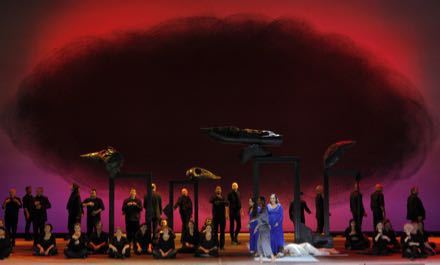
Dominique Blanc (in blue) as Persephone, Paul Groves (lying) as Eumolpe, dancers left of principals, plus chorus
Photo by Pascal Victor courtesy of the Aix Festival
Persephone (1933) comes from Stravinsky’s neo-classic period where much use is made of formalized tableau. It is circus-like theater of catatonic rhythmic repetition according to Stravinsky contemporary Theodor Adorno (a philosopher and aficionado of Schöneberg). Considering Persephone from this point of view it becomes a perfect vehicle for Mr. Sellars’ theatrical genius.
When not done as a concert performance Persephone is danced, a sort of pantomime. Mr. Sellars used four Cambodian dancers who naively imitated André Gide’s narrated and sung poem. One recalled the two Cambodian dancers who wandered aimlessly around the stage for the duration of his 1997 Salzburg staging of Le Grand Macabre.
Russian conductor Teodor Currentzis did not conduct the performance I attended due to illness. It was ably conducted by his assistant, and maybe it was this inexperience that hindered any sense of musical sweep to the evening. Mo. Currentzis is director of the Perm (Russia) Opera (about 800 miles east of Moscow) and is now a frequent collaborator with Mr. Sellars.
The strong voiced, Russian speaking cast for Iolanta sang loudly in fine Russian un-nuanced voices and style. The lone foreigner was American bass Willard White who was the tale’s elegantly voiced Muslim doctor. American tenor Paul Groves was splendid as the Eumolpus, priest of the Eleusinian Mysteries (Persephone abducted into Hades by Pluto). The musical highpoint of the evening was the lovely Tchaikovsky a cappella prayer sung by the chorus of the Opéra de Lyon. It is very rare to hear a 48-voice choir of trained operatic voices singing beautiful, soft music. Simply stunning.
The 2010 Aix audience had no patience for Sellars’ Zaïde. The 2015 audience greatly appreciated this boring double bill. Maybe you had to be French.
Casts and production
Midsummer Night's Dream Oberon: Lawrence Zazzo; Tytania: Sandrine Piau; Puck: Miltos Yerolemou; Theseus: Scott Conner; Hippolyta: Allyson McHardy; Lysander: Rupert Charlesworth; Demetrius: John Chest; Hermia: Elizabeth DeShong; Helena: Layla Claire; Bottom: Brindley Sherratt; Quince: Henry Waddington; Flute: Michael Slattery; Snout: Christopher Gillett; Starveling: Simon Butterriss; Snug: Brian Bannatyne-Scott; Cobweb, Peaseblossom, Mustardseed et Moth: Benedict Hill, Lucas Pinto, Andrew Sinclair-Knopp et Jérémie de Rijk (members of the Trinity Boys Choir. Trinity Boys Choir; Orchestre de l’Opéra de Lyon. Conductor: Kazushi Ono; Mise en scène: Robert Carsen; Décors et costumes: Michael Levine; Lighting: Robert Carsen and Peter van Praet; Choreography: Matthew Bourne. Théâtre de l’Archevêché, Aix-en-Provence, July 16, 2015.
Iolante Iolanta: Ekaterina Scherbachenko; René: Dmitry Ulianov; Robert: Maxim Aniskin; Vaudémont: Arnold Rutkowski; Ibn-Hakia: Willard White; Alméric: Vasily Efimov; Bertrand: Pavel Kudinov; Marta: Diana Montague; Brigita: Maria Bochmanova; Laura: Karina Demurova.
Perséphone Perséphone: Dominique Blanc; Eumolpe: Paul Groves; Perséphone: Sathya Sam; Déméter: Sodhachivy Chumvan (Belle); Pluton: Chan Sithyka Khon (Mo); Mercure, Démophoon, Tripolème: Narim Nam. Direction musicale: Teodor Currentzis; Mise en scène: Peter Sellars; Décors: George Tsypin: Costumes: Martin Pakledinaz et Helene Siebrits; Lighting: James F. Ingalls. Orchestra, Chorus and Childrens Chorus of the Opéra national de Lyon. Grand Théâtre de Provence, Aix-en-Provence, July 17, 2015.
Carmen at the Chorégies d'Orange
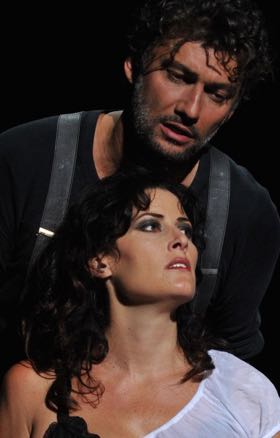
Jonas Kaufmann as Jose, Kate Aldrich as Carmen
Photos courtesy of the Chorégies d'Orange
Some time ago in San Francisco there was an Aida starring Luciano Pavarotti, now in Orange it was Carmen starring Jonas Kaufmann. No, not tenors in drag just great tenors whose names simply outshine the title roles.
But Jose, unlike Aida’s Radamès, is actually the star of the show, Carmen herself is a cameo role, three brief songs, then thrown around a bit and finally stabbed, throttled or drowned depending on directorial humors. In Orange Carmen was one of the unusual interpreters of the role — Kate Aldridge.
Mme. Aldridge once brought the shine of Kansas to Carmen’s Seville (San Francisco Opera 2007) but this estimable artist has matured in Europe where she has embraced the soprano bel canto repertory with great success. Cast now in Orange a bit after her Carmen period the role is still well in her voice and she still makes Carmen a magic presence by sheer vivacity of personality, as she had in San Francisco. It is not a Carmen based on sultry sexiness.
It was a lively night in the 2000 year old Théâtre Antique despite the 37C/100F temperature. Normally at a Chorégies performance there are a few spectators (among the 10,000 or so) who are carried out on stretchers — the steps are steep, the audience aged and much wine has flowed at the hundreds of festive dining tables spread out in the streets of the old town. But no one was going to miss out on this famous tenor doing this famous role.
Given that expectations were inordinately high a couple of boos were heard through the polite applause for the “Habanera.” But that was before we (many, many of us in the audience) became aware that conductor Mikko Franck had indeed transformed Bizet’s fiery opera into a lovely symphonic tone poem. It was of great orchestral personality above all else, and of an inexorable deliberateness of musical exposition. The pit was absolutely detached from the stage.
Upon his re-entry into the pit after the intermission this conductor was met with a resounding chorus of boos (mine included). Mr. Franck conducted seated in an arm chair (yes, there really were arms) seldom glanced at the stage, made the instrumental duets with the singers into brilliant solos for the very fine players of the Orchestre Philharmonique de Radio France (the third act intermezzo for flute was coyly playful rather than the expected flowing reverie), destroyed the quintet with sluggishness, dragged down Micaëla’s aria with agogic elaborations in his accompaniment. Not to mention that the usual impeccable ensemble of the always huge chorus with the pit was painfully missing.
What seemed illuminated orchestral playing at the commencement of the evening — evoking once again admiration of the surprisingly acoustic of this fine old theater — soon became annoying, and in the end belayed the adage that Carmen is indestructible. But had not Mr. Franck, music director designate of the Orchestre Philharmonique de Radio France, destroyed it, the staging of Louis Désiré would have accomplished this singlehandedly.
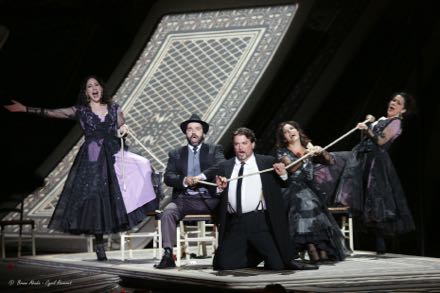
The quintet
Mr. Désiré, who gave us a splendid Tosca in Marseille last spring, evidently determined that the 300 foot expanse of the Théâtre Antique stage prevented all possibility of realizing the physical drama messieurs Meilhac, Halévy and Bizet had imagined. His solution was to make Carmen an oratorio, the identically costumed choristers frozen in blocks, the only physical actions were changing the placements of the famous scenes from one playing area to another (delimited by the surfaces of several huge face-up playing cards, a scattered deck being Mr. Désiré’s scenic concept).
All was not lost however because we did have the fine Don Jose of Jonas Kaufmann. Not that this tenorissimo is a real Jose — his voice is heroic, his delivery refined, his musicianship impeccable. Mr. Kaufmann is a remarkable singer with technique that allows him opportunity to explore and vocally exploit roles that are successful even when delivered monochromatically. In some ways Mr. Kaufmann and conductor Franck were an extraordinary musical match. Like conductor Franck he achieved an elegantly expanded rather than an eloquent performance.
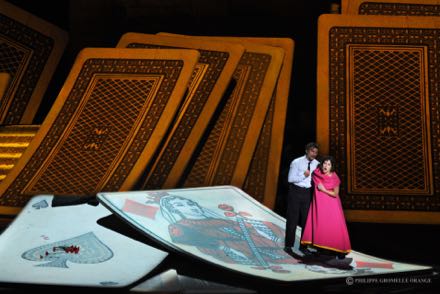
Act IV: Jonas Kaufmann as Jose, Kate Aldrich as Carmen
Physically Mr. Kaufmann’s Jose was scruffy and well acted, hardly the handsome matinée idol of his publicity photos.
Micaëla was sung by 50 year-old Inva Mula, her great experience and confidence triumphing above the over-refined pit, her “Je dis” expansively and knowingly delivered diva style. It was deservedly well appreciated by the audience. Escamillo was sung by Kyle Ketelsen, the Aix Festival’s nimble Leporello and Figaro. He brought a lively wit to this Escamillo that was beyond the scope of this oratorio context. One can only dream of Mme. Aldridge and Mr. Ketelsen in a theatrically informed Carmen in a small theater or maybe even in the huge Théâtre Antique with a conductor and stage director who know that opera is, well, opera.
Cast and production
Carmen: Kate Aldrich; Micaëla: Inva Mula; Frasquita: Hélène Guilmette; Mercédès: Marie Karall; Don José: Jonas Kaufmann; Escamillo: Kyle Ketelsen; Zuniga: Jean Teitgen; Le Dancaïre: Olivier Grand; Le Remendado: Florian Laconi; Moralès Armando Noguera. Orchestre Philharmonique de Radio France, choruses of the operas of Angers-Nantes, Avignon and Nice, Maîtrise (childrens chorus) of the Bouches-du-Rhône. Conductor: Mikko Franck; Mise en scène, décors, costumes: Louis Désiré; Lighting: Patrick Méeüs. Théâtre Antique, Orange, France, July 11, 2015)
Svadba and The Monster of the Labyrinth
in Aix-en-Provence
Monsters and Marriage at the Aix Festival
Plus an evening by the superb Modigliani Quartet (see Concert Reviews) that complimented the brief (55 minutes) a cappella opera for six female voices Svadba (2013) by Serbian composer Ana Sokolovic (b. 1968). She lives in Canada.
Svadba means marriage in Serbian, a slavic language. There are apparently marriage customs that straddle slavic cultures, one of which is the preparation of the bride’s hair for the marriage day, like Konstantin Makovsky’s enormous The Russian Bride’s Attire (1889) that hangs in San Francisco’s Palace of the Legion of Honor. This is simply that.
The opera Svadba follows in the footsteps of the famed Bulgarian State Television Female Vocal Choir so evidently there is a tradition of women’s songs and singing that is strangely absent from Western European and American high art. Plus an evening by the superb Modigliani Quartet that complimented the brief (55 minutes) a cappella opera for six female voices Svadba (2013) by Serbian composer Ana Sokolovic (b. 1968). She lives in Canada.
That Svadba is an opera is a question in itself. It may be more of a painting as there is little if any dramatic development. Mainly there is exposition of subject, like your eye following the story told in the fixed images — a painting. There is of course much physical motion, thanks to the fine efforts of two U.S. trained artists, stage director Ted Huffman and choreographer Zack Windkur who set abstract movement for each of the seven moments of this female version of what in the U.S. is an all male stag party.
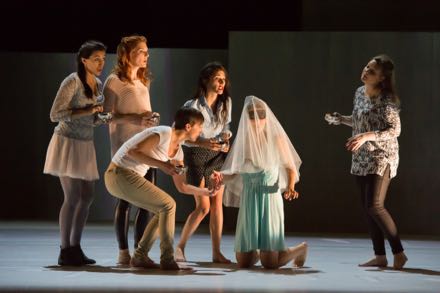
The six singers of Svadba
Photo copyright Bernard Coutant, courtesy of the Aix Festival.
Like immersing yourself in a painting the subject matter of Svadba is of less importance than the delight you find in the way its story is told. Composer Ana Sokolovic created these seven moments with the six female voices, but they are not always a cappella. There were strategic dings of a bell, an electronic tape or maybe a synthesizer, plus noises the six singers created with the few props as well as stomping, clapping and tongue clicking.
The sound world was enormous using the tones of trained voices that mostly moved in soundscapes of close intervals, though of course there was much rhythmic invention of syllables that were both nonsense and Serbian. To our Western ears the formulated voice sounds were all abstract (the sounds were so involving that we ignored the sparse supertitles). When there were melodic moments they were in the modal scales of slavic folk music, and this alone created a long ago and far away atmosphere.
There were two strategic and quite beautiful moments when the voices collided on the first inversion of a triad chord, and the grandiose final moment when the voices resolutely landed on a perfect fifth! It was good music.
The subject matter is essentially slavic folklore though its relevance surely has long disappeared. The metteurs en scène, perhaps the composer as well chose to update the imagery to contemporary dress and action. I found this disconcerting given the specifically dated subject matter. Or maybe there currently are some strange customs among Serbian women who live in Canada.
The six singers were superb musicians with beautiful voices. These 55 minutes were splendid indeed.
Monster of the Labyrinth
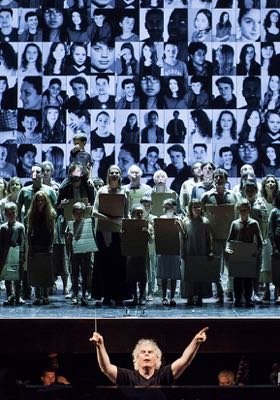
Simon Rattle, conductor
Photo copyright Vincent Beaume, courtesy of the Aix Festival
There was a time when the Aix Festival was at odds with its host city, Aix-en-Provence. Under the stewardship of Stéphane Lissner (1998-2006) the festival floundered artistically though Lissner did succeed in developing a close and cooperative relationship with the citizens of Aix. The festival has indeed regained its artistic footings with the current leadership of Bernard Foccroulle and importantly it has not lost the willing cooperation of the Aix citizenry so ably gained by Mr. Lissner.
To the degree that just now the citizenry of Aix starred in Jonathan Dove’s Monster of the Labyrinth, rendered in French as Le Monstre du labyrinthe. Like Svadba Dove’s Monster is really a concert piece, but unlike the extreme technical demands of Svadba Dove’s Monster was intended to be performed by a community chorus challenged only by the minimal musical demands if not by its considerable length.
Scores, maybe hundreds of Aixoises — men, women and children — had learned the whole thing (a considerable amount of music) by heart, obviously devoting considerable time to rehearse their moves around the Grand Théâtre de Provence.
Monster had its world premiere on June 20 at the Berlin Philharmonic in Berlin, performed next by the London Symphony in London on July 5 (yes, you get it — conducted everywhere by Simon Rattle), and at the Aix Festival on July 8 and 9 again with the London Symphony, though in all cities the orchestras included student, community or semi-professional players.
The music is primarily brass fanfare and huge choruses in a series of scenes that take the youth of Athens to Minos to be consumed by the Minotaur, only to be saved by the young Theseus. It is a piece for amateur performers, their communities and their families, not an work to be savored by opera aficionados and dissected by critics.
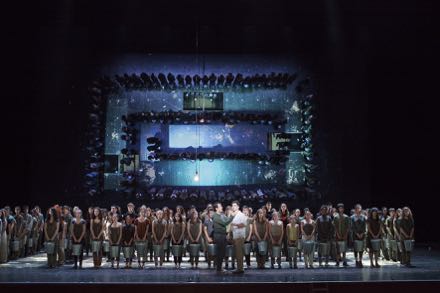
The projected maze, staging by Marie-Eve Signeyrole.
Photo copyright Vincent Beaume, courtesy of the Aix Festival.
Of critical interest in Aix however was the staging by Marie-Eve Signeyrole who last winter gave us an excellent Eugene Onegin in Montpellier. Mlle. Signeyrole’s signature technique is the inclusion filmic action, meaning that she uses an enormous cinema screen as backdrop on which she projects what is happening on stage from various perspectives, and most dazzling from above. Note that this worked perfectly for creating Dedale’s maze. Not only memetic of the stage actions the projections include original material, like the Theseus Minotaur battle enacted by two hugely enlarged, i.e. digitally amplified origami puppets.
The staging was of consummate charm, the masses of choristers moving graciously through the minimal stage elements and finally throughout the auditorium. Upon entering the auditorium we had been given a piece of paper. After the minotaur had been eliminated there was a full stop of everything and the was stage emptied. We were now instructed by 6 year-old boy (alone on the vast stage) how to turn the piece of paper into an origami ship so we could all get back to Athens.
The final celebratory chorus was sung by the choristers surrounding us in the auditorium, Sir Simon Rattle having turned to conduct the dispersed chorister and all of us in a final anthem while we (all of us) proudly held our ships on high.
Oh my.
Die Entführung aus dem Serail and Alcina
in Aix-en-Provence
The 67th edition of the prestigious Festival d’Aix-en-Provence opened on July 2 with an explosive production of Handel’s Alcina followed the next night by an explosive production of Mozart’s Die Entführung aus dem Serail.
Heightened security was evident with the search of all small hand bags entering the theaters, large bags and backpacks were prohibited.
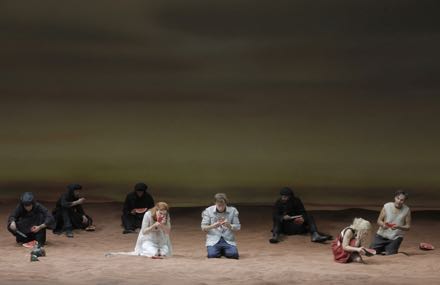
Jane Archibald as Konstanze and Daniel Behle as Belmonte
All Abduction photos copyright Pascal Victor, courtesy of the Aix Festival.
Before the Entführung Aix Festival general director Bernard Foccroulle (foe-crew-yeh) appeared before the audience to make an apology for the production by Austrian director Martin Kušej (koooo-shy) who may have insisted, at least should have demanded that Mr. Foccroulle explain why the festival had eviscerated his production.
Mr. Foccroulle evidently wished to avoid a confrontation such as had occurred a few nights earlier when during a performance the Covent Garden Guillaume Tell audience forcefully objected to graphic violence. Mr. Foccroulle announced that images which might be unsettling to the spectators had been expunged. In some ways the curtain speech was a brilliant move. Once into the first scene (buried in sand up to his neck, only Pedrillo’s un-embodied head saw much of the first act) we knew the specific image in question and it haunted us for three hours before lightening struck.
Make no mistake. The evening was not about Mozart even though the oeuvre of this Austrian composer is the raison d’être of the festival. It was about brutality.
After director Kušej’s Covent Garden Idomeneo fiasco (2013) there could only have been trepidation as to just what he would subject Entführung. In London (and in Lyon where I saw his Idomeneo production) Mr. Kušej found not the liberation granted by 18th century ideals but the revelation that citizens will never be free as long as there is religion. In Entführung the message is sort of the same, except here it emerges in powerful personal terms as the pasha Selim Bassa, played by veteran Austrian actor Tobias Moretti became the central focus of this theater production.
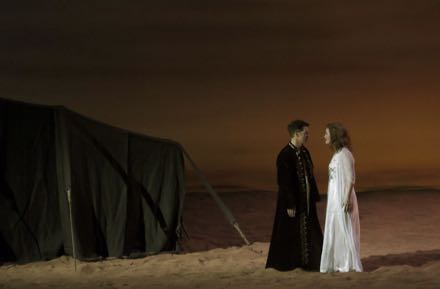
Tobias Moretti as the Pasha, Jane Archibald as Konstanze
The soldiers and their lieutenant Osmin were completely covered in Islamic State black, the Pasha however was in a fashionable, sophisticated Western business suit. Except when he was in loin cloth, whipping himself for love with thorny stemmed roses in a twisted take on the Islamic self flagellation ritual.
The first part of the evening (the escape quartet as its finale) was tough going, having to reconcile irritation at the Foccroulle apology with the heavy handed, blatantly obvious, patently political imagery while dealing with Mozart’s famed musical enlightenment. The second part of the evening left the music in the dust in a series of mostly soundless flash scenes. No more opera, now pure theater. The triumphal chorus sung from the pit, Osmin threw the blood covered white gown of Konstanze — though without her severed head — at the feet of the visibly shaken Pasha. It was big and it was profound.
At the intermission audience comments overheard were mostly that there was too much dialogue. In fact the exposed head of the buried Pedrillo itself tried to move things along suggesting to Belmonte that he stop the “fucking talking and start singing” (or maybe it was the other way around). As the primary enemy of Islam seems to be the Americans the production made much use of such colloquial speech in the dialogues (three of the four lovers were actual Americans), alternating with the Pasha’s hoch theatrical Deutsch declamation and Gottlieb Stephanie’s pretty German verse as set by Mozart.
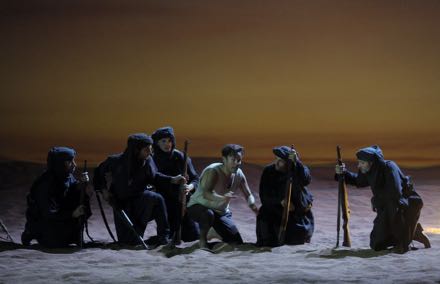
David Portillo as Pedrillo
There was simply too much singing. French conductor Jérémie Rhorer made the mighty Freiburger Barockorchester into a delightful salon orchestra, imposing lightness and a pleasing elegance to the overture. This informal approach was imposed on the singers as well, the arias delivered quite intimately, in stark contrast to the far more powerful rhetoric of the production. The opera itself was the boring if a necessary part of the evening.
There were occasional bright spots, in particular a sweet and beautifully sung “Martern aller arten” by former San Francisco Opera Adler Fellow Jane Archibald and a strong and smooth “Konstanze, Konstanze, dich wiederzushen" by German tenor Daniel Behle. Texas tenor David Portillo and American soprano Rachel Gilmore were the willing Pedrillo and Blonde (we train them well in the U.S.), and German bass Franz-Josef Selig made Osmin a fearsome fighter.
Alcina
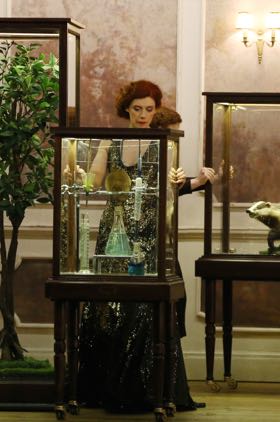
Patricia Petibon as Alcina
All Alcina photos copyright Patrick Berger, courtesy of the Aix Festival
A different set of potential audience vulnerabilities were attacked in Alcina, though about these Mr. Foccroulle remained silent. Within moments of the start of the opera German soprano Anna Prohaska as Alcina’s sister witch Morgana was strapped to a bed, legs splayed downstage, her private parts tickled by a feather duster (these were the coloratura moments of her “O s’apre al riso”), and then, in rapture, she was whipped by Bradamante, the Serbian mezzo Katarina Bradic.
There was no question that British director Katie Mitchell’s Alcina would take place in an English manor since all Ms. Mitchell’s theater pieces are domestic comedies. Here the household was that of two aging spinster witches whose magic created a luxurious sex den where they preside as gorgeous women, Alcina voluptuously — think of the coloratura passages — fucking Ruggiero in her first aria.
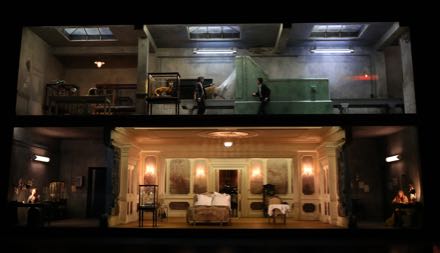
Scenery for the Katie Mitchell production designed by Chloe Lambert
Though when passing from that magical room into their taxidermy workshops both witches become old hags.
Upstairs (surely the Aix Festival recycled Katie Mitchell’s Written on Skin production) was the machinery that transformed men into beasts. Indeed we watched as Astolfo (mute presence) was conveyor-belted into the transformer to emerge as a magnificent stuffed mountain lion. Meanwhile Astolfo’s son, Oberto, a real 12 year-old boy soprano arrived searching for his father. Oberto has two sizable arias (artfully delivered by either Elias Mädler or Lionel Wunsch according to the program booklet). He was carrying a stuffed teddy bear and was carefully ushered from the room when the sex got intense.
After being passively raped by Alcina male soprano Philippe Jaroussky as Ruggiero allowed himself to be meticulously cleaned up by four household maids in efficiently prim black dresses even though one was male. Ruggiero’s fiancé Riccardo was taller and obviously stronger than he and had a real female voice though it was much lower and stronger than his voice. Melisso, the only real male voice on the stage, Polish bass Krzysztof Baczyk (we exclude Oronte because he is a lovesick tenor), meticulously combed Ruggiero’s hair to refresh his masculinity.
Mr. Jaroussky always did seem a bit bewildered, and he did sing more than any of the other characters as well, his lyric soprano voice needing more strength than it could possibly muster, often confusing itself with the same colors as the voices of real female lyric sopranos. The lovesick tenor Oronte, British tenor Anthony Gregory was a willing captive of Morgana who lovingly whipped her during her brilliant Act III aria only to know that he will lose her in his meltingly beautiful aria “un momento di contento.”
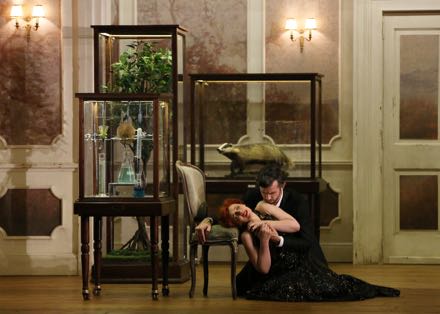
Patricia Petibon as Alcina, Anthony Gregory as Oronte
It was magical, completely magical, made magnificent by Patricia Petibon as the ravishing, red haired Alcina, whose “Ah mio cor” included a high E shriek and then ended the first part of the evening. The audience was left stunned and remained in their seats to give an extended ovation to the fallen curtain. She began the second part with her “Ombre palide” and ended the opera with the spectacular “Mi restano le lagrime,” emotionally emptied in maximum eloquence supported by the heartbroken Oronte, dragging her body across the stage in a succession of beautifully choreographed poses. It was wrenching.
When this wonderfully teasing, titillating magical world was destroyed and the fantasy of two old spinster sisters evaporated, we grieved. The sisters were then placed in the glass case sarcophagi that had held the captive males of their most secret lives. It was a moving end.
And we did not give a damn that Bradamante and Ruggiero were now free to continue their fight to save Europe from Islam.
P.S. The Freiburger Barockorchester was once again mighty, Italian conductor Andrea Marcon honestly provided all the bite and drama necessary to amplify Handel’s splendid drama as envisioned by Mme. Mitchell. It was thrilling indeed when the horns cut loose at the end. The two theorbo players, Daniele Ciminiti and Maria Ferré sat just under center stage, pouring their hearts out in the arias.
Cast and Production
Entführung Selim Bassa: Tobias Moretti; Konstanze: Jane Archibald; Blonde: Rachele Gilmore; Belmonte: Daniel Behle; Pedrillo: David Portillo; Osmin: Franz-Josef Selig. Chœur: MusicAeterna (Chœur de l'Opéra de Perm); Orchestre: Freiburger Barockorchester. Conductor: Jérémie Rhorer; Mise en scène: Martin Kušej; Décors: Annette Murschetz; Costumes: Heide Kastler; Lumière: Reinhard Traub; Dramaturgie: Albert Ostermaier. Théâtre de l’Archevêché, July 3, 2015.
Alcina Patricia Petibon; Ruggiero: Philippe Jaroussky; Morgana: Anna Prohaska; Bradamante: Katarina Bradić; Oronte: Anthony Gregory; Melisso: Krzysztof Baczyk; Oberto: Elias Mädler or Lionel Wunsch (membres du Tölzer Knabenchor). Chœur: MusicAeterna (Chœur de l'Opéra de Perm); Orchestre: Freiburger Barockorchester. Conductor: Andrea Marcon; Mise en scène: Katie Mitchell; Décors: Chloe Lamford; Costumes: Laura Hopkins; Lumière: James Farncombe. Grand Théâtre de Provence, Aix-en-Provence, July 4, 2015.
Fedora in Genoa
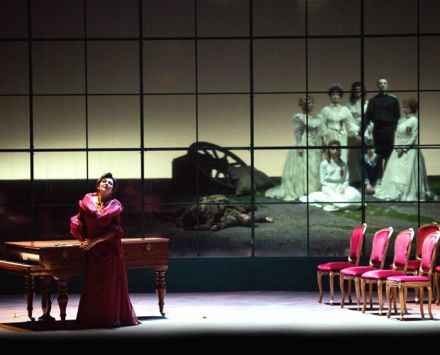
Daniela Dessi as Fedora, Act II
[All photos courtesy of Teatro San Carlo, Genova]
It is not an everyday opera. It is an opera that illuminates a larger verismo history.
If the operas of Giacomo Puccini are the standard bearers for operatic verismo, the stories of Giovanni Verga hold that place in literature. And there was the Casa Sonzogno [an Italian opera publishing house destroyed by a WWII bomb] that sponsored the famous 1888 competition in which Pietro Mascagni’s Cavalleria Rusticana (libretto on a story by Verga) took first place and became the emblematic moment of verismo.
A now forgotten opera by Umberto Giordano, Mala Vita (An Unhappy Life) took sixth place (out of 73 entries) in that competition. Mala Vita is the grizzly tale of a tuberculosis stricken prostitute and was in fact performed in 1890. Note that Puccini’s La boheme premiered in 1896.
Meanwhile in those same years Giordano saw the famed French tragedienne Sarah Bernhardt as Fédora and Puccini saw la Bernhardt as La Tosca, eponymous plays by Victorien Sardou. This facile playwright gave the public what it wanted — intense moments for dramatic outbursts against a colorful historical backdrop, with no demand that the public wade through motivations or contexts.
The operas Fedora (1898) and Tosca (1900) are very similar pieces. Both are three brief acts, both are about a powerful female in a politically volatile climate, both end in suicide. But where Puccini lyrically expands the personalities of his protagonists into rich, post romantic music, Giordano stays very close to the action making his story an intense, fast moving single action. Lyric moments are brief and fiery, generally less than a couple of minutes, the music looking forward to the more direct, minimalist tendencies of twentieth century music drama.
The new production of Fedora in Genoa attempts to bring historical depth to the Sardou play. Stage director Rosetta Cucchi and her set designer Tiziano Santi created a huge, full stage window looking upstage onto an imaginary plain where actions went well beyond the direct, let us say brutal happenings taking place downstage — Fedora’s mortally wounded fiance is brought on stage to die (Act 1), Fedora falls in love with the murderer and betrays him to the police (Act II), Fedora regrets this and kills herself (Act III).
The contexts for these acts played out in this imaginary space were visually splendid if rather confusing. There were battle fields that made us think of the of the 1916 revolution far more than remind us of the the specific context of Sardou’s play — the 1881 assassination of Alexander II. This impression was reinforced by a tableau portrait by costumed supernumeraries of the Czar’s family that made us think of the 1918 murders of the Romanov family. [See lead photo.]
To complicate these contexts the whole opera was played as a flashback — a duplicate Loris (as the by now very aged assassin of Fedora’s fiance) sat on the stage apron for the entire opera (including intermissions) only to walk into the imaginary plain in the final moments of the opera for a brief encounter/recognition of a young goatherd, perhaps the youngest son of the assassinated Ivan the Terrible. Or what?
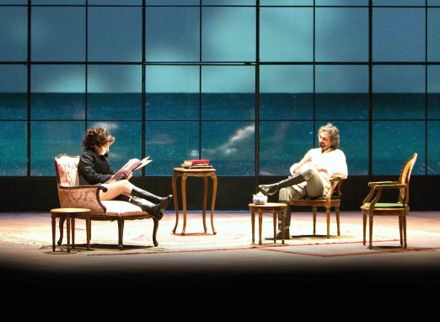
Daniela Dessi as Fedora, Fabio Armiliato as Loris, Act III
Of course none of this really mattered because Giordano’s opera is about the immediate passions of a rich Russian aristocrat, the widow Fedora. Fedora was sung by 56 year-old diva Daniela Dessi. Loris, the assassin of her fiancé and a suspected nihilist, was sung by 59 year-old Fabio Armiliato (both ages determined by birth dates found on the internet). These two formidable artists are partners in real life. Both were in good voice, but voices no longer capable of carving Giordano’s unique vocal exclamations in easy tones, relying instead large, uncolored wooden sounds. It was obvious that both artists knew well and once embodied the vocalism and the musicality of the style, and that they were working hard and honestly to achieve it again. The result was compromised.
Fedora’s friend Olga was enacted by Russian soubrette Daria Kovalenko, ably creating the intended overbearing presence of such a Slavic personality. Pianist (in real life) Siriio Restani, the Carlo Felice house pianist, had his moment in the spotlight giving the Act II solo concert against which Fedora and Loris declare their love in a precious scene that would find itself perfectly at home in the shallow sensualism and sensationalsim of Italian decadentismo, a parallel style to gritty verismo.
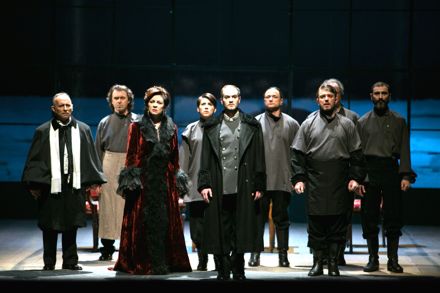
Daniela Dessi as Fedora, Male Supporting Cast
The myriad of smaller roles were executed with typical Italian panache.
The greater impact of the evening was lost by a late start for the brief first act, explained somewhat by an announcement about some casting problem, then there was an overly long first intermission. After the brief second act there was a very extended intermission (one can assume there was some backstage drama, left unexplained). The orchestra players became impatient and began stamping their feet, and finally we were given the brief third act. The far less-than-sold-out house gave la Dessi a huge ovation.
The pit at the Teatro Carlo Felice does not offer a great presence to an orchestra. None the less it was obvious that we were in fine musical hands. Young conductor Valerio Galli, already a verismo specialist, made the most of Giordano’s sophisticated score over this too long evening.
Cast and production
Fedora: Daniela Dessì; Loris: Fabio Armiliato; De Siriex: Alfonso Antoniozzi; Olga: Daria Kovalenko; Dimitri: Margherita Rotondi; Desiré: Manuel Pierattelli; Il Barone Rouvel: Alessandro Fantoni; Cirillo: Luigi Roni; Boroff: Claudio Ottino; Gretch: Roberto Maietta; Lorek: Davide Mura; Nicola: Matteo Armanino; Sergio: Pasquale Graziano; Michele: Roberto Conti; Boleslao Lazinski: Sirio Restani. Chorus and Orchestra of Teatro Carlo Felice. Conductor: Valerio Galli; Metteur en scène: Rosetta Cucchi; Set Design: Tiziano Santi; Costumes: Claudia Pernigotti; Lighting: Luciano Novelli. Teatro Carlo Felice, Genoa, March 25, 2015.
Tosca in Marseille
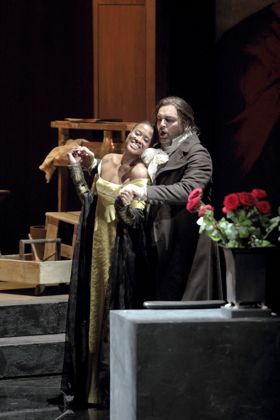
Adina Aaron as Tosca, Giorgio Berrugi as Cavaradossi
Rarely, very rarely does a Tosca come around that you can get excited about. Sure, sometimes there is good singing, less often good conducting but rarely is there a mise en scène that goes beyond stock opera vocabulary.
The recent, misguided Pierre Audi production at the Opéra de Paris as example. Despite its slick “look” it was no more than the emperor in new clothes. But maybe you made your way to Marseille last week where the new production (sets/costumes/stage direction) by Louis Désiré restored your faith in revisionist productions. And in Tosca.
It was not a cast of singers in Marseille that limited its sights to the verismo thrills perpetrated by larger than life opera singers and effect mongering conductors. It was a cast that immersed itself in a revision of Tosca. No longer a mere showpiece for powerful singers of powerful personality the opera had become true theater where every word was eloquent and every gesture carved — a revisionist Tosca if there ever was one.
Director Désiré imagined Puccini’s “shabby little shocker” in a shadowy atmosphere that bespoke the prevailing dangerous political climate in which corrupt power, jealousy and unfettered lust exploded into lurid happenings. The production was in fact a study in chiaroscuro — fields of darkness with shafts of yellow light at the precise moments when emotions flared.
Lighting the singers will have been a monumental task, not only for the very accomplished lighting designer Patrick Méeüs, but also for the actors to learn where and when to move into and out of the shafts of light (note that Mr. Méeüs primarily designs lighting for dance where directional lighting techniques are highly developed).
Marseille born Louis Désiré maybe began his career as a costume designer or maybe as a set designer (the program bio is unclear). As both he is known to American audiences as a collaborator of American director Francesco Negrin (Werther in San Francisco and Rinaldo in Chicago).
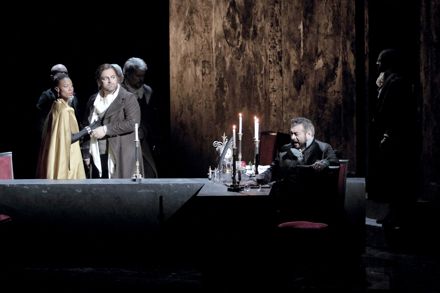
Adina Aaron as Tosca, Giorgio Berrugi as Cavardossi, Carlo Almaguer as Scarpia
As the sole metteur en scène of this Tosca he created stage pictures that are the highly charged personal moments of Mannerist painting — to be clear, it is the moment he captures, not the action. In fact his staging is two dimensional tableaux, occurring with few exceptions within the proscenium frame. He uses clever techniques to reduce this larger frame — for example Scarpia’s Act II table is a long black quadrangle box extending across half the stage, when actors move behind it there lower bodies are hidden, thus a sort close-up is effected.
The large proscenium frame of course was completely filled for the Scarpia “Te Deum.” There was no procession, only Scarpia standing downstage center holding one of the roses Tosca had placed on the altar to the Virgin Mary. Behind him in two straight, across the stage lines were 48 black cossack covered Opéra de Marseille choristers whose arms rose in celestial rapture to Scarpia’s sexual raptures. It was good, very, very good.
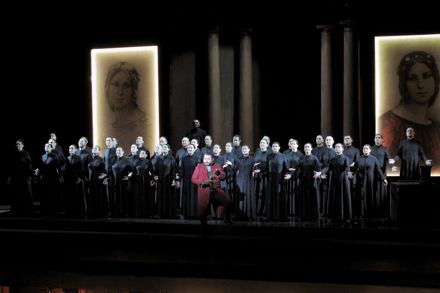
Scarpia’s apartment boasted a small balcony on the side where Tosca escaped to sing her “Vissi d’arte” in a shaft of light, her lower body hidden by the railing. These tableau moments told the sordid tale from beginning to end in a seemingly inexhaustible catalogue of Mannerist inspired poses, epitomized by the execution — Cavaradossi was alone downstage center, the revolving stage had removed the shooters from the frame, Tosca was hidden behind a wall).
American soprano Adina Aaron, dressed the entire opera in an unadorned straight line gold gown (like a shaft of light), created an exotic presence for the actress Floria Tosca, her dark hued voice producing a lovely, burnished spinto tone, her less-than-full-throated high climaxes absorbed into her the musicality of her character. She closed Act II sitting alone down stage center, flanked by two candles to speak Tosca’s “davanti lui tutta Roma tremava.” Delivered with resigned irony the tableau was simply an ironic statement of the line we had been waiting for.
Italian tenor Giorgio Berrugi sang Cavaradossi with exquisite musicality, all famous Italian tenor mannerisms firmly present but impeccably integrated musically. His ease of vocal production in this spinto role made his character about musical line, integrating his music into Puccini’s high octane drama in a flow that supported Mr. Désiré’s flow of tableaux. Of very great pleasure was the dramatic and musical authenticity of his rolled “r”‘s, creating unexpected ornamentation.
Mexican baritone Carlos Almaguer roared with unfettered gusto, as must every Scarpia. In this staging he is not asked to be emotionally complex but simply to reign as the perpetrator of the darkness of Napoleonic political atmospheres. Here he did not complicate his basically gruff delivery with nuance, nor did he attempt to assume an out-sized presence. He underscored director Désiré’s Tosca as a straight forward, uncomplicated recounting of the facts of the story. That he waited until the final curtain calls to take his bow assured the dramatic integrity of the production.
Of note as well was the excellent Angelotti of French bass Antoine Garcin, for once a consul of the fallen Italian republic who showed requisite age and stature.
Italian conductor Fabrizio Maria Carminati sacrificed the showy, obvious effects of this warhorse opera to the far more subtle demands of the production. It is the mark of a real opera conductor to integrate the score into the production. We can be very grateful to Mo. Carminati for the unobtrusive and very able contribution of the pit.
As metteur en scène Mr. Désiré both designs and stages Carmen for the Choregies d’Orange this summer, with lighting by Patrick Méeüs. Not to be missed (cherries-atop-the-cake: Kate Aldridge as Carmen, Jonas Kaufmann as Jose).
Casts and production information:
Floria Tosca: Adina Aaron: Mario Cavaradossi: Giorgio Berrugi; Scarpia: Carlos Almaguer; Le Sacristain: Jacques Calatayud; Angelotti: Antoine Garcin; Spoletta: Loïc Felix; Sciarrone: Jean-Marie Delpas; Le Pâtre: Jessica Murrolo. Orchestre et Chœur de l'Opéra de Marseille. Conductor: Fabrizio Maria Carminati; Mise en scène / Décors / Costumes; Louis Désiré; Lighting: Patrick Méeüs. Opéra de Marseille, March 18, 2015.
The Mastersingers of Nurenburg and The Indian Queen At English National Opera
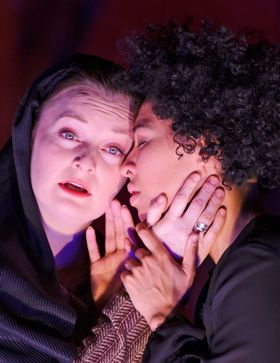
Lucy Crowe as Doña Isabel, Julia Bullock as The Indian Queen
All photos from the English National Opera
It has been a cold and gray winter in the south of France made splendid by some really good opera, followed just now by splendid sunshine at Trafalgar Square and two exquisite productions at English National Opera.
Sometimes you’ve got to get away to find a bit of sun, with good opera a bonus.
It was a brilliantly lighted afternoon making our way through Trafalgar Square on our way to the London Coliseum for the 3 PM curtain of Die Meistersinger, the winter hit of the ENO season. The production by British metteur en scène Richard Jones earned very positive review here on Opera Today, please see The Mastersingers of Nurenberg, as well as in the British press.
Of course it was no longer Die Meistersinger as it had been transformed into The Mastersingers of Nurenburg, and of course metteur en scène Richard Jones transformed Wagner’s noble, some may think pretentious tale of the glory of German art into a definitely unpretentious little story of cruelty to a silly old man (like in real comedy), though it was uncertain if the silly old man was Beckmesser — it might have been Hans Sachs). Like in real comedies true love prevailed, and that was enough to motivate Wagner’s mighty climax (abridged version) with just a tiny wink at German art — flash card faces at the very last moment (there had been a couple of hundred photos/drawings of German artists copied onto on the show curtain of which Jacques Offenbach was in bullseye position).
Like his staging of Ariodante in Aix last summer where the king of Scotland had become a mid-western American farmer, Mr. Jones miniaturized, indeed trivialized Meistersinger, here into a storybook tale. American designer Paul Steinberg created an almost children’s book setting. It was a mostly two dimensional scenic world of wallpaper-like repeating patterns in backdrops, the repetitive shapes echoed as well as in furniture and hand props. The second (riot) act was the intersection of two flat faced streets like classical Roman comedy, and the last scene (the competition) construed most of what we had already seen (props and drops) into grandiose, decidedly mock columns of imperial architecture.
The first scene (with the quintet) of the third act was, of course, the most rewarding. No longer the graphically flat public world of printed books it was the private world of Hans Sach exposed in the cluttered, not-for-public-view realism of a life that is not art, a flesh and blood life discovered in the midst of the artifice of witty and sophisticated design. In fact the quintet itself, surely meant by Wagner to be one of humankind’s greatest moments, stepped outside all scenic context, the singers lined across the stage in brilliant white light. Nothing else.
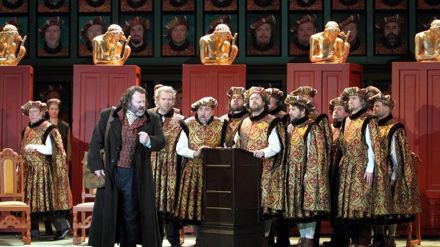
Gwyn Hughes Jones as Walther and the Mastersingers.
The use of the English language at ENO is very practiced, the diction nothing less than miraculous. The preciousness of the diction added a storybook, even infantile musicality that contributed greatly to Richard Jones’ fairytale, indeed satiric vision of what Mr. Jones, and we too might even perceive as Wagnerian bombast. It was this satire that brought honesty and perspective to this magnificent opera for us English speakers. Though maybe, finally, some of us missed the subtlety and gravity of the deeper reaches of Wagnerian thinking.
Back at Trafalgar Square a couple of days later the floating clouds of an ideal English skyscape prevailed during the day though heavy rains were predicted for the evening. The Peter Sellars production did rain heavy changes on Purcell’s 1695 "Dramatik Opera," The Indian Queen. Its original "Heroik Verse" by John Dryden washed away by Mr. Sellars’ Heroik Platitudes of Social Responsibility when not drowned in Down-With-White-European-Males syndrome.
There are those few of us who remember the 1998 Long Beach (CA) Opera production of The Indian Queen by Mexican performance artist Guillermo Gômez-Peña, the Dryden verse adapted to contemporary Chicano actors embodying the stereotypes that north-of-the-[Mexican]-border observers (cultural tourism) have imposed on south-of-the-border. However in the Peter Sellars production Dryden has been exiled from the Purcell intention.
Purcell’s piece does indeed cry out for racial and ethnic exoticism. In the Sellars production a Chicano actress from California narrated the ugly deeds of Dryden's Aztecs whom Sellars had transformed into Spanish conquistadors, manufacturing the evils they could have perpetrated on women and children. Note that this production has already been at Madrid’s Teatro Real where it certainly belongs — may the Spaniards expiate the sins of their past. It was a naive art, fish-out-of-water in London’s sophisticated theatrical world.
Peter Sellars has a fabulous, original theatrical mind and he is a great stage director. It was an evening of highest level theater, brilliantly conceived and realized starting with four dancers who were tirelessly choreographed into exotically titled dance sequences that added Mayan mysteries to Dryden's already absurd geography. Purcell's added Symphony, its parts titled Adagio, Allegro, etc., assumed names like “Dance of the Solar Fire Deities.” Note that a dramatik opera was like a French masque with recited words, instrumental music, airs and choruses, dances and of course spectacle.
Spectacle was created by Gronk [sic], the single named, Chicano artist/performance artist/etc who lives in downtown Los Angeles. He created paintings in the brilliant colors of exotic birds, industriously magnified into giant full stage drops or into large panels that could do all sorts of things like configure themselves into a Mayan temple from time to time. Sellars slickly incorporated this naive scenic art into the cult of talented, downtrodden but proud personalities that define his muse.
Cherry-atop-the-cake there was a signer [!] who stood in the baignoire next to the stage and signed the entire performance. You were not sure if this was for a disoriented deaf person who may have found himself in the Coliseum that evening, or to insist that the opposite of sound, excoriating evil in this case, is silence that simply ignores evil. Or what? It is a rich if silly image indeed. As well, both halves of the program culminated in silence, a quiet that endured naturally and decayed gradually. A coup de théâtre indeed before the delayed applause was heard. There were no individual bows taken beyond that of the conductor.
There are many of us who will argue that the ENO is the world’s finest opera company. Here the assembled cast was excellent (for the most part), polished singers of appropriate skin colors to sing the newly created words (Dryden was not at all in the picture). Well, except the conquistador replacing Dryden's Montezuma who was a black man. The orchestra boasted three theorbos, both a harpsichord and an portable organ in the sizable continuo, and a large number of modern and early music instruments for the larger orchestral pieces.
Most impressive of all was the ENO chorus, meticulously rehearsed into seemingly infinite colors and textures and volumes, the anti-war chorus that finalized the first act was positively shouted. The chorus had rushed onto the stage apron to confront us culpable white European males innocently sitting in the Coliseum auditorium.
The gentleman walking out of the auditorium ahead of me confessed to his friend that he had become hostile. So had I.
Casts and production information
The Mastersingers of Nurenburg Walther: Gwyn Hughes Jones; Eva: Rachel Nicholls; Magdalene: Madeleine Shaw; David: Nicky Spence; Hans Sachs: Iain Paterson; Sixtus Beckmesser: Andrew Shore; Veit Pogner: James Creswell; Fritz Kothner: David Stout; Kunz Vogelgesang: Peter van Hulle; Konrad Nachtigall: Quentin Hayes; Ulrich Eisslinger: Timothy Robinson; Hermann Ortel: Nicholas Folwell; Balthasar Zorn: Richard Roberts; Augustin Moser: Stephen Rooke; Hans Folz: Roderick Earle; Hans Schwarz: Jonathan Lemalu; Night Watchman: Nicholas Crawley. Chorus and Orchestra of the English National Opera. Conductor: Edward Gardner; Producer: Richard Jones; Set designs: Paul Steinberg; Costumes: Buki Schiff; Lighting: Mimi Jordan Sherrin; Choreography: Lucy Burge. The London Coliseum, Saturday, March 7, 2015.
The Indian Queen Teculihuatzin/Doña Luisa: Julia Bullock; Doña Isabel: Lucy Crowe; Hunahpú: Vince Yi; Ixbalanqué: Anthony Roth Costanzo; Don Pedro de Alvarado: Noah Stewart; Don Pedrarias Dávila: Thomas Walker; Sacerdote: Maya Luthando Qave; Leonor: Maritxell Carrero. Chorus and Orchestra of the English National Opera. Conductor: Laurence Cummings; Director: Peter Sellars; Set Designer: Gronk; Costume Designer: Dunya Ramicova; Lighting Designer: James F. Ingalls; Choreographer: Christopher Williams. Libretto: Songs and hymns by Purcell, with texts by Katherine Philips, George Herbert et al. Spoken texts by Rosario Aguilar from The Lost Chronicles of Terra Firma. London Coliseum, March 9, 2015.
A Florentine Tragedy and I pagliacci in Monte-Carlo
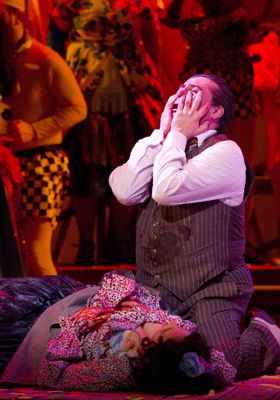
Marcelo Álvarez as Canio, Mariá José Siri as Nedda
All photos copyright the Opéra de Monte-Carlo
An evening of strange-bedfellow one-acts in high-concept stagings, mindbogglingly delightful.
These brief operas have interesting points of convergence, both are love triangles with older men and younger wives. both have physically unattractive protagonists, both are set in Italy. The librettos for both were written in the early 1890’s. And both are just plain ugly stories.
Nonetheless there are striking, irreconcilable differences that prevent them from creating a soul satisfying evening of opera. I pagliacci (1893) is one of the masterpieces of the startling new verismo movement in Italy. A Florentine Tragedy (1917) came 25 years later, captive of the psychological and musical complexities of the collapsing Viennese cultural hegemony. Simply said I pagliacci remains a fresh, new piece and A Florentine Tragedy rests a derivative attempt to revive lost musical enthusiasms. Namely and unabashedly the scandalous excitement created by Salome, Electra and Rosenkavalier.
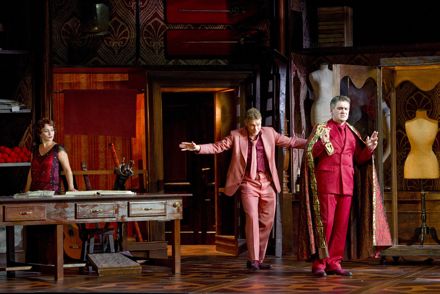
Barbara Haveman as Bianca, Carsten Wittmoser as Simone, Zoran Todorovich as Guido
Zemlinsky’s rendering of Oscar Wilde’s sick little tale was simply Zemlinsky getting even with Gustav Mahler for being more attractive to Alma Mahler than he was. And, well, making an opera about Alma Mahler’s affair with the architect Walter Gropius while she was married to Mahler. It is a very personal, vindictive work.
It began the evening. When it was over the audience could not get to the bar fast enough.
Metteur en scène Daniel Benoin would have nothing to do with Zemlinsky’s monumental (triple or quadruple winds, six horns, huge percussion battery) pettiness and therefore set out to find a less gossipy context for this sordid tale. He moved the action from 16th century Florence to the Italy just a bit after 1917 and the emergence of Fascism. Simone (the older husband) exits his shop from time to time, passing the Black Shirt recruiters visible though the huge shop windows. For the dénouement he returns to his shop in full Blackshirt garb (he strangles young, old-order rich Guido). Simone and his young wife Bianca reconcile and the strong, new Italy is born!
The Zemlinsky opera is enormously enriched by this concept, given that Zemlinsky’s music does not really allow us to enter into the psyches of his actors (as, for example, Strauss had) but instead keeps us enthralled in the web of subterfuges Simone is creating to murder Guido. Director Benoin allowed that we might participate in politically powerful propaganda that can possibly be found in, or matched by the music rather than in the petty jealousies that are not musically supported.
The inherent irony of decadent music of a collapsing empire building a strong new political order did not trouble Mr. Benoin who was having fun with his designers. Set designer Rudy Sabounghi created a richly traditional Florentine shop, gorgeous in scope and detail, the exposition of luxury fabrics though was limited to sample books [!], but at last yards and yards of real fabric fell from the rafters, some of which Simone used to strangle Guido.
Nathalie Bérard-Benoin created costumes that were flagrantly and effectively at odds with the period details of the set, Simone in a monochrome rose modern suit, shirt and tie, Guido in a darker rose suit, shirt and tie. Bianca was in a Klimt inspired beaded dress and wigged firmly into the dying pre-fascist era.
It was a solid, sophisticated and amusing production richly conducted by Pinchas Steinberg who was unwilling to sacrifice the humors of Zemlinsky’s huge orchestrations when the singers were unable to sustain needed and appropriate volumes of sound. It was an orchestral, not a singerly event.
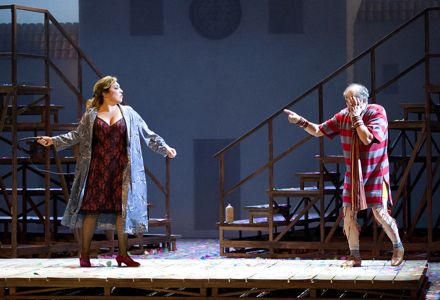
María José Siri as Nedda, Leo Nucci as Tonio
The exact opposite may be said of I pagliacci. It was very nearly a dream cast of singers who kept the audience in their seats applauding long after Canio had slaughtered Nedda. The pagliacci were opera stars baritone Leo Nucci and the estimable tenor Marcelo Álvarez, the Nedda was Argentine soprano María José Siri who thrilled us with the shimmering edge to her youthful tone. Silvio was Chinese born, Covent Garden trained baritone Zhengzhong Zhou whose exceedingly beautiful voice made the love duet with Nedda a meltingly beautiful few minutes. Peppe was carefully and charmingly etched by Italian tenor Enrico Casari. While conductor Steinberg did not fully capture the intense dramas of verismo he did give these superb singers tempos on which its lyricism could gracefully soar.
In fact the lighter weight and easier movements of Leoncavallo’s vocal lines felt much more at home in tenor Álvarez‘ voice than does Puccini’s Cavaradossi, surely this excellent artist's signature role (recently sung at the Bastille). Baritone Leo Nucci is a nimble 72 years of age (he wanted us to know this by effecting a heel clicking jump now and again). He is in good voice and is still a viable Tonio. Soprano Siri, a Tosca in her own right (Vienna and Berlin), is young enough to be believable as a real Nedda and sufficiently experienced in the grand repertoire to bring real diva style to her portrayal.
The common element to both short operas was designer, Monaco native Rudy Sabounghi (director Benoin did his own lighting, Pagliacci was lighted by Laurant Castaingt). Sabounghi with Swiss metteur en scène Allex Aguilera had us see through the back wall of a stage in order to create the conceit that we too are the actors since we feel what they feel — I pagliacci plays very heavily with the metaphor of theater.
It got even more complicated. The pagliacci started out as circus clowns, drumming up business for the upcoming performance, their public were country folk on the way to church. Though by the time of the performance of the play within the opera Tonio and Canio had dressed themselves in everyday clothes as they were dealing with their real, off-stage passions. Conversely the country folk now had transformed themselves into commedia dell’arte costumes, like the actors on the stage should have been costumed. This audience then was seated on the stage directly mirroring the Salle Garnier audience, thus it was they who were dealing with theatrical passions. We, the Salle Garner audience, were dealing with the real passions. Verismo indeed.
It all more or less worked in its weird way. Most of all it gave us something to get our minds around. Neither of the stagings found the essences of these strange little operas, nor were they looking for the them. It was a high-level, challenging and ultimately satisfying evening of opera.
Casts and production information:
A Florentine Tragedy Guido Bardi: Zoran Todorovich; Simone: Carsten Wittmoser; Bianca: Barbara Haveman. Mise en scène et lumières: Daniel Benoin; Décors: Rudy Sabounghi; Costumes: Nathalie Bérard-Benoin. I pagliacci Canio: Marcelo Álvarez; Nedda: María José Siri; Tonio: Leo Nucci; Beppe: Enrico Casari; Silvio: ZhengZhong Zhou. Mise en scène: Allex Aguilera; Décors Rudy Sabounghi; Costumes: Jorge Jara; Lumières: Laurent Castaingt. Chorus of the Opéra de Monte-Carlo, Orchestre Philharmonique de Monte-Carlo. Conductor: Pinchas Steinberg. Salle Garnier, Monte-Carlo, Monaco, February 25, 2015.
Iphigénie en Tauride in Geneva
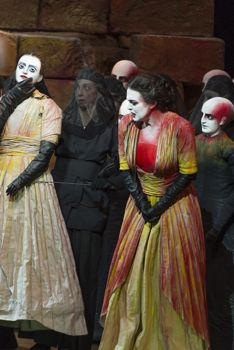
Iphigénie puppet, Anna Caterina Antonacci as Iphigénie, female chorus puppet
All photos copyright Carole Parodi, courtesy of the Grand Théâtre de Genève
Hopefully this brilliant new production of Iphigénie en Tauride from the Grand Théâtre de Genève will find its way to the new world now that Gluck’s masterpiece has been introduced to American audiences.
(The Metropolitan and Seattle operas production directed by Stephen Wadsworth made it to Live in HD in 2011, and Robert Carsen’s 2006/2007 production was seen in San Francisco and Chicago.)
Gluck’s 1779 opera is a strange work, its libretto based on the 1757 tragedy of the same name by Claude Guimond de la Touche who had lifted entire sections of his play from earlier opera librettos based on Euripides’ tragedy Iphigenia in Taurus. La Touche was a Jesuit for 14 years, but left the order to be a full-time poet.
Gluck’s French operas are through-composed solemn events, well respected in the troubled times that lead to the French revolution. But Gretry’s comic operas of the same moment with spoken dialogues and pretty airs were far more pleasurable to audiences. Maybe some of Gretry’s easy sentimentality made its way into Gluck’s tragedy in the questionable relationship between Oreste and his companion Pylade. The 1997 Glimmerglass production simply made them gay lovers.
If the Carsen production was dismissed as euro-trash by a critic on Resmusica* (blood covered walls, all actors in black tunics), and the Wadsworth production according to the critic on The Classical Review seemed fearful that its audience might be bored (hyper-ventilating ballets) the new Geneva production hits the nerve center of the opera by listening to the music. The production hears its solemnity, participates in its individual dramas, and illustrates its pantomimes — there is not a single second when the stage action departs from the absolute directness of the storytelling. The Gluck genius was to make music drama, and it was pure in Geneva.
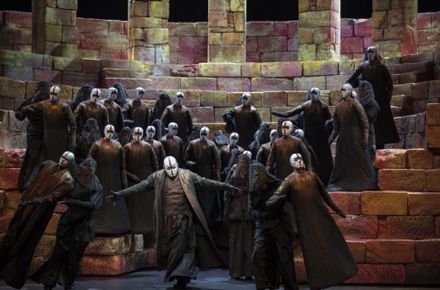
Alexey Tikhomirov as Thoas and male chorus puppets
Gluck’s rediscovered tragic unities are relentlessly upheld in this production staged by German born, culturally French informed stage director Lukas Hemleb and Berlin born, European and American formed sculptor Alexander Polzin. There was no ballet. Instead every principal actor had his double. A life-size puppet. Every blacked-out chorister, forty of them, held his life-size, black puppet. The set, astounding in scope, was a heavy Greek theater made of huge cut stones. It too had its double, an equal construction that had been yanked from the earth, suspended above the stage for the final scenes of the opera.
The concept was to step back from action, to allow the actors react to the story and to themselves as the story unfolded. Body movement was abstractly linear, the movement of mechanically motivated limbs. The results were constructions of motion that mirrored the brutal melodic lines of this morbid tale, and the abruptness of harmonic and theatrical structure, The actors were the music, and it was always a theater, theater itself, that we saw, and felt, from within and from without.
For the third act there was no set, only a bowl in the middle of the stage into which plummeted bits of the presumed dead Oreste. Oreste was Italian baritone Bruno Taddia who in the second act had fallen away from his puppet double onto the forestage to deliver, alone, his agonized recitative “Dieux protecteurs de ces affreux rivages!” In the emotional immediacy, rare in Gluck, of this outburst he became his puppet, moving in jerks and spasms as if operated by an exterior force. This force was Gluck’s music and the tragic muse.
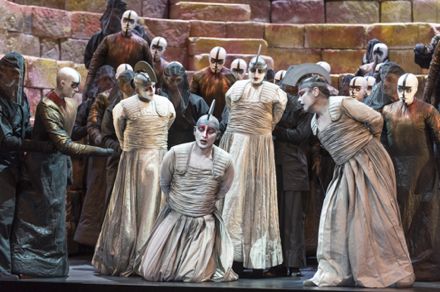
Bruno Taddia as Oreste, Steve Davislim as Pylade, their puppet doubles
Mr. Taddia gave an over-the-top performance in warm, secure voice. His extreme performance was matched to a much lesser degree by the Iphigénie of Italian soprano Anna Caterina Antonacci (remember that this was a Maria Callas role so the stakes are already impossibly high). Her physical involvement was gratefully more measured (much more) than that of Mr. Taddia, her voice securely if not easily or opulently carved Gluck’s emotional recitative “Je cede à vos désirs” and air “D’une image, hélas, trop chérie!”
Oreste’s companion Pylade was sung by Australian tenor Steve Davislim. At the final performance, perhaps exhausted from the run of six performances this fine artist was unable to take his air “Divinité des grandes âmes” to its melodic heights, though it was otherwise sung in beautiful voice. Pylade, unlike Oreste and Iphégenie is tormented only by human love (for Oreste), and not by divine forces.
As the tyrant king Thoas bass Alexey Tikhomirov threatened appropriately if without distinction compared to the powerful performances of Iphigénie, Oreste and Pylade.
The proceedings were presided over by Dresden born conductor Hartmut Haenchen, who magnificently managed the score, integrating its orchestral, choral, balletic and solo voices into the tragedia messa in musica that Gluck imagined. It must be said that one did not hear the orchestra separately from seeing the stage. Gesamtkunstwerk indeed.
Casts and production information
Iphigénie: Anna Caterina Antonacci; Oreste: Bruno Taddia; Pylade: Steve Davislim; Thoas: Alexey Tikhomirov; Diane: Julienne Walker; Un Scythe: Michel de Souza; 1ère Prêtresse: Mi-Young Kim; 2ème Prêtresse: Marianne Dellacasagrande; Une femme grecque: Cristiana Presutti; Le Ministre du sanctuaire: Wolfgang Barta. Chœur du Grand Théâtre de Genève, Orchestre de la Suisse Romande. Conductor: Hartmut Haenchen; Mise en scène: Lukas Hemleb; Décors: Alexander Polzin; Costumes: Andrea Schmidt-Futterer; Lumières: Marion Hewlett; Collaboration chorégraphique: Joanna O’Keeffe. Grand Théâtre de Genève, February 4, 2015.
Idomeneo in Lyon
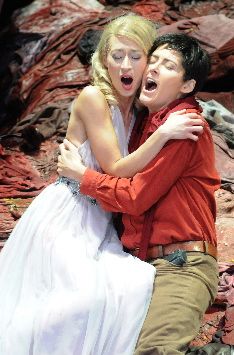
Elena Galitskaya as Ilia, Kate Aldrich as Idamante
All photos copyright by Jean-Pierre Maurin, courtesy of the Opéra de Lyon.
You might think you could go to an opera and take in what you see at face value. But if you did that just now in Lyon you would have had no idea what was going on.
Totally confused by the Uzi bearing thugs [sigh] that herded distressed costumes on and off the stage, and, well, by the mezzo-soprano in concert dress standing extreme stage right (singing Idamante while voiceless mezzo-soprano Kate Aldrich walked the role on the stage) luckily I found the insert in the program book at the intermission that would enlighten me. The Opéra de Lyon had come to a belated conclusion that this new production by German director Martin Kušej (koooo-shy) might not make any sense.
Mr. Kušej’s dramaturg, Olaf A. Schmitt, explained that Idomeneo lives in fear of the future established by the diminished chords of his Act II aria “Fuor del mar.” Furthermore that the D major tonality of this aria was the same as the first chords of the overture thereby establishing Idomeneo as the sovereign. The aria is old-fashioned, the da capo form, and this proves that Idomeneo is captive of an out-of-date, unchangeable system.
To make a long story short, Idamante is also captive, both the old and new sovereigns hold their repressive power by embracing and exploiting a religious system. This is proven because D major is obviously Idomeneo’s tyranny, and then this tonality is adopted by Idamante in his supplications to be sacrificed to the gods in order to save his people.
This rationale seems to have been constructed so that in the dénouement of the opera the resignation of Idomeneo may occur with him alone on the stage. He is writhing in emotional agony in what must now be a prison (the set was a revolving platform of repeating doors). He in fact has lost his power, and there has been no sacrifice. Furthermore the old, unchangeable order remains. The final celebratory chorus is grimly sung by drably dressed (old “Eastern-bloc”) choristers. At least they were not playing with the little fishes that had earlier served to demonstrate calmed waters.
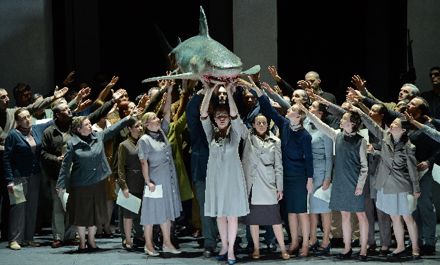
This sea monster of the first act gave way to the playful little fishes of the second act mentioned above.
Did I get this right? More or less?
Well, it might have worked, and in fact the final Idomeneo scene was a powerful coup de théâtre that might have been convincing theater had the Opéra de Lyon provided a persuasive cast of singers, and more than perfunctory conducting.
As it was the voiceless Kate Aldrich was the only convincing presence on the stage, this fine artist here acted this travesty role with surprising masculine force (she physically attacked Idomeneo when she wanted him to do her bidding — note how this supports Mr. Kušej’s concept).
Mme. Aldrich in fact had the flu and could not sing (the flu had been passed around the cast, evidently you never knew who would be down for which performance). Her words were beautifully sung by Russian mezzo Margarita Gritskova who sometimes could not help becoming dramatically involved (musically). But we needed the artistic maturity of la Aldrich to make Idamante alive.
The balance of the cast, all fine singers, did not have the force of character or the physical presences to make a convincing case for this off-the-wall, politically naive, theatrically forced concept. It was a long, very long evening.
We can only shutter at our premonitions of what Mr. Kušej and Mr. Schmitt may attempt with Mozart’s Die Entführung aus dem Serail at the Aix Festival this coming summer.
Casts and production information
Idoménée: Lothar Odinius; Idamante: Kate Aldrich; Ilia: Elena Galitskaya; Electre: Ingela Brimbert; Arbace: Julien Behr; Voix de Neptune: Lukas Jakobski. Orchestre et Choeurs de l’Opéra de Lyon. Conductor: Gérard Korsten; Mise en scène: Martin Kušej; Collaborateur artistique à la mise en scène: Herbert Stöger; Dramaturgie: Olaf Schmitt; Décors: Annette Murschetz; Costumes: Heide Kastler; Lumières: Reinhard Traub. Opéra Nouvel, Lyon, February 1, 2015.
Tristan et Isolde in Toulouse
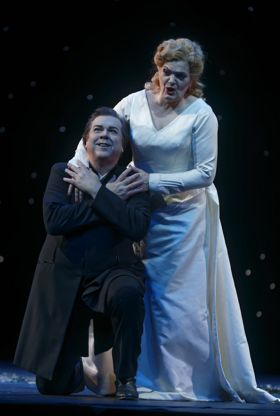
Robert Dean Smith as Tristan, Elisabete Matos as Isolde
All photos copyright Patrice Nin, courtesy of the Théâtre du Capitole.
Tristan first appeared on the stage of the Théâtre du Capitole in 1928, sung in French, the same language that served its 1942 production even with Wehrmacht tanks parked in front of the opera house.
But ten years later, 1952, Kirsten Flagstad sang Isolde in Toulouse, in German of course. The then director of the opera, tenor Louis Izar was a celebrated Ring Mime, and the then mayor of Toulouse, Raymond Badiou himself was big friends with Wieland Wagner. Toulouse had become known as Bayreuth-sur-Garonne (the river that passes through Toulouse).
Tristan und Isolde however disappeared from the Theatre du Capitole after the 1972 production (Herbert Becker and Klara Barlow), not to reappear until 2007 in a production by Nicholas Joël, remounted just now with American tenor Robert Dean Smith as Tristan and Portuguese soprano Elisabete Matos as Isolde. At the first intermission a tall gentleman strode through the bar loudly proclaiming in hoch British that it was “better than Bayreuth.”
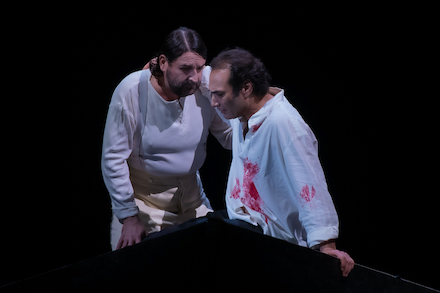
Elisabete Matos as Isolde
Most of us have not been to Bayreuth so we cannot know, but it was indeed certain that this Tristan was already an ultimate experience, and that was well before the Tristan delirium that was the musically shattering climax of the performance. The conductor was 62 year old, Leipzig born conductor Claus Peter Flor, known in the U.S. as the guest conductor of the Dallas Symphony (1999-2008). While no stranger to the opera pit his program booklet biography reveals him to be primarily an orchestral conductor.
The maestro concentrated his attention on the famed Toulouse orchestra, here strings 12/12/10/8/6, triple winds but 6 horns, with the full backstage complement of 6 horns and 3 each trumpets and trombones. There were two harps for the mesmerizingly beautiful second act love tryst, Brangäne gorgeously intoning her admonitions. The exquisite minor third trills of the clarinets had already laid the foundations for Wagner’s eternally quivering passions.
If seventy six orchestra players and two heroic voices can be said to whisper this was the intimacy of the second act. In fact the first act as well was developed in personal rather than mythical voices, the oboes, flutes and English horn working to color Isolde’s despair, Brangäne’s (in black spectacles) deception, and Tristan’s indifference. The first act love duet was surprise more than passion, preparing us for the musico-psychological treatise on nineteenth Romantic century love that was the second and third acts.
Metteur en scène Nicholas Joël hovered between the real and the magical, his production sometimes staged and sometimes semi-staged. Wagner’s first act sailors were 8 supernumeraries [figurants] (the chorus was hidden) in formal concert dress (tails) who reappeared at the end of the opera as King Mark’s soldiers. The second act swords drawn, Melot’s thrust was symbolically received, Tristan fell, isolated on the other side of the stage. At the end of the opera Kurvenal’s thrust was symbolic, not actually touching the jealous traitor, Tristan’s friend Melot.
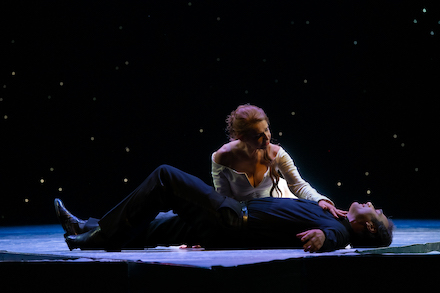
Elisabete Matos as Isolde, Robert Dean Smith as Tristan
Finally Tristan lying dead, Isolde rose, walked down stage center (the soldiers, the dead Kurvenal and Melot as well as King Mark had all slipped off stage). This was the liebestod for the brilliant-red gowned Isolde, in concert now. It was, as intended, a panegyric to love. It was not the end of an opera.
The coup de théâtre occurred at the beginning of the third act. The curtain rose on the wounded Tristan hanging over the front point of the now sharply elevated triangular center platform (the stage set was three platforms that in the first act had moved up and down as the wave motions of the sea). Arms and head dangling into the emptiness high above the orchestra pit Tristan remained there for maybe ten minutes (through the English horn solo and Kurvenal’s scene with the shepherd).
He awoke to deliver his great mad scene, always perched on this point, and somehow balanced philosophy with emotional rawness, rationality with irrationality. It was in this delirium that the maestro let loose with the great (and here the biggest) orchestral climaxes of the entire opera. It was the cerebral drama of this extended tract that made the Joël concept of Tristan become the masterpiece Tristan und Isolde is said to be — we both understood and felt love as if we were a Romantic poet.
Robert Dean Smith is of strong, secure and virile voice, his dramatic and musical intelligence apparent, well able to effect the considerable challenges of this mise en scène. He has already established himself as one of the important Tristans of our day on the world’s important stages. Elisabete Matos has performed Isolde once before, in 2011 at Barcelona’s Liceu. In the prime of voice she is able to soar to and beyond the enormous climaxes never compromising her richly colored sound. Her familiarity with the great Verdi dramatic soprano roles lies under her Isolde, the liebestod far more intimate and personal than heroic. The vast emotional vistas and philosophic scope of this production were perfectly realized in her performance.
German mezzo-soprano Daniela Sindram well fulfilled the requirements of this production, her Brangäne a very present figure in Wagner’s conceptual preparations. Costumed in white German baritone Stefan Heidemann made a very present Kurvenal, his rather loud, darkly colored voice a welcomed contrast to the refined Heldon tenor tone of Robert Dean Smith. German bass Hans-Peter König was a perfunctory King Mark.
Conductor Claus Peter Flor created this remarkable musical vision that fulfilled the complex theatrical vision of Nicholas Joël. The stage and pit were remarkably synchronized, the maestro focused on his orchestra, the stage very sure of itself.
Casts and production information:
Tristan: Robert Dean Smith; Isolde: Elisabete Matos; King Mark: Hans-Peter Koenig; Kurwenal: Stefan Heidemann; Melot: Thomas Dolié; Brangaene: Daniela Sindram; Un Jeune matelot / Un Berger: Paul Kaufmann; Un Pilote: Jean-Luc Antoine. Choeur du Capitole, Orchestre national du Capitole. Conductor: Claus Peter Flor; Mise en scène: Nicolas Joel; Scenery and costumes: Andreas Reinhardt; Lighting: Vinicio Cheli. Théâtre du Capitole, Toulouse, February 1, 2015.
Kat'a Kabanova in Toulon
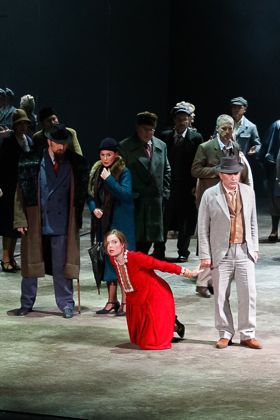
(left to right) Mikhail Kolelishvili as Dikoï, Ange-Marie Todorovitch as Kabanicha, Christina Carvin as Katia, Ladislav Elgr (behind) as Boris, Zwetan Michailov as Tikhon
All photos copyright Frédéric Stéphan, courtesy of the Opéra de Toulon.
Káťa Kabanová is, they say, Janáček's first mature opera — it comes a mere 20 years after his masterpiece, Jenůfa.
It is true that the Káťa Kabanová libretto is closer to The Makropoulos Affair and From the House of the Dead, sharing the brittle dramatic structures of these works and revealing the growing selfishness and emotional pessimism of the sixty-seven year old composer. But musically Káťa Kabanová seems spoken in the same voice that sings the emotional idealism of Jenůfa. Herein lies the challenge of producing Káťa Kabanová — it must hover between hope and hopelessness.
The Opéra de Toulon has just now presented this Janáček masterwork for the first time ever. It is a new production shared with the Opéra d’Avignon, thoughtfully and carefully directed by Nadine Duffaut. The set is by Emmanuelle Favre, a designer often utilized in the south of France, notably Orange, Marseille and Toulouse. Mme. Favre works in bold strokes, in big shapes and with few colors. Her décors are impressive, expressive and beautiful. As is the set for Káťa Kabanová.
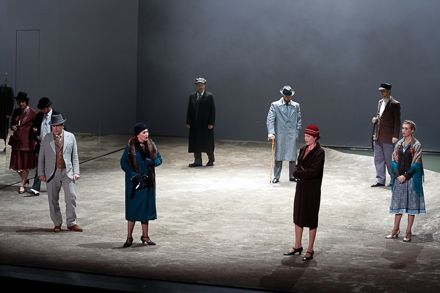
Set design by Emmanuelle Favre, costume design by Danièle Barraud
The stage was a huge white box, a full stage platform with period furniture on it hovered high above the stage floor, descending to create an interior or to provide shelter from the storm. The side walls were mirrorized making occasional flashes of the brightly colored costumes, like the sonic flashes of Janáček’s nervous orchestra. The Volga was a pool of real water, its splashes the visual echos of nerves on edge.
Family and business are the crushing forces in Káťa Kabanová. They are embodied in this suspended platform, and in the very presence of Kabanicha, the mother of Katia’s husband, sung by mezzo-soprano Marie-Ange Todorovitch. Mme. Todorovitch too is often on the stages in the south of France. She is a force of nature, her voice powerful, her presence riveting. Director Duffaut ended the opera with la Todorovitch standing front and center, triumphant in five intense beams of white light.
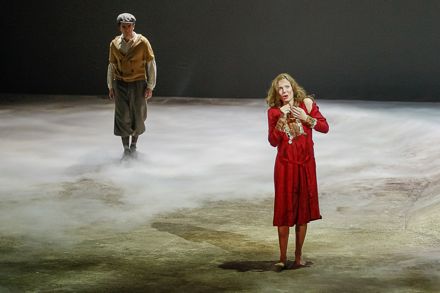
Sébastien Lemoine as Kouliguine, Christina Carvin as Katia
The drowned Katia lies behind her. Portraying Katia is a vocal and dramatic tour de force, riding the cusp at all times between hope and despair. Franco-allemande soprano Christina Carvin possesses the idea colors — the slavic warmth of tone, a maturity of tone that forebodes, and a freshness of sound that breathes life. Mlle. Carvin made a powerful Katia. This young artist now sings regularly at the Vienna Staatsoper.
Katia’s young lover Boris was sung by Czech tenor Ladislav Elgr with sufficient vocal prowess to indulge in the manic love fantasies of Katia, but never to allow his character to lose its sense of defeat. In the beautifully directed scene when Katia publicly admits her infidelity he hovered in the background, then fled, and after his final moments with Katia near the end of the opera he simply evaporated.
The complementing personalities of Janáček’s slavic world, named below, were perfectly cast, notably Icelandic tenor Elmar Gilbertsson who sang Kudriach, some of it while riding the obligatory Jenůfa bicycle, and some of it skipping stones across the pool of water.
If this fine effort by the Opéra de Toulon did not create the full impact of Janacek’s brief opera it came close. While the tempos effected by Australian conductor Alexander Briger seemed appropriate and easily managed by the singers, the sounds coming from the pit sometimes seemed labored. It was apparent that the maestro was working closely with the orchestra but even so the boil of Janáček’s orchestral continuum did not always take flight.
Casts and production information:
Kat'a: Christina Carvin; Boris: Ladislav Elgr; Kabanicha: Marie-Ange Todorovitch; Dikoy: Mikhail Kolelishvili; Tichon: Zwetan Michailov; Varvara: Valentine Lemercier; Kudriach: Elmar Gilbertsson; Kouliguine: Sébastien Lemoine; Glasa: Caroline Meng. Chorus and orchestra of the Opéra de Toulon. Conductor: Alexander Briger; Mise en scène: Nadine Duffaut; Décors: Emmanuelle Favre; Costumes: Danièle Barraud; Lumières: Jacques Chatelet. Opéra de Toulon, March 27, 2015.
Guillaume Tell in Monte-Carlo
Peasants revolt amidst a sea of Ferrari and Maserati's.
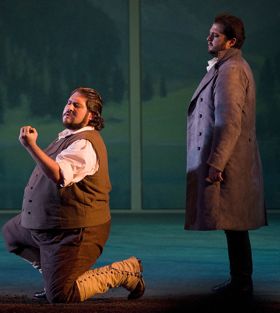
Nicola Alaimo as Guillaume Tell, Celso Abelo as Arnold
All photos copyright by the Opéra de Monte-Carlo
There was the usual automotive hardware in front of Monte-Carlo’s magical opera house. The peasants were all on the stage of the Salle Garnier, an embarrassment of riches, most notably Nicola Alaimo as Guillaume Tell and Celso Abelo as the lovesick Arnoldo. In fact the entire cast beginning with Mekeldi Atxalandabso as Reudi whose hymn to Swizerland “Accour dans ma nacelle” that opens the opera upheld the high level of singing that defined the evening, Basque tenor Atxalandabaso’s warm and easy high “c”’s only the first of the many vocal pleasures of the evening.
Music director of the Orchestre Philharmonique de Monte-Carlo Gianluca Gelmetti presided over his orchestra for this occasion, an opera he conducted twenty-years ago (1995) at the Rossini Opera Festival in Pesaro to enormous critical acclaim. Much has transpired in his career since 1995. He is now famous for the Italian post-Romantic repertory perhaps explaining the massive sonic scope he found in the Rossini score for the Salle Garnier, and the warmth of tone he infused into the orchestral sound firmly persuading us that Guillaume Tell was a new, sentimental Rossini, and a unique Rossini — it is the last of the Rossini operatic oeuvres.
Before all else Rossini’s Guillaume Tell is French grand opéra as its extended dramatic recitatives attest, though Rossini could not keep himself from breaking into some coloratura from time to time, a lapse effortlessly and beautifully absorbed into the musical flow by the maestro. Rossini discovered the pleasures of the rich French low mezzo-soprano voice in Hedwedge, the wife of Guillaume, dissolving this voice into a sublime trio with Guillaume’s soprano son, Jemmy and Mathilde, his savior, with its intricacies rendered by the maestro in rich delicacy. Though Gelmetti had already pummeled us with the fiery Rossini we know so well when Guillaume and Walter Furst shamed Arnold into fighting for his fatherland.
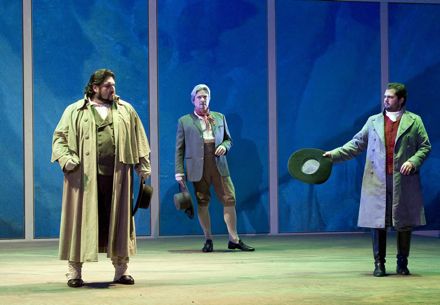
Nicola Alaimo as Guillaume Tell, Nicholas Cavallier as Walter Furst, Celso Abelo as Arnold
There was the spectacle of typical grand opéra, the maestro endowing the classic Rossini storm with truly terrifying proportions (even though it was the same storm we know from the Roman comedies). And there were the magnificent complexities of the Rossini ensembles we know from the later Naples tragedies, the defiance of the peasants to the strength of the Hapsburgs magnified by Gelmetti in the repeating brass motifs in the orchestra, each time louder until it could not become louder. But it did, shattering the acoustic of the Salle Garnier.
At last Rossini resolved the opera’s conflicts into a huge, uncharacteristically pastoral ensemble evoking the beautiful cello elegy of the overture with its singing oboe echoed by flute — the majestic serenity of the Alps’ mountain valleys restored. But only for a short while, the peasants finally rushed forward shouting “liberté, liberté!” as loud as they possibly could.
One could not help recalling that it was in 1910 when the Monegasque Revolution forced the prince of Monaco, until then an absolute ruler, to proclaim a constitution.
What we missed in Monaco were the ballets, an economy that saved us one and one half hours of time, compacting the above musical riches of the opera into a brief three hours twenty minutes. Other less obvious economies took their toll as well, rendering the storytelling sometimes oblique and other times incomprehensible. The adage that the full ballets are integral to the dramatic integrity of Guillaume Tell was again proven in Monaco.
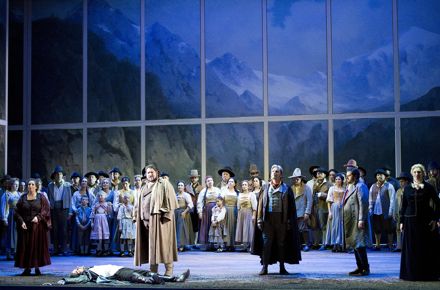
Décors by Eric Chevalier, Costumes by Françoise Raybaud
Monaco-born Jean-Louis Grinda, the metteur en scène (and general director of Opéra Monte-Carlo) knows that the complex musico-dramatic structures of the Rossini tragedies resonate in abstract formulae, either conceptual (like the museum dioramas of the 2013 Pesaro production) or in the physical architecture of the set itself. In this new production Grinda’s designer, Eric Chevalier, evokes the Helvetic mountainous setting in hazy images projected onto an imprisoning box structure of small repeating panels that open and close, the back wall of which disappeared into the brilliant dawn-of-freedom light. Costumer Françoise Raybaud provided threatening teutonic patterns of the late nineteenth century for the Hapsburg characters.
Movement for the chorus action was in purely geometric terms — lines and circles. Images were few, simple and powerful. Guillaume Tell himself pulled a plow, like a beast, across the stage during the opening chorus (a shocking and confusing image), there were two dance pantomime sequences in which a ballerina and a ballerino were attached to one another in a kiss (like two animals stuck together in the mating act — another shocking and confusing image) — choreography by Eugénie Andrin. Arias and duets were delivered standing front and center, as in concert format. Grinda provided a basic context and basic movements for the opera, but did little to illuminate the story evidently relying on the genius of Rossini and the brilliance of the performances to fire the evening.
And that they did.
Italian baritone Nicola Alaimo is a gigantic figure, appropriate to a mythic hero of William Tell proportion. His voice and presence are warm, powerful and encompassing, in short he is a convincing Guillaume Tell. His antagonist Gessler, the Hapsburg governor, was sung by French bass Nicholas Courjal in threatening, black toned vocal color, with a vividly present figure. Spanish tenor Celso Abelo as the fickle tenor Arnold had high “c”’s to spare, squarely hit and held rather then finding place in the musical flow. Just when you thought no human could have the stamina to hit another, he hit the final one of his showpiece aria and held it forever. Mr. Abelo is an accomplished Rossini performer.
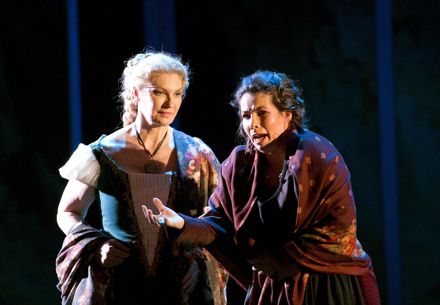
Annick Massis as Mathilde, Élodie Méchain as Hedwidge
French soprano Annick Massis was Mathilde, a role that only sometimes requires the Isabella Colbran dramatic coloratura model of Rossini tragedies. Mme. Massis indeed well held the stage as Hapsburg aristocracy, riding crop in hand, though her showpiece arias were powerful her coloratura was not convincing and her high notes were of a spread tone that defied identifying any one individual note. French contralto Elodie Méchain sang Guillaume Tell’s wife Hedwidge to absolute perfection, and Russian soprano Julia Novakova as his son Jemmy provided the appropriate upper edge to the ensemble textures.
The only disappointment of the evening was the staging (lack of) for the arrow and apple.
Casts and production information:
Guillaume Tell: Nicola Alaimo; Hedwige: Elodie Méchain; Jemmy: Julia Novikova; Arnold: Celso Albelo; Melchtal: Patrick Bolleire; Walter Furst: Nicolas Cavallier; Gessler: Nicolas Courjal; Mathilde: Annick Massis; Rodolphe: Alain Gabriel; Leuthold: Philippe Ermelier; Reudi; Mikeldi Atxalandabaso. Chorus of the Opéra de Monte-Carlo. Orchestre Philharmonique de Monte-Carlo. Direction musicale: Gianluigi Gelmetti; Mise en scène: Jean-Louis Grinda; Décors: Éric Chevalier; Costumes: Françoise Raybaud; Lumières: Laurent Castaingt; Chorégraphie: Eugénie Andrin. Salle Garnier, Monte-Carlo, January 25, 2015.
Peter Grimes in Nice
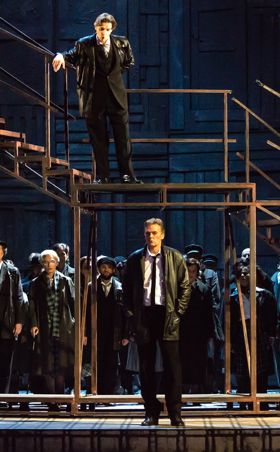
André Cognet as Swallow, John Graham Hall as Peter Grimes
All photos copyright Dominique Jaussein, courtesy of the Opéra de Nice.
Nice’s golden winter light is not that of England’s North Sea coast. Nonetheless the Opéra de Nice’s new production of Peter Grimes did much to take us there.
A new production of Peter Grimes is always news, in fact any production of this first Britten operatic masterpiece beckons travel from afar. Nice Opera artistic director (since 2012) Marc Adam was the metteur en scène for this new production for which he has collaborated with born-in-Algiers, raised-in-Nice, Juilliard School trained conductor Bruno Ferrandis. Mr. Adam previously collaborated with Mo. Ferrandis for a Wozzeck (Gurlitt) at the Opera de Rouen in 1997.
Much of Bruno Ferrandis’s career has transpired in Canada and the U.S. He is currently the music director of the Santa Rosa (California) Symphony.
Mr. Adam assembled an excellent cast. English tenor John Graham Hall as Peter Grimes possesses an appropriate voice for Britten heros, not the dramatic tenor often associated with Grimes, but the lighter, character voice that characterizes the Aschenbach of Death in Venice, another of Mr. Hall’s Britten roles. Mr. Hall has an affecting presence and the vocal stamina to have seen the role through this production’s expressionist requirements.
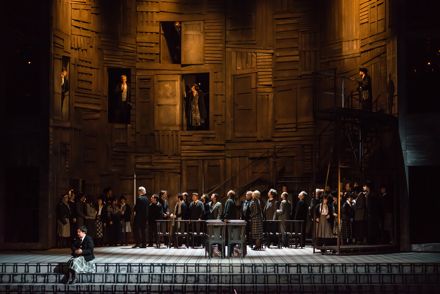
Fabienne Jost as Ellen (left lower corner)
French soprano Fabienne Jost sang Ellen. An ensemble singer at the Berne Opera and previously at German theaters, she offered a purity of voice and a musicality supported by fine technique that made this Ellen very pleasurable, in fact memorable.
Swallow was effectively portrayed by Marseille born, veteran bass-baritone André Cognet. French baritone Vincent Le Texier did not find the humanity of, or any softness for Balstrode, often barking his lines rather than singing. We were left unfulfilled by his character. Among the well cast smaller roles Marseille born tenor Edward Mout was especially effective as Bob Boles, all these rustic characters linguistically colored by carefully produced English sounds.
Among the more effective moments of the production were the black and white projections on the scrim covered proscenium that occurred during Peter Grimes’ famous orchestral sea interludes (of course Britten purists would have preferred no visual distraction from the sounds of these magnificent pieces). At times the images were the boiling sea, as well there were affective moments when the costumed actors were seen in pantomime through the foggy images. Puzzling however was the ascent to Grime’s cottage, rendered in images of industrial steel construction (the back side of the semicircular set unit was Grimes' hut).
Set design was entrusted to Roy Spahn who works primarily in German theaters. It was a strange semicircular multi-level abstraction of windows placed on a revolving stage. Installation of the revolving stage evidently necessitated a raised stage platform (about 60 cm [2‘] high) that was faced with incongruous black and white squares that looked a bit like Halloween decorations. The floor of the stage was not visible from the seats in the orchestra.
A further complication of the raised platform was the necessity to raise the conductor’s podium to give him view of the stage. This seemed to separate the maestro from his orchestra with the resulting impression that the orchestra was at adrift and rudderless, eviscerating the complex, ambiguous, sensual, cruel, tender, passive musico-dramatic world that is genius of Benjamin Britten. From time to time the maestro did take his eyes off the stage and engage the orchestra. These moments supplied brief impressions that the Orchestre Philharmonique de Nice was capable of creating the magic of the Britten score when asked.
It was perhaps an artistic choice of the director and conductor to strip the opera of its colors, moods and ambiguities, and focus the drama on the words and outward behavior of its actors. While this did create a theatrical atmosphere, often of great intensity, it stripped the opera of its emotional focus, rendering its protagonist as mentally unbalanced rather than as a complex human character adrift in a threatening natural world and outside an alien and uncomprehending human world.
Casts and production information:
Peter Grimes: John Graham Hall; Ellen Orford: Fabienne Jost; Balstrode: Vincent Le Texier; Tantine: Manuela Bress; Première nièce: Hélène Le Corre; Deuxième nièce; Anne Ellersiek; Bob Boles: Edward Mout; Swallow: André Cognet; Mrs Sedley: Sophie Fournier; Le recteur: Frédéric Diquero; Ned Keene: Bernard Imbert; Hobson: Thomas Dear. Orchestre Philharmonique de Nice; Choeur de l’Opéra de Nice. Conductor: Bruno Ferrandis; Mise en scène: Marc Adam; Décors: Roy Spahn; Costumes: Pierre Albert; Lumières: Hervé Gary; Chorégraphie: Pascale Chevreton. Opéra de Nice, January 24, 2015.
Idomeneo in Montpellier
Vestiges of a momentous era . . .
A legacy of ousted Montpellier general director Jean Paul Scarpitta, the staging of Mozart’s first operatic masterpiece remained entrusted to Scarpitta’s assistant Jean-Yves Courrégelongue. Both Scarpitta and Courrégelongue are stage directors whose artistic formations were with Robert Wilson. Both have developed strongly individual voices, Wilsonesque only in so much as they both cultivate an extreme minimalism. Of these two Montpellier directors Courrégelongue is more imagistic, Scarpitta is more satiric.
Courrégelongue and his designer Mathieu Lorryy-Dupuy used a chair, a curtain, a table and a swimming pool to bring alive Mozart’s tale of sacrifice. This was not to update an ancient story’s Baroque retelling so much as it was to purge a Mozart masterpiece of extraneous, misleading detail (the trappings of an anachronistic opera seria for example) and to make it what it is — a dramatic action in music, and nothing more.
And yes, there was still the spectacle that is so strikingly created in Mozart’s score. It was squarely minimalist where less is more — an all the more terrifying appearance of the beast of the deep in the symbolic form of a sacrificial table exploding in white light. High tension had already been created in the blackouts that exploded into the sudden appearances of Idomeneo and later the crowds of terrified Cretans.
Courrégelongue hit sacrifice hard, depriving the opera of its obligatory happy ending. Elettra not only longed for death, she sacrificed herself to the love of Ilia and Idamante holding the sacrificial knife and disappearing through the crowd into swimming pool.
At last the gods having been appeased and the crowd having cleared the pool of detritus (plastic bags, old tires, etc.) deposited by the storms, Elettra’s body, victim of the opera’s emotional storms, was retrieved and laid out to Mozart’s orchestral epilogue. The sacrifice we had fought all evening had become real, it was a sacrifice more real to us than the averted opéra seria mythological filicide. And it was pure Mozart.
In Idomeneo the young Mozart had made an immensely powerful opéra seria, and here we discovered a hidden depth of humanity to surprisingly illuminate this masterpiece. It was fully realized musically in Montpellier by French conductor Sébastien Rouland whose considerable career seems to be centered in big house productions of Baroque repertory (contemporary perspectives, not historical re-creations).
Mo. Roulard brings bite and high drama to Mozart, suppressing the neo-classicism (balance of tension and relaxation) that informs the symphonic Mozart and his soon-to-come comedies. The appropriate (reduced) forces from the Orchestre National de Montpellier eagerly responded to the maestro’s demand for edgy tone and sharply defined shapes. The orchestra melted into transparent pianissimos for the prayer of Idomeneo creating transcendent musical magic, then roared with frustration in Electra’s final aria. Rare sonorities of orchestration sang out, most notably the fine horn quartet.
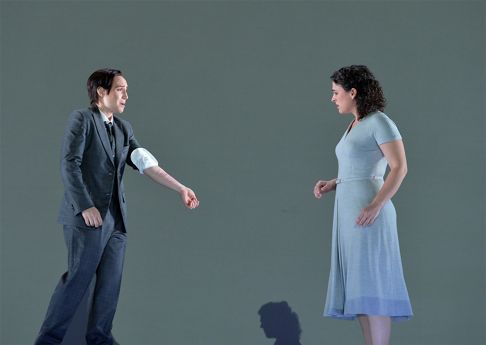
Anna Manske as Idamante, Marion Tassou as Ilia
Mo. Roulard’s tempi were at once dramatically pointed and solidly within reach of the young cast. The three women were well matched in vocal color and accomplishment. Ilia was sung by French soprano Marion Tassou with beguiling purity of tone, Idamante was sung by Austrian mezzo Anna Manske who found a charming male/female compromise, and Elettra was sung by Swiss soprano Clémence Tilquin who raged with conviction in her aria begging for death. Robert Wilson costumer Yashi (single name) provided a simple dress for Illia, a shapely male business suit for Adamante and a slinky pants suit for Elettra, simple attire that spoke volumes about character.
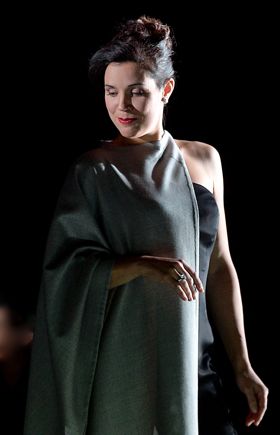
Clémence Tilquin as Elettra
The male voices were under par for a Montpellier Mozart opera, all over-parted, i.e. either unable to fulfill Mozart’s vocal demands or too inexperienced to be convincing, or both. An announcement was made that American tenor Brendan Tuohy as Idomeneo was “soufrant” and would not be at his best. While an appropriately imposing figure as Idomeneo his lack of experience to take on a major role on an important stage was glaring.
Casts and production information:
Idomeneo: Brendan Tuohy; Ilia: Marion Tassou; Idamante: Anna Manske; Elettra: Clémence Tilquin; Arbace: Antonio Figueroa; Nepture priest: Nikola Todorovitch; Neptune: Jean-vincent Blot. Chorus and orchestra of the Opéra Orchestre national Montpellier. Conductor: Sébastion Rouland; Mise en scène: Jean-Yves Courrégelongue; Scenery: Matthieu Lorry-Dupuy; Costumes: Yashi; Lighting: John Torres. Opéra Commedie, Montpellier. January 4, 2015.
L'elisir d'amore in Marseille
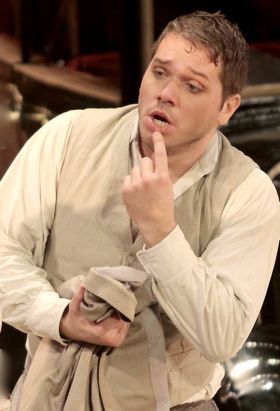
Paolo Fanale as Nemorino
All photos copyright Christian Dresse / Opéra de Marseille
There were hints that L’elisir is one of the great bel canto masterpieces.
The Opéra de Marseille revived the 2004 Toulouse production of L'elisir d'amore as its holiday season confection. And quite a confection it is. Former Nicholas Joël assistant Arnaud Bernard and his designer William Orlandi envisioned Donizetti’s hyper sentimental story as a series of early twentieth century photographs (a sepia tinged silver color palate), and took the concept a step further by constructing a stage that was a series of shutters (complex flats that moved somewhat like the shutter of a still image mechanical camera).
There were complicated, sometimes amazing scenic moves, that included a disintegrated figuration of the shutter flats when we learned that Nemorino had become rich. Of course there were many visually splendid freezes, some self consciously posed for an on-stage old fashioned larger-than-life prop camera.
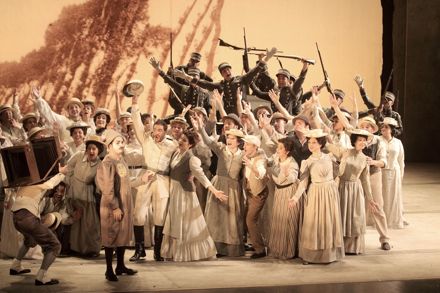
Set and costume design by William Orlandi
Yes, of course there were period bicycles that circled the stage (including a precarious ride by the diva), and there was was the antique automobile that brought on Dulcamara, an absolutely splendid car by an unidentified luxury maker that had been structurally reinforced to permit actors to climb all over it (Nemorino was exceptionally agile), and yes, of course there was the miniature model of the car as well, parked upstage with its tiny highlights on to oversee the consummation of the story (that Adina and Nemorino do in fact love one another).
Bel canto operas are indeed about singing, and Elisir is a series of arias, duets and trios that easily convince you, at least for the moment, that this opera must be the epitome of the style. Metteur en scène Arnaud Bernard’s snap shot concept at best set the stage for the singers to present themselves in specific musical moments to be remembered (i.e. visual moments where the bel canto could really rip). At worst the complex staging overwhelmed if not ignored Donizetti’s easy, satisfying sentimentalism.
The singers therefore had the challenge to live up to the production. Nemorino, Italian tenor Paolo Fanale, came the closest. While Mr. Fanale may not possess the sweetness of voice or character to be the ultimate Nemorino, he does possess the artistry to have delivered an absolutely exquisite “Una furtive lagrima,” the highpoint of the performance well recognized by the audience. This fine artist gamely executed the considerable antics required by the stage director.
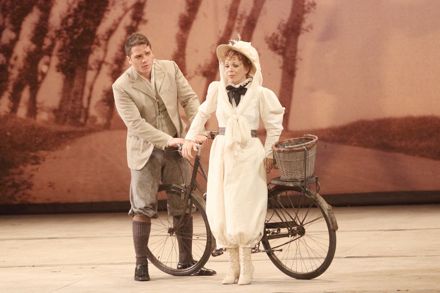
Paolo Fanale as Nemorino, Inva Mula as Adina
Veteran soprano Inva Mula who recently sang Desdemona both in Marseille and at the Chorégies d’Orange competently managed the vocal and histrionic demands of Adina (as she had in San Francisco Opera’s 2008 Elisir when she had had to find her way through middle American cornfields in some heavy handed Americana). Her impressive vocal technique served her well though it revealed the strains of maturity when she did not secure satisfying pitch for her high notes, and it came across as mere competence in Adina’s spectacular “Prendi, per me sei libero,” not the joyous exuberance of singing so many notes so fast.
Argentine baritone Armando Noguera sang Sargent Belcore, late in the evening displaying some lovely coloratura in an otherwise underweight performance. The same may be said of the Dulcamara of Italian baritone Paolo Bordogna, a veteran of many roles at Pesaro’s Rossini Festival who well displayed his fine buffo instincts but who was dwarfed by his automobile and his magician costume. Gianetta was nicely sung by French soprano Jennifer Michel, evidently cast because she could sing the role rather than create the character.
It was not clear what was going on in the pit. Italian conductor Roberto Rizzi Brignoli seemed to be trying to conduct Donizetti’s opera while the stage was laboring to do Mr. Bernard’s production. The stage seemed to have the upper hand, after all it took a lot to execute all those antics — and while the shutters moved flawlessly they might not have. There was little synchrony between the pit and stage, and there seemed to be little synchrony between conductor and the orchestra players, who seemed reluctant or maybe technically unable to enter the bel canto spirit.
Finally Mo. Rizzi Brignoli and tenor hit it off magnificently in “Una furtiva lagrima,” and the maestro seemed at last to capture the spirit of Donizetti with his orchestra. Any hope for synchrony with the stage remained futile.
Casts and production information:
Adina: Inva Mula; Giannetta: Jennifer Michel; Nemorino: Paolo Fanale; Belcore: Armando Noguera; Dulcamara: Paolo Bordogna. Chorus and Orchestra of the Opéra de Marseille. Conductor: Roberto Rizzi Brignoli; Mise en scène: Arnaud Bernard; Décors/Costumes: William Orlandi; Lighting: Patrick Méeüs. Opéra de Marseille (France). January 2, 2015.
Aureliano in Palmira in Pesaro
The year is 1813, Rossini is 22 years old. He has two huge successes in Venice — L’italiana in Algeri, his first big comedy (there were seven smaller ones before), and Tancredi, his first big serious opera (there was two previous smaller ones). But on December 26 his next opera seria, Aureliano in Palmira is a flop at La Scala. [These are reminders for Rossinians.]
The libretto of Aureliano in Palmira is by La Scala’s librettist, the prolific Felice Romani who provided the librettos for all three Rossini La Scala commissions — Il Turco in Italia (1814), and Bianca e Falliero (1819) make the three. Romani is best known and appreciated for his many librettos for Donizetti and Bellini.
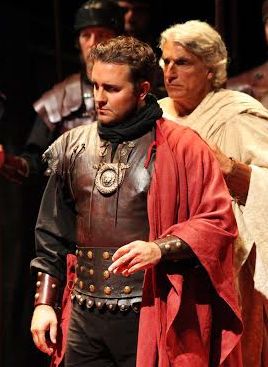
Michael Spyres as Aureliano
Most Romani librettos were set by multiple composers, though the three Rossini librettos were only set by Rossini. The turco in Italia libretto is dramatically quite complex enabling a stage director to produce it just now at the Aix Festival as Pirandello’s Six Characters in Search of an Author, a concept it wore perfectly. The libretto Aureliano in Palmira is no less complicated, compacting three or more major battles and their motivations and aftermath into two confusing acts. As is opera’s wont the libretto transforms documented military history into affective opera history which we Rossinians find far more real than mere history anyway.
The Aureliano in Palmira libretto by Felice Romani was famously the cause of the failure of the opera. The librettist felt the need to defend his work, saying that he was never “discostato un momento dal verosimile” meaning that his story at least always seemed real, or that it could have been real. It was up to Rossini then make it real. The contemporary perception was that he did not, the fault of the singers, said Rossini. But it was a big job — they had to deal with the undying love of the Prince of Persia and the Queen of Syria thwarted again and again by the might of the Roman Empire led by the Emperor Aureliano who lusted intermittently after the Syrian Queen while never wavering from his military objectives.
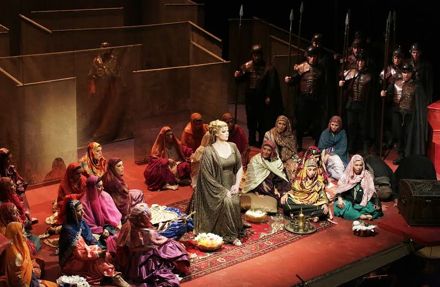
Jessica Pratt as Zenobia
It is hard to fault the quality of the music of Aureliano in Palmira because Rossini simply recycled it two years later into Il barbiere di Siviglia which was a flop too. But only at first. It quickly became one of the repertory’s more esteemed masterpieces. So Rossini was right, there was nothing wrong with the music.
The Rossini Festival had given us a simply splendid Barbiere the night before, so all of the tunes and colors were fresh in our ears. It befell the American conductor/scholar/critic Will Crutchfield to transform these musical lines and colors into intense periods of amorous passion, passionate rejection, heart breaking sorrow, vivid denunciation, etc. Miraculously he succeeded more or less. He did securely ground the performance in opera seria, transferring the onus upon us, the audience, to forget what we know so well. It was not always possible.
The Rossini Festival entrusted the production of this difficult opera to director Mario Martone who couldn’t quite fit it onto the stage of the Teatro Rossini, clumsily spilling a Roman column and a throne out over the orchestra pit. Gratuitously some entrances onto the stage were made through from the audience, plus the chorus was often spread out onto the stage apron and left there, exceeding the boundaries of imagination imposed by the proscenium. These naive attempts at theatrical immediacy gave way to claustrophobia.
Filmy panels of various sizes flew in and out to make mazes, tents, battlefields, palaces, and mountains. Plus there was an elevated walkway hidden behind the brown backdrop that from time to time revealed soldiers, refugees, etc., trudging to and fro. That was it. Except for four real, live goats who burst onto the stage during a lovely chorus (though Asia may be in flames peasants rejoice in the freedom and poverty of their fields). Yes, one goat squatted to pee thereby adding a river.
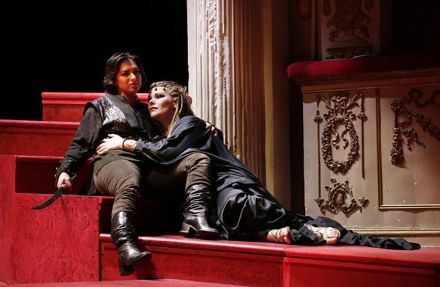
Lena Belkina as Arsace, Jessica Pratt as Zenobia
The emperor Aureliano was sung by American tenor Michael Spyres, a believable general, a believable actor and a very good bel canto singer. Mr. Spyres does not possess the high notes to make Aureliano a Rossini hero. Zenobia, Queen of Syria, was sung by statuesque Australian soprano Jessica Pratt. Mme. Pratt has strong, secure high notes that impress audiences. She does not move easily on the stage. Arsace, the prince of Persia, was sung by Uzebekistan mezzo Lena Belkina, an accomplished singer who projects the feeling that she wishes she were somewhere else, or at least that you were not looking at her. The production did not make it clear who Publia was. Sung by Raffaella Lupinacci, Publia suddenly professed to be in love with Arsace in her one aria, and for a moment we had the hope that she and he would get together, that Aureliano and Zenobia would get together and the opera would end. It didn’t.
Cast and production information:
Aurelliano: Michael Spyres; Zenobia: Jessica Pratt; Arsace: Lena Belkina; Publia: Raffaella Lupinacci; Oraspe: Dempsey Rivera; Licinia: Sergio Vitale; Gran sacerdote: Dimitre Pkhaladze; Un Pastore: Raffaele Costantini. Chorus of the Teatro Comunale di Bologna. Orchestra Sinfonica G. Rossini. Conductor: Will Crutchfield. Metteur en scène: Mario Martone; Scenery: Sergio Tramonti; Costumes: Ursula Patzak; Lighting: Pasquale Mari. Photos courtesy of the Rossini Opera Festival. Teatro Rossini, Pesaro, August 15, 2014.
Il barbiere di Siviglia in Pesaro
Ossia Il barbiere di Siviglia. Why waste a good tune.
Both by default and by merit Il barbiere di Siviglia is the hit of the thirty-fifth Rossini Opera Festival. But did anyone really want, and did the world really need yet another production of this old warhorse?
The Rossini Opera Festival’s answer to this question was inspired. Its conceit was to stage a semi-staged Barber, stripping the production of any pretense of importance, and avoiding the thankless challenge to some unfortunate stage director of discovering a brilliant new perspective (there are those who remember the Pesaro staging some years ago by Luigi Squarzina — he placed the action in the Teatro Anatomico [the medieval dissection room] of Bologna’s famous, ancient medical school).
So now in Pesaro there was not even a stage director, but a class from the Accademia di Belle Arti di Urbino who conceived, staged, designed and executed the physical production (an un-named professor did admit to some coordination). There were approximately thirty twenty-somes who took a bow.
The production, and it was a fully staged semi-staged production, alternated between hijinks, caricature, slapstick, assault, nonsense and genius utilizing every inch and orifice of the Teatro Rossini to get us through the score we know so well. Most of it occurred on the floor of the platea (the orchestra section), deftly finding its way onto the stage apron for the big arias. “Largo al Factotum” and “Una voce poco fa” for example were delivered concert style but in magnified visual relief — Rosina clothed/costumed in a discrete concert black dress, Figaro decked out like an adventurous audience member clothes horse.
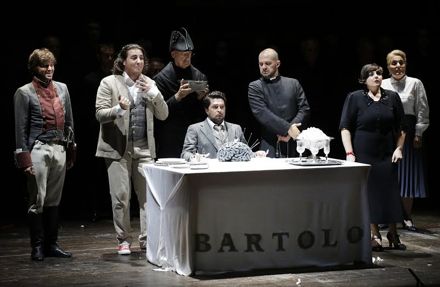
The big ensembles of course occurred on the stage, presentationally, and lest we forget that we were observers we watched a lone observer, patently passive, eternal, seated on the stage watching as well. The boxes in the walls of the Italian horseshoe theater were integrated into the action, audience so seated had to get out of the way when the action trampled through their box, the walls of the tiered horseshoe even transformed themselves into lighted scenery making the world a stage.
The staging was a series of lazzi (commedia dell’arte visual tricks) blown up to supersized proportion, and you were in the middle of it. This was the concept and it worked marvelously. It was a masterpiece of casting —excellent, matched singing actors who animated the Rossini magic of great music working through the age-old comic process — youth outsmarting age. And this production was just that — the creativity and exuberance of these Urbino students dismissed the experience, perspective and intelligence of a metteur en scène.
It was also the limitation of this extraordinary evening.
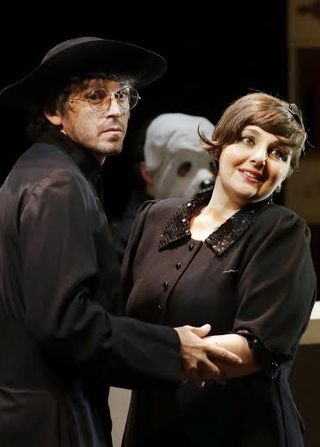
Juan Francisco Gatell as Almaviva, Chiara Amarù as Rossina
It was platinum casting. Young French baritone Florian Sempey may as well be named Giacomo Rossini. He is the spit and image of the twenty-four year-old Rossini of 1816, overflowing with musical energy and unfettered fun. His Italian was perfection, his patter exceeded the speed of light. In short he is the Figaro of your dreams. Upstaged, and then only briefly by Italian bass Alex Esposito as Basilio who in a simple black cossack fingering his rosary oiled his way onto the stage to deliver “la calunnia” knelt in fervent prayer, roaring divine strength and terror to Dr. Bartolo, confessionally kneeling as well. The Basilio of your dreams.
Italian baritone Paolo Bordogna achieved unusual presence as Bartolo, and won us over to a real understanding of a man obsessed by the delights of his table and his fear of germs. He was a not too old, not too ugly, just a fully humanized Bartolo whose obsessed patter too exceeded the speed of light, But he was foiled by the truly dumb antics of his coltraltino (a light voiced, high Rossini tenor) competition — what operatic tenors lack in intelligence they make up in fervor. This was Argentine tenor Juan Francisco Gatell who obliged Rossini’s idea of articulate, gurgling youth to the maximum.
Rosina, Sicilian mezzo Chiara Amarù, needless to say stood in box overlooking the stage (displacing its inhabitants) while she was serenaded by Almaviva. She wore a big post-adolescent smile all evening, except when she sang, and then it was replaced by deadly serious, positively astonishing coloratura. The depth of casting included a sixty-some Berta, that of sixty-some Italian soprano Felicia Bongiovanni, and even a strong voiced Fiorello, Andrea Vincenzo Bonsignore, who displayed intimidating smarts and later, as the Ufficiale, entered the auditorium astride the full-sized rolling horse we saw in the lobby as we entered the theater.
Not to forget the male chorus, members of the local amateur chorus, the Coro San Carlo di Pesaro, who filed on and off the stage, concert style, to wheezily debunk whatever possible sense of fancy opera that might still be present. This wonderful Coro completed the sense of community — Rossini, artists, audience — that the perpetrators of this evening succeeded in creating.
It was finally an evening about words, every word of the comedy clearly articulated and understandable. This was made possible by the perfection of the pit. Young Italian conductor Giacomo Sagripanti coaxed the members of the orchestra of the Teatro Comunale di Bologna to an always comfortable level of delirium that supported and completed the delirium of the singers and the staging. This careful balance in fact made the young Rossini the true star of the show.
Cast and production information:
Figaro: Florian Sempey; Rosina: Chiara Amarù; Count Almaviva: Juan Francisco Gatell; Bartolo: Paolo Bordogna; Basilio:Alex Esposito; Berto Felicia Bongiovanni; Fiorello: Andrea Vincenzo Bonsignore; Ambrogio: Alberto Pancrazi. Orchestra of the Teatro Comunale di Bologna. Coro San Carlo di Pesaro. Conductor: Giacomo Sagripanti; Concept/projections/scenic elements/stage movements/video/costumes: Accademia di Belle Arti di Urbino. Photos courtesy of the Rossini Opera Festival. Teatro Rossini, Pesaro, August 14, 2014.
Armida in Pesaro
Armida (1817) is the third of Rossini’s nine operas for the Teatro San Carlo in Naples, all serious. The first was Elisabetta, regina di Inghilterra (1815), the second was Otello (1816), the last was Zelmira (1822).
The San Carlo was the world’s most important theater at that time. Its legendary caffe waiter turned opera impresario Domenico Barbaja had not only the famous mezzo-soprano Isabella Colbran (his mistress, later Rossini’s wife) on his roster but also three splendid baritenori [literally baritone tenors] — the baritenore, the contraltino and the tenore di grazia represent the Italian high tenor voices of the time. Plus the San Carlo possessed a sizable stable of dancers, an accomplished orchestra with excellent solo players, and, not least, a stage endowed with the latest in technical innovations!
With Elisabetta (anticipating Sir Walter Scott) and Otello (Shakespeare) Rossini had ventured into dramatic territory new to opera. Two masterpieces resulted. But in Armida Rossini returns to the imaginary world of chivalry and its heros, specifically the knight Rinaldo and his captor, the beautiful witch Armida (the late-Renaissance poet Tasso’s intense version of Ariosto’s Alcina, both derived more or less from the Ariadne myth we know so well from the Richard Strauss opera).
Like Tasso Rossini plays the emotive strains of rapture and rage in gloriously rich language — Tasso in word and Rossini in music. The Teatro San Carlo’s librettist was one Giovanni Schmidt who gave Rossini lots and lots of syllables to transform into sublime vocal lines — the inimitable Rossini flights of vocal delirium. Schmidt’s libretto is indeed long on affect (and quite short on action and situation) giving Rossini ample opportunity, maybe too much opportunity to exploit his voices and to explore the affective potentials of the musical instruments in his pit — horns of course and also the extreme treble range of the cello as examples.
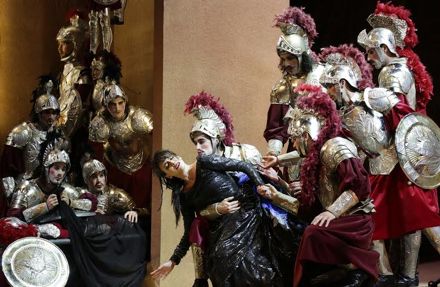
Carmen Romeu as Armida
Even without the complex ensembles that burst forth so magnificently in many of the Neapolitan operas there is potentially just enough of the Rossini genius in Armida to thrust it into the masterpiece sphere. This did not occur just now in Pesaro.
The conductor was Carlo Rizzo, well known to big house audiences for the grand repertory. His Rossini credentials seem to be that he will conduct Mosé in Egitto and Guillaume Tell at the Scottish Opera a couple of years from now. This maestro’s intention seemed to be to layer the moods and colors of late Romantic music onto Rossini rather than to energize and illuminate the Rossini vocabulary and gesture. The Rossini score did not support this stylistic transposition and left us indifferent to the orchestral playing and much of the singing.
In fact the sole ecstatic ovation of the evening occurred for the ballet (normally there are many extended periods of applause and foot stomping that Pesaro audiences use to release their excitement, though intelligence from opening night reports that that audience released its disappointment with considerable booing)! Just when you thought that opera ballets were unique to France you found a thirty or so minute ballet in Naples, and two years later there is an extended dance scene in Mosé in Egitto as well. Throughout its years of patronage by the Bourbon dynasty the Teatro San Carlo fulfilled these rulers’ love of dance.
In the Act II finale Armida conjures an allegorical vision of a young warrior succumbing to the pleasures of the senses. Rossini composed an orchestral theme and variations that choreographer Michele Abbondanza exploited to the fullest with eight or so quite athletic and accomplished dancers from his Compania Abbondanza/Bertoni (his collaborator is the dancer/choreographer Antonella Bertoni) backed up by what seemed to be about ten, maybe twelve able and willing supernumeraries. Mr. Abbondanza’s movement vocabulary was advanced, at once inventive and highly controlled. It was complex, ornamental and inexhaustibly evolving. It was an absolutely over-the-top feat of theater. In short it was everything you want from a Rossini performance.
Choreographer Abbondanza is a teacher at the Scuola di Teatro Giorgio Strehler. The director of this school of such prestigious name is octogenarian Luca Ronconi who was not so coincidently the metteur en scène of this Armida together with his septuagenarian collaborator Ugo Tessatori.
The Rossini Festival assigned Armida to the Adriatic Arena, a venue that has seen over-the-top mise en scènes in recent years, its vast spaces transformed into massive scenic installations supporting brilliant concepts. Thus expectations were high. Long time Ronconi collaborator Margherita Palli created the scenery. It was a crumpled brown paper-like background against which floor to ceiling display cases slid on and off, plus there was a hidden conveyor belt that weirdly transported actors on and off the stage but oddly only three or four times over the long evening. It would have been more appropriate scenery in Pesaro’s traditional Teatro Rossini.
Signor Palli’s credits include installing shows at various museums over the years. Perhaps this experience led to the production concept which seemed to be that we should see this old opera as artifact rather than as living, breathing art. Costumer Giovanna Buzzi cooperated by dressing her soldiers in clumsy, oversized armored vests and blousey shirts that visually stultified all sense of movement. Armida, the only female singer, was in abstract bird-like, intensely colored gowns, solid red for her final scene of first supplication, then revenge. The demons were dressed as bats in costumes that reeked of naiveté to our modern eyes, further quoting antique style costuming and further creating the sense of artifact that Sigg. Ronconi and Tessatori apparently sought.
Armida was sung by young Spanish soprano Carmen Romeu, an ambitious assignment she completed honorably if without distinction. Armida is a role for a star — for the Spanish mezzo-soprano Isabella Colbran as example. It demands a magnetic performer and a great singer. At this point in her career Signorina Romeu is still an aspiring artist who boasts clean and careful, finely wrought coloratura. But the role as well requires considerable full voice singing in the lower soprano register where Sig.na Romeu sometimes lacked the support necessary to maintain accurate pitch. One does however appreciate the conceit of casting a Spanish soprano in this Colbran role.
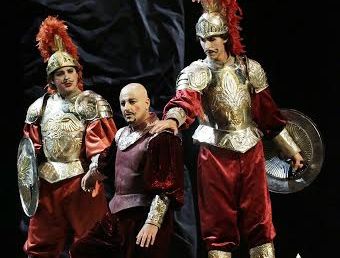
Dmitry Korchak as Carlo, Antonino Siragusa as Rinaldo, Randall Bills as Ubaldo
The high point of the evening was when Rossini’s compositional virtuosity exploded in the third act three tenor trio, “In quale aspetto imbelle” — Rinaldo sees himself reflected in a warrior’s shield as a disarmed lover. The knights Ubaldo and Carlo encourage him in his struggle to sacrifice love to glory. The lover Rinaldo was sung by Italian tenor Antonino Siragusa, a veteran of many roles in Pesaro, usually villains. It was a stretch of imagination to see him as the romantic hero. He is a very fine singer with all the secure, ringing high notes Rossini demands, and exquisite, beautifully voiced coloratura. He offered the finest vocal pleasures of the evening.
Russian tenor Dmitry Korchak cut a fine figure first as Gernando, a French knight who was outraged when Rinaldo was elected as leader of the French forces, and then as Carlo, a knight sent to rescue Rinaldo from Armida. Mr. Korchak possesses the baritonore voice, a darkly colored high voice. While he did manage his few high notes, barely, he created none of excitement with them that he achieved in his coloratura. American baritenore Randall Bills was asked to portray Goffredo, the commander-in-chief of the Christian forces. He is a slightly built, fine young artist with a lovely, warm tone. He was dramatically far more successful later in the opera when he had become the French knight Ubaldo and contributed significantly to the overwhelming beauty of the tenor trio.
Cast and production information:/
Armina: Carmen Romeu; Rinaldo: Antonino Siragusa; Goffredo/Ubaldo: Randall Bills; Gernando/Carlo: Dmitry Korchak; Idraote/Astorotte: Carlo Lepore; Eustazio: Vassilas Kavavas. Ballet: Compagnia Abbondanza/Bertoni. Orchestra and chorus of the Teatro Comunale di Bologna. Conductor: Carlo Rizzi; Metteurs en scène: Luca Ronconi and Ugo Tessitore; Choreographer: Michele Abbondanza; Scenery: Margherita Palli; Costumes: Giovanna Buzzi, Lighting: A.J. Weissbard. Photos courtesy of the Rossini Opera Festival. Arena Adriatica, Pesaro, August 13, 2014.
Il turco in Italia at the Aix Festival
A revitalized Rossini world has emerged over the past several decades, the difficult if astonishing tragedies find occasional productions, the famous comedies find ever tighter mise en scènes, and singers have reached for an ever more refined Rossini technique and style. So when a conductor comes along who can enter the Rossini ethos, and this is not often, a sort of operatic nirvana can be achieved.
Director Alden’s Turco at the Long Beach Opera is remembered as one of these rare operatic moments. While the musical resources of a small opera company are limited, and American operatic resources twenty years ago were more enthusiastic than accomplished the Long Beach Turco succeeded not because of conducting but because of the staging. Alden’s heroine, trapped in her drab existence, found escape in the movies (like many of us in the 1950’s), and imagined herself swept of her feet by a handsome guy in a white suit with an accent. Finally, of course, real life prevailed and real love won the hearts of everyone.
This simple concept anchored three hours of singing, and made the very high artifice itself of the brilliant Rossini style the emotional crux of this fantasy of fulfillment.
Twenty years later Alden has now envisioned Rossini’s comic masterpiece as an intellectual game, much like Pirandello’s Six Characters in Search of an Author. Alden has made Rossini’s playwright Prosdocimo the protagonist of the opera, not just a benevolent facilitator of an intrigue about to happen (librettist Felice Romani had enriched a commonplace operatic comedy with the conceit of an author looking for a story). Alden’s Prosdocimo is an omnipresent troublemaker in perpetual conflict with his characters.
Prosdocimo possesses a Pirandello era (or so) typewriter on which he actually performs the Rossini score — clackity clack, clackity clack — in lively sync with the sounds coming from the pit. Well, until the heroine Fiorella grabs the typewriter to write her own script for a while. Alden makes his concept work flawlessly, with business between the author and his characters happening every second. Few if any moments are spared for us to savor the human dimensions of the story while we admire this interplay of wills.
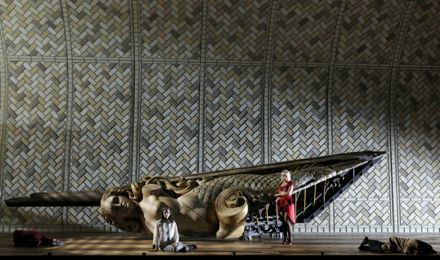
Alden and his set designer Andrew Lieberman know that less can be more, therefore they endeavored to keep the surroundings as simple as possible. The set is a floor that is stuck upon what would be the back wall of the stage climbing onto what would be the ceiling — a mind-boggling vaulted floor. It is the floor of an unidentified room, maybe the floor of the Korean evangelical church the pair used for their Berlin Aida a few years back. There was a church basement coffee urn in one corner of the Aix set, a reference certainly foreign to the French audience.
Alden furthered his early-twentieth-century-theater concept with an extravagant overlay of theatrical tricks discovered by Pirandello’s contemporary Bertolt Brecht. The staging was indeed an amusing primer in Brecht's so-called Epic Theater, notably the half curtain, here movie palace green with a gold fringe. Set and costume changes were Brechtian a vista — we got to see a few of France’s intrepid intermittants actually at work (these are seasonal theatrical technicians about to loose their favored unemployment compensation who had gone on strike to prevent the premiere of Il turco from occurring as scheduled). All this Epic Theater served as smart business to intensify the mind games.
Lighting designer Adam Silverman provided an initial blast of stark white light emanating from a stage-wide hanging line of institutional lights, then at times he used only a part of the line to indicate a reduced acting area within the extreme width of the Archevêché theater. As well much use was made of exaggerated side lighting (a side wall deftly slide back to admit this strong yellow gold light), not to mention changing the color of the huge back wall floor to rose or light green from time to time, and the surprising moment when a strip, stage wide, of lights embedded into the floor burst into in brilliant upward light. Like the staging and the design, the lighting too was virtuoso.
The prow pole of a classic sailing ship, replete with the sumptuous breasts of its carved female figurehead, was the Brechtian image for the Selim (the Turco). He was Romanian bass Adrian Sampetrean who was purely and simply machismo incarnate. Vocally he delivered raging coloratura cleanly and in full voice and displayed a confidence of character that was appropriately intimidating. Russian soprano Olga Peretytko, a regular at the Pesaro Rossini Festival, made a cheap and sassy Fiorella, well able to delightfully embody the caricature of a tacky Hollywood sex queen. Unfortunately by this penultimate performance (a run of seven) she was unable to find the vocal brilliance and stability that would equal her exquisitely defined character.
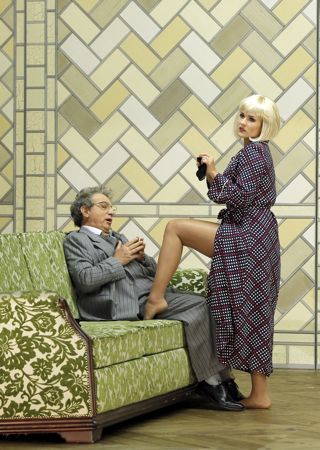
American soprano Cecelia Hall was Zaida, the Turco’s original love now in competition with Fiorella, She was costumed, like the Turco (whose only Turkish mark was a beaded fez), in homely, 30’s or 40’s drab everyday western clothes. The costume designer was Kaye Voyce, like Lieberman and Silverman, a frequent Alden collaborator. She managed a huge variety of vividly defined costumes — gypsy-like skirts for the six women extras who accompanied the drab Zaida (so we would know she is a gypsy even though she was not dressed like one), not to forget the transparent, filmy, fancy ball gowns the eighteen male choristers donned to create the masquerade party.
All this theatrical brilliance on the stage would have been more effective and more meaningful had there been a brilliant Rossini pit. As it was there were Les Musiciens du Louvre Grenoble, an original instrument orchestra (instruments of the time a piece was composed) founded 30 years ago by its now famous conductor Marc Minkowski. Perhaps, though doubtfully, a Rossini orchestra actually sounded like a wheezy reed organ, but this is not the sound needed to support a conceptually and theatrically complex contemporary opera production.
Conductor Minkowski never reached the Rossini boil that propels the listener into musical euphoria. The only true Rossini moment of the evening was achieved by tenor Lawrence Brownlee who gamely portrayed Don Narciso (an additional suitor of Fiorella) as an trench coat covered spastic. He lay in front of the half curtain and delivered “Tu seconda il mio disegno” in high style to earn the biggest, and the only real ovation of the evening.
Italian buffo Pietro Spagnoli ably fulfilled the task of bringing Alden’s high energy Prosdocimo to life for the duration of the long evening, and baritone Alessandro Corbelli found his match as the duped, defeated Don Geronio, the long-suffering husband of Fiorella.
Casts and production information:
Selim: Adrian Sâmpetrean; Fiorilla: Olga Peretyatko; Don Geronio: Alessandro Corbelli; Narciso: Lawrence Brownlee; Prosdocimo: Pietro Spagnoli; Zaida: Cecelia Hall; Albazar: Juan Sancho. Chœur: Ensemble vocal Aedes; Orchestre: Les Musiciens du Louvre Grenoble. Conductor: Marc Minkowski; Mise en scène: Christopher Alden; Décors: Andrew Lieberman; Costumes: Kaye Voyce; Lumière: Adam Silverman. Théâtre du l’Archevêché, Aix-en-Provence, July 19, 2014.
Winterreise and Tauernacht at the Aix Festival
That’s A Winter’s Journey and A Night of Mourning for metteurs-en-scène William Kentridge (South Africa) and Katie Mitchell (Great Britain), completing the clean sweep of English language stage directors for Aix-en-Provence productions this year.
Luckily German baritone Matthais Goerne and Austrian pianist Markus Hinterhauser were enlisted by the Festival to imbue genuine nordic Romanticism into the Schubert masterpiece. Albeit the strum und drang of late Romanticism that seemed on the brink of expressionism.
Mr. Goerne is famous for his performances of Die Schöne Müllerin (including a recent performance in San Francisco), making this 1826 Schubert cycle an outwardly emotional experience within his evenly tempered, dynamic and very clear baritone sound. It is a reading of the cycle that proves his mastery of its performance traditions and embarks on a measured transcendence of historical style and Schubertian presence.
His Winterreise was even more transcendent. It was a terrifying, angry journey through Schubert’s bleak landscape. Mr. Goerne emitted uncomprehending cries and bitter exclamations reliving an heretofore unexplored agony that can only be supposed within the soul of the syphilis stricken 28 year-old composer. With his accomplice Markus Hinterhauser hunched over the gigantic Steinway piano middle-aged Matthais Goerne exposed Schubert’s one hour twenty minute journey in unrelenting, electric tones that tore through your soul.
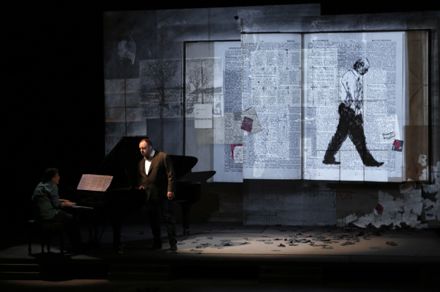
The physical presence of this large man and powerful artist, his voice magnified by the designer acoustic of the recital hall of the new Aix conservatory of music, plus the resources of a twenty-first century engineered concert grand piano played by a hyper sophisticated musician (Mr. Hinterhäuser is the artistic director of the Salzburg Festival) could only dwarf the gloss of the video accompaniment imagined by South African artist and actor William Kentridge. Mr. Kentridge does not possess the vocabulary or emotional scope to embody or virtualize these first moments of the very brief Schubert maturity.
In spite of a vague physical resemblance (both middle aged, comfortably fed men) Mr. Goerne could not become the traveler imagined by Mr. Kentridge. In fact that traveler was William Kentridge himself, his pen and ink drawn profile (resembling and as recognizable as the famous profile of Alfred Hitchcock) marched across the screen already in the second song. This alone created an insurmountable gulf between the actual (Mr. Goerne) and the virtual (Mr. Kentridge).
Mr. Kentridge is well known to opera audiences through his brilliant stagings of a puppet Il ritorno d’Ulisse and a multi-media Die Zauberflöte. His staging of Shostakovich’s derisive The Nose was betrayed by his evident good and open nature, quick wit and easy charm. These overpowering Kentridge attributes were indeed present in his Winterreise as well and were in irreconcilable conflict Mr. Goerne’s angoisse.
There were a few interesting moments. Baritone Goerne gave his performance in concert position standing by the piano that was placed off to the side of a low stage platform backed by a large screen. In the seventh song Goerne walked to the middle of the platform to relate momentarily to the projected visual field — Schubert’s river torrents were rendered as pen and ink drawn water faucets. It was conscious recognition that there was no connection between music and image, and this alone created a powerful connection.
Again in the seventeenth song the baritone moved center stage to recognize Muller’s sleepless villager who had become Kentridge’s sleepless, cigar smoking mogul — a striking, wild card image that effectively layered extraneous nineteenth century industrial revolution overtones upon baritone Goerne’s private and personal desolation.
The twenty-first song, Schubert’s inn by a cemetery, achieved a sort of unity of word and image. Kentridge rendered the simplicity of the conceit of this song by drawing lines of tombstones in crude shapes that bespoke his exhaustion of ideas. And finally in the twenty-fourth and final song Schubert’s old man rolling his cart on icy paths through the freezing village became Kentridge’s procession of bent South African black women, silhouettes, carrying their burdens or pumping railroad carts, images that are a recurrent image in the Kentridge oeuvre. Word and image were in distinct hemispheres (northern and southern) but became, surprisingly, one globe.
Katie Mitchell’s Trauernacht is a collection of four choruses, five recitatives and five arias (ranging between BWV 46 and BWV 668) from among J.S. Bach’s 200 cantatas. Plus an initial a capella motet composed by Johann Christof Bach that at once reduced our expectations of the vocal forces for the evening to the four singers who were on the stage to sing it.
British stage director Mitchell distinguished herself at the Aix Festival two years ago with her staging of Richard Benjamin’s Written on Skin (it was a complicated household situation) and returned last summer for another premiere, The House Taken Over (a complicated household situation) thus it was no surprise that Trauernacht (Night of Mourning) was a complicated household situation — a soprano, alto, tenor and bass try to come to grips with the death of their father over dinner.
Katie Mitchell and young French early-music conductor (and counter-tenor) Raphaël Pichon compiled these bits of cantatas that are sort of like a requiem mass — a sinner begs to be saved — though unlike a requiem mass it seems in Trauernacht that the children ultimately find solace in the illusion that their father basks in the gaze of God.
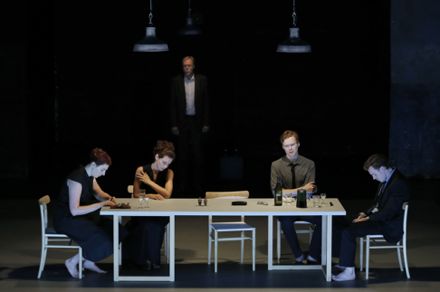
The four voices (two males and two females), simply and somberly clothed, wandered onto a platform where there was a dinner table and four chairs, though there was a fifth chair that was finally occupied by the father who sang one brief aria. However for most of the evening he remained a phantom who sat at the back of the naked stage, standing up from time to time to whistle eerily.
The four singers had mastered slow motion movement in order to move on and off the stage without disturbing the almost beat-less flow of the music. These artificial movements were quite extended as the singers served themselves a three course meal from shelves that were on the far sides of the stage. They were barefoot.
All this might have worked had the musical forces been finished artists. As it was the young musicians on the stage and particularly those in the pit lacked the polish to create a purity of sound and form that can propel J.S. Bach’s music into celestial spheres. What might have been sublime music (and probably was on the recordings used to imagine this pastiche) became a tedious exposition of antique four-part harmony.
Katie Mitchell is old enough to have known better.
Casts and production information:
Winterreise: Baryton: Matthias Goerne; Piano: Markus Hinterhäuser. Mise en scène et création visuelle: William Kentridge; Scénographie: William Kentridge et Sabine Theunissen; Costumes: Greta Goiris; Lumière: Herman Sorgeloos. Aix-en-Provence Conservatory of Music, July 12, 2014.
Trauernacht: Le Père: Frode Olsen; Soprano: Aoife Miskelly; Mezzo-soprano: Eve-Maud Hubeaux; Ténor: Rupert Charlesworth; Basse: Andri Björn Robertsson. Orchestre: Instrumentistes de l'Académie européenne de musique. Conductor: Raphaël Pichon; Mise en scène: Katie Mitchell; Costumes et scénographie: Vicki Mortimer; Lumière: James Farncombe. Théâtre du Jeu de Paume, Aix-en-Provence, July 16, 2016.
Nabucco at Orange
It was a production by Jean-Paul Scarpitta who was stage director and scenery and costume designer. Mr. Scarpitta’s dramaturgy is informed by his fascinations for Giorgio Strehler and Robert Wilson from which many wonderful stagings have resulted during his ten year residency in Montpellier.
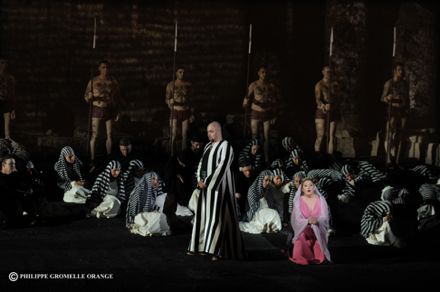
There was promise in the air, the breadth of the raked stage (300 feet wide, 60 feet deep) was covered in a black asphalt-like substance, the mostly intact, imposing scaenae frons (back wall of the theater) was bare, overseen from high above by the massive sculpture of the Emperor Augustus. The revelation of the evening was the lighting of the black floor by Urs Schônebaum, its enormous shiny, rough surface shone in a myriad of intensities for the huge exterior scenes, sometimes it was reduced to a brilliant square of white light to frame a singer (Nabucco’s intensely personal “Son pur queste mie membra”), other times strong directional side light cast enormous, elongated shadows across the stage that deepened emotional relationships (the Act I confrontation of Abigail with the lovers Fenena and Ismaele).
Scapitta’s staging of Verdi’s early masterpiece was sabotaged often by the video projections on the back wall. After an initial appreciation of the technical feat of accomplishing such massive projections (ranging from discretely deployed white-lighted, descending emotional shapes to the ugly, yellow-ish, sprayed styrofoam image that covered the entire back wall for the palace interior scenes) the projections became distractions to the accomplishments of the singers and lights on the black floor.
Mr. Scarpita is a musical stage director, his actors moved more by musical line and musical structural rather than by dramatic motivation. Here too he was sabotaged, now by singers who were read as static lumps of color rather than as the excited singers responding to the young Verdi whose Nabucco revealed his genius for the first time.
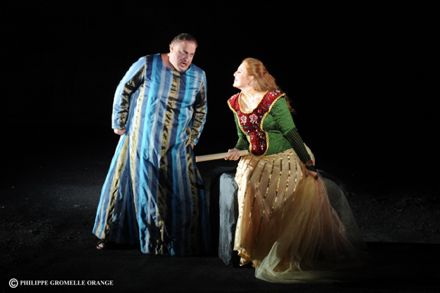
Veteran Georgian baritone George Gagnizde made some big sounds in a strong entrance but soon fell into an almost lieder-like performance by a bored singer. Veteran Austrian soprano Maria Serafin, a noted Tosca, no longer has the bloom of voice and perhaps never had the agility of voice to create a vibrant Abigail, a character Verdi created to tear-up-the-stage vocally and dramatically.
Younger members of the cast were more effective. French mezzo-soprano Karine Deshayes made a low key Fenena that conveyed a static presence and personality in her monochrome rose costume. Italian tenor Piero Pretti sang a stylish Ismaele and moved gracefully.
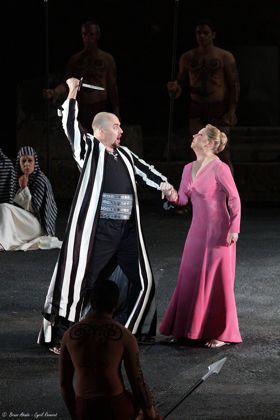
The opera is however about Nabucco and Abigail, not Fenena and Ismaele. Russian bass Dimitry Beloselskiy made it about the Jewish high priest Zaccaraia as well. This fine young bass found the voice and presence to make his role the biggest performance of the evening. Unfortunately his performance was sabotaged by his costume, a white robe covered by black lightning bolt-like (sort of) shapes. While the powerful shapes on the costume sought to embody a force of divine strength they instead made his exhortations seem decorative rather than dramatic.
The costumes of the chorus were always identical, creating giant blocks of color on the stage, mostly static swathes of color that in theory (and if they were far larger) might have become a pedal-point musical color. The problem of how to move these blocks of color onto and off of the stage was never overcome. An additional scenic impulse backfired — thirty or so spear carrying Babylonian warrior extras wearing only loin clothes. Had these stalwart young Orangeois been clothed they might have seemed handsome and strong. Semi-nude they exposed a variety of shapes and postures that cried out for prosthetic chests.
The sight lines from the cavea (the tiered seating) of the Théâtre Antique makes the orchestra (seated in the “orchestra” of a Roman theater) a visually important part of the field of vision. This presence together with the fine acoustic of the theater leaves the orchestra as exposed as a solo singer on the stage. Here the unforgiving acoustic revealed the weaknesses of the Orchestre National de Montpellier, particularly the winds, The sound of the orchestra itself lacked the finesse expected of a fine French orchestra.
The conducting of veteran Israeli maestro Pinchas Steinberg did not come near the intense excitement that Verdi had found within himself for opera as a patriotic art form, nor for the new styles of vocal virtuosity that Verdi asked of his singers. Even “Va pensiero” came across as little more than a self-conscious hum along.
And what about the lighted, window onto upstage stage center from back stage that was left uncovered? Its light and passing figures fouled the stage picture of anyone sitting in Section 4. Is there no one home at the Chorégies?
Casts and production information:
Abigaïlle: Martina Serafin; Fenena: Karine Deshayes; Anna; Marie-Adeline Henry; Nabucco: George Gagnidze; Zaccaria: Dmitry Belosselskiy; Ismaele: Piero Pretti; Il Gran Sacerdote di Belo: Nicolas Courjal; Abdallo: Luca Lombardo. Orchestre National Montpellier Languedoc-Roussillon. Choruses of the opera companies of Nice, Montpellier, Avignon and Toulon. Conductor: Pinchas Steinberg. Mise en scène, scenery and costumes: Jean-Paul Scarpitta; Lighting: Urs Schönebaum. Théâtre Antique Romain, Orange, France, July 9, 2014.
Ariodante at the Aix Festival
High drama in Aix. Three scenarios in conflict — those of G.F. Handel, Richard Jones and the intermittents (disgruntled seasonal theatrical employees). Make that four — mother nature.
All for Lodovico Ariosto’s brief histoire of Ginevra and Ariodant in his send-up of chivalry in his epic farce Orlando Furioso. By the time this little story got to opera it had lost the famous indulgent smile Ariosto cast on knights and damsels and now needed about twenty-five arias to resolve a truly complicated mess.
This production by British director Richard Jones was created just now in Aix, the start of its travels to Amsterdam, Toronto and Chicago — the Aix Festival has an incessant belief that co-productions are economical.
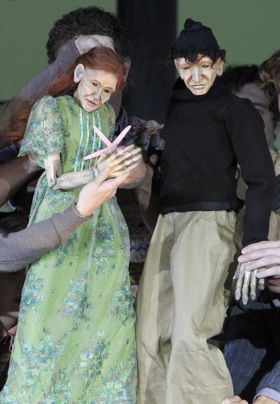
Somehow Ariosto and Handel and the American Midwest made Mr. Jones think of American Gothic painter Grant Wood’s “Dinner for Threshers” (or maybe it was Ultz’s idea, his mono-named designer). The set was an exact copy. We would not have known where Handel’s opera takes place had not Ariosto’s King of Scotland worn a kilt. But Richard Jones’ American threshers of the Wood painting were on the stage much of the evening keeping the action firmly in the western hemisphere, a presence that did not endear them to the exasperated audience (there was whistling when these valiant participants took their 2 AM bows).
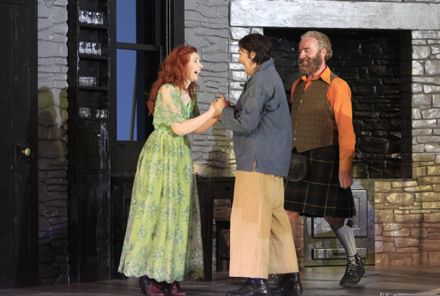
Mr. Jones determined that Ariosto’s poetic immolation of fallen damsels might be poetically well represented by implying the brutally restrictive mores he imagines imposed by American gothic principles. It is an amusing premise, probably more amusing to Europeans than to Americans like me who think that Europeans should mind their own moral business.
Handel’s Ariodante is different than most Handel operas because it includes dance interludes (Handel inserted them to be able to include the participation of a famous dancer and her company at the Covent Garden 1735 premiere). Since Ginevra is believed to be a fallen woman these interludes made Mr. Jones think of burlesque pole dancing (an art form born in Canada during the Great Depression by the way) that he was able to include by turning Ginevra, at least as imagined by American threshers, into a puppet who was stripped of her chaste garments, then scantily clad in black vinyl and red spike heels and made to masturbate abstractly on a rake handle.
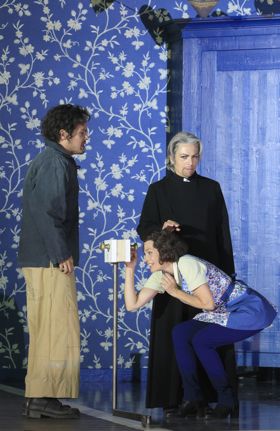
But Mr. Jones did not exclude dancing after all, as he had his American threshers shed their shoes and line them up across the front of the stage in the old death ovens image and happily do a country dance to the arias that announced the “they-lived-happily-ever-after” resolution (The king of Scotland was spared from burning his daughter who married her intended, Ariodante, after all).
Mr. Jones’ real Ginevra however bought none of this. She packed her suitcase, slipped out of her bedroom, walked onto the stage apron and when last seen was hitching a ride, presumably to Toronto or Chicago.
Maybe there was Ariosto’s famous smile after all. The audience indulged Mr. Jones with rapt attention in the second and third acts (it was hard to concentrate in the first act — read on), and rewarded him with thunderous boos (hues in French), meaning that we had had a very good time and loved every minute and that we did not know what to think. Mr. Jones’ wide smile never left his face.
Where was Handel in all this, you may ask. Well, he was right there and having a very good time too, though none of this was what he had in mind.
The esteemed Freiburger Barockorchester is in residence in Aix for this 66th Festival d’Aix with its period brass and wind instruments, and its gut strings making its uniquely cultured sound that placed Handel’s score in another time and another place. Just when you might have thought that it does not really matter what orchestra is in the pit for a Handel opera an aria would come along that was infinitely enriched the with colors that could emanate only out of this superb orchestra.
Handel surely could have only rejoiced to the matched cast of excellent singers brought to Aix for the occasion. French soprano Patricia Petibon overshadowed all others in an over-the-top performance as Ginevra, able to float beautiful high, straight (vibrato-less) tones and to cut loose in full voiced lyricism. As Mr. Jones’ Ginevra she introduced a pathos to her Act II lament (she believes Ariodante is dead) that went beyond brilliant Baroque singing to arrive, almost, at whispered tones. In total her very clear voice mfelted into a beautifully defined and determined character — it was a complete performance.
No less striking was the Polinesso of Italian contralto Sonia Prina as Handel’s vindictive Duke and as Mr. Jones’ morally corrupt fundamentalist preacher who stood over Grant Wood’s harvest table during the overture to deliver the blessing (an understandably exasperated audience member shouted “oh sit down”). Mme. Prina sang with color and assurance as if she were a famed castrato, her staccato fioratura genuinely astonishing, her brilliant wig (a long gray, troublesome lock on either side fell onto her face, plus a long, sexually ambivalent braid) made us detest her even more.
The balance of the cast gave high-wire vocal acts as well. Dalinda (Ginevra’s maid) as sung by French harpist turned soprano Sandrine Piau was not Handel’s confused soubrette but a full-scaled vocal villain who raged magnificently at love and not because Polinesso had raped her (on stage) but because he did not love her. Ariodante’s brother Lucanio was sung by American tenor David Portillo who was the junior member of the cast, and even so managed to hold his own and render his inexperience and youth as Lucanio’s innocence and naiveté. Italian bass Luca Tittoco straddled the poles of an isolated, old fashioned farmer who should have felt a bit silly in a kilt while he had to be a mythical personage from the age of chivalry at the same time.
Ariodante, British mezzo-soprano Sarah Connelly, brought an encompassing warmth to Handel’s hero, having suffered setbacks worthy of Ariosto’s erstwhile knight on her way to the stage, escorted from her dressing room to the stage by police who protected her from the intermittents who had broken into the backstage of the theater, knocked over a stagehand and blocked her way (first act). Later (second act) she waited to deliver her exquisitely chiseled lament (Polinesso had deceived Ariodante into believing that Ginevra was unfaithful) while a screaming car alarm was located and removed from the auditorium.
Italian early music conductor Andrea Marcon [sic] presided, evidently unflappable, over the evening, not stopping when the intermittents began a barrage of noise just outside the open air theater during the first act. Though later he coolly halted his pit musicians and the stage when security measures needed to be undertaken, started again as if nothing had happened. Thankfully in Act III (1:30 AM) he did not stop when lightning, thunder and raindrops competed with Handel and Richard Jones for our attention. The wind whipped costumes of the singers must have created some consternation among those on the stage who surely were, like us, praying for the end to come.
And yes, finally, the twelve valiant threshers from English Voices, the excellent chorus, took off their shoes and danced one last time. We booed gleefully and went back to our hotels.
Casts and production information:
Ariodante: Sarah Connolly; Ginevra: Patricia Petibon; Dalinda: Sandrine Piau; Polinesso: Sonia Prina; Lurcanio: David Portillo; Il Re di Scozia: Luca Tittoto; Odoardo: Christopher Diffey. English Voices (chorus) and the Freiburger Barockorchester. Conductor: Andrea Marcon. Mise en scène: Richard Jones; Décors et costumes: Ultz; Lumière: Mimi Jordan Sherin; Chorégraphe: Lucy Burge; Metteur en scène et concepteur des marionnettes;Finn Caldwell. Théâtre de l’Archvêché, Aix-en-Provence, July 3, 2014.
La Flûte Enchantée (2e Acte) at the Aix Festival
In past years the operas of the Aix Festival that took place in the Grand Théâtre de Provence began at 8 pm. The Magic Flute began at 7 pm, or would have had not the infamous intermittents (seasonal theatrical employees) demanded to speak to the audience.
These are the folks who brought down the 2003 Aix Festival after disrupting the opening night La traviata, and are threatening to bring down the current Aix and Avignon festivals, the crown jewels of estival high art in France. Recognizing the periodic nature of employment for workers in theatrical arts, including cinema, the French government awards the intermittants unemployment compensation well above that provided unemployed workers in fields that offer permanent employment.
This enlightened and much abused program of the French state subsidizes the ferment of the theatrical arts in France by allowing technicians and artists to pursue careers in theater rather than by forcing them to seek careers in fields that provide full employment. The Aix and Avignon festivals are the most vulnerable battlefields for working through the inevitable fiscal and political tensions created by such a program.
All of the intermittents of the Aix Festival filled onto the stage at a bit after 7 PM last night (July 2, opening night), one of whom read a brief, dignified statement about the contribution of the intermettents to French arts. The audience applauded and they filed off, not delaying the performance sufficiently to allow those of us who arrived mistakenly at 7:30 for an 8 pm curtain to catch the first act.
Never mind, Act II is the masterpiece act. It was a great pleasure to be able to enter the auditorium, finally, the chorus seated in a spread out auditorium fashion facing us (the audience) on the bare, black stage. Sarastro walked through the Freiburg Baroque Orchestra (seated house level) mounted the podium to deliver the Masonic creed in a precious, very precious German (like you might use to speak to idiots). This address was on what is called the “God” microphone (the microphone held by the stage director during the final theater rehearsals) that reverberates in volumes only known to overpowering deities (stage directors). It was an impressive trick. Promising.
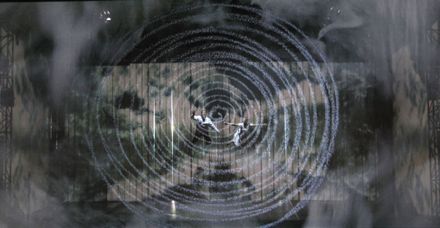
Trail by Water to sound effects (visual effect in silence)
The production, by London theater personality Simon McBurney, was first done last winter at the English National Opera in the English language. What may have been real words (in English) to a British audience became cute, caricatured Germanic sounds for a very French audience in very French Aix that enclosed the entire production (well, the second act) within quotation marks — Die Zauberflöte quoting itself. Add this to Mr. McBurney’s highly self conscious theatrical vocabulary — all scenic effects were physically performed in miniature on one side of the stage and projected onto the stage backdrop, all sound effects (multitudinous) were physically created in miniature on the other side of the stage and amplified throughout the hall. The presence of theatrical manipulation was overpowering.
Mr. McBurney and his collaborators have a fecund recollection of advanced theater vocabulary, virtually every avant-garde gimmick that has been over-used in theater crazed Berlin over the past 30 or so years found its way onto the Grand Théâtre de Provence stage during the next hour or so, very long hour or so. The few very fine moments of theatrical success — the opening Act II council, the Queen of the Night’s Act II wheelchair aria ("Der Hölle Rache kocht in meinem Herzen"), Tamino and Papageno’s final encounter with the Three Ladies, and the choreographic shapes created in the final chorus unfortunately did not contribute to a comprehensible exposition of the philosophy of this masterpiece.
McBurney’s Flute set out to amaze and amuse. On this level it well succeeded with the opening night audience. However Mozart’s massive singspiel was never intended to be an ordinary little entertainment for the Viennese hoi polloi of yesteryear or the Parisian haute bourgeoisie of today. It set out to exemplify the encompassing nobility and the eternal importance of the Masonic process, not to make theatrical fun out of it. Die Zauberflöte was completely forgotten in McBurney’s theatrical gluttony. But no matter, the audience was impressed and the powers that be of the Aix Festival are pleased as Punch.
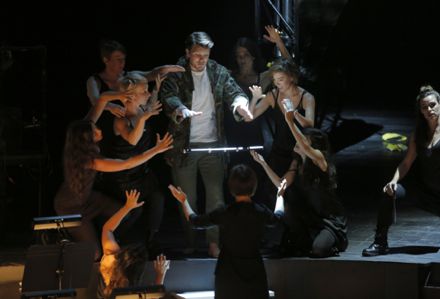
Presentation of the flute by members of the orchestra
Bernard Foccroulle (foe-crew-yeh), general director of the Aix Festival is committed to co-productions as a cost-cutting measure. Therefore any production you now see in Aix may not be specific to the time (now) and place (Aix). In this case Mozart’s Flute was created last year by an Englishman for an English audience. What then remains to make the Aix Flute a production of the Aix Festival is the cast, chorus, conductor and orchestra.
It is a prestigious festival. Its efforts to assemble the musical personnel are intelligent, interesting and far-reaching. The Flute cast reached perfection in the Pamina of young Norwegian soprano Mari Eriksmoen with just the right blond look who possesses of voice of pure tone befitting of the purity and innocence of Mozart’s heroine. The same may be said of young French tenor Stanislaus de Barbeyrac who found the perfect balance of innocent manhood and enlightened aspiration.
Papageno was Dutch baritone Thomas Oliemans who was given so much business on the stage and within the audience that his presence was irritating to those of us (surely there were at least a few of us) who did not buy into Simon McBurney’s onslaught. This included a virtuoso level keyboard performance by Mr. Oliemans on a keyboarded glockenspiel, an imagined version of an instrument Mozart included but of which no example has survived.
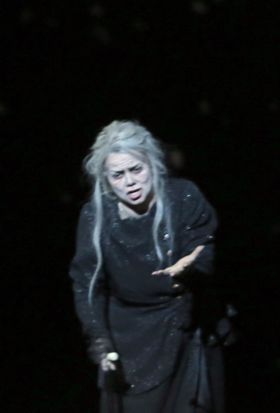
Queen of the Night
The balance of the cast from around Europe and the U.S. were handsome singers, very ably fulfilling their requirements. German bass Christof Fischesser as Sarastro suffered the indignity of competing with the very loud, extraneous sound effects McBurney added to the Sarastro scenes. The contrast between these volumes and the natural acoustic of Mr. Fischesser’s voice rendered, by comparison, his arias too softly delivered to be impressive.
The three boys, named only as soloists of the Knabenchor der Chorakademie Dortmund, were big, finished performers who grandly did McBurney’s bidding of turning the purity of young boys into instruments of the Queen of the Night’s chaos.
Freiburg’s famed baroque orchestra (Freiburger Barockorchester) was in the pit bringing spectacular colors to Mozart’s transcendental music. The 32 youthful voices of Britain’s English Voices created a magnificently clear, beautifully pure and very loud "Die Strahlen der Sonne" (the final chorus). Spanish conductor Pablo Heras-Casado presided over the occasional periods the production allowed the Mozart score to take over. His efforts to make an impression then became too obvious. Even so, there were many splendid musical moments.
Mr. McBurney skipped in to take his bows in jeans, a shirt carelessly (wanna bet) tucked in, and a baseball cap worn backwards. Cool, very cool.
Casts and production information:
Tamino: Stanislas de Barbeyrac; Pamina: Mari Eriksmoen; Queen of the Night: Kathryn Lewek; Papageno: Thomas Oliemans; Papagena: Regula Mühlemann; Sarastro: Christof Fischesser; Monostatos; Andreas Conrad; Erste Dame: Ana-Maria Labin; Zweite Dame: Silvia de La Muela; Dritte Dame: Claudia Huckle; Der Sprecher: Maarten Koningsberger; Erster Priester/Zweiter Geharnischter: Krzysztof Baczyk; Zweiter Priester/Erster Geharnischter: Elmar Gilbertsson. English Voices (chorus) and the Freiburger Barockorchester. Conductor: Pablo Heras-Casado; Mise en scène: Simon McBurney; Décors: Michael Levine; Costumes: Nicky Gillibrand; Lumière: Jean Kalman; Vidéo: Finn Ross; Sound: Gareth Fry. Grand Théâtre de Provence, July 2, 2014.
La traviata in Marseille
It took only a couple of years for Il trovatore and Rigoletto to make it from Italy to the Opéra de Marseille, but it took La traviata (Venice, 1853) sixteen years (Marseille, 1869).
Maybe because it had a bad reputation as a betrayal of Alexander Dumas fils’ novel La Dame aux Camélias and maybe because local critics had already objected to its jumpy motifs and its vulgar rhythms. Once on the stage of Marseille’s venerable Opéra (1787) however it has become, with Rigotetto, Marseille’s most performed opera.
These June performances were sold out three months in advance — one wonders what foresight will have informed the Marseillais that this was a Traviata not to miss?
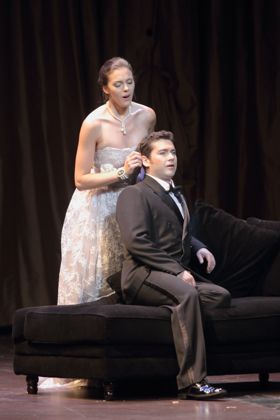
Zuzana Marková as Violetta, Teodor Ilingäi as Alfredo
All photos copyright Christian Dresse, courtesy of Opéra de Marseille
Alexander Dumas fils too might have been pleased. His 20 year-old Marguerite, renamed Violetta in the opera was very young as well, and very beautiful. The honesty and ironic innocence that Dumas finds in his ill-starred prostitute radiated from young Czech soprano Zuzana Marková in her role debut.
Mlle. Marková may have been a somewhat tentative Lucia last winter in Marseille, but as Violetta she moved with new found grace and delivered a deeply studied performance with complete mastery and conviction. She is a remarkable technician in the first flower of beautiful, clear, coloratura voice. The E-flat taken in “Sempre libera” rang with silvery confidence, the mid-voice of the second act and death shone with strength and warmth.
It was a sterling performance allowed by remarkable conducting, that of Stuttgart formed young Korean maestra Eun Sun Kim (it is already an established career with credits at English National Opera, Frankfurt Opera, Vienna Volksoper). The maestra is clearly of a new generation of conductors who feel tempos in a minimalist sense — slower macro-pulses offering sound spaces where immediate depths may be probed. Musical energy is discovered by the exploration of this microcosmos rather than in energy found by forcing brute speed and sudden braking.
This musicianship allows for the lyric expansion inherent in bel canto and here it laid bare the roots of the mid-period Verdi in this rapidly disappearing style. Mlle. Markocá exposed bel canto’s purity of melodic intention by stylishly suspending her musical lines, plus she exploited these long, carefully sculpted melodic contours in lovely pianissimos and full fortes, and with beautiful vocal colors.
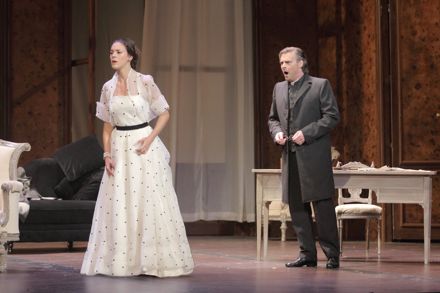 Zuzana Marková as Violetta, Jean-François Lapointe as Giorgio Germont
Zuzana Marková as Violetta, Jean-François Lapointe as Giorgio Germont
The conducting of Eun Sun Kim well served the artistry of Canadian baritone Jean-François Lapoint as Giorgio Germont. Mr. Lapoint who counts both Pelleas and Golaud among his roles is primarily known in the French repertory. He brought a projection of text from these roles, and a delicacy of delivery that created an unusual depth of personality and musical presence to Germont. The absence of an Italianate color and inflection, and an inborn leading-man presence were overcome here by the convincing sense of bel canto that he and Mlle. Eun achieved (Mr. Lapointe also counts Donizetti’s Alphonse XI [La Favorite] among his roles).
It was a new production, the work of Renée Auphan, the former general director of Marseille Opera (perhaps accounting for the care in its casting). In her program notes she cautions us not to think too much about the Dumas novel, that that demi-monde is far removed from our experience. She asks us instead to focus on Verdi’s universal humanity.
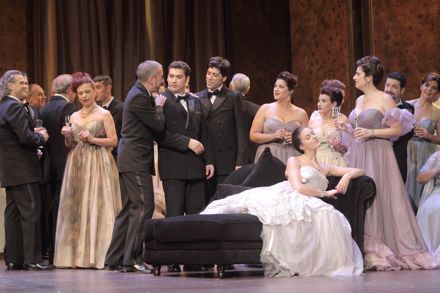 Gaston, Alfredo, Le Marquis, Violetta, Flora
Gaston, Alfredo, Le Marquis, Violetta, Flora
But the characters in her staging are very much those of Dumas, starting with the youth of Mlle. Marková (if not the brattish confidence of Dumas’ Marguerite) and the forty-some age of the has-been prostitute Flora. Her Act III party admitted the startling vulgarity of the demi-monde as described by Dumas. French mezzo Sophie Pondijiclis made this role vividly real, a revelation. French mezzo Christine Tocci played Annina, here transformed from Verdi’s dramatic utility into Dumas’ Nanine, a factotum confidante, possibly a lover of Marguerite, not a chamber maid. Costumed in male styled trousers and top, with a bright smile and strong voice Mlle. Tocci was constantly at Violetta’s side, a vivid, voiceless presence in Act I.
Act II begins with Alfredo’s outpouring of contentment, the emotion ironically compromised by the presence of Dr. Grenvil, who sits writing something, perhaps a prescription, while Alfredo sings the opening of "dei miei bollenti spiriti" to him. The doctor then departs, imparting a perfunctory gesture of professional sympathy to Alfredo. Romanian tenor Teodor Ilincâl made Dumas’ obsessive Armand quite real as Verdi’s Alfredo. Mr. Ilincâl is a strong voiced, Faustian tenor who well embodied Dumas and Verdi’s single minded and selfishly Romantic lover. Verdi simply does not award him the delicacy or complexity of feeling that he lavished on Violetta and Germont.
Mme. Auphan is wise to suggest that we not dwell on Dumas. But understanding the detail of her mise en scène together with the exemplary casting and the musical depth of the conducting explains why this staging brought unexpected vitality to this old warhorse. It was not a moving Traviata so much as it was an almost clinically musical and dramatic examination of this masterpiece. And finally it was mesmerizing art.
The new production provided an unobtrusive, standard mid-nineteenth century setting designed by Marseille born Christine Marest, a veteran of the late 20th century avant garde. The scenery, beautifully lighted by photographer Roberto Venturi, was a stage box that easily transformed its feeling from salon to an intimate, emotional interior space most notably in the “sempre libera.” In Dumas novel this scene takes place in Marguerite’s boudoir, in the Auphan production the lights of the salon are softened into dim, candle light, and just as in the Dumas novel Alfredo was present, making this scene an operatic pas de deux, Violetta voicing her conflicts while Alfredo crumpled a white camellia.
There were performances on six consecutive days, thus there were two casts. Jean-François Lapointe however unexpectedly sang all performances (and was still in fine form at the fifth performance). Intelligence from the pressroom indicates that the alternate cast was quite impressive — Romanian soprano Mihaela Marcu as Violetta and Turkish tenor Bülent Bezdüz as Alfredo.
Casts and production information:
Violetta: Zuzana Marková; Flora: Sophie Pondjiclis; Annina: Christine Tocci; Alfredo Germont: Teodor Ilincäi; Giorgio Germont: Jean-François Lapointe; Le Baron: Jean-Marie Delpas; Le Marquis: Christophe Gay; Le Docteur: Alain Herriau; Gaston de Letorières: Carl Ghazarossian; Giuseppe: Camille Tresmontant. Chorus and Orchestra of the Opéra de Marseille. Conductor: Eun Sun Kim; Stage Director: Renée Auphan; Scenic Designer: Christine Marest; Costume Designer: Katia Duflot; Lighting Designer: Roberto Venturi. Opéra de Marseille, June 21, 2014.
Rusalka in Monte-Carlo
Every-once-in-a-while a Rusalka comes along, and this week there are even two here on the French Riviera — just now in Monaco and upcoming Saturday on movie screens all along the coast.
While invisible pulses of energy emanating from New York’s Lincoln Center will become huge shapes, bright colors and amplified sounds the Opéra Monte-Carlo’s Rusalka was vividly alive on the stage of one of the world’s most beautiful theaters, the Casino’s 500-seat jewel box, the Salle Garnier).
The renowned Orchestre Philharmonique de Monte-Carlo was in the pit in full force with notably splendid harp playing to evoke the splashes of water that were in fact quite real splashes of quite real water.
Stage director Dieter Kaegi created a contemporary story to frame the adolescent fairytale that is Dvorak’s last opera (of ten). During the overture two shapely bodies (male and female) on a motorcycle came upon a hidden pond. They shed their cloths (though strangely not all-the-way), dove in and did not reappear. It was of course a magic pond, so water sprites emerged — three stick-like marionettes (with three human operators) whose voices were three black-gowned singers standing downstage.
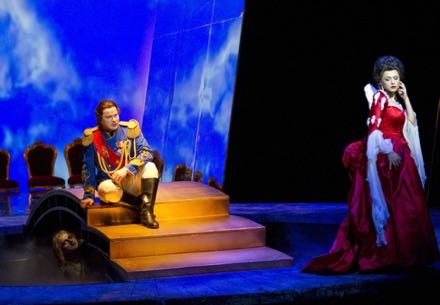 Maxim Aksenov as the Prince and Tatiana Pavlovskaïa as the Foreign Princess [Photo courtesy of Opéra Monte-Carlo]
Maxim Aksenov as the Prince and Tatiana Pavlovskaïa as the Foreign Princess [Photo courtesy of Opéra Monte-Carlo]
More splashes of real water for the half-drowned appearance of the water god Ondin, father of the water sprite Rusalka who was not a marionette. Dressed in filmy light blue she was meant to be water itself so she never had to get actually wet. The romantically deluded Prince appears with his rifle to sing an impassioned love duet with Rusalka as he whisks her away to his palace, not forgetting to pick up the rifle he had put down when he embraced her.
Rusalka had had to negotiate with the witch Jezibaba to become human, the price was losing the ability to speak i.e. sing. Meanwhile the two shapely motorcycle bodies reappear to dance a pas de deux under the theater lights carefully focused by a stagehand who sang the role of the forester. A visiting princess points out that the prince is ignoring his guests. It is not certain if the prince falls in love with this princess even though he loves Rusalka above all else. Anyway, Rusalka thinks he has fallen in love with another.
All this gives rise to absolutely beautiful music, the Czech equivalent of an over-wrought Giordano, an uncanny amalgamation of Tchaikovsky’s on-your-sleeve emotions with Wagner’s subliminal emotional and philosophic impulses. There is a plethora of musical climaxes that offer frequent hints that the opera is about to end but it never does. It takes big voices to sail over the top of all this music.
The Opéra de Monte-Carlo took very good care of these needs. American conductor Lawrence Foster imposed the necessary sweep and importance to big music on a trivial subject. It was cleanly shaped, an approach that ignored a slavic pathos that might ignite such fateful tragedy. Dutch soprano Barbara Haveman brought big voice to Rusalka that she uses with high-level artistry, her “Měsíčku na nebi” was sensitively detailed with a felt intimacy in this actual context rather than as the usual concert aria. While Mme. Haveman did not find the youth and innocence in her voice that made her Monte-Carlo Jenufa (2007) memorable, she accomplished with sincere aplomb the miming of being water, and in fact distinguished herself as a total performer.
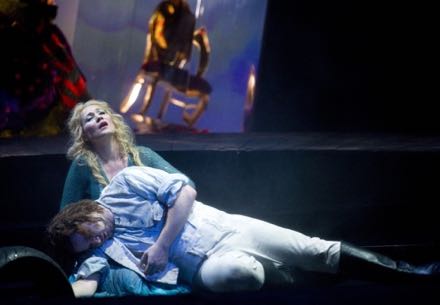 Barbara Haveman as Rusalka and Maxim Aksenov as the Prince [Photo courtesy of Opéra Monte-Carlo]
Barbara Haveman as Rusalka and Maxim Aksenov as the Prince [Photo courtesy of Opéra Monte-Carlo]
Russian tenor Maxim Aksenov brought good looks, good high notes and an theatrical savoir faire that reveals his foundation in music theater and his grounding in the slavic repertory. Russian soprano Tatiana Pavlovskaïa added temperament, impassioned voice and very good singing to the Foreign Princess. Slimy costumed Russian bass Alexeï Tikhomirov, most often seen splashing in water or dripping water proved himself a willing performer who made the most of his role in this context. Polish mezzo-soprano Ewa Podles lustily sang the witch Jezibaba, naively directed as if she were the witch in Hansel and Gretel.
Director Kaegi completed the frame he created to enclose Dvorak’s opera by allowing his motorcycle couple to emerge from the pond during the final duet and delightedly photograph one another holding remnants of the fairytale still taking place — the Prince lay in the pond along with the now upended motorcycle and other detritus, dying his watery death in the arms of Rusalka who did not care.
Casts and production information:
Le Prince: Maxim Aksenov; La Princesse étrangère: Tatiana Pavlovskaïa; Rusalka: Barbara Haveman; L’Ondin: Alexei Tikhomirov; Jezibaba: Ewa Podles; Le Garde Forestier; Valdis Jansons; Le Marmiton: Julie Robard-Gendre; Première Nymphe; Daphné Touchais; Deuxième Nymphe: Marie Kalinine; Troisième Nymphe: Mayram Sokolova. Chœur de l'Opéra de Monte-Carlo; Orchestre Philharmonique de Monte-Carlo. Conductor: Lawrence Foster; Mise en scène: Dieter Kaegi; Décors et costumes: Francis O’Connor; Lumières: Olaf Lundt. Salle Ganier, Monte-Carlo, January 29, 2014.
Lucia di Lammermoor in Marseille
A handsome new production, beautifully staged in Marseille’s fine old opera house cried out for a cast to make the opera bel canto.
Not that there was not some good singing, namely Czech soprano Zuzana Markova as Lucia. Originally the Lucia of the relief cast (taking two of the six performances) this beautiful young singer was advanced into the primary cast when illness forced the first Lucia to cancel. Of secure technique, solid musicianship and a voice in its youthful bloom Mlle. Markova did hold the stage the entire evening, lacking only a diva presence to achieve a convincing bel canto performance. This talented young artist is in dire need of coaching — not only how a real diva artist might act this demanding role but also how a real diva might act.
Certainly Mlle. Markova was not in a position to pull diva antics, like refusing to wear the costumes designed for Lucia by Opéra de Marseille house designer Katia Duflot. A bona fide diva would know that if the audience was baffled by the gravity defying design of her bare shoulder red gown, it was probably not paying attention to her performance. Never mind that the red gown did not finally reveal a topless Mlle. Markova, the bare shoulder white gown of the wedding scene all but revealed everything. Mlle. Markova’s lovely young breasts simply upstaged her beautiful young voice.
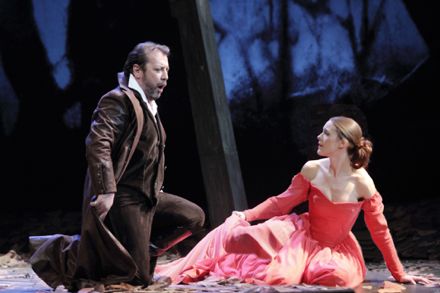 Giuseppe Gipali as Edgardo, Zuzana Markova as Lucia. Photo by Christian Dresse
Giuseppe Gipali as Edgardo, Zuzana Markova as Lucia. Photo by Christian Dresse
On the other hand Lucia's brother Enrico sung by French baritone Marc Barrard was visually choked by the high collar Mme. Duflot engineered for his first act costume. Our sympathy for his strangled sound was however unfounded as his later costume with unbuttoned shirt allowed plenty of breathing room. We discovered that his voice is unfocused and sounds very worn, or perhaps making a bel canto sound is simply foreign to his voice. If the program booklet biography is at all complete this role may have been his first venture into this repertory.
Giuseppe Gipali was the Edgardo. This Albanian tenor turned bel canto into can belto in vocal tones and shapes that were stylistically appropriate if monochromatic and unvaryingly forte. Mr. Gipali is not an affecting performer, his eyes never on the person (Lucia) he was singing to, instead his face was always outward, performing directly to the audience. His final scene — his suicide — was in fact splendidly sung, lacking any hint of sincerity of emotion that could bring this famous opera to its hyper-Romantic conclusion.
And finally Polish bass Wojtek Smilek was Raimondo, the Calvinist priest. Mr. Smilek is an important local resource, frequently appearing in Marseille, nearby cities and in Paris. He sings just about every smaller principal bass role you can think of. Unfortunately Raimondo is a big role, with lots of exposed singing. While Mr. Smilek is a fine singer he does not have the warmth of tone required for basso cantante roles nor the smoothness of line that can make him a lyric bass.
Lucia di Lammermoor is a numbers opera, one big aria or duet after another, embellished by chorus interjections that change circumstances to motivate even more beautiful singing — there is simply a huge amount of a very particular style of solo singing. This opera must be carefully cast. It was not.
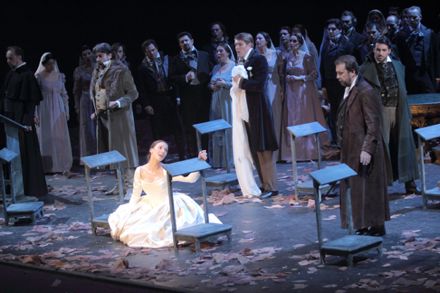 The Sextet. Photo by Christian Dresse
The Sextet. Photo by Christian Dresse
The pit was overseen by French conductor Alain Guingal who responsibly sustained the proceedings but supplied no stylistic flourish to make this evening musically vibrant. While the big harp obligato in the first act was magnificently played the flute duet with Lucia’s mad scene was rendered with contours and colors that went too far beyond those offered by Mlle. Markova.
The new production was staged by French theater director Fréderic Bélier-Garcia. He is the absolute master of staging operas that are strings of numbers, finding natural seeming motion for his singers while they perform lengthy arias about how they feel. Here he exploited a new trick by sometimes taking his singers to the extreme sides of the stage to stand against the wide soft black false proscenium, removing the singer from all scenic context. With absolutely glorious lighting by designer Roberto Venturi the singers were suddenly stripped of everything except voice and artistry —what greater effect could be created for the supreme moments of bel canto opera!
The physical production was designed by Jacques Gabel, a frequent collaborator of Mr. Bélier-Garcia. The design was minimal, two scrims on which various forest shapes were projected, a platform that was sometime a ramp and sometime a pier, like on a lake, and (of course) a chandelier. The sensuous stained glass Jesus figure on a panel flown in for the Enrico/Edgardo meeting is hard to explain, as are the brilliant northern light colors that embellished the scrims from time to time. But not as hard to explain as the costumes described above that just did not seem to belong in a drafty old Scottish castle.
Cast and production information:
Lucia: Zuzana Markova; Alisa: Lucie Roche; Enrico: Marc Barrard; Edgardo: Giuseppe Gipali; Raimondo: Wojtek Smilek; Arturo: Stanislas de Barbeyrac; Normanno: Marc Larcher. Orchestra and Chorus of the Opéra de Marseille. Conductor: Alain Guingal; Mise en scène: Frédéric Bélier-Garcia; Scenery: Jacques Gabel; Costumes: Katia Duflot; Lighting: Roberto Venturi. Opéra de Marseille, February 6, 2014
La favorite in Toulouse
French mistresses are much in the news these days, and now the Théâtre du Capitole’s new production of Donizetti’s La Favorite has added considerable fuel to the fire.
The news though is actually Chinese tenor Yijie Shi who assumed the beautiful young woman who had knelt next to him at the famous shrine Santiago de Campostela was pure. She was not.
Never mind that Donizetti’s la favorite was not French. Named Léonor di Guzman she was in historical fact the mistress of no less than Alfonso XI, the king of Castille who is famous for driving the Moors out of Andalusia in the mid fourteenth century. History is often reinvented in opera plots to make passions more real than facts, thus according to Donizetti’s librettists it was the lovesick novice monk Fernand, (tenor Shi) who actually led the Spanish armies to these important victories under Alfonso’s flag.
All Fernand wanted in return was the hand of the beautiful and pure woman he had prayed with. Alfonso however was a cunning thinker who did not want to give up his mistress, not to mention that his courtiers detested the upstart Fernand as well. Add to this mess a meddlesome priest of proto-inquisitor zeal and you can see that there was a lot to sing about.
Donizetti’s French masterpiece was in the hands of Italian conductor Antonello Allemandi. This maestro, a bel canto specialist, captured the fire and intensity of the passions from the get-go, making the overture a superbly eloquent transition to a musical world based on beautiful lines and colors that elaborate distress and make it compellingly elegant. Mo. Allemandi demonstrated a full authority over the stage for the musically complex scenes, and in the arias and duets he demonstrated his confidence in the artistry of distraught singers by establishing ample tempos to support their soaring vocal lines while he concentrated on pulling every possible nuance from the pit players.
The great climaxes of the quintets and sextets with chorus achieved emotional releases that equaled those of the later Romantic masters while remaining specifically bel canto.
Shanghai born tenor Yijie Shi, a protogé of the Pesaro Rossini Festival, made a startling first impression, standing in shirtsleeves among a disciplined formation of hooded monks. He did not cut a figure that would lead soldiers into battle though he did finally become the smitten, naive and always confused young lover who basks in the pleasure of his feelings. After an extended apprenticeship in Pesaro he is now a finished performer, more at home in the bel canto repertory than in Rossini. His voice is purely Italianate, and his French was splendid. By the end of the performance it was certain that Mr. Shi now owns this role, singing it and acting it with true bel canto abandon.
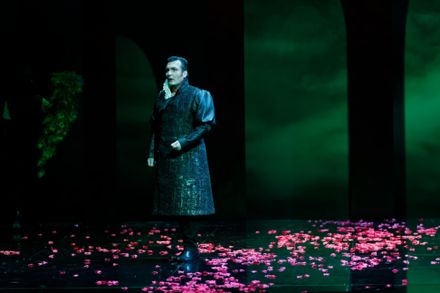 Kate Aldridge as Léonor, Yijie Shi as Fernand. Photo by Patrice Nin
Kate Aldridge as Léonor, Yijie Shi as Fernand. Photo by Patrice Nin
If the tenor has the most to sing in La Favorite, the heroine is burdened with the need to exemplify the magnetism that would pull a young monk from his vows of chastity while bemoaning her situation — as mistress to the king she cannot and never will be wife to any man. American mezzo-soprano Kate Aldridge, a seasoned bel canto artist, did not succeed, lacking at this point in her career the warmth of voice and charm of youth to bring Leonora emotionally alive. Her most effective if inappropriate vocal moments occurred when she used the chest voice that has made her a very fine Carmen.
The opera was conceived in French for the Paris Opera (not the Théâtre-Italien where Donizetti’s Italian operas were performed) as a vehicle for the mistress of the director of the opera. In the style of French grand opera the heroine is a dramatically complex role for mezzo soprano. Léonora is subdued and discretely nuanced in her only aria and in her scenes with Fernand and Alfonso. The opera is in the four act grand opera form, though the traditional ballet was missing in Toulouse.
Alfonso was sung by French baritone Lodovic Tézier. Of clear, sterling colored voice Mr. Térzier is an ideal Donizetti villain, well able to convincingly rage, manipulate and deceive without sacrificing beauty of tone and grace of execution. Italian bass Giovanni Furlanetto as the father superior Balthazar produced a rich and smooth basso cantante though he did not convey a force of personality that could make him a convincing spiritual father to Fernand or an imposing accuser to Alfonso. The role of Inès was charmingly performed by Marie-Bénédicte Souquet.
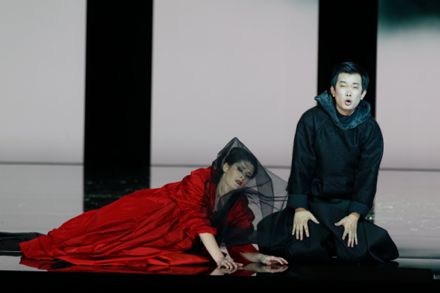 Lodovic Tézier as Alphonse XI. Photo by Patrice Nin
Lodovic Tézier as Alphonse XI. Photo by Patrice Nin
The new production, by Vincent Boussard and his designers Vincent Lemaire (scenery) and Christian Lacroix (costumes), was in minimal terms. The mists and spirituality of Santiago de Campostela were conveyed in mirrored stage walls, fogs and lights with a backdrop of abstracted soaring arches, the sumptuousness of Seville’s Alcazar was effected in emerald greens, graced by parading, lifelike peacocks on the arms of courtiers. The mirrored side walls descended opening balconies on either side from where courtiers would learn all court happenings.
Costumes were abstracted into colors rather than shapes taking us into a musical space rather than a specific historical moment. The single prop, excepting the peacocks, was an illuminated suitcase Fernand took with him into his worldly adventures and returned with to take finally his vows. Metteur en scéne Boussard is a master of staging musically rather than dramatically, moving his chorus as a structural musical force and his principals as moments of music, finding extended periods of poetry rendered in classical sculptural poses.
It was a splendid afternoon of beautifully staged bel canto transformed into great music. This production can be watched on CultureBox of France Télévision through August 15, 2014: La Favorite
Casts and production information:
Léonor de Guzman: Kate Aldrich; Fernand: Yijie Shi; Alphonse XI: Ludovic Tézier: Balthazar: Giovanni Furlanetto; Don Gaspar: Alain Gabriel; Inès: Marie-Bénédicte Souquet; Chorus and Orchestra of the Théâtre du Capitole. Conductor: Antonello Allemandi: Mise en scène: Vincent Boussard; Scenery: Vincent Lemaire; Costumes: Christian Lacroix; Lighting: Guido Levi. Théâtre du Capitole, Toulouse, February 16, 2014.
Carmen in Bilbao
Bilbao is always news, Calixto Bieito is always news, Carmen with a good cast is always news. So here is the news.
The Calixto Bieito Carmen is old news, this edition having already taken place in Barcelona, Venice and Torino, though a Bieito Carmen has been around on advanced European operatic stages since 1999. It was never headline news, finding instead this extraordinary stage director in a rather subdued state. Yes, there was fellatio, pissing, nudity, gang rape, child abuse and true brutality. Yes, Mercedes was Lilas Pastia’s middle-aged wife, and yes, Don Jose was really annoyed by an insistent Micaëla who sang her pretty song and then gave Carmen the “up-yours.”
Bieito creates a world that puts you on edge, here it was Spain with the cut-out bulls on the hilltops, gypsies in dilapidated cars, freaked out youth, blinding beaches and lurid tourism, and of course bull rings. But finally Bieito’s bull ring was only a chalk-line circle laid down by Lilas Pastia in which the raw power of Carmen’s indifference was pitted against the impotent supplications of Jose. Murdered, Jose dragged Carmen out of the circle — like a dead bull.
Movement is violent and often sudden in this and all Bieito worlds. There were very limited moments of dialogue but many additions of crowd noise and shouts, and punctuations of imposed silence broken by frenetic crowd clamor. The quintet was splendidly staged catching the lightening speed of the music in fast, demonstrative movement, and the trio was deadpan, the cards read on the hood of a car with no sense of doom, Carmen indifferent to her fate.
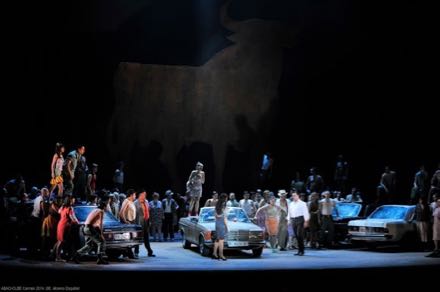 Act III. Escamillo in white shirt. Photo by E. Moreno Esquibel
Act III. Escamillo in white shirt. Photo by E. Moreno Esquibel
There was no set. A simple cyclorama against which there was first a flag pole and a phone booth, then a car and a Christmas tree, then eight cars and a gigantic cut out bull and finally nothing except a beach with a marked out chalk ring.
All this might seem a recipe for a dynamite Carmen, but this does not seem to be Bieito’s intention. This tale of Jose’s infatuation disappeared into this cosmos of marginal life in Spain and became unimportant, its emotions melted into the morass of a much bigger and equally violent, emotionally raw world.
With some setbacks along the way Bilbao's Amigos de la Ópera managed a cast responsive to the needs of both Bizet and Bieito. The Carmen announced in the publicity was Sonia Ganassi who withdrew because of illness, young Italian mezzo Giuseppina Piunti came to replace her. However she could not do this second performance (of five) thus this performance fell to the cover Carmen. Ana Ibarra is a young Spanish artist, not a Carmen by nature or physique but a very fine singer, and with obviously limited rehearsal attention she still gave a quite credible performance, greatly appreciated by the audience.
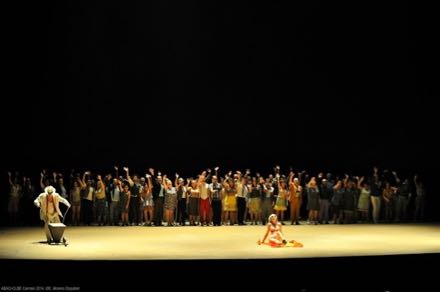 Lilas Pastia marking bull ring circle and sunbather. Photo by E. Moreno Esquibel
Lilas Pastia marking bull ring circle and sunbather. Photo by E. Moreno Esquibel
Venezuelan tenor Aquiles Machado is in his vocal prime, and gave a beautifully sung performance. His Flower Song was the hit of the evening, the high notes squarely placed and exciting. Mr. Machado projects an affecting presence, and could perhaps be a moving Jose in a heated or even warmer production. Quick on his feet he was able to have a real looking knife fight with Escamillo, leaping from roof to roof of a line of cars. He was equaled in agility by seasoned Spanish baritone Carlos Alvaro! This esteemed singer brought a sharp Italianate edge to the role, making Escamillo a powerful and dangerous presence with real bullfighter voiced coglioni if not with physique or stance.
Micaëla was sung by Valencia born soprano Maite Alberola who brought a brightness of voice that has made her a fine traviata though she did not move with a natural agility in the wonderfully tacky clothing that was her costume. With the resources of a traviata voice (a brilliant top and a warm middle voice) she found unusual and very welcome vocal excitement in her aria.
French maestro Jean Yves Ossonce provided a generally idiomatic reading, giving the principals solid understanding for their arias — a faster than usual “Je dis,” a louder than usual "La fleur que tu m'avais jetée," as examples. The quintet was masterfully held together and the big chorus scenes were unleashed with sonic abandon — the Euskadiko Orkestra Sinfonikoa gave it their all.
The support roles — Frasquita, Mercedes, Remendado, Dancairo, Zuniga and Morales — were of proper age, voice, and experience (i.e. gratefully not pieced together from a young artist program). The Mercedes of Basque mezzo Itxaro Mentxaka was especially interesting as the middle aged wife of Lilas Pastia, the Zuniga of Italian Federico Sacchi stood out as a real sleaze, his brutally murdered body an unforgettable image.
Bilbao is about architecture, as you know. There is an old (nineteenth century), imposing opera house said to be an imitation of Paris’ Garnier that is no longer used. The Asociación Bilbaina de Amigos de la Ópera now produces its operas in the theater of the Palacio Euskalduna, Bilbao’s conference center that opened in 1999. Designed by architects Federico Soriano and Dolores Palacios it is supposed to be like a vessel permanently under construction (it stands on a dock of the former Euskalduna Shipyard). It received the 2001 Enric Miralles award at the 6th Biennial of Spanish Architecture.
However striking the architecture may be, and the public areas are of interest if a bit hard to navigate, the hall itself reveals the lack of interest architects in general seem to have for opera. If these two architects had ever been to an opera they would know that an auditorium is a dark place to sit while you observe a performance, that no prime seating space should be sacrificed to some questionable geometric design whims, that every seat should be as close as possible to the stage (the upper reaches of this theater are unbelievably remote), and finally, actually first of all, that the sound in the hall is of utmost importance (the cavernous depths of this theater create a hollow “cavernous” sound).
Ignoring these completely obvious requirements for the auditorium one can only imagine the ignorance these architects will have exercised in designing the stage (here too wide), wings and dressing rooms. Is there no prize for bad theater architecture. There is a stupendous amount of it worldwide that could compete for being the absolute stupidest.
Casts and production information:
Carmen: Ana Ibarra; Don José: Aquiles Machado; Escamillo: Carlos Álvarez; Micaëla: Maite Alberola; Mercedes: Itxaro Mentxaka; Frasquita: Elena Sancho Pereg; Le Remendado: Vicenç Esteve; Le Dancaïre: Damián del Castillo; Zuniga: Federico Sacchi; Moralès: Giovanni Guagliardo; Lilas Pastia (actor): Abdelazir El Mountassir. Euskadiko Orkestra Sinfonikoa, Coro de Opera de Bilbao. Conductor: Jean Yves Ossonce; Mise en scène: Calixto Bieito; Scenery: Alfons Flores; Costumes: Mercé Paloma; Lighting: Alberto Rodriguez. Palacio Euskalduna, Bilbao, February 18, 2014.
L'elisir d'Amore in Monte-Carlo
Will wonders never cease? Wheat stalks 6 meters high? Rats 2 meters tall. Setting Donizetti’s little comedy amidst biological mutations engendered by Chernobyl does seem a bit farfetched.
Actually it was not Chernobyl, the tip-off being the 7 meters diameter tractor wheel, mud hanging off of the lower treads. Then a thrown-away tuna fish can crashed onto the stage and rolled center, from which emerged Belcore with the old trick of how many whatever-they-weres could possibly emerge from a tuna fish can. We indeed had delighted smiles on our faces.
This was the lilliputian Elisir d’amore! Tiny, magical creatures acted out this bit of sentimental commedia del’arte residue underneath a wheat field somewhere in Switzerland (the production comes from Lausanne). Given it was magical the Belcore creature was part Samurai (the wig) and part Swiftian general. Dulcamara arrived atop a contraption that was totally fantastic, maybe a sort of rolling still though he seemed some sort of crazed Swiftian magistrate in his red robe and weird wig.
It was a splendidly realized concept. The slender wheat stalks could actually be scaled, and were by five or so acrobats evoking wonder amongst us spectators. For some reason there was a boy and girl, eight year olds maybe, who rushed on stage from time to time to act out bits of puppy love. Besides the rats, birds as well as a life sized horse, i.e. about ten meters high (all we could see were the legs), meandered across the back of the stage usually during the arias and duets — the wonders of very skillful projections.
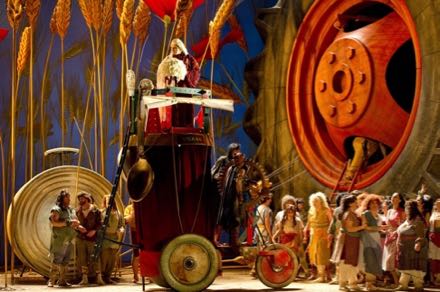 Dulcamara atop his wagon, tuna fish can, tire and wheat. Photo courtesy of the Opéra de Monte-Carlo
Dulcamara atop his wagon, tuna fish can, tire and wheat. Photo courtesy of the Opéra de Monte-Carlo
What, you may ask, has all this to do with Donizetti’s opera? The answer is nothing. It was an extravaganza of concept and hard-headed exploitation of contemporary digital techniques. Placed on the stage by a team of Italians, stage director Adriano Sinivia, set designer Christian Taraborrelli, and costume designer Enzio Iorio this was a stand alone theater piece that used a bel canto masterpiece as an excuse to imagine a far-fetched digital video game.
Donizetti’s opera is neither a fairytale for children with hidden meanings for adults nor a Swiftian satire of rural morality. It is a simple love story told very directly — love overcomes all obstacles if you sing well enough and long enough. Actually the cast assembled by the Opéra de Monte-Carlo did sing well enough but even so could not overcome the obstacle of this production. It was a long evening that left us indifferent to all this sophisticated human talent and effort.
While the Opéra de Monte-Carlo had the esteemed Orchestre Philharmonique de Monte-Carlo in the pit it had French contralto Nathalie Stulzmann on the podium who had not a clue about bel canto musicality — a musicality that allows time to stand still so you can elegantly feel how you feel. Define it how you may it will never be driving the music hard and fast with an authority that is above that of the singers. Musically the evening was a willful display of conductorial insensitivity.
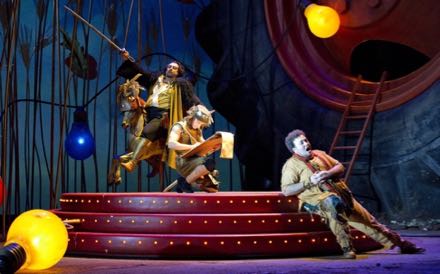 George Petean as Belcore, Stefan Pop as Nemorino. Photo courtesy of the Opéra de Monte-Carlo
George Petean as Belcore, Stefan Pop as Nemorino. Photo courtesy of the Opéra de Monte-Carlo
It is enlightening to know that Angela Gheorghiu is not the only singer to come out of Romania. The Opéra de Monte-Carlo found three more excellent artists. Twenty-eight year-old tenor Stefan Pop made a roly poly Nemorino who gave a skillful account of his aria — maybe the only moment of the evening not sabotaged by directorial gloss — and in general convincingly portrayed a country bumpkin with a sophisticated vocal technique. Baritone George Petean was a roly poly Belcore who gave it his all though it seemed too much, fault maybe of his silly wig or his feeling that his was a hopeless character in this lilliputian satire so he had to try to make something of it. Bass Adrian Sampetrean on the other hand rose above his ridiculous wig and assumed a genuine authority that you probably do not want from this shyster, fault maybe of the conductress who did not try to reign him in to become Donizetti’s charming con man.
Italian ingenue soprano Mariangela Sicilia was the spunky, too spunky Adina who sang quite well, though her knowing attitude and knowing vocal technique is not yet finished to the degree that she can settle with confidence into character and sail securely above it all with unflappable technique. It will come. The Giannini of Parisian soprano Vannina Santoni was a larger than usual character and an appreciated component of the larger ensembles.
It was unclear whether the generous applause was relief that it was over, appreciation of good singing, or evidence that the Monegasques (those who reside in Monaco) are willing to reward even bad conducting.
Casts and production information:
Adina: Mariangela Sicilia; Nemorino: Stefan Pop; Belcore: George Petean; Dulcamara: Adrian Sampetrean; Giannetta: Vannina Santoni. Chorus of the Opéra de Monte-Carlo and Orchestre Philharmonique de Monte-Carlo. Conductor: Nathalie Stutzmann; Mise en scène: Adriano Sinivia; Scenery: Christian Taraborrelli; Costumes: Enzo Iorio; Lighting: Fabrice Kebour. Salle Garnier, Monte-Carlo, February 26, 2014.
Eugene Onegin in Montpellier
Entering the hall there arose the Dantesque “abandon all hope ye who enter” feeling — a cluttered a vista socialist setting, a poster of Lenin and large letters proclaiming Moscow, December 1999.
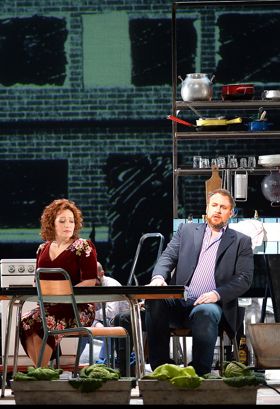
Lucas Meachem as Onegin, Dina Kuznetsova as Tatiana. Photo Marc Ginot / Opéra national de Montpellier
Maybe Pushkin never existed and Tchaikovsky is a condemned a bourgeois composer.
The first music we heard came from a cheap socialist era stereo, a blast of heavy metal to which a ripe young female appropriately gyrated. Fear and hope were equally mixed that this was the Tatiana. She was not, but was one of the seething swarm of inhabitants of a large communal apartment construed on the stage, leaving no doubt that therein existed a cosmos of human souls.
Emerging from this swarm were figures who gracefully appeared and disappeared, the characters we know by Pushkin’s names who moved in and out of the kitchen, the bedrooms, TV salon, bathroom, (spaces cleverly defined with minimal doorway lines and furniture) with beguiling naturalness and an ease that was purely musical.
There was one resident with a digital camera, a voyeur who surreptitiously captured young women in the a vista shower (we saw silhouette against the shower curtain). Innocent and charming, except we see him follow Olga as she pursues and then seduces Onegin while Tatiana is writing her letter. This spied upon scene took place on a slightly elevated platform behind the apartment floor, a place that served throughout the evening as somewhere else.
You get the picture. Filippievna did a lively dance to the famous Russian gypsy song “Dark Eyes” while listening to the radio before Tatiana’s birthday party where Lenski got jealous. The digital camera with its stored images got passed around. There was no way to stop a session of Russian roulette.
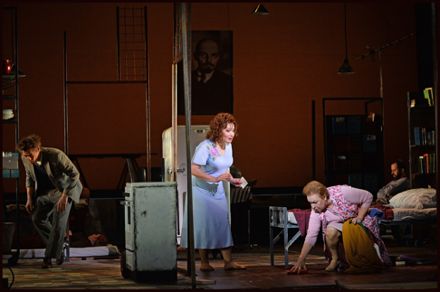
Dina Kuznetsova as Tatiana, Olga Tichina as Filippievna. Photo Marc Ginot / Opéra national de Montpellier
It is indeed a digital world that allows quick and easy recording and transmission of images and scenes of life around us, from all angles and in duplication and repetition. Here digital technology was used to add additional perspectives to what we could see from our seats. Intimate scenes were magnified onto the huge blank stage backdrop, the apartment as seen from above was projected onto the huge screen echoing what we could see from our seats, etc. These were direct dramatic motivations for use of multimedia and the achievement of rare theatrical integrity for the use of such technology.
As a theater piece, really a theatrical installation based on Eugene Onegin it was conceptually elegant, masterfully directed, wonderfully witty and charmingly successful. While it may have been at cultural odds with the richly romantic voice of Pushkin it was easily comfortable with the broad and absolutely obvious emotional climate of Tchaikovsky’s genius if not this composer’s nineteenth century tonalities.
The separation of the mise en scène from its sources was complicated by a separation of the pit and the stage. Tchaikovsky’s score was elegantly realized by Finnish conductor Ari Rasilainen and Montpellier’s fine Orchestre national. It was a symphonic reading, the conductor pulling every possible nuance and depth of tone from his instruments, and carefully pacing the flow to exploit his players’ musicality.
While the maestro did cue the entrances of the voices he did not visually or musically communicate with the stage in any other way. Left on their own the singers responded to secure, sturdy tempos but were bereft of the supercharged emotional thrust that makes Onegin (or any Tchaikovsky opera) a huge and immediate emotional experience. Perhaps this distant music actually served the production, reinforcing the blatant separation of source from its translation, Pushkin from Putin, poetry from TV drama, and finally separating high nineteenth century art from what was high twenty-first century art.
There were many grand moments created by a superb cast, and not least by the Onegin of American baritone Lucas Meachem as a souless man, a man who did not know who or what he is. Mr. Meachem was unable to sustain a singing tone nor could he find the tonalities of the Russian language. Mr. Meachem however brought a physicality to Onegin that was quite involving and finally moving. Sad to say he was not given the final bow, he is after all the name of the opera.
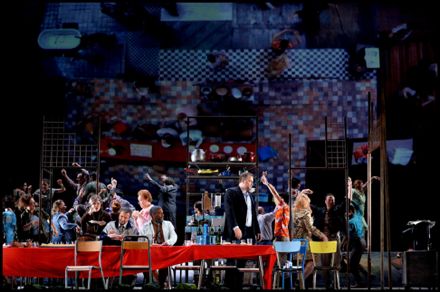
Act II Country Ball. Photo Marc Ginot / Opéra national de Montpellier
Tatiana was Russian born soprano Dina Kuznetsova, alumna of the young artist program at Lyric Opera of Chicago, who wrote her letter moving between the kitchen table and the window of her room (metal lines directly frontal onto the audience, i.e. in your face), the brilliant light of the opened refrigerator flooding the darkened kitchen at an appropriate textural moment. Mlle. Kuznetsova possesses a round, Slavic toned voice she used with dramatic knowledge and style, unable however to squarely hit the high note at the ends of her letter and her final duet with Onegin.
Olga was enacted by French mezzo soprano Anna Destraël in a performance that was so real it was unnerving. Olga, a slut, was visibly bored by Lenski though she was happy to go to bed with him (we saw this in the ferment of life in the communal apartment), her seduction, quasi rape of Onegin showed real animal determination, her slight response to Lenski’s jealosy was of a shallow adolescent. It was a powerful performance that went well beyond good singing. It did not endear her to the audience.
Bespectacled Lenski was sung by Turkmenistan tenor Dovlet Nurgeldiyev, his spectacles crushed on the floor by Onegin he sang his “Kuda, kuda vï udalilis” emotionally groping his way across the stage as a pathetic rather than a sympathetic, sometimes tragic figure. Beautifully sung it earned the evening’s biggest ovation.
Simply superb were the two aging Russian women, proto petite bourgeoise, Larina sung by Svetlana Lifar and Filippievna sung by Olga Tichina. Russian bass Mischa Schelomianski oiled his way across the stage as an oligarch, the Prince Gremin. His surveillance cameras caught the Onegin Tatiana duet in eight identical images he sees from his armchair — ironically Tatiana’s new life as transparent as her past life.
All the scenes of acts I and II were run together. After the intermission four homeless looking dancers shoved a homeless looking Onegin around the stage to the music of the first polonaise. The second polonaise at a nouveau riche cocktail party brought the Opéra’s fine chorus into in a moving circle, their clicking heels forcing the Tchaikovsky polonaise to a halt. It was a moment of powerful dramatic punctuation that underlined the wonderfully theatrical nature of this fine evening at the opera (of which this account is but the tip of the iceberg).
Authors of this theatrical installation were Marie-Eve Signeyrole who imagined and created the mise en scène and her collaborators Yashi Tabassomi (costumes), Philippe Berthomé (lights), Julie Compans (movement) and Julien Meyer (audiovisual).
Cast and production information
Onegin: Lucas Meachem; Tatiana: Dina Kuznetsova; Olga: Anna Destraël; Lenski: Doviet Nurgeldiyev; Prince Gremin: Mischa Schelomianski; Madame Larina: Svetlana Lifar; Filippievna: Olga Tichina; Monsieur Triquet: Loïc Félix; Zaretski: Laurent Sérou. Chorus and Orchestra of the Opéra Orchestre national Montpellier Languedoc-Roussillon. Conductor: Ari Rasilainen; Mise en scène and stage setting: Marie-Éve Signeyrole; Costumes: Yashi Tabossomi; Lighting: Philippe Berthomé. Opéra Berlioz, Montpellier. January 17, 2014.
Coeur de Chien in Lyon
If satire is your thing you will not want to miss this opera about human testicles grafted onto a dog.
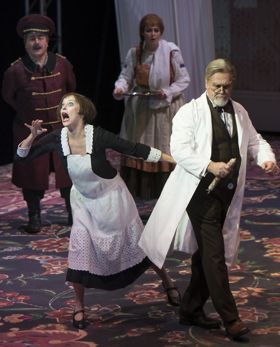
All photos copyright Stofleth
Coeur de Chien was a commission of the Holland Festival, premiered in 2010, and since has found clamorous arrivals in 2011 at the English National Opera as A Dog’s Heart, and in 2012 at La Scala as Il cuore di cane. Its real title is Собачье сердце because it is sung in Russian (though the libretto by Cesare Mazzonis was written first in Italian). It is based on a 1924 novel by Mikhail Boulgakov that was finally published in Russia in 1987.
The composer, Alexander Raskatov, now 60 years-old, was a Soviet citizen and a member of the Union of Soviet Composers. He is now a member of the Composers’ Union of Russia though these days he lives in France. His only other opera, The Pit and the Pendulum was composed in 1990.
This satire is about life in Moscow in the years just after the 1917 revolutions. It has absolutely no point of view and makes no judgements. Those were heady years when the intelligentsia, apparatchiks, commoners (maybe proletariat) and dogs were adjusting into the greatest social experiment of modern times, maybe ever. It was a mess all around, though according to this opera none of the various players ever lost their basic humanity (vanity, cupidity, duplicity) or their considerable personal charm. It was a beguiling evening.
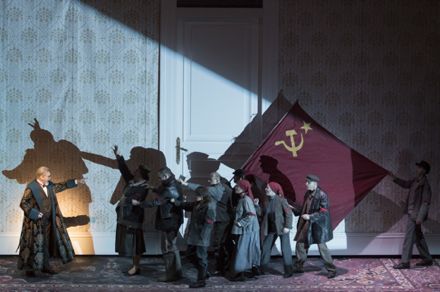
Coeur de Chien is an important opera that deserves to enter the repertory and certainly will depending on who has the guts to tackle its difficulties. The Holland Festival gave it an auspicious debut engaging director Simon McBurney of London’s Complicite, a theatrical venture founded in 1983 that is famous for its tackling of serious subjects using high-powered technology, and by engaging British designer, veteran-of-all-important-theaters Michael Levine to design the set (Levine is known most recently to San Francisco and Met audiences for his spectacular twenty-five year-old Mefistofele).
On the face of it, it is not exactly a serious subject given that all players are reduced to their most vulgar levels and stay there. That leaves us not much to think about. There was little high technology in its realization given the set was but a raked platform and a back wall and a few projections. The famished dog was a marionette with four manual operators — no high tech there.
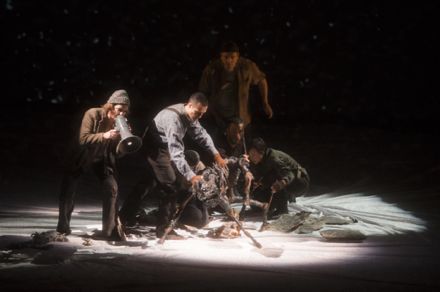
Raskatov made vulgar music (snorts and farts) and he made music vulgar incorporating liturgical hymns and famous old folk songs into the musical flow of his sensational text (the last line of the first act, shouted by the dog transformed into the “new man” is “go fuck yourselves!” in the libretto, and “lick my dick” in the supertitles). The composer recognizes that contemporary ears are accustomed to an infinity of musical and random sounds thus he has no compunction in raiding Monteverdi’s recitative, using extreme voices (shrieking higher-than-you-can-imagine sopranos) or making hoarse, coarse sounds through megaphones (the opera ends with sixteen players shouting vowels through megaphones into the faces of the audience. Underlying all this is Raskatov’s basic musical language heard from time to time which seemed to be more or less Webernesquely minimal.
This unleashed musical vocabulary was transferred onto the stage in an equally blatant vocabulary. There were two sets, outdoors and indoors that were the one set (floor and wall), black for outdoors where some scrims and projections created a raging blizzard without needing even a single plastic snowflake. When lighted the set was patterned to be a rug and wallpaper surrounding a big doorway. The floor ran with gallons of blood when it became the operating room for the castration and implant. When things really fell apart in the second act the wall itself (made of paper we learned) was smashed for entries and exits, then the wall rotated backwards letting players move under it, and one arm of the enormous chandelier that flew in to make the space a salon broke and dangled. Period.
The players movements were sometimes more or less natural, in fact the man/dog Charikov was even quite realistic when you imagine how such a creature might move and what gestures he might make. Other times movement was abstracted, and in extreme moments it was caricatured like figures in a comic strip equating in body rhythm the constant disjointed flow of the vocal line.
The original production in Amsterdam was conducted by Martyn Brabbins as it was in Lyon. The principals of the original cast remained intact except the role of Charikov here played by Peter Hoare who came to the production at La Scala. These were all extraordinary performances, and how else could they have been for such extraordinary roles. The smaller roles in Lyon were impeccably inhabited by appropriate artists as well.
It was quite noticeable that the audience was not the usual Lyon bourgeoise but instead mostly an under thirty contingent (meaning invited), and there were a few empty seats in the back of the auditorium, the assumption being that there was no huge demand for seats. There was however a huge ovation for the production, the kind young audiences like to give when finally they too get to do something.
After the Milan performances there were rumors that the production would tour to the United States. But sad to say there can be no opera company in the U.S. that would risk the vocabulary or manage the budget. It should have been the purview of an idealized version of the latter day New York City Opera. Sadly such an opera company does not now exist in the U.S.
N.B. There are extracts from Coeur de Chien aka A Dog’s Heart aka Il cuore di cane on YouTube.
Cast and Production
Filipp Filippovitch Preobrajenski: Sergei Leiferkus; Ivan Arnoldovitch Bormenthal: Ville Rusanen; Charikov: Peter Hoare; Daria Petrovna: Elena Vassilieva; Voice of Dog: Andrew Watts; Zina: Nancy Allen Lundy; Un Provocateur: Robert Wörle; Une patiente: Annett Andriesen; Fiancée de Charikov: Sophie Desmars; Schwonder: Vasily Efimov; Un détective: Piotr Micinski; Un Chef haut placé: Gennady Bezzubenkov. Orchestre de l'Opéra de Lyon; Ensemble vocal “Il Canto di Orfeo.“ Conductor: Martyn Brabbins; Mise en scène: Simon McBurney; Scenery: Michael Levine; Costumes: Christina Cunningham; Lumières: Paul Anderson; Vidéo: Finn Ross; Marionnettes: Blind Summit Theatre. L’Opéra Nouvel, Lyon, January 30, 2014.
The Tender Land in Lyon
It is not often that a Aaron Copland's The Tender Land comes along with resources like those of the Opéra de Lyon, one of Europe's finest. So carpe diem!
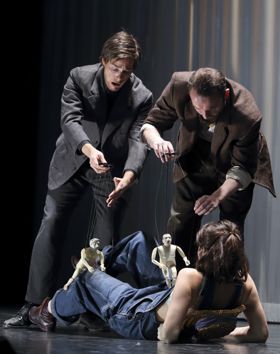
All photos copyright Michel Cavalca
The Tender Land was not a success at its New York premiere back in 1956, and it is not a success these fifty-eight years later in Lyon. But not for lack of trying, then or now.
For this production the Opéra de Lyon joined forces with the Théâtre de la Croix Rousse (the Croix Rousse is a neighborhood above the city center, home to the centuries-old Lyon silk industry where there was once an ochre cross) where it was performed. The artistic director of the Croix-Rousse theater, Jean Lacornerie staged this production.
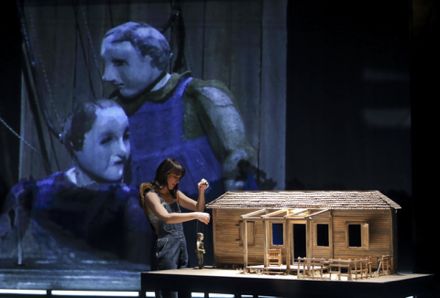
Laure Barras as Laurie Moss.
The Tender Land was composed as an opera for television at a time when mass communication believed it had an obligation make high, or higher art, like opera, theater and symphony, accessible to the masses (at that time the masses meant anyone who did not live in New York City). So NBC Television created an opera company for opera on television!
Mid-twentieth-century America like much of the European world was struggling to integrate a broader public work-force into a cohesive social fabric. This meant that American composers with aspiration to political correctness — and it was dangerous if you did not — aspired to create music that would speak directly to these masses. [Ironically at the same time the U.S. was providing the funding for the hermetic music coming out of Darmstadt.]
Much fine and beautiful music came out of New York by composers like Aaron Copland who submitted The Tender Land, his one and only opera to NBC Television Opera.
Sensibly enough it was rejected by the television producers probably because it does not have a strong enough story to support one hour forty minutes of story telling, its characters are monochromatic and its message of hope is compromised by their innate simplicity, read mediocrity. Simply its Depression era setting was not in keeping with the frenetic enthusiasms of the mid-fifties (recall the 1955 design shift in cars) and its musical numbers were not based on exotic cultures, like for example the New York gangs of West Side Story or the Italian immigrants of The Saint of Bleecker Street.
These fifty-eight years later it is a regretful look at American fundamentalism.
But within The Tender Land there are jewels of pure music, and these sang out splendidly on the Croix Rousse, the superb quintet that closes the first act bringing the separate impulses of the five principals into an integrated musical context, and the gorgeous, extended love duet of Laurie and Martin that interwove its musical elements into a colorful fantasy of love. These moments are purely musical, not dramatic, and were indeed pleasurable.
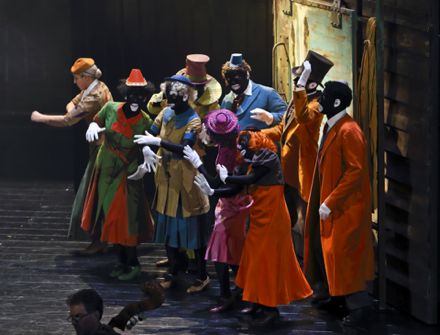
The chorus in blackface [!].
The choreographed numbers were appropriately lively with the youth and agility of Copland’s hopes for the future — Laurie, Martin and Top — able to manifest their impotent energies. In fact this recall of the energy of Copland’s 1944 Appalachian Spring provided the validation for the reduction (by Murray Sidlin) of the fully symphonic score of The Tender Land to a mere flute, clarinet and bassoon plus double strings and piano, Copland’s original orchestration for Appalachian Spring.
The intrinsic weakness of the opera precludes enlisting its original, full orchestral forces for a production. Sadly audiences will likely never hear the complete the sonic world envisioned by Copland when the opera is staged. Thirteen excellent players from the orchestra of the Opéra de Lyon gave it their all, with the Opéra de Lyon’s assistant music director Philippe Forget (that’s for-jay) as their able leader. It was fine playing, and at times even these few instruments created the true American colors that Copland’s harmonics uniquely evoke. We ached for more of those colors.
Mostly however the minimal orchestral forces disappeared into the very fine, complex and sizable production created by Mr. Lacornerie, his scenographer Bruno de Lavenére and his costumer Robin Chemin. Mr. Laconerie wisely played on the television genesis of Copland’s opera, reducing the visual field to a doll-house-sized farmhouse with puppet characters identically dressed as their operators, the actual characters. At times this puppet action or the faces of the operators was projected onto a half stage scrim creating the close up images that are the primary tools of television. At other times these props disappeared and actual farm buildings appeared for real stage production. And finally the whole stage was closed for Ma Moss to give her closing monologue as a concert piece in front of the curtain.
The Opéra de Lyon provided a solid cast. Veteran bass-baritone Stephen West was a stern, stolid and soul damaged Grandpa Moss, veteran mezzo-soprano Lucy Schaufer was a fine voiced, not rough enough Ma Moss who did not provide enough character or voice to conclude the opera (Mme. Schaufer is a fine artist, here victim of perhaps the direction, and certainly of the reduced orchestral forces). Three members of the Opéra de Lyon studio created excellent characters, Rémy Mathieu as Martin had real music theater sparkle, Toby Girling as Top exhibited extraordinary strength and agility as a singer and dancer, and Laure Barras brought much depth to the role of Laurie Moss. The neighbors were cast with excellent singers from the Opéra de Lyon chorus.
Casts and production information
Ma Moss: Lucy Schaufer; Beth Moss: Odile Bertotto; Gramdpa Moss: Stephen Owen; Laurie Moss: Laure Barras; Martin: Rémy Mathieu; Top: Toby Girling; Mr. Splinters: Brian Bruce; Mrs. Splinters: Alexandra Guérinot; Mr. Jenks: Paolo Stupenengo; Mrs. Jenks: Sharona Applebaum. Members of the Orchestre de l'Opéra de Lyon. Solistes du Studio et Chœurs de l'Opéra de Lyon. Conductor: Philippe Forget; Mise en scène: Jean Lacornerie; Scenery: Bruno de Lavenère; Costumes: Robin Chemin; Lumières: Bruno Marsol; Chorégraphie: Thomas Stache; Vidéo: Séb Coupy; Marionnettes: Emilie Valantin. Théâtre de la Croix-Rousse, Lyon, February 1, 2014
Cosi fan tutte in Montpellier
This Cosi fan tutte completes the Montpellier Mozart/da Ponte trilogy staged by French metteur en scène and esthète Jean-Paul Scarpitta. Primarily studies in elegance and refinement these mises en scènes have provoked all that that is most precious and perfect in Mozart’s scores.
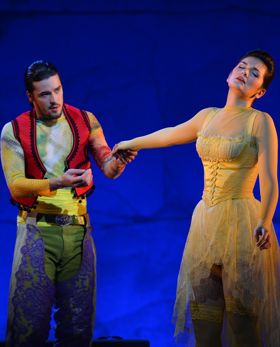
André Achuen as Guglielmo, Marianne Crebassa as Dorabella. Photo by Marc Ginot Opéra de Montpellier
Back in 2007 the scandals created by Scarpitta’s libidinous Don Giovanni were those of a troubled young man who burst into hysterical laughter in the Act I finale. This set the stage for a gifted young cast to bare its soul in flights of lyricism that became the core and substance of all action. Scarpitta’s staging took us inside Mozart's music, his set and costume design offered minimal decor that supported but never defined this interior space. Versailles’ Le Concert Spirituel then in residence in Montpellier resonated with primitive sounds that transported us into this rarefied space.
Les Noces de Figaro did not appear until 2012, now with players of the Orchestra National de Montpellier. Austrian conductor Sascha Goetzel delicately and obsessively shaped its many instrumental voices into flights of melodic splendor. The cast was absolute perfection, finished young singers whose lithe bodies slid into luxuriously refined costumes created by Jean Paul Gaultier. When voices and orchestra finally united in Act IV an ultimate level of pure lyricism was achieved — the simple humanity of opera’s most succinctly human opera long forgotten.
And just now Cosi fan tutte finishes the cycle, again with splendid players from the Orchestra National de Montpellier here conducted by Alexander Shelly. This young English conductor made immediate musical impact in the overture by imposing musical depth rather than dramatic thrust. Each moment of Mozart’s music was explored, there was no beginning nor end. The program booklet optimistically anticipated a duration of three hours ten minutes for the performance. It came in at just under four hours.
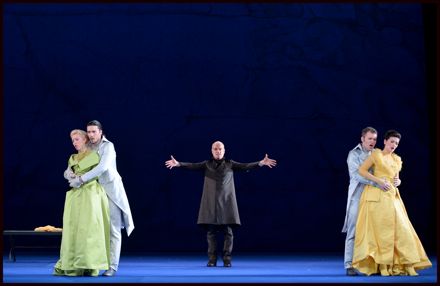
Photo by Marc Ginot / Opéra national de Montpellier
Like Don Giovanni and Le nozze di Figaro Jean Paul Scarpitta created the setting. Here it was a green floor and a blue wall. Just that. There were six chairs and a couple of little tables that found their way onto the stage from time to time. Nothing more, except quite sophisticated and beautiful lighting by Urs Schönebaum.
Though costume design was credited to Mr. Scarpitta, like Les Noces it was understood and obvious that the elegance could only be the work of a grand couturier — well known names flew around the theater. The costumes were splendidly minimal, a plain green gown for Dorabella, a yellow one for Fiordiligi, the gowns easily shed from time to time to reveal shapely legs surmounted by a high style bustle undergarment of the same color. Ferrando and Guglielmo were first seen in white long underwear, then shapely morning coats that were changed to vaguely Harlequinesque vests when they became Turks.
Everyone knows that Cosi has no real story, that it is an abstraction of youthful love as lived by young singers with beautiful voices and good bodies. Scarpitta moved his bodies in blocks of color, the chorus in black silhouette, and movement was mostly in abstract relationship to the music, much like balletic choreography. No emotive pulse of Mozart’s score was left without a correspondence of position or movement, and this transported us to the depths of decorative 18th century music. And very great musical pleasure.
Scarpitta most often envisioned the famous arias as ensemble statements, not just of singer and wind instrument, but of the singer amongst all the other singers on the stage, the meanings becoming more overtly public. The famous trio “Soave sia il vento” was a musical expanse of frozen emotion, its breezy triple meter only enough to reposition a feeling. Duets were synchronized exposition of studied movement, never broken nor forced. Time stood still.
Italian soprano Erika Grimaldi gave clear, rich, Italianate voice to Fiordiligi, well able to maintain her fine technique from prostrate positions, French mezzo Marianne Crebassa boasts elegant technique and has an innate sense for elegant movement. Scarpitta (as the general director of the Montpellier opera at the time the opera was cast) placed the more important vocal and musical responsibilities for his production on these two roles — as has Mozart.
American tenor Wesley Rogers as Ferrando however was quite alone on stage to sing his “Un’aura amorosa del nostro tesoro,” his insecure technique illuminating the vulnerability of his character. Tyrollean baritone André Schuen moved and sang with innocent grace as Guglielmo. Italian bass Antonio Abete brought grizzled elegance and aged vocal cynicism to the figure of Don Alfonso and French soubrette Virginie Pochon was a used-up, seen-it-all Despina who reenforced Don Alfonso’s disaffection for youth.
Director Scarpitta quickly downplayed the minimal dramatic outline of da Ponte’s plot by demonstrating very early on that basic sexual instincts superseded any emotional loyalty (there was lots of pawing). This directorial insight however undermined the a development of character that could support the intense lyricism of the second half of the opera. It was here that the evening became long, very long, and the maestro’s musical probings fell upon deaf ears.
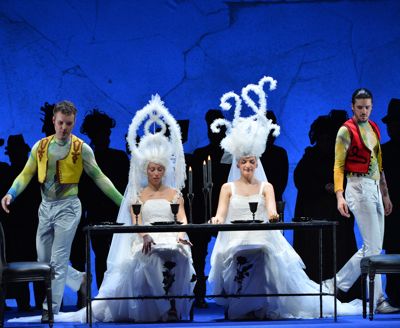
Photo by Marc Ginot / Opéra national de Montpellier
Scarpitta ended his Cosi fan tutte with the utter physical disruption of its nuptial banquet and emotional disarray of its protagonists, much as Scarpitta had ended his Don Giovanni by having waiters, da Ponte’s demons, destroy the Don’s final banquet, leaving its survivors bewildered. Both banquets were the symbolic feasts of young love feasting on itself. Both ended in the deceptions of mature human values, and emotional bewilderment.
This Mozart da Ponte cycle was a stellar achievement, and majestically crowns Jean Paul Scarpitta’s fifteen years at the Opéra de Montpellier.
Links to my reviews of the Montpellier Giovanni and Nozze:
Les Noces de Figaro in Montpellier
Casts and production information:
Fiordiligi: Erika Grimaldi; Dorabella: Marianne Crebassa; Guglielmo: André Achuen; Ferrando: Wesley Rogers; Despina: Virginie Pochon; Don Alfonso: Antonio Abete. Chorus of the Opéra national Montpellier. Orchestre national Montpellier Languedoc-Roussillon. Conductor: Alexander Shelley; Mise en scéne, sets and costumes: Jean-Paul Scarpitta; Lighting: Urs Schönebaum. Opéra Comédie, Montpellier. January 9, 2014.
Otello in Genoa
Forget Shakespeare, this was distinctly an Otello without the ‘h’. It was Italian melodramma to its core, the collaboration of its metteur en scène Davide Livermore, wunderkind conductor Andrea Battistoni and its Desdemona, Maria Agresta.
There was some foreign intervention, the Otello of American (Wisconsin) tenor Gregory Kunde and the Iago of Spanish baritone Carlos Àlvarez. The American is one of Europe’s leading bel canto tenors who sang Rossini’s Otello long before taking on Verdi’s Moor, in fact his role debut as the Verdi Otello was in the premiere of this production that happened in Valencia, Spain in June 2013 with these same three principals (Zubin Mehta conducting).
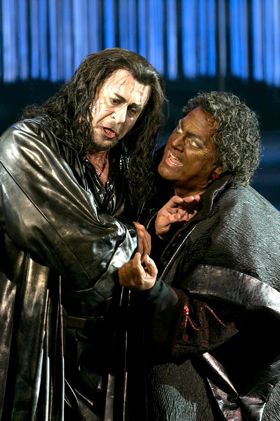
Carlos Àlvarez as Iago, Gregory Kunde as Otello, photo by Marcello Orselli
Kunde is a bel canto singer who finds unexpected lyricism in this gigantic showpiece usually undertaken by the spinto voices. Kunde’s voice resonated with more depth and beauty than his Rossini roles elicit, with a substantial force of voice somewhat rounder rather than the cutting tone that serves him well in Rossini. The result of this lighter voice in Genoa was a vulnerable Otello, a man neurotically tormented by jealousy, not simply possessed by it. This lyricism grounded the Livermore production as an exposition of neurosis, Desdemona and Iago components of Otello's neurosis.
Àlvarez possesses a darkly colored voice, a black tonality often found in basses who must create the dread associated with opera’s villains — though a baritone Iago is maybe the ugliest of all operatic villains. Àlvarez’ lack of tonal warmth plus his reserve of power, that of a true Verdi baritone, his slim stature and his head endowed with snaky black locks of hair made an evil character who oscillated between feigned passivity and triumphant domination. True to the end he did not dash toward a cowardly escape but ceremoniously descended off the upper edge of the stage, no longer a player in Otello's hell.
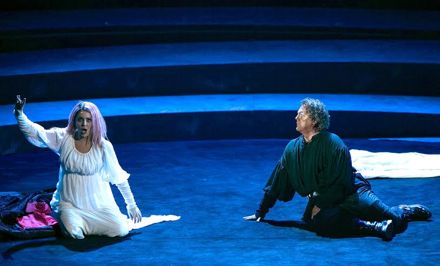 Maria Agresta as Desdemona, Gregory Kunde as Otello, photo by Marcello Orselli
Maria Agresta as Desdemona, Gregory Kunde as Otello, photo by Marcello Orselli
Soprano Maria Agresta as Desdemona revealed levels of vulnerability to human instinct that Shakespeare ignores (the Bard hides deeper character revelations in the phrase picked up by Verdi and Boito — “born under an evil star”). This splendid young soprano is of powerful and complex voice, fearlessly mounting to pianissimo high notes that permitted hints of risk which added edge to character. Of complex persona as well she circled Otello in the Act I duet almost dancing as an animal in rut. And there was more circling — flirtatious at the least — in her Act II meeting with Cassio. La Agresto sang her final prayer lying face down on the floor, a fallen angel, reflected as the whore Otello had made her.
This spectacular casting was topped off by the Cassio of Angelo Fiori, a very tall, very present, young Italian who moved a bit like a dancer. Like Desdemona he was wigged in long blond hair unabashedly establishing a physical connection to her that ignited Otello’s neurosis and palpably inflamed the innate terror of the corni (horns) of all males (Italians) present in the theater.
Like melodramma and like verismo, these characters were possessed by big emotions, clearly stated at the beginning and simply awaiting brutal dénouement. This was Act III, the Venetian scene, when 26 year-old conductor Andrea Battistoni let loose with volumes that equaled, maybe exceeded the opening storm, volumes that were spine chilling in intensity, and dramatically ironic in that they established the enormity of the murderous emotion yet to come. This young conductor obviously relished the brutality of the Livermore conception, visibly participating with the stage by demonstratively pushing the chorus to and beyond its limits. All chorus scenes were huge, the Act II garden chorus seated, aggressively taunting more than praising the purity of Desdemona.
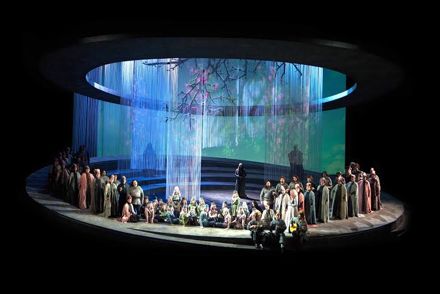 Act II Garden Chorus, photo by Marcello Orselli
Act II Garden Chorus, photo by Marcello Orselli
These days metteur en scène Davide Livermore is the most visible stage director on Italy’s more adventurous stages. Like all of his recent projects here he was not only stage director but also the set designer with the collaboration of Giò Forma, a Milanese design company that does big events like the America’s Cup 2012 and the MTV Awards. Here the concept was a vortex like structure (descending concentric circles) with a central, focal disk, like the pupil of an eye. The pupil moved, rising above the structure to transport Otello and Desdemona to the heavens of desire in their love duet. It elevated its front edge from which Iago delivered his “Credo in un dio crudele” at which point the edges of the concentric circles illuminated in red lines (Mr. Livermore is credited for the lighting).
Costume design is credited to Mr. Livermore, wigs a signature element of character (the long blond wigs of Desdemona and Cassio, the long black tresses of Iago that may or may not have been a wig, the identical ship-like, punk shapes of the wigs for the women’s chorus). The swaths of cape colors illuminated character — Iago in luminous metallic silver, Otello ultimately in priestly vestment, a red-lined white cape, that he carefully took off to administer death to Desdemona. Stage movement was abstract, actors moving on the vortex lines of an unstoppable downward vacuum, finding the most powerful, emotional place on the structure to deliver their signature statements. Otello at the end again elevated on the pupil of the eye, this time alone reliving the “bacio” to Verdi’s trombones whispering the opera’s opening storm.
Rarely do operatic forces converge with the artistic power created on the Carlo Felice stage by this production.
Casts and production information:
Otello: Gregory Kunde; Jago: Carlos Àlvarez; Cassio: Angelo Fiore; Roderigo: Naoyuki Okada; Lodovico: Seung Pil Choi; Montano: Claudio Ottino; Un Araldo: Gian Piero Barattero; Desdemona: Maria Agresta; Emilia: Valeria Sepe. Orchestra and Chorus of Teatro Carlo Felice. Conductor: Andrea Battistoni; Metteur en scène: Davide Livermore; Scenery: Davide Livermore and Giò Forma; Costumes: Davide Livermore and Marianna Fracasso; Lighting: Davide Livermore. Teatro Carlo Felice, Genoa, Italy. January 3, 2014.
Les Contes d'Hoffmann in Lyon
Maybe there can be no bigger feat than making it through Les Contes d’Hoffmann in the Laurent Pelly version without a hitch or two. There were in fact two just now in the Opéra de Lyon remounting of its 2005 production of Hoffmann, both collective hitches.
Not only has Mr. Pelly created a figurative nightmare, he has created a technical nightmare as well. The usual four sets — the tavern, the workshop, the bedroom, the salon — morph into thirty or forty or so scenes, a seemingly countless progression of scenic moments that evolve through the unfolding of Hoffmann’s narration in dream form. And the dream is a bad one in which the macabre surreal is suspended in abstract, dark space.
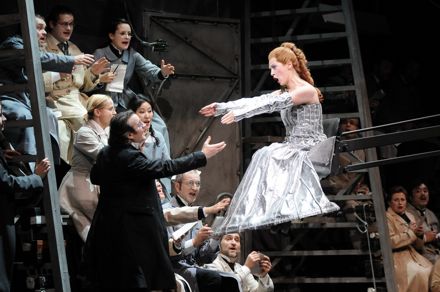 Olimpia, Hoffmann, Chorus, photo © Jean-Pierre Maurin
Olimpia, Hoffmann, Chorus, photo © Jean-Pierre Maurin
The Pelly concept is complex indeed. Not for a moment does Pelly allow us to forget that human motivations push the bizarre psychological and philosophical impulses of E.T.A. Hoffmann’s morbid tales. He accomplishes this by making us watch smart, strong stagehands push and pull walls and platforms and operate machines that transport Pelly’s phantoms through the dream world he has created for Offenbach’s opera.
Offenbach never lets up on his teasing of the world of art — E.T.A. Hoffmann was a poet, Offenbach’s Hoffmann is a poet and singer, Stella is a singer, etc. Pelly and his brilliant scenographer Chantal Thomas have created a production that is continuous creation, and like the roles of Hoffmann and Stella in all her transfigurations — roles that demand great virtuosity and superhuman strength — their production teases the art of stagecraft by teetering it on the edge of what mechanical stagecraft can possibly achieve.
The efforts of mind and muscle expended to operate its scenic mechanism are enormous, and amazingly and precisely timed to messieurs Offenbach and Hoffmann. But in a real dream all this movement would seem effortless, even magical. It did not quite work that way just now in Lyon — there were occasional thumps, pounding now and again, walls chasing singers, platforms that jerked their way across the stage. The production simply does not sit comfortably within the confines of architect Jean Nouvel’s theater.
But you can imagine that when this production does move effortlessly it easily becomes the star of the show. The production was reborn last year in Barcelona and San Francisco before returning now to Lyon. In San Francisco it achieved, more or less, the smoothness of a dream (though there were still technical glitches) and it was in fact the star of the show. However the star was supposed to be Natalie Dessay who finally sang only Antonia (appropriately and ironically the iconic French diva announced her retirement from the opera stage after the second performance).
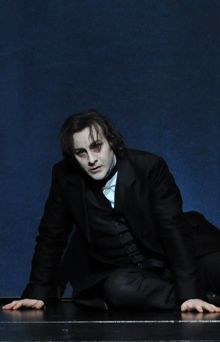 |
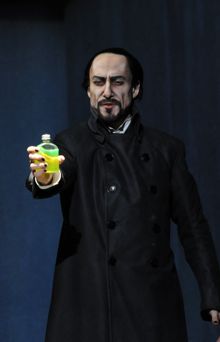 |
Of course the name of the opera is Hoffmann thus the star of the show should be Hoffmann. In fact in Lyon American tenor John Osborn achieves the artistic stature to fulfill the demands of Laurent Pelly’s concept, and hold the stage vocally and histrionically through this monumental competition. Mr. Osborn is a very physical performer, a real actor and a beautifully voiced, finished singer. Vocally he is a tenore leggero allowing him to negotiate the role’s high tessitura with ease, maybe even interpolate a few high notes for added effect. At the end however when we expect the pathos of an emotionally and vocally exhausted Hoffmann Mr. Osborn sounded like he could take it from the top all over again.
The Pelly production begins with Stella alone onstage singing Mozart's “Non mi dir” from Don Giovanni. It was Italian diva Patrizia Ciofi, an esteemed artist who quite resembles Natalie Dessay, in what seems to be her role debut as Stella. It was easy to forgive this bit of wobbly Mozart, harder to forgive the wooden tones of Olimpia with truncated high notes, painful to hear the hoarse sounds of her lower voice as Antonia, and irritating to perceive her struggling tiredness as Giulietta. Though dramaturgically Offenbach’s Tales may beg a single opera star to fulfill an impossible array of voices, this example vindicates casting three different singers who can compete vocally with Hoffmann himself, not to mention a conceptually demanding production.
French bass-baritone Laurent Alvaro made big voiced, sinister villains, moving through the roles with force and aplomb though he does not exude a vocal, musical or histrionic refinement that rises to the sophistication of the Pelly production. The same may be said of young Cyrille Dubois as the four servants. Belgian mezzo-soprano Angélique Noldus was over-parted as Nicklausse, neither her voice nor her persona able to cross over the pit into the auditorium. The roles of Luther and Crespel were clumsily executed by British baritone Peter Sidhom.
Offenbach’s score is one of opera’s most engaging masterpieces. But even the pit could not save this performance. This sixth performance (of eight) was conducted by Philippe Forget (Kazushi Ono conducted the first four). This young French maestro conducts minor projects at the Opéra de Lyon and elsewhere. While the Lyon orchestra ably fulfilled its role and the maestro and singers were comfortable with one another, the wit, power and pathos of the score were sorely lacking. Perhaps the young maestro was unnerved by the roughness of the production and its singers.
Cast and Production
Hoffmann: John Osborn; Lindorf/Coppelius/Docteur Miracle/Dapertutto: Laurent Alvaro; Olympia/Antonia/Giulietta/Stella: Patrizia Ciofi; Muse/Nicklausse: Angélique Noldus; Andrès/Cochenille/Frantz/Pitichinaccio: Cyrille Dubois; Hermann/Peter Schlemil: Christophe Gay; Nathanaël/Spalanzani: Carl Ghazarossian. Chorus and Orchestra of the Opéra de Lyon. Conductor: Philippe Forget. Mise en scène and costumes: Laurent Pelly; Scenery: Chantal Thomas; Lighting: Joël Adam. Opéra Nouvel de Lyon. December 26, 2013.
Rossini Festival, Pesaro 2013
L'italiana in Algeri
Two years ago Italian metteur en scène Davide Livermore (lee-ver-mo-ray) staged Rossini’s very first little opera, Demetrio e Polibio. The staging wasn’t about Demetrio e Polibio, it was about fire (live flames were passed about the stage and floated through the theater), surprising effects that distracted us from the slightness of Rossini’s adolescent attempt. Last year Sig. Livermore staged Rossini’s first tragedy, Ciro in Babilonia. The Livermore metaphor was silent film, likening the primitive moments of cinema to the primitive Rossini. The slight opera was told in startlingly complex early filmic image and color, the magnitude of which overwhelmed any tragic innocence that might have flowed from the young composer.
Just now the prestigious festival bestowed Rossini’s second full length comedy, L’italiana in Algeri (1813) upon Sig. Livermore. L’italiana is in fact Rossini’s first masterpiece though it does not yet host all of the musical and dramatic complexities that operatically deify the composer from Pesaro.
Sig. Livermore does not however lack in complexities. He smothered the Rossini comedy with sight gags, lazzi in commedia dell’arte terms. They were non-stop, some amusing, some really amusing, some annoying, some really annoying, and everything in between. It was an immense, astonishing catalog that towered in sheer scale above the simple comedic process of the libretto which Rossini had taken on after another composer had backed out.
The Mustafà, the bey of Algiers, accidentally shoots down a DC 6 (four propellers) carrying the Italiana to Algiers from where her distressed boyfriend had telephoned her for help. A section of the plane crashed onto the stage from which emerged two stewardesses who joined two platinum wigged ladies of the harem and one eunuch in non-stop backup routines à la Supremes through the curtain calls.
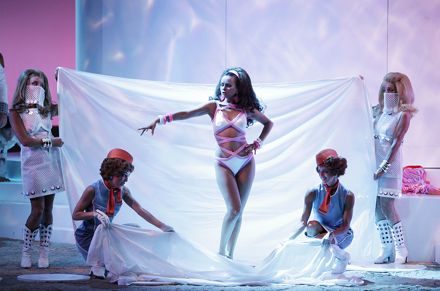 Isabella, harem and stewardesses
Isabella, harem and stewardesses
Mustafà took some pre-Viagra stimulus that so enflamed his prowess that smoke poured from his pants. However pages of women’s magazines from the 1960‘s were projected to inform women how to be beautiful, keep fit and cook good food, in short how to be the worldly and wily Italiana who could make short work indeed of a simple male libido.
Comic book style videos abounded to take us from place to place, and make us homesick for mamma, a real mamma seemed to be present most of the time (it looked like a guy in travesty) to remind us that mamma is not always beautiful. Sig. Livermore is nothing if not slickly theatrical. Rossini, come to think of it, is slickly theatrical too but these two theatrical minds did not seem to be talking to each other.
The Rossini Festival layered on the ironies casting an Italiana who was not Italian at all, but Russian! Mezzo soprano Anna Goryachova is a toothsome young singer from the Zurich Opera. She held the stage with her looks and her long legs more than with her voice which is of burnished beauty and capable of clean if not joyous fioratura. Her rival Elvira, young Italian soprano Mariangela Sicilia has much less to sing but has the obligation to top off the ensembles which she did with force of voice if not personality.
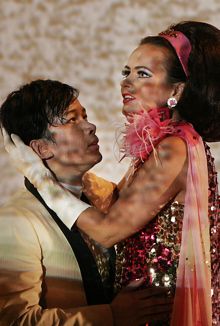 |
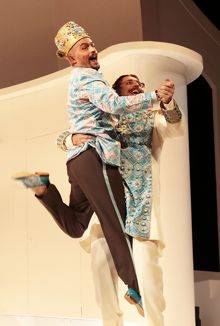 |
Lindoro and Isabella (left), Mustafà (right)
Photos courtesy of the Rossini Opera Festival
Italian bass Alex Esposito commanded our full attention as Mustafà with strong, firm fioratura that raged magnificently when necessary. Mr. Esposito in the prime of vocal estate, a spirited, charismatic actor of inextinguishable theatrical energy. Director Livermore did not wish to channel this splendid young performer into a character who would finally charm us with the warmth of his male simplicity, instead he turned him into a pig in the failed Pappataci finale leaving us bereft of sympathy for such a fine performance.
Young Chinese tenor Vljie Shi is a protégé of the Pesaro festival. These days he seems to be the festival’s artistic director Alberto Zedda’s tenor of choice for Rossini’s elegiac heros. Mr. Shi sang Lindoro with superb Rossini style if not with impressive voice. He is a willing if not convincing actor. His was the least vivid performance of the evening earning him the biggest ovation from an audience that had suffered way too much stimulus. Not to be overlooked was the fine performance of Davide Luciano as Mustafà’s lieutenant Haly, a character that director Livermore constantly paired with the silent eunuch for some reason. Mr. Luciano gave a fine account of his obligatory aria, included even though it was not penned by Rossini.
Festival culture vaunts risk, and risk always seems to be dramaturgical rather than musical. But the Rossini Festival threw caution to the wind and engaged Spanish conductor José Ramós Encinar for L’italiana. Mo. Encinar who is a specialist in contemporary Spanish orchestra music and opera informed Rossini with a clarity of tone developed by studious tempos, achieving at rare times a near Rossini delirium. Notable also was specific and unusual articulation in the ensembles. The dissatisfaction expressed toward Mo. Encinar at the bows of the second performance may have been a response to the stage rather than to his pit.
Guillaume Tell
Rossini’s Guillaume Tell premiered in Paris in 1829. It was in the line-up of operas each year at of the Paris Opera until 1876, missing only 1849, the year of the Spring of Nations revolutions that pitted downtrodden Europeans against undemocratic authority. For good reason — Rossini’s opera is about abused Swiss peasants who rebel against tyrannical Austrian rule. It is a purely political piece that would have further fueled the fires of that particular French revolution.
Rossini’s Guillaume Tell is a French “grand” opera, meaning there is a surfeit of ballet and spectacle, and there is a sentimentalism that is not at all Rossini. It is the final, and a unique moment in the Rossini operatic oeuvre signaling that the two centuries of opéra seria of which he was the final glory were now history.
These days it is rarely performed because it is simply too long — five hours plus — and impossible to cut without sacrificing dramatic integrity and extraordinarily fine music. The French grand opera form demands a ballet in the first act (here a peasant triple wedding) and a ballet in the third act (a peasant celebration). At the end there is a huge storm that must be staged to wipe out the villains so that everyone can live happily ever after or until another revolution is needed.
The Rossini Festival supplied brilliant solutions to the grand opera challenges. First and foremost the opera was staged in the Adriatic Arena, a sports coliseum that the festival transforms into a viable 1500 seat theater. Here a production is an installation rather than scenery placed behind a proscenium, and the installation space is immense. Over the past several years it has proven itself one of the world’s most challenging, spectacular and rewarding stages.
Graham Vick is one of opera’s most overtly political stage directors. With his designer Paul Brown he created a massive white space with a single point forced perspective into the corner of a museum exhibition space, its ceiling a reverse perspective thrust well into the auditorium enclosing the audience visually within the museum.
Along one wall huge glass windows revealed a diorama exhibition space, along the opposite wall was a high gallery opening. The museum image was complicated by the presence of a period movie camera in the Austrian public scenes and by a massive wooden trestle supporting huge theatrical lights that descended finally to the floor in the battle scene where realistic looking, life size horses were mounted by the chorus. It was a sculpted, onstage diorama.
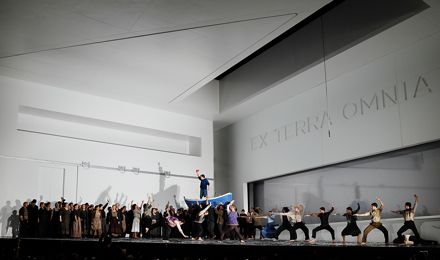 Photo courtesy of the Rossini Opera Festival
Photo courtesy of the Rossini Opera Festival
These images insisted that the production was not fiction, it was actual documented history, illuminated on a stage. William Tell was not simply a mythical figure made a household word by the overture that bears his name but was an actual husband and father and martyr for freedom.
Without the famed ballet of the Paris Opera to execute about an hour and a half of dance Graham Vick worked with his long time collaborator, choreographer Ron Howell to create dance sequences that were pointedly political, therefore more acrobatic than balletic (abrupt, muscular rather than refined movement). Nine dancers plus one talented singer (the evil tyrant Gesler) were soloists with a corps de ballet made up of supernumeraries, and sometimes the chorus all of whom managed some smooth looking background dance movement.
Gesler and his Austrian cronies abused the peasants in the third act dances in a crescendo of ugly images of subjugation ever more painful to observe. Rossini’s Parisian divertissements became quite real representations of repression. Some of the spectators at the second performance really got the point (the very real need to rebel) and booed the dancers when finally (it was very, very long) we could offer some applause and move on to William Tell’s attempt to save his son’s life with the famous arrow/apple trick.
There may be only one person more appreciated in Pesaro than Juan Diego Flórez and that is young conductor Michele Mariotti (the son of Gianfranco Mariotti [the sovrintendente of the festival] and graduate of Pesaro’s Rossini Conservatory), already one of the world’s most sought after conductors for the bel canto repertory. The Rossini overture was played in front of the red fist of the show curtain, a balance of classical elegance, Rossini verve and dramatic intensity — forget the Lone Ranger, it was hearing a magnificent piece of music in perfect context for the first time.
Conductor Mariotti paced the long evening carefully, carving Rossinian detail and new found sentimentalism in unhurried expositions of singing, the extended dramatic recitatives integral to French opera, the arias of course, and more particularly the ensembles — the huge male trio of the second act (Tell, his accomplice Walter Furst and the lovesick Arnold), the mind-boggling quartet in the third act (Tell, his son Jemmy, the tyrant Gesler, his henchman Rodulphe), and finally, many hours into the performance the stunning trio for three female voices (Tell’s wife and son Jemmy plus Mathilde [Arnold’s Austrian girl-friend]) still probing musical and dramatic depth with total indifference to audience fatigue.
Making an opera about Swiss peasantry was as uncontroversial back in 1829 as it would be now. Nonetheless Guillaume Tell is about oppressed peasants and there are always lots of them everywhere, plus French grand opera likes big music. Rossini responded with a huge number of complex chorus numbers and chorus in concert with soloists as in the magnificent finale when William Tell himself leads the emancipated peasants into a world reborn to freedom, to the rebirth of pure, enlightened nature. The outward point of the ceiling of the museum descended revealing a red staircase leading upward and outward of the museum. William Tell urged his son Jemmy into this pure world to Rossini’s moving, pastoral adieu to the tyrants and villains of opera.
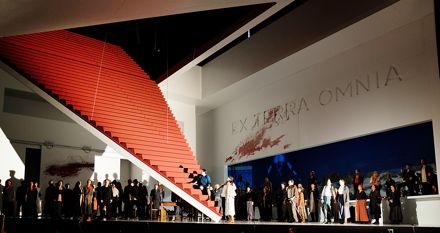 Photo courtesy of the Rossini Opera Festival
Photo courtesy of the Rossini Opera Festival
There were no cuts made to the 1995 Fondazione Rossini critical edition so the performance began at 6 PM rather than at 8 PM — meaning we could get back to our hotels by midnight. There were no supertitles, in fact the program booklet (in which it is standard practice to include the libretto) provided the libretto only in French. The Rossini Festival provided a perfect cast, listed below.
L'occasione fa il ladro
From the sublime to the ridiculous, in Rossini parlance this means the sublimely ridiculous and that was L’occasione fa il ladro, one of the three, one act farces (about one and one half hours in length) Rossini composed in 1812. The truly dumb, incredibly complicated story defies summary, except to say that a petty theft resulted in two couples living happily ever after after just about everything had become therefore totally messed up.
Only a Rossini could make sense of it, and that sense was musical, stretched out into five major arias, one duet, one quintet and a finale. Of the six singers needed the Rossini Festival cast four who are in initial career stages, three of whom have participated in the festival’s Accademia Rossiniana. This is the festival’s young artist program that each year tutors young singers in Rossini style and results in the annual performance of Il viaggio a Reims.
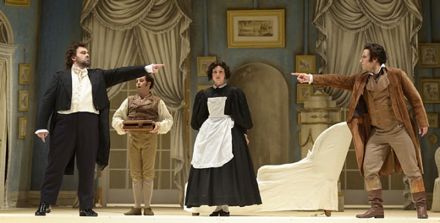
Consistent with current vocal tastes at the festival the two female roles were cast with Russians! Soprano Elena Tsallagova of the Deutsch Oper Berlin sang Berenice (a proto-Rosina role) though her career seems to be heading well outside bel canto. Mezzo soprano Viktoria Yarovava who sings the maid Ernestina was in the Accademia in 2009, then invited to sing in Demetrio e Polibio on the main stage the next year. Her warm and supple voice and apparent charm are leading her to the more famous Rossini roles, notably Rosina and Cenerentola.
Consistent with the national genius all four male roles were sung by Italians! Don Eusebio was sung by tenor Giorgio Misseri, an Accademia participant in 2011 who proved himself here a singing actor of true promise. He is now a part of the young artist program at the Teatro de la Scala. Conte Alberto, Ernestina’s rather colorless protector, was sung by tenor Enea Scala, a former participant in the Pesaro Accademia who has embarked on a lively career.
Martino, Don Eusebio’s servant (the proto-Figaro role) was soundly executed by 41 year old baritone Paolo Bordogna, who has performed roles at the Rossini Festival since 2005. Don Parmenione, was sung by veteran baritone Roberta de Candia who seems now to be exploring buffo roles rather than the straight baritone roles of his earlier career.
The Orchestra Sinfonica G. Rossini was conducted by Mlle. Yi-Chen Ling, a young Taiwanese woman who comes out of the Accademia Rossiana as well. She seems to be very comfortable in the Rossini ethos, though providing a tight musical ambiance in which the singers were held in strict control and from which Rossini seemed to escape from time to time in brief flights of spirit.
The major interest in this production was however the revival of the 1987 production by the great French designer/stage director Jean-Pierre Ponnelle (1932-1988). Typical of many Ponnelle productions this one too was referential to staging techniques that had long sense fallen from use. In L’occasione fa il ladro he plays with sketches of painted canvas panels that used to be the basis of all scenery. These drops were hung inside the stage constructed within the Teatro Rossini stage. During the performance about 15 stagehands were busily at work, a vista, manipulating old ropes connected to an old style wooden grid (the skeleton of the roof structure of a primitive stage). The drops and props were changed, always a vista by the stagehands when the action moved from place to place.
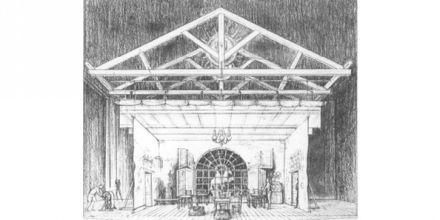
Ponnelle acolyte Sonja Frisell, a stage director of great subsequent accomplishment, recreated the Ponnelle staging that played with the stage space, making use of the auditorium itself as an entrance (Martino started the proceedings by rushing down the aisle to hand the maestra her score). he later used the orchestra pit as a quick escape from the stage jumping into it and out of it as need be to move along the action. The floor of the stage within the stage was a low platform from which the singers stepped down onto the apron of the Teatro Rossini stage for the larger, purely musical events.
A sense of nostalgia was very present for the work of one of the 20th century’s most important and influential stage director, for a time when old opera as contemporary theater was finding its footing, and for a simplicity of concept that may now seem naive but back then seemed, and in fact was a brilliant way to give new life to old art.
Casts and Production
L’italiana in Algeri
Mustafa: Alex Esposito; Elvira: Mariangela Sicilia; Zulma: Raffaella Lupinacci; Haly; Davide Luciano; Lindoro: Yijie Shi; Isabella: Anna Goryachova; Taddeo: Mario Cassi. Orchestra and chorus of the Teatro Comunale di Bologna. Conductor: José Ramón Encinar; Metteur en scéne: Davide Livermore; Scenery and projections: Nicolas Bovey; Costumes: Gianluca Falaschi. Teatro Rossini, Pesaro. August 13, 2013.Guillaume Tell
Guillaume Tell: Nicola Alaimo; Arnold Melchtal: Juan Diego Flórez; Walter Furst: Simon Orfila; Melchtal: Simone Alberghini; Jemmy: Amanda Forsythe; Gesler: Luca Tittoto; Rodolphe: Alessandro Luciano; Ruodi Pêcheur: Celso Albelo; Leuthold / Un Chasseur: Wojtek Gierlach; Mathilde: Marina Rebeka; Hedwige: Veronica Simeoni. Orchestra and chorus of the Teatro Comunale di Bologna. Conductor: Michele Mariotti; Metteur en scène: Graham Vick; Scenery and costumes: Paul Brown; Choreographer: Ron Howell; Lighting: Giuseppe di Iorio. Adriatic Arena, Pesaro, August 14, 2013.
L’occasione fa il ladro
Don Eusebio: Giorgio Misseri; Berenice: Elena Tsallagova; Conte Alberto: Enea Scala; Don Parmenione; Roberto de Candia; Ernestina: Viktoria Yarovaya; Martino: Paolo Bordogna. Orchestra Sinfonica G. Rossini. Conductor: Yi-Chen Lin; Metteur en scéne scenography and costumes: Jean-Pierre Ponnelle; Stage director: Sonja Frisell. Teatro Rossini, Pesaro. August 15, 2013.
Un ballo in maschera at the Chorégies d'Orange
A massive antique Roman theater where stadium opera is always grand opera and often good opera as well.
Un ballo in maschera was maybe the first opera to be strikingly if arbitrarily translocated in place and time — Verdi first moved his story and characters from Stockholm to Pomerania, then from there to New England, all this for political rather than dramaturgical reasons! The raisons d’état for such moves and their ramifications are in fact quite theatrical (censors and lawsuits), in fact far more so than what small theatricality can be eked from the opera.
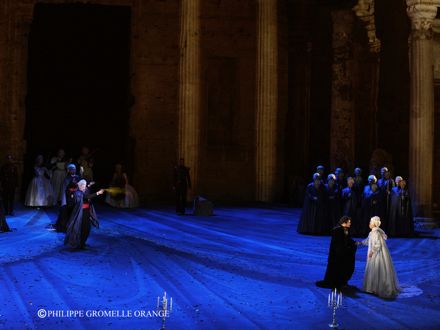 Renato murders Riccardo, Amelia looks on
Renato murders Riccardo, Amelia looks on
There is however a lot of singing that results from a reworking of an old libretto by Eugène Scribe about the assassination of Gustavo III of Sweden. Scribe is the famed creator of the “well-made play” which meant back in the early 19th century construing a series of emotional moments into a reasonable flow of happenings. But such reasonable intention can become an end in itself, and Verdi’s ballo seems such an exercise.
Such lack of dramatic sincerity was evident in Claude Auvray’s production for the Chorégies d’Orange. There was no telling where or when the action takes place, maybe back in Stockholm though the characters use their Italian names from the Pomeranian version. The king and his courtiers were in modern business suits, cell phones at their ears, the decor was a sort of 19th century theatrical drape painted on the stage floor, the masked ball was 18th century powdered wigs. Riccardo (identified as Gustavo on political posters) was enveloped in a massive nordic looking mantle from time to time, Ulrica and her acolytes were in big black gowns with weird gray fright wigs.
It is big at Orange, the stage a few hundred feet wide, its pit (orchestra in Latin) is correspondingly huge and for this ballo housed the accomplished Orchestra National Bordeaux-Aquitaine with a fully symphonic contingent of strings. French conductor Alain Altinoglu, well known to international opera audiences through Live in HD from the Met, responded with ample tempos that stressed size rather than intensity.
Voices were of smaller scale, Riccardo, that is Gustavo, was Mexican tenor Ramón Vargas, one of the more musically accomplished tenors who frequent international stages. He was in fine voice and delivered a well executed performance. His voice remains sweet and supple without the force of production one might expect from the King of Sweden, particularly on a Roman proscenium.
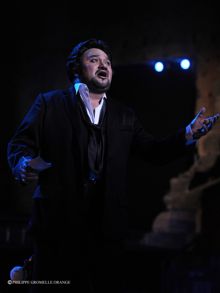 |
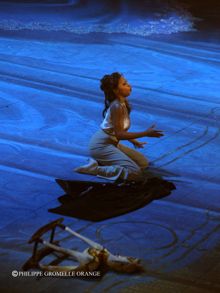 |
Riccardo, Amelia
Amelia was young American soprano Kristen Lewis (born in Arkansas) who went directly from the University of Tennessee to Vienna where she has blossomed into a proto-Verdi soprano who also sings Mimi. She possesses a voice of pure, sweet sound, of ample force that she uses in high Italianate style. Plus she has mastered natural looking acting gestures appropriate to big singing. It all seemed the Cinderella moment of an important career until she disappeared at the end into her huge white ball gown and remained a mere Mimi.
Renato was bespectacled Italian baritone Lucio Gallo notable as the first Italian singer to be invited to the Bayreuth Festival (as Lohengrin’s Telramund in 2010). In Orange just now he apparently was seduced by the grandness of antiquity as he attempted volumes beyond his capacity and lost all possibility of actually forming words. He accepted his hueés (boos) with dignity.
Oscar, French soubrette Anne Catherine-Gillet took the stage from the start and made Verdi’s opera about the page (it was she who supported Gustavo during his dying moments, Amelia showed no reaction at all discreetly distanced on the arm of her husband, the murderer). French mezzo soprano Sylvie Brunet-Grupposo created an Ulrica of little distinction (by the way it was in 2005 that she added the Sicilian surname to her French one when she discovered the identify of her father).
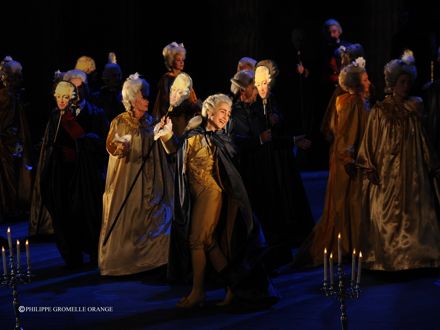 Oscar
Oscar
Singing and mise en scéne at Orange is about size, not about detail. Over the years the various musical and staging techniques have become apparent, though the secret of the impeccable ensemble of chorus with the pit remains a mystery (the combined choruses of the operas of Nice, Nantes-Angers and Avignon number well more than a hundred). Staging however is done to recognized formulae that have proven effective over the decades, notably choristers pour onto the stage from both sides in colorful costumes to make scenic effect given that any real scenery would compete with the magnificent Roman stage wall and no one would want that. Principals remain down stage center and sing.
There is always a coup de théâtre event at the finale, here projections brilliantly lighted the huge Roman stage wall with its original sculptural detail. But the wall slowly darkened from the top down during the several minutes it took Riccardo aka Gustavo to expire. Magnificent is the word. The scenography was by Rudy Sabounghi and the exceptionally moody lighting by Laurent Castaingt, artists primarily active in the south of France and Monaco).
Light sprinkles of rain stopped the show from time to time but did not dampen the enthusiasm of the 8000 or so spectators. The stagehands, apparently unprepared for even the slightest precipitation, resorted to using toilet paper, a Calixto Bieito touch, to wipe dry the stage floor.
Cast and Production
Amelia: Kristin Lewis; Ulrica: Sylvie Brunet-Grupposo; Oscar: Anne-Catherine Gillet; Riccardo: Ramón Vargas; Renato: Lucio Gallo; Samuel: Nicolas Courjal; Tom: Jean Teitgen; Silvano: Paul Kong; A judge: Xavier Seince; A servant: Bo Sung Kim. Orchestre National Bordeaux-Aquitaine and the choruses of the operas of Nice, Avignon and Angers-Nantes, plus the Compagnie Fêtes Galantes conducted by Alain Altinoglu. Mise en scène: Jean-Claude Auvray; Scénographie: Rudy Sabounghi; Costumes: Katia Duflot; Lighting: Laurent Castaingt; Chorégraphie: Béatrice Massin. Le Théâtre antique d'Orange, August 6, 2013.
Don Giovanni, Rigoletto and Elektra at the Aix Festival
Don Giovanni as envisioned by director Dimitri Tchneriakov was first seen at the Aix Festival’s Archevêché theater in 2010. It created a sensation, and scandal in some quarters as do many Tchneriakov mises en scène. Don Giovanni was a somewhat sympathetic drunk who accommodated the sexual needs of a complicated household (in Tchneriakov’s Don Giovanni everyone is related or about to be, except Leporello).
It was a splendid production, conducted by Louis Langrée, music director of Lincoln Center’s Mostly Mozart, with the period resources of the Freiburg Baroque Orchestra. It was a musically vivid if unique, far out take on the legend as told in the opera. A feeling of déja vu anticipated the revival, enough was enough. And besides it seemed only a couple of years since its premiere. It was too soon for the same thing.
Until the curtain rose. The same set, only a different atmosphere, now the silence of a funeral home, the formality of a law court. Then the downbeat. One of the hallmarks of the original production was the crashing of a show curtain to separate, or punctuate scenes and establish a precise time sequence (and, well, to take the place of a whole lot of recitative). In 2010 the moments in time were demurely indicated in French. Now, somehow, the crash was more brutal, the time indications were suddenly boldly typed out, in French and then in English. Sans serif.
The Don stumbled out of Donna Anna’s bedroom, crashed to the floor, dead drunk and he remained drunk for the several month duration of Tchneriakov’s action. American bass baritone Rod Gilfry who not so long ago was the St. Francis in Amsterdam embodied the Don. Mr. Gilfry is the charismatic performer ne plus ultra. Thus we were solidly in the presence of a drunk, a man useless to the world. We were not the only ones. The entire cast of well-known characters had lost patience with him, and finally sat at a grim household council to determine how to rid themselves of the problem. Giovanni himself solved the problem, he simply drank himself to death — il dissoluto punito!
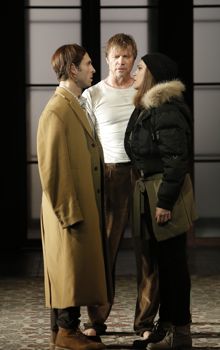 |
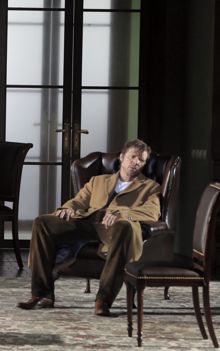 |
Leporello, Giovanni, Elvira
Photo copyright: Patrick Berger / Artcomart, courtesy of the Aix Festival
No one particularly cared, except maybe Zerlina just a bit. After all he was no longer Don Ottavio’s more virile competition nor was he Masetto’s richer competition. These two, usually losers, reached a virile standoff at Giovanni’s Act I party that had nothing to do with the kiss they exchanged during the opera’s Act II finale in 2010. Ottavio now in fact had some real coglioni. Elvira was perfectly happy, in fact relieved to be passed off to Leporello in the complex serenade escapade. Anna and Ottavio had a little flirtatious moment after the Don’s demise and the opera ended.
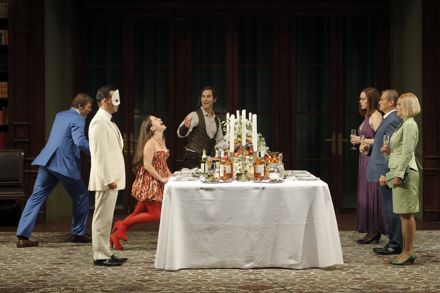 Photo copyright: Patrick Berger / Artcomart, courtesy of the Aix Festival
Photo copyright: Patrick Berger / Artcomart, courtesy of the Aix Festival
This time it was the London Symphony Orchestra and conductor Marc Minkowski, a maestro of impeccable early music credential. There was a suavity of sound, an amplitude of color that only a fine modern symphony orchestra achieves. It was urged on by this once early music maestro who in recent years has taken on the gamut of colorful nineteenth and twentieth century repertory, and now maybe has left earth as well.
The maestro brought forth sugary sweet, sometimes incoherent sounds from the pit that created a sort of alcoholic musical haze through which a wacko continuo pounded. There was indifference to the often separate sonic worlds of the pit and stage, and the maestro seemed to be confusing conducting with arm flailing.
You surely understand by now that all this was art at its most sublime. It was the sequel, hardly the repeat of the brilliant 2010 Tchneriakov Don Giovanni. It had to be seen to be believed, Mozart’s Don Giovanni was not deconstructed, but Don Giovanni destructed as is, in fact, the intention of the opera. We all bought it with minimum booing.
As had been in 2010 the casting for the new Tcherniakov and Minkowski vision was impeccable, bass baritone Kyle Kettleman the only hold over, bridging with sensitivity and subtle emotional understanding the decline of his boss. Arias were sometimes whispered, sometimes almost spoken, never fully sung. Ensembles were dramatically inverted. The new Donna Elvira had withdrawn (no explanation given), and was replaced for the first four performances by the 2010 Elvira, Latvian soprano Kristine Opolais and for the final four performances by Romanian soprano Alex Penda (lately known as Alexandrina Pendatchanska) who oozed Slavic disgust for her no-account husband (the Don).
There used to be an adage in the opera business — don’t mess with Verdi. Another adage was don’t produce Verdi if you don’t have the voices. But a few generations of new age directors have changed all that. Blame it on Jonathan Miller with his mafia Rigoletto, blame it on Calixto Bieito with his toilets in Un ballo in maschera, both emblematic new age productions of Verdi.
The wisdom of the ages still stands of course, but if you invite famous director Robert Carson to stage Rigoletto you take what the latest in operatic thinking gives you. To wit, a big confusion with the equally famous jester in I pagliacci, plus a relentless big top metaphor that offered a myriad of possibilities for creating stage excitement (acrobats, contortionists, a lion tamer [with eight or so scantily clad females (a few square centimeters of faux lion skin], the ninth was the Countess Ceprano, all of whom willing to go topless). Plus the ring master (the Duke of Mantua) willing to take it all off.
Young, reasonably fit Mexican baritone Arturo Chacón Cruz was the Duke of Mantua. His youth ensures powerful and secure high notes though his vocal production seems to preclude forming words. He projects youth and energy and even some charm, though no sweetness or delicacy, and no musical or vocal sophistication. Mr. Chacón Cruz is however experienced in the big-top metaphor having recently played Werther in circus language in Lyon (it worked a bit better for Werther there than for Rigoletto here).
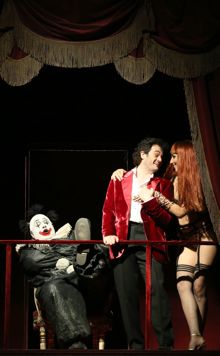 |
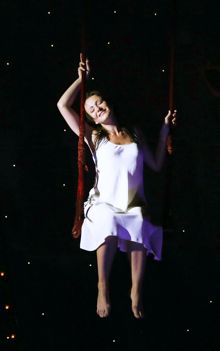 |
Rigoletto, Duke of Mantua, Countess Ceprano, Gilda
Photo copyright: Patrick Berger / Artcomart, courtesy of the Aix Festival
Soprano Irina Lungu was the alternate Violetta to Natalie Dessay’s recent La Traviata in Aix. Russian born and trained, extensively schooled in Italy this young diva has secure above the staff capabilities though her voice sits more expressively in the full lyric range. Mlle. Lungu is indeed highly schooled, her Gilda created by exploiting style without plumbing sincerity either vocally or dramatically.
Georgian baritone George Gagnidze sang Rigoletto, his signature role that he has taken to the world’s major stages (in the U.S. at the Met and in L.A.). His is a consummate Rigoletto combining beauty and power of voice with a seemingly natural inclination to negotiate the emotional poles of the Rigoletto character. Much of this Rigoletto however disappeared amid the clamor of the big-top metaphor.
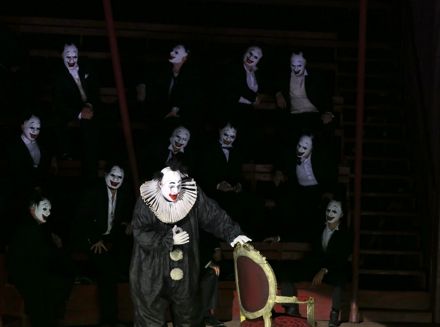 Photo copyright: Patrick Berger / Artcomart, courtesy of the Aix Festival
Photo copyright: Patrick Berger / Artcomart, courtesy of the Aix Festival
Robert Carson typically avails himself of fine designers, here the husband and wife team Radu and Boruzescu of Bulgarian origin who have made their professional lives in France. it is a big-top of long-ago atmospheres, colors that are emotional and shapes that are storybook traditional. The grandstands are steep thus adding a vertical plain to the staging surfaces. With consummate directorial skill Carson used every inch of the horizontal and vertical spaces to create stage pictures, including to highest reaches of the big-top for a floating trapeze swing from which Gilda sang her “Caro nome.”
The richness of directorial and scenic possibilities afforded by the metaphor however sabotaged Carson. His tricky staging failed to ignite the emotional lives of his protagonists, including, most harmfully, the courtiers of Verdi’s crucial Rigoletto chorus. Not that this seemed to bother enthusiastic audiences.
Italian conductor Gianandrea Noseda sometimes allowed his orchestra, the London Symphony to be covered by staging noises, and other times, too often, indulged in exploring and exploiting the sophistication of sound that has made this superb symphony orchestra famous. The Verdi orchestra however is purely dramatic, not an end in itself. It is a dominant player in Verdi’s tightly complex opera organism. Noseda did not and this orchestra could not fulfill their roles in Aix.
Don’t mess with Verdi.
Rarely in the annals of opera do forces converge to create a masterpiece. But this occurred just now in Aix. And no surprise. Patrice Chéreau created the stage and Esa-pekka Salonen created the pit for the Strauss Elektra with extraordinary German soprano Evelyn Herlitzius.
The fire curtain rose to reveal a silence hanging over the minimally shaped classical architectural forms of the set. Von Hofmannsthal’s maids began sweeping and scrubbing the floors. The sounds of the broom, the running of water to fill pails slowly became apparent, even loud, focusing our attention on detail, smallest detail. It was to be an Elektra discovered through microscopic dramaturgical detail.
All hell broke loose in the pit, murdered Agamemnon the dominant musical force of the evening. The servants spread realistically throughout the courtyard discussed palace life. Their individual personalities were perceived by a striking diversity of age, body type and race, the “real” made more so by precise and complex staging, like the music. Real as well was the detail of the costume, vaguely middle European, vaguely mid-twentieth century, the socialist grit and survival feel against which all life must play.
Elektra rendered her opening monologue in stately, mythic terms of pre-written destiny, her idée fixe — the duty of her brother Orest to reek vengeance on their mother Clytemnestra for the murder of their father, Agamemnon. Chéreau’s Clytemnestra was soprano[!] Waltraud Meier, possessed also of her idée fixe — her fear of being killed by her son. Mme. Meier possesses a delicate persona making a vulnerable Clytemnestra. She was a personage and voice much reduced in magnitude from the usual monster.
She was visually and vocally neurotic rather than evil (after all she did have a justifiable reason to kill her husband). Elektra in fact actually embraced her mother during Clytemnestra’s monologue of fear, a coup de théâtre not withstanding its deeply human motivation. A second coup soon followed— Orest and his tutor ceremoniously entered the courtyard (unnoticed by Clytemnestra and Elektra) just as the Clytemnestra confession was concluding, adding frightening layers of now palpable physical threat.
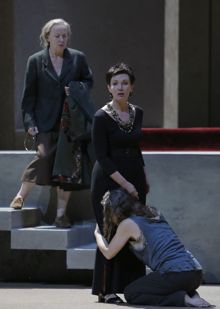 |
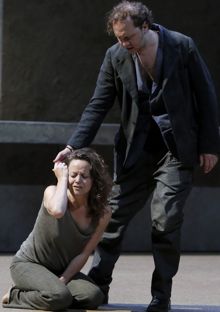 |
Clytemnestra, Elektra, Orest
Photo copyright: Pascal Victor / Artcomart, courtesy of the Aix Festival
Chrysothemis, sung by Canadian soprano Adrianne Pieczonka, was of substantial personality and force, the only being on the stage who could see beyond the murder of Agamemnon. Of a vocal magnitude nearly parallel to that of Mme. Herlitzius Chrysothemis competed vocally with Elektra offering life instead of death.
Orest, Russian bass Mikhail Petrenko, held back from revealing himself to Elektra, the scene staged with Elektra blind to his presence. At this point we were somehow inside Elektra but deprived of understanding this reaction to her brother. Orest too was possessed by duty, his idée fixe, that in fact destroyed him emotionally (killing his mother). His beaten form was made visible to us as he walked slowly off the stage during Elektra’s dance.
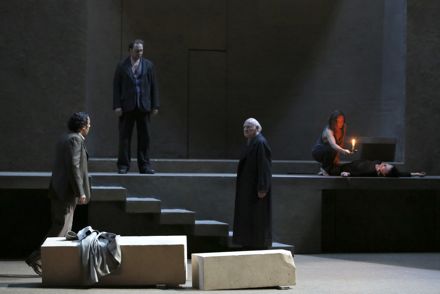 Photo copyright: Pascal Victor / Artcomart, courtesy of the Aix Festival
Photo copyright: Pascal Victor / Artcomart, courtesy of the Aix Festival
Finally Chéreau left Elektra exhausted, sitting on a ledge, and we saw the tragedy not only as that of Elektra but of Orest as well, and of Clytemnestra who lay there dead, murdered by her son.
Conductor Esa-Pekka Salonen used the considerable resources of the Orchestre de Paris, 110 players (68 strings) to tell the Chéreau story. Nothing happened on the stage that did not happen in the pit, with the same intelligence of detail. The dissection of the Von Hofmannsthal libretto was echoed in Salonen’s immersion into the Strauss score, taking it well beyond what you may have perceived before. The delicacy of the chamber orchestra that Strauss inserted inside his massive instrumental forces was notably absent, having disappeared into this fortissimo colossus of neurosis and humanity.
The title is Elektra, she was 50 year-old Evelyn Herlitzius, who took the stage with the palpable energy of a post-adolescent and of voice that shown at momentous times with the beauty of youth. Mme. Herlitzius will have challenged Chéreau and Salonen to make use of these attributes. It is impossible to imagine this production without this phenomenal artist of unceasing physical and vocal stamina. The production now goes to Milan, Helsinki, Barcelona and Berlin with most of this same cast. Casting will be modified when it comes to the Met — a different Elektra most significantly).
For an account by Michael Milenski of the two smaller operas of the Aix Festival 2013, please see Elena and The House Over Taken at the Aix Festival (below).
Casts and Production:
Don Giovanni
Don Giovanni: Rod Gilfry; Leporello: Kyle Ketelsen; Donna Anna: Maria Bengtsson; Don Ottavio; Paul Groves; Donna Elvira: Alex Penda; Zerlina: Joelle Harvey; Masetto; Kostas Smoriginas; Il Commendatore; Anatoli Kotscherga. The Estonian Philharmonic Chamber Choir. The London Symphony Orchestra conducted by Marc Minkowski; Mise en scène et scénographie: Dimitri Tcherniakov; Costumes: Dmitri Tcherniakov and Elena Zaytseva; Lighting: Gleb Filshtinsky. Théâtre de l’Archevêche, Aix-en-Provence, July 18, 2013.
Rigoletto
Rigoletto: George Gagnidze; Gilda: Irina Lungu; Il Duca di Mantova: Arturo Chacon Cruz; Sparafucile: Gábor Bretz; Maddalena: José Maria Lo Monaco; Giovanna: Michèle Lagrange; Il Conte di Monterone: Wojtek Smilek; Borsa: Julien Dran; Marullo: Jean-Luc Ballestra; Il Conte di Ceprano: Maurizio Lo Piccolo; La Contessa di Ceprano: Valeria Tornatore. The Estonian Philharmonic Chamber Choir. The London Symphony conducted by Gianandrea Noseda. Mise en scène: Robert Carsen; Scenery: Radu Boruzescu; Costumes: Miruna Boruzescu; Lighting: Robert Carsen and Peter van Praet; Chorégraphie: Philippe Giraudeau. Théâtre de l’Archevêche, Aix-en-Provence, July 24, 2013.
Elektra
Elektra: Evelyn Herlitzius; Klytämnestra: Waltraud Meier; Chrysothemis: Adrianne Pieczonka; Orest: Mikhail Petrenko; Aegisth: Tom Randle; Der Pfleger des Orest: Franz Mazura; Ein junger Diener: Florian Hoffmann; Ein alter Diener: Sir Donald McIntyre; Die Aufseherin/Die Vertraute: Renate Behle; Erste Magd: Bonita Hyman; Zweite Magd/Die Schleppträgerin: Andrea Hill; Dritte Magd: Silvia Hablowetz; Vierte Magd: Marie-Eve Munger; Fünfte Magd: Roberta Alexander. Coro Gulbenkian. The Orchestre de Paris conducted by Esa-Pekka Salonen. Mise en scène: Patrice Chéreau; Scenery: Richard Peduzzi; Lighting: Dominique Bruguière; Costumes: Caroline de Vivaise. The Grand Théâtre de Provence, Aix-en-Provence, July 19, 2013.
The House Taken Over and Elena at the Aix Festival
That’s Helen (of Troy) by Cavalli, so maybe you are interested after all, though the more engaging experience was The House Taken Over by Vasco Mendonça.
In a festival dominated by Elektra directed by Patrice Chéreau, Don Giovanni directed by Dimitri Tcherniakov and Rigoletto directed by Robert Carson gratefully a place was found for a new opera. It was a commission by the Aix Festival through its Académie Européen de Musique to young (34 years old) Portuguese composer Vasco Mendonça (by comparison the Mozart of Don Giovanni was 31 years old).
The Aix Festival gave the new opera a substantial production by the esteemed British director Katie Mitchell who last summer imagined a brilliant production of British composer George Benjamin’s Written on Skin for Aix (since seen at the Nederlandse Oper and at Covent Garden). Sig. Mendonça is in fact a student of George Benjamin who was a student of Britten and Messiaen.
The libretto was contrived by British dramaturge Sam (short for Samantha) Holcroft on a novella by Argentine novelist Julio Cortázar. Cortázar emigrated from Argentina to France in 1951 when he was 36 years old. His muses were surrealism, improvisation and stream-of-consciousness. He translated Edgar Allen Poe into Spanish.
You get the idea — traditional genres and dramatic attitudes are out the window though Aristotelian unities were zealously respected. A brother and sister clean then eat and read in a room of an old house. Mysterious noises frighten them, so they transfer the same activities to another room where the same thing occurs. They take these activities onto the front doorstep where the sister realizes she must use a bathroom. They leave the house to embark on new lives.
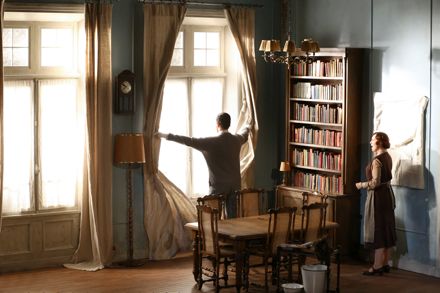 Concordia, Discordia et al
Concordia, Discordia et al
Photo copyright: Patrick Berger / Artcomart, courtesy of the Aix Festival
The libretto in this production did no more than provide composer Mendonça with a structure on which to expound infinite combinations of tones, colors and rhythms that sometimes directly applied to the story telling, but mostly just percolated along as what seemed to be notated improvisation, or rather invention.
The Asko Schönberg Ensemble from the Netherlands was here comprised of two violins, two violas, one cello, one bass, one flute, two clarinets, two trumpets, one trombone plus a myriad of percussion choices presided over by one virtuoso player (Joey Marijs). Etienne Stiebens was the production’s chef d’orchestra. One musical delight followed another in an astonishing array of variation elaborated by these instruments.
Fortunately the grandstand seating at the outdoor Domaine du Grand St. Jean gave us full view into the pit where the evening’s excitement took place. Plenty of it. Cerise sur le gâteau: the trumpeters at the finale abandoned their horns in favor of Melodicas (plastic keyboard harmonicas).
Director Katie Mitchell with her scenographer, British theater designer Alex Eales, shied away from the surrealism of the novella opting to evoke a commentary on the insignificant and suffocating, narrow lives of the English petite bourgeoisie. The production did not take us into the attractive sonic world of Sig. Mendonça’s music nor into the subtle philosophic atmospheres felt by an Argentine intellectual based in mid twentieth century Paris.
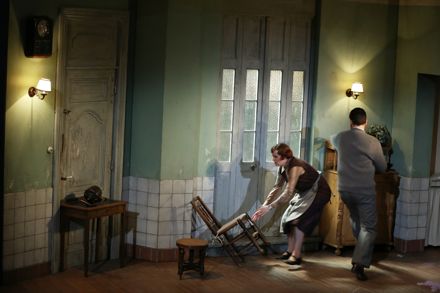 Photo copyright: Patrick Berger / Artcomart, courtesy of the Aix Festival
Photo copyright: Patrick Berger / Artcomart, courtesy of the Aix Festival
The Aix Festival provided two quite able, young British singers, mezzo soprano Kitty Whately and baritone Oliver Dunn, both done up to try to look dull middle-aged. These fine young artists managed the undistinguished narrative style delivery of text with crystal clear English diction, and veered into the opera’s very occasional ariosos with vocal gusto. It is not an opera about voices.
This talented young composer may yet find his operatic way, after all Richard Strauss was 41 before he hit his operatic stride with the Salome libretto by Von Hofmannsthal. Perhaps Mr. Mendonça should look beyond British theatrical forces.
Elena aka The Abduction of Helen by Cavalli is of course not about Helen of Troy even though it says it is. It is really about racy attitudes towards sex and marriage in 17th century Venice. All of Venice had been excommunicated when Cavalli was four years old, not for its free and easy morality but rather because this rich city had the confidence to ignore playing by rules imposed by others. Elena, the thirty-second of his forty one or so operas, is also about playing harmlessly outside the rules, those of restraint or civilized conduct in particular.
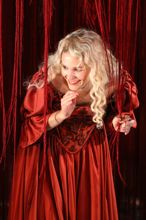 |
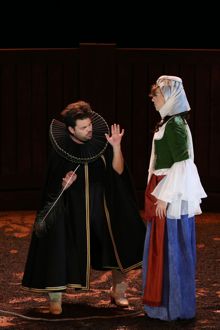 |
Helen of Troy (left), Menelaus (travesty) (extreme right)
Photo copyright: Patrick Berger / Artcomart, courtesy of the Aix Festival
The operas that have made Cavalli famous these days — L’Ormindo, La Calisto and L’Erismena — are all earlier in the Cavalli oeuvre and exemplify the easy charm of stories about deities falling in and out of love with doses of sincerity here and there. Cavalli turned out Elena at age 57 when he was at the height of his fame (the next year Louis XIV lured him to Paris with a special, high tech theater built just for his Ercole Amante). At this point it was easy, too easy for Cavalli to make an opera. Elena seems far too contrived, and perhaps it is an opera best forgotten.
Like all Cavalli operas Elena has a big cast of characters, all with lots to do. Casting is sophisticated at the Aix Festival, and with rare exception true to character and voice and with rare exception indifferent to fame. At the same time the Aix Festival knows the virtues and financial rewards of encouraging young artists. Thus the large cast was comprised of talented young singers all of whom were well nurtured indeed by the opera world’s elaborate and extensive apprentice system.
There was therefore a uniformity of relatively high level talent and technical ability. This was the limitation of the cast. Cavalli’s characters were created by generic, well trained young singers rather than by mature or finished artists with specific traits that qualify them to bring artistic life to human character. Those few with hints of greater artistry fell victim to a generic apprentice atmosphere of promise rather than accomplishment.
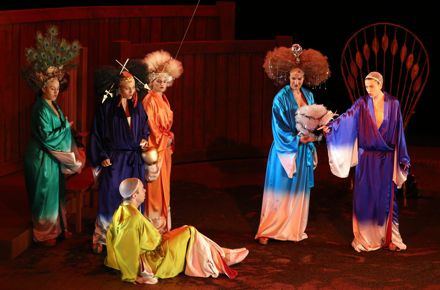 Concordia, Discordia, et al
Concordia, Discordia, et al
Photo copyright: Patrick Berger / Artcomart, courtesy of the Aix Festival
The production was in the Festival’s tiny Théâtre du Jeu de Paume, a relic in the Italian horseshoe style that is perfect for Baroque opera. It was staged by Jean-Yves Ruf, a young French theater pedagogue with acting credentials as well, in a stage space that resembled a bull ring in the first half and a macramé fantasy in the second. The scenery and costumes were fashionable, generic theatre designs that probed “look” rather than depth. It was a long, very long evening.
Ten members of Ambronay’s (a town between Lyon and Geneva) early music ensemble Capella Mediterranea plucked, sawed and tooted in finest, informed period style, led by its founder of Argentine origin and Swiss training, Leonardo Garciá Alarcón.
With the cost of tickets at one half that for major productions at the Aix Festival, productions like Elena and The House Over Taken open the festival to a larger public, those unable or unwilling to bear the $300 plus cost of a ticket for Don Giovanni or Elektra.
Casts and Production
The House Taken Over. Brother: Oliver Dunn; Sister: Kitty Whately. Asko | Schönberg Ensemble conducted by Etienne Siebens. Mise en scène: Katie Mitchell; Scenery: Alex Eales; Lighting: James Farncombe. Domaine du Grand St. Jean, July 11, 2013.
Elena. Elena/Venere: Emöke Barath; Menelao: Valer Barna-Sabadus; Teseo: Fernando Guimaraes; Ippolita/Pallade: Solenn' Lavanant Linke; Peritoo: Rodrigo Ferreira; Iro: Emiliano Gonzalez Toro; Menesto/La Pace: Anna Reinhold; Tindaro/Nettuno: Scott Conner; Erginda/Giunone/Castore: Mariana Flores; Eurite/La Verita: Majdouline Zerari; Diomede/Creonte: Brendan Tuohy; Euripilo/La Discordia/Polluce: Christopher Lowrey; Antiloco: Job Tomé. Cappella Mediterranea conducted by Leonardo García Alarcón. Mise en scène: Jean-Yves Ruf; Scenery: Laure Pichat; Costumes : Claudia Jenatsch; Lighting: Christian Dubet. Théâtre du Jeu de Paume, July 17, 2013.
Verdi Messa da requiem in Naples
San Francisco and Naples have much in common these days — streets with potholes, ever more gourmet pizzerias, homeless, etc., and, yes, Nicola Luisotti.
This Verdi Messa da requiem in Naples was the San Francisco Opera’s music director’s debut as the neo-direttore musicale of the Teatro San Carlo, one of Italy’s more august musical institutions. The event was announced as a staging of what was to have been Verdi’s crowning achievement [the 73 year-old composer then further ornamented his crown with Otello and Falstaff]. It was a happening no serious Luisotti groupie could resist.
To be sure the foolish idea to stage this setting of the now outdated Catholic liturgy was later abandoned, and whispers of such an event at San Francisco Opera fell silent as well. Hear tell the production was to have been by the Catalan theatrical collective La Fura dels Baus operatically famous for a Grand Macabre at the English National Opera (samples may be found on YouTube).
The third performance of the Requiem (February 28) was briefly delayed by a wildcat strike by the orchestra and chorus protesting the elimination of funding for the theater’s corpo di ballo (corp de ballet), funding already sunk in a morass of scandal. The director of the theater came on stage to announce the delay to the great displeasure of one member of the audience who could not stop shouting vergogna, vergogna (shame, shame).
But the performance did begin, the whispers of Requiem aeternum (find eternal peace) first in the strings then by the chorus were clearly articulated stating that this was to be a vocal performance, not judgement day atmospheres. This spectacular Luisotti requiem prayer in fact emerged as one voice confessing, supplicating, imploring, begging eternal rest, with the implicit resolution that such reward was very much in question.
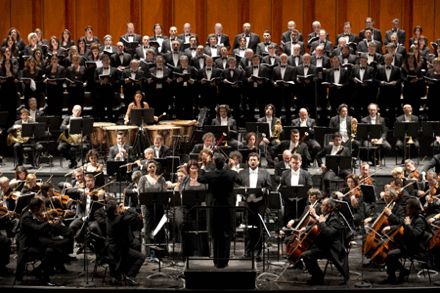
The first opportunity to establish the emotional chaos that set the dramatic character of Luisotti’s sinner comes soon, the male chorus of the Teatro San Carlo aggressively shouted Te decet hymnus, Deus (a hymn rises to you, God) in individual voices, a ragged sound that articulated individual anguish.
There was a lot to be worried about. The maestro unleashed the fury of the Dies irae in volumes possible only in old, very old opera houses (1716). The bass drum punctuation slightly anticipated the beat adding nearly intolerable tension, brass blurted out hidden threats. And the prayer began, four vocal colors placed directly in front of the maestro and directly in his control. Individually and jointly these voices supplicated forgiveness in the midst of raging fury of San Carlo’s huge, virtuoso orchestra.
Mezzo soprano Luciana d’Intino conveying that all is written and will be judged (Liber scriptus proferetur) exploited an enormous range of colors, gutteral chest tones, raucous almost spoken tones, snarling threats, beautifully voiced high climaxes, a voice in the prime of its expressive power that deeply invaded our sensibilities. Mme. d’Intino, of middle age, is one of Italy and Europe’s current greats who has not yet found her way onto the American west coast stages.
Argentine tenor Marcelo Alvarez delivered Verdi’s extended Dies irae tract Ingemisco tamquam reus (I weep because I am guilty) with unprecedented tenorial fervor (choking and weeping), not to mention hand wringing amidst evident physical torment as well. Mr. Alvarez, like no other tenor, ever, can take powerful vocal emotion to the edge of dramatic explosion.
Ukrainian bass Vitalij Kowaljow (Wotan in L.A.and Lucrezia Borgia’s third husband Alfonso in San Francisco) used focused black tone with minimum inflection to announce the day of judgement and describe the cries coming from the damned shrouded in flames, words that were maximally chilling in this cold blooded delivery.
The four singers stood before maestro Luisotti in rapt visual contact. An overwhelming synergy of artistic intention occurred that created one voice and body for all mankind in its final moments of existence. The performance was a massive statement, it was conceptually complete and artistically finished.
The Offertorium duet between Teatro Don Carlo’s concert master, Gabriele Pieranunzi and the soprano was of exquisite beauty. The Sanctus took off in an orchestral frenzy that left the chorus in the dust though it soon caught up and erupted into absolute delirium for the final Hosanna in excelsus. The Agnus dei was sung as if hummed, a prelude to the gentle Lux aeterna trio.
Soprano Maria Agresta in the first flush of an illustrious European career possesses a clear soprano of full lyric capability, and of great beauty that she manages with full confidence in passages of soaring tones, with much subtlety of volume from pianissimo to fortissimo. For Verdi the soprano voice is one of purity, not of complexity though dramatically there is the suspicion that such purity must harbor some guilt. It is to such a voice that Verdi gives the final Requiem prayer, Libera me, Domine (spare me, God, from eternal damnation).
This prayer, offered at the graveside, is the voice of the single, innocent soul against the fury of the Day of Wrath who in its guilt and fear explodes in a final, personal supplication for peace. The final lines in Naples were no longer sung by Maria Agresta, but spoken in desperate fear.
The Neapolitan audience seemed not to know how to react to all this shock and awe. It did manage some applause though it was hardly commensurate with the scope of the performance.
And finally the despotic maestro was not hampered by production.
Teatro San Carlo scheduled back to back performances on February 28 and March 1 (the third and fourth of five performances). Given his commitment to the role tenor Alvarez could not possibly have survived a next day performance, thus Hungarian tenor Szabolcs Brickner was scheduled to sing that performance. Said to be indisposed he was replaced by tenor Stefano Secco, well known to San Francisco Opera audiences for many roles including the 2009 Verdi Requiem conducted by Donald Runnicles. Mr. Secco is a very different artist than Marcelo Alvarez, of sweeter voice and temperament. Obviously uninitiated into the maestro’s idiosyncratic conception much accommodation was accorded Mr. Secco and a very fine, far smoother performance resulted. It did not approach the expressive magnitude of the previous evening.
Luisotti will conduct the Verdi Requiem in San Francisco in June. It could be the hottest ticket in a long time.
Cléopâtre and Les Troyens in Marseille
There are forces to be reckoned with at l’Opéra de Marseille — a first class orchestra, a first class chorus, first class casts (with notable exception, see below) who inhabit an extraordinarily fine old opera house.
(And, yes, Roberto Alagna as Enée [Aeneas]).
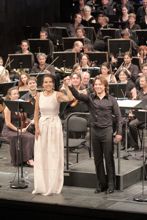
Béatrice Uria-Monzon and Roberto Alagna
Photo copyright Christian Dresse, courtesy Opéra de Marseille
French grand opera adores the mezzo-soprano voice, among its greatest roles are legendary personages who expound human warmth and honest sensuality. Just now there were three of these unique creatures in Marseille — Cléopâtre, Cassandre and Didon — all in the person of French mezzo-soprano Béatrice Uria-Monzon (born of a Spanish father).
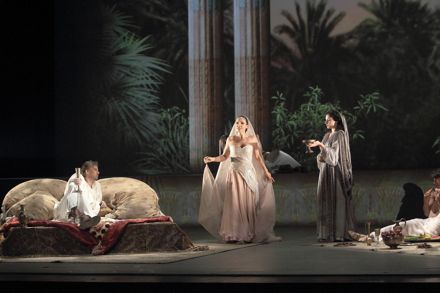 Marc Antoine, Cléopâtre, Octavie
Marc Antoine, Cléopâtre, Octavie
Photo copyright Christian Dresse, courtesy Opéra de Marseille
Mme. Uria-Monzon was the Carmen ne plus ultra on major stages twenty years ago. Her roles are now mature women of courage and resolve (like Tosca too, Mme. Uria-Monzon’s current rôle fétiche). At fifty years of age now Mme. Uria-Monzon reads as a beautiful woman in her vocal prime. Her sound is big and secure, beautiful and elegant, uniformly produced throughout the mezzo register. Her expressive subtleties, her musicianship are created by rhythm and volume gradation more so than by variation of color.
Not that Massenet’s Cléopâtre is among French grand opera’s greatest works. Having long since given the world his masterpieces Massenet kept turning out operas, the last opera, Cléopâtre, premiered posthumously in Monte Carlo (1914). It is almost the same story as Dido (beautiful woman entraps vulnerable man who abandons her). By 1912, the year of his death, Massenet knew how to write an opera, the final count was forty.
Cléopâtre takes place in a warring world (lots of fanfare) engendering wrenching farewells not to mention betrayals (lots of singing). It was therefore a very pleasurable afternoon if you like fanfares and arias (well, we all do) and you do not look to closely or expect too much. Marseille’s venerable metteur en scéne Charles Roubaud endowed this slight work with a perfect staging that would have pleased the monegasques (those who reside in Monaco) in the heady days just before the first world war.
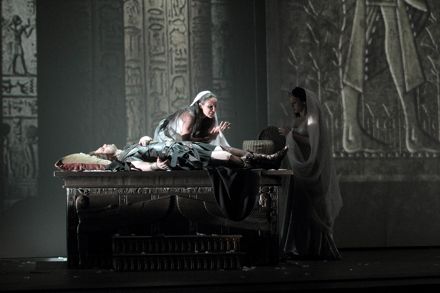 Cléopâtre preparing for death
Cléopâtre preparing for death
Photo copyright Christian Dresse, courtesy Opéra de Marseille
Its hero, Marc Antoine was impersonated by handsome Canadian (Quebec) baritone Jean François Lapointe who sings well and seems most at home in giddy moments. His rival for Cleopatra’s attention, Spakos was keenly portrayed by Marseille born tenor Luca Lombardo, and Mark Anthony’s faithful and forgiving wife Octavie was beautifully sung by Canadian (Quebec) soprano Kimy McLaren. Conductor Lawrence Foster realized the maximum possible from Massenet’s score.
As Carthage’s Dido in Berlioz’ Les Troyens mezzo soprano Béatrice Uria-Monzon towered in stature far above Egypt’s flighty Cleopatra. Berlioz’ endows his tragic queen with sublime music. The Berlioz muse is iconoclastic, quite personal, even naive allowing this heroine an emotional simplicity and honesty that explodes first in delicate sexuality and finally in rage at Aeneas. Mme. Uria-Monzon as Troy’s Cassandra on the other hand needed to threaten the Trojans with her prophecies. These menaces lie in an emotional range less present in Mme. Uria-Monzon’s persona, though such violent utterances did find resonance within her voice.
It was a concert version of Les Troyens in Marseille, within this format Mme. Uria-Monzon shined, creating first Cassandra and then Dido in her voice then adding minimal physical movement in gesture and expression that carefully etched and held character even in concert format. Overt physical action was however implicit in the Berlioz orchestra, the five trumpets and four trombones detailing its bellicose happenings (the finale of the Trojan War, the proto-Hannibal invasion of Carthage and, not least, the founding of Rome).
Seventy-two year old American conductor Lawrence Foster, the lone linguistically foreign presence (well, save a tenor from Texas), drew an always driving, rhythmically square, colorfully detailed performance from the Marseille Orchestra who skillfully created non-stop thunder, be it military description or deeply personal emotional statement. Mo. Foster is the new music director of the Marseille orchestra, its first in many years. He has the task of honing it into an ensemble of true stature. Much progress has already occurred, there is the assumption that obvious deficiencies will soon disappear as well.
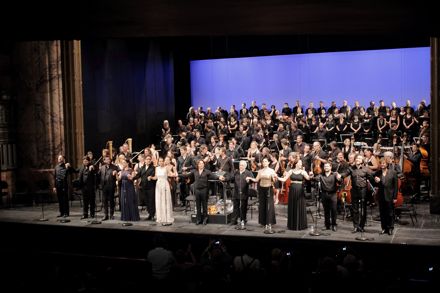 Orchestra, chorus and soloists of the Opéra de Marseille
Orchestra, chorus and soloists of the Opéra de Marseille
Photo copyright Christian Dresse, courtesy Opéra de Marseille
The violins are solid (twelve firsts and twelve seconds), the cellos and violas sang quite beautifully. Berlioz makes much use of a wind quartet (flute, oboe, clarinet and bassoon) in various combination to color his story, and these players proved fully capable of providing this big time maestro and Berlioz what they demanded. The French horn duet was intoned and echoed in appropriately sweet and supple tones, a very visible and very appreciated orchestral high point of the evening.
Among the high points of the five hour evening was the fourth act Anna (Dido’s sister) and Narbal (a government minister) duet discussing, no surprise, duty versus love. In this concert performance several roles were double cast, not just the tour de force of Cassandra/Dido. Bass Nicolas Courjal sang Narbal, Priam and the ghost of Hector. He is a beautifully voiced young singer who early in the evening had made Priam’s description of the sack of Troy especially moving.
Texas tenor Gregory Warren as Iopas softly sang the Ode to Cérès as well as the Song of Hylas in sweetly beautiful tones (he also urgently delivered a few messenger one-liners). In a staged performance both of these stand alone songs assume greater relief than in a concert performance. Here they were the only episodes where scenic atmospheres were sorely missing.
The field of mezzo-sopranos (not a soprano in sight) was completed by Clémentine Margaine as Dido’s sister Anna and Marie Kalinine as Aeneas’ son Ascanio. Mlle. Margaine is obviously a Carmen of stature whose bolder presentation served to underline the subtlety and delicacy of Béatrice Uria-Monzon’s Dido.
Not to forget the Trojans and the Carthaginians, the eighty or so voices of the Opéra de Marseille chorus who suffered and raged with Berlioz’ inimitable gusto and proved themselves an ensemble of true operatic stature. The tenors made an exceptionally beautiful sound.
That leaves Aeneas, Roberto Alagna. Sad to say this famous tenor was a black hole in an otherwise superb evening. He was obviously unprepared, losing his way in his big moment in the fifth act; unsure of himself he resorted to inappropriate tenorial vocal mannerisms (heaving the voice, exaggerated scooping); unable to trust his musicianship he compensated with non-stop gesturing; apparently unable to deliver the nuit d’ivresse et d’extase infinie he availed himself of sotto voce, vocal trickery that simply caricatured a lover. Most disappointing were the antics he affected as he was being booed.
For an appreciation of the Opéra de Marseille please see www.OperaToday.com "Marseille, European Capital of Culture"
Cléopâtre: Cast and Production
Cléopâtre: Béatrice Uria-Monzon; Octavie: Kimy McLaren; Charmion: Antoinette Dennefeld; Marc Antoine: Jean-François Lapointe; Spakos: Luca Lombardo; Ennius: Philippe Ermelier; Amnhès: Bernard Imbert; Sévérus: Jean-Marie Delpas. Chorus and Orchestra of the Opéra de Marseille conducted by Lawrence Foster. Mise en scéne: Charles Roubaud; Décors: Emmanuelle Favre; Vidéos: Marie-Jeanne Gauthé; Costumes: Katia Duflot; Lumières: Marc Delamézière. Opéra de Marseille, June 23, 2013.
Les Troyens: Cast and Production
Didon / Cassandre: Béatrice Uria-Monzon; Ascagne: Marie Kalinne; Anna: Clémentine Margaine; Hécube / Polyxène: Anne-Marguerite Werster; Enée: Roberto Alagna; Chorèbe: Marc Berrard; Panthée / Mercure: Alexandre Duhamel; Narbal / Priam / Ombre d’Hector: Nicolas Courjal; Iopas / Hylas: Gregory Warren; Un Chef grec / 1ère sentinelle: Bernard Imbert; Prêtre de Pluton / 2ème sentinelle: Antoine Garcin; Helenus: Wilfried Tissot. Chorus and Orchestra of the Opéra de Marseille conducted by Lawrence Foster. Opéra de Marseille, July 15, 2013.
Elettra a Marsiglia
Vendetta sadistica e sfida sadistica in parti uguali. Conoscete la storia – se Oreste non avesse trucidato sua madre, Elettra l’avrebbe fatto. E così fa ripetutamente nel suo delirio lungo quasi due ore.
Le fantasie sadistiche di Elettra sono pressochè pari alla tortura sadistica inflitta da Richard Strauss agli interpreti con ruoli davvero impervi. La soprano americana Jeanne-Michèle Charbonnet (nata a New Orleans) dimora lo spaccato di un sotterraneo di un maestoso palazzo miceneo in questo lasso di un’ora e cinquanta minuti d’estremo sforzo vocale.
Non ci sono state sorprese in questa rimessa in scena dell’Opéra di Marsiglia di uno spettacolo inizialmente prodotto da Charles Roubaud nel 2003. C’è un richiamo all’arte filmica che nel primo scorcio del Novecento minava le esplorazioni psicologiche, specialmente le psiche perverse. La scenografa Emmanuelle Favre ha prodotto una duplice prospettiva notevolmente esagerata su una scala tonale di bianchi e neri, e la costumista Katia Duflot ha lavorato sia col bianco e nero sia col colore, donando una ricchezza art nouveau seppure non nelle sue forme originali. Una mise en scène semplice e efficace da parte dei produttori.
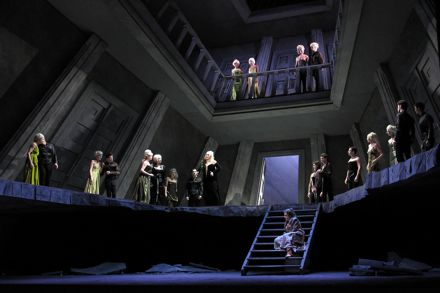 Scenografia di Emmanuelle Favre
Scenografia di Emmanuelle Favre
Photo copyright Christian Dresse / Opéra de Marseille
Jeanne-Michèle Charbonnet interpreta una Elettra adeguatamente giovane, fisicamente e vocalmente. L’artista proietta la degradazione della bellezza fisica causata dall’ossessione depressiva e suscita la nostra simpatia vitale verso tale triste creatura. Si infuria con toni veri e potenti, a volte di una bellezza piacevole e a volte lacerati, anche soffocati, tali che talvolta abbiamo temuto il cedere intero della sua voce solo per venirne rassicurati e di seguito star di nuovo all’erta. Conclusa la danza, esanime per terra, la Charbonnet ci ha convinti di essere una vera Elettra, e non soltanto una soprano che più o meno riesce a cantarla.
Il maestro Pinchas Steinberg invece ha riservato sorprese. Questo veterano direttore d’orchestra ha imposto un passo molto misurato il quale ha offerto un quadro inaspettato dei momenti più delicati e vuoi sensibili dell’espressionismo straussiano. Questo quando non ha minacciato di arrestare l’intero flusso emozionale. La scena di Oreste e Elettra è stata di una dolcezza spettacolare, e pure brutale. L’Oreste, il basso Nicolas Cavallier (attore prima di diventare cantante) trasudava l’appena celata soddisfazione sessuale provata da Elettra mentre le sue fantasie raggiungono lentamente e con furba prudenza il climax.
Il coup de grace del pomeriggio è stato comunque dato dalle grida, forse amplificate, di Clitennestra durante l’assassinio, grida cantate e non il solito protratto grugnito viscerale. La mezzosoprano Marie-Ange Todorovitch ha offerto attraverso il verace canto una rara versione di questo personaggio tragico e complesso, proponendo una figura ben più ricca e completa del solito mostro cantato a voce roca se non spenta. Madame Todorovich, squisitamente avvolta in un abito di scena nero e parrucca in biondo platino, ha reso la sua scena con Elettra estremamente vivida, quasi euforica nella esposizione infranta delle sue paure.
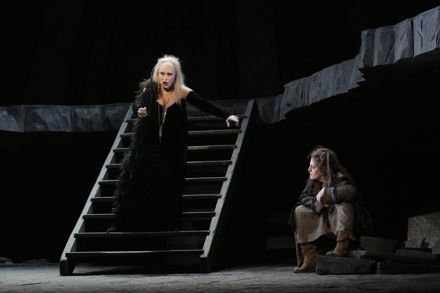 Clitennestra, Elettra
Clitennestra, Elettra
Photo copyright Christian Dresse / Opéra de Marseille
La soprano tedesca Ricarda Merbeth ha fornito una persistente tonalità, ampia e luminosa, nel ruolo di Crisotemide, vestita di fiori che, per quanto pallidi, si addicevano alla sua figura verginale (Mme. Merbeth canta anche nel ruolo di Salomé). È riuscita nel proiettare l’atteggiamento pauroso e ingenuo del suo personaggio senza peraltro trovare le profondità vocali e istrioniche di questo personaggio - antidoto a sorella e madre.
Patrick Raftery ha voce sufficiente per incarnare un pallido Egisto, adatto ai bisogni di Strauss and del metteur en scène Roubaud. La sorvegliante, le ancelle e il restante cast sono stati resi in maniera consona da chi, con alcuni soprannumeri di costumi sorprendenti, ha popolato di tanto in tanto con immagini nauseanti e vivaci le parti sopraelevate del maestoso edificio scenico.
L’Opéra di Marsiglia ha previsto un organico di settantasei musicisti, sufficiente tranne nel momento in cui il maestro necessitava di un suono imponente dagli archi per sviluppare i momenti voluttuosi della partitura straussiana. Le baignoires su entrambi i lati della fossa hanno ospitato ciascuna un numero parziale di otto timpani richiesti da Strauss, riproponendo i climax con grande impatto stereofonico. I palchetti sovrastanti le baignoires hanno ospitato gli altri strumenti a percussione e le due arpe, il cui suono ha fluttuato inquietante negli spazi superiori del teatro offrendo una consonanza acustica al tintinnio psichico del dramma di Strauss.
Un pomeriggio piacevole (10 febbraio 2013)
Dopo i suoi studi di letteratura italiana all’Università di California, Berkeley, Michael Milenski si dedicò all'opera lirica in quanto assistente di produzione e di technica all’Opera di San Francisco. Fondò in 1979 una compagnia di opera a Long Beach (città pochi chilometri al sud di Los Angeles), compagnia presto rinomata per le sue mises en scène d’avanguardia. Sotto Milenski l'Opera di Long Beach fece diverse prime americane importanti — la trilogia di Monteverdi in versioni originali, Król Roger di Szymanowski, Powder Her Face di Thomas Adès, ecc. Nato a Colorado, U.S.A., Milenski è stato Professore d’Opera alla California State University, Long Beach. Adesso vive tra San Francisco e un paesino nel sud di Francia.
Elektra in Marseille
Sadistic revenge and sadistic challenge in equal parts. You know the story — if Oreste had not slaughtered his mother Elektra would have. And did over and over in nearly two hours of raving about killing her mother. Elektra is one of the repertory's more beloved operas.
Elekta’s sadistic fantasies are surely equaled by the sadistic torture of the soprano by Richard Strauss. American soprano Jeanne-Michèle Charbonnet (born in New Orleans) inhabited the cutaway basement of a soaring Mycenaean palace for the nearly two hour stint of vocal abuse.
 Set design by Emmanuelle Favre
Set design by Emmanuelle Favre
Photo copyright Christian Dresse / Opéra de Marseille
There were no surprises in this restaging of Opera de Marseille’s 2003 Charles Roubaud production. There was no metaphor save image derivation from the first moments film art, this new medium at one with the distortions of reality mined by the new century’s exploration of psyche. Twisted psyches in particular. Set designer Emmanuelle Favre provided a greatly exaggerated double perspective in black and white, and costume designer Katia Duflot worked both in black and white and in color with an art nouveau richness though not tone. It was a simple and effective mise en scène by its producers.
Jeanne-Michèle Charbonnet reads as an appropriately young Elektra, physically and vocally. She projected the degradation of physical beauty brought on by depressive obsession, and she evoked our basic sympathy for such a sad creature. She raged in big, pure tones that were sometimes beautiful and sometimes ragged, and sometimes we feared for her stamina only to be reassured and then put on edge again. Her dance finished, dead on the floor, la Charbonnet had convinced us she was a real Elektra, not simply a soprano who could sing it, more or less.
 Clytemnestra, Elektra
Clytemnestra, Elektra
Photo copyright Christian Dresse / Opéra de Marseille
The conducting did hold surprise. Veteran maestro Pinchas Steinberg imposed a very measured pace that offered startling insight into the softer, even tender moments of Straussian expressionism. This when it did not threaten to stall all emotional flow. The Orest and Elektra scene was of spectacular beauty and tenderness and still very brutal. Orest, bass Nicolas Cavallier (an actor turned singer) exuded the not-so-subtle sexual satisfaction Elektra feels as her fantasies slowly and carefully moved toward climax.
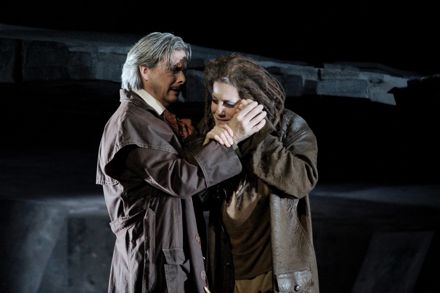 Orest, Elektra
Orest, Elektra
Photo copyright Christian Dresse / Opéra de Marseille
The coup de grace of the afternoon was however the screams, possibly amplified, of the murdered Clytemnestra, sung screams rather than the usual extended gut grunt. Mezzo-soprano Marie-Ange Todorovitch offered a well sung, through sung version of this complex, tragic personage that revealed in fact a much larger and far more complete personage than the usual half-voiced monster. Mme. Todorovitch made her scene with Elektra maximumly vivid, reveling in the shattered exposition of her fears, exquisitely costumed in black gown with a platinum blond wig.
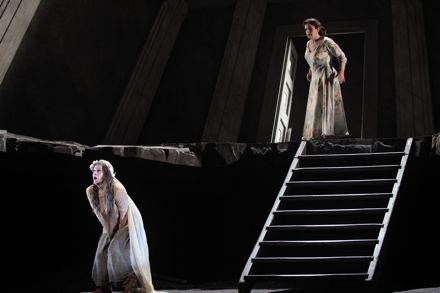 Elektra, Chrysothémis
Elektra, Chrysothémis
Photo copyright Christian Dresse / Opéra de Marseille
German soprano Ricarda Merbeth provided big, luminous tones non-stop as Chrysothémis, costumed in colorful flowers befitting her maidenhood (Mme. Merbeth sings Salome as well). This fine singer succeeded in projecting the larger attitudes of her character without plumbing the vocal and histrionic depths of this character antidote to sister and mother.
Patrick Raftery retains sufficient voice to deliver a pallid Aegistus, the limit of the role for Strauss and metteur en scène Roubaud. The overseer and maid servants, train bearer and confidant were appropriately rendered (no small compliment), who with a number of strikingly costumed supernumeraries made sick and lively stage pictures from time to time on the upper levels of the soaring set.
The Opéra de Marseille deployed seventy-six musicians. That seemed not quite enough, particularly when the maestro needed huge string sounds to develop the voluptuous moments of the Strauss score. The baignoires on both sides of the pit each housed a partial number of the eight timpani Strauss requires, rendering the great climaxes in stereo, and maximally powerful. Boxes further above housed percussion and harps whose sounds floated eerily in the higher reaches of the hall with an acoustic appropriateness to the psychic pings of the Strauss drama.
It was a fine afternoon.
Cast and ProductionElektra: Jeanne-Michèle Charbonnet; Chrysothémis: Ricarda Merbeth; Clytemnestre: Marie-Ange Todorovitch; First Servant: Lucie Roche; Second Servant: Christine Tocci; Third Servant: Simona Caressa; Fourth Servant: Bénédicte Rousseno; Fifth Servant: Sandrine Eyglier; Overseer: Anne-Marguerite Werster; Aegisthe: Patrick Raftery; Oreste: Nicolas Cavallier; Précepteur d’Oreste: Erick Freulon; Young Servant: Avi Klemberg; Old Servant: Christophe Fel. Chorus and Orchestra of the Opéra de Marseille. Conductor: Pinchas Steinberg; Mise en scéne: Charles Roubaud; Scenery: Emmanuelle Favre; Costumes: Katia Duflot; Lighting: Marc Delamézière. Opéra de Marseille. February 10, 2013
Die Entfûhrung aus dem Serail in Montpellier
The fearsome Ottoman Turks had threatened the Austrian borders for centuries. But Mozart’s little singspiel makes light of this truly serious situation, and offers a quite enlightened resolution for the conflict as well.
Shall we say naive resolution. After all the complexly human trilogy is yet to come, and the Magic Flute will be just that — a fantasy. So let Abduction’s Pasha forgive and forget, and don’t argue with operatic idealism. This new production of Mozart’s first operatic masterpiece forgets any and all intriguing political or dramatic contexts. It merely frames this simplistic singspiel as a work of art to be admired, like a late 18th century painting in a museum.
Metteur en scène Alfredo Arias and scenographer Roberto Platé, both Argentine, used a huge gilded frame as the back drop, framing only sky because it was the ceiling of a grand old room turned on its side (the floor of the stage had some windows as did the stage ceiling). The why of this witty perspective seems to be just because.
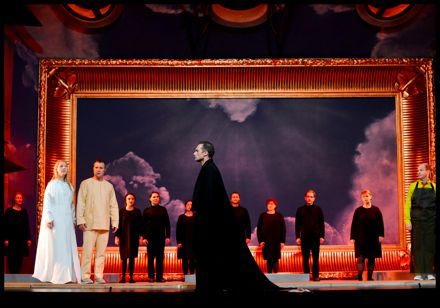 Konstanze, Belmonte, Pacha Selim, Pedrillo
Konstanze, Belmonte, Pacha Selim, Pedrillo
Photo copyright Marc Ginot / Opéra National de Montpellier
French high fashion designer Adeline André abstracted early twentieth century shapes for the very witty costumes (Osmin, the Pasha’s chauffeur with greatly exaggerated glove cuffs, Pedrillo in a bright green shirt with a black leather bistro apron, Konstanze in light blue high 40’s design pumps as prime examples). Mozart’s six principals spent most of the time on the fore stage, sometimes wrapping themselves in the Opéra Comedie’s red velvet house curtain, sometimes in front of or behind a painted scrim that echoed the framed sky and flew in and out now and again.
Of course the staging was not nonsense any more than Mozart’s singspiel is nonsense. The 25 year-old Mozart simply exploded musically. The explosion happened in the pit. About 30 players from the Orchestre National de Montpellier formed the absolutely splendid pit ensemble, the wooden mallets on the period tympani used for this occasion defined the musical grit and edge. The pizzicato strings of Pedrillo’s Romance, in fact the whole of this extended scene, sounded with nearly boom box resonance. The architecturally magnificent 1200 seat Opéra Comédie burst with musical magnificence.
Hungarian conductor Balázs Kocsár was the musical force, never overwhelming the naive joy of Mozart’s little opera with his own or Mozart’s self importance, finding instead a rhythmic release and musical elaboration that told of the young composer’s newly found independence — from a tyrannical patron and a smothering father — and the young composer’s discovery of love — for first Aloysia and then Constanze Weber. Joyous excitement that Mo. Kocsár made flow from the pit in intense, always lyric tempos.
Vocal explosion happened on the stage when German soprano Cornelia Gôtz brought the energy and furious excitement of Mozart’s future Queen of the Night to the headstrong Konstanze, imposing her prodigious vocal technique on what is surely Mozart’s most demanding role, and making it vocally vivid and dramatically real. Mozart’s famous show stopper “Martern aller Arten” was far more than a virtuoso feat, it was gigantic emotional release.
It was sublime music making indeed when this maestro joined this soprano to discover the happiness that Mozart exudes in his first Viennese years.
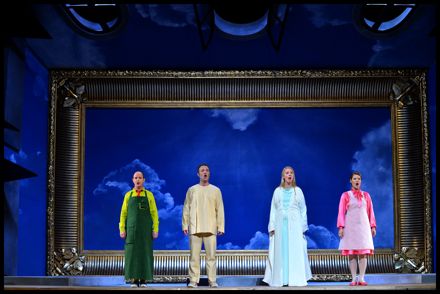 Konstanze, Belmonte, Pedrillo, Blonde
Konstanze, Belmonte, Pedrillo, Blonde
Photo copyright Marc Ginot / Opéra National de Montpellier
Metteur en scène Arias provided dramatically abstract staging, stage movement based on musical phrase rather than story telling illustration. All movement was choreographed, an aria about or influenced by another character was always sung in the physical presence of that character. Mozart’s gigantic Act II quartet “Ach, Belmonte, Ach, mein leben” was rendered in purely formal geometric shapes, rigidly symmetrical. Choristers in the Act I finale construed themselves in a formal pattern on the stage dressed in concert blacks. Mr. Arias staged which is to say choreographed every last second of music. It was effective when it was not tiresome.
Czech bass Jan Stava made chauffeur liveried Osmin a charming, positive presence with just a hint of menace. Stage director Arias‘ choreography allowed none of the classic schtick. The young bass attacked his mindboggling "O, wie will ich triumphieren" with confident bravado and succeeded as well as anyone with its coloratura and range challenges.
American tenor Jeff Martin as Pedrillo exemplified the arbitrary casting possible in this mise en scène, musically rather than character driven. In this witty casting it was not the usual ingénu Pedrillo, Mr. Martin these days sings Wagner's Mime here and there, plus Rosenkavalier’s Valzacchi at the Bolshoi! Pedrillo’s complications to Mozart’s silly story were therefore a bit less naive and a lot less romantic and a far more structural. The same may be said of the Blonde sung by Norwegian soprano Trine Wilsberg Lund.
Mlle. Lund however did not achieve the elegant lyricism that the maestro afforded his singers, never quite capturing the beat of his lyric flow. On the other hand American tenor Wesley Rogers as Belmonte did sing musically, and nearly mastered the spirit of the stage movement. After an impressive start he seemed very tired by the third act, understandable as the vocal demands of the role are considerable.
And finally Pacha Selim exploded, as musically as if there had been music [his lines are spoken]. Swiss actor Markus Merz let it rip in hochdeutsch. There had been mercifully little dialogue, with the obvious frustration that the spoken German was not a language most of us understood. When Mr. Merz had his moment he made it compete as best he could with some of the world’s most joyful music.
Cast and Production
Konstanze: Cornelia Gôtz; Belmonte: Wesley Rogers; Blonde: Trine Wilsberg Lund; Pedrillo: Jeff Martin; Osmin: Jan Stava; Pacha Selim: Markus Merz. Chorus of the Opéra National Montpellier. Members of the Orchestra National Montpellier. Conductor: Balázs Kocsár; Mise en scène: Alfredo Arias; Scenery: Roberto Platé; Costumes: Adeline André; Lighting: Jacques Rouveyrollis. Opéra Comédie, Montpellier. February 5, 2013.
Dialogue of the Carmelites in Toulon
Boasting one of France’s grandest opera houses (said to be the model for Paris’ Opéra Garnier) Toulon hosts a season of five operas from the standard repertory. In France that means that Aida, Butterfly and Flute go hand in hand with Carmen and, yes, Dialogue des Carmélites.
The pit however is small for big opera, thus the baignoires (boxes) sitting just over the sides of the pit have long since been taken over by percussion. In the recent renovation of the Opéra the pit was not enlarged making it necessary to requisition additional nearby baignoires to accommodate Poulenc’s generous post Romantic orchestration — the harps coté cour (left side) and a piano coté jardin. The Opéra de Toulon was set up for a big evening.
New productions are rarely created in Toulon — this Dialogue of the Carmelites was an exception. Jean-Philippe Clarac and Olivier Deloeuil, the artistic team of some pretension that has overseen the Opéra Français de New York since 2005 were its authors. In recent years messieurs Clarac and Deloeuil have undertaken as well the stagings of large, non-operatic choral and orchestral works in important French theaters.
The techniques they have developed informed this staging of Poulenc’s Dialogues, the set more of an art installation than an integration of opera’s dramatic components. The ancien régime (or ancestral home in this abstract staging) was a Louis XIV settee in a display case, the monastery was a white, hard-edge Stonehenge configuration. Interludes were visually inhabited by huge black and white projections of nuns’ faces enclosed in Revolutionary period habits when not enlivened by the a vista intrusion of stagehands (maybe the angry mob) to modify the elements of the installation (some benches became crosses and others became the general mayhem of the Place de la Révolution).
The coup de théâtre was, of course, the executions. A large white plaque descended with MORT written in straight neon lines, fifteen, uhm, make that sixteen little lines were extinguished one by one in concert with Poulenc’s hyper kitsch, not to say wonderfully effective, always moving finale. It even survived, almost, this staging. Believe it or not.
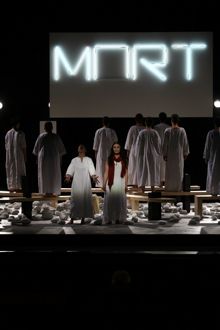
Virginie Pochon as Constance, Ermonela Jaho as Blanche
Photo courtesy Opéra de Toulon, copyright Yachar Valakdjie
The mise en scène did offer the singers ample space and relief to portray Poulenc’s very human characters struggling to reconcile life with death, fear with principle (and the list of conflicts goes on), the humanity in Poulenc’s startling opera exponentially intensified by installing it within spiritually competitive women. The impact of Poulenc’s opera is realized by the individual performances of five nuns, each performance contributing to the complexity and therefore effectiveness of the other performances. These are complicated women.
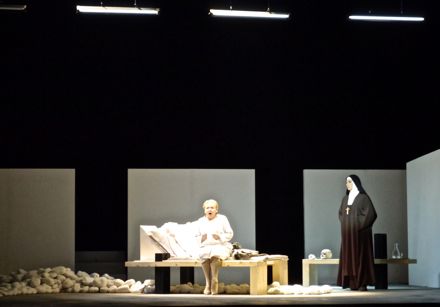 Nadine Denize as the Prioress, Sophie Fournier as Mère Marie
Nadine Denize as the Prioress, Sophie Fournier as Mère Marie
Photo courtesy of Opéra de Toulon, copyright , Frédéric Stéphan
Toulon made it part of the way with Albanian soprano Ermonela Jaho as Blanche, possessed by primal fears and questionable spirituality. No stranger to the Toulon stage (Mireille [2007], Thais [2010]) Mlle. Jaho is a large scale artist with a very fine instrument (thus a very big career). Blanche dominated the stage as Poulenc meant her to do, the stage having been set for her by the old Prioress Mme. de Croissy enacted by mezzo soprano Nadine Denize. The Prioress is dying, thus this cameo role is always undertaken by a magnetic singer, often retired who can gasp and hopefully emit a few good tones from time to time. Mme. Denize was appropriately magnetic, shall we say mesmerizing, and gasped with the best of them. Equally affecting was the role of Constance, the young nun whose impetuousness belied her purity, sung by French soprano Virginie Pochon.
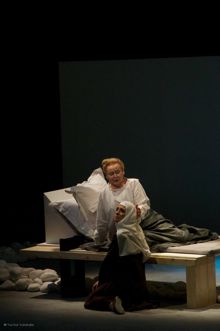
Nadine Denize as the Prioress, Ermonela Jaho as Blanche
Photo courtesy Opéra de Toulon, copyright Frédéric Stéphan
The roles of Mère Marie de l’Incarnation and Madame Lidoine are dramatically more pointed. In fact the biggest singing of the evening is given to Mère Marie, once assumed to be the successor to the old Prioress, and who finally is the only one of the nuns who declines martyrdom making her the spiritual villain of Poulenc’s opera. The new prioress, Madame Lidoine is a simple, unassuming soul, who finally achieves emotional stature as an effective mother to her flock. Taken respectively by mezzo soprano Sophie Fournier and Spanish soprano Angeles Blancas Gulin these two roles did not contribute sufficient force of personality or voice to effectively complete the dramatic spectrum. The same may be said of the aumônier (chaplain) to the nuns sung by tenor Olivier Dumait.
Overseeing all this musically was octogenarian conductor Serge Baudo. The realization of Poulenc’s score lacked the urgency these spiritual dilemmas should provoke, and lacked the musical energy required to keep this theater piece alive for two hours. Nor could the maestro impose sufficient control over the orchestra to assure clean entrances and cutoffs.
Cast and Production
Blanche de la Force: Ermonela Jaho; Madame de Croissy: Nadine Denize; Madame Lidoine: Angeles Blancas Guin; Le Chavalier de la Force: Stanislas de Barbeyrac; L’Aurmônier: Olivier Dumait; Le Marquis de la Force: Laurent Alvaro; Constance de Saint-Denis: Virginie Pochon; Mère Marie de l’Incarnation: Sophie Fournier; Le premier commissaire: Thomas Morris; Le second commissaire: Philippe Ermelier; Docteur Javelinot: Jean-François Verdoux; Thierry: Thierry Hanier; Mère Jeanne: Sylvia Gigliotti; Soeur Mathilde: Rosemonde Bruno La Rotonda. Chorus and Orchestra of the Opéra de Toulon. Conductor: Serge Baudo; Mise en scène & scene design: Jean-Philiippe Clarac & Olivier Deloeuil; Costumes: Thibaut Welchlin; Lighting: Rick Martin. Opéra de Toulon. January 29, 2013.
Pelléas et Mélisande in Nice
Pelléas et Mélisande, in t-shirts and jeans, were out riding bicycles. They came upon a fountain. You know what happened.
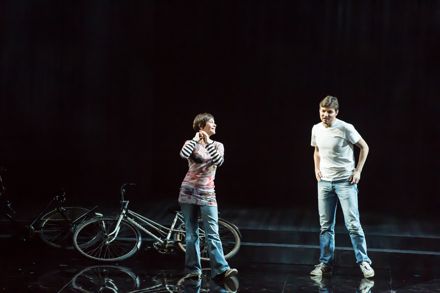 Sandrine Piao as Mélisande, Sébastien Guéze as Pelléas
Sandrine Piao as Mélisande, Sébastien Guéze as Pelléas
Photos courtesy of Opéra de Nice, ©D.Jaussein
As we already did because it was all a flash back. We had seen Golaud, dead, a bullet hole on the top of his head, seated in a sort of chair carefully and cleanly created out of a piece of a classic Greek column. He was surrounded by a lot of strangely dressed people plus an even stranger one in a clown costume (lacking only the red bulb on the nose). This we soon found out was Yniold.
In a bit less than three hours Mélisande was dead too during a psychedelic light show that took place beyond the Zen garden behind the very gray, very angular Japanese pavilion that served as the unit set. This garden setting was perhaps intended to invite us to conjure in our meditations all those fountains and grottos and bleak seascapes that other times make Debussy’s masterpiece one of opera’s sublime experiences. We were however just then participating in a violent domestic tragedy making meditation difficult.
The day of Mélisande’s death and his own Golaud chose to wear a bright maroon suit with black stripes. Pelléas was of course already dead having chosen to wear red blazer and a yellow shirt with a colorful tie for his late night fateful farewell to Mélisande. Mélisande who had a short, pert haircut had to pretend that a blue and gold scarf, obviously from India, was the hair that Pelléas tried to wallow in.
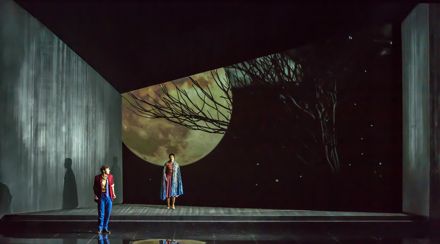 Sandrine Piao as Mélisande, Sébastien Guéze as Pelléas
Sandrine Piao as Mélisande, Sébastien Guéze as Pelléas
Photos courtesy of Opéra de Nice, ©D.Jaussein
Costumes were by the production’s stage director, René Koering (père), sets were by Virgil Koering (fils) who evidently has a thing about radio operated model cars because this high tech toy was also featured in Wolf-Ferrari’s Secret of Susanna [the secret was that she smoked dope] that he designed a few years ago for Montpellier. Arkel on the other hand was pushed around the stage in an antique wheelchair.
The Opéra de Nice, a Belle Époque monument, these days boasts fairly large pit, allowing a quite generous number of strings. The accomplished Orchestre Philharmonique de Nice did indeed provide some of the rich sonorities that can make this remarkable score an orchestral tour de force. The conductor was Philippe Auguin, its music director (Mo. Auguin is also the music director of the Washington National Opera).
The maestro surely will have had an agreement with the cast that they would be entirely on their own for the duration of the opera as he did not so much as even glance at the stage, remaining buried in the score when not energetically encouraging the various players and sections of his orchestra (Mo. Auguin was quite visible to me as I had press seats courtesy of the Opéra de Nice in a box directly over the pit and stage). This presumed agreement however had its flaws — the engrossed maestro did not connect with the stage. The huge, shattering moments that make Pelléas and Golaud two of the repertoire’s most complexly emotional roles were rendered orchestrally soulless, their impact filtered through the maestro’s ponderous orchestral processes.
The singers (on the stage directly below me) were in fact brilliantly connected to the Maeterlinck tragedy and were well able to negotiate the text rendered into Debussy’s urgent melodic shapes and rhythms. Baritone Franck Ferrari (a Niçois with an Italian surname) gave a powerful performance as Golaud. Ferrari possesses a dark hued voice with reserves of virile power, ideal for Maeterlinck’s tragic hero. He is a consummate singing actor who gamely executed even the strangest moments of the stage direction.
 |
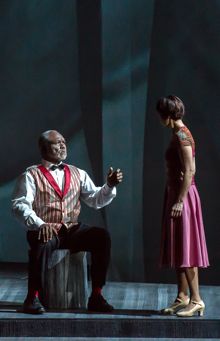 |
Franck Ferrari as Golaud, Willard White as Arkel
Photos courtesy of Opéra de Nice, ©D.Jaussein
Lyonnais tenor Sébastien Guéze proved himself yet again to be a very accomplished interpreter of the French heroic roles (Faust as well as Pelléas as examples). His French is crystal clear, his voice is able to expand into ever greater fortes of emotional release in Debussy’s most intense moments. The scenes of his sexual discovery of and declaration of love to Mélisande were the most thrilling of the evening.
A last minute replacement for the Arkel listed in the program (no explanation why, leaving room for speculation) was American trained black bass baritone Willard White. Jamaican born White is one of the renowned basses of recent times. Obviously a powerful performer he added an unusual, lascivious magnitude to Arkel that seemed to make him the primary architect of the tragedy. Mr. White’s French had a bit of a twang at first but we got used to it.
French early music diva Sandrine Piau was the Mélisande. Her voice is of sufficient amplitude to convey the indecision of this famous enigma though the mise en scéne deprived her of the ambience and the persona needed to enflame the above gentlemen. Mlle. Piau gamely pretended that Mélisande had a psychotic breakdown before she died. Russian born, French trained soprano Khatouna Gadelia gave Yniold a far more energetic and knowing presence than this emblematic innocent usually possesses.
It is hard to fathom what quirk of old-boyism handed a new production of this masterpiece to veteran opera intendant René Koering when there are so many easily identifiable French stage directors who have the technique, experience and imagination to plumb its depths with intelligence and sensitivity. Mr. Koering is a jack-of-all-operatic-trades. This attribute served him brilliantly as general director of the Opéra National de Montpellier, but it does not give him the experience or artistic stature to mount a production on what should be an important provincial French stage.
Cast and Production
Pelléas: Sébastien Guéze; Mélesande: Sandrine Piau; Golaud: Granck Ferrari; Arkel: Willard White; Geneviève: Elodie Méchain; Yniold: Khatouna Gadelia; Doctor: Thomas Dear. Chorus of the Opéra de Nice Côte d'Azur. Orchestre Philharmonique de Nice; Conductor: Philippe Aiguin; Stage Director: René Koering; Costumes: René Koering; Set Design: Virgil Koering; Lighting: Patrick Méetüs. Opéra de Nice. January 17, 2013.
L'Italiana in Algeri in Marseille
Once a mainstay of the repertory L’Italiana in Algeri now usually gives way to Il Turco in Italia when an opera company wants to give Il barbiere di Sivigllia and La cenerentola a rest. So a new production of this first flower of Rossini’s comic maturity was very welcome news.
In recent years the Rossini Festival at not-too-far-away Pesaro has focused on very early and very late Rossini, from the first silly commedia dell’arte farces that manage a trio or quartet once in awhile to the mature comedies that are dramatically so complex that the comedy genre collapses into grand act finales of septets at the minimum, with internal quintets and sextets that further complicate relationships. L’Italiana manages a modest sextet to close the first act and allows the pappataci quartet to grow to a brief sextet at the opera’s end. The extended, masterful sextet finales of Il barbiere will arrive three years later.
There was the wonderful just now in Marseille. Italian conductor Giuliano Carella was in the pit. This fifty-seven year old maestro, music director of the Opéra de Toulon and frequent guest in Marseille and Monte Carlo, is one of the treasures of opera in the south of France. As well he makes the rounds of the more prestigious European stages for the bel canto repertory, not to mention the Bellini Festival in Catania.
That he is a master Rossinian as well was apparent from the first moments of Rossini’s overture — an unrushed fleetness, a lightness that would lead anywhere, like the witty interplay of the oboe and piccolo that made you feel the pure joy of making music.
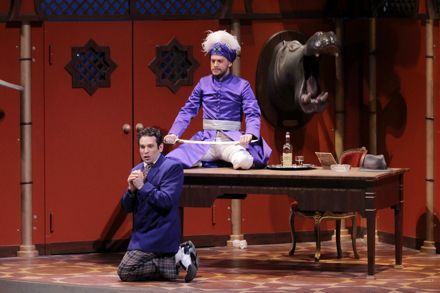 Frédéric Antoun as Lindoro, Alex Esposito as Mustafa
Frédéric Antoun as Lindoro, Alex Esposito as Mustafa
Photos courtesy of Opéra de Marseille, copyright Christian Dresse
Then the singing, the repeated ragings of an Algerian emir named Mustafa (fed up with a clinging concubine) where the maestro’s ample tempos allowed magnificent fioratura to rip forth. And it all came together in the end with the zany quartet in which Mustafa is made a pappataci (it’s a joke, no one, most of all Mustafa, is sure what a pappataci is), the plot complexities became musical complexities, the confusion became total and the maestro brought it all together into a joyful froth that was pure music. The great Rossini.
And there was the weird. French mezzo-soprano Marie Ange Todorovitch was the Isabella. Mme. Todorovitch is one of the treasures of the Opéra de Marseille, recently in Henri Sauguet’s Chartreuse de Parme as Stendhal’s splendid Dutchess of Sanseverina inappropriately in love with her young nephew Fabrice, as the cowardly Mother Marie in Poulenc’s Dialogue of the Carmelites, and upcoming as Clytemnestra in Elektra. So it was a huge stretch to embody Rossini’s sex-bomb Isabella (role debut apparently) even though Mme. Todorovitch’s roles have included about everything else in her long career.
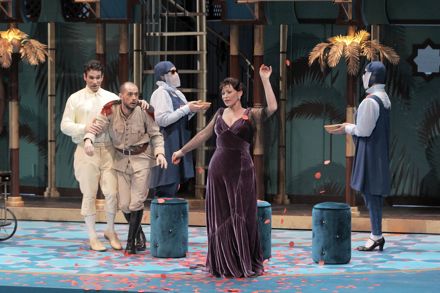 Frédéric Antoun as Lindoro, Alex Esposito as Mustafa
Frédéric Antoun as Lindoro, Alex Esposito as Mustafa
Marie-Ange Todorovitch as Isabella
Photos courtesy of Opéra de Marseille, copyright Christian Dresse
Mme. Todorovitch possesses a large, roundly mature mezzo-soprano voice with, therefore, minimal flexibility though she did manage a bit of fioratura at mezza voce. Her needed effort to do so deprived Rossini of the joyful unleashing of florid technique that make these passages sheer musical delirium. Unfortunately Mme. Todorovitch’s performance severely dampened the verve that had been established initially by the maestro, by the accomplished Italian Rossini bass Alex Esposito as Mustafa and by the excellent Canadian tenor Frédéric Autoun as Lindoro. Make no mistake, la Todorovitch is an estimable artist. She was flagrantly, inexplicably miscast.
The new production, shared with Avignon, was created by Italian stage director Nicola Berloffa whose major credits seem to be assisting important Italian directors at major theaters. He successfully staged Rossini's Voyage à Reims performed by entry level artists that made the rounds of French stages a few years ago. But here Mr. Berloffa made the usual mistakes perpetrated by directors who do not commune with the comic muse. Mr. Berloffa confounded Rossini fioratura with too bright colors, with busy, cute decor and with catchy staging conceits (chorus and stage hands in drag, among others) that at first glance may be amusing but pall as the evening wears on. Not trusting Rossini to provide the theatrical energy Mr. Berloffa demanded that his actors constantly move and gesture. And as a bonus the action was arbitrarily updated, at least in part, to the flapper era, perhaps so that Mr. Berloffa, who designed the costumes as well, could provide a flashy red flapper dress for Mme. Todorovitch to wear during the finale.
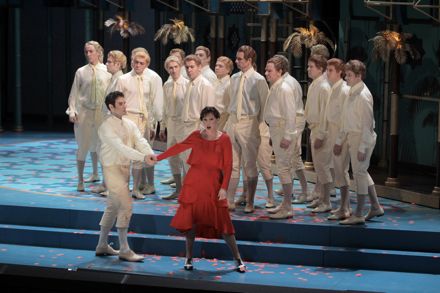 Frédéric Antoun as Lindoro, Marie-Ange Todorovitch as Isabella
Frédéric Antoun as Lindoro, Marie-Ange Todorovitch as Isabella
Photos courtesy of Opéra de Marseille, copyright Christian Dresse
Besides the conducting the evening did have two other quite considerable pleasures — the Mustafa of Alex Esposito was energetically sung in consummate Rossini style. Evidently a committed collaborative artist Mr. Esposito gave his all to realize Mr. Berloffa’s hyped-up stage direction. Tenor Frédéric Antoun as Lindoro, the lost lover Isabella stumbles upon in Algeria, is a cooler performer who struck a less strident tone on the stage. He delivered the brilliant coloratura and hit all the high notes with infectious ease in warm, even tones that prove a Rossini tenor can in fact have a beautiful voice and still be exciting.
Uhm, did I miss the point? Maybe there was a well hidden concept that Isabella was supposed to be a woman in mid-life crisis who conjured for herself a fantasy fling with two fine young singers. Unfortunately she would have had to hold up her end of the deal.
Win some, lose some.
Cast and Production
Isabella: Marie-Ange Todorovitch; Elvira: Eduarda Melo; Zulma: Carol García; Mustafa: Alex Esposito; Lindoro: Frédéric Antoun; Taddeo: Marc Barrard; Haly: Patrick Delcour. Orchestra and Chorus of the Opéra de Marseille. Conductor: Giuliano Carella; Stage Director: Nicola Berloffa; Set Design: Rifail Ajdarpasic; Costume Design: Nicola Berloffa; Lighting: Gianluca Antolini. Opéra de Marseille, January 2, 2013.
Falstaff in Los Angeles
There was once the famous L.A. “Giulini Falstaff” — back in 1982 — a project of the Los Angeles Philharmonic that did much to propel the founding of Los Angeles Opera the following year (though L.A. Opera’s first production was not until 1986).
At the time accounts of the Giulini Falstaff performances at the Dorothy Chandler Pavilion were politely enthusiastic, these many years later recollections are less so. With the Los Angeles Philharmonic in the pit (called, by the way, the golfo mistico in Italian) a frustrating gulf opened between operatic forces. In opera the pit is intended as one player in a much larger mechanism, but with this magnificent orchestra in the pit the intention was that singers, scenery, costumes and lights become a part of the symphonic ensemble.
Thus the Giulini stage was simple — a symmetrical and monochromatic country house. And in all other aspects as well the production was understated, and praised because it did not usurp attention. The important pit had become a too formidable gulf to traverse on our way to a real Falstaff.
Falstaff is again at the Dorothy Chandler these 31 or so years later, and it marks a dramatic change of operatic temperament. It is a real Falstaff, a very real one which is to say that there is much to like and much to question. Like why pay good money for a new production that looks like it was a reject for the Giulini Falstaff of thirty years ago.
Once again the American operatic establishment has looked to the British stage director cabal. In this case it was one Lee Blakely whose major credits in the program booklet are musicals for Paris’ Thêàtre Chatelet, and some Offenbach and Bizet for Santa Fe Opera. Maybe this explains why the set looked like it had been designed for Santa Fe Opera’s opened-to-the-horizon stage (in Santa Fe they say it is so you can see nature’s magnificent thunder storms in the distance).
Set symmetrically between identical towers flanking the sides of the stage are the carefully described wooden locales of each of Falstaff’s first two acts, always leaving the horizon line apparent. And for the third act as well, but with a twist. British designer Adrian Linford provides an incongruous weird, nightmarish Black Huntsman’s tree for Windsor Forest begging the question why it is surreal, since in the story it is a real tree (and everything else is real in this production).
Director Blakely did give us a very good third act by envisioning all its magical antics as a parade crossing the horizon between the towers. This trick structured the act very effectively, making the homespun theatrics seem like real homespun theatrics conjured by the residents of Windsor. Maybe the tree needed to be built like a platform so Fenton could find a good place to sing his aria.
There are incongruities in the casting as well. Three singers hold the stage with high operatic panache and voice that is purely Italian. Baritone Roberto Frontali is an accomplished if generic Falstaff and he sings it beautifully and powerfully. Baritone Marco Caria is a handsome Ford who has sufficient voice and presence to anchor the action, an accomplishment all to rare for this role. Soprano Carmen Giannattasio has a bright sound and sparkling persona well suited to a comedic Alice Ford. These are big singers, comfortable doing their thing on the stage.
Then casting became international. Argentine tenor Juan Francisco Gatell makes a fine looking Fenton, his voice with a bright boyish edge rather than a finished tenorial sound. Russian soprano Ekaterina Sadovnikova makes nice sounds and moves as a reserved Nanetta.
The character roles are less effective, most of the singers having neither the personalities nor the experience needed to make their roles vibrant participants in this be-all-and-end-all of ensemble operas. Los Angeles mezzo soprano Ronnita Nicole Miller sang a powerful Erda in the San Francisco Opera Ring but here exhibits little talent as a comedic performer. Rodell Rosel as Bardolfo and Valentin Anikin sing and move well as apprentice artists in roles begging much more.
Tenor Robert Brubaker, a very experienced performer, makes little of Dr. Caius, perhaps due to directorial choices, and that leaves Meg Page, here appropriately accomplished by soprano Erica Brookhyser.
The Los Angeles Opera Orchestra is not the Los Angeles Philharmonic, nor should it be. This ensemble grows in stature with each passing season, and responds well to the demands of its eloquent music director James Conlon. The maestro delivers a lively if unengaging Falstaff, victim of the production. The thrust of the music is oft interrupted by the scene changes requiring some silent and long minutes. A show curtain descends upon which we are offered a lengthy quote from Shakespeare before, finally, the music begins again.
Cast and Production
Robert Brubaker (Dr. Caius), Roberto Frontali (Sir John Falstaff), Rodell Rosel (Bardolph), Valentin Anikin (Pistol), Erica Brookhyser (Meg Page), Carmen Giannattasio (Alice Ford), Ronnita Nicole Miller (Mistress Quickly), Ekaterina Sadovnikova (Nannetta), Juan Francisco Gatell (Fenton), Marco Caria (Ford)
Los Angeles Opera Orchestra and Chorus, James Conlon (conductor), Grant Gershon (chorus master)
Lee Blakeley (stage director), Adrian Linford (scenery and costume designer), Rick Fisher (lighting designer)
Die Zauberflöte in Los Angeles
It’s a hot ticket in Berlin, it’s a hit on YouTube and it’s on the stage at the Dorothy Chandler Pavilion in Los Angeles. It’s Barrie Kosky’s The Magic Flute at L.A. Opera.
We all know Mozart’s Flutepretty well these days so we can welcome a riff on too familiar material. Actually the production has been a collaboration for Berlin’s Komische Oper by Australian born, Teutonic formed Kosky and a British theater company named “1927” (the year of the film Jazzman a monument of early filmic art that sits on the cusp of silence becoming sound in film).
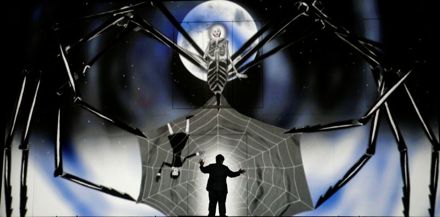
Erika Miklósa as The Queen of the Night, Lawrence Brownlee as Tamino
Photo by Robert Millard courtesy of Los Angeles Opera
Like most, maybe all Kosky productions it is over-the-top, not with the virtuoso weird sexual takes or outrageous nudity that have made Kosky famous, but with the sheer audacity to butcher the holiest of the holy. And to do so with unrelenting visual quotes from the silent film era and unrelenting animation. Never mind that it was charming, at least in intention. Suffice it to say that the Queen of the Night is an animated spider, Papageno is Charlie Chaplin and the magic flute is a dragon fly. Check it out on YouTube.
L.A. Opera has appropriately and brilliantly rekindled the legendary Berlin/Hollywood film connection with this German import. The opening night audience registered its delight with chuckles, ooh’s and ah’s, laughs. Though however charmed the audience may have been it was left bereft of the magnificence of Mozart’s singspiel.
The Kosky version eliminates all dialogue and much orchestral accompanied recitative, substituting mimed action with projected ye olde titles (descriptions or explanations) to the accompaniment of highly melodramatic moments from a few different Mozart fortepiano pieces. The result was disjointed musical flow, the opera no longer about words but instead about images, be they animated film cartoons or silent film quotations with barroom piano sound.
Mozartian magic could perhaps have been discovered in this imagistic storytelling had the singers been a larger component of the storytelling. The stage was simply a huge screen that sat immediately and elevated on the Chandler stage. Most of the singing emanated from cut out openings high upon the screen thus there was little contact possible between conductor James Conlin and his singers. This alone may explain the generally lackluster performances. On the other hand there was an astonishing coordination of the pit with the flow of animation, un-nerving when it was not boring.
The music seldom took hold, in fact there only two scenes where music enveloped the auditorium and these were the famed second act choruses, singers in formal dress standing on the stage level of the imagined movie palace in front of its bright red curtain. No animation, no film quotes. L.A. Opera’s maestro achieved real musical magic in these moments, most often secondary to the symphonic enlightenment that other times may suffuse the second act.
Tenor Lawrence Brownlee in white face gamely went through the paces of integrating himself into the animation, deftly dodging all illusionary obstacles thrown in his path. Mr. Brownlee is not a dynamic performer, even the truly elegant phrasing of his arias did not elevate this Tamino to candidacy for redemption. Soprano Janai Bruggeri, also a deft dodger in white face, was faceless as Pamina, vocally mismatched to the purer colors of this heroine’s voice and presence.
The star of the show was Russian baritone Rodion Pogossov as Charlie Chaplin sans moustache aka Papageno. Mr. Pogossov’s postures were pure Chaplin, vocally he was much more richly endowed than the usual Papageno. He was a warm, abstractly human silent film character (who incongruously sang) aided in no small way by the complete absence of the usual Schikaneder (Flute’s playwright) imposed schtick.
The face and voice of Hungarian soprano Erika Miklósa was the Queen of the Night, de rigueur big house casting (the rest of Mme. Miklósa was hidden behind the movie screen, her on screen character a gigantic spider). The remaining principal roles — the three ladies, Sarastro and Monostatos — were not cast to the stature or for the expanses of the Dorothy Chandler Pavilion.
A brilliant cast and connected pit might propel the images of Mr. Kosky’s concept and 1927’s realization to greater heights. It was an amusing evening, nothing more.
Cast and Production
Lawrence Brownlee (Tamino), Janai Brugger (Pamina), Erika Miklósa (Queen of the Night), Evan Boyer (Sarastro), Rodion Pogossov (Papageno), Hae Ji Chang (First Lady) Cassandra Zoé Velasco (Second Lady), Peabody Southwell (Third Lady), Rodell Rosel (Monostatos), Amanda Woodbury (Papagena), Phillip Addis (Speaker), Vladimir Dmitruk (1st Armored Man), Valentin Anikin (2nd Armored Man), Drew Pickett (First Boy), Charles Connon (Second Boy), Jamal Jaffer (3rd Boy)
Los Angeles Opera Orchestra and Chorus, James Conlon (conductor), Grant Gershon (chorus master)
Barrie Kosky (stage director and concept), Suzanne Andrade (stage director and concept), Paul Barritt (animation and concept), Ester Bialas (scenery and costume design)
Porgy and Bess in San Francisco
It’s been renamed “The Gershwins' Porgy and Bess,” it hails itself as “The Broadway Musical” and further qualifies itself as “The Porgy and Bess for the Twenty-First Century.”
Yet Porgy and Bess has survived through all this! Well, more or less, and even so it again proves itself an operatic masterpiece of the American century.
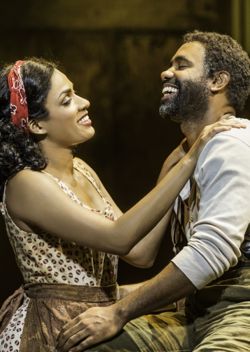
Alicia Hall Moran as Bess, Nathaniel Stampley as Porgy
Photo courtesy of SHN
All the above titles and qualifiers played at New York’s Richard Rogers Theater for nine months in 2012 and began a national tour in San Francisco this November 10 at the Golden Gate Theatre (a barn of an old theater in San Francisco’s, uhm, colorful Tenderloin). It travels on to Los Angeles and to cities in Florida and Ohio.
This Porgy and Bess has new punch indeed. The draconian control over the opera by the Gershwin Estate evidently continues (note the registered trademark logos), here manifest in the Gershwin Estate’s choice of Broadway director Diane Paulus (Hair) to consider perspectives that heretofore have remained buried in its characters and therefore to renew the piece.
The musical adaptation by Diedre L. Murray (Running Man) is always in the Gershwin spirit if not to its letter. For starters Jake sang the second verse of Clara’s “Summertime.” It went from there to music you think you have never heard before. As well the recasting of the story by playwright Suzan-Lori Parks (Topdog/Underdog) may have made some of the old music seem like new music.
Moving from the pit of an opera house to the pit of a vaudeville theater necessitates much reduced orchestration — five woodwinds and six brass (both with an impressive array of instruments to be blown), nine strings, and a keyboard. The percussion battery, somehow manipulated by one player, includes just about anything you can think of to hit or ring.
Additional transformation from opera house to theater is the addition of sound reinforcement. Here Acme Sound Partners (Hair, A Chorus Line) keeps the sound at reasonable levels and the balance of voice to pit at someone’s idea of perfection. Though the wall of sound is quite flat the skilled players in the orchestra wail the great pieces we know so well, and with the percussion battery and digital sound technology create a hurricane that is positively awesome.
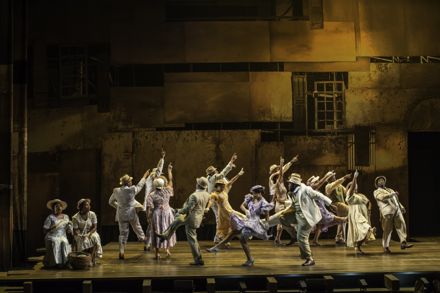
The national company of Porgy and Bess
Photo courtesy of SHN
What makes this production of Porgy and Bess become a fine piece of theatrical art is the minimalism of its staging — only a raked stage platform, an abstract ramshackle back wall, a sky scrim for the picnic, a border to make an interior, a hanging lamp to swing in the storm. There are but twenty-two total inhabitants of Catfish Row, and two policemen. These minimal physical and human resources focused our responses onto the opera’s human tragedies through the joys and sorrows we could clearly perceive on each and every face and body on the stage.
The choreography, by Ronald K. Brown too was minimal, just enough to make it a “show” with a few snappy moves by the bodies that could, and even some surprising, acrobatic moves (the four fishermen being fish) by bodies you were sure could not — there were no skinny chorus boys and girls here.
Unlike the broader and deeper exploration of the human spirit that may occur on the opera stage the Broadway musical heads for always direct emotions. Suzan-Lori Parks has Bess deeply in love with Porgy. Clara hands her baby to Bess who becomes its surrogate mother. A dose of happy dust in a weak moment forces Mariah, the matriarch of Catfish Row to expel Bess, who, devastated, has no where to go but New York. Porgy then seems to be going somewhere too, transfixed by love.
It all works and it is all opera, meaning big stories, big emotions, big music, because of the splendid performances of Alicia Hall Moran as Bess, Nathaniel Stampley as Porgy and Alvin Crawford as Crown. Mlle. Moran plays a weak and strong Bess, warm and fun, above all honest. Bess is complex and of course since it is a musical she is very appealing. Mr. Stampley makes Porgy a simple, warm and open spirit, charismatic and quite handsome. Mr. Crawford is a towering, muscular force, dumb and selfish though he too is good underneath it all. All ably vocally negotiated their numbers, especially Mlle. Moran in an appropriately husky mezzo.
Opera audiences will surely savor the pleasures of this smart production, tightly conceived and very well directed. One can wish for such stagecraft on opera house stages where production values on the level of this Porgy and Bess are very rare, too rare indeed.
For comparison with an opera house production see Porgy and Bess at San Francisco Opera, a review of the 2009 production.
Cast and production information:
Porgy: Nathaniel Stampley; Bess: Alicia Hall Moran; Clara: Sumayya Ali; Jake: David Hughey; Mariah: Danielle Lee Greaves; Sporting Life: Kingsley Leggs; Mingo: Kent Overshown; Serena: Denisha Ballew; Robbins: James Earl Jones II; Crown: Alvin Crawford; Detective: Dan Barnhill; Policeman: Fred Rose; Strawberry Woman: Sarita Rachelle Lilly; Honey Man; Chauncey Packer; Crab Man; Dwelvan David. Conductor: Dale Rieling. American Repertory Theater production. Book adaptation: Suzan-Lori Parks; Musical score adaptation: Diedre L. Murray; Stage Director: Diane Paulus; Choreography: Ronald K. Brown; Set Design: Riccardo Hernandez; Costume Design: ESosa; Lighting Design: Christopher Akerlind. Golden Gate Theater, San Francisco. November 20, 2013.
Il barbiere di Siviglia in San Francisco
San Francisco Opera wraps up its fall season of five operas with what it insists is a new production of Rossini’s comic masterpiece.
It is the staging of Spanish stage director Emilio Sagi (pronounced saw-he) that has many of the ideas he first explored at Madrid’s Teatro Real in a big production that then traveled to Los Angeles, both cities likely harbors for its witty and affectionate quoting of classic hispanic flamenco postures. This San Francisco Barber is a slimmed down, re-elaborated version of the original Sagi conception that will soon be shared with the Lithuanian National Opera.
There was much to like on opening night, notably the polished performances of Count Almaviva and his future countess, characters also known as Lindoro sung by Mexican tenor Janvier Camarena and Rosina sung by American mezzo-soprano Isabel Leonard.
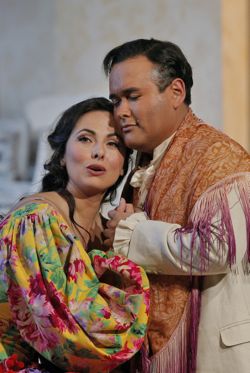
Isabel Leonard as Rosina, Janvier Camarena as Almaviva
Photo by Cory Weaver, courtesy of San Francisco Opera
Mr. Camarena provided the high points of the evening, accompanying himself on the guitar for the serenade with virtuoso plucking technique, acting the music teacher with the skill of a sure comedian. To top it off he gave us the rare “Cessa di più risistere” later known and now better known as “Non piu mesta” from La cenerentola in a dazzling display of fioratura and high notes that brought the house down.
Mlle. Leonard, if not of pure hispanic origin (her mother was Argentine) even so matched Mr. Camarena’s latin excitement and brilliant singing with a presence that exuded refined fun and projected mature vocal and histrionic confidence — a poised Rosina who knew what she wanted and how to get it. Once a student at the Joffrey Ballet School she was well prepared to snap out flamenco poses that easily outclassed those of the official ballerinas.
There were moments of fine, idiomatic conducting. Italian conductor Giuseppe Finzi effectively captured the ephemeral Rossini ethos from time to time (the joy and blatant fun of singing difficult, florid music with aplomb), particularly in his support of the arias of these two singers. As well the maestro often caught the transparent rhythms of the big ensembles where three to six complex and sometimes more vocal lines compete with complete musical ease, conviction and wit.
The set, designed by Spaniard Llorenç Corbella, is quite different from the Madrid production. Here it is essentially a narrow, diagonally raked platform thrusting upstage, with an adjacent abstract black area (no scenery) accessible to various contraptions on wheels and lots of choristers. At best the set worked well, the rake providing a dynamic line on which the principals moved up and down, on and off, the black area serving as a space to stage business that elaborates the various musical numbers.
Besides the witty gloss of the flamenco poses, the Sagi production was embellished with lots of spoke wheel vehicles (bicycle like) that gave a sense of lightness and fleetness to the staging that flouted period (century or decade). The costumes as well were embellished with witty abstractions of Sevillian decorations that had little to do with period and everything to do taking costumes onto an abstract musical level.
Various human bodies and objects crawled out from under the raked platform and props flew down from above from time to time to further negate any sense of real time or real space. Barber’s various numbers were arbitrarily placed on the ramp or in the black space and finally everything more or less disappeared anyway to reveal a night sky filled with fireworks (projected). In short director Sagi and his designer Corbella concocted a heady framework for the music of Rossini’s masterpiece. It would have been truly brilliant had it gotten off the ground.
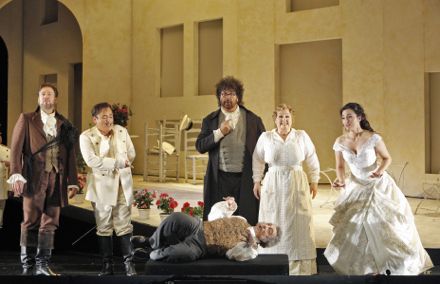
Lucas Meachem as Figaro, Janvier Camarena as Almaviva
Andrea Silvestrelli as Basilio, Alessandro Corbelli as Bartolo
Catherine Cook as Berta, Isabel Leonard as Rosina
Photo by Cory Weaver, courtesy of San Francisco Opera
Unfortunately stage director Sagi was more interested in exploring these interesting theatrical ideas than in staging his singers. This lack of a unified and focused dramatic intelligence resulted in the feeling that Rossini’s headstrong characters were arbitrarily walking through the classic comedic process rather than bringing it to life.
A plodding succession of the events of the story we know so well resulted. This sense was exacerbated in the pit. While conductor Finzi did have his truly splendid moments, and there many of them he could not impose a larger musical unity over an act or the evening, evidenced by the overture that ignited no excitement whatsoever. There was a sense of relief when nine dancers appeared to maybe add some life with a bit of abstracted flamenco movement. Alas the choreography was clumsy and meaningless, later met with feelings of dread whenever the dancing became lengthy.
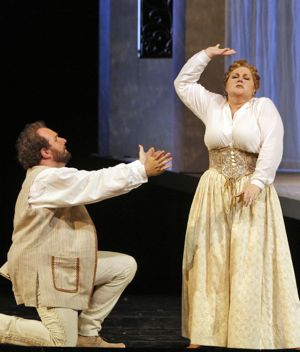
A.J. Glueckert as Ambrogio, Catherine Cook as Berta
Photo by Cory Weaver, courtesy of San Francisco Opera
Catherine Cook was the Berta who was as lightheaded as Rosina was weighty minded. She made her aria another of the evening’s high points with the help of her adoring Ambrogio, Adler Fellow A.J. Glueckert who shined as a silent, physical performance artist given he has hardly anything to sing. Bass baritone Hadleigh Adams brought snap and flair to the brief role of the Officer, not allowing his few moments on stage to go unnoticed.
Andrea Silvestrelli brought the considerable panache he provides Rigoletto’s Sparafucile to the role of Basilio. This major role stood out as miscast, and as a vocal misfit into Rossini’s vocal and musical textures. Much the same can be said of the Figaro of Lucas Meachem who confused bellowing with singing and strutting with acting. Italian bass baritone Alessandro Corbelli is a small scale if accomplished Bartolo who here disappeared into the melée rather than making himself the cause of it all.
Of the many, many Barbiere productions encountered over the years, this one stacks up among the best. Its glaring flaws could have easily been overcome with more careful casting, conducting, lighting and directing.
Cast and production information:
Figaro: Lucas Meachem; Rosina: Isabel Leonard; Count Almaviva: Javier Camarena; Doctor Bartolo: Alessandro Corbelli; Don Basilio: Andrea Silvestrelli; Berta: Catherine Cook; Ambrogio: A.J. Glueckert; Fiorello: Ao Li; An Officer: Hadleigh Adams; Notary: Andrew Truett. San Francisco Opera Chorus and Orchestra. Conductor: Giuseppe Finzi. Stage director: Emilio Sagi; Set Designer: Llorenc Corbella; Costume Designer: Pepa Ojanguren; Lighting Designer: Gary Marder; Choreographer: Nuria Castejón. San Francisco War Memorial Opera House. November 13, 2013.
Der Fliegende Holländer in San Francisco
Train wrecks are fascinating events, huge forces collide, brutal destruction results. Investigators rush to the scene to explain how and why it happened.
That is more or less what happened last night at San Francisco Opera. Though the forces for Der Fliegende Holländer are relatively modest — three principal singers live the drama, three more offer background story; orchestrally there are but double winds, (except triple trombones and five horns). San Francisco Opera beefed up its chorus to a grandiose seventy-eight, after all it is a Wagner anniversary, and there were a few extra strings as well.
But Der Fliegende Holländer is the inauguration of Wagner’s uniquely fertile exploration of redemption through love, and it is emblematic of the tragic idealism that exponentially enriches nineteenth century art. It is conceptually and philosophically big art.
San Francisco Opera partnered with the Opéra Royal de Wallonie (a province of Belgium), that has a sizable presence in French provincial opera for this new production of Dutchman conceived by French/Romanian director Petrika Ionesco. Mr. Ionesco is known to San Francisco audiences for the Théâtre du Châtelet (Paris) staging of Cyrano de Bergerac seen two years ago at the War Memorial — a swashbuckling, cinematic conception that made the most of a slight opera for a broad audience. Mr. Ionesco has staged both Aida and Nabucco at the 80,000 seat Stadt de France and Continents on Parade at EuroDisney.
For those of us who did not see the Vaisseau Fantôme in Liège accounts say it began with Senta alone on stage in a cemetery (Senta does not appear in the libretto until the second act) and ended with Senta freezing to death among the same tombstones — the opera became Senta’s dream (Senta works in a factory that makes clothing and sails for sailors thus in her dream piles of cloth had become tombstones by means of tricky lighting).
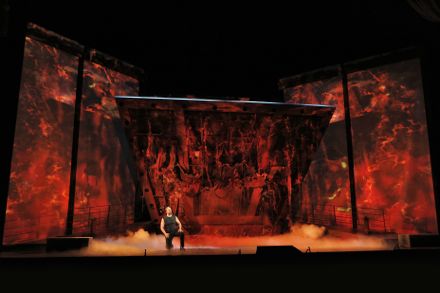
Greer Grimsley as the Dutchman
Photo by Cory Weaver, courtesy of San Francisco Opera
In Liège the Dutchman flew onto Daland’s ship attached to a huge anchor to seek protection from the opening storm. Then there was some sort of science fiction action that accompanied the Dutchman to a fantasy place of skeletons and cloaks where he tells his tale of woe. The production was said to have been tuned to appeal to a broad public, maybe becoming a bit like a Stephen King novel.
Strange to say it was not until the production was actually onstage at War Memorial that the current artistic politic of San Francisco’s opera house determined that the production did not conform. Mr. Ionesco and his ideas were dismissed. A fast attempt was made to re-stage the opera by summarizing the action. Senta still began the opera alone on stage but there were no tombstones, and finally she leapt to her death from the remnant of a raised hatch from the Act I ship (though there was no idea where she landed as by that point we had no idea where we were). But it did not seem to be freezing and there was not a tombstone in sight. All this was hardly Ionesco’s adolescent dream, in fact it was simply a walk through of the libretto.
The Dutchman walked on and off the stage from downstage right or left with absolutely no visual magic or fanfare even though he is a phantom hero. He stood totally alone in front of the red lighted fantasy space to deliver his extended monologue as best he could. The considerable snowfall in Act I and the clumsy every-once-in-a-while projections of icebergs that could have dramaturgically motivated a death by freezing remained unexplained, arbitrary atmospheres.
It would have been heroic salvation had conductor Patrick Summers been able to redeem this fiasco through enthralling music. This was not the case, the maestro sought always a richness of orchestral description and color rather than a realization of music drama. Tempos were generally relaxed rather than charged with meaning, apparent first in the leaden overture, and burdensome particularly in the Dutchman monologue and the big Senta ballad. The maestro’s tempos never discovered the joys of a good wind nor found the terrors of a great storm, both stupendous expressive moments in Wagner’s first masterwork.
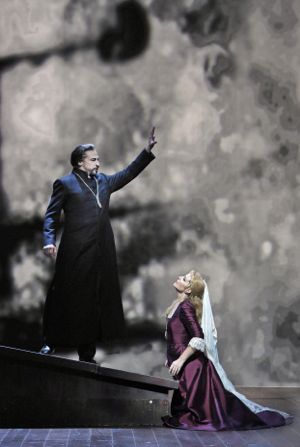
Greer Grimsley as the Dutchman, Lise Lindstrom as Senta
Photo by Cory Weaver, courtesy of San Francisco Opera
Mo. Summers is however particularly attuned to his singers, and some very fine, if meaningless performances resulted, most notably the Dutchman himself, enacted by American bass baritone Greer Grimsley. We can assume that the character Mr. Grimsley portrayed on the stage was created for the Ionesco production. The Dutchman was a suffering, vulnerable human man that Grimsley brilliantly portrayed both physically and vocally. He possesses a quite beautiful voice that he colored in many tonalities to fill his monologues with precise and genuine information and feeling.
Summers offered the same support to the Steersman, beautifully sung, and made real by Adler Fellow, tenor A.J. Glueckert. Welsh tenor Ian Storey created an Eric, Senta’s intended, who came across as more threatening than hurt. With a presence more Tristan than as a Hanseatic lad he sang Wagner’s quite felt music beautifully, perhaps too much so for the Ionesco character. His too frequent use of sotto voce was bothersome. Conductor Summers gave Senta’s father Daland the gruffness inherent to Icelandic bass Kristinn Sigmundsson’s persona and voice, a gruffness that resonated as well in the truly plodding tempos the maestro imposed on the dances that begin the third act.
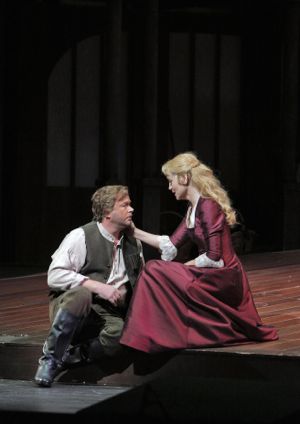
Ian Storey as Eric, Lise Lindstrom as Senta
Photo by Cory Weaver, courtesy of San Francisco Opera
Originally German soprano Petra Maria Schnitzer was cast as Senta. She was replaced by American (San Francisco) soprano Lise Lindstrom who is a fine singer well suited to the Turandot role she frequently sings on the major stages. Hers is not a voice of youthful sweetness or lyricism that might make Senta a mythical nineteenth century angel of death, but it did serve to portray Ionesco’s neurotically obsessed young woman. Intelligence gathered while the elevator descended to subterranean parking levels reveals that some of you thought she stole the show.
Hopefully such events as this Dutchman are once in a century.
Casts and production information:
Dutchman: Greer Grimsley; Senta: Lise Lindstrom; Erik: Ian Storey; Daland: Kristinn Sigmundsson; Steersman: A.J. Glueckert; Mary: Erin Johnson. Chorus and Orchestra of the San Francisco Opera. Conductor: Patrick Summers; Director/Set Designer: Petrika Ionesco; Costume Designer: Lili Kendaka; Lighting Designer: Gary Marder; Projection Designer: S. Katy Tucker. War Memorial Opera House, October 22, 2013.
Falstaff in San Francisco
A rambunctious ensemble on the stage and in the pit. A star conductor. Falstaff showed its stuff as one of the repertory’s greatest masterpieces.
It is an astonishing score embodying a libretto of unequaled brilliance. It proves Verdi the veritable progeny of Rossini, able to infuse comedy with an explosive energy that holds you at the moment you would burst were you not held safe by great art.
Falstaff is the ultimate ensemble piece bringing together ten voices of nearly equal dramatic force, interweaving them so tightly that only brief if very intense instances of lyric expansion linger. Though there are two much larger moments which well endure — Ford at the end of the second act explodes in an extended fit of rabid jealousy of his wife Alice (and its flip side, his obsessive fear of cuckoldry), and Fenton in the moonlight of the final scene cannot contain his raptures of love for Ford’s daughter Nanetta whom he is obsessively courting.
At the center of Falstaff is the gigantic elaboration on the follies of love, and those are the appetites of Sir John Falstaff. His appetite for roasted chickens and stewed rabbits and casks of wine have promoted the impressive girth that simply defines the magnitude of his appetite for women. Nor is he particularly selective about which woman as it turns out.
The action moves so fast that the opera seemed to stage itself. This was the triumph of this San Francisco Opera production, the myriad of dramatic complexities were tightly contained mostly within the hole left when Falstaff erupted through the floor of the abstracted Elizabethan theater that sat on the War Memorial stage. After all, this Verdi Falstaff is an interloper into the Shakespearian histories (four plays) of Sir John’s adventures.

Fenton, Pistola, Ford, Dr. Caius, Bardolfo
Photo by Cory Weaver, courtesy of San Francisco Opera
Austrian stage director Olivier Tambosi was joined by two associate directors, Jose Maria Condemi and Stephanie Smith to make the action move in precise concert with Verdi’s score where no action can be imagined that does not already have musical definition. Certainly this was a daunting task. And there are the constraints of conforming to the needs of the maestro who likes the action downstage center where the singers are under his direct control, not to mention the big (seven to ten voices) ensembles of daunting complexity where the singers need to find their way into a line across the front of the stage in order to musically survive.
The complex set, a fifteen year old production from Lyric Opera of Chicago, staged then (and now) by Tambosi was designed by Frank Philipp Schlössmann, which team is known to San Francisco Opera audiences for its 2010 Makropulis Case. The set offers many hidden openings in its massive wooden walls, Fenton could appear here and there like an annoying housefly. When it became Ford’s house his henchmen could ransack its upper hallways, and finally its back walls disappeared completely to reveal Windsor Forest.
Conductor Nicola Luisotti mercilessly taunted Falstaff with choruses of horns, and mercilessly rubbed in the double entendre in by placing the Herne’s Oak horn call from a box in the opera house (blown by the orchestra’s costumed principal horn). The already high-voltage of the octogenarian composer’s score was poised on the edge of explosion, holding us enraptured by the solo winds making fun of everyone on stage, the piccolo hinting at the pain. This was Luisotti at his absolute finest, making this remarkable score conjure up the genius of Shakespeare himself to join in Verdi’s roast of his delusional knight.
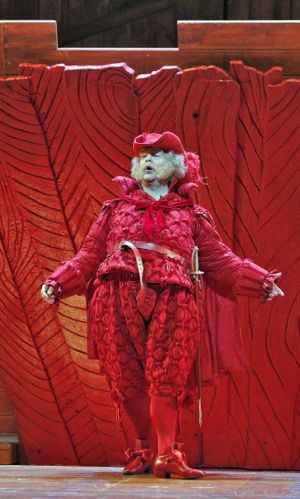
Sir John Falstaff
Photo by Cory Weaver, courtesy of San Francisco Opera
It was an impeccable cast. Welsh baritone Bryn Terfel as Falstaff anchored these dramas of the wily women of Windsor making fun of lovesick men. The Tambosi/Terfel Falstaff is not a lovable version of the man, it is a more blatant, uncomfortable take on the mythical knight than a sympathetic portrayal. Terfel has now had decades of experience with the role and has surely mastered all its possible moves. At 48 years of age he has no lack of power, stamina or subtlety to create the crimson colored monster of this production.
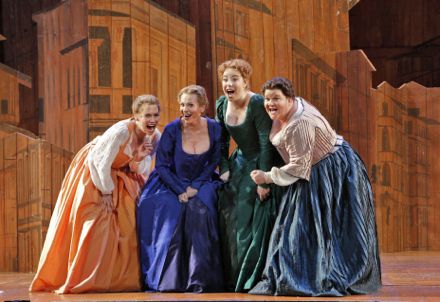
Nanetta, Alice Ford, Meg Page, Mistress Quickly
Photo by Cory Weaver, courtesy of San Francisco Opera
If Terfel’s performance towered about all the rest it was to validate his character as the name of the opera. The balance of the cast worked very much as an ensemble and did not burden us with stars attempting to fit into a complex dramatic mechanism. Italian baritone Fabio Capitanucci made Ford vulnerable, sly and twisted, his instinctual Italianate fear of the horns palpable. Italian tenor Francesco Demuro as Fenton delivered a stunning “Dal labbro il canto estasïato vola,” reveling in the rolled “r”’s of his native language.
Spanish soprano Ainhoa Areta brought charm and plenty of voice to Alice Ford, finding the fun of the character rather than the authority. American coloratura soprano Heidi Stober was a fine looking Nanetta, beautifully paired to her Fenton though she did not have the innocence of voice to create the magic of Windsor Forest (she sings the more complex Mozart and bel canto heroines). Adler Fellow mezzo-soprano Renée Rapier held her own as Meg Page.
If Bryn Terfel met his match anywhere in this cast it was American contralto Meredith Arwady whose force of personality, force of voice, inherent sense of comedy attained veritable Falstaffian proportions. Of near Falstaffian proportions as well were the Dr. Caius of Joel Sorensen, the Bardolfo of Greg Fedderly and the Pistola of Andrea Silvestrelli, more believable Shakespearian rogues could not possibly be found anywhere nor could more accomplished character artists.
Cast and Production:
Falstaff: Bryn Terfel; Alice Ford: Ainhoa Areta; Nannetta: Heidi Stober; Dame Quickly: Meredith Arwady; Fenton: Francesco Demuro; Ford: Fabio Capitanucci; Meg Page: Renée Rapier; Bardolfo: Greg Fedderly; Dr. Caius: Joel Sorensen; Pistola: Andrea Silvestrelli. San Francisco Opera Chorus and Orchestra. Conductor: Nicola Luisotti; Stage Director: Olivier Tambosi; Production Designer: Frank Philipp Schlössmann; Lighting Designer: Christine Binder. War Memorial Opera House, October 8, 2013.
Carrie The Musical in San Francisco
Coincidentally last night was the closing night of San Francisco Opera’s Dolores Claiborne and the opening night of Ray of Light Theatre’s Carrie The Musical.
If you follow popular culture in general and pulp fiction in particular you will know that both of these music theater pieces are based on novels by horror story titan Stephen King. Carrie The Musical (1988) is famous as the most monumental flop of all musicals until maybe Spider Man. The less said about Dolores Claiborne the opera the better.
Ray of Light Theatre is notable for many reasons, one of which is its feisty attitude to programming. If it is controversial, i.e. off-putting it is perfect — in recent years Jerry Springer The Opera (blasphemy), Assassins (inappropriate levity), The Full Monty (male nudity). ROL Theatre makes it all innocent fun that leaves opening night audiences screaming (well, they seem to be mostly friends of the cast).
ROL Theatre is also notable for an enviable production standard. Shows are finished — slickly directed and ably choreographed. Sets and costumes are well designed and executed, suppressing any suspicion of imposed minimalism. Plus ROL Theatre avails itself of the Mission district’s 500 seat Victoria Theatre, a 90-year-old vaudeville theater once named Brown’s Opera House that is not as funky as it used to be but still retains a good vibe for well-produced, off-the-wall shows.
The controversy engendered by Carrie The Musical is how-bad-can-a-musical-be-and-still-be-presented, not to mention the questionable taste of exploiting the adolescent emotions that any hint of adult maturity has left behind. These emotions are not primal instincts, like in Salome for example, but truly base, everyday high-school emotions (though in more significant terms Carrie The Musical speaks to bullying, and to the tragic school massacres).
Already the object of ridicule Carrie has her first period (bleeding) in the high-school locker room shower. Her classmates throw tampons at her. One girl, guilt ridden, becomes sympathetic to Carrie’s plight, and forces her football hero boyfriend to invite Carrie to the senior prom. The Cinderella part of the story ends when another classmate dumps a bucket of water on Carrie. Carrie gets even by magically setting her high school ablaze, her classmates inside.
Meanwhile Carrie’s Christian fundamentalist mother, a complicated piece-of-work, must kill Carrie to protect her from original sin. Then the mother either has a heart attack and dies or is stricken down by unidentified outside forces.
The problem with Carrie The Musical in its current incarnation (it was revised for off-Broadway in 2012, and further revised here) is that its writers have found no effective way to infuse Carrie’s telekinetic skills into the action, rendering unrealistic and unexpected the conflagration finale. We need to believe that Carrie actually had the powers to create it, instead we were overwhelmed with production numbers based on familiar high school situations. We needed numbers about telepathic prowess — truly a missed opportunity when you think about it.
Carrie The Musical wants to be mostly about Carrie’s social life, but feels it must explain the isolation created by her mother, Margaret. Margaret in fact has a degree of emotional and intellectual maturity, however screwy, and she provides a rich, human presence in the midst of general high-school superficiality. She draws the emotional focus of the piece to her complicated emotional histories and instinctual forces, and these become her actions. Margaret has a lot to sing about and Carrie The Musical makes room for her to do so. In comparison a character of such depth and complexity did not materialize in San Francisco Opera’s Dolores Claiborne, its one-dimensional actors motivated by simple, quite explicable reactions to ugly situations. Please see Dolores Claiborne in San Francisco.
Ray of Light Theatre casting was impeccable. These were your high school classmates, your gym teacher, your English teacher. Hopefully this was not your mother. They all sang at the top of their lungs for two hours, their emotions worn on their sleeves. Miraculously their voices held strong to the end, supported by an instrumental ensemble of six players always at full forte — Carrie The Musical is plug-in music indeed.
This small company, with Berkeley’s West Edge Opera, and Carmel’s Hidden Valley Opera Ensemble have made some very interesting operatic art this fall, something often in short supply at our more corporate institutions. Carrie The Musical deserves to be a hot ticket.
Creative, Cast and Production information
Book: Leonard Cohen; Lyrics: Dean Pitchford; Music: Michael Gore. Tommy Ross: Nikita Burshteyn; Norma: Samantha Cardenas; Miss Gardner: Jessica Coker; Frieda: Chloe Condon; George: Dan Hurst; Helen: Olivia Hytha; Chris Hargensen, Riley Krull; Sue Snell: Courtney Merrell; Billy Nolan: Forest Neikirk; Carrie White: Cristina Ann Oeschger; Stokes: Matt Ono; Margaret White: Heather Orth; Freddy: Danny Quezada; Mr. Stephens: Danny Cunningham. Conductor: Ben Prince; Stage Director: Jason Hoover; Choreographer: Amanda Folena; Scene Design: Kelly Tighe; Costume Design: Amanda Angott; Lighting Design: Joe D’Emilio. Victoria Theater, San Francisco. October 5, 2013.
Vanessa in Berkeley and Don Giovanni in Carmel Valley
Opera in San Francisco is what occurs at the War Memorial Opera House. Every so often though you can think outside the box and find some interesting performances nearby, though rarely in San Francisco.
This past weekend West Edge Opera formerly known known as Berkeley Opera took a bold step, moving off the stage of a suburban East Bay high-school onto the 400 seat, Berkeley Repertory Theatre Thrust Stage for two semi-staged performances of Samuel Barber’s Vanessa. Berkeley Rep is a prestigious address, after all its productions sit at the forefront of American regional theater. The spectacular new East Span of the SF-Oakland Bay Bridge somehow adds a panache to Berkeley that the funky, dangerous old Bay Bridge excluded. Expectations were high, promise was and is in the air.
This past weekend as well saw the last of six performances of Mozart’s Don Giovanni in the 250-seat black box theater of Hidden Valley, an institute for the performing arts in Carmel Valley (2 1/2 hours south of San Francisco) that has come back to producing opera now that a degree of prosperity has returned to the Monterey Peninsula. Its Opera Ensemble founded in 1974 offers young singers an opportunity to take initial steps into professional producing circumstances. Overseeing this current Don Giovanni were conductor Stewart Robertson, Music Director Emeritus of Glimmerglass Opera and veteran stage director/designer Robert Darling.
The common artistic ground held by the two productions was opera as theater, not opera as opera.
On Berkeley Rep’s blackened Thrust Stage a 30 piece orchestra sat upstage, two chairs and a table were downstage and the singers performed within a few inches of the three-quarters surround audience. The conductor was visible to the singers only by television monitor. At Hidden Valley it was opera in the round, a 9 piece ensemble (including harpsichord) sat off in a corner, TV monitors offered the conductor’s beat, the stage itself was a small asymmetrical platform in the center of the space surrounded by audience.
Common also were the much, much reduced orchestrations. While the brass and woodwind complement of Vanessa was somewhat intact the strings were limited to twelve players total (there were forty five or so at the opera’s premiere). The Don Giovanni orchestra became a string quintet, plus a flute, oboe, and bassoon (the three woodwinds total were reduced from the fifteen brass and woodwind instruments of Mozart’s score).
Not exactly Wagner’s gesamtkunstwerk, and it really did not matter as the immediacy of voice, the urgency of action, the physical presence of character created a powerful dimension of theater — a dimension that is so often and so easily overwhelmed by opera’s complexities.
The theatrical dimension was very present in Berkeley. Vanessa was about aging soprano Marie Plette and her shallow young tenor lover Anatol, Jonathan Boyd. Innocent if weird young Erika, San Francisco Conservatory graduate soprano Nikola Printz simply wanted real love whatever that is, and dumbly wise bass Phillip Skinner was the Doctor who even knew how vapid he was. Not to forget the grandmotherly Baroness, Malin Fritz who sang very little but looked very stern. Very believable characters indeed, who were also quite real singers and very good artists. Even the staging was their own (there was no stage director), and seemed completely true to character — how could it have been otherwise.
Barber’s Vanessa itself sat very comfortably in the chamber format. The coy libretto by Barber’s life partner Gian Carlo Menotti is like a short story that resolves into a clever play on words much more so than it is a complex human situation that might end in tragedy. The chamber format imposed by the small theater responded to the wit and fun that permeates Barber’s music, and revealed his brilliance as a composer of mid-century complexities — like the splendid quintet that winds up Vanessa. And as a composer of occasional pieces, like the well known arias and duets that embellish the action.
In this reduced orchestral and sceneless format the specific colors and tones of Barber’s quite pictorial music and the atmospheres inherent to Menotti’s little twilight zone story are sacrificed. But the chamber format did ring true as the perfect place to bare the soul of this wonderful artifact of mid-twentieth century American music. The proceedings were held together by West Edge Opera music director Jonathan Khuner.
Hidden Valley has had much practice staging in the round, achieving in this Don Giovanni a degree of perfection. The irregular shape of the small center platform provided places to step, to sit and to hide, and it was turned from time to time by three very, that is very shapely damsels in black vinyl body stockings to indicate a change of scene, or rotated sometimes to make a posed stage picture visible to the entire audience. The entrance/exit aisle bisecting the theater was used for staging, the intersecting aisle axis led to platforms high against the side walls where Elvira appeared on her balcony and later the Commendatore’s statue loomed.
And there was production — minimalist lighting by designer Matthew Antaky sketched a few atmospheres, plus when those sexy stagehands threw a red rope net over the Don and drew him into hell a bit of smoke billowed from under the central platform. All this while the eight players in the pit gave it there all. And it was absolutely enough for the circumstances, probably because we were right in the middle of it.
Sitting in such close proximity to six fine young singers showing their stuff was a very great pleasure. While Don Giovanni himself seems to have the least to sing in the opera he must create a powerful presence to give reason for everyone else to sing a lot. Baritone Gregory Gerbrandt had the voice, charisma and physical stature to set off the vocal fireworks blazingly exhibited by Donna Anna sung by soprano Jennifer Jakob, Donna Elvira sung by soprano Anna Noggle, and particularly Don Ottavio sung by tenor Zachary Engle. Mezzo soprano Nora Graham-Smith as Zerlina has a vocally warm presence that was appreciated in the ensembles, and baritone Ryan Bradford brought touching boyish naiveté to Masetto. Brazilian baritone Igor Vieira had the hint of accent and the bad-boy instinct (he often ignored the beat) to make him a truly believable Leporello. Veteran (i.e. old) bass Art Schuller was a very intimidating Commendatore.
This young cast could not plumb the depths of Don Giovanni, after all the Don himself needs a bit of age to have created the catalog that Leporello thumbed through on his iPad. Stage director Robert Darling therefore took the libretto and music at face value, embellishing the story just enough to provide some staging interest, like for example the Commendatore exchanging pistol shots with Don Giovanni, wounding the Don. It was enough that the staging was a vehicle for young singers to explore their voices and hone their acting skills.
Conductor Stewart Robertson presided from afar, providing a reasonable musical basis on which these young artists could build commanding performances of some of opera’s most known and beloved music. This maestro made the singers shine at the expense of exploiting the orchestral dramas of the Mozart score — after all he had but a flute, oboe and bassoon, plus the string quintet who surely found new meaning for the word exhaustion.
Casts and Production
Vanessa: Marie Plette; Erika: Nikola Printz; Baroness: Malin Fritz; Anatol: Jonathan Boyd; Doctor: Phillip Skinner; Majordomo: Timothy Beck; Footman: Calvin Wall. The West Edge Opera Orchestra. Conductor: Jonathan Khuner. The Thrust Stage of Berkeley Repertory Theater. September 21, 2013.
Don Giovanni: Gregory Gerbrandt; Donna Anna: Jennifer Jakob; Donna Elvira: Anna Noggle; Leporello: Igor Vieira; Don Ottavio: Zachary Engle; Masetto: Ryan Bradford; Zerlina: Nora Grahamm-Smith; Commendatore: Art Schuller. Hidden Valley Opera Ensemble Orchestra and Chorus. Conductor Stewart Robertson. Stage Director: Robert Darling; Lighting Designer: Matthew Antaky; Costumer: Katy Simola. Hidden Valley Theatre. September 22, 2013.
Dolores Claiborne in San Francisco
Dolores Claiborne, the heroine of the book Dolores Claiborne (1992), is a figment of the imagination of prolific pulp horror novelist Stephen King. Just now she has been made into an operatic heroine by composer Tobias Picker with one assumes a lot of undocumented help from J.D. McClatchy, his librettist.
But before the opera the fictional Dolores Claiborne became the heroine of a movie (film does not seem the appropriate term) back in 1995 that a lot of people seem to remember even though a lot more films based on Stephen King novels made a lot more money (seventeen of them made more money to be exact).
If these two pop genres are not part of your general culture and opera is, and you happened into the War Memorial Opera House and caught Dolores Claiborne you might have been as aghast as I was.
This poor domestic servant (Dolores) had just emptied the bedpan and changed the diaper of her mean old employer when the bitter old woman was chased down the stairs by the ghost of her murdered husband. A lot happened before this, for example Dolores’ daughter Selena was raped by her father, Dolores’ husband Joe (a big number about “into the well and don’t tell”). But Selena worked hard and became a lonely Boston lawyer after Dolores got Joe drunk during the 1962 eclipse of the sun and pushed him into a well, then hit him on the head with a big rock when he tried to climb out.
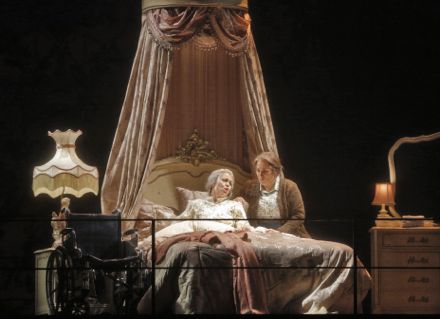
Vera, Dolores
Photo by Cory Weaver, courtesy of San Francisco Opera
With all this, and it is only for starters, there was not much time for psychological immersion. Empathy too was out of the question given that the sordid situations these unfortunate figments of Mr. King’s imagination got themselves into were revolting.
The governing tension of the piece is that men abuse women (there is quite a list of ways in the opera) and that God is a man and not interested in women so women must become mean bitches to take care of themselves (these are the words used in the opera). One might take a moment to compare the tensions explored in Werther or Wozzeck (or for nearly any other opera in the repertory), tensions that engender psychological exploration and emotional elaboration.
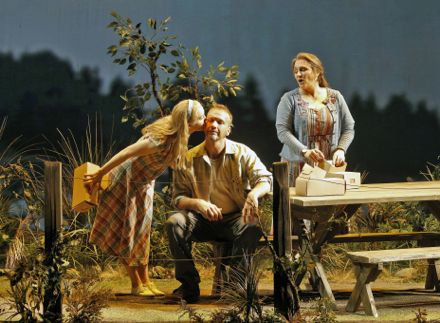
Selena, Joe, Dolores
Photo by Cory Weaver, courtesy of San Francisco Opera
There is no point in imagining the music that might equal the situations of this libretto, except, just for the fun of it, to imagine music that might be created for a solar eclipse. There was not a hint of any such music. Tobias Picker let the words of the story tell the story in plausible, more or less conventional musical lines supported by appropriate, more or less conventional contemporary sounds emerging from the pit.
There was but one moment of reflection that stood out in the evening. Dolores’ daughter Selena was alone on stage in the starry blackness of the solar eclipse and senses that things are not quite right. It was a beautiful moment before it got musically boring, but it did call attention to the absolutely brilliantly designed set, the work of Allen Moyer. Here it was the projection of an all black abstraction of Van Gogh’s “Starry Night,” and it was the opera’s only imaginative moment.
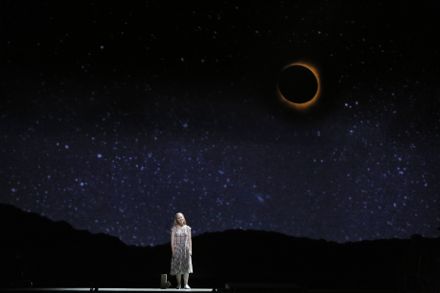
Selena; Set Design by Allen Moyer
Photo by Cory Weaver, courtesy of San Francisco Opera
Moyer’s set was the outline of a rural police office elaborated by cinematic projections (by Greg Emetaz), some realistic, some abstractions of physical spaces, and there were stunning landscapes created across the width of the stage, among them a realistic clapboard house sitting in actual coastal marshes of Maine. With effective lighting by Christopher Akerlind the physical production achieved immense emotional atmospheres that were without response in the music. One assumes that stage director James Robinson had much to do with the realization of this superb physical production.
Mezzo soprano Dolora Zajick had the foresight to abandon the project, the role of Dolores Claiborne assumed and achieved, heroically, by diva Patricia Racette. Unfortunately there are already two sopranos in the score. The old woman Vera, vocally conceived as a high, thin aged voice was taken by Elizabeth Futral (in splendid voice). Dolores’ daughter Selena sung by Susannah Biller was the high coloratura voice of youth. Mme. Zajick would have provided welcomed alternative vocal color. Bass Wayne Tigges sang Dolores’ no-good husband Joe, and tenor Greg Fedderly was the not-too-bright country detective.
It was a high-powered cast who gave it their all. It was a waste of important talent. Conductor George Manahan held it together from the pit.
Cast and Production
Dolores Claiborne: Patricia Racette; Selena St. George: Susannah Biller; Vera Donovan: Elizabeth Futral; Joe St. George: Wayne Tigges; Detective Thibodeau: Greg Fedderly; Mr. Pease: Joel Sorensen; Teenage Girl: Nikki Einfeld; Teenage Boy: Hadleigh Adams; Maid: Jacqueline Piccolino; Maid: Nikki Einfeld; Maid: Marina Harris; Maid: Laura Krumm; Maid: Renée Rapier; Mr. Cox: Robert Watson; Mr. Fox: Hadleigh Adams; Mr. Knox: A.J. Glueckert. Chorus and Orchestra of the San Francisco Opera. Conductor: George Manahan; Stage Director: James Robinson; Set Designer: Allen Moyer; Costume Designer: James Schuette; Lighting Designer: Christopher Akerlind; Projection Designer: Greg Emetaz. San Francisco War Memorial Opera House, September 18, 2013.
Mefistofele in San Francisco
There is the exception. The revival of an old opera production need not always be perceived as an expedient (read cheap) solution to getting a season of opera put together, but may pass instead as an artistically thoughtful choice.
Just now San Francisco Opera has presented Arrigo Boito’s Mefistofele, in a 25 year old production by Canadian stage director Robert Carsen who was 34 years old at its premiere in Geneva in 1988. Carsen’s production, designed by Michael Levine (who was 27 years old back in 1988), is brilliantly witty. Maybe its racy titillations (bared female breasts and exposed male genitalia) were racier back in the ’80’s than they are now but they still brightly illuminate Mefistofele as one of opera’s more bizarre artifacts.
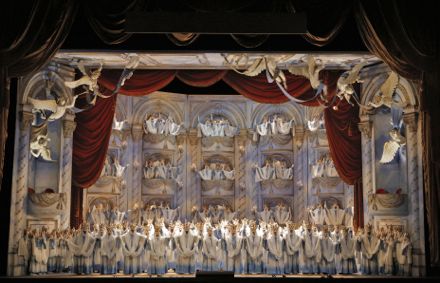
Production design by Michael Levine
Photo by Cory Weaver, courtesy of San Francisco Opera
What the Carsen production did not have at its 1989 premiere in San Francisco was conductor Nicola Luisotti whose exuberant showmanship and spectacular musical making have found, finally, an opera production that is their match. It is no secret that the glories of the Luisotti pit frequently dwarf what is on the stage in San Francisco, or more often ignore the intentions of the stage, meager may they be these days. Here however the Boito, Carsen and Luisotti collaboration was one clearly envisioned in heaven.
The 1860’s were heady times in Paris and Milan, Offenbach was at the peak of his fame making fun of both love and antiquity sparing, strangely, religion. In Milan however there were a few outrageous poets (messy haired ones) who took on anything sacred to the Italians, be it personal appearance, God or Goethe. One of them (these scapigliature) was Arrigo Boito, 26 years old in 1868, who deftly extracted a few passages from the bible of bourgeois Romanticism, i.e. Goethe’s Faust and construed them to cruelly satirize nineteenth century self-fulfillment aspirations.
These were not modest times operatically — Verdi’s Don Carlo comes in 1867. The fully developed 19th century Italian sound was widespread as evidenced by the many composers who contributed to the Messa per Rossini (1869). A man of letters and a man of his times Boito could write music as well as librettos. The operas Mefistofele and Nerone are his musical legacy. Their style is typically Italian of the period, warmed somewhat with oltralpe sonorities (beyond the Alps means Wagnerian, a dirty word in Italy just then). It is good music.
Obviously Boito’s Mefistofele is massive, given it addresses the always important struggles of good and evil. God and the Devil confront one another, Faust is in between, Margherita is pathetic and Helen of Troy is untouchable. Robert Carsen manages all this with enough supernumeraries to turn a village fair into a Chinese New Year of the Snake running amok in the Garden of Eden, a huge chorus of nymphs and satyrs is unleashed into an out-of-control bacchanal, and a pristine ballet revels to the beauty of classical architecture shining in an hyper elaborated harp solo. All of this overseen by a massive chorus of heavenly angels who are joined by legions of cherubim at the moments when the glory of God rises to its utmost clamor.
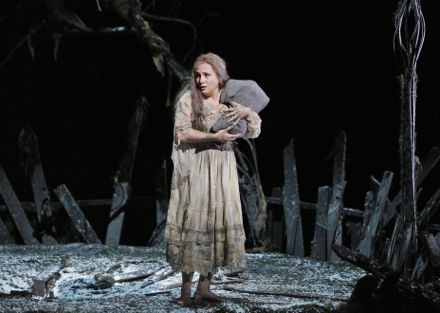
Margherita
Photo by Cory Weaver, courtesy of San Francisco Opera
Needless to say everyone has a very good time, most of all maestro Luisotti who can unleash the forces of heaven themselves in massive choirs of praise as well as confront God with outright derision — those two piccolos screaming over the orchestra were only some of the whistles you heard (the fischio [whistle] is obvious derision in Italy), the rest were real. Even poor Marguerite has a good time even though condemned to death because she has a very beautiful aria to sing. It was an exquisite duet with the maestro, the diva in quite fine voice at the third performance.
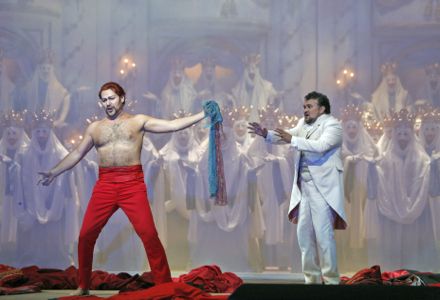
Mefistofele, Faust
Photo by Cory Weaver, courtesy of San Francisco Opera
Carsen’s indulgence of affection for Boito’s youthful escapade was sweetened by the casting of Mexican tenor Ramón Vargas as Faust. His is a voice of great beauty still most at home in the light lyric repertory (he was San Francisco’s Nemorino). At 53 years of age Vargas now takes on heavier roles, like Boito’s Faust as well as Gustavo III in Un ballo in maschera last summer at Orange. Here he sang with consummate style and musicianship, and with the maestro made a quite moving declaration of love to Helen. Nonetheless he remains a miniature tenor for the big repertory and therefore could perfectly embody a pretend Romantic hero caught up in all this fun.
Much the same can be said for the Mefistofele of Russian bass Ildar Abdrazakov. He gave a maximally effective performance, vocally and histrionically. In fact Mr. Abdrazakov was absolutely adorable as a pretend villain whose sole purpose is to give rise to lots of fortissimo music. While it surely was expedient to cast Adler Fellow Marina Harris as Helen of Troy it was not appropriate. However fine a young singer may be it is rare that an Adler Fellow may have the presence, personality and experience to hold the stage in a major role. After all, San Francisco Opera boasts that it performs on the international level. Or does it?
The Robert Carsen/Michael Levine production is huge, and hugely fun. It is a masterpiece that was well worth reviving. If you miss it just now in San Francisco you can catch it at the Met in 2015 (conductor and cast not yet announced).
Cast and Production
Mefistofele: Ildar Abdrazakov; Margherita: Patricia Racette; Faust: Ramón Vargas; Elena: Marina Harris; Marta: Erin Johnson; Pantalis: Renée Rapier; Wagner/Nereo: Chuanyue Wang. Chorus and Orchestra of the San Francisco Opera. Conductor: Nicola Luisotti; Production: Robert Carsen; Stage Director: Laurie Feldman; Choreographer: Alphonse Poulin; Set and Costume Design: Michael Levine; Lighting Design: Gary Marder. San Francisco War Memorial Opera House. September 14, 2013.
Cosi fan tutte in San Francisco
Tucked away somewhere in the San Francisco Opera warehouse was an old John Cox production of Cosi fan tutte. from Monte Carlo. Well, not that old by current standards at San Francisco Opera.
It first appeared at the Prince Rainier Auditorium in 2004, the temporary home of Opéra Monte Carlo while the Casino’s magnificent Salle Garnier was in restoration. Perhaps this explains why its false proscenium is so wide and low, in fact disconcertingly so.
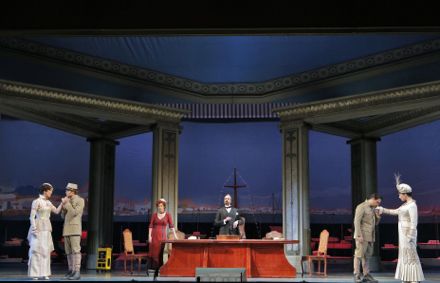
Production design by Robert Perdziola
Photo by Cory Weaver, courtesy of San Francisco Opera
The production is a relic from the Pamela Rosenberg era at San Francisco Opera, when high concept productions were the norm rather than the exception. John Cox is one of the British opera producers cabal so for its time the production had some prestige.
Cosi fan tutte is the bête noire of the trilogy (with Don Giovanni and Le nozze di Figaro), a far fetched little story about the trivialities of puppy love. Of course it gets serious there for a while, and even explores the darker side of love if you want (and know how) to go there.
John Cox and his American designer Robert Perdziola told the story in Monte Carlo where young ladies have lives of ease and young men have money to wager. Croupiers are dashing and dangerous and hotels have maids. The Hotel de Paris is next to the Casino, and the harbor is just below — an intimate and very definable locale, maybe better than Mozart’s Bay of Naples.
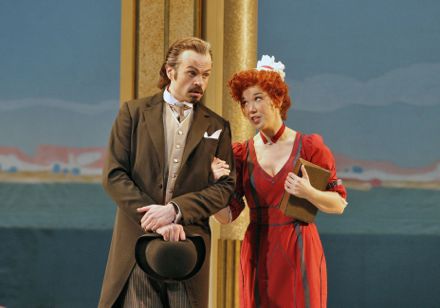
Don Alfonso, Despina
Photo by Cory Weaver, courtesy of San Francisco Opera
Ignoring the fantasy battles of young lovers messieurs Cox and Perdziola imposed a real war, World War I, so that the young men were actually inducted. The Hotel de Paris became a military hospital to the chagrin of remaining guests, and the young ladies become nurses. In the end the young men leave the young ladies standing there as they march back into battle.
Into these colliding worlds of fiction and non-fiction stage director Jose Maria Condemi had the task of moving his actors through the paces of the story, which he thoroughly and carefully accomplished, establishing character and providing schtick. Though sometimes there was simply nothing to do.
It was up to Mozart and the maestro, Nicola Luisotti to make music, after all these young artists had torments to express for which they were more or less capable. San Francisco Opera’s reigning Mozart heroine, Ellie Dehn (the Countess in Le nozze [2010] Donna Anna in Giovanni [2011]) sang Fiordiligi. This heroine has much to sing, some of it quite difficult as it exploits the limits of the soprano range, the lower extreme not really in Mlle. Dehn’s voice. The vocal high point of the performance was Dorabella’s first aria Smanie implacabili, sung by German mezzo soprano Christel Lötzsch where the jagged vocal line found a rare synergy with the maestro who discovered an orchestral roughness to make this aria a true duet of vibrant musical forces.
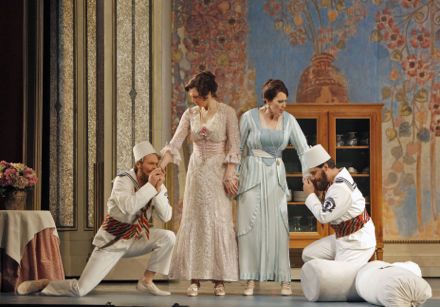
Guglielmo, Dorabella, Fiordiligi, Ferrando
Photo by Cory Weaver, courtesy of San Francisco Opera
While both ladies are accomplished singers they are also shapely singers, all the better to model the fine imitations of art deco couture created by designer Perdziola, one of the more apparent pleasures of the afternoon.
Maestro Luisotti finds drama, or emotive detail that illuminates the Mozart genius in sometimes unexpected and always immensely pleasurable ways. These discoveries were in evidence throughout the performance, though rarely in collaboration with his singers in their arias. There were however moments of exquisite beauty in many of the ensembles, particularly in the early on trio Soave sia il vento (May the wind be gentle) where all motion became sublimated into a frozen moment of time. These few sublime instances still overtook any dramatic tension that might have developed during the afternoon.
The biggest tensions of the performance occurred in the overture. The maestro has raised the pit so that the tips of the bass viols are just at stage level. This gives a brighter and more immediate sound, and there was great fun to be had from watching the maestro tease the woodwinds to achieve their solos at breakneck speeds. And there was severe distress created by the dragging tempos of the trumpets. This bizarre problem persisted well into the performance, placing distrust in the musical forces that we would endure for three and one half hours.
Ferrando was sung by Italian tenor Francesco Demuro. Mr. Demuro is much more Italianate vocally than Mozartian, in fact his credits include no Mozart roles at all. Guglielmo was sung by first year Adler Fellow Philippe Sly, a highly communicative performer in an auspicious main stage debut. Don Alfonso was sung by Italian bass-baritone Marco Vinco who made a case for this usually cynical personage to be a careless gambler, however a bit timid one vocally. Former Adler Fellow Susannah Biller ably went through the paces of a typical Despina.
It was a long, very long afternoon at the opera.
Cast and Production Credits
Fiordiligi: Ellie Dehn; Dorabella: Christel Lötzsch; Despina: Susannah Biller; Ferrando: Francesco Demuro; Guglielmo: Philippe Sly; Don Alfonso: Marco Vinco. San Francisco Opera Chorus and Orchestra. Conductor: Nicola Luisotti. Stage Director: Jose Maria Condemi; Production Designer: Robert Perdziola. War Memorial Opera House, June 9, 2013.
Les Contes d’Hoffmann in San Francisco
Just when you thought the protagonist was Hoffmann! Who, rather what stole the show?
No surprises here, it was the Laurent Pelly production that originated in 2005 on a small stage in Lausaunne before moving to Lyon’s Opéra Nouvel. Just now its seemingly countless animate components have been transformed to a new production of the scope to inhabit Barcelona’s Liceu and San Francisco’s War Memorial. And it is still a living organism with its own intelligence. Maybe it is even smarter than Offenbach.
Not that Offenbach has not gotten a lot smarter over the years, subject to the scrutiny of researchers, scholars, editors, not to mention those who have finished, fixed and improved the mess that Offenbach left behind. Finally stage directors have the task of actually putting it on the stage in some fashion they think is coherent. And the fun continues.
Strange to say this potentially magnificent work has come to the War Memorial stage in but two earlier incarnations, a 1944 version repeated in 1945 and 1949, and a 1987 version directed by Lotfi Mansouri. Christopher Alden directed a 1996 version that was mounted in the Civic Auditorium because the War Memorial was closed for earthquake repairs. This production was based on the artistically correct, read de rigueur Michael Kaye and Jean-Christophe Keck edition as rendered in a 1993 production at Long Beach Opera directed by David Alden.
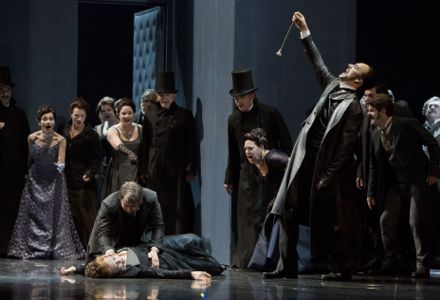
Dapertutto, Hoffmann, Giulietta
Photo by Cory Weaver, courtesy of San Francisco Opera
The Kaye-Keck edition is of course the basis for the 2005 Pelly production, with Lausanne and Lyon’s own particular blend of non-Offenbach recitatives and dialogues. Needless to say seven years later Laurent Pelly has rethought it a bit for Barcelona, and now it is further adapted for San Francisco. You get the idea. We could get lost in detail.
Pelly’s production is magnificent, making E.T.A. Hoffmann’s short horror stories into a dream fantasy where anything real becomes surreal, where anything physical is ephemeral. There is no time because there is no place. Images appear and disappear without a logic, as stream-of-unconscious.
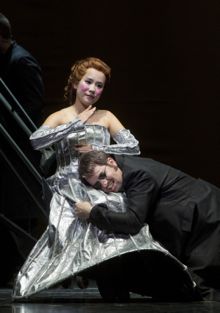
Hoffmann and Olympia
Photo by Cory Weaver, courtesy of San Francisco Opera
Pelly’s conceit is based on the Olympia episode, on Spalanzani’s mechanics where magic dissolves into stagecraft when Olympia is revealed as a manipulation of three stagehands. We then become conscious that the continuous flow of images is effected by the most basic level of stage mechanics — men pushing scenery and men pulling ropes. And we become even more amazed by the intelligence behind the when and how of it all.
It is a diabolical staging in an opera where there is nothing but diabolical manipulation of, uhm, nothing. Something like quantum mechanics maybe.
There is the glue that holds all this together, and that is mere Offenbach, the minor genius who was a major genius, who made trivial musical magic into powerful emotional statements. Conductor Patrick Fournillier realized this Offenbach utilizing the ample voice of the San Francisco Opera Orchestra, exploiting thought rather than sentiment by driving fast tempos, emotion rather than atmosphere by probing depth of tone — assignments this formidable orchestra relished. The pit had a big job indeed. It had to supply the colors, abstract and real, that the essentially dark monotone set left undefined. It succeeded.
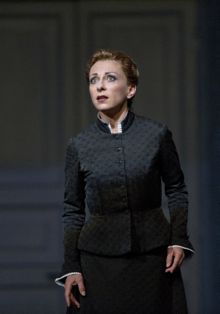
Antonia
Photo by Cory Weaver, courtesy of San Francisco Opera
And there is the lubrication allowing the Pelly mechanics to flow. This of course would be the voices of the actors. American tenor Matthew Polenzani had the daunting task of making us feel the pain of the destruction of illusion. It is a lot of singing, and he made it to the end with apparent ease. Mr. Polenzani is a light lyric tenor, a voice that does not boast the strain that makes a large-scale lyric tenor exciting. Though a beautifully acted performance, and in fact a beautifully sung performance it did not propel us to confusion, disillusion and exhaustion, the fulfillment of Hoffmann’s love.
Matthew Polenzani is a star, not to forget Laurent Pelly, so it is inexplicable why San Francisco Opera felt it needed an additional star to illustrate its aspiration to be a big-time opera company. Soprano Natalie Dessay sang a waif-like Antonia, the only one of the heroines this estimable artist can still negotiate. She did deliver vocally with sure, proven technique. Though if there are to be three sopranos for the opera, one would surely prefer a full lyric for this role. Mme. Dessay did give us the very real pleasures of a diva presence and crystal clear French.
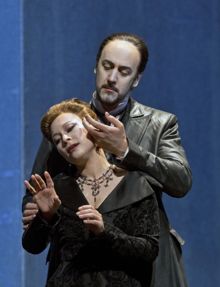
Dapertutto and Giulietta
Photo by Cory Weaver, courtesy of San Francisco Opera
There is great pleasure to be had in hearing young singers with beautiful, well-used voices. Bass Christian Van Horn, last fall’s Angelotti in Tosca, almost held his own in fulfilling the star quality needed for the four villains. Soprano Hye Jung Lee of Florida Grand Opera’s Young Artist program was adequate as Olympia. Giulietta was Irene Roberts who was Fresno Opera’s Carmen. Angela Brower, a member of the Bavarian State Opera ensemble disappointed as Nicklausse, lacking the requisite richness of voice for this trouser role and necessary presence to hold the stage for such an extended period of time.
Casting of the myriad of additional roles ranged from star turns, like the casting of Steven Cole as the four servants, to the pallid Spalanzani of Thomas Glenn and lackluster Crespel of James Creswell. The Adlers did their usual fine service in other roles, especially Hadleigh Adams as Schlemil.
The Pelly production needed more powerful presences all around to liberate our minds and hearts from its brilliant stage mechanics and allow its devilish design to take flight. The San Francisco Opera Orchestra alone could not accomplish this. It could have been done.
Cast and Production
Hoffmann: Matthew Polenzani; The Muse/Nicklausse: Angela Brower; Coppélius, Dapertutto, Dr. Miracle, Lindorf: Christian Van Horn; Antonia: Natalie Dessay; Olympia: Hye Jung Lee; Giulietta: Irene Roberts; Stella: Jacqueline Piccolino; Frantz, Andrès, Cochenille, Pittichinaccio: Steven Cole; Nathanaël: Matthew Grills; Spalanzani: Thomas Glenn; Crespel: James Creswell; Hermann: Joo Won Kang; Luther, Schlemil: Hadleigh Adams. Chorus and Orchestra of San Francisco Opera. Conductor: Patrick Fournillier. Director: Laurent Pelly; Set Design: Chantal Thomas; Costumes: Laurent Pelly; Lighting Design: Joël Adam. War Memorial Opera House, June 5, 2013.
The Brahms Third in San Francisco (Berkeley)
Nicola Luisotti and the San Francisco Opera Orchestra climbed out of the War Memorial pit, braved the wind whipped bay and held spellbound an audience at Cal Performances’ Zellerbach Auditorium at UC Berkeley.
It was an extraordinary evening at the opera, a perfect mise en scène (none) for San Francisco’s tyrannical maestro. The 70 member orchestra sat huddled in a black void and sang in one magnificent voice Brahms’ most lyrical symphony, its colors shining as never before, its moods of turgid Brahmsian contentment translocated into luminescent, metaphysical Latin lyricism.
It was opera, and this was understood by the audience who felt each movement as an extended aria, and unabashedly applauded each movement in unbridled appreciation of great singing. It was symphony as opera, the fifty-year-old composer spinning this famous yarn of contentment, its thematic play subsumed into joy of performance. Bel canto indeed.
The maestro can sometimes, even often be accused of imposing excessive drama, but Brahms offers him very little of it to manipulate. Thus the musical excess — and there was plenty of it — was limited to expected extreme tempo alterations and cantabile melodic exaggerations that illuminated and transfixed more than distorted an Alpine pastoral lyricism. Though it seemed a subdued Luisotti it was still a possessed Luisotti, a powerful conductor with a unique voice.
The Opera orchestra is known to be a very able ensemble, after all it performs the most difficult orchestral scores that exist. The sludgy sound of the War Memorial Opera House prevents perception of the beauty of its sound, sounds that until now we could only imagine. Though Zellerbach Hall is a dowdy acoustical space — the sound at first had a cavernous quality but once accepted it permitted the winds of the orchestra to sing with a beauty of tone reminiscent of the Vienna Philharmonic (yes, really it’s true). What the strings may lack in clarity of tone they make up in boldness, and this alone defines and qualifies this ensemble as a truly dramatic orchestra.
It was an evening of orchestral drama. Not least of which was the Nino Rota 1962 Piano Concerto in C major. Not much of Italian Fascist musical culture is around these days, but its heroic post-Romanticism certainly informed composer Rota’s musical formation and aspiration. Add this to the heady filmic creativity at mid-century Cinecitta and you have the sense of this musical relic. It challenged elegant French pianist Aldo Ciccolini at its premiere in 1987 but was a-piece-of-cake just now for 34 year-old Italian pianist Giuseppe Albanese (no relationship to Licia).
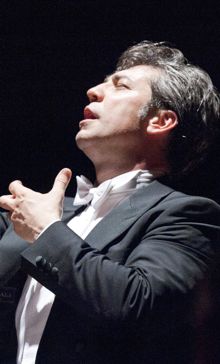 |
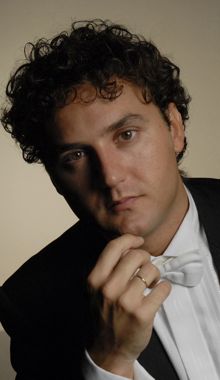 |
Giuseppe Albanese (right)
Dressed in formal wear with scarlet spats young Albanese visually startled, and then attacked the American Steinway with the confidence of a finished post-Boulez virtuoso and a highly intelligent contemporary musician. Like Luisotti pianist Albanese was possessed by the music, the mechanics of the score and its execution played out physically and intellectually in full view, or let us say a vista. It was pure theater of musical performance. Mr. Albanese is also Professor of Philosophy at the University of Messina where he teaches the “methodology of musical communication.”
The Rota concerto was Prokofiev, Rachmaninoff and Tchaikovsky but more so it was the myriad moods that composer Rota mined for films ranging from 8 1/2 to Godfather. These moods were often conversations between the piano and an instrument of the orchestra, raptly and rapturously executed in an atmosphere of absolute artistic collaboration imposed by the maestro.
The audience roared (yes, it was a vocal opera audience), and brought Albanese back for curtain calls. But two were enough for these lovers of voices. Never mind. This determined artist came back unsummoned to perform four encores — to our great pleasure! The highlights were Scriabin’s Left Hand Nocturne played with his downstage arm (the right one) hanging limply, and a version (showers of notes) of Gershwin’s song The Man I Love created by American piano virtuoso Earl Wilde.
Conductor Luisotti opened the program with Puccini’s 1883 Capriccio Sinfonico. From this early work Puccini literally recycled the flashier moments to La boheme (1896) and even Suor Angelica (1918). It served as a perfect, amusing overture to the evening.
Bonjour M. Gauguin in Berkeley (El Cerrito)
Once Berkeley Opera, renamed West Edge Opera, this enterprising company offers the Bay Area’s only serious alternative to corporate opera, to wit Bonjour M. Gauguin.
It was the reprise of an opera by an enterprising young Italian composer, Fabrizio Carlone (b. 1970) who promoted its premiere in Venice in 2005 that included the manufacture of a CD and DVD. No doubt short on cash West Edge Opera is long on creativity, the least of which was discovering this already far-away produced opera, thus saving the considerable costs of a first performance while offering the Bay Area the excitement of operatic discovery.
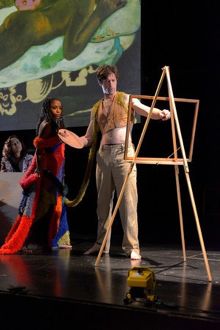
Gauguin and his Inner Voice
Photo by Alessandra Mello courtesy of West Edge Opera
It was a pleasurable evening of something new, not just another Magic Flute, and we discovered more than a new opera — we were reminded of the French painter Paul Gauguin with more information than most of us ever knew.
And once again we witnessed a new generation, that of this young Italian composer, chanting its mantra of revolution and finding a new victim/hero to sing about.
We learned that messieur Gauguin was not a very nice man who died enriched (finally) by his artistic and moral sweat — current sentiment does not seem to concern itself with condemning dishonorable behavior nor honoring penniless death. It was a sequential, exhaustive (about two hours) account of his life in snippets of his own and his contemporary’s words. An unusual libretto that was more a lecture about Gauguin and his art than a dramatic action.
It was in fact absolutely flat dramatically, the French language, by nature little inflected was in perfect accord with Mr. Carlone’s music that percolated underneath achieving quiet, never overly intense musical climaxes. And these emotional climaxes, of which there were a considerable number, were intellectual rather than visceral insuring an evenly illuminated two-hour musical and histrionic landscape.
The actions of geographic change were narrated. Gauguin’s reflections and his contemporaries reactions were recited. This prompted West Edge producers to embellish the lengthy text with abstract dance movement except when specific action was mimed in overt description. The staging was entrusted to Bay Area choreographer Yannis Adoniou who with his dance group Kunst-Stoff, a company of five dancers, energetically executed complex, unceasing movement. The odd number of dancers was evened to six (three male/female couples) when it was joined by Gauguin himself, dancer Anders Froehlich.
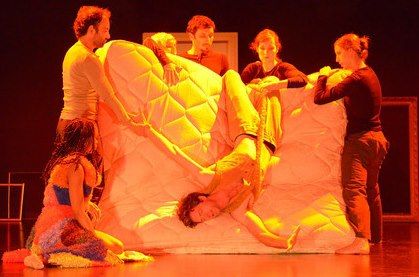
Gauguin (upside down)
Photo by Alessandra Mello courtesy of West Edge Opera
M. Froehlich is also an accomplished singer, a fine light baritone who achieved with apparent ease the refined lyricism required by the composer. If without the roughness and rudeness of the described Gauguin this singer fulfilled to near perfection the intellectual and conceptual elegance of the score and this production.
Composer Carlone’s Gauguin was complemented by an inner voice, the exotically costumed soprano Shawnette Sulker who is endowed with a rich voice that she used securely to fulfill the extensive and challenging coloratura requirements of the role. When joined by Gauguin and the three narrators, Keith Perry, Paul Murray and Nicole Takesono, Mlle. Sulker provided the brilliant upper edge to finely wrought five-voice ensembles that were among the musical highlights of the evening.
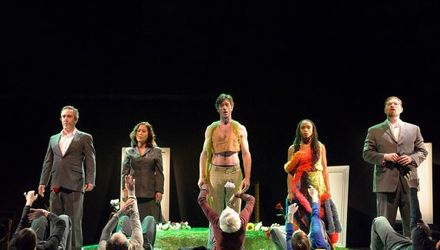
The three Narrators with Gauguin and his Inner Voice
Photo by Alessandra Mello courtesy of West Edge Opera
There were some staging resolutions that defied comprehension, like the bare innerspring mattress that was thrown about the stage nearly the entire evening. Had it related to the bed on which the artist Gauguin laid his naked Tahitian girl in Spirit of the Dead Watching we might have felt some visual structure to the staging of the opera.
The action of Gauguin painting his Tahitian masterpiece Spirit of the Dead Watching occurred near the end of the opera, and was the biggest moment of the opera. It was mimed by Gauguin and described by Gauguin himself, and illustrated by photographic images projected on the large screen that dominated stage right. This splendid scene was of unusual intensity that even brought to mind Berlioz’ Benvenuto Cellini casting his statue of Persius — a David and Goliath comparison, nonetheless germane.
This large screen however was unceasing illuminated throughout the evening by images of paintings that most often were by Gauguin, but oftentimes were by other artists, rarely identified, prompting personal mental scurrying to identify the images and reconcile them to the narration. As well the English translation of the sung French was projected on this screen. Watching this screen and frantic thinking came into direct conflict with participating in the performance. [Surely Gauguin's 1889 painting Bonjour Messieur Gauguin appeared, though I do not recall seeing it.]
Conductor Mary Chun and the San Francisco Sound Group Orchestra were in the pit. Mme. Chun oversaw the realization of composer Carlone’s score with authority, precision and sensitivity. She created a musical warmth that encouraged the exceptional level of lyricism achieved by the singers, all in recognition of composer Carlone’s lyric gifts (he is Italian, so supposedly they come naturally).
The San Francisco Sound Group was comprised of nine players entrusted with illuminating composer Carlone’s pallet of, therefore, nine colors. A limited pallet for two hours of music. Composer Carlone’s pedigree is impeccable, including the Ferienkurs für Neue Musik in Darmstadt and the Académie d’été of Ircam in Paris. Thus much current European compositional technology is present in his basically neo-impressionist style. There was a plethora of textures, shapes and rhythms if not volume.
Cast and Production
Gauguin: Anders Froehlich; Inner Voice: Shawnette Sulker; Clovis Gauguin: Schuler Wijsen; Narrator #1: Keith Perry; Narrator #2: Paul Murray; Narrator #3: Nicole Takesono; Dancers: Yannis Adoniou, Jerremy Bannon-Neche, Lindsey Renee Derry, Katie Gaydos, Kate Jordan. The sfSoundGroup Orchestra. Conductor: Mary Chun, Stage Director/Choreographer: Yannis Adoniou; Lighting Designer: Lucas Benjaminh Krech; Video Designer: Jeremy Knight; Costume Designer: Shannon Maxham. El Cerritos High School Auditorium, April 6, 2013.
Tosca (Postscript) in San Francisco
Extraordinary diva Angela Gheorghiu pulled out of opening night after act one. It was news when she made it to the end of the second performance. Here is what happened at the third performance.
First and foremost Angela Gheorghiu is a diva. She holds the stage by the sheer force of her personality, like perhaps no other contemporary diva. The excitement she brought to the stage with her entrance was indeed palpable, and she played the first act softly, alternating coyness with temperament, interspersing a forceful high note from time to time, even a few entire phrases rang out. There was no doubt that this diva, Tosca, was high maintenance, that she was trouble. A diva who would in actual fact engage a powerful man — Scarpia. Her first act was a masterpiece, worth the price of admission.
Italian baritone Roberto Frontali however plays an insidious rather than a powerful Scarpia. In the first act his underhanded tactics to track Cavaradossi and entrap Tosca expose his truly perverse psyche. He begins the second act publicly proclaiming his consuming sadism. Downstage center, to all of us. No secrets.
But as the second act progressed there was a personality change in both Tosca and Scarpia. Tosca shed her temperament revealing a weak, vulnerable woman who had lived for her art, turning to and walking toward Scarpia, making her aria, softly, a pitiable confession, submitting to her tormentor. Scarpia however had become uncertain of his sadistic tools, his threats were absorbed into the retro scenery. He became palpably impotent. Mme. Gheorghiu, Tosca, the trapped victim, now became sly. Softly and perversely she was the insidious tormenter. You know what happened.
Conductor Nicola Luisotti played along, allowing an unusual orchestra continuum to percolate under this act that seemed nearly parlato (spoken) rather than sung. A highly unusual Tosca, Act II. Disquieting.
The third act is the Cavaradossi act, tenor Massimo Giordano brought out the turgid in Maestro Luisottii — huge, round orchestral tones that went nowhere. Giordano, who did made real tenorial noise upon rare occasion, nailed his high notes strangely, scooping up with a jump of a minor third. He evoked scattered applause for what is usually a show-stopper (e lucevan le stelle). La Gheorghiu, Tosca, entered, muttered her instructions softly, deftly acting non-stop (where was the singing?). You know what happened.
Tosca, la Gheorghiu, fled up the parapet, forgetting to shed her cloak and throw it at her pursuers who pretended she did and fell anyway. Then there was a very strange moment — you felt that Angela really did not want do that nasty jump. But she had to.
If you want a magnificent Tosca go to that of verismo diva Patricia Racette, if you want a gourmet, weird Tosca that of la Gheorghiu may fill the bill.
Tosca (Racette) in San Francisco
Who is Patricia Racette? Sexually ripe Nedda, maternal Cio-Cio-San, neurotic Sister Angelica? But now the jealous Tosca? And without question Mme. Racette has again proven herself the Puccini heroine par excellence of this moment.
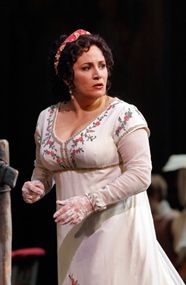
Patricia Racette as Tosca
Photo copyright Cory Weaver, San Francisco Opera
Patricia Racette is a powerful lyric soprano, like all great singers she possesses a unique voice, its signature sound is the interplay of excited overtones. This excitement, these vocal nerve endings possess all of these Puccini victims, and transmit their vulnerability, their super human strength, their beauty, above all a melodramatic feminine humanity that has endured one full century now, and will still be real as long as their may be humankind.
Mme. Racette is a committed and skilled actress, but more so she is an honest artist. Her voice is in its prime, as it has been and will be for some time, to her voice she adds intelligent and straight forward musicianship that ties us securely to her character, thus we are held captive by her very presence even in the numerous pantomimes when Tosca does not sing, but silently observes the murdered Scarpia, and approaches the dead Cavaradossi. It is her rock solid artistry in service to real human drama that seduces us.
If in the first act la Racette does not find the persona of a jealous diva, one we suspect we would find in the more usual spinto voiced Tosca. Racette does persuade us that she is a woman in love, and a woman vulnerable to powerful men, fiery revolutionaries and corrupt functionaries. At the opera’s end, finally trapped by these forces she frees herself in her dramatic leap. And what a leap it was — in spread eagle form, the euphoria of liberation. Patricia Racette is a bona fide diva.
These days in the War Memorial when Nicola Luisotti is on the podium individual performances are tied to the pit, an aria is really a duet, and such was the case last night in a stunning delivery of Vissi d’arte, the maestro in his euphoria of pillaging every possible tremor of feeling from a very willing orchestra, the soprano but a part of his larger whole. Scarpia and his henchmen plotting to ensnare Angelotti, Cavaradossi and Tosca captured with a musical force nearly equal to Verdi’s Otello, culminating in a Te Deum that had much more to do with Luisotti and Puccini and the joy of sheer power than with Scarpia.
The maestro plumbs a depth of sound and searches color in the orchestral voice, and only then pushes forward the flow of musical action. This creates a stop and go rhythm of often extreme tempos, fast or slow. Last night in the second act in particular these fluctuating tempos musically riveted us to the interplay of Tosca and her tormentor, and in the third act bound us to her nervous fear.
Tosca’s tormentor, the Scarpia of bass baritone Mark Delavan, was not driven by the pure, unadulterated lust that usually drives this politically privileged baron. Instead Delavan toyed with his power, the seduction of Tosca was played as a game with himself, as proof of his privilege, not as release of his unbridled libido. Delavan found a humanity in Puccini’s villain that was supremely ugly, more offensive than exercising sexual prowess. Utilizing the inherent beauty of his now mature voice he thoroughly embodied the bloated, entitled political aristocracy. This was Mark Delavan as an estimable artist. We would have expressed our appreciation had he stayed around for the bows at the end of the opera.
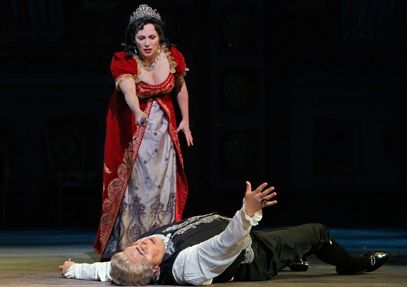
Patricia Racette as Tosca, Mark Delavan as Scarpia
Photo copyright Cory Weaver, San Francisco Opera
Against all this, a quirk of impresario privilege, San Francisco Opera general director David Gockley cast an Adler Fellow as the artist and revolutionary tenor Cavaradossi. Young tenor Brian Jagde held his own to some degree, while definitely out of his league. He possesses a young, vibrant voice and secure high notes. He lacks the squillo that would make his voice Italianate, nor is he yet schooled in the style. There was the occasional catch that sometimes might have been the tenorial sob and other times might have been a momentary catch in an overburdened voice. While Mr. Jagde was abundantly rewarded by the crowd for his performance the fact remains that the War Memorial is not an appropriate stage for a young singer to break in a role.
Supporting roles were superbly cast. Christian Van Horn made a detailed and very present Attavanti who set the stage for a revolutionary tone to Puccini’s opera. Tenor Joel Sorensen etched a sniveling Spoletta, brutalized by Scarpia and Adler Fellow Ao Li was right-on as Sciarrone. Not to overlook the low key, masterful, not too intrusive Sacristan of Dale Travis.
The production was the 1997 remake of the 1923 production, and it is time to send it to the dump — its nostalgia has been lost and it is boring. The staging of this umpteenth revival was however masterfully managed by Jose Maria Condemi. Hopefully Mr. Condemi will write a book to reveal the now secret (maybe best left untold stories) of staging these San Francisco Opera Tosca follies.
Cast and Production
Floria Tosca: Patricia Racette; Mario Cavaradossi: Brian Jagde; Baron Scarpia: Mark Delavan; Angelotti: Christian Van Horn; Spoletta: Joel Sorensen; Sacristan: Dale Travis; Sciarrone: Ao Li; Jailer: Ryan Kuster; Shepherd Boy: Ryan Nelson-Flack. San Francisco Opera Orchestra and Chorus. Conductor: Nicola Luisotti; Stage Director: Jose Maria Condemi; Production Designer: Thierry Bosquet; Lighting Designer: Christopher Maravich. San Francisco War Memorial Opera House. November 16, 2012.
Tosca (Gheorghiu) in San Francisco
Operatic train wreck in San Francisco, hopes crushed for 3000 opera-goers, impresario’s grand scheme derailed.
Now that I’ve got your attention.
There were even advance whispers that something dramatic might happen. Well, no surprise given the cast of characters, character that is — Romanian soprano Angela Gheorghiu.
Huge anticipation was in the air for the American premiere of Mme. Gheorghiu’s Tosca, a role Opera Today’s London critic said she was born to play, the quote trumpeted all over San Francisco. Most of the world knows more about Mme. Gheorghiu marital dramas than it knows about her artistry. But luckily here in San Francisco we do know her charming Rondine and her touching Mimi as well. Adding all this up we were indeed prepped for a dynamite Tosca (after all maestro Luisotti was in the pit).
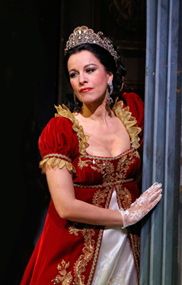
Angela Gheorghiu as Tosca
Photo copyright Cory Weaver, San Francisco Opera
Angela Gheorghiu was born to play Tosca. The Floria Tosca that entered Sant’Andrea della valle exuded layers of histrionic complexity, her voice was soft, her presence lost, a fiery diva in a sanctuary where women are pure. Her duet with Cavaradossi was fraught with interior conflict that exploded from time to time in full voice, detailing movements of emotion that would prepare her spiritually for what we already knew she must do — in full voice — as the evening unfolded.
Nicola Luisotti drove his orchestra full throttle, the voice of operatic verismo, searching for a depth of histrionic orchestral tone, ignoring the forward dramatic thrust of the words themselves. Often an open conflict between the pit and the stage instigated by this maestro results in inspired music making, a duet of conductor and singer that is exponentially richer than voice alone. But famously la Gheorghiu avoids rehearsing, and perhaps this precipitated the musical error (an early entrance) that passed unnoticed by most (or was accepted as diva histrionics), but certainly unsettled this temperamental diva in performance.
Meanwhile stage director Jose Maria Condemi well exposed the machinations of Scarpia that would fulfill his lust for the actress Tosca. Italian baritone Roberto Frontali relished the role, making the predatory Baron less powerful and more insidious than we have usually seen in San Francisco and elsewhere, aided in no small part by the maestro who gave him huge volume and color to work with. Mr. Frontali has a sizable, not beautiful voice and the musical confidence to contend with the Luisotti pit.
Well, this leaves Cavaradossi, Massimo Giordano. Mr. Giordano is a flawed singer who has loud high notes that he only seems to effect if he attacks them from above. This places an accent where usually there would be a smooth line. At first it seemed that this mannerism was used for dramatic effect, but by the end of the evening it was obvious that this was central to his vocal technique. While it was jarring in the first act at least we hoped it might be an amusing tenorial affectation, if used without taste or discretion.
Mo. Luisotti, Mr. Frontali, the San Francisco Opera Orchestra and Chorus erupted in a Te Deum that completely enveloped the War Memorial Opera House. The curtain fell, the audience roared, and the evening ended.
Not that the performance did not in fact continue. Mme. Gheorghiu pulled out, physically distressed (intestinal flu) we were told, though the suspicion lingers that it was vocal distress, and certainly a large dose of emotional distress must be included. We waited while the cover singer, Melody Moore, was costumed. Mlle. Moore is a promising young singer who does not have spinto capabilities demanded by the role. She was painfully ill-suited to follow the diva footsteps made by Mme. Gheorghiu in the first act, nor did she seem coached or rehearsed to do so. It is indeed strange that San Francisco Opera had not anticipated such an occurrence, hardly unexpected from la Gheorghiu.
Thus impresario’s David Gockley coup de théâtre (two Toscas) gone up in smoke.
Cast and Production
Floria Tosca Act I: Angela Gheorghiu; Floria Tosca Acts II and III: Melody Moore; Mario Cavaradossi: Massimo Giordano; Baron Scarpia: Roberto Frontali; Angelotti: Christian Van Horn; Spoletta: Joel Sorensen; Sacristan: Dale Travis; Sciarrone: Ao Li; Jailer: Ryan Kuster; Shepherd Boy: Etienne Julius Valdez. San Francisco Opera Orchestra and Chorus. Conductor: Nicola Luisotti; Stage Director: Jose Maria Condemi; Production Designer: Thierry Bosquet; Lighting Designer: Christopher Maravich. San Francisco War Memorial Opera House. November 15, 2012.
Wozzeck at UC Berkeley
At this famous bastion of intellect the biggest drama was the parking. Though the football stadium may have been stuffed, Zellerbach Hall was not.
An appearance by London’s famed Philharmonia orchestra starring in one of opera’s most riveting theater pieces (an avowed intellectual masterpiece as well) might well have generated sufficient advance excitement to fill the hall. Sad to say, come to pass, not a lot of excitement was created in the hall either.
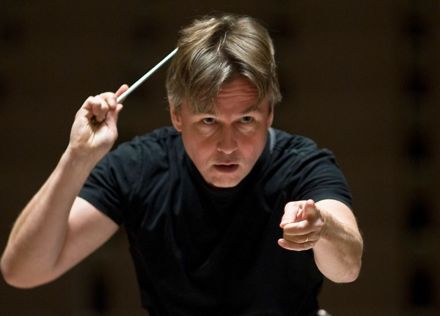 Esa-Pekka Salonen
Esa-Pekka Salonen
The Philharmonia’s claim to fame is its conductorial pedigree more so than its sound — Otto Klemperer, Herbert von Karijan, Ricardo Muti, Giuseppe Sinopoli, Christoph von Dohnányi. And now Finnish conductor Esa-Pekka Salonen, well known locally as one of the L.A. Phil’s wunderkind (Rattle, Salonen and Dudamel).
The no-longer-young maestro did deliver splendidly on what we came for — the three stupendous B’s after Marie is murdered grew to unequalled quivering force, and the masterful, musically riveting Invention in D minor led to the superbly delivered, tonally pure “hop hop” repetitions that end the opera (how did excellent boy soprano Zachary Mamis so securely find those incredibly high pitches?). All these were wonderful, uniquely Salonen moments.
The maestro made a good case for Wozzeck as an orchestral showpiece, marking solid beats to expose the shape and rhythms of the abstract structures that construct acts I and II, reserving his serpentine hand movement to motivate elaborations of color in the too few moments of orchestral solo. As Berg’s score is cerebral Salonen’s delivery too was cerebral, may we say cold, even uninvolved in the opera’s dramatic exposition.
Berg’s score, an opera, is far more than pure music. It is the physical atmospheres in which the Wozzeck tragedy unfolds. Without Berg’s prescribed physical production (sets, lights, costumes) an orchestra acting alone takes on the enormous burden of creating complex atmospheres. This began to occur somewhat in the second act in the public scenes, and took hold in the third act when Berg’s more formal structures gave way to free musical invention. Here Salonen followed suit with a freer dramatic involvement.
The Philharmonia Orchestra is known for the warmth of its strings, an attribute that is not really present in the Wozzeck atonalities. Yet the strings of this orchestra made a startling showing in projecting the nervous attitudes that Berg created and the still youthful maestro elicited. The youth (relative) of the players was evident, dominated by the nearly electric presence of 30-year-old German concert master Zsolt-Tihamér Visontay.
Spreading the Philarmonia Orchestra on the stage rather than, let’s say, cramming Berg’s sizable orchestral requirements into a pit engendered a clarity of instrumental tone, and a transparency of sound that exacerbated Salonen’s coldness. At the same time however it redeemed the coldness into a musical and instrumental purity that made this very fine orchestra great, and made it the star of the show, as intended.
The assembled singers included several distinguished artists. All were quite capable of fulfilling their role, here primarily to fill the musical space Berg’s score demands. With no overview of the opera other than that imposed by the maestro it became however a mere reading of the text. Then there was the unfortunate idea that some staging was needed, when in fact a purely concert performance would have complemented the performance by the orchestra.
The singers apparently attempted to move and emote as they saw fit. This resulted in some strange solutions to entrances and exits, motivations and discoveries. Unfortunately this British bred Wozzeck did not attempt to compete with the semi-staged operas recently attempted by the L.A. and N.Y. Philharmonics, endeavors that sensibly enough involved opera directors. And by the way when are opera companies going to start staging symphonies?
This Wozzeck in Berkeley was the full musical nine-yards. The UC Berkeley Chamber Chorus acquitted itself handsomely (a few missed pitches), the Piedmont East Bay Children’s Choirs marched on and did its duty, and members of the UC Berkeley Symphony well managed the off-stage banda and most of the on-stage banda (the clarinet player was from the Philharmonia).
Cast Wozzeck: Johan Reuter; Marie: Angela Denoke; Drum Major: Hubert Francis; Andres: Joshua Ellicott; Captain: Peter Hoare; Doctor: Tijl Faveyts; First Apprentice Henry Waddington; Second Apprentice: Eddie Wade; Idiot: Harry Nicoll; Margret: Anna Burford; Marie’s Child: Zachary Mamis. UC Berkeley Chamber Chorus. Piedmont East Bay Children’s Choir. Members of the UC Berkeley Symphony Orchestra. The Philharmonia Orchestra. Conductor: Esa-Pekka Salonen. Zellerbach Hall, Berkeley, California. November 10, 2012.
Lohengrin in San Francisco
Exquisite pianissimos, sumptuous climaxes, gigantic fortes, insistent horns, sugary winds, tremulous brass, blasting trumpets, whispering strings, pulsating oboes, more gigantic fortes, even more sumptuous climaxes.
Lohengrin like never before. It was an orgy of orchestral colors, an adventure in sonic discovery, the absolute summit of virtuosic orchestral delivery. Maestro Nicola Luisotti attacked and conquered Lohengrin.
There. That’s done. What’s left now that it’s all over?
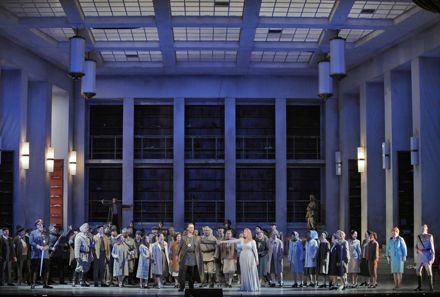 Act I, set design by Robert Innes Hopkins
Act I, set design by Robert Innes Hopkins
Photo copyright Cory Weaver, San Francisco Opera
No longer mythic Germanic lore, this tale seemed to be an episode from, say, Ceausescu’s already mythic Romania, where books were torn from library shelves to burn to make electricity to light the libraries. Though in the emptied library in which all this took magic took place there was not enough juice to illuminate all the grandiose (Romanian socialist moderne) light sources. Well, save in the last scene when Lohengrin finally was going to save the masses. But bowed out.
The masses were magnificent socialists, eighty mighty workers (plus a few sword and standard bearers) who whispered in shimmering sounds and roared in full, transparent tones. But with such idealistic and obviously pleasurable glory in their sonority, and willing unity in their regimentation (yes, this multitude of virtuosic choristers was happily organized in lines and blocks) that they hardly needed to be saved from such perfection — to cede such artistry to mere Western materialism would be tragic indeed.
Meanwhile Icelandic bass Kristinn Sigmundsson in socialist general regalia was instructed to walk downstage center and be the embattled king Heinrich. Mr. Sigmundsson, once an estimable artist, here was perfect as crumbling, ineffective power. Baritone Brian Mulligan, a San Francisco Opera fixture, was Heinrich’s prissy acolyte, a welcomed vocal contrast to his superior. Mr. Mulligan is a richly voiced singer who complemented the maestro’s musical textures while overwhelming the import of this mere herald.
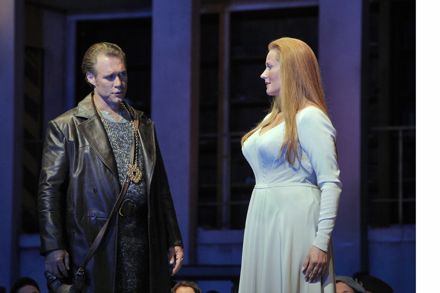 Brandon Jovanovich as Lohengrin, Camilla Nylund as Elsa
Brandon Jovanovich as Lohengrin, Camilla Nylund as Elsa
Photo copyright Cory Weaver, San Francisco Opera
American tenor Brandon Jovanovich was the Lohengrin, a role debut. He apparently has a new voice teacher as the perfectly reasonable tenor we heard a few years ago as Luigi in Il Tabarro has been transformed into a trumpet. While he has not yet mastered the subtlety of tone of a fine trumpeter he does have a surprising variety of volume if not color, though his first and last words in the opera were delivered in a tentative half voice that was cause for concern. Even with its moments of real beauty the sharpness of his tone worked with the costuming of this production to make him look and sound gawky. Though this maybe helped establish the assumed caricatural intent of this conception of Lohengrin.
Of the five principals the Elsa of Finnish soprano Camilla Nylund realized the most successful character. Elsa herself is a lost soul, and Mlle. Nylund though looking like a well-kept Romanian apparatchik had no idea how to be one. The purity of her voice and the innocence of her presence served her well, though in the bigger moments her voice could not ride the the maestro’s mighty crests, as could, for example, the out-of-scale voice of Mr. Jovanovich.
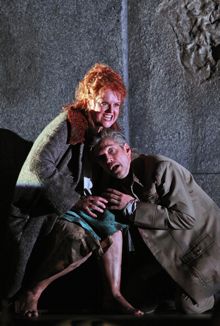
Gerd Grochowski as Telramund, Petr Lang as Ortrud
Photo copyright Cory Weaver, San Francisco Opera
German bass-baritone Gerd Grochowski seemed over parted as Telramund, diminishing the stature of evil in Wagner’s struggle to overcome baser levels of humanity. Mr. Grochowski’s fine baritone and interesting persona are more at home in roles that are more lyric and more complex psychologically. He lacks the inherent vocal color and physical force to personify an uncontrolled thirst for power, willing to say or do anything to get it. Reduced to a whimpering wimp in this production there was little for all those arcane powers of the Holy Grail to overcome.
Joining her homeless husband as Ortrud, the bag lady was German mezzo Petra Lang. Mme. Lang did not seem to be in good voice, her final curse thinly delivered, again underlining the opera’s need to endow evil with enough stature to be worth overcoming. As it was the famous pollution of socialist industry managed to create quite atmospheric lighting for Ortrud’s scenes brainwashing Telramund and deceiving Elsa, convincingly delivered by Mme. Lang.
The production by British director Daniel Slater and British designer Robert Innes Hopkins is from Geneva (2008) and Houston (2009). It apparently has the intention to remove all magic from Wagner’s tale where swans ferry supernatural knights back and forth from an imaginary mountain. The musical moments for these arrivals and departures are truly momentous, even in ordinary circumstances, but here the workers and apparatchiks stare always forward only to discover and not seem to care that the bus terminal was behind them.
The production could not support the musical values imposed by Mo. Luisotti. Magic, and a lot of it was sorely needed to give place and meaning to this mountain of sound.
Moby Dick in San Francisco
Forget Herman Melville, forget struggling with deep human complexities. At least those that possessed nineteenth century Americans.
Think bel canto. Give a singer an impossible situation and see if he can sing his way out of it. Moby Dick in San Francisco was about singing, and well, the singers had those famous ready made situations that frame Melville’s deeper discussion, and they sang and sang. And sang.
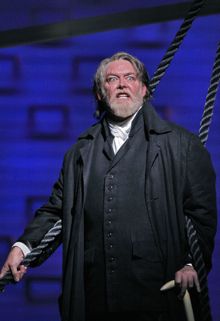 |
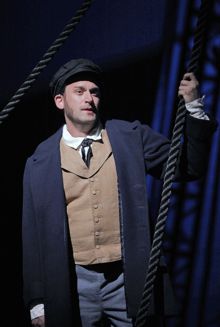 |
Photos copyright Cory Weaver/San Francisco Opera
Composer Jake Heggie has a gift for lyricism that flows and flows. And flows. In San Francisco he had very willing interpreters, most notably tenor Jay Hunter Morris, a late term replacement for heldon tenor Ben Heppner who had sung the doomed and damned Captain Ahab in this premiere production of the opera two years ago in Dallas, and this year already in Calgary and San Diego.
Maybe for a second or so one regretted the absence of Mr. Heppner, surely the epitome of casting for Melville’s emblematic monster. But Mr. Morris, a smaller scale performer with a more lyric voice, and luckily for Mr. Heggie one of great stamina, immediately commanded a character of some interest who had the impossible task of towering above mutiny, slaughter, hurricanes, human kindness and one white whale. He delivered Mr. Heggie’s very singable, if not easily hummable, lines with aplomb and musical grace.
First mate Starbuck, endowed in this made-for-opera version of Melville’s story with the daunting task of equaling Ahab in emotional stature, fared less well. Baritone Morgan Smith successfully made the case for onshore domestic contentment but could not find the needed torment and agony in Mr. Heggie and librettist Gene Sheer’s character — the only antagonist in the story, the only character asked to tackle the obsessive captain. Maybe he did not have enough words to sing or maybe Mr. Heggie’s music simply does not plumb those depths.
Librettist Sheer ends his book with the line “call me Ismael,” famously the first line of Melville’s book, a conceit that invites us to go to novel to sink ourselves into its archaic language and delve into its meanings, an immersion that Moby Dick the opera eschews. And the question then looms as to what Moby Dick the opera may have to do with anything beyond smart entertainment à l’amèricaine.
Smart it is, a libretto that cleverly abstracts the shell of the novel into a series of musical numbers. The staging by Leonard Foglia (who helped shape the opera) is presentational, generous doses of rushing forward to point to happenings exactly where the audience happens to be sitting (a sure way to ensure involvement). Designer Robert Brill made a huge wave like structure on stage that cleverly embodied the sea itself and he made smart use of sophisticated moving projections to graphically illustrate a gigantic moving schooner and its boats. Not to mention the effective fight scenes by choreographer Keturah Stickann and fight director Jonathan Rider.
The Moby Dick saga surely attracted composer Heggie because of its opportunities for programmatic music. These five or so episodes were the most successful parts of the opera. Lacking the complexities of nineteenth century morality afforded by written language the scenes that illustrated the plights of Melville’s famous characters were sometimes dramatically pallid, limited by the consistent richness of smooth sound and rhythmic movement, essential elements Mr. Heggie’s voluptuous style. It is smart, attractive music that in actuality is quite complex harmonically and rhythmically.
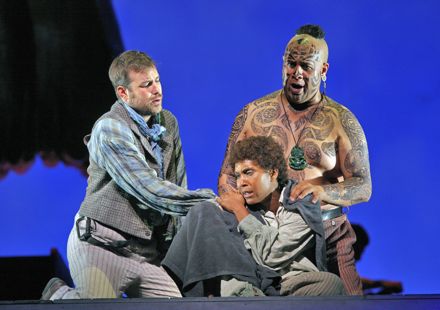 Stephen Costello as Greenhorn, Talise Trevigne as Pip
Stephen Costello as Greenhorn, Talise Trevigne as Pip
Jonathan Lemalu as Queequeg
Photo copyright Cory Weaver, San Francisco Opera
Greenhorn (Ishmael at the opera’s conclusion, though it is his name throughout Melville) who begins and ends the opera is the classic outcast, and in the opera he becomes innocence as well. The role was beautifully sung by tenor Stephen Costello though the role would have been more effectively served by a less Italianate voice (Italian tenors are never innocent), perhaps a purely beautiful voice could have moved us more in his extended scenes with the savage Queequeg, effectively typecast with Samoan bass Jonathan Lemalu.
There is one female voice in the cast, Pip, the black boy, sung by soprano Talise Trevigne. Pip is thrown out of the whaling boat in Moby Dick the opera (he twice jumps out in the novel) and then does the Mary Martin Peter Pan trick of flying, suspended, across the stage while singing and here going crazy too. In the opera Pip is cleverly paired in an extended duet with Stubb the Second Mate, sung by veteran baritone Robert Orth, obsessed with killing whales. Pip is his victim, a sacrifice in the rites of men, at least those portrayed in Moby Dick the opera.
Committed and convincing performances by all the named roles and by the San Francisco Opera Chorus were the hallmark of the production, by now nearly a classic. Conductor Patrick Summers gave Heggie’s score its intended luminous glow ensuring that Moby Dick the opera remain a rich theatrical confection.
I Capuleti e i Montecchi in San Francisco
Give me good verses, I’ll give you good music, said Bellini to his librettist Felice Romani. Give me a good director and I’ll give you good opera surely thought San Francisco Opera general director David Gockley.
Not just good opera but great opera took stage at the last night in San Francisco, adding new found artistic luster to the brutal conflicts of the Capulets and the Montagues. The pretended death of Giulietta was exquisitely suffered both by Bellini’s Romeo and his rival Tebaldo, and ultimately emotional pain of monumental musical intensity and ineffable sweetness melted into the tragic release of the love-death. Legendary mezzo Joyce diDonato hand in hand with soprano Nicole Cabell walked triumphantly into the beyond.
It was real, this beyond. It was in fact the proscenium frame, at once the Romantic love-death itself and, Mme. diDonato and Mlle. Cabell left standing in front of the fallen curtain, it was opera. The enraptured audience leapt to its feet and roared.
Giulietta, tragically denied true love (this is pristine Romanticism), had literally climbed the wall. Standing on a sink, the lone symbol of a physical world, balancing herself eerily on one foot, she reached up towards an unattainable suspended image of entwined lovers and floated vocal lines that soared and fell with suspended emotion in what seemed a musical eternity (uhm, this is high, very high Romanticism).
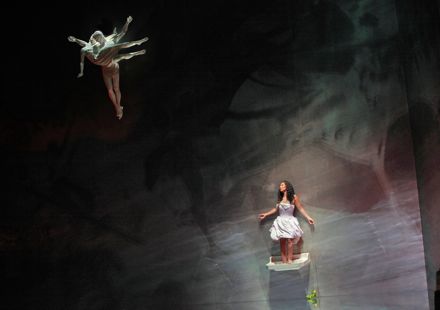 Nicole Cabell as Giulietta
Nicole Cabell as Giulietta
Photo copyright Cory Weaver, San Francisco Opera
These scenes, the tragic ones, occurred in a space with a mirrored floor negating all sense of physical gravity. There was no reference to defined space save one vertical line that created a sort of metaphysical reality, a line that was always the same and never the same, clothed in an infinity of changing color, the ebb and flow of love. The stage, drawn by French designer Vincent Lemaire and lighted by Italian designer Guido Levi, provided an abstract space for love, may we say, with the Romantics, the most abstract world of them all.
In these scenes director French Vincent Broussard used an almost framed painting, though with vaguely defined, mostly abstract images that suspended the search for specific reference. However in the larger scenes with public meaning he completed the proscenium frame across the bottom of the stage making it the fully formed image of a physical painting. It became a real space with a background of infinitely ascending steps on which brilliantly colored and lighted courtiers spread themselves, and later the elaborately clothed, now disheveled women descended, remnants of the unseen defining battle. Mr. Broussard landed squarely on a descriptively minimalist language that could elevate this simple story to Bellini’s metaphysical world of music.
The most astonishing scene was Giulietta’s passage in her underclothes across the sharp and treacherous lower edge of this worldly frame as she sought to resolve her plight, and did so finally with the help of Lorenzo, the family physician (Felice Romani was far more practical that Shakespeare who complicated matters by appointing a priest to this task). Or was it Romeo’s address to the sleeping Giulietta, now no longer laid out on her wedding dress but frozen upright facing Joyce di Donato who was fully possessed vocally and physically by Bellini’s music.
There was no separation between the pit and the stage, the changing stage pictures themselves almost seemed the black printed notes of Bellini’s score made into extraordinarily beautiful sounds by Italian conductor Riccardo Frizza and the San Francisco Opera Orchestra. This maestro achieved the exquisitely delicate and felt Romanticism that makes Bellini the epitome of such difficult, elusive and rare operatic art.
It was a nearly phenomenal achievement in bel canto. Like all great opera it was a collaboration of huge forces. The fine Albanian tenor Saimir Pirgu gained vocal security during the evening to viably take on the incomparable Joyce diDonato in their confrontation. The brilliant Nicole Cabell as Giulietta in her defining long black wig found an unerring vocal balance that did not falter in confronting the extraordinary directorial demands of this role.
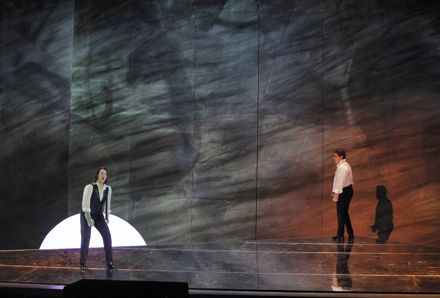 Joyce diDonato as Romeo, Saimir Pirgu as Tebaldo
Joyce diDonato as Romeo, Saimir Pirgu as Tebaldo
Photo copyright Cory Weaver, San Francisco Opera
The high-style costumes designed by famed French couturier Christian Lacroix forcefully etched heightened supernatural character with a sophisticated sense of once-upon-a-time. The actual set became a canvas on which lighting designer Levi detailed mood after mood, choosing momentary detail that rose to the emotional surface in the shadowy supra-rational state of consciousness, never permitting a face or voice to destroy the complex metaphysical tonalities of the production.
It was an enthralling evening at the War Memorial Opera House, the ovations were enormous. And, yes, metteur en scène Vincent Broussard braved exhuberant booing at his curtain call. Go figure.
Rigoletto in San Francisco
Four Rigolettos in nine days (for this critic), of twelve Rigolettos in 24 days (are these world records?).
Major support for this San Francisco operatic extravaganza is provided by, among others, the Great Interpreters of Italian Opera Fund. Hyperbole, or not?
It is a qualified answer. That conductor Nicola Luisotti may join the ranks of, let us say, Toscanini and von Karajan (et al) is yet to be determined. Luisotti is however Italian and this alone endows him with integrity as an interpreter of Italian opera. Based on the September 19 performance the maestro did achieve some greatness.
Rigoletto may be the quintessential Italian opera sitting on the cusp between the glories of bel canto and the agonies of Romantic realism. Formally it is pure bel canto, the individual blocks (“numbers”), arias and duets are interrupted, then capped with a fast, determined “cabaletta.” The trios and quartets are vocally splendid and dramatically static. Finales (when things get done) are brief and to the point.
But add to bel canto the pathos of a cripple’s love for his daughter, the philosophic examination of love and the malevolence of fate. Francesco Piave’s libretto uses Monterone’s curse to close each act and explain why. It is rapid and violent melodrama.
Maestro Luisotti knows that Rigoletto is about beautiful singing, and he gives his singers all needed support based on the supposition that any aria is really a duet — for him and the singer. At its most dramatic were paroxysms of podium involvement in Gilda’s stunning Caro nome, and in the next act Rigoletto and Gilda’s wrenching duet that ends with Rigoletto’s Sì! Vendetta, tremenda vendetta. All this, needless to say, elicited paroxysms of instrumental involvement (the oboe obbligato in Gilda’s Tutte le feste al tempio as example). Tempos, always slower or faster than anticipated, served to generate genuine emotional immediacy obliterating the suspicion of conductorial willfulness. And hardly to be outdone in bel canto by the stage, the maestro imposed an full-voiced orchestral lyricism that took unrelenting flight throughout the evening.
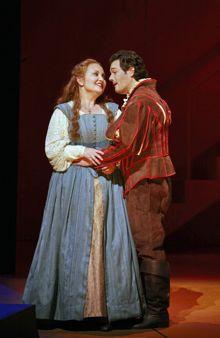 |
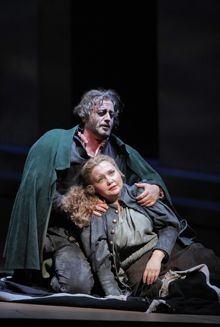 |
Photos copyright Cory Weaver/San Francisco Opera
Houston trained, Russian soprano Albina Shagimuratova without qualification is a great interpreter of Gilda. While she has gained her international fame as Queen of the Night, her vocal endowment well encompasses much of the lyric repertoire. The facility and agility of her voice is enriched by a sizable palette of color and delivery that matches her dramatic concentration. Rarely has a singer so completely embodied the Gilda character. Time stood still in the adolescent musings of the young girl who had just had melismatic sex with the Duke (yes, the second act love duet was mesmerizing).
San Francisco trained, Mexican tenor Arturo Chacón-Cruz was the over-sexed, heart-throb Duke of Mantua. With a voice that resides in color somewhere between the French and Italian repertoire and a technique that betrays his youthfulness, he constructed Verdi’s vocal lines with precision and the hint of spinto that make tenors desirable lovers, ably seducing the splendidly drawn Countess Ceprano of Adler Fellow Laura Krumm as well as the production’s sympathetic, sexually ripe Maddalena, former Adler Fellow Kendall Gladden.
Italian baritone Marco Vratogna too achieves status as a great interpreter of Rigoletto, given that this twisted human is more, and in Mr. Vratogna’s case much more than a big voice who rages at the cortigiani. Mr. Vratogna’s Rigoletto is small in scale but, and maybe therefore, large in insinuation that more than a victim, Rigoletto is indeed an ugly soul in an ugly body. This compromises the blatant pathos that might be awarded a big voiced Rigoletto who will be righteous by sheer volume. Mr. Vratogna uses his medium scaled voice of many colors and much Italianate style to make Rigoletto sinister, unsympathetic, maybe pitiful.
And very interesting.
On the other hand Canadian bass Robert Pomakov as Monterone roared his curses, quivering with rage, well anchoring the conciseness of the drama by sheer volume, abetted by Italian bass Andrea Silvestrelli as the honest murderer Sparafucile, incomparable casting in both cases.
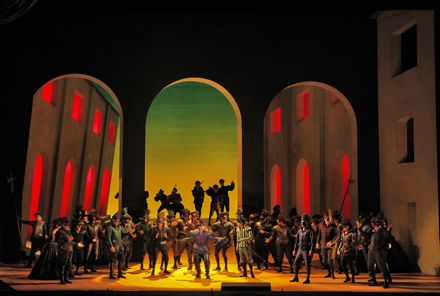 Rigoletto set designed by Michael Yeargan
Rigoletto set designed by Michael Yeargan
Photo copyright Cory Weaver, San Francisco Opera
This San Francisco Opera production, designed by veteran American scenographer, now Yale professor, Michael Yeargan, debuted in 1997. Mr. Yeargan too assumes stature as a great interpreter of Italian opera with a set that echoes the conciseness of the dramatic action of Rigoletto in an abstracted, classically forced-perspective Italian street. Hard edge, repeated porticos are obsessive, sinister and overwhelming. Colors are saturated, basic and bright when not cast as dim, sinister washes on the buildings. The set is minimal, no props (save one chair in the third act). The set functions with almost machine-like precision. Like Verdi’s Rigoletto.
Post Script
Because of the number and proximity of performances San Francisco Opera must provide two sets of principals. On September 11 I saw Serbian baritone Zeljko Lucic as Rigoletto, Polish soprano Aleksandra Kurzak as Gilda and Italian tenor Francesco Demuro as the Duke. Mr. Lucic is a big voiced Rigoletto whose well focused tone did not waver over the course of events resulting in a hunchback of little interest, though Cortigiani, vil razza dannata was hurled with maximum vehemence. Mme. Kurzak is a brilliant singer whose musicianship is abstract rather than dramatic, and while she did make music with maestro Luisotti she made no attempt whatsoever to impersonate Verdi’s vulnerable heroine. Mr. Demuro is an ideal Duke, good looking with a bona fide tenorial swagger. He possesses a light voice that too easily negotiates the Duke’s high tessitura with little of the vocal excitement that makes the Duke musically and dramatically alive.
At this performance the brilliant colors of the set seemed abrasive, the costumes seemed ridiculous and the staging by Harry Silverstein seemed to try too hard to make something out of nothing. In retrospect this reaction was caused by the non-involvement of the principals in their characters.
On September 12 I saw the cast described in the body of this review. At this performance the staging by Mr. Silverstein redeemed itself as a totally competent management of the chorus scenes, if more complicated than Verdi’s direct story telling ideally requires. The principal scenes seemed more detailed than the incipient realism of middle-period Verdi provokes (but, hey, opera these days is supposed to be “acted” — the exception was Mr. Vratogna’s Rigoletto effected with minimum gesture and maximum vocal physicality). In particular the Gilda of Mme. Shagimuratova seemed artful rather than felt in her final scenes.
On September 15 the Lucic/Kurzak/Demuro cast was again on stage at the War Memorial Opera House and on the scoreboard of the local ball park, home of the SF Giants, where 27,000 spectators and I braved the cold for the duration (other years have been far warmer in temperature and far warmer musically). The format requires much focus on faces and acoustical manipulation of voices exposing the limitations of this cast. Mr. Demuro however seemed a natural born TV actor, to the degree that there was the suspicion he might be playing himself.
On September 19, above, it was all pure magic. Go figure. There are four more performances but I’m stopping while I’m ahead.
The Magic Flute in San Francisco
A feast for the eyes, a feast for the ears, a Flute from America’s heartland that goes directly to your heart.
Maybe it’s those three boy sopranos who impeccably deliver the words and tones of Mozart’s three spirits and make the hopes of mankind so real in their innocence.
Maybe it’s the rhyming couplets of David Gockley’s new translation of the lyrics, and the rhythm and flow, and the internal and period rhymes of the dialogues that harmonize like square dance calls. It’s somewhere between cradle, pub and couch and makes you feel really good.
Certainly it’s the kaleidoscope of lines and dots and a thousand colors, maybe more that percolate across the proscenium canvas in always changing, never ending orders that make you feel that the good life will never end, and that, well, even if life may not always be that simple it keeps moving. Finally all those lines and all those dots will become a perfect circle!
This new Magic Flute is indeed a perfect circle, a masterpiece of conception and execution. There is even an illustrated book that engagingly documents the massive scope of a production process that traces the circle from idea to fact and makes artistic creation seem like a piece of cake.
Some of us like to think of San Francisco Opera as synonymous with Covent Garden and Vienna, like sharing productions with, uhm, La Scala (Attila for example) so it comes as a bit of a shock to realize that SFO is sharing productions with Omaha and Kansas City. In fact Japanese born artist Jun Kaneko, the creative force behind the sets and costumes of this production, makes his home in Omaha where he makes ceramics, conceives massive public art projects and designed Madama Butterfly for Opera Omaha.
San Francisco Opera has distinguished precedent for productions based on visual rather than theatrical art, like David Hockney’s Turandot, and even like Marc Chagall’s Magic Flute. And speaking of the Flute, South African artist William Kentridge created one for Brussels' Monnaie about a decade ago that set the benchmark pretty high.
But middle America has its own things to say these days, like Picasso’s French Riviera had its things to say a hundred years ago at the Opéra de Monte Carlo. Maybe it says most about the America that looks westward to Asia for so much of its persona that remains so hidden. Artist Kaneko who emigrated to the U.S. in 1961 creates an endless landscape, like the American midwest, but in Asian lines and colors. He constructs a Chinese puppet dragon and draws costumes that seem made of glazed clay or painted porcelain. In fact we felt quite at home as all of this is so much a part of our national heritage. Come to think of it.
Within this visual realm stage director Harry Silverstein finds constant movements and antics to enliven Gockley’s earthy contemporary banter. Things are left pretty basic, the cosmic conflict between Sarastro and the Queen of the Night has the weight of a domestic spat. It is taken for granted that women need to be put in their place, not to mention that people of color exhibit libidos that are not philosophic and that love conquers all obstacles, like fire and water.
Casting was young and fun. Rather than attempt the more usual and appropriate jugendliche dramatic voices for Tamino and Pamina, San Francisco Opera cast light lyric tenor Alex Shrader and soubrette Heidi Stober. The fine singers brought youth and lightness and consummate charm to Mozart’s young lovers, plus they seemed the very embodiment of corporate promise. Baritone Nathan Gunn was Tamino’s cool sidekick Papageno, everyone’s good friend who isn’t going to make it out of the warehouse.
Russian dramatic coloratura Albina Shagimuratova with her threatening accent (even if slight — she is an alumna of the Houston Opera Studio) was the appropriately toned Queen of the Night. Like nearly always this role gets the biggest ovation because she has the highest notes, and of course the niftiest arias as well. Mlle. Shagimuratova well earned her ovation with extraordinarily clean delivery of her stratospheric notes. Iceland born bass Kristinn Sigmundsson used his Germanic accented English to add more imperative to righteousness though vocally he no longer has the equipment to embody such depth and authority.
Baritone Greg Fedderly made Monostatos absolutely delightfully unthreatening, because as we all now know libido is fun after all. Mr. Fedderly is in good voice. Melody Moore Lauren McNeese and Renée Tatum were First, Second and Third Ladies, lighter voiced than the usual specimens, appropriate to convey the Valley Girl syndrome they knowingly managed.
Not least were the Three Spirits, Etienne Julius Valdez, Joshua Reinier and John Walsh who have to have been the best Three Spirits that ever hit the earth.
Where was the music in all of this, you ask. Well, we were having so much fun that we almost didn’t notice it. But when we did it seemed to support the words with grace and ease and the San Francisco Opera Orchestra did play with lovely sterling tone. British Conductor Rory Macdonald felt tempos that seemed quite slow, but they were tempos that allowed the words to sail across the pit and amuse us. Mozart’s ultimate symphonic thrust, the sublime musical process that propels Tamino and Pamina to an advanced humanity sadly did not happen.
Attila in San Francisco
Fanfares that celebrate soldiers with plumed helmets by a composer who donned a helmet (metaphorically) — Verdi the operatic father of the Risorgimento!
He did have some debts just then and patriotic operas were good box office in Venice so why not an opera about the barbaric general who scared the population off of dry land out into the lagoon that finally became La Serenissima.
Attila is not big at the box office these days as there are too many better operas that attract and please the public and that better illuminate the Verdi genius as well. But it is Verdi, the early Verdi, and it is fiery music with hints of the late, great Verdi who ultimately created the Venetian general Otello. It is the Verdi who pushed singers to and beyond technical limits but not yet the Verdi who had transformed virtuoso voices into the complex dramatic personas that transcend mere technique.
So Attila is about voices, let’s start there. The real Attila the Hun was probably fairly young when he descended from Hungary as far as Rome (there is no recorded birthdate). It was the young American bass Samuel Ramey who took on Attila back in 1981 and made him his own of which there is much discography. The elder Mr. Ramey was just now on the stage of the War Memorial no longer as the Hun but as the bishop Leo who implores Attila to turn back. Mr. Ramey’s voice proves his long career, a still strong tone of now monumental wobble. But Mr. Ramey’s presence was obviously not to sing or be Leo but to be Mr. Ramey.
This formidable Italian bass Ferruccio Furlanetto is however in his prime, traversing Attila’s emotional poles and vocal treacheries with ease, reaching the high notes of its extreme range with force and security, descending to the suave tones that evoke the sexual allure of a powerful man. In better circumstances the tall, fit and heroic Mr. Furlanetto would have motivated dramatic tensions that lie just beneath the surface, and exploited the hints of Otello and Desdemona that lurk there.
International opera becomes ever more international, witness the fortunate discovery of young Venezuelan soprano Lucrezia Garcia. Mlle. Garcia was Odobella whose father had been slain by Attila and who married Attila. Mozart had already played with this situation in more obvious circumstances. However these hidden complexities were ignored in this San Francisco production leaving Mlle. Garcia as nothing more than a singer. The role is vocally formidable as was this singer who adds extraordinary agility to a powerful voice of real sweetness.
Mexican tenors have long since been discovered, so the discovery of tenor Diego Torre from Domingo’s L.A. Opera young artist program comes as no surprise. Mr. Torre brought security and strength to his vocal delivery of Odobella’s suitor Foresto, and his youthfulness added a bit of wanted charm to the opera’s most strident music (not in short supply). Verdi was never too kind to his tenors, usually finding them of questionable integrity, like Foresto, but Mr Torre was offered no opportunity to be more than a good singer.
Add to these two fine young singers Hawaiian baritone, Quinn Kelsey, a wonderful young singer who essayed Ezio, a Roman general who is the foil of Attila, i.e. the salvation of Italy. These days casting at San Francisco Opera seems to surround one big star with up and coming (at best) stars and with house singers, like Mr. Kelsey. This kind of casting often results in miss matching musical and/or histrionic styles, miss matching body types and over parting (a singer not yet or maybe ever able to take on a certain role). Pitted against Mr. Furlanetto My. Kelsey had no chance to deliver this proto-Verdi-baritone role with requisite force of voice or personality. His once famous second act aria of heroic resolution E' gettata la mia sorte fell quite short of generating the excitement needed to unity Italy.
Not much can be known about the death of Attila in 453, though most certainly it was not at the hands of Odabella who in the opera saves his life so that she can kill him. Since this murder is pure fantasy anyway Italian film star and opera director Gabriele Lavia set the murder scene in a movie theater, complete with a screen on which Jack Palance was sacking Rome (the size and movement of the film images compelled our attention more forcefully than the miniscule by comparison singers — “what idiocy” was an overheard comment). But never mind as the second act was set in an opera house for some reason — maybe because Attila is an opera? The first act was the Roman amphitheater in Aquila and it looked just like the Arena di Verona where singers more or less line up across the front of the stage and sing.
Which is where maestro Nicola Luisotti likes his singers and Mr. Lavia seems happy to oblige. The maestro needs total control to impose his egomaniacal musicianship. It is effervescent, and seductive for a while, and this Verdi score obliges this maestro with the opportunity to be legitimately bombastic. The few moments of descriptive music offered by Verdi were overwhelmed by Luisotti’s penchant for effect. Effect for its own sake is a pitfall of this early Verdi opera that in its first years elicited the critical comments that began this review.
Nixon in China in San Francisco
John Adams’ Nixon in China is an amazing, riveting piece of music, and compelling theater to boot.
It was an uncanny fit in the War Memorial opera house, our residual banking and energy tycoons superimposed onto our tech billionaires, the old guard and the young Turks all sitting there in our stodgy old opera house mesmerized by a brash young opera (well, young relative to our 400 year old repertory).
Not to mention Nixon and Mao, Pat and Chiang Ch’ing, Henry and Chou. How many ways could composer Adams find to make two against three, four against three, everything over anything go together and not go together during the three fleet hours it took a virtuoso orchestra to navigate this treacherous score?
Over this but more so within this score lies Alice Goodman’s libretto that juxtaposes mind-boggling and mind-numbing banalities with metaphors of grace and intelligence and flights of lyricism that float in and out of comprehension and are the motor of the mind-bogglingly richness of energy and color, ebb and swell, the sure sonic embodiment of one of the more bizarre moments of human history. And finally what it means. This seems to be found in a few tiny moments of personal reminiscences that are nothing and everything.
Nixon in China is a masterpiece, and if you did not know what theory of binary opposition is at least now you know what it feels like.
Of course there is the back story of the West once again discovering the East, though it dims as time goes on. It is history that will be vaguely known by few of the new generation of opera goers. What really was is no longer of concern to this opera that seems to have joined Simon Boccanegra in the core repertory (36 productions worldwide in its 25 years of existence). Nixon in China is now an operatically consecrated human document, not an historical document.
Like Verdi, Adams knows that politics are loud, and Nixon in China was plenty loud, belying its relatively modest resources — only double or triple winds and a reduced string contingent. But Adams adds a chorus of saxophones to traverse musical prerogatives, plus some rare sharp percussive sounds to throw listener sensibilities off-balance. It was already the digital age back in 1987 so there is a synthesizer, and there is electronic manipulation of all natural instrumental and vocal sound. Get it? — Adams’ amplifies his score!
Adams thereby is able to insert Wagner’s apocalyptic resolution into Madame Mao’s ballet with a richness maybe known only by 110 players in Bayreuth. Luckily next up this spring is Verdi’s Attila with Maestro Luisotti so there should not be too much of a sonic letdown.
Masterminding this cold war götterdämmerung was Dutch conductor Lawrence Renes who imposed a sense of rhythmic precision that immediately gripped and never flagged over the duration, evoking sounds that made the excitement of space exploration in the late twentieth century as alive and provocative as its accompanying politics. It was masterful conducting.
It was a cast of singers rather than singing actors. Some voices were larger than others, but with the help of sensitive sound design all of these fine and beautiful voices melded magically with the sonorities created in the pit to create opera that was pleasing rather than provocative.
San Francisco Opera regular Brian Mulligan effected a fairly reasonable profile as Richard Nixon but captured nothing of the charisma of such a political personality. Tenor Simon O’Neill achieved a Mao of effective proportion though without messianic sense. Both soprano Maria Kanyova and baritone Chen-Ye Yuan are making a sizable careers as Pat Nixon and Chou En-lai having already performed the roles in many productions around the country. Mr. Yuan brings particular sensitivity and solidity to Chou En-lai . Patrick Carfizzi did not find a persona as Henry Kissinger though he provided good fun. Watch soprano Hye Jung Lee sing Madame Mao’s aria on YouTube, www.youtube.com/watch?v=IwHxvRJ_vPMto, to understand why she got the role even though she is way too young.
As in the recent production of The Death of Klinghoffer at the English National Opera the biggest and finest moments of lyric transport occurred not vocally but in dance. The relentless obscurity of the Alice Goodman libretto suspended, Adams unfettered by need to support vocal line, music and movement united to become one in the plight of the poor peasant girl, splendidly danced en point by ballerina Chirharu Shibata to the choreography of Wen Wei Wang, supported by her savior, dancer Bryan Ketron.
The performance was an un-nerving experience, exacerbated by the absence of its primary creator, Peter Sellers. It was after all his idea. It is inexplicable why San Francisco Opera eschewed the genius of this major American director for its premiere of one of the most important operas of the twentieth century.
As it was San Francisco Opera opted for a production from Vancouver Opera that most recently visited Kansas City. It is a fine, good looking production of theatrical savvy by Canadian director Michael Cavanagh. It is straightforward and workmanlike. It did not approach the opposites of the abstract, structuralist theatrical world of Sellers, Goodman and Adams.
Rossini Opera Festival 2012
Ciro in Babilonia, Mathilda di Shaban,
and Il signor Bruschino
A couple of years ago the Rossini Festival staged the very first Rossini opera, Dimitrio e Polibio. It is on a serious subject (a father finds his long lost son and reconciles with an old enemy as well). Rossini was 15 years old. It was five years later that he discovered his comic muse with L’equivoco stravagante, followed the very next year (1812) by four more comedies, plus what the Festival considers his first opera seria, Ciro in Babilonia (forgetting that Dimitrio e Polibio is an opera seria). The rest is history.
The Festival had entrusted the staging of Dimitrio e Polibio to Italian director Davide Livermore who gave us enough lazzi (little visual tricks) to amuse ourselves mightily and make the opera itself as incidental to the evening’s entertainment as it is to the Rossini oeuvre. Ciro in Babilonia ossia La caduta di Baldassare is pretty thin material as well. It was another opportunity for Mr. Livermore!
Though thrust between Rossini and Mr. Livermore (lee-vehr-more-aye, no accent one assumes) was former enfant terrible New York Times music critic Will Crutchfield, now a conductor and coach of bel canto at the Caramoor Center for the Arts (64 kms north of New York City). Conductor Crutchfield is a strange mixture of erudition, musicality, and limited musical charisma who seems possessed by the operatic ideal of collaboration.
Meanwhile there was some singing too, most notably by 62 year-old Polish contralto Ewa Podles as lovesick Ciro. At this point in her career Mme. Podles is most often reverentially cast as a celebrated singer in a character role (the evil aunt in San Francisco’s Suor Angelica as example). The surprise is that Mme. Podles can still do a coloratura trouser role with plenty of voice and dazzling aplomb. Rossini’s Ciro is however a decidedly pale character to host such force of voice and personality.
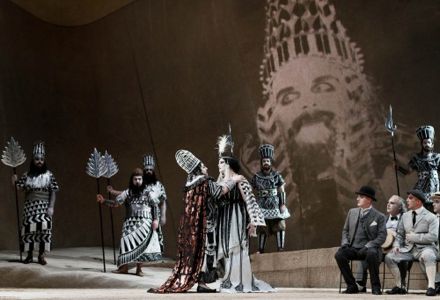 Ewa Podles as Ciro, Jessica Pratt as Matilda, Michael Spires as Baldassare (video image)
Ewa Podles as Ciro, Jessica Pratt as Matilda, Michael Spires as Baldassare (video image)
Photos courtesy Rossini Opera Festival
Mme. Podles did indeed make this unlucky Persian king (he lost a battle plus his wife to Belshazzar) into a character well beyond the possible imaginings of Rossini. This only succeeded in rendering Australian soprano Jessica Pratt less convincing as the Rossini heroine Amira, his Rossini imagined femme fatale wife. Mlle. Pratt possibly could have approached the vocal ideal of such a creature as she is a fine Rossini singer, popping off interpolated stratospheric notes in shimmering coloratura.
Baldassare, the lovesick ruler of Babilonia (yes, like Handel’s Xerxes) loses in the end. Ciro wins a battle and gets his wife back and everyone lives happily ever after, though of course all this is pure fantasy. Baldassare too, Missouri born tenor Michael Spires, was no match for Ciro. He cut a good figure, his very long lament Qual crudel, qual trista sorte made a case for the greatness of the Rossini-to-come, and earned him a real ovation (real ovations are long and loud in Pesaro).
Mr. Livermore took on Rossini’s opera seria and cleverly did away with it knowing that we would find its superimposition onto a silent film epic imitation more amusing. Surely we did (though an opera seria every once in a while does hit the spot). That its transformation was thorough is beyond question, including the suppression of supertitles so we could not know really what was being said or thought (these singers did not project the Italian text as did, for example, the singers in Mathilda di Shabran to a remarkable degree). So it was opera without words, though we all know opera has words, and some of us, probably many of us ached for real opera.
Mr. Livermore made constant reference to the silent film era with video techniques effected by Torino’s D-Wok (an enterprise that offers “multi-sensory creativity recipes”). These effects were brilliantly and sensitively used to goose up Rossini’s incipient greatness, like the moving background film images slipping into judder for the serious moments in the Ciro/Amira recognition duet, plus the scratches on the film (thin streaks of light) increasing in intensity and frequency as Rossini’s music intensified at the opera’s conclusion. Not to ignore the close-up shots of melodramatic faces in sepia tinted frames, and (whew!) the absolutely stunning early film-art epic costumes designed by Gianluca Falaschi.
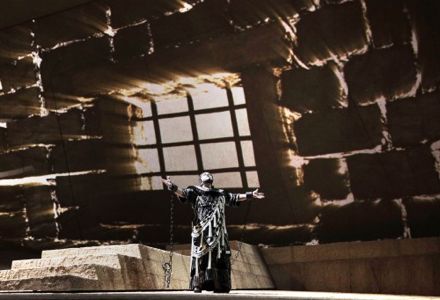 Ewa Podles as Ciro
Ewa Podles as Ciro
Photos courtesy Rossini Opera Festival
Mr. Livermore was a singer before he became one of Italy’s most gifted and interesting stage directors. Well aware of the needs of singers he and his designer Nicolas Bovey provided a moving platform stage layout that propelled the singers to positions of direct communication with the conductor (and therefore the audience) for the big arias. In fact Mo. Crutchflield seemed more interested in his singers than in the fine orchestra of the Teatro Comunale di Bologna even though a splendid violin solo rang out in forceful melodramatic pathos with Mlle. Pratt’s Deh, per me non v’affliggete (don’t beat yourself up on my account).
Davide Livermore’s production was smart indeed, too smart for what Rossini had to say.
Well, enough with opera seria, let’s get back to comedy. The very next year, a big one, Rossini first dashed of a one-act farce, Il signor Bruschino before composing his first great tragedy, Tancredi, and his first great comedy, L’italiana in Algeri. The Festival entrusted the staging of this incidental farce to Teatro Sotterraneo, a Florentine group comprised of dancers, actors, performance artists, singers, etc., who collectively create and perform theater.
At first the suspicion was that this was in fact the case, that the stage manager, his assistant, the dresser, etc., who rushed about the stage doing schtick before, during and after the overture were Teatro Sotterraneo, that a couple of old guys (Bruschino and Gaudenzio as we later learned) putting on strange costumes and sort of coxcomb like plastic wigs were Teatro Sotterraneo, and that Florville and Sofia who sang about their problems were Teatro Sotterraneo actors and not really Rossini singers.
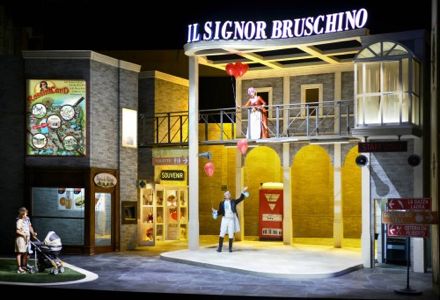 Photos courtesy Rossini Opera Festival
Photos courtesy Rossini Opera Festival
The sets and costumes, the issue of the Accademia di Belle Arti di Urbino which was part of this opera-by-committee committee, were a crossroads somewhere (like Latin comedy), maybe Pesaro, or in the unlikely case that you (and the far more likely case that these talented kids) had been to a Disneyland in Anaheim, Tokyo, Orlando or Paris in the recent past, maybe a theme park somewhere. Probably it was just the Lungomare in Pesaro — in fact there was even a sign announcing that we were in Rossiniland with arrows pointing to La Gazza Ladra and other such attractions.
What would Disneyland/Rossiniland be without you and me to wonder and marvel at what we found there? So what looked like the youth cult that surely must be Teatro Sotterraneo, plus a few more seasoned tourists like us, timidly interfaced with Bruschino, Florville and Filiberto there in Rossiniland (the Cinderella, Daffy and Donald Ducks, etc., of Disneyland). That is when we were not distracted by a sudden parade chasing after William Tell (yes, Rossini’s late, great opera was quoted).
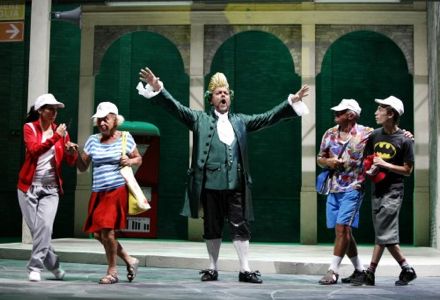 Photos courtesy Rossini Opera Festival
Photos courtesy Rossini Opera Festival
So it was a farce within a farce, one dumbly brilliant farce, make that brilliantly dumb farce within another. A stroke of genius. Anything went to sabotage the integrity of one of Rossini’s lesser efforts, efforts that in fact gave it the vibrantly casual artistic life it deserves.
With due respect to the singers, they were appropriately neither Teatro Sotterraneo nor were they the cast you would dream of for a Pesaro Italiana or Tancredi. They were wonderful singing actors who brought Rossini’s farce alive in high art that was well beyond mere opera. Roberto de Candia and Carlo Lepore supplied experience and savoir faire as Bruschino and Gaudenzio, Andrea Vicenzo Bonsignore as the innkeeper Filiberto, David Alegret as Florville the young lover, and Maria Aleida with her amazingly high notes as Sofia the ingenue supplied the promise. Young Italian conductor Daniele Rustioni was a lively participant in the proceedings as were members of the Orchestra Sinfonica G. Rossini.
Much magnificence was added to the Rossini oeuvre over the next ten years, like all of the more recognizable Rossini titles (the operas in French were still to come), including Matilde di Shabran ossia Bellezza e cuor di ferro in 1821, a very strange piece. Like Handel’s Xerxes it is either a tragedy or a comedy, and in the best of all possible worlds it is both.
It was a revival of a 2004 production erected in the limited stage housing of the 600 or so seat Teatro Rossini that made its way to Covent Garden in 2008 where the two concentric floor to rafters circular staircases, the sum total of its scenery, were presumably resized to a considerably larger dimension. Back now in Pesaro at the Adriatic Arena in this or another enlarged version of the original it did not come close to making the startling scenic impressions that have marked Adriatic Arena productions in recent years (like Mose in Egitto, Zelmira, and Ermione).
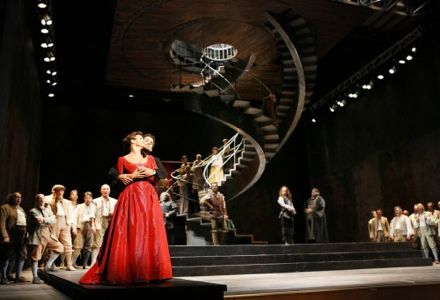 Photos courtesy Rossini Opera Festival
Photos courtesy Rossini Opera Festival
However it did have Juan Diego Flórez and that seemed enough to bring the audience to an a priori delirium. The twenty-three year-old Juan Diego made his Pesaro debut in the role of Corradino the Iron Hearted back in 1996, in a resurrection of Matilde di Shabran after 175 years of oblivion. Needless to say it was Mr. Flórez who sang it in London at age 35, and may it suffice to say that the role still belongs to him alone at age 39. Possibly this is because he may be the only one who can sing it. Or maybe wants to.
Corradino the Iron Hearted has a lot to sing about. The peace and quiet (save for an occasional battle) of his chateau has been disturbed by the arrival of two women who are chasing him. He hates women. So there are a lot of high “C”’s and more than a few elaborate rages. Corradino is head-strong and not too smart (well, he is a tenor). Though of course Juan Diego is nothing if not smart, and very famous for his high “C”‘s. This combination of character and singer is exploited to perfection by Mr. Flórez in minimal moves and maximal voice and musicianship.
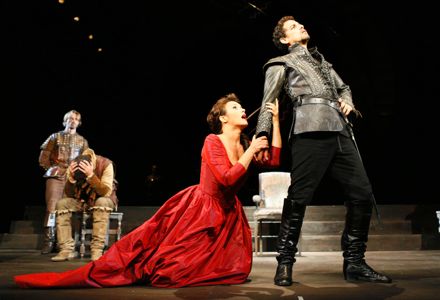 Photos courtesy Rossini Opera Festival
Photos courtesy Rossini Opera Festival
Olga Peretyatko as Matilda, Juan Diego Flòrez as Corradino
This is mature Rossini who masterfully constructs huge ensembles, a quintet in the first act bringing iron hearted Juan Diego together with German formed Russian soprano Olga Peretyatko as Matilda, the pushy ingenue who lets nothing get in her way (like Rosina) and Italian mezzo Chiara Chialli as the pushy Contessa who, after four hours [!] of conniving, was the sore loser. Young Italian buffo Nicola Alaimo as the wise doctor Aliprando and Italian baritone Paolo Bordogna as the opportunistic Neopolitan poet Isidoro (gifted Pesaro regulars) finished the five who lined up across the stage and let it rip.
The staging of the opera was limited to the principals running up and down the spiral staircases when not forming a line to sing together. The quintet was joined in the extended first act finale by the two additional principals, young Russian mezzo Anna Goryachova as Edoardo, captured son of the Iron Hearted’s arch enemy, and excellent Spanish bass Simon Orfila as Ginardo, the castle gatekeeper.
Holding all of this together with the orchestra of the Teatro Comunale di Bologna was young Italian conductor Michele Mariotti, a graduate of the Conservatorio Rossini di Pesaro who has gone to the top fast. Mo. Mariotti brought unusual elegance to the opera’s overture, and coaxed continued suavity and a far more than usual or expected orchestral participation in the complex musical proceedings without foregoing his responsibilities to the stage.
Without the participation of a real production conception (Italian film director Mario Martone’s production was more or less costume opera, at least as seen from row 14), the performance missed achieving the magical Rossini operatic delirium that has been the hallmark of recent Adriatic Arena productions. Not that this lack was lamented by the audience who responded to Rossini’s magnificent ensembles with huge, really huge, foot stomping ovations.
Olga Peretyatko, Matilda, had the last word in an extended solo scene at the end of the opera in which she unleashed torrents of brilliant coloratura bragging about her conquest of Juan Diego, the real Rossini diva she has become over the past several years in Pesaro.
Les Noces de Figaro in Aix
You pay your money, you takes your chances — that is festival life at its best. Sometimes it pays off and sometimes it doesn’t. The fun is in the risk, so the riskier the better.
Yes, it was risky indeed for the Festival’s umpteenth production of Les Noces de Figaro by the Festival’s signature composer, W.A. Mozart (that’s Mose-art in French by the way). Richard Brunel, director of the Comédie de Valence (a small city south of Lyon), re-conceived Beaumarchais’ testy little comedy to take place in a contemporary notaire’s office, or maybe it was an avocat’s office or some sort of corporate office where Barbarina was the receptionist (it was confusing), with grand doors embedded into the stage left wall leading into, we later learned, a large room with two sewing machines.
It seems that there was to be an office wedding with Susanna and Marcellina arguing who was going to wear the wedding veil (Via, resti servita), a long white filmy thing that was on stage most of the opera. The count, who was a lawyer or something, sometimes brought his dog to the office as if he had just been hunting and still had his gun with him. His dog was really smart and sniffed out the door behind which Cherubino was hiding and guarded it while the Count, strangely lacking janitorial staff, went to get some tools. Later when things got out-of-hand between the Count and Countess the dog barked in just the right place, the only moment he could get a bark in.
A court room appeared on stage right, abutting the count’s office. Everyone soon gathered for various reasons and then the Countess came in and sang her Dove sono (translation: Where am I?). In the end the Countess wore a wedding gown to disguise herself as Susanna, and Susanna wore black with a high grey turban to hide the Countess’ long blond hair (we had been amazed earlier by this strange coiffure on the Countess). The sterile (no plants) garden seemed to be behind some featureless house in a French banlieue (suburb) parts of which kept sliding eerily about the stage making everyone even sleepier (it was 1:30 AM by then).
The curtain fell (well, a large flat thing slowly descended) and when it rose for the artists to take their bows the star of the show appeared alone on the stage. Yes! The dog.
Some very good singers then made their way onto the stage to accept applause. Figaro, American baritone Kyle Ketelson, of course had the final bow. Mr. Ketelsen had a huge success two years ago in Aix as Don Giovanni’s cheeky sidekick, a very physical Leporello. He is a vivid performer who projects text to perfection but dressed in a suit and tie his cheek did not find character in Figaro. The biggest ovation went to Cherubino, American mezzo Kate Lindsay, dressed in a suit and tie who fussed with the Countess’ bra (other times a ribbon) and sang breathlessly making Mozart’s young lover quite fun and real.
Brazilian baritone Paolo Szot who was to have appeared in Aix’s Nose but did not was the Count. Mr. Szot has a quite beautiful voice, beautifully used. He is often strangely type miscast in big houses (because he is South American i.e. latin) as Escamillo in spite of a soft, pretty presence. He did not read as a bonafide sexual predator, and made Almaviva seem even sympathetic and misunderstood in his garden escapade.
These were the big house singers. Things got risky with French soprano Patricia Petibon as Susanna and Swedish soprano Malin Byström as the Countess. Mlle. Petibon gave Susanna a quite saucy “ina” (Zerlina, Despina) character in a quite smokey voice that precluded any text projection. At first it seemed Mlle. Byström might be a Swedish dramatic soprano in training, but it became apparent that she is a lovely, quite beautiful singer who does not project strong character. Both women boast important credits in early music so perhaps the attributes that made their performances pale on the Archevêché stage are valuable in other circumstances.
The singers in the supporting character roles were swallowed up in the concept.
The evening’s conceit seems to have been to juxtapose hard edge contemporary dramaturgy and design with real, old, decorative music, a conceit that in some circumstances might spawn better results. The risky orchestra in Aix was Le Cercle de l’Harmonie, a group based in Deauville (Normandy) led by violinist/conductor Jérémie Rhorer, a protégé of William Christie. This orchestra has been specifically built to perform the music of the late 18th century (i.e. Mozart and Hadyn). As it was from row M in the Archevêché the music seemed long ago and far away, a bit like an old reed organ without sufficient air supply. Conductor Rhorer’s tempi seemed appropriate for the occasion.
Maybe you had to be French.
Written on Skin in Aix
Not about tattoo art, not an evocation of the Holocast, and let us not even try to put our finger on what it is about.
Because Written on Skin seems to be about every thing you can think of, let us just say it is about being alive and knowing it. The artistic trick in Written on Skin is this huge revelation, which is art itself. It is big art, hard art, tender art, brutal art. Written on Skin above all is very real art.
Written on Skin is a libretto and its music — not since Monteverdi have music and words combined with more force and clarity. Playwright Martin Crimp distills a thousand years of images and issues into a brief text that composer George Benjamin embodies in one hour and forty minutes of sounds that defy definition.
If opera is essentially sex and violence Written on Skin well qualifies, Benjamin’s score magnifies the strange and delicate sexual stirrings that Benjamin Britten musically discovered and carries these urges to powerful and violent climax, rendering Britten’s guilty regret into utter hopelessness. And there is the sonic scope of timeless Messiaen transferred from God’s lofty nature to the creator’s own, base human nature. It is the sonic gamut of human nature.
It was an exhilarating evening that owes everything to everyone who created it, an astounding portrayal of the wife Agnes by soprano Barbara Hannigan, at once the fourteen year-old girl, the bride, the subject of her husband and an animal in heat. Baritone Christopher Purves made a profoundly moving portrayal of the Protector, Agnes’ husband, provider and, yes, protector and victim. The Boy, the medieval and timeless illuminator who was at once artist, innocence, lover and angel was countertenor Bejun Mehta in beautiful voice and charismatic character.
Two additional presences complete Martin Crimp’s humanity, the female, mezzo soprano Rebecca Jo Loeb, consumed by unconsecrated sexuality, her essence played out on the senses of her skin. She is a lost, unredeemed angel. Her husband, baritone Allan Clayton, like the Protector is an actor in the world, like all men unprotected, ineffectual and meaningless. He too is an unredeemed angel.
Metteur en scène Katie Mitchell and scenographer Vicki Mortimer echoed the complexities of the Crimp text within five designated spaces on the split level stage to move between dialogue and narration, from action to description, from self discovery to self-conscious notation. High above was the artist studio where the world’s happenings are recorded, and next to it a verdant space with a window looking into something, maybe fulfillment, below a sort of ante-room to heaven and hell next to the world stage that was a room in the Protector’s house, both heaven and hell.
A side space in nature gave way in the last of the three part opera (marked by two brief pauses) to a coup de theatre — the sudden apparition of a stairway ascending to undefined spaces above the stage where Agnes climbed to a sort of redemption. At last, served for dinner the heart of the boy, the artist, the lover, she knows that nothing will ever take its taste from her mouth, erase the boy’s pictures from her skin.
Like Bartok’s Bluebeard’s Castle, Written on Skin is a horror story, a journey into the darkest abyss’s to be tread by the human spirit. It brings the fascination and exhilaration of a glimpse into a psychic place one should never enter without the protection of really good art. Like Written on Skin.
David et Jonathas in Aix
Rare, very rare repertory that is not even opera stole the show at the sixty fourth Aix Festival.
It was an oratorio by Marc-Antoine Charpentier who created between the acts tableaux for Molière comedies before Louis XIV banned frivolous entertainments, like plays and opera. Thus theater, never to be suppressed, moved to the concert hall where bible stories were told. That they were really operas anyway was a secret no one told.
David et Jonathas is about two boys who love each other passionately (that’s the David of the Goliath story by the way, and Jonathas, son of Saul) . And yes, there was a prolonged kiss in the Aix staging by Andreas Homoki, lately intendant of Berlin’s Komishe Oper, coming in as that of Zurich Opera. William Christie and his Les Arts Florisants orchestra were in the pit, about forty musicians, including 24 strings to provide a big, lush sound and winds and percussion to add seemingly infinite colors. The wind roll and thunder sheet, both exceptionally well played, made the case for the virtuosity of this famed early music ensemble.
In concert with all this fire power were its three principal singers, Pascal Charboneau as David, Ana Quintans as Jonathas and Neal Davies as Saul, who delivered the maximum rapture, agony and rage that any drama of the Baroque could possibly conjure. There can be no way to hear how this music sounded long ago, but the suspicion lurks that three centuries of operatic progress have layered bel canto, verismo and expressionism onto what singing once was. These singers gave us all of this.
In these voices the usual vocal technique of floating a tone on a column of air gave way (it seemed) to singing on the chords (the vocal chords), like shouting (or screaming) where the vocal urgency is apparent. Of course exercised by these artists it was singing at its most dramatic. And seventeenth century Catholic priest librettist Père François de Paule Bretonneau gave Charpentier’s singers a lot to sing about.
In the Homoki staging David, an outcast of both the Jews and the Philistines, has been taken into the bosom of Saul’s household, the en famille dinner table. The silent mother, first portrayed by an actress and later brilliantly sung by identically costumed counter-tenor Dominique Visse provides the love, Saul is consumed by suspicions, obsessed that David is a powerful rival. Homoki introduced the innocence and intensity of the David/Jonathas relationship in the overture with two young boys happily playing in Saul’s home. These young boys, wonderful actors, later in the opera may have sung a brief duet as their lips moved though no sound was apparent.
Homoki gently and succinctly portrays the crisis in Saul’s mind and kingdom (Saul’s family) by pantomiming the death of the mother. But the mother transformed into the witch Pythonisse, now Mr. Visse, who appears to torment Saul in a lengthy scene where her presence is inexorably intensified by ten (or so) identical mothers. Mr. Visse rendered this scene otherworldly in an operatic voice that is feminine but is not. It was the voice of a witch.
Young Canadian tenor Pascal Charboneau as David compelled us to suffer the death of Jonathas, his love, to be trapped in his complex feelings for his surrogate father and sworn enemy Saul and to understand his emotional desolation of his coronation as the bible’s King David. Mr. Charboneau is a dynamic performer who has yet to gain final finish though this roughness added to his performance.
Portuguese soprano Ana Quintans as Jonathas made time stand still in her lament that she (Jonathas) must forsake her love for David, the eternal nature of such love expressed in suspended tones floating above the staff. Mlle. Quintans is a quite polished singer and actress.
English baritone Neal Davies made Saul both a conflicted, more or less contemporary Orthodox Jew pater familias and a conflicted political leader. Stabbed by David he lay seemingly dead through an extensive scene until resurrected by rage he made a final, extensive, spine tingling, vocally splendid lunge at David to avenge the death of his son.
Mr. Homoki with his designer, architect Paul Zoller played on the concert genesis of the opera by constructing a huge wooden box, like a concert stage. It was however a sentient machine that expanded and contracted in concert with the drama and its music, its side walls moving in to crush Saul as he learns that God has forsaken him. Its walls again move in to crush Jonathas when he must decide if he must forsake his duty to his father for the sake of his love for David. The costumes by Gideon Davey were brilliantly simple, a timeless modern adaptation of Orthodox dress and an adaptation of the Arabic thwab.
Not to forget to extol the exemplary performance by Les Arts Florisants chorus, both individual voices in solo lines and the scenes with full chorus. Not only did this fine ensemble find the urgency and excitement of opposing populations in its vocal projection, its members physically embodied the action in stance and movement. It was an opera chorus of stellar accomplishment.
Dialogues of the Carmelites in Toulon
Boasting one of France’s grandest opera houses (said to be the model for Paris’ Opéra Garnier) Toulon hosts a season of five operas — Aida, Butterfly and Flute are hand in hand with Carmen and, yes, Dialogues des carmélites.
The pit however is small for big opera, thus the baignoires (boxes) sitting just over the sides of the pit have long since been taken over by percussion. In the recent renovation of the Opéra the pit was not enlarged making it necessary to requisition additional nearby baignoires to accommodate Poulenc’s generous post Romantic orchestration — the harps coté cour (left side) and a piano coté jardin. The Opéra de Toulon was set up for a big evening.
New productions are rarely created in Toulon — this Dialogues of the Carmelites was an exception. Jean-Philippe Clarac and Olivier Deloeuil, the artistic team of some pretension that has overseen the Opéra Français de New York since 2005 were its authors. In recent years messieurs Clarac and Deloeuil have undertaken as well the stagings of large, non-operatic choral/orchestral works in important French theaters.
The techniques they have developed informed this staging of Poulenc’s Dialogues, the set more of an art installation than an integration of opera’s dramatic components. The ancien régime (or ancestral home in this abstract staging) was a Louis XIV settee in a display case, the monastery was a white, hard-edge Stonehenge configuration. Interludes were visually inhabited by huge black and white projections of nuns’ faces enclosed in Revolutionary period habits when not enlivened by the a vista intrusion of stagehands (maybe the angry mob) to modify the elements of the installation — some benches became crosses and others became general mayhem (aka Place de la Révolution).
The coup de théâtre was, of course, the executions. A large white plaque descended with MORT written in straight neon lines, fifteen, uhm, make that sixteen little lines were extinguished one by one in concert with Poulenc’s hyper kitsch, not to say wonderfully effective, always moving finale. It even survived, almost, this staging. Believe it or not.
The mise en scène did offer the singers ample space and relief to portray Poulenc’s very human characters struggling to reconcile life with death, fear with principle (and the list of conflicts goes on), the humanity in Poulenc’s startling opera exponentially intensified by installing it within spiritually competitive women. The impact of Poulenc’s opera is realized by the individual performances of five nuns, each performance contributing to the complexity and therefore effectiveness of the other performances. These are complicated women.
Toulon made it part of the way with Albanian soprano Ermonela Jaho as Blanche, possessed by primal fears and questionable spirituality. No stranger to the Toulon stage (Mireille [2007], Thais [2010]) Mlle. Jaho is a large scale artist with a very fine instrument (thus a very big career). Blanche dominated the stage as Poulenc meant her to do, the stage having been set for her by the old Prioress Mme. de Croissy enacted by mezzo soprano Nadine Denize. The Prioress is dying, thus this cameo role is always undertaken by a magnetic singer, often retired who can gasp and hopefully emit a few good tones from time to time. Mme. Denize was appropriately magnetic, shall we say mesmerizing, and gasped with the best of them. Equally affecting was the role of Constance, the young nun whose impetuousness belied her purity, sung by French soprano Virginie Pochon.
The roles of Mère Marie de l’Incarnation and Madame Lidoine are dramatically more pointed. In fact the biggest singing of the evening is given to Mère Marie, once assumed to be the successor to the old Prioress, and who finally is the only one of the nuns who declines martyrdom making her the spiritual villain of Poulenc’s opera. The new prioress, Madame Lidoine is a simple, unassuming soul, who finally achieves emotional stature as an effective mother to her flock. Taken respectively by mezzo soprano Sophie Fournier and Spanish soprano Angeles Blancas Gulin these two roles did not contribute sufficient force of personality or voice to effectively complete the dramatic spectrum. The same may be said of the aumônier (chaplain) to the nuns sung by tenor Olivier Dumait.
Overseeing all this musically was octogenarian conductor Serge Baudo. The realization of Poulenc’s score lacked the urgency these spiritual dilemmas should provoke, and the musical energy required to keep this theater piece alive for two hours. Nor could the maestro impose sufficient control over the orchestra to assure clean entrances and cutoffs.
Cast and Production
Blanche de la Force: Ermonela Jaho; Madame de Croissy: Nadine Denize; Madame Lidoine: Angeles Blancas Guin; Le Chavalier de la Force: Stanislas de Barbeyrac; L’Aurmônier: Olivier Dumait; Le Marquis de la Force: Laurent Alvaro; Constance de Saint-Denis: Virginie Pochon; Mère Marie de l’Incarnation: Sophie Fournier; Le premier commissaire: Thomas Morris; Le second commissaire: Philippe Ermelier; Docteur Javelinot: Jean-François Verdoux; Thierry: Thierry Hanier; Mère Jeanne: Sylvia Gigliotti; Soeur Mathilde: Rosemonde Bruno La Rotonda. Chorus and Orchestra of the Opéra de Toulon. Conductor: Serge Baudo; Mise en scène & scene design: Jean-Philiippe Clarac & Olivier Deloeuil; Costumes: Thibaut Welchlin; Lighting: Rick Martin. Opéra de Toulon. January 29, 2013.
Les Noces de Figaro in Montpellier
Perfection. A seldom used term in critiques of opera performances. There it was, almost (and will be, maybe).
Haute couture designer Jean Paul Gaultier created costumes for Mozart’s masterpiece in this new production at the Opéra National de Montpellier with set design and stage direction by Jean-Paul Scarpita. The most theatrical among haute couture stars Gaultier is uniquely suited to Mozart comedy, sharing with the venerated composer both sharp wit and a preoccupation and fascination for women.
Gaultier had a particular fascination for his grandmother’s underclothes, structural corsets above all, and this preoccupation with structure permeates his oeuvre (currently on exposition at the De Young Museum in San Francisco, through August 19). In Montpellier he literally exposed the understructure of late 18th century couture in visible linear sculptures that resonated wittily with Mozartian musical structures.
Like all haute couture that of Gaultier is elegant and luxurious. In Montpellier (France’s most elegant city) Mozart too became haute couture of rarefied elegance and luxury. The reduced Orchestra National de Montpellier was in splendid form responding to Austrian conductor Sascha Goetzel’s delicate and obsessive shaping of the multiple instrumental voices that sang out in refined flights of melodic splendor. Mo. Goetzel evoked a multitude of unusual colors and musical shapes by exploiting the sharper sounds we associate with early music rendered by the virtuoso forces of this exceptionally fine modern French orchestra.
Now let us talk about true perfection (and the suspicion that you had to fit the clothes to get the role). Czech baritone Adam Plachetka was the epitome of the libidinous Almaviva, in a costume masterpiece that resonated with the darkness of a Don Juan figure. Mr. Plachetka towered as the male, thirty-ish libido in full force, his voice with a sharp, maybe sadistic edge, and power, know-how and vulnerability. Svelte blond Italian soprano Erkia Grimaldi countered with a precociously full lyric thirty-ish Rosina and an astounding vocal technique (the reprise of Dove sono sung in a sleepy pianissimo). When not the sensuous woman in a form-fitting white early Hollywood gown lying on the floor or petting in a corner with Cherubino she donned a towering white wig-like construction to become the Countess.
Cherubino, young Israeli soprano Rachel Frenkel entered in white underclothes eschewing all trouser affectation. She was soon dressed by Rosina and Susanna to be Cupid himself as he remained for the rest of the opera. This Cherubino sung in an unusually lyric fashion was an ephemeral blue presence. Bartolo, Italian basso Antonio Abete, and Marcellina, svelte, not-at-all tall French mezzo Virginie Pochon were dressed in brilliant crimsons and were colorful rather than buffo objects, as was the brilliant yellow Basilio of French tenor Loîc Félix.
Both Figaro and Susanna were light on their feet, German baritone Konstantin Wolff effecting a few very graceful full body falls (not to ignore a spectacular body roll over the fourth act bench by Almavia himself). Mr. Wolff was in black leather pants and white shirt with criss crossing details that hinted Harlequin. An exquisite actor and fine singer he created a Figaro of genuine, even moving innocence, assuming finally the fetal position next to Marcellina during her fourth act aria. Québécoise soprano Hélène Guilmette, Susanna, carried an exposed traverse bustle under construction on her hips for most of the opera. The opera’s catalyst, its constructive and destructive forces she delivered her Deh, vieni alla fenestra with consummate innocence, its words emerging with such vocal naturalness that it seemed nearly spoken.
Designer and stage director Scarpita offered a vaguely detailed architectural space of neutral color in which the vividly costumed actors assumed high relief. There were very few props — an abstracted Susanna/Figaro bed subsequently also served as the chair for the first act trio (though the only idea of a bed in the Countess’ boudoir was the Countess lying on the floor). There was no window for Cherubino’s escape (he ran off stage right), and there was no shrubbery to hide behind in the fourth act. This minimalism was strikingly elegant, and carried into Mr. Scarpita’s story telling by his omission of most gestural detail, streamlining the action into fleet, sometimes abstractly narrative lines.
There were some real problems in the performance on June 26. Conductor Goetzel concentrated his attention on his instrumental voices, the stage voices left to fend for themselves. But sometimes these brilliant young artists missed the dramatic and musical confidence to be on their own, and, well, maybe opera does need an opera conductor after all. At the worst moments, and there were many, the pit and stage seemed absolutely unconnected (at best, in the fourth act, Mozart was more magical than ever).
The brilliance of the costume design and the refinement of the staging seemed to overwhelm the simple humanity of the repertoire’s most succinctly human opera.
It could be that everyone’s game was a bit off that evening. The performance was postponed for 30 minutes so that the chorus, orchestra and stage hands could make the audience aware of their dissatisfaction with Jean-Paul Scarpita as general director of the Opéra National de Montpellier. Among the complaints was that Mr. Scarpita had banished the chorus to the pit for this production because he did not want “fat cows” (des vaches grasses they said he said) on the stage, replacing them with the lithe bodies of supernumeraries who presumably fit more suitably into haute couture.
Such artistic considerations would have been more commendable had Mr. Scarpita used a corps de ballet (even better bodies than his supernumeraries) and a choreographer for his servants and peasants. These scenes were regretful, clumsy moments.
There are two more performances as part of the Montpellier Radio France Festival, July 14 and 15. It is quite possible that stars may align and forces may converge to achieve the perfection we imagined on June 26.
The Death of Klinghoffer at the English National Opera
Is The Death of Klinghoffer a flawed piece tainted by political propaganda or is it compelling musical theater shadowed by explosive tension?
Twenty years after its initial performances In Brussels and Brooklyn the English National Opera has revived John Adams‘ oratorio opera in a production that forsakes the bleeding heart genius of one of its original collaborators — Peter Sellers — in exchange for a gentler vision of the passions and personalities of this bizarre moment of maritime history. It is a joint production with the Metropolitan Opera where, may we conjecture, it will be directed via “Live in HD” to fifty-six countries around the world into thousands of movie theaters.
But still it is a dangerous piece of American artistic propaganda that may well provoke unreasonable, angry and possibly violent reactions because of its extra-artistic implications. Like Jerry Springer, The Opera did. And John Adam’s opera really is something like Jerry Springer, The Opera with its slice of basic humanity coping with hopeless situations in simple and simplistically violent terms. Unfortunately for the implicit geo-political gravity of The Death of Klinghoffer its victims emerge as caricatures of the American lower middle-class, like the Jerry Springer Show.
The success of this production by Tom Morris (who not so coincidently was the original presenter of Jerry Springer, The Opera) is balanced on the transporting of such humanity to a level of sympathetic artistic objectivity. Hard to do (and of course initially it was hardly the aspiration of director Peter Sellers) as the opera and this production insist on statements of sensational historical moments (including a vaguely explicable reference to Compton 1992) that spotlight the plight of the downtrodden.
But the production succeeded in finding objectivity from time to time, especially when it transcended Alice Goodman’s libretto, a book that valiantly attempts to transform the real-life vocabularies of these real-life actors into a medium for high art. The objectivity occurred when the opera became purely lyrical dance movement, its two essential moments the exhortation to holy death (by his mother) to hijacker Omar who danced its torture and ecstasy and the Klinghoffer dancer double who danced the dead Klinghoffer’s death oration. Both were very moving human moments.
Mrs. Klinghoffer has little to say in Mme. Goodman’s libretto until the final scene of the opera when she has the most expansive and extended tract in the opera, sort of like the Libera Me that concludes Verdi’s Requiem. “I wanted to die,” she repeats, after reciting a litany of ailments amidst anecdotal recollections of marital life. Composer Adams did not succeed (nor possibly could have succeeded) in creating music that transformed this agony into Apolline clarity.
If Benjamin Britten brings his listener to immediate contact with obscure and decidedly delicate sexual impressions John Adams in The Death of Klinghoffer immediately hits with equal bullseye the simplistic tone and the violence of his actors. His minimalism expanded with effective richness when need be, and rose to extraordinary violence in the two on-stage executions of Klinghoffer, and of course chugged the ultra simplicity of the plights of the deposed Palestinians and the homeless Israelis. The Tom Morris production easily and effectively subsumed John Adams’ very direct musical expression well rendered by conductor Baldur Brônnimann.
The English National Opera does not use stars. If the Klinghoffer of Alan Opie and the Mrs. Klinghoffer of Michaela Martens were effectively cast, as decidedly was Omar danced by Jesse Kovarsky, the other hijackers were pallid vocally and histrionically. Omar’s mother, Clare Presland, sorely lacked maternal color. James Cleverton was a convincing First Officer though Christopher Magiera did not vocally discover a depth of character for The Captain (maybe Alice Goodman’s Captain in fact never had any).
Perhaps at the Met The Death of Klinghoffer will be cast with bigger and more vividly vocal performers. It so there is a possibility that it can be transformed into a masterpiece of sorts. It must transcend the docudrama basis that this production insists upon. A future production might even transpose the time and place of this opera to times past, stripping it of its sensationalism and therefore allowing its humanity to prevail. Well, why not?
Mazeppa in Monte-Carlo
Tchaikovsky’s Mazeppa is not everyday repertory, nonetheless here in the south of France the Monaco production follows fairly closely (a couple of years) on the heels of the Peter Stein Mazeppa in Lyon.
If Mr. Stein was preoccupied with the larger political implications of this ignoble moment of Russian history, metteur en scène Dieter Kaegi in this production from Opera Ireland dwells on the sordid personalities of its protagonists. Peter Stein’s Ukraine was its expanse, in Dublin and now Monaco the Ukraine became a small drawing room where a treacherous general seduces a gullible adolescent whose simple father naively tries to wreck revenge.
Peter Stein’s cast could not have descended to this basic humanity had it wanted to, but Mr. Kaegi’s cast was indeed able and maybe a bit too willing. Bass-now-baritone Tómas Tómasson made a handsome, just-graying Mazeppa whose intrinsic masculinity could not help but awaken the sensibilities of the gullible young Maria, the lithesome Tatiana Pavlovskaia.
The parents of Maria are quite comfortable, bass Paata Burchuladze was the very picture of bourgeois contentment together with mezzo Elena Manistina as his wife. Both are quite comfortable artists with fine, well used rich voices, and unobtrusive stage mannerisms. Maria’s intended, the plain, uncharismatic Andreï was Dmitro Popov who compensated with quite ample vocal charisma.You get the idea, a great cast, all nurtured in Russian vocalism and style (though Mr. Tomasson is in fact Icelandic). Add Russian conductor Dmitri Jurowski for a clean sweep. Mo. Jurowski is perhaps a new breed of Russian conductor, all business, little pleasure in the smaller musical gestures that color Tchaikovsky’s more personal moments. The battle scenes roared, the confrontations howled, and finally Maria’s madness was relentlessly driven by the obliging Orchestre Philharmonique de Monte-Carlo. The only thing lacking was poetry.
Mr. Kaegi (general director of Opera Ireland) together with designer Rudy Sabounghi and costumer David Belugou (both frequent contributors to Monte-Carlo productions) updated the action from Peter the Great’s reign to the 1930’s or so, a transposition it did not wear well. But never mind, the wigs, costumes and room furnishings were visually engaging (handsome and colorful indeed), and provided absolutely no sense of rural Ukraine in what must have been a fairly austere period (the 1930’s).
Unfortunately the supertitles, maybe faithful to Tchaikovsky’s text, often belied the staging, making a gap in the credibility of either. Like, for one example, the festive picnic at the execution of Maria’s father and the massive hammer and sickle banner that oversaw the scene. Orlik, Mazeppa’s thug aptly portrayed by Opera Ireland bass Gerard O’Conner, motivated his mutilation of Maria’s father by first shaving himself in the prison cell — evidently he just happened to have a straight razor that could have other uses.
This reduction of Mazeppa to a melodrama with all the trappings of a 1940‘s movie might have worked with a tighter theatrical technique. As it was the inconsistency of the staging with the libretto and the heavy handed use of staging leitmotifs prevented an effective realization of the concept. Mr. Tomasson’s over-acting and Mlle. Pavlovskaia’s mannered presence added a touch of soap opera caricature to production.
It was a festive evening in Monte-Carlo, the performance well appreciated by an international audience, the automotive artillery guarding the entrance to the opera house cum casino included an orange Koenigsegg CCX and a splendid vintage Mercedes Benz roadster.
The Charterhouse of Parma in Marseille
Henri Sauguet is not entirely unknown in opera circles — divas Regine Crespin, Felicity Lott, Nathalie Dessay and Leontyne Price have included his arias in their solo albums. Plus there is a recording of his 1954 opera-comique Les Caprices de Marianne.
These days at least three (Milhaud, Poulenc, Honegger) of the famous les six are still quite recognizable names. But in Paris during the musically vibrant 1920’s and 30‘s Henri Sauguet of les trois (a group that promoted les six, Eric Satie and themselves) was a quite well known name as well. Put all that musical baggage on top of an essentially Gounod sensibility and you have a good idea of the Sauguet poetic. At least operatically.
Both Stendhal and Sauguet claim to like simple art hidden in complex language. So Sauguet took on Stendhal’s difficult novel La Chartreuse de Parme to make it into a simple opera and just now the Opéra de Marseille resurrected this piece after 62 years of oblivion and made it a plausible candidate to enter the repertoire.
To a man the audience in Marseille will have read Stendhal’s novel, the story of a very complicated young man too much loved by his very complicated aunt in too many ways who finally finds what he believes is love (though fortunately it is impossible love otherwise he would not have known what it was). The Church gets involved too.
It is a quite vivid work of fiction, thus every one of us at these Marseille performances intimately knew the cast of characters and voilà there they were! The real Fabrice in the person of tenor Sébastien Guèze and the equally real Duchess of Sanseverina in the person of mezzo Marie-Ange Todorovitch.
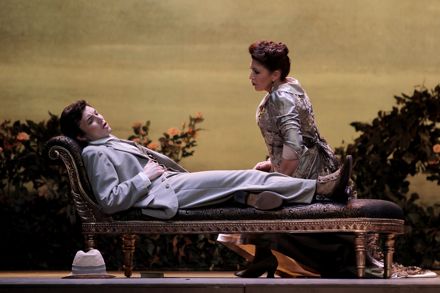 Sébastien Guèze as Fabrice, Marie-Ange Todorovitch as the duchess of Sanseverina
Sébastien Guèze as Fabrice, Marie-Ange Todorovitch as the duchess of Sanseverina
All photos copyright Christian Dresse / Opéra de Marseille
In the novel Fabrice has affairs with first an actress and then an opera singer (neither profession known for depth of personal character) before he finally succumbs to an infatuation with an adolescent girl, Clelia Conti, the only one of his lovers to make it into the opera. And there she was — soprano Nathalie Manfrino! Casting so perfect it was fiction itself.
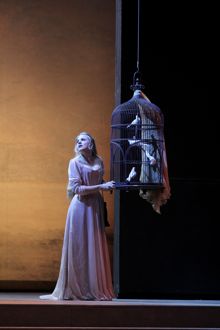
Nathalie Manfrino as Clélia
Though baritone Nicolas Cavallier made a plausible Comte Mosca and baritone Jacques Calatatud made a good Barbone (the guard Fabrice beats up) the balance of the casting disappointed, particularly bass Jean-Phillippe Lafont as an uncomfortable, harsh, cruel General Conti rather than Stendhal’s very complicated courtier and caring father.
Neither Ludovic nor Theodolinde, tenor Eric Huchet and mezzo Sophie Pondjiclis had the physical or vocal edge to capture Stendhal’s vividly if minimally drawn characters that color Fabrice’s escapades in Bologna. Sauguet’s opera renders them as buffo relief rather than as Stendhal’s plot facilitators who just happen to be of impressive character.
But that is the novel. It will have been a daunting task for Sauguet and his librettist Armand Lunel to reduce a famous six hundred page novel to a little (by comparison) theater piece, and to musically rather than narratively structure its scenes. They and the Opéra de Marseille actually succeeded fairly well in giving a taste, albeit a clumsy one, of Stendhal’s novel. There were the painful omissions, like the actress and the opera singer, and the far more painful reordering and recasting of Stendhal’s episodes to arrive at a convincing dramatic process.
But succeed they did. In Act I we had to come to grips with these plot changes, and accommodate an unfamiliar musical language. Very successful persuasion came from the pit, in the scope and sweep of big, very big and very sophisticated music that conductor Lawrence Foster drew out of his very willing orchestra. Mo. Foster has just been named music director of the Opéra de Marseille and has made a huge first impression negotiating this bit of post-Sentimentalism, not similar but so comparable to Cilea and Giordano in its over-the-top and distinctly over ripe Romanticism.
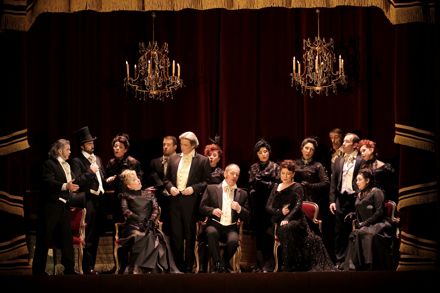 Nicolas Cavallier as Comte Mosca, Marie-Ange Todorovitch as the duchess of Sanseverina, Jean-Philippe Lafont as Général Conti
Nicolas Cavallier as Comte Mosca, Marie-Ange Todorovitch as the duchess of Sanseverina, Jean-Philippe Lafont as Général Conti
Marseille performed acts one and two as the first half of the performance, glossing over the crucial time lapse and change of place that transpires between the acts — a mistake because it kept us from digesting the dramatic and musical complexities that occur in a box at a La Scala performance. As it was the first half was dwarfed by the ball at the Sanseverina palace in Parma that was hugely long and complex, and musically handled so deftly by Sauguet that it resembled the best of Tchaikowsky’s ballets.
Acts three and four brought the lyric gifts of Sauguet to the fore. They are considerable. There was scene after scene of dizzying arias and duets for Fabrice and Clélia. Sauguet’s vocal lines are florid and elaborate, not with ornamentation but complex cantabile melodies that seem rarely to move stepwise, and often move in fifths, sixths, even octaves! These arias and scenes are quite extended (like Stendhal’s interminable accounts of the slightest movement of mind and soul of his protagonists), and in high tessatura.
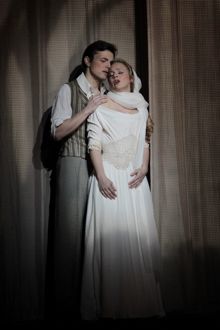 |
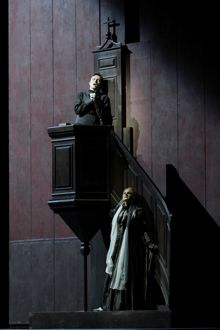 |
Both young Sébastien Guèze and Nathalie Manfrino made it to the end. It was herculean. While Mlle. Manfrino did show some fatigue, she never faltered in a convincing delivery of Sauguet’s vocal line. Mr. Guèze has mastered a falsetto that he implemented from time to time, particularly at his death (without love Fabrice simply wasted away), when perhaps a full voice pianissimo would have been more effective. But after three hours at full forte, in fact a brilliant vocal and histrionic performance, this observation is purely gratuitous.
The opera was staged by Renée Auphan, the former general director of the Opéra de Marseille. To the great profit of operatic France she was the instigator of several equally interesting revivals during her reign. The production and staging was adequate at best. Though of period credibility the unfortunate costumes by Katia Duflot read as haute couture rather than as character completion. Sauguet’s opera could have profited from a more sophisticated production.
Il trittico in Lyon
All the important directors pass through Lyon, so it was just a matter of time before British director David Pountney would be invited to stage a production. It was Puccini’s triptych.
So here is the Trittico he gave the Lyonnais (note that this difficult Puccini work is three little horror stories, very loosely and ironically structured as hell, heaven and purgatory):
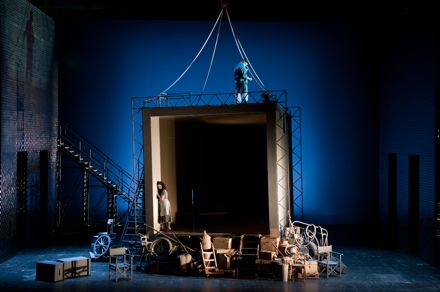 Il Tabarro
Il Tabarro
Mr. Pountney’s point of departure was to relate the three stories each to the next. Michele’s murder of Luigi seemed to be among the presumed serial murders of young dock workers seduced by Giorgetta, ritual killings that somehow purged their horror at the death of their young son. Sister Angelica consumes the body and blood (bread and wine) of the son of God in a sort of sacrificial black mass that excites a vision of her dead son during her final moments of life. And, well, Frugula and Talpa from Tabarro reincarnate themselves in Gianni Schicchi as Gherardo and a pregnant Nella with a baby in a carriage and an annoying seven year-old son on roller skates.
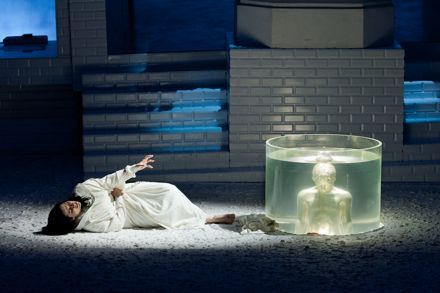 Csilla Boross as Sister Angelica
Csilla Boross as Sister Angelica
Maybe you prefer Puccini’s shock and awe versions of the same stories.
The mise en scène fortified the thematic unification. In Tabarro there was a box that was supposed to be a ship container, in Suor Angelica the same box became a tabernacle and in Gianni Schicchi it was a coffin though it had multiplied itself into many more boxes that were safes filled with boxes of spaghetti and cans of tomato sauce. Colors too brought things together conceptually. The Tabarro container was within a huge stage box of small shiny black bricks (hell). The Suor Angelica box was in a stage box cloister of small shiny white bricks, thousands of them (heaven). In Gianni Schicchi the little bricks of the visible side walls seemed the color of spagetti al pomodoro.
Of the three operas Il Tabarro was the most successful for a number of reasons, the first of which was that the top of the ship container box had cables and a hook that suggested it would disappear after that act. At first there seemed no reason to think that this little théâtre guignol piece was not being taken at face value, and even Mr. Pountney’s little twist at the end seemed fun. All the nuns in Suor Angelica disappeared under identical massive white habits so they all looked exactly alike. Therefore Sister Angelica seemed to have no personality whatsoever but that did not really matter once we understood that the opera was not about her but about a play on the Catholic mass.
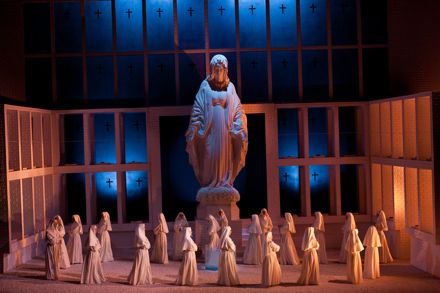 Suor Angelica
Suor Angelica
Things fell apart in Gianni Schicchi where Mr. Pountney displayed his sense of fun in runaway character expositions that dwarfed Puccini’s own idea of his comedy. Specifically the campy antics of a very fey Marco (son of Simone), not to mention the fellatio and cunilingus enacted by Rinuccio and Lauretta. Then there were the witnesses to the writing of the new will who upstaged the whole scene by busily and noisily eating, yes, spaghetti al pomodoro.
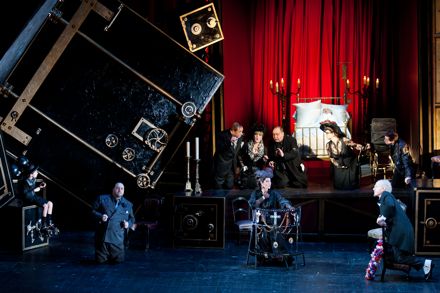 Gianni Schicchi
Gianni Schicchi
Even a stellar cast could not have saved this production. As it was the Opéra de Lyon assembled a number of promising young singers and a few (but not enough) seasoned performers who mostly held things together on the stage. Of particular notice was the Brazilian born, Italian nurtured tenor Thiago Arancam who allowed Luigi’s passions to burst forth with tenorial flair and dramatic reality. Hungarian soprano Csilla Boross sang securely and acted Giorgetta with conviction but did not find the ultimate rapture of Sister Angelica, victim of the production. Bass-baritone Werner Van Mechelen is an accomplished artist who made both Michele and Gianni Schicchi into vocally and dramatically vivid characters. Wynne Evans and Paolo Battaglia were appropriately cast as Tinca and Talpa, and carried age and experience to Gherardo and Simone in Gianni Schicchi.
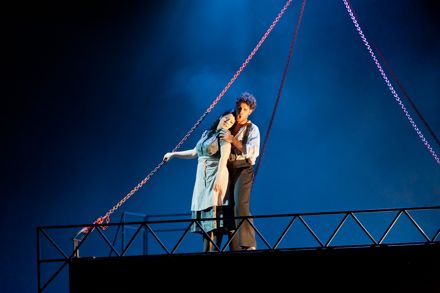 Csilla Boross as Giorgetta, Thiago Arancam as Luigi
Csilla Boross as Giorgetta, Thiago Arancam as Luigi
Of notice as well was Austrian born, Israeli nurtured mezzo soprano Natasha Petrinsky who is not yet an accomplished enough artist to bring Frugola alive, nor old enough and complicated enough to impersonate Suor Angelica’s evil aunt, and not grand enough to make Zita a comic force. She is a very promising artist. Neither tenor Benjamin Bernheim nor soprano Ivana Rusko, both house singers at Zurich Opera, are sufficiently finished artists to have been asked to take on the roles of Rinuccio and Lauretta in Gianni Schicchi.
Young Sicilian conductor Gaetano d’Espinosa made natural and convincing verismo in the pit, aided by the naturally harsh sound of the Opéra Nouvel and its fine orchestra. Il Tabarro was his best effort, perhaps motivated by the splendid vocal force of the principals (Mlle. Boross, messieurs Arancam and Van Mechelen). Suor Angelica too seemed driven with sensitivity and understanding though he missed reaching its emotional heights. His choice of tempi (sometimes unusually slow) in Gianni Schicchi was beyond the capabilities of his some of his young, inexperienced artists.
L'Enfant et les Sortileges and La Navarraise in Monte-Carlo
The magic was in the pit, not that all Monaco was not magical — on January 25 a yellow Lamborghini, a red Ferrari, a vintage Jaguar among other magnificent machines stood before the entrance to Monte-Carlo’s resplendent Casino cum transplendent 500-seat Salle Garnier.
Even without this automotive hardware Monaco may still have been magical eighty-seven years ago when Maurice Ravel and Colette conjured a strange little comédie musicale, L’Enfant et les Sortileges for Monte-Carlo’s opera house. These days Colette’s singing cats, clocks, teakettles, etc., rarely recapture the magic that is said have surprised, puzzled and perturbed the monégasques (those rich enough to sojourn in Monaco) back in 1925.
Happily all of L’Enfant’s reputed magic was recreated just now in this little opera house, brought alive by Monaco’s fine Orchestre Philharmonique responding to the remarkable precision of narrative detail and intonation imposed by conductor Patrick Davin. Ravel’s score shone as the masterpiece of orchestral colors and musical wit that has won it huge respect and exposure in musical circles.
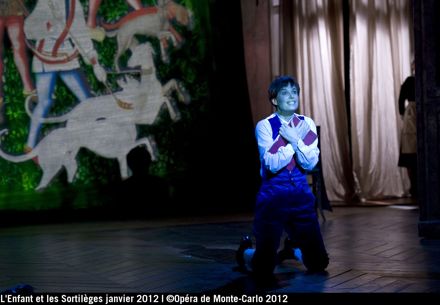 Carine Séchaye as l'Enfant
Carine Séchaye as l'Enfant
If you are among those who find people impersonating animals, objects or elements (there is a big piece for a soprano named “fire”) amusing this new production by the Opéra de Monte-Carlo’s general director Jean-Louis Grinda might have disappointed you. As it was we were not required to suspend disbelief for a second. It was the household staff of Mamam (the quite imposing Béatrice Uria-Monzon in full Coco Chanel regalia) who went to a great deal of trouble to terrorize Mamam’s little darling while Mamam went out for the evening.
This alone made the entertainment adult and saved us from having to rediscover the-child-that-is-in-all-of-us. In fact it was a pleasure to get back at the naughty little brat (convincingly portrayed by Swiss mezzo Carine Séchaye) by dreaming up mean and clever tricks. Cats were made by shadow puppetry and sung by their puppeteers, three household staff (very fine dancers) executed nifty slimy choreography (by Eugénie Andrin) that kept the torture relentless. The household maitre d’ actually appeared in the clock and the governess climbed atop the armoire to sing the Princess’ lament.
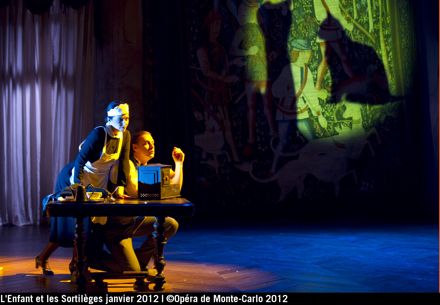 Patricia Fernandez as La Chatte, Jean-François Lapoint as Le Chat
Patricia Fernandez as La Chatte, Jean-François Lapoint as Le Chat
This realistic staging revealed the charm of this little story by the famously unconventional Colette and let us hear Ravel’s brilliant score with the eyes and ears of adults of presumed intelligence and wit. These attributes are in fact the magic of Colette and Ravel’s amusing trifle, not its fantastical characters. These were forty-five riveting minutes.
The French speaking audience (where were the Italians and the Russians?), obviously mature and certainly well-healed paid 15 euros per flûte de champagne at intermission where they were far more animated than at the perfunctory applause awarded the entertainment.
L’Enfant et les Sortileges is a chamber work of childish sentiment detailed by a very large orchestra. It is of ideal proportion to the Salle Garnier. Its companion piece, Massenet’s La Navarraise is an emotional blockbuster that was sonically stuffed into this intimate theater where it suffered a dismal production as well.
This brief piece attempts to impose the emotional force of Italian verismo onto French sentiments familiar to us through Alexander Dumas fils’ La Dame aux Camélias and Mérimée’s Carmen. The big blow, that hallmark of pristine verismo, was the gypsy girl’s suicide over the corpse of her lover. This final moment was very noisily presaged in the opening battle scene and by the challenge of her lover’s father that she match his dowry. She was then accused of treason, the tenor sang a great big aria and there was an even bigger battle scene.
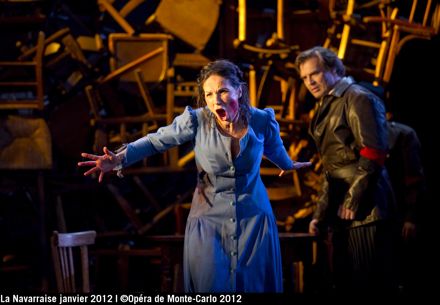 Béatrice Uria-Monzon as La Navarraise, Jean-François Lapointe as Garrido
Béatrice Uria-Monzon as La Navarraise, Jean-François Lapointe as Garrido
It would be hard for anyone to remain aloof from all this violence and maestro Davin certainly was not. He urged his orchestra to sing out full voice, and encouraged his singers to give everything they had. And they all did. We understood why this piece was once popular and no longer is. It is too loud and too short, a blatant and naive imitation of Cavalleria Rusticana by a capable composer who knew what the London public wanted back in 1895.
The Opéra de Monte-Carlo did Masennet’s little escapade full justice with French mezzo Béatrice Uria-Monzon, a famous Carmen who has essayed Tosca as well, as the Navarraise — a more ideal singer for this heroine of a verismo manqué cannot be imagined. Spanish tenor Enrique Ferrer was Araquil, her lover, negotiating the role’s high tessitura at continuous forte levels with apparent ease, adding the easy swashbuckle that cost him his life. Canadian baritone Jean-François Lapointe was a dynamic lieutenant of beautiful voice however baritone Marcel Vanaud as the father Remigio did not rise to sufficient vocal or histrionic stature to have motivated such a tragedy. Earlier in the evening Mr. Vanaud had portrayed a fine chair and a successful tree.
Otello in Zurich
War and destruction is everywhere these days, not least in Pesaro where Graham Vick staged a lethal Mosé in Egitto last August, nor less so in San Francisco where baritone Thomas Hampson perished as Rick Rescorla in Heart of a Soldier last September.
These two gentlemen were at it again just now in Zurich, Mr. Vick staging a new Verdi Otello and Mr. Hampson attempting its villain Iago, a late career role debut that did not even require him to change costume from his convincing, indeed moving portrayal of Rick, the professional soldier cum World Trade Center hero.
In Pesaro Graham Vick exploited the explosive hostilities of the Palestinians and Jews in such graphic detail that some audience fled the theater in terror. The Cyprus Greek Turkish tensions do not carry as much emotional baggage or fearsome consequences, at least in the international psyche, but like Mosé in Egitto the contemporary metaphor, here the on-going Cyprus problem, is too striking to ignore. All this is to say that Verdi’s old story, no longer old, was told in contemporary terms.
Unlike the huge ethnopolitical tragedies of Mosé in Egitto, Otello is a personal tragedy that unfolds in war torn Cyprus, though the visible ravages of war could be anywhere. Its opening chorus is not watching the battle but participating in it by slathering black soot on their faces, stripping off clothes exposing white bodies parts as if wounded.
To preface the opera however, Otello, not in blackface, presented himself alone on the stage thus forcing himself into our close focus for the duration. Maybe it was the lack of the expected blackface that planted the seeds of racism in our minds, rewarded when Vick finally allowed overt racism to burst forth in Act III when a suddenly exposed back-of-a-stage flat said “nigger.” But Vick had made it a black and white opera long before, and on multiple levels. Desdemona appeared in Act I as a phantom bride, a white veiled wife, who moved as if in an Otello dream, his dream of a world of beauty and purity, a sanctuary from the burned black colors of war.
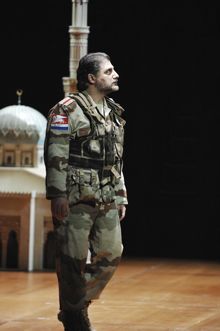 |
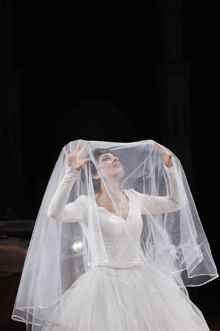 |
(there is no photo available of Barbara Frittoli as Desdemona)
Photos copyright Suzanne Schwiertz/Zurich Opera
Act IV, the Desdemona act, placed Desdemona in the center of a black stage. She re-entered the wedding dress, covered herself with the bridal veil and became again Otello’s dream as she sang her song and prayer, standing and immobile. We now knew and felt with certainty that this was Verdi’s opera as the Othello tragedy and not the melodrama of a fallen woman.
Acts II and III were in fact the Desdemona acts when she presented herself as an emancipated, worldly woman, possibly unfaithful, even defiant thus taunting the sensibilities of this Venetian general whose Asian sensibilities imagine his woman as veiled, like the burka covered women who praised Desdemona’s exposed beauty in Act II. The opera had suddenly gone globally political and we knew then that its tragically violent outcome was to be understood in universal as well as personal terms.
Where, you may ask, did Iago fit into all of this? This is where the Zurich casting choices for this remarkable Graham Vick production come into question. Tenor Jose Cura was a gruff, hulking, brutal Otello who held forth magnificently in high Italianate vocal style and whose high style method acting transported his Otello to admirable histrionic heights. Soprano Barbara Frittoli is young and shapely and a formidable Italianate singer whose personal beauty and beauty and range of voice fulfilled the gamut of Desdemona’s expressive needs in this complex concept.
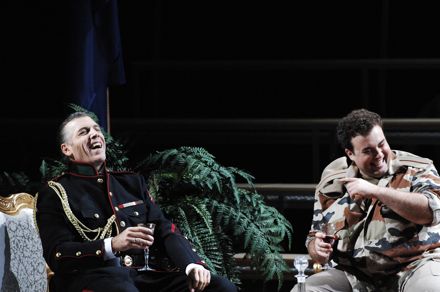 Thomas Hampson as Iago, Stefan Pop as Cassio
Thomas Hampson as Iago, Stefan Pop as Cassio
Photo copyright Suzanne Schwiertz/Zurich Opera
Thomas Hampson simply did not fill the bill as Iago. His size and age precluded a physicality that could color and magnify the ugly insinuations Iago dishes out to Otello. In his army fatigues he seemed still the aged Rick Rescorla of the World Trade Center, towering over everyone else, and shouting out accusations to Otello like instructions for evacuation. His nemesis Cassio, played by 24-year-old Stefan Pop was equally out of place in age and size, thus depriving this pivotal character of his essential weight and meaning in Verdi’s drama. Vocally however this young singer made the most of Verdi’s musical points.
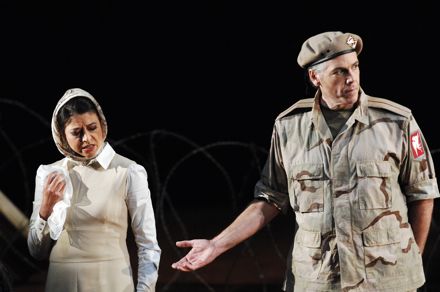 Thomas Hampson as Iago, Judith Schmid as Emilia
Thomas Hampson as Iago, Judith Schmid as Emilia
Photo copyright Suzanne Schwiertz/Zurich Opera
With the Pesaro Mosé in Egitto and this Zurich Otello Graham Vick has proven himself to be one of our greatest contemporary stage directors, working now in a rich, highly minimal language with the goal of bold and highly pointed storytelling. As well both operas were laden, burdened, over-burdened with contemporary political messages that enriched the inherent political agendas of both operas. With significant participation of his designer, Paul Brown, the visual and theatrical language is refined to few moves, shapes and colors that bring this theater to astonishing heights of a minimalist expressionism.
Conductor Massimo Zanetti rose to the occasion executing Verdi’s score in biting and cutting detail, pushing its nervousness to an ultimate extreme, sometimes forcing his singers, maybe including Mr. Hampson, to shout rather than sculpt their musical lines (there is however the possibility and suspicion that this was a staging mandate). While this musical brutality may work for the Otello personage it can as well suppress much of the well known subtlety of this Verdi score.
Finally this Otello tragedy was powerfully felt, intellectually and theatrically. It was not musically felt. And that is perhaps the inevitable when a formidable stage director like Graham Vick tackles a formidable work of theater, overlooking that Verdi’s Otello is an opera as well.
La Bohème in Toulon, Marseille and Genoa
Three La Bohèmes in ten days, a critic’s nightmare that was more fun than a barrel of monkeys.
Well, why not? Why not make La Bohème about 1968! 1968 was a long time ago, dim in memory but now that you mention it an exciting time to recall — the vehement anti Vietnam war protests in the U.S. were small in comparison to Mai 1968, huge protests in Paris and around France against authority (any and all), a premise wildly cheered by American and Italian university students eager for any and all revolution, all this general excitement notably prompted by the politically pointed 1968 Prague Spring.
Maybe May 1968 is a mantle that La Bohème does not wear very well. But never mind, it was fun to revisit those exciting times even if the 2003 Nice Opera production by Daniel Benoin revived just now in Toulon was filled with much imagery that was maybe recognizable only by the French, and by now those French of a certain age (this seems to have been the case based on overhearing intermission conversations). It did leave us Berkeley-ites of a certain age mostly in the dark.
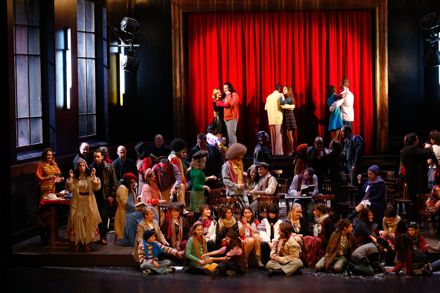 Act II, photo copyright Frédéric Séogan/Opéra de Toulon
Act II, photo copyright Frédéric Séogan/Opéra de Toulon
A bit of post performance research into Mai 1968 explained that the rubber face-masked, caricatured Mao-ites who marched in at the end of Act II were deriding the French communists who joined the rightwing Gaullists to condemn the strikes. Riot police were everywhere in Mai 1968 (DeGualle had fled to Germany) thus they prefaced the third act by climbing onto the stage to be in place before the curtain rose onto a mesh fence with a gate that guarded some sort of internment compound and then inexplicably did not.
Mr. Benoin, director of the esteemed Théâtre National de Nice since 2002, is not a musical opera director, if he were musical he would know that you better not mess around with La Bohème at all. He would know that posters announcing the appearance of Country Joe and the Fish at the Café Momus would disqualify Puccini’s orchestra, that Musetta, a determined, militant revolutionary, could not croon her waltz into a microphone to a mute jazz trio accompaniment. He would know that if a corps de ballet did happen by the Café Momus it would not attempt to jive dance to Puccini’s trumpet fanfares.
But make no mistake, Mr. Benoin is a savvy director (making one curious if a little nervous about the Madame Butterfly he staged in Salerno [Italy] in 2007). He used his Act III wire mesh fence to sublime effect, separating his sets of lovers while allowing them to touch. His Act IV conceit was to clothe his entire cast in pure white, Rodolfo draping the windows with white cloth at the moment Mimi expired. All this packed a wallop.
If Daniel Benoin indulged himself in seemingly arbitrary forays into high theatrical style Toulon Opera music director Giuliano Carella indulged Puccini in some very powerful verismo that exactly magnified the opera’s emotive intent to huge proportion, real and pure embodiment of the verismo ideal of oversized sentiment. This an accomplishment rarely achieved on any operatic stage. Well, once we got to Act III that is. Acts I and II were rocky, evoking terrors that are usually dealt with at the dress rehearsal. And the maestro simply could not drag the Toulon chorus into a festive melée at the Café Momus.
Finally La Bohème rests on the charm and voice of its bohemians, and Toulon Opera did not let us down. The Bohème herself was Italian soubrette Nuccia Focile whose mannered Italian endowed Mimi with more personality than we may have wanted but whose voice rose to easy highs to insinuate a younger and simpler idea of this heroine. Sympathetic Polish tenor Arnold Rutkowski, easily the audience favorite, drew his musical lines with more than usual ease suggesting that Onegin’s Lenski is his innate character. Georgian born French soprano Anna Kasyan brought good, tough character to this unusual Musetta though she only sometimes seemed to have the requisite vocal heft. Italian baritone Devid Cecconi was a gruff, lovable, bumbling Marcello aided by countrymen Massimiliano Gagliardo and Roberto Tagliavini as the charming and vocally adept Schaunard and Colline.
Well, why not translocate La Bohème onto the rooftops of Paris, maybe like a movie musical (Moulin Rouge for example)? These rooftops rarely have people on them for good reason (they are steep) so the trick just now in Marseille was finding a few flat places where bohemians could frolic and die.
Rooftops are just that so there was no way to sketch an artists’ garret, a café or an entrance to the city, after all these places are easily imagined. Maybe this lone rooftop location was a bow to the new austerity that has made opera companies worldwide feel as penniless as Puccini’s bohemians.
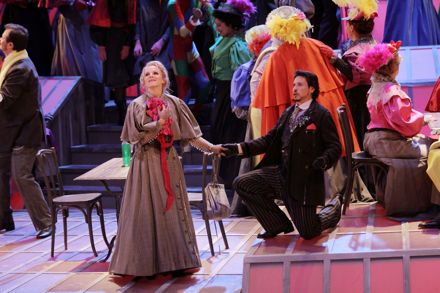 Act II, Mimi and Rodolfo, photo copyright Christian Dresse/Opéra de Marseille
Act II, Mimi and Rodolfo, photo copyright Christian Dresse/Opéra de Marseille
La Bohème is indestructible, or nearly. The current Bohème at Marseille Opera toyed with that distinction. This Christmas Eve bonbon (well, the first two acts) might have survived the rooftop concept but it could not survive the attempt to turn Puccini's thrusting emotions into the measured, percolated, precious movements of spirit that mark a Britten or Janacek opera. Like a driver willfully blocking the flow of traffic by driving too slowly to prove how careful he is, Irish conductor Mark Shanahan thwarted the very essence of verismo by rendering it into slow, almost frozen musical motion. The cathartic moment of Puccini's tearjerker in Marseille finally was not a tear or two, it was pure and simple road rage at the conductor.
Were it not victim of the conducting this La Boheme probably would have succumbed at the moment Musetta's waltz became a 1950's movie musical production number, those Parisian rooftops disguised very symmetrical platforming that allowed a garishly costumed Musetta, let us say clownishly, to top a pyramid of snazzy Café Momus waiters executing some snappy choreography. Well, Café Momus was already a crazed showbiz, dayglo colored adult playground so why not.
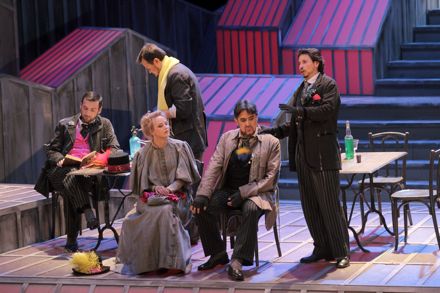 Act II, act II principals, photo copyright Christian Dresse/Opéra de Marseille
Act II, act II principals, photo copyright Christian Dresse/Opéra de Marseille
It would be unfair to delve too deeply into the individual performances as there was obvious dissension between pit and stage, and not just between the singers and the conductor, also between stage management and conductor — changes in the lighting seldom occurred at the appropriate musical moment.
Suffice to say that French soprano Nathalie Manfrino was a vocally and physically attractive Mimi, though her ample sound was mismatched to Ricardo Bernal as the young, handsome Rodolfo. This Mexican tenor’s appropriately Italianate delivery was hampered by a voice more suited to the light lyric roles. Marcello, Schaunard and Colline were undertaken by Marc Barrard, Igor Gnidii and Nicolas Courjal respectively. All are accomplished in their roles though none found the youthful charisma of their characters as had the Mimi and Rodolfo.
The staging concept credited to Jean-Louis Pichon seems to have been to transform Puccini's sad little tale into a slick musical with one nifty crowd scene, leaving the well known tunes elsewhere to fend for themselves as well they might and usually do. Marseille's remarkable opera house, unequaled anywhere for its direct stage-audience rapport did respond from time to time to the obtuse staging with some enjoyable stage pictures.
Well why not? Why not place Puccini’s sad, gritty little story in an enchanted storybook world where fantastically dressed bohemians named Mimi, Rodolfo, Marcello, Schaunard and Colline have identically fantastically dressed child counterparts aged 5 to 9 who mirror their every move.
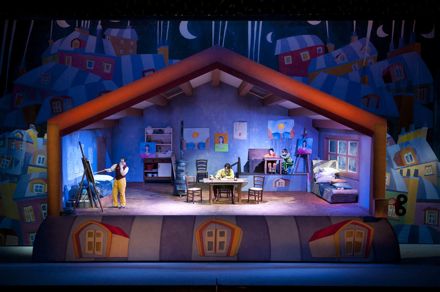 Act I, photo copyright Jacopo Morando/Teatro Carlo Felice
Act I, photo copyright Jacopo Morando/Teatro Carlo Felice
There was no message in Genoa just now, like innocence is transitory if not illusionary — “just wait until you grow up, kids, life gets complicated.” Instead it was simply the bi-polar Bohème pathology gone extreme. The first two acts of the opera are indeed childish play, as are the antics of the fourth act, and you know the rest of the story.
The juxtaposition of storybook and real seemed ridiculous but once you thought about it, well, thought about it quite a lot, you could make it make some sense. It was a justifiably abstracted bi-polar world that incorporated Puccini’s verismo, if uncomfortably, by separating the visual and sonic worlds. The musical was what is real, even tangible (like great verismo really is), and the visual became a metaphysical world that shadows and colors the real, like music ordinarily does. Yes, this conclusion took some thinking.
So we were very much on edge, and maybe heard this great masterpiece with new ears, as we were seeing it with new eyes. There were other advantages that we will get to.
Teatro Carlo Felice invited Genoa born and culturally nurtured artist Francesco Musante to create this new production. Over his long career Mr. Musante has exploited op art and Viennese Succession influences, he has worked in water color, lithograph and particularly illustration. A specific reference in his oeuvre to this telling of La Bohème might be his comic book rendition of Lewis Carrol’s Alice in Wonderland (1980). Mr. Musante is not widely known outside Italy.
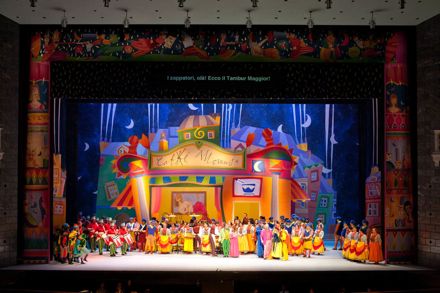 Act II, photo copyright Jacopo Morando/Teatro Carlo Felice
Act II, photo copyright Jacopo Morando/Teatro Carlo Felice
The Musante abbozzi, or renderings of the scenes displayed in the foyer of the opera house succinctly expounded the artist’s specific vision of La Bohème — a bright and noisy world animated by children. Act II was in fact an illustrated music box merry-go-round wound up by the children on the stage at the end of Act I.
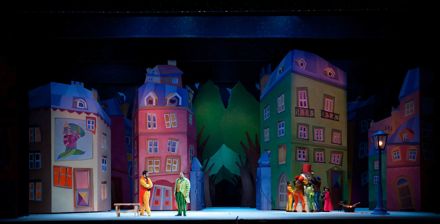 Act III, photo copyright Jacopo Morando/Teatro Carlo Felice
Act III, photo copyright Jacopo Morando/Teatro Carlo Felice
On the Carlo Felice stage Mr. Musante’s sketches were brought alive by Italian actor Augusto Fornari who presumably was in cahoots with the artist. This obviously able stage director was hampered by the absence of professional child actors, here the extensive mimicry was supplied by members of the Carlo Felice’s Children’s Chorus (“coro di voci bianchi”). But what a chorus this was! The first in living memory to carry out hyper visual antics in perfect [!] synchronization with the Puccini’s musical antics — among them the entry of a 12 member (maybe more) marching band that capped the Momus act with utter visual and musical delirium.
Unaided by any visual realism whatsoever, conductor Marco Guidarini managed only a restrained verismo that fully supported Puccini’s needs but mostly missed finding a synergy with the stage. If this Bohème’s visual world was exuberant and extravagant, Mo. Guidarini’s Puccinian thrust was careful and by-the-book when it could have been pushed to and even beyond verismo extremes.
Musante’s stylized visual language obliterated the need for singers to look or be bohemians, thus they came in all shapes, ages and sizes but to a man on January 5 they had solid Italian schooling and gave big vocal performances with big mannerisms that might be considered tasteless in more restrained musical cultures. Three casts people its eleven performances over a two month period. On January 5 Massimiliano Pisapia was the Rodolfo, though were it not for his musical postures he might have been singing Siegfried. Amarilli Nizza is an accomplished Tosca and Aida on big stages (Verona, Vienna) so she was hardly a retiring Mimi. Hers was a fully successful, vocally and musically splendid performance. Of special interest as well was the Musetta of Alida Berti whose vocal and presence actually matched the exuberance and innocence of the production, as did the remarkably vivid, full voiced Alcindoro of Fabrizio Beggi.
La Bohème in Genoa
Well why not? Why not place Puccini’s sad, gritty little story in an enchanted, storybook world where fantastically dressed bohemians named Mimi, Rodolfo, Marcello, Shaunard and Colline have identically fantastically dressed child counterparts aged 5 to 9 who mirror their every move.
 Act I, photo copyright Jacopo Morando/Teatro Carlo Felice
Act I, photo copyright Jacopo Morando/Teatro Carlo Felice
There was no message, like innocence is transitory if not illusionary — “just wait until you grow up, kids, life gets complicated.” Instead it was simply the bi-polar Bohème pathology gone extreme. The first two acts of the opera are indeed childish play, as are the antics of the fourth act, and you know the rest of the story.
If at first the juxtaposition of the storybook with the real seemed ridiculous once you thought about it, well, thought about it quite a lot, you could make it make some sense. It was a justifiably abstracted bi-polar world that incorporated Puccini’s verismo, if uncomfortably, by separating the visual and sonic worlds. The musical was what is real and tangible (like great verismo really is), and the visual became a metaphysical world where meaning is abstract, like music ordinarily is. Yes, this conclusion took lots of thinking.
So we were on very much on edge, and maybe heard this great masterpiece with new ears, as we were seeing it with new eyes. There were other advantages that we will get to.
Teatro Carlo Felice invited Genoa born and culturally nurtured artist Francesco Musante to create this new production. Over his long career Mr. Musante has exploited op art and Viennese Succession influences, he has worked in water color, lithograph and particularly illustration. A specific reference in his oeuvre to this telling of La Bohème might be his comic book rendition of Lewis Carrol’s Alice in Wonderland (1980). Mr. Musante is not widely known outside Italy.
 Act II, photo copyright Jacopo Morando/Teatro Carlo Felice
Act II, photo copyright Jacopo Morando/Teatro Carlo Felice
The Musante abbozzi, or renderings of the scenes displayed in the foyer of the opera house succinctly expounded the artist’s specific vision of La Bohème — a bright and noisy world that plays by itself once a child winds up its spring. Act II was in fact an illustrated music box wound up by the children at the end of Act I.
If the actual stage sets were a bit less vivid than the abbozzi they still came close to capturing the excitement of this fantastic world realized in a dazzling visual language. The three sets (garret, cafe and gate) were anchored by a colorful show curtain that was a resume of Musante’s vibrant shapes and colors for all the acts. Of the three sets Act III, the cabaret and barrière d’Enfer (today the Denfert-Rochereau square in Montparnasse) was the most eloquent, describing the long ago (decades before Puccini in fact) passage from the countryside and its farms to the city and its tales.
 Act III, photo copyright Jacopo Morando/Teatro Carlo Felice
Act III, photo copyright Jacopo Morando/Teatro Carlo Felice
On the Carlo Felice stage Mr. Musante’s scenes were animated by Italian actor Augusto Fornari who presumably was in cahoots with the artist. This obviously able stage director was hampered by the absence of professional child actors, here the extensive mimicry was taken on by members of the Carlo Felice’s Children’s Chorus ("coro di voci bianchi"). But what a chorus this was! The first in living memory to carry out hyper visual antics in perfect [!] synchronization with the Puccini’s musical antics — among them the entry of a 12 member (maybe more) marching band that capped the Momus act with utter visual and musical delirium.
Unaided by any visual realism whatsoever, conductor Marco Guidarini managed only a restrained verismo that fully supported Puccini’s needs but missed finding a synergy with the stage. If this Bohème’s visual world was exuberant and extravagant, Mo. Guidarini’s Puccinian thrust was careful and by-the-book when it could have been pushed to and even beyond verismo extremes.
Musante’s stylized visual language obliterated the need for singers to look or be bohemians, thus they came in all shapes, ages and sizes but to a man on January 5 they had solid Italian schooling and gave big vocal performances with big mannerisms that might be considered tasteless in more restrained musical cultures. Three casts people its eleven performances over a two month period. On January 5 Massimiliano Pisapia was the Rodolfo, though were it not for his musical postures he might have been singing Siegfried. Amarilli Nizza is an accomplished Tosca and Aida on big stages (Verona, Vienna) so she was hardly a retiring Mimi. It was a fully successful, vocally and musically splendid performance. Of special interest as well was the Musetta of Alida Berti whose vocal and presence actually matched the exuberance and innocence of the production, as did the remarkably vivid, full voiced Alcindoro of Fabrizio Beggi.
La Bohème in Marseille
Well, why not translocate La Bohème onto the rooftops of Paris, maybe like a movie musical (Moulin Rouge for example)? They rarely have people on them for good reason (they are steep) so the trick just now in Marseille was finding a few flat places where bohemians could frolic and die.
Rooftops are just that so there was no way to sketch an artists’ garret, a café or a city gate, after all these places are easily imagined. Maybe this lone rooftop location was a bow to the new austerity that has made opera companies worldwide feel as penniless as Puccini’s bohemians.
 Act II, Mimi and Rodolfo, photo copyright Christian Dresse/Opéra de Marseille
Act II, Mimi and Rodolfo, photo copyright Christian Dresse/Opéra de Marseille
La Bohème is indestructible, or nearly. The current Bohème at Marseille Opera toyed with that distinction. This Christmas Eve bonbon (just the first two acts) might have survived the rooftop concept but it could not survive the attempt to turn Puccini's thrusting emotions into the measured, percolated, sometimes precious movements of spirit that mark a Britten or Janacek opera. Like a driver willfully blocking the flow of traffic by driving too slowly to prove how careful he is, Irish conductor Mark Shanahan thwarted the very essence of verismo by rendering it into slow, almost frozen musical motion. The cathartic moment of Puccini's tearjerker in Marseille finally was not a tear or two, it was pure and simple road rage at the conductor.
Were it not victim of the conducting this La Bohème probably would have succumbed at the moment Musetta's waltz became a 1950's movie musical production number. Those Parisian rooftops disguised very symmetrical platforming that allowed a garishly wigged Musetta, young French soprano Gabrielle Philiponet, to top a pyramid of snazzy Café Momus waiters who executed some snappy choreography. Well, Café Momus was already a crazed showbiz, dayglo colored adult playground so why not.
 Act II, act II principals, photo copyright Christian Dresse/Opéra de Marseille
Act II, act II principals, photo copyright Christian Dresse/Opéra de Marseille
It would be unfair to delve too deeply into the individual performances as there was obvious dissension between pit and stage, and not just between the singers and the conductor, also between stage management and conductor — the lack of forward motion often confused the timing of the changes to the lighting. This same absence of thrust in the conducting even hampered the movement of the actors, indeed some of the simplest moves became truly clumsy.
Suffice to say that French soprano Nathalie Manfrino was a vocally and physically attractive Mimi, though her ample sound was mismatched to Ricardo Bernal as the young, handsome Rodolfo. This Mexican tenor’s appropriately Italianate delivery was hampered by a voice more suited to the light lyric roles. Marcello, Schaunard and Colline were undertaken by Marc Barrard, Igor Gnidii and Nicolas Courjal respectively. All are accomplished in their roles though none found the youthful charisma of their characters as had the Mimi and Rodolfo.
The staging concept credited to Jean-Louis Pichon seems to have been to transform Puccini's sad little tale into a slick music hall production with one nifty crowd scene, leaving the well known tunes elsewhere to fend for themselves as well they might and usually do. Marseille's remarkable opera house, unequaled anywhere for its direct stage/audience rapport did respond from time to time to the obtuse staging with some enjoyable stage pictures.
La Bohème in Toulon
Well, why not? Why not make it about May 1968!
1968 was a long time ago, dim in memory but now that you mention it an exciting time to recall — the vehement anti Vietnam war protests in the U.S. were small in comparison to Mai 1968, huge protests in Paris and around France against authority (any and all), a premise wildly cheered by American and Italian university students eager for any and all revolution, the general excitement notably prompted by the politically pointed 1968 Prague Spring.
 Act II, photo copyright Frédéric Séogan/Opéra de Toulon
Act II, photo copyright Frédéric Séogan/Opéra de Toulon
Maybe May 1968 is a mantle that La Bohème does not wear very well. But never mind, it was fun to revisit those exciting times even if the 2003 Nice Opera production by Daniel Benoin was filled with much imagery that was maybe recognizable only by the French, and by now those French of a certain age (this seems to have been the case based on overhearing intermission conversations). It did leave us Berkeley-ites of a certain age mostly in the dark.
A bit of post performance research into Mai 1968 explained that the rubber face-masked, caricatured Mao-ites who marched in at the end of Act II were deriding the French communists who joined the rightwing Gaullists to condemn the strikes. Riot police were everywhere in Mai 1968 (DeGualle had fled to Germany) thus they prefaced the third act by climbing onto the stage to be in place before the curtain rose onto a mesh fence with a gate that guarded some sort of internment compound and then inexplicably did not.
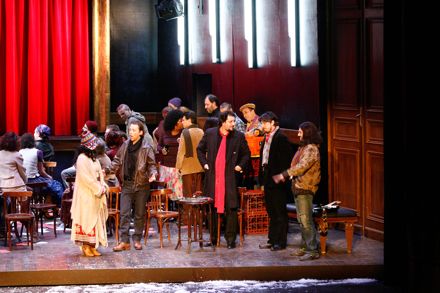 Act II, photo copyright Frédéric Séogan/Opéra de Toulon
Act II, photo copyright Frédéric Séogan/Opéra de Toulon
Mr. Benoin, director of the esteemed Théâtre National de Nice since 2002, gave Nice Opéra a superb Berg Wozzeck in 2005. Mr. Benoin is not a musical opera director (Wozzeck is after all a play). If he were musical he would know that you better not mess around with La Bohème at all. He would know that posters announcing the appearance of Country Joe and the Fish at the Café Momus would disqualify Puccini’s orchestra, that Musetta, a determined, militant revolutionary, could not croon her waltz into a microphone to a mute jazz trio accompaniment. He would know that if a corps de ballet did happen by the Café Momus it would not attempt to jive dance to Puccini’s trumpet fanfares.
Make no mistake, Mr. Benoin is a savvy director (making one curious if a little nervous about the Madame Butterfly he staged in Salerno [Italy] in 2007). He used his Act III wire mesh fence to sublime effect, separating his sets of lovers while allowing them to touch. His Act IV conceit was to clothe his entire cast in pure white, Rodolfo draping the windows with white cloth at the moment Mimi expired. All this packed a wallop.
If Daniel Benoin indulged himself in seemingly arbitrary forays into high theatrical style Toulon Opera music director Giuliano Carella indulged Puccini in some very powerful verismo that exactly magnified the opera’s emotive intent to huge proportion, real and pure embodiment of the verismo ideal of oversized sentiment. This an accomplishment rarely achieved on any operatic stage. Well, once we got to Act III that is. Acts I and II were rocky, evoking terrors that are usually dealt with at the dress rehearsal. And the maestro simply could not drag the Toulon chorus into a festive melée at the Café Momus.
Finally La Bohème rests on the charm and voices of its bohemians, and Toulon Opera did not let us down. The Bohème herself was Italian soubrette Nuccia Focile whose mannered Italian endowed Mimi with more personality than we may have wanted but whose voice rose to easy highs to insinuate a younger and simpler idea of this heroine. Sympathetic Polish tenor Arnold Rutkowski, easily the audience favorite, drew his musical lines with more than usual ease suggesting that Onegin’s Lenski is his innate character. Georgian born French soprano Anna Kasyan brought good, tough character to this unusual Musetta though she only sometimes seemed to have the requisite vocal heft. Italian baritone Devid Cecconi was a gruff, lovable, bumbling Marcello aided by countrymen Massimiliano Gagliardo and Roberto Tagliavini as the charming and vocally adept Schaunard and Colline.
Mosé in Egitto and Adelaide di Borgogna at Pesaro
It was a no-brainer. The Old Testament Egyptians had to become today’s Palestinians.
Well, the politics of the Graham Vick production were a bit confusing at first as Moses implored God to restore light to Egypt and He did in the most magnificent chorus of Andrea Leone Tottola’s azione tragico-sacra that ultimately parts the Red Sea and then drowns the Egyptians.
But back to Egypt bathed in glorious light with the Egyptians confused about who was going to clean up the ostentatious palaces growing out of decayed reinforced concrete structures if the enslaved Jews were released. So they did not free the Jews after all to the relief of the scion of the ruling family who had fallen in love with an Hebrew maiden.
Moses, betrayed, implores God to rain fire on the Egyptians, and the Hebrews to a man, woman and child strap bombs onto their bodies while singing a most magnificent chorus. And, uhm, was that really Osama Bin Laden's beard on Moses? We now fully understand that Graham Vick’s dramatic vocabulary is not politically literal. It is the storybook tragedy of the Old Testament magnified onto the now massive tragedy of Western Asia and the entire world.
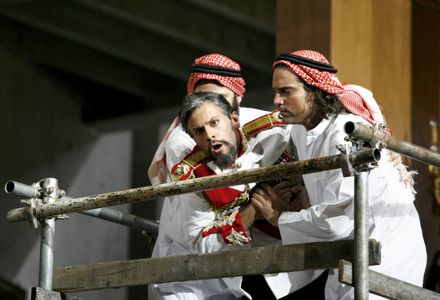 Alex Esposito as the Pharaoh, photo Studio Amati Bacciardi
Alex Esposito as the Pharaoh, photo Studio Amati Bacciardi
The enormity of the subject and its realization was full force in this sleepy seaside town, the birthplace of the great Rossini. Its 15,000 seat sports palace, the Adriatic Arena is now home to one of the three major productions of this August festival (the other two are in the 19th century Teatro Rossini). But wait! Walls and a ceiling (new this year — that nasty echo is no more) are installed, those 15,000 seats are reduced to 1200. A huge space remains for a scenic installation.
The drafty, leaky Adriatic Arena has become surprisingly one of the world’s most exciting opera venues. Opera there is out-of-the-box so to speak, and has been for several years, notably the scenic installations of Zelmira (2009) by Italian director Giorgio Barberio Corsetti (critics attacked its political illiteracies) and Cenerentola (2010) by Italian director Luca Ronconi. There are no directors more in-the-box than Graham Vick (the stage housings of the Met, San Francisco War Memorial, etc.). Maybe it should have been no surprise that he can ascend to the heights of the great Italian theater directors, but it was.
Rossini’s exquisitely beautiful third act prayer by Moses, Aaron, Elcia and chorus of Hebrews was punctuated by random sniper fire executing the Egyptian eldest sons (its sound mute, its victims’ fell sharply echoing the suddenness of the gunshot). Special forces commandos stormed the Adriatic Arena pursuing the Jews (some audience fled in terror [yes, this really happened]) for whom the sea parted for their crossing into the Promised Land. The Egyptians are destroyed but for one lone surviving boy. He straps a bomb onto his body as a lone Israeli soldier climbs out of a tank and offers him a detonator.
Wrenching.
Conductor Roberto Abbado had propelled the Zelmira to plateaux of lyric delirium as he had the Ermione (2008), a brilliant Adriatic Arena installation directed by his cousin Daniele Abbado. But this was another Rossini, the delirium replaced by lyric solemnity, much like the tone of the Rossini Stabat Mater, but with extended dramatic scenes for soloists. Bass Alex Esposito, the Egyptian pharaoh, exploded in his Cade dal ciglio il velo, terrifying in its runaway machismo. Tenor Dimitry Korchak, the pharaoh’s son and soon lover of the Hebrew girl Elcia lamented her loss in clumsy, brutal moves of male domination. Soprano Sonia Ganassi as Elcia tore at our hearts in her supplication to him to release Moses.
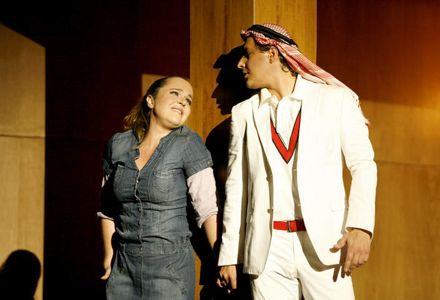 Sonia Ganassi as Elcia, Dmitry Korchak as Osiride
Sonia Ganassi as Elcia, Dmitry Korchak as Osiride
photo Studio Amati Bacciardi
New at the Rossini Festival productions this year were supertitles. Tottola’s text however is virtually incomprehensible in the archness of its style and the richness of its archaic vocabulary that fit the perceived gravity of a biblical subject. Never mind that the supertitles were washed out by the crescendo of brilliant light during the Eterno! immenso! incomprensibil Dio!, Maestro Abbado simultaneously effected a spine tingling choral crescendo that took us into and beyond the text, and kept us there until the opera’s final moment.
Ovations at the Rossini Festival are usually reserved for a singer who has executed a difficult aria with finesse, and these ovations are extended often over several minutes. Here these extended, very extended ovations occurred only at the ends of the acts, the astonished audience unwilling to leave its seats.
The individual performances were subsumed into the Graham Vick production of this Rossini masterwork. Nonetheless besides the flashy performances of brilliant singing mentioned above Riccardo Zanellato as Moses captured the anger and passivity of this complex personage with exceptional beauty of voice and delivery. Young Chinese Ylhe Shi as Aaron continues to mature as a Rossini tenor, here showing a new confidence that propelled this secondary character to unexpected emotional stature. The chorus of the Teatro Comunale of Bologna rose to unprecedented glory in its huge roles as the Hebrews when not as the Egyptians.
The premiere of Adelaide di Borgogna was in December, 1817, the premiere of Mosé in Egitto in March, 1818, thus the two works were composed back to back and performed just now in Pesaro back to back. Both works chronicle the fall of a father and son, both works explore human relationships in politically charged atmospheres, and both end in hollow political victories.
The librettist, Giovanni Federico Schmidt had written the libretto for Armida (upcoming at the Met) earlier the same year. Adelaide di Borgogna was the wife of Lotario, the last Carolingian king of most everywhere in those days, though Schmidt is quite confused about dates and happenings. Never mind, as opera is about opera and not about history as Rossini and Graham Vick know.
In Schmidt’s libretto the widowed Adelaide is told by Lotario’s successor, Berengario that she must marry his son, thereby legitimizing the succession, You can imagine the rest of the story. And yes, she finally marries Ottone, making him Otto I, the first Holy Roman Emperor while Berengario and his son Adelberto are taken away in chains. The operatic problem is that Adelberto truly loves Adelaide, and that maybe Berengario did not murder Lotario after all.
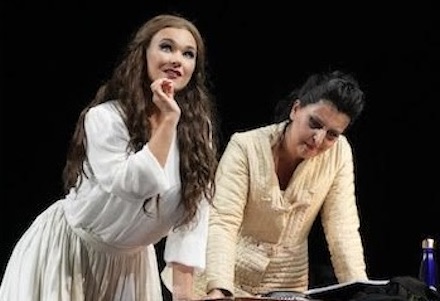 Daniela Barcellona as Ottone, photo Studio Amati Bacciardi
Daniela Barcellona as Ottone, photo Studio Amati Bacciardi
Italian avant-gardiste of the 1980’s Pier’Alli was the stage director. He also did sets, costumes, video projections and lights. He did not have Graham Vick’s good luck — no pregnant political metaphor comes to mind nor does the challenge of the Adriatic Arena present itself. But he did have video to play with, and that can be pretty cruel too.
The Teatro Rossini stage is small, challenging some contemporary metteurs en scéne to overcome this perceived limitation. Mr. Pier’Alli explored the digital technology that has exploded in theatrical scenic applications. Apparently no one informed Mr. Pier’Alli that you cannot watch a movie of a mud puddle and live opera at the same time, that moving images, particularly geometric images in absolute synchronization with musical architecture gets old fast, and that fast visual information (image stimuli) is not consistent with fast musical stimuli (Rossini, for example). Not least, Mr. Pier’Alli who trained as an architect is visually imprisoned by absolute structural symmetry. His mise en scéne was suffocating, if at best sort of pretty.
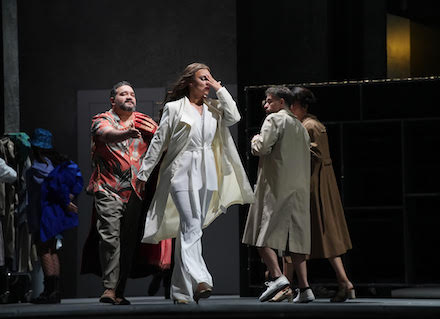 Jessica Pratt as Adelaide with Daniela Barcellona as Ottone
Jessica Pratt as Adelaide with Daniela Barcellona as Ottone
photo Studio Amati Bacciardi
Against Schmidt’s strange account of historical happenings and this mise en scène Russian conductor Dmitri Jurowski deployed a score that is not one of the Rossini masterpieces, and in fact may not all be by Rossini. The orchestra of the Teatro Comunale of Bologna responded with warmth of tone and obvious sympathy for the maestro whose tempos were indeed sympathetic to the needs of the singers. This maestro however did not connect with the Rossini ethos, and in this opera maybe Rossini does not either.
Mezzo soprano Daniella Barcellona is one of the Rossini Festival’s greatest treasures. Though she is surely the world’s prima donna assoluta of Rossini pants roles, even she could not make Ottone, the cardboard savior of poor Adelaide into a sympathetic hero. Our sympathies were with young Romanian tenor Bogdan Mihai as Adelberto whose vocal and histrionic innocence won us over to his father’s side. Australian soprano Jessica Pratt as Adelaide was the prize but her mannered piano singing and stolid presence captured none of the Rossini flash that could have made her operatically desirable to either suitor.
Mme. Pratt did know enough to hit her high E forte so she drew wild applause from an audience susceptible to the high is hard fallacy. On the other hand solid performances in high style were delivered by Italian baritone Nicola Ulivieri as a sympathetic Berengario and by Italian mezzo soprano Francesca Pierpaoli as Adelaide’s protector Iroldo, performances greatly appreciated by all of us Rossinians from all over the globe.
N.B. Graham Vick’s Mosé in Egitto was wildly cheered and wildly booed at its first performance, probably because Mr. Vick took a bow. Earlier that evening real riot police were brought in to quell a fight among patrons that broke out in the auditorium. At this second performance above the audience was enthralled though there was one lone boo heard.
La Bohème at Torre del Lago
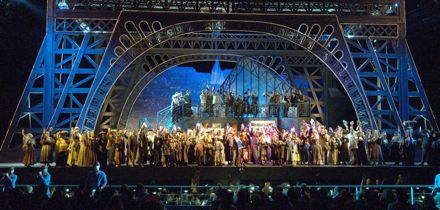
This is where Puccini composed many of his operas until the lake got so polluted he had to move to nearby Viareggio.
Like Bayreuth the Torre del Lago is devoted exclusively to the works of one composer. But unlike Bayreuth the Fondazione Puccini exerts little effort to glorify the legacy of this remarkable composer by staging productions that may fulfill the operatic expectations of the unwashed masses but leave serious Puccini disciples aghast.
Such was the effect of La Boheme (8/12) seen from press seats in the 26th row of the 3200 seat Gran Teatro all’Aperto Giacomo Puccini at the edge of Lake Massaciuccoli, a sort of swamp by the Mediterranean near Pisa. Actually the 26th row is even more distant from the action than it would ordinarily be because not only are there several wide lateral aisles between sections, there is also a lot of legroom (a boast of the management).
Thus those of us in this section felt rather remote from the performance, encouraging some seaside bathers sitting nearby to follow the libretto on the screens of their cell phones with the added advantage of not missing urgent text messages, and others to sotto voce the story to their children — the lack of supertitles thus compensated (though these kids were far too young to read). After the first act the audience readjusted itself and we found seats in the 16th row amidst more serious spectators.
Here at least there was something to appreciate — the well-schooled verismo conducting of Alberto Veronesi was apparent (Mo. Veronesi is Eve Queler’s successor at the Opera Orchestra of New York), and the proficient opera acting and idiomatic Italian tenor singing of Venezuelan Aquiles Machado as Rodolfo was pleasurable. The mature style and presence of Italian baritone Marzio Giossi balanced the lively young and appropriately Italianate Colline of South Korean bass Seung-Pil Choi (it had to be him though the program gave another name).
Italian soprano Anna Maria dell’Oste made some fun as a Musetta who knew all the classic moves. Of the principals only the Mimi of Italian soprano Serena Farnocchia disappointed, her Mozartian delivery and matronly presence failed to capture the musical and dramatic energy imparted by the rest of the cast. Most notably it was Mr. Machado who generated real Puccini magic in his third act farewell to Mimi and with his final cries at her death. He accepted his abundant applause with extravagantly florid bows.
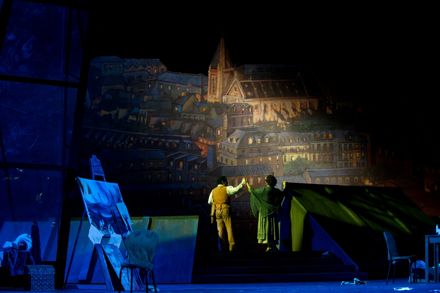
Rome Opera resident stage director Maurizio di Mattia moved his very experienced cast with slick flair, though he imposed a tasteless appearance of Puccini himself to watch the death scene. Rome Opera scene painter Maurizio Varamo designed the sets and presumably it was he who painted a quite wonderful backdrop of Paris for the set. But its architecture betrayed crudeness and naivete, especially the kitsch Tour Eiffel. The production was first seen in Hong Kong where it was not un-appreciated.
In flagrant disregard of current performance practice principal bows were effected after each of the four acts cruelly lengthening the evening, interminable already because of the clumsy production could not possibly be organized into the now usual two part format. A lot of fine Pommery champagne, a sponsor of the festival, flowed between the acts making the sculptures in the large garden seem very witty indeed by the early morning hours of the next day.
Aix-en-Provence Festival 2011
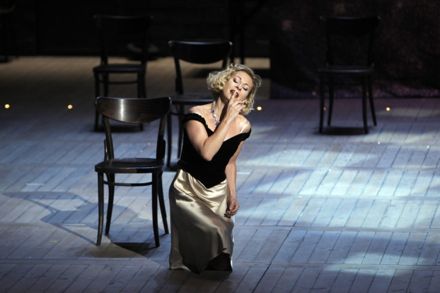 Natalie Dessay, photo courtesy Aix Festival, copyright Pascal Victor / ArtcomArt
Natalie Dessay, photo courtesy Aix Festival, copyright Pascal Victor / ArtcomArt
Natalie Dessay is more or less a national hero here in France, maybe even more famous than Carla Bruni. Nonetheless there are those of us who are not fans of Mme. Dessay, thus we were relieved to be able to attend one of the four performances of La traviata sung by Irina Lungu.
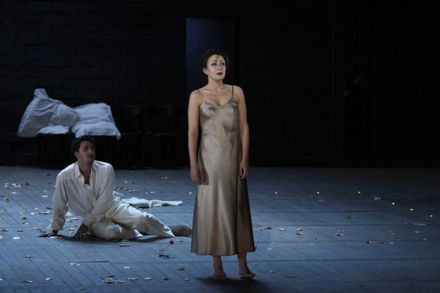 Irina Lungu and Charles Castronovo, photo courtesy Aix Festival, copyright Pascal Victor / ArtcomArt
Irina Lungu and Charles Castronovo, photo courtesy Aix Festival, copyright Pascal Victor / ArtcomArt
Ironically the star of this traviata finally was not Mlle. Lungu nor probably was it la Dessay but its metteur en scene Jean-François Sivadier, an actor and later playwright who declared his love for la traviata back in 1996 in a theater piece that became very famous in France. Called Italienne avec orchestra, it was based on fictional rehearsals for a presumed production of La traviata.
Mr. Sivadier has truly fulfilled his dreams these many years later, and given enormous pleasure to Aix audiences with his finally finished traviata. For Mr. Sivadier Violetta is not a courtesan but an actress, a calling far more familiar to most of us these days. Though a concession to current perceptions is not Mr. Sivandier’s intention (he offers a convoluted rationale in his program booklet apology) it was an interpretive tool that accommodates a diva as an actress, not troubling her to attempt a character, here Piave’s sympathetic courtesan.
The hard part was not seeing Mme. Dessay, for whom Mr. Sivandier’s production was finally created, in every move and gesture made by young Russian soprano Irina lungu, an ingenue traviata. Once past this distraction however Mlle. Lungu made this Violetta her own, her fresh voice, burnished tone and fine Italianate style well sustaining the substantially different vocal demands of the first and last acts, her almost convincing diva stage presence unencumbered by a famous name and excessive fame.
Mr. Sivandier’s traviata catalogued virtually every twentieth theatrical cliché, from Brechtian devices to physical theater, from Stanislavski acting to cinematic realism, and of course plenty of scenic graffiti. Since his basic metaphor was self-conscious theater the use of such diverse techniques was central to his concept, and amusingly appropriate.
The traviata herself was the most theatrically abstracted character, dying without so much as a cough, simply walking forward into bright light with the blackout just at the moment she would step into the pit. Alfredo was the least abstracted character, the admirations, supplications and sufferings of a most sympathetic Charles Castronovo were cinematically real, and very human. This young American tenor is a light voiced, stylishly correct singer. He sang all ten performances, some back to back, perhaps explaining the cracked b-flat as he stormed off-stage to follow Violetta to Paris (7/18).
Germont fulfilled the psychological reversals (reinterpretations) that fulfill later twentieth century theatrical exigencies. No longer the gentle, hurt father French baritone Ludovic Tézier realized a bullying Germont with steely tone and threatening, uncomfortable presence. And yes, the Di Provenza cabaletta was restored, dramatically motivated by a cowering Alfredo. Mr. Castronovo is a fine actor.
This Aix traviata was made festival fare by availing itself of unusual operatic collaborators. Veteran opera conductor Louis Langrée conjured a traviata of extraordinary sweetness and passivity taking advantage of the symphonic resources of the London Symphony Orchestra, indulging in beauty of symphonic tone rather than dramatic pressures. The Estonian Chamber Choir provided pleasurable, excessively careful tone and musicianship in its stolid presence, betrayed by the two female choristers who executed fine physical theater, full body death collapses in their fourth act rejoicing, a vista in Mr. Sivadier’s rehearsal production.
The action of Mr. Sivadier’s opera took place on an empty stage during Traviata rehearsals — a constructed empty stage erected on the stage of the Archeveché theater. The back wall was black, simulated brick. There were minimal costumes (Annina was Violetta’s wardrobe assistant) — Violetta’s rehearsal costume was a leftover sort of commedia dell’arte Colombina). There were few hand props — flower bouquets presented to the diva by admirers, and champagne glasses. A few small painted cloud flats and de rigueur crystal chandeliers flew in from time to time to suggest locale.
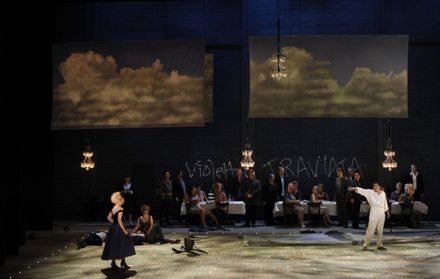 Violetta, Alfredo, photo courtesy Aix Festival, copyright Pascal Victor / ArtcomArt
Violetta, Alfredo, photo courtesy Aix Festival, copyright Pascal Victor / ArtcomArt
The Aix Festival’s La clemenza di Tito occurred within the actual empty stage housing of the Archeveché Theater, the back wall of which is the south courtyard facade of this old bishops palace. This last of the Mozart operas was staged by David McVicor, a member of good standing of the British opera director cabal. Perhaps this accordance to British artistic imperialism was determined by the presence of the London Symphony Orchestra succeeding the Berlin Philharmonic as the festival’s orchestra in residence.
The LSO was again in the pit, with none other than Sir Colin Davis at the helm, though at this point he is more a reverential presence than a musically inspirational one. But we enjoyed rock solid Anglo-Saxon sound, musicianship and style. All this added little to the performance (7/06) as this strange, anachronistic opera seria demands a determined pit presence, here sorely lacking.
The Aix Festival at its best profits from intelligent artistic gullibility, but it was obviously tricked into acceding to stage director Mr. McVicor the creation of the scenic space for his staging of Tito. This amounted to a clumsy, huge gray stair unit (some sort of temple) stage left, and a couple of black columns sitting on a small black platform stage right. Both units rolled on and off stage from time to time, though a monumental white marble statue of Tito remained on the stage all the time. Its face turned red when Sextus was to be executed at Titus’ command.
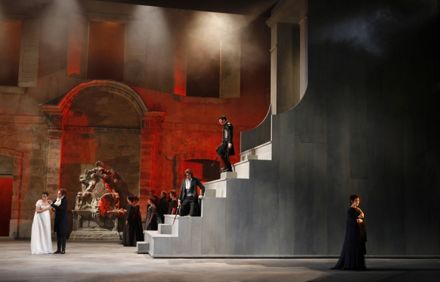 Photo courtesy Aix Festival, copyright Pascal Victor / ArtcomArt
Photo courtesy Aix Festival, copyright Pascal Victor / ArtcomArt
Yes, you got it — shades of black, white and red (for blood). Red lighted theatrical fog (i.e. smoke) oozed through the apertures of the façade of the bishop’s palace during the Roman uprising. All this Mr. Vicor’s idea of minimalism.
Tito was costumed in a white satin 18th century formal court dress quotation that included a powdered wig and shiny white shoes. He dragged a twenty-foot mantel that he tried to fold up when governing became all to much for him, and comically it was a bit much for him to organize Mr. Vicar’s conceit. But Tito finally forgave everyone, almost. Mr. McVicor had a surprise up his sleeve — Tito’s eight black costumed, semi-balletic dragoon figurants (extras) skewered Vitelia (a solid black gown)! Blackout!
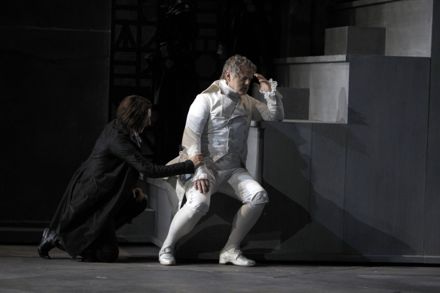 Tito, Sextus, photo courtesy Aix Festival, copyright Pascal Victor / ArtcomArt
Tito, Sextus, photo courtesy Aix Festival, copyright Pascal Victor / ArtcomArt
American tenor Gregory Kunde took the place at the last minute for an indisposed John Mark Ainsley as Tito. Mr. Kunde has enjoyed much success at the Rossini Festival in Pesaro over the years. He is not a Mozart singer nor an elegant performer. Italian soprano Carmen Ginnattasio as the antagonist Vitelia offered mannered, spat Italian with grating “r”’s — fun for a while. English soprano Sarah Connolly brought solid Anglo-Saxon artistry to Sextus, but nothing more.
Win some, lose some.
The third and last big production of this sixty-third Aix festival was Shostakovich’s Le Nez/The Nose (ticket price $340), a co-production with New York’s Metropolitan Opera where it opened last year (ticket price $240 +/-), and the Opéra de Lyon where it plays in October (ticket price $140).
South African artist/actor William Kentridge is the author of this production, thus instead of the filter of a symphony orchestra between the opera and its production (as for the Traviata and Tito) there was the filter of a mature, powerful contemporary visual artist to distance us from this youthful experiment/prank/masterpiece (composed by Shostakovich when he was 22 years old).
Casting was as problematic as it had been in New York. South Pacific star Paulo Szot, the Met’s Kovaliov (who loses his nose), had been replaced by Albert Schagidullin who was replaced after the program was printed by Vladimir Samsonov. Though a veteran of the role at Paris’ Bastille Mr. Samsonov who began his career as an operetta artist was not a big enough singer or strong enough performer to command the stage in Aix.
In his previous opera productions (Il ritorno d’Ulisse and Die Zauberflöte) Mr. Kentridge has used puppetry to great effect. This theatrical abstraction is echoed in his visual art in abstracted black two-dimensional human forms on white background and sometimes some red lines as well, and here these paper cut-out forms sometimes re-appeared in marching formation during musical interludes.
Mr. Kentridge offered many collages as well including a show curtain that was an abstracted newspaper with both English and now French catchy news items teasing early socialism. To distance or distract us further from Gogol’s derisive text other interlude collages included such video images as a middle-aged Shostakovich playing the piano!
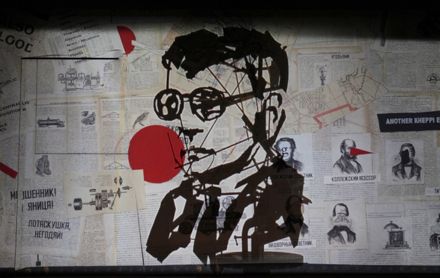 Photo courtesy Aix Festival, copyright Pascal Victor / ArtcomArt
Photo courtesy Aix Festival, copyright Pascal Victor / ArtcomArt
Mr. Kentridge’s visual language is essentially good natured, with studied charm. He projected this temperament onto the staged scenes by making Sweeney Todd like vignette’s pop out of the show curtain from time to time. This technically complex, completely finished production teetered on the edge of popular musical theater. Maybe this is why the public in the 1350 seat, indoor Grand Théâtre de Provence roared its approval (7/08), and the word on the street was that it was a great show!
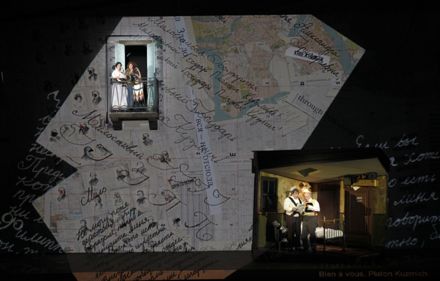 photo courtesy Aix Festival, copyright Pascal Victor / ArtcomArt
photo courtesy Aix Festival, copyright Pascal Victor / ArtcomArt
The strengths of the production were the resources of the Opéra de Lyon, its music director Kazushi Ono providing a chiseled if somewhat restrained reading of this extravagant score by the fine orchestra of what is certainly France’s premier opera company. The contributions of the chorus of the Opéra de Lyon gave real pleasure as well.
To these strengths add the fine, appropriately expressionistic, exaggerated characters of Gogol’s ravings enacted by tenor Andrei Popov as the Inspector, Vladimer Ognovenko as the Barber and Vasily Efimov as Kovaliov’s servant (all veterans of the Met cast). The casting of Tehmine Yeghiazaryan as the Daughter of Madame Podtotchine is however inexplicable (after all you paid $340 for your ticket!).
Coupling Mr. Kentridge’s puppetry with Mozart’s puppet opera masterpiece, The Magic Flute made sense. His production was enthralling. In Aix just now however the strident young Shostakovich was shortchanged. It was a long one hour forty minutes.
Les Noces de Figaro in Paris
This is the one by Giorgio Strehler that opened at Versailles in 1973 and since has endured twenty-three incarnations, first at the Garnier and later at the Bastille. Anyone who is anyone in the pantheon of Mozart interpreters over the last forty years has gone through the paces of this Strehler masterpiece.
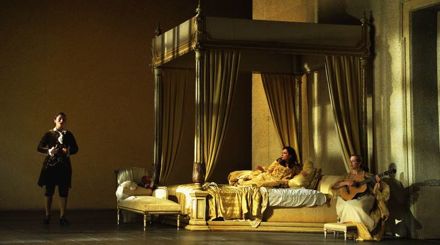 Cherubino, Countess, Susanna
Cherubino, Countess, Susanna
It did have a brief respite during the Gerard Mortier five year reign of terror. To everyone's relief it is back now ostensibly as a tribute to Rolf Liebermann (the celebrated progressive impresario who succeeded in staying in conservative Paris for seven years in the nineteen-seventies) but actuality it is an appeasement to Parisian audiences for whom it has become, purely and simply, the Mozart masterpiece.
Based on its current edition at the Bastille it is a Marriage of Figaro none of us should go without. Not to worry if you have missed it so far. It will surely be back, and with whoever are the stars of the moment. The Strehler Noces is as Parisian as is, well, the Opéra or for that matter the Tour Eiffel. It is the embodiment of the elegance, refinement and grace that define La Ville-Lumière.
Its roots are in mannerisms, the little movements of physical comedy that were sculpted by the comedians of the Italian renaissance, then refined by Italy's eighteenth century dramatists, and finally distilled by Giorgio Strehler. It is like the theatrics of the French royal courts that have become elaborated over the centuries into French politesse, haute couture, haute cuisine, etc. Simply to say that the ultra controlled, hyper refined theatrics of Giorgio Strehler very well mirror an idealized French spirit.
Though strange to say it was the musical refinement of the current production that very nearly upstaged the Strehler elegance. Israeli conductor Dan Ettinger unleashed the lyricism Mozart lavished on the individual instruments of the orchestra that brought this familiar music to new plateaux of delicate pleasures. The horn duet in Se vuol ballare, the oboe solo in Dove sono, the resonant pizzicato strings in Deh vieni leap out as examples, but the overwhelming orchestral lyricism was everywhere and always.
The cast was perfection. The program bio of Uruguayan bass Erwin Schrott unabashedly declares him to be the Figaro of the moment, a claim well proven by his distinctive dark voice, physical agility and sympathetic authority. His nearly speech-like delivery of recitative was remarkable. The Susanna of German soprano Julia Kleiter was physically, even vocally well matched to the Countess of German soprano Dorothea Röschmann to make Strehler's very presentational staging of the disguises far less tiresome than usual.
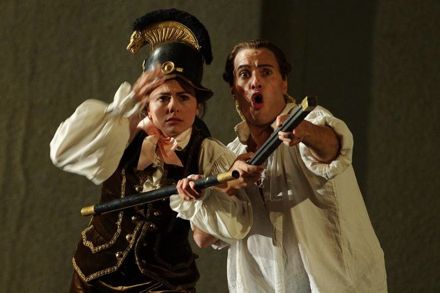 Cherubino, Figaro
Cherubino, Figaro
Both sopranos are no-nonsense artists, penetrating the heart of the music and letting it naturally flow to the obvious great pleasure of the maestro who melted Mozart's eloquent orchestra to their voices. It was extraordinary music making. British baritone Christopher Maltman brought bark and bite and unusual fun to the Count, plus new, sly insight into his often tiresome aria that perceptibly deepened his character and enlivened the denouement of Figaro's financial predicament.
American mezzo Isabel Leonard may now compete with Federica von Stade as the Cherubino of your dreams, combining easy postures with consummate charm, upholding the impeccable musicianship that validates this travesty. The there-can-be-no-opera-in-Paris-without corps de ballet crashed the wedding scene, and the intrusion only gained validity when Mlle. Leonard leapt into the balletic fray with a virtuostic display of dance that conclusively proved her manhood (one did wonder how la Von Stade and all the others pulled this scene off).
The Marcellina of British mezzo/comedienne Ann Murray was exemplary. The Bartolo of Maurizio Muraro and the Basilio of Robin Leggate were rendered less present than usual in this production by the persuasive musicality of the five principals.
The extant members of the original production team were said to be involved in mounting this latest incarnation — Ezio Frigerio (sets and costumes), Franca Squarciapino (costumes), Marise Flach (movement). The actual credit for this and perhaps many other incarnations of the Strehler Noces belongs to Humbert Camerlo, an original member of the Libermann directorial staff who will have adapted the individual personalities of its current interpreters to the original Strehler conception.
Dido et Enée in Toulon
There is a problem with Henry Purcell's little masterpiece. The problem is that it is little. It takes Purcell only about forty-five minutes to dramatize Dido's happiness, her too great pride and the tragedy of Carthage. It is an immense emotional outpouring that is the stuff of grand opera. It deserves to stand alone.
No opera company dares. Toulon Opera offered what may be the best solution yet by staging Purcell's 1692 cantata for chorus and six soloists, Ode to Saint Cecilia (Hail, Bright Cecilia!) and inserting his 1689 Dido and Aeneas masque into the midst of it. The performance grew thus to two solid hours of splendid music making it an afternoon of musical and histrionic sensibility in complete harmony with itself. Well maybe Dido did get a bit lost among the cantata's musical splendors but who cares.
Saint Cecilia is, if you did not know, the patron saint of music who was martyred in the second century A.D. There is no back story that can link her to the Baroque Dido who sacrifices herself to love. But more directly Purcell's cantata is a celebration of the powers of music, and Dido and Aeneas is one of opera and therefore music's greatest moments.
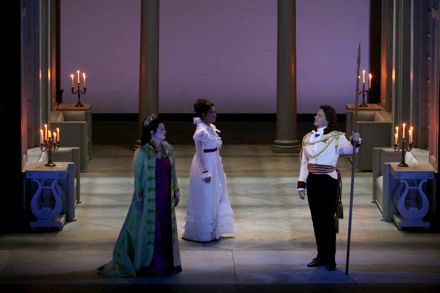 Dido, Belinda, Aeneas
Dido, Belinda, Aeneas
In Toulon the music was powerful indeed, Toulon's chef d'orchestra Giuliano Carella was the driving force. Mo. Carella does not seem to be an early music specialist, his apparent domain is Verdi, verismo and bel canto. So the fine players of Les Bijoux Indiscrets (an early music ensemble based in Toulon that provided the continuo and other Baroque accoutrements) mixed in with members of the Toulon opera orchestra can be forgiven for delivering an incomprehensible overture, a nine minute mess.
If this maestro does not resonate with straight forward primitive instrumental music he does resonate with voices. Air after air poured forth from the elaborate Baroque rooms that were the stage, magically inhabited by a group of remarkably young, evidently versatile opera singers (only one boasted early music credits) who enacted the Hail, Bright Cecilia. Dido appeared at the celebration, marked only by her crown and a solid red gown, Aeneas then arrived in splendid dress uniform, the flower of seventeenth century heroic military portraiture.
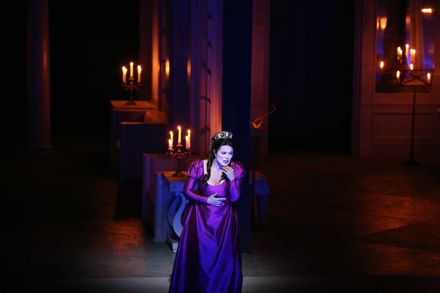 Dido
Dido
The flow of airs was interrupted only by the intense confrontation of Dido and Aeneas. Dido then gave her farewell and Purcell's most famous chorus crowned the tragedy. Purcell's cantata resumed with grandiose music that celebrates war as well as love. At last everyone except Dido who was dead and Aeneas who had left gave a mighty farewell to Saint Cecilia. The matinee audience was mesmerized by Purcell's lyricism rendered as purest bel canto.
Among the most pleasurable airs of the cantata were 'Tis Nature's Voice and In Vain the Am'rous Flute sung by Argentine tenor Manuel Nunez Camelino whose every movement elegantly seconded Purcell's musical phrases. Affective lighting deepened further the abstract drama of the verses he sang. In fact abstract, choreographed movement imposed by Italian stage director Massimo Gasparon informed all airs, duets and choruses of both the cantata and the opera with visual stimulation that was musical rather than dramatic.
Italian soprano Anna Caterina Antonacci impersonated Dido with diva appearance and attitude appropriate to the translocation of Purcell's little opera into a sumptuous Baroque drawing room. Mr. Gasparon imagined this tragic episode in Virgil's account of the founding of Rome not as political tragedy (the fall of Carthage) but as a sudden domestic tragedy that interrupted a grandiose, eighteenth century formal gathering.
The new production (sets and costumes) was designed by Pier Luigi Pizzi, a well-known Italian designer/director. Though Mr. Gasparon is often an assistant to Mr. Pizzi, here the tables are a bit turned with Mr. Pizzi's designs supporting Mr. Gasparon's conception. Mr. Gasparon does separately boast impressive early opera credits, including Handel's Tancredi for Toulon in 2005. This Dido and Aeneas showed a musical and particularly staging polish that is all too rare in Toulon.
Don Giovanni in Marseille
Scratch the surface of Mozart's Don Giovanni and you have infinite possibilities for revisionist productions, among them the infamous Dimitri Tcherniakov production seen last summer 20 miles up the road at the Aix Festival.
But the Opéra de Marseille is a staid company that stands by solid vocal and musical values and avoids challenging its audience with current operatic fashion. The consequence is that from time to time the audience faces more insidious challenges, like monotony and sometimes boredom.
Marseille revived its 2005 production of Don Giovanni directed by Frédéric Bélier-Garcia, a theater director who now heads the Centre Dramatique Pays de la Loire. He takes Don Giovanni absolutely at face value — a string of magnificent arias, duets and trios plus its stupendous finales, he applies theatrical flourish with slick movement and a well-designed set and smart costumes. An obvious recipe for success, and it could have worked with the generally quite respectable cast Marseille assembled.
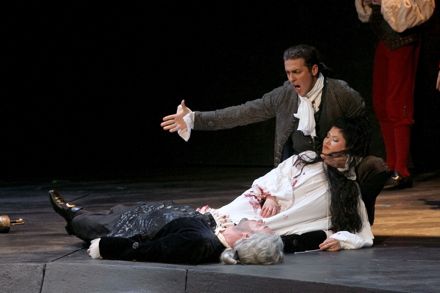 Commendatore, Don Ottavio, Donna Anna
Commendatore, Don Ottavio, Donna Anna
Russian tenor Alexey Kudrya stole the show as Don Ottavio. This absolutely unique accomplishment was effected by extraordinarily fine delivery of his two arias not hampered by any idea of who this character may be. It was enough to know that his fiance was somehow and somewhat injured by someone. Mr. Kudrya simply gave the biggest vocal performance.
Usually the domaines of big voices with big musical personalities both the Donna Elvira of Canadian soprano Marianne Fiset and the Donna Anna of Turkish soprano Burcu Uyar were miniature performances. Mlle. Uyar in her elegant black (she is in mourning as you know) gown exhibited elegant musicianship and vocal finesse. Mlle. Fiset in her amusing gold gown topped by a military jacket and black tricorn (three pointed hat) is a natural comedienne and a fine singer to boot. She was a delightfully comic Elvira who did not ignite the vocal fireworks inherent to this role.
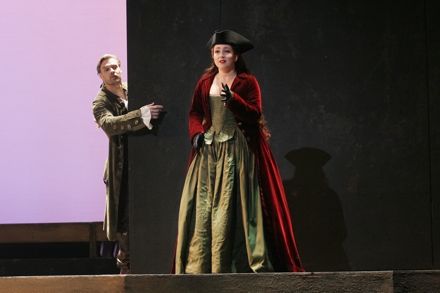 Don Giovanni, Donna Elvira
Don Giovanni, Donna Elvira
Leporello, sung by Austrian baritone Josef Wagner was vocally and physically well matched to the Don of Canadian baritone Jean-François Lapointe, making the disguise scenes potentially more fun than usual. Both gentlemen are fine artists who worked very hard to insert life into their generic characters. Mr. Lapointe was upstaged during his serenade by an elegantly dressed mandolin player who stood beside him as he sang directly to the audience. Mr. Wagner attempted valiantly to add life to the production by clacking his heels from time to time.
French baritone Vincent Pavesi was a naturally oafish Masetto and German soprano Emilie Pictet was a generic Zerlina. These pivotal roles however did not contribute the vocal and histrionic weight needed to complete Mozart's tragi-comedy. On the other hand the Commendatore sung by French bass Nicolas Courjal made this often understated personage very present and pleasurable.
All this was presided over by Austrian conductor Theodor Guschlbauer who took slow, very slow tempos and imbued each aria, duet, etc., with its maximum musical importance. Mozart's individual pieces became building blocks for what seemed and sounded like a massive symphonic construction. Though surely it was Mr. Bélier-Garcia who placed Don Giovanni's party orchestra on stage, no doubt it was the maestro who distanced a few inside voices of this orchestra downstage right and left to insist on imposing the idea of musical structure — imagine this famous dance musically inside out!
But back to the Aix Giovanni — Mozart's coda, the final sextet, somehow disappeared into the bickering of a frighteningly dysfunctional family. Not so in Marseille where it glowed with musical splendor. At that point however it was hard to care.
Akhmatova in Paris
The very name Mantovani strikes musical terror in the hearts of high minded Americans and Brits of a certain age. Now the same surname is evidently terrorizing Parisians.
At least it seemed so, judging by the empty seats of the sixth and final performance of Bruno Mantovani's Akhmatova at the Bastille (and the even more empty seats after intermission).
Just when Parisians have breathed a collective sigh of relief that the Gerard Mortier reign of terror has ended. [Gerard Mortier is a notorious impresario now in Madrid.]
 Mme. Akhmatova, Modigliani sketch of Akhmatova
Mme. Akhmatova, Modigliani sketch of Akhmatova
This French Mantovani (only the name is Italian, with no relation to Annuncio Paolo Mantovani) is 37 years old. His musical idiom is a continuum of sonic explosions effected in astringently classical mediums. For Akhmatova he used a Beethoven orchestra with a couple of clarinets added plus some extra brass and a remarkably restrained percussion battery. In a concert the previous evening of piano music by Mr. Mantovani only the piano keys were struck, there was no amplification or other extra-classical application. His string quartets are just that.
There was a time when an opera was credited to the author of its play, its composer only identified on a second line. Turning back to this custom of bygone centuries let us credit this work, Akhmatova, to its creator, one Christophe Ghristi, dramaturg of the Toulouse Opera who presented the idea and libretto to Bruno Mantovani. It is a book of complex theme and sad to say little poetry.
Strange to say little poetry because Anna Akhmatova, if you did not know, is one of Russia's great poets. Like many of the important Soviet era artists she was tortured by her art and tortured by her social responsibility. Ghristi exposes Akhmatova's tortures not through her poetry, but by recounting a back story — her alienation from her son Lev, alienation that was both artistically and politically motivated. In fact her most beautiful poetry dwells on separation, but Akhmatova knows too that her art is superfluous. Thus by conscience she must condemn her son's defense of the art of his father, the poet Nikolai Gumilyov who was executed by the Revolution.
So we have some pretty big themes put on the table. Too bad that they are left there. The story is told but rarely felt even though Mantovani's orchestra is as sentient as Strauss' orchestra, maybe even moreso. The Mantovani sonic vocabulary is enormous, based on repeated notes, trills, glissandi, and oblique tonal movement in, strange to say, almost Beethovenesque sonority. It is music that is potentially responsive to the biggest and smallest movements of the human spirit.
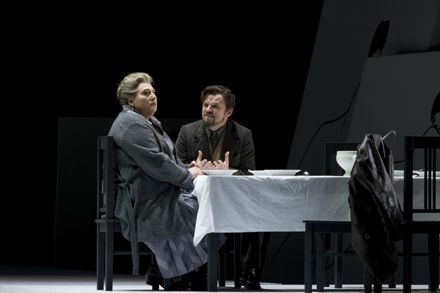 Lev, Akhmatova
Lev, Akhmatova
Note that there are no steps in a progression of tones, the term melody is not relevant. Accords between tones are equally irrelevant, any occasional suspicion of harmony is diffused by quietly apparent foreign tones. Like Rameau who bragged that he could set newspaper copy to music, there is no doubt, evidenced by Akhmatova, that Mantovani could as well — interesting, vital and beautiful music.
Mantovani is a lyric composer who is motivated by word, image and idea, real or imagined, the stuff of poetry. The Ghristi book gave him copy that he colorfully illuminated, but Ghristi gave him no poetry, and surprisingly incorporated a most minimal amount of Akhmatova verse though her quite brilliant poetry was certainly there for the taking!
The Opéra de Paris production directed by Nicolas Joel and designed by Wolfgang Gussmann relied on the usual devices of slick modern storytelling. Its point of departure was the abstract portrait that Modigliani sketched of the 20 year old Akhmatova. This black and white image was omnipresent at the Bastille, and dictated that all color in the production would be within the gray scale (a brief bright red scene in the second act indicated a bit of frivolity). The Modigliani minimalism in fact informed all decor. It is a simplified staging idiom that seemed ignorant of or impervious to the luxuriant compositional techniques of Mantovani.
German mezzo-soprano Janina Baechle was Anna Akhmatova. Mme. Baechle's usual repertory is Mistress Quickly, Brangene, Fricka, etc. The beautiful, young Akhmatova of the Modigliani sketch bore no relationship to the heavy-set, bitter, aged Akhmatova we saw all evening and who only made sense in the opera's third and final act. The first and second acts lacked the presence of the thin, intense, charismatic Akhmatova of middle age who was illustrated by photographs in the program booklet. Such impersonation would have brought vibrancy and finally pathos to Mr. Ghristi's story. As it was Mme. Baechle's quite powerful performance was unfulfilling.
Romanian tenor Atilla Kiss B. [sic] was Akhmatova's son Lev. Mr. Kiss B.'s usual repertoire seems to be emotionally complicated Strauss and Janacek roles, and that was his weight in this production. He is a striking performer who fully embodied the bitter, strident middle-aged Lev returned from the Gulag camps, but missed creating the naivete of Lev the idealistic university student in the early moments of the opera. His impressive delivery of his ugly adieu to his mother begged for the sense of the boy whose innocence was wasted.
The balance of a mismatched cast negotiated the Mantovani vocal lines with aplomb, no easy feat. Mr. Ghristi's phrases were generally declaimed on a single note, jumping, seldom if ever stepping to subsequent tones to further the speech. From the initial downbeat conductor Pascal Rophé made Mantovani's orchestra the center of attention. Perhaps there never was the possibility of the traditional operatic relationship between pit and stage as the Mantovani orchestral continuum naturally absorbs the voice rather than supports it.
Ariadne on Naxos in Bordeaux
Ariadne on Naxos, or you could call it Bacchus á Bordeaux. It was an orgy of art.
The opera's prologue got us pretty concerned about exactly how the Strauss/von Hofmannsthal conceit (superimposing improvised comedy on high art tragedy) would play out. It was going to happen in some sort of distressed art space where some pretty bad art (a huge, plastic sculpture) had been lifted out to make space for more, we assumed, bad art ("performance art" is at least naughty if not usually bad).
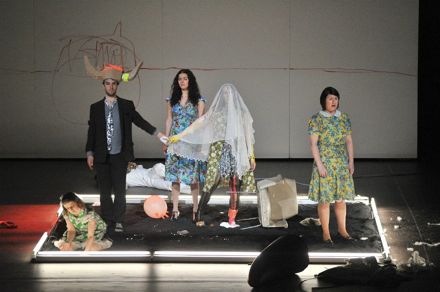 Echo, Harlequin, Najade, Zerbinetta, Dryade
Echo, Harlequin, Najade, Zerbinetta, Dryade
But all this turned out to be a high flying artistic extravaganza. Its riches were three fold — first it is a big opera with three great roles for sopranos, second there were three great sopranos, and third Bordeaux gave the opera a mise en scène that played with its complexities and reveled in its fun.
Performance art is as close as we come these days to commedia dell'arte, so this transcription of art form was well taken, plus performance art seems to question the nature of art more than it questions anything else and this led metteur en scène Roy Rallo to probe the depths of this silly Strauss/von Hofmannsthal tragedia cum commedia and to find out that it is in fact a fairly serious artistic treatise.
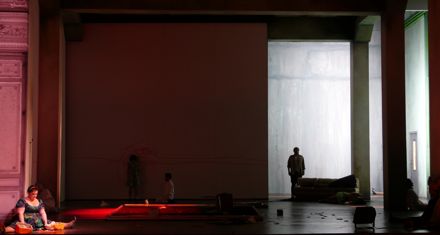 Ariadne, Bacchus
Ariadne, Bacchus
The ubiquitous wreck of a cheap sofa that inhabits most performance spaces here headquartered Najade, Dryade and Echo in various prone positions while stage hands poured buckets of dirt over them, Ariadne was seated in the neon tube outlined sand box, with the remnant, a small head (remember the huge sculpture in the prologue), of a dog's toy that was the minotaur, and Theseus too. Echo outlined the minotaur head on the ubiquitous performance space white wall during Ariadne's lament, and later seconded the forceful horn announcements of Bacchus' arrival with determined throws of her yoyo. More dirt was poured on Najade and Dryade.
When it was Zerbinetta's turn in the sand box she sang her ravishing parody in nightclub garb only to be sexually ravaged by the comedians (painting her in lurid colors). When she became Harlequin's wife in an American gothic tableau during Ariadne's prayer we understood all too well that all this was the trappings of ordinary, everyday mortal love in contrast to the grandiose ideal of love sought by Ariadne.
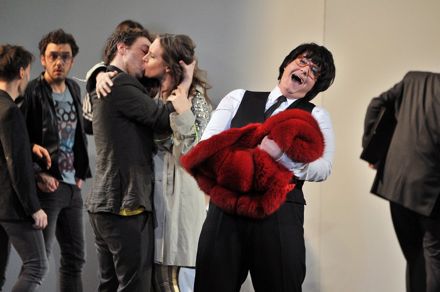 Harlequin, Zerbinetta, Composer
Harlequin, Zerbinetta, Composer
Well, Bacchus arrived and we had Orpheus and Euridice all over again. In reverse. When their gaze finally met it was all over, Bacchus disappeared into the void (all the doors onto the stage burst open — out the back we even saw the building across the street) and Ariadne was left alone on the stage as the beat-up Zerbinetta with her sad Harlequin husband exited through a side door into a snow storm.
So, all this was art, but what about life? That was of course Strauss' Composer who had a bitter artistic pill to swallow, though this young composer thought he had found a soul mate in Zerbinetta, and he poured his heart out about it, only to be first of the opera's lovers to learn that true love is not to be had in this life. Just then there was a bonus: the Opéra National de Bordeaux enriched Strauss' ridiculous concoction by superimposing an operatic whim of its own — real time, curtain calls onto the prologue!
Marsha Ginsberg gave detailed design to the sets, the dirty walls and chipped tiles of a very realistic building blurring the boundaries between art and real life, and costumer Doey Lüethi further complicated this distinction with real clothing that sometimes screamed character. Lighting by Chris Akerlind cannily intermixed the real and the arty, the flashing red and green lights during the opera's final sublime love music reminding us that all this was, said and done, performance art confusing itself with art.
Yes, it took the considerable artistry of three exquisite sopranos to pull this off. Elza van den Heever (Composer), Heidi Melton (Ariadne) and Brenda Rae (Zerbinetta) are new generation artists with beautiful, fresh and well-schooled voices that illuminate amazing histrionic depth with elegant artistry. Mlle. van den Heever literally tore up the stage in her aria. Not to mention that Zerbinetta tore up the stage as well, standing motionless for her aria, and Heidi Melton brought real gravity to the opera's opera, sitting with her back against the wall, her legs splayed downstage, her voice lofting torrents of gorgeous tone.
Conductor Kwamé Ryan drove the big moments of the opera to maximum Straussian effect, and that effect was considerable indeed, though precision and energy were wanting in the detail that Strauss lavishes on his musical story telling. This was most noticeable in the Prologue, though it is possible that this Prologue's laxity was also the result of the heavy-handed exposition of the performance art metaphor.
The Harlequin, sung by baritone Thomas Dolié, created the evening's most touching moments, approaching Ariadne's sandbox with his arms outstretched during her lament, and then as Zerbinetta's forlorn husband. The Music Master was confidently portrayed by Oliver Zwarg. Actor Martin C. Turba as the Major-domo seemed to be at odds with the musical and staging rhythms of the Prologue further deadening it. Tenor Arnold Bezuyen as Bacchus confused bellowing with singing. Najade (Mélody Loulejian), Dryade (Leslie Davis) and particularly Echo (Eve-Christophe-Fontana) brought fine singing and much pleasurable deadpan perspective to Ariadne's suffering.
Parsifal in Brussels
Romeo Castellucci is the cat's whisker of current avant-garde theater directors. Thus it has simply been a matter of time before he would be invited to the Monnaie to stage an opera.
Unlike most avant-garde artists Sig. Castellucci has earned mainstream credibility and recognition (France's major daily newspaper Le Monde named his Divine Comedy cycle the best theatrical event dans le monde for the first decade of the twenty-first century!).
Here in the south of France Sig. Castellucci created one of his eleven-piece cycle La Tragedia Endogonidia for Marseille (each part was created in different cities). We were led, blind, into a black space and left standing, lights illuminated a huge pile of furniture, a brutal action occurred, meanwhile the mess of furniture disappeared and a survivor of the action sat at a piano and played the Gymnopédie #3 (the one everyone knows). Twenty minutes after we had entered the space we left.
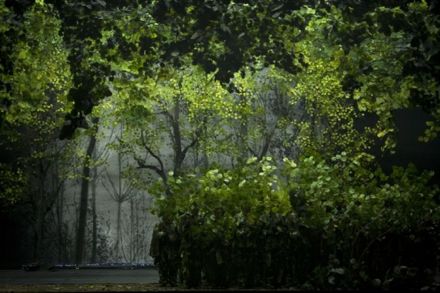 Act I
Act I
In Brussels it was into the splendor of the Théâtre Royal de la Monnaie that we entered and some four hours plus later we emerged. What had happened was that a kinetic mess of a forest (trees kept falling) gave way to a brutal action and the survivor then marched to the Holy Grail. And, uhm, that is more or less what happens in Dante's Divine Comedy too.
While Sig. Castellucci may be stuck in his story telling he is not stuck in the imagery, and that is of course what his art is all about. The Parsifal in the Monnaie was not about Wagner's Parsifal but about Sig. Castellucci's art. And that art is considerable and there is no shortage of self congratulation. To wit, Klingsor is a chef d'orchestre, the holy lance is his baton but Parsifal does not catch it because Klingsor lays it on the floor and walks off the stage. Thus in this improvised second act contest between stage and pit Mr. Castellucci seems to be the winner.
Not to mention that for the entire overture a huge image of Nietsche was projected above the orchestra. FYI Nietsche detested Wagner.
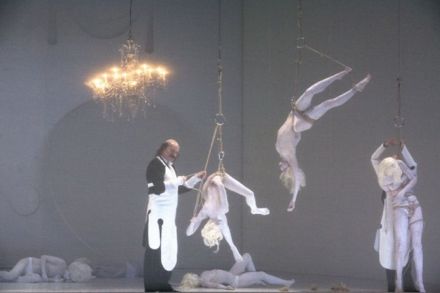 Act II, Klingsor
Act II, Klingsor
Sig. Castellucci's imagistic language is rife with reference, and like most music the images are not metaphors of ideas or translated spaces but superimpositions of impressions. When examined these vast impressions lead to so many conceptual conclusions that no one may be identified as the absolute. Though it is fun to try.
The first unveiling of the Holy Grail is a clue to Sig. Castellucci's artistic intuition. A huge white sheet suddenly covered the kinetic forest, thus all motion stopped as we were confronted only with one small, black quotation mark in this void of white — the word of God? As the final vision of the Grail was unfolding Parsifal and the multitudes marched relentlessly forward it (a rolling stage floor allowed the perpetual forward marching). The lights in auditorium were illuminated — we knew that we are not only a part of the multitudes, we were the Grail itself. Well, why not refer this magnificent affirmation of existence to Satie's insipid ditty.
Too bad for Sig. Castellucci, but the pit won after all. Wagner's magnetic score received a magnificent reading at the baton of German conductor Hartmut Haenchen who was clearly sympathetic to this reduction of Wagner's holy rite to abstract images — his task was now purely musical rather than dramatic. Never before have such sounds emerged from a pit, the antagonistic guttural attacks of the string bows, shattering fortes, earth shaking fortissimos. Most striking of all innovations were the nymphs of the garden scene placed in the pit which gave the maestro opportunity to transform the sweetness of this music into loud music of inexorable persuasiveness. Mo. Haenchen too abstracted Wagner's opera.
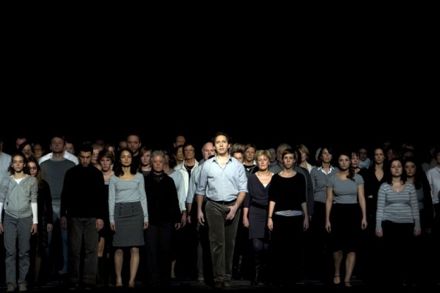 Act III, Parsifal
Act III, Parsifal
For all the brilliance of the imagery and the discovery and superlative implementation of a myriad of scenic techniques, for all the visual excitement created by the plasticity (constant movement) of these images and for the intuitive sense of a supra-eternal artistic presence, those four hours seemed long. The slow succession of Sig. Castellucci's depth images impeded the dramatic flow of Wagner's opera, visual and musical climaxes seldom coincided.
The casting of young American tenor Andrew Richards was a coup de théâtre in itself. This neophyte Wagnerian embodied a Parsifal of genuine innocence, and managed its delivery effectively if with far more sweetness than heldentenor brilliance. Because Sig. Castellucci art is visual rather than dramatic the singers rarely had the support of creating and developing character. Thus much of their success was dependent on sheer vocal artistry. The performances of Kundry (Anna Larsson), Amfortas (Thomas Johannes Mayer) and particularly Gurnemanz (Jan-Hendrik Rootering) missed creating sufficient presence. Klingsor (Tómas Tomasson) had much to do — conducting as well as trussing and hanging ballerinas — and thus made a big impression.
The production is huge and magnificent, and, hear/tell, a bit compromised in execution. It is the idealized stuff of the Aix Festival. May it arrive at the Grand Théâtre de Provence! I would like a second look.
Werther in Lyon
Massenet tells us that his Werther is 23 years old, that Charlotte is 20 years old. Albert is 25 and Sophie is but 15. Just now the Lyon Opera assembled just such a cast.
This unusual casting was the crucial element of an astonishing concept production. Director Rolando Villazón mined the delicate moments of transition between childhood, adolescence and the first revelatory moments of maturity that he divined in The Sorrows of Young Werther. Goethe himself could not argue with Mr. Villazón.
The delicacy of Mr. Villazón's concept was exacerbated by his metaphor. The action of opera's most turgid tale was transferred to the big top — yes, a circus! and narrated in the language of clowning. If all this sounds off-putting, it was. For about three minutes. It became first fascinating, and finally convincing.
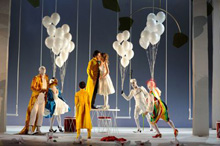 |
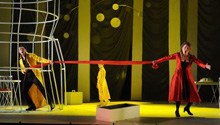 |
The opera wore the concept well, Massenet's local drunks Schmidt and Johann were singing clowns (very good ones) and a couple of young town folk, Katchen and Bruhlmann, were in fact very real circus clowns. Mr. Villazón's clowns were always on or never far from the stage. They complicated the opera's world of childish delights — Massenet's Yuletide begins and ends his opera — by framing the opera's story with the sadness that is inherent in all clowns. They also imposed a blatantly simple language of storytelling.
They cavorted as clowns do (Schmidt's teared clown-face hovered behind Charlotte as she delivered her Va, laisse couler mes larmes, marking its moments with his clown-hand miming). They exploited the clowning technique to use a simple prop to represent a fare more complicated image (a black dress for Charlotte's dead mother, and finally Werther's frock coat for the dying then dead Werther).
Two identical Werthers moved in simultaneous motions on the stage, one the 10-year-old child Werther, the other the Werther who now faces a different world. Mr. Villazón knows that Charlotte is the victim of the opera Werther, suffering the overwhelming forces of maternal love in conflict with nearly equal forces of romantic love. Werther himself has only to cope with the realization that Werther the child no longer exists, but it is Charlotte who must place his tiny frock coat into the small, coffin shaped box of clowning props.
The clowning metaphor was relentlessly pursued, not for a moment did the concept waiver within the appropriate decors designed by François Séguin — the big-top made of many masts supporting flowing cloth, cages, the toys clowns use and an abstracted harpsichord that mimed the church organ sounds of resigned and contented lives. Costume design by Thibault Vancraenenbroeck [sic] underscored the depth of the concept in its deft mixture of period costume and clowning tradition.
This startling concept insisted that we hear this masterpiece as we never had heard it before. And that we did in a very present (loud) orchestral reading that magnified the score s more vivid colors. Austrian conductor Lionel Hager had obvious respect for the concept. He found inspired orchestral realization for the love that flowed though a long red, clown scarf pulled between the Charlotte and Werther. He brought a multitude of fortissimo climaxes to the outpourings of the young Werther. And no real gunshot shocked the musical torrent of the suicide (the gun was merely a prop from the box of toys).
Famed hautecontre tenor Jean-Paul Fouchecourt stole the clowning show as Schmid, well matched by Lyon Opera regular, Syrian baritone Nabil Suliman as Johann. Katchen and Bruhlmann (Marie-Laure Cloarec and Gregory Escolin) managed their few lines somehow and otherwise added artistic sheen as professional clowns. Mr.Escolin embodied yet a third Werther, this one a clown imprisoned in a cage.
Usually the province of a mature, read matronly, artist here Charlotte was gracefully embodied by young French mezzo soprano Karine Deshayes. She is a finished artist with a bright and vibrant voice, a revelation in this role. American tenor Arturo Chacón-Cruz substituted youth and good looks for the refinement associated with Massenet's singer (and Goethe's poet), and had an abundant supply of secure and powerful high notes to win over those not taken in by looks alone. Belgian baritone Lionel Lhote was a gentile, sympathetic young Albert not yet made hard by worldly success. Though obviously far from fifteen Belgian soprano Anne-Catherine Gillet nonetheless captured the accents of incipient adolescence far more than the usual vocal brilliance of Sophie, and this innocence made her endearing.
Rolando Villazón is a tenor of enormous reputation, and obviously a man of directorial vision. At the same time much credit must go to the Opéra de Lyon for seeing this remarkable production through to the end and for adding exceptional polish to such a problemic endeavor.
Mr. Villazón is an admitted amateur clown. Let us hope he has not blown his directorial wad with this bizarre first production. And that he may have other hidden talents to theatrically exploit in future productions. Hopefully some daring opera house will find out.
Cavalleria rusticana and I pagliacci in Marseille
Opera is good in Marseille. The house boasts a good acoustic, a good orchestra, and its singers are good. Make that sometimes really good. Just now Béatrice Uria-Monson was Santuzza and Vladimir Galouzine was Canio in the classic double bill that makes operatic murder seem like real murder.
Add Carlos Almaguer as both Alfio and Tonio and you are close to dream casts. The Turiddu of Luca Lombardo was more effective dramatically that vocally — a mega-tenor is needed ideally to drive Cavalleria rusticana to its ultimate level.
Galouzine's dark hued tenor however quickly reached its apex of tension in I pagliacci as he tore through the explosions of this over-wrought, jealous husband. The double murder was thoroughly satisfying, with the super-sized participation of Mr. Almaguer.
Mamma Lucia was impersonated by Viorica Cortez, reverential casting as she has little voice or presence these days. Nedda was obligatory casting — Mme. Galouzine aka Nataliya Tymchenko gave a light voiced, mannered but convincing performance, well matched by the Silvio of Etienne Dupuis.
While Béatrice Uria-Monson has a troubled career here she was in good voice, more soprano colored these days (she lists a Tosca in Avignon as an upcoming project), and she projected the inner fire and physical energy that has made her the quintessential Carmen of previous decades, and now a formidable verismo diva.
Strange to say Mme. Uria-Monson's fine Voi lo sapete did not earn an ovation, victim of the lackluster conducting of Fabrizio Maria Carminati who could not enforce the emotional urgency of either score. The usually over-wrought, italianissimo conductor Giuliano Carella was the original maestro but had broken his ankle and could not mount the podium — dommage!
The production was by Jean-Claude Auvray. He erected a false proscenium to restrict further Marseille's already quite contained stage picture. A bizarre gesture as this was a co-production with the Chorégies d'Orange where the stage is 300 feet or so wide. But the stage direction (movements of the actors) was à la Orange which is to say that the singers wandered downstage center and fended for themselves. What may be a necessity in thrown together stadium opera did not work in Marseille.
Without precise, thoughtful, dramatically driven movement there were no emotional rhythms created, a lack that precluded building to the inevitable conclusions of the operas' explosive passions. These famed masterpieces of melodrama were eviscerated — dommage!
Mr. Auvray gratuitously placed the action of both operas in the 1950's giving costumer Rosalie Varda license to dress the chorus women in crinoline skirts, an almost acoustical image that visually upstaged everything else as well. Mr. Auvray does not understand that the self-conscious social realism of the mid 20th century has little to do with the raw passions of late nineteenth century Italian verismo.
Der Freischutz in Toulon
Carl Marie von Weber's magical masterpiece has had a hard time of it in France. In his memoirs Hector Berlioz heaps condemnation upon its 1824 premiere in Paris where it had been made over to appeal to Parisian (French) taste. Le Freischutz according to Berlioz was "mutilé, vulgarisé, torturé, insulté" — it had in fact even become Robin des Bois.
The usual sarcastic bombast of the memoirs is however absent when Berlioz describes his own transformion of the work. He composed sung recitatives to replace its spoken dialogues for its performances at the Paris Opera in 1841 — no spoken words at this altar of musical art!
Von Weber's Romantic masterpiece has had a very hard time of it just now in Toulon (home of the French Mediterranean fleet, its magnificent opera house said the be the model for the Paris Opéra Garnier). Its extensive spoken dialogues had been somewhat restored (delivered in German by an international cast [there was one German] to this French speaking audience).
The metteur en scène in Toulon was sixty-three-year-old Jean-Louis Benoit, director of the Théâtre National La Crée-Marseille. He too re-wrote von Weber's delicate masterpiece, translocating it from the enchanted forests of a mythical Germany to inside Max's head, a space "urbanisé, métallique, no longer in need of a forest"[!] according to Mr. Benoit.
These days one has learned that it is dangerous to question too closely the visions of stage directors, and anyway it is indeed true that all human perception occurs in someone's head. Unfortunately Mr. Benoit and his scenic collaborator Laurent Pedruzzi did not have the vocabulary or technique to realize such a concept — the enchanted forest was reduced to a huge hanging circle, presumably a moon, the Wolf Glen was an empty stage, the forest ranger's home was a bed.
Mr. Benoit's actors moved presentationally in costumes that identified their character (some of the chorus wore metallic gray great coats), addressing themselves directly to the audience. Chorus movement was geometric and in direct relationship to the musical structure. The metallic urbanization seemed to make this production no more than a concert performance of one of the repertory's most splendid scores.
Laurence Equilbey is one of the rare females admitted into the fraternity of conductors. Mme. or Ma. Equilbey took a very literal approach to this score, marking its beat stolidly and seldom allowed its music to take flight. In fact Ma. Equilbey seemed to be in contention with the stage from time to time when the music wanted it to take flight all by itself and she insisted on the beat.
This is not to say that we did not hear von Weber's opera. The orchestra of the Opéra de Toulon approached the score with obvious respect, and responded to its conductor's talents by giving a clean performance, if one lacking the tonal splendor of, let's say, the Berlin Philharmonic.
Grave responsibility to create both character and music rests on the shoulders of concert singers. Berlioz remarks that the Agathe of Robin des Bois was a lovely singer who delivered her great second act aria with "imperturbable sang-froid" and with all the charm of a vocalise. Much the same thing can be said of the performance of the Toulon Agathe, American soprano Jacqueline Wagner who applied the same sang-froid to Agathe's lovely third act prayer as well.
Max, Agathe's misguided fiance, was entrusted to German tenor Jürgen Müller who combined sturdy singing with believable character. He managed to recover from some vocal malaise that marred the third act trio with Agathe and Annchen to finish the opera in fine form. All in all he offered a splendid performance.
The Kaspar was sung by Moldovian bass-baritone Roman Ialcic who discovered the cunning of von Weber's evil paysan but did not project its force. Mr. Ialcic too is a fine singer. Georgian bass Nika Guliashvili was too young to be Agathe's father, and too green to portray the gravity the head forest ranger Kuno, Canadian soubrette Mélanie Boisvert was an appropriate Annchen.
Turandot in San Francisco
The magnificent David Hockney Turandot production burst again onto the War Memorial stage with a new cast and conductor that recaptured its potential to make this fairytale into great opera.
Well, almost a new cast. The slave girl Liu of Leah Crocetto was a hold over from the October cast though her performance in these new circumstances seemed more vibrant and vivid. No longer dwarfed by larger than life colleagues, it was far bigger than before and this time it truly mesmerized the opera house — her prayer and supplication, then her suicide came in limpid pianissimos, in rich fortes, the youth and freshness of her voice embodied the purity and innocence of maidenhood.
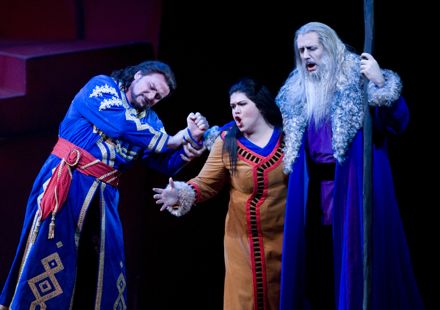 Walter Fraccaro as Calaf, Leah Crocetto as Liu, Christian Van Horn as Timur
Walter Fraccaro as Calaf, Leah Crocetto as Liu, Christian Van Horn as Timur
Photo copyright D. Ross Cameron/San Francisco Opera
Susan Foster was both the new Turandot and a new Turandot — not the icy, unattainable princess but the vulnerable, neurotic maiden, a Turandot very rarely revealed. Now she was a human scaled, twisted rival of the pure and gentle Liu. To be sure Mme. Foster could not be the icy Turandot if she wanted to. She does not possess the steely, dramatic voice nor the mythic persona to engage in a shouting match with her suitor Calaf. But she does have an engaging dramatic voice with volume aplenty when she needs it, and a personal softness that shone beautifully in her touching revelation that Calaf’s name was in fact “love.”
Calaf too, tenor Walter Fraccaro, had a softness and vulnerability that brought a very human dimension to his “Nessun dorma” that beguiled the opera house with its intimacy and earned him one of its all time biggest ovations. His Calaf was a young warrior who was perhaps as neurotic as Turandot, both of them equating love, or let us just say sex — there is that kiss — with death. Mr. Fraccaro did have the heft and volume in secure, supple voice to assault Turandot in his second act answers to her riddles.
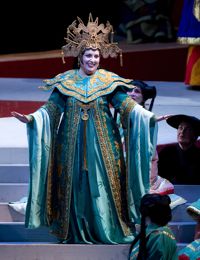 |
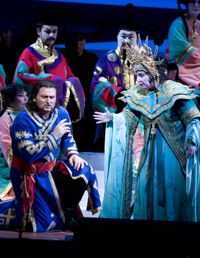 |
Photos copyright D. Ross Cameron/San Francisco Opera
Bass Christian Van Horn brought physical stature (he’s tall) and volume to Timur, confidently anchoring the narrative relationships of the opera’s’ protagonists. The Hockney production does not offer this personage opportunity to expand emotionally.
San Francisco Opera Resident Conductor Giuseppi Finzi allowed Puccini’s score to rise naturally from the pit, with tempos that encouraged its huge sonic scope to saturate the War Memorial Opera house. It is a great big opera that gives the San Francisco Opera chorus and orchestra opportunity to strut their stuff as two of the world’s fine ensembles.
The musical flow revealed this young conductor’s understanding of Puccini’s story. He did not sacrifice this newly discovered delicate humanity to dramatic and musical effect — this score’s fatal temptation. But what the young maestro could not do was drive the Alfano duet that ends the opera to the musical coherency that his predecessor Nicola Luisotti miraculously achieved, nor bring point and edge to the machinations of Ping, Pang and Pong.
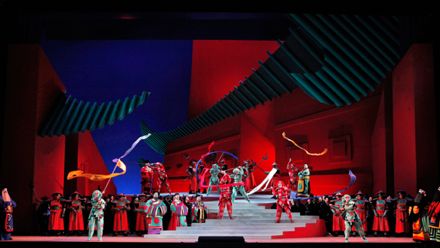 Photo copyright Cory Weaver, San Francisco Opera
Photo copyright Cory Weaver, San Francisco Opera
The Hockney production is saturated with Chinese reds and fantastical shapes that evoke much more than illustrate a sense of Oriental splendor. Hockney thinks two dimensionally, i.e. the proscenium opening is a canvas, thus we are presented with a succession of paintings. This places his characters on the canvas, or rather it freezes them onto the canvas. There is little movement, and virtually no dramatic reality, i.e. characters do not speak to each other — conversations are a visual, public presentation. Puccini’s Turandot offered this formidable visual artist unique opportunity to create a masterpiece.
Xerxes in San Francisco
No cuts, not a single one, nearly four hours of non-stop arias, and its only hit tune happens within the first five minutes.
It was a fine evening in the War Memorial Opera House, a rare visit by one of opera’s greatest dramatists, G.F. Handel now 326 years-old. San Francisco Opera welcomed his 273 years-old Xerxes with a production that is 26 years-old.
While the mushy acoustic of San Francisco’s venerable opera house is not kind to the linear detail and sculptural shapes of Baroque opera an exemplary cast overcame this handicap with the help of the English National Opera production directed by Nicholas Hytner and designed by David Fielding — purely and simply a classic.
The Handel revival has been going on quite a while now, in fact nearly one hundred years though not so many of his operas find their way onto the big stages to play for broader audiences. That may be the reason that when the populist and always lively ENO took on Xerxes for the Handel 1985 anniversary it choose to play up the comic elements of this opera seria, in fact to make it an outright comedy, trappings it wears quite naturally.
Impeccable comic timing and deadpan humor rarely describe performances by mezzo-soprano Susan Graham (whose roles at SFO include Iphigénie, Ariodante and Sister Helen [Dead Man Walking]). As the Persian king Serse (Xerxes) these attributes are as appropriate as the more usual phrases like impeccable musicianship and superb delivery. Her trouser acting technique does not attempt masculinity leaving us gratefully unconfused in the usual gender confusion.
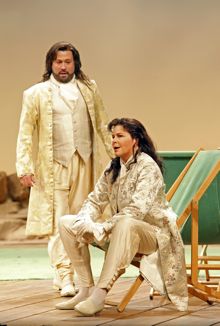 |
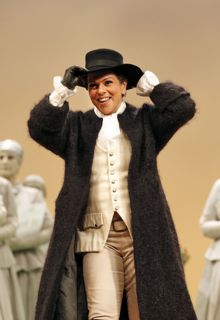 |
Sonia Prina as Amastris
Photos copyright Cory Weaver, San Francisco Opera
Almost the same things can be said about countertenor David Daniels who was her/his (Serse’s) rival in love, though in the case of Mr. Daniels the gender confusion became a part of the comedy with his maleness exaggerated by the addition of a beard — all the while singing in a male voice in a female register. Mr. Daniels has a quite beautiful falsetto that is evenly colored throughout his range, and exposes his mastery of Baroque style with every note.
To a man all the other pro- and antagonists were scene stealers. Heidi Stober and Lisette Oropesa were the sisters, Atalanta and Romilda, very lyric singers and beguiling actresses, complemented by the delightfully outraged Sonia Prina as Serse’s forgotten fiance Amastris, now disguised as a soldier. She earned a huge ovation for her dynamite, end of first act explosion “Saprà delle mie offese, ben vendicarsi il cor.”
Well, to a man it was hopeless, tormented love finally resolved by the dumb coyness of lovesick Serse aided by the very real charm of the servant Elviro sung by baritone Michael Samuel and by the pomposity of the general Ariodates adroitly served up by bass Wayne Tigges.
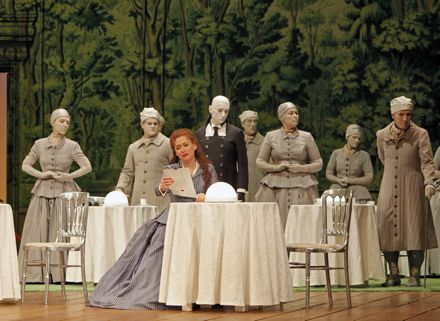 Heidi Stober as Atalanta
Heidi Stober as Atalanta
Photo copyright Cory Weaver, San Francisco Opera
The greatest pleasure of the evening was however the finished staging accomplished by stage director Michael Walling. Its imposed precise movements were confidently executed by the cast. This finish alone allowed the comedy to shine as well as to expose gracefully the considerable personal charms of the seven principals. Not to mention the huge presence of 24 choristers (but only two brief choruses) and 17 tireless supernumeraries as the very slightly defined Persian society (disguised in period European dress) — totally gray, shadowy, barely visible gentle commentators on the shenanigans of Handel’s brightly dressed lovers — that added very welcome action and context to the countless arias.
David Fielding’s set on which Serse and Ariodates plot their invasion of Europe was a Baroque room with a garden superimposed (recognizing that Xerxes is really a pastorale) with a back wall that flew out to reveal some witty Middle Eastern vistas and side panels that opened to admit some monumental Persian sculpture in museum cases. Together with the cheap lawn chairs and newspapers there was plenty of nifty confusion of time and place to complement the amusing gender confusions mixed up in the silly romantic convolutions.
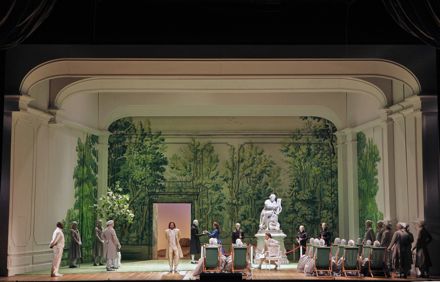 Act I. Photo copyright Cory Weaver, San Francisco Opera
Act I. Photo copyright Cory Weaver, San Francisco Opera
Conductor Patrick Summers allowed all this to happen without imposing musical extravagances, choosing instead to indulge in his sympathy for the needs of his singers. There was no real attempt or for that matter possibility or even need to create a Baroque sound in the vast expanse of the War memorial.
This production from twenty-six years ago reflects the tastes and challenges of that time, a particularly innovative period at the ENO. A new production now of this problematic opera might attempt to underscore the depth of emotion in its exposition of these tragic (genuinely unhappy) stories. The feelings are musically quite real. The heady humor of the Hytner production kept us outside and above the much of the potential musical depth and maybe some of the pleasures of this Handel score.
Carmen in San Francisco
Déja vu. Well, sort of. Last time around (2006) there was a Carmen and then another who cancelled leaving San Francisco Opera in the lurch. Of the several step-ins one seemed the most unlikely, but American lyric mezzo Kate Aldrich surprised everyone with a Carmen that was splendidly charismatic. Five years later la Aldrich, now a Rossini diva as well, was to be the centerpiece for eleven performances of this get-em-in-the-opera-house war horse. Guess what!
But this time, so far, the replacements have been very likely Carmens. American mezzo and recent Adler Fellow Kendall Gladden took the first two performances. This fine young artist has already distinguished herself as a viable Carmen on several of the world’s major stages. Georgian diva Anita Rachvelishvili, a veteran of the role at La Scala, the Met, Munich, etc., has now made her local debut and takes the next four performances as well. San Francisco Opera still hopes Mme. Aldrich may arrive for the final four performances, but stay tuned.
The problem is that Kate Aldrich is a very specific artist. She has a tonality that incorporates her quite lyric voice with a bright, American presence. It would seem that San Francisco Opera built its cast around this formidable persona and that meant lighter voices and lighter weight personalities. And since Carmen is a dialogue and numbers opera anyway the artistic concept seems to have been to make it a true operetta-like musical.
A light-weight cast was the result. Young Brazilian tenor Thiago Arancam was an adolescent looking and sounding Jose whose singing gave great pleasure but who lacked the power to make Jose’s frustration and rage seem more than a temper tantrum. Current Adler Fellow Sara Gartland possesses a small, quite lovely voice with an engaging flutter. She was a Micaëla blown about the stage by the whims of a few soldiers and smugglers rather than the stolid emotional force of Jose’s ties to his mother.
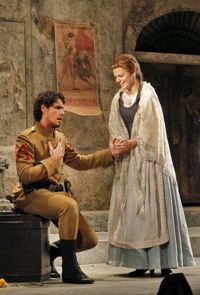 |
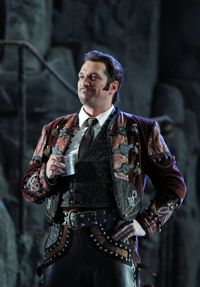 |
Paulo Szot as Escamillo
Photos copyright Cory Weaver, San Francisco Opera
Brazilian baritone Paulo Szot was the Escamillo. His claim to fame is the role of Emile De Becque in a Broadway revival of South Pacific and as the caricatural Shostakovich Nose at the Met. Mr. Szot simply lacks the operatic coglioni to fight bulls and seduce Carmen, but he did make a more or less pretty figure on the stage.
All this light artillary confronted a Carmen of maximum operatic magnitude, Anita Rachvelishvili. Mlle. Rachvelishvili has a big, big voice that she manages with grace and subtlety, and she does project a forceful personality if not a particularly sexual one. She apparently arrived in enough time to get her mind around the production’s dialogues but hardly in time to be integrated into its staging, if there ever was any. As it was she made generic Carmen moves from time to time.
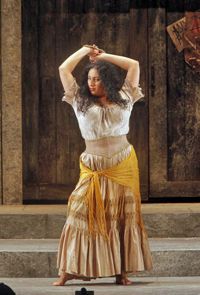 |
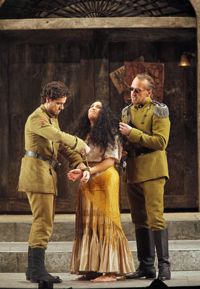 |
Thiago Arancam as Don José, Wayne Tigges as Zuniga
Photos copyright Cory Weaver, San Francisco Opera
This 1981 Jean Pierre Ponnelle production once had an edge. It was in fact the first time Bizet’s spoken dialogues were incorporated at the War Memorial and among the first times on any major stage in the world. To effect such daring Ponnelle obviously needed to downsize the public’s idea of Carmen from grand opera to a music hall ambience.
This need accounts for the small false proscenium embedded in a massive stone wall. The little proscenium opens and closes upon some historical scenic ideas (as well as a few more sophisticated techniques) that Ponnelle uses to substitute for the grand opera ideas of locale and ambience.
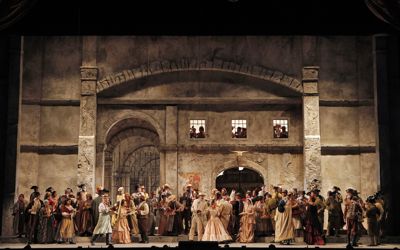 Act IV. Photo copyright Cory Weaver, San Francisco Opera
Act IV. Photo copyright Cory Weaver, San Francisco Opera
Production and set designer Jean-Pierre Ponnelle
Costume designer Werner Juerke, Lighting designer Christopher Maravich
But more than anything else the stone wall foreshortens stage depth determining that the staging be presentational, like music theater once was (and maybe still is). Can this explain why Jose seemed to be singing the "Flower Song" to the audience? And why Jose and Escamillo confronted one another without confronting one another (they seemed to be confronting the conductor). While the program does credit a fight choreographer these several crucial events that we look forward to in Carmen were inordinately weak.
Meanwhile, o Dio, we had Nicola Luisotti in the pit, a more formidable opera conductor cannot be imagined. Once again blatant staging concessions were obviously made to this tyrannical maestro so that all his musical points could be maximally vivid. And vivid Bizet’s music was. Maybe it was the point and flash of the music that made the stage seem so painfully pallid and therefore undermined our enjoyment of the performance.
Of the comprimarios the Dancairo of Timothy Mix had real flash, and the Moralès of Trevor Scheunemann well filled the stage. Adler Fellow Susannah Biller as Frasquita lacked the brilliance and volume of the high notes needed to vocally anchor the big ensembles. Wayne Tigges as Zuniga failed to find the fascistic stance that the Ponnelle production introduced to establish a political tyranny equal to the emotional tyranny imposed by Jose's mother.
The fashion to use the very compromised (i.e. hugely shortened) opéra comique dialogues in big opera houses has long since disappeared, and it is time to retire the Ponnelle production rather than destroy its integrity by producing it in unfavorable circumstances. The French dialogues just now were a pleasure however, easily understandable to anyone with high school French. Cleverly one Frenchman was introduced into the cast, Micaela’s mountain guide boy, so that we could hear what real French sounds like.
Roméo et Juliet in Los Angeles
Things got a bit confusing at the Dorothy Chandler. Some of us thought we were there to see Gounod’s Roméo et Juliet, others it seems — those on the stage — thought we might enjoy West Side Story as well. So that no one would be disappointed L.A. Opera opted to superimpose the one upon the other.
The Los Angeles Opera production, the physical production, of Romeo et Juliet designed by John Gunter is stunning. Its elaborate Gothic tracery elaborated in abstracted late nineteenth century Parisian iron structures cannily superimposes the horrors of this old, Italian gothic tale onto the swashbuckle and delicate sentimentalism of late French Romanticism.
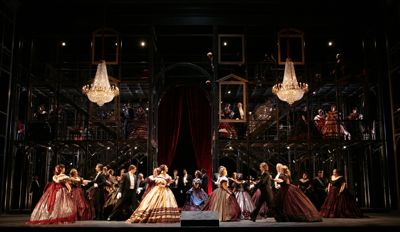 Photo copyright Robert Millard, Los Angeles Opera
Photo copyright Robert Millard, Los Angeles Opera
The elaborate mass and formality of the costuming by Tim Goodchild echoed the puffed proportion of this catchy little tragedy, and the stage pictures with the Renoir umbrellas delightfully reminded us that life does indeed include some troubled moments that can in fact be quite lovely.
It is hard to imagine a more perfect stage for Gounod’s delicate little opera than this virtuostic Anglo-Saxon, pseudo-Shakespearean vision.
Alas, Tony and Maria and the Jets and the Sharks took over adding the pizzazz of Broadway to the picture. The fight scenes, staged by Ed Douglas and the choreography by Kitty McNamee (of L.A.’s Hysterica Dance Company), were almost slick enough to approximate the real Broadway thing. The cast was young and fun. And Italian, Georgian, Russian, Korean, even some Americans, though not a Frenchman in sight — in short it was so-called international opera. Thus we were spared the difficult and seemingly impossible struggle of making French opera.
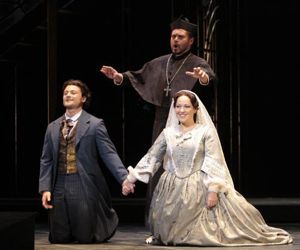
Vittorio Grigolo as Roméo and Nino Machaidze as Juliet
Vitalij Kowaljow as Friar Laurence
Photo copyright Robert Millard, Los Angeles Opera
Italian tenor Vittorio Grigolo was the Roméo. He is a real singer, even an Orphic voice like Pavarotti was, and just like Pavarotti his very being is Latin (unlike Pavarotti he does not possess a voice of unique color). His singing of Roméo was akin to Maria Callas singing Isolde, i.e. inappropriate. His presence is muscular and rawly emotional, his movement is forceful and nervous. In short he could be a perfect Tony, or even Rigoletto were he not so blatantly vain. His performance was marred by his constant look-at-me antics.
Georgian soprano Nino Machaidze was the Juliet, remembered as a monochromatic, unrepentant Fiorella in last season’s Turco in Italia. She is young and beautiful, and uniquely voiced (the dark, full sound of slavic voices) for the light lyric coloratura repertoire. But here too she never sacrificed hard, brilliant Rossini singing to the soft innocence that defines Juliet, though she did have the look and sound we could accept for the West Side Story Maria.
Russian bass-baritone Vladimir Chernov created a light weight Capulet pater familias coached into a comic liveliness that belied the gravitas of such a personage. Mr. Chernov has all the trappings of a star save a commanding vocal and stage presence. Such presence however marked the initial moments of Ukrainian bass Vitalij Kowaljow (L.A.’s Wotan) singing Friar Laurence but his voice soon lost its beauty as he cannot sustain the soft understanding of a piously human personage (he tore up the stage just now in San Francisco as Lucrezia Borgia’s jealous husband).
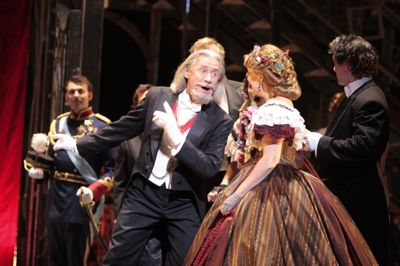 Vladimir Chernov as Lord Capulet
Vladimir Chernov as Lord Capulet
Photo copyright Robert Millard, Los Angeles Opera
Amidst all this vocal abundance Russian tenor Alexey Sayapin, a participant in the L.A. Opera young artist program, was vocally out of place though other of the program’s participants managed credible performances of Mercutio and Stephano — Korean baritone Museop Kim and American mezzo Renée Rapier who stepped in for the previously announced Italian mezzo Elena Belfiore.
Other smaller roles were appropriately cast. Philip Cokorinos is more at home in comprimario roles than leading roles (like the recent Zaretsky in Onegin), and made a suitable Duke of Verona. L.A. Opera favorite Ronnita Nicole Miller was a full-voiced Nurse, and Michael Dean makes a belated L.A. Opera debut with his well sung Gregorio.
Beloved opera legend Placido Domingo was in the pit as conductor, and left us wondering if a qualified French repertory conductor might have saved the day. Ian Judge, the original stage director of this 2005 L.A. Opera production, evidently recreated his original staging to suit the personalities of the interpreters, or should have. This fine physical production deserves better.
Don Giovanni in San Francisco
Ossia Maestro Watching in Fog City. Ten years ago it was German provincialism, now it is the Italian sort wanting to take root in the War Memorial Opera House.
San Francisco Opera unveiled a new Don Giovanni just now in nearly direct competition with the new Giovanni from the Met (you can see it soon on Live in HD). Of course the Met has avoided an American take on this old story as well, preferring to impose still more British artistic imperialism on Americans.
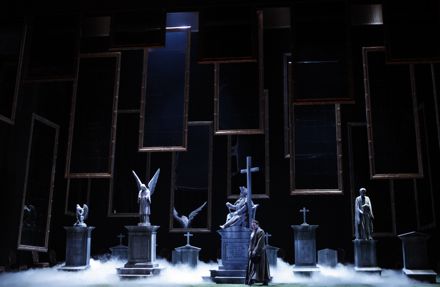 Act II, Cemetery. Photo copyright Cory Weaver, San Francisco Opera
Act II, Cemetery. Photo copyright Cory Weaver, San Francisco Opera
Set designer Alessandro Camera, Costume designer Andrea Viotti
Lighting designer Christopher Maravich
The SFO Giovanni is all about egoism, and we are not talking just about the libidinous Don. We are of course talking about SFO music director Nicola Luisotti. Like the Don, this maestro is much larger than life, and equally astonishing in his powers. But the Luisotti Don Giovanni is not about sex as it is for most stage directors, it is about how Luisotti can take you to the brink of lyric orgasm and hold you there longer than maybe you ever thought possible.
Of course the maestro did need some collaborators to support his lyric blowout, specifically a general director willing to suspend artistic judgement and engage a stage director who is at home on secondary Italian stages where standards are parochial to say the least. One Gabriele Lavia was Luisotti’s collaborator for his Salome in Bologna shortly after the San Francisco one (if in Bologna it was orchestrally more brilliant the staging was even cornier than in San Francisco).
The comedy of Mozart’s sublime tragicommedia in San Francisco was watching Sig. Lavia keep the maestro’s singers on a plain about 4 feet wide across the stage apron where no one could escape the maestro’s thrall. And still tell the story. It sometimes worked, sort of, belying the not-too-distant link of Mozartian dramaturgy to the linear and static placement of singers for Baroque opera seria.
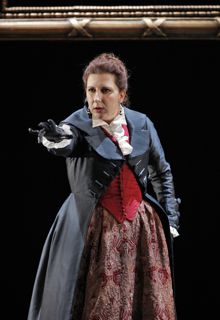 |
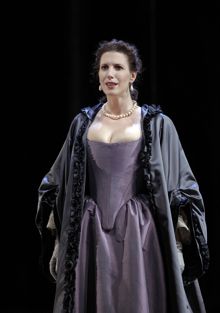 |
Photos copyright Cory Weaver, San Francisco Opera
General Director Gockley as well engaged a small scale, very Italiate diva, the splendid Serena Farnocchia whose bright lyric voice is on the small side for Donna Elvira, and light enough to negotiate, almost, Elvira’s very difficult music at the speed of light. The maestro succeeded in upstaging Sig.ra Farnocchia’s “Mi tradi” with a hyper emotional orchestral accompaniment to its recit (grotesque heaving).
Donna Anna was the American soprano Ellie Dehn who had made little impression as the Countess last fall. But she glowed vocally as a retiring Donna Anna, her just ample enough voice blended perfectly in ensembles, having shown with hanging beauty and fine musicianship in her first act aria "Or sai chi l'onore.” American tenor Shawn Mathey was Don Ottavio, but not the usual impotent one. Turning the tables he was the singer with the coglioni rather than the usual Giovanni heroines. Both Don Ottavio arias were blockbusters, exposing forceful, detached tones in quick passages and fioratura, and letting tone and feeling explode in lyric passages. Both Ms. Dehn and Mr. Mathey managed a synergy with the maestro to sublime effect.
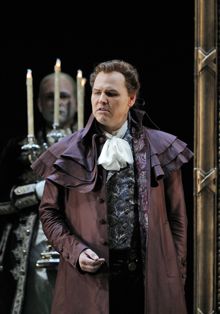 |
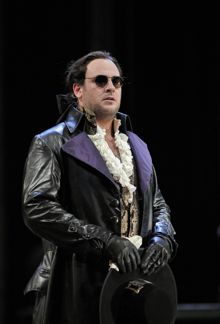 |
Photos copyright Cory Weaver, San Francisco Opera
Ignoring all potential complexities of relationship to his master, Italian bass Marco Vinco made Leporello a cute, almost expendable character, needed but not wanted. Though he, like most all Leporellos earned the biggest ovation. Like Leporello, Zerlina and Masetto were needed only for the maestro’s beautifully wrought ensembles, but not much more. Zerlina was ably and musically sung by Kate Lindsey, Adler Fellow Ryan Kuster made a cute Masetto.
San Francisco regular, bass baritone Lucas Meachem filled the shoes of Don Giovanni with aplomb and even charm. Mozart did not endow his most loved character with arias of consequence, and a stage director must dig way beneath the surface to intuit any complexity of personality, obviously not the scope of this production. But the Don is always big, and he lets it all hang out in his explosion at the end of the first act. Needless to say this was the meat of the maestro who turned it into an absolute frenzy. Mr. Meachem could not possibly compete, though he gave it a good try. The real Don would have thrown this maestro the very graphic up-yours gesture and walked off the stage.
From the downbeat of the overture Mo. Luisotti stated that this Mozart opera was an orchestral and musical process, its very sound groaning with importance, reminding us that the maestro has made his orchestra into one of the world’s fine pit ensembles. The beginning foretold the absolutely literal ending with the Commendatore, ably delivered by bass Morris Robinson, wreaking his vengeance on the Don in gigantic symphonic terms. We discovered last fall that after the maestro’s over-the-top musical dénouement in The Marriage of Figaro that he could not touch the quiet Mozartian humanity that ends Figaro. And here he does not even look for Mozart’s humanity, ending Giovanni with the Don’s noisy descent into hell rather than letting the quietly splendid Prague sextet wipe up the mess.
It was a fun evening. However Mozart and San Francisco might equally enjoy a bit of operatic integrity.
Cosi fan tutte and Eugene Onegin in Los Angeles
L.A. likes to think of itself as the Berlin of the Western Hemisphere when it comes to the visual arts — the place where it (art) happened and happens. In fact the art happening of the year “Pacific Standard Time, Art in L.A. 1935 - 1970” opened this past weekend all over Los Angeles.
Important art of another ilk happened in L.A. last weekend as well, back to back performances of Tchaikovsky’s Eugene Onegin and Mozart’s Cosi fan tutte. The art of opera is glowing in L.A. with accomplishment and hopeful promise. The Ring of the century, well maybe the decade (the Freyer Ring, summer 2010), has imposed astringent economies onto L.A. Opera, and it has turned poverty into a virtue. Intelligent choices (rare in opera circles), not expensive choices of productions and casts made a splendidly satisfying 2010/11 season, and this intelligence was manifest just now in Onegin and Cosi.
It may well have been the Cosi fan tutte of the century, or maybe the decade, with a youthful, perfectly matched cast and a production that took on the preciousness of the bète noir of Mozart’s trilogy and made it a virtue. This was the Nicholas Hytner production for the Glyndebourne Festival (uhm, the repository of all operatic preciousness). Just now it was successfully re-staged by Ashley Dean who made sure that Mozart’s twosomes remained the production’s staging conceit — its protagonists stayed always as tightly paired on stage as Mozart’s thirds and sixths (musical intervals) are paired in the score.
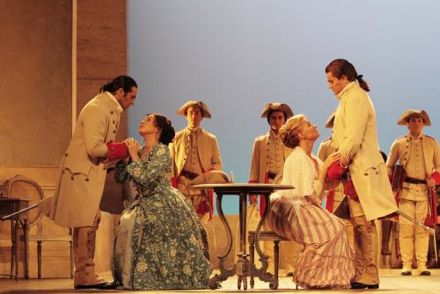 Guglielmo, Fiordiligi, Dorabella, Ferrando.
Guglielmo, Fiordiligi, Dorabella, Ferrando.
Photo copyright Robert Milard, Los Angeles Opera
Casting a young singer, Lorenzo Regazzo, as a disheveled and not-at-all “gray haired” Don Alfonso stated the case. This was youth defining its appetites. The Albanian disguises (loose hair as opposed to hair pulled into a queue) offered no more than excuses for girls to try out someone else’s boyfriend. The in-joke is that the Ferrando, Saimir Pirgu is a real Albanian so he needed no disguise anyway.
It was conceptually light weight and minimal — the wager occurred over a cup of tea, there were just a few light props (veranda furniture and a wall moved on and off by a couple [man and woman] of nearly dead senior citizens totally oblivious by now to all that ardor). Despina, Roxana Constantinescu, did all the classic antics so we did not have to deal with the what-to-do-with-Despina problem. And there was even a touch of attitude — in the final tableau Guglielmo made it clear that he was pissed.
While Ildebrando d’Arcangelo, the Guglielmo, may be famous for his good looks, and that counts in La La Land, his dark bass baritone voice brought welcome edge to the homogenous sound of Mozart’s score. The biggest arias are given to his girlfriend Fiordiligi, sung by Aleksandra Kurzak who therefore made the biggest effect vocally. Ruxandra Donose as Dorabella was the most delightfully comedic figure of the evening. Well matched in voice color the two women reveled in singing together, and Mozart gave them much, well, too much opportunity to do so.
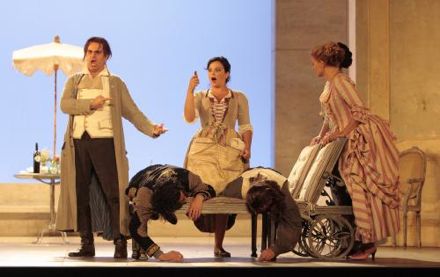 Don Alfonso, Guglielmo, Despina, Ferrando, Dorabella.
Don Alfonso, Guglielmo, Despina, Ferrando, Dorabella.
Photo copyright Robert Milard, Los Angeles Opera
The names say it all (there was not an American in sight). These are international opera singers, not opera stars, with credits on the world’s major stages (and L.A. is already one of them). It is a new breed of singer whose artistry equates voice with presence.
There was a time not so long ago when symphony circles looked down upon the L.A. Opera orchestra, but this surely is no longer the case. Music director James Conlin has transformed the ensemble into a fine opera orchestra of resonant strings and singing winds. The overture to Cosi, gratefully left unstaged, exposed fine solo playing all over the place. The maestro was more than a willing player in all this fun, in fact the driving force with tempi so perfect that they seemed pure Mozart. Well, except in the overture when some of the woodwind solos had a hard time keeping up. Maybe it was the excitement of what was about to happen on the stage.
The afternoon did become long as each of Mozart’s young lovers was given his and her moment to sing alone. Even the gold light that tried to conjure a more emotional atmosphere for all this late afternoon singing could not sustain my interest. The opening of all possible cuts in the score made most of us grateful and others of us uncomfortable that there was only one intermission in the 3 1/2 hour duration of the performance.
San Francisco Opera tried not so long ago to be the operatic Berlin of the Western Hemisphere. That did not work out. And the Freyer Ring in L.A. did leave some (a lot of) folks out in the cold as well. So it is understandable that this fall L.A. season preferred to identify itself with London and its West End, Anglo-Saxon theatrical inclusiveness.
While this made Cosi accessible it faltered in Eugene Onegin. Maybe this is because the Covent Garden Onegin production by the late Steven Pimlott exploited Anglo-Saxon theatrical virtuosity in rather obscure ways.
Tchaikovsky’s Onegin is rife with atmosphere and locale. Most often these are literal representations of where the action takes place, other times in the Berlin manner they can be reduced to symbols of various sorts. In this Onegin Pimlott and his designer Anthony McDonald strove to make these atmospheres actual participating actors in the Onegin drama.
The sides of a basic 18th century neo-classic interior, light green in color created a false proscenium with side doors that remained in place through the performance. Mid-stage there was a sheet of water, i.e. a river or pond, with a couple of bridges, and there were upstage rolling hills. This forced all dramatic action onto a band across the downstage except of course when someone was splashing in the water during the warm summer. In the winter the water froze in cold snowy (lots of) weather, and became the Neva (the river flowing through St. Petersburg) on which everyone ice skates.
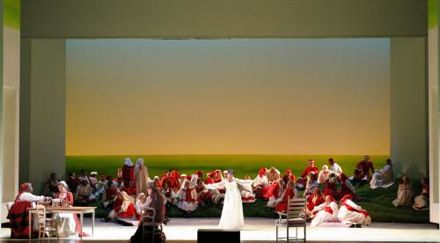 Eugene Onegin I, ii. Filipievna, Larina, Tatiana, Olga (in white).
Eugene Onegin I, ii. Filipievna, Larina, Tatiana, Olga (in white).
Photo copyright Robert Milard, Los Angeles Opera
A wall descended in front of the pond/river from time to time to create an interior, a bit cramped for the party that precipitates the duel. In Russia everyone dances the polonaise but in this limited floorspace the chorus could only stand and watch a few real dancers manage a bit of movement. These same dancers then actually did ice skate on the frozen Neva during the third act polonaise music, and later Prince Gremin and Tatiana arrived on a sleigh. The warmly dressed chorus stood and watched all this.
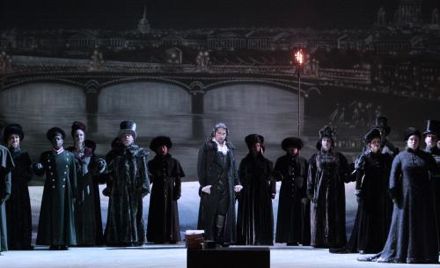 Eugene Onegin III, i. Onegin.
Eugene Onegin III, i. Onegin.
Photo copyright Robert Milard, Los Angeles Opera
Lots of atmosphere indeed, and it had a profound effect on Tchaikovsky’s score. Maestro Conlin delivered these grand polonaises of the second and third acts symphonically since he was not faced with having to provide enough lilt to lift all those middle-aged bodies. This symphonic tone in fact prevailed throughout the evening rendering the balletic nature of Tchaikovsky’s music more aggressive than lyrical.
Like the Cosi, the Onegin principal roles were cast from the international pool of opera singers who are not stars, though here those artists of Slavic language. Slovakian baritone Dalibor Jenis did not project a charisma powerful enough to smite a vulnerable adolescent girl, even his long black locks missed rendering him exotic. Ukrainian soprano Oksana Dyka could not catch the vocal innocence of the adolescent Tatiana and her stolid physical and vocal stature precluded touching the tormented soul of the mature wife. Russian tenor Vsevolad Grivnov displayed little personality, thus we lacked the softness and naivete of the poet Lenski. Belarusian soprano Ekaterina Semenchuk was too old and too abrasive to embody the vapid Olga.
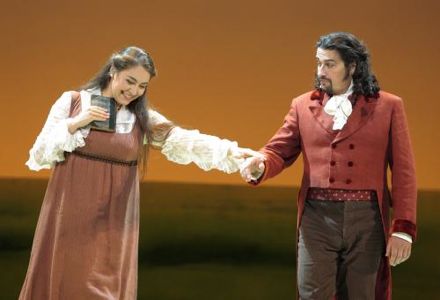 Tatiana and Onegin. Photo copyright Robert Milard, Los Angeles Opera
Tatiana and Onegin. Photo copyright Robert Milard, Los Angeles Opera
But these artists were at home in the Russian language and all excellent singers. The production placed all the big scenes between the downstage doorways in bright light, leaving these wonderful singers scenically naked. Perhaps this worked at Covent Garden where presumably these roles were embodied by big stars, but in the Dorothy Chandler it motivated a symphonic rather than operatic performance. Maestro Conlin seemed to commune with his fine orchestra rather than with Pushkin’s tale.
The balance of the cast were Americans, many alumni of the L.A. Opera’s young artist program. When it was not sending boys in to do men’s work it was a question of mixing musical cultures — international big house singers with well trained, some even sophisticated American artists. It simply does not work.
It was a performance of considerable conceptual, musical and even vocal interest if not success. And, may the stars remain at Covent Garden!
Lucrezia Borgia in San Francisco
Bad news travels fast. Though you are about to read another version of how American diva Renée Fleming failed to bring Lucrezia Borgia alive in San Francisco, let’s begin by mentioning a few other things you already know.
Venetian facades are marble, not brick, thus it takes more than blue light rippling on red brick walls to evoke Venice. Lucrezia’s new home Ferrara was not towering walls of styrofoam bricks painted red, plus it is obvious that all of Lucrezia’s evil machinations did not occur in a strong, golden sunset sidelight.
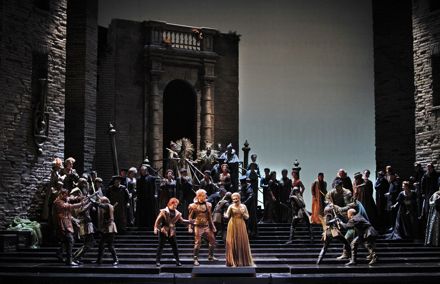 Orsini, Gennaro, Lucrezia. photo copyright Cory Weaver, San Francisco Opera
Orsini, Gennaro, Lucrezia. photo copyright Cory Weaver, San Francisco Opera
Rolex is not spelled Borgia, even though the golden insignia that hung over the stage seemed to advertise luxury watches, and the B wrenched from the Borgia name (that somehow found itself inscribed on a tomb in Ferrara) was a dead ringer for the serifed first letter of Bulgari.
Amazingly Mme. Fleming’s second act, stupendously rich gown upstaged both red styrofoam and gold gel (the transparent film that colors stage lights), and the ridiculousness of her third act soldier disguise (revealing ample decolletage under a bouffant wig) upstaged her maternal anguish (she had had to poison her son).
Mme. Fleming has carefully nurtured the image of American artistic luxury. Her porcelain persona was everywhere evident on the War Memorial stage. Mme. Fleming is at the same time a very intelligent artist who possesses a unique talent and a beautiful voice. Perhaps if this production had presented her as a real person we might have perceived a full, beautifully voiced character of brutal mind and twisted integrity.
Donizetti and his librettist’s idea of Lucrezia Borgia is as a bel canto heroine — no matter how horrible a person she may be, and how terrible her circumstances become, the music must always be beautiful, her voice soaring gloriously. Bel canto titillates its acolytes (willing audiences) with this contradiction. In the artificial atmospheres of this production that set out solely to beautify Mme. Fleming she read as dramatically and vocally insipid. And, well, the opera is all about her.
Lucrezia Borgia boasts sensational subject matter beyond infanticide. Her son Gennaro has sworn eternal love to his friend Maffio Orsini, who is actually a girl because it is a pants role. So a guy loves a guy who is actually a girl. Unfortunately this production precluded any resulting sexual titillation by casting diminutive mezzo Elizabeth DeShong as Orsini who read as Gennaro’s belligerent baby sister.
Even so the B in bel canto did succeed somewhat in forcing its way into the theater. Italian conductor Riccardo Frizza provided a solidly idiomatic if uninspired reading of Donizetti’s score, perhaps in reaction to the production. American tenor Michael Fabiano gave great pleasure, as a singer he is stylish and correct as evidenced in his splendid “Di pescator ignobile," and he glowed as an accomplished actor in scenes with his no affect mother. Ukrainian bass Vitalij Kowaljow made a big impression as Lucrezia’s third husband, Alfonso d’Este, tearing up the stage with his showpiece "Vieni, la mia vendetta!"
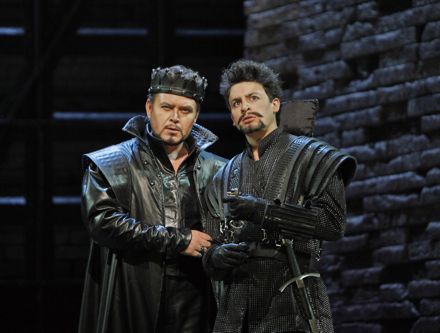 Alfonso d'Este, Rustighello. photo copyright Cory Weaver, San Francisco Opera
Alfonso d'Este, Rustighello. photo copyright Cory Weaver, San Francisco Opera
While Mlle. DeShong did not physically measure up to Orsini she proved herself to be a strong singer. Among the smaller roles the Rustighello of Adler Fellow Daniel Montenegro was effectively drawn.
The libretto by Felice Romano is undeserving of ridicule. It accomplishes what a bel canto libretto sets out to do — create situations that can only be resolved by beautiful singing. But Lucrezia Borgia is like a carefully constructed short story where there is not one word too many, and in fact Donizetti revised the opera several times so maybe there is not one note too many either. It is this stark minimalism that shunts this blunt opera from masterpiece status.
Stage direction, sets and costumes are all by English producer John Pascoe, a production he created for Mme. Fleming at the Washington Opera in 2008.
Turandot in San Francisco
Los Angeles has been good to Turandot. The gritty 1984 Andre Serban production inaugurated an opera company in Los Angeles where a mere eight years later L.A. Opera bestowed the splendid Luciano Berio ending upon the world in an uber-pompous Gian-Carlo del Monaco production.
Meanwhile that same year (1992) Los Angeles artist David Hockney bestowed a Turandot upon San Francisco (and Chicago) that is pure Tinseltown. L.A. is famously the Hockney muse, thus the specific muse for the technicolor Hockney Turandot has to have been Grauman’s Chinese Theater. Like this National Historic Monument, the Hockney Turandot vibrates in theatrical shapes and Chinese reds, and by now it too is an historic monument.
 Turandot II,ii. photo copyright Cory Weaver, San Francisco Opera
Turandot II,ii. photo copyright Cory Weaver, San Francisco Opera
San Francisco has put its unique stamp solidly on Turandot as well. The 1977 Jean-Pierre Ponnelle production had its massive stone Buddha that gestured and wept blood when the steely Monserrat Caballé succumbed to Luciano Pavarotti in their role debuts, this back in the days when San Francisco Opera pushed the progressive opera envelope in the U.S.
These days it is a bit different in San Francisco. There is a stamp of a different sort, it is musical and it too pushes the envelope. Specifically it is the quixotic Italian conductor Nicola Luisotti who makes every score he touches vibrate with color, energy and sometimes questionable theatricality. Put this together with the timeless Hockney Turandot and you hit remarkable pay dirt — the current Turandot in San Francisco!
The Hockney Turandot is, no surprise, like a painting in that it is two dimensional. On this flat surface Ping, Pang and Pong complain, Liu sacrifices, Calaf thunders and Turandot rages. The lack of depth plays directly into the hands of the maestro who likes his singers right downstage center where he communes mightily with his voices and maybe even with Puccini. The current staging by Carnett Bruce is sensitive to artist, character and story telling, and it is precise and efficient in somehow getting and keeping the artists where the maestro wants them and where Hockney surely saw them.
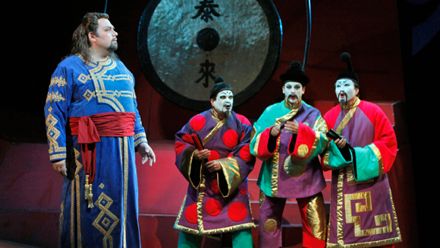 Calaf, Ping, Pang, Pong. Photo copyright Cory Weaver, San Francisco Opera
Calaf, Ping, Pang, Pong. Photo copyright Cory Weaver, San Francisco Opera
The performance was riveting from beginning to end. Even so there were those scenes that glowed with new life — the Ping, Pang, Pong conversation for example, made intimate by the three Hockney straight backed chairs painted onto a drop and by the maestro’s oh-so smooth intermingling of their vocal lines. Liu’s first act prayer Signore ascolta was magical in its Adler Fellows innocence, and the Alfani duet (“who is Berio?” Luisotti surely would ask) that ends the opera was articulated with a surprising intimacy that made us actually feel a renewed humanity — no small feat amidst all that bombast.
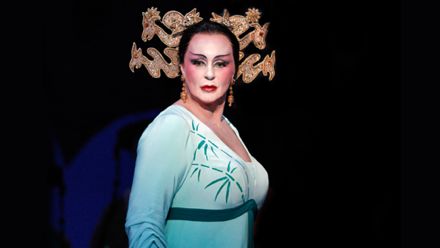 Turandot. Photo copyright Cory Weaver, San Francisco Opera
Turandot. Photo copyright Cory Weaver, San Francisco Opera
The biggest vocal presence was Italian tenor Marco Berti as Calaf who used his strangely brutal Nessun dorma to threaten the Chinese royalty and population even more, and more quickly dismiss Liu’s sacrifice. Swedish soprano Iréne Theorin was far more lyrical in her capitulation than the usual Turandot, though there was icy rage aplenty as she well anchored this story of anger versus power. Against this big house firepower the Liu of Adler Fellow Leah Crocetto was indeed sacrificial, a sacrifice of this symbolic character who must fully embody the supernal power of love. The mix of musical cultures does not work — the Adlers are specifically nurtured contemporary artists whose sophistication is at odds with can belto international artists.
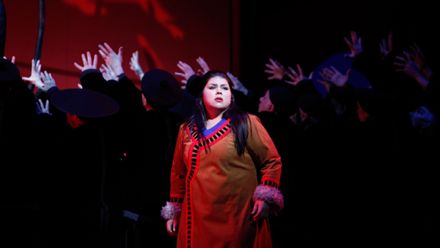 Liu. Photo copyright Cory Weaver, San Francisco Opera
Liu. Photo copyright Cory Weaver, San Francisco Opera
The Timur of Raymond Aceto fulfilled its narrative obligations without adding pathos. The Ping of Hyung Yun dominated the trio of courtiers in association with the vivid Pang of L.A. character tenor Greg Fedderly. Pong was Adler Fellow Daniel Montenegro.
The visual sophistication of the David Hockney Turandot begs precise and brilliant lighting, a need recognized from the inception of this production those many years ago. Just now the lighting was reconfigured by Christopher Maravich though the ending was new. Mo. Luisotti endowed the final chord of the performance with an intense, nearly screaming crescendo that was matched by a crescendo of bright, brighter, blinding light.
Theatrical! No?
Heart of a Soldier in San Francisco
The house lights dimmed, SFO General Director David Gockley instructed us to stand and sing the Star Spangled Banner. This crucial moment revealed the intentions and complexities of this fine production at San Francisco Opera.
We immediately knew that we were not before San Francisco’s altar to operatic art but rather at an altar of national sentiment. Christopher Theofanidis and Donna di Novelli’s Heart of a Soldier is not great art, nor is it political or historical tragedy. It is what it sets out to be — an account. Strangely, and perhaps this was its hidden intention, it distills the destruction of New York’s World Trade Center to some very small components — a few men and women whose lives were and are simply insignificant to the larger historical perspectives of the twenty-first century.
San Francisco Opera pulled out its biggest guns to accomplish this task. Ring director Francesca Zambello created a slick and smart production, minimal in concept though maximal in execution (it was complex). It toyed with a few levels of two white high rise towers, a few scenic screens, some with projections, and a couple of sliding platforms.
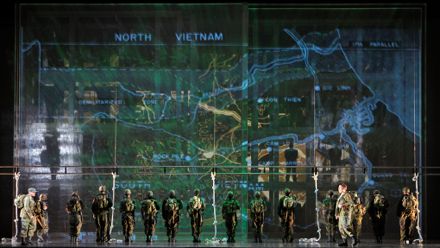 Heart of a Soldier, photo copyright Cory Weaver, San Francisco Opera
Heart of a Soldier, photo copyright Cory Weaver, San Francisco Opera
Set design by Peter J. Davison
Costume design by Jess Goldstein
Lighting design by Mark McCullough
The libretto held thirty named roles that San Francisco Opera covered with fourteen singers, led by no less than American baritone Thomas Hampson as Rick Rescorla, security chief at the WTC. Mr. Hampson obviously reveled in portraying this more colorful than interesting character who was, might we say, more headstrong than heroic.
SFO principal guest conductor Patrick Summers was at the helm of all these folks, plus a standard sized chorus and a modestly endowed Romantic era orchestra. There was remarkably little percussion limited to the service of orchestral color. Battle sounds were modest electronic reproductions of the real thing.
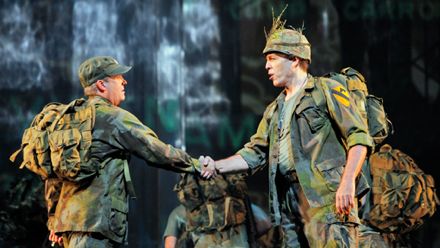 Rick, Dan, photo copyright Cory Weaver, San Francisco Opera
Rick, Dan, photo copyright Cory Weaver, San Francisco Opera
The key to understanding this remarkable evening is to take yourself back to that terrible day, as you could not help but do in anticipation of the performance. Thus it was already emotionally laden before the fact.
For most of us the destruction of the World Trade Center was a small event, which is to way it was the size of our television screen. What were certainly awesome roars emitted by the collapsing towers were no louder than the voices of those begging for news of loved ones, the visual images of the still standing towers were even smaller than these anonymous tortured faces.
Heart of a Soldier captured the anonymity of this calamity by recounting the life of but one of its 3000 victims, a life however that was fulfilled by its death in battle. This victim, Rick, was a soldier, his story was told in scenes in which he was among many soldiers on the many battlefields on which they fought. Justness of cause was never mentioned. It was simply life on a battlefield, the battlefield of life where finally you too will die. It was a metaphor for all its victims, at once huge and minuscule.
There was huge art involved in creating this opera. Donna di Novelli’s libretto was the structure, stating its themes and images, developing them and recapitulating all these themes on that fateful September 11. It might have seemed contrived except we soon perceived that these conceits were in fact structural, creating brief lyric musical spaces as well as the arc of the story. The lyric moments were however always too brief, never indulging in what were the inherently wrenching emotions we had braced ourselves to endure and maybe finally wished we had.
The score by Christopher Theofanidis was based on American musical vocabulary, our open fifths and fourths, our primitive dance forms and our chugging minimalism. Its musical sophistication was stratospheric — Mr. Theofanidis’ brilliant orchestration would have made Berlioz green with envy, his harmonic transports would have cowed Richard Strauss.
While the premise of Heart of a Soldier was challenging on so many levels, Mr. Theofanidis’ score simply was not. One longed for a fugue or at least some sense of music taking on a life of its own, music that transcended the word and the literal and pushed us to the edge of our sensibilities and our endurance, like 9/11 had. This splendidly beautiful music did not.
Rick Rescorla’s best friend Dan Hill was portrayed by tenor William Burden in a quite convincing and moving characterization of this simple American mercenary who converted to Islam. Rick’s second wife Susan was enacted by Melody Moore who achieved the simple vivacity of character asked by the libretto in vibrant voice. The opera’s lack of emotional indulgence was echoed by its absence of vocal indulgence, even Mr. Hampson was given but one small opportunity to place his operatic art before Rick’s swagger. Of the secondary roles only the medic Tom beautifully sung by Michael Sumuel and his girlfriend Juliet sung by Adler Fellow Nadine Sierra were offered somewhat extended opportunities for lyric expansion.
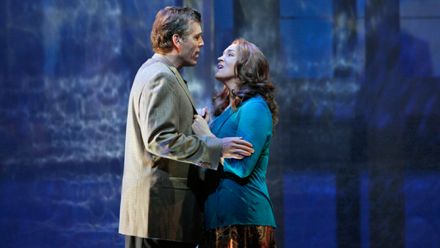 Rick, Susan, photo copyright Cory Weaver, San Francisco Opera
Rick, Susan, photo copyright Cory Weaver, San Francisco Opera
The final image was neither word nor music, it was simply the tableau of Dan Hill knelt in Islamic prayer and Susan Rescorla, arms uplifted sifting the dust of 9/11 through her fingers. It was the only emotionally overpowering moment of the performance.
Der Ring des Nibelungen in San Francisco
Some of the experts said it was the best Ring ever, others merely said it was one of the best (these were lecturers at a Wagner Society symposium). The final curtain down at last on the second cycle, the audience leapt to its feet and roared. What was all the fuss about?
The delights of the San Francisco Ring were myriad. The cycle played out over a mere six days during which Wagner’s drama did not seem to stop. It was an immersion Ring rather than episodic one as the Freyer Ring in L.A. seemed over its ten long days, not to mention the Berlin Philharmonic Ring in Aix-en-Provence that was spread over four years.
Conductor Donald Runnicles slid into the initial e-flat pedal tone and relentlessly sustained Wagner’s orchestral deliberation for its seventeen hour duration. The maestro drove an orchestral continuum that was imperceptibly fleet (it was actually fast), its speed though was calibrated to the careful articulation of Wagner’s score, the conductor knowing that Wotan’s plight and designs give rise to riveting music only when they are musically exploited to the maximum.
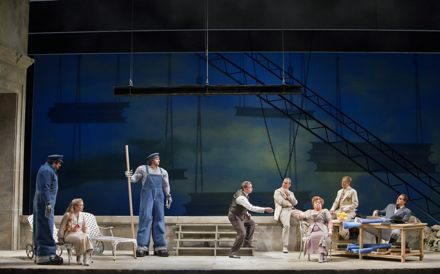 Das Rheingold, photo courtesy of San Francisco Opera, copyright Cory Weaver
Das Rheingold, photo courtesy of San Francisco Opera, copyright Cory Weaver
Mo. Runnicles achieved a rare transparency of the orchestral sound in the War Memorial, the percolating inner voices of the continuum often shining brilliantly in the vast space of the hall as they can never do in the recordings we use to learn and casually listen to the Ring. And too the vast spaces of the War Memorial allowed huge fortes to roll forth, immersing the hall in mighty sound. Even the quirks of the hall contributed, its “golden horseshoe” overhang magnifying the eight horns and double timpani for those of us seated on the right side of the orchestra.
The careful musical exposition was subject to the largest arc of Wagner’s myth, the orchestral climax of the entire Ring occurring about sixteen hours into it, only at the end of the second act of Götterdämmerung when Mo. Runnicles unleashed it all for Brünnhilde’s pact with Hagen to murder Siegfried. This Ring was bigger than its pieces, and we understood that the usual frenzy we missed at the conception of Siegfried was measured against the hugely complex dilemma of his death.
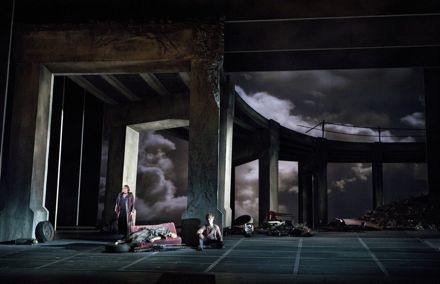 Die Walküre, photo courtesy of San Francisco Opera, copyright Cory Weaver
Die Walküre, photo courtesy of San Francisco Opera, copyright Cory Weaver
It is futile to discuss the concept of the production, San Francisco Opera touting it as “an American Ring.” There were indeed vibrant American images, like redwood trees. like pollution that had a specifically American feel, but the Gibichung headquarters was well beyond the 1930’s American skyscrapers director Francesca Zambello cites in her program book apology, and much more on the scale of Austrian expressionist Fritz Lang’s immense Metropolis of his 1927 film. And too the light green behind Brünnhilde’s fire seemed more like a weird color choice that an evocation of escaping industrial gases.
All these specific images however quietly dissolved into the careful storytelling that was the hallmark of the Zambello production. Not a musical motive was left without a corresponding movement on the stage, no musical interludes were left on an abstract imaginative level but accompanied by moving projections — clouds, water, trains, fire, more clouds, etc. It was a fully illustrated Ring (take it or leave it) that (if you took it, and that took a while) eased you, even gracefully, inside the Ring’s musical universe.
It was an easy, engaging Ring that deflated Wagnerian philosophical pomposity at every turn with surprising, sometimes funny twists — Alberich attached to his homeless supermarket cart searched for Faftner with infrared binoculars, the forlorn Rhine maidens hopelessly picked up plastic bottles from a dried up river bed, beer guzzling buddies who were actually sworn enemies downed cases. Not to mention the purely comic book, utterly delightful visuals for Fafner and Fasolt, or the Valkyries parachuting onto the rocks of Valhalla (this image said to have been borrowed from a Swedish commercial for a detergent powder).
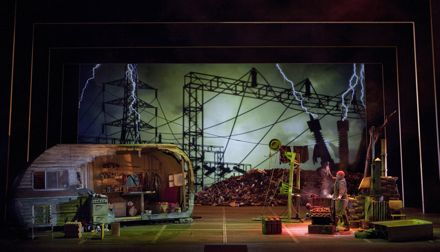 Siegfried, photo courtesy of San Francisco Opera, copyright Cory Weaver
Siegfried, photo courtesy of San Francisco Opera, copyright Cory Weaver
Finally the Zambello Ring maybe even arrived at tongue-in-cheek with the black covered Arab-esque women cowering in the wake of their men, black uniformed fascistic soldiers of Hagen’s evil army. Not to intimate that Mme. Zambello did not somehow use all of this to bring Wagner alive. She did.
San Francisco Opera promoted a number of seminars to accompany its Ring. Anti-Semitism was a big topic, though it was put in succinct perspective by the Mime of the production, David Cangelosi who rhetorically asked “haven’t we turned the page on all that?” Distinguished lecturers examined the Ring in Schopenhauerian terms, a former Buddhist monk delineated the Ring’s roots in Buddhism. The most convincing of the philosophical analogies described the Ring in purely Sartrean Existential terms. (I might also mention a concert of Wagner transcriptions on the 5000-pipe organ of St. Mary’s Cathedral — the Ride of the Valkyries executed by four hands and four feet and those 5000 pipes).
Well, none of that for the San Francisco Ring. While there were two real dogs portraying wolves, a bear played by a real man and a number of fantastic and dead animals involved, there was no horse at all for Brünnhilde to ride into the flames. The flames were fed by the downtrodden Gibichung women and the Rhine maidens throwing the plastic bottles picked up from the riverbed (tossed there by males in the context of this production). Gutrune, a male-victimized “moll” embraced Brünnhilde and we understood that she was redeemed. Photographs of the fallen heros rescued by the Valkyries showered down and at last a young girl planted a tree. Mo. Runnicles had had his fun with the murder pact, the usually spectacular ending instead was musically rather resigned.
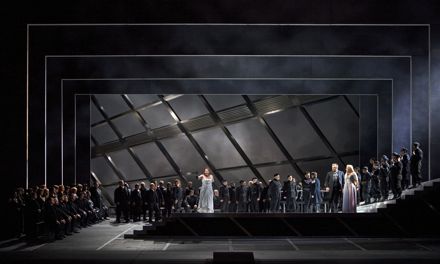 Götterdämmerung, photo courtesy of San Francisco Opera, copyright Cory Weaver
Götterdämmerung, photo courtesy of San Francisco Opera, copyright Cory Weaver
This was not a minimal phyiscal Ring. It was created by veteran opera designer Michael Yeargan. There were four superimposed prosceniums and a sentient floor (lighted from underneath) that served as the stage mechanism for the Wagner mega-drama, with full stage screens flying in and out at all depths of the stage to capture the inexhaustible catalogue of projections developed by Jan Hartley and her associates. If the freeway interchange under which Wotan saw Siegmund die and where he murdered Hunding was not life size it seemed so. Hunding’s mountain cabin was as good as real as was Mime’s wrecked Airstream trailer.
What, you may ask, held all this together. It was the Brünnhilde of Swedish soprano Nina Stimme who brought bonafide Teutonic style to rock solid vocal production and muscular physicality to her indefatigably energetic Valkyrie. This Ring was Brünnhilde’s personal story, placed in even higher relief by the pallid portrayal of Wotan by American bass Mark Delavan, a performance that effaced the Wagnerian complexities and emotional stature of this human father cum transcendent being. The suspicion lurks that this was the intention of Zambello, a suspicion founded on the portrayal of Siegfried as one step above the village idiot, charmingly rendered by Jay Hunter Morris in Siegfried, and less vividly but vocally far more convincing by English tenor Ian Storey in Götterdämmerung.
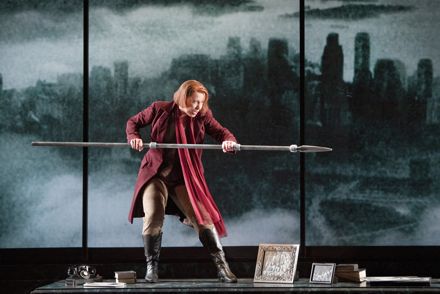 Nina Stemme as Brünnhilde, photo courtesy of San Francisco Opera, copyright Cory Weaver
Nina Stemme as Brünnhilde, photo courtesy of San Francisco Opera, copyright Cory Weaver
There were several performances that stood out among the universally good performances of the entire cast. The Siegmund of American tenor Brandon Jovanovich was disarmingly charismatic and Italian basso Andrea Silvestrelli created Zambello’s arch villain Hagen with supreme testosterone gusto. American tenor David Cangelosi as Zambello’s creepy hobo Mime succeeded in making the first two acts of Siegfried high points (well, among many) of the entire cycle.
San Francisco Opera does not seem to have been a competitor in who-can-spend-the-most-for-a-Ring contest. Still, there went a pile of gold. One assumes costumer Catherine Zuber was well rewarded for what was an heroic and immensely successful effort, as was the complex lighting of Mark McCullough — both seasoned opera pros, like Zambello and Yeargan and their supporting teams.
It was not a prestigious Ring, like the Aix Ring with the Berlin Philharmonic in the pit (by the way with the six harps Wagner requires — San Francisco made do with two) with its elegant, minimalist staging by Stéphane Braunschweig. It was not an arty Ring imagined in a rarefied visual language like the splendid L.A. Achim Freyer Ring, nor was it a big, international house Ring with proven big name interpreters and the flavor-of-the-day producer (by the way that would be the Robert Lepage Ring at the Met).
The San Francisco Ring was a good Ring, if a wacky one that seemed at times like it might even be a spoof. It was however, perhaps therefore absolutely understandable. The experts may debate how it betrayed or illuminated Wagner’s musico-philosophic treatise, but they too will admit that those seventeen hours in the War Memorial Opera House were full of fun and richly rewarding.
The Turn of the Screw in Los Angeles
Strange things can happen at L.A. Opera, like chamber opera struggling to survive in a great big opera house. Britten's little masterpiece had a hard time of it in the Dorothy Chandler even though great effort was expended to blow it up to grand opera proportions.
To wit, verismo diva Patricia Racette was Britten's Governess, young Verdi spinto Tamara Wilson was Miss Jessel, and the Met's Papagena, diminutive Ashley Emerson was the child Flora.
A complex production was imported from England's Glyndebourne Festival (this intimate opera house seats only 1200 but it has a big stage), designed by big time British designer Paul Brown (his most recent West Coast credit was the 2007 Graham Vick Tannhauser at San Francisco Opera) and directed by Jonathan Kent of London's Almeida Theatre fame, incarnated in Los Angeles by Francesca Gilpin.
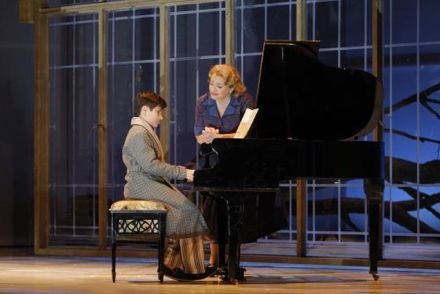 Governess, Miles
Governess, Miles
But on a much smaller scale were the Quint of William Burden and the Housekeeper of Ann Murray. Mr. Burden was positively collegiate as the narrator, and youthfully wholesome as the scary ghost Peter Quint. Mme. Murray was a no-nonsense, take-charge housekeeper.
Twelve-year-old Michael Kepler Meo as the not-so-innocent Miles proved himself an accomplished musician and actor, but read as very small within the vast spaces of the Dorothy Chandler and within stage director Kent's vision of Britten's little horror story. His sister Flora, Mlle. Emerson, was a finished artist with a mature voice. If this attribute contributed vocal symmetry to the ensembles of female voices, it gravely unbalanced her scenes with Miles.
Ignoring Britten's obsession with the sexual journeys of the souls of children, the L.A. psycho-drama was drawn by Mr. Kent along the lines of the Henry James novella, delving deeply into the Governess' obsession with her unseen employer. Mme. Racette is a powerful singer and presence making such a diva the perfect choice for an undertaking of this sort. Ideally one might wish for a diva with a greater spectrum of vocal color and subtlety of tone to mine such a potentially fruitful heroine, but one cannot deny that la Racette was electrifying in Miles' death scene.
Two more very powerful, if brief moments resulted from this literary conception — the Governess' encounter with her ghostly nemesis Miss Jessel, Mlle. Wilson a vocal force and a huge presence that the Governess had finally to confront; and the last scene when we understand that little Miles in the mind of the Governess had become her London employer, the child Miles, beautifully acted by Mstr. Meo, now in male formal attire assumed masculine poses taunting the Governess.
The set accentuated the sense of obsession, its floor was two concentric circles that moved incessantly in opposite directions during the musical transitions between scenes. A sort of spatula-like window construction hung over the floor that twisted and turned and flattened to sketch location (lying flat on the floor it was the lake), visually imposing a further source of obsession.
Mr. Kent's obsession with the Governess' obsession was well taken, and indeed successful, but there were long periods when his story-telling was vague and we had only the magic of Britten's musically obsessive score to keep us involved. Here the hard edged and mechanical minimalist production faltered, the vast impressions and atmospheres that permeate Britten's operas were defined in too few, specific rotating objects, his sexual mysteries reduced to nothing more than blue light. This pat definition effaced the intoxicating psycho sexual world of opera's most sex-obsessed composer.
James Conlon, Los Angeles Opera music director, did not succeed in igniting the magic of the Britten musical ethos in the big acoustic of the Dorothy Chandler. The sound of the thirteen players of Britten's chamber ensemble was simply loud. It lost all beauty of tone (I sat in the seventeenth row of the orchestra) and therefore could not evoke Britten's delicately beautiful explorations of incipient psycho-sexual drives.
The Turk in Italy in Los Angeles
Stage director Christof Loy can be very witty. But you must look well beneath the surface to discover his wit in this Hamburg Opera production of the fourth of Rossini's great comedies — Barber, Cenerentola, Italiana and last, absolutely not least Turco!
You may never find it. Or you may determine that it is witty to ignore the heavy handed sentimentalism Rossini heaped on his Turco and instead play with its conceit — a playwright is looking for a story, and learns that it is dangerous when art gets confused with life. Mr. Loy got heavy handed in turn, as his playwright became evermore beat-up as the evening progressed. Physically beat-up by sight gags.
Rossini is indeed presentational (his singers regale their audiences with their art), and Chistof Loy chose to make his comedy presentational — his actors regaled the audience with physical humor (lazzi in commedia dell'arte meaning little physical tricks, or slapstick in American vaudeville). It was nonstop fun starting with his modern-day gypsy camp trailer (a common sight in Europe) doing the old clown trick of expelling more clowns, here gypsies, than could possibly be in it.
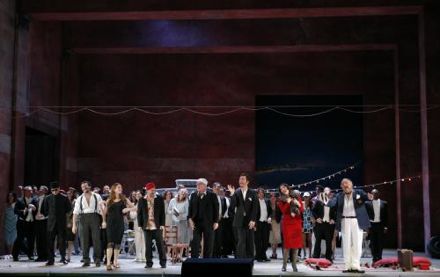
This trick took place in the overture. As it wore on we lost track of the music, curious instead as to how many more choristers could possibly emerge, and when they might. Mr. Loy is fine director, his physical comedy throughout the afternoon was delightful, and well-paced. And, well, maybe we did not even need the music.
Los Angeles Opera music director James Conlon was in the pit. He gave us a stupendous Lohengrin and a dynamite Rigoletto earlier this season. The maestro does not seem to be a Rossinian (nor for that matter is the Dorothy Chandler a Rossini theater) and this exceptionally vibrant Rossini score never reached its boil, its delirium, or its euphoria. Notably absent were the extended ovations that well performed Rossini evokes (though it was a sleepy matinee audience).
Maybe Rossini almost made it to this performance in the first act finale when Mr. Loy finally began listening to the music and structured his stage movement in musical rather than comedic terms. Plus Mo. Conlon proved he could deliver some hints of Rossini when the music was not competing with the stage.
But it was a long afternoon, a wet blanket thrown on it with the announcement that Italian buffo Paolo Gavanelli, the Don Geronio, would mark his role rather than sing it because he was indisposed. In typical singer fashion this lasted about five minutes, and then he became caught up in the fun and gave his all the rest of the afternoon, though his big aria was cut as a courtesy to his indisposition.
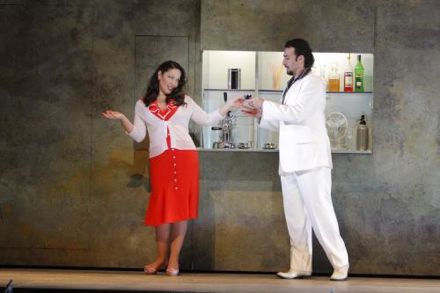 Fiorella, Turco
Fiorella, Turco
Georgian soprano Nino Machaidze was a superb Fiorella, completely unconvincing as a repentant wife though of course it hardly mattered as she marched through all the physical paces without sacrificing brilliant singing. Mlle. Machaidze is a star. Veteran baritone star Thomas Allen too gamely effected the Poet.
The Turco himself was young Italian bass-baritone Simone Alberghini, already a veteran Rossinian with appearances at the Rossini Festival in Pesaro. He was completely convincing in his comedic persona and vocally secure in his delivery though hampered by tempi that were not sufficiently quick to make his singing fun.
American mezzo-soprano Kate Linsey gave a fine accounting of Zaida, the Turco's true love. Russian tenor Maxim Mironov was the too-small-voiced Don Narciso, needing the confines of a real Rossini theater to expose his considerable talent as a Rossini interpreter. This Christof Loy production was staged in Los Angeles by Alex Weidauer.
Il barbiere di Siviglia in Montpellier
There is more than one way to skin a cat.
Montpellier's old Comedie would have been a perfect venue for Rossini's most famous comedy, but this fine, late-nineteenth century Italian style theater is closed for renovation. This left the huge, ultra-modern Théâtre Berlioz, a barn-of-a-theater that the Opéra National de Montpellier often makes work against all odds.
The solution for presenting Le Barbier de Seville in this vast space was to import an existing production from another barn-of-a-theater, the Deutsch Oper Berlin. The Deutsch Oper had some solutions of its own for blowing up Rossini's diminutive masterwork to sufficient size to fill up its vast space.

To wit, performing it as a sort of commedia dell'arte on a stage wagon pulled by a tractor onto a beachfront esplanade in front of a lively square that was perhaps Seville, though of course Seville is nowhere near any sea. There was a beach, and we presumably sat on it to watch the show, together with various little families, lovers, same-sex lovers and a donkey all of whom from time to time were doing their own thing.
It is Berlin after all, where artistic choices are sometimes questionable though usually amusing. The Deutsch Oper had hired Katharina Thalbach, a protege of Brecht's theatrically chic Berliner Ensemble, to stage the opera. Thus Rossini's hyper-sophisticated early nineteenth century opera would have the gloss of hyper-sophisticated mid-twentieth century theater. It was simply the old-hat trick of a play within a play.
If you are getting the idea that all this could not possibly work you are absolutely right. And worse placing Rossini's opera within quotation marks distanced us from Rossini's inimitable musical immediacy. The theatrics were indeed clever (and there were abundant antics by the crowd watching [or not] the silly play to keep us amused). The great Rossini was reduced to a small stage on the stage. And the pit.
The Opéra National de Montpellier had made its choices too. A big theater demands a big conductor, and the Italian maestro Stefano Ranzani was an obvious choice, with credits of the biggest repertory in the biggest theaters. A lot of big music resulted, and of course some weird tempi. And there was even some Rossini to be heard though this was perhaps the first Rossini this maestro ever conducted — no Rossini credits were listed in his program biography.
There were even a few times when a modest Rossini boil was achieved, but those were moments when the maestro was aided by the two veteran Rossinians in the cast, Simone Alaimo as Basilio and Alberto Rinaldi as Bartolo. It was a hint of what Rossini can be but almost never is in great big theaters.
Bartolo's ward and intended bride Rosina was Georgian mezzo soprano Ketevan Kemoklidze, a recent winner of the Placido Domingo competition (among many other competitions). Appropriately for winning competitions and for Rossini's Rosina, Mlle. Kemoklidze exhibited boundless confidence. She possesses an unusually bright mezzo voice, a winning stage presence and obviously sings quite well.
Her lover Almaviva was Italian tenor Filippo Adami who sang very well too, and attacked Rossini's fioratura with cool bravura. Mr. Adami possesses a voice with a fine edge and not much sweetness, attributes that would be more appreciated in productions with specific Rossini musico-dramatic values.
If Mlle. Kemoklidze and Mr. Adami came across as sophisticated performers, young French Canadian baritone Etienne Dupuis, the Figaro, presented himself as a consummately charming performer, but one who does not yet possess the finesse and bravura to fully anchor Rossini's comedy.
These three young performers are representative of a fine new generation of opera singers, well prepared vocally and musically, and willing and able to fit themselves into whatever directorial visions may occur. This Montpellier staging was obtuse, complex and demanding. These performers made all possible effort to pull it off, and they did. Bravo!
The mid-winter holidays are festive, and entertainments are meant to be festive. If nothing else Le Barbier de Seville in Montpellier was just that. Unlike Berlin, there are actually fine beaches not far away where we will soon find ourselves. All said and done this production was maybe right at home in Montpellier.
La Belle Hélène in Marseille
A legend in French musical theater, metteur en scène Jérôme Savary first staged La Belle Hélène at Paris' Opera Comique in 1982. Just now it was the Opéra de Marseille's festive holiday offering in yet another of this production's countless incarnations, though the sixty-six-year-old Chevalier de la Légion d'honneur now entrusts his famous productions to his long time associate Frédérique Lombart for staging.
By 1864 the Offenbach operettas were no longer casual Parisian entertainments but were very big pieces with daunting production requirements. La Belle Hélène is the first of these operas for the Théâtre des Variétés where his most famous titles were soon seen — La Périchole, Barbe-blue, La Grand Duchesse. Les Brigands, and La Vie Parisienne all occur before the end of this decade.
There is giddy magic in a successful production of any of these Offenbach masterworks. This arrived in the 2003 Marseille edition of La Périchole though it has been sorely missed since here in the south of France. Thus the critical discussion is usually how close a production may come to achieving the Offenbach magic.
Offenbach called these masterworks opéras bouffes, though Orphée aux enfers (1858) is termed an opéra bouffon. In the Offenbach oeuvres (100 more or less) one also finds opérettes, opérettes bouffes, and opéras comiques. Whatever the genre distinctions may be (maybe there are some) all share the mixture of the spoken word (dialogues and soliloquies) with songs, duets, choruses and ballets, and complex musical finales. In the successful contemporary productions a balance of the spoken and musical is achieved that is possibly quite different from the 1860's ratio.
To an outsider France is a club and its members are the French, though there do seem to be a few foreign initiates. But the language part is especially hard for those of us who are not initiates. I must admit that I understood little of the archly delivered spoken performances even though I had reviewed the text in the program booklet — it had been greatly expanded in the actual performance. Finally the spoken word seemed to far outweigh the sung word in the overall import of the performance. The sung words were far more understandable, reinforced by projected super titles.
Egyptian born conductor Nader Abbassi is an easily identifiable initiate of the France club as he managed to create believable Offenbach froth, besides giving some of us quite a show. I had an easy view of the TV monitors that face the stage for the benefit of the singers and thus was awarded sight of the maestro's extravagant arm waving in the quite lively overtures (Mo. Abbassi is music director of the Cairo Opera where he is famous for his arm waving). He did use his stick to demurely stir up some genuine giddiness in the great third act trio (Menelaus, Agamemnon and Calchas) and to make effervescent magic of the opera's recurring waltz.
The Savary production knows that in Offenbach less is more, thus the physical production was cannily simple and cheap, with a knowing naivete that mocked the gravity of the story (the abduction of Helen that caused the Trojan War). Added comic detail was minimal, and just a touch of sauciness was achieved by two, in-your-face topless figurants (supers).
Our attention was justly focused on the singers who had only their personalities to bring their performances alive. Soprano Mireille Delunsch in her role debut held the stage as a fairly straight-laced Hélène empowered by big, fine singing that the role's famous originator Hortense Schneider famously lacked. French trained English tenor Alexander Swan (another France club initiate) found the just-right attitudes for Helen's abductor Paris, and sang in a quite small, well-focused voice that betrayed his sizable comic presence. Helen's husband Menelaus was amusingly enacted by tenor Eric Huchet, his bumbling presence comic perfection. With some exceptions the many smaller roles were performed with charming verve.
The six men and six women of an extravagant corps de ballet executed quite a lot of complex and effective choreography credited to Josyane Ottaviano though it was unclear if it was original choreography or a reprise of a previous production.
The evening seemed long, but finally the lanky maestro took his bow, raised his famous arms and we all sang the waltz chorus one last time and left the theater still humming.
Lohengrin in Los Angeles
At the end, in the milliseconds of silence before the applause burst there were whispers of "awesome!" Then the crowd went wild, and with good reason.
This was a richly detailed telling of Wagner's saga where a knight arrives on the back of a swan and confuses even more an obviously deranged young woman. It gets still more confusing as we struggle to determine if this complicated opera event is a retelling of Lady MacBeth, a deconstruction of The Magic Flute, or a peculiar rehashing of Orphée et Euridice.
Quite a few disparate elements came together in L.A. to blow our minds — an ugly old Lohengrin unit set, a brilliant young stage director, a great heldentenor with a silver leg, a snarling Verdi mezzo, two fine singing actors and a superb conductor leading an orchestra that is fast becoming a formidable ensemble.
If all this sounds truly wonderful, it indeed was. If there was a unifying element it may have been the spectacular brass choirs that inhabited the light wells on both sides of the hall — an occasional reminder that this was over-the-top magnificence.
Of course this staging of Lohengrin should have inhabited a white box set. The tensions that make Wagner's saga are purely human, manifest in the human forms, i.e. real bodies, on the stage. We would have been much more comfortable without a pretend locale (a huge, brown colored styrofoam ruin of a protestant looking church). But there it was, so forget it.
Stage director Lydia Stier, an American though of Germanic theatrical formation, carefully illuminated the complexities of Wagner's saga using only a tent, a bench, a bed and a sea of litters covered with wounded humanity. Mlle. Stier carefully positioned her actors to create the myriad of human confrontation inherent in Wagner's lively, even racy story. She asked of them only minimal but always telling movement, letting the tensions of Wagner's most un-Wagnerian opera explode in abstract, musical form.
The complicated machinations of Ortrud and Telramund resolved themselves as a moving love story, the disillusion of Lohengrin was heart-breaking, and the stupidity of a simple young girl was wrenching. This young stage director involved us deeply in these human stories so that when the larger, metaphysical implications exploded (well, maybe there was no swan but there sure was quite a bit of swan colored lights flooding the stage) we felt the release from human complication and maybe a brief glimpse of human purity and possibly a momentary hope of salvation.
Lohengrin himself never really fooled anyone. We saw a battle-front surgeon, actually Telramund, remove someone's leg, and soon after Lohengrin arrived with a silver leg. It was not a prosthetic leg of course, it was a magic leg. In the context of this production it became the talisman for Wagner's musical and philosophic mysteries.
Mlle. Stier's staging set the stage for magic to be made, and that magic came from the pit. Conductor James Conlin drove Wagner's saga musically, his singers instruments of the larger musical texture, the complex stories unfolded in unrelenting, unending musical detail. The catastrophic confrontation of Elsa and Lohengrin unfolded in painful clarity, and finally the miraculous appearance of her young brother occurred in maximum volume and orchestral magnificence. It was very human Wagner.
Ben Heppner is the undisputed heldentenor of our day. He was in fine voice except when he squawked. These not infrequent occurrences (11/28) did not seem to phase him, and therefore these weird noises did detract from his otherwise splendid performance. In the context of this production his limited acting skills were put to good effect.
The Elsa was sung by Finnish soprano Soile Isokoski who brought innocence and simplicity to the role with her bright, young sounding voice that was able to soar above all else in the climaxes but was sometimes covered by Wagner's orchestration in smaller moments. Likewise American baritone James Johnson was in excellent voice, his helden baritone though cut through thicker textures making his performance extraordinarily vivid. His sympathetic persona and sensitive acting made this Telramund a very human victim.
Mr. Johnson's exchanges with his Ortrud, Dolora Zajick were among the spectacular moments of the performance. Mme. Zajick was making her first foray into the Wagnerian repertoire. Known for the big Verdi mezzo roles in stand-and-sing mega productions here instead she was asked to create a character in a concept production. She tried and in fact succeeded to some degree. In fact she was more successful as an actress than as a Wagnerian singer, her lower registers were hidden within orchestral textures and her trumpeted high notes were too loud within Wagner's dramatic context. She earned the biggest ovation of all (singers and conductor) probably because she sang the loudest.
Much has been made of the austerity of this L.A. Opera season. Both the Rigoletto seen November 27 and this Lohengrin seen November 28 betrayed an opulence of artistic spirit that could be the envy of any opera company anywhere.
Rigoletto in Los Angeles
Nostalgia is one of la la land's dominant notes, thus an old fashioned Rigotetto seemed right at home in L.A.'s 1960's Dorothy Chandler opera palace. The production was borrowed from San Francisco Opera though there was little evidence that it amounted to more than some scenery in front of which a miss matched cast more or less did its thing.
There were however unexpected pleasures, like the Rigoletto of Georgian baritone George Gagnidze, who stumbled back and forth across the stage in a sort of distorted walk that was just enough to indicate a character. Mr. Gagnidze delivered a vocally resplendent and musically stylish rendition of Verdi's twisted hero. Crowning his performance was the Cortegiani, vil razza dannata hurled with maximum vehemence, then magically melted into supplication with its cello obligato gloriously delivered.
It was big music making at the urging of conductor James Conlin when in fact he had big singers. Mo. Conlin has unique respect for Verdi's voice and vocal line manifest in his willingness to support a big voice and its inherent musicality rather than create and drive his own musical force. Mo. Conlin made this Rigoletto about voices.
Italian bass Andrea Silvestrelli is the quintessential Sparafucile, his voice brutish rather than beautiful, his stature dark rather than handsome. He was a worthy vocal collaborator with the maestro's pit as was young American mezzo Kendall Gladen who made a sympathetic [!] Maddalena. She exuded sufficient exoticism to easily seduce the Duke of Mantua and had sufficient vocal heft and style to eloquently negotiate with her brother to save the Duke's life.
By that time however few present would have lamented his demise. Italian tenor Gianluca Terranova gave a fairly straight, even pleasurable la donna è mobile but marred most everything else he sang with aggressive vocalism. Sig. Terranova creates a supremely caddish Duke who is at odds with Verdi's essentially elegant singer, and Mo. Conlin's elegant conducting.
All the maestro's fine conducting could not salvage Verdi's Gilda, delivered by American soprano Sarah Coburn. Though easily sung, her Gilda lacked the flash needed to hold the stage in this musically fired production.
The stage direction was attributed to Mark Lamos, though it looked like he had not tried to impose much shape. Mr. Lamos had collaborated with set designer Michael Yeargan to create this spare (no props) production in 1997. The elegant set served this Los Angeles edition well, the geometrically abstracted Mantua was saturated in primary colors. Its precise structures and varying colors well seconded Verdi's solidly constructed, emotionally vivid, second period set-piece style. The production team did not take opening night bows.
The Makropulos Case in San Francisco
Just now in San Francisco Finnish soprano Karita Mattila kicked ass as Janacek's 337 year old Elina Makropulos.*
Specifically she kicked the asses of the several men who materialized in her long, long life just as the effects of the longevity potion her father invented back in 1593 began to wear off. These unfortunate men had awakened those few moments when, over the centuries, her soul had been moved, and these rediscovered feelings conflicted with her instinct for eternal life as she had come to understand over the centuries the futility of her emotions. She finds resolution of this conflict in death.
This bizarre masterpiece is, all said and done, Janacek's idea of a comedy. His uniquely middle European depressive poetic, melding philosophy with highly complex emotions took solid hold into the reaches of War Memorial Opera House by its third performance (November 17).
Universally vivid performances. Elina's great, great, great, etc., grandson Berti sung by Slovakian tenor Miro Dvorsky touched the true tonalities of the Czech language, the Prus of German bass-baritone Gerd Grochowski found the suavity and confidence of an Austro-Hungarian aristocracy, the fumbling lawyer Dr. Kolenaty was enacted skillfully by stalwart San Franciscan buffo Dale Travis.
Touching were the performances of Adler alumni Thomas Gleen as Vitek and Brian Jagde as Janek, the callow young victim of Elina's perfected sexual prowess. Adler alumnus Matthew O'Neill was caricatural pure perfection as Elina's idiot lover Hauk, as was Kristina, the opera-star-to-be (Elina Makropulos' protege) sung by Susannah Biller.
Dominating the stage equally were Janacek's heroine Karita Mattila as Elina Makropulos and Janacek's orchestra conducted by Jiri Belohlavek. They were simply one and the same, one soprano embodying Mo. Belohlavek's seventy-three players. Yes, the performance was huge. She was huge, the enormity of 337 years of life graphically unravelling on the stage was quite real.
The story of Elina Makropulos is told musically rather than dramatically, the little lawsuit Gregor vs. Prus merely pretext for the inner life of Mme. Makropulos to explode in the orchestra, superseding the dramatic inconsistencies and general confusion of the libretto.
Mme. Mattila absorbed every musical movement in a dramatic performance so complete that it will become legendary as it traverses the world. For this she has partnered with conductor Belohlavek who revealed the gamut of the depraved humanity Janacek had transformed into pure music in his preceding oeuvre. Like all Janacek heroines Elina Makropulos too attains a sort of salvation by reconciling herself to the futility of life.
The production by Viennese director Olivier Tambosi merely supported the Mattila performance, the stylishly directed supporting cast moving appropriately over the turntable set imagined by big-time designer Frank Philipp Schlëssmann. Like the staging the set disappeared behind the Mattila performance. Its cartoon lines were self-consciously descriptive of a caricatural concept that the production flirted with but never fully absorbed. Maintaining this careful balance of caricature and expressionist comedy was however the strength of the production, allowing at least some perspective for the over-the-top Mattila performance.
*"Let's kick ass" was Mme. Mattila's term before attacking Salome last year on the Met's Live in HD.
Madama Butterfly in San Francisco
San Francisco Opera has hosted all the important Butterflies over the years — well almost all. Surely its connoisseur audience has long awaited the Butterfly of Daniela Dessi who finally is The City's latest Lepidoptera specimen.
Mme. Dessi brought a true Italian spinto bravura to the role though at this point it was intermittent, this wonderful artist now adept at harboring her forces that she can sometimes unleash to supreme effect. Her tu, tu, tu was a ravishing display of the Italianate style, and her suicide genuinely moving. The rhythmic exaggerations of her second act outpourings were exciting if musically untenable — this willfulness the prerogative of a real diva. Throughout the evening she nailed the essential high notes, if briefly, and achieved most other of Butterfly's salient vocal points even though un bel di was mostly murmured.
No longer in vocal bloom, la Dessi was unable to capture the ravishing beauty of Puccini's Act I Butterfly, her voice was sometimes barely audible, and seemed in distress over its passaggio. Yet the lower voice found the usual burnished beauty of tone that has made this estimable soprano unique.
Like Mme. Vassileva (her predecessor in the role this fall) Mme. Dessi was betrayed by the Broadway style Hal Prince production. If la Vassileva was the essential Belasco Butterfly, la Dessi is the diva Butterfly, one that needs the standard trappings to ground an essentially old-school approach to opera. The second act gold Victorian dress in lieu of traditional Japanese attire gave her the grim authority of a schoolmarm of the old west.
But Mme. Dessi did find a sympathetic collaborator in the conducting of Bulgarian Julian Kovatchev, a regular in Italian theaters. Mo. Kovatchev reveled in the usual Puccinian sonorities and provided a firm foundation for Mme. Dessi's rhythmic vagaries with tempos sympathetic to singerly expectations. Conductor Kovatchev has replaced maestro Luisotti for this late season Butterfly cycle.
No longer Luisotti's terrorized Pinkerton, Stefano Secco gave great pleasure, his voice in full bloom, his style replete with Italianate mannerisms very tastefully rendered. The new maestro gave Mr. Secco the tempi he needed to pursue the glories of Puccini's musical line in this richly rewarding collaboration.
Hawaiian baritone Brian Kelsey possesses a fine voice of youthful urgency with sterling potential to be a powerful Rigoletto some day. Though Mr. Kelsey gave much vocal pleasure in this musically settled performance Puccini's Sharpless wants a warmth and gravitas that this fine young artist does not yet possess.
This was a Butterfly for connoisseurs. The twelve performances of Madama Butterfly this fall most certainly were programmed to attract a broad public to the War Memorial Opera House. Would it better serve the cause of opera to have offered a production of vocal and dramatic integrity?
Cyrano de Bergerac in San Francisco
Franco Alfano's Cyrano de Bergerac at the San Francisco Opera has little chance of measuring up to a Cyrano standard once set here in Fog City.
There are those of us who remember the San Francisco American Conservatory Theater's Peter Donat as Cyrano and his Roxanne, Marsha Mason, unleashing floods of spellbinding lyricism in the Geary Theater. This was back in the 1970's, the mere recollection sets the current Cyrano benchmark impossibly high.
Cyrano the seventeenth century dramatist and Cyrano, Edmund Rostrand's Belle Époque hero dealt in the spoken word. The rhythm and music is already there. Franco Alfano, a twentieth century post-Romantic opera composer adds only more opulence to Rostrand's 1898 already opulently verbal masterpiece but he cannot surmount Rostrand's lyrical flights — his extravagant music simply overwhelms the more modest art form.
Near the end of his long life Henri Caïn (Massenet's well-experienced librettist) provided Alfano with this easily workable libretto of Rostrand's Cyrano, each act with its central lyrical episode surrounded by lively battle scenes. Alfano's advanced Romantic compositional technique responded to these scenes with music that rivals Meistersinger's midsummer night's riot and Otello's storm, and this complex, descriptive music is indeed effective. But when Alfano wishes to describe emotions his music teeters on the edge of insincerity as its sheer size and sheen betrays all intimacy.
Enter the grand old man of opera, Plàcido Domingo, veteran of opera's greatest lyric moments! Though now he is too old to be Cyrano his presence alone is enough to enliven the lyric muse. And perhaps he has always been Cyrano, his art coming so easily to him that it can become real only in the person of another, a character he plays. In the Rostrand Cyrano it is handsome, young Christian who takes his voice. But Domingo is no longer young, and perhaps this does not matter as Rostrand has his Cyrano die fourteen years after this torrid love poetry is spoken, and now, near death most movingly repeated by the aged tenorissimo.
Just last year this Cyrano was produced at the Châtelet theater in Paris. It is rare that the Châtelet produces, preferring to search out productions of opera and music theater that are famous or infamous and need therefore to be seen in Paris. So this Cyrano was conceived as a boutique production to compete with the rarest and finest of Europe's opera productions.
It has survived its translocation to San Francisco, no longer a boutique production here but as part of a repertory season. It profits greatly from San Francisco Opera's superb orchestra that overcame with ease the difficult score and made Alfano's descriptive music glow at the direction of St. Etienne's Patrick Fournillier, a Massenet specialist. Both the Roxanne, Ainhoa Arteta, and her lover Christian, Thiago Arancam are from the Domingo cadre. Mme. Arteta provides a lovely figure as Cyrano's muse but her fine soprano does not possess the beauty of tone one could wish for Roxanne. The same could be said of tenor Arancam who otherwise made a good Christian.
The supporting roles may not have a panache equal to their Parisian counterparts but showed San Francisco Opera as a truly fine ensemble company, specifically the villain De Guiche sung by Stephen Powell, the baker Ragueneau sung by Brian Mulligan who here proves that he belongs in character roles, and the lieutenant Le Bret sung by Timothy Mix. The drunken Bojan Knezevic stands out as well, as do Adler Fellows Austin Kness and Maya Lahyani in various roles.
The Châtelet Cyrano is above all else cinematic, a style that well fits the swashbuckling Cyrano (well he did manage some fairly quick moves) with very flashy swordsmanship surprisingly executed without mishap by eight fencing acrobats. The cinematic staging also pointed out the cinematic nature of Alfani's intimate music, small movements of spirit sonically magnified to full-screen proportion. What was once verismo was by the mid 1930's neo-verismo well on its way to becoming movie melodrama.
Romanian opera director Petrika Ionesco staged this Cyrano de Bergerac in the way that Parisians love — nostalgic longing for the the bloodiest and the artiest moments of their history, and a dose of kitsch as well. Mr. Ionesco has staged both Aida and Nabucco at the 80,000 seat Stadt de France and The Millennium Project and Continents on Parade at EuroDisney (near Paris). Here is a man that knows pageantry.
Colorful theater, good opera and one of San Francisco Opera's finer recent moments.
Roberto Alagna was the Cyrano in the Opéra National de Montpellier's Alfano Cyrano in 2008. No doubt a San Francisco debut by this tenor would generate an enthusiasm equal to that of this Domingo return (if not the nostalgia). For the record the Festival de Radio France et Montpellier revived several late verismo operas in the early years of this new century, notably operas by Alfani, Franchetti, and Mascagni.
Salome in San Francisco
If Herbert von Karajan conducted Madama Butterfly and Maria Callas sang Isolde it follows that Nicola Luisotti should conduct Salome.
And that is exactly what he did at San Francisco Opera just now where he is the incoming music director, and therefore can conduct what he pleases. No reduced orchestration for this maestro, the ninety-one players stuffed into the War Memorial pit made a mighty sound, a mighty opulent one.
Mo. Luisotti sought the sonic richness of this early Strauss score rather than its burgeoning sexuality and exploding nervousness. The psychological penetration that is Strauss’ discovery in *Salome* may not yet have become the orchestral maelstrom that bares Elektra’s tortured soul, nonetheless Strauss is dealing with a pantheon of unstable personalities who enact a very sexual, personal and finally very ugly story. Strauss obliges with music that is sometimes sensual and sometimes ugly, but always personal — after all it marks a difficult passage and consequent loss of innocence. Mo. Luisotti opted to make it all beautiful.
It is an unabashedly lush score, as Mo. Luisotti helped us discover as never before. He caressed its musical lines that evoked the opera’s evening setting, the rising moon and the overwhelming grandeur and power of the word of God. His lions roared and his dogs barked and Herodias raged. But Luisotti did not discover the delicate sensuousness with which Strauss enveloped Salome, nor the desperate lust and self doubt that tortured Herod, or the sense of impending doom that hangs on every word of the text.
Luisotti version of Strauss’ first great opera was supported by the production imported from the Opera Theatre of St. Louis, the stage *a vista* (open to view) when we entered the auditorium, the soldiers, Jews, Nazarenes, were milling around as they did the entire evening, making Salome’s sexual awakening a public spectacle rather than a personal drama. But these onlookers did not seem to know quite what to do or think as they stood around. We were kept waiting for them to react but they never did.
One of several daunting challenges facing a *Salome* stage director is the extended length of its dance of seven veils. The Opera Theatre of St. Louis production sought to solve this problem by engaging a choreographer, Seán Curran, to stage the opera. His solution was to impose an unrelenting formalized ritual, ten minutes of abstract choreography whose sensuality was limited to the flowing geometry of five or six squares of silk pulled through the air by a pair of eunuchs. The final shock of Strauss’ dance was eviscerated by completely covering Salome with silk veils so that, as we found out, she could make a quick change into a gold, vaguely Klimpt-essque gown for her orgy with John the Baptist’s severed head.
The setting too, by Bruno Schwengl, was unrelentingly geometric, a hard edge rectangular box disappearing into an exaggerated one point perspective that the supertitles called a vault and the libretto calls a cistern, but in this production it was really the most private part of the female anatomy, with an opening that expanded and contracted just like the real thing (honest to God). Gratuitously symbolic except that when the executioner entered it and Luisotti’s pit made its super exaggerated slicing noises the effect was a virtual hymenectomy. It was flat out gross.
But John the Baptist was not really inside the vault. When he was to have been heard from the cistern/vault he was actually off-stage down left singing through a sousaphone bell. His voice was weirdly loud over there on the side, very far away from where it was supposed to be (upstage center), and could have been had modern electronic technology been allowed to do its magic.
There were some fine performances on October 21 (the second one), particularly Nadia Michael as Salome, certainly one of the more resplendent of our current Salomes, her youthful figure able to embody a vocally well drawn character, with reserves of gorgeous tone sufficient to soar above the massive Strauss orchestral climaxes. We may miss the neurotic tinges awarded this complex role by Anna Silja and Maria Ewing, and the uncanny histrionics perpetrated by Leonie Rysanek (all former San Francisco Opera Salomes) but we did profit from Mme. Michael’s more even temperament as she did her best, a good trouper, to go along with this hapless production.
Reportedly in the fourth of the six performances her stamina waned, and she then bowed out of the fifth performance. Molly Fillmore was brought in at the very last moment from Arizona Opera where she is rehearsing the role (according to SFO general director David Gockley’s front of curtain announcement). While those of us there that evening must be grateful to Mme. Fillmore for the obvious heroics necessary to get through the performance, we can question San Francisco Opera’s lack of an adequate cover in what were foreseen circumstances.
Greer Grimsley gave his brief on-stage performance as Jokanaan splendidly, blinded by light delivering his confrontation with Salome with genuine fervor and horror, his curse ringing in our ears. Russian mezzo-soprano Irina Mishura gave a fully sung, lurid account of Herodias that was intense and chilling, as it should be and so rarely is.
British tenor Kim Begley is not a big enough performer to bring Herod as horridly alive as he should be. One remembers Mr. Begley as a fine, sympathetic Narraboth, this role in this production taken by Garret Sorenson who made no effect in what can be a most affecting role. Perhaps both Mr. Begley and Mr. Sorenson were betrayed by the conducting and production, thus exonerating them from blame for their pale performances.
With staging entrusted to a choreographer there was much smooth movement. Overall the effect was in fact choreography rather than staging, except in the complex ensemble scenes when staging reverted to textbook procedures.
Cast and Production
Salome: Nadja Michael; Herodias: Irina Mishura; Herod: Kim Begley; Jokanaan: Greer Grimsley; Narraboth: Garrett Sorenson; A page: Elizabeth DeShong; First Jew: Beau Gibson; Second Jew: Robert MacNeil; Third Jew: Matthew O’Neill; Fourth Jew: Corey Bix; Fifth Jew: Jeremy Milner; First Soldier: Andrew Funk; Second Soldier: Bojan Knezevic; First Nazarene: Julien Robbins; Second Nazarene: Austin Kness; Cappodocian: Kenneth Kellogg; Slave: Renée Tatum. Conductor: Nicola Luisotti. Director: Seán Curran. Consulting Director/Dramaturg: James Robinson. Production Designer: Bruno Schwengl. War Memorial Opera House, November, 2009)
Madama Butterfly in San Francisco
“One of the most beautiful sets I have ever seen,” crows San Francisco Opera general director David Gockley over the airwaves, “directed by Broadway legend Hal Prince.”
He is trying to sell twelve performances of Puccini's masterpiece presumably to the unwashed hordes who flocked to to see Aida simulcast from the opera house onto the scoreboard of the local baseball stadium. The problem is once you have got them inside the War Memorial what do they see?
No doubt Hal Prince is a brilliant Broadway director. Soon after his opera exploits (Willie Stark in 1981 [more a Broadway musical than an opera], Madama Butterfly in 1982 and Turandot in 1983) he went on to direct Phantom of the Opera (1986), the longest running musical in history.
Yes, this is the Madama Butterfly he staged for Lyric Opera of Chicago. It caused a lot of excitement back in 1982, after all those theatrically savvy Broadway folks know how to put on a show. There was a national telecast so the production is well known, but back then the lighting seemed far darker so it was harder to see the Kabuki theater knock-off Koken spin the set, and it is harder yet to recall the staging itself after these 28 years.
In San Francisco just now those ninja-like Koken (lithe figures in black body stockings) convincingly simulated the massive efforts needed to turn the huge, fairytale, Las Vegas worthy love nest of Pinkerton and Butterfly. They were quite apparent, forcing the same question that arose back then – what does hyper-stylized Kabuki theater have to do with verismo (realistic) opera?
The answer is about as much as Broadway has to do with verismo opera. The play Madama Butterfly on which Puccini based his opera is by San Francisco's own David Belasco. It is the American equivalent of théâtre guignol or French horror theater, a frequent Puccini muse. In Belasco's Butterfly Cho-Cho-San's horrific suicide is carefully prepared within grubby circumstances. It is reality best experienced, if you must, from a seat in a theater.
Broadway is typically fast and easy. There is lots of stimulation created by frequent scenic movement and lots of color. The story is direct and emotions are obvious. Thus in the Prince Butterfly the set is spun and spun, the colors are seductive and glittery. Butterfly boldly sheds her kimono in favor of American apparel. But the bright gold of her bustled Victorian dress belied three years of wear and the condition of extreme poverty required by the story. It did have requisite Broadway flash.
The Butterfly was the diminutive Svetla Vassileva, a veteran of the world's big stages to be sure but also an artist of considerable depth, and one who is game for interesting contemporary productions. Her Butterfly is intrinsically Belasco's geisha, physically and emotionally clumsy (after all she is fifteen years old), simple and very honest. She is not a geisha who makes it to Broadway.
Nevertheless the misplaced glitz of the production faded in her presence, leaving Mme. Vassileva alone on stage to carry Butterfly's tragic burden, and that she did, to a degree. She is in fine voice – a young and healthy one – well schooled in verismo technique. She tirelessly delivered all the great scenes. The production betrayed her in its absence of reality, her lover seemed a confused kid who found himself in an opera production because he sings well. The balance of the casting showed blatant disregard for the needs of both Belasco and Broadway, and Puccini too needs heavier, Italianate voices. Even the genius of San Francisco Opera's quixotic conductor Nicola Luisotti could not save the day, though he tried with a breathtaking coda.
But don't just take my word for it. Check out the video excerpt on the San Francisco Opera website.
Jerry Springer, The Opera in San Francisco
The fall opera season in San Francisco has been dealt a wild card – Jerry Springer, The Opera! Not exactly material for SF's august opera company, but just right for SF's Ray of Light Theatre!
This charming piece was once famous for its shock and disgust value. These days these values are little more than innocent subject matter for a shock and disgust theater genre. How riled up can you get when the little biscuit that is the symbolic body of Christ is thrown onto the floor, or Jesus is told to put his f***ing clothes back on, or for that matter witnessing God beg Jerry for his guidance? Plus the ca ca doo doo pee pee factor is non-stop as is every sexual proclivity you can imagine and then some, not to forget the swell of awe one felt when Jerry threw the Gettysburg Address into the general blasphemy.
All this is old hat, and was old hat even before Jerry Springer, The Opera took London by storm back in 2003, and entered the British cultural mainstream in 2006 through a kingdom-wide BBC telecast. Jerry Springer, The Opera is very British, our chic British cousins finding no one more appropriate for making fun of than us Americans. It is true, we are open and we let it all hang out (well, we don't have a queen to look up to as an example of discretion).
It is very well made theater, operatic in theme – infidelity and forgiveness with a big dose of revenge. It is operatic in structure with an earthy exposition (see above) that thrusts the wounded Jerry (he was shot) into a hospital purgatory. It culminates in heaven (which serves also as hell) where Jerry's death is truly operatic, i.e. too long and utterly implausible that anyone so close to death has so much breath. [N.B. the real Jerry Springer is still on the air.]
It is well made music, its structures and harmonies complex in the extensive choruses. The huge ensembles were crowned by above-the-staff voices, the duets were bona fide Baroque contests, the extensive vocal ornamentation was dramatically motivated, and the crooning was silken.
Not yet a repertory piece (only now does it have this U.S. west coast premiere) and it may never attain such status, such is the fate of the shock and disgust genre. It is however pointedly deserving of this status as it offers challenging roles for performers, from the spoken-only role of Jerry, the crooning of his nemesis, the Valkyrie voice of his conscience, the devotion of his goons, to the comic and quite complicated and delightfully wrecked humans whom only a Jerry can understand. Roles that could be developed in infinite levels of vocal and histrionic sophistication.
So how did Ray of Light Theatre fare with such material? Pretty f***ing well based on the resources of San Francisco's equivalent of Off-Broadway. Patrick Michael Dukeman was a convincing, even moving Jerry Springer (though I confess I have never laid eyes on the real thing for comparison). The ensemble roles were thoughtfully cast and when finesse was lacking (often) it was compensated by volume. The twenty-six choristers executed their music with aplomb and infused a joie de vivre appropriate to responsive voyeurs.
The slick production was directed by M. Graham Smith and was moved along adroitly by music director Ben Prince. These gentlemen kept us on the edge of our seats for nearly three hours (though the program booklet warned us there would be an overly long intermission as an overflow of folks (300 plus) would need to piss [sic] in but two stalls).
The Marriage of Figaro in Los Angeles
After its Ring cycle last spring Los Angeles seemed like the big time, operatically speaking. Its concurrent (to San Francisco) Marriage of Figaro has confused this perception. Seen October 6 three new cast members (Susanna, Marcellina and Barbarina) were being integrated into the cast, this situation alone was sufficient to distort its staging rhythm.
The Marriage of Figaro is central to the repertory of all opera companies. In 2004 L.A. Opera unveiled this Ian Judge production (in its initial years L.A. had relied on the Peter Hall production from Chicago). Now six years later the Judge production still passes as a contemporary statement, needing only a cast and conductor to bring it alive.
Designed by Tim Goodchild (a Brit with extensive theater credentials, like Mr. Judge) it is business like -- a back wall of a different saturated color for each scene, a few chandeliers coming and going, and sensibly enough a house on an horizon (like TV's Dallas) overlooking an extensive dark park illuminated by a huge moon (yes, it is very Halloween though surely this is not its intention).
The costumes, designed by Diedre Clancy, another of our mainstream British cousins, made up in slickness what they may have lacked in inspiration. Clever and surprisingly harmonious was the mix of styles and periods. Not to mention Mr. Judge's tricky use of a telephone in the Countess' bedroom and flashlights in the garden in this predominantly period production.
All this high style was not requited by either the conducting or the singing. Placido Domingo was in the pit, by now a very beloved L.A. personage it seems judging from the huge ovation awarded him. In the first part (acts one and two) he imposed tempos that were quite convenient for the singers but lacked the Mozartian impudence that keeps Figaro forever alive.
If the first part of Figaro is about Mozart the second part (acts three and four) is about singers as each are awarded a showpiece aria. Here Domingo was right on with the evening's stars – Bo Skovhus as the Count and Martina Serafin as the Countess – giving them everything they needed to tear up the stage. And that they did, Mr. Skovhus, though small of voice managed some elegant musicianship rushing back and forth across the stage. Mme. Serafin, of big, very big voice, musically well controlled to be sure was a far more determined Countess than a reflective one (after all la Serafin is usually a Tosca).
These larger scaled performances established an emotional focus for Mozart's comedy that brought to mind the silly notion that The Marriage of Figaro is the perfect opera. But to subvert any attempt at a perfect realization L.A. Opera succumbed to the too prevalent practice of sending boys in to do men's work, i.e. expecting talented young singers from an apprentice artist program to embody important Mozartian personalities, and otherwise entrusting character roles to unseasoned artists.
Rebekah Camm gave a fine performance as Susanna, though she does not look like a typical Susanna, and as well she was stepping into a part already staged for another singer (Marlis Petersen sang the first three performances). Daniel Okulitch fulfilled the basic needs of the Count's major factotum without imparting grand personality and Renata Pokupic made a convincingly adolescent Cherubino.
The Marriage of Figaro in San Francisco
No question that Nicola Luisotti is a conducting genius, and no question that genius runs amuck from time to time. In the case of Mo. Luisotti fairly often.
The September 23 performance teetered on the edge of madness with the overture used as a projectile to ignite the eighteenth century social unrest that is Le nozze di Figaro. The unrest was not only social, it was also musical for the porcelain-like figurines who embodied Mozart's by now mythical characters. Their struggle, usually successful, to keep apace with the musical force was heroic, with even unexpected fruits – beautiful agogic accents occurring when a voice fell slightly behind the beat.
If Mo. Luisotti unabashedly strives for effect, its motivation is musical and not mere showmanship. The maestro here met his match in the case of his Susanna, Danielle de Niese and his Figaro Luca Pisaroni, the play of tempos with vocal line was even sublime. The exposition of the story in the first scene was a masterpiece.
John Copley staged the opera. Mr. Copley is the most musical of directors, merging word and vocal line with movement in perfect concert with storytelling. It is manifest in continuous movement and dramatic flow which was exemplary Copley in the performances of this Susanna and Figaro. Indeed throughout much of the first act and with all of the cast a sense of uneasy perfection prevailed amongst pit, voice and stage.
The maestro's illumination of musical line and the visual artifice supplied by Mr. Copley created the abundance of detail that resulted in the figurine quality of the cast. Gracefully dominated on September 23 by Mlle. de Niese and Mr. Pisaroni it was otherwise an ensemble cast of gifted singing actors – Michéle Losier as Cherubino, Lucas Meachem as the Count and Ellie Dehn as the Countess, with grandly experienced performances by Catherine Cook as Marcellina, John Del Carlo as Dr. Bartolo and Greg Fedderly as a stylistically exact Basilio.
The sense of exquisite detail that prevailed extended to the smallest roles – a rashly drunk Antonio sung by Bojan Knezevic and the Don Curzio sung by Robert MacNeil.
All this surface artifice played against a vaguely house-like wooden structure that was vaguely indoors/outdoors as needed, and it could also be used for Barber and Falstaff or Turn of the Screw for that matter (best not to mention this to SFO MBA David Gockley). It was built in 1982 for another director and already once visited by Mr. Copley before being taken over by legendary Susanna, Graziella Sciutti turned stage director. Surely it will now go directly from the War Memorial Opera House to the dump.
Mo. Luisotti exposed very nimble fingers at the continuo fortepiano, and nimble musicality superimposing a bit of Lohengrin, snatches of Mozart piano sonatas plus a touch of Eine kleine Nachtmusik (and who knows what else) from time to time. Everyone was having so much fun that when things got serious things fell apart. The second part (the third act) brings the big showpiece arias that require big artists to command big theaters. It was beyond the scope of this fine cast who had so brilliantly executed the ensembles of the first part (acts one and two)
To the delight of everyone the maestro and the director exploited the agility of this responsive cast to the degree that when Count Almaviva knelt to beg forgiveness we all laughed because we were so used to being amused by the musical and physical antics. Of course this moment is deadly serious, and after the fact the maestro did try to save the day by imposing a sudden largo. It was too much too late.
On October 10 San Francisco Opera introduced four new singers into the last three of its nine performances of Le Nozze – Kostas Smoriginas as Figaro, Heidi Stober as Susanna, Trevor Scheunemann as Almaviva and Dale Travis as Bartolo.
For messieurs Scheunemann and Travis the transition was seamless, both artists blending into the ensemble and upholding its precision. Mr. Smoriginas and Mlle. Stober introduced their own particular tonalities. Both are very warm performers with strong voices, who found themselves at odds with the maestro in the opening scene. A compromise seemed to be reached soon enough resulting in convincingly human performances from these two artists that took the Copley production to another level.
In the end we still did laugh when the Count knelt to beg the Countess' forgiveness, but in this performance Mo. Luisotti grasped the depth of meaning in this gesture, and infused a warmth and understanding into Mozart's chorale that exponentially complicated the situations of the four sets of lovers lined across the stage. This unexpected realization spread slowly through the audience as the last ensemble unfolded, leaving us again smitten by this astonishing work of art.
Werther in San Francisco
It has been twenty-five years since San Francisco Opera has staged a Werther. so it was high time that Massenet's whiney, weepy masterpiece be given another chance. How it fared in 1985 is an interesting speculation, as its famed Werther, Alfredo Kraus was then 57 years-old and his Charlotte was the famed verismo diva Renata Scotto in decline.
Just now the Werther was entrusted to 50 year-old Ramòn Vargas. Just two years ago Mr. Vargas was the perfect embodiment of an adorable Nemorino in the SFO Elisir d'amore. His career however generally has traversed larger lyric tenor roles — Rodolfo, Lenski, Don Carlo, etc. — for which he has perfected the physical delivery. Unfortunately this famous Mexican tenor no longer seems to be able to muster the vocal heft to match the gestures. Lacking now was the sense of vocal push and emotional release that makes a tenor, and therefore Werther exciting.
Likewise his Charlotte, British mezzo Alice Coote gave a problematic performance. She is a lovely artist in prime condition whose fame has accrued primarily in the Baroque repertory. But the studied musicality that made her an ideal Idamante in SFO's 2008 Idomeneo did not serve her in this foray into the French dramatic mezzo repertory. Unlike Mr. Vargas she has not absorbed the gestures and mannerisms of repertory, an attribute that this production exploited by inducing too much realistic detail into her acting. Coupled with self-conscious musicality her performance was hard to watch.
Conductor Emmanuel Villaume however supplied everything these artists lacked, and created what was a memorable performance, his orchestra whining and weeping convincingly and crying out in full throat and throttle, his expansive tempos relentlessly driving the despair first of Werther and finally of Charlotte. Massenet's tear-jerker is replete with much opportunity for the double reeds to freely emote and that the fine players of the San Francisco Opera Orchestra did with abandon.
The flawed performances of the protagonists were overwhelmed indeed by Mo. Villaume's orchestral outpourings and were exacerbated by the set of this new production that elevated the singers and placed them somewhat behind the proscenium arch, a positioning that proved visually and acoustically remote. [This observation was based on sitting in the eighteenth row. At another performance seated in the third row these problems disappeared.]
This brand new production, directed by Francisco Negrin and designed by Louis Dèsirè, is challenging and interesting, attributes that are rare these days at SFO. The intent of the production was apparently to supply the world in which Werther and Charlotte's story evolved with the innumerable complexities hinted at in the libretto but not present in Massenet's score. The practical intent was perhaps to insert action into a libretto of static emotional and dramatic situations.
The frenzy of subtext that resulted did not illuminate the simple, direct emotions of the Massenet score but rather created a vibrant ambience for Massenet's ultimate, over-the-top dènouement. Any attempt at analysis of this imposed subtext seems useless as it hardly matters to the emotional gravity of the story that Sophie is head-over-heels in love with Werther or that Albert reads Werther's letters alongside Charlotte and lies beside her in the marriage bed while she imagines Werther reciting Ossian. These real and imagined complications were sometimes amusing and other times annoying.
All this was effected in a frenzy of staging clichès — piles of furniture, the doubling of characters by actors, scribbling on a wall, lines of neon light, reflective surfaces, post-modern mix of materials and images, shuttering effects of light and image, not to forget the obligatory use of video. But all were put to good use, and even effective once the irritation of seeing these hackneyed tricks hit the stage once again was forgotten.
Of particularly fine effect was the use of actor doubles for the dying Werther (making three of them!) allowing Charlotte to kneel over a splayed Werther while the erect Vargas/Werther held forth pathetically nearby and the third sat motionless facing upstage. Perhaps there was even a fourth Werther as someone held a torch in upstage blackness all through this long death scene.
It had come as a bit of a surprise when Charlotte donned the black dress in which she emoted over dying Werther — for the first three acts she was kept emotionally aloof and physically far away so it was hard to accept that she suddenly raced to his side.
The set architecture was based horizontal bands — Werther's garret on stage level, above that the stage-wide platform on which all life unfolded like on a cinemascope movie screen (even silver hued because of reflective metal walls). And above that floated intermittently a band of photographs of, inexplicably, some old New England houses variously modified from time to time to illustrate mood. A few vertical leafless metallic trees tried to function as an indication of season.
Mr. Vargas and Mme. Coote executed their roles with obvious respect for the production. Baritone Brian Mulligan was directed to an unrelenting oafish presence for Albert that precluded the admittance of any depth to his character. Soprano Heidi Stober brought vitality and vocal brilliance to Sophie in the evening's only sympathetic performance. The unusually fine supporting cast (the bailiff and his cronies) though too young managed to bring their roles vocally and dramatically alive.
This Werther is co-produced by Lyric Opera of Chicago where presumably it will appear in the 2011-12 season. With another cast it may take on a depth it lacked here in San Francisco.
Aida in San Francisco
Opera as circus. The current San Francisco Aida comes from the English National Opera where an inspired and probably very excited administrator proposed a production by aging London fashionista Zandra Rhodes whose program book credits include her various hair colors ("bright green later changed to a spectacular pink, sometimes radiant red"). Mme. Zandra, approximately 70 years of age according to the program booklet, was aided by British stage director Jo Davis whose credits include Chitty Chitty Bang Bang in the West End.
These ladies are nothing if not clever. They dealt with Verdi's problematic three-ringer in a very business like fashion (among Mme. Rhodes listed credits is her successful retail outlet in fashionable Fulham Road). More often than not Verdi's delicate masterpiece is crushed by its own weight (six big singers working out a sordid political mess caused by some runaway passions and a great big military victory, the situation finally resolved by sheer fatigue — that of the lovers themselves and invariably of the audience too).
The fatigue factor was very nearly solved by mesdames Rhodes and Davis who kept things moving right along by a pyramid shape that expanded and contracted according to moods and situations (the shutters closed completely, finally, on the dying lovers). Sometimes one of the triangle of lovers was left alone on the apron against blank, dark scenery to tell us a few things in private, and once the stage was opened up totally in blank white in stark contrast to the bright greens, spectacular pinks and radiant reds of an unusually flamboyant, 1960's sensibility Egypt.
All this slick theatricality was unfettered by concept save the presence of the wrathful eye of Horus that oversaw much of the action and cleverly doubled as decoration too. The lower portion of Horus' priests were covered by wide gold lamè skirts leaving the priests naked from the waist up (and that was a sight to see), coiffed by the appropriate falcon headdress. The Ethiopians and particularly Aida's father Amonasro were spectacularly savage á la American indian or maybe Australian aboriginal, comically light years away from tall, proud, black Ethiopians who might have seemed actually threatening.
All this was overseen by San Francisco Opera's extraordinary music director, Nicola Luisotti who probably saw nothing of the above having maneuvered his singers out onto the stage apron where alone, in pairs, trios, etc., he vindicated the idea of the traditional Italian "numbers" opera and reinvented the idea of the "costume" opera (characters are identified by their costumes rather than by what they do). This positioning was ideal for Mo. Luisotti to commune with Verdi and with great big voices, and to create as much effect as possible. Suffice to say that the effect was in fact very nearly maximum, held back only by the fuzzy acoustic of the War Memorial Opera House.
So it was a great evening that teased critical sensibility, seamlessly morphing in and out of tongue-in-cheek caricature of spectacle opera to just plain big, thrilling opera like opera once was, or so we are told.
Diva Dolora Zajick spat and soared in fine voice as Amneris, upholding her by now very long held reputation as the Amneris of our day. She was in ideal concert with the big musical and vocal ideas of the maestro and perfectly at home in the costume opera concept (a big blue dress with a huge sphinx like headdress). Mme. Zajick in fact and against all odds almost succeeded in making Amneris a living, feeling character, this achievement the magic of a true artist.
Likewise tenor Marcello Giordani and soprano Micaela Carosi, the ill-fated lovers, held their own with the maestro, Mr. Giordani bravely donning a truly ridiculous, unflattering warrior skirt while traversing the tenorial tessitura with ease and stylistic aplomb. Mme. Carosi soared to some beautiful pianissimos in the upper-most soprano registers, often the undoing of lesser singers, and otherwise exploited all Italianate mannerisms with conviction. Neither Mme. Carosi nor Mr. Giordani approached the vulnerability or sympathy of their characters, leaving the stage to Mme. Zajick.
Baritone Marco Vratogna was puzzling as Amonasro. In his peculiar way-over-the-top costume he was inherently silly, and he delivered his role in a complementary fashion. He proved himself an excellent artist last season as Iago, thus the question remains whether he was directed into this strange histrionic performance or if he came up with it himself. The King of Egypt and the priest Ramfis were well sung respectively by Christian Van Horn and Hao Jiang Tian and were less controversial.
No account of an Aida production can avoid the triumphal scene. It moved quickly thanks to Mo. Luisotti and the mesdames Rhodes and Davis. They went for pure circus, complete with acrobats, a family dancing act and even the de rigueur elephant, here a whimsical, gossamer blue concoction that crowned the wit and fun of these clever ladies. The usual hundreds of supernumeraries had been reduced to a mere thirty-three, and there were no cuts. The scene flew by.
Tosca at Orange
There was a time when the likes of Luc Bondy and Francesca Zambello staged operas for the Chorégies d’Orange in its famed Théâtre Antique. No more. In recent years staging responsibilities have been given to the default directors at small opera houses in the south of France with passable to dismal results.
The Théâtre Antique is a magnificent theatrical vestige of France’s Roman past. These days it is home to this small opera festival -- there are two performances each of two operas in late July and early August. The catch is that the stage is 150 feet wide and the amphitheater seats 9000 people. It is a small festival of big, very big operas.
However this summer both operas are relatively small -- Puccini’s Tosca and Gounod’s Mireille. While Tosca is obvious repertory to attract an audience of 18,000 people, it is still an intimate opera even though its music is big and its story shocking. Mireille is delicate music to an innocent little love story by Provence’s poet Mistral.
The suspicion is that messieur Raymond Duffaut, general director of the Chorégies has lost his mind. Not just because Mireille cannot possibly attract an audience of 18,000 people (famous last words), but also because he entrusted Tosca to the least able of these local stage directors, one Nadine Duffaut (yes, his wife).
The best operas at Orange have been epics and spectacles, where armies clash and jealousies rage. The best operas have spectacular endings, as examples the shooting real flames of Norma’s funeral pyre or even the huge projected flames of Azucena’s funeral pyre, not to mention the transformation of the Turandot chorus into a dragon. The back wall of the Théâtre Antique’s rises 150 feet -- one had high hopes for Tosca’s leap.
Mme. Duffaut chose the Mary Magdalene painted by Cavaradossi for the Attavanti chapel as her primary image. Magnified a thousand times into a huge set piece this biblical sinner oversaw all in some inexplicable irony. Though in the last few seconds the surface cracked and checkered (a black and white projection onto the painting) as Tosca walked through a slit in the bottom. So much for spectacle.
Mme. Duffaut attempted to use very nearly the entire width of the stage in her staging with the result that it took a lot of time for any of the opera’s protagonists to get from one chapel to another, from Scarpia’s desk to his chaise longue, etc. Conductor Mikko Franck did his best to accommodate these extended distances with tempi so slow that they were just plain deadly (in fact in section D alone paramedics had to remove three opera patrons on stretchers during the performance).
The Orchestra Philharmonique de Radio France loved this Finnish maestro, apparent from the foot stomping in the pit for every arrival and departure of Mo. Franck. Let us attribute this love to the maestro’s encouragement that they play as loud as they possibly could -- an unusual pleasure for a pit (or any) orchestra. But even the orchestra was overcome by the slowness, manifest by frequent premature entrances.
Mme. Duffaut updated the opera to the Fascist era, giving costumer Katia Duflot (ubiquitous in these parts) yet another opportunity to dress singers in over-designed costumes extolling le look rather than defining le caractère. Tosca entered in a white shin length afternoon dress splashed with huge purple flowers, and simply disappeared within it. In the second act she was in a huge red satin evening gown with an exaggerated train that stood on its own dwarfing its wearer and hindering her movement.
Needless to say Roberto Alagna held the stage as Cavaradossi as did Falk Struckmann as Scarpia. Alagna is a natural singer and a natural actor, Struckmann is a pro. Neither need nor probably want a stage director. Except that there are scenes between protagonists that have to be shaped. Mme. Duffaut’s abilities apparently do not extend to imposing direction on such artists.
On the other hand Catherine Naglestad, the Tosca, has had a brilliant career working with some of Germany’s most gifted directors. Perhaps she could have been coached into embodying a temperamental diva. Left on her own she could not master the quick, nervous, powerful moves that she needed to manipulate her grand red dress. Nor unfortunately does she possess an imposing vocal presence.
The Angelotti of Wojtek Smilek and Spoletta of Christophe Mortagne were well realized within these reduced circumstances. The roles of the Sacrestan and the Shepherd were embarrassments to the profession.
This Tosca fared equally poorly in the French press: www.lemonde.fr/culture/article/2010/07/16/tosca-dans-ses-finesses-orchestrales_1388802_3246.html. Let us not forget that opera at Orange can be good, justifying the steep climb to your seat in brutal summer heat.
Rossignol, Alceste, Don Giovanni at Aix
The Aix Festival was known not so very long ago for pretentious productions. Perhaps now it will become known for good productions, at least based on the Don Giovanni, Alceste and Rossignol that opened within the first three days of the festival (July 1 - 21).
The logistics of opening three shows within three days are daunting. Both the Giovanni and the Alceste are new productions, alternating performances in the Festival’s signature Archevêché theater. Meanwhile Le Rossignol from Canadian Opera had been installed in the Grand Théâtre de Provence. Later in the month the Stravinsky gives way to Rameau’s Pygmalion arriving direct from the Holland and Athens Festivals. Not to mention yet another theater comes into action within the Festival’s first week -- the countryside Grand St. Jean (grand meaning a kind of barn, Jean pronounced john) with a Festival commission, Oscar Strasnoy’s new chamber opera Un Retour El Regresso.
The means of the Aix Festival obviously exceed those of any ordinary opera house with its three theaters and its large number of resident ensembles (the Freiburg Baroque Orchestra, English Voices, orchestra and chorus of the Opéra de Lyon, the William Christie Ensemble, Ensemble Musicatreize plus the Aix Festival’s Académie européenne de musique) and a 20 millions euros budget for its twenty-one day duration!
The cat’s whisker of North American opera these days is Canadian Robert Lepage. While we wait for his massive Ring at the Met we can be entertained by his reasonably modest production of Stravinsky’s Le Rossignol put together with a potpourri of other Stravinsky fables. Though how modest can it be to banish the orchestra to the stage by filling the pit with water (making the pit a lake, river or swimming pool is hardly a new idea, but to this point it has been metaphor rather than fact).
Nor is the Stravinsky orchestra modest. Rossignol stands with Firebird, Petruska and Rite of Spring as the Stravinsky theater works for very large orchestra (triple winds with extensive doubles plus much additional percussion, double harp). Rossignol is trapped by its too simple story and its simplistic moralism within Stravinsky’s burgeoning musical and orchestral language that simultaneously with this pale fable bursts into the primal motives and rhythms of the ballets. But in Rossignol this expanding language is relegated to portraying an exoticism of locale and nature subordinated to the tedious procedures of ritualistic storytelling.
Trapped onstage without an acoustic shell and hidden behind the seated chorus the Opera de Lyon orchestra provided a beautiful if muted account of Stravinsky’s colorful score, carefully driven by conductor Kazushi Ono. The Rossignol was Olga Peretyatko, a veteran of the original Toronto production. Aggressively sung to be sure, this nightingale’s Rossini bravura matched the aggressive orientalisme and puppeture insisted upon by the Lepage production. The spectacle style staging though succeeded only sporadically in alleviating the inherent boredom of the score.
Waste deep in the pit lake Lithuanian tenor Edgaras Montvidas gave a brilliant performance as the fisherman while deftly operating his puppet double, well seconded by his other semi-submerged Russian speaking colleagues, notably the Chinese emperor of Ilya Bannik. The singing was intensely lyrical in its Russianness, implacably spurned on by Maestro Ono.
You can’t make a silk purse out of a sow’s ear, though this was an amusing if exaggerated attempt.
Much more successful were the other simple fables for ensemble voices and various combinations of instruments in smaller ensembles. These pieces not even meant to be staged were delightfully performed by broadly smiling peasant Russians. The tales were enacted by black and white shadow puppetry in various techniques with Cirque de Soleil virtuosity. The juxtaposition of Stravinsky’s early strident minimalism with the more abstract forms of puppetry was perfection.
Christoph Gluck’s opera Alceste was staged by the witty German director Christof Loy who chose to tease the audience by magnifying the severity of Gluck’s reform style. Adding to the austerity of the evening Mr. Loy allowed us no break between Acts I and II thus we sat two long hours before regrouping (most of us) to witness Alceste’s reprieve from death only to learn that we all are going to die anyway.
Mr. Loy reduced Euripides tragedy from its larger political terms to a purely family tragedy (the untimely death of a father). Euripides’ Thessalians became modern children holding toys. A black suited, clerically collared priest to Apollo physically abused one of these children (arousing an angry protest from someone in the audience on July 6). Jupiter was an expansive uncle who came to visit.
Yes, there was dance. The chorus of children moved to carefully designed stage positions during the dance interludes. The set was a white room, its side wall a huge window, its angled back wall broken by a small proscenium type opening that usually revealed mom and dad’s bedroom (this was a carefully created child’s world).
Yes, there was spectacle -- this opening became an attic where mementos of past lives are cast off and forgotten, like Hades, the netherworld. This vision became alive as these colorful spirits of the past flowed out onto the stage to taunt Admete and Alceste. The finale of the opera was in fact quite magnificent spectacle -- the doors of this stage within a stage opened on an absolute black void -- nothing. It was a vast vision of death, a concept and a reality. Huge. Everyone wound up entering.
Alceste was Mr. Loy’s metaphor of human destiny that even children understand.
Gluck’s reform operas give the chorus and orchestra huge dramatic responsibilities. Mr. Loy’s staging exacerbated these responsibilities, and miraculously they were met by English Voices, a chorus of 32 young singers who sang with magnificent Baroque gusto and seemed quite at home acting like six-year-olds, and by the Freiburg Baroque Orchestra conducted by Ivor Bolton. Mo. Bolton elicited bold sounds from this prestigious group, its bassoons and double basses especially called upon to instill shock and awe.
Alas, just knowing Maria Callas sang Alceste places any other soprano who attempts the role in impossible competition. The Aix Festival entrusted the role to French early music soprano Veronique Gens who exuded artistry far more than passion. Canadian tenor Joseph Kaiser in fact melded his artistry into powerful Gluckian humanity, notable indeed when he reacted to Alceste’s sacrificial intentions to save his life.
This Alceste was close to musical perfection with careful period performances by principal singers, chorus and orchestra. The production now moves on to Royal Danish Opera and the Vienna State Opera where perhaps it will lose some of this carefulness and hopefully attain a dramatic reality unfettered by performance practice.
Russian stage director Dimitri Tcherniakov knows we all know Don Giovanni pretty well, maybe too well. The Aix Festival knows its audience loves Mozart and so there is always plenty of it (there are 10 performances of this Giovanni). One of the recent Giovanni ‘s served up in Aix was by British director Peter Brooks who experimented with Mozart’s masterpiece by turning its singers loose on stage to figure it out for themselves -- it is not hard to imagine how successful that was.
Mr. Tcherniakov did not even try to figure it out. In fact he did everything he could to confuse the opera’s issues. First he informed us that Giovanni and Elvira are married and that Zerlina is Donna Anna’s daughter. Leperello is some relative who happens to be in the Commedatore’s house, and Masetto and Don Ottavio are various fiances who end up kissing each other.
Not that he re-wrote the script. It was still the same old familiar words, never mind that it made no sense. Though a curtain crashed onto a silent stage from time to time to inform us of a quite precise but totally arbitrary time line (un jour plus tard, trois jour plus tard, deux mois plus tard, etc.).
Mr. Tcherniakov ignored the mysteries of the Don Juan complex by making the Don Giovanni a drunken bum no one could possibly love. The mystery therefore was why the three women in the story love him. Not that much was explained except that Donna Anna loves sex and was not getting much of it from Don Ottavio, Zerlina was obsessed by sex and was not getting much of it from Masetto. Elvira was cold and did not seem to want much sex.
Thus, and this is maybe Mr. Tcherniakov’s point (if there could possibly have been one), we might hear Mozart’s Don Giovanni for the first time! That, maybe, we did indeed.
French conductor Louis Langrée took on the resources of the Freiburg Baroque Orchestra to magnificent result. Right on tempi, certainly on the fast side, that took advantage of the agility of the early instruments, with the raspy sound of these more primitive versions of modern instruments used to implement attack and immediacy. These unfamiliar sounds made this familiar score come brilliantly alive. It was new music.
Plus Mozart’s score was accorded extraordinary relief with Mr. Tcherniakov’s play with silence. The curtain rose before the overture, and fell well before the overture was completed forcing our attention again onto sound. Action within the unit set (a room in the Commendatore’s comfortable haute bourgeoise house) was interrupted between numbers by the crashing curtain and minutes of silence. Each time begun again the music gained vibrancy.
Of many momentous moments several stand out. The Don’s, Danish baritone Bo Skovhus, serenade was a drunken reverie moving in his aloneness; Slutty Donna Anna’s, German soprano Marlis Petersen, account of her rape was her rape of Don Ottavio; Zerlina, Swedish soprano Kerstin Avemo, turned her Batti, batti into a sex fantasy with the Don (accompanied by a weird cello obligato); Elvira, Latvian soprano Kristine Opolais, was leaden of aspect when passed by the Don to the very physical Leporello of American bass-baritone Kyle Ketelsen; Don Ottavio, Canadian tenor Colin Balzer, kissed Masetto, Serbian/Israeli David Bizic.
You get the idea. The Aix Festival scoured the earth to get just the right people to upset Mozart with quite brilliant performances of his own music.
Well, bravo Aix, bravissimo! The trip has been worthwhile. So far.
Sigismondo, La Cenerentola, Demetrio e Polibio at Pesaro
The fourteen year old Rossini composed his first opera Demetrio e Polibio in 1806 though it was not performed for another six years. He was twenty-two when he composed the tragedy Sigismondo and only twenty-five when he wrote La Cenerentola (the last of the four Italian comedies that are now stables of the standard repertory)! This was the stuff of the thirty-first Rossini Opera Festival.
Rossini was born in Pesaro, though he left when he was eight years old. He somehow retained enormous affection for his birthplace, returning in 1818 to conduct La Gazza Ladra in a performance that inaugurated Pesaro’s new Teatro Nuovo (now named the Teatro Rossini). In 1864, three years before his death (in his seventy-third year) Rossini was again in Pesaro for the unveiling of his statue in bronze (a gift to the city by a Parisian and a Madrilian) that now sits in the courtyard of the music school he pledged his fortune to found.
These days legions of Rossinians from around the world harbor great affection for Pesaro because it is home to the Rossini Foundation that resurrects the Rossini oeuvre in pristine editions to be performed by the annual (since 1980) Rossini Festival, These days Pesaro itself is a not-too-attractive beach town where it is hard to find a quiet hotel and a good restaurant. Plus the festival occurs across the sacrosanct Feast of the Assumption when every Italian who can walk or be pushed find themselves at the beach -- it might be hell but it is heaven.
This festival edition was the young Rossini (though all Rossini is relatively young as he wrote his last opera at age thirty-seven). And youth was present wherever you looked and listened. The Rossini Foundation had restored Demetrio e Polibio to its original form, purging the goosed up version Rossini had concocted for its belated premiere. Thus it was the adolescent Rossini with a clumsy libretto, imitative vocabulary and tentative bravura. Strangely the opera gave little clue that it was composed by the man would soon, very soon become the world’s greatest opera composer (be aware that it takes awhile for Rossini euphoria to wear off).
One of Italy’s more able stage directors, Davide Livermore, was in charge of a group design students of Urbino’s Accademia di Belle Arti and together they came up with the very good idea of suggesting that this little opera might be best left on the shelves of the Rossini archives.
It was a witty resolution. The back wall of the Teatro Rossini became the proscenium opening and the real proscenium became a transparent wall through which we would soon spy on the ghosts of the darkened theater. But first we saw all those kids from the Accademia di Belle Arti packing up some other show, and of course the ever present fire inspectors getting in the way, nonchalant because fires (a constant and real danger) so rarely happen. But this is Italy where everyone smokes (or used to), so one of the inspectors saw no reason not to light up.
This Demetrio e Polibio was a frenzy of jokes, a play on commedia dell’arte lazzi (sight gags) and they flowed throughout the evening, one after another, most subject to the libretto’s indication that a fire somehow broke out while Eumene abducts Lisinga. We learned that theatrical technology has discovered a flame that smokes but does not burn and these quite real flames were passed around a lot. Add to this lighted candelabras that flew across the stage and even out across the pit and halfway back into the auditorium.
But once the young design students had got the departing show packed up and had left the stage, and the fire inspectors had made their last round the stage became alive with the ghosts of theater all in period costumes, here the aforementioned Eumene who is really Demetrio, king of Syria, and Siveno, his son (but nobody knows this) who loves Lusinga. Both lovers call Polibio, king of Parthia, their father. Through all this the lazzi kept us amused, and charmed for the fairly brief duration of the opera.
And the young singers were equally charming. Casting was based on promise more than on accomplishment, with our interest piqued as to what Pesaro artistic director Alberto Zedda hears in these voices that encourages him to provide such important opportunity to fledgeling artists. Italian bass Mirco Palazzi shone as Polibio, as did tenor Chinese tenor Vlhe Shi who was Demetrio, Last season Mr. Shi, already a fine Rossini singer, was a tentative Comte Ory but here presented himself as a far more finished artist. Russian mezzo Victoria Zaytseva delivered a plausible Siveno, while Spanish soprano María José Moreno popped out big voiced high E’s with aplomb but was not a convincing Lisinga.
Davide Livermore is a stage director of great sophistication who brought an abundance of theatrical technique to this production. Maybe an over-abundance. But Italian conductor Corrado Rovaris managed to hold the young Rossini’s own, evoking fine playing from the Orchestra Sinfonica G. Rossini (rarely present for the festival’s main-stage productions) and urging his singers to excellent performances with tempi that were delightfully driven and never over-challenging. It was a successful collaboration.
The Rossini Festival seems to have been nurturing young Venetian stage director Damiano Michieletto, who returned to stage Sigismondo even though he provided an unimaginative, lackluster La scala di seta last summer. Mr. Michieletto must watch a lot of prime time television as he had turned La scala di seta into pure run-of-the-mill TV sit-com. This summer he made Sigismondo into a classic made-for-TV horror movie (low budget, low taste). At intermission disgust was everywhere and very appropriate.
Sigismondo has attacks of madness because he had had his wife put to death for a supposed infidelity that he now seems unsure of. Unbeknownst to him she escaped by assuming another identity, and strangely she still loves him. Thus there was lots to sing about and Rossini saved the day. But not until well into the second act when Sigismondo and Aldimira managed with extended difficulty to reconcile. Complex emotionally, musically and vocally it was the stuff if not the essence of the great Rossini.
Two veteran Italian Rossinians set the pace, Antonino Siragusa as the villain and Daniela Barcellona as the protagonist. Mme. Barcellona is the epitome of the pants-role mezzo, tall of stature with a large, round burnished voice that magnificently soars to the occasion when agility is demanded. Her aria Vincesti, iniqua sorte brought the house down (Rossini Festival audiences like nothing more than to roar approval). Mr. Siragusa is the epitome of the Rossini villain, a shaved head and a cutting voice that became exceptionally expressive and musically brilliant when Ladislao (his character) repented in his spectacular Misero me!
Youth came to the fore in the casting of young Russian soprano Olga Peretyatko as the unhappy queen Aldimira. If in the first act she seemed miscast, an ingenue asked to play a tragic queen. In the second act she shed all doubt as to her queenliness in her splendid, extended scene with the chorus Ah, Signor! nell’alma mia tu non leggi, tu non vedi.
Without showpieces the balance of the cast fell victim to the production set in a mental ward in the first act, the supernumerary inmates frequently mauling the principals and then following them into the halls of state in the second act where the molesting continued.
The weird solo-wind instrument in the overture was a piccolo playing in a very low register, though later Rossini gave it even more brilliant solo opportunity. Surprising too was the double bass solo -- the young Rossini having fun experimenting with orchestral colors. The orchestra of Bologna’s Teatro Comunale offers a fine, finished sound that Pesaro-born conductor Michele Mariotti, Bologna’s music director, exploited to the fullest in sympathetic participation with his singers in the opera’s showpieces.
Canadian-born young conducting star Yves Abel was at the helm for La Cenerentola, propelling it onto plateaux of extended lyricism that approached delirium (Rossini mania again). It was an inspired collaboration with Italian master stage director Luca Ronconi (now 77 years-old) and his co-director Ugo Tessitori in a revival of his 1998 Pesaro production. Add to this a brilliant young cast and a bit of luck -- the original Cinderella, Kate Aldrich, backed out and was replaced by Marianna Pizzolato -- though Mme. Aldrich may be from Maine she reads as pure Kansas while la Pizzolato is cento per cento italiana. Her voice is large, well-focused and agile and her persona even projects goodness. Not to mention that last summer she stole the show as nurse to Mme. Aldrich’s Zelmira.
This Italian comedy based on the familiar fairytale offers two buffo roles, Cinderella’s father and the the prince’s page. Unusual for productions of this Rossini masterpiece was the youth of these buffo interpreters, here Italians Paolo Bordogna as Don Magnifico and Nicola Alaimo as Dandini. The comparative lightness of their voices allowed Mo. Abel to take the patter songs at breakneck speed and Mr. Ronconi to exploit their physical agility thus setting a tone for these roles that was otherworldly. The prince’s troublemaking tutor Alidoro was played by Italian bass Alex Esposito who possesses a voice of exceptional beauty that both conductor and director used with magical effect to diplomatically reconcile (sort of) the Don Magnifico family situation.
The stepsisters are thankless roles, with only Clorinda given a brief, hopeful aria. Here they were lightly played and sung by French soprano Manon Strauss Evrard as Clorinda and Spanish mezzo Cristina Faus as Tisbe. American tenor Lawrence Brownlee contributed fine singing and an appropriate if generic presence as Don Ramiro (the prince).
La Pizzolato is an unlikely Cenerentola given that she does not fit into the classic princess mold. In fact she seemed right at home in Don Magnifico’s kitchen. But she too could dream, and that she did with consummate vocal finesse and bravura. There can be no doubt in our minds that these were the attributes (not her goodness) that won her the throne. After all this is Rossini.
The Ronconi production is a masterwork. It is huge, heavy and complicated and this added to the impression that La Cenerentola is Rossini’s biggest and best comedy. Put this together with the celerity of the music and action and it seemed very witty indeed that we sat in complete silence for five minutes to watch Don Magnifico’s jumbled household lifted by cables to the rafters slowly, but very slowly. Little by little the Palace rooms were revealed with not just the one over-sized chimney of Don Magnifico’s kitchen (now transformed into a very grand chimney) but a jumble of massive, very grand fireplaces.
Luca Ronconi’s knows that Rossini’s music is architectural, thus the large pile of furniture that was Don Magnifico’s house and the fireplace jumble of the palace provided many levels and places on which the singers could stand to deliver the music. Action was accomplished by moving from singing position to singing position rather than by inventing stage business in an attempt to create comedy. And Ronconi had no fear of stopping movement while musical development took place, particularly effective in the big ensembles though this technique worked just as well in arias.
The massive fireplace palace was constructed of merging levels and spaces into which the chorus, the men of Bologna’s Teatro Comunale, intruded always as a formally dressed phalanx. This sheer size and complexity echoed the complexity of the very largest of the Rossini Cenerentola ensembles and the flashiest of its aria showpieces. When it got truly rolling in the second act the ovations got truly huge and clapping, shouting and stomping became part of the Rossini fun.
Der Ring des Nibelungen in San Francisco
$32,000,000, and it would have been a bargain at $50,000,000. Los Angeles Opera went for broke, and it paid off with a Ring that has raised the worldwide Ring bar to a dizzying height.
It was everything smart money can buy. L.A. superseded the sometimes sleazy flash of its film and television industry with brilliant flash, reminding us that this huge center of intellectual property is driven by artistic creation. There was no compromise. The nine day duration made it possible to retain the same Wotan, Brünnhilde and Siegfried et al and to keep them in good voice, and it gave pilgrims to the L.A. Ring ample time to explore this magnificent city of art, architecture, gardens and music.
This Ring was indeed flashy, starting in the pit. Conductor James Conlon did not explore or even approach the cosmic sonorities of Wagner’s score choosing to propel text and musical line to their maximum tension, nearly unbearable in Wotan’s farewell to Brünnhilde (arms outstretched they passed without touching). He choose the brightest voices to enflame the Valkyries ride (though actually they just stood there), he unveiled the love of Siegfried and Brünnhilde with such urgency (though they stood on opposite sides of the stage) that it became vocally extremely dangerous -- and breathtakingly exciting.
But the immolation was delivered by a Brünnhilde (facing the audience standing on a center stage podium) who was wise and resigned rather than ecstatic, and finally Mo. Conlon’s cataclysm was measured rather than unleashed. At the end Wagner’s resolution was not a hopeful return to a primal world but the sad, unlamented demise of tormented creatures. Operatic indeed, and heartbreaking too.
Though Mo. Conlon was perhaps limited by the L.A. Opera orchestra itself, his path was shared if not proscribed by line and color, by masks, puppets and symbols.
German artist Achim Freyer got the gigantic commission to create this staging of Richard Wagner’s treatise, a fancy that incorporates the nineteenth century bourgeois social conscience with opera’s age old tensions -- love, jealousy and dirty politics. Just as much about all this old operatic stuff Wagner’s treatise is about art -- the building of Valhalla and the forging of the ring. So Mr. Freyer made his own art the focal point of his Ring.
Achim Freyer’s art is visual and for Freyer music is equally visual. Music must flow therefore Freyer’s art too must flow. The static frames that are formed on the stage by Freyer’s masks and puppets are overlaid with constant movement. Sometimes by horizontal or vertical lines that traverse the stage’s fourth wall (the proscenium opening), sometimes by a gigantic stage floor disk that revolves, other times by huge cloths pulled across the stage. With Brünnhilde deprived of her divinity black human forms began to slowly traverse the stage in perpetual pacing. Freyer’s catalogue of flow was inexhaustible.
As the music of Germany’s great river flows from the Ring’s inception to beyond its end, Wagner’s music flows too for the Ring’s twenty or so hours (intermissions included) and so flows Freyer’s visual world for these eternal hours, an accomplishment as superhuman as Wotan’s building of Valhalla.
The architecture of the Ring world transformed the Dorothy Chandler Pavilion’s stage. A theater wide scrim was suspended halfway out over the orchestra pit, thereby incorporating much of the orchestra within the volume of the stage. The huge revolving disk was cantilevered far over the pit, platforms suspended on either side of the protruding disk held threatening batteries of lighting instruments. A huge, rather severe rake (sloping platform) covered the stage itself non plussing Siegfried tenor John Treleaven who tripped only a couple of times (second cycle), having warned the world through the L.A. Times that Mr. Freyer’s Ring was a dangerous place.
The Freyer Ring is a dangerous and exciting space, it’s weapons (the sword and the staff) were tubes of light, its repose was long lines of light, its disorder these long lines broken into a myriad of small lines. The ultimate destruction of the space was effected by the racks of lights hidden in the flys (the space above the stage housing scenery and equipment) suddenly descending with blinding white light, Wotan’s ravens flying out to reveal two onstage conductors (prompters), the upstage scrim disappearing to reveal the bare stage back wall against which all creation flew every which way in black silhouette.
The world of art was destroyed at the same moment our own world was revealed as that imaginary world. It could be depressing but instead it is thrilling art.
A Valhalla of theatrical art Freyer’s Ring had its Nibelheim as well. A small army (twelve) of silent slaves, Freyer’s Nibelungen, effected the huge puppets who doubled the Ring’s pantheon of characters in defining moments, trudged endlessly across the stage in black body stockings, donned elaborate Nibelungen attire, were rigged to fly above the stage, and the list goes one. It was endless, mindless, thankless labor.
Freyer’s singers, a veritable Who’s Who among opera singers, were but symbols in a gigantic visual world well beyond an opera stage, their faces were masked or painted, their bodies clothed in huge costume caricatures, Brünnhilde magnificent in a huge black wig that would shame Louis XIV. This camouflage left these artists naked as singers, and a vocally more brilliant cast cannot be imagined, down to the last Valkyrie.
Los Angeles itself seems a Valhalla. Traversing this heroic city on its endless Wilshire Boulevard, from the Music Center downtown through Koreatown, then MacArthur Park through Hancock Park stopping at Ace Gallery in Miracle Mile to see the paintings created by Achim Freyer while he was preparing the Ring (priced from $25,000 to $100,000) -- canvases that are huge moments of soundless music. Offered too are the prototypes of Wotan’s ravens ($7500 each), and a huge Wotan puppet, the only work in the exhibition that includes sound -- piano doodling on Ring themes ($50,000).
Continuing through Beverly Hills and Westwood finally Santa Monica appears and the Ruth Bachofner Gallery at Bergamot Station where photographer Monika Ritterhaus exhibits her photographs of the Ring production. These stunning mementos of this great theater art were printed (by “art ink jet” onto silver rag) and shimmer in vibrant color (priced from $2500 to $5000). They may be previewed at www.RuthBachofnerGallery.com.
For in depth reviews of the individual operas please consult OperaToday.com (search title and city) and music critic Mark Swed at www.LATimes.com.
La fanciulla del West in San Francisco
A bizarre rock cliff attributed in the program booklet to one Antonio Nigro was the sole background for San Francisco Opera’s production of Puccini’s version of a play named The Girl of the Golden West by San Francisco born David Belasco (1853-1931). Over the long evening we got to know this wall’s every nook and cranny in about every color of light imaginable.
Just when you thought San Francisco Opera got its productions from Chicago this one comes from Palermo (Italy) where its stage director, one Lorenzo Mariani, is the artistic director of the Teatro Massimo. The Italianization of San Francisco Opera is amusing. One can even imagine an Italian operatic mafia that promotes only its own when brokering international deals. This could explain and perhaps excuse the otherwise inexplicable and inexcusable.
The star of this San Francisco edition of Palermo’s Fanciulla is, no surprise, conductor Nicola Luisotti whose full throated orchestra sang out with delirious abandon Minnie’s true love for the bandito Ramerrez. He pulls us through this evening with orchestral sweep and dramatic point -- typical Luisotti.
Mo. Luisotti is indeed a force to be reckoned with. Minnie, soprano Deborah Voight, and Dick Johnson (aka Ramerrez), tenor Salvatore Licitra had no problem at all. Mme. Voight sings her first Minnie, combining a bona fide Americana persona with convincing Italianate singing, cutting loose with high notes as only a dramatic soprano can and here needs to do. Minnie is not the usual Puccini heroine who accepts her unhappy fate. Minnie’s fate is true love that she gains with true soprano coglioni, three aces and a pair, and high notes that simply wither anything that gets in the way!
Salvadore Licitra cuts a fine figure on the stage, the red flag on the back pocket of his Levi’s convincing, the six shooters on his hips menacing. He also sings. His musicianship is impeccable, his phrasing is elegant, and he soars to high notes with ease in his powerful, baritone colored tenor. He should shut up with his retro ideas about opera staging, voiced in an San Francisco Opera Guild preview.
The unhappy, love sick sheriff, Jack Rance, was perfectly rendered by Roberto Frontali who was appropriately emotionally withdrawn though expressive in his brief but revealing soliloquy and his pleadings to Minnie were touching too. His fine baritone served him just as well when he got mean. Mr. Frontali’s voice, stance and profile would threaten bandits in any spagetti western.
Of the large supporting cast, Timothy Mix [sic] stood out as Sonora, a fine voice and sympathetic, commanding presence, as did young Adler Fellow Maya Lahyani as the Indian Wowkle, the only female voice in the opera other than Mme. Voight.
Fanciulla is pure Italian kitsch. For Puccini California was a faraway colorful myth. Mix this with his beloved pentatonic scale (in his mind the perfect sound for the California dream, though we Californians hear it as the Far East) and with a play that is like catchy short story (winning a guy in a card game). So no one expects a production of Fanciulla to be particularly California.
Nevertheless, evidently scene designer Maurizio Balò, like Puccini, has never been to California, because he would know that we do not have funny red brown rocks carved out of foam. Those rocks are in Utah and even there they are not carved out of foam. They turned weirdly blue when it was supposed to be snowing, though the snow was bubbles of some sort rather than flakes. Finally when Minnie and Dick were headed off into the sunset the foam wall turned gold, and split apart revealing a painted drop that was supposed to be, maybe, the Sierras as our plein air artists might imagine them. If this was the idea it failed miserably in execution.
Costumes are credited to American designer Gabriele Berry. The miners’ costumes seemed reasonable in the first act, but in the second act the many men of the posse had all donned identical, sinister, vaguely WWI looking raincoats. For her tryst with Dick Johnson in her cabin Mme. Voight was resplendent in a far too grand Victorian dress that she surely would have shed (but did not) to tease Dick a bit more before she rolled herself up (in the dress) in a blanket to sleep on the floor (she had given Dick the bed).
Director Lorenzo Mariani moved actors on and off the stage as needed, and platforms holding a bar, a bed and a scaffold as well. When it was time for Minnie to rescue Dick he attempted a coup de théâtre with Minnie arriving on horseback -- a bored, placid palomino was led slowly onto the stage by two keepers. Com’on, hasn’t he even seen Zefferelli’s white stallion gallop across the stage to rescue Leonora in Il Trovatore in Verona? That’s theater!
Provincial Italian opera surely has better to offer than this Fanciulla del West.
Faust in San Francisco
Faust has long since left the French repertory to enter the international repertory, meaning that, like Disneyland, it has been absorbed into diverse cultures where it discovers new resonances. The operatic culture at San Francisco Opera is quite Italian these days, explaining maybe why for this montage of Gounod’s 1859 masterpiece the baton was passed to Italian conductor Maurizio Benini and its leading role was entrusted to fine Italian tenor Stefano Secco.
We might have been tempted to think of it as an Italianate montage except that all but one of the rest of its cast were graduates of SFO’s estimable young artist stable, the Adler Fellows, most notably the divissima Patricia Racette as a touching Marguerite, and not too far behind John Relyea as an ultra debonair Méphistophélès. Not to mention soprano Daniela Mack as a right-on Siébel.
The Adler Fellows is the justifiable pride of San Francisco Opera. Young singers arrive and are transformed into young artists many of whom eventually or even quickly become big stars with extraordinary dimension — well schooled fine voices and well schooled stage comportment. If you were a stage director these artists could be the colleagues of your dreams.
The production (sets and costumes) for this Faust montage came from the San Francisco Opera warehouse where it has been sequestered for fifteen years. The program booklet did not identify an original director, though the scenery and costumes were attributed to Robert Perdziola a veteran of several SFO productions during the Mansouri years. It was a meant-to-be dreary, towering unit set, its painted backdrop even more dreary architecture, scenery reminiscent of all the mistaken reasons Faust is considered a dated old piece that does not resonate with current sensibilities.
Staging of this revival was entrusted to yet another former Adler Fellow (the Adler Fellows occasionally include the odd stage director as well as the usual singers). Argentine born and trained Jose Maria Condemi did his best to make something of all this — like making Faust who we always thought was a philosopher into an anatomy professor. The opera began with four corpses on the stage awaiting dissection, Faust about to become a fifth corpse. But suddenly one of the corpses arose as Méphistophélès who saved the day.
Wagner, current Adler Fellow Austin Kness, was not a student but a soldier, later brought back from battle on a stretcher where, wept upon by his mother, he expired during the rousingly famous Soldiers’ Chorus, meanwhile Valentin, Juilliard trained Brian Mulligan as commanding officer presented flags to distraught wives and mothers of the soldiers who did not return.
And, uhm, Méphistophélès arrived at the fair (Kermesse) like Pagliacci (in harlequin garb) in his pornography wagon, Marguerite sang her spinning song while operating a huge loom in an eighteenth or some other century sweatshop. Just when you thought Faust was about pretty music it turned out to be about stage business. Mr. Condemi did indeed have many ideas that the singers worked too hard to implement. We soon tired of all those ideas and from all that work and just wanted to hear Gounod’s beautiful music.
But that we did not. Conductor Benini took turgid tempos, confusing Faust’s inherently pretty sentimentalism with hard-hitting verismo. Tenor Stefano Secco, a sensitive actor, did have some very fine moments of quite beautiful singing, never quite suppressing a hint of squillo or the sense that a tenorial sob was out of the question. Mr. Mulligan, the Valentin, quickly created his character in his Avant de quitter as an insensitive, volatile, big voiced personality who had not quite mastered the strut and lurch school of acting. Mme. Racette indulged us with some thrilling diva singing though her persona conveyed heroic distress more than Marguerite’s innocent madness.
The Saturday night audience, the opening night of the spring season, was out for a good time and judging from the applause Méphistophélès succeeded best in making it fun. Bass Baritone John Relyea dominated the stage with a commanding presence, a forceful voice, and lots of colorful costumes. The staging however deprived him of all possibility to exploit the sometimes diabolically sublime music Gounod gave him, in particular his here sarcastic delivery of the meltingly beautiful invocation to darkness, Ô nuit, étends sur eux ton ombre.
The name of the opera is Faust though it is all about Marguerite who has the great showpiece arias plus the sometimes spine-tingling ascension. But Faust gets the last bow anyway. Though his cad-like behavior on stage had not endeared him to the audience Mr. Secco gracefully accepted his less enthusiastic ovation, knowing that he had made a successful debut in a role that will serve him well in international circles.
Lighting designer Duane Schuler did not take an opening night bow. Mr. Schuler most recently lighted the Peter Stein Tchaikowsky trilogy in Lyon, moving from the sublime to the ridiculous.
Les Contes d'Hoffmann in Torino (2009)
Puzzling, the choice of London's defunct Cyrstal Palace (1851-1936) as the backdrop on which all of the action of Torino's Les Contes d'Hoffmann took place, as was indeed puzzling the show curtain that was a copy of poster for a side-show -- a snake covered woman suggesting, in English, that we see the incredible snake lady and a gargantuan gorilla too.
Perhaps explicable since the august Teatro Regio has not had a lot of experience with the complications of Offenbach's masterpiece, the last Torino Hoffmann some thirty-five years ago. Presumably this previous Hoffmann occurred in 1973, the first season of the controversial, then new Teatro Regio (the previous one having burned down in 1936), whose architect, one Carlo Mollino, had obviously never been to an opera.
If stage director Nicolas Joël and his designer Ezio Frigerio did seem to be off-track in their solutions, at least the Teatro Regio was mostly right-on with its singers and, particularly, with its conductor, Emmanuel Villaume. After all, as we were told by the charming young guide who showed us the theater that afternoon, opera is only music, i.e. singing. Suspicions were that it was going to be just that anyway.
Poor Hoffman was left lying on the forestage in front of the show curtain during the five-minute transition from Luther's tavern to Spalazini's workshop (a window panel of the Crystal Palace was replaced by a full-size choo-choo train locamotive). Young Mexican tenor Arturo Chacon-Cruz was singing his first Hoffman in these Torino performances. He is in the Carreras mold, the force of his sound heaved from his body rather than floated from his head. His voice never faltered through these five demanding scenes, his final prayer to the muse offered vocally rather than dramatically. This young tenor made his debut only in 2006, and to date has been heard primarily on important American stages. While he boasts considerable youthful vocal splendor he still offers only the promise of a real Hoffmann — we need to wait until he has lived long enough to survive a few brutal love affairs of his own.
There were some tense moments as Olympia spun around the stage on a remote controlled platform, and these movements contributed to this heroine taking the prize for the best performance of the three sopranos Torino used for this production. Had Italian soprano Désirée Rancatore been left on her own she might have done as all the others did, simply stand downstage to deliver her role. As it was she ably delivered the vocal fireworks of her stand-alone showpiece while whirling around the stage, marred only by some shattering of tone in her above-the-staff coloratura.
In the Antonia act the choo-choo train was replaced by a pipe organ, the purpose of which, we learned, was to hide Antonia's mother from view. Center stage there were three instruments of a vaudeville orchestra. Young soprano Raffaella Angeletti gave us a fine, light voiced Antonia, even her slim figure could perhaps have been thought of as consumptive. She pulled out all her considerable stops for the big trio, though she had to compete with the vaudeville orchestra that came alive as performing skeletons.
Not to mention the mechanical gondoliers that propelled a couple of gondolas into the Crystal Palace for the Venice episode (at least there was a lot of dark blue light). Giulietta was sung by soprano (the program calls her a mezzo), Monica Bacelli, who flounced about the stage as if she were a naive Carmen or a silly Donna Elvira rather than a femme fatale, though she delivered her scene with vocal finesse, giving considerable pleasure as the voice of Giulietta.
The only disappointment was basso Alfonso Antoniozzi who failed to cut the sizeable figures required by Offenbach's four villains, nor did he bring these flashy roles alive vocally, perhaps due to a flu that had forced him to cancel the first two performances.
Nicklausse was a victim of her costume (though all the other costuming seemed reasonable). She appeared first as a Salvation Army rescuer, in something like a brass button uniform with an apron, and a small keg hanging over her shoulder. For the three episodes she became a man dressed in tails, but reappeared at the end again as the Salvation Army nurse turned muse. Nino Surguladze (a Georgian, thus the possible gender confusion) made this role very present, providing a mezzo soprano vocal force that was formidable, and bringing unusual physical liveliness to Nicklausse. She was not able to muster the stature that the muse needs to end the opera effectively.
The Nicolas Joël production was evidently about mechanical things, the 1851 Crystal Palace a symbol of the mechanical technologies that were central to an industrial revolution. With this idea pounded into our heads throughout the evening the fast tempos and the lightness imposed by French conductor Emmanuel Villaume seemed at first vapid and mechanical. Mr. Joël's stage tricks had served only to trivialize these three tales, thus the purely musical values emerging from the pit, values that strove to balance the overwrought emotions of the libretto with the Offenbach muse, were overwhelmed.
It became apparent finally that maestro Villaume was walking the line between operatic parody and real opera, and between operetta and opera, a line that this maestro apparently finds to be very fine in Offenbach's masterpiece. The tempos and lightness did indeed make bona fide Offenbach music, if not the musically indulgent Hoffmann that we self-indulgently crave.
Nicolas Joel is said to have been ill, and unable to come to Torino to stage the singers, this task taken on by Stephane Roche. In short, Mr. Roche lined the singers up across the stage, and made a semi-circle of the chorus behind them. The appearance of Stella in the final scene was the epitome of directorial ineptitude.
The program booklet did not credit the edition used, though presumably it was the 2003 Keck version, complete with the twenty-six pages of recently discovered manuscript for which Mr. Keck is said to have paid 160,000 euros to the French government.
Offenbach, Les Contes d'Hoffmann: co-production Teatro Real de Madrid et al, producer Nicholas Joël. Soloists, chorus and orchestra of Teatro Regio Torino, conductor Emmanuel Villaume. Torino, Italy. 04/02/09.
Romeo et Juliette in Toulon
The splendor of the Opéra Toulon Provence Méditerranée is the theater itself, an early version, maybe the first of France's nineteenth century opera palaces. Sometimes this grandness is echoed from the pit with Toulon's accomplished orchestra and generally excellent conducting. That the Toulon Opera is provincial opera as its full name even indicates, does not imply that opera in Toulon need not be good opera as it is easy to recall hundreds of well-sung performances in smart productions in small cities and out-of-the-way places throughout the world.
Though the Toulon Opera usually provides adequate singers, it almost never offers productions (mises en scènes) of quality, though at best generic settings occasionally provide at least a context for telling a story. The most recent case of an at-worst scenario were the late January performances of Roméo et Juliette. The production was imported from L'Esplanade Opéra Théâtre de Saint-Etienne, one assumes a professional theatre (no credentials were offered in the program booklet) though this Roméo et Juliette production was blatantly amateur.
As grand opera Gounod's trivialized telling of Shakespeare's tragic masterpiece does not demand singing actors who physically embody its young lovers as does, for example, Bernstein's West Side Story. But it does expect singers who can vocally impersonate the impassioned lyricism of young love, where beauty of voice alone can fulfill the ideal of the physical beauty of youth. There is a wide range of performers between these two extremes, and most productions of Roméo et Juliette manage to arrive at some reasonable reconciliation of the two.
In Toulon the Juliette was Nathalie Manfrino, appropriately young though she betrayed an ignorance of acting technique (unusual these days in up-and-coming young artists), and she lacked the technical and vocal brilliance needed to establish a dramatic vitality for Juliette (there was an intermission announcement [01/02/08] that she was suffering from a cold and begged our indulgence). The Roméo of youthful appearing Fabrics Dalis was neither heroic nor poetically swain-like, and while an accomplished singer he would be more at home in character tenor roles rather than essaying the vocal and physical postures of the romantic tenor.
The Friar Laurent of fine bass Paul Gay was not the foolish old prelate who unites the young lovers in a politically impossible marriage but a tall, muscular young man who looked ready to jump into bed with either of the two young lovers. Juliette's nurse Gertrude played by Marie-José Dolorian was prevented from any credibility by a costume that surely came out of the Esplanade Opéra-Théâtre de Saint-Etienne's production of The Abduction from the Seraglio. Mercutio was well sung, if heavily sung by gray-haired Peter Edelmann making it beyond all credibility to place him as a cohort of young Romeo. Of the supporting players only the Tybolt of Antonio Figueroa and the Stephano of Blandine Staskiewicz were dramatically convincing and vocally sufficient.
Conductor Emmanuel Joel-Hornak found no lyricism in Gounod's score, hampered perhaps by the impossibility of the production. But more than likely he simply does not connect with the sentimentality and dramatic naiveté of Gounod's opera.
Charles Gounod, Roméo et Juliette, Soloists, chorus, and orchestra of the Opéra Toulon Provence Méditerranée, Emmanuel Joel-Hornak conductor, production from L'Esplanade Opéra-Théâtre de Saint-Etienne. Location Toulon, France. 01.02.2008 (MM)
King Arthur in Montpellier (2009)
Like Handel's Italian operas Purcell's dramatik operas have offered themselves as fertile fields to be plowed, i.e. turned upside down, by creative opera directors, one has only to think of the famous Fairy Queen perpetrated by David Pountney at English National Opera in 1995, or Mexican performance artist Guillelmo Gomez-Pena's take on the Dryden/Purcell Indian Queen at Long Beach Opera (California) in 1997.
The modern revival of Purcell's 1691 dramatik opera King Arthur dates back to 1995 when it was staged at Brussel's Théâtre la Monnaie by choreographer Lucinda Childs, more recently its lively French dance rhythms have attracted choreographer Mark Morris in a 2006 production at English National Opera, seen this past March (2008) at the New York City Opera.
Given dramatik operas themselves derive from the French mixture of theater and music (Moliere/Lully collaborations for example) it was only a matter of time before France would covet the fruits of what had become of its venerable operatic tradition across the channel. It was France's one maverick opera company, Montpellier, that had the courage to ignite this foreign operatic war, and had the resources to do it -- the Baroque vocal and instrument group Le Concert Spirituel in residence in Montpellier, and the rare imagination (but oh so French) to be contrarian in its response to the across-the-channel high art.
If Brussels, London and New York took on high-brow avant garde, brand name American choreographers Childs and Morris, Montpellier called upon Shirley and Dino, the low-brow, off-beat street theater team that had somehow made a cult hit film (Cabaret Paradiso) a few years ago. Corinne and Gilles Benizio became Shirley and Dino when they took an act to the 1988 "Off" element of the Avignon Festival, back in the days when the bizarre and inane mixed freely with the weird and the wonderful, and it all made no sense whatsoever but everyone had a good time.
In Montpellier Shirley and Dino wanted nothing to do with slick Restoration theater, thus Dryden's blank verses recounting the chivalric adventures of Ariosto's King Arthur rescuing the blind princess Emmeline were thrown out (or maybe never had been looked at), so that Shirley and Dino could concentrate on trying to get the music of the dramatik opera on the stage. Not a small task, and an extremely messy one to clean up after, not to mention the confusion of managing scenic transformations, and how did they find themselves in the middle of it after all. Why us? they wept in the program booklet.
No slick choreography either, as the chorus of Arthurian knights marching on and off the stage slaughtered the dancerly precision of the French court music, two merry monks cavorted around the stage singing Purcell's cheery songs and Arthur, the guy in black leather pants with a crown, more or less balanced the attentions of two damsels when not passed out in alcoholic stupor at the barbeque. The musically ultra proper program booklet identified musical functions of the voices (dessus, haute-contre, taille, basse), not the characters the voices embodied on the stage.
Early music conductor Hervé Niquet and his musically ultra chic Concert Spirituel were drawn into the fray, hapless and helpless and superfluous as orchestras are in operatic organization, conductor Niquet taking full advantage of his rare opportunity to take himself center stage and make himself the star of the show the best he could -- holding forth with vaudeville songs and schtick. The venerable maestro was upstaged only by Dino's mute rendition of the famed French chanson "Mexico," and Shirley and Dino's skiing across the stage uttering nonsense German sounding sounds.
Finally one did hear some of Purcell's finest music very well performed indeed by the superb Concert Spirituel instrumental ensemble, its twenty-four member chorus singing magnificently while never missing a beat of the low-brow physical comedy. Only the solo singers were a disappointment, not large enough performers vocally or histrionically to command Montpellier's Opéra Comédie, though certainly willing and adventurous and sometimes even charming. Not to mention slaughtering the Queen's English.
Henry Purcell, King Arthur, new production by Corinne and Gilles Benizio, soloists, chorus and orchestra of Concert Spirituel, Hervé Niquet conductor at the Festival de Radio France Montpellier Languedoc-Rousillon. Location, Opéra Comédie, Montpellier, France. 17/07/08 (MM)
Tosca in San Francisco (2009)
Like Carmen, Tosca is a constant presence in our operatic lives, frequently revisited like it or not.
Over the years some of the performances have even been memorable — fiery Carmens and intense Toscas, mesmerizing conducting, productions that have occasionally been gripping. And there have been those performances that are imminently forgettable.
We may all have had our favorite performance, the one to which we compare all others. Or perhaps none of the productions we have seen have come near our idea of what the perfect Carmen or the perfect Tosca should be. This latest San Francisco Opera rendition of Tosca will be many things to many people, though it is unlikely to be anyone’s favorite, more likely for most of us it is one to be forgotten. The sooner the better.
Back in 1997 SFO general director Lotfi Mansouri had the kitsch idea of reviving the 1923 San Francisco Opera production (the first SFO season) to reopen the repaired War Memorial Opera House. Kurt Herbert Adler had also once dragged it out for some occasion, maybe it was to commemorate the company’s fiftieth anniversary. Just now David Gockley must have calculated the savings to be had by hanging these old canvases instead of paying for a modern production. And perhaps he believes that these old rags are like an old sweatshirt, just too comfortable and lovable to throw out.
Here in San Francisco we were once promised the Tosca of Maria Callas, but instead we had the brilliant Marie Collier. We had the Tosca of Magda Olivero at age 71 (she is now 99), a holdover from the golden age of verismo to show us how it was supposed to have been done. And we have had a host of lesser and greater Toscas over the years. The latest one is Canadian soprano Adrienne Pieczonka, whose full, rich and even voice makes a plush, comfortable Tosca quite at odds with the quixotic temperament of the high strung murderess who crosses herself and then hurls herself into the void. Need one be reminded that Puccini’s Tosca is a character defined role.
Cavaradossi was Italian tenor Carlo Ventre who brought bona fide Italianate vocalism, and bona fide stock Italianate acting gestures. Mr. Ventre comes from the Carreras mold, heaving his voice from his throat and chest, igniting an exciting squillo when needed. Preoccupied with tenorial sound he found none of the sweetness Puccini imbued into the arias of his sentimental painter, leaving this tenor under appreciated by a crowd ready to cheer. He was however a strength of the production.
Georgian baritone Lado Ataneli seemed a more versatile artist than his colleagues as he was able to combine singing with character. The sheer power of Puccini’s Scarpia though must tower over the artistic personalities of his victims. He must embody both spiritual and temporal power, and the brute force of pure libido. Mr. Atanel’s more sophisticated approach to his role was instead overwhelmed by the more operatic, less dimensional performances of his colleagues.
Both conductor Marco Armilliato and stage director Jose Maria Condemi confused verismo with realism, meticulously illustrating every twist and turn of the text. Verismo is direct, immediate emotion, not elaboration of detail. It is thus that verismo lends itself to melodrama — a sudden shocking action that unleashes a huge emotion. Rather than build to the melodramatic moments that cap each of Puccini’s three acts, this production lost itself in tedious detail, exacerbated by a Tosca and Cavaradossi physically incapable of inhabiting their characters. Mo. Armilliato sometimes took his musical illustration to extremes, forcing his singers to establish and hold the beat of the text while he dragged it emotively. It was here that tedium became torture.
Of the smaller roles, the Spoletta of Joel Sorensen was effective, the scenes involving Scarpia’s henchmen were in fact skillfully drawn by stage director Condemi. The Sacristan of Dale Travis and his scenes were terminally cute, the San Francisco Boys Chorus proving itself once again one of our city’s great treasures.
It is time for a new Tosca in San Francisco, a theatrical one.
Die Walküre in San Francisco
Ring fever rages on. San Francisco has just unveiled its Walkûre, the completed cycle to take place next June. Gratefully the price of the SFO effort has not become a topic of conversation, as has the cost of the just completed L.A. Ring. Whispers about the price tag of the upcoming Met Ring suggest the proportions of a foreign war.
Gratefully as well the SFO Rheingold and Walkure have looked like opera, and not like crazed imitations of Star Wars, so they are easier to talk about. Though not necessarily a more or less compelling take on Wagner’s mega opera, this plain SFO Ring is unfolding as conceptually direct and wonderfully human.
Two years ago Rheingold got the San Francisco Ring off to a rocky start with its light weight cast and unfocused staging. Still it was a promising beginning with lots of ideas, some of which did not work all that well (the Nibelheim special effects as example). But lots of fun came out of its director Francesca Zambello who imposed a light touch on the divine machinations that initiate this long saga of greed and love, affectionately capturing the naivete, optimism and entrepreneurial fun that built our cities.
Conductor Donald Runnicles got right to the point in Walkûre, not even allowing the applause that greeted him to die before attacking the complications motivated by Wotan’s insecurities. The War Memorial Opera House is particularly kind to Wagner, allowing the transparency within his massive orchestral sound to project the depth of his mountainous landscapes, and as well the myriad of musical motivations to coexist amongst themselves and within this cosmic nature. Mo. Runnicles exploited the Walkûre score to its utmost, a remarkably rich reading.
Die Walkûre is no place for lightweights (as in fact Rheingold is not either), and San Francisco Opera rose to the occasion with a nearly stellar cast. The Siegmund of English tenor Christopher Ventris captured the youth of a young hero, his voice beating with energy, the Sieglinde of Dutch soprano Eva-Maria Westbroek soared vocally over the maelstrom with the unborn hero in her womb. But it was Swedish sopranto Nina Stemme’s Brûnnhilde whose voice rose over all else as the energy and psychic spirit of Wotan, her creator and the world’s master builder.
This is an American Ring (the mountains are surely our California Sierras, though there is no defining land or river-scape). Hunding’s cabin is an American primitive wood facade with a screen door that can be found no where else in the world other than in middle America. American bass Raymond Aceto in a long sleeved winter undershirt with suspenders was a medium voiced Hunding, his strut and menace hiding this character’s predestined impotence. Paired with his unhappy, beaten and defeated wife, Sieglinde in a ill fitting, sad pale blue dress Hunding, strangely, evoked sympathy.
Costumer Catherine Zuber dressed German mezzo Janina Baechle as Wotan’s wife Fricka in a sort of purple beaux arts long gown in which she stolidly prevailed as a wet-blanket moral conscience. Meanwhile Wotan, American bass Mark Delavan from the Rheingold cast, muttered and spat effectively as some sort of railroad tycoon, but was vocally pallid even before running out of voice (June 22).
Wotan’s Valhalla is seen through the window of a massive high rise. It was not specifically San Francisco but a high rise city profile that is specifically American, with echoes of Fritz Lang’s Metropolis. Set design for this American Ring is by Michael Reardon who, with Mme. Zambello is working in a determined post-modern vocabulary, Wotan’s desk a huge table with four huge wooden claws as legs, the following scene moving onto the contemporary detritus under an abandoned elevated freeway, and finally an abstract space for the Valkyries and the Wotan farewell to Brûnnhilde.
Beautiful, detailed lighting by Mark McCullough subtly caught a real life wolf-dog and his cub racing across the stage as Wotan was about to kill his son, connecting the innocence of real nature to the tragedies of cosmic destiny. McCullough magically captured the steel gray folds of Wotan’s coat covering the sleeping Brûnnhilde as a ring of real fire began to encircle the stage, this real fire somehow making the fairytale ending of the Ring’s second installment humanly real, and unusually moving.
Everything in this Ring was ordinary, and that was its triumph. Rarely has operatic acting achieved this level of realism delicately sitting on the verge of expressionism. This accomplishment signals heroic efforts of stage direction plus determined commitment from singers. Miraculously this staging melted effortlessly into the Runnicles reading of the score, the abstract musical motivations from the pit rendered on the stage in movement that effortlessly and truly portrayed complex dramatic motivations. Gesamtkunstwerk indeed!
It was a good night at San Francisco Opera.
Mazeppa and Eugene Onegin in Lyon
In Europe only a few theater stage directors are operatically more famous than Peter Stein (pronounced Pay-tear), to mention Sir Peter Hall, Patrice Chereau and Giorgio Strehler as examples. These directors made their primary operatic contributions in the previous century. Mr. Stein too made forays into opera back then (notably a hugely successful Otello at Welsh National Opera in 1986 and a notoriously unsuccessful Das Rheingold at the Paris Opera also in the ’80’s), but his major explorations of the genre have occurred in this first decade of the new century, and at the Opéra National de Lyon.
Not to forego mentioning Boris Godunov coming this fall at the Met.
Besides Pelleas et Melisande, Falstaff and Lulu in Lyon Mr. Stein has staged the three primary Tchaikowsky operas in the intimate Opéra Nouvel [named after its architect Jean Nouvel] -- Mazeppa in 2006, Eugene Onegin in 2007 and Pique Dame in 2008. Just now these thrilling operas have had cyclic performances as a trilogy, certainly the crown of the France wide, year long celebration of Russian art.
Peter Stein is a consummately musical director. In the most pristine moments of his stagings (at the premieres, less so in these revivals) the staging detail is so precise that even the smallest motion of a hand resonates musically, the spacial relationships between two (or more) singers are so precisely defined that musical tensions are held at their maximum. Movement is abstracted and directional, like musical line.
Mr. Stein ignores the presence of an audience, creating a fourth wall in his performing space, thus allowing a singer to move down stage center and face this wall, privately voicing his or her emotions with no consciousness that this wall is transparent. Peter Stein’s stage world is complete in itself. In its most pristine form you, the audience witness a dramatic privacy, immediate in its emotional import and highly distilled in its expression. At once cold and hot. Riveting.
Designer Ferdinand Wôgerbauer, longtime Peter Stein scenic collaborator, created the physical stages for the trilogy, spaces that at first seem like comic book frames in their austerity, but realized so that the singer is the primary shape on the stage, and therefore the single expressive element. The space delineates a location and its boundaries but does not compete with a singer’s presence or his words or movements by describing a surrounding. Though when, rarely, there is furniture or an implement it is very real, because the singer is real.
Costume collaborator Anne Marie Heinreich contributes to the impression of comic book vignette by her use of bold primary color, in shapes that are large, and always specifically evocative of period. Of Peter Stein’s collaborators only American lighting designer Duane Schuler does not come from theater, his provenance is big-time opera. Lighting is crucial in the Peter Stein opera language because the singer or singers are all there is -- though they are small they must be big, resonating in light. Mr. Schuler has mastered the technic of projecting Mr. Stein’s tiny visual frames onto the operatic scale.
Peter Stein’s musical collaborator for the trilogy is conductor Kirill Petrenko. Russian born, Viennese trained Mo. Petrenko is a consummately theatrical musician, magnifying the smallest instrumental details into revelations of emotional color, his orchestra becoming a raw nerve ending in direct contact with Peter Stein’s tense visual frames. Mo. Petrenko supplies the driven tempos that crucially underpin the careful progression of these frames. The inspired Petrenko/Stein connection illuminates the supercharged Tchaikowsky genius, respectively heating it up and cooling it down. [N.B. Petrenko will not conduct the Met Boris (entrusted to Gergiev), contenting himself, surely, with a Bayreuth Ring in 2013. Ironically Stein was offered a Bayreuth Ring in 1976, but the Wagners refused to uncover the pit, so it went to Chereau].
Comic book is an imperfect metaphor since the Tchaikowsky operas do not tell simple stories. In fact they do not tell stories at all since Tchaikowsky assumes that we, as all good Russians already know these famous Pushkin stories. Tchaikowsky drops us into the crucial scenes of these stories, just when something horrible is about to happen -- he calls them lyric scenes rather than operas.
Taken in sequence the first of the trilogy is Onegin, a domestic comedy that goes bad. Mazeppa follows, an epic tale that clothes wrenching familial concerns, and finally Pique Dame is a horror opera, pure Guignol. Each has one or more suicides (Maria in Tchaikowsky’s original Mazeppa version kills herself), a gambler who loses, a bloody fight between two men, and a woman who loses love and life (Tatiana succumbs to the bourgeoisie, a synonym of death in many circles then [and now]).
With its two sets of lovers Eugene Onegin (1879) is like Puccini’s La Boheme (1898), but Puccini’s lovers are so busy dealing with immediate crises that there is little psychology and no philosophy. The miracle of Tchaikowsky is that within heightened emotional immediacy we still participate intellectually -- we struggle to understand why. The why can be psychological, political or philosophical, or all three. In a Peter Stein production we feel and we understand these sometimes indefinable depths to a shattering degree.
Just now in Lyon (May 14) the focus was on Lenski, Lithuanian tenor Edgaras Montvidas, whose youth, immediacy of voice and tall physical stature commanded our attention, and gave us the vibrancy of young life and love. Onegin, Russian baritone Alexey Markov, was but the motor of the scenes, driving Lenski to his death and Tatiana to her unenviable bourgeois fate (surely joining Desperate Housewives). Onegin was little more than a symptom of Russian social malaise, who had finally just a glimpse of an overpowering primal emotion before he too was crushed by the dullness of bourgeoisie life. Not that we cared as Tchaikowsky had given him little to sing.
Tatiana’s letter scene resonated with very real adolescent energy bouncing between obsession and determination, splendidly realized by Ukrainian soprano Olga Mykytenko to brilliant musical detail from Mo. Petrenko’s pit. Gremin’s ball was a brisk Polonaise made leaden by the blank stares of its dancers through Peter Stein’s fourth wall. Tatiana, now the Prince’s wife, had become matronly, her youthful dreams lost to the weight of social responsibility. She wreaked her revenge with little regret. The curtain fell as the tall, handsome, dull, vocally lackluster Prince Gremin, Russian bass Michail Schelomianski, towered over Onegin, mocking his futile gesture.
If Eugene Onegin is the thirty-nine year old Tchaikowsky at his most inspired, Mazeppa found the forty-four year old composer frustrated by a problematic libretto of his own making. Peter Stein took it all at face value, knowing that epic is episodic and that Puskin’s epic had been left in the dust anyway, so he did his best. This 2006 production then traveled to the Edinburgh Festival who stages host only the most prestigious productions.
Mazeppa is the Ukrainian general who betrayed Peter the Great, but it didn’t matter because the Russians whipped the Swedes at the battle of Poltava, so Mazeppa, a Swedish ally, lost his gamble to liberate the Ukraine from Russian rule. Tchaikowsky took care of all this in a symphonic interlude, and Peter Stein dismissed it by projecting a huge battle painting (with a heavy gold frame) in commemoration of this momentous bit of history.
Tchaikowsky’s muse was a hopeless one, here the eighteen year-old daughter of a rich Ukrainian is smitten by an older man, General Mazeppa, who unlike the much younger Onegin, requites her love, smitten himself. The rich Ukrainian and his wife are most unhappy to lose their beautiful daughter to this treacherous old man.
There were some great scenes (May 13). The rich Ukrainian had a pow wow with his friends where they decided to take a gamble -- if they betrayed Mazeppa’s intentions to Peter, maybe Peter would dispose of Mazeppa, thereby liberating his daughter. Her childhood lover, Andrei, is the ardent messenger of this intelligence to Peter (Russian tenor Misha Didyk is always ardent to the hilt). The mother, seated among the women, was artfully picked out by beautiful light to deliver her plea (though the mother, Russian mezzo Marianna Tarasova, soon lost her voice so she did not present herself at the curtain calls).
Vintage Peter Stein (after Onegin and Pique Dame we are now experts) was the confrontation between the daughter Maria, beautifully sung by Russian soprano Olga Guryakova (who moved her large voice quite effectively in pianissimo singing) and Mazeppa, sung by Siberian baritone Nikolai Putilin, physically a cross between Robert E. Lee and Napoleon. This balcony scene had no movement, save small motions of hands in the tense distances between its protagonists, with eloquent and elegant music soaring from Mo. Petrenko’s pit.
Well, Mazeppa arrested the rich Ukrainian and the messenger (we assumed) and then had no choice but to behead them, but not before the disheveled prisoners sang a prayer. For some reason this scene evoked a chorus of boos from the audience. As it turned out it was not the messenger (Misha Didyk) who was beheaded though in the distressed costume it could have been, but a minor character (Iskra) sung by Edgaras Montvidas, resurrected the very next night as our superb Lenski (only of course to die again).
Death scenes must always be snowy in Russia. Maria’s childhood lover, Andrei (the ardent Mr. Didyk) confused us (we thought he was dead) by appearing on a snowy hillside where Mazeppa soon passed fleeing Poltava (the real Poltava battle was fought in scorching heat). Mazeppa thwarts Andrei’s pathetic attempt at revenge, and Andrei dies in the now mad Maria’s arms though she has not the foggiest idea who he is. Likewise Lenski -- once shot dead he very dramatically and very slowly slid down a very steep snow covered slope, and Liza in Pique Dame threw herself into the Neva with snow flying everywhere, though it took awhile.
The big scene was the lament of Kotchoubei (the rich Ukrainian) tortured in his prison cell. Sung by Ukrainian bass Anatoli Kotscherga (the only surviving member of the original cast) in a stage frame greatly contracted into a narrow vertical slit -- a brilliant scenic resolution. Mr. Kotchoubei is basically a character singer whose huge, bear-like physical presence and inelegant vocal delivery evoke a comic presence. This casting will have been Peter Stein’s, and perhaps it was Mr. Stein’s way of calling attention to the theatrical precariousness of Mazeppa. Mr. Stein can be very subtle, so just maybe.
Or maybe it was too much Tchaikowsky in one sitting, or too much Peter Stein. Finally it was all wonderful, especially the high level, dedicated singing actors, the vision and technique of a master director, and above all else, a dynamite conductor.
For Peter Stein’s Pique Dame, please see my review of a performance in 2008, now archived on my website www.CapSurOpera.com.
Mefistofele in Montpellier
Back in 1989 Ken Russell opened his Genovese Mefistofele with heavenly choirs contemplating the divinity of a praying mantis. Earlier this spring Jean-Louis Grimpa had a flock of chickens perform his Falstaff in Monaco, though just now messieur Grimpa resurrected his 2007 Liège (Belgium) Mefistofele in Montpellier (May 4) with actual homo sapiens to embody Goethe’s Faustian characters.
Not that these humans brought any deep humanity to Boito’s highly concocted version of the Goethe Faust as Jean-Louis Grimpa rendered this austere battle of the here and the hereafter as pure farce. Mr. Grimpa does have valid claim to knowing earthly pleasures as he was born in Monaco and is now the intendant of the Monte Carlo opera, his treatment of this Faust opera however quells speculation as to any possible spiritual credentials.
The Opera National de Montpellier was a willing partner in the project, assembling a fine cast that brought added dimension to operatic farce, notably tenor Argentine Gustavo Porta as Faust who exploits the complete catalogue of tenor mannerisms in unrelenting spinto projection, and young American soprano Takesha Meshé Kizart as Margherita who shows herself a committed student of diva mannerisms that she is instinctively placing in the service of her fine Italianate instrument.
Boito’s opera gave these two singers ample opportunity to show their stuff and that they did, strutting as singers might but coming close to giving us the splendid, over-ripe vocalism that will flower in post Verdian opera. Mlle. Meshé Kizart delivered the vivid prison scene that heralds her salvation moving effectively between chest and head voice, and ultimately arriving at a qualified artistic salvation of her incipient diva mannerisms. Mr. Porta knew that he was artistically saved all along because we are all suckers for Italian tenors.
In its program booklet Montpellier pronounced the Mefistofole premiere to be in 1868 at La Scala, though what we heard was the much modified (and significantly shortened) 1881 version that pleased audiences who preferred real Italian opera and cared little about Teutonic philosophy. Like its reviled predecessor (Gounod’s 1859 version) its operatic heart winds up in the tempestuous Faust/Margarite encounter. Boito was however undaunted by the Goethe Book II which he incorporates in the last two of his opera’s seven scenes -- Helen of Troy’s seduction of Faust and finally the salvation of Faust.
The oblique progression of Faust’s salvation and Mefistofele’s defeat in this final version lends itself to farce because its story became so simply told in such brief terms. Where Ken Russell’s brilliant metaphors deepened an audience’s intellectual involvement and thereby retained Goethe’s seriousness Jean-Louis Grimpa realizes Mefistofele as an arch-villain who materializes dressed in a red velvet suit and bathed in red light. He parades himself in front of the heavenly choirs seated on bleachers amidst floating clouds.
And from this moment on Mr. Grimpa with Boito demand that their Mefisto tower over every scene. The name of the opera after all is Mefistofele. That he did. Russian bass Konstantin Gorny made the Mefisto of your dreams, charming and seductive he exuded a irresistible commitment to pleasure that never flagged. His grandest moment occurred when, banned from the ancient world (because he did not yet exist) he exulted in Grecian beauty from the audience, perched on a balcony railing, legs dangling into the void.
Mr. Grimpa and his accomplices, set designer Rudi Sabounghi and costume designer Buki Shiff, are theatrically savvy indeed. The set was minimalism at its most eloquent, a downstage false proscenium made of worldly wood against heavens rendered by projected clouds and mists, and mirrors to make it infinite. Though Mefisto simply changed into a black leather suit to become Faust’s mentor chorus costuming was quite elaborate They were first white robed angels, then a huge variety of circus players, then black and white spirits later becoming toga draped Greeks, and once again white robed angels, a hundred or so of them. No expense spared to create this spectacle.
This witty costuming more than anything else created the farce, and the movements of the players effected by director Grimpa complemented these costuming abstractions. Mr. Grimpa consistently utilized extended diagonal movement that accelerated Boito’s already sketchy story telling. Faust’s seduction of Margarite as example was a masterpiece of stage direction interweaving Mefisto resisting Martha’s advances with Faust pursuing Margarite in movement that was linearly musical (in perfect step with Boito’s complex quartet) rather than theatrically dramatic.
The pit was entrusted to French conductor Patrick Davin who kept the massive choral and orchestral forces required by Boito in absolute control without neglecting the construction of the opera’s huge climactic moments. That these climaxes were rarely satisfying can possibly be blamed on Boito’s compositional naivete, as perhaps the thwarted musical resolutions of some of the arias can be as well. Or maybe Mo. Davin is just not Italian.
The stars of this show were the choruses, one hundred or so (the chorus from Wallonie journeyed down to join the Montpellier chorus) plus thirty or so singing cherubs. While Boito’s grand choruses did sometimes expose naivete, at other times he pulled out the stops to create complex choral structures, notably the giant fugue in witches‘ Sabbat scene, impeccably executed with appropriate glee. To the aplomb of this choral accomplishment you can add that of the children’s chorus, delivering difficult part writing never out of sync with Mo. Davin.
And finally, Faust saved, Mefistofele was driven from the scene, pelted with rose petals hurled [!] by three innocent cherubim, as clouds of rose pedals floated down from the Opéra Berlioz ceiling coating the audience with one last bit of heavenly fun.
The Saint of Bleecker Street in Marseille
It takes some courage these days for an opera company to program a Gian Carlo Menotti opera. Nonetheless last month the Opéra de Marseille defied current sensibilities to give us a new production of The Saint of Bleecker Street.
In his prize winning account of music in the twentieth century The Rest is Noise New Yorker magazine critic Alex Ross accords Menotti two mentions -- 1) a composer invited into Jacqueline Kennedy’s newly art responsive White House, and 2) an openly gay composer. There is no reference to Menotti’s art perhaps because musically it was a dead end street, and because Menotti’s melodrama, like the broad, latter day melodramma of Italian verismo had soon morphed first into cinematic realism and then disappeared into populist television.
Ironically Menotti did leave a significant artistic legacy. He founded the Festivals of Two Worlds first in Spoleto (1958) and then in Charlotte (1977), stalwart bastions of everything that is progressive in opera and music -- a contradiction left unaddressed by Alex Ross.
The Saint of Bleecker Street premiered in 1953, rife with the baggage of the post WWII era. This was when operatic art was expected to abandon its high perches and descend onto Main Street and long runs in Broadway theaters. The Saint of Bleecker Street endured 72 performances. It has had sporadic revivals in the U.S., notably a 1978 televised version from New York City Opera with Catherine Malfitano (once a Marseilles Butterfly) and a 2007 revival at Central City Opera directed by Mme. Malfitano.
Immigrant life in New York, the quintessential melting pot of the early and mid-century America, is the background for Menotti’s tale of alienation, a subject deeply explored in the ’50’s by artists like Edward Hopper and George Tooker. In fact Tooker’s iconic painting of alienation “The Subway” (1950) was the basis of the design of the original Broadway production. But Menotti complicated his take on the alienation of Italian immigrants by slathering on a lurid, melodramatic overlay of questionable religious fervor.
If nothing more Menotti’s Broadway success spawned a true masterpiece, Leonard Bernstein’s West Side Story that had its premiere in 1956, just three years later. It is a work so similar in subject that its provenance from Menotti’s little opera is blatantly obvious. But where Bernstein incorporated and expanded the musical discoveries of the twentieth century in his score Menotti kept his tonalities banale and his structures derivative of traditional sources./
The Marseilles Saint of Bleecker Street production was in the hands of British director Stephen Metcalf and British designer Jamie Vartan (neither boast American credits) who placed all the action in a courtyard between two nineteenth century oddly un-New York tenement facades. This confined space supported the scene changes uncomfortably, cramping Menotti’s facile music into a dramatic focus it could not support. Missing was the punctuation of Broadway’s quick-change theatricality, changes that in fact Menotti cleverly incorporated into his descriptive music -- à la Puccini.
The Broadway style thrives on razzle-dazzle, and messieurs Menotti and Metcalf obliged with a couple of good, lively scenes -- the murder of Assunta and the assumption of the Bleecker Street saint Annina -- but the overall scenic rhythm was in fits and starts that missed a Broadway crescendo.
Somehow the underlying theme of incest was always gnawing, perhaps this was subtle direction by Mr. Metcalf or more likely it is latent Menotti, an active participant in the sexually giddy circles of New York’s artistic crème de la crème of that era. This thread carried a potential wallop that never materialized, impossible obviously for Main Street art of the 1950’s but not for the jaded sensibilities of this new century -- a missed opportunity for a new production of this potentially shabby little shocker.
There was not an American in the cast, unusual for almost any opera production in the south of France these days. Though she gave a fine, detailed performance French soprano Karen Vourc’h did not capture a saintly rapture, or the crazed rapture of a consenting sexual victim. She was a too plain, too real Annina. Hungarian tenor Attila B. Kiss used a Broadway style voice to expound the trails of the lover Michele when a more beautiful voice could have added dimension to this role. His too careful enunciation of the American underscored the homelessness of this Marseilles production.
Armenian mezzo soprano Juliette Galstian was a good Assunta, capturing a convincing, grandly temperamental jealousy as Michele’s jilted girl friend. But her character was betrayed by the too stylish lines of her costume, in fact the period haute couture look of all womens’ costumes in this production was more important than the character they clothed (a typical complaint to the hereabouts ubiquitous costume design of Kata Duflot).
Russian bass Dmitry Ulyanov was a fish-out-of-water as the priest Don Marco, simply too young and too green to inhabit the soutane of the spiritual and temporal shepherd of Menotti’s needy Italian immigrants. The myriad of supporting roles were however well cast and uniformly effective.
British conductor Jonathan Webb played the Menotti score for all it was worth. The Friday (02/19/10) evening audience indicated by its warm but limited enthusiasm that it had not been duped into believing it had had a significant opera experience.
Otello in Montpellier
The announcement of a version concert of Verdi’s Otello, hardly the usual contender for such an honor, engendered some mid-winter operatic excitement, and anticipation of possible new revelations into the mysteries of one of the pinnacles of all opera.
Montpellier is sometimes denigrated as “that provincial town that thinks it is Paris,” and in fact the same architect who redeveloped les Halles of Paris took on the urban renewal of Montpellier centre, creating a giant, always lively promenade with the 1888 Comedie opera house at its head and the 1990 Opéra Berlioz at its foot. The Opéra Berlioz is used for the larger nineteenth century repertory, the Comedie for eighteenth century and smaller repertory. Consequently the massive Otello was in the splendid new opera house. The acoustic of the Opéra Berlioz has proven itself better adapted to opera, i.e. pit and stage, than for concert. Otello is loud, sometimes very loud. The orchestra shell amplifies these forte’s even more resulting in a shattered treble, and very limited transparency, faults rarely apparent in its staged operas.
The distinguished American conductor Lawrence Foster is the new music director of the Orchestra National de Montpellier. He too boasts an impressive resume of concert opera.
Without the stage opera loses its essential persona, and becomes an abstract form that is very transparent and unforgiving. Just now in Montpellier, after the initial excitement of the Verdi’s opening storm, and the titillation that something magnificent was going to happen it became very much opera business as usual. Revelations were in short supply, and in fact there were even periods of tedium. This Otello never ignited after its initial sparks.
Possibly Otello is a poor choice for a concert piece. Its reputation as one of the few masterpieces of the repertory that truly melds music with drama demands that it be musically driven to be dramatically alive. With Verdi’s actors behind the conductor (i.e. not on stage facing the conductor in the pit) a vital communication link was missing. Two major scenes underscored this lack -- the hugely complex Act I fight and the daunting Act III septet when Mo. Foster focused on keeping his orchestral and choral forces in order, and out right abdicated his dramatic responsibilities. Had his actors been under his baton perhaps they would have inspired some theater into his beat. As it was Mo. Foster delivered these scenes as squarely paced measures of music you had to get through somehow. We were deprived of the build-up to the exposition of Otello’s triumphal strength and the horror of his public denigration. Both were decidedly pale moments in this concert performance.
The Otello was Georgian tenor Badri Maisuradze, a bear of a man who did not need black face to distinguish himself as an exotic creature. But Mr. Maisuradze could not get his words out. Though he sang with almost enough super-human force to qualify as a real Otello his text projection was non-existent, eviscerating his character. Mr. Maisuradze is a fine artist to be sure, his Act III monologue and his death were beautifully sung.
The one interpreter who succeeded in inhabiting her character was Dutch soprano Barbara Havemen, and this despite some troubling pitch approximations. Mme. Haveman possesses a large voice of sterling clarity, and perhaps the pitch issue is a by-product of this voice. She delivers brilliantly clear high notes, and she descends expressively into a guttural chest voice. The high point of this concert Otello was her Willow Song, and particularly her Ave Maria when all the pathos of this first heroine of Italian melodramma was keenly present. The actual presense of the english horn rendered this great Verdi number musically vivid, and vindicated opera as concert for these few minutes.
Iago was Russian baritone Sergey Murzaev, a facile artist who served up a vocally exuberant villain but did not succeed in imbuing any sense of malice into his character, even with the help of Verdi’s exuberant Act II woodwinds. Neither Mo. Foster nor Mr. Murzaey touched the nuances of this subtle character who does in fact sing very loud, and that Mr. Murzaey did.
Otello and Iago’s nemesis Cassio was sung by Italian tenor Maurizio Pace. At least this singer was not snatched from an opera company’s young artist program to attempt this pivotal role. Mr. Pace seemed to be a mature artist, almost of the size needed to thwart Iago’s ambitions and ignite Otello’s jealosy. The fine vocal accomplishment of French bass baritone Christian Helmer as Lodovico was compromised by his youth, unable to embody the majesty and power of Venice.
Concert opera is staged. Not only do we obviously associate the interpreter with the character (and we do not have the costume to help us) but we place every movement on the stage in a musico dramatic context. The striking movements of the double basses performing their solo at the opening of Act IV creates musical and dramatic excitement, as does Verdi’s wrenching solo cello, not to mention watching the bassoons double the cellos, and the oboe morph into the serpent. And the list goes on. This is the domain of concert opera.
This concert performance was a mess with performers walking on and off the stage throughout the performance, often during musical passages of primary importance. A large children’s chorus trooped on and off the stage during Act II. Apparently there was no one in charge of the staging of this concert opera. Otello deserved better.
The Broadway style thrives on razzle-dazzle, and messieurs Menotti and Metcalf obliged with a couple of good, lively scenes -- the murder of Assunta and the assumption of the Bleecker Street saint Annina -- but the overall scenic rhythm was in fits and starts that missed a Broadway crescendo.
Somehow the underlying theme of incest was always gnawing, perhaps this was subtle direction by Mr. Metcalf or more likely it is latent Menotti, an active participant in the sexually giddy circles of New York’s artistic crème de la crème of that era. This thread carried a potential wallop that never materialized, impossible obviously for Main Street art of the 1950’s but not for the jaded sensibilities of this new century -- a missed opportunity for a new production of this potentially shabby little shocker.
There was not an American in the cast, unusual for almost any opera production in the south of France these days. Though she gave a fine, detailed performance French soprano Karen Vourc’h did not capture a saintly rapture, or the crazed rapture of a consenting sexual victim. She was a too plain, too real Annina. Hungarian tenor Attila B. Kiss used a Broadway style voice to expound the trails of the lover Michele when a more beautiful voice could have added dimension to this role. His too careful enunciation of the American underscored the homelessness of this Marseilles production.
Armenian mezzo soprano Juliette Galstian was a good Assunta, capturing a convincing, grandly temperamental jealousy as Michele’s jilted girl friend. But her character was betrayed by the too stylish lines of her costume, in fact the period haute couture look of all womens’ costumes in this production was more important than the character they clothed (a typical complaint to the hereabouts ubiquitous costume design of Kata Duflot).
Russian bass Dmitry Ulyanov was a fish-out-of-water as the priest Don Marco, simply too young and too green to inhabit the soutane of the spiritual and temporal shepherd of Menotti’s needy Italian immigrants. The myriad of supporting roles were however well cast and uniformly effective.
British conductor Jonathan Webb played the Menotti score for all it was worth. The Friday (02/19/10) evening audience indicated by its warm but limited enthusiasm that it had not been duped into believing it had had a significant opera experience.
Otello in San Francisco
Verdi’s Otello was the third of four productions to come to San Francisco Opera’s 2009/2010 season from Lyric Opera of Chicago.
Sir Peter Hall (or maybe in the U.S. we omit the title) created this production of Otello at Chicago Lyric Opera in 2001. While the SFO program booklet credits the production to Mr. Hall it does not provide a biography of his accomplishments, a tool useful for placing a production in context. That Sir Peter founded the Royal Shakespeare Company and was the general director of Britain’s National Theatre would tell us that we have a theatrically sophisticated director, that he was the general director of the Glyndebourne Festival well establish him as a sophisticated opera director. It would be interesting to know what Peter Hall opera and theater productions have previously played in San Francisco -- Chicago Lyric boasts five Peter Hall productions, Denver premiered his ill-fated Tarquinius, Los Angeles Opera gave us his former wife Maria Ewing as his Salome.
However Peter Hall’s Otello was staged in San Francisco by Australian Stephen Barlow for whom there is a biography that includes assisting many directors at Glyndebourne and Covent Garden and staging many revival productions, i.e. originally directed by someone else. Curiosity nags about the original Peter Hall Otello with Ben Heppner and its Glyndebourne revival with David Rendall and if these performances achieved the formidable stature of Mr. Barlow’s San Francisco staging with Johan Botha.
Perhaps key to understanding this fine San Francisco Otello is the Desdemona of Bulgarian soprano Zvetelina Vassileva, a role she has previously performed only in Sofia (according to the program booklet biography). Mme. Zvetelina possesses a large, quite beautiful Slavic voice, and seems to be a careful musician. She was able to project a waif like, lost presence, and hold these attributes for the duration of the performance, never complicating Verdi’s heroine with an Italianate sweetness and beauty, or the pathos that Verdi imbued into his last act.
Dressed in white, with a blond wig, Mme. Vassileva evoked Bianca, the phantom lover of Cassio and she was the symbol of the vulnerable side of Shakespeare’s fierce fighter, the inflamed warrior who would succumb to the power of Venus. This Desdemona was not presaging verismo’s melodramatic heroine, rather she was the Venus that destroyed Otello, and therefore she was a part of Otello himself. Mme. Vassileva’s quite powerful voice could indeed equate his presence. She was never his victim, as he himself was his victim.
Shakespeare’s Otello is of course black though current custom proscribes black face, but even so the complete whiteness of the cloth draped stage was in absolute conceptual contrast to Verdi’s moor dressed in brown robes, uniquely exotic among the otherwise Victorian clothed cast. The unit set of the first three acts was an abstracted old Globe wooden theater, abstracted shudders and a ceiling fan hinting a southern climate, simple wooden desks or benches placed to accommodate the actors’ moves necessary to inflame and expose Otello’s vulnerability.
In contrast to the Met’s massive Zefferelli, grand opera production, the Peter Hall production is an anti-Otello, the storm is only seen in the reaction of the chorus, the beauty of the evening star is realized on the faces and in the voices of Otello and Desdemona. Verdi’s opera became about Shakespeare’s words, his poetry and Otello’s tragedy, and not about the spectacle of nature’s destructive and intoxicating powers.
In the San Francisco staging Iago was embodied by Italian baritone Marco Vratogna, small of stature, wily, a shaved head, an archetypical untrustworthy look. If Otello and Desdemona were abstracted black and white characters, Iago was real, and really mean, with strong TV drama body language, his powerful voice in grand theatrical contrast to his affected servile stance. He delivered his Credo as a shouted harangue, beautifully sung to be sure, downstage center directly at the audience. Chilling, and eminently satisfying.
South African tenor Johan Botha is a real Otello, vocally and temperamentally, a voice huge enough to overpower a melee of his soldiers and establish himself as the invincible warrior, with sufficient Italianate vocal gestures to supplicate the bacio from Desdemona, his hysteria and temper flaring all the while. It was all there in Verdi’s first act, and played out in the following two, Iago’s snakey treachery slowing engulfing Otello in the second act, the moor’s tormented third act soliloquy delivered sotto voce unmoving, leaning against an upstage column in dim light, marred only by over excited clarinets and cellos in the pit. Finally in a brilliant moment of complex cowardice Otello suffocated Desdemona with a pillow.
If Cassio, though striking in his Victorian profile, was vocally over-parted (i.e. we needed more), Locovico was gratefully under-parted to veteran Don Carlo Grand Inquisitor Eric Halfvarson (no Adler Fellow here). Mr. Halfvarson, as the production demanded, created the power and spectacle of Venetian authority entirely by his voice and presence (and just one small banner of the Venetian lion). Iago’s wife Emilia was beautifully realized by Adler Fellow Renée Tatum, her servile demeanor unwavering until she unleashed our pent-up response to evil and tragedy, and became in those few lines one of the evening’s principal singers.
Teetering on the edge of mannered theatricality, the production made the fazzoletto almost a tongue-in-cheek topic. In fact all evening Mr. Hall’s slick theatricality demanded an admiration that competed with the dramatic honesty of Shakespeare and Verdi, or maybe it simply exposed the virtuosity of Verdi’s challenge to Shakespeare’s obvious theatricality. Whatever detractions one may conjure, Mr. Hall’s superb production can perhaps serve as a versatile platform for whatever resonances individual artists may bring to these iconic roles, open to the interpretive creativity of whoever may stage them.
San Francisco Opera’s excitable music director Nicola Luiscotti was in the pit. As we have well perceived this fall Mo. Luiscotti is smitten with creating effects, and there were all the obvious ones amplified, and many more, not the least of which was the aggressive virtuosity of the mandolin accompaniment to Desdemona’s second act entrance. Musically the production was indeed solid, but the music remained illustrative and theatrical, seldom penetrating the poetry. What contributions Mo. Luisotti may have made to the staging and the individual performances are not possible to know, but finally this theatrically brilliant evening was musically and emotionally cold.
Il trittico in San Francisco
In the otherwise silent sixteen years between La fanciulla del west (1910) and Turandot (1926) Puccini had a flirtation with operetta, La rondine (1917) and with the quick and easy drama of the short story in his three one-acts, Il trittico(1918), composed as a one-evening cycle.
Both light-weight works remained on the fringe of the Puccini repertory for most of the twentieth century, though in recent years they have been exploited in opera’s attempt at repertory expansion.
In San Francisco La rondine reappeared in 2007 in a lackluster production made splendid by the magnetic Rondine of Angela Gheorghiu. Il trittico was in the 1923 and 1952 SFO seasons (though parts of it have appeared in many other years), and just now it has dared the War Memorial stage once again, and succeeded as one of its truer artistic ventures!
The by-now enormous vocal resources of SFO triumphed, led by Merola and Adler Fellow alumna Patricia Racette as all three heroines — Giorgetta, Suor Angelica, Lauretta, supported by fifteen other past and present Merolini and Adler Fellows, notably mezzo Catherine Cook as Frugola, Monitor and La Ciesca. And not the least of whom was conductor Patrick Summers, a most distinguished Merola alumnus. Three singers only, of the thirty two singers who performed the myriad of roles across the three operas, validated the company’s international pretensions, Italian baritone Paolo Gavanelli as Michele and Gianni Schicchi, Polish contralto Ewa Podles as the Princess, and Italian bass Andrea Silvestrelli as Il Talpa and Simone, thus delicately spicing the otherwise all American brew.
Verismo as an operatic term is applied to the Puccini oeuvre though verismo per se is much purer than any Puccini opera ever wanted to be. Puccini was far more entralled by horror theater, the infamous Grand Guignol, like the blood bath that concludes Madama Butterfly, her two-year-old son looking on, and particularly in the revelation of Luigi’s mutilated body in the triptych’s Il tabarro. Not to mention Suor Angelica’s on-stage suicide under the gaze of the Virgin Mary, and the Gianni Schicchi heirs’ horror that their arms be reduced to stumps.
Paris’ Théâtre du Grand Guignol, the world’s original horror theater (20 rue Chaptal), finally petered out in 1962, the public no longer titillated by the contemplation of the gruesome. But it was going strong during and after the first world war, and fashionable for the fashionable. Puccini was a man of his times, a true Italian with his finger on the pulse of style, and all style was Parisian just then. Voilà Il trittico.
Nowhere on earth do opera audiences seem partial to high style. Thus when West Virginia born stage director James Robinson conceived this fairly high concept production for New York City Opera in 2002 he was careful to imbue its original cutting edge style with adorable, witty images. The first was even a caricature, a super-endowed and sexually overripe female alone on the empty stage slinking alongside a mostly submerged hut. Puccini’s Seine flowed as bored time and there was little hint of a Parisian dockside, it could have been near a coal mine as well, but where was not the point as long as it was dark and low.
Robinson stripped la Frugola of her usual pathos, instead we saw a happy, giddy floozy with her homey fantasies. Luigi was a lanky American boy, not smart enough to keep his hands off the boss’s wife, Giorgetta, who was aching to be touched in her little girl, Butterfly voice, and strangely dismissive of her baby’s death. At last Michele blew-up in nearly buffo terms leaving Luigi dead, hanging from his arms like a Michelangelo Pietà.
Robinson rendered Suor Angelica’s seventeenth century convent as a twentieth century children’s hospital adorable in its sterile detail. Its diseased and maimed occupants were quietly eating lunch while its custodians chattered about trivial spiritual concerns. The maiden aunt arrived in supercilious Protestant outrage and the resulting suicide was somehow rendered by all this clutter into terms that were softly personal, and heart wrenchingly tender. The final, blurred vision of an Asian-American boy (Trouble, now seven years old?) was super witty, hardly maudlin at all.
Robinson made Buoso Donati’s home with a view a shiny white high rise hospital room, so shiny that its patterned black and white marble floor was perfectly reflected on the walls and ceiling, the heirs attired in oh-so impeccably fashionable black and white. Lauretta was a daddy’s valley girl who got finally everything she wanted, save a good view of Florence as set designer Alan Moyer’s Duomo dome ruthlessly blocked most of it. Nothing’s perfect.
And so the more delicate sensibilities of twenty-first century audiences were titillated by wit rather than horror. And greatly so by the superb individual performances of the entire cast. Patricia Racette, without doubt the world’s reigning Butterfly, was in magnificent voice (9/30). She applied the wiles of the complex Butterfly role to Puccini’s quickly drawn triptych heroines with contagious gusto. Though Il trittico had its world premiere at the Met in 1918 (with three different sopranos), the Met jumped the anniversary gun by introducing a new production by Jack O’Brien in 2004. Odds are that even the new, enlightened Met with its reprise next year (with la Racette) cannot one-up this low budget NYCO production as it was incarnated just now at SFO.
Notable among many fine performances was American tenor Brandon Jovanovich, already an SFO Pinkerton (2007), whose rendering of Luigi as a down-and-out itinerant worker willing enough to appease Giorgetta’s animal needs was down-right real. Mexican tenor David Lomelí, an Adler Fellow, brought solid voice, stolid presence and just about enough stature to fill the shoes of Lauretta’s fiance Rinuccio. Impressive indeed was the contralto voice and performance of Merola alumna Meredith Arwady as the Abbess and Zita.
And finally Paolo Gavanelli stepped off the stage onto the apron to have the last word, and beg applause for his vivid performances of two of opera’s most sympathetic villains, Michele and Schicchi, and for Puccini’s kitsch operatic novellas of heaven and hell, and purgatory too. There was a mighty roar, particularly for the responsive, hyper-sensitive conducting of Patrick Summers who got Puccini just right for this heady concoction.
Manon Lescaut in Lyon
If you want Italian opera go to Italy and hope for the best -- like conductor Daniel Oren’s Manon Lescaut two years ago in Genoa. May this caveat lay to rest all complaint that the new Manon Lescaut just now unveiled in Lyon had little to do with anything that resembles Italian verismo and melodramma.
If the Genovese Manon Lescaut belonged to the conductor, the Lyonaise edition went to the director, Lluís Pascal -- though its conductor, Kazushi Ono, did make brilliant music. And this Manon Lescaut disproved the notion that Puccini’s first masterpiece is a fragile one. If it could survive Mr. Pascal’s treatment it can survive nearly anything.
The production is brilliant. Spanish theater director Pascal lavished a theatrical gloss over Puccini’s four brutal episodes in the rather brief but quite eventful life of the Abbé Prevost’s eighteenth century heroine, Manon. It was witty theater, the bold emotional strokes of verismo replaced by heady concepts -- the mind was stunned with striking images.
Each of Puccini’s acts is a decisive action -- deceit and flight, boredom and theft, deportation, and lastly death in the deserts of Louisiana. For metteur en scène Pascal it was all theater. Act one was evoked by a circus ringmaster. This was des Grieux’ friend Edmondo sporting the signature white tie and tails. Act two was a quotation. Manon starred in a sumptuous made-for-TV pastoral complete with the dowdily dressed Andrews Sisters crooning off-camera (radio is not visual). Act three was easier. It was a public parade of hissing prostitutes. Act four was the end of the line, Manon and des Grieux blasted by the light of an a vista (in view) large theater spotlight hammering home that all this could only happen in theater since we now know that there is too much water in Louisiana anyway.
Like in theater Mr. Pascal’s setting was functional rather than descriptive. Trains and tracks brought actors on and off the stage, save in the salon act where a motorized cart carried the camera. The desert act was the end of the line -- train tracks terminated at a lone buffer stop, or bumper (the familiar shock absorbing structure you see at the end of tracks in train stations). This small structure on a bare stage served valiantly to absorb the throes the dying Manon in her over-the-top sola, abbandonata, io, la deserta donna when in fact des Grieux had merely gone off to find some water (the desert horizon sky split discretely to let him leave the stage). Otherwise the splendid, svelt Manon, Bulgarian Svetla Vassileva sang the entire act flat on her back on the floor, resplendently.
To put it lightly tenor Misha Didyk gave it his all to the point that in the third act it seemed he was giving too much, and we feared that the several months between this performance and his promised Hermann in Lyon’s Pique Dame (April) would not leave enough time for him to regain his vocal composure. To put it mildly the several physical scenes with Mme. Vassileva seemed like they might possibly be quite real. Mr. Didyk is the same handsome, blond Russian who played des Grieux to Karita Mattila’s Manon in San Francisco.
How you might ask did the Puccini score fit into all this. Conductor Kazushi Ono enriched and enlivened the orchestration by emphasizing its coloristic details, reveling in them and then catching up with Puccini’s punch by effecting dizzying accelerandi for the final moments of each act.
Maybe Lluís Pascal got it right. Opera is a circus.
Flip back to Genoa a couple of years ago. The show was all in the pit. While conductor Daniel Oren is hardly Puccini, he can embody Puccini's music pure and simple. On the podium he may at first be immobile, but he soon stomps and jumps, emitting grunts and snorts. He sings along (in good baritone) in the big numbers while expansively pulling his orchestra together to emote in one huge voice along with his inspired collaborators on the stage. He then appreciatively applauds his singers right along with the applause of a thrilled audience. Mo. Oren is a phenomenon.
These artists keep us coming back for more.
N.B. The Lyon matinee audience (January 24) did not indulge itself or the performers by applauding the arias.
Lucio Silla in Nice
Back in the eighteenth century poet/librettist Pietro Trapassi (aka Metastasio) and composer W.C. Gluck worked up quite a sweat to purge opera seria of its excesses. Just now the Opéra de Nice has had to have sweat a lot to restore these excesses in its expensive new production of Mozart’s Lucio Silla.
Lucio Silla is the last opera of Mozart’s youth (he was sixteen), or maybe the first breath of his maturity. In the hands of metteur en scène Dieter Kaegi and designer Bruno Schwengl Mozart’s purified little tragedy took on the gloss of contemporary cool and bored haut monde, and the trappings of comedy to boot.
The basic conceit of this Lucia Silla was “art,” in so much as art is exhibited in an art gallery. During the overture five of Mozart’s six players were placed on display in front of a solid red show curtain. The costumes were of blatant high fashion intention (with not-so-discrete labels of their characters printed on the drop). The players soon came alive greeting one another (kiss kiss) as old friends or perhaps acquaintances and set out somewhere, as we later learned for a tour of art galleries.
Meanwhile Mozart’s sixth player Cecilio, the nemesis of Mozart’s Enlightenment hero Lucio Silla, climbed out of the orchestra pit and had a picnic with his friend Cinna in front of the red show curtain, and then to amuse themselves they played blind man’s bluff. The orchestra pit did not seem to assume a conceptual meaning of any sort (like hell or a swimming pool) but rather simply was a way to get on or off the stage apron. It was here (this narrow corridor in front of the red show curtain) that most of the exuberant singing demanded by the young Mozart took place.
It was a relief indeed when that solid red flat (called a curtain) finally lifted to reveal an “opening” at the first of the art galleries we visited, complete with a corps de ballet in groovy duds in living art poses that complemented the playful sculptures. Meanwhile the plot thickened as we realized that Lucio Silla was in the throes of a mid-life crisis.
Cut after awhile to the cemetery where Cecilio encountered his missing wife, Giulia. This took us inside an art work, a huge hard edge tube obliquely angled in which the corps de ballet was trying to appear off balance in some sort of infernal choreography. This amazing work (and it was) of abstract art, read scenic art, was viewed (contemplated) by the chorus arrayed in the closest boxes overlooking the stage.
The chorus later made its way into a gallery, art devotées who seconded Lucia Silla’s desire for a renewed, refined, enlightened life with Giulia. Meanwhile back in front of the red show curtain we were confused by the lazzi (little sight gag tricks from the commedia dell’arte tradition) perpetrated by the corps de ballet while Giulia was threatening to kill herself.
Finally Lucio Silla envisioned life without Giulia and at the same time envisioned his own art gallery, the architectural drawings of which were the backdrop decor of this final gallery we visited. There was a last minute flurry of lazzi by the corps de ballet before Lucio Silla donned a bomber jacket and set out up the main aisle of the theater presumably to found his new gallery.
At the dress rehearsal (2/17/10) the attractive young cast struggled valiantly to realize the concept. With the concentration of performance perhaps these talented singers can rise above the production, and give life to some of the young Mozart’s splendid music. Guido J. Rumstadt conducted the fine Orchestre Régional de Cannes, an ensemble too small to support this plenitude of grandiose arias, too many of them performed by women wearing pants.
Parsifal in Nice
Parsifal had its first performances in Bayreuth in 1882 where it was soon seen by Wagner’s soul mate Friedrich Nietzsche. And there the friendship ended. Nietzsche and possibly most everyone else have been ever after bewildered by Wagner’s renunciation of love. After all love had always been the overwhelming motivation for the antics of Wagnerian mythology.
In 1883 Nietzsche began his winter sojourns to Nice and the mild winters of the French riviera where he envisioned his diatribe Nietzsche contra Wagner. But neither Parsifal nor any other Wagnerian masterpieces have been frequent visitors to this gentle climate of subtle sensual beauty. And not only because climatic subtlety and cruel philosophy seem at odds with one another, but also because when Nice re-built its opera house in 1882 the city fathers looked to old Italian theaters as models rather than to the latest theatrical theories and techniques from Bayreuth. Wagner’s mature operas are simply too huge to stuff into a small horse-shoe theater of delicate decoration.
The Opéra de Nice is now considered one of the finest monuments of belle époque architecture. With recent renovations and modifications it adequately serves much of the repertory. But for the really big stuff the Opéra de Nice (the name of the opera company and its theater are the same) takes over the 2500 seat Salle Apollon in what is called the Acropolis, an architectural monstrosity designed in the late 1970‘s that holds five other performing spaces, an exhibition hall and a bowling alley or two as well.
The Opéra de Nice is in transition, its new management transforming it into a somewhat adventurous opera company with a serious production standard. This production of Parsifal was its first adventure, and a striking success. Not that artistic chances were taken -- it was the 2004 production from the Grand Théâtre de Genève, the metteurs en scène were the Swiss minimalist designer Roland Aeschlimann and the American minimalist choreographer Lucinda Childs. In Nice their original Geneva staging was realized by Dagmar Pischel who imbued it with vibrant new life.
This superb production was well served by a strong cast, led by Kurt Rydl as Gurnemanz whose dramatic presence never faltered and fortunately his voice gained focus as the afternoon progressed (January 17) making his lengthy narrations a powerful frame for Wagner’s Easter saga. Parsifal himself was American Gary Lehman who has effected a transition from baritone to a splendid heldentenor of total security with power to burn. He was willing to attempt the acting of the innocent fool (surely one of opera’s more thankless tasks) redeeming his seeming dramatic naivete with fine vocal art. Russian soprano Elena Zhidkova defined the many facets of Kundry with dramatic precision, and sang securely and beautifully, her second act seduction and supplication convincingly delivered, her third act submission uncomfortable to watch (Nietzsche would have wretched).
The antagonist was English baritone Peter Sidhom, the truly mad magician Klingsor who raged with Wagnerian élan, and was suitably stricken dumb. Finnish bass Jukka Rasilainen can and did possess a black tinted, i.e. colorless voice, ideal for the pitiful state of Amfortas, and well used to document his long suffering. He was well costumed in dreadlocks and black cloth, and then in white face for his death made poignant indeed with the dead Kundry draped across his lap. These two figures in this touching pietà was the culminating moment of this sculptural production.
Aeschlimann and Childs made this Parsifal a ritual of death, the staging realized in poses and tableaus on a sloping stage platform broken by a long horizontal gash, its fore stage area embossed with the names of the knights of the Holy Grail, presumably their and perhaps our own tombs. The tabernacle was giant diminishing perfect circles where finally the grail appeared, a revolving faceted extra-terrestrial object that shone with all the cinematic panache of Stanley Kubrick’s 2001.
This inspired minimalism allowed the vivid vocal and musical performances to prevail, and bring us to a state of purification -- even Nietzsche found the music of Parsifal to be sublimely beautiful (and maybe finding sublimity is redemption enough these days). Conductor Philippe Auguin paced the prelude very slowly, at first excruciatingly slow, but with time this unworldly pace took us to another realm -- rarified teutonic mythology -- and it was here that some of Wagner’s greatest music poured forth from the Orchestre Philharmonique de Nice for nearly five hours. Perhaps the poetry of Bayreuth was missing (and we did applaud after the first act), but very real Wagnerian musico-sensual pleasures were notably apparent making this Parsifal’s redemption an unforgettable afternoon on the Cote d’Azur.
N.B. All the subordinate roles were taken by quite accomplished, i.e. world class, performers. This Parsifal was an auspicious new beginning for the Opéra de Nice.
Tristan und Isolde in Genoa
Tristan has been a fairly frequent visitor in Genoa over the past sixty years (post WW II). Tullio Serafin conducted the Isolde of Maria Callas there in 1948, but not in La Superba’s famed old, bombed out Teatro Carlo Felice but in its post-war movie palace turned verismo temple, the famed Teatro Grattacielo. Since then Wagner’s love story has found its way into the Genovese repertory once each decade (except the ‘70‘s) and always in the hands of Viennese schooled conductors.
Until now, and barely in time for its once in-a-decade appearance, Genoa’s latest Tristan und Isolde is back in the hands of an Italian maestro, Gianluca Gelmetti, and back in the now bizarre post-modern decor of the reconstructed Carlo Felice.
Maestro Gelmetti’s Tristan (April 18) elevated Wagnerian music drama to pure melodramma, amplifying Wagner’s subtle, insidious musical continuum into a powerful voice that roared and whispered, grunted and snorted and joyously sang out this tale of love. The Wagnerian complexities were turned into pure emotional punch, bringing us forever to the edge, never of resolution but always of explosion. And like in real verismo there was a sudden, earth shattering blow, and release -- the death of Tristan!
For this Italian maestro the northern shores of Cornwall (Cornovaglia in the supertitles) and the hull a Nordic ship were Tristan’s Isle of Circe where love seduces and ultimately destroys men. The maestro’s third act English horn (prominently seated just out of sight on the side of the stage apron) urgently sang out the Siren’s call, and a young boy stirred in the early morning light already magically drawn to her call. In the midst of Tristan’s delirium a Siren (a beautiful young woman in a white art nouveau gown) materialized in the upstage darkness, mimicking the now outrightly delirious English horn, bringing Tristan to climax and death. At Tristan’s release was the sudden coup de theatre -- muscular, semi-nude young men materialized in the surreal shadow of the upstage black miming battle, the primal male force sacrificed to love by Tristan!
Fantastic music, fantastic theater and yes, great opera.
And yes, you have probably got it by now, this Tristan was staged by the maestro himself. But if ever a Tristan, Welsh tenor Ian Storey, and an Isolde, American soprano Jayne Casselmann, needed a stage director these were they. Neither artist, and they indeed are, are innate actors, or intuitive comedians. Left to their own devices neither could embody a Wagnerian hero (were Tristan’s hands actually in his pockets during the first act love delirium?), but they could sing.
Mme. Casselmann and Mr. Storey offered a gorgeously sung second act love duet, standing side by side downstage facing the maestro (actually holding hands), Wagner’s music fortunately dissolved into a vision in the black void beyond the stage of a semi-nude young male and female in rapturous embraces. Well it was glorious until Isolde was required to move above the staff, perhaps a domain once well within Mme. Casselmann’s reach but no longer.
Mr. Storey possesses a youthful voice of great strength and beauty that he used with considerable artistry throughout this daunting tenorial escapade. In this Tristan the third act delirium was more than contemplation or exposition of pain. It was at times chilling emotional outburst. And finally the maestro gave his soprano the unique opportunity of delivering the Liebestod not as a prayer but as a grand lament! Alas Mme. Casselmann does not have the means to exploit the Wagnerian line or the Gelmetti passion.
The scenery and costumes came from the 1998 Carlo Felice production designed by Maurizio Balò. The primary image was the huge curving timbers of a timeless ship, the upper portions of which disappeared to create the second act garden and the horizon of the third act. The imposing celestial adornments of the 1998 production were left in the warehouse thereby exposing a heavenly void that would so effectively host Mo. Gelmetti’s apparitions.
The extreme cross-stage curve of the ship hull forced the always-forward-facing singers to stand with one foot higher than the other often resulting in distorted, crippled postures -- an example of the hazards of recycling productions. As well this extreme curve forced a very restricted playing area down stage center, well serving the musical values of the production (singers’ gazes could only be directed onto Mo. Gelmetti) but limiting its dramatic perspectives.
Norwegian bass Frode Olsen rose to the occasion to make King Mark’s soliloquies far more passionate than eloquent. Bavarian mezzo-soprano Hermine May was the most stage worthy of the afternoon’s artists in a beautifully drawn and sung Brangâne, eloquently proclaiming her guilt in creating this tragedy for which Mo. Gelmetti stopped just short of having Kurvenal, the rough voiced bass-baritone Finn Jukka Rasilainen, slit her throat. Italian tenor Roberto Accurso was the Melot, and more than any other of the artists suffered from poor costuming and lack of direction.
Conductor Gianluca Gelmetti delivered a unique reading of Wagner’s magnificent score that cried out for a production of equivalent daring. So let’s be daring -- if we must recycle productions why not impose Pesaro’s super brilliant, critically reviled Zelmira of last summer onto the Gelmetti Tristan? Italian dramaturg and stage director Georgio Barberio Corsetti used a meshed floor, a sand covered under-stage, video projection and a giant mirror to move amongst real and irreale worlds, and confuse the confines between the pit and the stage. And Mr. Corsetti is a man of the theater who would have known how to stage those three incisive, shattering intrusions of King Mark into the psyches of Tristan and Isolde. One can dream.
ADDENDUM: April 28 performance
For some unpublicized reason Carlo Felice scheduled an hiatus of ten days after the third of its five Tristan performances. For the reprise on April 28 much of the cast had changed, most notably the Isolde, now English soprano Elaine McKrill. Mme. McKrill, a veteran of smaller roles in prestige Ring productions, is an accomplished and experienced artist who arrived in Genoa vocally and dramatically well prepared, and definitely rearing to give a fine performance. That she did.
While not a youngster Mme. McKrill is a youthful Isolde, her wiles more innocent than knowing, her musicality more urgent than considered. Thus she gave Mo. Gelmetti an Isolde more human than mythical -- she was not the sorceress that Mo. Gelmetti might imagine if Wagner’s opera were only the Tristan tragedy. Mme. McKrill’s Liebestod was understood as a hymn to femininity, her tragedy felt as the impossibility of attaining the paramount feminine ideal. Both heroes of this Tristan were victims of love, Isolde learned that love was but a myth, Tristan understood that to love he would sacrifice his life.
Conductor Gelmetti again exploited the hair-trigger responsiveness of the Carlo Felice orchestra to give this Tristan an urgency that could only end in tragedy. But unlike most Tristans this Tristan was a deeply human experience and not just a grandiose celebration of Romantic love. The triumph of this production was its language, and that language was purely musical. Mo. Gelmetti’s means were a full-throated Italian orchestra as motor of this shattering tragedy, and in this performance a Tristan and Isolde who could voice its deeper meanings.
The scheduled tenor for this performance was replaced inexplicably by Ian Storey. The Kurwenal was again baritone Jukka Rasilainen. Mr. Rasilainen made an unobtrusive Kurwenal who structured perfectly the third act Tristan delirium without adding personal dimension. It was a superb and appreciated supportive performance. The balance of the cast seemed unconnected to the production. The Melot was an unforgivable black hole.
Cendrillon in Marseille
Rare repertory but not truly rare, Massenet’s Cendrillon makes an appearance from time to time. One of the more notable recent revivals occurred at the Opéra National du Rhin (Strasbourg) in 2003 in the mise en scène of French born director/choreographer Renaud Doucet and Canadian designer André Barbe. The production is well traveled, including a stopover at the New York City Opera two years ago, and just now it was again revived in a splendid evening in Marseille (December 29.)
This staging team is far better known in the U.S. and Canada than in Europe, in fact the entire 2009-2010 four opera season of Florida Grand Opera (Miami) consists of stagings by Messieurs Doucet and Barbe. Was it not in the 1950’s that the exodus to Florida began?
The Doucet/Barbe Cendrillon looks backwards at the fabulous American 50’s, our out-sized and shiny kitchen appliances, our long and sleek automobiles, the giant juke boxes and the big screens for our Hollywood movies. Like all French glances at the U.S. this one too is vaguely anti-American, rubbing it in that though we may have all these flashy contraptions we do not have royalty and titles -- i.e. breeding, that which money cannot buy.
Thus at the center of the Doucet/Barbe production is the American princess, Grace Kelly whose kingdom, Monaco, is just down the road from Marseille, and whose fairy tale royal marriage filled the giant black and white movie screen suspended from a branch of Massenet’s giant, magical third act oak tree. The coloratura incantations of Cinderella’s fairy godmother brought the Prince and Cinderella together for a vocally sumptuous if chaste seduction scene at the drive-in movies, where she too became a movie star.
The Doucet/Barbe production wore its concept like the skin-tight, low-cut gown of the 1953 Calendar girl hanging above the juke box. Cinderella, here named Lucette, emerged scrubbing, from the oven of a giant Admiral [brand name] stove, the giant kitchen radio expelled first the magical tones and then the personage of her fairy godmother. Per the fairytale the dream soon vanished. Lucette awakened among endless rows of the cracker-box homes of an American subdivision, only to find herself soon again at the Prince[ton] ball (get it? -- he had a P on his varsity sweater).
In Marseille conductor Cyril Diederich made Massenet’s marvelous score move seamlessly from the opera buffa fantasies of Lucette’s father and her stepmother and stepsisters to the late nineteenth century style opera seria heartrending outpourings of Cinderella, from the musical banality of balletic processions to the kinetic brilliance of above-the-staff singing. You had to pinch yourself to keep from believing it to be the most delightful Rosenkavalier you could possibly imagine. After his initial downbeat Mo. Diederich’s Cendrillon never touched ground, vindicating Massenet’s score as the most magnificent of French musical confections after Hoffmann!
The stage was in fact seen through the distorted lens of a crystal ball, somethings huge, somethings small, nothing as it really is. The costumes were fabulous exaggerations too, only Cinderella was left in a plain, gray skirt and sweater. But were those the colors (pinks, purples and greens) and shapes of the 1950’s? Certainly Messieurs Doucet and Barbe did their research, and certainly knowingly threw in some of the electric colors of the 60’s, and a pure 60’s Cadillac grill at the drive-in movies to boot.
Singing is solid in Marseille, and this Cendrillon was no exception. Canadian born, Juilliard trained mezzo soprano Julie Boulianne was Lucette, her beautifully even, bronze-hued tone was easy to imagine as the ideal singing voice of the regal Grace Kelly, plus she possesses a fine upper extension able to project Massenet’s very occasional sentimental exuberance. Her studied polish however betrayed her artistic youth. Prince Charming was Canadian tenor Frédéric Antoun who trained at Philadelphia’s Curtis Institute and is a veteran of the New York City Opera production. He is handsome, brooding and accomplished, and just right for twisted takes on the heroes of his fach (Almaviva, Tamino, Nemorino, etc.).
Baritone Francois Le Roux took Pandolfe (Lucette’s father) well beyond the caricature of his costume to the highest level of later buffo style, magnifying ever word and smallest feeling to truly human proportion. Lilana Faraon was the Fairy Godmother of your dreams, her coloratura impeccable, her diminutive figure irreale and her energy indefatigable. Veteran Marseille mezzo soprano Marie-Ange Todorovitch made hay of singing a comic role for once (she is most often the stalwart heavy-duty mezzo in Marseille), and Julie Mossay and Diana Axentil were truly believable Miami Beach adolescent females.
Choreographer Doucet’s production requires four zany ballerinas and three beautiful female jugglers, and a lively small chorus that does not mind executing a few dance steps, not to mention a brief pas de trois by the stepmother and stepsisters. In Marseille the Doucet/Barbe production achieved a near perfect balance of real and irreale, of humor and sentiment, of spoof and beloved fairytale.
Massenet’s original Prince Charming is a soprano trouser role to be sung by a so-called Falcon soprano, a dark-toned French soprano voice, though in modern productions it is most often transposed for a male voice, satisfying current, particularly French sensibilities. The 1983 New York City Opera production though used a female Prince Charming (Suzanne Marsee) to reportedly wonderful effect.
This same 1983 NYCO production marked the first use of supertitles in the occidental world. Then NYCO general director Beverly Sills had seen supertitles used in Chinese opera in Peking and thought it might be a good idea to let her audiences know what was happening in this unfamiliar opera while it was happening. Now, a mere twenty-five years later, in spite of the excellent diction of the all Francophone cast, even in Marseille this Cendrillon was supertitled!
Aida in Berlin
The last new Aida at the Deutsche Oper was fifteen years ago, staged by the grand old man of West Berlin opera, Gˆtz Fredrich. Thus it was high time for a new look and the first chance to see it was at its premiere on March 2. Inexplicable, perhaps foolhardy was the Deutsche Oper Berlin's choice of an American production team for this Italian Egyptian classic. Led by stage director Christopher Alden, the team included Roy Rallo as co-director, Andrew Lieberman as designer, Doey Luethi as costume designer and Adam Silverman as lighting designer.
It was a site specific production as Berlin was the protagonist, physically represented on the Deutsche Oper stage by fine, slick modern architecture that self consciously evokes the historical and traditional Berlin ñ massive brick walls, ample marble, huge block shapes, clumsy neo-gothic references (nothing at all to do with the international avant guard mercantile Berlin plops of Renzo Piano, Frank Gehry, or Jean Nouvel). Designer Andrew Lieberman encased Aida's eight scenes in this interior space, scene changes marked by light changes, the gamut of Verdi's atmospheres virtuostically evoked by Adam Silverman.
As Berlin has been reborn as political propaganda, Aida too was born as political propaganda to celebrate Egypt's new stature as the part-owner and guard dog of Suez Canal. Verdi reluctantly accepted the enormous commission only when he learned that if he did not Wagner might. The nineteenth century French Egyptologist Mariette Bey provided Verdi with the gruesome background of a fanatical second millenium B.C. church/state to which Verdi sacrificed the not-so-innocent slave Aida. Just now on a cold wet day in Berlin this sacrifice became a chilling love-death drowning.
Making this new Aida circular, the Alden staging opens with a drowned body dragged from a black marble basin, the baptismal font in an evangelical church kept spotlessly polished by Aida, humbling herself as a servant to its massive power. Aida and the large congregation are clad in DDR socialist uniforms (gray skirts/pants, white blouses/shirts), holding, sometimes waving their Maoist bibles. These images from contemporary and recent history easily recall the countless fanatical tyrants and regimes that add political piquancy to centuries of opera stories.
The high priest Ramfis, an impeccably suited leader preaches on his platform, his face and body plastered against the marble, heaven-directed central pillar, his bible held tightly against the pillar to take strength from its strength, his voice magically, extra-corporeally (loud speakers) directing his followers. Radames, immobile on a folding chair, pours out his Celeste Aida. He is ordained by the priestess Amneris whose grace is marked by a symbolic tiara. Aida, Radames and Amneris sit unmoving on three adjacent downstage chairs to voice the conflicts that will momentarily rock the foundations of the church.
The Alden triumphal scene is a masterpiece of satire with its frenzy of images illustrating the American mega-church phenonomen and its insidious use of vanity and self-indulgence as techniques of mind control. This scene is highest comedy and harshest condemnation, yet always with the theatrics of magnificence that Verdi envisioned for this, his most famous scene. Capping the first part of the evening the triumphal scene was rewarded with thunderous applause from the opening night audience.
Back in the thick of emotional conflict Aida teased the high C of O patria mia, and made one of the evening's few staging movements, walking towards her father, hidden in the midst of a sea of empty chairs. The Alden staging poetic is based on developing concept not character. Dramatic tension is generated through the gradual revelation and friction of larger concepts, the actor himself not a character but a concept. Thus dramatic interaction is irrelevant, as the music, voice and body are symbol and fact of the concept. Alden succeeds in creating huge tensions, and these tensions palpably gripped the opening night audience.
Director Alden's vocal collaborators were eager participants in the ritual. Soprano Annalisa Raspagliosi was the beautiful young Aida, seemingly as comfortable polishing the floor as reaching for her high C. Mexican Tenor Carlo Ventre filled the shoes of Radames with his fine, well-schooled Italianate tenor, coolly the sacrificial murderer and the lover of Aida. Mezzo Irina Mishura made a large voiced, small scale Amneris, most effective at the end when humiliated in power and love and stripped of her grace, she delivered the last words of the opera, a curse, crouched in darkness against the proscenium. Bass Raymond Aceto exuded a raw, almost real charisma as the high priest Ramfis, accompanied always by a mute, ruthless, sexless, stately blond matron acolyte embodied by Jacqueline Wagner. Baritone Zeljko Lucic was the less exotic and in fact confusing Amonasro, projecting a human presence, the only such warmth in this otherwise coldly conceptual Alden/Rallo Aida.
Marked by refinement of concept and elegance of realization, the production was light years away from the blatant and obvious, if serviceable conducting of Renato Palumbo, oblivious to the formidable theater art that was happening on the stage.
The one hundred seventy six cast members took bow after bow, Mo. Palumo was loudly applauded. After a suspenseful delay the production team appeared, the audience howled its appreciation and approval -- it only sounded like boos. Maestro Palumbo did not come to the post-performance party.
The Verdi Requiem at San Francisco Opera
Musical matters at San Francisco Opera have marched under the baton of Donald Runnicles for the past seventeen years. To mark the end of the Runnicles musical reign the San Francisco Opera spring season opened with a single performance of Verdi's 1874 requiem mass, conducted by Mo. Runnicles. Befitting the occasion it was a performance that celebrated Runnicle's operatic musicianship and the musical forces of San Francisco Opera he has nurtured. It had little to do with dying.
The Verdi Requiem was only once a real requiem, when it marked the death of Alessandro Manzoni. Now it is a concert tour de force, reminding us that while death is indeed the terrifying final moment, a Verdi opera is magnificent eternal art. For the Verdi mass is an opera, as it stages Judgment Day in seven dramatically charged, emotionally hyper-taught scenes.
It belongs in an opera house, it requires an orchestra that breathes opera, four opera singers, and above all an opera chorus of real voices that will sustain the strained tension of multitudes of sinners pleading for salvation. And then a conductor who can harness these forces into its final single voice, one individual soul begging to be spared eternal damnation.
It was a joyous performance, its exuberance unchecked by any Christian sentiment. It began almost inaudibly, then the voice of the violins cried out — the fear immediately arose that once again Mo. Runnicles would approach a masterpiece from some distorted musical perspective. It was however the first articulation of a soul begging salvation. The performance quickly emerged as a continuous articulation of incisive musical pleas, moments that wove themselves convincingly into its gigantic doomsday orchestral climaxes, the chorus roaring and hissing the Dies Irae throughout. Mo. Runnicles' finest moments at San Francisco Opera have been his readings of Janacek and Britten scores, his musical genius merging with the motivic detail of these works. His discovery and development of urgent emotive detail in this Requiem became magic as well.
Its solo voices were brilliantly cast with opera singers that that were recognizable opera characters, the snarling Verdi mezzo of Stephanie Blythe (Azucena), the ballsy if not too bright tenor (Don Carlo) of Stefano Secco, this admirable tenor small in stature next to the towering character bass of Andrea Silvestrelli (Sparafucile -- and, well, Fasolt in the SFO Ring). The soprano was to have been Patricia Racette with a powerful, beautiful voice (Desdemona) who canceled. She was replaced by Adler Fellow Heidi Melton who remained an Adler Fellow, not yet with the histrionic stature of a Verdi heroine capable of transcendental sacrifice. In short the solo roles were intended to be those of the cross section of humanity who are Verdi's sinners.
This evening was opera at it showiest, opera on the edge. It fulfilled for many of us the longing to hear Verdi's tribute to Manzoni (and Rossini, as the Libera Me was composed for an 1869 Rossini memorial) in a real opera house. With the applause quieted, Mo. Runnicles was presented with the San Francisco Opera Medal, though the circumstances (seventeen years and three management regimes) cried out for at least a Rolex. In the only articulate speech of the brief presentation ceremony Mo. Runnicles complemented the San Francisco opera audience for its adventurous spirit and its openness to new operatic experiences.
The San Francisco spring season continues with a dated Lotfi Mansouri production of Tosca, a traveling Francesca Zambello production of Porgy and Bess (she is the director of SFO's questionable new Ring), and the critically reviled Los Angeles Opera production of La Traviata. San Francisco Opera may have some explaining to do on Judgment Day.
Orphée et Eurydice in Montpellier
When a production of Gluck's OrphÈe et Eurydice is announced you usually take no notice of who is singing OrphÈe because you probably have never heard of him anyway. But such was not the case in Montpellier when one did notice because you had heard of him. With disbelief you saw it was Roberto Alagna, though the idea soon became explicable, remembering that Maria Callas had sung the Liebestod so why not Roberto Alagna singing Che faro senza Euridice (J'ai perdu non Eurydice).
Equally absurd was the idea that Marco Guidarini was conducting, the Genovese conductor who had made even the reticence of Pelleas et Melisande eloquently alive in Nice, who had fired its suppressed love triangle into a passionate eruption. Hardly the man to illuminate this signature, cool musical document of the French Enlightenment, calming the excessive grief of the Baroque within the intimate confines of the Rococo.
The Montpellier season itself seemed peculiar, programming first the famous Offenbach parody of the Orpheus myth last December before stating the myth two months later, one presumed in the pristine form Gluck had imposed upon it in this, his most famous reform opera.
These mysteries were quickly explained (03/02/08). Gluck's OrphÈe et Eurydice had been de-constructed by director David Alagna (Roberto's brother) in light of the latent high drama and deep intelligence in this Gluck masterpiece. He had given free rein to his own obviously formidable theatrical imagination, and was taking full advantage of the vocal and histrionic resources of his tenorissimo brother, Roberto. David (dah-veed) is hardly the first director to plumb the depths of Gluck's masterpiece and will not be the last. But this OrphÈe et Eurydice, while made of the Gluck OrphÈe, is anything but Gluck's opera, nor one Gluck could possibly have imagined, except perhaps for the Romeo et Juliette ending imposed by David Alagna, an ending that surely Gluck would have preferred to the happy ending imposed on him by convention.
Once past David Alagna's mute prologue, an interpolated first scene of a noisy wedding party that rudely punctuated Gluck's translocated incidental music, the second scene, now Gluck's own, unfolded with skillful paramedics pulling first the lifeless body of Euridice from an overturned, crushed bright red Renault, and then the inanimate body of her husband OrphÈe. There was no longer any possibility that this was not a parody, a fully and clearly defined made-for-television-movie reality opera supplanting opera's most hallowed pastoral myth. And then the cry "Eurydice" from the world-class Verdi tenor, with some of the biggest vocal coglioni (balls) around in full evidence. Any further fears of the banal were banished right along with all collegium musicum regrets.
Alagna lamented at Eurydice's tomb, supported by her grief stricken parents, surrounded by a sea of umbrella covered friends, the cellos of Guidarini's full blown orchestra throbbing sobs, the crushed red Renault replaced by a long black hearse. Overcome OrphÈe fell into the pile of dirt about to cover Eurydice's coffin, his face and chest against the stage floor that now became a massive sounding board for his, and Gluck's magnificent Chiamo il mio ben cosi (Eurydice, Eurydice, ombre chËre).
Amor, baritone Marc Barrard in a floor length black leather cloak, gave Orphée his options. The long black hearse brought OrphÈe to heaven's waiting room, a rather crowded worldly mortuary for souls in transition. Knowing stratospheric travel, contemporary audiences understand that temperatures are frigid in the heavens, thus Guidarini's Mahlerian trombones sounded their chilling tones, bringing into sight a corps de ballet of suspended frozen bodies. That of Eurydice identified, the long black hearse arrived to bring her back to earth, not without the well-known discussion passionately voiced by the beautiful Serena Gamberoni. Furious with OrphÈe, she first made love with the tall and handsome Amor in its front seat.
The grief of the Alagnas' OrphÈe was real, it was wrenching, and it was fully considered in the finest Gluckian manner, but no longer with his formidable eighteenth century emotional discipline. This new Alagna perspective was a forging of the considerable art of twentieth century operatic hyper verismo with twenty-first century conceptual art, realized with the considerable resources of one of France's finest opera companies. Roberto Alagna is a phenomenon. As much an artist as he is a tenor, he gave full realization to these often contradictory terms in this performance, putting the heated vocal posturing of the heroic tenor in service to cool, smart conceptual art.
Among the triumphs of the evening were the visually stunning stage pictures created by director/designer Alagna, with the costumes of Carla Teti. But most remarkable of all was the cool control exercised by David Alagna, never forcing his staging beyond the boundaries determined by Gluck's reformist intentions and the immense wit of his own vision. With this OrphÈe et Eurydice held always in such delicate balance he proved himself a true artist.
Marco Guidarini, the Alagnas' willing musical collaborator, brought an exploration of color and a musical urgency to Gluck's score that added new luster to France's centuries old tradition of orchestral art. It cannot be left unsaid that the flute solo in the blessed spirits ballet music has never been played more beautifully.
The Montpellier Orpheus ritual complete the excited cast took their bows, the wildly enthused audience showered the stage with flowers. Finally, and only finally did Roberto bring his brother David onto the stage for a bow to a chorus of boos.
Pique Dame in Lyon
Suicide loomed large in Tchaikovsky's mind, with the two emotionally charged, self-inflicted deaths in La Dame de Pique. Suicidal in the opera also would have been the intended duel between the competing lovers, a form of Russian self elimination that had already claimed the life of Pushkin, the creator of the original Pique Dame tale (1834). In one further case of self destruction the phantasmagoric Pique Dame herself had to know that she was buying death by accepting the secret of the cards. Tchaikovsky's own suicide was in 1893, three years after the opera's premiere at the Marinsky in St. Petersburg in 1890, and nine days after the premiere of his Symphonie Pathetique (though the OpÈra de Lyon's program booklet attributes his death to cholera, the cause condoned by Soviet era sensibilities).
Tchaikovsky's soul is the stuff of sensational speculation, and it is enticing to transpose these speculations onto the tortured soul of Hermann, the hero of Pique Dame, his consuming compulsions tricked by vindictive Russian fate. In Lyon at the OpÈra Nouvel (30/01/08) this famous story was told by director Peter Stein, his collaborators and an excellent array of interpreters, notably his diminutive hero Hermann resembling Pushkin's comparison to Napoleon far more than embodying the handsome Tchaikovsky we see in photographs.
Bulgarian tenor Kostadin Andreev, singing Hermann this evening (and only one other of the total seven performances), attacked the role, physically possessed in staggering and lurching movements, urgently voicing his distress. In short a theatrically and musically intriguing introduction to the central figure, the fateful lover and tragic victim of Modest and Peter Tchaikovsky's Pique Dame (Tchaikovsky's brother Modest was the librettist who, with Tchaikovsky, had transformed Pushkin's story into a conventional Russian opera of its time). And tenor Andreev kept us intrigued for the duration, elaborating this character born of Carmen's clumsy Don Jose but quickly evolving into the physically supple and vocally boiling-over lover of the gullible Liza, though the nearly inhuman form of the diabolically possessed gambler was never far beneath the surface. Finally this pathetic, dying young soldier sent us running to the Pushkin tale to find out where he got those 40,000 ducats to bet, a detail left unexplained by the libretto. The daunting challenges of director Peter Stein's approach to this role were well met by this young, multi-dimensional artist.
Based in theatrically sophisticated Berlin, Peter Stein is a master director, working with precise minimal movements to create and sustain dramatic tension. Each motion -- a hand touching a cheek or a slow (or fast) walk up or down stage for example -- is charged with dramatic content and made always with absolute complementary musical motivation. His choruses are a single persona, not crowds, never individuals. The chorus is in constant, generally geometric and unison movement, its energy enhanced at times by moving scenic elements, always sustaining a physical tension that heightens the sense of intense story telling.
Herr Stein's musical collaborator was Russian born, Vienna trained Kirill Petrenko, willing to support Herr Stein's tensions at the expense of neglecting the indulgent ironic pathos exuded by Tchaikovsky's music. Mo. Petrenko further agreed to excise Tchaikovsky's entire Pastoral and ballet thereby upsetting the balance of the larger Modest and Piotr Tchaikovsky music-dramatic structure, forcing Tchaikovsky's central scene into a single, fast, dramatic crescendo to the fireworks accompanied mock appearance of Catherine the Great as a huge, self moving puppet.
Designer Ferdinand Wogerbauer's visual language well supports Herr Stein's obvious tensions, with minimal shapes and forced perspectives in cardboard, comic book images like the light bulb lighted lightening bolts, the snowy night cutout for Liza's suicide, even the diamond shaped gambling table concocted platform with Hermann's head dangling, dead, over its downstage point. Ironic in the truncated Pastoral scene were the black and red blocks of architect Jean Nouvel's theater echoed on the stage.
Tchaikovsky is the master of pastiche, juxtaposing for example in the last scene a sad gambling song, a noisy drinking song and a suicide. In the third scene he segues an art song duet with a sad Russian ballad followed by a foot stomping folk song and finally a torrid love scene. Amidst all the seven scenes he inserted a huge pastoral, an eighteenth century intermezzo with ballet starring Daphnis, Chloe and Pluto, as, after all, Pushkin had set his tale in the Russia of Catherine the Great and that is what they did then. But in place of introducing a bit of the more appropriate Rameau, for example, Tchaikovsky recast Don Giovanni's immortal ball scene, an homage to his beloved Mozart. In the following scene Tchaikovskian musical philology regained its purity when he resurrected of an aria from Gretry's Richard Coeur-de-Lion (1784) for the Pique Dame Countess. It all works as seamless theater and convincing operatic story telling and this is Tchaikovsky's genius.
Tchaikovsky's insertion of the extended Rococo pastoral motivated the cameo appearance by Catherine herself. By cutting the pastoral director Stein eschewed Tchaikovsky's intention (and Pushkin's) to place the story at this earlier time, instead forcing the scenographic crescendo to her apparition in the same bustled silhouette as we had come to associate with the Pique Dame. Then as one of her apparitions in the nightmare scene we saw Pique Dame herself as a huge, self-moving puppet, like Catherine the Great.
Others of her phantasmagoric guises of the third act echoed the mock grotesqueries of the Mexican Day of the Dead or the American Halloween (a custom now finding resonance in France as well). Perhaps there is no Halloween in Russia or Protestant Germany, thus maybe these were not meant to be the really silly apparitions they seemed to be, but were serious grotesqueries, part of designer Wogerbauer's cardboard vocabulary. Whatever the motivation for the comic book language the powerful pathos and intense ironies of the third act were blatantly destroyed. The death prayer for the Countess' funeral was overwhelmed with scary images, and the touching choral prayer for Hermann's final peace seeming to be still in the shadow of the waving arms of an inflatable Pique Dame seen only moments before.
The Hermann of Kostadin Andreev convincingly established the core of Tchaikovsky's melodrama, the Liza of Olga Guryakova eloquently embodied the naivetÈ of a country girl, with simplicity and elegance of voice from her doomed soul crouched against the edge of the proscenium. Prince Yeletsky, Andrey Breus as her rejected rich and handsome fiancÈ, was rich in voice, generous of spirit, and appropriately pallid in the magnetic presence of Hermann. The Countess of Marianna Tarasova was an ancient, ugly, and selfish creature, a relic of such an ugly and selfish past, propped-up in her chair humming Gretry's old tune. The Tomski of Nikolai Putilin was strangely old, though on the same high level of all supporting players.
The association of the Pique Dame with Catherine the Great remains shrouded in mysterious recesses of Peter Stein's psyche.
Manon Lescaut in Genoa
Giacomo Puccini's Manon Lescaut at the Teatro Carlo Felice (17/1/08) started out with a bang -- as the evening's conductor made his way to the pit's podium he was instantaneously recognized as Daniel Oren, not the young conductor announced in the program. As Mo. Oren turned from a very brief, cursory acknowledgement of his applause he was already raising his arms to attack Puccini's fragile masterpiece.
And attack he did, dispelling the myth that this work is fragile, needing delicate balances of interpreters, music and production to take on an ephemeral life. Oren's Manon Lescaut is a masterpiece of verismo at its finest and melodramma at its purest. The first of Puccini's mature works (only Edgar and Le Villi come before) Manon Lescaut (1893) betrays the French origins of verismo in distilling the abbÈ PrÈvost's Manon story into four emotionally charged scenes. Massanet had already told PrÈvost's histoire much more realistically and delicately, but some ten years earlier.
And forget about Manon and her brother's high-born origins, both embody the baser instincts verismo likes to find among the lower classes, look only to Henze's wonderfully sleazy Manon in Boulevard Solitude to complete this picture.
And do think melodramma, the super Italian soupy film genre (like Catene [1949], the film that made Sicilian audiences weep in Cinema Paradiso) where the woman succumbs to understandable temptation, only to regret her fall before being forgiven, though too late.
While Oren is not Puccini, he is Puccini's music pure and simple, sometimes remaining immobile, then stomping then jumping on the podium, emitting grunts and snorts, usually singing along, while expansively pulling his orchestra together to emote in one huge voice along with his inspired singers, then applauding appreciatively his singers right along with the enthused audience. Mo. Oren is a phenomenon.
Manon Lescaut is told in four big strokes, deceit and flight, boredom and theft, deportation, and lastly death in the deserts of Louisiana, all the better that we all know that Louisiana is not a desert and often has too much water. All were rendered as enormous, explosive emotional situations, disproving forever that Puccini's Manon Lescaut is fragile, and proving once and for all that while it may not be the first (Mascagni's Cavalleria Rusticana is 1890), Manon Lescaut remains one of the purest examples of Italian musical verismo.
In the absence of a production specifically developed for such a musically brutal conception of Puccini's opera, the Teatro Carlo Felice imported Flemish director Gilbert Deflo's production from the Deutsche Oper Berlin. At first his white box conception (actors in high relief in relatively neutral surroundings with few props) evoked a deja vu disappointment, but as the musical force of the production took over the white box setting began to essentially service the telling of the story without either effectively absorbing it or detracting from it.
Director Deflo is obviously a theater director with actors at his disposal whose movements and physical attitudes can fill such a neutral space. In the expanses of the Carlo Felice stage the conception was most effective when character singers were at work, as for example the rich Geronte, and his household staff in Act II, these caricatured abstractions working well with the exaggerated emotions. Or the actresses as the exaggerated prostitutes in Act III effectively separating Manon in her degradation from their flashy pride. Here too Deflo's minimalism was effective in the use one small scenic element, a small boat, to send Manon and Des Grieux off to America. The principal singers whose movements and physical attitudes are specific to the needs and habits of opera singers were less effective, looking as if they had been thrown into a warmed-over production, which of course it was.
The Manon of Micaela Carosi rose magnificently to the occasion, her rich, warm, spinto voice offering Oren everything needed to encourage her to bring out the subtleties of pathos of this difficult role. Renzo Zulian, singing two of the seven performances, delivered a Des Grieux with little finesse but with ample vocalism to serve musical needs. Manon's brother Lescaut, sung by Gabriele Viviani, proved less of a vivid vocal presence while the Geronte of Carlo Lepore was classy singing in ridiculous clothing.
Scenes from Goethe's Faust in Parma
Goethe's Faust is a two-part play intended to be read, not staged, though in 2002 it was staged by Peter Stein in a mere twenty-one hours. Schumann's Scenes from Goethe's Faust is an oratorio meant to be performed in concert, not staged, though just now its seven scenes were staged at the Teatro Regio in Parma by Hugo de Ana in three long hours.
Robert Schumann was not an opera composer, though we learn from the Teatro Regio's program booklet that he did compose one opera, Genoveva, an experimental, recitative-less work that has been staged in recent times at Palermo's Teatro Massimo. Strange, this Italian preoccupation with Schumann.
Schumann is unknown operatic territory, as is Goethe's Faust Book II (1832) unknown operatic territory. We do know a bit of Book I (1806) from Berlioz (1846), Gounod (1859) and Boito (1868) though it is accepted sacrilege to associate these derivative masterpieces with the real Goethe Faust. But Schumann's Scenes from Goethe's Faust are simply that, the actual Goethe verses, the first three briefer scenes are from Book I, the final four scenes, longer and more involved come from Book II, meaning that the larger part of the work is uncharted territory for audiences and this critic as well, among probably most others.
A pristinely Romantic spirit, Schumann, like Schubert and Woyzeck's Buchner, and maybe Bellini and Chopin, had a relatively brief, disturbed and unhappy life. All of these early nineteenth century Romantic geniuses worked best in small or closed, often programmatic forms. Schumann's Scenes from Goethe's Faust were not composed as a musical unity, much less a larger dramatic unity, but as separate, brief segments composed in mostly backwards order over ten or so years.
Yet for us in the theater there was a beginning, middle and end, and we struggled to make it so, having only producer Hugo de Ana's staging to help us. Mr. de Ana worked with basic solutions, in the first scene personalizing Goethe's Faust to become Schumann himself with Clara Schumann seated at a grand piano as Gretchen, though this conceit was then abandoned. The following scenes were blatantly straightforward as for example the realistic cathedral where Gretchen prays, or symbolic like the huge projected compass (drafting tool) for the palace where Faust envisions his grandiose earthly projects. Faust expiates his remorse for Gretchen's death in a fantastical, silver lighted forest (silver is the word used by Goethe) with the elves and spirits of the large chorus dressed in large, light reflecting, silver robes. The final scene representing celestial perfection was made by the large chorus alternately holding or sitting on small, lighted boxes, though a cherubim encased in a plastic box descended from above from time to time.
Thus we had only Goethe's words to guide us through the evening, with Book II being famously abstract and difficult, and here made more so by Schumann's use of truncated and non-consecutive tracts. For synthesis of word and music we had to rely on Faust, Mephistopheles, Gretchen and various symbolic characters to bring these scenes to life. Gretchen is not a large presence in Schumann (or Goethe), thus the small scale performance by Daniela Bruera was adequate. Mephistopheles looms large in Schumann's scenes, and a huge, dynamic presence would have been helpful in simulating a dramatic action. Michele Pertusi delivered a Mephistopheles that would have been convincing in an oratorio rendering of the work, but missed grounding the role on the operatic stage. Faust himself, Markus Werba, began the evening as a too young and too green Faustian presence, and soon lost his voice besides. Thus an extra intermission was taken to give time to organize cuts in the score, notably Faust's death monologue. The rest of the evening Mr. Werba made some sounds, mouthed most lines particularly in the higher tessitura, therefore at the more dramatic moments, and beautifully enacted several sublime moments.
Moments made sublime in part because there were no words, the Schumann orchestra singing out the Faustian condition, Faust himself physically embodying these inspired musical utterances -- particularly at his death, in his embrace of the physical world, and ultimately at his apotheosis, the Schumann score in the hands of conductor Donato Renzetti in heartfelt coincidence with these Faustian postures.
Hugo de Ana is a brilliant designer, an obviously extraordinarily expensive designer. Schumann's overture was accompanied by a stunning vision of heavenly bodies flying through the solar system. His use of projections and lasers through out the evening was spectacular, with massive physical scenery intermixed as well in an onslaught of visual images that overwhelmed the simplicity and integrity of Schumann's music. Mr. de Ana's costuming was confusing as well, combining abstracted flapper era evening dress with costumes appropriate to timeless legends, many costumes with fantastical flourishes that would wow in a Las Vegas show but seemed vulgar in the Teatro Regio.
Schumann's musical impetus is ephemeral, even momentary, and his sound is uniquely transparent, and curiously unobtrusive while remaining gloriously lyrical. Mr. de Ana's shapes are volumetric and huge, and always beautiful. His concepts are basic, straightforward and literal. But slice it how you want, Schumann's Scenes from Goethe's Faust is an oratorio not an opera.
Tosca in Rome
There are always compelling reasons to make a quick mid-winter trip to Rome, but probably none more important than to see the new production of Puccini's Tosca that inaugurated the Opera di Roma's 2008 season. The Opera di Roma has staged more than seventy editions of this, the most Roman of all operas, with about a thousand performances over the past 108 years. Thus, since its prima assoluta in Rome on January 14, 1900, they have had enough practice to get it right. And that they did, well almost, at the gala opening night on January 14, 2008.
This newest edition was staged by Franco Zefferelli, now 85 years old, and he was true to form as the maestro assoluto of gigantic opera. Famous are his many super-sized productions at the huge Arena di Verona -- Aida, Carmen, and most recently a Trovatore, to name a few. Memorable was the heroically sized Otello at the Metropolitan Opera maybe 20 years ago, and the more recent, oversized La Boheme at the Met with over 300 people on stage for the Café Momus scene.
This new Roman Tosca was huge too, about as huge as it could be in the ample, if finally limited confines of the Rome Opera, and made more gigantic by means beyond mere physical size. Zefferelli utilized huge, heavy stage elevators to raise a very large chorus to stage level and into the Basilica Sant'Andrea delle Valle for the famous Te Deum. Facing forward and unmoving this chorus thrust its massive sound directly outward, against which Scarpia avowed first his lust for Tosca and finally his humility in front of God.
Three big singers dominated the stage with super-sized voices and big opera singer presences. It was an international cast, the Tosca of Austrian soprano Martina Serafin, the Cavaradossi of Spanish tenor Marcelo Alvarez (the era of Spanish tenorial hegemony goes on and on), and the Scarpia of ubiquitous Italian baritone Renato Bruson. Zefferelli's challenge was not to mold these singers into his conception of Puccini's characters but to impose their generic renderings of these roles onto the spectacular scenic tableaux of Rome that he created, even allowing them at times to move forward onto the black stage apron to do their thing directly to the audience, context be damned.
Conductor Gianluigi Gelmetti took this considerable stimulus to generate a musical reading that fully enveloped this gigantism. Though Puccinian tempos were observed, though sometimes on the slow side, Mo. Gelmetti fully elaborated the not too deeply hidden hysteria in Puccini's score in full-throated orchestral sounds. The result was riveting indeed, strangely stealing the thunder from Strauss' Electra as the prototype of twentieth century operatic aberration.
Both Mo. Gelmetti and Zefferelli know that to scratch the surface of Tosca makes Rome, not Tosca, its protagonist. For centuries Rome has struggled to reconcile its weighty, restrictive Christian presence with its permissive pagan atmospheres, and to protect the solidity of its traditional ecclesiastical structures from the new social and political ideas that continuously arrive from a more progressive Europe. The Roman actress Tosca is trapped in these conflicts, jealously enthralled by the patriotic artist Cavaradossi and at the same time infatuated by the power of Scarpia, the head of ecclesiastic Rome's secret police.
Zefferelli played with the massive weight of past and present Rome in the execution of Cavaradossi atop the Castel Sant'Angelo. The scene opened as expected with the imperial eagle proudly placed above highest ramparts. Huge stage elevators then raised this massive structure to reveal a dark prison beneath holding Cavaradossi, who soon moved onto the black stage apron to deliver the showpiece of the opera, e lucevano le stelle complete with a hokey vocal choke on the last phrase.
The effect was brilliant, the ovation was gigantic and well deserved indeed. The excited crowd demanded that the show be stopped and the aria repeated. Sig. Alvarez slipped off-stage to grab a sip of water while the clarinet player (this aria is actually a duet for clarinet and tenor) took his equally well-deserved bow. Though Alvarez seemed a bit winded vocally the second time around he pulled himself together for his final duet with Tosca, tenorial splendor at its peak.
Less Italianate was the Tosca of Marina Serafin, vocally a dramatic soprano rather more than an Italian spinto. Serafin's sound is in fact very big but it seems to be produced with remarkable ease, without the visceral push that defines the spinto. The result is a quite beautiful if not vocally thrilling lyricism that nonetheless served the over-the-top musical front emanating from the pit. Though this Tosca seemed more a musical means than a dramatic force her final leap did indeed set a new standard for cheap operatic thrills.
It would be illuminating to see an operatic Scarpia as a powerful, sexual symbol of authority rather than as the usual dirty old man. Renato Bruson is a master of this role and still vocally secure, though at more than seventy years of age he can no longer enrich this neurotically erotic opera with the sexual and vocal force needed to confuse Tosca. To see a Tosca endowed with these more complex overtones check out Carmine Gallone's 1945 film Davanti a lui tremava tutta Roma where Scarpia is the Nazi commandant of Rome (the Tosca is Anna Magnani to the voice of Renata Tebaldi).
Orphée aux Enfers in Montpellier
Offenbach's vast catalogue is under-exploited here in the south of France where the omnipresent Les Contes d'Hoffmann is usually complimented by a La PÈrichole and the Grande Duchesse de GÈrolstein. Happily this past holiday season Nice offered La Vie Parisienne and Montpellier trotted out a handsome OrphÈe aux enfers. This leaves only a new La Belle HÈlËne to update the local quotient of the standard international Offenbach. One can only dream of more Offenbach revivals.
Hoffmann is never a problem -- big music, big singers and big sets easily impress. But that is that for easy Offenbach. La PÈrichole and La Grande Duchesse are masterpieces of simple humanity and simple humor, yet one can only dream of what a Grand Duchess delivered by Offenbach's legendary mezzo Hortense Schneider must have been, or savor the memories of StÈphanie d'Oustrac's Perichole in Marseille not so long ago, or Maria Ewing's Perichole in San Francisco long, long ago while suffering through overblown performances of these complex and sophisticated slight and silly pieces. And one can only groan at recollections of ponderous parody productions of OrphÈe aux enfers in Santa Fe or La Belle HÈlËne in Aix-en-Provence.
Like Monteverdi's Orfeo who can move Hell only when he stops trying to impress Hell, Offenbach's operettes become deliciously amusing as they are meant to be only when they are not working at being funny, when Offenbach's simple parodies are not themselves parodied. OrphÈe aux enfers in Montpellier came in somewhere in the middle ground, sometimes simple and fun, more often imploding upon itself from the sheer weight of production and hyper-energized performances.
Offenbach made much of his genius for simple humanity and simple humor in his early, small theaters, the original OrphÈe aux enfers written in 1878 with two acts and four scenes for the second manifestation of his ThÈ‚tre des Bouffes Parisiens (a law had just been passed that allowed more than four performers on its stage!). But Offenbach, as so many of his producers since, succumbed to the urge to elaborate on his successes inaugurating his residency in the big, new ThÈ‚tre de la GaÓtÈ in 1874 with a style Ènorme version, an orchestra of 60, a military band of 40, 120 choristers, 78 dancers, in 4 acts and 12 scenes. One can only dream or dread that the OpÈra Bastille may one day produce this version.
The producers in Montpellier split the difference, coming up with a version in two acts and four scenes that relied heavily on the 1858 version, adding material from the 1874 version. Whether artistic or budgetary, the decision it was a good one, offering an afternoon (23/12/07) that was finally amusing if not so very deliciously so. The success owes more to the staging of Claire Servais (who inevitably had revised the text as well), than the conducting of Montpellier's resident early music conductor HervÈ Niquet whose lugubrious seeming tempos seldom ignited Offenbach's mercuric score. But maybe that is about as fast as you can dance the can-can anyway.
Claire Servais' staging relied heavily on sight gags of which there were many, and a few good ones (Diana's dogs, Pluto's car, John Styx' hand), a technique that draws attention to what is supposed to be funny and obligates the performers to execute a theatrical process rather than bring a role to life. The roles in OrphÈe aux enfers are already compromised because they are broad and bold caricatures, thus finding and projecting the je ne sais quoi of Offenbach's humanity is elusive. Of the performers only the Pluto of LoÔc FÈlix, and to a lesser degree the Opinion publique of Hanna Schaer found some of this unique Offenbachian humanness and consequent charm. Though the OrphÈe of FrÈdÈric Antoun was appropriately funny from time to time this OrphÈe did not capture the capricious honesty of the male spirit that the role wishes. Marco de Sapia, a fine, young performer, worked too hard to make the Jupiter and Gabrielle Philiponet, the Eurydice, was too busy singing to allow us to share her delights in ephemeral sexual attractions.
Much larger than Offenbach's Théâtre des Bouffes, Montpellier's Opéra Comédie (and the OpÈra Royal de Wallonie and the ThÈ‚tre Municipal de Metz) beguiled the producers into making the most of sets and costumes. Set designer Dominique Pichou made a fine Olympus, a perfect balance of caricature with other worldly atmosphere, and enfers itself was an appropriately functional space to show off the plentitude of elaborate costumes designed by Jorge Jara and the lively can-can of a corps de ballet, including Diana's four male hounds now sporting colorful skirts they waved in perfect unison with seven ballerinas (some kicking higher than others). The final chorus was repeated three or four times to the great delight of a flock of Montpellians filled with holiday spirit.
Orphée et Eurydice in Toulon
Orpheus is synonymous with opera -- the poet sings, making art and action one, and in the myth he must move hell itself. The bigger challenge though is to move an audience, and this task is both easy and hard. Easy if there is the artistic integrity that the myth itself demands, but hard because both hell and audiences instantly perceive when art falters. Or falls flat on its face as did OrphÈe et Euridyce at the Toulon Opera (09/12/07).
Announcing a production of an opera with any mention of the Orphic in the title has come to suggest a flirtation with art itself. The Harry Kupfer 1991 production of Gluck's Orfeo ed Euridice (the 1762 Italian version for castrato) at the Komische Oper Berlin incorporated the orchestra, audience and art itself into its catharsis, the Trish Brown/Roland Aeschlimann 1998 production of Monteverdi's Orfeo at Brussel's Monnaie graphically elaborated and then resolved the puzzles of the Renaissance's Orpheus myth, the 400th anniversary of the birth of opera was celebrated at the Getty Center in Los Angeles in 2000 with a production of Peri's Euridice, one that instilled vibrant life and high entertainment into this venerable artistic artifact.
Thus there were precedents to engender excitement about a new production of Gluck's 1774 version of OrphÈe et Euridyce for Paris where Orpheus would be sung by a tenor rather than by a castrato substitute (a male or female mezzo soprano) or by the baritone of the 1867 Berlioz edition, not to mention that Toulon Opera possesses a fine ballet hinting that just maybe we would have all the forces necessary to realize Gluck's vision of what Wagner later re-envisioned as Gesamtkunstwerk.
With the modern orchestral forces of the Toulon Opera there could be, thankfully, no attempt at a precious Collegium Musicum reading of the work, thus the tuning tone A was at approximately 448, considerably higher than the A at 393 in 1774 (giving some real justification for Berlioz' baritone). That Toulon's fiery Italian conductor Giuliano Carella was in the pit evoked a bit of trepidation as the circumspect and ceremonious proceedings of Gluck reform operas never caught on in Italy, his Alceste judged a turgid de profundus at its 1767 Milan premiere.
But if there were any pleasures at all in the evening they came from the pit during the third act when Euridice confronted Orpheus' coldness in a duet that Carella made quiver with the very Metastasian hyper-emotions that Gluck had wished to restrain. Carella then drove emotional excitement and simple raw speed through Eurydice's death culminating in OrphÈe's great lament, delivered in chokingly exaggerated orchestral phrasing to OrphÈe's unbridled despairing lyricism, far from the heroic self-awareness Gluck and the Enlightenment's Orpheus had worked so hard to achieve, but worth the price of admission.
The first two acts of Orphée et Eurydice are extended scenes for chorus and ballet in which Orpheus' predicament unfolds, each scene centered around an Orpheus monologue and aria. While the pushed quality and fast vibrato of Russian tenorino Maxim Mironov worked in Carella's passionate third act these fine Rossini attributes were out of place in the stately pace of these acts, the measured emotions of Chiamo il mio ben and Che puro cielo simply did not materialize making these two acts a musical and dramatic void.
The brief appearance of the Eurydice was the only excitement offered, German soprano Henrike Jacob exuding a heated, Carmen like physical and vocal sexuality that was blatantly foreign to the intelligence of the Orpheus' tragedy.
The two pantomimes of the second act, the furies barring Orpheus' entry into hell and the blessed souls of the Elysian Fields, unfolded in what seemed to be some sort of anti-choreography, the first pantomime clumsily mimicking grotesque motions and the second a moving circle miming some sort of dead harmony -- so much for Gluck's intention of integrating the complex ballets of the intermËdes of French tragedie lyrique into the action of the opera. All the more confusing because there was a choreographer credit in the program.
Jack-of-all-theater-trades Numa Sadoul, born in Brazzaville though one assumes naturalized to France, staged the opera, taking the chorus that Gluck had so carefully integrated into the opera out of the action, dressing the choristers in costumer Luc Londiveau's idea as to what would pass for eighteenth century finery, seating them in the first two levels of the boxes overhanging the orchestra pit. With Amore, French soprano Joanna Malewski, and her two mute accomplices in eighteenth century dress as well, director Sadoul apparently intended to frame the action within some sort of historical context though no perspective made itself discernable. The result was the distancing of his audience from any confrontation with the complexities of the Orpheus tragedy.
But, voil‡, the ballet! Finalment! Everything finished except for the last chorus celebrating the inevitable happy ending, sixteen golden eighteenth century courtiers invaded the stage, and we saw that they were not the clumsy furies and the bored souls of Act II, but eight real ballerinas and eight real ballerinos who carried out a complex choreography in classic ballet movements for perhaps thirty minutes. They danced to the music that Gluck was obliged to provide for an extended ballet segment at the 1774 production, a ballet that had absolutely nothing to do with his opera and occurred only after the unities of his tragedy were complete.
But in Toulon Gluck's final celebratory chorus was a stinger to this ballet, director Numa Sadoul somehow outmaneuvering Gluck. France would be far wiser to invest in augmenting its arsenal of nuclear weaponry rather than adding more mediocre or worse productions to its opera repertory.
Marius et Fanny in Marseille
French playwright/filmmaker Marcel Pagnol (1894-1974) is loved in France and unabashedly worshipped in Marseille where he was born. He has a bit of an international following as cult figure for devotees of twentieth century cinema as the maker of Manon de la Source, and is appreciated by foreigners for depicting idealized ProvenÁal personalities that we actually sometimes meet.
Pagnol wrote during one of the bloodier eras of France's bloody history -- two huge wars taking place on French soil, the Vietnamese and Algerian colonial wars, student riots and constitutional crises. But these cataclysmic events are not topics in the Pagnol oeuvre as Pagnol tells the little stories of decent, unimportant people taking delight in doing the decent if sometimes painful thing in the face of quite understandable human failings. These stories document a humanity that seems simple and pure when rendered in Pagnol's delicate art but are at the same time the ingrained pastime we all know as gossip.
Marius et Fanny is an opera based on three plays written by Pagnol in the 1920's and 30's, Marius, CÈsar, and Fanny, and then made immediately into films. These plays have been dubbed the Marseille trilogy as they relate a love story that takes place on Marseille's Vieux Port. Besides this world premiere the OpÈra de Marseille offers two more operas this fall, Madama Butterfly and Il barbiere di Siviglia, brilliant programming, as these operas are both mirrors and polar opposites of Marius and Fanny, offering contrasts that tell us everything we need to know. When Marius who has abandoned Fanny returns he does not take their child with him when he again departs, and the abandoned Fanny does not kill herself but in fact marries her much older, rich suitor and is content. A further significant contrast is that Butterfly and Barber are important operas, Marius et Fanny is not.
Romanian born, naturalized French composer Vladimir Cosma created the opera, its book based on Pagnol's words but the music is all Cosma. No stranger to Pagnol works, Cosma composed the music for the 1990 films made by Yves Robert of Pagnol's 1957 novels La Gloire de Mon Pere and Le Chateau de Ma Mere. Among the more than 200 film and television scores he has created so far, international cinema audiences may rememberDiva (1981), one of the first French films made in the colorful, melodic new cinÈma du look style with Cosma's facile imitations of Eric Satie's GymnopÈdies integrated into his pastiche of well known opera arias.
There is a deep chasm between Pagnol and Cosma, both accomplished twentieth century artists emerging from two of its more distinct emotional and artistic climates. Pagnol is delicate and original while Cosma is bombastic and derivative, able to conjure Le Wally, Puccini, Bernstein, Rogers and Hammerstein and Tony Bennett (voir Sasha Distel) successively and simultaneously, and able as well to easily construe a series of musical numbers that resembles a real opera or better operetta. Such extravagant means are foreign to the Pagnol innocence that reassures a simply humanity within the unspoken inhumanity of its contemporary history. On the surface beguiling, Cosma's Fanny et Marius mostly fell into meaningless, clichÈd musical gesture, its music better suited to amplifying wide-screen Technicolor images than simple emotions.
As nearly always at the OpÈra de Marseille casting was superb, extraordinary was Marius' father CÈsar (the role created by the legendary Toulon commedien Raimu) played by bass Jean-Philippe Lafont, sympathetic was the fine baritone of Marc Barrard as the old suitor Panisse, convincing was the Marius of young tenor SÈbastien GuÈze (14/09/07). Soprano Karen Vourc'h seemed more comfortable playing the matronly Fanny than the girl-next-door Fanny (14/09/07). As too often in Marseille the production was of little interest, content with a sort of literal illustration that is unsatisfying to audiences now accustomed to thoughtful, sometimes even conceptual staging. The Cosma score was dutifully served up by conductor Jacques Lacome and Marseille's fine orchestra.
But this was Marseille's moment, its audience immensely appreciative of this pop-opera bow to probably its most favorite son. This obvious appreciation was contagious certainly even to those in the audience who will soon be genuinely moved by Butterfly's brilliantly heroic self sacrifice and delighted by the unbridled vocal egoism of Beaumarchais' twisted characters in Rossini's brilliant Barber.
Note that the alternate cast was Roberto Alagna as Marius and Angela Gheorghiu as Fanny. A DVD recording has been made of this performance. Bon dieu. Not to be missed!
Monteverdi Madrigals in Edinburgh
Much is made of Claudio Monteverdi's madrigals by historians of music. This formidable body of music that emerged over Monteverdi's long life dramatically tracks the rise of solo voice declamation of theatrical text and the demise of multi-voice, polyphonic settings of lyric poetry. However not much is made of these extraordinary pieces by early music performers, perhaps because of their inextricable fusion to Italian sensibility and language as well as to their inherently virtuostic technical and musical nature. Surely it is difficult to find places for such brief pieces in larger programs, and then there are those of us who suspect that music of such dramatic force transcends the preciousness associated with early music and therefore does not belong in such programs anyway.
Italian conductor Rinaldo Alessandrini organized a cycle of fifty-one madrigals coming from the eight separate books of madrigals published by Monteverdi over approximately fifty years. The Alessandrini cycle was spread over five, early evening one-hour programs within seven days. After the first, well-attended program word was out that this was the hot ticket at the festival, stuffing the Greyfriars Kirk with an excited audience for the remaining four evenings.
The Alessandrini cycle enacted these small pieces, many of them masterpieces and some not so small after all, with his on-going group Il Concerto Italiano, here comprised of a pool of seven singers, two omnipresent theorbos, three violins, a cello, bass and harpsichord. The cycle became operatic indeed as we became familiar with Alessandrini's singers who soon lost identity as the accomplished young Italian singers they were and became the actual Tirsi's and Clori's, Pastorella's and Pastore's, Amarilli and the suffering poets themselves who speak out in these madrigals. These mythic characters plunged us into an inexhaustible state of tension, our desperate needs teased but never fulfilled, our souls at once torn and satisfied by passion.
Monteverdi lived with this poetic tension over his long life, and it was his muse. Over the five programs our minds were at first charmed by Renaissance madrigal art itself and then, gradually, astounded by the Monteverdi genius as it discovered the solo voice, the expressive possibilities soaring when voices are freed of musical obligations.
The most memorable moments of the cycle were always the five voiced madrigals on poetry by the great Italian Renaissance poets. The early books (I, II, III) were at their most exciting when setting fluid, mixed meter verses by Torquato Tasso, poetry that offered ample opportunities for indulging in natural and emotional description. The masterful, harmonically highly articulated middle books (IV and V) using Battista Guarini's complicated pastoral Il Pastor Fido and the dramatically vivid verses by Ottavio Rinuccini (the librettist for Peri's Dafne and Eurydice, the very first operas) take the five voice polyphonic madrigal to dramatic heights never surpassed.
Though Monteverdi's book VI comes after his first very successful Mantuan operatic efforts it does not pursue the solo voices that opera had discovered, preferring the traditional five madrigal voices here to musically cloth the lament of Rinuccini's Arianna, Monteverdi's lost second opera of which the only existing fragment is this lament, in the opera obviously for solo voice. It is in this book that Monteverdi discovers the brilliant and complex sonnets by both the ultra-modern poet of the moment, Giambattista Marino and the venerable first of the Renaissance love poets, Francesco Petrarca. The long lines of these metaphorically involved and structurally complex sonnets trigger intensive experimentation through the addition of instrumental musical textures. This frees the poets' words to float freely and decoratively above the basic musical groundwork, and for Monteverdi to indulge in five-voice musical elaborations of stridently intense emotions.
The final two books, VII and VIII, hold the great solo madrigals, among them the extended scene Tirsi e Clori, an intense love letter read by a suffering shepherd, a lament for an emotionally overwrought nymph (with three commenting shepherds), and finally the extended Combattimento di Tancredi e Clorinda that indulges its narrator to recount the brutal actions and terrible ironies of Torquato Tasso's knight who unknowingly thrusts his sword into his beloved, impressively aided by Monteverdi's indulgence in his newly found agitated style. These madrigals were sung full-throttle in full-scale histrionic melodrama, at once over done and perfectly done.
The last madrigal in the cycle returned to the multi voiced madrigal, a six voice concerted (with instruments) setting of one of the most famous poems from Petrarch's Canzoniere, Hor che'l ciel e la terra e'l vento tace (Now that heaven, earth and the winds are silent). This complex work, really a dramatic oratorio, was a most fitting and moving conclusion to Monteverdi's life-long musical adventure, as it was a synthesis of the most basic expressive techniques of sixteenth century multi-voiced madrigals with the most audacious of early seventeenth-century musical discoveries.
Ironically conductor Alessandrini's powerful presence was almost unseen, as his back was to the audience while he ignited and controlled these five hours of on-the-edge emotions and sublime art. Although the program booklet did not identify the singers who sang the solo madrigals, these artists received huge ovations as did, finally Maestro Alessandrini. This Monteverdi/Alessandrini madrigal cycle was a powerful, one fears once-in-a-lifetime experience.
Unfortunately Mo. Alessandrini has been engaged to conduct the three extant Monteverdi operas in new productions at Milan's La Scala, a theater and an artistic environment hardly appropriate for these works.
Abduction from the Seraglio in San Francisco
Some of the more memorable achievements of San Francisco Opera occurred in the brief life-span of its Spring Opera season, 1961-1981.
This long ago April-May season embraced the lesser known and experimental repertory, premieres and advanced staging style looks at nearly anything that might be called opera. And sung in English, the language of its audience. Thus almost immediately (1962) Spring Opera gave San Francisco Mozart’s Abduction from the Seraglio — it readily qualified as lesser known, it was an experiment — Mozart’s own experiment into singspiel, and with its dependence on the spoken work it was not really opera.
Spring Opera’s headier moments happened in its later years at the Broadway-style Curran Theatre, and among these moments again was Abduction (1975) this time in the hands of jack-of-all-theatre-trades Jack O’Brien (but that handle is now, back then it was his first, experimental foray into opera). O’Brien’s first revelation was that Abduction was not about its story told in spoken words, it was about its music, thus he slashed its dialogues to the absolute bone, and let them sing. One of Spring Opera’s slickest productions resulted.
But these days Abduction is big-house stuff, not only in repertory weary San Francisco but around the world. Just last March Lyric Opera of Chicago unveiled a new production of Die Entführung aus dem Serail that is currently on the War Memorial stage. Only in Chicago the spiel was in German (well, there was one German in the cast) while in San Francisco the dialogues were mostly in American though the sing fortunately was in German — the one German in sight was a very important one, the young maestro Cornelius Meister.
This uncomfortable language duality left he ear confused. It also gave rise to the trivial critical question as to whether Mozart's opera should have been entitled Entführung in San Francisco, or Abduction as preferred by the SFO program booklet.
But the answer is easy — it was an Entführung. It all happened in the pit, the San Francisco Opera Orchestra rising magnificently to the occasion of the American debut of 29 year-old, wunderkind Cornelius Meister. This fine orchestra responded to the warmth and to the joyous overflow of rare and new Mozartian colors imparted by the young German maestro, and played with a beauty of string tone that gave the evening (2/10) its considerable musical luster.
Mozart’s simple singspiel has two monster roles, that of the abducted Constanze and her rescuer Belmonte. Matthew Polenzani, an alumnus of Lyric Opera’s young artist program and now a highly credentialed Mozart singer, brought urgency, beauty of tone and perfect phrasing to the considerable amount of singing Mozart’s hero must accomplish. Mary Dunleavy, a recent SFO Gilda, took on the fiendishly difficult Constanze and succeeded gracefully enough, appropriately displaying her quite beautiful voice, considerable technique and solid high notes in the opera’s grand soprano showpiece Martern aller Arten.
Unfortunately Es lebe die Liebe, Mozart’s famous tour de force reunion quartet, did not succeed in musically uniting its four singers — though Anna Christy acquitted herself handsomely as Blonde throughout the evening, Adler Fellow Andrew Bidlack was over parted as Pedrillo, not yet a match for arrived artists. Bass Peter Rose was a vocally pale Osmin, his smooth voice and soft presence an uncomfortable match to Mozart’s sharper buffo demands. The Pasha of actor Charles Shaw Robinson made no effect.
While Mr. Rose’s Queen’s English inflected speeches were no more at odds with the character of the Turkish lecher Osmin than Hochdeutsch might have been, his Samurai wig was, as was his most fanciful Papageno-like costume, not to mention his retinue of little, bare chest Samurai eunuchs. In fact one was not sure what was supposed to be happening on the Baroque stage within the War Memorial stage.
Accounts of the Chicago performances talk about an old Pasha who began imagining this episode of his lost youth during the overture, about a trap door that opened into the false stage where Belmonte then climbed out, and soon a young Pasha appeared as well, explaining that this was a performance within a performance. None of this or anything else of the Chas Rader-Shieber Chicago concept made it to San Francisco. What we saw in San Francisco was inexplicable.
Besides Blonde’s jaunty yellow hat the quartet of lovers costumes were elaborately period, including Constanze’s wigs. So it was costume opera, take it or leave it. The crowd gamely took it, and applauded young Mozart’s Italianate attempt at singspiel that belonged in a much smaller theater, and cheered the appropriately attractive youthful cast and conductor.
Cast and Production
Constanze: Mary Dunleavy; Blonde: Anna Christy; Belmonte: Matthew Polenzani; Pedrillo: Andrew Bidlack; Osmin: Peter Rose / Andrea Silvestrelli (9/29); Pasha Selim: Charles Shaw Robinson. Conductor: Cornelius Meister / Giuseppe Finzi (10/17, 10/23). Director: Chas Rader-Shieber. Designer: David Zinn. Lighting Designer: Christopher Akerlind.
L'incoronazione di Poppea in Edinburgh
Tragic dignity along with Platonic idealism long flushed into a canal, Venice's mid seventeenth century opera scene was real, the real having everything to do with what turned the public on. The Venetian audience was no doubt sexually quite sophisticated, and luckily the senior citizens of Britain must be even moreso as this experience was needed to appreciate director Barrie Kosky's Poppea, a fantasy on Monteverdi's last opera, The Coronation of Poppea.
With only an occasional word of Italian to be heard, the guttural utterances of German actors were appropriately matched to the guttural tones of an orchestra of three cellos throbbing between the legs of their players, all this mixed with the lively innuendoes of worldly Cole Porter lyrics. And not a singer in sight.
The curators of the Edinburgh festival must have had some trepidation as this version from the Vienna Schauspielhaus of Monteverdi's last masterpiece could only be perceived as a centerpiece of the festival's focus on the first of the great Italian musical lyricists. Although a synopsis of Poppea's action could not be found in the program booklet a sort of apology could, this in the guise of a listing of director Kosky's weird sexual concepts for opera productions in Austria and Australia. While we all have come a long way and can handle most anything thrown at us by now, the fear lingered that the experience was going to be gross.
And of course it was, though it is hard to decide if the grossness was Monteverdi's opera itself, the very nerve to create a theatrical fantasy on an operatic masterpiece, or the compendium of sexual deviations that was so gracefully inserted into Monteverdi's libretto. Amore was a madame whose pleasures by now have included those of the table, her bejewelled fingers shooting sparks of the je-ne-sais-quoi that ignite and tease passions. Love had twisted Poppea's young husband Ottone into contortions, Poppea was an animal shooting sparks from her teeth and growls from her mouth, Nero's body and mind revealed indulgences that transcended the primitivism of his costume, a piece of sparkling black fabric that hung waist down like a pelt, matching that of Poppea. Seneca appears as a deaf mute, an inanimate statue, a masturbating voyeur.
These were actors whose entire physical, spiritual and vocal presences embodied Monteverdi's characters. We soon understood that while they were not singers, they would sing anyway, the entire text as well as the inserted songs -- both Cole Porter's and finally the magnificent Monteverdi lament and love duet, the rejected empress Ottavia using broken voiced harmonics and squeaks, the triumphant Poppea twisting her low predatory tones under the strange tenorial innocence of Nero. Not opera or even ballad singers, these actors were certainly instinctual musicians.
The generic contemporary German stage box held but two Louis XIV chairs that crashed silently from time to time and a small bathtub that shot into the space from time to time. Within this space the whore madame Amore guides Poppea to her goal, rids Nero of Seneca in a blood bath, thwarts Ottavia's revenge and sends Ottone and his new sweetheart Drusilla off into the sunset, presumably to continue singing Cole Porter songs to one another. This leaves Poppea and Nero alone, sitting passively side by side, professing love in this sudden emptiness. It is empty, and for once we have truly felt Monteverdi's deep intuition that it is suffering and not love that is the fun.
This evening of theatrical hyper-sophistication never strayed too far from Monteverdi musically, with L'incoronazione di Poppea's most recognisable themes as well as subtle distillations of Monteverdi's musically elaborate recitatives woven into composer Kosky's musical texture. Theatrically Poppea kept the careful balances of tragicomedy even with or perhaps because of the audacious mixing of Cole Porter songs with Kosky's music. These songs, plus the use of the German language, an always useful barroom piano, the throaty sounds of cello, a greatly simplified love situation made a fine cabaret opera, perhaps musically too sophisticated for the larger theater public and theatrically too sophisticated for the larger opera audience. It was a perfect evening for Edinburgh's festival audience.
Unlike opera traditionally thought to be made of individual performances, theater prides itself on ensemble, thus no individual bows were taken (and so no names are here written). In a well-rehearsed simultaneous motion the actors recognised the musical and theatrical creator of the evening, Barrie Kosky who sat at the piano in the orchestra pit.
Il trovatore in Orange
Orange's magnificent Théâtre Antique was packed to the gills. France's glamour tenor Roberto Alagna was le trouvËre, reputedly one of his best roles. And Les ChorÈgies d'Orange had well met the challenge of assembling a supporting cast for this dashing, now forty-four year-old tenorissimo with the Leonora of American soprano Susan Neves, the Azucena of Russian mezzo Larrissa Diadkova, and the Conte di Luna of South Korean baritone Seng-Hyoun Ko.
Make no mistake, Il trovatore is not about infanticide and bloody revenge. It is about singing. Nonetheless a case can be made for casting a handsome trouvËre, and in Orange his gypsy mother exuded an elegance of bearing that could even have engendered such tenorial flash, though of course she is not really his mother and really is a hag. Verisimilitude was completely lost with the pairing of this trouvËre's cocky Sicilian swagger with the ballsy swagger of his somewhat shorter Korean brother. It was international opera at its best, meaning that the casting ultimately did make dramatic sense where it matters most for Il Trovatore -- in the voices.
The venue is huge, dominated by a massive back wall with some small architectural detail remaining. Because the stage may be as much as 60 meters wide it reads as a massive horizontal space, clearly impossible to transform scenically. Thus the Orange Roman theater gave definition to minimalist staging long before this late twentieth century style became accepted by opera audiences elsewhere.
So it was staging as usual, this time by Charles Roubaud who has proven himself a fine minimalist in many productions hereabouts, most recently Die Walk¸re in Marseille. As usual massive armies poured in from the huge side openings, clashed as necessary in the middle and flowed out the other side, here the Aragon soldiers and their officers in tailored pale blue gray uniforms, the Biscay rebels without uniform, mostly in black. By contrast nuns flowed in, circled and flowed out of a hidden upstage opening, white habits billowing. Costumes are everything at Orange. Costumer Katia Duflot rose to the occasion providing something akin to operatic haute couture, never allowing a level of elegance to falter even when clothing Verdi's gypsy hag.
The principal singers were kept right where they belonged -- downstage center, le trouvËre and his elegant gypsy stepmother in chic, close fitting Spanish black. Leonora on the other hand was covered in yards of a gray-blue gossamer fabric able to be caught by the slightest of breezes, creating an impressively dynamic presence. Mme. Neves remained immobile for her fourth act arias, allowing the movements of her costume to amplify her pianissimos and to brighten the fires of these showpieces. Nine thousand people, maybe ten, roared their appreciation.
Downstage center to be sure, and in obvious rapport with conductor Gianandrea Noseda, this fine cast delivered great arias and ensembles of Verdi's most melodious opera on the level of what seemed near perfection. Though when not communing with his divas and divos this conducting star indulged in lugubrious, self-important tempos, sometimes losing the scores of chorus voices (unlikely as it may seem, tight ensemble has been the rule rather than the exception at Orange over the years).
A stepped structure upstage center gave access the large door centered in the back wall, a point of dramatic entrance and exit. It was here that director Roubaud positioned Alagna, his sword thrust high, to deliver the critically incorrect high "c" of di quella pira. Even though the duration of this high note was kept tastefully brief it evoked a huge ovation, the long duration of which Alagna held this hyper dramatic pose.
The most striking visual element of this Orange production was its use of projection and video, the work of one Gilles Papain. For
once the cheap effect stigma of such tricks was overcome, perhaps because projecting video images of such magnitude (an estimated 40 by 60 meters) could hardly be cheap, and images of such size can only be imposing. Inspired by the breezes and sometimes the winds that play around the uncovered theater, these huge, artful video images, always in black and white, created a visual energy in this massive space that complimented its high musical energy.
The shadow of the single branch that made Leonora's garden seemed to move with the gentle breezes that stirred the evening air, battle scene flags beat urgently to the hints of a mistral wind, the huge raft of votive candles flickered dimly in the monastery. Finally a pyre ignited; at first a red slash appeared across the width of the stage, then a huge, intense, red flame burst onto the wall into which Azucena shouted her revenge.
This final image, playing beyond the words but certainly within the intention of Verdi's libretto, was driven with inspired musical brilliance by conductor Noseda, creating the kind of spine tingling finale that occurs every so often in Orange, and keeps us going back for more.
Sorbet, Sorbet in Carnoules
Summertime in the South of France provides a superabundance of performing arts. Luckily the seemingly unlimited means of the Aix, Avignon, Montpellier and Orange festivals usually fund good performances, sometimes even great performances on standards comparable to Europe's important festivals. But there are lots more festivals hereabouts, small village festivals, and some even dare artistic aspirations comparable to those of the major festivals.
The Weekend Musical in Carnoules, a village in the central Var, is such a festival. Though working on a production standard that is decidedly local it is at the same time uncompromising in its aspiration to create high art. In the past content with versions of pieces like Carmen, Werther and even Milhaud's Trois OpÈras Minutes, this summer Weekend Musical took on the daredevil task of making a new opera, a sprawling comedy called Sorbet Sorbet.
Sorbet Sorbet is a collaboration between librettist Bernard Turle and two composers, VÈronique Souberbielle and Simon Milton, she French and he British. The result was complex theater of spoken word (French) that flowed into chant, broke into chanson, gave way to dance and converged in complex musical scenes of aria and ensemble. The focus seldom faltered at its July 25 world premiere, though the oblique storytelling left much of the audience often wondering what in fact was happening.
Global warming makes topics like "ice" topical indeed and global markets have made it likely that your sorbet may now be made in China. Thus Bernard Turle fittingly made his story about an ice cream factory caught in transition, not only in its marketplace but also the personalities caught in these larger world transitions. The story, set in the 1970's, is comic, developing the tensions between the generations of the factory's founding family, and the tensions that overwhelm their inner lives as each transcends an age of life. Of course these comic forces are not always funny, but they are always classically comic as we see yet again that these are the forces that renew the world.
Big yes, too big maybe for the Salle Communale in Carnoules, that was mostly a stage set and an orchestra, the overflow audience seeming almost incidental. A large cast, the father and mother, a son and a two daughters, a maid and a foreman, an ice-skating teacher, plus the catalyst, the "green" boyfriend who arrives on a vintage motor scooter -- all principal roles. Not to mention the 20 or so workers in the ice cream factory who chanted and sang and danced throughout the evening.
As the story deftly interlaced the bizarre, the absurd and the weird into the real, the music paced itself, balancing the certainty of gospel style harmonic progressions with the confident plaintiveness of the modern French chanson, juxtaposing the enervating intervals of Richard Strauss quotations with the acoustical play of harmonics, and in the larger moments unleashing orchestral structures that created the warm, cold, comic, tragic, ironic moods that underpinned the story. Though two compositional styles were perceptible they were compatible, and seamlessly integrated. A printed program that credited the specific contributions of each composer would have been helpful.
There were some quite effective performances, among them the mother, a Marschallin figure portrayed by soprano Julia Catalani who pleads to preserve her beauty cyrogenically (by freezing). Bernard Turle himself vividly spoke the few words of the father that acerbate both the incipient family and business confrontations, the rebel daughter Marie-Jo played by mezzo-soprano Danielle Sales was at first convincingly angry and then moving as she gave birth, her lover Kamel was played by tenor John Upperton who brought some high level singing to the production.
High art too was the ice-skating dance scene that opened the second act, walking a fine line between caricature, comedy and even ballet as performed by CÈcile the ice-skating daughter sung by composer VÈronique Souberbielle herself and an unidentified chorister, both non dancers though Ms. Souberbielle is perhaps a better dancer than singer. Perhaps it was she as composer who provided the brilliantly ironic and highly refined music for this mesmerizing scene.
The chorus, comprised of local townspeople who ably negotiated demanding rhythms and never let down a formidable dramatic concentration, was one of the evening's supreme pleasures.
The nine players of the orchestra, that of London's Midsummer Opera, here specifically a string quartet, plus clarinet (played by composer Simon Milton), flute, bassoon and percussion was led from the piano by its conductor/director David Roblou. This small group brought robust presence to the Milton/Souberbielle score particularly colored from time to time by clarinet and bassoon solos and the wood block punctuation of the percussion.
The cast included Tania Zolty who made the fur hat coiffed ice-skating teacher Madame Kezeeff seem exotic, soprano CÈcile Piris exuded a sweetness as the maid that ensnared finally the recalcitrant family scion Hughes, sung by baritone Trevor Alexander. Bass Jean-Philippe Doubrere uttering some strikingly low tones in the final tableau was the wily factory foreman Blandenyck. The formidable job of musical preparation of the singers was not identified, though one assumes it should be credited to Mo. Roblou.
Staged by Bernard Turle who also assembled an impressive array of costumes and props, and effectively lighted by Franck Jouanny, this production had all the polish one expects from the big festivals, and none of the pretension. As all new works, this one too has need of editing as the evening could have ended a bit before it finally did.
Cosi fan tutte and Zaide at the Aix Festival
Mozart's Zaide was performed the previous evening in the acoustically excellent, outdoor Théatre de l'Archeveché, as was this Cosi. The Zaide was a 2006 production from the Weiner Festwochen and New York's Lincoln Center, and was presented by the Aix Festival as an obvious masterpiece of mise en scène. Therefore critical discussion of this brilliant Peter Sellars production was limited and finally trivial, and at the same time the audience response was enthusiastic, something all too rare in Aix.
There was however excited anticipation surrounding Aix's current attempt at staging Cosi fan tutte, this time by Iranian filmmaker Abbas Kzarostami. That Mr. Kzarostami's films often include scenes in the back seat of cars seemed a fine preparation for a racy take on this difficult-to-stage opera. Cosi often defeats even real opera metteurs en scène, raising the question of why such a problematic task was given to a filmmaker who had never staged on opera -- a question obliquely illuminated by the counter question of why opera directors are never asked to make films.
At first there seemed to be a payoff as film, meaning moving pictures images (movies) filled the full stage backdrop, initially a cafe backdrop of voyeurs to Cosi's wager, offering the intriguing idea that this public may later be peeking into the back seats of cars. The second, and prevailing backdrop was the hypnotic wave action of the waters of the Bay of Naples. Though after awhile a boat appeared on its horizon, slowly making its way forward, then retreating, charmingly creating the opera's departure deception.
The constant movement of images — the small physical motions of the cafe patrons in the brief first scene and the constant movement of waves -- encouraged the heightened musical level that had begun with the overture (gratefully un-staged), its detailed woodwinds cannily stating the sly, maybe cruel humor of this Mozart masterpiece. The insightful conducting of Christophe Rousset infused the fine Salzburg Camerata with fleetness and detail.
The musical apex of the evening, and it was spellbinding, was only too quickly reached in the famous first act trio Soave sia il vento. We were then left with three hours of slight wave action illustrating the too scrupulous telling of this too contrived story in its pure eighteenth century setting. Not a syllable was cut from Mozart's recitatives nor a single phrase of his music was deleted, proving the well known if infamous evaluation that Mozart uses far too many notes. It was a four hour endurance effort with only a single intermission to relieve the boredom.
The last twenty minutes saw filmmaker Kiarostami's third set of moving images. This time the backdrop was of the Salzburg Camerata and maestro Rousset in full concert regalia, mutely holding forth in more or less unison with the actual Salzburg Camerata musical rendition of this scene live from Archevêché pit It was some slight relief to have something to think about, like what possible dramatic reason there could be for the pit orchestra to suddenly become the backdrop of this truly inept production.
Maestro Rousset revealed himself to be the early music musician of his program booklet biography, evoking an unvarying cuteness of style that cannot sustain an extended evening. The Rousset tempi were those common to early music, toe-tappingly quick in the ensembles when not excruciatingly slow in the arias. The Aix Festival assembled a young cast of which only the Guglielmo of Edwin Crosslry-Mercer had the physical vitality to match the hyperventilation emanating from the pit. The small voice of tenor Finnur Bjarnason was mismatched to his larger voiced amorous competitors; the Fiordiligi of poker faced Sofia Solovzy offered a few ultra-italianate tones from time to time; the gangly Dorabella of Janja Vuletic was at odds with the idea of an upcoming Carmen her program booklet biography announced.
Don Alfonso seemed lost in his own thoughts while on stage, noticeably limping when taking his bow, and supporting himself on the back of a chair while the others took their bows, a mystery if this comportment were his character or a sudden illness. Kzarostami's Despina was charmless, no fault of Judith van Wanroij in the most solid vocal performance of this helpless evening.
Because of its juxtaposition to the Peter Sellars production the night before, this Kzarostami Cosi was placed in direct contrast to the politicized stagings of Mr. Sellars' Mozart, be it the famous 1980 (or so) setting of Cosi fan tutte in a diner [a sort of simple American brasserie] or this Zaide set in an anywhere sweatshop, controversial antiwar statements replaced by the universal, unarguable anti-slavery sentiments we all share.
Peter Sellars is now too old to be a wunderkind, though this Zaide proves that he is, but in full operatic maturity. The interesting if sometimes barely adequate young American singers of his late twentieth century Mozart trilogy mounted in rural upstate New York have been replaced by graduates of San Francisco Opera and the Met's young singer programs, and here in Aix a Viennese trained Russian soprano thrown in as well. If nothing else these young artists have major voices and impeccable training. Not to mention that the scrappy trilogy orchestras are now real orchestras with real conducting, here New York's Mostly Mozart conductor Louis Langrée and the Salzburg Camerata.
What has not changed is Sellars' idea that these artists, and in fact Mozart's operas, are simply people who sing, who above all else possess simple, human realities. This provokes acting that seems like anti-acting, and often leads Sellars to champion humble minority classes, thrust into high theatrical relief because of their non-European skin tones. New are the repetitive, sometimes ritualistic motions that mercilessly grind in elevated emotion, and sometimes unite his characters in common philosophical aspiration. New too is his expressive exploitation of time in long spells of silence or long sections of aimless music, here some incidental music Mozart turned out for a random theater evening in Vienna (not every Mozart note is a masterpiece).
With these fragments of an opera that Mozart finished Sellars made a dramatic whole, adding only an eloquent sheet metal back wall that sounded loudly throughout the evening. Sellars ended where Mozart stopped, in full tragic circumstance with no resolution. Though there was hope of redemption as golden light flooded up the back wall through the metal grills of the multi-level prison floors.
The Aix Festival was founded sixty-one years ago, its first production was Mozart's Cosi fan tutte. The Mozart operas, much loved by the enlightened French public, have remained central to its repertory. In recent years Aix has insisted on entrusting these masterpieces to puppeteers, filmmakers and theater directors who have little feeling for or understanding of opera. The results, uniformly dismal, have not breathed new life into this old art form but have made it theatrically more distant, and finally more boring than ever before.
L'Orfeo at the Aix Festival
The more famous contemporary choreographers arrive from time to time in the South of France to ply their craft. Pina Bausch inaugurated the StÈphane Lissner regime at the Aix Festival ten years ago with an indifferent, ultimately boring Bluebeard's Castle, more recently Sasha Walz brought her splendid Dido and Aeneas to Montpellier, water tanks and all. Some years back Trisha Brown's troop of dancers showed up in the Cour d'Honneur of the Avignon Festival, enervating a small audience that fled noisily when it had had its fill of stomping and running.
But not so the Trisha Brown L'Orfeo at the Aix Festival where the audience sat entranced for two hours of mushy Monteverdi. Danced rather more effectively than sung, this performance (15/07/07) was driven primarily by spectacular stagecraft, brilliant minimalism and the indefatigable genius of Monteverdi. It is no surprise that there was a pleased audience as this Orfeo was hardly a new trick, having proved itself ten years ago at Bernard Foccroulle's ThÈatre Monnaie.
Swiss designer Toland Aeschlimann provided a huge white box to enclose the action. The front wall then the back wall held the same huge open circle on which Trisha Brown's flying dancer, La Musica, became the dynamic suspended decorations of a Renaissance ceiling. A sidewall moved forward revealing the third act blackness of Hell and its guard Caronte, its fatal movement heroically resisted by Trisha Brown's Orfeo. Then Euridice was turned to stone, the enigmatic tragedy was achieved, and Hell receded. Eventually the opposite side moved onstage motivating Orfeo's apotheosis by pushing his assent onto Aeschlimann's perfect, heavenly circle. These bold scenographic statements matched perfectly Monteverdi's mythology.
Trisha Brown's nymphs and swains, uniformly clothed in movement friendly loose white pant suits, enlivened the pastoral first act while Orfeo, loosely suited in energetic yellow, expressed his happiness. Monteverdi's Euridice appears only momentarily; here in an elaborate, abstracted short gown in saturated blue, her subsequent death recounted by an emerald green nymph, la Messagiera. The infernal spirits wrapped in cowled black robes rolled on the floor making the river Styx come alive with these unhappy souls marooned in Hell. These strong shapes and colors of Aeschlimann's minimalist costumes attained status as universal symbols of the Christian and pagan tensions that preoccupied the Renaissance man.
There was little distinction in the movements and dynamism of Trisha Brown's ten dancers, the eleven young chorus singers comprising English Voices, and the twelve young soloists of the Aix Festival's AcadÈmie europÈenne de musique. Trish Brown's dance language is urgent and minimal, as is Monteverdi's music. Movements are simple elaborations of ordinary human motions that are quickly executed while moving in concert with other dancers in and out of larger graphic shapes.
There were two professional singers in the cast, the Orfeo of Ed Lyon (appearing in three of the six performances) and the Musica/Messagiera/Speranza of Marie-Claude Chappuis. Mr. Lyon's Orfeo was splendidly sung and choreographically superbly rendered, his lengthy monologues enacted in abrupt, abstracted physical actions, a strongly defined Monteverdian musical word often underscored with a single powerful body movement. Marie-Claude Chappuis's performance was less effective. Her La Musica was vocally insecure, the highly dramatic Messagiera speech was vocally and histrionically tepid, though her movements -- arms and hands choreographically placed in precise, unmoving attitudes that underscored the sense of a verse -- were convincing.
The exploits of the mythological Orfeo, and here his courage to confront hell itself, are nothing if not heroic. Not less so are the vocal and histrionic exploits Monteverdi requires of his Orfeo. Mr. Lyon is a light tenor voice, a slender young swain, who for all his artistry cannot physically be Orfeo. Ms. Chappuis is an accomplished, young early-music singer who possesses neither the adequate vocal size nor the physical presence or charisma to fill an opera theater. The same may be said with some few exceptions of the young singers of the AcadÈmie europÈenne de musique.
Yet this was Ms. Brown's evening of highly theatrical movement in Mr. Aeschlimann's brilliant setting, an artistic accomplishment of considerable stature. Even the inherent difficulty of the piece, the seemingly extraneous apotheosis of the fifth act, was overcome, the physicality of the scenography and choreography making a dramatic crescendo into the final, devil-teased tableau. This was the evening's miracle.
RenÈ Jacobs and his Concerto Vocale were the willing musical collaborators providing a smooth accompaniment for movement rather more apparently than providing the specific sounds Monteverdi envisioned to amplify the words of Alessandro Striggio's libretto. Though certainly there were some very fine moments, among them the harp accompaniment to Orfeo's plea to Caronte. The twenty-eight players of Concerto Vocale were buried in the orchestra pit depriving the audience of seeing and even really hearing these exotic instruments. Mo. Jacobs offered some acoustical and visual play, placing the sackbuts on the side of the stage for the orchestral prelude, and strings in the rear of the auditorium for the instrumental interjections during Orfeo's plea, though these few brief tricks did not integrate themselves into the larger dramatic texture of the production.
For the past ten years the Aix Festival has been somewhat an artistic desert. This evening did offer finally the Aix audience a production worthy of its attention.
Pelleas et Melisande in Montpellier
The tale of Melisande and her husband Golaud and her lover Pelleas is not very interesting, really a fairly common bourgeoise domestic situation. Debussy's telling of this banal story is however one of the great operatic masterpieces. Debussy's dark drama exploits the natural and emotional atmospheres and landscapes offered by Maeterlinck's symbolist play about love's fatal attractions, greatly refining the sonorities of the post-Romantic orchestra and challenging the technical resources of twentieth century stagecraft. Well, it was 1902 and one presumes Paris' Opera Comique was a state-of-the-art theater as Paris was the world's state-of-the-arts city.
The Opéra de Montpellier came up with the questionable idea of staging Pelleas et Melisande as a mise-en-espace (costumes, platforms, lights, no scenery and a bare minimum of props (a pail of water, a knife, two chairs and for Melisande's death a skeletal cot), and staging it to Debussy's piano score, created between 1893 and 1895. Debussy did not orchestrate Pelleas et Melisande until 1901 when he was assured of its mise-en-scene at the OpÈra Comique for which he added its magnificent orchestral interludes to accommodate time needed for scenic transformations. But a fascinating idea, Montpellier's exploration of the primal moments of this theatrical masterpiece.
Piano previews of Pelleas et Melisande were offered in the poet Mallarme's salon, an intimate platform for exploring the depths of symbolist thought, and in which, apparently, the new art of photography was among discussions. There exists in fact a photo of Debussy at a small piano ‡ droit (an upright) with whom one can imagine singers not accomplished enough to sing at Paris' various opera houses but musically accomplished enough to gather around the piano to satisfy the demands of the avant-garde (here coping with Debussy's experimental, vocally quite un-operatic narrative).
These were not the resources at Montpellier Opéra Comedie where three extraordinary opera singers were the primary players in this salon tragedy, where a sizeable platform thrust itself deeply into the auditorium, where sophisticated lighting instruments were visible and an imposing Hamburg Steinway concert piano sat at the side of the thrust stage. Intimate yes, by current operatic standards though hardly a salon, and most of all an exquisitely exciting theatrical space.
To stage the opera Montpellier chose Jean-Yves Courrégelongue, a metteur en scËne who has made a career assisting others, notably Peter Sellars, Patrice Chereau and Montpellier's artist-in-residence Jean Paul Scarpitta, directors of ultimate theatrical sophistication. Sophistication was indeed apparent, as was preparation, good sense and solid technique. Without a specific scenic context and without orchestral colors, CourrÈlongue's players emerged in high relief. He had had only their movements to embody Debussy's symbolism and did so effectively with abstract actions (Golaud staring forward, Melisande far behind him in the initial forest encounter), abstract placement (Pelleas and Melisande standing off either side of the thrust platform for the final, and fateful declaration of love), abstract tableaux (Golaud, defeated, yet still in supplication of the truth from the dead Melisande). But at rare times too all stage action was suppressed, the players in simple explication of the text as lieder singers.
Mr. CourrÈgelongue attempted to integrate the idea of photography into his concept, pounding it home in the delicate scene where Yniold regards the fearful lambs headed perhaps to slaughter. His primitive camera projects small cloud images onto a scrim, asking or telling us to reconcile photography to symbolism when we had plenty of other things on our mind, like Debussy's opera. This problematic role, Yniold, was taken by an adolescent girl, allowing the player to assume musical and dramatic complexities beyond the reach of a younger singer, if compromising Maeterlinck's inherent naturalism.
In keeping with the conceit of primitive photography the color palate of Silver Sentimenti's costumes were gray color tones, blacks and whites, in turn of the century shapes, perhaps updated in the case of Pelleas to what Americans recognize as the Great Gatsby (specifically Robert Redford as F. Scott Fitzgerald's 1925 hero). This interesting if over-specific image burdened Pelleas with precise meanings that possibly clashed with the vague shadows of Maeterlinck's symbolist world. The players were in fact very often dark silhouettes in front of the blank luminous zinc plate scrim provided by the ultra-minimalist decors of Mathieu Dupuy. Though at times this scrim was covered with hazy abstract, sometimes blinking black and white dotted shapes, projections created by Carolina Suarez that distracted from rather than artfully penetrated Maeterlinck's abstract natural world.
The gaunt Golaud of black voiced Laurent Alvaro dominated the stage, relentlessly, uselessly struggling, the Melisande of Marie-Adeline Henry seemed more resolute and more natural than the usual ephemeral Debussy heroine, the Pelleas of Ivan Geissler was perhaps the ideal Debussy hero, lyrical and slight and frustrating in his passivity. All are finished singing actors pursuing interesting careers. Finally CourrÈgelongue succeeded in keeping Debussy's players as philosophical figments rather than troubled, rather uninteresting humans, rendering his quite effective crescendo to the lengthy denouement an explosion of ideas moreso that an exposition of over-wrought, operatic emotions.
Pelleas et Melisande comes early in the Debussy oeuvre (as does Clair de la lune as example), the great piano works coming from his late period. Thus perhaps one must not expect Debussy's score to be one of his pianistic monuments. It does however have the responsibility of creating Debussy's musical continuum, the center of his symbolist poetic and in fact the substance of his opera far more than are the banalities of its verbal narrative. Alas, the careful, too soft piano playing of Anne PagËs-Boisset seldom rose above accompaniment to this narrative leaving us aching for real musical involvement and at least the few or even the many wrong notes that might inevitably result. The pianist is most certainly the protagonist of this proto-Pelleas et Melisande. May one imagine such a project with a real collaborative pianist. Michel BÈroff and Peter Serkin come to mind, and a host of others. One hopes there is a next time, and soon.
Said and done, only to add that Mr. Courrégelongue's staging of the bows was a pretentious mess, a sloppy ending to a slick afternoon.
Romeo et Juliette in Toulon
The splendor of the Opéra Toulon Provence MéditerranÈe is the theater itself, an early version, maybe the first of France's nineteenth century opera palaces. Sometimes this grandness is echoed from the pit with Toulon's accomplished orchestra and generally excellent conducting. That the Toulon Opera is provincial opera as its full name even indicates, does not imply that opera in Toulon need not be good opera as it is easy to recall hundreds of well-sung performances in smart productions in small cities and out-of-the-way places throughout the world.
Though the Toulon Opera usually provides adequate singers, it almost never offers productions (mises en scËnes) of quality, though at best generic settings occasionally provide at least a context for telling a story. The most recent case of an at-worst scenario were the late January performances of RomÈo et Juliette. The production was imported from L'Esplanade OpÈra ThÈ‚tre de Saint-Etienne, one assumes a professional theatre (no credentials were offered in the program booklet) though this RomÈo et Juliette production was blatantly amateur.
As grand opera Gounod's trivialized telling of Shakespeare's tragic masterpiece does not demand singing actors who physically embody its young lovers as does, for example, Bernstein's West Side Story. But it does expect singers who can vocally impersonate the impassioned lyricism of young love, where beauty of voice alone can fulfill the ideal of the physical beauty of youth. There is a wide range of performers between these two extremes, and most productions of RomÈo et Juliette manage to arrive at some reasonable reconciliation of the two.
In Toulon the Juliette was Nathalie Manfrino, appropriately young though she betrayed an ignorance of acting technique (unusual these days in up-and-coming young artists), and she lacked the technical and vocal brilliance needed to establish a dramatic vitality for Juliette (there was an intermission announcement [01/02/08] that she was suffering from a cold and begged our indulgence). The RomÈo of youthful appearing Fabrics Dalis was neither heroic nor poetically swain-like, and while an accomplished singer he would be more at home in character tenor roles rather than essaying the vocal and physical postures of the romantic tenor.
The Friar Laurent of fine bass Paul Gay was not the foolish old prelate who unites the young lovers in a politically impossible marriage but a tall, muscular young man who looked ready to jump into bed with either of the two young lovers. Juliette's nurse Gertrude played by Marie-JosÈ Dolorian was prevented from any credibility by a costume that surely came out of the Esplanade OpÈra-ThÈ‚tre de Saint-Etienne's production of The Abduction from the Seraglio. Mercutio was well sung, if heavily sung by gray-haired Peter Edelmann making it beyond all credibility to place him as a cohort of young Romeo. Of the supporting players only the Tybolt of Antonio Figueroa and the Stephano of Blandine Staskiewicz were dramatically convincing and vocally sufficient.
Conductor Emmanuel Joel-Hornak found no lyricism in Gounod's score, hampered perhaps by the impossibility of the production. But more than likely he simply does not connect with the sentimentality and dramatic naivetÈ of Gounod's opera.
Don Giovanni in Montpellier
Mille tre seductions in Spain alone, six hundred forty in Italy, though but only one hundred in France [?!], these numbers may add up to the number of Don Giovanni productions that have failed around the world, maybe last year alone. One sure thing -- Don Giovanni seduces audiences into the opera house, and he most often leaves them there.
The Opera National de Montpellier opened its latest version last summer with two performances at the Festival de Radio France et Montpellier, and continued the run with three more performances in late March/early April. Intelligence gathered from conversations in front of the opera house after the final performance revealed that perhaps the summer performances had not been seductive, that the rehearsals for the March reprise had deepened the characters, and that with the final performance on April 6, this Don Giovanni had arrived.
And seductive it was indeed, though with some bumps along the way. As these well-known characters revealed themselves, one was struck by their youth, all late twenties-early thirties. Primal operatic fears (was this yet another premature use of young-artist-program singers?) were allayed as these singers immediately passed as finished artists, their youth displayed in fresh, well-focused voices in handsome, histrionically expressive postures.
Stage director Jean Paul Scarpitta deployed a clinically suspect evaluation of Don Giovanni's 'Don Juan syndrome.' Scarpitta's Don was not the confident stud, instead a troubled young man. Scarpitta's Donna Anna was the Freudian one, hanging desperately onto the Don despite the threats of her father. Masetto was not a bumpkin, Zerlina was not a pushover, and Donna Elvira was a woman deeply in love. Further dramatic confusion ensued when the Don broke into hysterical laughter in the first act finale, leaving us bewildered at intermission, and frustrated that we had not been able to comprehend the familiar music.
The second act was the revelation, each of Mozart's actors pouring out the torments of youthful love, the Don's Deh vieni alla finestra sung mezza voce, almost vocally whispered, transporting us inside a delicate psyche searching for love, Zerlina palpably oozing love for Masetto in Vedrai carino, Elvira possessed by love in Mi tradi, Donna Anna's mind racing in Non mi dir, Ottavio's lovely Il mio tesoro pitifully stated. The power of these expressions of love transcended into the mind and soul of the young Don and induced his chaotic and terrifying end (the corps de ballet, Da Ponte's implied devils disguised as waiters, swarmed onto the stage, cleared the dinner table and brought Scarpitta's banquet of young love to its end).
The opera did seem to end here, but after a while the survivors finally appeared on stage, Ottavio quite alone, Zerlina and Masetto quite together. Anna and Elvira then stepped forward and grasped hands, sharing their youthful desolation. With them, and with us was the young man who saw it all -- Leporello, always at the side of the Don and absolutely as bewildered by love and life as was his master, and perhaps as was the Montpellier matinee audience recollecting its lost youth.
The second act achieved an almost unprecedented level of lyricism as Scarpitta's concept was absorbed by conductor HervÈ Niquet and his early music ensemble Le Concert Spirituel, and driven to dizzying heights by insanely fast if revelatory tempos. Niquet's music was enacted with ultimate class by the Montpellier cast. The American Franco Pomponi, bare-chested in white tights, infused unusual nuance and complexity to the Don. The lithe Leporello of the Dutch baritone Henk Neven evoked the possibility of a definitive Leporello performance. The Italian Donna Anna, Raffaella Milanesi now holds the record for having sung the fastest Non mi dir in history, her love sick rival Donna Elvira tenderly portrayed by French soprano Isabelle Cals. Zerlina and her Masetto were large scaled characters deeply in love, performed by Georgian born Anna Kasyan and French baritone Nicolas Courjal. Finnish bass Petri Lindross provided a vocally resplendent, very, very young Commendatore. Though graduated a bit soon from his young artist program, tenor Cyril Auvity made poor Don Ottavio beautifully pitiful, earning for himself a huge ovation.
Jean Paul Scarpitta took us inside Mozart's music, his stage and costume design offering decor that supported but never defined this interior space, as carefully lighted by Urs Schonebaum.
Jenufa in Toulon
J
anacek's Jenufa is built on a short story, Her Foster Daughter by Czech novelist Gabriela Preissova, a brief episode in the life of a young girl struggling with her life in a timeless rural society. Janacek amplified the elements of the story into opera, fusing its stark eastern European naturalism with Russian fatalism, interweaving the comfort and cruelty of its human world with the beauty and harshness of its physical world. Within the close confines of this larger world personal and social conflicts erupt, and are resolved with simplistic brutality. Yet in Janacek's Jenufa there is redemption, redemption belonging to the purest Romantic ideal of love. Unlike the musical Romantics Janacek tells his story not in larger, sweeping musical and dramatic idealistic terms, but in the smallest and most precise details of the gamut of emotions that interplay among simple human psyches. And finally the miracle of Janacek's musical story telling is the gigantic proportion of its redemptive resolution.
Quite an undertaking for the Toulon Opera that already this season has had real difficulty dealing with the comparative simplicities of Gluck and Gounod (well, Gluck said he wanted to be simple, and everyone says Gounod is simple). Maybe these gentlemen are really quite a bit more difficult than they seem, given that Toulon succeeded fairly well in dealing with the formidable challenges of Janacek's opera, but failed to meet the challenges of OrphÈe et Eurydice and Romeo et Juliet.
Toulon assembled a cast that brought Janacek's countryside characters to vivid life. Czech soprano Helena Kaupova embodied Jenufa with a sizable sweetly lyric, young voice and a peasant presence in the flush of youth, at once passive and stalwart. Austrian tenor Peter Svensson embodied LaÁa in a big, almost beautiful voice, with a not-too-bright presence that was sly, passive and brutish. Canadian tenor James McLean portrayed Steva, spoiled because of his boyish cuteness, who had learned long ago how to escape from his deeper feelings. American soprano Nadine Segunde brought rigidity, blind stupidity and dignity to Jenufa's foster mother, Kostelnicha, in strongly voiced scenes that were indeed effective though never quite hitting this character's delicate humanness.
The production was by Jean-Louis Martinelli, whose origins in straight theater were clearly apparent in this attempt, his only, to stage opera. The production was also warmed over, having had its original performances at the OpÈra de Nancy in 2002. In Toulon the production was restaged by Ruth Orthmann in second hand direction that perhaps exacerbated the naivetÈ of blocking, and the patently obvious staging solutions that betrayed the emotional complexities of Janacek's storytelling.
Rare is the production that can assimilate the multitude of social, natural and personal tensions that make up Janacek's opera. Mr. Martinelli eschewed the natural world and its ironic insertions into human lives, the warm light of fall reduced to a pile of potatoes on a completely white stage, and the excitement of the emerging colors of spring indicated by a single bouquet of flowers. The frigid stillness of winter was ignored as Steva stood in an open doorway to deliver a good part of his second act scene with Kostelnicka. The social world that in fact imposes the tragedy of this infanticide was reduced to a small chorus unable initially to generate a spontaneous social energy or finally, lined up against a colorless spring sky, to project this world's sympathetic morality.
This left Toulon's fine cast on its own (certainly with some help from the stage director) to create Janacek's drama. Besides the four principals the Grandmother Buryja of Zlatomira Nikolova effectively grounded the family drama, as the mayor, rendered by Jean-Marie FrÈmeau, grounded the social drama. The smaller roles, the frivolous Karolka of Olivia Doray, the lively Jano of Anna Kasyan, et al were sensitively cast. All this with a formidable orchestral underpinning led by conductor Friedrich Pleyer who very effectively delved into the details and subtleties of Janacek's score at the expense of realizing its hysteria or fully capturing its grander emotional sweep -- not a bad trade off if there has to be one.
Janacek's Jenufa builds to a huge denouement, Kostelnicha's crime recognized, Jenufa's nearly incomprehensible humanity extended. Love itself exudes from LaÁa and finally Jenufa in overpowering orchestral and vocal outpourings. For this sublime moment Mr. Martinelli placed his lovers on a high platform upstage mostly hidden behind a scrim that depicted a primitive, gold painted Madonna and Child. Perhaps there are gulags somewhere in the antarctic to send musically insensitive stage directors for re-education.
Belshazzar in Aix
Opera, the extravagant art, has suffered at times during its long history, the victim of religious and political repression but more often strangled by lack of money. Strangely, when opera suffers financial repression it usually thrives, Handel's Belshazzar at the Aix Festival is a case in point. Not that the Festival d'Aix did not pay about as much as could possibly be paid for an opera production, importing this one lock, stock and barrel (sets and costumes, orchestra, chorus, some principals) from the Staatsoper Berlin.
Handel's financial problems are legend. He lost his shirt producing opera, so he began making oratorios instead. Oratorios are essentially operas without the expense of the Baroque's scenic marvels, without the sumptuous costumes of its royalty, and without expensive Italian singers. Even so the economics of 18th century oratorios are puzzling — the magnificent choruses Handel added to his arsenal of vocal effects and the larger oratorio orchestras could hardly have been cheap, given the sheer numbers of singers and players needed, and the rehearsal time needed to master this less familiar and more complex music.
Handel's oratorios did not need opera stars, they needed local singers able to deliver the English words of newly created librettos (real opera librettos were endlessly recycled). The stories were told with current sensibilities, therefore speaking directly to contemporary mores and even patriotism. In fact the program booklet essay, imported from Berlin as well, explains that Belshazzar is a defense of English Protestantism attacked by progressive, enlightened continental thinking. This was powerful, successful art for the mid-eighteenth century, and Handel died a rich man.
Berlin, the miracle of post cold war Europe, is rich and creative, always on the lookout for new operatic extravagances. The current Handel mania could only be enlivened by staging one of these powerful works of art, thus Berlin built a huge, magnificent production and imported expensive English and American opera singers, including a star-turn counter-tenor Bejun Mehta. Add to this the presence of a superb local Baroque instrumental ensemble (with its roots in the old East Germany by the way) and an accomplished vocal ensemble (with its roots in the American sector), not to mention an easily accessible world-renowned early music conductor, René Jacobs. And voilà, an operatic hit.
Christophe Nel, a well-respected metteur en scène in progressive German opera houses (Stuttgart and Frankfurt) teamed up with famed Swiss minimalist set designer Roland Aeschlimann and costume designer Bettina Walter to create a production that respected the supposed austerity of oratorio and certainly adhered to the contemporary German sensibility that less is more. This experienced team brought Handel's not-so-high drama and philosophic tragedy to almost operatic dramatic standards as the Persian prince Cyrus overran the dissolute Babylonians and freed the captive Jews.
The four, moving horizontal sections of a huge back wall were most often tiered, creating levels that were scaled, sometimes easily and sometimes with difficulty by principals and chorus alike. The essential static nature of Handel's dramaturgy was thereby overcome, and certainly emotionally intensified by these constant climbing and descending movements, spectacularly accented in spider-like movements by four male acrobats, henchmen of Nabucco's son Belshazzar. The scenographic marvelous was exploited, a corpse falling from the heavens as blood began oozing through a central seam of the wall sections, now a flat back, presages of the imminent destruction of Nabucco's empire.
The abstractly costumed chorus was one moment the Babylonians and the next moment the Jews, the change of nationality accomplished by a simple change of placement on the stage or deployment on the walls. These changing crowds were sculpted by the striking use of lighting, a technique that amplified a vivid presence for either population. Costume design renderings were used as decoration in the program booklet, though disappointingly the high emotionality of the designs had been modified for the Aix stage -- Belshazzar was not bare chested, nor was the prophet Daniel nude.
The Persian prince Cyrus, deliverer of the Jews, was sumptuously sung in heroic stances by Bejun Mehta, a male soprano with tenorial balls. Rosemary Joshua, Belshazzar's mother Nitocris, sang in convincingly Handelian terms, and convincingly accomplished the gestures of a religious zealot troubled by her wayward son. Most beautiful too was the singing of Neal Davies as the Syrian Gobrias, whose son had been killed by the dissolute emperor Belshazzar, this role well sung and broadly performed by American tenor, Kenneth Taylor. Only the Daniel of Kristina Hammarström disappointed, not fitting vocally or histrionically the program booklet costume rendering that indicated a far more vivid personage.
The star of the show was the RIAS-Kammerchor, able to impersonate Babylonians or Jews at the drop of a hat, singing magnificently as an opera chorus, never as a concert choir, able to maneuver itself back and forth, up and down, never missing an entrance in Handel's complex choral fugues (this is the same chorus that appeared naked in Sasha Walz' staging of Dido and Aeneas). The Akademie für Alte Musik Berlin again proved itself a world-class chamber ensemble. Rich in experience with the venerable René Jacobs both were here at their most formidable.
Salustia in Montpellier
Wonders never cease. Certainly the weirdest wonder of the current festival season in the South of France (and perhaps anywhere in the world so far this century) was the world premiere [!] of Pergolesi's first opera Salustia. The young composer was but 21 years old in 1732 when he wrote this opera, and soon realized he must re-think the whole art form. He is now far better known as Pergolesi, the new-age composer of La Serva Padrona.
The program booklet provides a detailed biography of Pergolesi, notes on opera seria and this opera, a three-page apology of some sort by the metteur en scène, plus a full-page color portrait of the young composer. All this is a lot to read, never mind digest in the twenty minutes time one generally has between arriving at the opera house and the curtain going up. In fact it was impossible even to try. Thus this performance, as all performances should, had to stand on its own.
Salustia comes from the days when an opera was by its librettist, not the composer of its music. Here the librettist is one Sig. S. [Sebastiano?] Morelli who re-wrote the far more well-known Alessandro Severo tragedy by Apostolo Zeno. In fact this sentimentalism filled libretto was far more striking than the music, the libretto an arsenal of situations that take the usual heroic Baroque love vs. duty conflict to bizarre domestic extremes.
As is the wont of Baroque opera the action was not action but reaction, three and one half hours (one brief intermission) of aria after aria, usually unleashing fury of some sort, though there were some quite beautiful softer moments. The talented young Pergolesi did treat us to one brief duet, and a complex, very effective quartet buried inside the second half that foretold the coming of dramatic action by musical means.
There were two full, single spaced, paragraph-less pages of synopsis. Essentially the selfish Giulia wanted to get rid of her son Alessandro's wife Salustia, whose not very bright father Marziano was a war hero who wanted to get rid of Giulia. Salustia's friend Alina loves the father's not-so-bright friend Claudio who cannot bear her. Salustia saves the cruel mother from being murdered by her father and everyone lives happily ever after.
All this made metteur-en-scène Jean-Paul Scarpitta think of water. The curtain rose on ten dancers frolicking on a water covered black stage floor with some Afghanistan looking hills as a backdrop. Down stage center there was a large platform-trolley covered with a dirt like substance (though neither dirty, dusty nor eventually muddy) on which the singers stood or in which they rolled while the platform was pushed back and forth across the proscenium with great (simulated) effort by two wannabe Hercules.
In the second half of the evening the hems of the costumes were still being soaked by the perpetually water covered stage floor. The Baroque's mandate for scenic marvels was honored when a huge curtain of rain replaced the dry hills as the stage backdrop, under which the various mute men and ladies-in-waiting bathed one another (male-male, female-female, then male-female, you name it).
These instruments of movement, one hesitates to call them dancers, offered their own voiceless additions to the story, adding lots of meaningful looks and lots of meaningful touching that often had strange sexual connotations. Although the opera has a happy ending one silent friend of the cruel, turned forgiving mother was moved to murder Salustia. And then Salustia, resurrected, was left alone, super-naturally, on the stage, her family celebrating what was to have been an uplifting ending in an off-stage, i.e. faraway, sextet. Thus Pergolesi's big, singerly, reconciliation affect wrapping up this quite frankly startling opera simply vanished.
Pergolesi's surely fine vocal writing was overwhelmed both by Sig. Morelli's weird libretto and by Jean Paul Scarpitta's bizarre gloss. One yearned for the opportunity to discover the voice of this important new composer. Of the singers only soprano Maria Ercolano, the Salustia herself, brought true operatic excitement to the stage, and it was formidable. Valentina Varriale cut a fine vocal figure as the deceitful if loving Albina, adding some welcome excitement from time to time. The cruel mother Giulia is a huge role, and would have profited from a larger-scale, older singer, though soprano Raffaella Milanesi did it justice. Missing were counter-tenors, neither the Alessandro of mezzo José Maria Lo Monaco nor the Marziano of alto Marina De Liso filled the pants of these two, even then wimpy male roles. The Claudio of tenor Cyril Auvity was painful to listen to.
Now, let me see if I can find that program booklet.
L'elisir d'amore in San Francisco
There are remnants of snobbery in San Francisco that are happiest when San Francisco Opera associates itself with the likes of Vienna State Opera and Covent Garden, and left positively frightened at the idea of a production from Opera Colorado/Fort Worth Opera/et al. on the War Memorial Opera House stage.
Adina (Inva Mula), Nemorino (Ramón Vargas), Belcore (Giorgio Caoduro), Dulcamara (Alessandro Corbelli), Giannetta (Ji Young Yang). San Francisco Opera. Bruno Campanella, conductor. James Robinson, director.
Our worst fears came true at the opening of L’elisir d’amore when the curtain rose to reveal a bandstand right out of a Kansas farm town sitting center stage, instilling the dread that it was going to sit there all night. It did.
The joke was on us. The singers, looking like they were stepping out of a retro production of Oklahoma, were absolutely dripping with the credits that comfort all opera snobs. In fact you asked yourself how all this high operatic horsepower could find itself in the middle of Republican, mid-western America. But a Mexican tenor, an Albanian soprano, two Italian buffos, even a Korean soubrette stepped right out onto that bandstand and made Oklahoma or Nebraska their own.
It was a perfect fit. This edition of Donizetti’s one hundred seventy five year old opera about rustics in Northern Spain had all the trappings of pre-World War I rural America as envisioned by American stage director Jim Robinson. What we saw was was not the Midwest as illustrated by this scenery for earlier versions of the Robinson production, but a special San Francisco version. In fact it was “Harvest Day” celebration in Napa Valley. Albanian soprano Inva Mula was “Crush Queen,” and we were quickly swept into the wine country flow.
The Elixir of Love (as it was named in San Francisco even though it was sung in Italian and should have been called L’elisir d’amore) is a perfectly constructed little “numbers” opera. The plot is carefully made so that the succession of arias, duets and trios is foremost an opportunity for singers to show their stuff and then coincidentally a means by which to move this nineteenth century sentimental opera buffa story along. All this happened with the utmost ease, the grace of bel canto echoed in the grace by which sight gag after sight gag flowed throughout the evening, footballs sailing in great arches across the back of the stage during the first act finale.
Life was good in those old days, pleasures were simple — apple pies, layer cakes and ice cream sundaes. Bel canto is a downright delicious confection too, so all this went into the same pot. Nemorino and Adina were as interested in ice cream as they were in each other, Belcore devoured an entire apple pie, Dr. Dulcamara picked at leftover tidbits of fried chicken and potato salad from the potluck. And through all of this gourmandaise, Italian conductor Bruno Campanella, another star of bel canto, never missed a beat, keeping the singers in musical rapture from the first note to the last.
These were the really old days when even simple country folk could afford (almost) a Napa cabernet. Nemorino, Mexican tenor Ramón Vargas, downed his two bottles and never faltered from consummate Italian tenorial schooling, even while dancing the two step, a tango or the doing the Lindy. Not to mention the consummate charm he exuded while catching a flying piece of apple in his open mouth.
Soprano Inva Mula is no shrinking violet. With her girlish figure and full scale vocalism she easily took center stage as the town diva, relentlessly teasing Nemorino while being swept off her feet (literally) by the irresistible Belcore. The pleasures she brought to the bandstand were as much her fine, rich, very stylish singing as was her warm, natural presence. This Adina was never coy, she was always intensely vocal as a bel canto diva should be.
The role of the lady killer Sargent Belcore was an easy fit for young Italian baritone Giorgio Caoduro, his swagger a natural one, his fluid baritone breaking into Donizetti’s giddy coloratura with utmost ease, communicating an inborn sense of fun, a strong dedication to Italianate high style, and a go-for-broke physicality when he ended up tackled under a pile of his recruits (the high-school football team) or doubled over, punched in the nuts by Nemorino.
Too often San Francisco Opera’s Adler Fellows are thrown into important roles before they are mature enough to take them on. Not so the Gianetta of Ji Young Yang. Here is a charming, finished singer who will soon be an Adina in her own right.
The purple suited shyster Dr. Dulcamara, bass-baritone Alessandro Corbelli, exploited his native Italian to the fullest, every syllable flying across the pit into the house, making his Italian so understandable that it seemed to pass for real American. The lively, inventive San Francisco Opera Chorus that eagerly lined up to buy the elixir seemed as delighted and gullible as was the audience, clearly eating up every nuance of bel canto and Americana. And finally it dawned on Dr. Dulcamara, as Robert Mondavi was just then learning and we all now know, that he had the best elixir around — a Napa cabernet.
It is all to rare that productions by American directors find there way onto major American stages. James Robinson gave San Francisco audiences enjoyment that was specifically American, designer Allen Moyer provided brilliant, minimalist scenery with subtle detail that was as delicious as Donizetti’s coloratura. Yet another American, costume designer Martin Pakledinaz, though no stranger to big-time international opera, gave us costumes worthy of Broadway. Central to the success of this fine production were the supertitles written by Jerry Sherk and Francesca Zambello.
Faust in Orange
Opera can be magic in Orange, and magical it was last Saturday when tenorissimo Roberto Alagna hobbled onto the stage as the old Faust, made his famous, if regrettable deal and cart-wheeled off the stage, in fine vocal form as well -- can there be any doubt that this forty-five year old French tenor has made a pact with some supernatural force.
Needless to say, opera in Orange's huge Théâtre Antique is about big singing, and as usual the Chorégies d'Orange did not disappoint. Albanian soprano Inva Mula rendered Margarite in vocally perfect terms, her splendid musicianship bringing fresh life to Margarite's tired, too-often-heard arias, her frail physique belying the physical force she brings to Gounod's too easily seduced then tortured heroine. Red-suited German bass-baritone René Pape made a dashing, absolutely irresistible Mephistopheles, and Canadian baritone Jean-François Lapointe, a world-famous Pelleas, stated his case as one of the world's great Valentins.
It was sheer pleasure to hear Alagna deliver Gounod's cantabile musical lines full-throated, but not with his familiar Italianate spinto. While it was a little shaky up there on the high C he did hit it even if he did not hold it as long as we devotees may have wished. Finally it was not his best night vocally — perhaps he was suffering from a cold — though this did not diminish his, or the crowd's enthusiasm. Gounod's opera is really about Margarite, and as Mme. Mula deserved, her fabulous Margarite earned the evening's major ovation.
Unlikely as it is, opera at Orange's old Roman theater can be about the orchestra, the Orchestre Philharmonique de Radio France sumptuously spread out in full view of the nine thousand spectators, allowing the audience to participate in the goings-on in the pit, i.e. the harp, woodwind and brass solos that add special colors in their duets with the vocal lines on stage, plus the blasts of the trombones, the thunder of the huge bass drum and the terror of the gong. As a part of the mise en scène the orchestra achieved an unexpected illusion of musical depth.
Conductors at Orange are like singers at Orange — you have heard of them, i.e. they are well-known, even famous. And frankly you specifically hear them in Orange because they are a big part of the show. The venerable, seventy-five year old, Michel Plasson (as big a star in the conducting world as Alagna is in the tenor firmament), brought Gounod's chestnut to a consistent gently boiling point, suffusing these old tunes with the verve of an Offenbach operetta, a perfect balance of tongue-in-cheek and the truly melodramatic.
There was a time, not even so long ago when Orange experimented with interesting stage directors. No more. In recent years productions have been farmed out to the directorial mafia of local Southern French opera houses. This Faust was identified as a co-production with the Théâtre du Capitole de Toulouse meaning that it was Nicolas Joël's familiar old production (the huge book prop, a tenor Siebel on crutches, etc.) goosed up to fill the huge Orange stage.
But Orange brings out the best in these run-of-the-mill directors, its sheer size imposing minimalism and demanding bold strokes. More often than not these routiniers deliver! Over the years Gounod's opera — originally composed with spoken dialogues, later gaining fluid, expandable and retractable recitatives and even a sizeable ballet — has been sculpted in many ways. Metteur en scène Joël divided Gounod's five acts into two, tight parts, the first ending with Margarite's capitulation (end of Act III), the second with her death. He focused squarely on the musical numbers, allowing the bold musical strokes of the powerful cast and its conductor to supercede staging. Thrills and chills abounded — Margarite's seduction, Valentin's death, and finally Margarite's death were the expected big ones.
There was no scenery, the stage dominated the entire evening by one gigantic prop -- a super-sized pipe organ, utilized, needless-to-say by Mephistopheles in his sacrilegious exchange with Margarite in the church. Costumes were of Gounod's, not Faust's time, and lighting was nearly always an eerie blue, corny and effective. Not yet verismo, Gounod's essay into nineteenth century melodrama (a vulnerable young girl is seduced and pays a high price) seemed a true operatic masterpiece in Orange, equaling in artistic stature Goethe's eighteenth century philosophic masterpiece (may we bask in this questionable thought for a couple of minutes).
La bohème in San Francisco
The show curtain was an illustration of the typical Parisian skyline.
On the downbeat it quickly parted to reveal a scenic contraption that was a garret of sorts, its mattress elevated on a pile (illustrated, not real) of books, and an admonition written on the wall Se plaindre c’est un perdre du temps (for those of the audience who didn’t know French or were sitting too far away to read it, this told us that complaining is a waste of time).
So, let us not waste time on what we found lacking, and get right to what we liked. San Francisco Opera Music Director designate, Nicola Luisotti, participated with every syllable uttered on the stage, literally quivered with every emotion, and wrenched very grand pathos out of Puccini’s sad little story. Donald Runicles’ San Francisco Opera Orchestra responded full bore to their new maestro with renewed lyricism and resplendent tone proving itself again one of the world’s fine operatic ensembles.
Moments of extraordinary verismo abounded. The monochromatic tenor of Piotr Beczala made sudden sense in the third act when Mo. Luisotti orchestrally evoked the naïve, adolescent recognition of new feelings by what seemed to be an emotionally retarded tenor. The fourth act duet of reconciliation shivered with tiny flashes of love, and finally the sudden, overwhelming orchestral cry, joined by that of Rodolfo, shattered the silence of death.
Back at the first act, Mimi and Rodolfo sustained full throated high “C’s” offstage as the garret contraption disappeared into kinetic openness of a Parisian place. Illustrated hotels de la ville materialized in front of our eyes in a surprisingly simple, and pleasing a vista transformation of scene. The Cafe Momus later materialized much less elegantly, to become populated suddenly and a little strangely by a noisy crowd of youngsters — the amazing San Francisco Boys Chorus (with some members of the San Francisco Girls Chorus) singing boisterously and joyfully, and always on the beat.
The big house extravagance of a real marching band (two drums, four trumpets, two piccolos) parading noisily across the stage at the end of Act II was deeply satisfying too. Some of the best Boheme’s understandably occur in provincial theaters where resources are usually as humble as are the opera’s protagonists, and where it is far more cost efficient to render this lively musical climax from the pit.
If Maestro Luisotti gave us the very real if overscaled emotions of verismo, Angela Gheorghiu gave us simplicity itself as the ill-fated Mimi. She was the evening’s only believable and real character, achieved by la Gheorghiu with true artistry, artistry that often tested, and sometimes even teased her considerable, sophisticated vocal technique. Madame Gheorghiu (she is an officier de l’Ordre des Arts et des Lettres) indeed creates a vocally complex Mimi. That it is so physically manifest (acted out) is another matter, understandably irritating to the uninitiated, and irritating to stage directors who are almost universally not among her fans.
One can only sympathize with Mme. Gheorghiu in her trials with Lyric Opera of Chicago regarding an AWOL from her Chicago Boheme manquée rehearsals to visit Roberto who was singing Faust just then at the Met (if there is possibly anyone who does not yet know, the French tenorissimo Roberto Alagna is her husband). As Mme. Gheorghiu knows, Mimi is the calm center of the maelstrom of emotions that are La Boheme. What more is there for her to do than walk on stage at the end of Act I and sit on the bed while Rodolfo sings, sit at a table at the Cafe Momus while Musetta sings, hover in the background in Act III while Rodolfo and Marcello sing, and lie in bed in Act IV while her friends emote one by one. Quite obviously it is Mimi’s friends, not Mimi, who need rehearsal time as they are the ones who complete the show.
These San Francisco Opera performances of La Boheme (the last one will mark the two hundred twenty third SFO performance of Puccini’s little opera) bare the delicacy of this masterpiece when attempted with extravagant operatic resources. In San Francisco the problem was integrating smaller scale artists — singers, directors and designers - with great artists and with grand opera scale choral, orchestral and technical resources.
Cast and Production: Mimì: Angela Gheorghiu; Rodolfo: Piotr Beczala; Marcello: Quinn Kelsey; Musetta: Norah Amsellem; Colline: Oren Gradus; Schaunard: Brian Leerhuber; Benoit/Alcindoro: Dale Travis; Parpignol: Colby Roberts; Customhouse Sergeant: David Kekuewa; Customhouse Officer: Jere Torkelsen; Prune Vendor: Chester Pidduck. Conductor: Nicola Luisotti; Stage Director: Harry Silverstein; Set Designer: Michael Yeargan.
Wozzeck in Barcelona
Arriving in Barcelona one is greeted by a giant phallus, a 32 floor architectural landmark, appropriately the offices of the local water company (the design of the erotically obsessive French architect Jean Nouvel). Though this, the Torre Agbar, is far surpassed in audacity by the utter insanity of the multiple portals and towers (higher ones are yet to come), of the Gaudi's maniacal cathedral Sagrata Familia.
Clearly Barcelona is a no-holds-barred town, proven yet again in its recent production of Alban Berg's Wozzeck at the Gran Teatre de Liceu. The director, Calixto Bieito, by now infamous in opera circles for productions in a theatrical language based on sexual violence and bathrooms, does not disappoint.
Though Buchner and Berg's Wozzeck pisses along the road within their first scenes (gepist hat, auf der Strasse gepist hat, gepist), Bieito's Wozzeck discretely does not. Not to worry, there is plenty of blatant sexual and bathroom action to come. These elements are indeed the glass, stone, steel and stucco, the building blocks of Bieito's theatrical architecture. Though Alban Berg admonishes us not to distract ourselves from Wozzeck's world by focusing our attention on the musical language, Bieito's need is a bit more complex, as his language is so self-conscious. Ultimately we need to allow ourselves to admire its wit, because it is brilliantly expressive.
The audacity of Bieito's Wozzeck is not his use of extreme, generally ugly sexual images, after all this has been the stuff of opera from the beginning. It is rather the cheek to take one of the revered masterpieces of the repertory, in fact the greatest modernist musical monument, and transform it into a story that is yet even further from the original history of the condemned barber, into one that has uncanny reference to contemporary Barcelona, one that gives little reference to the Buchner or Berg re-workings of this 1824 news item, and for that matter offers no respect for the modernist moment in cultural history.
Bieito's Wozzeck is not a victim, he is a hero, proving himself human in a world made inhuman by the grim necessity of increasing the annual percentage growths of the national product. He seeks value in his human relationship with Marie, and when his love for Marie is forsaken by her frantic pursuit of material satisfaction, he purges himself of this love. This story told in Bieito's striking theatrical language, in unforgettable images.
The primary image is the guts of an industrial plant, complex in its need to move liquids from process to process. At the same time this image is of human guts, where finally, in Bieito's world, we feel ourselves, physically and emotionally. We will see significant industrial and human connections disintegrate -- as Wozzeck's world disintegrates we see the captain shave Wozzeck, we even feel a certain poignancy when the captain humps Wozzeck, when the doctor makes love to a dead woman, and when the gas-masked child is placed on a tin toilet. We understand when Wozzeck and Marie each cleanse themselves in a ritual shower.
Marie is the protagonist in Bieito's Wozzeck, the pursuer of the golden Drum-major and his gold, sexually defined by serving the quick, brutal satisfaction of fellatio. She is finally the tragic figure in Bieito's Wozzeck, with full recognition of the sacrifice she will make to purify Wozzeck.
Of wrenching effect is Marie's reading the Bible's Mary Magdalene, sung over a battered, bloody Wozzeck lying on the stage still, from the previous dormitory scene where he was brutally beaten and then pissed on by his fellow men. And then the murder scene, Wozzeck and Marie sitting in white light on one of the pipes in an effect of utter stillness, Marie offering herself to Wozzeck as his sacrifice.
The mesmerizing fifth invention, in d minor, the purification of Wozzeck, as naked men and women, in prime and pure physical condition slowly emerge through the maze of pipes -- human images far from the bloated bodies of Wozzeck, the Captain and the Doctor that are Bieito's world. And the final "hop hop" scene, with the child in his disfiguring gas mask, an inhuman, unredeemed creature.
The stunning performance of Marie was by soprano Angela Denoke, taking her bow with the child, unidentified in the cast list, who was on-stage for a good part of the opera delivering at last a finely sung, young "hop hop." Franz Hawiata, Herbert Delamboye and Markus Hollop gave committed, remarkably physical performances of Wozzeck, the Captain and the Doctor respectively. Reiner Goldberg was the repulsive Drum-major. Initially the Berg Wozzeck sounded all-wrong in this context, though soon enough the music melded with the stage into the Bieito Wozzeck, the conductor Sebastian Weigle a sympathetic collaborator in this new telling of this old story.
The audience was palpably gripped. It was at times tough going, and some few of the audience exited from time to time, understandably.
In February the Nice Opera mounts its Wozzeck. One can wish for an homage to Berg's masterpiece. If so, we can admire brilliance of the building blocks of his theatrical architecture -- his musical language. Finally we can commiserate with a man lost in a hostile world, betrayed by his fellow men. A Wozzeck no less and no more real than Barcelona's >Wozzeck, or for that matter Wozzeck himself.
Mireille in Toulon
The Opéra de Nice production of Gounod's Mireille made its way to Toulon last week, as had Nice's Pelleas et Melisande only four months before. Pelleas, an undisputed chef d'oeuvre easily stimulates intelligent staging, and the Nice Pelleas succeeded as real theater. Mireille on the other hand is easily thrown away as little more than beautiful music. As seen in Toulon (5/15/07), Mireille revealed itself as an operatic gem in a production left untouched by theatrical intelligence.
Unburdened by the philosophic or theatrical pretensions of Faust and Romeo et Juliet, Gounod's facile lyricism suits pastoral tragedy. Frédéric Mistral's Miréio (1859), a narrative poem in the Provençal language about star-crossed lovers lost in the hostile wilds of the Rhone delta, became Mireille in French when Gounod and Mistral reconfigured it into an elaborate musical pastoral along the lines of courtly Renaissance and Baroque pastorals.
The poetry is highly refined, its simplicity elaborated in richly musical verse, these dramatic outpourings interspersed between highly stylized choruses and dances of those happy folk who inhabit an idealized countryside. Spectacle enters with the intrusion of the other world, a pagan hell, when a rival for Mireille's hand cruelly attacks her lover and then drowns in the river Styx. Complete with balletic netherworld spirits this scene is right out of a ballet de cour at Louis XIV's Versailles.
Gounod was no stranger to nineteenth century musical pastoralism, Mireille's sophisticated score recalls moments of earlier Romantic musical pastorals -- the magical horn calls of Der Freischutz, the mysterious fairy music of Mendelssohn's Midsummer Night's Dream, the solitude of Tristan's horn blowing Shepherd. Peasant songs become fine choruses, peasant dances undergo symphonic elaboration. Most astounding is Gounod's seemingly boundless lyricism, able always to transform itself into renewed statements of simple pastoral amorous premises.
Gounod and Mistral's Mireille is subtle, sophisticated theater and it deserves sophisticated production. If this was lacking in Toulon, musical sophistication was not. Conductor Alain Guingal led the fine Toulon orchestra in a polished performance with excellent wind playing (forget the blip by the second horn). This maestro never let down his orchestral support for those singing their hearts out on the stage.
Ermonela Jaho, a young and beautiful Albanian soprano, made a formidable Mireille. She possesses a warm voice comfortable (most of the time) in Gounod's considerable use of the mezzo register and made effective use of her bright upper register as well, ably sustaining Gounod's extended mounting musical lines. Tenor Florian Laconi was the charmingly believable little basket maker Vincent who would surely win the heart of any rich farmer's daughter or for that matter any other girl on Mistral's Mulberry plantation. He possesses a fine light lyric voice particularly effective in the forte climaxes of this crossover character/romantic role. The villainous herdsman, Ourrias was well sung by Marc Barrard, brutally aggressive and then cowardly repentant, excellently acted in the in the extended Val d'enfer scene. Vincent's sister Vincenette was nicely rendered by Isabelle Obadia as was Vincent's father by bass Jean-Marie Delpas. The roles of the witch Taven, played by Anne Pareuil and the father, played by Christian Tréguier were less effective.
The Toulon stage became theatrically alive momentarily during the ballet of infernal spirits, very musically choreographed by Servane Delanoe in elaborated repeating contemporary style movements. This gripping dance scene was a fish out of water in this production.
Paul-Émile Fourny, general director of the Opéra de Nice, was the producer. He seemed to leave his singers to their own devices for getting through their arias. The one directorial flourish, besides the obligatory sinking to the knees in all big arias, was Mireille delivering a sizeable portion of her heat delirium lying on her back, feet headed up-stage. Designer Poppi Ranchetti chose an appropriate Provençal color palette for his otherwise uninteresting costumes that sometimes but not always defined character. His scenery, less attractive, was impressionist inspired painted scrims and drops before and behind a drab brown platform configuration that served as a floor.
Rare is the evening in Toulon when musical and vocal values are not solidly upheld, rare in Toulon is the evening when production values are of interest.
Teseo in Nice
Teseo in Nice
The Handel revival has been going on for some thirty years now as it takes a while to rediscover fifty-six operas. Hereabouts in the south of France we have had three memorable productions in recent years, all superb -- a Rinaldo in Montpellier and two Alcina’s, one at the Aix Festival and the other in Lyon.
A germinal moment in the Handel revival was Peter Seller’s politicized Giulio Cesare at the long defunct Pepsico Summer Fare in New York, the story translocated to war-torn Lebanon (the 1980’s one), specifically to the bombed out Holiday Inn (the orchestra pit was the swimming pool needless-to-say). Another particularly arty version was Isabel Milenski’s Los Angeles Semele set on JR’s Dallas ranch, the long necks of the theorbo’s in the pit echoing the vertical thrusts of oil derricks on the stage.
Swiss director Marco Arturo Marelli set his Rinaldo (Montpellier, Berlin) in the timeless outback of the Middle East, ground-to-air missiles on the backs of burros, speakers mounted on neo-gothic church towers blasting Mohammad’s message. Jossi Wieler put his modern dressed Alcina (Lyon, Stuttgart, San Francisco) in a huge Baroque picture frame to prove that duty, while noble indeed, is pretty boring. Robert Carsen’s Alcina (Aix-en-Provence, Paris) set in a minimal abstracted space had his warrior heroine Bradamante going through some pretty tough tests, like submerging herself fully clothed in a pool of water then delivering an aria dripping wet.
The phenomenal power of Handel’s music and vocalism easily sustains the inexorable political and emotional forces that drive these stories. Ironically stories were not important to Handel, only emotions were – a Handel opera is simply a string of twenty-five or so arias, each focused on one or two strong affects. Nothing more, nothing less, hang them on whatever story you want.
This amazing tradition of contemporary Handel stagings brought us to a heightened level of anticipation for Teseo in Nice (18/03/07), Handel’s second opera seria for London (1713). Unlike Rinaldo (1711), his first, based on the purely Italian form, Teseo continues French lyric tragedy, the Handel libretto based on Quinault’s libretto for Lully’s Thésée (1675), it based on the tragic shapes of the celebrated Corneille (1606-1684). This means five acts instead of three, a happy ending for sure based on the magnanimous sacrifice of a sovereign ruler, this being, after all, the France of the Roi Soleil, art in service to the state.
The curtain rose onto a setting of painted Baroque architecture, with fluffy cut out Baroque clouds in the background, Agilia loves the absent warrior Teseo, though she must marry the king Egeo. Everyone was in fully wigged Baroque regalia, delivering their arias in poses reminiscent of Baroque portraits, picture the one of Louis XIV standing in a perfect balletic third position. Hardly competitive in theatrical excitement with the Handel we have come to expect.
Yet when Agilia, soprano Brigitte Hool, missing her beloved Teseo, let loose with vocal fireworks in an extended duet with an oboe things heated up mightily. L’Opéra de Nice, eschewing the use of mezzo sopranos for Handel’s favored voice, the countertenor, had invested in three of these rare males. Teseo’s lieutenant Arcane, Damien Guillon, cut loose with a vocally virtuostic account of Teseo’s bravery in battle and finally the long awaited return of Teseo, male soprano Jacek Laszezkovski, kept vocal tensions high in his brilliant entry aria that sailed well above the staff. The sorceress Medée, the fiery mezzo Aurélia Legay, Agilia’s rival for the affections of Teseo, furiously threatened Agilia in jealous musical rages.
Aria after aria flowed in a succession of affects that became the drama, a purely musical drama. Just when you thought all imaginable dramatic force had been exhausted Agilia and Teseo were reunited by the magnanimous king, the male alto Pascal Bertin, in a spectacular duet, male and female voice competing with each other in vocal virtuosity and intensity in the same, mostly above the staff register, really huge human emotions made utterly magnificent in the artificial world of Baroque theater.
This artificial world evoked by director Gilbert Blin was not at all a re-creation of an original Baroque production, rather it was a metaphor as outrageous in its way as any of the productions cited above, using wigs, tights, poses, clouds, painted architecture, pagan hell itself, images as exotic as a bombed out Holiday Inn to clothe Handel’s music drama.
Monsieur Blin staged the opera, designed the scenery and costumes, and lighted the stage, a tour de force indeed, though underlying was the feeling that opera is a collaborative art form, and more collaborators, most apparently a lighting designer, would have benefited his considerable achievement. Conductor Gilbert Bezzina, the willing musical collaborator with his intrepid Ensemble Baroque de Nice held forth nicely, though modern performance practice has induced a taste for a richer string sound than emerged from this pit.
Boulevard Solitude in Barcelona
Most of the operas that play at the Gran Teatro del Liceu in Barcelona have originated in other theaters. While this makes the Liceu a bit like a road house it has the advantage of offering the large local opera audience productions of known value. The really good news is that Barcelona has the really good taste to choose interesting productions of interesting repertory.
Such was the case with Hans Werner Henze's Boulevard Solitude, March 2 - 15. The production by Nikolaus Lehnhoff from London's Covent Garden won the prestigious Laurence Olivier Award for best opera production in 2002 [this year's winner was the David Alden production of Jenufa at the English National Opera]. Boulevard Solitude is Henze's first opera, premiered in 1952, thus the London production marked its fiftieth anniversary. It should have renewed interest in Henze's sizeable operatic catalogue but seemingly it has not.
Like Elegy for Young Lovers and other early Henze works, Boulevard Solitude is based on a bleak story, here that of Manon Lescaut. The atmospheres of the immediately post World War II years were pessimistic, and the old Manon tale (the Abbé Prévost's novel published in 1731) fits perfectly into this milieu. The sentimental crux of this Henze Manon episode is not however Manon, rather it is Des Grieux who, as the opera's text explains from time to time, is Orpheus bemoaning the loss of his beloved Euridice.
While Manon loves her young student, immersed as young men will be in ideas and ideals of art, Manon herself cannot abide art, i.e. modern art, a dislike shared by her brother Lescaut and her sugar-daddy Lilaque. This final, and most serious example of her moral dissolution precipitates her downfall when, involved in an art theft, she is led to assault Lilaque by her unscrupulous brother, Lescaut.
The immediate inspiration for the opera was the film Manon by Henri-Georges Clouzot (winner of the Venice Film Festival in 1949). The film was no doubt the inspiration for the Lehnhoff production as well as this is opera at its most cinematic. The seven scenes of the opera all occur in a large, architecturally neo-classical train station, a réverie of Armand Des Grieux as he sits dazed on his trunk down stage center, his dream state superimposing the various locations in the story onto the train station. The Wozzeck-like interludes of Henze's opera are used to move people in and out of the station, creating the bustle of activity behind the dream, the frenetic humanity that engenders such a story.
Never for a moment are we left without strong visual images in the brilliantly designed sets and costumes by Tobias Hoheisel, enlivened by director Leinhoff and choreographer Denni Sayers who moved a huge crowd of train passengers in, through and out of the station -- forty-eight actors and dancers, aurally augmented by off-stage choruses comprised of twenty-six men and women, and twenty-six children. Big, yes indeed, and immensely impressive.
The strong visuals, unrelenting visuals, and the graphic staging of the principal scenes were completely at home with Henze's music, with the result that the music seemed to disappear into the scenography. Henze wrote Boulevard Solitude in his early, melodic twelve-tone technique, quite beautiful music. These fifty-five years later it is in fact and feel not contemporary music, but music from another time, easily understood and appreciated. Much is made of Henze's inclusion of jazz idioms in Boulevard Solitude, though they are used to make dramatic points (the intrusion of the outside world into the strange Manon/Des Grieux intimacy) rather than as a technique for emotive musical elaboration, this reserved for Henze's rich twelve-tone palette.
Barcelona convened a superb cast to serve Lehnhoff's production, including Pär Lindskog from the original Covent Garden production as a hypersensitive Armand. Laura Aikin made a dynamite Manon, visually and vocally, Tom Fox brought cinematic reality to the despicable Lescaut. The casting of Hubert Delamboye and David Menéndez as Lilaque pere and fils respectively was puzzling in the over-the-top context of the three principals. Perhaps a bit less sharply defined than in the London original, the actors and dancers still made the needed effect. It was virtuostic staging virtuostically executed.
The conductor was the Hungarian Zoltan Pesko, serving the production dutifully, very ably managing the orchestral forces of the Liceu and the complex vocalism of the stage.
One yearns to know the original 1952 staging of Boulevard Solitude, for which the legendary stage director Jean-Pierre Ponnelle made his professional debut as the designer. One yearns for the opportunity to hear rather than to see Henze's Boulevard Solitude interludes. Any finally one yearns for more, high-level productions of Henze operas such as this Covent Garden endeavor.
Eine florentinische Tragödie and Il segreto di Susanna in Montpellier in Montpellier
The Opéra Berlioz of Montpellier's ultramodern Le Corum is a magnificent theater, and when the Opéra National de Montpellier is in residence big and important things usually happen. Just now (2/3/07) Zemlinsky's A Florentine Tragedy (1914-1916) took the stage. Though not really rare repertory to be sure, it is well out of the usual repertory, certainly because of its requirements for large orchestral forces, three big singers and its brief length of one hour ten minutes.
The sordid adultery of A Florentine Tragedy resonates strongly with Zemlinsky's life. His first love was Alma Schmidt who then rejected him to marry Gustav Mahler, his sister Mathilde married his close friend Arnold Schoenberg and then had a passionate affair with a young painter who killed himself when she returned to Schoenberg. In fact the second string quartet, dedicated to Arnold Schoenberg, composed during the same period as A Florentine Tragedy makes specific reference to this tragic affair with cryptic notational constructions of the name Mathilde.
The Montpellier production took an alternative perspective, inventing from Zemlinsky's text (after the play by Oscar Wilde) a parallel to the serial murders of Bartok's Bluebeard's Castle (1911, premiere 1918). The intense, neurotic verbal and musical negotiations of Zemlinsky's husband, wife and lover however had not prepared us for the entry of a fourth personage, a Charon like creature who dragged in a rack with four hanging bodies, a fifth hook awaiting the corpse of this lover, to be the latest in a series of sick murders. Actually a fifth person had entered the stage, a stagehand who needed to correct the direction of an inexplicable, remote controlled red Ferrari sports car that had meandered here and there on the stage during much of the opera.
The stage itself evoked unknown, unreal time, a dark warehouse of indeterminate size and shape, architecturally defined by a few beams, a vastness punctuated by small yellow light sources, emotionally enriched by two live, smoking fires, and decorated with symbolic images -- a bass viol, a small forest of swords. Zemlinsky's obsessive musical drama sat well in this effective physical evocation of the unconscious, effectively lighted by Patrick Méeüs.
Mezzo soprano Kate Aldrich, costumed in a burnished long red gown and a huge red wig, the magic of costume designer Guisi Giustino, was the sexually magnetic wife Bianca. Aldrich's explosive performance anchored the arguments of her lover Guido Bardi, an electric performance by tenor Robert Künzli and Bianca's husband Simone, a well sung though understated characterization by Pavlo Hunka, a sometime Bluebeard. Montpellier's fine orchestra was conducted by Bernard Kontarsky. The production was staged by René Koering, the superintendent of music at the Opéra National de Montpellier, and the scenery was designed by Virgile Koering.
The first part of the evening was a production of Wolf-Ferrari's The Secret of Susanna (1909) a slight piece about the pleasures of smoking. Koering updated the time to the present, underlined by a remote controlled model car, a red Ferrari (get it?), a play thing, among others, of a jealous husband, energetically played by baritone Ales Genis, who suspects his new wife is entertaining another man. Koering's concept did not sit well with the piece, as the upscale, tight-jeans clad wife was forbidden to go out alone, the pleasures of smoking tobacco, so sumptuously expressed in Carmen and almost equally here by a dizzying violin obligato, were replaced by smoking marijuana. What blond bombshell, here portrayed by soprano Michelle Canniccioni, would accept domestic imprisonment, or bother with smoking dope when the highs of cocaine are à la mode?
Wolf-Ferrari is known as a composer of comic opera, though his musical language is based on verismo sonorities and gestures, and his melodic lines are long and Italianate. Heftier voiced singers would have made this trivial piece more satisfying vocally in the vast spaces of the Opéra Berlioz. The small physical and emotional scale of the piece would have played more effectively in the Opéra National de Montpellier's other theater, the intimate, ornate 19th century Opéra Comedie.
The in-your-face politically un-correctness of smoking, exacerbated by replacing tobacco smoke with marijuana smoke, was tasteless rather than amusing in the Theatre Berlioz. This was an obviously educational outreach night at the Opéra National de Montpellier, with many adolescents in the audience. It was a strange moment to glamorize what most communities wish to abolish.
Don Carlos in Barcelona
The Gran Teatro del Liceu rolled out Verdi's Don Carlos, the whole nine yards and then some, January 27 - February 14. This is the original Don Carlos created for the Paris Opéra in 1867, not the later Don Carlo, a truncated version in Italian that Verdi put together for La Scala in 1884. This means that in Barcelona it was sung in French, its five acts and ballet exceeding five hours in length.
The Peter Konwitschny production made its way to the Liceu from Vienna, though it was originally made in Hamburg. Scandal and controversy have accompanied this production from the beginning, though seen now in Barcelona perhaps this controversy can be directed away from the extreme ballet and auto-da-fé to the radical shift effected by Konwitschny in the Phillip monologue.
The Fountainebleau act, the first one, the one Verdi dispensed with in his La Scala version, is in a black void, inhabited by cold, shivering men, women and children. The crowd dispersed, Don Carlos and Elisabeth make their chance encounter, and ignite their passions for one another. And here too Elisabeth's acquiesces to marry Don Carlos' father, Phillip II of Spain.
The Spanish court descends, a huge, heavy box made of thick, plain white walls, its entire lower perimeter a series of low doors forcing the king and queen themselves and members of the court, all encumbered by heavy, black Spanish court dress, to stoop when entering. There are only two additional visual images. Most prominent was the black prompter's box where it always is, downstage center. It is at once Carlo V's tomb, a bench or whatever, and of course the prompter's box. An old monk, the voice of Carlo V, adds the second image by planting a tree seedling next to the prompter's box, admonishing Don Carlos on the futility of ambition. It is in this decorated space that Konwitschny shapes and destroys the five personages that are perhaps Verdi's most deeply felt characters.
Konwitschny gives his opera singers ritualized, abstracted motions that quickly and strongly indicate what is happening to them. Don Carlos is entrapped in love simply by turning himself around, Don Carlos and Elisabeth, side by side, rhythmically thrust twigs into a stove as their passion grows, Don Carlos and the Marquis de Posa cement their vow of friendship with thrusting clenched fists, Rodrigue, driven against a wall by Phillip's boasts of power, erupts in laughter, Phillip crumbles at his feet. These motions spellbound, literally and physically, the Liceu stage and audience.
These scenes meld into the third act. Elisabeth entrusts Eboli with her veil, Eboli, enlightened about where Don Carlos' passions lie, screams revenge. But just at this moment it is time for the Queen's ballet.
Ballet and spectacle were one and the same with opera in Louis XIV's France, and this model persevered for two hundred or so years, well, until it has gotten too expensive for such extravagances except on very special occasions. Konwitschny must have thought that it is pretty silly to interrupt Schiller's perfectly intense story with these divertissements, but sportingly he led his show on. Out went the enormous white box of the Spanish court, in came Eboli and Don Carlos' tacky 1970's apartment, the boss and wife (that's Phillip II and Elisabeth) invited over for dinner. The roasting chicken, forgotten, burns to a crisp, a desperate telephone call summons a pizza delivery man (the Marquis de Posa). Not a cent spent on ballerinas.
Thoroughly stunned we stumbled into intermission, grabbed coupes of champagne and expressed our wonderment. Soon TV monitors lighted up with an excited newsperson, on location, direct from the Liceu, inviting us to an auto-da-fé (burning of the heritics) that we could watch on the monitors or see on the stage. Trumpets lined up here and there in the Liceu's public areas and the music began, bloodied heretics were driven through the foyers. The TV monitors showed the orchestra playing in the pit, the stage filled with choristers dressed like the audience, coupes of champagne in hand, cheering the arrival of the heritics onto stage. The king and queen arrived at the Liceu's grand Rambla entrance, and surrounded by bodyguard thugs made their way down the main aisle of the fully lighted auditorium, partially filled with a cheering audience, the rest glued to monitors in the foyers. On stage the king was humbly addressed by the Flemish ambassadors, implored by the crowd, and then rashly admonished by the rabble-rouser Don Carlos. Leaflets depicting a bombed-out opera house dropped into every corner of the theater.
We were two thousand supernumeraries, costing not one cent, in this scene of unprecedented theatrical audacity and operatic magnitude.
Back at the oppressive Spanish court Phillip is found in his study, the enormous white box having descended, where he will deliver the greatest bass scene in all of opera, his ten-minute confession of loneliness. Shockingly he is not alone -- a woman lies beside him as he begins his lament elle ne m'aime pas. The woman sharing his bed is recognized only after we have summoned our most profound feelings of sympathy for this suffering king. It is not the queen, but Eboli! We feel Phillip's agony as never before, and share the degradation he feels for himself and for his court. If there is scandal and controversy in Konwitschny's production it should be addressed here as this scene, a (perhaps the) Verdi masterpiece, is at once immeasurably enriched and utterly destroyed by depriving its protagonist of his intended dignity.
The production's miscalculation was not to re-focus our attention on the stage after the exhilaration of the ballet and the auto-da-fé. The white box became tiresome, Spanish court dress meant nothing. Without a renewed theatrical language and its resultant stimulation the most powerful of Verdi's Don Carlos music lost the forceful edge brought to the score in the first part of the evening.
Make no mistake, this was opera at its absolute level. The conductor, Maurizio Benini, gave a sympathetic reading of the score that was one with the production conception and the needs of the singers. The cast, led by Franco Farina in a flawless vocal and histrionic delivery of the fragile Don Carlos, included the physically and vocally powerful Giacomo Prestia as Phillip II, and an enigmatic and dangerous, vocally splendid Carlos Alvarez as Rodrigue. Neither the Elisabeth of Adrienne Pieczonka nor the Eboli of Sonia Ganassi matched the elegance of the males, adding an earthiness that was perhaps partially a directorial choice. Both are excellent Verdi interpreters and gave powerful performances. Eric Halfvarson was the Grand Inquisitor, casting one expects in any high level production. The ballet disproved the notion that opera singers are not actors. This cast could hold its own on any TV soap opera.
Sémélé in Montpellier
Sémélé in Montpellier
Marin Marais, known perhaps to a few cello cognoscenti (a massive collection of solos and duets) was unknown until now to the opera public. Well, the opera public of Montpellier that is, one that ventures where few dare tread.
Cellist and pedagogue Marin Marais wrote four operas of which Sémélé was apparently the second. It was not a success when performed in 1709. Nonetheless the Centre de Musique Baroque de Versailles has resurrected the work, or a portion of the work, creating a version that was given last summer in a concert performance at the Radio France Montpellier Festival. This past week (January 30, February 1, 3) the Opéra National de Montpellier added costumes, sets and movement for the principals.
Sémélé, as seen in Montpellier, is a slight work. How much of it did we see is a lingering question, as the performance lasted a mere two and one half hours. The story line in Montpellier was made tight, too tight, involving only seven characters, Jupiter and jealous Juno, Sémélé and her earthly fiance Adraste, Sémélé's maid Dorine and her lover Arbate, actually Mercure. Plus a few brief speeches by Sémélé's father, Cadmus. There were a few choruses of probably many more, and there was no ballet though there was some ballet music of certainly much more. These, the heart and soul of French Baroque opera, were sorely missed.
The visual ideal of the production was realized by the exquisite costumes of Giusi Giustino, a mix of detailed period and abstracted modern dress. It was immediately apparent that that this production was about design, not about theater.
Director Olivier Simmonet in his debut as a metteur en scène provided obvious, soap opera staging, ending the opera with the spurned, silent Juno alone on the stage, a prosaic comment on Sémélé's triumphal ascension into the heavens. His production included spectacular video intrusions realized by Calicot Productions that gave us changing locales and huge close-ups (indeed all too close) of the singers, depriving the stage of depth by creating a two-dimensional canvas -- like a flat television screen. Gilles Cenazandotti's scenery was abstracted architectural shapes carved in white foam and white painted ropes construed in tree and swing shapes, these in relief against a large square of changing saturated color, again negating all sense of depth. The effect was at worst like department store window dressing and at best handsome.
The glory of French Baroque opera are its dramatic recitatives, and these were delivered by a largely non-French cast. The beautiful Shannon Mercer regally intoned the gloriously ornamented speeches of Sémélé. Anders J. Dahlin not only cut a fine figure as Adraste but also sang this haute-contre role elegantly (no castrati here!). The Dorine of Bénédicte Tauran (from Limoges) was quite charming against the rough voiced Mercure of bass Lisandro Abadie. The Jupiter of Thomas Dolié and the Juno of Hjordis Théault, fine performances as well, had the misfortune of being the subjects of most of the close-ups. These are singers, not TV actors.
Montpellier hosts a fine Baroque music group, Le Concert Spirituel, and its excellent conductor, Hervé Niquet. The orchestra is of the necessary size (large) and accomplishment to perform the difficult French court and academy works. The splendor of French Baroque opera is its spectacle. Lacking this on the stage it did occur in the pit, with the impressive thunder and earthquake -- the thunder made using the old trick of simply shaking and striking a sheet of zinc, the earthquake made terrifying by three bassoons underscoring the basses the length of this extended scene. More impressive yet was the chorus of Le Concert Spiritual, joined in the pomp and terror scenes by the brilliant tones of the high Baroque trumpet. This chorus, in abstracted stage movements, was twenty fine, discernibly individual voices joined, not melded into a mighty sound when needed, diminished to individual whispers when appropriate.
One may recall for comparison Davide Livermore's minimal yet highly theatrical production of Vivaldi's Bajarzet last summer at the Montpellier Radio France Festival.
Dialogue of the Carmelites in Marseille
Marseille, France's second city, is not an opera town. The season there is small -- seven operas of generally four performances each in its opera house a few steps from the Vieux Port. The cornerstone of the Opera Municipal was laid in 1784, but that is about all of the original theater that remains, its latest reconstruction in 1924. It may be time for yet another opera house fire -- note the roguishly dilapidated bench coté jardin of the mezzanine bar.
Opera in Marseille is often very well sung, and this was the case November 14, the first Marseille performance of Poulenc's Dialogues des Carmelites since 1988. Admirable indeed were the vocal (and histrionic) performances of four of the five Carmelite nuns who face death with varying degrees of grace. The fearful novice Blanche, the eager novice Constance, the cowardly Mother Marie and the resolute new prioress were performed respectively by Barbara Ducret, Laura Hynes Smith, Marie-Ange Todorovitch and Manon Feubel. Less successful was the grand cameo role of the old prioress whose angry death was enacted with gusto by the vocally ineffective Zlatomira Nikolova.
Tedious, yes, except when Poulenc's accessible mid twentieth century music took flight, not infrequently. Yet in order to give depth and meaning to these deaths one had to infer complex relationships among these unusual women that simply are not developed either in the libretto or Poulenc's music. Thus much of the opera remains on the superficial, kitsch level of the opera's finale, as the fourteen nuns mount the guillotine one by one, reducing one by one the number singing a final Salve Regina. The production, from up the road a few miles (Avignon), offered no help, dutifully marking literal actions against very unattractive sets.
After the interval there was some welcome excitement when a man's voice from the balcony told off the conductor just before he raised the baton to continue the performance. It was unclear if the abuse was personal or artistic, though the competent Patrick Davin took his final applause and his boos with obvious pleasure. There was one, only one note of laughter during this long heavy evening when the very large cast (that included numerous very well performed male roles) rushed forward to take yet another bow and the Chevalier de la Force, the excellent (and witty) Gilles Ragon, feigned stepping into the orchestra pit.
Nabucco in Toulon
There is discussion about where Nabucco fits into the Verdi oeuvres. It was his first success, and that success was huge, but it is puzzling that it has become a repertory mainstay in place of, for example, other early works like Macbeth and Ernani, operas based on effective theater (Shakespeare and Victor Hugo). In Toulon its weaknesses were left apparent, and its strengths hard to discern.
In his later years Verdi had painful relationships with his librettists, demanding dramatically true scenes and even words themselves that hold inherent drama. It is in fact painful to look back at the libretto of this first Verdi success (his third opera) with its improbable, even impossible human conflicts and unrealistic deus ex machina resolution (the pagans simply succumb to the Old Testament God, thus ending the all conflict).
Still we went home humming Va pensiero while wondering why such a politically explosive libretto did not arouse at least a little public protest in Toulon's Arab quarter.
Toulon's Nabucco did provide some real Verdi. It was in the pit. Conductor Giuliano Carella, brought appropriate speed and particularly volume to this early Verdi political work, and effectively displayed the musical kernels that explode much later in his great masterpieces -- the Germont Violetta duet in La Traviata and the Phillip II monologue with its cello obligato in Don Carlo are two easily recognized descendants.
The stage was in conflict with the pit, its pointed energy counterpoised to sloppy, aimless movement particularly by the principals but also by the chorus, the incipient Verdian operatic poetic was pitted against stage pictures of crude shapes and colors, the production in toto a thoughtless staging of Verdi's already dramatically handicapped series of choruses, arias and ensembles. That left the burden of pulling off the evening to the singers.
The Toulon chorus, augmented by the chorus of the Opéra de Nancy and de Lorraine was not up to its task of infusing either the Jews or the Babylonians with robust presences. Verdi made the role of the evil Abigail fiendishly difficult, and though adequately delivered (that is, by the way, a compliment for this role) Elisabete Matos was physically uncomfortable. The big voiced Nabucco, baritone Carlos Almaguer, appropriately dominated the stage, but failed to convey humanity in what should be deeply felt scenes. The Ismaele of tenor Carlo Guido could be heard over both the chorus and orchestra at fortissimo, the Fenena of Svetlana Lifar was well sung if poorly acted, and finally the grand priest Zaccaria was adequately taken on, replacing an indisposed singer, by Wojtek Smilek who seemed no more uncomfortable on the stage than anyone else.
The show was in the pit, conductor Carella in a very vocal and physical performance (for those who could hear and see him) stimulated the Toulon orchestra to excellent ensemble playing, and noticeably fine solo work of the cello, flute and English horn. The dramatic tension of the evening was created in the pit making it finally a memorable Verdi encounter.
In all fairness, stage director Charles Roubaud did provide a plausible Nabucco at the Chorégies d'Orange in 2004, perhaps aided by its monumental ambience. Verdi is difficult to produce because of its absolute dependence on great, not just good, singers, and a delicate production balance. Inadequate singing destroyed a recent Los Angeles Opera Nabucco, and just last month poor productions defeated both Un ballo in maschera and Rigoletto at San Francisco Opera, two big, international houses. Finally it should be said that Toulon made an honest attempt in its fine, Verdi friendly opera house.
Tristan und Isolde in Montpellier
Wagner the thinker dreamed of opera as a total art form, the gesamtkunstwerk -- opera not just as music, but a synthesis of sound and word and image. Wagner the philosopher, defined the forces that drive humankind in broad and simple terms. But still he dreamed, dreamed that the power of love could restore primeval purity.
Wagner, far more than a thinker, was an artist, an instinctive Schubertian Romantic, whose life fulfillment is death. Wagner uses Tristan and Isolde to chart this passage in Apollonian terms, with the resolution of consuming love desires in death. Wagner then sublimated this love death beyond nothingness, into an exhausted dream state that has no end.
Wagner was his own worst enemy -- read a biography and sympathize with his father-in-law, Franz Liszt. It was hard to like Wagner. Artistically Wagner shot himself in the foot as well. He created music so immediate and so gripping, and powerful that it easily overwhelms the mind and the senses. This makes his music easy not to like. It also makes his gesamtkunstwerk very hard to accomplish.
Undaunted by probably hundreds of failed attempts to render Tristan as total art, Montpellier set out to accomplish this artistic synthesis, and then upped the ante by putting a conductor in the pit who would activate Wagner's score in its most powerful terms, and a cast on the stage who could audibly deliver every word of Wagner's libretto while integrating itself into the musical maelstrom as well.
Conductor Fiedemann Layer played the overture, and in fact the whole score, without imposing musical innovations, revealing its familiar lines in the darkened auditorium with clarity. The line between the overture's close and the opera's beginning was blurred by the sudden vision of the deck of a ship in boiling seas, an image somewhere between a high seas blockbuster movie, a nineteenth century opera set, a piece of good modern architecture and a snow filled black and white television screen.
Director Georges Lavaudant is a minimalist, moving his characters rarely, but then definitively; gestures are seldom, then stylized, and laden with meaning; his characters are placed structurally within the stage picture, positioned for inner meaning rather than literal action. Emotional movement is thus rendered in large scaled staging shapes.
Though there is little action in Tristan, director Lavaudant made important use of the few times something does happen by making these moments visually loud and physically violent, thus underlining the intrusion of an antagonistic force -- the sailor choruses at the end of the first act, the acts two and three entries of Melot and King Mark, the interruptions of Kurvenal in the Tristan delirium as examples. The Tristan delirium was delivered in thrusting movements that made it a determined philosophic reality far more than a mad scene.
Designer Jean-Pierre Vergier (sets, costumes, lights) developed few images, but all were huge, and merged with the flux of Wagner's score, the boiling sea in the first act, moving planets and falling stars in the second act sky, and swarms of seagulls in act three. Huge, ominous rock like shapes loomed on the sides from time to time, and there were several well-placed blinks of blackout that refocused the images. Vergier slashed a cleft across the second act floor, perhaps the wound that separates love from life. The third act floor was a field of tiny sand structures stretched to the horizon, a simple image of complex responses and difficult traverses.
With the help of choreographer Anne Martin, Tristan and Isolde marked the power of the love potion in dance-like proscribed magic ritual movement, the menace and violence of Melot and four henchmen were rendered in abstracted dance motions that punctuated and elaborated King Mark's disillusion, making it both pontifical and threatening, and finally the tableau of Isolde and Tristan, reunited, reaching towards, but not touching the other's hand.
Gesamtkunstwerk was achieved. Lavaudant and his artistic team created the bold visual strokes and the bold staging that would embody Wagner's surging score. The musical conception of conductor Layer was one with this Lavaudant treatise, remarkably passionate, remarkably violent, the Liebestod finally an anticlimax, the hugeness of the dilemma dissolved in an exhausted harmonic resolution that could never extinguish the flames of this Wagnerian love.
No less important collaborators in achieving this superb Tristan and Isolde were the singers, all with appropriately sized and effective voices. Hedwig Fassbender was a very physical Isolde, Richard Decker a very conflicted Tristan, Nora Gubisch a caring Brangaene. The King Mark of Xiaoliang Li was both moving and menacing. Extraordinary were the powerful Kurvenal of Wolfgang Schone and the violent Melot of André Heyboer, and were, perhaps, the key figures in making this performance one of the great evenings in the theater.
Ercole Amante in Toulon
Ercole Amante in Toulon
Actually a one night preamble to the Toulon new season, and definitely a fish out of water in the Toulon opera house, Cavalli's Ercole Amante (Hercules the Lover) (1662) was brought from the Académie Baroque Européenne in Ambronay, a town about half way between Lyon and Geneva.
Cavalli (1602-1676) gives definition to the first, and best years of Venetian opera -- an operatic synthesis of the new dramatic style of solo singing, spectacle from Italian ducal courts, and a huge dose of commedia dell'arte. No longer intellectual high art or royal splendor, opera became entertainment, and commercial enterprise. Dignity be drowned.
Cavalli achieved great fame with his lively, racy, and dramatically true operas. It comes then as no surprise that he was summoned to the then center of the civilized world, Paris. Summoned to compose an opera that would celebrate the marriage of the twenty-two year old monarch Louis XIV to Marie-Thérèse of Spain.
Only a century earlier when the Renaissance was in full force, Hercules was revered as a pagan with Christ-like qualities, an appropriate subject for solemn commemorative entertainments. Now, in full musical Baroque, and in the delightful excesses of Venetian opera Hercules was instead admired for his amorous exploits and excesses. And, truth to tell, Louis XIV did indulge in famous extra marital exploits.
Something in Toulon went awry. The evening was advertised as Cavalli's opera with Lully's ballets, thereby recreating the famous six hour evening that had inaugurated a new theater dubbed the Salle des Machines (because it held huge apparatus for creating the scenic meraviglia [the marvelous] of Baroque opera). Erected between the courtyard and the garden of the Tuileries palace this theater explains theater jargon still in use -- coté cour and coté jardin. But in Toulon there was no Lully to be heard, no dancers to be seen, and an affiche in front of the theater announced, citing technical difficulties, that there would be no scenery.
Thus eviscerated we were left with a concert performance of an opera whose very form depends on staging -- the physical theater of the pop commedia scenes, the pomp scenes and the marvelous visual effects that are in fact Baroque opera.
Early music is not difficult music, making Cavalli's opera well within the reach of the young performers from the Ambronay Baroque Academy (perhaps meaning a training school), the bulk of whom seemed to be under thirty. No biographical material was offered, thus we have no idea who these performers were or what is the real nature of this Baroque academy.
The music was in fact very well played under the direction of veteran Argentine early music specialist Gabriel Garrido. Two large continuo groups on stage, some quite fine plucking (lutes, theorbos, guitars) entertained us a bit. In the pit was a full complement of strings plus the usual winds, including two trumpets and four oboes! A Lully sized orchestra -- far more players than served the usual Venetian opera house of the time. Thus we were provided with some sumptuous sounds, including a Cavalli innovation in this opera -- he added violins to recitative accompaniment, blurring the contrast between story telling and musical reflection, a separation that defines later Baroque opera.
The young singers performed on a professional level, though casting was perhaps accomplished by utilizing existing members of the academy rather than searching for singers equipped with the specific voices required to sound all the notes of Cavalli's delightful airs and dramatic recitatives.
Finally, though, it is pure pleasure to hear Cavalli anytime anywhere, and with Ercole Amante we can relive the musical moment that so invigorated the first efforts to create French opera. Fortunately there is a fine resource for the visually spectacular elements we missed in Toulon -- the film Vatel by English director Roland Joffé. This 2001 film earned by a Hollywood Oscar and a French César award for art direction, including some very impressive, operational Baroque theater machines!
Note bene: Returning the night before from an extended stay in the U.S. I was suffering from jet lag. I saw only the first of this two-part evening.
Sampiero Corso, Pelleas et Melisande, Il trovatore, Phédre - Didon et Enée, Don Giovanni, Le nozze di Figaro, Salome, Wozzeck, La Voix Humaine - Les Mamelles de Tirésias, Callirhoé, Madama Butterfly, Peer Gynt, Alcina, Ariane et Barbe-bleue
Don Pasquale in Weimar
For many decades the best German opera productions have mercilessly explored the texts and subtexts of old operas. Stories that were once innocent have been subjected to analysis that erupts on the stage into surprising, sometimes shocking story telling, and at times even unexpected revelations of meaning. Such was still the case when Weimar's new Don Pasquale fell into the hands of American stage director Roy Rallo.
The age-old comic process of youth overcoming obstacles placed by its elders is the crux of Donizetti's opera. To effect the inevitable reconciliation of youth and age this story plays a dirty trick, one that is really mean -- even its perpetrators think so, leaving us finally somewhat ambivalent in our feelings about the new generation. Mr. Rallo's sympathies were clearly with the older generation. The opera ends not on the exhilaration of youth, but on a defeated sense of aging.
In Weimar Don Pasquale's house was an old folk's home, populated by old folks. Real old folks. Exploiting these folks is of course not a unique theatrical trick, having been used in recent times notably by Barry Kosky and Robert Carsen. In Weimar these venerable souls expressed a collective wish for their lost youth. Miracles were in store! Not only could the cosmetic surgeon Dr. Malatesta transform Norina into the sex bomb needed to stimulate Pasquale's sexual apparatus, he could also offer the residents of the old folks home the outward appearance of their lost youth.
American set designer Marsha Ginsberg provided an idealized old room for the action of the opera, idealized in the sense that it looked like a really old real old room, one that was in its prime long, long ago. Its walls are now a faded Easter pale blue, one corner showing smoke residue from a bygone wood stove, and its old furniture was obviously scavenged from forgotten corners of the DDR.
Costumes, the work of Doey Lüthi, were rich in detail too, as they were surely scavenged from the piles of garments found in second hand stores, discarded as fashions have changed over the decades. Norina, first a nurse in the old folks home, transformed herself by donning a magnificent 1940's gown, then surgically assumed gigantic tits plus lots of platinum hair before resolving herself into a very plain socialist matron.
Dirty tricks (of fate) abounded at the premiere. Early in the performance a television failed to illuminate, the missing images obviously meant to provide crucial motivational information for the story. Pasquale jabbed at the television remote (did remotes exist in bygone DDR days?), triggering extreme light cues that illuminated the love affair of Norina and Ernesto, and left us with the expectation that there would be some extreme light cues at their later reconciliation. This moment was indeed scenically set up, but any light cue missed.
Dirtiest of all was the last minute cancellation of the Dr. Malatesta (attributed to a back injury suffered from slipping on Weimar's icy streets). The role was taken by a confident young Korean baritone, Ji-Su Park, a member of Weimar's opera studio. Mr. Park's presence as an aggressive young surgeon seemed totally natural in an uncanny way (at least it worked well for the Americans in the audience as Asians have an important presence in American medicine). But surely it altered the tonality of the production, as the story telling would have been quite different if the plot were motivated by a contemporary of Pasquale.
Like all successful German productions, this one too relied on its strong concept to showcase effectively the ensemble singers typical of German repertory opera houses. Notable was Ernesto, the fine tenor of Uwe Stickert (though those of us who intimately know retirement homes would have made him the maintenance man/janitor -- he would have been much easier to costume as well). The Norina of Heike Porstein was well sung, though she was more comfortable as the good hearted, simple nurse than as Donizetti's strident Norina. The Don Pasquale of bass-baritone Damon Nestor Ploumis was a fine success. One might have wished for a larger vocal presence but he brought subtle coloration to this character, seemingly defeated at the end, certainly not entirely reconciled to, and perhaps confused by the story's outcome.
Mr. Rallo's Don Pasquale was not without its coup de théâtre. Playing on the Italian word Pasqua (Easter), Easter eggs appeared on stage, Pasquale and Malatesta donned bunny masks for their patter duet (an hysterically funny play on bunny's mouths eating carrots). The twenty or so old folks broke open the eggs to find photographs of themselves, thereby discovering rebirth into the prime of life through the miracle of photography and the richness of memory. Thus this simple sentimental comedy assumed profound human dimensions.
All this in spite of what came out of the pit. Conductor Martin Hoff confused Donizetti with Beethoven, perhaps because it was a blustery cold, snowy night in Weimar and sunny Italy is so far away, and the opera was sung in German anyway.
Ariane et Barbe Bleu in Nice
The Opéra de Nice is a very good theater with a very large orchestra pit and a stage that has an immediate rapport with its hall, not to mention its beautiful belle époche interior and exterior. Though the inside and out is just a little shabby, comforts are minimal with what must be the original late nineteen century seats and chairs, and demands on its technical staff are daunting -- scenery to be loaded into the theater must be broken down into small pieces to fit into a small freight elevator to take it up from the street to the stage level.
Happily the sound in the theater is superb and the orchestra is excellent. This past season the Nice Philharmonic has been called upon to perform three very difficult orchestral scores, Debussy's Pelleas et Melisande, Berg's Wozzeck and last week (May 30) Paul Dukas' Ariane et Barbe Bleu -- three orchestral masterpieces. The orchestral playing has provided the most solid of the season's pleasures.
The Ville de Nice has hosted a multitude of famous, infamous, not-so-famous artists over the years, including the Belgian poet Maurice Maeterlinck (1862-1949), who bought a home on the Cap de Nice in 1930, and died there in 1949. This Nice Maeterlinck relationship has continued with the Opéra de Nice production of Paul Dukas' only opera Ariane et Barbe Bleu (1907) for which Maeterlinck provided the libretto.
The Opéra de Nice production pays little homage to Maeterlinck. The picture postcard scenery (four of them) and the literalness of the costumes and wigs, all designed by Louis Désiré, were at once careful abstractions and specific representations of the story's locations. Though visually striking the settings eschewed evocations of the multitude of symbols and shifting moods in Maeterlinck's play.
The staging by Paul-Emile Fourny was overtly practical in its solutions, escaping again into abstraction rather than dealing with narrative, i.e. stage action was blatently independent of storytelling. And it was confusing when it attempted an over-layer of sophistication -- the inappropriate and heavy-handed pieta at the end as the prime example. The addition of a choreographer would have been helpful, as Bluebeard's first five wives wandered aimlessly around the stage for extended periods of time.
Maeterlinck had offered his play as a libretto to Edvard Grieg, who had never written an opera, coming closest with his incidental music to Ibsen's Peer Gynt (the Teatro Carlo Felice production reviewed below). Maeterlinck's literary sophistication, like that of other symbolist poets did not extend to musical sophistication -- the delicacies of the long departed Schubert more to their taste. So it is ironic that the transparency and purity of the comparatively simplistic Grieg musical spectrum envisioned by Maeterlinck gave way to an aural palate as rich, complex and sophisticated as that of Paul Dukas. Though unlike Strauss, a composer with similar orchestration facility, Dukas did not achieve his own musical poetic, his Ariane et Barbe Bleu a succession, to twenty-first century ears, of Debussian, Wagnerian et al, references.
Maeterlinck's Ariane is the polar opposite of Maeterlinck's Melisande. Ariane moves with confidence within a world she ultimately learns she cannot understand. It is still Melisande's imponderable world. Dukas' musical continuum is more than anything else confident and cocky, evoking a musical competition with his peers far more than evoking the gentle conflicts and confrontations of Melisande's world. But make no mistake -- it is beautiful music.
Dukas was diabolical to his singers, the roles of Ariane and the Nurse extraordinarily difficult. Hedwig Fassbender rose to the occasion, with a beautifully sung Ariane, though with an uncomfortable stage presence and a sometimes dry voice. Anne Pareuil was perhaps over-parted as the Nurse, and equally uncomfortable on the stage. The former wives were well sung, though on stage they seem to have been left to create inappropriate individual, clumsy personalities for themselves. The very brief role of Bluebeard himself, other times taken by big baritonal presenses, was here performed by Evgenij Demerdjiev.
Alcina in Lyon
Alcina in Lyon
The Jossi Wieler/George Frederic Handel Alcina descended on the Opera National de Lyon (May 14), a revival staging by Roy Rallo of the original Stuttgart Opera production from sometime in the mid nineteen nineties.
Handel composed Alcina for his first season at Covent Garden (1735), where, losing his shirt five years later, he was cured of his urge to write operas. But by then he had already composed fifty, a body of work that as it slowly emerges immeasurably embellishes the already hyper sophisticated English theater tradition from which it came.
Add to this the perspectives of an Israeli director, Jossi Wieler, known for his stagings of Nobel prize winning Elfriede Jelinek's texts, an Italo-German dramaturg, Sergio Morabito, a German designer, Anna Viebrock, and an American soprano, Catherine Naglestad, who next sings Tosca at Covent Garden and then Salome at the Bastille.
And, well, all this in a Jean Nouvel designed opera house. Not exactly the makings of a Collegium Musicum.
Alcina, a chivalric adaptation of the Greek goddess Circe, came alive in richly humanistic terms in Lodovico Ariosto's Orlando Furioso, originally told at Ferrara's haute Renaissance court. Ariosto's tale was an inexhaustible source of Baroque opera libretti, this Stuttgard Alcina of unknown authorship is from cantos seven and eight (of thirty eight) and was likely used by a few other Baroque opera composers as well.
A complex premise for an afternoon of opera in Lyon. A baroque orchestra seated on the floor against a front paneled stage platform. A stage surround of four richly decorated walls dominated by a huge empty ornamented gilt frame, vestiges of human life -- a chair, tools, weapons, shoes -- piled in a corner. A door. Though the walls have needed patching here and there. The gilt frame serves as a mirror, a portrait, a portal, a dream, another reality. The objects in the corner are evocations of any life, any time, though decayed and uniformly gray. The door sometimes in a wall, sometimes beyond the frame.
Bradamante, a woman disguised as her brother, in search of Ruggiero, a woman dressed as a man, her future husband. A confused semi-sorceress is in love with a man who is a woman, meanwhile her future husband wishing to be seduced by a man who is really a woman. Alcina, a sorceress, is enthralled by a woman who is a man, her victim Ruggiero enthralled in turn by her love. And, significantly, a little bondage here and there. Pale by comparison is a man who is a man, one who knows there is a job that has got to be done (those damned Saracens), and that Ruggiero and his warrior wife Bradamante have got to do it.
Duty triumphs, leaving Catherine Naglestad, Alcina, isolated in her pain, wrenchingly expressed (few words, many, many notes), her love reaching tragic human grandeur as she can know, a magician and a musician, that Ariosto's Ruggiero, renouncing love, will therefore find death.
Handel, with no small help from Wieler, takes the feelings of his warriors and magicians to genuinely operatic and truly magnificent proportions, Handel using multiple, emotive variations of the simple Baroque three section aria, Wieler using the smallest human gestures, the smallest objects to embody human compassion, the laying out of tools, the tacit presence of an antagonist, employing simple sounds, an actor physically (and metaphorically) hitting the wall, an object dropped or thrown, a gunshot.
Thus Handel and Wieler transform the formal, highly artificial Baroque opera form into an intensely human experience, where the energy created by each aria was returned to the stage in Lyon not in the usual operatic applause, rather in the palpable, silent empathy the hall offered the stage after each aria.
Finally the realm of love, of physical attraction defeated, Alcina shot dead, Ariosto's characters gather on the stage in recognition of their sacrifice. A last entrance of the now silent Alcina is the final irony, the comprehension that duty is wrenchingly empty.
That the Jossi Wieler/Sergio Morabito production survived the transition from its ensemble creation at Stuttgart Opera those many years ago to Lyon is a quasi miracle, certainly due to the empathetic staging of Roy Rallo, and the conducting of Alessandro de Marchi, bringing committed and guided Baroque musical principles to the revival of the Wieler/Morabito production. The Lyon cast brought new dimension and strength to the production conception, the Ruggiero of Stéphanie d'Oustrac a miracle of masculine ambivalence, the doggedness of the Bradamante of Ann Hallenberg, the sexual ambivalence of Mirko Guadagnini, the boyishness of Katherine Rohrer, the stickiness of the Morgana of Cyndia Sieden, and the stolidness of bass Tòmas Tòmasson.
There is yet one more irony. The cast was greeted with big ovations that grew and grew with the crescendo of humanity as each of Ariosto's characters came on stage. The conductor and orchestra, Handel himself, were genuinely appreciated. The production team -- Wieler, Morabito, Rallo, and lighting designer David Finn, brought on stage by the diva, were soundly booed.
Peer Gynt in Genoa
Unable to meet the cost of mounting the announced Janacek's Katya Kabanova Genoa's Teatro Carlo Felice offered instead Ibsen's play Peer Gynt with its incidental music by Edvard Grieg, seen April 30. Cruel Slavic realism supplanted by cool Nordic realistic romantic idealism -- a very rare opportunity to savor a very bland concoction.
Not the antagonistic Ibsen that hits the world's speaking stages, Nora in A Doll's House (1879), or Hedda Gabler herself (1890), Peer Gynt (1867) is an early Ibsen drama, in verse, made famous by the music that accompanied its 1876 premiere in Christiana (Oslo), Norway. Ibsen's hero Peer leaves home to experience the world only to return home sweet home, travel that is romantically archetypal, though seen through the clear Ibsen eye it was subject to some, if not enough, irony.
It is possible that the young Ibsen's Peer Gynt was never meant to go on stage (its versification compromises any dramatic impetus, and in fact one of its scenes is completely in the dark). The mature Ibsen, now the creative director of National Theater, knew that Peer Gynt needed something (a lot) more to make it stageworthy. Thus, shrewdly, he approached the famous Grieg to provide music, as he surely would have approached Edward Munch for the sets had the dates worked out. After an initial first success at the National Theater, Ibsen's drama has survived in Ibsen anthologies and Ibsen studies, and Grieg's music has fallen onto symphony halls, more then than now.
For most of us Peer Gynt is Grieg's music and not Ibsen's play. What wonderful music it is, evoking a naive world of simple symbols in pure melodies and approachable rhythms, a purified Norwegian landscape that will never loose its primal beauty. Nordic mysteries abound but with an innocence unknown to another Romantic idealist, Richard Wagner. Grieg's music is from my childhood, as it surely must be such for everyone.
Seated out of sight in Carlo Felice's live pit and led by Gabor Ötvös (a genuine Hungarian, perhaps a refuge from the Katya Kabonova production), the Carlo Felice orchestra gave a splendid performance, with sumptuous sonorities and joyous Italianate solo wind playing. A true pleasure to hear a sophisticated opera orchestra sing out simple symphonic repertory.
Seated on stage were sixty some, formally dressed choristers who erupted from time to time in Grieg's spirited choruses, and from which emerged, from time to time, individual singers to perform, excellently, solo vocal parts. A true pleasure to hear symphonic choruses sung by real singers.
On the side of the stage were two fine actors who read between them the twelve characters that populate Ibsen's drama. Here in a "dramaturgical reduction" envisioned by Marco Salotti, a professor at the University of Genoa, and realized by Fausto Consentino of the Carlo Felice production staff. Downstage center were of a couple of white boxes, a few white chairs, a white ladder and five white pajama clad actors who dutifully pantomimed Ibsen's dramatic action amid these few props. This blandly white highly abstracted action (would that it had been balletic) wore out quickly. This left two hours to endure more.
The rare opportunity to experience Ibsen's commercial compromise (and Carlo Felice's) was more than anything else a missed opportunity. One yearned for the orchestra to sit on the stage, for twelve actors to read Ibsen's verse treatise, some of it recited in the dark maybe. Thus the true Ibsen genius, and it is, could have joined the apparent Grieg genius, trusting the opera audience to get through an afternoon without spectacle (especially the inept, meaningless projections that sometimes hit the upstage scrim).
Madama Butterfly in Genoz
Renata Scotto, dubbed a legendary Butterfly in Carlo Felice publicity, and conductor Daniel Oren, deified by the Carlo Felice audience, together attacked Giacomo Puccin's strappalagrime (tearjerker) at Genoa's eccentric opera house, Teatro Carlo Felice (February 16).
Producer Scotto's designer, Beni Montressor, outlined a vague pavilion against infinite whiteness with miles of mirrors, its ephemeral interior miles of filmy white cloth, and dressed his Butterfly in a pure white, winged kimono (yes, a pure white Kate Pinkerton as well -- forgive her, the innocent cause of all your sorrow).
The well-buttoned and finely belted Benjamin Franklin Pinkerton (Oh say, can you see), Vicenzo La Scola, was understandably under appreciated by the crowd. The sumptuous geisha, the Romanian Doina Dimitriu, well schooled in Italy, was indeed well coached in the grandiose gestures of the great Scotto's Butterfly. Somberly dressed Suzuki and Sharpless were kept well out of the way of the melodramatic outbursts of this fallen angel and the heartbreaking regret of eternally naive American foreign policy.
The epicenter of this melodrama was the orchestra, singing as if human, with infinite nuance, always full voiced (loud), encouraged by the enthralled baritone of conductor phenomenon Daniel Oren singing along.
In a final surge, a huge, ironic theatrical gesture, Scotto's Butterfly vanished. The stage blank, the orchestra silenced, the audience remained motionless until conductor Oren carefully placed his baton on his desk.
Wozzeck in Nice
Always a box office challenge, Wozzeck in Nice was no exception, many empty seats greeted a fine new production of this dark masterpiece.
The production, by Daniel Benoin, director of the Theatre National de Nice, identified itself at once as theater by the imposition of a spoken prologue, the source of text unidentified and not recognizable as the Buchner play. Marked as theater also by a scenic picture that eschewed operatic spectacle, putting stagecraft in its place -- a dark insane asylum, an inmate mumbling words about wife murder. Hidden portals slam open, shafts of bright white light enter, a delirium begins.
Thus emancipated from any rational context, Buchner's text and Berg's music flowed in the disconnected images of a distorted psyche, in full musical force and slick theatrical technique. No social commentary, no concept overriding the action.
Words and actions thus magnified, Berg's score emerged in unusual eloquence, its music beautiful in its honesty and directness. Conductor Marco Guidarini brought out an exceptionally detailed reading of the score, richly intoned by the Nice Philharmonic, bringing alive director Benoin's concrete images -- a merry-go-round, a slide, etc. Images that did not touch the primal images ignored by Benoin -- the moon, the pond, the field -- that are the lifeblood of a universality usually sought in stagings of Berg's Wozzeck.
Hartmut Welker was an exceptionally passionate Wozzeck. Jay Hunter Morris, Gunter Missenhardt, Ivan Matiakh convincingly portrayed the fascistic drum major, the importantly voiced doctor, and the crippled, twisted Captain respectively. The child of Marie and Wozzeck was the diaper clad old idiot of the inn scene, played by sixty-some Christian Jean. Marie, Helena Juntunen, was remarkable in the virtuosity of the complex lyricism and physical embodiment of this simple woman. The powerful choruses in the inn and barracks scenes were musically solid and very effectively staged.
This Wozzeck emerged as an incredible piece of music, a brilliant piece of stagecraft, including a prosaic staging of the 'd minor invention,' Berg's musical transfiguration of the deep humanity of Buchner's play. Profundity be damned.
Callirhoé in Montpellier
Callirhoé in Montpellier
Montpellier is unique, possibly in the world, for its ability to find funding, find performers and find audiences for forgotten operas. This city offers a rare gift indeed, and it is to be cherished, and supported in every way possible so that this miracle may continue.
The forgotten works that have taken the stages of the grand old Comedie and the sparkling new Corum rarely fall into the masterpiece category. These are works to be enjoyed rather than worshiped. The music is always attractive, and the performances are often excellent, and most valuable of all they offer live perspectives into cultural history.
Last week (January 31, February 2, 5) Montpellier staged a Baroque tragedy, Callirhoé (1712, revised 1743) by one André Cardinal Destouches, in service to Louis XV. The occasion was the inauguration of the Montpellier residency of the Baroque music group Le Concert Spirituel. A fascinating bit of opera history, as this work illuminates the unknown operatic years between the great tragedian Lully (last opera 1687) and the worldly Rameau (first opera 1733).
The 1743 revised edition of Callirhoé was performed in Montpellier, thus the original moment of artistic inspiration was lost. The original composer, then 71 years old, added current operatic trends, and edited the libretto to achieve a more sentimental dramatic focus. The result in Montpellier was a theater piece that seemed not to know what or where it was. There were the powerful dramatic recitatives, some few brief airs, big choruses, descriptive symphonic episodes -- lacking was a sense of form. Most notably lacking was dance, an element as essential to French Baroque operatic form as recitative, and certainly a part of both the 1713 and 1743 versions.
Conducted by Hervé Niquet, the performance was orchestrally hyper sophisticated, the Callirhoé of Stéphanie d'Oustrac was superbly drawn in her signature physical style. This hyper polish demands the same from all its musical forces and its physical production. Neither the Agénor of a very young Cyril Auvity nor the well sung Corésus of Joäo Fernandes had the style or presence to create a love triangle. The production by René Koering was a catalogue of worn-out directorial commonplaces, with the added distraction of a superfluous video art commentary. The costumes by Giusi Giustino did have a sculptural integrity, and offered some sense of magnificence to the occasion.
Montpellier does know sophisticated stagings of Baroque operas -- Purcell's Dido and Aeneas and Handel's Rinaldo are recent examples.
Callirhoé was met with appreciative applause by the Sunday matinee audience. There was only one insistent voice delivering boos at the bow of the producer.
La Voix Humaine and Les Mamelles de Tirésias in Toulon
La Voix Humaine and Les Mamelles de Tirésias in Genoa
Opéra Toulon Provence Méditerranée presented (January 20, 22, 24) Francis Poulenc's forty minute La Voix Humaine with Poulenc's Les Mamelles de Tirésias in a fine new production staged by Olivier Bénézech, costumed by Frédéric Olivier, with stage sets designed by sculptor Olivier Millagou. The evening, on firm literary footing, sets first Jean Cocteau's monologue to music, and then Guillaume Apollinaire's drame surréaliste. This production team, all Riviera based artists, was geographically apt, as the action of Les Mamelles takes place in Zanzibar, a [yet to be] undiscovered seaside village somewhere between Nice and Montecarlo.
Apollinaire's little theater piece, written in 1917, plays gently and just a little dangerously with cross dressing, transgendering, and women's liberation -- Thèrese becomes a man so she can be a soldier, her husband heeds the admonition delivered in the prologue to make love not war. Thérese/Tirésias goes off to war, the husband in fact makes children, lots of them, who furthermore can support him in his old age, though this is not accomplished without the obstructive antics of the local gendarme and a pushy newspaper reporter. Perhaps a thin allegory of Apollinaire's life as an artist. Poulenc (1899-1963), though no stranger to the French high art circles of the earlier twentieth century, was not an innovator or an avantgardiste, but a grounded and accomplished musician who composed music for a broad Parisian audience, one with little taste for musical experimentation and just enough taste for titillating subject matter.
Thus Poulenc's Les Mamelles de Tirésias (1947) is composed a bit in the boulevard musical style to which Honegger, for example, had given solid musical values in Le Roi Pausole (1930), presented last year in Nice. Fun music, built on nineteenth century sensibilities, carefully using some twentieth century techniques. This nineteenth century tradition is emblematic in works like Offenbach's La Perichole (three act version 1874) premiered in post Franco-Austrian war Paris, and presented hereabouts recently both in Montecarlo and Marseille (2002).
These are all slight works, compared with, for example, the Mozart comedies, and in fact compared with the Milhaud operatic comedies. This does not mean that they are not fine, and even great works of art. But they are delicate when viewed from a perspective of high art. Of all the productions above, including this Toulon production, the most successful was the Marseille La Perichole because it allowed the small, delicate, nuances of the text and the individual charm of the performers to take center stage. In short this genre is about charming performances. These performances are easily overshadowed by productions that are overly visual, and laden with directorial flourishes.
Les Mammelles in Toulon was handsomely mounted in a simple, visually striking set, the costuming and stage antics took on the challenge of being witty and making the piece amusing, though not particularly charming. Of particular amusement were the many children -- eight hairy men in baby clothes complete with baby sound effects, identified as the Ballet de l'Opéra de Toulon with over-the-top choreography (rather movements) by its director, Erick Margouet.
Toulon provided six fine singers for the nine roles of its Mamelles. Dutch soprano Renate Arends gave us the grand high C's of Thérése/Tirésias, her husband was Thomas Morris living up quite well to his character tenor fach, baritone Richard Rittelmann provided a well-wrought author child, with Elisabeth Bavière the newspaper seller and Jean-Philippe Corre the newspaper reporter. The prologue's le directeur was sung beautifully indeed by François Le Roux.
Twelve years later Poulenc offered the Parisian public another little opera, this one deadly serious. La Voix Humaine (1959) is Poulenc's music to a text by Jean Cocteau in which a woman suffers abandonment by the man she loves though a series of telephone calls. Although we hear only the part of the exchanges uttered by the woman we feel every word said to her.
Obviously this is a one-man show -- one woman, one telephone. Neither set nor costume needed -- four white walls sufficient to enclose the action. The work was suggested to Poulenc as a vehicle for Maria Callas, then at the height of her career, though she never performed it. Poulenc wrote it for Denise Duval, a singer at the Opéra de Paris, and later it became a vehicle for Magda Olivera, the last of the original verismo divas.
It is now the domain of Anne-Sophie Schmidt, and it was Ms. Schmidt who performed it in Toulon! This superb artist provided every nuance of the text, every gesture of the music in a performance remarkable for its directness and simplicity, delivering the recitatives in a French worthy of Racine and the vocal elaborations worthy of (one can't dare say Callas) a great artist.
Finally, La Voix Humaine is a rather trivial piece, not a great lyric tragedy. It is dependent again upon on the performer and not the producer. In was Ms. Schmidt's performance of Poulenc's La Voix Humaine that carried this fine evening in Toulon.
Toulon possesses an excellent, intimate house, perfect for opera theater. And of all theaters on the western Mediterranean it offers a program booklet worth the standard five euro charge, the excellent commentaries may be attributed to Monique Dauterner, the design of the booklet to Studio MCB.
Salome in Montpellier
Salome (Strauss) and Salome (Mariotte) in Genoa
Not just Richard Strauss' little shocker, also selected lines of Oscar Wilde's pretentious French language bon bon set to music by one Antoine Mariotte, avignonais -- thus another, the other, Salome, this one in the French of an Irishman. The rare Mariotte Salome was given a concert performance at the France Musique Montpellier Festival in summer 2003, where it emerged as a dramatically viable and musically compelling setting of Wilde's decadent play.
The Opéra National de Montpellier gave itself the project of comparing the two works, with the goal of performing the two Salomes back to back, December 3 and 4, 2005. The outcome of this wonderfully absurd project was disappointing, because the playing field was not level, or better said, too level. In effect we have yet to see the Mariotte Salome, and thus to savor the French genius, and then admire the German one in contrast.
Choosing one producer for the two operas was a great gift to the producer, Carlos Wagner, and a blow to those of us who heard the Mariotte Salome in concert, and came away with a belief in the value of this rare opera. The comparison of the two works did bring reward, in terms of a very informed and indeed detailed staging of the Strauss Salome, a far richer, and obviously more important work than the Mariotte.
The Wagner Strauss Salome production was hoch Deutsch, in a by-now tired, once avant garde late 20th century German theatrical language called upon yet again to bring new life to this old chestnut. And that it did. From the initial disappointment in the déja vu set (oh how many times) came a growing appreciation for the costumes, designed by Conor Murphy (as was the set), that deeply defined these players, on so many levels beyond Wilde's banalities, the amazing Klimt quotation of Herodias, the white feathers cloaking the gold, exposed bloated body of Herod, the red tuxedos of the twisted Jews and Nazarenes, the androgynous page, murderer of her twin, her/his lover, the Chesterfield boy Narraboth.
Narraboth clutching Salome's green flower, twitching on the sand covered stage, the forbidden sexual object Jochanaan hoisted high above the cistern, the baptism and subsequent drowning of Salome, the masturbation of the Jews and Nazarenes during the blindfolded Salome's danse manquée, Herodias passing the execution ring to Naaman, the fruit-laden silver platter, the head slung across the stage, unforgettable images indelibly written onto Strauss' blatantly shocking score.
This theatrical language functioned on a highly musical level, interplaying with the Strauss score, given an equally detailed reading by conductor Friedmann Layer, with tempi that were often exaggerated in ways that fed the theatrical elaborations of the production. Then finally a remarkably long and loud sounding of the famous chord that marks Salome's bloody kiss of fulfillment, the sound of revulsion and the moment of recognition and the awareness that Salome is ugly.
Brilliantly cast, the Salome of Manuela Uhl was childlike, physically and vocally pure, with all needed power to sail above the orchestral maelstrom, the Herod of Gerhard Siegel was a marvel of physicality, in body and voice, equaled by the Herodias of Julia Juon, both roles here given, unusually, to viable voices, expressively used. The Jochanaan of James Rutherford succeeded in being threatening, saintly and sexual, vocally and physically, while the Narraboth of Marcel Reijans was marked by a beauty of voice that rendered his Salome fixation the more pitiful. All supporting roles were effectively performed.
The libretto of the Mariotte Salome purifies both the action and the French of the Wilde Salome, leaving the impression more of French symbolism than of English decadentism. Wilde and Strauss' theological discussions are excised, while the story of the murder of Herod's brother, husband of Herodias (ignored in the Strauss) is strategically placed, focusing the Mariotte Salome more on love stories, twisted though they may be, than on religious revenge and justice, twisted as these may be, that satisfied Wilde and Strauss. In fact in the Wagner staging Salome is not killed at Herod's command, as she so brutally is in his staging of the Strauss, but stands defiant, daring the soldiers to approach her.
The orchestra of Mariotte's Salome does not rely on color and detailed description to create its particular effect, rather it is the musical completion of the words -- though without Wagnerian (Richard) techniques (and consequent brilliance). Mariotte's theater style is in fact similar to Debussy, though without the palate of musical colors and symbols, where the declamation of the text is paramount over a musical continuum, here subtle. Though darkly effective in the Montpellier concert performance it became bland in this staged performance.
This delicacy makes the Mariotte Salome theatrically vulnerable. Though Carlos Wagener attempted to soften its edges, the work did not make the transference into the hard-edged German set, and into the same overly eloquent costumes (though now colored black instead of the red, silver or white of the Strauss), the Herod lower body now covered in trousers. The major staging gestures remained identical (the twitching young Syrian, the hurling of the head, etc.).
Bringing three strongly stated personages and performances from the Strauss Salome -- the Herodias of Julia Juon, the young Syrian/Naraboth of Marcel Reijans, and the page of Herodias of Delphine Galou -- confused these parts in the Mariotte, making them shadows of themselves. The three new cast members, the Herod taken by Scott Wilde, the Iokanaan by Jean-Luc Chaignaud, and the effective, though Carmen-like Salome of mezzo Kate Aldrich were not able to bring this, the other Salome to life.
Don Giovanni and Le nozze di Figaro in Genoa
A new production of Don Giovanni completed Teatro Carlo Felice's cycle of the three Mozart comedies to librettos by Lorenzo Da Ponte. The producer, Davide Livermore, torinese though the name seems inglese, created a production that stripped Don Giovanni of its usual philosophic and theatrical ambivalences, making of the Don an heroic figure equal in stature if not qualification to the tragic figures Schiller was just then creating for later use by Beethoven and Verdi.
The conceptual underpinnings of Livermore's production dismissed the generally playful moments of Mozart's opera as irrelevant to its larger statement, simply that there was a time when man, the Don and maybe other men were masters of their lives. The sexual repression of Donna Anna removes her from a world that is lively and vivid, Donna Elvira is trapped obsessively in her self-indulgent pain, Zerlina and Masetto are held in place by their peasant natures. Thus the final encounter of the Don with his nemesis, the Commendatore, became an astonishing coup de théâtre as the Don smashes the statue to bits.
All this occurring on the level of high art, where the sophisticated visual language of the production merged with the musical language of one of the great masters of music drama. The basic apparatus supporting Livermore's visual language were stairs the entire width of the stage, mounting to an horizon of equal width at least six meters above (20 feet). Livermore used this vertical space to move his action in up and down abstracted directions, rather than on the horizontal plains of action in an every day world. Nor did the space remain fixed, sections moving, sometimes some and sometimes all a great 18th century palace sitting on the horizon, flanked sometimes by graffiti marked, grim early twentieth century industrial buildings, sometimes crossed by a graffiti marked wall covered by political and funeral posters. An always changing, fluid space corresponding to the inherently fluid nature of music.
Leporello and the Don easing in and out of manholes in pursuit of sexual encounters, with the nocturnal graphic sexual encounters frequent indeed -- Donna Anna's repressed fantasy of raping the Don was enacted during her great Act II dramatic recitative telling of the murder of her father by Don Giovanni. Elvira rapes Leporello, the Don more or less rapes Zerlina, and Zerlina's double entendre laden vedrai carino sung to Masetto removes any sense of double. Though the impotent Don Ottavio sings his sterling arias on the blank steps in white light.
The visual concept was masterfully constructed by scenic architect Santi Centineo, The visual images (set decoration and costuming) by the brilliant installation art team from Torino, Botto and Bruno. The realization of the totality of the Davide Livermore concept was certainly the equal accomplishment of his visual and musical collaborators.
In the strictest sense, his primary collaborator was the conductor Julia Jones who gave him the musical fluidity that interplayed with the always moving and changing images of his stage and his actors. The sense of music never faltered, with the singers brought to a level of intense lyricism only possible when their musical and directorial collaborators have communicated so effectively. Pietro Spagnoli the Don, Alex Esposito the charismatic Leporello, Vito Priante the very physical performance of Masetto, Myrto Papatanasiu the beautifully sung Donna Anna, Marcella Orsatti Talamanca the believable Elvira, and Elena Belfiore the very charming, earthy Zerlina (the cast of November 22, 2005).
I attended the performance indicated as series G, to learn that G is for giovani (youth). The audience seemed to be between 12 and 16 years of age, and when they weren't talking to one another or playing games on their portable phones they were firmly gripped by the opera. Though the best part of any kids opera are the curtain calls, when the energy that came from the stage is returned to the stage in ovations singers must dream of. The biggest ovation of all, and it was really huge, was reserved for the truly macho Don.
Teatro Carlo Felice also revived its recent productions of Le nozze di Figaro and Cosi fan tutte to offer Mozart afecionados (and who isn't) the opportunity to see all three within one weekend.
What some consider Mozart's operatic masterpiece, Le nozze di Figaro was revived from the 2004/05 season. This was a production by the Canadian director Robert Carsen, designed by Charles Edwards from England, and created originally for the Opéra de Bordeaux.
In this staging the feudal estate of Count Almaviva became an overstaffed suburban villa, very sparsely furnished in overblown bourgeois taste, inhabited by a business-suited tycoon (the presumption is such), and his slim, blond, blandly dressed (a formfitting black dress, presumably chic) wife. Cherubino seemed to be the newspaper delivery boy. The household staff, some thirty maids and butlers could not possibly be kept occupied with household tasks, except placing some twenty or thirty dress forms in the garden for the fourth act masquerade.
This does provide a striking garden image. However the transition from the visual banality of the first three acts to a garden with no trees or gazebos, and instead a forest of dress forms, made no sense, nor did the transition to 18th century dress for the masquerade actions of the scene.
Somehow, and not surprisingly, all this did not hold up Mozart's masterpiece of musical storytelling. The personages never emerged from caricature, thus excluding the humanness of Da Ponte and Mozart's troubled and very real characters. The opera became a series of tiresome arias, and boring ensembles that never ignited.
It is possible that the attractive young cast, led by Pietro Spagnoli, an almost effective Count, was not up to the task of filling the vast spaces of the Carlo Felice, and that the conductor was too inexperienced to musically energize such performers. It is more likely that the production missed the hand of its original stage director and simply did not make the transition from the hyper grandness of the Grand-Théâtre de Bordeaux to the neo-classical severity of the hyper modern Carlo Felice.
Dido and Aeneas and Phaedra in Marseille
The two great names of British opera were represented this November on the Marseille stage, Henry Purcell with his mini masterpiece Dido and Aeneas, and Benjamin Britten with a fifteen minute cantata, Phaedra. Of apparent little interest to the Marseille audience given the large number of empty seats.
An interesting evening of turned tables -- the French performing in English rather than the much more frequent occurrence of the English performing in French. There were startlingly few English in the audience for this syllabic experience, and little sense of the English language in the theater either. This is France after all.
Ordinarily the domain of Collegium Musicums around the world, Dido here encountered an opera company, with the expected result -- big singing, and in fact excellent singing, inappropriate and disappointing orchestral playing, and this unpretentious little experiment in French Baroque opera composed for a girls boarding school, up against a producer known sometime back in the last century for large scale, big house productions (Boris Godunof at the Opéra Bastille, for example).
Indifferent, or perhaps deaf to Purcell's affective music, and the already choral nature of British music, Yannis Kokkos filled the stage with hugely and noisily costumed choristers, sometimes in red, sometimes in black with skull caps, sometimes in white, always shiny synthetic fabric. Josias Priestly, Purcell's choreographer, was replaced in this production by Jamaican born Richild Springer, a frequent Kokkos collaborator, who gave some and sometimes a lot of movement to the chorus, clumsily executed, no doubt contributing to the disturbing lack of ensemble with the conductor and orchestra.
Dido herself, simply though not effectively costumed, died downstage center, curled up on her cloak with not a flame in sight. The chorus, in red this time, symbolic fire maybe, delivered, syllabically, the final chorus, other times a deeply felt and terribly tragic comment, and then tromped off during Purcell's absolutely still postlude.
That's the bad news. The genuinely tragic Dido of Stéphanie d'Oustrac was a vocally sculpted, stylistically perfect tour de force. This formidable artist, already known to Marseille for her delicious La Perichole, deserves productions built for her. Aeneas himself, Paulo Szot, brought some genuine English language presence to this generally colorless, here ridiculously costumed role, delivering his brief recitative of regret with vocally splendid and quite unusual passion. He was the Eugene Onegin of Marseille's previous season -- Cadillac casting indeed. The well sung Belinda of Isabel Monar was less effective, perhaps a victim of poor staging. The supporting witches were effective and effectively sung, especially the two Korean singers, Sin Nyung Hwang and Yu Ree Jang, whose forward vocal production brought interest and some excitement to these smaller roles.
More bad news. Britten's Phaedra could not be heard over the expressionistic writhing and saturated red color of the production. Once again deaf to music Yannis Kokkos made a meaningless abstract setting for the very particularly controlled and specifically classical world that hosts Britten's fantasies of forbidden pleasures. This very late, near the same time as Death in Venice, small piece is an interesting companion to Dido, perhaps better to follow Dido than to precede it, as it did in Marseille. Britten's piece, not meant to be staged, is an abstracted, frozen expression of feeling that could have extended the emotional desolation Purcell so effectively creates.
Stéphanie d'Oustrac gave a committed performance of Phaedra that deserves rethinking in an appropriate production. As it was Ms. Springer provided an alter-Phaedra, dressed in black, who again appeared at the end of Dido, the alter-Dido.
The conductor for the evening was Sébastion Rouland, a protége of Marc Minkowski, whose likely early music sensibilities were obliterated by the evening's unsuccessful production values.
Il trovatore in Toulon
Advertised as Le Trouvère, it was in fact Il trovatore, Verdi's dramatically improbable, manically musical setting of El Trovador, an old Spanish play made into an opera for Verdi by Teatro San Carlo's librettist Salvatore Cammarano -- the first opera in the first full season given in Toulon's newly and beautifully restored opera house.
The production was a remounting of a recent Marseille production -- its reds, golds and browns melted with these same colors of the Italian style theater, resulting in an unusual visual rapport between the hall and the stage. The excellent Italian conductor, Giuliano Carella, effected nearly seamless communication between the fossa and the scena, in a strongly driven and brightly Italianate reading of the score, with a musical tension that remained throughout the evening.
This left the singers to deliver the goods -- which they did with varying levels of success. A good start, with the well-sung, bel canto recounting of the happenings up to the moment the opera begins by the Ferrando of Carlo Cigni, a young Italian basso. Giuseppe Gipali, Albanian born and musically reared in Italy gave us a fine, idiomatic, vocally secure Manrico, with squillo to burn. He landed firmly on di quella pira's famous high C loudly and longly, and then again in its encore. The American baritone, Robert Hyman, started and ended the evening in a colorless, under-sung rendering of the Conte di Luna. The contested Leonora was attempted by Ukrainian soprano Iano Tamar, whose covered tone promised but never attained requisite spinto qualities, and who began the evening vocally tentative and ended it in vocal difficulty. The Azucena of youngish Russian mezzo-soprano Mzia Nioradze was statuesque, vocally resplendent, and thoroughly unconvincing.
It was an evening that served Verdi well. The horseshoe hall, and particularly the narrow stage of the Toulon theater, focused attention onto the frontstage where every one of the opera's eight scenes took place. Verdi's story telling, in these eight consecutive bursts of dramatic tension that end finally this quest for revenge, was made dramatically effective by the musicality, if not the vocal splendor, of the cast and of course the conductor. Of specific grace were Leonora's heartbroken arias (and the famous Miserere) that are the first scene of the last act, where Ms. Tamar showed exquisite musicianship if vocal instability.
The singers were staged in appropriately stock poses by the production's original stage director, Charles Roubaud. Directorial touches -- over-staging the chorus, the grand guignol beheading tableau, etc. -- were superfluous to any effect achieved by the production. The scenery, designed by Jean Nöel Lavesvre, seemed to be an exercise in graphic design, with clean lines and organized spaces above all other considerations. The setting eschewed any grittiness conjured by this bloody tale, providing a drawing room atmosphere, emphasized by the beautiful costumes of Katia Duflot. Perhaps all this contributed to the musical focus of the production's success.
The middle of the three early middle period masterpieces (Rigoletto, Trovatore, Traviata), Il trovatore is infamous for its requirement of four exceptional singers.
Pelleas et Melisande in Nice
Nice's over-the-top Belle Epoque opera house hosted an almost over-the-top production of Debussy's symbolist feat, Pelleas et Melisande. In his brief play, Maurice Maeterlinck gives delicate treatment to the dark fate that dominates this irrational world. Gentle as well is the death of his accepting heroine Melisande, and the aimlessness of her lover Pelleas. Melisande's husband Golaud resists this fateful romance, feebly and uselessly. In Nice the ageless love triangle emerged as a very powerful and passionate one, where violence flared, overwhelming Maeterlinck's gentle, dreamlike pessimism.
Debussy set Maeterlinck's strongly imagistic text to music, creating a myriad of moods for the play's twelve scenes, recited in their entirety, with inexhaustible musical imagery deploying Maeterlinck's symbols -- dark forests, vanishing ships, dark wells, deep caves, etc. Yet in Nice another Debussy musicality emerged, where the gentle music propelled emotional frustrations to levels unimagined by Maeterlinck, and probably not by Debussy either.
Initially unsettling, this telling of Maeterlinck's complex philosophical love story became convincing by mid-opera, and by the end illuminated Maeterlinck and Debussy's intentions in strong twenty-first century terms. Both the stage director (producer) Olivier Bénézech, and the conductor Marco Guidarini, are from these parts, Nice and Genoa respectively, thus explaining perhaps this production's heated Mediterranean spin.
The sets for this new production, designed by Mr. Bénézech and Caroline Constantin, rendered Maeterlinck's symbolic world even more musical.
Abstract visual metaphors replaced Maeterlinck's concrete symbols and propelled Debussy's musical images through the opera by a kinetic set, operated in simple mechanical terms that melted into the simplicity of the text. The action was thus moved, unseen, as Maeterlinck's fate. Big operatic moments emerged, with palpable tension gripping the audience for extended periods of time.
The characters were defined by the few visual symbols employed, Melisande by red roses, a wedding ring and a bed of abstracted blond hair, Pelleas by the long bridge over the cavern, and Golaud by his sword. The striking costumes, designed by Frédéric Olivier, were the real and unreal clothing of Maeterlinck's Kingdom-of-All-the-World, symbolic in the blue of Melisande's dress, in the red of Arkel cloak with his gold crown, weirdly tailored suits for Pelleas and earthily Nordic coverings for Golaud.
An almost willful Melisande was beautifully performed by Nathalie Manfrino, the languid Pelleas convincingly portrayed by Nicolas Rivenq, vocally overwhelmed only in the conductor's bigger Verdian moments. Golaud was superbly played and sung by Marcel Vanaud, whose black colored voice was symbolic itself in the play of colors created by the excellent lighting of Laurent Castaingt (any Pelleas is about lights). The child Yniold was sung in strong soprano by a young woman, Elena Golomeova, required by the musical propulsion of this production that would have obliterated the delicacy of Maeterlinck and Debussy's young boy. This production was created in the pit as much as on the stage, the score beautifully, and strongly indeed played by the Orchestre Philharmonique de Nice.
So many good ideas, so much of the Nice production well done, and such a fine, successful result, that it is perhaps irrelevant to point out weaknesses in the realization. But they were frustrating. The set had incongruities that a more rigorous thought process could have corrected, the secondary roles of Arkel and Genvieve are not secondary at all and require deeper characterization.
Sampieru Corsu in Marseille
Opening night in Marseille brought out some upstanding Marseillaises in fancy dress, and many more in jeans to savor a now glorious moment of Marseille history -- Sampieru Corsu strangling his wife. This was the high point of the evening, and genuinely moving, however brief.
It was a long evening of one hour forty minutes, a well-prepared and sincere production of Marseille born Henri Tomasi's stolid Sampiero Corso, composed in the 1950's, performed first in Bordeaux in 1956, and then in Marseille in 1959.
Raphael Cuttoli's libretto laments the Genovese oppression of the Corsican people, recalling early Verdi political preoccupations. It avoids the murkier questions of this old story of wife murder that Shakespeare plumbed and late Verdi carried to melodramatic heights. The action unfolds in a series of set pieces, recalling again early Verdi, including a lullaby, a prayer, several long aria monologues, a couple of duets, though these pieces are more like Baroque arias in the use of few affects and no affective development. There are small, patriotic choruses at the end of each of the two acts.
Henri Tomasi's score, derivative of many modern styles, primarily evokes cinematic grandeur, with lots of brass, and persistent echoes of muted trumpets. The music is descriptive, telling us what we are seeing, and because we are largely in Corsica (only the murder scene takes place in Marseille) where there is a natural scenic grandeur and where elemental passions motivate violent acts, the music is colorful. And, of course, loud. Tomasi has added several dance numbers to the libretto that illustrate what we have seen and reinforce stereotypical ideas of Corsican behavior.
Given the opera was written in the 1950's, not a glorious period of operatic history, it would be illuminating to know the stagings of the original productions of Sampiero Corso, thus to find a context for understanding. The Marseille production offered no such help, with sets by Dominique Pichou and costumes by Katia Duflot that missed creating a convincing visual setting for Cuttoli and Tomasi's kind of storytelling. The production was lighted effectively by Roberto Venturi, notably in its persistent use of silhouettes, furthering a distance between the presentational music and the setting.
The libretto and music were apparently written in French, though a conceit of the Marseille production was translating the libretto into Corsican, a language that is essentially Italian -- a not so subtle way, perhaps, to add the current French oppression of the Corsicans to the then Genovese oppression.
The production was staged by Renée Auphan, the very able general director of Marseille Opera. Last season Mme. Auphan introduced us to the Ibert-Honneger L'Aiglon in a well-conceived production by Moshe Leiser and Patrice Carrier that was superbly performed.
Theatricality rather than vocal finesse was apparent in the casting, with Carlo Guido an effective Sampiero, Irina Mataeva his dramatically underdeveloped wife (fault of the libretto), and Sergey Murzaev the stock villain Ombrone. The vocératrice, a Greek-chorus knock-off first performed by Regine Crespin, was ineffectively rendered by Laurence Schohn. Twelve dancers, choreographed by Ana Yepes, provided lively Corsican peasant personalities. The well-rehearsed large orchestra was conducted by Patrick Davin.
Aida in San Francisco
Opera as circus. The current San Francisco Aida comes from the English National Opera where an inspired and probably very excited administrator proposed a production by aging London fashionista Zandra Rhodes.
The program booklet credits include her various hair colors (“bright green later changed to a spectacular pink, sometimes radiant red”). Mme. Zandra, approximately 70 years of age according to the program booklet, was aided by British stage director Jo Davis whose credits include Chitty Chitty Bang Bang in the West End.
These ladies are nothing if not clever. They dealt with Verdi’s problematic three-ringer in a very business like fashion (among Mme. Rhodes listed credits is her successful retail outlet in fashionable Fulham Road). More often than not Verdi’s delicate masterpiece is crushed by its own weight (six big singers working out a sordid political mess caused by some runaway passions and a great big military victory, the situation finally resolved by sheer fatigue — that of the lovers themselves and invariably of the audience too).
The fatigue factor was very nearly solved by mesdames Rhodes and Davis who kept things moving right along by a pyramid shape that expanded and contracted according to moods and situations (the shutters closed completely, finally, on the dying lovers). Sometimes one of the triangle of lovers was left alone on the apron against blank, dark scenery to tell us a few things in private, and once the stage was opened up totally in blank white in stark contrast to the bright greens, spectacular pinks and radiant reds of an unusually flamboyant, 1960’s sensibility Egypt.
All this slick theatricality was unfettered by concept save the presence of the wrathful eye of Horus that oversaw much of the action and cleverly doubled as decoration too. The lower portion of Horus’ priests were covered by wide gold lamé skirts leaving the priests naked from the waist up (and that was a sight to see), coiffed by the appropriate falcon headdress. The Ethiopians and particularly Aida’s father Amonasro were spectacularly savage à la American indian or maybe Australian aboriginal, comically light years away from tall, proud, black Ethiopians who might have seemed actually threatening.
All this was overseen by San Francisco Opera’s extraordinary music director, Nicola Luisotti who probably saw nothing of the above having maneuvered his singers out onto the stage apron where alone, in pairs, trios, etc., he vindicated the idea of the traditional Italian “numbers” opera and reinvented the idea of the “costume” opera (characters are identified by their costumes rather than by what they do). This positioning was ideal for Mo. Luisotti to commune with Verdi and with great big voices, and to create as much effect as possible. Suffice to say that the effect was in fact very nearly maximum, held back only by the fuzzy acoustic of the War Memorial Opera House.
So it was a great evening that teased critical sensibility, seamlessly morphing in and out of tongue-in-cheek caricature of spectacle opera to just plain big, thrilling opera like opera once was, or so we are told.
Diva Dolora Zajick spat and soared in fine voice as Amneris, upholding her by now very long held reputation as the Amneris of our day. She was in ideal concert with the big musical and vocal ideas of the maestro and perfectly at home in the costume opera concept (a big blue dress with a huge sphinx like headdress). Mme. Zajick in fact and against all odds almost succeeded in making Amneris a living, feeling character, this achievement the magic of a true artist.
Likewise tenor Marcello Giordani and soprano Micaela Carosi, the ill-fated lovers, held their own with the maestro, Mr. Giordani bravely donning a truly ridiculous, unflattering warrior skirt while traversing the tenorial tessitura with ease and stylistic aplomb. Mme. Carosi soared to some beautiful pianissimos in the upper-most soprano registers, often the undoing of lesser singers, and otherwise exploited all Italianate mannerisms with conviction. Neither Mme. Carosi nor Mr. Giordani approached the vulnerability or sympathy of their characters, leaving the stage to Mme. Zajick.
Baritone Marco Vratogna was puzzling as Amonasro. In his peculiar way-over-the-top costume he was inherently silly, and he delivered his role in a complementary fashion. He proved himself an excellent artist last season as Iago, thus the question remains whether he was directed into this strange histrionic performance or if he came up with it himself. The King of Egypt and the priest Ramfis were well sung respectively by Christian Van Horn and Hao Jiang Tian and were less controversial.
No account of an Aida production can avoid the triumphal scene. It moved quickly thanks to Mo. Luisotti and the mesdames Rhodes and Davis. They went for pure circus, complete with acrobats, a family dancing act and even the de rigueur elephant, here a whimsical, gossamer blue concoction that crowned the wit and fun of these clever ladies. The usual hundreds of supernumeraries had been reduced to a mere thirty-three, and there were no cuts. The scene flew by.
Cast and Production: Aida: Micaela Carosi; Amneris: Dolora Zajick; Radames: Marcello Giordani; Amonasro: Marco Vratogna; Ramfis: Hao Jiang Tian; The King of Egypt: Christian Van Horn; Priestess: Leah Crocetto; Messenger: David Lomelí. Conductor: Nicola Luisotti. Director: Jo Davies. Production Designer: Zandra Rhodes. Lighting Designer: Christopher Maravich. Original Choreographer: Jonathan Lunn. Revival Choreographer: Lawrence Pech.
Ermione and Maometto II in Pesaro
Flops are curious. Ermione was a flop back in 1819 at Naples' Teatro San Carlo. In recent times it has been revived as a curiosity, particularly in 1992 when it made its way to Omaha, Buenos Aires, San Francisco and London. More recently Ermione played the stages of Glyndebourne, Santa Fe and New York City Opera entrusted to cool English style regia (Graham Vick, Jonathan Miller, John Copley). At last Ermione has arrived at the Rossini Festival in Pesaro, and finally in the hands of Italian artists it has shone as a Rossini masterpiece.
If by 1819 opera buffa had firmly embraced dramatic simplicity, opera seria had not. Ermione, a serious azione tragica, wallows in emotional complexities stated in rhetorically dripping verses. Essentially Hermione loves Pyrrhus who loves Andromache, though Orestes loves Hermione and will do anything for her. Hermione bids him murder Pyrrhus, and he does even though he should have known better.
Of course Rossini's opera is not about any of this. It is about singing -- brilliant singing, plus virtuoso orchestra playing and sizzling musicality. It was just this in the hands of conductor Roberto Abbado and stage director Daniele Abbado, not to mention the Hermione of Sonia Ganassi, the blood-covered Orestes of Antonino Siragusa, the skewered Phrryus of Gregory Kunde, et al.
Stage director Abbado minimalized stage action within scenic abstractions (strong, moveable geometric shapes) created by Graziano Gregori. The extreme rake (slope) of the front stage was shocking, and not too long after the opera began it was dangerously negotiated by Andromache's barefoot young son (sharpening our response to the acting space), and later by the principals who, understanding its potential for danger, used it to heighten the effects of their vocal gymnastics. Sections of the rake were sometimes lifted by cable to make level, hanging stages (and we hung on every note). Sometimes this created an isolated stage for an aria, other times it allowed isolated areas for singers to reveal themselves as the individual components of a musical whole. Director Abbado staged Rossini's music, physically configuring its structural and emotional tensions rather than using setting and stage movement to illustrate the librettist's story.
The Greek and Trojan warriors were rendered in exaggerated military shapes, recalling sinister moments of the early twentieth century, and maybe even Darth Vader. The women, royalty or slave, were in simple, abstracted gowns (all ornamentation on the stage remained purely vocal). From time to time director Abbado, with the help of costumer Carla Teti, placed singers and chorus in momentary tableaux that represented the inner imaginings of Rossini's characters, images that drove these singers to ever greater flights of voice.
Conductor Abbado drove the stage and the pit, balancing the musical nuances of the singers within the ensembles, gave his singers Rossini's full orchestral resources, particularly the complex voice-instrumental duets and trios that are essential to the Rossini musical poetic. In the final two scenes the repentant murderer Hermione confronts the murderer Orestes, scenes that Conductor Abbado brought to climatic musical heights on the stage and in the pit, extending a tingling tragic catharsis over several phenomenal minutes. This was Rossini we have dreamed of, and very seldom known.
Soprano Sonia Ganazzi, the Hermione, brought full voice, limpid phrasing, brilliant ornamentation and diva presence to Rossini's tragic heroine, able to render director Abbado's abstract staging with finesse and conviction. The American tenor Gregory Kunde, the Phrryus, possesses a heroic colored voice, making Rossini's tragic victim in fact heroic, though at the same time this powerful voice easily managed the tenorial stratosphere as well as Rossini's ornamental delicacy. Tenor Antonino Siragusa, the Orestes, had heroic coglioni as well, adding a sharper sound, thrilling high notes and a presence sympathetic to the production's underlying sense of politico-military disease. The supporting cast was of equivalent level.
The 2008 edition of the Rossini Opera Festival focused on Rossini flops. All three of the operas presented were not well received initially, though the Festival now has made good cases for Ermione and the comedy L'equivoco stravagante to ascend to masterpiece status. Not so for Maometto II, premiered in 1820, the year after Rossini had composed Ermione.
Even Rossini thought Maometto II needed some re-working, and he did re-write it into a proto French grand opera for Paris, apparently no more successful than the original Italian version. The language is high Italian tragedy of its time, here the Turks versus the Venetians with poor Anna, daughter of a loser Venetian general, caught in the middle, torn between irresistible love for the flashy sultan and her duty to Venice in the person of a young, loser general, Calbo.
Rossinians make the pilgrimage to Pesaro for the quintessential of Italian opera. Why then would the Rossini Opera Festival import a production from a minor, German provincial opera house (Bremen), a house certainly not able to approximate the flash and form of the Italian artistic spirit. This imported production included a German conductor one suspects in total ignorance of the Italian language who in fact spent his three hours plus in the pit evincing grand sounds from his orchestra and leaving his singers to fend for themselves on the stage.
While the singers were accomplished and sang the notes, no one except contralto Daniela Barcellona, in the pants role of the young general Calbo, brought vocal excitement and dramatic presence. Without any apparent support of a stage director, said to have been Michael Hampe, the remaining singers were unable to achieve character, lapsing into stock opera histrionics that made the first half of the evening amusing and the second half embarrassing. With no sympathy from the pit the musicality on stage wandered and often faltered. There were periods of genuine musical boredom, a rare state of affairs for a Rossini opera, and a big disappointment for this Rossini pilgrim.